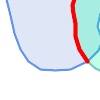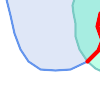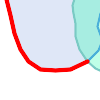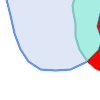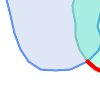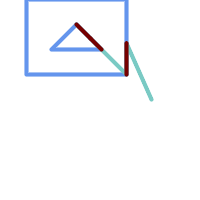Manuel PostGIS 3.7.0dev
DEV (Thu Dec 4 08:47:45 AM UTC 2025 rev. a92fadc )
PostGIS est une extension du système de base de PostgreSQL données relationnel-objet qui permet de stocker des objets SIG (Système d'Information Géographique) dans la base. PostGIS comporte un support des index spatiaux R-Tree basé sur GiST et des fonctions d'analyse et de traitement des objets SIG.
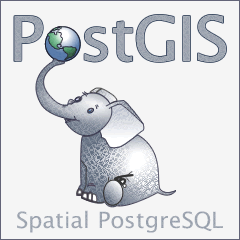

Manuel de la version 3.7.0dev
 Ce travail est soumis à une licence Creative Commons Attribution-Share Alike 3.0 License. Vous pouvez utiliser ce matériel comme bon vous semble, mais nous vous demandons de mentionner le projet PostGIS et, dans la mesure du possible, d'ajouter un lien vers https://postgis.net.
Ce travail est soumis à une licence Creative Commons Attribution-Share Alike 3.0 License. Vous pouvez utiliser ce matériel comme bon vous semble, mais nous vous demandons de mentionner le projet PostGIS et, dans la mesure du possible, d'ajouter un lien vers https://postgis.net.
- 1. Introduction
- 2. Installation de PostGIS
- 3. Administration de PostGIS
- 4. Gestion des données
- 5. Requêtes spatiales
- 6. Conseils sur les performances
- 7. Référence PostGIS
- 7.1. Types de données PostGIS Geometry/Geography/Box
- 7.2. Fonctions de gestion des tables
- 7.3. Constructeurs de géométries
- 7.4. Fonctions d'accès aux géométries
- 7.5. Éditeurs de géométrie
- 7.6. Validation de la géométrie
- 7.7. Fonctions des systèmes de référence spatiale
- 7.8. Import de géométrie
- 7.9. Export de géométrie
- 7.10. Opérateurs
- 7.11. Relations spatiales
- 7.12. Fonctions de mesure
- 7.13. Fonctions de superposition
- 7.14. Traitement des géométries
- 7.15. Couvertures
- 7.16. Transformations affines
- 7.17. Fonctions de clustering
- 7.18. Fonctions des boîtes de délimitation
- 7.19. Référencement linéaire
- 7.20. Fonctions de trajectoire
- 7.21. Fonctions de version
- 7.22. Variables PostGIS GUC (Grand Unified Custom Variables)
- 7.23. Fonctions de dépannage
- 8. Référence des fonctions SFCGAL
- 9. Topologie
- 9.1. Topology Primitive Tables
- 9.2. Les types associés à "Topology"
- 9.3. Domaines de topologie
- 9.4. Gestion de la topologie et de TopoGeometry
- 9.5. Gestion des statistiques de topologie
- 9.6. Constructeurs de topologie
- 9.7. Éditeurs de topologie
- 9.8. Accès à la topologie
- 9.9. Traitement de la topologie
- 9.10. Constructeurs de TopoGeometry
- 9.11. Editeurs de TopoGeometry
- 9.12. Accès aux TopoGeometry
- 9.13. Sorties TopoGeometry
- 9.14. Relations spatiales de topologie
- 9.15. Importer et exporter des topologies
- 10. Gestion des données raster, requêtes et applications
- 11. Référence Raster
- 11.1. Types de données pour la prise en charge raster
- 11.2. Gestion raster
- 11.3. Constructeurs de raster
- 11.4. Fonctions d'accès aux rasters
- 11.5. Fonctions d'accès aux bandes raster
- 11.6. Fonctions d'accès et de modifications des pixels raster
- 11.7. Éditeurs de raster
- 11.8. Éditeurs de bandes raster
- 11.9. Statistiques et analyses des bandes raster
- 11.10. Import de raster
- 11.11. Export de raster
- 11.12. Traitement des données raster : algèbre cartographique
- 11.13. Fonctions de rappel intégrées d'algèbre cartographique
- 11.14. Traitement des données raster : MNT (élévation)
- 11.15. Traitement des données raster : raster vers géométrie
- 11.16. Opérateurs raster
- 11.17. Relations spatiales entre raster et entre bandes raster
- 11.18. Astuces raster
- 12. PostGIS Extras
- 13. Index des fonctions spéciales de PostGIS
- 13.1. Fonctions d'agrégation de PostGIS
- 13.2. Fonctions Window PostGIS
- 13.3. Fonctions de PostGIS compatibles avec SQL-MM
- 13.4. Fonctions d'aide au type geography de PostGIS
- 13.5. Fonctions de support des données raster de PostGIS
- 13.6. Fonctions PostGIS de dump Geometry / Geography / Raster
- 13.7. Fonctions Box de PostGIS
- 13.8. Fonctions PostGIS supportant la 3D
- 13.9. Fonctions d'aide aux géométries courbes de PostGIS
- 13.10. Fonctions de support des surfaces polyédriques de PostGIS
- 13.11. Matrice d'aide aux fonctions de PostGIS
- 13.12. Fonctions PostGIS nouvelles, améliorées ou modifiées
- 14. Rapporter un problème
- A. Annexes
Chapter 1. Introduction
PostGIS est une extension spatiale pour la base de données relationnelle PostgreSQL. Elle a été créée par Refractions Research Inc, sous la forme d'un projet de recherche sur les technologies de base de données spatiales. Refractions est une société de conseil en SIG et base de données basée à Victoria, British Columbia, Canada, et spécialisée en intégration de données et développement logiciel.
PostGIS est désormais un projet de la OSGeo Foundation. PostGIS est développé et financé par de nombreux développeurs et organismes FOSS4G dans le monde entier, qui bénéficient de manière significative de ses fonctionnalités et de sa polyvalence.
Le groupe de développement du projet PostGIS a en charge la maintenance et l'amélioration de PostGIS pour un meilleur support de fonctionnalités importantes en SIG, dans les domaines des standards OGC et SQL/MM, des constructions topologiques avancées (couvertures, surfaces, réseaux), des sources de données pour les outils graphiques de bureautique pour la visualisation et l'édition des donnée SIG, ainsi que dans le domaine des outils web.
1.1. Comité de direction du projet (Project Steering Committee)
Le comité de direction du projet (PSC) coordonne la direction générale, les cycles de publication, la documentation et les efforts spécifiques pour le projet PostGIS. De plus, le PSC fournit un support général aux utilisateurs, accepte et approuve les patches de la communauté PostGIS et vote sur divers points concernant PostGIS, tels que les accès commit pour les développeurs, les nouveaux membres du PSC ou les changements majeurs d'API.
- Raúl Marín Rodríguez
Support MVT, Correction de bugs, Améliorations des performances et de la stabilité, Nettoyage du GitHub, Alignement de PostGIS avec les publications PostgreSQL
- Regina Obe
Maintenance de l'IC (intégration continue) et du site web, production Windows et builds expérimentaux, documentation, alignement de PostGIS sur les versions de PostgreSQL, support X3D, support du géocodeur TIGER, fonctions de gestion.
- Darafei Praliaskouski
Amélioration de l'index, correction de bugs et amélioration des fonctions de géométrie/géographie, SFCGAL, raster, curation GitHub, et maintenance ci (intégration continue).
- Paul Ramsey (Directeur)
Co-fondateur de PostGIS. Maintenance générale, maintenance des Geography, maintenance des index Geography et Geometry (index 2D, 3D, nD et tout index spatial), structures internes des Geometry, intégration des fonctionnalités GEOS et alignement avec les publications GEOS, alignement de PostGIS avec les publications PostgreSQL, loader/dumper, IHM de chargement Shapefile.
- Sandro Santilli
Corrections de bugs et maintenance, maintenance des CI (intégration continue), gestion des miroirs git, fonctions de gestion, intégration de nouvelles fonctionnalités GEOS et alignement sur les versions GEOS, support topologique, framework raster et fonctions API de bas niveau.
1.2. Contributeurs cœur actuels
- Nicklas Avén
Améliorations et ajouts de fonctions de distance (notamment fonctions de distance 3D et relations), format de sortie Tiny WKB (TWKB) et support utilisateur
- Loïc Bartoletti
Améliorations et maintenance de SFCGAL et maintien de l'intégration continue
- Dan Baston
Ajout de fonctions sur le clustering de géométries, améliorations sur les algorithmes sur les géométries, améliorations GEOS et support utilisateur
- Martin Davis
Améliorations GEOS et documentation
- Björn Harrtell
Fonctions MapBox Vector Tile, GeoBuf et Flatgeobuf. Tests Gitea et expérimentation GitLab.
- Aliaksandr Kalenik
Traitement des géométries, PostgreSQL gist, correction de bugs
- Laurențiu Nicola
Bug fixes, maintenance, stability, and performance
1.3. Anciens contributeurs cœur
- Bborie Park
Ancien membre du PSC. Développement raster, intégration avec GDAL, loader raster, support utilisateur, correction de bugs, tests sur divers systèmes d'exploitation (Slackware, Mac, Windows, et autres)
- Mark Cave-Ayland
Ancien membre du PSC. Coordination de l'effort de correction de bugs et de maintenance, sélectivité et liaisons des index spatiaux, loader/dumper, IHM de chargement Shapefile, intégration et amélioration de nouvelles fonctions.
- Jorge Arévalo
Développement Raster, support du driver GDAL, outil de chargement
- Olivier Courtin
(Émérite) Fonctions d'entrée/sortie XML (KML,GML) et fonctions GeoJSON, support 3D et correction de bugs.
- Chris Hodgson
Ancien membre du PSC. Développement général, maintenance du site et du robot de build, gestion de l'incubation OSGeo
- Mateusz Loskot
Support de CMake pour PostGIS, a développé le loader raster original en python et les fonctions d'API bas-niveau raster
- Kevin Neufeld
Ancien membre du PSC. Documentation et outils pour la documentation, maintenance du robot de build, support utilisateur avancé sur le newsgroup PostGIS, et maintenance et améliorations des fonctions PostGIS.
- Dave Blasby
Développeur originel et co-fondateur de PostGIS. Dave a écrit les objets côté serveur, les liaisons des index, et de nombreuses fonctions d'analyse côté serveur.
- Jeff Lounsbury
Développement originel de l'outil de chargement/export de shapefiles.
- Mark Leslie
Maintenance générale et développement de fonctions du noyau PostGIS. Amélioration du support des courbes. Interface graphique de chargement des shapefiles.
- Pierre Racine
Architecte de l'implémentation raster de PostGIS. Architecture globale raster, prototypage, support au développement
- David Zwarg
Développement raster (principalement fonctions analytiques d'algèbre cartographique)
1.4. Autres contributeurs
- Contributeurs individuels
Alex Bodnaru Gerald Fenoy Matthias Bay Alex Mayrhofer Gino Lucrezi Maxime Guillaud Andrea Peri Greg Troxel Maxime van Noppen Andreas Forø Tollefsen Guillaume Lelarge Maxime Schoemans Andreas Neumann Giuseppe Broccolo Megan Ma Andrew Gierth Han Wang Michael Fuhr Anne Ghisla Hans Lemuet Mike Toews Antoine Bajolet Haribabu Kommi Nathan Wagner Arthur Lesuisse Havard Tveite Nathaniel Clay Artur Zakirov IIDA Tetsushi Nikita Shulga Ayo Adesugba Ingvild Nystuen Norman Vine Barbara Phillipot Jackie Leng Patricia Tozer Ben Jubb James Addison Rafal Magda Bernhard Reiter James Marca Ralph Mason Björn Esser Jan Katins Rémi Cura Brian Hamlin Jan Tojnar Richard Greenwood Bruce Rindahl Jason Smith Robert Coup Bruno Wolff III Jeff Adams Roger Crew Bryce L. Nordgren Jelte Fennema Ron Mayer Carl Anderson Jim Jones Sam Peters Charlie Savage Joe Conway Sebastiaan Couwenberg Chris Mayo Jonne Savolainen Sergei Shoulbakov Christian Schroeder Jose Carlos Martinez Llari Sergey Fedoseev Christoph Berg Jörg Habenicht Shinichi Sugiyama Christoph Moench-Tegeder Julien Rouhaud Shoaib Burq Dane Springmeyer Kashif Rasul Silvio Grosso Daniel Nylander Klaus Foerster Stefan Corneliu Petrea Dapeng Wang Kris Jurka Steffen Macke Daryl Herzmann Laurențiu Nicola Stepan Kuzmin Dave Fuhry Laurenz Albe Stephen Frost David Garnier Lars Roessiger Steven Ottens David Skea Leo Hsu Talha Rizwan David Techer Loic Dachary Teramoto Ikuhiro Denys Kovshun Luca S. Percich Tom Glancy Dian M Fay Lucas C. Villa Real Tom van Tilburg Dmitry Vasilyev Maksim Korotkov Victor Collod Eduin Carrillo Maria Arias de Reyna Vincent Bre Esteban Zimanyi Marc Ducobu Vincent Mora Eugene Antimirov Mark Sondheim Vincent Picavet Even Rouault Markus Schaber Volf Tomáš Florian Weimer Markus Wanner Zuo Chenwei Frank Warmerdam Matt Amos George Silva Matt Bretl - Organisations sponsors
Certaines organisations ont contribué du temps de développeur, de l'hébergement, ou du financement direct pour le projet PostGIS. Par ordre alphabétique :
- Aiven
- Arrival 3D
- Associazione Italiana per l'Informazione Geografica Libera (GFOSS.it)
- AusVet
- Avencia
- Azavea
- Boundless
- Cadcorp
- Camptocamp
- Carto
- Crunchy Data
- City of Boston (DND)
- City of Helsinki
- Clever Elephant Solutions
- Cooperativa Alveo
- Deimos Space
- Faunalia
- Geographic Data BC
- HighGo
- Hunter Systems Group
- INIA-CSIC
- ISciences, LLC
- Kontur
- Lidwala Consulting Engineers
- LISAsoft
- Logical Tracking & Tracing International AG
- Maponics
- Michigan Tech Research Institute
- Natural Resources Canada
- Norwegian Forest and Landscape Institute
- Norwegian Institute of Bioeconomy Research (NIBIO)
- OSGeo
- Oslandia
- Palantir Technologies
- Paragon Corporation
- Postgres Pro
- R3 GIS
- Refractions Research
- Regione Toscana - SITA
- Safe Software
- Sirius Corporation plc
- Stadt Uster
- UC Davis Center for Vectorborne Diseases
- Université Laval
- U.S. Census Bureau
- U.S. Department of State (HIU)
- Zonar Systems
- Campagnes de financement participatif
Les campagnes de financement participatif sont des campagnes que nous organisons pour financer des fonctionnalités très demandées qui peuvent servir à une large communauté. Chaque campagne est centrée sur une fonctionnalité, ou un lot de fonctionnalités. Chaque sponsor apporte une petite fraction du financement nécessaire, et avec assez de personnes et d'organisations contribuant, nous obtenons les fonds nécessaires pour payer le travail qui aidera la communauté. Si vous pensez qu'une fonctionnalité pourrait être co-financée par de nombreux acteurs, vous pouvez poster votre idée sur le newsgroup PostGIS et ensemble nous pourrons la réaliser.
PostGIS has experimented with community fundraising for features in the past. We used PledgeBank and we got two successful campaigns out of it.
postgistopology - Plus de 10 sponsors ont contribué chacun 250USD pour créer la fonction toTopoGeometry et sortir le support de la topologie dans la version 2.0.0. Ce fut une réussite.
postgis64windows - Plus de 20 sponsors ont contribué chacun 100USD pour le support PostGIS 64-bit sur Windows. Ce fut une réussite.
- Bibliothèques de base importantes
GEOS, la bibliothèque pour les opérations sur les géometries
GDAL (Geospatial Data Abstraction Library), la bibliothèque utilisée pour propulser la plupart des fonctionnalités raster introduites dans PostGIS 2. En retour, les améliorations requises dans GDAL pour supporter PostGIS sont reversées dans le projet GDAL.
PROJ, la bibliothèque gérant les projections cartographiques
Enfin, mais non des moindres, le projet de SGBD PostgreSQL, géant sur les épaules duquel PostGIS s'appuie. La rapidité et flexibilité de PostGIS serait impossible sans l'extensibilité, le planificateur de requêtes, les index GiST et les nombreuses fonctionnalités SQL que fournit PostgreSQL.
Chapter 2. Installation de PostGIS
Ce chapitre décrit les étapes nécessaires pour installer PostGIS.
2.1. Version courte
Pour compiler, en supposant que toutes les dépendances soient dans votre chemin de recherche :
tar -xvzf postgis-3.7.0dev.tar.gz cd postgis-3.7.0dev ./configure make make install
Une fois PostGIS installé, il est nécessaire de l'activer (Section 3.3, “Création de bases de données spatiales”) ou de le mettre à jour (Section 3.4, “Mise à jour des bases de données spatiales”) dans chaque base de données où vous voulez l'utiliser.
2.2. Compilation et installation depuis les sources
![[Note]](images/note.png) | |
La plupart des systèmes d'exploitation dispose de paquets pré-compilés de PostgreSQL/PostGIS. La compilation est réellement nécessaire uniquement pour disposer des toutes dernières fonctionnalités ou pour les responsables de paquets PostGIS. Cette section décrit le processus générique de compilation. Si vous compilez pour Windows ou d'autres systèmes d'exploitation, vous trouverez des instructions plus détaillées dans les wiki de la communauté guides de compilation et PostGIS Dev Wiki. Les paquets pré-compilés pour de multiples systèmes d'exploitation sont listés dans PostGIS Pre-built Packages Pour les utilisateurs Windows, des versions stables sont disponibles sur Stackbuilder ou sur le site de téléchargement PostGIS Windows. Des compilations expérimentales incluant les dernières fonctionnalités sont disponibles. Ces compilations sont généralement mises à jour une ou deux fois par semaines, ou chaque fois qu'une nouvelle fonctionnalité intéressante est ajoutée. Vous pouvez les utiliser pour suivre l'avancée des versions de PostGIS |
Le module PostGIS est une extension pour le serveur backend PostgreSQL. Par conséquent, PostGIS 3.7.0dev nécessite l'ensemble des entêtes du serveur PostgreSQL pour pouvoir être compilé. PostGIS peut être compilé pour les versions PostgreSQL 12 à 18. Les versions précédentes de PostgreSQL ne sont pas supportées.
Référez-vous aux guides d'installation de PostgreSQL si vous ne l'avez pas encore installé : https://www.postgresql.org .
![[Note]](images/note.png) | |
Pour les fonctionnalités de GEOS, quand vous installez PostgreSQL, vous aurez peut-être besoin de lier explicitement PostgreSQL avec la bibliothèque standard C++ : LDFLAGS=-lstdc++ ./configure [YOUR OPTIONS HERE] Ceci est une solution de contournement d'exceptions C++ d'interactions bugués dans des outils de développements plus ancien. Si vous tombez sur ce genre de problèmes (backend soudainement fermé ou des choses similaires) essayez cette astuce. Cela nécessite de recompiler votre PostgreSQL du début, bien sur. |
Les étapes suivantes résument la configuration et la compilation des sources PostGIS. Elles ont été rédigées pour les utilisateurs sous Linux et ne fonctionneront pas pour Windows et Mac.
2.2.1. Obtenir les Sources
Les sources de PostGIS sont disponible depuis https://postgis.net/stuff/postgis-3.7.0dev.tar.gz
wget https://postgis.net/stuff/postgis-3.7.0dev.tar.gz tar -xvzf postgis-3.7.0dev.tar.gz cd postgis-3.7.0dev
Un répertoire appelé postgis-3.7.0dev sera créé dans le répertoire courant.
Les sources peuvent également être obtenues depuis le dépôt git https://git.osgeo.org/gitea/postgis/postgis/ .
git clone https://git.osgeo.org/gitea/postgis/postgis.git postgis
cd postgis
sh autogen.sh
Se placer dans le nouveau répertoire créé postgis-3.7.0dev pour poursuivre l'installation.
./configure
2.2.2. Pré requis à l'installation
La compilation et l'utilisation de PostGIS nécessitent les éléments suivants :
Obligatoire
PostgreSQL 12 - 18. A complete installation of PostgreSQL (including server headers) is required. PostgreSQL is available from https://www.postgresql.org 18 .
Pour une matrice complète de compatibilité PostgreSQL/PostGIS et PostGIS/GEOS, référez-vous à https://trac.osgeo.org/postgis/wiki/UsersWikiPostgreSQLPostGIS
Un compilateur GNUC C (
gcc). D'autres compilateurs ANSI C peuvent être utilisés, mais la compilation avecgccest source de moins de problèmes.GNU Make (
gmakeoumake). Sur beaucoup de systemes, GNUmakeest la version par défaut de make. Vous pouvez vérifier la version de make avec la commandemake -v. D'autres versions demakepeuvent ne pas être compatibles avec leMakefilede PostGIS.Proj, bibliothèque de reprojection. Proj 6.1 ou supérieur est nécessaire. La bibliothèque Proj est utilisée pour fournir le support de reprojection de coordonnées dans PostGIS. Proj est disponible au téléchargement depuis https://proj.org/ .
GEOS geometry library, version 3.8.0 or greater, but GEOS 3.14+ is required to take full advantage of all the new functions and features. GEOS is available for download from https://libgeos.org .
LibXML2, version 2.5.x ou supérieur. LibXML2 est actuellement utilisée dans certaines fonctions d'import (ST_GeomFromGML et ST_GeomFromKML). LibXML2 est disponible au téléchargement depuis https://gitlab.gnome.org/GNOME/libxml2/-/releases.
JSON-C, version 0.9 ou supérieure. JSON-C est utilisé pour l'import GeoJSON avec la fonction ST_GeomFromGeoJson. JSON-C est disponible depuis https://github.com/json-c/json-c/releases/.
La version 3+ de GDAL est préférable. Elle est nécessaire pour la prise en charge des données matricielles. https://gdal.org/download.html.
Si vous compilez avec PostgreSQL+JIT, LLVM version >=6 est nécessaire https://trac.osgeo.org/postgis/ticket/4125.
Optionnel
GDAL (pseudo optionnel) vous pouvez l'omettre seulement si vous ne voulez pas du support raster. Pensez également à activer les pilotes que vous souhaitez utiliser, comme décrit dans Section 3.2, “Configurer la prise en charge du raster”.
GTK (GTK+2.0, 2.8+) pour compiler le chargeur de shape file shp2pgsql-gui. http://www.gtk.org/ .
SFCGAL, 1.4.1 or higher is required and 2.1+ is needed to be able to use all functionality. SFCGAL can be used to provide additional 2D and 3D advanced analysis functions to PostGIS cf Chapter 8, Référence des fonctions SFCGAL. And also allow to use SFCGAL rather than GEOS for some 2D functions provided by both backends (like ST_Intersection or ST_Area, for instance). A PostgreSQL configuration variable
postgis.backendallow end user to control which backend he want to use if SFCGAL is installed (GEOS by default). Nota: SFCGAL 1.2 require at least CGAL 4.3 and Boost 1.54 (cf: https://sfcgal.org) https://gitlab.com/sfcgal/SFCGAL/.In order to build the Section 12.1, “Address Standardizer” you will also need PCRE 1 or 2 http://www.pcre.org (which generally is already installed on nix systems). Section 12.1, “Address Standardizer” will automatically be built if it detects a PCRE library, or you pass in a valid
--with-pcre-dir=/path/to/pcreduring configure.Pour permettre d'utiliser ST_AsMVT, la bibliothèque protobuf-c 1.1.0 ou supérieur (pour l'utilisation) et le compilateur protoc-c (pour la compilation) sont nécessaires. Également, pkg-config est nécessaire pour vérifier la version minimale correcte de protobuf-c. Voir protobuf-c. Par défaut, PostGIS utilise Wagyu pour valider les polygones MVT plus rapidement, ce qui nécessite un compilateur c++11. Ceci utilisera les CXXFLAGS et le même compilateur que l'installation PostgreSQL. Pour désactiver cela et utiliser GEOS à la place, utilisez la variable
--without-wagyupendant l'étape de configuration.CUnit (
CUnit). Nécessaire pour les tests de régression. http://cunit.sourceforge.net/DocBook (
xsltproc) est nécessaire pour générer la documentation. Docbook est disponible depuis le site http://www.docbook.org/ .DBLatex (
dblatex) est nécessaire pour générer la documentation au format PDF. DBLatex est disponible depuis http://dblatex.sourceforge.net/ .GraphicsMagick (
gm convert) is required to generate the images used in the documentation. If GraphicsMagick is unavailable, ImageMagick (convertormagick convert) provides the same command-line syntax. GraphicsMagick is available from http://www.graphicsmagick.org/ and ImageMagick from https://imagemagick.org/ .
2.2.3. Configuration de la compilation
Comme pour la plupart des installations linux, la première étape est de générer le Makefile qui sera utilisé pour compiler le code source. Ceci est réalisée en lançant le script shell
./configure
Sans paramètre supplémentaire, cette commande tentera de localiser automatiquement les composants requis et les bibliothèques nécessaires à la compilation de PostGIS. Bien que cela soit l'utilisation la plus commune de la commande ./configure, vous pouvez également ajouter différents paramètres à ce script. Par exemple, vous pouvez définir l'emplacement de bibliothèques ou de programmes si ceux-ci ne sont pas localisés à un emplacement standard.
La liste suivante présente les options les plus courantes. Pour consulter la liste complète utilisez l'option --help ou --help=short.
--with-library-minor-versionÀ partir de PostGIS 3.0, les fichiers de bibliothèque générés par défaut n'auront plus la version mineur dans le nom de fichier. Ceci signifie que les libs PostGIS 3 se termineront par
postgis-3. Ceci a été fait pour faciliter l'usage de pg_upgrade, avec la contrainte que vous ne pouvez installer qu'une seule version de PostGIS 3 sur votre serveur. Pour basculer sur l'ancien comportement et avoir des fichiers qui incluent la version mineure : e.g.postgis-3.0, ajoutez ce paramètre dans la commande de configuration.--prefix=PREFIXCela correspond à l'emplacement où les exécutables et librairies de PostGIS seront installés. Par défaut, cet emplacement est le même que celui de l'installation de PostgreSQL.
![[Caution]](images/caution.png)
Ce paramètre est actuellement défectueux : le paquet s'installe uniquement dans le répertoire d'installation de PostgreSQL. Le suivi de ce bug est disponible depuis http://trac.osgeo.org/postgis/ticket/635 .
--with-pgconfig=FILEPostgreSQL fournit l'utilitaire pg_config permettant aux extensions comme PostGIS de localiser le répertoire d'installation de PostgreSQL. Utiliser ce paramètre (--with-pgconfig=/path/to/pg_config) pour spécifier une installation particulière de PostgreSQL pour laquelle PostGIS doit être compilée.
--with-gdalconfig=FILEGDAL, une des bibliothèques requises pour le support des rasters. gdal-config pour permettre au logiciel de localiser le répertoire d'installation de GDAL. Utiliser ce paramètre (--with-gdalconfig=/path/to/gdal-config) pour spécifier un répertoire d'installation particulier de GDAL qui sera utilisé pour compiler PostGIS.
--with-geosconfig=FILEGEOS, une des bibliothèques requises, fournit un utilitaire appelé geos-config permettant aux logiciels de localiser le répertoire d'installation de GEOS. Utiliser ce paramètre (--with-geosconfig=/path/to/geos-config) pour spécifier le repertoire de GEOS qui sera utilisé pour la compilation de PostGIS.
--with-xml2config=FILELibXML est la bibliothèque requise pour les processus GeomFromKML/GML. Elle est normalement trouvée si libxml est installé, mais si ce n'est pas le cas ou si vous souhaitez qu'une version spécifique soit utilisée, vous devrez indiquer à PostGIS un fichier confi
xml2-configspécifique pour permettre aux installations logicielles de localiser le répertoire d'installation de LibXML. Utilisez ce paramètre (>--with-xml2config=/path/to/xml2-config) pour spécifier manuellement une installation LibXML particulière avec laquelle PostGIS sera construit.--with-projdir=DIRProj4 est la bibliothèque de reprojection nécessaire à PostGIS. Utilisez ce paramètre (--with-projdir=/path/to/projdir) pour spécifier le répertoire de Proj qui sera utilisé pour la compilation de PostGIS.
--with-libiconv=DIRRépertoire d'installation d'iconv.
--with-jsondir=DIRJSON-C est une bibliothèque sous licence MIT utilisée par PostGIS pour les traitements JSON (ST_GeomFromJSON par exemple). Utiliser ce paramètre (--with-jsondir=/path/to/jsondir) pour spécifier le répertoire de JSON-C qui sera utilisé pour la compilation de PostGIS.
--with-pcredir=DIRPCRE (Perl Compatible Regular Expression) est une bibliothèque sous licence BSD requise par l'extension address_standardizer. Utilisez ce paramètre (--with-pcredir=/chemin/vers/pcredir) pour spécifier un répertoire contenant PCRE qui sera utilisé par PostGIS.
--with-guiCompile l'interface graphique d'import de données (nécessite GTK+2.0). Ceci créé l'interface graphique shp2pgsql-gui à shp2pgsql.
--without-rasterCompilation sans support des raster.
--without-tigerDisables tiger geocoder support.
--without-topologyCompile without topology support.
--with-gettext=noPar défaut PostGIS tentera de détecter la gestion de gettext et de reposer dessus pour la compilation, cependant si vous tombez sur des problèmes d'incompatibilités qui cause la cassure du chargeur, vous pouvez le désactiver entièrement avec cette commande. Référez vous au ticket http://trac.osgeo.org/postgis/ticket/748 pour un exemple de problème résolu par cette configuration. NOTE : que vous perdez beaucoup de chose en le désactivant. Cela est utilisé pour la gestion de l'aide et des labels internationaux dans le chargeur graphique qui n'est pas documenté et encore expérimental.
--with-sfcgal=PATHPar défaut, PostGIS ne contiendra pas le support sfcgal sans cet argument.
PATHest un argument optionnel permettant de préciser un chemin alternatif vers sfcgal-config.--without-phony-revisionDésactive la mise à jour de postgis_revision.h à partir du HEAD courant du dépôt git.
![[Note]](images/note.png) | |
Si vous avez téléchargé PostGIS depuis le dépôt du code , la première étape est d'exécuter le script ./autogen.sh Ce script générera le script configure qui est utilisé pour personnaliser votre installation de PostGIS. Si vous avez obtenu PostGIS comme archive, lancer la commande ./autogen.sh n'est pas nécessaire puisque configure a déjà été généré. |
2.2.4. Compiler
Une fois le Makefile généré, compiler PostGIS est aussi simple que lancer
make
La dernière ligne de la sortie doit être "PostGIS was built successfully. Ready to install."
All the functions have comments generated from the documentation. If you wish to install these comments into your spatial databases later, run the command which requires docbook. The postgis_comments.sql and other package comment files are also packaged in the tar.gz distribution in the doc folder so no need to make comments if installing from the tar ball. Comments are also included as part of the CREATE EXTENSION install.
make comments
The make cheatsheets target generates html cheat sheets suitable for quick reference or for student handouts. This requires xsltproc to build and will generate 4 files in doc folder topology_cheatsheet.html, tiger_geocoder_cheatsheet.html, raster_cheatsheet.html, postgis_cheatsheet.html
Vous pouvez télécharger des pré-compilations disponibles en HTML et PDF à partir de PostGIS / PostgreSQL Study Guides
make cheatsheets
2.2.5. Compiler les Extensions PostGIS et les déployer
The PostGIS extensions are built and installed automatically when PostgreSQL extension support is available.
Si vous compilez à partir des dépôts des sources, vous devez compiler les descriptions de fonction d'abord. Ceci est compilé si vous avez docbook installé. Vous pouvez également compiler manuellement avec cette commande :
make comments
Compiler les commentaires n'est pas nécessaire si vous avez compilé à partir d'une release d'archive puisque ceux-ci sont des pré-compilations packagés avec le tar ball.
Les extensions devraient être automatiquement compilées lors du make install. Vous pouvez, si nécessaire, compiler à partir des répertoires d'extensions ou copier les fichiers si vous en avez besoin sur un serveur différent.
cd extensions cd postgis make clean make export PGUSER=postgres #overwrite psql variables make check #to test before install make install # to test extensions make check RUNTESTFLAGS=--extension
![[Note]](images/note.png) | |
|
Les fichiers extensions seront toujours les mêmes pour les mêmes versions de PostGIS et PostgreSQL indépendamment de l'OS, par conséquent il n'y a pas de problème à copier les fichiers extensions d'un OS à un autre du moment que vous avez les binaires PostGIS déjà installés sur vos serveurs.
Si vous voulez installer les extensions manuellement sur un serveur différent séparé de votre développement, vous devez copier les fichiers suivants à partir du répertoire extension dans le répertoire PostgreSQL / share / extension de votre installation PostgreSQL ainsi que les binaires nécessaires pour une version correcte de PostGIS si vous ne les avez pas déjà sur le serveur.
Ceux-ci sont les fichiers de contrôle qui renvoie les informations telles que la version de l'extension à installer si non spécifié.
postgis.control, postgis_topology.control.Tous les fichiers dans le répertoire /sql de chaque extension. Notez que ceux-ci nécessitent d'être copiées à la racine du répertoire share/extension de PostgreSQL
extensions/postgis/sql/*.sql,extensions/postgis_topology/sql/*.sql
Une fois que vous avez fait cela, vous devriez voir postgis, postgis_topology comme extensions disponibles dans PgAdmin -> extensions.
Si vous utilisez psql, vous pouvez vérifier que les extensions sont installées en lançant cette requête :
SELECT name, default_version,installed_version
FROM pg_available_extensions WHERE name LIKE 'postgis%' or name LIKE 'address%';
name | default_version | installed_version
------------------------------+-----------------+-------------------
address_standardizer | 3.7.0dev | 3.7.0dev
address_standardizer_data_us | 3.7.0dev | 3.7.0dev
postgis | 3.7.0dev | 3.7.0dev
postgis_raster | 3.7.0dev | 3.7.0dev
postgis_sfcgal | 3.7.0dev |
postgis_tiger_geocoder | 3.7.0dev | 3.7.0dev
postgis_topology | 3.7.0dev |
(6 rows)Si vous avez l'extension installée dans la base de données que vous interrogez, vous verrez la mention dans la colonne installed_version. Si vous n'obtenez aucun enregistrement , cela signifie que vous n'avez pas d'extension postgis installés sur le serveur. PgAdmin III 1.14+ fournira aussi cette information dans la section extensions dans l'arbre de l'explorateur de la base de données et autorisera même la mise à jour ou la désinstallation par clic-droit.
Si vous avez les extensions disponibles, vous pouvez installer les extensions postgis dans votre base de données de votre choix soit en utilisant l'interface d'extension de PgAdmin ou lançant ces commandes SQL :
CREATE EXTENSION postgis; CREATE EXTENSION postgis_raster; CREATE EXTENSION postgis_sfcgal; CREATE EXTENSION fuzzystrmatch; --needed for postgis_tiger_geocoder --optional used by postgis_tiger_geocoder, or can be used standalone CREATE EXTENSION address_standardizer; CREATE EXTENSION address_standardizer_data_us; CREATE EXTENSION postgis_tiger_geocoder; CREATE EXTENSION postgis_topology;
Avec psql, vous pouvez contrôler les versions installées ainsi que les schémas d'installation.
\connect mygisdb \x \dx postgis*
List of installed extensions -[ RECORD 1 ]------------------------------------------------- Name | postgis Version | 3.7.0dev Schema | public Description | PostGIS geometry, geography, and raster spat.. -[ RECORD 2 ]------------------------------------------------- Name | postgis_raster Version | 3.0.0dev Schema | public Description | PostGIS raster types and functions -[ RECORD 3 ]------------------------------------------------- Name | postgis_tiger_geocoder Version | 3.7.0dev Schema | tiger Description | PostGIS tiger geocoder and reverse geocoder -[ RECORD 4 ]------------------------------------------------- Name | postgis_topology Version | 3.7.0dev Schema | topology Description | PostGIS topology spatial types and functions
![[Warning]](images/warning.png) | |
Extension tables |
Si vous avez installé la version 3.7.0dev sans utiliser le système d'extensions, il est possible de l'activer via les commandes suivantes pour packager les fonctions dans leurs extensions respectives. L'installation via `unpackaged` a été supprimé dans PostgreSQL 13, nous vous invitons donc à basculer sur une installation utilisant le système d'extensions avant de migrer à PostgreSQL 13.
CREATE EXTENSION postgis FROM unpackaged; CREATE EXTENSION postgis_raster FROM unpackaged; CREATE EXTENSION postgis_topology FROM unpackaged; CREATE EXTENSION postgis_tiger_geocoder FROM unpackaged;
2.2.6. Tests
Si vous désirez tester la compilation de PostGIS, lancez
make check
La commande ci-dessus fonctionnera pour différentes tests de vérification et de régression en utilisant la bibliothèque générée selon la base de données actuelle.
![[Note]](images/note.png) | |
Si vous avez configuré PostGIS en utilisant un emplacement non standard de PostgreSQL, GEOS, ou Proj4, vous pourrez avoir besoin d'ajouter l'emplacement des bibliothèques à la variable d'environnement |
![[Caution]](images/caution.png) | |
Pour le moment, make check repose sur les variables d'environnement |
![[Note]](images/note.png) | |
Sandboxed build accounts that are not PostgreSQL superusers can delegate database ownership during the regression cycle by exporting These variables allow automated environments to exercise the full upgrade and extension install paths without promoting the calling account to superuser, provided the target PostgreSQL instance permits extension installation by those delegate roles. |
Si réussi, make check sortira les résultats de près de 500 tests. Les résultats seront similaires à la sortie ci-dessous (avec de nombreuses lignes omises) :
CUnit - A unit testing framework for C - Version 2.1-3
http://cunit.sourceforge.net/
.
.
.
Run Summary: Type Total Ran Passed Failed Inactive
suites 44 44 n/a 0 0
tests 300 300 300 0 0
asserts 4215 4215 4215 0 n/a
Elapsed time = 0.229 seconds
.
.
.
Running tests
.
.
.
Run tests: 134
Failed: 0
-- if you build with SFCGAL
.
.
.
Running tests
.
.
.
Run tests: 13
Failed: 0
-- if you built with raster support
.
.
.
Run Summary: Type Total Ran Passed Failed Inactive
suites 12 12 n/a 0 0
tests 65 65 65 0 0
asserts 45896 45896 45896 0 n/a
.
.
.
Running tests
.
.
.
Run tests: 101
Failed: 0
-- topology regress
.
.
.
Running tests
.
.
.
Run tests: 51
Failed: 0
-- if you built --with-gui, you should see this too
CUnit - A unit testing framework for C - Version 2.1-2
http://cunit.sourceforge.net/
.
.
.
Run Summary: Type Total Ran Passed Failed Inactive
suites 2 2 n/a 0 0
tests 4 4 4 0 0
asserts 4 4 4 0 n/aLes extensions postgis_tiger_geocoder et address_standardizer ne supportent actuellement que l'installcheck de PostgreSQL. Pour les tester, cf ci-dessous. Note : Il n'est pas nécessaire de lancer make install si cette commande a déjà été lancée dans le répertoire racine des sources PostGIS.
Pour l'extension address_standardize :
cd extensions/address_standardizer
make install
make installcheck
La sortie de la commande devrait ressembler à :
============== dropping database "contrib_regression" ============== DROP DATABASE ============== creating database "contrib_regression" ============== CREATE DATABASE ALTER DATABASE ============== running regression test queries ============== test test-init-extensions ... ok test test-parseaddress ... ok test test-standardize_address_1 ... ok test test-standardize_address_2 ... ok ===================== All 4 tests passed. =====================
Le géocodeur tiger nécessite d'avoir les extensions postgis et fuzzystrmatch installée sur l'instance PostgreSQL. Les tests de l'extension address_standardizer seront lancés si PostGIS est compilé avec le support address_standardizer :
cd extensions/postgis_tiger_geocoder
make install
make installcheck
La sortie de la commande devrait ressembler à :
============== dropping database "contrib_regression" ============== DROP DATABASE ============== creating database "contrib_regression" ============== CREATE DATABASE ALTER DATABASE ============== installing fuzzystrmatch ============== CREATE EXTENSION ============== installing postgis ============== CREATE EXTENSION ============== installing postgis_tiger_geocoder ============== CREATE EXTENSION ============== installing address_standardizer ============== CREATE EXTENSION ============== running regression test queries ============== test test-normalize_address ... ok test test-pagc_normalize_address ... ok ===================== All 2 tests passed. =====================
2.2.7. Installation
Pour installer PostGIS, entrez
make install
Ceci copiera les fichiers d'installation de PostGIS dans leur sous-répertoires appropriés définis par le paramètre de configuration --prefix. En particulier :
Les binaires du chargeur et du dumper sont installés dans
[prefix]/bin.Les fichiers SQL, tel que
postgis.sql, sont installé dans[prefix]/share/contrib.Les bibliothèques PostGIS sont installées dans
[prefix]/lib.
Si vous avez déjà lancé la commande make comments pour générer les fichiers postgis_comments.sql, raster_comments.sql, installer le fichier sql en lançant
make comments-install
![[Note]](images/note.png) | |
|
2.3. Installation et utilisation de l'extension address standardize
The address_standardizer extension is bundled with PostGIS. For more information about the address_standardizer, what it does, and how to configure it for your needs, refer to Section 12.1, “Address Standardizer”.
Ce normalisateur d'adresses peut être utilisé avec l'extension PostGIS tiger en remplacement de Normalize_Address. Se référer à la page Section 2.4.2, “Utilisation de l'Extension Address Standardizer avec le Geocodeur Tiger” pour mettre en place ce remplacement. Il peut également être utilisé pour fabriquer son propre géocodeur ou pour normaliser des adresses pour les comparer plus facilement.
Le normalisateur d'adresses se base sur PCRE, généralement installé sur les systèmes Nix. Il peut également être téléchargé ici : http://www.pcre.org. Durant la phase Section 2.2.3, “Configuration de la compilation”, si PCRE est détecté, le normalisateur d'adresses sera automatiquement compilé. Pour utiliser une installation personnalisée de PCRE, passer le paramètre --with-pcredir=/chemin/vers/pcre dans la commande configure, où /chemin/vers/pcre est le répertoire contenant les sous-répertoires pcre include et lib.
Windows installation packages include the address_standardizer so you can move straight to the CREATE EXTENSION step.
Une fois installée, vous pouvez vous connecter à votre base de données et lancer le SQL :
CREATE EXTENSION address_standardizer;
Le test suivant ne nécessite pas de table rules, gas, ou lex
SELECT num, street, city, state, zip
FROM parse_address('1 Devonshire Place PH301, Boston, MA 02109');La sortie de la commande devrait ressembler à
num | street | city | state | zip -----+------------------------+--------+-------+------- 1 | Devonshire Place PH301 | Boston | MA | 02109
2.4. Installation, mise à jour et chargement de données pour le géocodeur Tiger
L'extension géocodeur Tiger peut ne pas être distribué avec votre installation de PostGIS. Si vous n'avez pas l'extension géocodeur Tiger, ou si vous souhaitez utiliser une version plus récente de celle de votre installation, vous pouvez utiliser les fichiers share/extension/postgis_tiger_geocoder.* depuis les paquets disponibles à Windows Unreleased Versions, dans la section pour votre version de PostgreSQL. Même si ces paquets sont pour Windows, les fichiers d'extension postgis_tiger_geocoder fonctionneront quel que soit votre système d'exploitation car c'est une extension en SQL/plpgsql.
2.4.1. Tiger Geocoder Activation de votre base de données PostGIS
Ces instructions supposent que l'extension postgis_tiger_geocoder soit déjà installée dans votre installation PostgreSQL.
Connectez-vous à la base de données avec psql ou PgAdmin (ou tout autre client) et lancez la commande SQL suivante. Note : Si l'installation se déroule sur une base de données contenant déjà PostGIS, la première étape n'est pas nécessaire. Si l'extension
fuzzystrmatchest déjà installée, la seconde étape n'est pas nécessaire non plus.CREATE EXTENSION postgis; CREATE EXTENSION fuzzystrmatch; CREATE EXTENSION postgis_tiger_geocoder; --this one is optional if you want to use the rules based standardizer (pagc_normalize_address) CREATE EXTENSION address_standardizer;
Si l'extension postgis_tiger_geocoder est déjà installée et que vous souhaitez la mettre à jour, lancez :
ALTER EXTENSION postgis UPDATE; ALTER EXTENSION postgis_tiger_geocoder UPDATE;
Si vous avez modifié
tiger.loader_platformoutiger.loader_variables, vous devrez peut être les mettre à jour.Pour tester l'installation, lancez cette commande SQL sur la base de données :
SELECT na.address, na.streetname,na.streettypeabbrev, na.zip FROM normalize_address('1 Devonshire Place, Boston, MA 02109') AS na;Qui devrait afficher
address | streetname | streettypeabbrev | zip ---------+------------+------------------+------- 1 | Devonshire | Pl | 02109Créez un nouvel enregistrement dans la table
tiger.loader_platformcontenant les chemins vers les exécutables et le serveur.Par exemple, pour créer un profil nommé debbie suivant la convention
sh, vous feriez :INSERT INTO tiger.loader_platform(os, declare_sect, pgbin, wget, unzip_command, psql, path_sep, loader, environ_set_command, county_process_command) SELECT 'debbie', declare_sect, pgbin, wget, unzip_command, psql, path_sep, loader, environ_set_command, county_process_command FROM tiger.loader_platform WHERE os = 'sh';Et modifiez les chemins dans la colonne declare_sect pour les faire correspondre aux chemins des programmes pg, unzip, shp2pgsql, psql, etc. sur le serveur Debbie.
Si vous ne modifiez pas la table
loader_platform, elle contiendra des chemins par défaut pour les programmes, et vous aurez à modifier les scripts après leur génération.The Zip code-5 digit tabulation area
zcta5load step uses current ZCTA data and is part of the Loader_Generate_Nation_Script when enabled. It is turned off by default because it takes quite a bit of time to load (20 to 60 minutes), takes up quite a bit of disk space, and is not used that often.Pour l'activer, exécutez :
UPDATE tiger.loader_lookuptables SET load = true WHERE table_name = 'zcta520';
Si disponible, la fonction Geocode peut l'utiliser lorsqu'un filtre de frontière est utilisé avec des codes zips. La fonction Reverse_Geocode l'utilise si l'adresse retournée n'a pas de code zip, ce qui arrive souvent avec le géocodage inverse sur des autoroutes.
Créez un répertoire nommé
gisdataà la racine du serveur ou de la machine locale si le réseau entre les deux est suffisamment rapide. Ce répertoire contiendra les fichiers tiger téléchargés et traités. Pour changer ce répertoire, modifier le champstaging_folddans la tabletiger.loader_variables.Créez un répertoire nommé temp dans le répertoire
gisdata(ou dans le répertoire que vous avez configuré dans le champstaging_fold). Ce répertoire contiendra les données tiger extraites.Puis exécutez la fonction SQL Loader_Generate_Nation_Script, pour vous assurer que votre libellé de profil personnalisé est utilisé, et sauvegardez le script dans un fichier .sh ou .bat. Par exemple pour générer le script de chargement d'une nation :
psql -c "SELECT Loader_Generate_Nation_Script('debbie')" -d geocoder -tA > /gisdata/nation_script_load.shExécutez en ligne de commande les scripts de chargement précédemment générés.
cd /gisdata sh nation_script_load.sh
Lorsque vous avez terminé d'exécuter les scripts, vous devriez avoir trois tables dans votre schéma
tiger_data, avec des données déjà remplies. Vous pouvez confirmer cela avec les requêtes suivantes, à exécuter dans psql ou pgAdmnSELECT count(*) FROM tiger_data.county_all;
count ------- 3235 (1 row)
SELECT count(*) FROM tiger_data.state_all;
count ------- 56 (1 row)Celle-ci n'aura des données que si vous avez spécifié le chargement de zcta5
SELECT count(*) FROM tiger_data.zcta5_all;
count ------- 33933 (1 row)
Par défaut, les tables correspondant à
bg,tract,tabblock20ne sont pas chargées. Ces tables ne sont pas utilisées par le géocodeur, mais sont typiquement utilisées pour les statistiques de population. Si vous souhaitez charger ces données lors du chargement des états, exécutez la requête suivante.UPDATE tiger.loader_lookuptables SET load = true WHERE load = false AND lookup_name IN('tract', 'bg', 'tabblock20');Autrement, il est possible de charger juste ces tables après le chargement des données sur les états en utilisant le Loader_Generate_Census_Script
Pour chaque état dont vous voulez charger les données, générez un script d'état Loader_Generate_Script.
![[Warning]](images/warning.png)
NE GÉNÉREZ PAS le script d'état avant d'avoir chargé les données de nation, car le script d'état utilise la liste des comtés chargés par le script de nation.
psql -c "SELECT Loader_Generate_Script(ARRAY['MA'], 'debbie')" -d geocoder -tA > /gisdata/ma_load.sh
Lancez alors les lignes de commande générées.
cd /gisdata sh ma_load.sh
Après le chargement des données, ou lors d'une pause dans le chargement, il peut être utile de lancer analyze sur toutes les tables tiger pour mettre à jour les statistiques (y compris les statistiques héritées)
SELECT install_missing_indexes(); vacuum (analyze, verbose) tiger.addr; vacuum (analyze, verbose) tiger.edges; vacuum (analyze, verbose) tiger.faces; vacuum (analyze, verbose) tiger.featnames; vacuum (analyze, verbose) tiger.place; vacuum (analyze, verbose) tiger.cousub; vacuum (analyze, verbose) tiger.county; vacuum (analyze, verbose) tiger.state; vacuum (analyze, verbose) tiger.zcta5; vacuum (analyze, verbose) tiger.zip_lookup_base; vacuum (analyze, verbose) tiger.zip_state; vacuum (analyze, verbose) tiger.zip_state_loc;
2.4.2. Utilisation de l'Extension Address Standardizer avec le Geocodeur Tiger
Une des plaintes les plus récurrentes concerne la fonction Normalize_Address, qui normalise l'adresse avant de la géocoder. La normalisation est loin d'être parfaite, et corriger ces imperfections consomme énormément de ressources. Par conséquent, nous avons intégré un autre projet qui a un moteur de standardisation d'adresses bien meilleur. Pour utiliser ce nouveau address_standardizer, compilez l'extension en suivant Section 2.3, “Installation et utilisation de l'extension address standardize” et installez l'extension dans votre base de données.
Une fois que vous avez installé cette extension dans la même base de données où vous avez installé postgis_tiger_geocoder, vous pouvez utiliser Pagc_Normalize_Address à la place de Normalize_Address. Cette extension ne dépend pas de Tiger, et peut donc être utilisée avec d'autres sources de données telles que des adresses internationales. L'extension de géocodage Tiger est installée avec ses propres versions spécifiques de rules table ( tiger.pagc_rules) , gaz table (tiger.pagc_gaz), et lex table (tiger.pagc_lex). Vous pouvez les améliorer et ajouter des règles pour avoir de meilleurs résultats de géocodage pour vos besoins spécifiques.
2.4.3. Outils nécessaires pour charger des données tiger
Le processus de chargement télécharge les données du site web census pour respectivement les fichiers nation, état demandé, extrait les fichiers, puis charge chaque état dans son ensemble de tables état. Chaque table state hérite de la table définie dans le schéma tiger, il est suffisant d'interroger ces tables pour accéder à toutes les données et supprimer un ensemble de table state n'importe quand en utilisant Drop_State_Tables_Generate_Script si vous devez recharger un état ou si vous en avez plus besoin.
Dans l'objectif de charger des données vous avez besoin des outils suivants :
Un outils pour décompresser les fichiers zip du site web census.
Pour les systèmes Unix-like : un exécutable
unzipqui est habituellement installé sur la plupart des plateformes Unix-like.Pour Windows, 7-zip qui est un outils de compression/décompression libre, vous pouvez le récupérer à partir de http://www.7-zip.org/
La commande
shp2pgsqlqui est installé par défaut quand vous installez PostGIS.wgetqui est un outil de récupération de lien habituellement installé sur les systèmes Unix/Linux.Si vous êtes sous Windows, vous pouvez obtenir des binaires pré-compilés à partir de http://gnuwin32.sourceforge.net/packages/wget.htm
Si vous mettez à jour depuis tiger_2010, vous aurez besoin d'abord de générer et exécuter le Drop_Nation_Tables_Generate_Script. Avant de charger les données d'états, vous devez charger les données de nation via Loader_Generate_Nation_Script. Celui-ci va générer un script de chargement pour vous. Loader_Generate_Nation_Script est une étape à exécuter une seule fois, pour la mises à jour (depuis des données tiger précédentes) ou pour de nouvelles installations.
Pour charger les données d'états, voir Loader_Generate_Script pour générer un script pour charger les données pour votre plateforme et les états que vous souhaitez. Note : vous pouvez les charger peu à peu, vous n'avez pas besoin de tout charger d'un coup. Vous pouvez les charger lorsque vous en avez besoin.
Après que les états que vous désirez aient été chargé, assurez vous de lancer la commande :
SELECT install_missing_indexes();
comme décrit dans Install_Missing_Indexes.
Pour tester que les choses fonctionnent comme elles le devraient, essayez de lancer un géocodage sur une adresse de votre état en utilisant Geocode
2.4.4. Mise à jour du géocoder Tiger et de ses données
Tout d'abord, mettez à jour l'extension postgis_tiger_geocoder en exécutant :
ALTER EXTENSION postgis_tiger_geocoder UPDATE;
Puis supprimez toutes les tables nation et chargez les nouvelles. Générez un script de suppression avec la requête SQL comme détaillée dans Drop_Nation_Tables_Generate_Script
SELECT drop_nation_tables_generate_script();
Lancement des requêtes SQL de suppression générées.
Générez un script de chargement des pays avec la requête SELECT comme détaillé dans Loader_Generate_Nation_Script
Pour windows
SELECT loader_generate_nation_script('windows'); Pour unix/linux
SELECT loader_generate_nation_script('sh');Reportez-vous à Section 2.4.1, “Tiger Geocoder Activation de votre base de données PostGIS” pour savoir comment exécuter le script de génération. Cette opération ne doit être effectuée qu'une seule fois.
![[Note]](images/note.png) | |
Vous pouvez avoir un mix de différentes années dans vos tables d'états et vous pouvez les mettre à jour indépendamment. Avant de mettre à jour un état, vous devez d'abord supprimer l'année précédente dans les tables d'états pour cet état en utilisant Drop_State_Tables_Generate_Script. |
2.5. Problèmes courants pendant l'installation
Il y a plusieurs choses à vérifier quand votre installation ou mise à jour ne va pas dans la direction souhaitée.
Vérifiez que vous avez installé PostgreSQL 12 ou plus récent et que vous êtes en train de compiler avec la même version du code source de PostgreSQL que la version qui fonctionne. Un mélange peut arriver lorsque votre distribution (Linux) a déjà une version de PostgreSQL installée ou que vous avez oublié que vous avez déjà installée une version. PostGIS fonctionnera uniquement avec PostgreSQL 12 ou plus récent, et des messages d'erreurs étranges et inhabituelles en résultera si vous utilisez une version plus ancienne. Pour vérifier la version de PostgreSQL qui fonctionne, connectez vous à la base en utilisant psql et lancez la requête :
SELECT version();
Si vous utilisez une distribution basé sur les RPM, vous pouvez vérifier l'existence de paquets pré-installés en utilisant la commande rpm comme suit : rpm -qa | grep postgresql
Si votre mise à jour plante, assurez vous de la présence de PostGIS dans la nouvelle base de données.
SELECT postgis_full_version();
Vérifiez également que le script configure a correctement détecté les chemins et versions de PostgreSQL, de la bibliothèque Proj.4 et de la blibliothèque GEOS.
La sortie du configure est utilisée pour générer le fichier
postgis_config.h. Vérifiez que les variablesPOSTGIS_PGSQL_VERSION,POSTGIS_PROJ_VERSIONetPOSTGIS_GEOS_VERSIONont été définies correctement.
Chapter 3. Administration de PostGIS
3.1. Optimisation des performances
Le réglage des performances de PostGIS est similaire à celui de n'importe quelle charge de travail PostgreSQL. La seule considération supplémentaire est que les géométries et les rasters sont généralement de grande taille, donc les optimisations liées à la mémoire ont généralement plus d'impact sur PostGIS que sur d'autres types de requêtes PostgreSQL.
Pour plus de détails sur l'optimisation de PostgreSQL, reportez-vous à Tuning your PostgreSQL Server.
PostgreSQL configuration can be set at the server level without touching postgresql.conf or postgresql.auto.conf by using the ALTER SYSTEM command.
ALTER SYSTEM SET work_mem = '256MB'; -- this forces non-startup configs to take effect for new connections SELECT pg_reload_conf(); -- show current setting value -- use SHOW ALL to see all settings SHOW work_mem;
En plus des paramètres de Postgres, PostGIS a quelques paramètres personnalisés qui sont listés dans Section 7.22, “Variables PostGIS GUC (Grand Unified Custom Variables)”.
3.1.1. Démarrage
Ces paramètres sont configurés dans postgresql.conf :
Valeur par défaut : partition
This is generally used for table partitioning. The default of "partition" forces the planner to only analyze tables for constraint consideration if they are in an inherited hierarchy and avoids paying the planner penalty otherwise.
Default: ~128MB
Réglez-le à environ 25 à 40 % de la mémoire vive disponible. Sous Windows, il se peut que vous ne puissiez pas définir une valeur aussi élevée.
max_worker_processes controls the maximum number of background processes available to the server and therefore also bounds how many workers can participate in parallel queries.
Valeur par défaut : 8
Définit le nombre maximum de processus d'arrière-plan que le système peut prendre en charge. Ce paramètre ne peut être défini qu'au démarrage du serveur.
3.1.2. Temps d'exécution
work_mem - définit la taille de la mémoire utilisée pour les opérations de tri et les requêtes complexes
Valeur par défaut : 1-4MB
Ajustement pour les grandes bases de données, les requêtes complexes, beaucoup de RAM
Ajuster à la baisse pour de nombreux utilisateurs simultanés ou une faible mémoire vive.
Si vous avez beaucoup de mémoire vive et peu de développeurs :
SET work_mem TO '256MB';
maintenance_work_mem - la taille de la mémoire utilisée pour VACUUM, CREATE INDEX, etc.
Valeur par défaut : 16-64MB
Généralement trop faible - immobilise les Entrées/Sorties, bloque les objets pendant l'échange de mémoire
Nous recommandons 32MB à 1GB sur les serveurs de production avec beaucoup de RAM, mais cela dépend du nombre d'utilisateurs simultanés. Si vous avez beaucoup de RAM et peu de développeurs :
SET maintenance_work_mem TO '1GB';
max_parallel_workers_per_gather
Parallel query support in modern PostgreSQL and PostGIS uses this setting to decide how many workers a plan may request. If set to higher than 0, then some queries such as those involving relation functions like ST_Intersects can use multiple processes and can run more than twice as fast when doing so. If you have a lot of processors to spare, you should change the value of this to as many processors as you have. Also make sure to bump up max_worker_processes to at least as high as this number.
Valeur par défaut : 0
Définit le nombre maximum de workers qui peuvent être démarrés par un seul nœud
Gather. Les workers parallèles sont pris dans le pool de processus établi parmax_worker_processes. Notez que le nombre de workers demandé peut ne pas être disponible au moment de l'exécution. Dans ce cas, le plan s'exécutera avec moins de workers que prévu, ce qui peut s'avérer inefficace. La définition de cette valeur à 0, qui est la valeur par défaut, désactive l'exécution parallèle des requêtes.
3.2. Configurer la prise en charge du raster
Si vous activez la prise en charge du raster, vous devriez lire ce qui suit afin de bien la configurer.
Out-of-db rasters and all raster drivers are disabled by default. In order to re-enable these, you need to set the following environment variables POSTGIS_GDAL_ENABLED_DRIVERS and POSTGIS_ENABLE_OUTDB_RASTERS in the server environment. You can also use the more cross-platform approach of setting the corresponding Section 7.22, “Variables PostGIS GUC (Grand Unified Custom Variables)”.
Si vous souhaitez activer le raster hors connexion :
POSTGIS_ENABLE_OUTDB_RASTERS=1
Si la variable a n'importe quelle autre valeur, ou si elle n'a pas de valeur, le support du raster hors-connexion sera désactivé.
Pour utiliser tous les pilotes GDAL disponibles dans votre installation GDAL, définissez la variable d'environnement via
POSTGIS_GDAL_ENABLED_DRIVERS=ENABLE_ALL
Si vous souhaitez activer une liste de pilotes spécifiques, définissez la variable d'environnement via :
POSTGIS_GDAL_ENABLED_DRIVERS="GTiff PNG JPEG GIF XYZ"
![[Note]](images/note.png) | |
Si vous êtes sous Windows, ne pas mettre de guillemets autour de la liste des pilotes |
Setting environment variables varies depending on OS. For PostgreSQL installed on Ubuntu or Debian via apt-postgresql, the preferred way is to edit /etc/postgresql/ where the placeholders refer to the PostgreSQL major version and cluster name.MAJOR/CLUSTER/environment
Sous Windows, si vous fonctionnez en tant que service, vous pouvez définir des variables système auxquelles vous pouvez accéder, sous Windows 7, en cliquant avec le bouton droit de la souris sur Ordinateur ->Propriétés - Paramètres système avancés ou, dans l'explorateur, en naviguant jusqu'à Panneau de configuration - Tous les éléments du panneau de configuration - Système. Cliquez ensuite sur Advanced System Settings ->Advanced->Environment Variables et ajoutez de nouvelles variables système.
Après avoir changé les variables d'environnement, vous devrez redémarrer le service PostgreSQL pour prendre en compte les changements.
3.3. Création de bases de données spatiales
3.3.1. Base de données spatiale en utilisant EXTENSION
If you have compiled and installed the extensions/postgis modules, you can turn a database into a spatial one using the EXTENSION mechanism.
L'extension cœur postgis inclus le support des types geometry et geography, la table spatial_ref_sys ainsi que toutes les fonctions et commentaires. Les supports de raster et topologie sont fournis par des extensions dédiées.
Exécutez les requêtes SQL suivantes dans la base de données où vous souhaitez activer le support spatial :
CREATE EXTENSION IF NOT EXISTS plpgsql;
CREATE EXTENSION postgis;
CREATE EXTENSION postgis_raster; -- OPTIONAL
CREATE EXTENSION postgis_topology; -- OPTIONAL
3.3.2. Base de données spatiale sans utiliser EXTENSION (non recommandé)
![[Note]](images/note.png) | |
Cette méthode n'est en générale nécessaire que si vous ne pouvez pas ou ne voulez pas que PostGIS soit installé dans le répertoire des extensions PostgreSQL (par exemple pour des tests, du développement, ou dans un environnement restreint). |
L'ajout des objets et définitions des fonctions PostGIS dans votre base de données se fait en chargeant plusieurs fichiers sql présents dans [prefix]/share/contrib, cet emplacement est celui qui a été défini durant la phase de compilation.
Les objets au cœur de PostGIS (types geometry et geography, et les fonctions associées) sont dans le script postgis.sql. Les objets raster sont dans le script rtpostgis.sql. Les objets de topologie sont dans le script topology.sql.
Pour avoir la liste complète des définitions des systèmes de coordonnées EPSG, vous pouvez aussi charger le script spatial_ref_sys.sql pour remplir la table spatial_ref_sys. Cela permettre d'utiliser la fonction ST_Transform() pour effectuer des reprojections sur les géométries.
Si vous souhaitez ajouter les commentaires sur les fonctions PostGIS, vous pouvez les trouver dans le script postgis_comments.sql. Vous pouvez accéder aux commentaires d'une fonction en tapant \dd [nom_de_la_fonction] depuis un terminal psql.
Exécutez les commandes Shell suivantes dans votre terminal :
DB=[yourdatabase]
SCRIPTSDIR=`pg_config --sharedir`/contrib/postgis-3.6/
# Core objects
psql -d ${DB} -f ${SCRIPTSDIR}/postgis.sql
psql -d ${DB} -f ${SCRIPTSDIR}/spatial_ref_sys.sql
psql -d ${DB} -f ${SCRIPTSDIR}/postgis_comments.sql # OPTIONAL
# Raster support (OPTIONAL)
psql -d ${DB} -f ${SCRIPTSDIR}/rtpostgis.sql
psql -d ${DB} -f ${SCRIPTSDIR}/raster_comments.sql # OPTIONAL
# Topology support (OPTIONAL)
psql -d ${DB} -f ${SCRIPTSDIR}/topology.sql
psql -d ${DB} -f ${SCRIPTSDIR}/topology_comments.sql # OPTIONAL
3.4. Mise à jour des bases de données spatiales
La mise à jour des bases de données spatiales existantes peut s'avérer délicate car elle nécessite le remplacement ou l'introduction de nouvelles définitions d'objets PostGIS.
Malheureusement, toutes les définitions ne peuvent pas être facilement remplacées dans une base de données active, de sorte que la meilleure solution consiste parfois à effectuer un processus de dump/rechargement.
PostGIS propose une procédure SOFT UPGRADE pour les versions mineures ou les corrections de bugs, et une procédure HARD UPGRADE pour les versions majeures.
Avant d'essayer de mettre à jour PostGIS, il est toujours utile de sauvegarder vos données. Si vous utilisez l'option -Fc pour pg_dump, vous serez toujours en mesure de restaurer le dump lors d'un HARD UPGRADE.
3.4.1. Mise à niveau progressive (Soft upgrade)
Si vous avez installé votre base de données en utilisant des extensions, vous devrez également mettre à jour en utilisant le modèle d'extension. Si vous avez installé votre base de données à l'aide de l'ancien script SQL, il vous est conseillé de passer à l'extension car le script n'est plus pris en charge.
3.4.1.1. Soft upgrade using extensions
If you originally installed PostGIS with extensions, then you need to upgrade using extensions as well. Doing a minor upgrade with extensions is fairly painless.
Use the PostGIS_Extensions_Upgrade function to upgrade to the latest version you have installed.
SELECT postgis_extensions_upgrade();
If you are upgrading a database that still runs PostGIS 2.5, issue an ALTER EXTENSION followed by postgis_extensions_upgrade() to make sure the legacy postgis_raster objects are folded back into the main extension.
ALTER EXTENSION postgis UPDATE; SELECT postgis_extensions_upgrade(); -- This second call is needed to rebundle postgis_raster extension SELECT postgis_extensions_upgrade();
Si plusieurs versions de PostGIS sont installées et que vous ne souhaitez pas mettre à niveau vers la dernière version, vous pouvez spécifier explicitement la version comme suit :
ALTER EXTENSION postgis UPDATE TO "3.7.0dev"; ALTER EXTENSION postgis_topology UPDATE TO "3.7.0dev";
Si vous obtenez un message d'erreur du type :
No migration path defined for … to 3.7.0dev
Vous devrez alors sauvegarder votre base de données, en créer une nouvelle comme décrit dans Section 3.3.1, “Base de données spatiale en utilisant EXTENSION”, puis restaurer votre sauvegarde sur cette nouvelle base de données.
Si vous obtenez un message du type :
Version "3.7.0dev" of extension "postgis" is already installed
Dans ce cas, tout est déjà à jour et vous pouvez l'ignorer en toute sécurité. Sauf vous essayez de passer d'une version de développement à la suivante (qui ne reçoit pas de nouveau numéro de version) ; dans ce cas, vous pouvez ajouter "next" à la chaîne de caractères de la version, et la prochaine fois, vous devrez à nouveau supprimer le suffixe "next" :
ALTER EXTENSION postgis UPDATE TO "3.7.0devnext"; ALTER EXTENSION postgis_topology UPDATE TO "3.7.0devnext";
![[Note]](images/note.png) | |
Si vous avez installé PostGIS à l'origine sans spécifier de version, vous pouvez souvent ignorer la réinstallation de l'extension postgis avant la restauration puisque la sauvegarde a juste exécuté |
![[Note]](images/note.png) | |
Si vous mettez à jour l'extension PostGIS à partir d'une version antérieure à 3.0.0, vous aurez une nouvelle extension postgis_raster que vous pouvez abandonner en toute sécurité, si vous n'avez pas besoin du support raster. Vous pouvez abandonner l'extension comme suit : DROP EXTENSION postgis_raster; |
3.4.1.2. Soft upgrade without extensions
Extensions have been the supported installation method for many releases. If you still rely on an unpackaged installation, perform a HARD UPGRADE into a database created with extensions and migrate your data there.
3.4.1.3. Mise à niveau complète (Hard upgrade)
Par HARD UPGRADE, nous entendons un dump/recharge complet des bases de données compatibles avec PostGIS. Vous avez besoin d'une mise à jour complète lorsque le stockage interne des objets PostGIS change ou lorsque la mise à jour progressive (Soft upgrade) n'est pas possible. L'annexe Release Notes indique pour chaque version si vous avez besoin d'un dump/recharge (HARD UPGRADE) pour effectuer la mise à jour.
Le processus de dump/rechargement est assisté par le script postgis_restore.pl qui se charge de sauter du dump toutes les définitions qui appartiennent à PostGIS (y compris les anciennes), ce qui vous permet de restaurer vos schémas et vos données dans une base de données où PostGIS est installé sans obtenir d'erreurs de symboles dupliqués ou d'avancer des objets obsolètes.
Des instructions supplémentaires pour les utilisateurs de Windows sont disponibles sur Windows Hard upgrade.
La procédure est la suivante :
Créer un dump au format personnalisé de la base de données que vous souhaitez mettre à jour (appelons-le
olddb) et inclure des blobs binaires (-b) et une sortie verbose (-v). L'utilisateur peut être le propriétaire de la base de données, il n'a pas besoin d'être le super utilisateur postgres.pg_dump -h localhost -p 5432 -U postgres -Fc -b -v -f "/somepath/olddb.backup" olddb
Effectuez une nouvelle installation de PostGIS dans une nouvelle base de données - nous appellerons cette base de données
newdb. Veuillez vous référer à Section 3.3.2, “Base de données spatiale sans utiliser EXTENSION (non recommandé)” et Section 3.3.1, “Base de données spatiale en utilisant EXTENSION” pour les instructions sur la façon de procéder.Les entrées spatial_ref_sys trouvées dans votre dump seront restaurées, mais elles ne remplaceront pas les entrées existantes dans spatial_ref_sys. Cela permet de s'assurer que les corrections du jeu officiel seront correctement propagées dans les bases de données restaurées. Si, pour une raison quelconque, vous souhaitez vraiment que vos propres entrées standard soient remplacées, ne chargez pas le fichier spatial_ref_sys.sql lors de la création de la nouvelle base de données.
Si votre base de données est très ancienne ou si vous savez que vous avez utilisé des fonctions dépréciées depuis longtemps dans vos vues et fonctions, vous devrez peut-être charger
legacy.sqlpour que toutes vos fonctions, vues, etc. reviennent correctement. Ne le faites que si c'est _vraiment_ nécessaire. Envisagez plutôt de mettre à jour vos vues et fonctions avant de faire le dumping, si possible. Les fonctions dépréciées peuvent être supprimées plus tard en chargeantuninstall_legacy.sql.Restaurez votre sauvegarde dans votre nouvelle base de données
newdbà l'aide de postgis_restore. Les erreurs inattendues, s'il y en a, seront imprimées par psql dans le flux d'erreurs standard. Conservez un journal de ces erreurs.postgis_restore "/somepath/olddb.backup" | psql -h localhost -p 5432 -U postgres newdb 2> errors.txt
Des erreurs peuvent survenir dans les cas suivants :
Certaines de vos vues ou fonctions utilisent des objets PostGIS obsolètes. Pour y remédier, vous pouvez essayer de charger le script
legacy.sqlavant la restauration ou vous devrez restaurer vers une version de PostGIS qui contient encore ces objets et réessayer une migration après le portage de votre code. Si la méthodelegacy.sqlfonctionne pour vous, n'oubliez pas de corriger votre code pour arrêter d'utiliser les fonctions dépréciées et de les supprimer en chargeantuninstall_legacy.sql.Certains enregistrements personnalisés de spatial_ref_sys dans le fichier dump ont une valeur SRID invalide. Les valeurs SRID valides sont supérieures à 0 et inférieures à 999000. Les valeurs comprises entre 999000 et 999999 sont réservées à un usage interne, tandis que les valeurs > 999999 ne peuvent pas être utilisées du tout. Tous vos enregistrements personnalisés avec des SRID invalides seront conservés, avec les valeurs > 999999 déplacées dans la plage réservée, mais la table spatial_ref_sys perdrait une contrainte de contrôle qui protège cet invariant et peut-être aussi sa clé primaire (lorsque plusieurs SRIDS invalides sont convertis en la même valeur SRID réservée).
Pour résoudre ce problème, vous devez copier votre SRS personnalisé vers un SRID avec une valeur valide (peut-être dans la plage 910000..910999), convertir toutes vos tables vers le nouveau SRID (voir UpdateGeometrySRID), supprimer l'entrée invalide de spatial_ref_sys et reconstruire le(s) contrôle(s) avec :
ALTER TABLE spatial_ref_sys ADD CONSTRAINT spatial_ref_sys_srid_check check (srid > 0 AND srid < 999000 );
ALTER TABLE spatial_ref_sys ADD PRIMARY KEY(srid));Si vous mettez à jour une ancienne base de données contenant une cartographie française IGN , vous aurez probablement des SRID hors limites et vous verrez, lors de l'importation de votre base de données, des problèmes comme celui-ci :
WARNING: SRID 310642222 converted to 999175 (in reserved zone)
Dans ce cas, vous pouvez essayer les étapes suivantes : d'abord supprimer complètement l'IGN du sql qui résulte de postgis_restore. Ainsi, après avoir exécuté :
postgis_restore "/somepath/olddb.backup" > olddb.sql
Exécutez cette commande :
grep -v IGNF olddb.sql > olddb-without-IGN.sql
Créez ensuite votre newdb, activez les extensions Postgis nécessaires, et insérez correctement l'IGN du système français avec : ce script Après ces opérations, importez vos données :
psql -h localhost -p 5432 -U postgres -d newdb -f olddb-without-IGN.sql 2> errors.txt
Chapter 4. Gestion des données
4.1. Modèle de données spatiales
4.1.1. Géométrie OGC
L'Open Geospatial Consortium (OGC) a développé le standard Simple Features Access (SFA) pour fournir un modèle de données géospatiales. Ce standard définit le type spatial Geometry, ainsi que les opérations pour manipuler et transformer des géométries, et permettre des tâches d'analyses spatiales. PostGIS implémente le modèle OGC Geometry sous forme de types PostgreSQL geometry et geography.
Geometry est un type abstrait. Les valeurs géométriques utilisent les sous-types concrets, qui représentent les diverses formes géométriques. Ces types incluent les types atomiques Point, LineString, LinearRing et Polygon, ainsi que les types de collections MultiPoint, MultiLineString, MultiPolygon et GeometryCollection. Le standard Simple Features Access - Part 1: Common architecture v1.2.1 ajoute les sous-types pour les structures PolyhedralSurface, Triangle et TIN.
Geometry représente des formes dans le plan cartésien en 2 dimensions. Les types PolyhedralSurface, Triangle, et TIN peuvent également représenter des formes en 3 dimensions. La taille et la localisation des formes sont spécifiées par leurs coordonnées. Chaque coordonnées a une dimension X et une Y, qui déterminent sa position sur le plan. Les formes sont construites à partir de points ou de segments. Les points sont spécifiés par une seul coordonnée ; les segments par deux coordonnées.
Les coordonnées peuvent inclure des valeurs pour les dimensions optionnelles Z et M. La dimension Z est souvent utilisée pour représenter l'élévation. La dimension M contient une mesure, qui représente par exemple le temps ou une distance. Si la dimension Z ou M est présente pour une valeur géométrique, elle doit être définie pour tous les points de la géométrie. Si une géométrie a une dimension Z ou M, la dimension de la coordonnée est 3D ; si elle a à la fois les dimension Z et M, la dimension de la coordonnée est 4D.
Les valeurs géométriques sont associées à un système de coordonnées de référence (SCR, ou en anglais spatial reference system, SRS), qui indique dans quel système de coordonnées les valeurs sont définies. Le SCR est identifié par un identifiant appelé SRID. Les unités sur les axes X et Y sont déterminées par ce système de coordonnées de référence. Dans un système planaire, les coordonnées X et Y représentent les distances respectivement selon l'Est et le Nord. Dans un système géodésique elles représentent la longitude et la latitude. L'identifiant SRID 0 représente un plan cartésien infini, sans unité sur ses axes. Voir Section 4.5, “Systèmes de référence spatiale”.
La dimension d'une géométrie est une propriété des types géométriques. Les types Point ont une dimension 0, les types linéaires ont une dimension 1, et les types polygonaux ont une dimension 2. Les collections ont la dimension de leur élément de plus grande dimension.
Une valeur géométrique peut être vide. Une valeur vide ne contient aucun vertex (pour les types de géométriques atomiques) ou aucun élément (pour les collections).
Une propriété important des valeurs géométriques est leur emprise spatiale (extent en anglais) ou leur boîte englobante (bounding box en anglais), que le modèle OGC nomme enveloppe (envelope). La boîte englobante est la boîte 2D ou 3D qui contient les coordonnées d'une géométrie. C'est une façon efficace de représenter l'emprise d'une géométrie dans un espace et de tester comment deux géométries interagissent.
Le modèle de géométrie permet d'évaluer les relations topologiques, telles que décrites dans Section 5.1.1, “Modèle à 9 intersections dimensionnellement étendu”. Pour supporter cela, les concepts de intérieur (interior en anglais), frontière (boundary en anglais) et extérieur (exterior en anglais) sont définis pour tous les types de géométries. Les géométries sont topologiquement fermées, donc elle contiennent toujours leur frontière. La dimension de la géométrie de la frontière est la dimension de la géométrie moins un.
Le modèle de géométrie OGC définie des règles de validité pour chaque type géométrique. Ces règles permettent de s'assurer que les valeurs géométriques représentent des situations réalistes (e.g. il est possible de définir un polygone avec un trou à l'extérieur, mais cela n'a pas de sens au niveau géométrique, et est donc invalide). PostGIS permet de stocker et de manipuler des valeurs géométriques invalides, ceci permet de les détecter et de les corriger si besoin. Voir Section 4.4, “Validation de la géométrie”
4.1.1.1. Point
Un objet de type Point est une géométrie de dimension 0, qui représente un seul point dans l'espace.
POINT (1 2) POINT Z (1 2 3) POINT ZM (1 2 3 4)
4.1.1.2. LineString
Le type LineString est une ligne, de dimension 1, formée par une séquence de segments linéaires contigus. Chaque segment est défini par deux points, l'extrémité d'un segment étant le point de départ du segment suivant. Un LineString valide au sens OGC a soit zéro, soit deux points ou plus, mais PostGIS permet d'avoir des LineStrings avec un seul point. LineStrings peuvent se croiser (auto-intersection). Un LineString peut être fermé si les points de début et fin sont les mêmes. Un LineString est dit simple s'il ne s'auto-intersecte pas.
LINESTRING (1 2, 3 4, 5 6)
4.1.1.3. LinearRing
Le type LinearRing définit un LineString qui est à la fois fermé et simple. Autrement dit, le premier et dernier points doivent être égaux, et la ligne ne doit pas s'auto-intersecter.
LINEARRING (0 0 0, 4 0 0, 4 4 0, 0 4 0, 0 0 0)
4.1.1.4. Polygon
Un polygone, de type Polygon est une région d'un plan, de dimension 2, délimité par une frontière extérieure (la coquille, shell en anglais) et zéro, une ou plusieurs frontières intérieures (trous, holes en anglais). Chaque frontière est un LinearRing.
POLYGON ((0 0 0,4 0 0,4 4 0,0 4 0,0 0 0),(1 1 0,2 1 0,2 2 0,1 2 0,1 1 0))
4.1.1.5. MultiPoint
Le type MultiPoint est une collection de Points.
MULTIPOINT ( (0 0), (1 2) )
4.1.1.6. MultiLineString
Le type MultiLineString est une collection de LineStrings. Un MultiLineString est fermé si tous ses éléments sont fermés.
MULTILINESTRING ( (0 0,1 1,1 2), (2 3,3 2,5 4) )
4.1.1.7. MultiPolygon
Un MultiPolygon est une collection de Polygons, non superposés et non adjacents. Les polygones de la collection peuvent se toucher, mais uniquement en un nombre fini de points.
MULTIPOLYGON (((1 5, 5 5, 5 1, 1 1, 1 5)), ((6 5, 9 1, 6 1, 6 5)))
4.1.1.8. GeometryCollection
Le type GeometryCollection représente une collection hétérogène de géométries (i.e. de types différents).
GEOMETRYCOLLECTION ( POINT(2 3), LINESTRING(2 3, 3 4))
4.1.1.9. PolyhedralSurface
Le type PolyhedralSurface modélise une surface polyédrique, sous la forme d'une collection de faces qui partagent des arêtes. Chaque face est un Polygon plan. Si les coordonnées du Polygon ont une dimension Z, alors la surface est de dimension 3.
POLYHEDRALSURFACE Z ( ((0 0 0, 0 0 1, 0 1 1, 0 1 0, 0 0 0)), ((0 0 0, 0 1 0, 1 1 0, 1 0 0, 0 0 0)), ((0 0 0, 1 0 0, 1 0 1, 0 0 1, 0 0 0)), ((1 1 0, 1 1 1, 1 0 1, 1 0 0, 1 1 0)), ((0 1 0, 0 1 1, 1 1 1, 1 1 0, 0 1 0)), ((0 0 1, 1 0 1, 1 1 1, 0 1 1, 0 0 1)) )
4.1.1.10. Triangle
Un Triangle est un polygone définit par trois sommets non colinéaires. Un Triangle étant un Polygon, et donc est fermé, il est définit par quatre coordonnées, la première et la dernière étant égales.
TRIANGLE ((0 0, 0 9, 9 0, 0 0))
4.1.1.11. TIN
Un TIN est une collection de Triangles non superposés, représentant un réseau irrégulier triangulé (Triangulated Irregular Network).
TIN Z ( ((0 0 0, 0 0 1, 0 1 0, 0 0 0)), ((0 0 0, 0 1 0, 1 1 0, 0 0 0)) )
4.1.2. SQL/MM Part 3 - Courbes
La norme ISO/IEC 13249-3 SQL Multimedia - Spatial (SQL/MM) étend l'OGC SFA pour définir des sous-types de géométrie contenant des courbes avec des arcs circulaires. Les types SQL/MM prennent en charge les coordonnées 3DM, 3DZ et 4D.
![[Note]](images/note.png) | |
Toutes les comparaisons en flottant dans l'implémentation de SQL-MM sont effectuées avec une tolérance spécifiée, actuellement 1E-8. |
4.1.2.1. CircularString
CircularString est le type de courbe de base, similaire à LineString dans le monde linéaire. Un segment d'arc unique est spécifié par trois points : les points de départ et d'arrivée (premier et troisième) et un autre point de l'arc. Pour spécifier un cercle fermé, les points de départ et d'arrivée sont les mêmes et le point central est le point opposé sur le diamètre du cercle (qui est le centre de l'arc). Dans une séquence d'arcs, le point final de l'arc précédent est le point de départ de l'arc suivant, tout comme les segments d'une LineString. Cela signifie qu'une CircularString doit avoir un nombre impair de points supérieur à 1.
CIRCULARSTRING(0 0, 1 1, 1 0) CIRCULARSTRING(0 0, 4 0, 4 4, 0 4, 0 0)
4.1.2.2. CompoundCurve
Une CompoundCurve est une courbe continue unique qui peut contenir à la fois des segments d'arc de cercle et des segments linéaires. Cela signifie qu'en plus d'avoir des composantes bien formées, le point final de chaque composante (sauf la dernière) doit coïncider avec le point de départ de la composante suivante.
COMPOUNDCURVE( CIRCULARSTRING(0 0, 1 1, 1 0),(1 0, 0 1))
4.1.2.3. CurvePolygon
Un CurvePolygon est semblable à un polygone, avec un anneau extérieur et zéro ou plusieurs anneaux intérieurs. La différence est qu'un anneau peut être une CircularString ou une CompoundCurve ainsi qu'une LineString.
Depuis PostGIS 1.4, PostGIS prend en charge les courbes composées dans un polygone de courbe.
CURVEPOLYGON( CIRCULARSTRING(0 0, 4 0, 4 4, 0 4, 0 0), (1 1, 3 3, 3 1, 1 1) )
Exemple : Un PolygoneCourbe dont l'enveloppe est définie par une CompoundCurve contenant une CircularString et une LineString, et dont le trou est défini par une CircularString
CURVEPOLYGON(
COMPOUNDCURVE( CIRCULARSTRING(0 0,2 0, 2 1, 2 3, 4 3),
(4 3, 4 5, 1 4, 0 0)),
CIRCULARSTRING(1.7 1, 1.4 0.4, 1.6 0.4, 1.6 0.5, 1.7 1) )4.1.2.4. MultiCurve
Une MultiCurve est un ensemble de courbes qui peuvent inclure des LineStrings, des CircularStrings ou des CompoundCurves.
MULTICURVE( (0 0, 5 5), CIRCULARSTRING(4 0, 4 4, 8 4))
4.1.2.5. MultiSurface
Une MultiSurface est un ensemble de surfaces, qui peuvent être des polygones (linéaires) ou des polygones courbes.
MULTISURFACE(
CURVEPOLYGON(
CIRCULARSTRING( 0 0, 4 0, 4 4, 0 4, 0 0),
(1 1, 3 3, 3 1, 1 1)),
((10 10, 14 12, 11 10, 10 10), (11 11, 11.5 11, 11 11.5, 11 11)))4.1.3. WKT et WKB
La spécification OGC SFA définit deux formats pour représenter des valeurs géométriques : Well-Known Text (WKT) et Well-Known Binary (WKB). Ces deux formats incluent les informations sur le type d'objet et sur les coordonnées qui le définissent.
Well-Known Text (WKT) fournit un standard pour représenter de façon textuelle des données spatiales. Voici quelques exemples de représentations WKT :
POINT(0 0)
POINT Z (0 0 0)
POINT ZM (0 0 0 0)
POINT EMPTY
LINESTRING(0 0,1 1,1 2)
LINESTRING EMPTY
POLYGON((0 0,4 0,4 4,0 4,0 0),(1 1, 2 1, 2 2, 1 2,1 1))
MULTIPOINT((0 0),(1 2))
MULTIPOINT Z ((0 0 0),(1 2 3))
MULTIPOINT EMPTY
MULTILINESTRING((0 0,1 1,1 2),(2 3,3 2,5 4))
MULTIPOLYGON(((0 0,4 0,4 4,0 4,0 0),(1 1,2 1,2 2,1 2,1 1)), ((-1 -1,-1 -2,-2 -2,-2 -1,-1 -1)))
GEOMETRYCOLLECTION(POINT(2 3),LINESTRING(2 3,3 4))
GEOMETRYCOLLECTION EMPTY
Des méthodes d'entrée/sortie en WKT sont fournies via les fonctions ST_AsText et ST_GeomFromText :
text WKT = ST_AsText(geometry); geometry = ST_GeomFromText(text WKT, SRID);
Par exemple, une requête pour créer et insérer une objet spatial sous forme de WKT et avec un SRID :
INSERT INTO geotable ( geom, name )
VALUES ( ST_GeomFromText('POINT(-126.4 45.32)', 312), 'A Place');Well-Known Binary (WKB) fournit un moyen portable et sans perte de précision pour représenter des données spatiales sous la forme de données binaires (tableau d'octets). Voici quelques exemples de représentations WKB :
WKT : POINT(1 1)
WKB : 0101000000000000000000F03F000000000000F03
WKT : LINESTRING (2 2, 9 9)
WKB : 0102000000020000000000000000000040000000000000004000000000000022400000000000002240
Des méthodes d'entrée/sortie en WKB sont fournies via les fonctions ST_AsBinary et ST_GeomFromWKB :
bytea WKB = ST_AsBinary(geometry); geometry = ST_GeomFromWKB(bytea WKB, SRID);
Par exemple, une requête pour créer et insérer une objet spatial sous forme de WKB :
INSERT INTO geotable ( geom, name )
VALUES ( ST_GeomFromWKB('\x0101000000000000000000f03f000000000000f03f', 312), 'A Place');4.2. Type de données Geometry
PostGIS implémente le modèle Simple Features de l'OGC via un type PostgreSQL geometry. Ce type représente tous les sous-types de géométries en utilisant un type interne (voir GeometryType et ST_GeometryType). Cela permet de modéliser les entités spatiales comme lignes de tables qui contiennent une colonne de type geometry.
Le type geometry est opaque, ce qui veut dire que tout accès est fait en appelant des fonctions sur les valeurs géométriques. Des fonctions permettent la création d'objets géométriques, l'accès et la mise à jour des champs internes, ainsi que le calcul de nouvelles valeurs géométriques. PostGIS supporte toutes les fonctions spécifiées par la spécification OGC Simple feature access - Part 2: SQL option (SFS), ainsi que de nombreuses autres. voir Chapter 7, Référence PostGIS pour une liste complète des fonctions disponibles.
![[Note]](images/note.png) | |
PostGIS respecte le standard SFA en préfixant toutes les fonctions spatiales par "ST_". Initialement, cela voulait dire "Spatial and Temporal" (Spatial et Temporel), mais l'aspect temporel du standard n'a pas été développé. À la place, ceci peut être interprété comme "Spatial Type" (Type Spatial). |
La standard SFA spécifie que les objets spatiaux doivent inclure un identifiant de système de coordonnées de référence (SRID). Ce SRID est obligatoire lors de la création d'objets spatiaux pour l'insertion dans la base de données (mais peut être défini par défaut à 0). Voir ST_SRID et Section 4.5, “Systèmes de référence spatiale”
Pour optimiser les requêtes sur les géométries, PostGIS définit plusieurs types d'index spatiaux, ainsi que des opérateurs spatiaux pour les utiliser. Voir Section 4.9, “Index spatiaux” et Section 5.2, “Utilisation des index spatiaux” pour plus d'informations.
4.2.1. PostGIS EWKB et EWKT
Les spécifications OGC SFA ne supportaient initialement que les géométries 2D, et le SRID de la géométrie n'est pas inclut dans les représentations d'entrée/sortie. La spécification OGC SFA 1.2.1 (qui est alignée avec le standard ISO 19125) ajoute le support pour la 3D (ZYZ) et les mesures (XYM et XYZM), mais n'inclut toujours pas la valeur du SRID.
À cause de ces limitations, PostGIS définit les formats étendus EWKB ((Extended Well-Known Binary) et EWKT (Extended Well-Known Text). Ils supportent la 3D (XYZ et XYM) et 4D (XYZM) et incluent l'information de SRID. Le format EWKB incluant toutes les informations de la géométrie, cela permet à PostGIS d'utiliser ce format pour les enregistrements (e.g. dans les fichiers DUMP).
EWKB et EWKT sont utilisés pour les "formes canoniques" des objets spatiaux de PostGIS. En tant qu'entrée, la forme canonique pour les données binaires est EWKB ; pour les données textuelles EWKB et EWKT sont tous deux acceptés. Cela permet de créer des valeurs géométriques en transtypant une valeur textuelle en HEXEWKB ou EWKT vers une valeur géométrique en utilisant ::geometry. Pour la sortie, la forme canonique pour les données binaires est EWKB et HEXEWKB (hex-encoded EWKB) pour les données textuelles.
Par exemple, cette requête créé une géométrie en transtypant depuis une chaîne de caractères contenant du EKWT, et retourne sa valeur sous sa forme canonique en HEXEWKB :
SELECT 'SRID=4;POINT(0 0)'::geometry; geometry ---------------------------------------------------- 01010000200400000000000000000000000000000000000000
La sortie PostGIS EWKT a quelques différences avec le OGC WKT :
Pour les géométries 3DZ, le qualificatif Z est omis :
OGC : POINT Z (1 2 3)
EWKT : POINT (1 2 3)
Pour les géométries 3DM, le qualificatif M est inclus :
OGC : POINT M (1 2 3)
EWKT : POINTM (1 2 3)
Pour les géométries 4D, le qualificatif ZM est omis :
OGC : POINT ZM (1 2 3 4)
EWKT : POINT (1 2 3 4)
EWKT évite de sur-spécifier les dimensions et ainsi éviter les inconsistances possibles avec le format OGC/ISO, comme :
POINT ZM (1 1)
POINT ZM (1 1 1)
POINT (1 1 1 1)
![[Caution]](images/caution.png) | |
Les formats étendus PostGIS sont des sur-ensembles des formats OGC, donc les représentations valides WKB/WKT sont aussi des représentations EWKB/EWKT valides. Cependant, cela pourrait changer à l'avenir, si l'OGC définit un format qui rentrerait en conflit avec la définition de PosGIS. Vous ne devriez donc PAS vous appuyer sur cette compatibilité ! |
Voici quelques exemples de représentations d'objets spatiaux sous forme EWKT :
POINT(0 0 0) -- XYZ
SRID=32632;POINT(0 0) -- XY avec SRID
POINTM(0 0 0) -- XYM
POINT(0 0 0 0) -- XYZM
SRID=4326;MULTIPOINTM(0 0 0,1 2 1) -- XYM avec SRID
MULTILINESTRING((0 0 0,1 1 0,1 2 1),(2 3 1,3 2 1,5 4 1))
POLYGON((0 0 0,4 0 0,4 4 0,0 4 0,0 0 0),(1 1 0,2 1 0,2 2 0,1 2 0,1 1 0))
MULTIPOLYGON(((0 0 0,4 0 0,4 4 0,0 4 0,0 0 0),(1 1 0,2 1 0,2 2 0,1 2 0,1 1 0)),((-1 -1 0,-1 -2 0,-2 -2 0,-2 -1 0,-1 -1 0)))
GEOMETRYCOLLECTIONM( POINTM(2 3 9), LINESTRINGM(2 3 4, 3 4 5) )
MULTICURVE( (0 0, 5 5), CIRCULARSTRING(4 0, 4 4, 8 4) )
POLYHEDRALSURFACE( ((0 0 0, 0 0 1, 0 1 1, 0 1 0, 0 0 0)), ((0 0 0, 0 1 0, 1 1 0, 1 0 0, 0 0 0)), ((0 0 0, 1 0 0, 1 0 1, 0 0 1, 0 0 0)), ((1 1 0, 1 1 1, 1 0 1, 1 0 0, 1 1 0)), ((0 1 0, 0 1 1, 1 1 1, 1 1 0, 0 1 0)), ((0 0 1, 1 0 1, 1 1 1, 0 1 1, 0 0 1)) )
TRIANGLE ((0 0, 0 10, 10 0, 0 0))
TIN( ((0 0 0, 0 0 1, 0 1 0, 0 0 0)), ((0 0 0, 0 1 0, 1 1 0, 0 0 0)) )
Des méthodes d'entrée/sortie sont fournies via les fonctions suivantes :
bytea EWKB = ST_AsEWKB(geometry); text EWKT = ST_AsEWKT(geometry); geometry = ST_GeomFromEWKB(bytea EWKB); geometry = ST_GeomFromEWKT(text EWKT);
Par exemple, une requête pour créer et insérer une objet spatial sous forme de EWKT :
INSERT INTO geotable ( geom, name )
VALUES ( ST_GeomFromEWKT('SRID=312;POINTM(-126.4 45.32 15)'), 'A Place' )4.3. Type de données Geography
Le type de données PostGIS geography permet le support des entités spatiales utilisant un système de coordonnées géographique (parfois appelé géodésique, ou "latitude/longitude" ou "longitude/latitude"). Les coordonnées géographiques sont des coordonnées sphériques, exprimées en unités d'angle (degrés).
Le type geometry de PostGIS est lié à un plan. Ainsi, le chemin le plus court entre deux points sur un plan est la ligne droite. Les fonctions sur les types geometry (aires, distances, intersections, etc.) sont donc calculées en utilisant des lignes droites et les mathématiques cartésiennes. Cela permet des implémentations plus faciles et plus rapides à exécuter, mais cela devient imprécis lorsque la rotondité de la Terre entre en jeu.
Le type PostGIS geography repose sur un modèle sphérique. Le chemin le plus court entre deux points sur une sphère est l'arc de cercle. Les fonctions sur les types geography (aires, distances, intersections, etc.) sont donc calculées en utilisant des arcs de cercle sur une sphère. En prenant en compte la rotondité de la Terre, ces fonctions permettent d'avoir une meilleure précision.
Les mathématiques utilisées pour les calculs étant plus compliquées, moins de fonctions sont définies pour le type geography que pour le type geometry. De nouveaux algorithmes sont ajoutés au fur et à mesure des versions de PostGIS, donc le support du type geography s'étend petit à petit. Si une fonction n'est pas disponible, il est toutefois possible de convertir un type geography en geometry puis vice-versa.
Like the geometry data type, geography data is associated with a spatial reference system via a spatial reference system identifier (SRID). Any geodetic (long/lat based) spatial reference system defined in the spatial_ref_sys table can be used. You can add your own custom geodetic spatial reference system as described in Section 4.5.2, “Systèmes de référence spatiale définis par l'utilisateur”.
Pour tous les systèmes de coordonnées de référence, les unités des valeurs retournées par les fonctions de mesure (e.g. ST_Distance, ST_Length, ST_Perimeter, ST_Area) et le paramètre de distance de ST_DWithin sont en mètres.
4.3.1. Création de tables géographiques
Vous pouvez créer une table pour stocker des données géographiques en utilisant la requête SQL CREATE TABLE, avec une colonne de type geography. L'exemple suivant créé une table avec une colonne géographique pour stocker des lignes 2D dans un SCR géodésique WGS84 (SRID 4326) :
CREATE TABLE global_points (
id SERIAL PRIMARY KEY,
name VARCHAR(64),
location geography(POINT,4326)
);Le type geography supporte deux modificateurs de type :
le modificateur de type spatial restreint le type de formes et dimensions de la colonne. Les valeurs permises pour le type spatial sont : POINT, LINESTRING, POLYGON, MULTIPOINT, MULTILINESTRING, MULTIPOLYGON, GEOMETRYCOLLECTION. Le type geography ne supporte pas les CURVEs, TINS, ni POLYHEDRALSURFACEs. Le modificateur permet de restreindre la dimension, en ajoutant les suffixes : Z, M ou ZM. Par exemple, un modificateur 'LINESTRINGM' permet uniquement de stocker des LineStrings en 3D, et traite la troisième dimension comme une mesure. De façon similaire, 'POINTZM' limite aux données 4D (XYZM).
le modificateur SRID restreint à un SCR spécifique. Si omis, le SRID 4326 (WGS84 géodésique) est utilisé, et tous les calculs sont effectués en utilisant WGS84.
Exemples de création de tables utilisant des colonnes géographiques :
Création d'une table avec une géographie POINT 2D avec le SRID par défaut 4326 (WGS84 longitude/latitude) :
CREATE TABLE ptgeogwgs(gid serial PRIMARY KEY, geog geography(POINT) );
Création d'une table avec une géographie POINT 2D dans le CRS NAD83 longlat :
CREATE TABLE ptgeognad83(gid serial PRIMARY KEY, geog geography(POINT,4269) );
Création d'une table avec une géographie POINT 3D (XYZ) avec le SCR explicite 4326 :
CREATE TABLE ptzgeogwgs84(gid serial PRIMARY KEY, geog geography(POINTZ,4326) );
Création d'une table avec une géographie LINESTRING 2D avec le SRID par défaut 4326 :
CREATE TABLE lgeog(gid serial PRIMARY KEY, geog geography(LINESTRING) );
Création d'une table avec une géographie POLYGON 2D avec le SRC 4267 (NAD 1927 long lat) :
CREATE TABLE lgeognad27(gid serial PRIMARY KEY, geog geography(POLYGON,4267) );
Les colonnes géographiques sont enregistrées dans la vue système geography_columns. Vous pouvez effectuer un requête sur la vue geography_columns et vérifier que la table est bien listée :
SELECT * FROM geography_columns;
La création d'index spatiaux sur les colonnes de type geography fonctionne de la même manière qu'avec le type geometry. PostGIS va prendre en compte que le type de la colonne est GEOGRAPHY et créer un index sphérique au lieu d'un index planaire utilisé pour GEOMETRY.
-- Index the test table with a spherical index CREATE INDEX global_points_gix ON global_points USING GIST ( location );
4.3.2. Utilisation des tables géographiques
Vous pouvez insérer des données dans des tables géographiques de la même façon qu'avec les géométries. Les données géométriques seront automatiquement transtypées en type geography si le SRID des données est 4326. Les formats EWKT et EWKB peuvent aussi être utilisés pour spécifier les valeurs géographiques.
-- Add some data into the test table
INSERT INTO global_points (name, location) VALUES ('Town', 'SRID=4326;POINT(-110 30)');
INSERT INTO global_points (name, location) VALUES ('Forest', 'SRID=4326;POINT(-109 29)');
INSERT INTO global_points (name, location) VALUES ('London', 'SRID=4326;POINT(0 49)');
Tout CRS géodésique (longitude/latitude) disponible dans la table spatial_ref_sys peut être utilisé comme SRID d'une géographie. L'utilisation d'un CRS non géodésique provoquera une erreur.
-- NAD 83 lon/lat
SELECT 'SRID=4269;POINT(-123 34)'::geography;
geography
----------------------------------------------------
0101000020AD1000000000000000C05EC00000000000004140
-- NAD27 lon/lat
SELECT 'SRID=4267;POINT(-123 34)'::geography;
geography
----------------------------------------------------
0101000020AB1000000000000000C05EC00000000000004140
-- NAD83 UTM zone meters - gives an error since it is a meter-based planar projection SELECT 'SRID=26910;POINT(-123 34)'::geography; ERROR: Only lon/lat coordinate systems are supported in geography.
Les requêtes et les fonctions de mesure utilisent le mètre comme unité. Les paramètres de distance doivent être exprimés en mètres, et les valeurs de retours seront également en mètres (ou en mètres carré pour les surfaces).
-- A distance query using a 1000km tolerance SELECT name FROM global_points WHERE ST_DWithin(location, 'SRID=4326;POINT(-110 29)'::geography, 1000000);
Vous pouvez vérifier la puissance des géographies en calculant à quel point un avion s'approche de Reykjavik (POINT(-21.96 64.15)) lors d'un trajet en arc de cercle depuis Seattle à Londres (LINESTRING(-122.33 47.606, 0.0 51.5)) (voir la route).
Le type geography donne la plus petite distance réelle de 122,235 km sur la sphère entre Reykjavik et l'arc de cercle entre Seattle et Londres.
-- Distance calculation using GEOGRAPHY
SELECT ST_Distance('LINESTRING(-122.33 47.606, 0.0 51.5)'::geography, 'POINT(-21.96 64.15)'::geography);
st_distance
-----------------
122235.23815667Le type geometry quant à lui calcule la distance cartésienne entre Reykjavik et la ligne droite entre Seattle et Londres, telle qu'elle serait tracée sur un plan. Cette distance n'a pas de sens réel, d'autant que l'unité du résultat est techniquement en degrés, mais que le résultat ne correspond à aucune différence angulaire entre les points, donc même considérer le résultat comme des degrés serait faux.
-- Distance calculation using GEOMETRY
SELECT ST_Distance('LINESTRING(-122.33 47.606, 0.0 51.5)'::geometry, 'POINT(-21.96 64.15)'::geometry);
st_distance
--------------------
13.342271221453624
4.3.3. Quand utiliser le type de données Geography
Le type de données geography permet de stocker des données en utilisant les coordonnées longitude/latitude, mais cela a un prix : il y a moins de fonctions disponibles sur le type GEOGRAPHY que sur le type GEOMETRY, et les fonctions disponibles prendront plus de temps CPU pour s'exécuter.
Le type de données à choisir devrait être déterminé par la zone de travail de l'application que vous construisez. Est-ce que vos données s'étendront sur l'ensemble du globe ou sur un continent, ou bien est-ce qu'elle seront locales, comme une région, un département ou une ville ?
Si vous données sont limitées à une petite zone, utiliser un SCR adéquat et le type GEOMETRY est la meilleure solution, à la fois en terme de performances que de fonctionnalités disponibles.
Si vos données s'étendent sur le monde entier ou couvrent un continent, le type GEOGRAPHY peut vous permettre de construire votre application sans trop vous soucier des projections. Vous pouvez stocker vos données en utilisant les coordonnées longitude/latitude, et utiliser les fonctions définies sur les GEOGRAPHY.
Si vous n'êtes pas à l'aise avec les projections, que vous ne souhaitez pas approfondir le sujet, et que vous êtes prêts à accepter les limitations sur les fonctionnalités offertes par GEOGRAPHY, alors ce peut être plus facile d'utiliser GEOGRAPHY au lieu de GEOMETRY. Chargez vos données en longitude/latitude et partez de là.
Référez-vous à Section 13.11, “Matrice d'aide aux fonctions de PostGIS” pour comparer les supports Geography et Geometry. Pour avoir un résumé des fonctions géographiques disponibles, référez-vous à Section 13.4, “Fonctions d'aide au type geography de PostGIS”
4.3.4. FAQ Geography avancée
- 4.3.4.1. Les calculs sont-ils faits sur la sphère ou sur la sphéroïde ?
- 4.3.4.2. Qu'en est-il de la ligne de changement de date et des pôles ?
- 4.3.4.3. Quel est l'arc le plus long que vous puissiez traiter ?
- 4.3.4.4. Pourquoi est-il si lent de calculer la superficie de l'Europe / de la Russie / insérer une grande région géographique ici ?
4.3.4.1. | Les calculs sont-ils faits sur la sphère ou sur la sphéroïde ? |
Par défaut, tous les calculs sur les distances et les surfaces sont effectués sur la sphéroïde. Les résultats des calculs sur les petites zones devraient coïncider avec les résultats des calculs planaire en utilisant les projections locales adéquates. Sur de plus grandes zones, les calculs sphéroïdaux seront plus précis que ceux effectués sur un plan projeté. Toutes les fonctions géographiques ont une option pour calculer sur une sphère, en passant comme tout dernier paramètre booléen 'FALSE'. Ceci améliorera les performances des calculs, en particulier pour les géométries très simples. | |
4.3.4.2. | Qu'en est-il de la ligne de changement de date et des pôles ? |
Tous les calculs omettent les concepts de ligne de changement de date et de pôles. Les coordonnées étant sphériques (longitude/latitude), une forme traversant la ligne de changement de date n'est, d'un point de vue calculs, pas différente de toute autre forme. | |
4.3.4.3. | Quel est l'arc le plus long que vous puissiez traiter ? |
Nous utilisons les arcs de grand cercle comme "ligne d'interpolation" entre deux points. Cela signifie que deux points quelconques sont en fait reliés de deux manières différentes, selon la direction dans laquelle vous vous déplacez le long du grand cercle. Tout notre code suppose que les points sont reliés par le *plus court* des deux chemins le long du grand cercle. Par conséquent, les formes qui ont des arcs de plus de 180 degrés ne seront pas correctement modélisées. | |
4.3.4.4. | Pourquoi est-il si lent de calculer la superficie de l'Europe / de la Russie / insérer une grande région géographique ici ? |
Parce que le polygone est vraiment énorme ! Les grandes zones sont néfastes pour deux raisons : leurs limites sont énormes, de sorte que l'index a tendance à tirer l'élément, quelle que soit la requête que vous exécutez ; le nombre de sommets est énorme, et les tests (distance, confinement) doivent parcourir la liste des sommets au moins une fois et parfois N fois (N étant le nombre de sommets dans l'autre élément candidat). Comme pour la GÉOMÉTRIE, nous vous recommandons, lorsque vous avez de très grands polygones, mais que vous effectuez des requêtes sur de petites zones, de "dénormaliser" vos données géométriques en morceaux plus petits, de sorte que l'index puisse effectivement interroger des parties de l'objet et que les requêtes n'aient pas à extraire l'objet entier à chaque fois. Veuillez consulter la documentation de la fonction ST_Subdivide. Ce n'est pas parce que vous *pouvez* stocker toute l'Europe dans un polygone que vous *devriez* le faire. |
4.4. Validation de la géométrie
PostGIS est conforme à la spécification Simple Features de l'Open Geospatial Consortium (OGC). Cette norme définit les concepts de géométrie comme étant simple et valide. Ces définitions permettent au modèle géométrique Simple Features de représenter les objets spatiaux d'une manière cohérente et non ambiguë qui permet un calcul efficace. (Remarque : l'OGC SF et SQL/MM ont les mêmes définitions pour simple et valide.)
4.4.1. Géométrie simple
Une géométrie simple est une géométrie qui ne présente pas de points géométriques anormaux, tels qu'une intersection ou une tangence propre.
Un POINT est intrinsèquement simple en tant qu'objet géométrique à 0 dimension.
Les MULTIPOINT sont simples si deux coordonnées (POINTs) ne sont pas égales (ont des valeurs de coordonnées identiques).
Une LINESTRING est simple si elle ne passe pas deux fois par le même point, à l'exception des extrémités. Si les extrémités d'une simple LineString sont identiques, elle est dite fermée et appelée anneau linéaire.
(a) et (c) sont des |
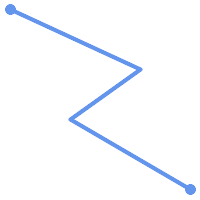 (a) |  (b) |
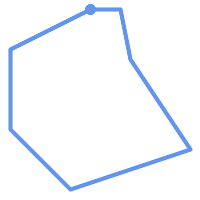 (c) |  (d) |
Un MULTILINESTRING est simple uniquement si tous ses éléments sont simples et si la seule intersection entre deux éléments quelconques se produit en des points situés sur les limites des deux éléments.
(e) et (f) sont de simples |
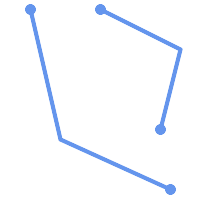 (e) | 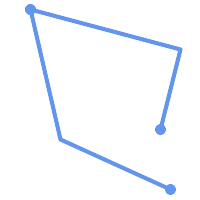 (f) |  (g) |
Les POLYGON sont formés à partir d'anneaux linéaires, de sorte que la géométrie polygonale valide est toujours simple.
Pour tester si une géométrie est simple, utilisez la fonction ST_IsSimple :
SELECT
ST_IsSimple('LINESTRING(0 0, 100 100)') AS straight,
ST_IsSimple('LINESTRING(0 0, 100 100, 100 0, 0 100)') AS crossing;
straight | crossing
----------+----------
t | f
En général, les fonctions PostGIS n'exigent pas que les arguments géométriques soient simples. La simplicité est principalement utilisée comme base pour définir la validité géométrique. C'est également une exigence pour certains types de modèles de données spatiales (par exemple, les réseaux linéaires interdisent souvent les lignes qui se croisent). La géométrie multipoint et linéaire peut être rendue simple en utilisant ST_UnaryUnion.
4.4.2. Géométrie valide
La validité géométrique s'applique principalement aux géométries bidimensionnelles (POLYGONs et MULTIPOLYGONs). La validité est définie par des règles qui permettent à la géométrie polygonale de modéliser des zones planes sans ambiguïté.
Un POLYGON est valide si :
les anneaux de délimitation du polygone (l'anneau extérieur de la coquille et les anneaux intérieurs des trous) sont simples (ils ne se croisent pas et ne se touchent pas). Pour cette raison, un polygone ne peut pas avoir de lignes de coupe, de pointes ou de boucles. Cela implique que les trous des polygones doivent être représentés par des anneaux intérieurs, plutôt que par l'anneau extérieur qui se touche (ce qu'on appelle un "trou inversé").
les anneaux de délimitation ne se croisent pas
Les anneaux de délimitation peuvent se toucher en certains points, mais uniquement sous la forme d'une tangente (c'est-à-dire pas sous la forme d'une ligne)
les anneaux intérieurs sont contenus dans l'anneau extérieur
l'intérieur du polygone est simplement connecté (c'est-à-dire que les anneaux ne doivent pas se toucher d'une manière qui divise le polygone en plus d'une partie)
(h) et (i) sont des |
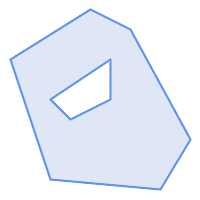 (h) | 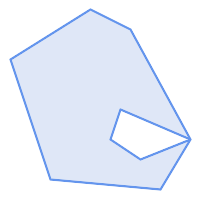 (i) | 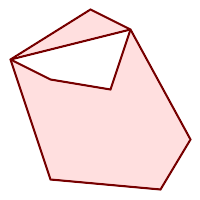 (j) |
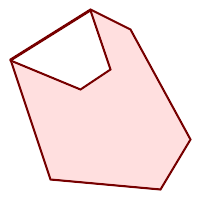 (k) | 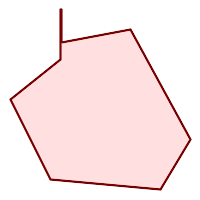 (l) | 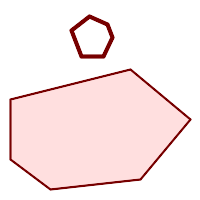 (m) |
Un MULTIPOLYGON est valide si :
ses éléments
POLYGONsont validesles éléments ne se chevauchent pas (c'est-à-dire que leurs intérieurs ne doivent pas se croiser)
les éléments ne se touchent que par des points (c'est-à-dire pas le long d'une ligne)
(n) est un |
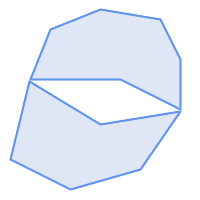 (n) | 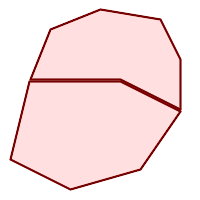 (o) | 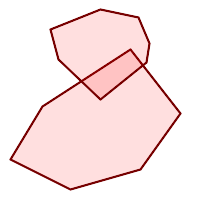 (p) |
Ces règles signifient que la géométrie polygonale valide est également simple.
Pour la géométrie linéaire, la seule règle de validité est que les LINESTRING doivent avoir au moins deux points et une longueur non nulle (ou, de façon équivalente, au moins deux points distincts).
SELECT
ST_IsValid('LINESTRING(0 0, 1 1)') AS len_nonzero,
ST_IsValid('LINESTRING(0 0, 0 0, 0 0)') AS len_zero,
ST_IsValid('LINESTRING(10 10, 150 150, 180 50, 20 130)') AS self_int;
len_nonzero | len_zero | self_int
-------------+----------+----------
t | f | t
Les géométries POINT et MULTIPOINT n'ont pas de règles de validité.
4.4.3. Gestion de la validité
PostGIS permet de créer et de stocker des géométries valides et non valides. Cela permet de détecter les géométries non valides et de les signaler ou de les corriger. Il existe également des situations où les règles de validité de l'OGC sont plus strictes que souhaité (par exemple, les lignes de longueur nulle et les polygones avec des trous inversés.)
De nombreuses fonctions fournies par PostGIS reposent sur l'hypothèse que les arguments géométriques sont valides. Par exemple, il n'est pas logique de calculer la surface d'un polygone dont le trou est défini à l'extérieur du polygone, ou de construire un polygone à partir d'une ligne de démarcation non simple. Le fait de supposer que les entrées géométriques sont valides permet aux fonctions de fonctionner plus efficacement, puisqu'elles n'ont pas besoin de vérifier l'exactitude topologique. (Les exceptions notables sont que les lignes de longueur nulle et les polygones avec des inversions sont généralement traités correctement). En outre, la plupart des fonctions PostGIS produisent une géométrie valide si les données d'entrée sont valides. Cela permet d'enchaîner les fonctions PostGIS en toute sécurité.
Si vous rencontrez des messages d'erreur inattendus lors de l'appel de fonctions PostGIS (tels que "GEOS Intersection() threw an error !"), vous devez d'abord vous assurer que les arguments de la fonction sont valides. Si ce n'est pas le cas, envisagez d'utiliser l'une des techniques ci-dessous pour vous assurer que les données que vous traitez sont valides.
![[Note]](images/note.png) | |
Si une fonction signale une erreur avec des entrées valides, il se peut que vous ayez trouvé une erreur dans PostGIS ou dans l'une des bibliothèques qu'il utilise, et vous devez le signaler au projet PostGIS. Il en va de même si une fonction PostGIS renvoie une géométrie non valide pour des données d'entrée valides. |
Pour vérifier si une géométrie est valide, utilisez la fonction ST_IsValid :
SELECT ST_IsValid('POLYGON ((20 180, 180 180, 180 20, 20 20, 20 180))');
-----------------
t
Les informations relatives à la nature et à la localisation d'une invalidité géométrique sont fournies par la fonction ST_IsValidDetail :
SELECT valid, reason, ST_AsText(location) AS location
FROM ST_IsValidDetail('POLYGON ((20 20, 120 190, 50 190, 170 50, 20 20))') AS t;
valid | reason | location
-------+-------------------+---------------------------------------------
f | Self-intersection | POINT(91.51162790697674 141.56976744186045)
Dans certaines situations, il est souhaitable de corriger automatiquement la géométrie non valide. Utilisez la fonction ST_MakeValid pour cela. (ST_MakeValid est un exemple de fonction spatiale qui doit permettre une entrée non valide !)
Par défaut, PostGIS ne vérifie pas la validité lors du chargement de la géométrie, car les tests de validité peuvent prendre beaucoup de temps CPU pour les géométries complexes. Si vous ne faites pas confiance à vos sources de données, vous pouvez imposer un contrôle de validité à vos tables en ajoutant une contrainte de contrôle :
ALTER TABLE mytable
ADD CONSTRAINT geometry_valid_check
CHECK (ST_IsValid(geom));4.5. Systèmes de référence spatiale
Un système de référence spatiale (SRS) (également appelé système de référence des coordonnées (SRC)) définit la manière dont la géométrie est référencée par rapport à des emplacements sur la surface de la Terre. Il existe trois types de SRS :
Un SRS géodésique utilise des coordonnées angulaires (longitude et latitude) qui correspondent directement à la surface de la terre.
Un SRS projeté utilise une transformation mathématique de projection pour "aplatir" la surface de la terre sphéroïdale sur un plan. Il attribue des coordonnées de localisation d'une manière qui permet de mesurer directement des quantités telles que la distance, la surface et l'angle. Le système de coordonnées est cartésien, ce qui signifie qu'il a un point d'origine défini et deux axes perpendiculaires (généralement orientés vers le nord et l'est). Chaque SRS projeté utilise une unité de longueur définie (généralement des mètres ou des pieds). Un SRS projeté peut être limité dans sa zone d'applicabilité afin d'éviter toute distorsion et de s'inscrire dans les limites des coordonnées définies.
Un SRS local est un système de coordonnées cartésiennes qui n'est pas référencé à la surface de la terre. Dans PostGIS, ce système est spécifié par une valeur SRID de 0.
Il existe de nombreux systèmes de référence spatiale différents. Les SRS courants sont normalisés dans la base de données de l'European Petroleum Survey Group EPSG database. Par commodité, PostGIS (et de nombreux autres systèmes spatiaux) se réfère aux définitions des SRS à l'aide d'un identifiant entier appelé SRID.
Une géométrie est associée à un système de référence spatiale par sa valeur SRID, à laquelle on accède par ST_SRID. Le SRID d'une géométrie peut être assigné en utilisant ST_SetSRID. Certaines fonctions de construction de géométrie permettent de fournir un SRID (telles que ST_Point et ST_MakeEnvelope). Le format EWKT prend en charge les SRID avec le préfixe SRID=n;.
Les fonctions spatiales qui traitent des paires de géométries (telles que les fonctions overlay et relationship) exigent que les géométries d'entrée soient dans le même système de référence spatiale (qu'elles aient le même SRID). Les données géométriques peuvent être transformées dans un système de référence spatiale différent en utilisant ST_Transform et ST_TransformPipeline. Les géométries renvoyées par les fonctions ont le même SRS que les géométries d'entrée.
4.5.1. Table SPATIAL_REF_SYS
La table SPATIAL_REF_SYS utilisée par PostGIS est une table de base de données conforme à l'OGC qui définit les systèmes de référence spatiale disponibles. Elle contient les SRID numériques et les descriptions textuelles des systèmes de coordonnées.
La définition de la table spatial_ref_sys est la suivante :
CREATE TABLE spatial_ref_sys ( srid INTEGER NOT NULL PRIMARY KEY, auth_name VARCHAR(256), auth_srid INTEGER, srtext VARCHAR(2048), proj4text VARCHAR(2048) )
Les colonnes sont :
sridUn code entier qui identifie de manière unique le Système de référence spatiale (SRS) dans la base de données.
auth_nameLe nom de la norme ou de l'organisme de normalisation qui est cité pour ce système de référence. Par exemple, "EPSG" est un
auth_namevalide.auth_sridL'ID du système de référence spatiale tel que défini par l'autorité citée dans le
auth_name. Dans le cas de l'EPSG, il s'agit du code EPSG.srtextReprésentation Well-Known Text du système de référence spatiale. Un exemple de représentation WKT du SRS est le suivant :
PROJCS["NAD83 / UTM Zone 10N", GEOGCS["NAD83", DATUM["North_American_Datum_1983", SPHEROID["GRS 1980",6378137,298.257222101] ], PRIMEM["Greenwich",0], UNIT["degree",0.0174532925199433] ], PROJECTION["Transverse_Mercator"], PARAMETER["latitude_of_origin",0], PARAMETER["central_meridian",-123], PARAMETER["scale_factor",0.9996], PARAMETER["false_easting",500000], PARAMETER["false_northing",0], UNIT["metre",1] ]Pour une discussion sur le SRS WKT, voir la norme OGC Well-known text representation of coordinate reference systems.
proj4textPostGIS utilise la bibliothèque PROJ pour fournir des capacités de transformation de coordonnées. La colonne
proj4textcontient la chaîne de caractères de définition des coordonnées PROJ pour un SRID particulier. Par exemple :+proj=utm +zone=10 +ellps=clrk66 +datum=NAD27 +units=m
Pour plus d'informations, consultez le site web de PROJ. Le fichier
spatial_ref_sys.sqlcontient les définitionssrtextetproj4textpour toutes les projections EPSG.
Lors de la récupération des définitions des systèmes de référence spatiale pour les utiliser dans les transformations, PostGIS utilise la stratégie suivante :
Si
auth_nameetauth_sridsont présents (non NULL), utiliser le PROJ SRS basé sur ces entrées (si au moins un existe).Si
srtextest présent, créez un SRS en l'utilisant, si possible.Si
proj4textest présent, créez un SRS en l'utilisant, si possible.
4.5.2. Systèmes de référence spatiale définis par l'utilisateur
La table PostGIS spatial_ref_sys contient plus de 3000 définitions des systèmes de référence spatiale les plus courants qui sont gérés par la bibliothèque de projection PROJ. Mais il existe de nombreux systèmes de coordonnées qu'elle ne contient pas. Vous pouvez ajouter des définitions de SRS à la table si vous disposez des informations requises sur le système de référence spatiale. Vous pouvez également définir votre propre système de référence spatiale personnalisé si vous êtes familiarisé avec les constructions PROJ. Gardez à l'esprit que la plupart des systèmes de référence spatiale sont régionaux et n'ont aucune signification lorsqu'ils sont utilisés en dehors des limites pour lesquelles ils ont été conçus.
Une ressource permettant de trouver des systèmes de référence spatiale non définis dans le jeu de base est http://spatialreference.org/
Les systèmes de référence spatiale les plus couramment utilisés sont les suivants : 4326 - WGS 84 Long Lat, 4269 - NAD 83 Long Lat, 3395 - WGS 84 World Mercator, 2163 - US National Atlas Equal Area, et les 60 zones UTM WGS84. Les zones UTM sont parmi les plus idéales pour les mesures, mais elles ne couvrent que des régions de 6 degrés. (Pour déterminer la zone UTM à utiliser pour votre zone d'intérêt, voir la utmzone PostGIS plpgsql helper function.)
Les États américains utilisent des systèmes de référence spatiale State Plane (basés sur le mètre ou le pied) - il en existe généralement un ou deux par État. La plupart des systèmes basés sur le mètre se trouvent dans le jeu de base, mais de nombreux systèmes basés sur le pied ou créés par ESRI devront être copiés à partir de spatialreference.org.
Vous pouvez même définir des systèmes de coordonnées non terrestres, tels que Mars 2000 Ce système de coordonnées martien n'est pas planaire (il est en degrés sphéroïdaux), mais vous pouvez l'utiliser avec le type géographie pour obtenir des mesures de longueur et de proximité en mètres au lieu de degrés.
Voici un exemple de chargement d'un système de coordonnées personnalisé à l'aide d'un SRID non attribué et de la définition PROJ pour une projection Lambert conforme centrée sur les États-Unis :
INSERT INTO spatial_ref_sys (srid, proj4text) VALUES ( 990000, '+proj=lcc +lon_0=-95 +lat_0=25 +lat_1=25 +lat_2=25 +x_0=0 +y_0=0 +datum=WGS84 +units=m +no_defs' );
4.6. Tables spatiales
4.6.1. Créer une table spatiale
Vous pouvez créer une table pour stocker des données géométriques en utilisant l'instruction SQL CREATE TABLE avec une colonne de type geometry. L'exemple suivant crée une table avec une colonne géométrie stockant des chaînes de lignes 2D (XY) dans le système de coordonnées BC-Albers (SRID 3005) :
CREATE TABLE roads (
id SERIAL PRIMARY KEY,
name VARCHAR(64),
geom geometry(LINESTRING,3005)
);Le type geometry prend en charge deux modificateurs de type facultatifs :
le modificateur de type spatial restreint le type de formes et de dimensions autorisées dans la colonne. La valeur peut être l'un des sous-types de géométrie pris en charge (par exemple POINT, LINESTRING, POLYGON, MULTIPOINT, MULTILINESTRING, MULTIPOLYGON, GEOMETRYCOLLECTION, etc). Le modificateur prend en charge les restrictions de dimensionnalité des coordonnées en ajoutant des suffixes : Z, M et ZM. Par exemple, le modificateur "LINESTRINGM" n'autorise que les lignes à trois dimensions et traite la troisième dimension comme une mesure. De même, "POINTZM" requiert des données à quatre dimensions (XYZM).
le modificateur SRID limite le système de référence spatiale SRID à un nombre particulier. S'il est omis, le SRID prend par défaut la valeur 0.
Exemples de création de tableaux avec des colonnes géométriques :
Créer une table contenant n'importe quel type de géométrie avec le SRID par défaut :
CREATE TABLE geoms(gid serial PRIMARY KEY, geom geometry );
Créer une table avec une géométrie POINT 2D avec le SRID par défaut :
CREATE TABLE pts(gid serial PRIMARY KEY, geom geometry(POINT) );
Créer une table avec des POINTS 3D (XYZ) et un SRID explicite de 3005 :
CREATE TABLE pts(gid serial PRIMARY KEY, geom geometry(POINTZ,3005) );
Créer une table avec une géométrie 4D (XYZM) LINESTRING avec le SRID par défaut :
CREATE TABLE lines(gid serial PRIMARY KEY, geom geometry(LINESTRINGZM) );
Créer une table avec une géométrie POLYGON 2D avec le SRID 4267 (NAD 1927 long lat) :
CREATE TABLE polys(gid serial PRIMARY KEY, geom geometry(POLYGON,4267) );
Il est possible d'avoir plus d'une colonne de géométrie dans une table. Cela peut être spécifié lors de la création de la table, ou une colonne peut être ajoutée à l'aide de l'instruction SQL ALTER TABLE. Cet exemple ajoute une colonne qui peut contenir des LineStrings 3D :
ALTER TABLE roads ADD COLUMN geom2 geometry(LINESTRINGZ,4326);
4.6.2. Vue GEOMETRY_COLUMNS
L'OGC Simple Features Specification for SQL définit la table de métadonnées GEOMETRY_COLUMNS pour décrire la structure de la table géométrique. Dans PostGIS, geometry_columns est une vue qui lit les tables de catalogue du système de base de données. Cela garantit que les informations de métadonnées spatiales sont toujours cohérentes avec les tables et les vues actuellement définies. La structure de la vue est la suivante :
\d geometry_columns
View "public.geometry_columns"
Column | Type | Modifiers
-------------------+------------------------+-----------
f_table_catalog | character varying(256) |
f_table_schema | character varying(256) |
f_table_name | character varying(256) |
f_geometry_column | character varying(256) |
coord_dimension | integer |
srid | integer |
type | character varying(30) |Les colonnes sont :
f_table_catalog, f_table_schema, f_table_nameLe nom complet de la table d'entités contenant la colonne géométrie. Il n'y a pas d'analogue PostgreSQL de "catalog", cette colonne est donc laissée vide. Pour "schema", le nom du schéma PostgreSQL est utilisé (
publicest la valeur par défaut).f_geometry_columnLe nom de la colonne géométrique dans la table des caractéristiques.
coord_dimensionLa dimension des coordonnées (2, 3 ou 4) de la colonne.
sridL'ID du système de référence spatiale utilisé pour la géométrie des coordonnées dans cette table. Il s'agit d'une référence de clé étrangère à la table
spatial_ref_sys(voir Section 4.5.1, “Table SPATIAL_REF_SYS”).typeLe type de l'objet spatial. Pour limiter la colonne spatiale à un seul type, utilisez l'une des options suivantes : POINT, LINESTRING, POLYGON, MULTIPOINT, MULTILINESTRING, MULTIPOLYGON, GEOMETRYCOLLECTION ou les versions XYM correspondantes POINTM, LINESTRINGM, POLYGONM, MULTIPOINTM, MULTILINESTRINGM, MULTIPOLYGONM, GEOMETRYCOLLECTIONM. Pour les collections hétérogènes (de type mixte), vous pouvez utiliser "GEOMETRY" comme type.
4.6.3. Enregistrement manuel des colonnes de géométrie
Deux des cas où vous pouvez avoir besoin de cela sont les cas de vues SQL et les insertions en masse. Dans le cas des insertions en masse, vous pouvez corriger l'enregistrement dans la table geometry_columns en contraignant la colonne ou en effectuant une modification de la table. Pour les vues, vous pouvez exposer en utilisant une opération CAST. Notez que si votre colonne est basée sur un typmod, le processus de création l'enregistrera correctement, il n'est donc pas nécessaire de faire quoi que ce soit. De même, les vues qui n'ont pas de fonction spatiale appliquée à la géométrie s'enregistreront de la même manière que la colonne géométrique de la table sous-jacente.
-- Lets say you have a view created like this
CREATE VIEW public.vwmytablemercator AS
SELECT gid, ST_Transform(geom, 3395) As geom, f_name
FROM public.mytable;
-- For it to register correctly
-- You need to cast the geometry
--
DROP VIEW public.vwmytablemercator;
CREATE VIEW public.vwmytablemercator AS
SELECT gid, ST_Transform(geom, 3395)::geometry(Geometry, 3395) As geom, f_name
FROM public.mytable;
-- If you know the geometry type for sure is a 2D POLYGON then you could do
DROP VIEW public.vwmytablemercator;
CREATE VIEW public.vwmytablemercator AS
SELECT gid, ST_Transform(geom,3395)::geometry(Polygon, 3395) As geom, f_name
FROM public.mytable;--Lets say you created a derivative table by doing a bulk insert
SELECT poi.gid, poi.geom, citybounds.city_name
INTO myschema.my_special_pois
FROM poi INNER JOIN citybounds ON ST_Intersects(citybounds.geom, poi.geom);
-- Create 2D index on new table
CREATE INDEX idx_myschema_myspecialpois_geom_gist
ON myschema.my_special_pois USING gist(geom);
-- If your points are 3D points or 3M points,
-- then you might want to create an nd index instead of a 2D index
CREATE INDEX my_special_pois_geom_gist_nd
ON my_special_pois USING gist(geom gist_geometry_ops_nd);
-- To manually register this new table's geometry column in geometry_columns.
-- Note it will also change the underlying structure of the table to
-- to make the column typmod based.
SELECT populate_geometry_columns('myschema.my_special_pois'::regclass);
-- To retain the constraint-based definition behavior
-- (such as case of inherited tables where all children do not have the same type and srid)
-- set optional use_typmod argument to false
SELECT populate_geometry_columns('myschema.my_special_pois'::regclass, false); Bien que l'ancienne méthode basée sur les contraintes soit toujours supportée, une colonne géométrique basée sur les contraintes utilisée directement dans une vue ne s'enregistrera pas correctement dans geometry_columns, tout comme une colonne typmod. Dans cet exemple, nous définissons une colonne à l'aide de typmod et une autre à l'aide de contraintes.
CREATE TABLE pois_ny(gid SERIAL PRIMARY KEY, poi_name text, cat text, geom geometry(POINT,4326));
SELECT AddGeometryColumn('pois_ny', 'geom_2160', 2160, 'POINT', 2, false);Si nous exécutons dans psql
\d pois_ny;
Nous observons qu'ils sont définis différemment - l'un est un typmod, l'autre une contrainte
Table "public.pois_ny"
Column | Type | Modifiers
-----------+-----------------------+------------------------------------------------------
gid | integer | not null default nextval('pois_ny_gid_seq'::regclass)
poi_name | text |
cat | character varying(20) |
geom | geometry(Point,4326) |
geom_2160 | geometry |
Indexes:
"pois_ny_pkey" PRIMARY KEY, btree (gid)
Check constraints:
"enforce_dims_geom_2160" CHECK (st_ndims(geom_2160) = 2)
"enforce_geotype_geom_2160" CHECK (geometrytype(geom_2160) = 'POINT'::text
OR geom_2160 IS NULL)
"enforce_srid_geom_2160" CHECK (st_srid(geom_2160) = 2160)Dans geometry_columns, les deux s'enregistrent correctement
SELECT f_table_name, f_geometry_column, srid, type
FROM geometry_columns
WHERE f_table_name = 'pois_ny';f_table_name | f_geometry_column | srid | type -------------+-------------------+------+------- pois_ny | geom | 4326 | POINT pois_ny | geom_2160 | 2160 | POINT
Cependant, si nous devions créer une vue comme celle-ci
CREATE VIEW vw_pois_ny_parks AS
SELECT *
FROM pois_ny
WHERE cat='park';
SELECT f_table_name, f_geometry_column, srid, type
FROM geometry_columns
WHERE f_table_name = 'vw_pois_ny_parks';La colonne de la vue géométrique basée sur le modèle s'enregistre correctement, mais pas celle basée sur les contraintes.
f_table_name | f_geometry_column | srid | type ------------------+-------------------+------+---------- vw_pois_ny_parks | geom | 4326 | POINT vw_pois_ny_parks | geom_2160 | 0 | GEOMETRY
Cela pourrait changer dans les prochaines versions de PostGIS, mais pour l'instant, pour forcer la colonne de vue basée sur les contraintes à s'enregistrer correctement, vous devez procéder comme suit :
DROP VIEW vw_pois_ny_parks;
CREATE VIEW vw_pois_ny_parks AS
SELECT gid, poi_name, cat,
geom,
geom_2160::geometry(POINT,2160) As geom_2160
FROM pois_ny
WHERE cat = 'park';
SELECT f_table_name, f_geometry_column, srid, type
FROM geometry_columns
WHERE f_table_name = 'vw_pois_ny_parks';f_table_name | f_geometry_column | srid | type ------------------+-------------------+------+------- vw_pois_ny_parks | geom | 4326 | POINT vw_pois_ny_parks | geom_2160 | 2160 | POINT
4.7. Chargement des données spatiales
Une fois que vous avez créé une table spatiale, vous êtes prêt à charger des données spatiales dans la base de données. Il existe deux façons d'intégrer des données spatiales dans une base de données PostGIS/PostgreSQL : à l'aide d'instructions SQL formatées ou à l'aide de l'utilitaire qui permet de charger des Shapefiles.
4.7.1. Utilisation de SQL pour charger des données
Si les données spatiales peuvent être converties en une représentation textuelle (WKT ou WKB), l'utilisation de SQL pourrait être le moyen le plus simple d'introduire les données dans PostGIS. Les données peuvent être chargées en masse dans PostGIS/PostgreSQL en chargeant un fichier texte d'instructions SQL INSERT à l'aide de l'utilitaire SQL psql.
Un fichier de chargement SQL (roads.sql par exemple) peut ressembler à ceci :
BEGIN; INSERT INTO roads (road_id, roads_geom, road_name) VALUES (1,'LINESTRING(191232 243118,191108 243242)','Jeff Rd'); INSERT INTO roads (road_id, roads_geom, road_name) VALUES (2,'LINESTRING(189141 244158,189265 244817)','Geordie Rd'); INSERT INTO roads (road_id, roads_geom, road_name) VALUES (3,'LINESTRING(192783 228138,192612 229814)','Paul St'); INSERT INTO roads (road_id, roads_geom, road_name) VALUES (4,'LINESTRING(189412 252431,189631 259122)','Graeme Ave'); INSERT INTO roads (road_id, roads_geom, road_name) VALUES (5,'LINESTRING(190131 224148,190871 228134)','Phil Tce'); INSERT INTO roads (road_id, roads_geom, road_name) VALUES (6,'LINESTRING(198231 263418,198213 268322)','Dave Cres'); COMMIT;
Le fichier SQL peut être chargé dans PostgreSQL en utilisant psql :
psql -d [database] -f roads.sql
4.7.2. Utilisation de l'utilitaire qui permet de charger des fichiers Shapefile
Le chargeur de données shp2pgsql convertit les Shapefiles en SQL pour les insérer dans une base de données PostGIS/PostgreSQL au format geometry ou geography. Le chargeur a plusieurs modes de fonctionnement sélectionnés par des indicateurs de ligne de commande.
Il existe également une interface graphique shp2pgsql-gui qui offre la plupart des options du chargeur en ligne de commande. Cette interface peut être plus facile à utiliser pour un chargement ponctuel sans script ou si vous êtes novice en matière de PostGIS. Il peut également être configuré comme un plugin pour PgAdminIII.
- (c|a|d|p) Ces options s'excluent mutuellement :
-cCrée une nouvelle table et la remplit à partir du fichier Shapefile. C'est le mode par défaut.
-aAjoute les données du fichier Shapefile dans la table de la base de données. Notez que pour utiliser cette option afin de charger plusieurs fichiers, les fichiers doivent avoir les mêmes attributs et les mêmes types de données.
-dSupprime la table de la base de données avant de créer une nouvelle table avec les données du fichier Shapefile.
-pProduit uniquement le code SQL de création de la table, sans ajouter de données réelles. Cette option peut être utilisée si vous souhaitez séparer complètement les étapes de création de la table et de chargement des données.
-?Afficher l'écran d'aide.
-DUtilise le format "dump" de PostgreSQL pour les données de sortie. Ce format peut être combiné avec -a, -c et -d. Il est beaucoup plus rapide à charger que le format SQL "insert" par défaut. Utilisez-le pour les très grands ensembles de données.
-s [<FROM_SRID>:]<SRID>Crée et remplit les tables de géométrie avec le SRID spécifié. Il est possible de spécifier que le fichier de forme d'entrée utilise le FROM_SRID donné, auquel cas les géométries seront reprojetées dans le SRID cible.
-kConserver la casse des identifiants (colonne, schéma et attributs). Notez que les attributs dans Shapefile sont tous en majuscules.
-iContraindre tous les entiers à des entiers 32 bits standard, ne pas créer de bigints 64 bits, même si la signature de l'en-tête DBF semble le justifier.
-ICréer un index GiST sur la colonne géométrie.
-m-m
nom_de_fichierSpécifier un fichier contenant un ensemble de correspondances entre les noms de colonnes (longs) et les noms de colonnes DBF à 10 caractères. Le contenu du fichier est une ou plusieurs lignes de deux noms séparées par un espace blanc, sans espace de départ ni de fin. Par exemple :COLUMNNAME DBFFIELD1 AVERYLONGCOLUMNNAME DBFFIELD2
-SGénère des géométries simples au lieu de géométries MULTI. Ne réussira que si toutes les géométries sont en fait simples (c'est-à-dire un MULTIPOLYGON avec une seule enveloppe, ou un MULTIPOINT avec un seul sommet).
-t <dimensionality>Force la géométrie de sortie à avoir la dimensionnalité spécifiée. Utilisez les chaînes de caractères suivantes pour indiquer la dimensionnalité : 2D, 3DZ, 3DM, 4D.
Si l'entrée a moins de dimensions que celles spécifiées, la sortie aura ces dimensions remplies avec des zéros. Si l'entrée a plus de dimensions que celles spécifiées, les dimensions non désirées seront supprimées.
-wSortie au format WKT, au lieu de WKB. Notez que cela peut introduire des dérives de coordonnées dues à la perte de précision.
-eExécuter chaque instruction séparément, sans utiliser de transaction. Cela permet de charger la majorité des bonnes données lorsqu'il y a quelques mauvaises géométries qui génèrent des erreurs. Notez que cela ne peut pas être utilisé avec l'option -D car le format "dump" utilise toujours une transaction.
-W <encoding>Spécifie l'encodage des données d'entrée (fichier dbf). Lorsqu'il est utilisé, tous les attributs du fichier dbf sont convertis en UTF8 à partir de l'encodage spécifié. La sortie SQL résultante contiendra une commande
SET CLIENT_ENCODING to UTF8, afin que le backend puisse reconvertir de UTF8 à n'importe quel encodage que la base de données est configurée pour utiliser en interne.-N <policy>Politique de gestion des géométries NULL (insert*, skip, abort)
-n-n Importer uniquement le fichier DBF. Si vos données n'ont pas de fichier de forme correspondant, il passera automatiquement à ce mode et ne chargera que le fichier DBF. Cette option n'est donc nécessaire que si vous disposez d'un fichier de forme complet et que vous ne voulez que les données d'attributs et pas de géométrie.
-GUtiliser le type geography au lieu de geometry (nécessite des données lon/lat) dans WGS84 long lat (SRID=4326)
-T <tablespace>Spécifiez le tablespace pour la nouvelle table. Les index utiliseront toujours le tablespace par défaut à moins que le paramètre -X ne soit également utilisé. La documentation de PostgreSQL contient une bonne description de l'utilisation des tablespaces personnalisés.
-X <tablespace>Spécifier le tablespace pour les index de la nouvelle table. Ceci s'applique à l'index de clé primaire et à l'index spatial GIST si -I est également utilisé.
-ZLorsqu'il est utilisé, cet indicateur empêche la génération des instructions
ANALYZE. Sans l'option -Z (comportement par défaut), les instructionsANALYZEseront générées.
Un exemple de session utilisant le chargeur pour créer un fichier d'entrée et le charger peut ressembler à ceci :
# shp2pgsql -c -D -s 4269 -i -I shaperoads.shp myschema.roadstable > roads.sql # psql -d roadsdb -f roads.sql
Une conversion et un chargement peuvent être effectués en une seule étape à l'aide de pipes UNIX :
# shp2pgsql shaperoads.shp myschema.roadstable | psql -d roadsdb
4.8. Extraction de données spatiales
Les données spatiales peuvent être extraites de la base de données à l'aide de SQL ou de Shapefile dumper. La section sur SQL présente certaines des fonctions disponibles pour effectuer des comparaisons et des requêtes sur les tables spatiales.
4.8.1. Utiliser SQL pour extraire des données
La manière la plus simple d'extraire des données spatiales de la base de données consiste à utiliser une requête SQL SELECT pour définir l'ensemble de données à extraire et à transférer les colonnes résultantes dans un fichier texte analysable :
db=# SELECT road_id, ST_AsText(road_geom) AS geom, road_name FROM roads;
road_id | geom | road_name
--------+-----------------------------------------+-----------
1 | LINESTRING(191232 243118,191108 243242) | Jeff Rd
2 | LINESTRING(189141 244158,189265 244817) | Geordie Rd
3 | LINESTRING(192783 228138,192612 229814) | Paul St
4 | LINESTRING(189412 252431,189631 259122) | Graeme Ave
5 | LINESTRING(190131 224148,190871 228134) | Phil Tce
6 | LINESTRING(198231 263418,198213 268322) | Dave Cres
7 | LINESTRING(218421 284121,224123 241231) | Chris Way
(6 rows)Il peut arriver qu'une restriction soit nécessaire pour réduire le nombre d'enregistrements renvoyés. Dans le cas de restrictions basées sur des attributs, utilisez la même syntaxe SQL que pour une table non spatiale. Dans le cas de restrictions spatiales, les fonctions suivantes sont utiles :
ST_IntersectsCette fonction indique si deux géométries partagent un espace.
=Cette fonction permet de vérifier si deux géométries sont géométriquement identiques. Par exemple, si 'POLYGON((0 0,1 1,1 0,0 0))' est identique à 'POLYGON((0 0,1 1,1 0,0 0))' (c'est le cas).
Vous pouvez ensuite utiliser ces opérateurs dans des requêtes. Notez que lorsque vous spécifiez des géométries et des box sur la ligne de commande SQL, vous devez explicitement transformer les représentations de chaînes de caractères en fonction géométrique. Le 312 est un système de référence spatiale fictif qui correspond à nos données. Ainsi, par exemple, le 312 est un système de référence spatiale fictif qui correspond à nos données :
SELECT road_id, road_name FROM roads WHERE roads_geom='SRID=312;LINESTRING(191232 243118,191108 243242)'::geometry;
La requête ci-dessus renverrait le seul enregistrement de la table "ROADS_GEOM" dont la géométrie est égale à cette valeur.
Vérifier si certaines routes passent dans la zone définie par un polygone :
SELECT road_id, road_name FROM roads WHERE ST_Intersects(roads_geom, 'SRID=312;POLYGON((...))');
La requête spatiale la plus courante sera probablement une requête "basée sur un cadre", utilisée par les logiciels clients, tels que les navigateurs de données et les cartographes web, pour saisir un "cadre de carte" d'une valeur de données pour l'affichage.
Lorsque vous utilisez l'opérateur "&&", vous pouvez spécifier soit une BOX3D comme élément de comparaison, soit une GEOMETRY. Toutefois, lorsque vous spécifiez une GEOMETRY, c'est sa boîte de délimitation qui sera utilisée pour la comparaison.
En utilisant un objet "BOX3D" pour le cadre, une telle requête se présente comme suit :
SELECT ST_AsText(roads_geom) AS geom FROM roads WHERE roads_geom && ST_MakeEnvelope(191232, 243117,191232, 243119,312);
Notez l'utilisation du SRID 312 pour spécifier la projection de l'enveloppe.
4.8.2. Utilisation de Shapefile Dumper
Le table dumper pgsql2shp se connecte à la base de données et convertit une table (éventuellement définie par une requête) en un fichier shape. La syntaxe de base est la suivante :
pgsql2shp [<options >] <database > [<schema >.]<table>
pgsql2shp [<options >] <database > <query>
Les options de la ligne de commande sont les suivantes :
-f <filename>Écriture de la sortie dans un fichier particulier.
-h <host>L'hôte de la base de données auquel se connecter.
-p <port>Le port auquel se connecter sur l'hôte de la base de données.
-P <password>Le mot de passe à utiliser lors de la connexion à la base de données.
-u <user>Le nom d'utilisateur à utiliser lors de la connexion à la base de données.
-g <geometry column>Dans le cas de tableaux comportant plusieurs colonnes géométriques, la colonne géométrique à utiliser lors de l'écriture du fichier de forme.
-bUtiliser un curseur binaire. L'opération sera plus rapide, mais ne fonctionnera pas si un attribut NON-geometry de la table n'est pas converti en texte.
-rMode brut. Ne pas supprimer le champ
gid, ni échapper les noms de colonnes.-m filenameRemapper les identifiants en noms de dix caractères. Le contenu du fichier est constitué de lignes de deux symboles séparées par un seul espace blanc, sans espace de départ ni de fin : VERYLONGSYMBOL SHORTONE ANOTHERYLONGSYMBOL SHORTER etc.
4.9. Index spatiaux
Les index spatiaux permettent d'utiliser une base de données spatiales pour de grands ensembles de données. Sans indexation, la recherche de caractéristiques nécessite un balayage séquentiel de chaque enregistrement de la base de données. L'indexation accélère la recherche en organisant les données dans une structure qui peut être rapidement parcourue pour trouver les enregistrements correspondants.
La méthode d'indexation B-tree couramment utilisée pour les données d'attributs n'est pas très utile pour les données spatiales, car elle ne permet de stocker et d'interroger les données que dans une seule dimension. Les données telles que la géométrie (qui a 2 dimensions ou plus) requièrent une méthode d'indexation qui supporte les requêtes sur toutes les dimensions des données. L'un des principaux avantages de PostgreSQL pour le traitement des données spatiales est qu'il offre plusieurs types de méthodes d'indexation qui fonctionnent bien pour les données multidimensionnelles : GiST, BRIN et SP-GiST.
Les index GiST (Generalized Search Tree) décomposent les données en "choses à côté", "choses qui se chevauchent", "choses qui sont à l'intérieur" et peuvent être utilisés sur un large éventail de types de données, y compris les données SIG. PostGIS utilise un index R-Tree implémenté au-dessus de GiST pour indexer les données spatiales. GiST est la méthode d'indexation spatiale la plus couramment utilisée et la plus polyvalente, et offre de très bonnes performances en matière de requêtes.
Les index BRIN (Block Range Index) fonctionnent en résumant l'étendue spatiale des plages d'enregistrements de la table. La recherche s'effectue par le biais d'un balayage des plages. L'index BRIN n'est approprié que pour certains types de données (triées dans l'espace, avec des mises à jour peu fréquentes ou inexistantes). Mais il permet une création d'index beaucoup plus rapide et une taille d'index beaucoup plus petite.
SP-GiST (Space-Partitioned Generalized Search Tree) est une méthode d'indexation générique qui prend en charge les arbres de recherche partitionnés tels que les arbres quadratiques, les arbres k-d et les arbres radix (tries).
Les index spatiaux ne stockent que la boîte de délimitation des géométries. Les requêtes spatiales utilisent l'index comme filtre primaire pour déterminer rapidement un ensemble de géométries correspondant potentiellement à la condition de la requête. La plupart des requêtes spatiales nécessitent un filtre secondaire qui utilise une fonction de prédicat spatial pour tester une condition spatiale plus spécifique. Pour plus d'informations sur les requêtes avec des prédicats spatiaux, voir Section 5.2, “Utilisation des index spatiaux”.
Voir également la section de l'atelier PostGIS sur les index spatiaux et le manuel de PostgreSQL.
4.9.1. Index GiST
GiST signifie "Generalized Search Tree" (arbre de recherche généralisé) et constitue une forme générique d'indexation pour les données multidimensionnelles. PostGIS utilise un index R-Tree implémenté au-dessus de GiST pour indexer les données spatiales. GiST est la méthode d'indexation spatiale la plus couramment utilisée et la plus polyvalente, et offre de très bonnes performances en matière de requêtes. D'autres implémentations de GiST sont utilisées pour accélérer les recherches sur toutes sortes de structures de données irrégulières (tableaux d'entiers, données spectrales, etc.) qui ne se prêtent pas à l'indexation B-Tree normale. Pour plus d'informations, voir le manuel PostgreSQL.
Dès qu'une table de données spatiales dépasse quelques milliers de lignes, vous devez créer un index pour accélérer les recherches spatiales dans les données (sauf si toutes vos recherches sont basées sur des attributs, auquel cas vous devez créer un index normal sur les champs d'attributs).
La syntaxe pour construire un index GiST sur une colonne "geometry" est la suivante :
CREATE INDEX [indexname] ON [tablename] USING GIST ( [geometryfield] );
La syntaxe ci-dessus permet toujours de créer un index 2D. Pour obtenir un index à n dimensions pour le type de géométrie, vous pouvez en créer un à l'aide de cette syntaxe :
CREATE INDEX [indexname] ON [tablename] USING GIST ([geometryfield] gist_geometry_ops_nd);
La construction d'un index spatial est un exercice de calcul intensif. Il bloque également l'accès en écriture à votre table pendant le temps de sa création, donc sur un système de production, vous voudrez peut-être le faire d'une manière plus lente, en tenant compte de la notion de CONCURRENCE :
CREATE INDEX CONCURRENTLY [indexname] ON [tablename] USING GIST ( [geometryfield] );
Après avoir construit un index, il est parfois utile de forcer PostgreSQL à collecter les statistiques de la table, qui sont utilisées pour optimiser les plans de requête :
VACUUM ANALYZE [table_name] [(column_name)];
4.9.2. Index BRIN
BRIN stands for "Block Range Index". It is a general-purpose index method provided by PostgreSQL. BRIN is a lossy index method, meaning that a secondary check is required to confirm that a record matches a given search condition (which is the case for all provided spatial indexes). It provides much faster index creation and much smaller index size, with reasonable read performance. Its primary purpose is to support indexing very large tables on columns which have a correlation with their physical location within the table. In addition to spatial indexing, BRIN can speed up searches on various kinds of attribute data structures (integer, arrays etc). For more information see the PostgreSQL manual.
Dès qu'une table spatiale dépasse quelques milliers de lignes, vous voudrez construire un index pour accélérer les recherches spatiales dans les données. Les index GiST sont très performants tant que leur taille ne dépasse pas la quantité de mémoire vive disponible pour la base de données, et tant que vous pouvez vous permettre la taille de stockage de l'index et le coût de la mise à jour de l'index en écriture. Sinon, pour les très grandes tables, l'index BRIN peut être considéré comme une alternative.
Un index BRIN stocke la boîte englobant toutes les géométries contenues dans les lignes d'un ensemble contigu de blocs de table, appelé plage de blocs. Lors de l'exécution d'une requête à l'aide de l'index, les plages de blocs sont examinées pour trouver celles qui recoupent l'étendue de la requête. Cette méthode n'est efficace que si les données sont physiquement ordonnées de manière à ce que les zones de délimitation des plages de blocs se chevauchent le moins possible (et, dans l'idéal, s'excluent mutuellement). L'index qui en résulte est de très petite taille, mais il est généralement moins performant en lecture qu'un index GiST sur les mêmes données.
La construction d'un index BRIN est beaucoup moins gourmande en ressources CPU que la construction d'un index GiST. Il est courant de constater qu'un index BRIN est dix fois plus rapide à construire qu'un index GiST pour les mêmes données. Et comme un index BRIN ne stocke qu'une seule boîte englobante pour chaque plage de blocs de table, il est courant d'utiliser jusqu'à mille fois moins d'espace disque qu'un index GiST.
Vous pouvez choisir le nombre de blocs à résumer dans une plage. Si vous diminuez ce nombre, l'index sera plus volumineux mais offrira probablement de meilleures performances.
Pour que le BRIN soit efficace, les données de la table doivent être stockées dans un ordre physique qui minimise le chevauchement de l'étendue du bloc. Il se peut que les données soient déjà triées de manière appropriée (par exemple, si elles sont chargées à partir d'un autre jeu de données déjà trié dans l'ordre spatial). Dans le cas contraire, il est possible de trier les données en fonction d'une clé spatiale unidimensionnelle. Une façon de procéder consiste à créer une nouvelle table triée par les valeurs géométriques (qui, dans les versions récentes de PostGIS, utilisent un classement efficace par courbe de Hilbert) :
CREATE TABLE table_sorted AS SELECT * FROM table ORDER BY geom;
Il est également possible de trier les données en place en utilisant un GeoHash comme index (temporaire) et en effectuant un regroupement sur cet index :
CREATE INDEX idx_temp_geohash ON table
USING btree (ST_GeoHash( ST_Transform( geom, 4326 ), 20));
CLUSTER table USING idx_temp_geohash;
La syntaxe pour construire un index BRIN sur une colonne geometry est la suivante :
CREATE INDEX [indexname] ON [tablename] USING BRIN ( [geome_col] );
La syntaxe ci-dessus permet de créer un index en 2D. Pour construire un index à trois dimensions, utilisez la syntaxe suivante :
CREATE INDEX [indexname] ON [tablename]
USING BRIN ([geome_col] brin_geometry_inclusion_ops_3d);Vous pouvez également obtenir un index quadridimensionnel à l'aide de la classe d'opérateurs 4D :
CREATE INDEX [indexname] ON [tablename]
USING BRIN ([geome_col] brin_geometry_inclusion_ops_4d);Les commandes ci-dessus utilisent le nombre par défaut de blocs dans une plage, qui est de 128. Pour spécifier le nombre de blocs à résumer dans une plage, utilisez la syntaxe suivante
CREATE INDEX [indexname] ON [tablename]
USING BRIN ( [geome_col] ) WITH (pages_per_range = [number]); Gardez à l'esprit qu'un index BRIN ne stocke qu'une entrée d'index pour un grand nombre de lignes. Si votre table stocke des géométries avec un nombre variable de dimensions, il est probable que l'index qui en résultera sera peu performant. Vous pouvez éviter cette pénalité de performance en choisissant la classe d'opérateur avec le plus petit nombre de dimensions des géométries stockées
Le type de données geography est pris en charge pour l'indexation BRIN. La syntaxe pour construire un index BRIN sur une colonne géographique est la suivante :
CREATE INDEX [indexname] ON [tablename] USING BRIN ( [geog_col] );
La syntaxe ci-dessus permet de créer un index 2D pour les objets géospatiaux sur le sphéroïde.
Actuellement, seul le "support d'inclusion" est fourni, ce qui signifie que seuls les opérateurs &&, ~ et @ peuvent être utilisés pour les cas 2D (à la fois pour geometry et geography), et seulement l'opérateur &&& pour les géométries 3D. Il n'y a actuellement pas de support pour les recherches kNN.
Une différence importante entre BRIN et les autres types d'index est que la base de données ne maintient pas l'index de manière dynamique. Les modifications apportées aux données spatiales de la table sont simplement ajoutées à la fin de l'index. Cela entraîne une dégradation des performances de recherche de l'index au fil du temps. L'index peut être mis à jour en effectuant un VACUUM, ou en utilisant une fonction spéciale brin_summarize_new_values(regclass). C'est la raison pour laquelle BRIN peut être plus approprié pour les données qui sont en lecture seule ou qui ne changent que rarement. Pour plus d'informations, consultez le manuel.
En résumé, l'utilisation de BRIN pour les données spatiales :
Le temps de construction de l'index est très rapide et la taille de l'index est très réduite.
Le temps d'interrogation de l'index est plus lent que celui de GiST, mais reste très acceptable.
Nécessite que les données du tableau soient triées dans un ordre spatial.
Nécessite une maintenance manuelle de l'index.
Plus approprié pour les tables de très grande taille, avec peu ou pas de chevauchement (par exemple des points), qui sont statiques ou qui changent peu souvent.
Plus efficace pour les requêtes qui renvoient un nombre relativement important d'enregistrements de données.
4.9.3. Index SP-GiST
SP-GiST signifie "Space-Partitioned Generalized Search Tree" et est une forme générique d'indexation pour les types de données multidimensionnelles qui prend en charge les arbres de recherche partitionnés, tels que les arbres quadratiques, les arbres k-d et les arbres radix (tries). La caractéristique commune de ces structures de données est qu'elles divisent de manière répétée l'espace de recherche en partitions qui ne sont pas nécessairement de taille égale. Outre l'indexation spatiale, SP-GiST est utilisé pour accélérer les recherches sur de nombreux types de données, telles que le routage téléphonique, le routage ip, la recherche de substrats, etc. Pour plus d'informations, voir le manuel PostgreSQL.
Comme pour les index GiST, les index SP-GiST sont avec perte, dans le sens où ils stockent la boîte englobante qui entoure les objets spatiaux. Les index SP-GiST peuvent être considérés comme une alternative aux index GiST.
Lorsqu'une table de données SIG dépasse quelques milliers de lignes, un index SP-GiST peut être utilisé pour accélérer les recherches spatiales dans les données. La syntaxe pour construire un index SP-GiST sur une colonne "géométrie" est la suivante :
CREATE INDEX [indexname] ON [tablename] USING SPGIST ( [geometryfield] );
La syntaxe ci-dessus permet de créer un index bidimensionnel. Un index tridimensionnel pour le type de géométrie peut être créé à l'aide de la classe d'opérateurs 3D :
CREATE INDEX [indexname] ON [tablename] USING SPGIST ([geometryfield] spgist_geometry_ops_3d);
La création d'un index spatial est une opération très gourmande en ressources informatiques. Elle bloque également l'accès en écriture à votre table pendant la durée de la création, donc sur un système de production, vous voudrez peut-être le faire d'une manière plus lente, en tenant compte de la notion de CONCURRENCE :
CREATE INDEX CONCURRENTLY [indexname] ON [tablename] USING SPGIST ( [geometryfield] );
Après avoir construit un index, il est parfois utile de forcer PostgreSQL à collecter les statistiques de la table, qui sont utilisées pour optimiser les plans de requête :
VACUUM ANALYZE [table_name] [(column_name)];
Un index SP-GiST peut accélérer les requêtes impliquant les opérateurs suivants :
<<, &<, &>, >>, <<|, &<|, |&>, |>>, &&, @>, <@, et ~=, pour les index à 2 dimensions,
&/&, ~==, @>>, et <<@, pour les index à 3 dimensions.
Il n'y a pas de support pour les recherches kNN pour le moment.
4.9.4. Optimisation de l'utilisation de l'index
Normalement, les index accélèrent de manière invisible l'accès aux données : une fois qu'un index est construit, le planificateur de requêtes de PostgreSQL décide automatiquement quand l'utiliser pour améliorer les performances de la requête. Mais dans certaines situations, le planificateur ne choisit pas d'utiliser les index existants, et les requêtes finissent par utiliser des balayages séquentiels lents au lieu d'un index spatial.
Si vous constatez que vos index spatiaux ne sont pas utilisés, il y a plusieurs choses que vous pouvez faire :
Examinez le plan de requête et vérifiez que votre requête calcule effectivement ce dont vous avez besoin. Un JOIN erroné, oublié ou vers la mauvaise table, peut récupérer plusieurs fois des enregistrements de la table de manière inattendue. Pour obtenir le plan de la requête, exécutez avec
EXPLAINdevant la requête.Assurez-vous que des statistiques sont collectées sur le nombre et la distribution des valeurs dans une table, afin de fournir au planificateur de requêtes de meilleures informations pour prendre des décisions concernant l'utilisation de l'index. La VACUUM ANALYZE calculera les deux.
Vous devriez de toute façon vacuum régulièrement vos bases de données. De nombreux administrateurs de bases de données PostgreSQL exécutent VACUUM en tant que tâche cron en dehors des heures de pointe sur une base régulière.
Si vacuum ne suffit pas, vous pouvez temporairement forcer le planificateur à utiliser les informations d'index en utilisant la commande SET ENABLE_SEQSCAN TO OFF;. De cette façon, vous pouvez vérifier si le planificateur est capable de générer un plan de requête accéléré par l'index pour votre requête. Vous ne devez utiliser cette commande qu'à des fins de débogage ; en règle générale, le planificateur sait mieux que vous quand utiliser les index. Une fois que vous avez exécuté votre requête, n'oubliez pas de lancer la commande SET ENABLE_SEQSCAN TO ON; afin que le planificateur fonctionne normalement pour les autres requêtes.
Si SET ENABLE_SEQSCAN TO OFF; aide votre requête à s'exécuter plus rapidement, votre Postgres n'est probablement pas adapté à votre matériel. Si vous trouvez que le planificateur se trompe sur le coût des balayages séquentiels par rapport aux balayages d'index, essayez de réduire la valeur de
RANDOM_PAGE_COSTdanspostgresql.conf, ou utilisez SET RANDOM_PAGE_COST TO 1.1;. La valeur par défaut deRANDOM_PAGE_COSTest 4.0. Essayez de la fixer à 1.1 (pour les disques SSD) ou à 2.0 (pour les disques magnétiques rapides). En diminuant la valeur, le planificateur est plus enclin à utiliser les balayages d'index.Si la SET ENABLE_SEQSCAN TO OFF; n'aide pas votre requête, il se peut qu'elle utilise une construction SQL que le planificateur Postgres n'est pas encore en mesure d'optimiser. Il peut être possible de réécrire la requête de manière à ce que le planificateur soit en mesure de la traiter. Par exemple, une sous-requête avec un SELECT en ligne peut ne pas produire un plan efficace, mais peut être réécrite en utilisant un JOIN LATERAL.
Pour plus d'informations, voir la section du manuel Postgres sur Query Planning.
Chapter 5. Requêtes spatiales
La raison d'être des bases de données spatiales est de réaliser à l'intérieur de la base de données des requêtes qui normalement nécessiteraient des fonctionnalités d'un SIG Desktop. Utiliser PostGIS requiert en effet la connaissance de quelles fonctions spatiales sont disponibles, comment les utiliser dans une requête, et de s'assurer de la mise en place adéquate des index, pour une bonne performance.
5.1. Déterminer les relations spatiales
Les relations spatiales indiquent comment deux géométries interagissent l'une avec l'autre. Elles constituent une fonctionnalité fondamentale pour effectuer des requêtes sur des géométries.
5.1.1. Modèle à 9 intersections dimensionnellement étendu
Selon le OpenGIS Simple Features Implementation Specification for SQL, "l'approche de base pour comparer deux géométries consiste à effectuer des tests par paire des intersections entre les intérieurs, les limites et les extérieurs des deux géométries et à classer la relation entre les deux géométries sur la base des entrées de la matrice "intersection" résultante."
Dans la théorie de la topologie des ensembles de points, les points d'une géométrie intégrée dans un espace à deux dimensions sont classés en trois ensembles :
- Limites
La limite d'une géométrie est l'ensemble des géométries de la dimension immédiatement inférieure. Pour les
POINT, qui ont une dimension de 0, la limite est l'ensemble vide. La limite d'uneLINESTRINGest constituée par ses deux extrémités. Pour lesPOLYGON, la limite est le réseau de lignes des anneaux extérieur et intérieur.- Intérieur
L'intérieur d'une géométrie est constitué des points de la géométrie qui ne se trouvent pas dans la limite. Pour les
POINT, l'intérieur est le point lui-même. L'intérieur d'uneLINESTRINGest l'ensemble des points situés entre les extrémités. Pour lesPOLYGON, l'intérieur est la surface aréale à l'intérieur du polygone.- Extérieur
L'extérieur d'une géométrie est le reste de l'espace dans lequel la géométrie est intégrée ; en d'autres termes, tous les points qui ne se trouvent pas à l'intérieur ou sur la limite de la géométrie. Il s'agit d'une surface non fermée à 2 dimensions.
Le Dimensionally Extended 9-Intersection Model (DE-9IM) décrit la relation spatiale entre deux géométries en spécifiant les dimensions des 9 intersections entre les ensembles ci-dessus pour chaque géométrie. Les dimensions des intersections peuvent être représentées formellement dans une matrice d'intersections de 3x3.
Pour une géométrie g, les Limites, Intérieures, et Extérieures sont désignés par la notation I(g), B(g), et E(g). En outre, dim(s) désigne la dimension d'un ensemble s dont le domaine est {0,1,2,F} :
0=> point1=> ligne2=> areaF=> ensemble vide
En utilisant cette notation, la matrice d'intersection pour deux géométries a et b est :
| Intérieur | Limite | Extérieur | |
|---|---|---|---|
| Intérieur | dim( I(a) ∩ I(b) ) | dim( I(a) ∩ B(b) ) | dim( I(a) ∩ E(b) ) |
| Limite | dim( B(a) ∩ I(b) ) | dim( B(a) ∩ B(b) ) | dim( B(a) ∩ E(b) ) |
| Extérieur | dim( E(a) ∩ I(b) ) | dim( E(a) ∩ B(b) ) | dim( E(a) ∩ E(b) ) |
Visuellement, pour deux géométries polygonales qui se chevauchent, cela ressemble à ce qui suit :
| ||||||||||||||||||
|
|
En lisant de gauche à droite et de haut en bas, la matrice d'intersection est représentée par la chaîne de texte "212101212".
Pour plus d'informations, voir :
5.1.2. Relations spatiales nommées
Pour faciliter la détermination des relations spatiales communes, l'OGC SFS définit un ensemble de prédicats de relations spatiales. PostGIS fournit ces prédicats sous la forme des fonctions ST_Contains, ST_Crosses, ST_Disjoint, ST_Equals, ST_Intersects, ST_Overlaps, ST_Touches, ST_Within. Il définit également les prédicats de relation non standard ST_Covers, ST_CoveredBy, et ST_ContainsProperly.
Les prédicats spatiaux sont généralement utilisés comme conditions dans les clauses SQL WHERE ou JOIN. Les prédicats spatiaux nommés utilisent automatiquement un index spatial s'il existe, de sorte qu'il n'est pas nécessaire d'utiliser également l'opérateur de boîte de délimitation &&. Par exemple :
SELECT city.name, state.name, city.geom FROM city JOIN state ON ST_Intersects(city.geom, state.geom);
Pour plus de détails et d'illustrations, voir l' Atelier PostGIS.
5.1.3. Relations spatiales générales
Dans certains cas, les relations spatiales nommées sont insuffisantes pour fournir une condition de filtrage spatial souhaitée.
 Prenons l'exemple d'un ensemble de données linéaires représentant un réseau routier. Il peut être nécessaire d'identifier tous les segments de route qui se croisent, non pas en un point, mais en une ligne (peut-être pour valider une règle commerciale). Dans ce cas, ST_Crosses ne fournit pas le filtre spatial nécessaire, puisque pour les caractéristiques linéaires, il renvoie Une solution en deux étapes consisterait à calculer d'abord l'intersection réelle (ST_Intersection) des paires de lignes routières qui se croisent dans l'espace (ST_Intersects), puis vérifier si le ST_GeometryType de l'intersection est " Il est évident qu'une solution plus simple et plus rapide est souhaitable. |
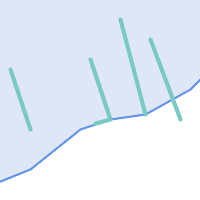 Un deuxième exemple est la localisation des quais qui coupent les limites d'un lac sur une ligne et dont l'une des extrémités se trouve sur le rivage. En d'autres termes, lorsqu'un quai est situé à l'intérieur d'un lac mais n'est pas complètement contenu par celui-ci, qu'il coupe la limite d'un lac sur une ligne et que l'une des extrémités du quai se trouve à l'intérieur ou sur la limite du lac. Il est possible d'utiliser une combinaison de prédicats spatiaux pour trouver les caractéristiques requises :
|
Ces exigences peuvent être satisfaites en calculant la matrice d'intersection DE-9IM complète. PostGIS fournit la fonction ST_Relate pour ce faire :
SELECT ST_Relate( 'LINESTRING (1 1, 5 5)',
'POLYGON ((3 3, 3 7, 7 7, 7 3, 3 3))' );
st_relate
-----------
1010F0212
Pour tester une relation spatiale particulière, un modèle de matrice d'intersection est utilisé. Il s'agit de la représentation matricielle augmentée des symboles supplémentaires {T,*} :
T=> la dimension d'intersection est non vide ; c'est-à-dire qu'elle se trouve dans{0,1,2}*=> indifférent
Les modèles de matrice d'intersection permettent d'évaluer des relations spatiales spécifiques de manière plus succincte. Les fonctions ST_Relate et ST_RelateMatch peuvent être utilisées pour tester les modèles de matrice d'intersection. Pour le premier exemple ci-dessus, le modèle de matrice d'intersection spécifiant deux lignes se croisant dans une ligne est '1*1***1**' :
-- Find road segments that intersect in a line
SELECT a.id
FROM roads a, roads b
WHERE a.id != b.id
AND a.geom && b.geom
AND ST_Relate(a.geom, b.geom, '1*1***1**');Pour le deuxième exemple, le modèle de matrice d'intersection spécifiant une ligne située en partie à l'intérieur et en partie à l'extérieur d'un polygone est "102101FF2" :
-- Find wharves partly on a lake's shoreline
SELECT a.lake_id, b.wharf_id
FROM lakes a, wharfs b
WHERE a.geom && b.geom
AND ST_Relate(a.geom, b.geom, '102101FF2');
5.2. Utilisation des index spatiaux
Lors de la construction de requêtes utilisant des conditions spatiales, il est important, pour de meilleures performances, de s'assurer qu'un index spatial est utilisé, s'il existe (voir Section 4.9, “Index spatiaux”). Pour ce faire, un opérateur spatial ou une fonction sensible à l'index doit être utilisé dans une clause WHERE ou ON de la requête.
Les opérateurs spatiaux comprennent les opérateurs de boîte de délimitation (dont le plus couramment utilisé est && ; voir Section 7.10.1, “Opérateurs de Bounding Box” pour la liste complète) et les opérateurs de distance utilisés dans les requêtes sur les plus proches voisins (le plus courant étant <-> ; voir Section 7.10.2, “Opérateurs de distance” pour la liste complète.)
Les fonctions tenant compte de l'index ajoutent automatiquement un opérateur de boîte de délimitation à la condition spatiale. Les fonctions tenant compte de l'index comprennent les prédicats de relation spatiale nommés ST_Contains, ST_ContainsProperly, ST_CoveredBy, ST_Covers, ST_Crosses, ST_Intersects, ST_Overlaps, ST_Touches, ST_Within, ST_Within, et ST_3DIntersects, et les prédicats de distance ST_DWithin, ST_DFullyWithin, ST_3DDFullyWithin, et ST_3DDWithin . )
Les fonctions telles que ST_Distance n'utilisent pas les index pour optimiser leur fonctionnement. Par exemple, la requête suivante serait assez lente sur une grande table :
SELECT geom FROM geom_table WHERE ST_Distance( geom, 'SRID=312;POINT(100000 200000)' ) < 100
Cette requête sélectionne toutes les géométries de la geom_table qui se trouvent à moins de 100 unités du point (100000, 200000). Elle sera lente car elle calcule la distance entre chaque point du tableau et le point spécifié, c'est-à-dire qu'un calcul ST_Distance() est effectué pour chaque ligne du tableau.
Le nombre de lignes traitées peut être considérablement réduit en utilisant la fonction d'indexation ST_DWithin :
SELECT geom FROM geom_table WHERE ST_DWithin( geom, 'SRID=312;POINT(100000 200000)', 100 )
Cette requête sélectionne les mêmes géométries, mais de manière plus efficace. Ceci est possible en ST_DWithin() utilisant l'opérateur && en interne sur une boîte de délimitation élargie de la géométrie de la requête. S'il existe un index spatial sur geom, le planificateur de requêtes reconnaîtra qu'il peut utiliser l'index pour réduire le nombre de lignes analysées avant de calculer la distance. L'index spatial permet d'extraire uniquement les enregistrements dont les boîtes de délimitation chevauchent l'étendue élargie et qui, par conséquent, pourraient se trouver à l'intérieur de la distance requise. La distance réelle est ensuite calculée pour confirmer l'inclusion de l'enregistrement dans l'ensemble des résultats.
Pour plus d'informations et d'exemples, voir l' atelier de travail PostGIS.
5.3. Exemples de SQL spatial
Les exemples de cette section utilisent une table de routes linéaires et une table de limites de communes polygonales. La définition de la table bc_roads est la suivante :
Column | Type | Description ----------+-------------------+------------------- gid | integer | Unique ID name | character varying | Road Name geom | geometry | Location Geometry (Linestring)
La définition de la table bc_municipality est la suivante :
Column | Type | Description ---------+-------------------+------------------- gid | integer | Unique ID code | integer | Unique ID name | character varying | City / Town Name geom | geometry | Location Geometry (Polygon)
- 5.3.1. Quelle est la longueur totale de toutes les routes, exprimée en kilomètres ?
- 5.3.2. Quelle est la superficie de la ville de Prince George, en hectares ?
- 5.3.3. Quelle est la plus grande municipalité de la province, en termes de superficie ?
- 5.3.4. Quelle est la longueur des routes entièrement comprises dans chaque municipalité ?
- 5.3.5. Créez un nouveau tableau avec toutes les routes de la ville de Prince George.
- 5.3.6. Quelle est la longueur en kilomètres de "Douglas St" à Victoria ?
- 5.3.7. Quel est le plus grand polygone municipal comportant un trou ?
5.3.1. | Quelle est la longueur totale de toutes les routes, exprimée en kilomètres ? |
Vous pouvez répondre à cette question à l'aide d'un code SQL très simple : SELECT sum(ST_Length(geom))/1000 AS km_roads FROM bc_roads; km_roads ------------------ 70842.1243039643 | |
5.3.2. | Quelle est la superficie de la ville de Prince George, en hectares ? |
Cette requête combine une condition d'attribut (sur le nom de la municipalité) avec un calcul spatial (de la surface du polygone) : SELECT ST_Area(geom)/10000 AS hectares FROM bc_municipality WHERE name = 'PRINCE GEORGE'; hectares ------------------ 32657.9103824927 | |
5.3.3. | Quelle est la plus grande municipalité de la province, en termes de superficie ? |
Cette requête utilise une mesure spatiale comme valeur de référence. Il existe plusieurs façons d'aborder ce problème, mais la plus efficace est la suivante : SELECT name, ST_Area(geom)/10000 AS hectares FROM bc_municipality ORDER BY hectares DESC LIMIT 1; name | hectares ---------------+----------------- TUMBLER RIDGE | 155020.02556131 Notez que pour répondre à cette question, nous devons calculer la surface de chaque polygone. Si nous faisions cela souvent, il serait logique d'ajouter une colonne de surface à la table qui pourrait être indexée pour des raisons de performance. En ordonnant les résultats dans une direction décroissante et en utilisant la commande "LIMIT" de PostgreSQL, nous pouvons facilement sélectionner la plus grande valeur sans utiliser une fonction d'agrégation comme MAX(). | |
5.3.4. | Quelle est la longueur des routes entièrement comprises dans chaque municipalité ? |
Il s'agit d'un exemple de "jointure spatiale", qui rassemble les données de deux tables (avec une jointure) en utilisant une interaction spatiale ("contenu") comme condition de jointure (plutôt que l'approche relationnelle habituelle de jointure sur une clé commune) : SELECT m.name, sum(ST_Length(r.geom))/1000 as roads_km FROM bc_roads AS r JOIN bc_municipality AS m ON ST_Contains(m.geom, r.geom) GROUP BY m.name ORDER BY roads_km; name | roads_km ----------------------------+------------------ SURREY | 1539.47553551242 VANCOUVER | 1450.33093486576 LANGLEY DISTRICT | 833.793392535662 BURNABY | 773.769091404338 PRINCE GEORGE | 694.37554369147 ... Cette requête prend un certain temps, car chaque route du tableau est résumée dans le résultat final (environ 250 000 routes pour le tableau de l'exemple). Pour des ensembles de données plus petits (plusieurs milliers d'enregistrements sur plusieurs centaines), la réponse peut être très rapide. | |
5.3.5. | Créez un nouveau tableau avec toutes les routes de la ville de Prince George. |
Il s'agit d'un exemple de "superposition", qui prend en compte deux tableaux et produit un nouveau tableau composé de résultats coupés dans l'espace. Contrairement à la "jointure spatiale" présentée ci-dessus, cette requête crée de nouvelles géométries. Une superposition est comme une jointure spatiale turbocompressée, et est utile pour des travaux d'analyse plus précis : CREATE TABLE pg_roads as SELECT ST_Intersection(r.geom, m.geom) AS intersection_geom, ST_Length(r.geom) AS rd_orig_length, r.* FROM bc_roads AS r JOIN bc_municipality AS m ON ST_Intersects(r.geom, m.geom) WHERE m.name = 'PRINCE GEORGE'; | |
5.3.6. | Quelle est la longueur en kilomètres de "Douglas St" à Victoria ? |
SELECT sum(ST_Length(r.geom))/1000 AS kilometers FROM bc_roads r JOIN bc_municipality m ON ST_Intersects(m.geom, r.geom WHERE r.name = 'Douglas St' AND m.name = 'VICTORIA'; kilometers ------------------ 4.89151904172838 | |
5.3.7. | Quel est le plus grand polygone municipal comportant un trou ? |
SELECT gid, name, ST_Area(geom) AS area FROM bc_municipality WHERE ST_NRings(geom) > 1 ORDER BY area DESC LIMIT 1; gid | name | area -----+--------------+------------------ 12 | SPALLUMCHEEN | 257374619.430216 |
Chapter 6. Conseils sur les performances
6.1. Petites tables de grandes géométries
6.1.1. Description du problème
Current PostgreSQL versions suffer from a query optimizer weakness regarding TOAST tables. TOAST tables are a kind of "extension room" used to store large (in the sense of data size) values that do not fit into normal data pages (like long texts, images or complex geometries with lots of vertices), see the PostgreSQL Documentation for TOAST for more information).
Le problème apparaît s'il vous arrive d'avoir une table avec d'assez grandes géométries, mais pas beaucoup de lignes d'entre elles (comme un tableau contenant les frontières de tous les pays européens en haute résolution). Ensuite, le tableau lui-même est petit, mais il utilise beaucoup d'espace TOAST. Dans notre exemple, le cas, la table elle-même avait environ 80 lignes et seulement 3 pages de données utilisées, mais la table TOAST 8225 pages utilisé.
Maintenant émettre une requête en utilisant l'opérateur de géométrie && pour rechercher une boîte englobante qui correspond que très peu de ces lignes. Maintenant l'optimiseur de requêtes voit que la table n'a que 3 pages et 80 lignes. Il estime qu'une analyse séquentielle sur une telle petite table est beaucoup plus rapide que d'utiliser un index. Et alors il décide d'ignorer l'index GIST. Habituellement, cette estimation est correcte. Mais dans notre cas, l'opérateur && doit aller chercher chaque géométrie à partir du disque pour comparer les boîtes englobantes, et par conséquent la lecture de toutes les pages TOAST également.
Pour voir si vous souffrez de ce problème, utilisez la commande postgresql "EXPLAIN ANALYZE". Pour plus d'informations et les détails techniques, vous pouvez lire le fil de discussion sur la liste de diffusion sur les performances de PostgreSQL : http://archives.postgresql.org/pgsql-performance/2005-02/msg00030.php
et un fil d'actualités plus récent sur PostGIS https://lists.osgeo.org/pipermail/postgis-devel/2017-June/026209.html
6.1.2. Solutions de contournement
Les personnes de PostgreSQL essayent de résoudre ce problème en faisant l'estimation de la requête TOAST-courant. Pour l'instant, voici deux solutions :
La première solution consiste à forcer le planificateur de requêtes à utiliser l'index. Envoyer "SET enable_seqscan TO off;" au serveur avant d'émettre la requête. Cela force le planificateur de requêtes à éviter balayages séquentiels lorsque cela est possible. Donc, il utilise l'index GIST comme d'habitude. Mais cet indicateur doit être fixé à chaque connexion, et il provoque le planificateur de requêtes à faire des erreurs d'estimation dans les autres cas, vous devrez donc faire "SET POUR enable_seqscan sur;" après la requête.
La deuxième solution consiste à faire le balayage séquentielle aussi vite que le planificateur de requêtes pense. Ceci peut être réalisé en créant une colonne supplémentaire qui "cache" la bbox, et contre cette correspondance. Dans notre exemple, les commandes sont comme :
SELECT AddGeometryColumn('myschema','mytable','bbox','4326','GEOMETRY','2');
UPDATE mytable SET bbox = ST_Envelope(ST_Force2D(geom));Modifiez maintenant votre requête pour utiliser l'opérateur && contre bbox au lieu de geom_column, comme suit :
SELECT geom_column
FROM mytable
WHERE bbox && ST_SetSRID('BOX3D(0 0,1 1)'::box3d,4326);
Bien sûr, si vous changez ou ajoutez des lignes à mytable, vous devez garder la bbox "synchro". La façon la plus transparente pour ce faire serait des déclencheurs, mais vous pouvez également modifier votre application afin de maintenir la colonne bbox courante ou exécuter la requête UPDATE ci-dessus après chaque modification.
6.2. CLUSTER d'index géométriques
Pour les tables qui sont pour la plupart en lecture seule, et où un seul index est utilisé pour la majorité des requêtes, PostgreSQL offre la commande CLUSTER. Cette commande réorganise physiquement toutes les lignes de données dans le même ordre que les critères de l'index, ce qui donne deux avantages de performance : d'abord, pour des analyses d'intervalle de l'index, le nombre de recherche sur la table de données est considérablement réduit. Deuxièmement, si votre jeu de travail se concentre à quelques petits intervalles sur les index, vous avez une mise en cache plus efficace parce que les lignes de données sont dispersées sur moins de pages de données. (N'hésitez pas à lire la documentation de la commande CLUSTER du manuel PostgreSQL à ce stade)
Cependant, PostgreSQL ne permet actuellement pas le clustering sur les index GIST de PostGIS car les indices GIST ignorent les valeurs NULL, vous obtenez un message d'erreur comme :
lwgeom=# CLUSTER my_geom_index ON my_table; ERROR: cannot cluster when index access method does not handle null values HINT: You may be able to work around this by marking column "geom" NOT NULL.
Comme le message d'ASTUCES vous le dit, on peut contourner cette lacune en ajoutant une contrainte "not null" à la table :
lwgeom=# ALTER TABLE my_table ALTER COLUMN geom SET not null; ALTER TABLE
Bien sûr, cela ne fonctionnera pas si vous avez besoin, dans les faits, de valeurs NULL dans la colonne de géométrie. En outre, vous devez utiliser la méthode ci-dessus pour ajouter la contrainte, en utilisant une contrainte CHECK comme "ALTER TABLE blubb ADD CHECK (geometry is not null)" ne fonctionnera pas.
6.3. Eviter les conversions de dimension
Il arrive parfois que vous ayez des données 3D ou 4D dans votre table, mais que vous y accédiez toujours à l'aide des fonctions ST_AsText() ou ST_AsBinary() conformes à OpenGIS qui ne produisent que des géométries 2D. Pour ce faire, elles appellent en interne la fonction ST_Force2D(), qui introduit une surcharge importante pour les géométries de grande taille. Pour éviter cette surcharge, il peut être possible de pré-déposer ces dimensions supplémentaires une fois pour toutes :
UPDATE mytable SET geom = ST_Force2D(geom); VACUUM FULL ANALYZE mytable;
Notez que si vous avez ajouté votre colonne de géométrie à l'aide AddGeometryColumn (), il y aura une contrainte sur la dimension de la géométrie. Pour contourner vous devrez supprimer la contrainte. N'oubliez pas de mettre à jour l'entrée dans la table geometry_columns et recréer la contrainte par la suite.
En cas de grandes tables, il peut être judicieux de diviser cette mise à jour en petites portions en restreignant l'UPDATE à une partie de la table via une clause WHERE et votre clé primaire ou d'un autre critère, et exécutant un simple «VACUUM» ; entre votre mises à jour. Cela réduit considérablement le besoin d'espace disque temporaire. En outre, si vous avez des données géométriques de dimension mixte, restreindre la mise à jour en "WHERE dimension(the_geom)>2" saute la ré-écriture des géométries qui sont déjà en 2D.
Chapter 7. Référence PostGIS
- 7.1. Types de données PostGIS Geometry/Geography/Box
- 7.2. Fonctions de gestion des tables
- 7.3. Constructeurs de géométries
- 7.4. Fonctions d'accès aux géométries
- 7.5. Éditeurs de géométrie
- 7.6. Validation de la géométrie
- 7.7. Fonctions des systèmes de référence spatiale
- 7.8. Import de géométrie
- 7.9. Export de géométrie
- 7.10. Opérateurs
- 7.11. Relations spatiales
- 7.12. Fonctions de mesure
- 7.13. Fonctions de superposition
- 7.14. Traitement des géométries
- 7.15. Couvertures
- 7.16. Transformations affines
- 7.17. Fonctions de clustering
- 7.18. Fonctions des boîtes de délimitation
- 7.19. Référencement linéaire
- 7.20. Fonctions de trajectoire
- 7.21. Fonctions de version
- 7.22. Variables PostGIS GUC (Grand Unified Custom Variables)
- 7.23. Fonctions de dépannage
Les fonctions suivantes sont celles dont un utilisateur normal de PostGIS peut avoir besoin. Il existe d'autres fonctions nécessaires au fonctionnement de PostGIS. Elles ne sont normalement pas destinées à un utilisateur standard.
![[Note]](images/note.png) | |
PostGIS a entamé une phase de transition concernant le nom des fonctions pour les faire correspondre à la norme SQL-MM. La plupart des fonctions ont été renommées en utilisant le préfixe des types spatiaux (ST, pour Spatial Type). Les anciennes fonctions, toujours disponibles, ne sont pas listées ci-après si leur équivalent est disponible. Les fonctions non préfixées par ST, qui ne sont pas listées dans cette documentation, sont dépréciées et seront supprimées des prochaines version de PostGIS. IL NE FAUT PLUS LES UTILISER. |
7.1. Types de données PostGIS Geometry/Geography/Box
Cette section répertorie les types de données PostgreSQL personnalisés installés par PostGIS pour représenter les données spatiales.
Chaque type de données décrit son comportement de type cast. Un type cast convertit les valeurs d'un type de données en un autre type. PostgreSQL permet de définir le comportement de casting pour les types personnalisés, ainsi que les fonctions utilisées pour convertir les valeurs du type. Les cast peuvent avoir un comportement automatique, ce qui permet la conversion automatique d'un argument de fonction vers un type supporté par la fonction.
Certains castings ont un comportement explicite, ce qui signifie que le cast doit être spécifié en utilisant la syntaxe CAST(myval As sometype) ou myval::sometype. Le casting explicite évite le problème des casts ambigus, qui peuvent se produire lors de l'utilisation d'une fonction surchargée qui ne supporte pas un type donné. Par exemple, une fonction peut accepter un box2d ou un box3d, mais pas un geometry. Puisque la géométrie a un cast automatique vers les deux types de boîtes, cela produit une erreur de "fonction ambiguë". Pour éviter cette erreur, utilisez un cast explicite vers le type de boîte souhaité.
Tous les types de données peuvent être transformés en text, il n'est donc pas nécessaire de le spécifier explicitement.
- box2d — Le type représentant une boîte de délimitation bidimensionnelle.
- box3d — Le type représentant une boîte de délimitation tridimensionnelle.
- geometry — Le type représentant les caractéristiques spatiales avec des systèmes de coordonnées planaires.
- geometry_dump — Un type composite utilisé pour décrire les parties d'une géométrie complexe.
- geography — Le type représentant les entités spatiales avec des systèmes de coordonnées géodésiques (ellipsoïdales).
Name
box2d — Le type représentant une boîte de délimitation bidimensionnelle.
Description
box2d est un type de données spatiales utilisé pour représenter la boîte de délimitation bidimensionnelle entourant une géométrie ou une collection de géométries. Par exemple, la fonction d'agrégation ST_Extent renvoie un objet box2d.
La représentation contient les valeurs xmin, ymin, xmax, ymax. Ce sont les valeurs minimales et maximales des étendues X et Y.
Les objets box2d ont une représentation textuelle qui ressemble à BOX(1 2,5 6).
Transtypages
Ce tableau énumère les casts automatiques et explicites autorisés pour ce type de données :
| Transtypage vers | Comportement |
| box3d | automatique |
| geometry | automatique |
Voir aussi
Name
box3d — Le type représentant une boîte de délimitation tridimensionnelle.
Description
box3d est un type de données spatiales PostGIS utilisé pour représenter la boîte de délimitation tridimensionnelle entourant une géométrie ou une collection de géométries. Par exemple, la fonction d'agrégation ST_3DExtent renvoie un objet box3d.
La représentation contient les valeurs xmin, ymin, zmin, xmax, ymax, zmax. Il s'agit des valeurs minimales et maximales des étendues X, Y et Z.
Les objets box3d ont une représentation textuelle qui ressemble à BOX3D(1 2 3,5 6 5).
Transtypages
Ce tableau énumère les casts automatiques et explicites autorisés pour ce type de données :
| Transtypage vers | Comportement |
| box | automatique |
| box2d | automatique |
| geometry | automatique |
Voir aussi
Name
geometry — Le type représentant les caractéristiques spatiales avec des systèmes de coordonnées planaires.
Description
géométrie est un type de données spatiales fondamental de PostGIS utilisé pour représenter une caractéristique dans des systèmes de coordonnées planes (euclidiennes).
Toutes les opérations spatiales sur la géométrie utilisent les unités du système de référence spatiale dans lequel se trouve la géométrie.
Transtypages
Ce tableau énumère les casts automatiques et explicites autorisés pour ce type de données :
| Transtypage vers | Comportement |
| box | automatique |
| box2d | automatique |
| box3d | automatique |
| bytea | automatique |
| geography | automatique |
| text | automatique |
Name
geometry_dump — Un type composite utilisé pour décrire les parties d'une géométrie complexe.
Description
geometry_dump est un type de données composite contenant les champs :
geom- une géométrie représentant un composant de la géométrie explosée. Le type de géométrie dépend de la fonction d'origine.path[]- un tableau d'entiers qui définit le chemin de navigation dans la géométrie explosée vers le composantgeom. Le tableau de chemins est basé sur 1 (c'est-à-dire quepath[1]est le premier élément)
Il est utilisé par la famille de fonctions ST_Dump* comme type de sortie pour exploser une géométrie complexe en ses parties constitutives.
Name
geography — Le type représentant les entités spatiales avec des systèmes de coordonnées géodésiques (ellipsoïdales).
Description
geography est un type de données spatiales utilisé pour représenter une entité dans les systèmes de coordonnées géodésiques. Les systèmes de coordonnées géodésiques modélisent la terre à l'aide d'un ellipsoïde.
Les opérations spatiales sur le type geography fournissent des résultats plus précis en prenant en compte le modèle ellipsoïdal.
Transtypages
Ce tableau énumère les casts automatiques et explicites autorisés pour ce type de données :
| Transtypage vers | Comportement |
| geometry | explicite |
7.2. Fonctions de gestion des tables
Ces fonctions permettent de définir des tables contenant des colonnes géométriques.
- AddGeometryColumn — Ajoute une colonne de géométrie à une table existante.
- DropGeometryColumn — Supprime une colonne géométrique d'une table spatiale.
- DropGeometryTable — Supprime une table et toutes ces références dans geometry_columns.
- Find_SRID — Renvoie le SRID défini pour une colonne géométrique.
- Populate_Geometry_Columns — Assure que les colonnes géométriques sont définies avec des modificateurs de type ou qu'elles sont soumises à des contraintes spatiales appropriées.
- UpdateGeometrySRID — Met à jour le SRID de tous les éléments d'une colonne géométrique et les métadonnées de la table.
Name
AddGeometryColumn — Ajoute une colonne de géométrie à une table existante.
Synopsis
text AddGeometryColumn(varchar table_name, varchar column_name, integer srid, varchar type, integer dimension, boolean use_typmod=true);
text AddGeometryColumn(varchar schema_name, varchar table_name, varchar column_name, integer srid, varchar type, integer dimension, boolean use_typmod=true);
text AddGeometryColumn(varchar catalog_name, varchar schema_name, varchar table_name, varchar column_name, integer srid, varchar type, integer dimension, boolean use_typmod=true);
Description
Ajoute une colonne géométrique à une table attributaire existante. schema_name est le nom du schéma de la table. srid est un entier positif présent dans la table SPATIAL_REF_SYS. type est le type de géométrie en texte, par exemple 'POLYGON' ou 'MULTILINESTRING'. Une erreur est renvoyée si le schéma n'existe pas (ou n'est pas visible dans le search_path courant) ou si le SRID, type de géométrie ou dimension est invalide.
![[Note]](images/note.png) | |
Changement : 2.0.0 Cette fonction ne met plus à jour geometry_columns maintenant que geometry_columns est une vue basée sur le catalogue système. Par défaut, elle ne créée plus de contraintes mais utilise le modificateur de type de PostgreSQL. Ainsi, par exemple, créer une colonne de type POINT WGS84 est désormais équivalent à : Changement : 2.0.0 Si l'ancien mécanisme basé sur les contraintes est nécessaire, utiliser le paramètre |
![[Note]](images/note.png) | |
Changement : 2.0.0 Les vues ne peuvent plus être enregistrées dans geometry_columns. Cependant, les vues construites à partir de tables contenant des géométries définies avec le modificateur de type et n'utilisant pas de fonctions d'encapsulation seront enregistrées dans la vue geometry_columns car elles héritent du mécanisme des tables dont elles sont issues. Les vues utilisant des fonctions renvoyant d'autres géométries doivent être transtypées vers des géométries avec modificateur de type pour pouvoir être correctement référencées dans la vue geometry_columns. Cf. Section 4.6.3, “Enregistrement manuel des colonnes de géométrie”. |
 Cette méthode implémente la spécification OGC Simple Features Implementation Specification for SQL 1.1.
Cette méthode implémente la spécification OGC Simple Features Implementation Specification for SQL 1.1.
 Cette fonction prend en charge la 3D et ne supprime pas l'indice z.
Cette fonction prend en charge la 3D et ne supprime pas l'indice z.
 Cette méthode prend en charge les types Circular String et Curve.
Cette méthode prend en charge les types Circular String et Curve.
Amélioration : 2.0.0 introduction du paramètre use_typmod. Le comportement par défaut est de créer une colonne géométrique avec modificateur de type au lieu de contraintes sur la colonne.
Exemples
-- Create schema to hold data
CREATE SCHEMA my_schema;
-- Create a new simple PostgreSQL table
CREATE TABLE my_schema.my_spatial_table (id serial);
-- Describing the table shows a simple table with a single "id" column.
postgis=# \d my_schema.my_spatial_table
Table "my_schema.my_spatial_table"
Column | Type | Modifiers
--------+---------+-------------------------------------------------------------------------
id | integer | not null default nextval('my_schema.my_spatial_table_id_seq'::regclass)
-- Add a spatial column to the table
SELECT AddGeometryColumn ('my_schema','my_spatial_table','geom',4326,'POINT',2);
-- Add a point using the old constraint based behavior
SELECT AddGeometryColumn ('my_schema','my_spatial_table','geom_c',4326,'POINT',2, false);
--Add a curvepolygon using old constraint behavior
SELECT AddGeometryColumn ('my_schema','my_spatial_table','geomcp_c',4326,'CURVEPOLYGON',2, false);
-- Describe the table again reveals the addition of a new geometry columns.
\d my_schema.my_spatial_table
addgeometrycolumn
-------------------------------------------------------------------------
my_schema.my_spatial_table.geomcp_c SRID:4326 TYPE:CURVEPOLYGON DIMS:2
(1 row)
Table "my_schema.my_spatial_table"
Column | Type | Modifiers
----------+----------------------+-------------------------------------------------------------------------
id | integer | not null default nextval('my_schema.my_spatial_table_id_seq'::regclass)
geom | geometry(Point,4326) |
geom_c | geometry |
geomcp_c | geometry |
Check constraints:
"enforce_dims_geom_c" CHECK (st_ndims(geom_c) = 2)
"enforce_dims_geomcp_c" CHECK (st_ndims(geomcp_c) = 2)
"enforce_geotype_geom_c" CHECK (geometrytype(geom_c) = 'POINT'::text OR geom_c IS NULL)
"enforce_geotype_geomcp_c" CHECK (geometrytype(geomcp_c) = 'CURVEPOLYGON'::text OR geomcp_c IS NULL)
"enforce_srid_geom_c" CHECK (st_srid(geom_c) = 4326)
"enforce_srid_geomcp_c" CHECK (st_srid(geomcp_c) = 4326)
-- geometry_columns view also registers the new columns --
SELECT f_geometry_column As col_name, type, srid, coord_dimension As ndims
FROM geometry_columns
WHERE f_table_name = 'my_spatial_table' AND f_table_schema = 'my_schema';
col_name | type | srid | ndims
----------+--------------+------+-------
geom | Point | 4326 | 2
geom_c | Point | 4326 | 2
geomcp_c | CurvePolygon | 4326 | 2
Name
DropGeometryColumn — Supprime une colonne géométrique d'une table spatiale.
Synopsis
text DropGeometryColumn(varchar table_name, varchar column_name);
text DropGeometryColumn(varchar schema_name, varchar table_name, varchar column_name);
text DropGeometryColumn(varchar catalog_name, varchar schema_name, varchar table_name, varchar column_name);
Description
Supprime une colonne géométrique d'une table spatiale. Note : schema_name doit correspondre au champ f_table_schema de la table geometry_columns.
 Cette méthode implémente la spécification OGC Simple Features Implementation Specification for SQL 1.1.
Cette méthode implémente la spécification OGC Simple Features Implementation Specification for SQL 1.1.
 Cette fonction prend en charge la 3D et ne supprime pas l'indice z.
Cette fonction prend en charge la 3D et ne supprime pas l'indice z.
 Cette méthode prend en charge les types Circular String et Curve.
Cette méthode prend en charge les types Circular String et Curve.
![[Note]](images/note.png) | |
Changement : 2.0.0 Fonction assurant la rétro compatibilité. Maintenant que geometry_columns est une vue basée sur les catalogues du système, la colonne géométrique peut être supprimée d'une table comme tout autre colonne en utilisant |
Exemples
SELECT DropGeometryColumn ('my_schema','my_spatial_table','geom');
----RESULT output ---
dropgeometrycolumn
------------------------------------------------------
my_schema.my_spatial_table.geom effectively removed.
-- The above is also equivalent to the standard
-- ALTER TABLE command. Both will deregister from geometry_columns
ALTER TABLE my_schema.my_spatial_table DROP column geom;
Name
DropGeometryTable — Supprime une table et toutes ces références dans geometry_columns.
Synopsis
boolean DropGeometryTable(varchar table_name);
boolean DropGeometryTable(varchar schema_name, varchar table_name);
boolean DropGeometryTable(varchar catalog_name, varchar schema_name, varchar table_name);
Description
Supprime une table et toutes ces références dans geometry_columns. Note : utilise la fonction current_schema() sur les installations PostgreSQL le supportant, si le schéma n'est pas fourni.
![[Note]](images/note.png) | |
Changement : 2.0.0 Function assurant la rétro compatibilité. Maintenant que geometry_columns est une vue basée sur les catalogues du système, une table spatiale peut etre supprimée comme tout autre table en utilisant |
Exemples
SELECT DropGeometryTable ('my_schema','my_spatial_table');
----RESULT output ---
my_schema.my_spatial_table dropped.
-- The above is now equivalent to --
DROP TABLE my_schema.my_spatial_table;
Name
Find_SRID — Renvoie le SRID défini pour une colonne géométrique.
Synopsis
integer Find_SRID(varchar a_schema_name, varchar a_table_name, varchar a_geomfield_name);
Description
Renvoie le SRID entier de la colonne géométrique spécifiée en effectuant une recherche dans la table GEOMETRY_COLUMNS. Si la colonne géométrique n'a pas été correctement ajoutée (par exemple avec la fonction AddGeometryColumn), cette fonction ne fonctionnera pas.
Exemples
SELECT Find_SRID('public', 'tiger_us_state_2007', 'geom_4269');
find_srid
----------
4269
Voir aussi
Name
Populate_Geometry_Columns — Assure que les colonnes géométriques sont définies avec des modificateurs de type ou qu'elles sont soumises à des contraintes spatiales appropriées.
Synopsis
text Populate_Geometry_Columns(boolean use_typmod=true);
int Populate_Geometry_Columns(oid relation_oid, boolean use_typmod=true);
Description
S'assure que les colonnes géométriques ont des modificateurs de type ou des contraintes spatiales appropriés pour garantir qu'elles sont enregistrées correctement dans la vue geometry_columns. Par défaut, convertira toutes les colonnes géométriques sans modificateur de type en colonnes avec modificateur de type.
Pour conserver la rétro compatibilité et pour des besoins particuliers comme par exemple des tables héritées ayant des types géométriques différents, l'ancien mécanisme est toujours supporté. Si ce mécanisme est nécessaire, le nouveau paramètre optionnel doit être mis à false : use_typmod=false. Avec cette valeur, la colonne géométrique sera créée sans modificateur de type mais 3 contraintes seront définies. Cela signifie concrètement que chaque colonne géométrique de la table aura au moins 3 contraintes :
enforce_dims_geom- garantit que chaque géométrie a la même dimension (voir ST_NDims)enforce_geotype_geom- garantit que chaque géométrie est du même type (voir GeometryType)enforce_srid_the_geom- s'assure que toutes les géométries sont dans la même projection (see ST_SRID)
Si un identifiant de table oid est fourni, cette fonction tente de déterminer le SRID, la dimension et le type géométrique de toutes les colonnes géométriques de la table, ajoutant des contraintes si nécessaire. En cas de succès, une ligne est insérée dans la table geometry_columns, sinon, une erreur est affichée indiquant le problème.
Si le oid d'une vue est fourni, comme avec un oid de table, cette fonction essaie de déterminer le srid, la dimension et le type de toutes les géométries de la vue, en insérant les entrées appropriées dans la table geometry_columns, mais rien n'est fait pour appliquer les contraintes.
La version sans paramètre est un raccourci pour la version avec paramètres. Elle vide puis remplit la table geometry_columns pour chaque table ou vue spatiale de la base, ajoutant les contraintes aux tables si besoin. Retourne un résumé montrant le nombre de colonnes géométriques identifiées dans la base et le nombre inséré dans la table geometry_columns. La version avec paramètres renvoie juste le nombre de lignes insérées dans la table geometry_columns .
Disponibilité : 1.4.0
Changement : 2.0.0 Par défaut, utilise les modificateurs de type au lieu de contraintes de vérification pour contraindre les types géométriques. Le comportement basé sur les contraintes peut être activé en mettant le nouveau paramètre use_typmod à false.
Amélioration : 2.0.0 L'argument optionnel use_typmod a été introduit pour controler si les colonnes sont créés avec des modificateurs de type ou des contraintes de vérification.
Exemples
CREATE TABLE public.myspatial_table(gid serial, geom geometry);
INSERT INTO myspatial_table(geom) VALUES(ST_GeomFromText('LINESTRING(1 2, 3 4)',4326) );
-- This will now use typ modifiers. For this to work, there must exist data
SELECT Populate_Geometry_Columns('public.myspatial_table'::regclass);
populate_geometry_columns
--------------------------
1
\d myspatial_table
Table "public.myspatial_table"
Column | Type | Modifiers
--------+---------------------------+---------------------------------------------------------------
gid | integer | not null default nextval('myspatial_table_gid_seq'::regclass)
geom | geometry(LineString,4326) |
-- This will change the geometry columns to use constraints if they are not typmod or have constraints already.
--For this to work, there must exist data
CREATE TABLE public.myspatial_table_cs(gid serial, geom geometry);
INSERT INTO myspatial_table_cs(geom) VALUES(ST_GeomFromText('LINESTRING(1 2, 3 4)',4326) );
SELECT Populate_Geometry_Columns('public.myspatial_table_cs'::regclass, false);
populate_geometry_columns
--------------------------
1
\d myspatial_table_cs
Table "public.myspatial_table_cs"
Column | Type | Modifiers
--------+----------+------------------------------------------------------------------
gid | integer | not null default nextval('myspatial_table_cs_gid_seq'::regclass)
geom | geometry |
Check constraints:
"enforce_dims_geom" CHECK (st_ndims(geom) = 2)
"enforce_geotype_geom" CHECK (geometrytype(geom) = 'LINESTRING'::text OR geom IS NULL)
"enforce_srid_geom" CHECK (st_srid(geom) = 4326)Name
UpdateGeometrySRID — Met à jour le SRID de tous les éléments d'une colonne géométrique et les métadonnées de la table.
Synopsis
text UpdateGeometrySRID(varchar table_name, varchar column_name, integer srid);
text UpdateGeometrySRID(varchar schema_name, varchar table_name, varchar column_name, integer srid);
text UpdateGeometrySRID(varchar catalog_name, varchar schema_name, varchar table_name, varchar column_name, integer srid);
Description
Met à jour le SRID de tous les objets d'une colonne géométrique et met à jour les métadonnées de geometry_columns et la contrainte sur le SRID. Note : utilise la fonction current_schema() sur les installations PostgreSQL le supportant, si le schéma n'est pas fourni.
 Cette fonction prend en charge la 3D et ne supprime pas l'indice z.
Cette fonction prend en charge la 3D et ne supprime pas l'indice z.
 Cette méthode prend en charge les types Circular String et Curve.
Cette méthode prend en charge les types Circular String et Curve.
Exemples
Insérer des géométries dans une table roads avec un jeu de SRID utilisant déjà le format EWKT :
COPY roads (geom) FROM STDIN;
SRID=4326;LINESTRING(0 0, 10 10)
SRID=4326;LINESTRING(10 10, 15 0)
\.
Cela va changer le srid de la table roads à 4326 quelle que soit sa valeur avant :
SELECT UpdateGeometrySRID('roads','geom',4326);L'exemple précédent est équivalent à cette requête DDL :
ALTER TABLE roads
ALTER COLUMN geom TYPE geometry(MULTILINESTRING, 4326)
USING ST_SetSRID(geom,4326);Si vous vous êtes trompé de projection (ou si vous l'avez introduite en tant qu'inconnue) dans le chargement et que vous voulez transformer en mercator web en une seule fois, vous pouvez le faire avec DDL mais il n'y a pas de fonction de gestion PostGIS équivalente pour le faire en une seule fois.
ALTER TABLE roads ALTER COLUMN geom TYPE geometry(MULTILINESTRING, 3857) USING ST_Transform(ST_SetSRID(geom,4326),3857) ;
Voir aussi
7.3. Constructeurs de géométries
These functions instantiate new geometry or geography values. They assemble primitives, coordinate sequences, or existing geometries into well-formed spatial objects that can participate in subsequent analysis.
- ST_Collect — Crée une géométrie GeometryCollection ou Multi à partir d'un ensemble de géométries.
- ST_LineFromMultiPoint — Crée une LineString à partir d'une géométrie MultiPoint.
- ST_MakeEnvelope — Crée un polygone rectangulaire à partir des coordonnées minimales et maximales.
- ST_MakeLine — Crée une LineString à partir de géométries Point, MultiPoint ou LineString.
- ST_MakePoint — Crée un point 2D, 3DZ ou 4D.
- ST_MakePointM — Crée un point à partir des valeurs X, Y et M.
- ST_MakePolygon — Crée un polygone à partir d'une collection et d'une liste facultative de trous.
- ST_Point — Crée un point avec des valeurs X, Y et SRID.
- ST_PointZ — Crée un point avec des valeurs X, Y, Z et SRID.
- ST_PointM — Crée un point avec des valeurs X, Y, M et SRID.
- ST_PointZM — Crée un point avec des valeurs X, Y, Z, M et SRID.
- ST_Polygon — Crée un polygone à partir d'une LineString avec un SRID spécifié.
- ST_TileEnvelope — Crée un polygone rectangulaire dans Web Mercator (SRID:3857) en utilisant le système de tuiles XYZ.
- ST_HexagonGrid — Renvoie un ensemble d'hexagones et d'indices de cellules qui couvrent complètement les limites de l'argument géométrie.
- ST_Hexagon — Renvoie un seul hexagone, en utilisant la taille du bord et les coordonnées de la cellule fournies dans l'espace de la grille de l'hexagone.
- ST_SquareGrid — Renvoie un ensemble de carrés de grille et d'indices de cellules qui couvrent complètement les limites de l'argument géométrie.
- ST_Square — Renvoie un seul carré, en utilisant la taille du bord et la coordonnée de la cellule fournies dans l'espace de la grille du carré.
- ST_Letters — Renvoie les lettres d'entrée rendues sous forme de géométrie avec une position de départ par défaut à l'origine et une hauteur de texte par défaut de 100.
Name
ST_Collect — Crée une géométrie GeometryCollection ou Multi à partir d'un ensemble de géométries.
Synopsis
geometry ST_Collect(geometry g1, geometry g2);
geometry ST_Collect(geometry[] g1_array);
geometry ST_Collect(geometry set g1field);
Description
Rassemble les géométries dans une collection de géométries. Le résultat est soit un Multi*, soit une GeometryCollection, selon que les géométries d'entrée ont des types identiques ou différents (homogènes ou hétérogènes). Les géométries d'entrée restent inchangées dans la collection.
Variante 1: accepte géométries en entrée
Variante 2: accepte un tableau de géométries
Variante 3: fonction agrégée acceptant un ensemble de géométries.
![[Note]](images/note.png) | |
Si l'une des géométries en entrée est une collection (Multi* ou GeometryCollection), ST_Collect renvoie une GeometryCollection (puisque c'est le seul type qui peut contenir des collections imbriquées). Pour éviter cela, utilisez ST_Dump dans une sous-requête pour développer les collections d'entrée en leurs éléments atomiques (voir l'exemple ci-dessous). |
![[Note]](images/note.png) | |
ST_Collect et ST_Union semblent similaires, mais fonctionnent en fait assez différemment. ST_Collect agrège les géométries dans une collection sans les modifier en aucune façon. ST_Union fusionne géométriquement les géométries lorsqu'elles se chevauchent, et divise les lignes aux intersections. Elle peut retourner des géométries uniques lorsqu'elle dissout les frontières. |
Disponibilité : 1.4.0 - ST_Collect(geomarray) a été introduit. ST_Collect a été amélioré pour gérer plus de géométries plus rapidement.
 Cette fonction prend en charge la 3D et ne supprime pas l'indice z.
Cette fonction prend en charge la 3D et ne supprime pas l'indice z.
 Cette méthode prend en charge les types Circular String et Curve.
Cette méthode prend en charge les types Circular String et Curve.
Exemples - Variante à deux entrées
Collectez les points 2D.
SELECT ST_AsText( ST_Collect( ST_GeomFromText('POINT(1 2)'),
ST_GeomFromText('POINT(-2 3)') ));
st_astext
----------
MULTIPOINT((1 2),(-2 3))
Collectez les points 3D.
SELECT ST_AsEWKT( ST_Collect( ST_GeomFromEWKT('POINT(1 2 3)'),
ST_GeomFromEWKT('POINT(1 2 4)') ) );
st_asewkt
-------------------------
MULTIPOINT(1 2 3,1 2 4)
Collectez les courbes.
SELECT ST_AsText( ST_Collect( 'CIRCULARSTRING(220268 150415,220227 150505,220227 150406)',
'CIRCULARSTRING(220227 150406,2220227 150407,220227 150406)'));
st_astext
------------------------------------------------------------------------------------
MULTICURVE(CIRCULARSTRING(220268 150415,220227 150505,220227 150406),
CIRCULARSTRING(220227 150406,2220227 150407,220227 150406))
Exemples - Variante avec un tableau
Utilisation d'un constructeur de tableau pour une sous-requête.
SELECT ST_Collect( ARRAY( SELECT geom FROM sometable ) );
Utilisation d'un constructeur de tableau pour les valeurs.
SELECT ST_AsText( ST_Collect(
ARRAY[ ST_GeomFromText('LINESTRING(1 2, 3 4)'),
ST_GeomFromText('LINESTRING(3 4, 4 5)') ] )) As wktcollect;
--wkt collect --
MULTILINESTRING((1 2,3 4),(3 4,4 5))
Exemples - Variante avec un agrégat
Création de collections multiples en regroupant les géométries dans une table.
SELECT stusps, ST_Collect(f.geom) as geom
FROM (SELECT stusps, (ST_Dump(geom)).geom As geom
FROM
somestatetable ) As f
GROUP BY stusps
Name
ST_LineFromMultiPoint — Crée une LineString à partir d'une géométrie MultiPoint.
Synopsis
geometry ST_LineFromMultiPoint(geometry aMultiPoint);
Description
Crée une LineString à partir d'une géométrie MultiPoint.
Utilisez ST_MakeLine pour créer des lignes à partir des entrées Point ou LineString.
 Cette fonction prend en charge la 3D et ne supprime pas l'indice z.
Cette fonction prend en charge la 3D et ne supprime pas l'indice z.
Exemples
Créer une LineString 3D à partir d'un MultiPoint 3D
SELECT ST_AsEWKT( ST_LineFromMultiPoint('MULTIPOINT(1 2 3, 4 5 6, 7 8 9)') );
--result--
LINESTRING(1 2 3,4 5 6,7 8 9)
Voir aussi
Name
ST_MakeEnvelope — Crée un polygone rectangulaire à partir des coordonnées minimales et maximales.
Synopsis
geometry ST_MakeEnvelope(float xmin, float ymin, float xmax, float ymax, integer srid=unknown);
Description
Crée un polygone rectangulaire à partir des valeurs minimales et maximales de X et Y. Les valeurs entrées doivent être dans le système de référence spatiale spécifié par le SRID. Si aucun SRID n'est spécifié, le système de référence spatiale inconnu (SRID 0) est utilisé.
Disponibilité : 1.5
Amélioré : 2.0 : La possibilité de spécifier une enveloppe sans spécifier un SRID a été introduite.
Exemple : Construction d'un polygone de la l'enveloppe englobante
SELECT ST_AsText( ST_MakeEnvelope(10, 10, 11, 11, 4326) ); st_asewkt ----------- POLYGON((10 10, 10 11, 11 11, 11 10, 10 10))
Voir aussi
Name
ST_MakeLine — Crée une LineString à partir de géométries Point, MultiPoint ou LineString.
Synopsis
geometry ST_MakeLine(geometry geom1, geometry geom2);
geometry ST_MakeLine(geometry[] geoms_array);
geometry ST_MakeLine(geometry set geoms);
Description
Crée une LineString contenant les points des géométries Point, MultiPoint ou LineString. Les autres types de géométrie provoquent une erreur.
Variante 1: accepte géométries en entrée
Variante 2: accepte un tableau de géométries
Variante 3: fonction agrégée acceptant un ensemble de géométries. Pour garantir l'ordre des géométries d'entrée, utilisez ORDER BY dans l'appel de fonction, ou une sous-requête avec une clause ORDER BY.
Repeated nodes at the beginning of input LineStrings are collapsed to a single point. Repeated points in Point and MultiPoint inputs are not collapsed. Components of MultiLineString are handled in the order they appear in the collection. ST_RemoveRepeatedPoints can be used to collapse repeated points from the output LineString.
 Cette fonction prend en charge la 3D et ne supprime pas l'indice z.
Cette fonction prend en charge la 3D et ne supprime pas l'indice z.
Availability: 3.7.0 - Support for MultiLineString input elements was introduced
Disponibilité : 2.3.0 - La prise en charge des éléments d'entrée MultiPoint a été introduite
Disponibilité : 2.0.0 - La prise en charge des éléments d'entrée LineString a été introduite
Disponibilité : 1.4.0 - création de ST_MakeLine(geomarray). L'agrégat spatial ST_MakeLine amélioré pour supporter plus de points plus rapidement.
Exemples : Variante à deux entrées
Créez une ligne composée de deux points.
SELECT ST_AsText( ST_MakeLine(ST_Point(1,2), ST_Point(3,4)) );
st_astext
---------------------
LINESTRING(1 2,3 4)
Créer une ligne 3D à partir de deux points 3D.
SELECT ST_AsEWKT( ST_MakeLine(ST_MakePoint(1,2,3), ST_MakePoint(3,4,5) ));
st_asewkt
-------------------------
LINESTRING(1 2 3,3 4 5)
Crée une ligne à partir de deux LineStrings disjointes.
select ST_AsText( ST_MakeLine( 'LINESTRING(0 0, 1 1)', 'LINESTRING(2 2, 3 3)' ) );
st_astext
-----------------------------
LINESTRING(0 0,1 1,2 2,3 3)
Exemples : Variante avec un tableau
Créer une ligne à partir d'un tableau formé par une sous-requête avec ordonnancement.
SELECT ST_MakeLine( ARRAY( SELECT ST_Centroid(geom) FROM visit_locations ORDER BY visit_time) );
Créer une ligne 3D à partir d'un tableau de points 3D
SELECT ST_AsEWKT( ST_MakeLine(
ARRAY[ ST_MakePoint(1,2,3), ST_MakePoint(3,4,5), ST_MakePoint(6,6,6) ] ));
st_asewkt
-------------------------
LINESTRING(1 2 3,3 4 5,6 6 6)
Exemples : Variante avec un agrégat
Cet exemple interroge des séquences temporelles de points GPS à partir d'un ensemble de pistes et crée un enregistrement pour chaque piste. Les géométries résultantes sont des LineStrings composées des points GPS dans l'ordre de leur déplacement.
L'utilisation de l'agrégat ORDER BY fournit une LineString correctement ordonnée.
SELECT gps.track_id, ST_MakeLine(gps.geom ORDER BY gps_time) As geom
FROM gps_points As gps
GROUP BY track_id;When ordering within the aggregate is not possible, ordering in a subquery can be used. However, sometimes the query plan may not respect the order of the subquery.
SELECT gps.track_id, ST_MakeLine(gps.geom) As geom
FROM ( SELECT track_id, gps_time, geom
FROM gps_points ORDER BY track_id, gps_time ) As gps
GROUP BY track_id;Voir aussi
ST_RemoveRepeatedPoints, ST_AsEWKT, ST_AsText, ST_GeomFromText, ST_MakePoint, ST_Point
Name
ST_MakePoint — Crée un point 2D, 3DZ ou 4D.
Synopsis
geometry ST_MakePoint(float x, float y);
geometry ST_MakePoint(float x, float y, float z);
geometry ST_MakePoint(float x, float y, float z, float m);
Description
Crée une géométrie de point 2D XY, 3D XYZ ou 4D XYZM. Utilisez ST_MakePointM pour créer des points avec des coordonnées XYM.
Utilisez ST_SetSRID pour spécifier un SRID pour le point créé.
Bien que non conforme à l'OGC, ST_MakePoint est plus rapide que ST_GeomFromText et ST_PointFromText. Il est également plus facile à utiliser pour les valeurs de coordonnées numériques.
![[Note]](images/note.png) | |
Pour les coordonnées géodésiques, |
![[Note]](images/note.png) | |
Les fonctions ST_Point, ST_PointZ, ST_PointM et ST_PointZM peuvent être utilisées pour créer des points avec un SRID donné. |
 Cette fonction prend en charge la 3D et ne supprime pas l'indice z.
Cette fonction prend en charge la 3D et ne supprime pas l'indice z.
Exemples
-- Create a point with unknown SRID SELECT ST_MakePoint(-71.1043443253471, 42.3150676015829); -- Create a point in the WGS 84 geodetic CRS SELECT ST_SetSRID(ST_MakePoint(-71.1043443253471, 42.3150676015829),4326); -- Create a 3D point (e.g. has altitude) SELECT ST_MakePoint(1, 2,1.5); -- Get z of point SELECT ST_Z(ST_MakePoint(1, 2,1.5)); result ------- 1.5
Voir aussi
ST_GeomFromText, ST_PointFromText, ST_SetSRID, ST_MakePointM, ST_Point, ST_PointZ, ST_PointM, ST_PointZM
Name
ST_MakePointM — Crée un point à partir des valeurs X, Y et M.
Synopsis
geometry ST_MakePointM(float x, float y, float m);
Description
Crée un point avec des coordonnées X, Y et M (mesure). Utilisez ST_MakePoint pour créer des points avec des coordonnées XY, XYZ ou XYZM.
Utilisez ST_SetSRID pour spécifier un SRID pour le point créé.
![[Note]](images/note.png) | |
Pour les coordonnées géodésiques, |
![[Note]](images/note.png) | |
Les fonctions ST_PointM et ST_PointZM peuvent être utilisées pour créer des points avec une valeur M et un SRID donné. |
Exemples
Créer un point avec un SRID inconnu.
SELECT ST_AsEWKT( ST_MakePointM(-71.1043443253471, 42.3150676015829, 10) );
st_asewkt
-----------------------------------------------
POINTM(-71.1043443253471 42.3150676015829 10)
Créer un point avec une mesure dans le système de coordonnées géodésiques WGS 84.
SELECT ST_AsEWKT( ST_SetSRID( ST_MakePointM(-71.104, 42.315, 10), 4326));
st_asewkt
---------------------------------------------------------
SRID=4326;POINTM(-71.104 42.315 10)
Obtenir la mesure du point créé.
SELECT ST_M( ST_MakePointM(-71.104, 42.315, 10) ); result ------- 10
Voir aussi
Name
ST_MakePolygon — Crée un polygone à partir d'une collection et d'une liste facultative de trous.
Synopsis
geometry ST_MakePolygon(geometry linestring);
geometry ST_MakePolygon(geometry outerlinestring, geometry[] interiorlinestrings);
Description
Crée un polygone formé par la collection donnée et un tableau optionnel de trous. Les géométries d'entrée doivent être des LineStrings (anneaux) fermés.
Variante 1: Accepte une collection de LineString.
Variante 2: Accepte une collection de LineString et un tableau de LineStrings internes (trous). Un tableau de géométrie peut être construit en utilisant les constructions PostgreSQL array_agg(), ARRAY[] ou ARRAY().
![[Note]](images/note.png) | |
Cette fonction n'accepte pas les MultiLineStrings. Utilisez ST_LineMerge pour générer une LineString, ou ST_Dump pour extraire les LineStrings. |
 Cette fonction prend en charge la 3D et ne supprime pas l'indice z.
Cette fonction prend en charge la 3D et ne supprime pas l'indice z.
Exemples : variante avec une entrée unique
Créez un polygone à partir d'une LineString 2D.
SELECT ST_MakePolygon( ST_GeomFromText('LINESTRING(75 29,77 29,77 29, 75 29)'));
Créez un polygone à partir d'une LineString ouverte, en utilisant ST_StartPoint et ST_AddPoint pour la fermer.
SELECT ST_MakePolygon( ST_AddPoint(foo.open_line, ST_StartPoint(foo.open_line)) )
FROM (
SELECT ST_GeomFromText('LINESTRING(75 29,77 29,77 29, 75 29)') As open_line) As foo;
Créer un polygone à partir d'une LineString 3D
SELECT ST_AsEWKT( ST_MakePolygon( 'LINESTRING(75.15 29.53 1,77 29 1,77.6 29.5 1, 75.15 29.53 1)')); st_asewkt ----------- POLYGON((75.15 29.53 1,77 29 1,77.6 29.5 1,75.15 29.53 1))
Créer un polygone à partir d'une LineString avec des mesures
SELECT ST_AsEWKT( ST_MakePolygon( 'LINESTRINGM(75.15 29.53 1,77 29 1,77.6 29.5 2, 75.15 29.53 2)' )); st_asewkt ---------- POLYGONM((75.15 29.53 1,77 29 1,77.6 29.5 2,75.15 29.53 2))
Exemples : Enveloppe extérieure avec variante de trous intérieurs
Créer un polygone en forme de donut avec un trou supplémentaire
SELECT ST_MakePolygon( ST_ExteriorRing( ST_Buffer(ring.line,10)),
ARRAY[ ST_Translate(ring.line, 1, 1),
ST_ExteriorRing(ST_Buffer(ST_Point(20,20),1)) ]
)
FROM (SELECT ST_ExteriorRing(
ST_Buffer(ST_Point(10,10),10,10)) AS line ) AS ring;
Créez un ensemble de frontières de province avec des trous représentant des lacs. L'entrée est un tableau de polygones/multipolygones de province et un tableau de lignes d'eau. Les lignes formant des lacs sont déterminées en utilisant ST_IsClosed. Le réseau de la province est extrait en utilisant ST_Boundary. Comme requis par ST_MakePolygon, la frontière est forcée à être une seule LineString en utilisant ST_LineMerge. (Cependant, notez que si une province a plus d'une région ou a des îles, cela produira un polygone invalide). L'utilisation d'un LEFT JOIN garantit que toutes les provinces sont incluses, même si elles n'ont pas de lacs.
![[Note]](images/note.png) | |
La construction CASE est utilisée car le passage d'un tableau nul dans ST_MakePolygon entraîne une valeur de retour NULL. |
SELECT p.gid, p.province_name,
CASE WHEN array_agg(w.geom) IS NULL
THEN p.geom
ELSE ST_MakePolygon( ST_LineMerge(ST_Boundary(p.geom)),
array_agg(w.geom)) END
FROM
provinces p LEFT JOIN waterlines w
ON (ST_Within(w.geom, p.geom) AND ST_IsClosed(w.geom))
GROUP BY p.gid, p.province_name, p.geom;
Une autre technique consiste à utiliser une sous-requête corrélée et le constructeur ARRAY() qui convertit un ensemble de lignes en un tableau.
SELECT p.gid, p.province_name,
CASE WHEN EXISTS( SELECT w.geom
FROM waterlines w
WHERE ST_Within(w.geom, p.geom)
AND ST_IsClosed(w.geom))
THEN ST_MakePolygon(
ST_LineMerge(ST_Boundary(p.geom)),
ARRAY( SELECT w.geom
FROM waterlines w
WHERE ST_Within(w.geom, p.geom)
AND ST_IsClosed(w.geom)))
ELSE p.geom
END AS geom
FROM provinces p;
Voir aussi
Name
ST_Point — Crée un point avec des valeurs X, Y et SRID.
Synopsis
geometry ST_Point(float x, float y);
geometry ST_Point(float x, float y, integer srid=unknown);
Description
Renvoie un point avec les valeurs de coordonnées X et Y données. C'est l'équivalent SQL-MM de ST_MakePoint qui ne prend que X et Y.
![[Note]](images/note.png) | |
Pour les coordonnées géodésiques, |
Amélioration : 3.2.0 srid a été ajouté comme argument optionnel supplémentaire. Les anciennes installations nécessitent une combinaison avec ST_SetSRID pour marquer le srid sur la géométrie.
 Cette méthode implémente la spécification SQL/MM. SQL-MM 3 : 6.1.2
Cette méthode implémente la spécification SQL/MM. SQL-MM 3 : 6.1.2
Exemple : Géométrie
SELECT ST_Point( -71.104, 42.315);
Création d'un point avec le SRID spécifié :
SELECT ST_Point( -71.104, 42.315, 4326);
Autre façon de spécifier le SRID :
SELECT ST_SetSRID( ST_Point( -71.104, 42.315), 4326);
Exemples : Géographie
Créez des points geography en utilisant la syntaxe :: :
SELECT ST_Point( -71.104, 42.315, 4326)::geography;
Code Pre-PostGIS 3.2, utilisant CAST :
SELECT CAST( ST_SetSRID(ST_Point( -71.104, 42.315), 4326) AS geography);
Si les coordonnées du point ne sont pas dans un système de coordonnées géodésiques (tel que WGS84), elles doivent être reprojetées avant d'être projetées dans une géographie. Dans cet exemple, un point en pieds du plan de l'État de Pennsylvanie (SRID 2273) est projeté en WGS84 (SRID 4326).
SELECT ST_Transform( ST_Point( 3637510, 3014852, 2273), 4326)::geography;
Voir aussi
ST_MakePoint, ST_PointZ, ST_PointM, ST_PointZM, ST_SetSRID, ST_Transform
Name
ST_PointZ — Crée un point avec des valeurs X, Y, Z et SRID.
Synopsis
geometry ST_PointZ(float x, float y, float z, integer srid=unknown);
Description
Renvoie un point avec les valeurs de coordonnées X, Y et Z données, et éventuellement un numéro SRID.
Amélioration : 3.2.0 srid a été ajouté comme argument optionnel supplémentaire. Les anciennes installations nécessitent une combinaison avec ST_SetSRID pour marquer le srid sur la géométrie.
Exemples
SELECT ST_PointZ(-71.104, 42.315, 3.4, 4326)
SELECT ST_PointZ(-71.104, 42.315, 3.4, srid => 4326)
SELECT ST_PointZ(-71.104, 42.315, 3.4)
Voir aussi
Name
ST_PointM — Crée un point avec des valeurs X, Y, M et SRID.
Synopsis
geometry ST_PointM(float x, float y, float m, integer srid=unknown);
Description
Renvoie un point avec les valeurs de coordonnées X, Y et M données, et éventuellement un numéro SRID.
Amélioration : 3.2.0 srid a été ajouté comme argument optionnel supplémentaire. Les anciennes installations nécessitent une combinaison avec ST_SetSRID pour marquer le srid sur la géométrie.
Exemples
SELECT ST_PointM(-71.104, 42.315, 3.4, 4326)
SELECT ST_PointM(-71.104, 42.315, 3.4, srid => 4326)
SELECT ST_PointM(-71.104, 42.315, 3.4)
Voir aussi
Name
ST_PointZM — Crée un point avec des valeurs X, Y, Z, M et SRID.
Synopsis
geometry ST_PointZM(float x, float y, float z, float m, integer srid=unknown);
Description
Renvoie un point avec les valeurs de coordonnées X, Y, Z et M données, et éventuellement un numéro SRID.
Amélioration : 3.2.0 srid a été ajouté comme argument optionnel supplémentaire. Les anciennes installations nécessitent une combinaison avec ST_SetSRID pour marquer le srid sur la géométrie.
Exemples
SELECT ST_PointZM(-71.104, 42.315, 3.4, 4.5, 4326)
SELECT ST_PointZM(-71.104, 42.315, 3.4, 4.5, srid => 4326)
SELECT ST_PointZM(-71.104, 42.315, 3.4, 4.5)
Voir aussi
Name
ST_Polygon — Crée un polygone à partir d'une LineString avec un SRID spécifié.
Synopsis
geometry ST_Polygon(geometry lineString, integer srid);
Description
Renvoie un polygone construit à partir de la LineString donnée et définit le système de référence spatiale à partir du srid.
ST_Polygon est similaire à la variante 1 de ST_MakePolygon avec l'ajout de la définition du SRID.
Pour créer des polygones avec des trous, utilisez ST_MakePolygon la variante 2 et ensuite ST_SetSRID.
![[Note]](images/note.png) | |
Cette fonction n'accepte pas les MultiLineStrings. Utilisez ST_LineMerge pour générer une LineString, ou ST_Dump pour extraire les LineStrings. |
 Cette méthode implémente la spécification OGC Simple Features Implementation Specification for SQL 1.1.
Cette méthode implémente la spécification OGC Simple Features Implementation Specification for SQL 1.1.
 Cette méthode implémente la spécification SQL/MM. SQL-MM 3 : 8.3.2
Cette méthode implémente la spécification SQL/MM. SQL-MM 3 : 8.3.2
 Cette fonction prend en charge la 3D et ne supprime pas l'indice z.
Cette fonction prend en charge la 3D et ne supprime pas l'indice z.
Exemples
Créer un polygone 2D.
SELECT ST_AsText( ST_Polygon('LINESTRING(75 29, 77 29, 77 29, 75 29)'::geometry, 4326) );
-- result --
POLYGON((75 29, 77 29, 77 29, 75 29))
Créer un polygone 3D.
SELECT ST_AsEWKT( ST_Polygon( ST_GeomFromEWKT('LINESTRING(75 29 1, 77 29 2, 77 29 3, 75 29 1)'), 4326) );
-- result --
SRID=4326;POLYGON((75 29 1, 77 29 2, 77 29 3, 75 29 1))
Voir aussi
ST_AsEWKT, ST_AsText, ST_GeomFromEWKT, ST_GeomFromText, ST_LineMerge, ST_MakePolygon
Name
ST_TileEnvelope — Crée un polygone rectangulaire dans Web Mercator (SRID:3857) en utilisant le système de tuiles XYZ.
Synopsis
geometry ST_TileEnvelope(integer tileZoom, integer tileX, integer tileY, geometry bounds=SRID=3857;LINESTRING(-20037508.342789 -20037508.342789,20037508.342789 20037508.342789), float margin=0.0);
Description
Crée un polygone rectangulaire donnant l'étendue d'une tuile dans le système de tuiles XYZ. La tuile est spécifiée par le niveau de zoom Z et l'indice XY de la tuile dans la grille à ce niveau. Peut être utilisé pour définir les limites de la tuile requises par ST_AsMVTGeom pour convertir la géométrie dans l'espace de coordonnées de la tuile MVT.
Par défaut, l'enveloppe de la tuile est dans le système de coordonnées Web Mercator (SRID:3857) utilisant la plage standard du système Web Mercator (-20037508.342789, 20037508.342789). Il s'agit du système de coordonnées le plus couramment utilisé pour les tuiles MVT. Le paramètre facultatif bounds peut être utilisé pour générer des tuiles dans n'importe quel système de coordonnées. Il s'agit d'une géométrie qui possède le SRID et l'étendue du carré "Niveau de zoom zéro" dans lequel le système de tuiles XYZ est inscrit.
Le paramètre facultatif margin peut être utilisé pour étendre une tuile du pourcentage donné. Par exemple, margin=0.125 étend la tuile de 12,5%, ce qui équivaut à buffer=512 lorsque la taille de l'étendue de la tuile est de 4096, comme utilisé dans ST_AsMVTGeom. Ceci est utile pour créer un tampon de tuile afin d'inclure des données situées en dehors de la zone visible de la tuile, mais dont l'existence affecte le rendu de la tuile. Par exemple, le nom d'une ville (un point) peut se trouver près du bord d'une tuile, son étiquette doit donc être rendue sur deux tuiles, même si le point se trouve dans la zone visible d'une seule tuile. L'utilisation de tuiles étendues dans une requête inclura le point de la ville dans les deux tuiles. Utilisez une valeur négative pour réduire la tuile à la place. Les valeurs inférieures à -0,5 sont interdites, car cela éliminerait complètement la tuile. Ne spécifiez pas de marge lors de l'utilisation avec ST_AsMVTGeom. Voir l'exemple pour ST_AsMVT.
Amélioré : 3.1.0 Ajout d'un paramètre de marge.
Disponibilité : 3.0.0
Exemple : Construction d'une enveloppe de tuiles
SELECT ST_AsText( ST_TileEnvelope(2, 1, 1) );
st_astext
------------------------------
POLYGON((-10018754.1713945 0,-10018754.1713945 10018754.1713945,0 10018754.1713945,0 0,-10018754.1713945 0))
SELECT ST_AsText( ST_TileEnvelope(3, 1, 1, ST_MakeEnvelope(-180, -90, 180, 90, 4326) ) );
st_astext
------------------------------------------------------
POLYGON((-135 45,-135 67.5,-90 67.5,-90 45,-135 45))
Voir aussi
Name
ST_HexagonGrid — Renvoie un ensemble d'hexagones et d'indices de cellules qui couvrent complètement les limites de l'argument géométrie.
Synopsis
setof record ST_HexagonGrid(float8 size, geometry bounds);
Description
Commence par le concept d'un tuilage hexagonal du plan. (Pas un pavage hexagonal du globe, ce n'est pas le schéma de pavage H3). Pour un SRS plan donné, et une taille d'arête donnée, en commençant à l'origine du SRS, il existe un unique tuilage hexagonal du plan, Tiling(SRS, Size). Cette fonction répond à la question : quels hexagones dans un Tiling(SRS, Size) donné se chevauchent avec une limite donnée.
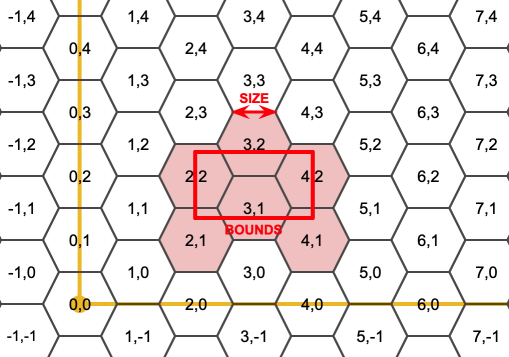
Le SRS pour les hexagones de sortie est le SRS fourni par la géométrie des limites.
Doubler ou tripler la taille des bords de l'hexagone génère un nouveau pavage parent qui s'adapte au pavage d'origine. Malheureusement, il n'est pas possible de générer des tuiles d'hexagones parents dans lesquelles les tuiles enfants s'insèrent parfaitement.
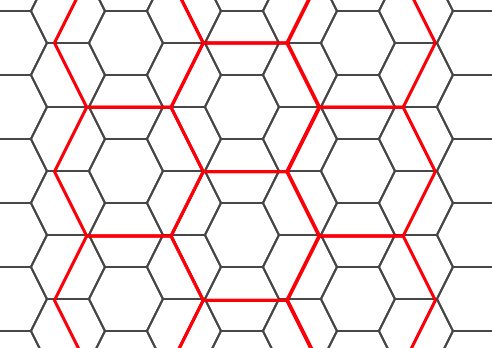
Disponibilité : 3.1.0
Exemple : Compter les points dans les hexagones
Pour faire un résumé des points par rapport à un pavage hexagonal, générez une grille hexagonale en utilisant l'étendue des points comme limites, puis joignez spatialement cette grille.
SELECT COUNT(*), hexes.geom
FROM
ST_HexagonGrid(
10000,
ST_SetSRID(ST_EstimatedExtent('pointtable', 'geom'), 3857)
) AS hexes
INNER JOIN
pointtable AS pts
ON ST_Intersects(pts.geom, hexes.geom)
GROUP BY hexes.geom;Exemple : Génération de la couverture hexagonale des polygones
Si nous générons un ensemble d'hexagones pour chaque limite de polygone et que nous éliminons par filtrage ceux qui n'intersectent pas leurs hexagones, nous obtenons un pavage pour chaque polygone.
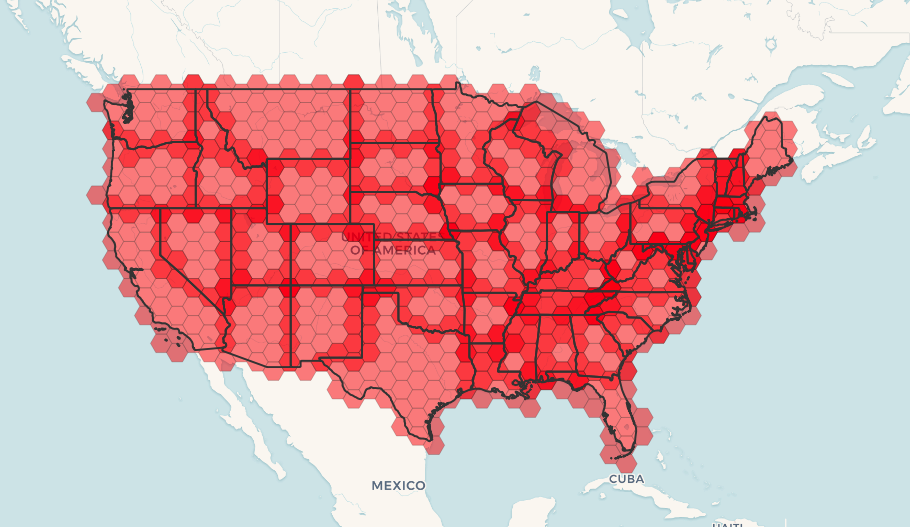
La mise en mosaïque des états donne lieu à une couverture hexagonale de chaque état, et à des hexagones multiples se chevauchant aux frontières entre les états.
![[Note]](images/note.png) | |
Le mot-clé LATERAL est implicite pour les fonctions de retour d'ensemble lorsqu'elles font référence à une table antérieure dans la liste FROM. Ainsi, CROSS JOIN LATERAL, CROSS JOIN, ou tout simplement , sont des constructions équivalentes pour cet exemple. |
SELECT admin1.gid, hex.geom
FROM
admin1
CROSS JOIN
ST_HexagonGrid(100000, admin1.geom) AS hex
WHERE
adm0_a3 = 'USA'
AND
ST_Intersects(admin1.geom, hex.geom)Voir aussi
ST_EstimatedExtent, ST_SetSRID, ST_SquareGrid, ST_TileEnvelope
Name
ST_Hexagon — Renvoie un seul hexagone, en utilisant la taille du bord et les coordonnées de la cellule fournies dans l'espace de la grille de l'hexagone.
Synopsis
geometry ST_Hexagon(float8 size, integer cell_i, integer cell_j, geometry origin);
Description
Utilise le même concept de tuilage d'hexagones que ST_HexagonGrid, mais génère un seul hexagone à la coordonnée de cellule souhaitée. En option, peut ajuster la coordonnée d'origine du tuilage, l'origine par défaut est à 0,0.
Les hexagones sont générés sans SRID défini, utilisez donc ST_SetSRID pour définir le SRID à celui que vous attendez.
Disponibilité : 3.1.0
Exemple : Création d'un hexagone à l'origine
SELECT ST_AsText(ST_SetSRID(ST_Hexagon(1.0, 0, 0), 3857));
POLYGON((-1 0,-0.5
-0.866025403784439,0.5
-0.866025403784439,1
0,0.5
0.866025403784439,-0.5
0.866025403784439,-1 0)) Voir aussi
Name
ST_SquareGrid — Renvoie un ensemble de carrés de grille et d'indices de cellules qui couvrent complètement les limites de l'argument géométrie.
Synopsis
setof record ST_SquareGrid(float8 size, geometry bounds);
Description
Commence par le concept de tuilage carré du plan. Pour un SRS plan donné, et une taille d'arête donnée, en commençant à l'origine du SRS, il existe un unique pavage carré du plan, Tiling(SRS, Size). Cette fonction répond à la question : quelles grilles dans un Tiling(SRS, Size) donné se chevauchent avec une limite donnée.
Le SRS des carrés de sortie est le SRS fourni par la géométrie des limites.
Le doublement de la taille du carré ou de son bord génère un nouveau pavage parent qui s'adapte parfaitement au pavage d'origine. Les carrelages standard des cartes Web dans mercator ne sont que des puissances de deux grilles carrées dans le plan mercator.
Disponibilité : 3.1.0
Exemple : Générer une grille de 1 degré pour un pays
La grille remplira toutes les limites du pays, donc si vous voulez seulement des carrés qui touchent le pays, vous devrez filtrer ensuite avec ST_Intersects.
WITH grid AS ( SELECT (ST_SquareGrid(1, ST_Transform(geom,4326))).* FROM admin0 WHERE name = 'Canada' ) SELEcT ST_AsText(geom) FROM grid
Exemple : Compter les points dans les carrés (en utilisant une seule grille découpée)
Pour faire un résumé des points par rapport à un tuilage carré, générez une grille carrée en utilisant l'étendue des points comme limites, puis joignez spatialement à cette grille. Notez que l'étendue estimée peut être différente de l'étendue réelle, soyez donc prudent et assurez-vous au moins d'avoir analysé votre tableau.
SELECT COUNT(*), squares.geom
FROM
pointtable AS pts
INNER JOIN
ST_SquareGrid(
1000,
ST_SetSRID(ST_EstimatedExtent('pointtable', 'geom'), 3857)
) AS squares
ON ST_Intersects(pts.geom, squares.geom)
GROUP BY squares.geomExemple : Compter des points dans des carrés en utilisant un jeu de grille par point
Cette méthode donne le même résultat que le premier exemple mais sera plus lente pour un grand nombre de points
SELECT COUNT(*), squares.geom
FROM
pointtable AS pts
INNER JOIN
ST_SquareGrid(
1000,
pts.geom
) AS squares
ON ST_Intersects(pts.geom, squares.geom)
GROUP BY squares.geomVoir aussi
ST_TileEnvelope, ST_HexagonGrid , ST_EstimatedExtent , ST_SetSRID
Name
ST_Square — Renvoie un seul carré, en utilisant la taille du bord et la coordonnée de la cellule fournies dans l'espace de la grille du carré.
Synopsis
geometry ST_Square(float8 size, integer cell_i, integer cell_j, geometry origin='POINT(0 0)');
Description
Utilise le même concept de tuilage carré que ST_SquareGrid, mais génère un seul carré à la coordonnée de cellule souhaitée. En option, peut ajuster la coordonnée d'origine du tuilage, l'origine par défaut est à 0,0.
Les carrés sont générés avec le SRID de l'origine donnée. Utilisez ST_SetSRID pour définir le SRID si l'origine donnée a un SRID inconnu (comme c'est le cas par défaut).
Disponibilité : 3.1.0
Exemple : Création d'un carré à l'origine
SELECT ST_AsText(ST_SetSRID(ST_Square(1.0, 0, 0), 3857)); POLYGON((0 0,0 1,1 1,1 0,0 0))
Voir aussi
Name
ST_Letters — Renvoie les lettres d'entrée rendues sous forme de géométrie avec une position de départ par défaut à l'origine et une hauteur de texte par défaut de 100.
Synopsis
geometry ST_Letters(text letters, json font);
Description
Utilise une police intégrée pour rendre une chaîne de caractères sous forme de géométrie multipolygonale. La hauteur de texte par défaut est de 100,0, soit la distance entre le bas d'une descendante et le haut d'une capitale. La position de départ par défaut place le début de la ligne de base à l'origine. Pour remplacer la police, il faut passer une carte json, avec un caractère comme clé, et des TWKB encodés en base64 pour la forme de la police, les polices ayant une hauteur de 1000 unités du bas des descendantes au haut des capitales.
Le texte est généré à l'origine par défaut, donc pour repositionner et redimensionner le texte, appliquez d'abord la fonction ST_Scale et ensuite appliquez la fonction ST_Translate.
Disponibilité : 3.3.0
Exemple : Génération du mot 'Yo'
SELECT ST_AsText(ST_Letters('Yo'), 1);
Lettres générées par ST_Letters
Exemple : Mise à l'échelle et déplacement des mots
SELECT ST_Translate(ST_Scale(ST_Letters('Yo'), 10, 10), 100,100);Voir aussi
7.4. Fonctions d'accès aux géométries
These functions expose structural information about an existing geometry without changing it. They provide access to metadata such as geometry type, dimensionality, or coordinate components so that spatial expressions can interrogate complex objects in a controlled way.
- GeometryType — Renvoie le type d'une géométrie sous forme de texte.
- ST_Boundary — Renvoie la limite d'une géométrie.
- ST_BoundingDiagonal — Retourne la diagonale de la boîte englobante pour la géométrie en argument.
- ST_CoordDim — Renvoie la dimension des coordonnées d'une géométrie.
- ST_Dimension — Renvoie la dimension topologique d'une géométrie.
- ST_Dump — Renvoie un ensemble de lignes
geometry_dumppour les composants d'une géométrie. - ST_DumpPoints — Renvoie un ensemble de lignes
geometry_dumppour les coordonnées dans une géométrie. - ST_DumpSegments — Renvoie un ensemble de lignes
geometry_dumppour les segments d'une géométrie. - ST_DumpRings — Renvoie un ensemble de lignes
geometry_dumppour les anneaux extérieurs et intérieurs d'un polygone. - ST_EndPoint — Renvoie le dernier point d'une LineString ou CircularLineString.
- ST_Envelope — Renvoie une géométrie représentant la boîte de délimitation d'une géométrie.
- ST_ExteriorRing — Renvoie une ligne représentant l'anneau extérieur d'un polygone.
- ST_GeometryN — Renvoie un élément d'une collection de géométries.
- ST_GeometryType — Renvoie le type SQL-MM d'une géométrie sous forme de texte.
- ST_HasArc — Teste si une géométrie contient un arc de cercle
- ST_InteriorRingN — Renvoie le Nième anneau intérieur (trou) d'un polygone.
- ST_NumCurves — Renvoie le nombre de courbes composantes d'une CompoundCurve.
- ST_CurveN — Renvoie la Nième courbe composante d'une CompoundCurve.
- ST_IsClosed — Teste si les points de départ et d'arrivée d'une LineString coïncident. Pour une PolyhedralSurface, teste si elle est fermée (volumétrique).
- ST_IsCollection — Teste si une géométrie est un type de collection de géométrie.
- ST_IsEmpty — Teste si une géométrie est vide.
- ST_IsPolygonCCW — Teste si les polygones ont des anneaux extérieurs orientés dans le sens inverse des aiguilles d'une montre et des anneaux intérieurs orientés dans le sens des aiguilles d'une montre.
- ST_IsPolygonCW — Teste si les polygones ont des anneaux extérieurs orientés dans le sens des aiguilles d'une montre et des anneaux intérieurs orientés dans le sens inverse des aiguilles d'une montre.
- ST_IsRing — Teste si une ligne est fermée et simple.
- ST_IsSimple — Teste si une géométrie n'a pas de points d'auto-intersection ou d'auto-tangente.
- ST_M — Renvoie la coordonnée M d'un point.
- ST_MemSize — Renvoie la quantité d'espace mémoire que prend une géométrie.
- ST_NDims — Renvoie la dimension des coordonnées d'une géométrie.
- ST_NPoints — Retourne le nombre de points (vertex) d'un objet géométrique.
- ST_NRings — Renvoie le nombre d'anneaux dans une géométrie polygonale.
- ST_NumGeometries — Renvoie le nombre d'éléments dans une collection de géométrie.
- ST_NumInteriorRings — Renvoie le nombre d'anneaux intérieurs (trous) d'un polygone.
- ST_NumInteriorRing — Renvoie le nombre d'anneaux intérieurs (trous) d'un polygone. Alias pour ST_NumInteriorRings
- ST_NumPatches — Renvoie le nombre de faces d'une surface polyédrique. Retourne null pour les géométries non polyédriques.
- ST_NumPoints — Renvoie le nombre de points dans une LineString ou une CircularString.
- ST_PatchN — Renvoie la Nième géométrie (face) d'une PolyhedralSurface.
- ST_PointN — Renvoie le Nième point de la première LineString ou LineString circulaire d'une géométrie.
- ST_Points — Renvoie un MultiPoint contenant les coordonnées d'une géométrie.
- ST_StartPoint — Renvoie le premier point d'une LineString.
- ST_Summary — Renvoie un résumé textuel du contenu d'une géométrie.
- ST_X — Renvoie la coordonnée X d'un point.
- ST_Y — Renvoie la coordonnée Y d'un point.
- ST_Z — Renvoie la coordonnée Z d'un point.
- ST_Zmflag — Retourne un code indiquant la dimension des coordonnées ZM d'une géométrie.
- ST_HasZ — Vérifie si une géométrie possède une dimension Z.
- ST_HasM — Vérifie si une géométrie a une dimension M (mesure).
Name
GeometryType — Renvoie le type d'une géométrie sous forme de texte.
Synopsis
text GeometryType(geometry geomA);
Description
Retourne le type de la géométrie, par exemple : 'LINESTRING', 'POLYGON', 'MULTIPOINT', etc.
OGC SPEC s2.1.1.1 - Retourne le nom du sous type instanciable de la géométrie. Le nom est retourné sous forme de texte.
![[Note]](images/note.png) | |
Cette fonction indique si la géométrie comporte une dimension de type mesure, en retournant un texte de la forme 'POINTM'. |
Amélioration : 2.0.0 introduction du support TIN, Triangles et surfaces polyédriques.
 Cette méthode implémente la spécification OGC Simple Features Implementation Specification for SQL 1.1.
Cette méthode implémente la spécification OGC Simple Features Implementation Specification for SQL 1.1.
 Cette méthode prend en charge les types Circular String et Curve.
Cette méthode prend en charge les types Circular String et Curve.
 Cette fonction prend en charge la 3D et ne supprime pas l'indice z.
Cette fonction prend en charge la 3D et ne supprime pas l'indice z.
 Cette fonction prend en charge les surfaces Polyhedral.
Cette fonction prend en charge les surfaces Polyhedral.
 Cette fonction prend en charge les triangles et les réseaux irréguliers triangulés (TIN).
Cette fonction prend en charge les triangles et les réseaux irréguliers triangulés (TIN).
Exemples
SELECT GeometryType(ST_GeomFromText('LINESTRING(77.29 29.07,77.42 29.26,77.27 29.31,77.29 29.07)'));
geometrytype
--------------
LINESTRING
SELECT ST_GeometryType(ST_GeomFromEWKT('POLYHEDRALSURFACE( ((0 0 0, 0 0 1, 0 1 1, 0 1 0, 0 0 0)),
((0 0 0, 0 1 0, 1 1 0, 1 0 0, 0 0 0)), ((0 0 0, 1 0 0, 1 0 1, 0 0 1, 0 0 0)),
((1 1 0, 1 1 1, 1 0 1, 1 0 0, 1 1 0)),
((0 1 0, 0 1 1, 1 1 1, 1 1 0, 0 1 0)), ((0 0 1, 1 0 1, 1 1 1, 0 1 1, 0 0 1)) )'));
--result
POLYHEDRALSURFACE
SELECT GeometryType(geom) as result
FROM
(SELECT
ST_GeomFromEWKT('TIN (((
0 0 0,
0 0 1,
0 1 0,
0 0 0
)), ((
0 0 0,
0 1 0,
1 1 0,
0 0 0
))
)') AS geom
) AS g;
result
--------
TIN Voir aussi
Name
ST_Boundary — Renvoie la limite d'une géométrie.
Synopsis
geometry ST_Boundary(geometry geomA);
Description
Renvoie l'ensemble formant la frontière finie de cette géométrie. La notion de frontière est définie dans la section 3.12.3.2 des spécifications OGC. Le résultat de cette fonction est un ensemble topologiquement fermé, représentable avec les types de base, comme décrit dans la section 3.12.2 des spécifications OGC.
Effectué par le module GEOS
![[Note]](images/note.png) | |
Avant la version 2.0.0, cette fonction renvoie une exception si une |
 Cette méthode implémente la spécification OGC Simple Features Implementation Specification for SQL 1.1. OGC SPEC s2.1.1.1
Cette méthode implémente la spécification OGC Simple Features Implementation Specification for SQL 1.1. OGC SPEC s2.1.1.1
 Cette méthode implémente la spécification SQL/MM. SQL-MM IEC 13249-3: 5.1.17
Cette méthode implémente la spécification SQL/MM. SQL-MM IEC 13249-3: 5.1.17
 Cette fonction prend en charge la 3D et ne supprime pas l'indice z.
Cette fonction prend en charge la 3D et ne supprime pas l'indice z.
Amélioration : 2.1.0 introduction du support pour Triangle
Modifié : 3.2.0 support pour TIN, n'utilise pas geos, ne linéarise pas les courbes
Exemples
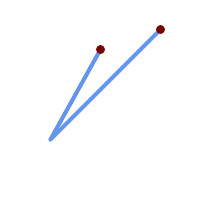 Ligne avec les points de démarcation superposés
SELECT ST_Boundary(geom)
FROM (SELECT 'LINESTRING(100 150,50 60, 70 80, 160 170)'::geometry As geom) As f;
ST_AsText output
MULTIPOINT((100 150),(160 170))
|  trous de polygone avec une multi-lignes en limite
SELECT ST_Boundary(geom)
FROM (SELECT
'POLYGON (( 10 130, 50 190, 110 190, 140 150, 150 80, 100 10, 20 40, 10 130 ),
( 70 40, 100 50, 120 80, 80 110, 50 90, 70 40 ))'::geometry As geom) As f;
ST_AsText output
MULTILINESTRING((10 130,50 190,110 190,140 150,150 80,100 10,20 40,10 130),
(70 40,100 50,120 80,80 110,50 90,70 40))
|
SELECT ST_AsText(ST_Boundary(ST_GeomFromText('LINESTRING(1 1,0 0, -1 1)')));
st_astext
-----------
MULTIPOINT((1 1),(-1 1))
SELECT ST_AsText(ST_Boundary(ST_GeomFromText('POLYGON((1 1,0 0, -1 1, 1 1))')));
st_astext
----------
LINESTRING(1 1,0 0,-1 1,1 1)
--Using a 3d polygon
SELECT ST_AsEWKT(ST_Boundary(ST_GeomFromEWKT('POLYGON((1 1 1,0 0 1, -1 1 1, 1 1 1))')));
st_asewkt
-----------------------------------
LINESTRING(1 1 1,0 0 1,-1 1 1,1 1 1)
--Using a 3d multilinestring
SELECT ST_AsEWKT(ST_Boundary(ST_GeomFromEWKT('MULTILINESTRING((1 1 1,0 0 0.5, -1 1 1),(1 1 0.5,0 0 0.5, -1 1 0.5, 1 1 0.5) )')));
st_asewkt
----------
MULTIPOINT((1 1 1),(-1 1 1))
Voir aussi
Name
ST_BoundingDiagonal — Retourne la diagonale de la boîte englobante pour la géométrie en argument.
Synopsis
geometry ST_BoundingDiagonal(geometry geom, boolean fits=false);
Description
Renvoie la diagonale de la boîte de délimitation de la géométrie fournie sous la forme d'une LineString. La diagonale est une LineString à 2 points avec les valeurs minimales de chaque dimension dans son point de départ et les valeurs maximales dans son point d'arrivée. Si la géométrie d'entrée est vide, la diagonale est une LINESTRING EMPTY.
Le paramètre facultatif fits spécifie si le meilleur ajustement est nécessaire. S'il est faux, la diagonale d'une boîte de délimitation un peu plus grande peut être acceptée (ce qui est plus rapide à calculer pour les géométries comportant de nombreux sommets). Dans les deux cas, la boîte de délimitation de la ligne diagonale renvoyée couvre toujours la géométrie d'entrée.
La géométrie renvoyée conserve le SRID et la dimensionnalité (présence Z et M) de la géométrie en entrée.
![[Note]](images/note.png) | |
Dans les cas dégénérés (c'est-à-dire un seul sommet dans l'entrée), la ligne retournée sera formellement invalide (pas d'intérieur). Le résultat est toujours topologiquement valide. |
Disponibilité : 2.2.0
 Cette fonction prend en charge la 3D et ne supprime pas l'indice z.
Cette fonction prend en charge la 3D et ne supprime pas l'indice z.
 Cette fonction prend en charge les coordonnées M.
Cette fonction prend en charge les coordonnées M.
Exemples
-- Get the minimum X in a buffer around a point
SELECT ST_X(ST_StartPoint(ST_BoundingDiagonal(
ST_Buffer(ST_Point(0,0),10)
)));
st_x
------
-10
Voir aussi
ST_StartPoint, ST_EndPoint, ST_X, ST_Y, ST_Z, ST_M, ST_Envelope
Name
ST_CoordDim — Renvoie la dimension des coordonnées d'une géométrie.
Synopsis
integer ST_CoordDim(geometry geomA);
Description
Retourne la dimension des coordonnées d'une valeur ST_Geometry.
Alias SQL/MM pour la fonction ST_NDims
 Cette méthode implémente la spécification OGC Simple Features Implementation Specification for SQL 1.1.
Cette méthode implémente la spécification OGC Simple Features Implementation Specification for SQL 1.1.
 Cette méthode implémente la spécification SQL/MM. SQL-MM 3 : 5.1.3
Cette méthode implémente la spécification SQL/MM. SQL-MM 3 : 5.1.3
 Cette méthode prend en charge les types Circular String et Curve.
Cette méthode prend en charge les types Circular String et Curve.
 Cette fonction prend en charge la 3D et ne supprime pas l'indice z.
Cette fonction prend en charge la 3D et ne supprime pas l'indice z.
 Cette fonction prend en charge les surfaces Polyhedral.
Cette fonction prend en charge les surfaces Polyhedral.
 Cette fonction prend en charge les triangles et les réseaux irréguliers triangulés (TIN).
Cette fonction prend en charge les triangles et les réseaux irréguliers triangulés (TIN).
Exemples
SELECT ST_CoordDim('CIRCULARSTRING(1 2 3, 1 3 4, 5 6 7, 8 9 10, 11 12 13)');
---result--
3
SELECT ST_CoordDim(ST_Point(1,2));
--result--
2
Voir aussi
Name
ST_Dimension — Renvoie la dimension topologique d'une géométrie.
Synopsis
integer ST_Dimension(geometry g);
Description
Renvoie la dimension topologique de cet objet Geometry, qui doit être inférieure ou égale à la dimension des coordonnées. OGC SPEC s2.1.1.1 - renvoie 0 pour POINT, 1 pour LINESTRING, 2 pour POLYGON, et la plus grande dimension des composants d'une GEOMETRYCOLLECTION. Si la dimension est inconnue (par exemple, pour une GEOMETRYCOLLECTION vide), 0 est renvoyé.
 Cette méthode implémente la spécification SQL/MM. SQL-MM 3 : 5.1.2
Cette méthode implémente la spécification SQL/MM. SQL-MM 3 : 5.1.2
Amélioration : 2.0.0 introduction du support TIN et surfaces polyédriques. Ne renvoie plus une exception si une GEOMETRY EMPTY est passée.
![[Note]](images/note.png) | |
Avant la version 2.0.0, cette fonction lève une exception si elle est utilisée avec une géométrie vide. |
 Cette fonction prend en charge les surfaces Polyhedral.
Cette fonction prend en charge les surfaces Polyhedral.
 Cette fonction prend en charge les triangles et les réseaux irréguliers triangulés (TIN).
Cette fonction prend en charge les triangles et les réseaux irréguliers triangulés (TIN).
Exemples
SELECT ST_Dimension('GEOMETRYCOLLECTION(LINESTRING(1 1,0 0),POINT(0 0))');
ST_Dimension
-----------
1
Voir aussi
Name
ST_Dump — Renvoie un ensemble de lignes geometry_dump pour les composants d'une géométrie.
Synopsis
geometry_dump[] ST_Dump(geometry g1);
Description
Une fonction de retour d'ensemble (SRF) qui extrait les composants d'une géométrie. Elle renvoie un ensemble de geometry_dump lignes, chacune contenant une géométrie (champ geom) et un tableau d'entiers (champ path).
Pour un type de géométrie atomique (POINT, LINESTRING, POLYGONE), un seul enregistrement est renvoyé avec un tableau path vide et la géométrie en entrée en tant que geom. Pour une collection ou une géométrie multiple, un enregistrement est renvoyé pour chacun des composants de la collection, et le path indique la position du composant à l'intérieur de la collection.
ST_Dump est utile pour développer les géométries. C'est l'inverse d'un ST_Collect / GROUP BY, en ce sens qu'il crée de nouvelles lignes. Par exemple, il peut être utilisé pour développer les MULTIPOLYGONES en POLYGONES.
Amélioration : 2.0.0 introduction du support TIN, Triangles et surfaces polyédriques.
Disponibilité : PostGIS 1.0.0RC1. Nécessite PostgreSQL 7.3 ou plus.
![[Note]](images/note.png) | |
Avant la version 1.3.4, cette fonction se bloquait si elle était utilisée avec des géométries contenant des CURVES. Ce problème est corrigé dans la version 1.3.4+ |
 Cette méthode prend en charge les types Circular String et Curve.
Cette méthode prend en charge les types Circular String et Curve.
 Cette fonction prend en charge les surfaces Polyhedral.
Cette fonction prend en charge les surfaces Polyhedral.
 Cette fonction prend en charge les triangles et les réseaux irréguliers triangulés (TIN).
Cette fonction prend en charge les triangles et les réseaux irréguliers triangulés (TIN).
 Cette fonction prend en charge la 3D et ne supprime pas l'indice z.
Cette fonction prend en charge la 3D et ne supprime pas l'indice z.
Exemples standard
SELECT sometable.field1, sometable.field1,
(ST_Dump(sometable.geom)).geom AS geom
FROM sometable;
-- Break a compound curve into its constituent linestrings and circularstrings
SELECT ST_AsEWKT(a.geom), ST_HasArc(a.geom)
FROM ( SELECT (ST_Dump(p_geom)).geom AS geom
FROM (SELECT ST_GeomFromEWKT('COMPOUNDCURVE(CIRCULARSTRING(0 0, 1 1, 1 0),(1 0, 0 1))') AS p_geom) AS b
) AS a;
st_asewkt | st_hasarc
-----------------------------+----------
CIRCULARSTRING(0 0,1 1,1 0) | t
LINESTRING(1 0,0 1) | f
(2 rows)Exemples TIN, Triangle et Surfaces Polyédriques
-- Polyhedral surface example
-- Break a Polyhedral surface into its faces
SELECT (a.p_geom).path[1] As path, ST_AsEWKT((a.p_geom).geom) As geom_ewkt
FROM (SELECT ST_Dump(ST_GeomFromEWKT('POLYHEDRALSURFACE(
((0 0 0, 0 0 1, 0 1 1, 0 1 0, 0 0 0)),
((0 0 0, 0 1 0, 1 1 0, 1 0 0, 0 0 0)), ((0 0 0, 1 0 0, 1 0 1, 0 0 1, 0 0 0)), ((1 1 0, 1 1 1, 1 0 1, 1 0 0, 1 1 0)),
((0 1 0, 0 1 1, 1 1 1, 1 1 0, 0 1 0)), ((0 0 1, 1 0 1, 1 1 1, 0 1 1, 0 0 1))
)') ) AS p_geom ) AS a;
path | geom_ewkt
------+------------------------------------------
1 | POLYGON((0 0 0,0 0 1,0 1 1,0 1 0,0 0 0))
2 | POLYGON((0 0 0,0 1 0,1 1 0,1 0 0,0 0 0))
3 | POLYGON((0 0 0,1 0 0,1 0 1,0 0 1,0 0 0))
4 | POLYGON((1 1 0,1 1 1,1 0 1,1 0 0,1 1 0))
5 | POLYGON((0 1 0,0 1 1,1 1 1,1 1 0,0 1 0))
6 | POLYGON((0 0 1,1 0 1,1 1 1,0 1 1,0 0 1))-- TIN --
SELECT (g.gdump).path, ST_AsEWKT((g.gdump).geom) as wkt
FROM
(SELECT
ST_Dump( ST_GeomFromEWKT('TIN (((
0 0 0,
0 0 1,
0 1 0,
0 0 0
)), ((
0 0 0,
0 1 0,
1 1 0,
0 0 0
))
)') ) AS gdump
) AS g;
-- result --
path | wkt
------+-------------------------------------
{1} | TRIANGLE((0 0 0,0 0 1,0 1 0,0 0 0))
{2} | TRIANGLE((0 0 0,0 1 0,1 1 0,0 0 0))
Name
ST_DumpPoints — Renvoie un ensemble de lignes geometry_dump pour les coordonnées dans une géométrie.
Synopsis
geometry_dump[] ST_DumpPoints(geometry geom);
Description
Une fonction de retour d'ensemble (SRF) qui extrait les coordonnées (sommets) d'une géométrie. Elle renvoie un ensemble de geometry_dump lignes, chacune contenant une géométrie (champ geom) et un tableau d'entiers (champ path).
le champ
geomPOINTreprésente les coordonnées de la géométrie fournie.le champ
path(uninteger[]) est un index énumérant les positions des coordonnées dans les éléments de la géométrie fournie. Les indices sont basés sur 1. Par exemple, pour unLINESTRING, les chemins sont{i}oùiest lanièmecoordonnée dans leLINESTRING. Pour unPOLYGONE, les chemins sont{i,j}oùiest le numéro de l'anneau (1 est l'anneau extérieur ; les anneaux intérieurs suivent) etjest la position de la coordonnée dans l'anneau.
Pour obtenir une géométrie unique contenant les coordonnées, utilisez ST_Points.
Amélioré : 2.1.0 Vitesse plus rapide. Réimplémentation en C natif.
Amélioration : 2.0.0 introduction du support TIN, Triangles et surfaces polyédriques.
Disponibilité : 1.5.0
 Cette méthode prend en charge les types Circular String et Curve.
Cette méthode prend en charge les types Circular String et Curve.
 Cette fonction prend en charge les surfaces Polyhedral.
Cette fonction prend en charge les surfaces Polyhedral.
 Cette fonction prend en charge les triangles et les réseaux irréguliers triangulés (TIN).
Cette fonction prend en charge les triangles et les réseaux irréguliers triangulés (TIN).
 Cette fonction prend en charge la 3D et ne supprime pas l'indice z.
Cette fonction prend en charge la 3D et ne supprime pas l'indice z.
Classique Éclater un tableau de lignes en nœuds
SELECT edge_id, (dp).path[1] As index, ST_AsText((dp).geom) As wktnode
FROM (SELECT 1 As edge_id
, ST_DumpPoints(ST_GeomFromText('LINESTRING(1 2, 3 4, 10 10)')) AS dp
UNION ALL
SELECT 2 As edge_id
, ST_DumpPoints(ST_GeomFromText('LINESTRING(3 5, 5 6, 9 10)')) AS dp
) As foo;
edge_id | index | wktnode
---------+-------+--------------
1 | 1 | POINT(1 2)
1 | 2 | POINT(3 4)
1 | 3 | POINT(10 10)
2 | 1 | POINT(3 5)
2 | 2 | POINT(5 6)
2 | 3 | POINT(9 10)Exemples de géométrie standard
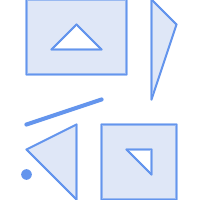
SELECT path, ST_AsText(geom)
FROM (
SELECT (ST_DumpPoints(g.geom)).*
FROM
(SELECT
'GEOMETRYCOLLECTION(
POINT ( 0 1 ),
LINESTRING ( 0 3, 3 4 ),
POLYGON (( 2 0, 2 3, 0 2, 2 0 )),
POLYGON (( 3 0, 3 3, 6 3, 6 0, 3 0 ),
( 5 1, 4 2, 5 2, 5 1 )),
MULTIPOLYGON (
(( 0 5, 0 8, 4 8, 4 5, 0 5 ),
( 1 6, 3 6, 2 7, 1 6 )),
(( 5 4, 5 8, 6 7, 5 4 ))
)
)'::geometry AS geom
) AS g
) j;
path | st_astext
-----------+------------
{1,1} | POINT(0 1)
{2,1} | POINT(0 3)
{2,2} | POINT(3 4)
{3,1,1} | POINT(2 0)
{3,1,2} | POINT(2 3)
{3,1,3} | POINT(0 2)
{3,1,4} | POINT(2 0)
{4,1,1} | POINT(3 0)
{4,1,2} | POINT(3 3)
{4,1,3} | POINT(6 3)
{4,1,4} | POINT(6 0)
{4,1,5} | POINT(3 0)
{4,2,1} | POINT(5 1)
{4,2,2} | POINT(4 2)
{4,2,3} | POINT(5 2)
{4,2,4} | POINT(5 1)
{5,1,1,1} | POINT(0 5)
{5,1,1,2} | POINT(0 8)
{5,1,1,3} | POINT(4 8)
{5,1,1,4} | POINT(4 5)
{5,1,1,5} | POINT(0 5)
{5,1,2,1} | POINT(1 6)
{5,1,2,2} | POINT(3 6)
{5,1,2,3} | POINT(2 7)
{5,1,2,4} | POINT(1 6)
{5,2,1,1} | POINT(5 4)
{5,2,1,2} | POINT(5 8)
{5,2,1,3} | POINT(6 7)
{5,2,1,4} | POINT(5 4)
(29 rows)Exemples TIN, Triangle et Surfaces Polyédriques
-- Polyhedral surface cube --
SELECT (g.gdump).path, ST_AsEWKT((g.gdump).geom) as wkt
FROM
(SELECT
ST_DumpPoints(ST_GeomFromEWKT('POLYHEDRALSURFACE( ((0 0 0, 0 0 1, 0 1 1, 0 1 0, 0 0 0)),
((0 0 0, 0 1 0, 1 1 0, 1 0 0, 0 0 0)), ((0 0 0, 1 0 0, 1 0 1, 0 0 1, 0 0 0)),
((1 1 0, 1 1 1, 1 0 1, 1 0 0, 1 1 0)),
((0 1 0, 0 1 1, 1 1 1, 1 1 0, 0 1 0)), ((0 0 1, 1 0 1, 1 1 1, 0 1 1, 0 0 1)) )') ) AS gdump
) AS g;
-- result --
path | wkt
---------+--------------
{1,1,1} | POINT(0 0 0)
{1,1,2} | POINT(0 0 1)
{1,1,3} | POINT(0 1 1)
{1,1,4} | POINT(0 1 0)
{1,1,5} | POINT(0 0 0)
{2,1,1} | POINT(0 0 0)
{2,1,2} | POINT(0 1 0)
{2,1,3} | POINT(1 1 0)
{2,1,4} | POINT(1 0 0)
{2,1,5} | POINT(0 0 0)
{3,1,1} | POINT(0 0 0)
{3,1,2} | POINT(1 0 0)
{3,1,3} | POINT(1 0 1)
{3,1,4} | POINT(0 0 1)
{3,1,5} | POINT(0 0 0)
{4,1,1} | POINT(1 1 0)
{4,1,2} | POINT(1 1 1)
{4,1,3} | POINT(1 0 1)
{4,1,4} | POINT(1 0 0)
{4,1,5} | POINT(1 1 0)
{5,1,1} | POINT(0 1 0)
{5,1,2} | POINT(0 1 1)
{5,1,3} | POINT(1 1 1)
{5,1,4} | POINT(1 1 0)
{5,1,5} | POINT(0 1 0)
{6,1,1} | POINT(0 0 1)
{6,1,2} | POINT(1 0 1)
{6,1,3} | POINT(1 1 1)
{6,1,4} | POINT(0 1 1)
{6,1,5} | POINT(0 0 1)
(30 rows)-- Triangle --
SELECT (g.gdump).path, ST_AsText((g.gdump).geom) as wkt
FROM
(SELECT
ST_DumpPoints( ST_GeomFromEWKT('TRIANGLE ((
0 0,
0 9,
9 0,
0 0
))') ) AS gdump
) AS g;
-- result --
path | wkt
------+------------
{1} | POINT(0 0)
{2} | POINT(0 9)
{3} | POINT(9 0)
{4} | POINT(0 0)
-- TIN --
SELECT (g.gdump).path, ST_AsEWKT((g.gdump).geom) as wkt
FROM
(SELECT
ST_DumpPoints( ST_GeomFromEWKT('TIN (((
0 0 0,
0 0 1,
0 1 0,
0 0 0
)), ((
0 0 0,
0 1 0,
1 1 0,
0 0 0
))
)') ) AS gdump
) AS g;
-- result --
path | wkt
---------+--------------
{1,1,1} | POINT(0 0 0)
{1,1,2} | POINT(0 0 1)
{1,1,3} | POINT(0 1 0)
{1,1,4} | POINT(0 0 0)
{2,1,1} | POINT(0 0 0)
{2,1,2} | POINT(0 1 0)
{2,1,3} | POINT(1 1 0)
{2,1,4} | POINT(0 0 0)
(8 rows)
Name
ST_DumpSegments — Renvoie un ensemble de lignes geometry_dump pour les segments d'une géométrie.
Synopsis
geometry_dump[] ST_DumpSegments(geometry geom);
Description
Une fonction de retour d'ensemble (SRF) qui extrait les segments d'une géométrie. Elle renvoie un ensemble de geometry_dump lignes, chacune contenant une géométrie (champ geom) et un tableau d'entiers (champ path).
le champ
geomLINESTRINGs représente les segments linéaires de la géométrie fournie, tandis queCIRCULARSTRINGs représente les segments d'arc.le champ
path(uninteger[]) est un index énumérant les positions des points de départ des segments dans les éléments de la géométrie fournie. Les indices sont basés sur 1. Par exemple, pour unLINESTRING, les chemins sont{i}oùiest lenièmepoint de départ du segment dans leLINESTRING. Pour unPOLYGONE, les chemins sont{i,j}oùiest le numéro de l'anneau (1 est l'anneau extérieur ; les anneaux intérieurs suivent) etjest la position du point de départ du segment dans l'anneau.
Disponibilité : 3.2.0
 Cette fonction prend en charge les triangles et les réseaux irréguliers triangulés (TIN).
Cette fonction prend en charge les triangles et les réseaux irréguliers triangulés (TIN).
 Cette fonction prend en charge la 3D et ne supprime pas l'indice z.
Cette fonction prend en charge la 3D et ne supprime pas l'indice z.
Exemples de géométrie standard
SELECT path, ST_AsText(geom)
FROM (
SELECT (ST_DumpSegments(g.geom)).*
FROM (SELECT 'GEOMETRYCOLLECTION(
LINESTRING(1 1, 3 3, 4 4),
POLYGON((5 5, 6 6, 7 7, 5 5))
)'::geometry AS geom
) AS g
) j;
path │ st_astext
---------------------------------
{1,1} │ LINESTRING(1 1,3 3)
{1,2} │ LINESTRING(3 3,4 4)
{2,1,1} │ LINESTRING(5 5,6 6)
{2,1,2} │ LINESTRING(6 6,7 7)
{2,1,3} │ LINESTRING(7 7,5 5)
(5 rows)Exemples de TIN et de triangles
-- Triangle --
SELECT path, ST_AsText(geom)
FROM (
SELECT (ST_DumpSegments(g.geom)).*
FROM (SELECT 'TRIANGLE((
0 0,
0 9,
9 0,
0 0
))'::geometry AS geom
) AS g
) j;
path │ st_astext
---------------------------------
{1,1} │ LINESTRING(0 0,0 9)
{1,2} │ LINESTRING(0 9,9 0)
{1,3} │ LINESTRING(9 0,0 0)
(3 rows)
-- TIN --
SELECT path, ST_AsEWKT(geom)
FROM (
SELECT (ST_DumpSegments(g.geom)).*
FROM (SELECT 'TIN(((
0 0 0,
0 0 1,
0 1 0,
0 0 0
)), ((
0 0 0,
0 1 0,
1 1 0,
0 0 0
))
)'::geometry AS geom
) AS g
) j;
path │ st_asewkt
---------------------------------
{1,1,1} │ LINESTRING(0 0 0,0 0 1)
{1,1,2} │ LINESTRING(0 0 1,0 1 0)
{1,1,3} │ LINESTRING(0 1 0,0 0 0)
{2,1,1} │ LINESTRING(0 0 0,0 1 0)
{2,1,2} │ LINESTRING(0 1 0,1 1 0)
{2,1,3} │ LINESTRING(1 1 0,0 0 0)
(6 rows)
Name
ST_DumpRings — Renvoie un ensemble de lignes geometry_dump pour les anneaux extérieurs et intérieurs d'un polygone.
Synopsis
geometry_dump[] ST_DumpRings(geometry a_polygon);
Description
Une fonction de retour d'ensemble (SRF) qui extrait les anneaux d'un polygone. Elle renvoie un ensemble de geometry_dump lignes, chacune contenant une géométrie (champ geom) et un tableau d'entiers (champ path).
Le champ geom contient chaque anneau sous forme de POLYGONE. Le champ path est un tableau d'entiers de longueur 1 contenant l'indice de l'anneau du polygone. L'anneau extérieur (coquille) a l'indice 0. Les anneaux intérieurs (trous) ont des indices de 1 et plus.
![[Note]](images/note.png) | |
This only works for POLYGON geometries, not MULTIPOLYGONs. Use ST_Dump to extract polygon elements from polygonal geometries: |
Disponibilité : PostGIS 1.1.3. Nécessite PostgreSQL 7.3 ou plus.
 Cette fonction prend en charge la 3D et ne supprime pas l'indice z.
Cette fonction prend en charge la 3D et ne supprime pas l'indice z.
Exemples
Extracting all rings as polygons.
SELECT polyTable.field1, polyTable.field1,
(ST_DumpRings(polyTable.geom)).geom As geom
FROM polyTable
Extracting shell and holes from a polygon.
SELECT path, ST_AsText(geom) As geom
FROM ST_DumpRings(
'POLYGON ((1 9, 9 9, 9 1, 1 1, 1 9), (2 2, 2 3, 3 3, 3 2, 2 2), (4 2, 4 4, 6 4, 6 2, 4 2))');
path | geom
------+--------------------------------
{0} | POLYGON((1 9,9 9,9 1,1 1,1 9))
{1} | POLYGON((2 2,2 3,3 3,3 2,2 2))
{2} | POLYGON((4 2,4 4,6 4,6 2,4 2))Name
ST_EndPoint — Renvoie le dernier point d'une LineString ou CircularLineString.
Synopsis
geometry ST_EndPoint(geometry g);
Description
Renvoie le dernier point d'une géométrie LINESTRING ou CIRCULARLINESTRING comme un POINT. Renvoie NULL si l'entrée n'est pas une LINESTRING ou CIRCULARLINESTRING.
 Cette méthode implémente la spécification SQL/MM. SQL-MM 3 : 7.1.4
Cette méthode implémente la spécification SQL/MM. SQL-MM 3 : 7.1.4
 Cette fonction prend en charge la 3D et ne supprime pas l'indice z.
Cette fonction prend en charge la 3D et ne supprime pas l'indice z.
 Cette méthode prend en charge les types Circular String et Curve.
Cette méthode prend en charge les types Circular String et Curve.
![[Note]](images/note.png) | |
Modifié : 2.0.0 ne fonctionne plus avec les MultiLineStrings à géométrie unique. Dans les anciennes versions de PostGIS, une MultiLineString à géométrie unique fonctionnait avec cette fonction et renvoyait le point final. Dans la version 2.0.0, elle renvoie NULL comme toute autre MultiLineString. L'ancien comportement était une fonctionnalité non documentée, mais les personnes qui supposaient que leurs données étaient stockées en tant que LINESTRING peuvent voir ces dernières retourner NULL dans la version 2.0.0. |
Exemples
Point final d'une ligne
postgis=# SELECT ST_AsText(ST_EndPoint('LINESTRING(1 1, 2 2, 3 3)'::geometry));
st_astext
------------
POINT(3 3)
Le point final d'une ligne qui n'en est pas une est NULL
SELECT ST_EndPoint('POINT(1 1)'::geometry) IS NULL AS is_null;
is_null
----------
t
Point final d'une ligne 3D
--3d endpoint
SELECT ST_AsEWKT(ST_EndPoint('LINESTRING(1 1 2, 1 2 3, 0 0 5)'));
st_asewkt
--------------
POINT(0 0 5)
Point d'arrivée d'une CircularString
SELECT ST_AsText(ST_EndPoint('CIRCULARSTRING(5 2,-3 1.999999, -2 1, -4 2, 6 3)'::geometry));
st_astext
------------
POINT(6 3)
Voir aussi
Name
ST_Envelope — Renvoie une géométrie représentant la boîte de délimitation d'une géométrie.
Synopsis
geometry ST_Envelope(geometry g1);
Description
Renvoie la boîte de délimitation minimale en double précision (float8) pour la géométrie fournie, en tant que géométrie. Le polygone est défini par les points d'angle de la boîte de délimitation ((MINX, MINY), (MINX, MAXY), (MAXX, MAXY), (MAXX, MINY), (MINX, MINY)). (PostGIS ajoutera également une coordonnée ZMIN/ZMAX).
D'autres cas (lignes verticales, points) retourneront une géométrie de dimension inférieure à POLYGON, c'est-à-dire POINT ou LINESTRING.
Disponibilité : 1.5.0 changement pour renvoyer un type double précision à la place de float4
 Cette méthode implémente la spécification OGC Simple Features Implementation Specification for SQL 1.1. s2.1.1.1
Cette méthode implémente la spécification OGC Simple Features Implementation Specification for SQL 1.1. s2.1.1.1
 Cette méthode implémente la spécification SQL/MM. SQL-MM 3 : 5.1.19
Cette méthode implémente la spécification SQL/MM. SQL-MM 3 : 5.1.19
Exemples
SELECT ST_AsText(ST_Envelope('POINT(1 3)'::geometry));
st_astext
------------
POINT(1 3)
(1 row)
SELECT ST_AsText(ST_Envelope('LINESTRING(0 0, 1 3)'::geometry));
st_astext
--------------------------------
POLYGON((0 0,0 3,1 3,1 0,0 0))
(1 row)
SELECT ST_AsText(ST_Envelope('POLYGON((0 0, 0 1, 1.0000001 1, 1.0000001 0, 0 0))'::geometry));
st_astext
--------------------------------------------------------------
POLYGON((0 0,0 1,1.00000011920929 1,1.00000011920929 0,0 0))
(1 row)
SELECT ST_AsText(ST_Envelope('POLYGON((0 0, 0 1, 1.0000000001 1, 1.0000000001 0, 0 0))'::geometry));
st_astext
--------------------------------------------------------------
POLYGON((0 0,0 1,1.00000011920929 1,1.00000011920929 0,0 0))
(1 row)
SELECT Box3D(geom), Box2D(geom), ST_AsText(ST_Envelope(geom)) As envelopewkt
FROM (SELECT 'POLYGON((0 0, 0 1000012333334.34545678, 1.0000001 1, 1.0000001 0, 0 0))'::geometry As geom) As foo;
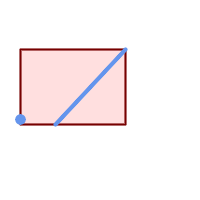
Enveloppe d'un point et d'une ligne.
SELECT ST_AsText(ST_Envelope(
ST_Collect(
ST_GeomFromText('LINESTRING(55 75,125 150)'),
ST_Point(20, 80))
)) As wktenv;
wktenv
-----------
POLYGON((20 75,20 150,125 150,125 75,20 75))Voir aussi
Name
ST_ExteriorRing — Renvoie une ligne représentant l'anneau extérieur d'un polygone.
Synopsis
geometry ST_ExteriorRing(geometry a_polygon);
Description
Renvoie une LINESTRING représentant l'anneau extérieur (coquille) d'un POLYGONE. Renvoie NULL si la géométrie n'est pas un polygone.
![[Note]](images/note.png) | |
Cette fonction ne prend pas en charge les MULTIPOLYGONES. Pour les MULTIPOLYGONs, utilisez conjointement avec ST_GeometryN ou ST_Dump |
 Cette méthode implémente la spécification OGC Simple Features Implementation Specification for SQL 1.1. 2.1.5.1
Cette méthode implémente la spécification OGC Simple Features Implementation Specification for SQL 1.1. 2.1.5.1
 Cette méthode implémente la spécification SQL/MM. SQL-MM 3 : 8.2.3, 8.3.3
Cette méthode implémente la spécification SQL/MM. SQL-MM 3 : 8.2.3, 8.3.3
 Cette fonction prend en charge la 3D et ne supprime pas l'indice z.
Cette fonction prend en charge la 3D et ne supprime pas l'indice z.
Exemples
--If you have a table of polygons
SELECT gid, ST_ExteriorRing(geom) AS ering
FROM sometable;
--If you have a table of MULTIPOLYGONs
--and want to return a MULTILINESTRING composed of the exterior rings of each polygon
SELECT gid, ST_Collect(ST_ExteriorRing(geom)) AS erings
FROM (SELECT gid, (ST_Dump(geom)).geom As geom
FROM sometable) As foo
GROUP BY gid;
--3d Example
SELECT ST_AsEWKT(
ST_ExteriorRing(
ST_GeomFromEWKT('POLYGON((0 0 1, 1 1 1, 1 2 1, 1 1 1, 0 0 1))')
)
);
st_asewkt
---------
LINESTRING(0 0 1,1 1 1,1 2 1,1 1 1,0 0 1)
Voir aussi
Name
ST_GeometryN — Renvoie un élément d'une collection de géométries.
Synopsis
geometry ST_GeometryN(geometry geomA, integer n);
Description
Renvoie la géométrie du Nième élément basé sur 1 d'une géométrie d'entrée qui est une GEOMETRYCOLLECTION, MULTIPOINT, MULTILINESTRING, MULTICURVE, MULTI)POLYGON ou POLYHEDRALSURFACE. Sinon, renvoie NULL.
![[Note]](images/note.png) | |
L'index commence à 1 pour respecter les spécificarions OGC depuis la version 0.8.0. Dans les versions antérieures, l'index commençait à 0. |
![[Note]](images/note.png) | |
Pour extraire tous les éléments d'une géométrie, ST_Dump est plus efficace et fonctionne pour les géométries atomiques. |
Amélioration : 2.0.0 introduction du support TIN, Triangles et surfaces polyédriques.
Changement : 2.0.0. Les versions antérieures renvoient NULL pour les géometries simples (un seul objet). Renvoie désormais la géométrie pour le cas ST_GeometryN(..,1).
 Cette méthode implémente la spécification OGC Simple Features Implementation Specification for SQL 1.1.
Cette méthode implémente la spécification OGC Simple Features Implementation Specification for SQL 1.1.
 Cette méthode implémente la spécification SQL/MM. SQL-MM 3 : 9.1.5
Cette méthode implémente la spécification SQL/MM. SQL-MM 3 : 9.1.5
 Cette fonction prend en charge la 3D et ne supprime pas l'indice z.
Cette fonction prend en charge la 3D et ne supprime pas l'indice z.
 Cette méthode prend en charge les types Circular String et Curve.
Cette méthode prend en charge les types Circular String et Curve.
 Cette fonction prend en charge les surfaces Polyhedral.
Cette fonction prend en charge les surfaces Polyhedral.
 Cette fonction prend en charge les triangles et les réseaux irréguliers triangulés (TIN).
Cette fonction prend en charge les triangles et les réseaux irréguliers triangulés (TIN).
Exemples standard
--Extracting a subset of points from a 3d multipoint
SELECT n, ST_AsEWKT(ST_GeometryN(geom, n)) As geomewkt
FROM (
VALUES (ST_GeomFromEWKT('MULTIPOINT((1 2 7), (3 4 7), (5 6 7), (8 9 10))') ),
( ST_GeomFromEWKT('MULTICURVE(CIRCULARSTRING(2.5 2.5,4.5 2.5, 3.5 3.5), (10 11, 12 11))') )
)As foo(geom)
CROSS JOIN generate_series(1,100) n
WHERE n <= ST_NumGeometries(geom);
n | geomewkt
---+-----------------------------------------
1 | POINT(1 2 7)
2 | POINT(3 4 7)
3 | POINT(5 6 7)
4 | POINT(8 9 10)
1 | CIRCULARSTRING(2.5 2.5,4.5 2.5,3.5 3.5)
2 | LINESTRING(10 11,12 11)
--Extracting all geometries (useful when you want to assign an id)
SELECT gid, n, ST_GeometryN(geom, n)
FROM sometable CROSS JOIN generate_series(1,100) n
WHERE n <= ST_NumGeometries(geom);
Exemples TIN, Triangle et Surfaces Polyédriques
-- Polyhedral surface example
-- Break a Polyhedral surface into its faces
SELECT ST_AsEWKT(ST_GeometryN(p_geom,3)) As geom_ewkt
FROM (SELECT ST_GeomFromEWKT('POLYHEDRALSURFACE(
((0 0 0, 0 0 1, 0 1 1, 0 1 0, 0 0 0)),
((0 0 0, 0 1 0, 1 1 0, 1 0 0, 0 0 0)),
((0 0 0, 1 0 0, 1 0 1, 0 0 1, 0 0 0)),
((1 1 0, 1 1 1, 1 0 1, 1 0 0, 1 1 0)),
((0 1 0, 0 1 1, 1 1 1, 1 1 0, 0 1 0)),
((0 0 1, 1 0 1, 1 1 1, 0 1 1, 0 0 1))
)') AS p_geom ) AS a;
geom_ewkt
------------------------------------------
POLYGON((0 0 0,1 0 0,1 0 1,0 0 1,0 0 0))-- TIN --
SELECT ST_AsEWKT(ST_GeometryN(geom,2)) as wkt
FROM
(SELECT
ST_GeomFromEWKT('TIN (((
0 0 0,
0 0 1,
0 1 0,
0 0 0
)), ((
0 0 0,
0 1 0,
1 1 0,
0 0 0
))
)') AS geom
) AS g;
-- result --
wkt
-------------------------------------
TRIANGLE((0 0 0,0 1 0,1 1 0,0 0 0))Voir aussi
Name
ST_GeometryType — Renvoie le type SQL-MM d'une géométrie sous forme de texte.
Synopsis
text ST_GeometryType(geometry g1);
Description
Renvoie le type de la géométrie sous forme de texte, par exemple : 'ST_LineString', 'ST_Polygon','ST_MultiPolygon' etc. Cette fonction diffère de GeometryType(geometry) par la casse du texte renvoyé et par le préfixe ST_ en début de texte. N'indique pas si la géométrie comporte une dimension MESURE.
Amélioration : 2.0.0 introduction du support des surfaces polyédriques.
 Cette méthode implémente la spécification SQL/MM. SQL-MM 3 : 5.1.4
Cette méthode implémente la spécification SQL/MM. SQL-MM 3 : 5.1.4
 Cette fonction prend en charge la 3D et ne supprime pas l'indice z.
Cette fonction prend en charge la 3D et ne supprime pas l'indice z.
 Cette fonction prend en charge les surfaces Polyhedral.
Cette fonction prend en charge les surfaces Polyhedral.
Exemples
SELECT ST_GeometryType(ST_GeomFromText('LINESTRING(77.29 29.07,77.42 29.26,77.27 29.31,77.29 29.07)'));
--result
ST_LineStringSELECT ST_GeometryType(ST_GeomFromEWKT('POLYHEDRALSURFACE( ((0 0 0, 0 0 1, 0 1 1, 0 1 0, 0 0 0)),
((0 0 0, 0 1 0, 1 1 0, 1 0 0, 0 0 0)), ((0 0 0, 1 0 0, 1 0 1, 0 0 1, 0 0 0)),
((1 1 0, 1 1 1, 1 0 1, 1 0 0, 1 1 0)),
((0 1 0, 0 1 1, 1 1 1, 1 1 0, 0 1 0)), ((0 0 1, 1 0 1, 1 1 1, 0 1 1, 0 0 1)) )'));
--result
ST_PolyhedralSurfaceSELECT ST_GeometryType(ST_GeomFromEWKT('POLYHEDRALSURFACE( ((0 0 0, 0 0 1, 0 1 1, 0 1 0, 0 0 0)),
((0 0 0, 0 1 0, 1 1 0, 1 0 0, 0 0 0)), ((0 0 0, 1 0 0, 1 0 1, 0 0 1, 0 0 0)),
((1 1 0, 1 1 1, 1 0 1, 1 0 0, 1 1 0)),
((0 1 0, 0 1 1, 1 1 1, 1 1 0, 0 1 0)), ((0 0 1, 1 0 1, 1 1 1, 0 1 1, 0 0 1)) )'));
--result
ST_PolyhedralSurfaceSELECT ST_GeometryType(geom) as result
FROM
(SELECT
ST_GeomFromEWKT('TIN (((
0 0 0,
0 0 1,
0 1 0,
0 0 0
)), ((
0 0 0,
0 1 0,
1 1 0,
0 0 0
))
)') AS geom
) AS g;
result
--------
ST_Tin Voir aussi
Name
ST_HasArc — Teste si une géométrie contient un arc de cercle
Synopsis
boolean ST_HasArc(geometry geomA);
Description
Renvoie true si une géométrie ou une collection de géométries contient une circular string
Disponibilité : 1.2.3 ?
 Cette fonction prend en charge la 3D et ne supprime pas l'indice z.
Cette fonction prend en charge la 3D et ne supprime pas l'indice z.
 Cette méthode prend en charge les types Circular String et Curve.
Cette méthode prend en charge les types Circular String et Curve.
Exemples
SELECT ST_HasArc(ST_Collect('LINESTRING(1 2, 3 4, 5 6)', 'CIRCULARSTRING(1 1, 2 3, 4 5, 6 7, 5 6)'));
st_hasarc
--------
t
Voir aussi
Name
ST_InteriorRingN — Renvoie le Nième anneau intérieur (trou) d'un polygone.
Synopsis
geometry ST_InteriorRingN(geometry a_polygon, integer n);
Description
Renvoie le Nième anneau intérieur (trou) d'une géométrie POLYGONE sous forme de LINESTRING. L'indice commence à 1. Renvoie NULL si la géométrie n'est pas un polygone ou si l'indice est hors de la plage.
![[Note]](images/note.png) | |
Cette fonction ne prend pas en charge les MULTIPOLYGONES. Pour les MULTIPOLYGONs, utilisez conjointement avec ST_GeometryN ou ST_Dump |
 Cette méthode implémente la spécification OGC Simple Features Implementation Specification for SQL 1.1.
Cette méthode implémente la spécification OGC Simple Features Implementation Specification for SQL 1.1.
 Cette méthode implémente la spécification SQL/MM. SQL-MM 3 : 8.2.6, 8.3.5
Cette méthode implémente la spécification SQL/MM. SQL-MM 3 : 8.2.6, 8.3.5
 Cette fonction prend en charge la 3D et ne supprime pas l'indice z.
Cette fonction prend en charge la 3D et ne supprime pas l'indice z.
Exemples
SELECT ST_AsText(ST_InteriorRingN(geom, 1)) As geom
FROM (SELECT ST_BuildArea(
ST_Collect(ST_Buffer(ST_Point(1,2), 20,3),
ST_Buffer(ST_Point(1, 2), 10,3))) As geom
) as foo;
Name
ST_NumCurves — Renvoie le nombre de courbes composantes d'une CompoundCurve.
Synopsis
integer ST_NumCurves(geometry a_compoundcurve);
Description
Renvoie le nombre de courbes composantes d'une CompoundCurve, zéro pour une CompoundCurve vide, ou NULL pour une entrée qui n'est pas une CompoundCurve.
 Cette méthode implémente la spécification SQL/MM. SQL-MM 3 : 8.2.6, 8.3.5
Cette méthode implémente la spécification SQL/MM. SQL-MM 3 : 8.2.6, 8.3.5
 Cette fonction prend en charge la 3D et ne supprime pas l'indice z.
Cette fonction prend en charge la 3D et ne supprime pas l'indice z.
Exemples
-- Returns 3
SELECT ST_NumCurves('COMPOUNDCURVE(
(2 2, 2.5 2.5),
CIRCULARSTRING(2.5 2.5, 4.5 2.5, 3.5 3.5),
(3.5 3.5, 2.5 4.5, 3 5, 2 2)
)');
-- Returns 0
SELECT ST_NumCurves('COMPOUNDCURVE EMPTY');
Voir aussi
ST_CurveN, ST_Dump, ST_ExteriorRing, ST_NumInteriorRings, ST_NumGeometries
Name
ST_CurveN — Renvoie la Nième courbe composante d'une CompoundCurve.
Synopsis
geometry ST_CurveN(geometry a_compoundcurve, integer index);
Description
Renvoie la Nièmecourbe composante d'une CompoundCurve. L'index commence à 1. Renvoie NULL si la géométrie n'est pas une CompoundCurve ou si l'index est hors de la plage.
 Cette méthode implémente la spécification SQL/MM. SQL-MM 3 : 8.2.6, 8.3.5
Cette méthode implémente la spécification SQL/MM. SQL-MM 3 : 8.2.6, 8.3.5
 Cette fonction prend en charge la 3D et ne supprime pas l'indice z.
Cette fonction prend en charge la 3D et ne supprime pas l'indice z.
Exemples
SELECT ST_AsText(ST_CurveN('COMPOUNDCURVE(
(2 2, 2.5 2.5),
CIRCULARSTRING(2.5 2.5, 4.5 2.5, 3.5 3.5),
(3.5 3.5, 2.5 4.5, 3 5, 2 2)
)', 1));
Voir aussi
ST_NumCurves, ST_Dump, ST_ExteriorRing, ST_NumInteriorRings, ST_NumGeometries
Name
ST_IsClosed — Teste si les points de départ et d'arrivée d'une LineString coïncident. Pour une PolyhedralSurface, teste si elle est fermée (volumétrique).
Synopsis
boolean ST_IsClosed(geometry g);
Description
Renvoie TRUE si les premier et dernier points de la LINESTRING sont identiques. Pour les surface polyhédriques, indique si la surface est surfacique (ouverte) ou volumétrique (fermée).
 Cette méthode implémente la spécification OGC Simple Features Implementation Specification for SQL 1.1.
Cette méthode implémente la spécification OGC Simple Features Implementation Specification for SQL 1.1.
 Cette méthode implémente la spécification SQL/MM. SQL-MM 3 : 7.1.5, 9.3.3
Cette méthode implémente la spécification SQL/MM. SQL-MM 3 : 7.1.5, 9.3.3
![[Note]](images/note.png) | |
SQL-MM définit le résultat de |
 Cette fonction prend en charge la 3D et ne supprime pas l'indice z.
Cette fonction prend en charge la 3D et ne supprime pas l'indice z.
 Cette méthode prend en charge les types Circular String et Curve.
Cette méthode prend en charge les types Circular String et Curve.
Amélioration : 2.0.0 introduction du support des surfaces polyédriques.
 Cette fonction prend en charge les surfaces Polyhedral.
Cette fonction prend en charge les surfaces Polyhedral.
Exemples de lignes et de points
postgis=# SELECT ST_IsClosed('LINESTRING(0 0, 1 1)'::geometry);
st_isclosed
-------------
f
(1 row)
postgis=# SELECT ST_IsClosed('LINESTRING(0 0, 0 1, 1 1, 0 0)'::geometry);
st_isclosed
-------------
t
(1 row)
postgis=# SELECT ST_IsClosed('MULTILINESTRING((0 0, 0 1, 1 1, 0 0),(0 0, 1 1))'::geometry);
st_isclosed
-------------
f
(1 row)
postgis=# SELECT ST_IsClosed('POINT(0 0)'::geometry);
st_isclosed
-------------
t
(1 row)
postgis=# SELECT ST_IsClosed('MULTIPOINT((0 0), (1 1))'::geometry);
st_isclosed
-------------
t
(1 row)Exemples : surfaces polyédriques
-- A cube --
SELECT ST_IsClosed(ST_GeomFromEWKT('POLYHEDRALSURFACE( ((0 0 0, 0 0 1, 0 1 1, 0 1 0, 0 0 0)),
((0 0 0, 0 1 0, 1 1 0, 1 0 0, 0 0 0)), ((0 0 0, 1 0 0, 1 0 1, 0 0 1, 0 0 0)),
((1 1 0, 1 1 1, 1 0 1, 1 0 0, 1 1 0)),
((0 1 0, 0 1 1, 1 1 1, 1 1 0, 0 1 0)), ((0 0 1, 1 0 1, 1 1 1, 0 1 1, 0 0 1)) )'));
st_isclosed
-------------
t
-- Same as cube but missing a side --
SELECT ST_IsClosed(ST_GeomFromEWKT('POLYHEDRALSURFACE( ((0 0 0, 0 0 1, 0 1 1, 0 1 0, 0 0 0)),
((0 0 0, 0 1 0, 1 1 0, 1 0 0, 0 0 0)), ((0 0 0, 1 0 0, 1 0 1, 0 0 1, 0 0 0)),
((1 1 0, 1 1 1, 1 0 1, 1 0 0, 1 1 0)),
((0 1 0, 0 1 1, 1 1 1, 1 1 0, 0 1 0)) )'));
st_isclosed
-------------
f
Voir aussi
Name
ST_IsCollection — Teste si une géométrie est un type de collection de géométrie.
Synopsis
boolean ST_IsCollection(geometry g);
Description
Renvoie TRUE si le type de géométrie de l'argument est un type de collection de géométrie. Les types de collection sont les suivants :
GEOMETRYCOLLECTION
MULTI{POINT,POLYGON,LINESTRING,CURVE,SURFACE}
COMPOUNDCURVE
![[Note]](images/note.png) | |
Cette fonction analyse le type de la géométrie. Renvoie |
 Cette fonction prend en charge la 3D et ne supprime pas l'indice z.
Cette fonction prend en charge la 3D et ne supprime pas l'indice z.
 Cette méthode prend en charge les types Circular String et Curve.
Cette méthode prend en charge les types Circular String et Curve.
Exemples
postgis=# SELECT ST_IsCollection('LINESTRING(0 0, 1 1)'::geometry);
st_iscollection
-------------
f
(1 row)
postgis=# SELECT ST_IsCollection('MULTIPOINT EMPTY'::geometry);
st_iscollection
-------------
t
(1 row)
postgis=# SELECT ST_IsCollection('MULTIPOINT((0 0))'::geometry);
st_iscollection
-------------
t
(1 row)
postgis=# SELECT ST_IsCollection('MULTIPOINT((0 0), (42 42))'::geometry);
st_iscollection
-------------
t
(1 row)
postgis=# SELECT ST_IsCollection('GEOMETRYCOLLECTION(POINT(0 0))'::geometry);
st_iscollection
-------------
t
(1 row)Voir aussi
Name
ST_IsEmpty — Teste si une géométrie est vide.
Synopsis
boolean ST_IsEmpty(geometry geomA);
Description
Renvoie true si cette géométrie est une géométrie vide. Si vrai, alors cette géométrie représente une collection de géométrie vide, un polygone, un point, etc.
![[Note]](images/note.png) | |
La norme SQL-MM stipule que ST_IsEmpty(NULL) doit renvoyer 0. PostGIS renvoie NULL. |
 Cette méthode implémente la spécification OGC Simple Features Implementation Specification for SQL 1.1. s2.1.1.1
Cette méthode implémente la spécification OGC Simple Features Implementation Specification for SQL 1.1. s2.1.1.1
 Cette méthode implémente la spécification SQL/MM. SQL-MM 3 : 5.1.7
Cette méthode implémente la spécification SQL/MM. SQL-MM 3 : 5.1.7
 Cette méthode prend en charge les types Circular String et Curve.
Cette méthode prend en charge les types Circular String et Curve.
![[Warning]](images/warning.png) | |
Modifié : 2.0.0 Dans les versions précédentes de PostGIS, ST_GeomFromText('GEOMETRYCOLLECTION(EMPTY)') était autorisé. Ceci est maintenant illégal dans PostGIS 2.0.0 pour mieux se conformer aux normes SQL/MM |
Exemples
SELECT ST_IsEmpty(ST_GeomFromText('GEOMETRYCOLLECTION EMPTY'));
st_isempty
------------
t
(1 row)
SELECT ST_IsEmpty(ST_GeomFromText('POLYGON EMPTY'));
st_isempty
------------
t
(1 row)
SELECT ST_IsEmpty(ST_GeomFromText('POLYGON((1 2, 3 4, 5 6, 1 2))'));
st_isempty
------------
f
(1 row)
SELECT ST_IsEmpty(ST_GeomFromText('POLYGON((1 2, 3 4, 5 6, 1 2))')) = false;
?column?
----------
t
(1 row)
SELECT ST_IsEmpty(ST_GeomFromText('CIRCULARSTRING EMPTY'));
st_isempty
------------
t
(1 row)
Name
ST_IsPolygonCCW — Teste si les polygones ont des anneaux extérieurs orientés dans le sens inverse des aiguilles d'une montre et des anneaux intérieurs orientés dans le sens des aiguilles d'une montre.
Synopsis
boolean ST_IsPolygonCCW ( geometry geom );
Description
Renvoie un résultat positif si tous les composants polygonaux de la géométrie en entrée utilisent une orientation anti-horaire pour leur anneau extérieur et une orientation horaire pour tous les anneaux intérieurs.
Retourne vrai si la géométrie n'a pas de composants polygonaux.
![[Note]](images/note.png) | |
Les lignes fermées ne sont pas considérées comme des composants polygonaux, de sorte que vous obtiendrez toujours un retour vrai en passant une seule ligne fermée, quelle que soit son orientation. |
![[Note]](images/note.png) | |
Si une géométrie polygonale n'utilise pas l'orientation inversée pour les anneaux intérieurs (c'est-à-dire si un ou plusieurs anneaux intérieurs sont orientés dans la même direction qu'un anneau extérieur), ST_IsPolygonCW et ST_IsPolygonCCW renvoient tous deux la valeur false. |
Disponibilité : 2.4.0
 Cette fonction prend en charge la 3D et ne supprime pas l'indice z.
Cette fonction prend en charge la 3D et ne supprime pas l'indice z.
 Cette fonction prend en charge les coordonnées M.
Cette fonction prend en charge les coordonnées M.
Voir aussi
Name
ST_IsPolygonCW — Teste si les polygones ont des anneaux extérieurs orientés dans le sens des aiguilles d'une montre et des anneaux intérieurs orientés dans le sens inverse des aiguilles d'une montre.
Synopsis
boolean ST_IsPolygonCW ( geometry geom );
Description
Renvoie un résultat positif si tous les composants polygonaux de la géométrie d'entrée utilisent une orientation dans le sens des aiguilles d'une montre pour leur anneau extérieur, et dans le sens inverse des aiguilles d'une montre pour tous les anneaux intérieurs.
Retourne vrai si la géométrie n'a pas de composants polygonaux.
![[Note]](images/note.png) | |
Les lignes fermées ne sont pas considérées comme des composants polygonaux, de sorte que vous obtiendrez toujours un retour vrai en passant une seule ligne fermée, quelle que soit son orientation. |
![[Note]](images/note.png) | |
Si une géométrie polygonale n'utilise pas l'orientation inversée pour les anneaux intérieurs (c'est-à-dire si un ou plusieurs anneaux intérieurs sont orientés dans la même direction qu'un anneau extérieur), ST_IsPolygonCW et ST_IsPolygonCCW renvoient tous deux la valeur false. |
Disponibilité : 2.4.0
 Cette fonction prend en charge la 3D et ne supprime pas l'indice z.
Cette fonction prend en charge la 3D et ne supprime pas l'indice z.
 Cette fonction prend en charge les coordonnées M.
Cette fonction prend en charge les coordonnées M.
Voir aussi
Name
ST_IsRing — Teste si une ligne est fermée et simple.
Synopsis
boolean ST_IsRing(geometry g);
Description
Renvoie TRUE si cette LINESTRING est à la fois ST_IsClosed (ST_StartPoint(g) ~= ST_Endpoint(g)) et ST_IsSimple (ne s'intersecte pas).
 Cette méthode implémente la spécification OGC Simple Features Implementation Specification for SQL 1.1. 2.1.5.1
Cette méthode implémente la spécification OGC Simple Features Implementation Specification for SQL 1.1. 2.1.5.1
 Cette méthode implémente la spécification SQL/MM. SQL-MM 3 : 7.1.6
Cette méthode implémente la spécification SQL/MM. SQL-MM 3 : 7.1.6
![[Note]](images/note.png) | |
SQL-MM définit le résultat de |
Exemples
SELECT ST_IsRing(geom), ST_IsClosed(geom), ST_IsSimple(geom) FROM (SELECT 'LINESTRING(0 0, 0 1, 1 1, 1 0, 0 0)'::geometry AS geom) AS foo; st_isring | st_isclosed | st_issimple -----------+-------------+------------- t | t | t (1 row) SELECT ST_IsRing(geom), ST_IsClosed(geom), ST_IsSimple(geom) FROM (SELECT 'LINESTRING(0 0, 0 1, 1 0, 1 1, 0 0)'::geometry AS geom) AS foo; st_isring | st_isclosed | st_issimple -----------+-------------+------------- f | t | f (1 row)
Voir aussi
Name
ST_IsSimple — Teste si une géométrie n'a pas de points d'auto-intersection ou d'auto-tangente.
Synopsis
boolean ST_IsSimple(geometry geomA);
Description
Renvoie TRUE si cette géométrie ne présente pas d'anomalie comme une auto intersection ou des segments tangentiels. Pour plus d'information sur les notions OGC de simplicité et de validité, se référer à "Ensuring OpenGIS compliance of geometries"
![[Note]](images/note.png) | |
La norme SQL-MM indique que le résultat de la fonction ST_IsSimple(NULL) doit être 0 ; PostGIS renvoie NULL. |
 Cette méthode implémente la spécification OGC Simple Features Implementation Specification for SQL 1.1. s2.1.1.1
Cette méthode implémente la spécification OGC Simple Features Implementation Specification for SQL 1.1. s2.1.1.1
 Cette méthode implémente la spécification SQL/MM. SQL-MM 3 : 5.1.8
Cette méthode implémente la spécification SQL/MM. SQL-MM 3 : 5.1.8
 Cette fonction prend en charge la 3D et ne supprime pas l'indice z.
Cette fonction prend en charge la 3D et ne supprime pas l'indice z.
Exemples
SELECT ST_IsSimple(ST_GeomFromText('POLYGON((1 2, 3 4, 5 6, 1 2))'));
st_issimple
-------------
f
(1 row)
SELECT ST_IsSimple(ST_GeomFromText('LINESTRING(1 1,2 2,2 3.5,1 3,1 2,2 1)'));
st_issimple
-------------
f
(1 row)Voir aussi
Name
ST_M — Renvoie la coordonnée M d'un point.
Synopsis
float ST_M(geometry a_point);
Description
Retourne les coordonnées M d'un point, ou NULL si non disponible. L'entrée doit être un point.
![[Note]](images/note.png) | |
Cette fonction ne fait pas (encore) partie de la spécification de l'OGC, mais elle est mentionnée ici pour compléter la liste des fonctions de l'extracteur de coordonnées de points. |
 Cette méthode implémente la spécification OGC Simple Features Implementation Specification for SQL 1.1.
Cette méthode implémente la spécification OGC Simple Features Implementation Specification for SQL 1.1.
 Cette méthode implémente la spécification SQL/MM.
Cette méthode implémente la spécification SQL/MM.
 Cette fonction prend en charge la 3D et ne supprime pas l'indice z.
Cette fonction prend en charge la 3D et ne supprime pas l'indice z.
Exemples
SELECT ST_M(ST_GeomFromEWKT('POINT(1 2 3 4)'));
st_m
------
4
(1 row)
Voir aussi
Name
ST_MemSize — Renvoie la quantité d'espace mémoire que prend une géométrie.
Synopsis
integer ST_MemSize(geometry geomA);
Description
Renvoie la quantité d'espace mémoire (en octets) que prend la géométrie.
Ceci complète les fonctions intégrées de PostgreSQL fonctions d'objet de base de données pg_column_size, pg_size_pretty, pg_relation_size, pg_total_relation_size.
![[Note]](images/note.png) | |
pg_relation_size qui donne la taille en octets d'une table peut renvoyer une taille en octets inférieure à ST_MemSize. Cela est dû au fait que pg_relation_size n'ajoute pas la contribution des tables toasted et que les grandes géométries sont stockées dans les tables TOAST. pg_total_relation_size - comprend la table, les tables toasted et les index. pg_column_size indique l'espace que prendrait une géométrie dans une colonne en tenant compte de la compression, et peut donc être inférieur à ST_MemSize |
 Cette fonction prend en charge la 3D et ne supprime pas l'indice z.
Cette fonction prend en charge la 3D et ne supprime pas l'indice z.
 Cette méthode prend en charge les types Circular String et Curve.
Cette méthode prend en charge les types Circular String et Curve.
 Cette fonction prend en charge les surfaces Polyhedral.
Cette fonction prend en charge les surfaces Polyhedral.
 Cette fonction prend en charge les triangles et les réseaux irréguliers triangulés (TIN).
Cette fonction prend en charge les triangles et les réseaux irréguliers triangulés (TIN).
Modifié : 2.2.0 nom modifié en ST_MemSize pour respecter la convention de nommage.
Exemples
--Return how much byte space Boston takes up in our Mass data set
SELECT pg_size_pretty(SUM(ST_MemSize(geom))) as totgeomsum,
pg_size_pretty(SUM(CASE WHEN town = 'BOSTON' THEN ST_MemSize(geom) ELSE 0 END)) As bossum,
CAST(SUM(CASE WHEN town = 'BOSTON' THEN ST_MemSize(geom) ELSE 0 END)*1.00 /
SUM(ST_MemSize(geom))*100 As numeric(10,2)) As perbos
FROM towns;
totgeomsum bossum perbos
---------- ------ ------
1522 kB 30 kB 1.99
SELECT ST_MemSize(ST_GeomFromText('CIRCULARSTRING(220268 150415,220227 150505,220227 150406)'));
---
73
--What percentage of our table is taken up by just the geometry
SELECT pg_total_relation_size('public.neighborhoods') As fulltable_size, sum(ST_MemSize(geom)) As geomsize,
sum(ST_MemSize(geom))*1.00/pg_total_relation_size('public.neighborhoods')*100 As pergeom
FROM neighborhoods;
fulltable_size geomsize pergeom
------------------------------------------------
262144 96238 36.71188354492187500000
Name
ST_NDims — Renvoie la dimension des coordonnées d'une géométrie.
Synopsis
integer ST_NDims(geometry g1);
Description
Renvoie la dimension des coordonnées de la géométrie. PostGIS supporte 2 - (x,y) , 3 - (x,y,z) ou 2D avec mesure - x,y,m, et 4 - 3D avec espace de mesure x,y,z,m
 Cette fonction prend en charge la 3D et ne supprime pas l'indice z.
Cette fonction prend en charge la 3D et ne supprime pas l'indice z.
Exemples
SELECT ST_NDims(ST_GeomFromText('POINT(1 1)')) As d2point,
ST_NDims(ST_GeomFromEWKT('POINT(1 1 2)')) As d3point,
ST_NDims(ST_GeomFromEWKT('POINTM(1 1 0.5)')) As d2pointm;
d2point | d3point | d2pointm
---------+---------+----------
2 | 3 | 3
Voir aussi
Name
ST_NPoints — Retourne le nombre de points (vertex) d'un objet géométrique.
Synopsis
integer ST_NPoints(geometry g1);
Description
Retourne le nombre de points d'un objet géométrique. Cela fonctionne pour tous les types de géométrie.
Amélioration : 2.0.0 introduction du support des surfaces polyédriques.
![[Note]](images/note.png) | |
Avant la version 1.3.4, cette fonction se bloquait si elle était utilisée avec des géométries contenant des CURVES. Ce problème est corrigé dans la version 1.3.4+ |
 Cette fonction prend en charge la 3D et ne supprime pas l'indice z.
Cette fonction prend en charge la 3D et ne supprime pas l'indice z.
 Cette méthode prend en charge les types Circular String et Curve.
Cette méthode prend en charge les types Circular String et Curve.
 Cette fonction prend en charge les surfaces Polyhedral.
Cette fonction prend en charge les surfaces Polyhedral.
Exemples
SELECT ST_NPoints(ST_GeomFromText('LINESTRING(77.29 29.07,77.42 29.26,77.27 29.31,77.29 29.07)'));
--result
4
--Polygon in 3D space
SELECT ST_NPoints(ST_GeomFromEWKT('LINESTRING(77.29 29.07 1,77.42 29.26 0,77.27 29.31 -1,77.29 29.07 3)'))
--result
4Voir aussi
Name
ST_NRings — Renvoie le nombre d'anneaux dans une géométrie polygonale.
Synopsis
integer ST_NRings(geometry geomA);
Description
Si la géométrie est un polygone ou un multi-polygone, renvoie le nombre d'anneaux. Contrairement à NumInteriorRings, il compte également les anneaux extérieurs.
 Cette fonction prend en charge la 3D et ne supprime pas l'indice z.
Cette fonction prend en charge la 3D et ne supprime pas l'indice z.
 Cette méthode prend en charge les types Circular String et Curve.
Cette méthode prend en charge les types Circular String et Curve.
Exemples
SELECT ST_NRings(geom) As Nrings, ST_NumInteriorRings(geom) As ninterrings
FROM (SELECT ST_GeomFromText('POLYGON((1 2, 3 4, 5 6, 1 2))') As geom) As foo;
nrings | ninterrings
--------+-------------
1 | 0
(1 row)
Voir aussi
Name
ST_NumGeometries — Renvoie le nombre d'éléments dans une collection de géométrie.
Synopsis
integer ST_NumGeometries(geometry geom);
Description
Renvoie le nombre d'éléments d'une collection de géométries (GEOMETRYCOLLECTION ou MULTI*). Pour les géométries atomiques non vides, le résultat est 1. Pour les géométries vides, le résultat est 0.
Amélioration : 2.0.0 introduction du support TIN, Triangles et surfaces polyédriques.
Modifié : 2.0.0 Dans les versions précédentes, cette fonction renvoyait NULL si la géométrie n'était pas de type collection/MULTI. 2.0.0+ renvoie maintenant 1 pour les géométries simples, par exemple POLYGONE, LINESTRING, POINT.
 Cette méthode implémente la spécification SQL/MM. SQL-MM 3 : 9.1.4
Cette méthode implémente la spécification SQL/MM. SQL-MM 3 : 9.1.4
 Cette fonction prend en charge la 3D et ne supprime pas l'indice z.
Cette fonction prend en charge la 3D et ne supprime pas l'indice z.
 Cette fonction prend en charge les surfaces Polyhedral.
Cette fonction prend en charge les surfaces Polyhedral.
 Cette fonction prend en charge les triangles et les réseaux irréguliers triangulés (TIN).
Cette fonction prend en charge les triangles et les réseaux irréguliers triangulés (TIN).
Exemples
--Prior versions would have returned NULL for this -- in 2.0.0 this returns 1
SELECT ST_NumGeometries(ST_GeomFromText('LINESTRING(77.29 29.07,77.42 29.26,77.27 29.31,77.29 29.07)'));
--result
1
--Geometry Collection Example - multis count as one geom in a collection
SELECT ST_NumGeometries(ST_GeomFromEWKT('GEOMETRYCOLLECTION(MULTIPOINT((-2 3),(-2 2)),
LINESTRING(5 5 ,10 10),
POLYGON((-7 4.2,-7.1 5,-7.1 4.3,-7 4.2)))'));
--result
3
Voir aussi
Name
ST_NumInteriorRings — Renvoie le nombre d'anneaux intérieurs (trous) d'un polygone.
Synopsis
integer ST_NumInteriorRings(geometry a_polygon);
Description
Renvoie le nombre d'anneaux intérieurs d'une géométrie polygonale. Retourne NULL si la géométrie n'est pas un polygone.
 Cette méthode implémente la spécification SQL/MM. SQL-MM 3 : 8.2.5
Cette méthode implémente la spécification SQL/MM. SQL-MM 3 : 8.2.5
Modifié : 2.0.0 - dans les versions antérieures, il permettait de passer un MULTIPOLYGONE, renvoyant le nombre d'anneaux intérieurs du premier POLYGONE.
Exemples
--If you have a regular polygon
SELECT gid, field1, field2, ST_NumInteriorRings(geom) AS numholes
FROM sometable;
--If you have multipolygons
--And you want to know the total number of interior rings in the MULTIPOLYGON
SELECT gid, field1, field2, SUM(ST_NumInteriorRings(geom)) AS numholes
FROM (SELECT gid, field1, field2, (ST_Dump(geom)).geom As geom
FROM sometable) As foo
GROUP BY gid, field1,field2;
Voir aussi
Name
ST_NumInteriorRing — Renvoie le nombre d'anneaux intérieurs (trous) d'un polygone. Alias pour ST_NumInteriorRings
Synopsis
integer ST_NumInteriorRing(geometry a_polygon);
Voir aussi
Name
ST_NumPatches — Renvoie le nombre de faces d'une surface polyédrique. Retourne null pour les géométries non polyédriques.
Synopsis
integer ST_NumPatches(geometry g1);
Description
Renvoie le nombre de faces d'une surface polyédrique. Retourne null pour les géométries non polyédriques. C'est un alias de ST_NumGeometries pour supporter le nommage MM. Il est plus rapide d'utiliser ST_NumGeometries si vous ne vous souciez pas de la convention MM.
Disponibilité : 2.0.0
 Cette fonction prend en charge la 3D et ne supprime pas l'indice z.
Cette fonction prend en charge la 3D et ne supprime pas l'indice z.
 Cette méthode implémente la spécification OGC Simple Features Implementation Specification for SQL 1.1.
Cette méthode implémente la spécification OGC Simple Features Implementation Specification for SQL 1.1.
 Cette méthode implémente la spécification SQL/MM. SQL-MM ISO/IEC 13249-3 : 8.5
Cette méthode implémente la spécification SQL/MM. SQL-MM ISO/IEC 13249-3 : 8.5
 Cette fonction prend en charge les surfaces Polyhedral.
Cette fonction prend en charge les surfaces Polyhedral.
Exemples
SELECT ST_NumPatches(ST_GeomFromEWKT('POLYHEDRALSURFACE( ((0 0 0, 0 0 1, 0 1 1, 0 1 0, 0 0 0)),
((0 0 0, 0 1 0, 1 1 0, 1 0 0, 0 0 0)), ((0 0 0, 1 0 0, 1 0 1, 0 0 1, 0 0 0)),
((1 1 0, 1 1 1, 1 0 1, 1 0 0, 1 1 0)),
((0 1 0, 0 1 1, 1 1 1, 1 1 0, 0 1 0)), ((0 0 1, 1 0 1, 1 1 1, 0 1 1, 0 0 1)) )'));
--result
6
Voir aussi
Name
ST_NumPoints — Renvoie le nombre de points dans une LineString ou une CircularString.
Synopsis
integer ST_NumPoints(geometry g1);
Description
Retourne le nombre de points dans une ST_LineString ou ST_CircularString. Avant la version 1.4, cette fonction ne fonctionnait qu'avec les lignes, comme l'indiquent les spécifications. A partir de la version 1.4, il s'agit d'un alias de ST_NPoints qui renvoie le nombre de sommets, et pas seulement pour les lignes. Envisagez d'utiliser ST_NPoints à la place, qui est polyvalent et fonctionne avec de nombreux types de géométrie.
 Cette méthode implémente la spécification OGC Simple Features Implementation Specification for SQL 1.1.
Cette méthode implémente la spécification OGC Simple Features Implementation Specification for SQL 1.1.
 Cette méthode implémente la spécification SQL/MM. SQL-MM 3 : 7.2.4
Cette méthode implémente la spécification SQL/MM. SQL-MM 3 : 7.2.4
Exemples
SELECT ST_NumPoints(ST_GeomFromText('LINESTRING(77.29 29.07,77.42 29.26,77.27 29.31,77.29 29.07)'));
--result
4
Voir aussi
Name
ST_PatchN — Renvoie la Nième géométrie (face) d'une PolyhedralSurface.
Synopsis
geometry ST_PatchN(geometry geomA, integer n);
Description
Renvoie la Nième géométrie (face) basée sur 1 si la géométrie est une POLYHEDRALSURFACE ou une POLYHEDRALSURFACEM. Sinon, elle renvoie NULL. Cette fonction renvoie la même réponse que ST_GeometryN pour PolyhedralSurfaces. L'utilisation de ST_GeometryN est plus rapide.
![[Note]](images/note.png) | |
L'indice est basé sur 1. |
![[Note]](images/note.png) | |
Si vous voulez extraire tous les éléments d'une géométrie, ST_Dump est plus efficace. |
Disponibilité : 2.0.0
 Cette méthode implémente la spécification SQL/MM. SQL-MM ISO/IEC 13249-3 : 8.5
Cette méthode implémente la spécification SQL/MM. SQL-MM ISO/IEC 13249-3 : 8.5
 Cette fonction prend en charge la 3D et ne supprime pas l'indice z.
Cette fonction prend en charge la 3D et ne supprime pas l'indice z.
 Cette fonction prend en charge les surfaces Polyhedral.
Cette fonction prend en charge les surfaces Polyhedral.
Exemples
--Extract the 2nd face of the polyhedral surface
SELECT ST_AsEWKT(ST_PatchN(geom, 2)) As geomewkt
FROM (
VALUES (ST_GeomFromEWKT('POLYHEDRALSURFACE( ((0 0 0, 0 0 1, 0 1 1, 0 1 0, 0 0 0)),
((0 0 0, 0 1 0, 1 1 0, 1 0 0, 0 0 0)), ((0 0 0, 1 0 0, 1 0 1, 0 0 1, 0 0 0)),
((1 1 0, 1 1 1, 1 0 1, 1 0 0, 1 1 0)),
((0 1 0, 0 1 1, 1 1 1, 1 1 0, 0 1 0)), ((0 0 1, 1 0 1, 1 1 1, 0 1 1, 0 0 1)) )')) ) As foo(geom);
geomewkt
---+-----------------------------------------
POLYGON((0 0 0,0 1 0,1 1 0,1 0 0,0 0 0))
Voir aussi
ST_AsEWKT, ST_GeomFromEWKT, ST_Dump, ST_GeometryN, ST_NumGeometries
Name
ST_PointN — Renvoie le Nième point de la première LineString ou LineString circulaire d'une géométrie.
Synopsis
geometry ST_PointN(geometry a_linestring, integer n);
Description
Renvoie le Nième point d'une ligne ou d'une ligne circulaire dans la géométrie. Les valeurs négatives sont comptées à rebours à partir de la fin de la LineString, de sorte que -1 est le dernier point. Renvoie NULL s'il n'y a pas de ligne dans la géométrie.
![[Note]](images/note.png) | |
L'index est basé sur 1 comme pour les spécifications de l'OGC depuis la version 0.8.0. L'indexation à rebours (index négatif) n'est pas prévue dans les spécifications de l'OGC. Les versions précédentes l'ont implémentée en la basant sur 0. |
![[Note]](images/note.png) | |
Si vous souhaitez obtenir le Nième point de chaque ligne dans une multiligne, utilisez ST_Dump en conjonction avec ST_Dump |
 Cette méthode implémente la spécification OGC Simple Features Implementation Specification for SQL 1.1.
Cette méthode implémente la spécification OGC Simple Features Implementation Specification for SQL 1.1.
 Cette méthode implémente la spécification SQL/MM. SQL-MM 3 : 7.2.5, 7.3.5
Cette méthode implémente la spécification SQL/MM. SQL-MM 3 : 7.2.5, 7.3.5
 Cette fonction prend en charge la 3D et ne supprime pas l'indice z.
Cette fonction prend en charge la 3D et ne supprime pas l'indice z.
 Cette méthode prend en charge les types Circular String et Curve.
Cette méthode prend en charge les types Circular String et Curve.
![[Note]](images/note.png) | |
Modifié : la version 2.0.0 ne fonctionne plus avec les multi-lignes à géométrie unique. Dans les anciennes versions de PostGIS, une multi-ligne d'une seule ligne fonctionnait parfaitement avec cette fonction et renvoyait le point de départ. Dans la version 2.0.0, elle renvoie simplement NULL comme n'importe quelle autre multi-ligne. Modifié : 2.3.0 : indexation négative disponible (-1 est le dernier point) |
Exemples
-- Extract all POINTs from a LINESTRING
SELECT ST_AsText(
ST_PointN(
column1,
generate_series(1, ST_NPoints(column1))
))
FROM ( VALUES ('LINESTRING(0 0, 1 1, 2 2)'::geometry) ) AS foo;
st_astext
------------
POINT(0 0)
POINT(1 1)
POINT(2 2)
(3 rows)
--Example circular string
SELECT ST_AsText(ST_PointN(ST_GeomFromText('CIRCULARSTRING(1 2, 3 2, 1 2)'), 2));
st_astext
------------
POINT(3 2)
(1 row)
SELECT ST_AsText(f)
FROM ST_GeomFromText('LINESTRING(0 0 0, 1 1 1, 2 2 2)') AS g
,ST_PointN(g, -2) AS f; -- 1 based index
st_astext
-----------------
POINT Z (1 1 1)
(1 row)
Voir aussi
Name
ST_Points — Renvoie un MultiPoint contenant les coordonnées d'une géométrie.
Synopsis
geometry ST_Points( geometry geom );
Description
Renvoie un MultiPoint contenant toutes les coordonnées d'une géométrie. Les points en double sont conservés, y compris les points de départ et d'arrivée des géométries en anneau. (Si vous le souhaitez, les points en double peuvent être supprimés en appelant ST_RemoveRepeatedPoints sur le résultat).
Pour obtenir des informations sur la position de chaque coordonnée dans la géométrie parente, utilisez ST_DumpPoints.
Les coordonnées M et Z sont conservées si elles sont présentes.
 Cette méthode prend en charge les types Circular String et Curve.
Cette méthode prend en charge les types Circular String et Curve.
 Cette fonction prend en charge la 3D et ne supprime pas l'indice z.
Cette fonction prend en charge la 3D et ne supprime pas l'indice z.
Disponibilité : 2.3.0
Exemples
SELECT ST_AsText(ST_Points('POLYGON Z ((30 10 4,10 30 5,40 40 6, 30 10))'));
--result
MULTIPOINT Z ((30 10 4),(10 30 5),(40 40 6),(30 10 4))
Voir aussi
Name
ST_StartPoint — Renvoie le premier point d'une LineString.
Synopsis
geometry ST_StartPoint(geometry geomA);
Description
Renvoie le premier point d'une géométrie LINESTRING ou CIRCULARLINESTRING comme un POINT. Renvoie NULL si l'entrée n'est pas une LINESTRING ou CIRCULARLINESTRING.
 Cette méthode implémente la spécification SQL/MM. SQL-MM 3 : 7.1.3
Cette méthode implémente la spécification SQL/MM. SQL-MM 3 : 7.1.3
 Cette fonction prend en charge la 3D et ne supprime pas l'indice z.
Cette fonction prend en charge la 3D et ne supprime pas l'indice z.
 Cette méthode prend en charge les types Circular String et Curve.
Cette méthode prend en charge les types Circular String et Curve.
![[Note]](images/note.png) | |
Amélioré : 3.2.0 renvoie un point pour toutes les géométries. Le comportement précédent renvoyait NULL si l'entrée n'était pas une LineString. Modifié : 2.0.0 ne fonctionne plus avec les MultiLineStrings à géométrie unique. Dans les anciennes versions de PostGIS, une MultiLineString à géométrie unique fonctionnait sans problème avec cette fonction et renvoyait le point de départ. Dans la version 2.0.0, elle renvoie simplement NULL comme toute autre MultiLineString. L'ancien comportement était une fonctionnalité non documentée, mais les personnes qui supposaient que leurs données étaient stockées en tant que LINESTRING peuvent voir ces données retourner NULL dans la version 2.0.0. |
Exemples
Point de départ d'une LineString
SELECT ST_AsText(ST_StartPoint('LINESTRING(0 1, 0 2)'::geometry));
st_astext
------------
POINT(0 1)
Le point de départ d'une géométrie qui n'est pas une LineString est NULL
SELECT ST_StartPoint('POINT(0 1)'::geometry) IS NULL AS is_null;
is_null
----------
t
Point de départ d'une LineString 3D
SELECT ST_AsEWKT(ST_StartPoint('LINESTRING(0 1 1, 0 2 2)'::geometry));
st_asewkt
------------
POINT(0 1 1)
Point de départ d'une CircularString
SELECT ST_AsText(ST_StartPoint('CIRCULARSTRING(5 2,-3 1.999999, -2 1, -4 2, 6 3)'::geometry));
st_astext
------------
POINT(5 2)
Voir aussi
Name
ST_Summary — Renvoie un résumé textuel du contenu d'une géométrie.
Synopsis
text ST_Summary(geometry g);
text ST_Summary(geography g);
Description
Renvoie un résumé textuel du contenu de la géométrie.
Les indicateurs indiqués entre crochets après le type de géométrie ont la signification suivante :
M : possède une coordonnée M
Z : possède une coordonnée Z
B : possède une bounding box en cache
G : est géodésique (geography)
S : possède un système de référence spatiale
 Cette méthode prend en charge les types Circular String et Curve.
Cette méthode prend en charge les types Circular String et Curve.
 Cette fonction prend en charge les surfaces Polyhedral.
Cette fonction prend en charge les surfaces Polyhedral.
 Cette fonction prend en charge les triangles et les réseaux irréguliers triangulés (TIN).
Cette fonction prend en charge les triangles et les réseaux irréguliers triangulés (TIN).
Disponibilité : 1.2.2
Amélioré : la version 2.0.0 a ajouté la prise en charge du type geography
Amélioré : 2.1.0 Indicateur S pour indiquer si le système de référence spatiale est connu
Amélioré : 2.2.0 Ajout de la prise en charge des TIN et des courbes
Exemples
=# SELECT ST_Summary(ST_GeomFromText('LINESTRING(0 0, 1 1)')) as geom,
ST_Summary(ST_GeogFromText('POLYGON((0 0, 1 1, 1 2, 1 1, 0 0))')) geog;
geom | geog
-----------------------------+--------------------------
LineString[B] with 2 points | Polygon[BGS] with 1 rings
| ring 0 has 5 points
:
(1 row)
=# SELECT ST_Summary(ST_GeogFromText('LINESTRING(0 0 1, 1 1 1)')) As geog_line,
ST_Summary(ST_GeomFromText('SRID=4326;POLYGON((0 0 1, 1 1 2, 1 2 3, 1 1 1, 0 0 1))')) As geom_poly;
;
geog_line | geom_poly
-------------------------------- +--------------------------
LineString[ZBGS] with 2 points | Polygon[ZBS] with 1 rings
: ring 0 has 5 points
:
(1 row)
Name
ST_X — Renvoie la coordonnée X d'un point.
Synopsis
float ST_X(geometry a_point);
Description
Renvoie la coordonnée X du point, ou NULL si elle n'est pas disponible. L'entrée doit être un point.
![[Note]](images/note.png) | |
Pour obtenir les valeurs X minimale et maximale des coordonnées géométriques, utilisez les fonctions ST_XMin et ST_XMax. |
 Cette méthode implémente la spécification SQL/MM. SQL-MM 3 : 6.1.3
Cette méthode implémente la spécification SQL/MM. SQL-MM 3 : 6.1.3
 Cette fonction prend en charge la 3D et ne supprime pas l'indice z.
Cette fonction prend en charge la 3D et ne supprime pas l'indice z.
Exemples
SELECT ST_X(ST_GeomFromEWKT('POINT(1 2 3 4)'));
st_x
------
1
(1 row)
SELECT ST_Y(ST_Centroid(ST_GeomFromEWKT('LINESTRING(1 2 3 4, 1 1 1 1)')));
st_y
------
1.5
(1 row)
Voir aussi
ST_Centroid, ST_GeomFromEWKT, ST_M, ST_XMax, ST_XMin, ST_Y, ST_Z
Name
ST_Y — Renvoie la coordonnée Y d'un point.
Synopsis
float ST_Y(geometry a_point);
Description
Renvoie la coordonnée Y du point, ou NULL si elle n'est pas disponible. L'entrée doit être un point.
![[Note]](images/note.png) | |
Pour obtenir les valeurs minimale et maximale en Y des coordonnées géométriques, utilisez les fonctions ST_YMin et ST_YMax. |
 Cette méthode implémente la spécification OGC Simple Features Implementation Specification for SQL 1.1.
Cette méthode implémente la spécification OGC Simple Features Implementation Specification for SQL 1.1.
 Cette méthode implémente la spécification SQL/MM. SQL-MM 3 : 6.1.4
Cette méthode implémente la spécification SQL/MM. SQL-MM 3 : 6.1.4
 Cette fonction prend en charge la 3D et ne supprime pas l'indice z.
Cette fonction prend en charge la 3D et ne supprime pas l'indice z.
Exemples
SELECT ST_Y(ST_GeomFromEWKT('POINT(1 2 3 4)'));
st_y
------
2
(1 row)
SELECT ST_Y(ST_Centroid(ST_GeomFromEWKT('LINESTRING(1 2 3 4, 1 1 1 1)')));
st_y
------
1.5
(1 row)
Voir aussi
ST_Centroid, ST_GeomFromEWKT, ST_M, ST_X, ST_YMax, ST_YMin, ST_Z
Name
ST_Z — Renvoie la coordonnée Z d'un point.
Synopsis
float ST_Z(geometry a_point);
Description
Renvoie la coordonnée Z du point, ou NULL si elle n'est pas disponible. L'entrée doit être un point.
![[Note]](images/note.png) | |
Pour obtenir les valeurs minimale et maximale de Z des coordonnées géométriques, utilisez les fonctions ST_ZMin et ST_ZMax. |
 Cette méthode implémente la spécification SQL/MM.
Cette méthode implémente la spécification SQL/MM.
 Cette fonction prend en charge la 3D et ne supprime pas l'indice z.
Cette fonction prend en charge la 3D et ne supprime pas l'indice z.
Exemples
SELECT ST_Z(ST_GeomFromEWKT('POINT(1 2 3 4)'));
st_z
------
3
(1 row)
Name
ST_Zmflag — Retourne un code indiquant la dimension des coordonnées ZM d'une géométrie.
Synopsis
smallint ST_Zmflag(geometry geomA);
Description
Retourne un code indiquant la dimension des coordonnées ZM d'une géométrie.
Les valeurs sont les suivantes : 0 = 2D, 1 = 3D-M, 2 = 3D-Z, 3 = 4D.
 Cette fonction prend en charge la 3D et ne supprime pas l'indice z.
Cette fonction prend en charge la 3D et ne supprime pas l'indice z.
 Cette méthode prend en charge les types Circular String et Curve.
Cette méthode prend en charge les types Circular String et Curve.
Exemples
SELECT ST_Zmflag(ST_GeomFromEWKT('LINESTRING(1 2, 3 4)'));
st_zmflag
-----------
0
SELECT ST_Zmflag(ST_GeomFromEWKT('LINESTRINGM(1 2 3, 3 4 3)'));
st_zmflag
-----------
1
SELECT ST_Zmflag(ST_GeomFromEWKT('CIRCULARSTRING(1 2 3, 3 4 3, 5 6 3)'));
st_zmflag
-----------
2
SELECT ST_Zmflag(ST_GeomFromEWKT('POINT(1 2 3 4)'));
st_zmflag
-----------
3
Voir aussi
Name
ST_HasZ — Vérifie si une géométrie possède une dimension Z.
Synopsis
boolean ST_HasZ(geometry geom);
Description
Vérifie si la géométrie d'entrée a une dimension Z et renvoie une valeur booléenne. Si la géométrie a une dimension Z, le résultat est vrai ; sinon, il est faux.
Les objets géométriques dotés d'une dimension Z représentent généralement des géométries tridimensionnelles (3D), tandis que ceux qui en sont dépourvus sont des géométries bidimensionnelles (2D).
Cette fonction est utile pour déterminer si une géométrie contient des informations sur l'altitude ou la hauteur.
Disponibilité : 3.5.0
 Cette fonction prend en charge la 3D et ne supprime pas l'indice z.
Cette fonction prend en charge la 3D et ne supprime pas l'indice z.
 Cette fonction prend en charge les coordonnées M.
Cette fonction prend en charge les coordonnées M.
Exemples
SELECT ST_HasZ(ST_GeomFromText('POINT(1 2 3)'));
--result
true
SELECT ST_HasZ(ST_GeomFromText('LINESTRING(0 0, 1 1)'));
--result
false
Name
ST_HasM — Vérifie si une géométrie a une dimension M (mesure).
Synopsis
boolean ST_HasM(geometry geom);
Description
Vérifie si la géométrie d'entrée a une dimension M (mesure) et renvoie une valeur booléenne. Si la géométrie a une dimension M, il renvoie vrai ; sinon, il renvoie faux.
Les objets géométriques de dimension M représentent généralement des mesures ou des données supplémentaires associées à des entités spatiales.
Cette fonction est utile pour déterminer si une géométrie contient des informations de mesure.
Disponibilité : 3.5.0
 Cette fonction prend en charge la 3D et ne supprime pas l'indice z.
Cette fonction prend en charge la 3D et ne supprime pas l'indice z.
 Cette fonction prend en charge les coordonnées M.
Cette fonction prend en charge les coordonnées M.
Exemples
SELECT ST_HasM(ST_GeomFromText('POINTM(1 2 3)'));
--result
true
SELECT ST_HasM(ST_GeomFromText('LINESTRING(0 0, 1 1)'));
--result
false
7.5. Éditeurs de géométrie
Ces fonctions créent des géométries modifiées en changeant le type, la structure ou les sommets.
- ST_AddPoint — Ajoute un point à une LineString.
- ST_CollectionExtract — Pour une collection de géométries spécifiée, renvoie une multi-géométrie contenant uniquement des éléments d'un type spécifié.
- ST_CollectionHomogenize — Renvoie la représentation la plus simple d'une collection de géométries.
- ST_CurveToLine — Convertit une géométrie contenant des courbes en une géométrie linéaire.
- ST_Scroll — Modifier le point de départ d'une LineString fermée.
- ST_FlipCoordinates — Renvoie une version d'une géométrie dont les axes X et Y sont inversés.
- ST_Force2D — Forcer les géométries à passer en "mode bidimensionnel".
- ST_Force3D — Force les géométries en mode XYZ. Il s'agit d'un alias de ST_Force3DZ.
- ST_Force3DZ — Forcer les géométries en mode XYZ.
- ST_Force3DM — Forcer les géométries en mode XYM.
- ST_Force4D — Forcer les géométries en mode XYZM.
- ST_ForceCollection — Convertir la géométrie en une GEOMETRYCOLLECTION.
- ST_ForceCurve — Retransformation d'une géométrie dans son type de courbure, le cas échéant.
- ST_ForcePolygonCCW — Oriente tous les anneaux extérieurs dans le sens inverse des aiguilles d'une montre et tous les anneaux intérieurs dans le sens des aiguilles d'une montre.
- ST_ForcePolygonCW — Oriente tous les anneaux extérieurs dans le sens des aiguilles d'une montre et tous les anneaux intérieurs dans le sens inverse des aiguilles d'une montre.
- ST_ForceSFS — Forcer les géométries à utiliser uniquement les types de géométrie SFS 1.1.
- ST_ForceRHR — Force l'orientation des sommets d'un polygone à suivre la règle de la main droite.
- ST_LineExtend — Renvoie une ligne prolongée vers l'avant et vers l'arrière selon les distances spécifiées.
- ST_LineToCurve — Convertit une géométrie linéaire en une géométrie courbe.
- ST_Multi — Renvoie la géométrie sous la forme d'une géométrie MULTI*.
- ST_Normalize — Renvoie la géométrie sous sa forme canonique.
- ST_Project — Renvoie un point projeté à partir d'un point de départ en fonction d'une distance et d'un azimut.
- ST_QuantizeCoordinates — Met à zéro les bits de poids faible des coordonnées
- ST_RemovePoint — Supprime un point d'une ligne.
- ST_RemoveRepeatedPoints — Renvoie une version d'une géométrie dont les points en double ont été supprimés.
- ST_RemoveIrrelevantPointsForView — Supprime les points qui ne sont pas pertinents pour le rendu d'une vue rectangulaire spécifique d'une géométrie.
- ST_RemoveSmallParts — Supprime les petites parties (anneaux de polygone ou lignes) d'une géométrie.
- ST_Reverse — Retourne la géométrie avec l'ordre des sommets inversé.
- ST_Segmentize — Renvoie une geometry/geography modifiée dont aucun segment ne dépasse une distance donnée.
- ST_SetPoint — Remplacer le point d'une ligne par un point donné.
- ST_ShiftLongitude — Décale les coordonnées de longitude d'une géométrie entre -180..180 et 0..360.
- ST_WrapX — Enveloppe une géométrie autour d'une valeur X.
- ST_SnapToGrid — Accrocher tous les points de la géométrie d'entrée à une grille régulière.
- ST_Snap — Accrocher les segments et les sommets de la géométrie d'entrée aux sommets d'une géométrie de référence.
- ST_SwapOrdinates — Renvoie une version de la géométrie donnée avec les valeurs d'ordonnées permutées.
Name
ST_AddPoint — Ajoute un point à une LineString.
Synopsis
geometry ST_AddPoint(geometry linestring, geometry point);
geometry ST_AddPoint(geometry linestring, geometry point, integer position = -1);
Description
Ajoute un point à une LineString avant l'index position (en utilisant un index basé sur 0). Si le paramètre position est omis ou vaut -1, le point est ajouté à la fin de la LineString.
Disponibilité : 1.1.0
 Cette fonction prend en charge la 3D et ne supprime pas l'indice z.
Cette fonction prend en charge la 3D et ne supprime pas l'indice z.
Exemples
Ajouter un point à la fin d'une ligne 3D
SELECT ST_AsEWKT(ST_AddPoint('LINESTRING(0 0 1, 1 1 1)', ST_MakePoint(1, 2, 3)));
st_asewkt
----------
LINESTRING(0 0 1,1 1 1,1 2 3)
Garantir que toutes les lignes d'une table sont fermées en ajoutant le point de départ de chaque ligne à la fin de la ligne uniquement pour celles qui ne sont pas fermées.
UPDATE sometable SET geom = ST_AddPoint(geom, ST_StartPoint(geom)) FROM sometable WHERE ST_IsClosed(geom) = false;
Voir aussi
Name
ST_CollectionExtract — Pour une collection de géométries spécifiée, renvoie une multi-géométrie contenant uniquement des éléments d'un type spécifié.
Synopsis
geometry ST_CollectionExtract(geometry collection);
geometry ST_CollectionExtract(geometry collection, integer type);
Description
Pour une collection de géométries spécifiée, renvoie une multi-géométrie homogène.
Si le type n'est pas spécifié, il renvoie une multi-géométrie contenant uniquement des géométries de la dimension la plus élevée. Les polygones sont donc préférés aux lignes, qui sont préférées aux points.
Si le type est spécifié, renvoie une multi-géométrie contenant uniquement ce type. S'il n'y a pas de sous-géométrie du bon type, une géométrie VIDE est renvoyée. Seuls les points, les lignes et les polygones sont pris en charge. Les numéros de type sont les suivants :
1 == POINT
2 == LINESTRING
3 == POLYGON
Pour les entrées de géométrie atomique, la géométrie est restituée inchangée si le type d'entrée correspond au type demandé. Sinon, le résultat est une géométrie VIDE du type spécifié. Si nécessaire, ces géométries peuvent être converties en géométries multiples en utilisant ST_Multi.
![[Warning]](images/warning.png) | |
La validité des résultats MultiPolygon n'est pas vérifiée. Si les composants du polygone sont adjacents ou se chevauchent, le résultat ne sera pas valide. (Par exemple, cela peut se produire lorsque cette fonction est appliquée à un résultat ST_Split). Cette situation peut être vérifiée avec ST_IsValid et réparée avec ST_MakeValid. |
Disponibilité : 1.5.0
![[Note]](images/note.png) | |
Avant la version 1.5.3, cette fonction renvoyait les entrées atomiques inchangées, quel que soit leur type. Dans la version 1.5.3, les géométries simples non correspondantes renvoyaient un résultat NULL. Dans la version 2.0.0, les géométries simples non correspondantes renvoient un résultat VIDE du type demandé. |
Exemples
Extraire le type de dimension le plus élevé :
SELECT ST_AsText(ST_CollectionExtract(
'GEOMETRYCOLLECTION( POINT(0 0), LINESTRING(1 1, 2 2) )'));
st_astext
---------------
MULTILINESTRING((1 1, 2 2))
Extraire des points (type 1 == POINT) :
SELECT ST_AsText(ST_CollectionExtract(
'GEOMETRYCOLLECTION(GEOMETRYCOLLECTION(POINT(0 0)))',
1 ));
st_astext
---------------
MULTIPOINT((0 0))
Extraire des lignes (type 2 == LINESTRING) :
SELECT ST_AsText(ST_CollectionExtract(
'GEOMETRYCOLLECTION(GEOMETRYCOLLECTION(LINESTRING(0 0, 1 1)),LINESTRING(2 2, 3 3))',
2 ));
st_astext
---------------
MULTILINESTRING((0 0, 1 1), (2 2, 3 3))
Voir aussi
Name
ST_CollectionHomogenize — Renvoie la représentation la plus simple d'une collection de géométries.
Synopsis
geometry ST_CollectionHomogenize(geometry collection);
Description
Pour une collection de géométries spécifiée, renvoie la représentation la plus simple du contenu.
Les collections homogènes (uniformes) sont renvoyées sous la forme de la multi-géométrie appropriée.
Les collections hétérogènes (mixtes) sont écrasées en une seule GeometryCollection.
Les collections contenant un seul élément atomique sont renvoyées sous la forme de cet élément.
Les géométries atomiques sont renvoyées telles quelles. Si nécessaire, elles peuvent être converties en une géométrie multiple en utilisant ST_Multi.
![[Warning]](images/warning.png) | |
Cette fonction ne garantit pas la validité du résultat. En particulier, une collection contenant des polygones adjacents ou se chevauchant créera un MultiPolygon invalide. Cette situation peut être vérifiée avec ST_IsValid et réparée avec ST_MakeValid. |
Disponibilité : 2.0.0
Exemples
Collection d'un seul élément convertie en géométrie atomique
SELECT ST_AsText(ST_CollectionHomogenize('GEOMETRYCOLLECTION(POINT(0 0))'));
st_astext
------------
POINT(0 0)
Collection imbriquée d'éléments simples convertie en géométrie atomique :
SELECT ST_AsText(ST_CollectionHomogenize('GEOMETRYCOLLECTION(MULTIPOINT((0 0)))'));
st_astext
------------
POINT(0 0)
Collection convertie en une géométrie multiple :
SELECT ST_AsText(ST_CollectionHomogenize('GEOMETRYCOLLECTION(POINT(0 0),POINT(1 1))'));
st_astext
---------------------
MULTIPOINT((0 0),(1 1))
Collection hétérogène imbriquée écrasée en une GeometryCollection :
SELECT ST_AsText(ST_CollectionHomogenize('GEOMETRYCOLLECTION(POINT(0 0), GEOMETRYCOLLECTION( LINESTRING(1 1, 2 2)))'));
st_astext
---------------------
GEOMETRYCOLLECTION(POINT(0 0),LINESTRING(1 1,2 2))
Collection de polygones convertis en un MultiPolygon (non valide) :
SELECT ST_AsText(ST_CollectionHomogenize('GEOMETRYCOLLECTION (POLYGON ((10 50, 50 50, 50 10, 10 10, 10 50)), POLYGON ((90 50, 90 10, 50 10, 50 50, 90 50)))'));
st_astext
---------------------
MULTIPOLYGON(((10 50,50 50,50 10,10 10,10 50)),((90 50,90 10,50 10,50 50,90 50)))
Voir aussi
Name
ST_CurveToLine — Convertit une géométrie contenant des courbes en une géométrie linéaire.
Synopsis
geometry ST_CurveToLine(geometry curveGeom, float tolerance, integer tolerance_type, integer flags);
Description
Convertit une CIRCULAR STRING en LINESTRING régulière ou CURVEPOLYGON en POLYGON ou MULTISURFACE en MULTIPOLYGON. Utile pour les sorties vers des appareils qui ne supportent pas les types de géométrie CIRCULARSTRING
Convertit une géométrie donnée en une géométrie linéaire. Chaque géométrie ou segment courbe est converti en une approximation linéaire en utilisant la `tolérance` et les options données (32 segments par quadrant et aucune option par défaut).
L'argument 'tolerance_type' détermine l'interprétation de l'argument `tolerance`. Il peut prendre les valeurs suivantes :
0 (par défaut) : La tolérance est le nombre maximum de segments par quadrant.
1 : La tolérance est l'écart maximal de la ligne par rapport à la courbe, en unités de source.
2 : La tolérance est l'angle maximal, en radians, entre les rayons générateurs.
L'argument 'flags' est un champ de bits. 0 par défaut. Les bits supportés sont :
1 : Sortie symétrique (indépendante de l'orientation).
2 : Conserver l'angle, évite de réduire les angles (longueur des segments) lors de la production d'une sortie symétrique. N'a aucun effet lorsque l'indicateur de symétrie est désactivé.
Disponibilité : 1.3.0
Amélioration : 2.4.0 a ajouté la prise en charge de la tolérance de l'écart maximal et de l'angle maximal, ainsi que de la sortie symétrique.
Amélioration : la version 3.0.0 a mis en place un nombre minimum de segments par arc linéarisé afin d'éviter une rupture topologique.
 Cette méthode implémente la spécification OGC Simple Features Implementation Specification for SQL 1.1.
Cette méthode implémente la spécification OGC Simple Features Implementation Specification for SQL 1.1.
 Cette méthode implémente la spécification SQL/MM. SQL-MM 3: 7.1.7
Cette méthode implémente la spécification SQL/MM. SQL-MM 3: 7.1.7
 Cette fonction prend en charge la 3D et ne supprime pas l'indice z.
Cette fonction prend en charge la 3D et ne supprime pas l'indice z.
 Cette méthode prend en charge les types Circular String et Curve.
Cette méthode prend en charge les types Circular String et Curve.
Exemples
SELECT ST_AsText(ST_CurveToLine(ST_GeomFromText('CIRCULARSTRING(220268 150415,220227 150505,220227 150406)')));
--Result --
LINESTRING(220268 150415,220269.95064912 150416.539364228,220271.823415575 150418.17258804,220273.613787707 150419.895736857,
220275.317452352 150421.704659462,220276.930305234 150423.594998003,220278.448460847 150425.562198489,
220279.868261823 150427.60152176,220281.186287736 150429.708054909,220282.399363347 150431.876723113,
220283.50456625 150434.10230186,220284.499233914 150436.379429536,220285.380970099 150438.702620341,220286.147650624 150441.066277505,
220286.797428488 150443.464706771,220287.328738321 150445.892130112,220287.740300149 150448.342699654,
220288.031122486 150450.810511759,220288.200504713 150453.289621251,220288.248038775 150455.77405574,
220288.173610157 150458.257830005,220287.977398166 150460.734960415,220287.659875492 150463.199479347,
220287.221807076 150465.64544956,220286.664248262 150468.066978495,220285.988542259 150470.458232479,220285.196316903 150472.81345077,
220284.289480732 150475.126959442,220283.270218395 150477.39318505,220282.140985384 150479.606668057,
220280.90450212 150481.762075989,220279.5637474 150483.85421628,220278.12195122 150485.87804878,
220276.582586992 150487.828697901,220274.949363179 150489.701464356,220273.226214362 150491.491836488,
220271.417291757 150493.195501133,220269.526953216 150494.808354014,220267.559752731 150496.326509628,
220265.520429459 150497.746310603,220263.41389631 150499.064336517,220261.245228106 150500.277412127,
220259.019649359 150501.38261503,220256.742521683 150502.377282695,220254.419330878 150503.259018879,
220252.055673714 150504.025699404,220249.657244448 150504.675477269,220247.229821107 150505.206787101,
220244.779251566 150505.61834893,220242.311439461 150505.909171266,220239.832329968 150506.078553494,
220237.347895479 150506.126087555,220234.864121215 150506.051658938,220232.386990804 150505.855446946,
220229.922471872 150505.537924272,220227.47650166 150505.099855856,220225.054972724 150504.542297043,
220222.663718741 150503.86659104,220220.308500449 150503.074365683,
220217.994991777 150502.167529512,220215.72876617 150501.148267175,
220213.515283163 150500.019034164,220211.35987523 150498.7825509,
220209.267734939 150497.441796181,220207.243902439 150496,
220205.293253319 150494.460635772,220203.420486864 150492.82741196,220201.630114732 150491.104263143,
220199.926450087 150489.295340538,220198.313597205 150487.405001997,220196.795441592 150485.437801511,
220195.375640616 150483.39847824,220194.057614703 150481.291945091,220192.844539092 150479.123276887,220191.739336189 150476.89769814,
220190.744668525 150474.620570464,220189.86293234 150472.297379659,220189.096251815 150469.933722495,
220188.446473951 150467.535293229,220187.915164118 150465.107869888,220187.50360229 150462.657300346,
220187.212779953 150460.189488241,220187.043397726 150457.710378749,220186.995863664 150455.22594426,
220187.070292282 150452.742169995,220187.266504273 150450.265039585,220187.584026947 150447.800520653,
220188.022095363 150445.35455044,220188.579654177 150442.933021505,220189.25536018 150440.541767521,
220190.047585536 150438.18654923,220190.954421707 150435.873040558,220191.973684044 150433.60681495,
220193.102917055 150431.393331943,220194.339400319 150429.237924011,220195.680155039 150427.14578372,220197.12195122 150425.12195122,
220198.661315447 150423.171302099,220200.29453926 150421.298535644,220202.017688077 150419.508163512,220203.826610682 150417.804498867,
220205.716949223 150416.191645986,220207.684149708 150414.673490372,220209.72347298 150413.253689397,220211.830006129 150411.935663483,
220213.998674333 150410.722587873,220216.22425308 150409.61738497,220218.501380756 150408.622717305,220220.824571561 150407.740981121,
220223.188228725 150406.974300596,220225.586657991 150406.324522731,220227 150406)
--3d example
SELECT ST_AsEWKT(ST_CurveToLine(ST_GeomFromEWKT('CIRCULARSTRING(220268 150415 1,220227 150505 2,220227 150406 3)')));
Output
------
LINESTRING(220268 150415 1,220269.95064912 150416.539364228 1.0181172856673,
220271.823415575 150418.17258804 1.03623457133459,220273.613787707 150419.895736857 1.05435185700189,....AD INFINITUM ....
220225.586657991 150406.324522731 1.32611114201132,220227 150406 3)
--use only 2 segments to approximate quarter circle
SELECT ST_AsText(ST_CurveToLine(ST_GeomFromText('CIRCULARSTRING(220268 150415,220227 150505,220227 150406)'),2));
st_astext
------------------------------
LINESTRING(220268 150415,220287.740300149 150448.342699654,220278.12195122 150485.87804878,
220244.779251566 150505.61834893,220207.243902439 150496,220187.50360229 150462.657300346,
220197.12195122 150425.12195122,220227 150406)
-- Ensure approximated line is no further than 20 units away from
-- original curve, and make the result direction-neutral
SELECT ST_AsText(ST_CurveToLine(
'CIRCULARSTRING(0 0,100 -100,200 0)'::geometry,
20, -- Tolerance
1, -- Above is max distance between curve and line
1 -- Symmetric flag
));
st_astext
-------------------------------------------------------------------------------------------
LINESTRING(0 0,50 -86.6025403784438,150 -86.6025403784439,200 -1.1331077795296e-13,200 0)
Voir aussi
Name
ST_Scroll — Modifier le point de départ d'une LineString fermée.
Synopsis
geometry ST_Scroll(geometry linestring, geometry point);
Description
Modifie le point de départ/fin d'une LineString fermée en fonction du sommet point donné.
Disponibilité : 3.2.0
 Cette fonction prend en charge la 3D et ne supprime pas l'indice z.
Cette fonction prend en charge la 3D et ne supprime pas l'indice z.
 Cette fonction prend en charge les coordonnées M.
Cette fonction prend en charge les coordonnées M.
Exemples
Faire partir une ligne fermée de son 3ème sommet
SELECT ST_AsEWKT(ST_Scroll('SRID=4326;LINESTRING(0 0 0 1, 10 0 2 0, 5 5 4 2,0 0 0 1)', 'POINT(5 5 4 2)'));
st_asewkt
----------
SRID=4326;LINESTRING(5 5 4 2,0 0 0 1,10 0 2 0,5 5 4 2)
Voir aussi
Name
ST_FlipCoordinates — Renvoie une version d'une géométrie dont les axes X et Y sont inversés.
Synopsis
geometry ST_FlipCoordinates(geometry geom);
Description
Renvoie une version de la géométrie donnée avec les axes X et Y inversés. Utile pour fixer les géométries qui contiennent des coordonnées exprimées en latitude/longitude (Y,X).
Disponibilité : 2.0.0
 Cette méthode prend en charge les types Circular String et Curve.
Cette méthode prend en charge les types Circular String et Curve.
 Cette fonction prend en charge la 3D et ne supprime pas l'indice z.
Cette fonction prend en charge la 3D et ne supprime pas l'indice z.
 Cette fonction prend en charge les coordonnées M.
Cette fonction prend en charge les coordonnées M.
 Cette fonction prend en charge les surfaces Polyhedral.
Cette fonction prend en charge les surfaces Polyhedral.
 Cette fonction prend en charge les triangles et les réseaux irréguliers triangulés (TIN).
Cette fonction prend en charge les triangles et les réseaux irréguliers triangulés (TIN).
Exemple
SELECT ST_AsEWKT(ST_FlipCoordinates(GeomFromEWKT('POINT(1 2)')));
st_asewkt
------------
POINT(2 1)
Voir aussi
Name
ST_Force2D — Forcer les géométries à passer en "mode bidimensionnel".
Synopsis
geometry ST_Force2D(geometry geomA);
Description
Force les géométries à passer en "mode bidimensionnel", de sorte que toutes les représentations de sortie n'auront que les coordonnées X et Y. Ceci est utile pour forcer une sortie conforme à l'OGC (puisque l'OGC ne spécifie que des géométries à 2 dimensions).
Amélioration : 2.0.0 introduction du support des surfaces polyédriques.
Modifié : 2.1.0. Jusqu'à la version 2.0.x, elle s'appelait ST_Force_2D.
 Cette méthode prend en charge les types Circular String et Curve.
Cette méthode prend en charge les types Circular String et Curve.
 Cette fonction prend en charge les surfaces Polyhedral.
Cette fonction prend en charge les surfaces Polyhedral.
 Cette fonction prend en charge la 3D et ne supprime pas l'indice z.
Cette fonction prend en charge la 3D et ne supprime pas l'indice z.
Exemples
SELECT ST_AsEWKT(ST_Force2D(ST_GeomFromEWKT('CIRCULARSTRING(1 1 2, 2 3 2, 4 5 2, 6 7 2, 5 6 2)')));
st_asewkt
-------------------------------------
CIRCULARSTRING(1 1,2 3,4 5,6 7,5 6)
SELECT ST_AsEWKT(ST_Force2D('POLYGON((0 0 2,0 5 2,5 0 2,0 0 2),(1 1 2,3 1 2,1 3 2,1 1 2))'));
st_asewkt
----------------------------------------------
POLYGON((0 0,0 5,5 0,0 0),(1 1,3 1,1 3,1 1))
Voir aussi
Name
ST_Force3D — Force les géométries en mode XYZ. Il s'agit d'un alias de ST_Force3DZ.
Synopsis
geometry ST_Force3D(geometry geomA, float Zvalue = 0.0);
Description
Force les géométries en mode XYZ. Il s'agit d'un alias de ST_Force3DZ. Si une géométrie n'a pas de composante Z, une Zvalue coordonnée Z est ajoutée.
Amélioration : 2.0.0 introduction du support des surfaces polyédriques.
Modifié : 2.1.0. Jusqu'à la version 2.0.x, elle s'appelait ST_Force_3D.
Modifié : 3.1.0. Ajout de la prise en charge pour pouvoir passer une valeur Z non nulle.
 Cette fonction prend en charge les surfaces Polyhedral.
Cette fonction prend en charge les surfaces Polyhedral.
 Cette méthode prend en charge les types Circular String et Curve.
Cette méthode prend en charge les types Circular String et Curve.
 Cette fonction prend en charge la 3D et ne supprime pas l'indice z.
Cette fonction prend en charge la 3D et ne supprime pas l'indice z.
Exemples
--Nothing happens to an already 3D geometry
SELECT ST_AsEWKT(ST_Force3D(ST_GeomFromEWKT('CIRCULARSTRING(1 1 2, 2 3 2, 4 5 2, 6 7 2, 5 6 2)')));
st_asewkt
-----------------------------------------------
CIRCULARSTRING(1 1 2,2 3 2,4 5 2,6 7 2,5 6 2)
SELECT ST_AsEWKT(ST_Force3D('POLYGON((0 0,0 5,5 0,0 0),(1 1,3 1,1 3,1 1))'));
st_asewkt
--------------------------------------------------------------
POLYGON((0 0 0,0 5 0,5 0 0,0 0 0),(1 1 0,3 1 0,1 3 0,1 1 0))
Voir aussi
Name
ST_Force3DZ — Forcer les géométries en mode XYZ.
Synopsis
geometry ST_Force3DZ(geometry geomA, float Zvalue = 0.0);
Description
Force les géométries à passer en mode XYZ. Si une géométrie n'a pas de composante Z, une Zvalue coordonnée Z est ajoutée.
Amélioration : 2.0.0 introduction du support des surfaces polyédriques.
Modifié : 2.1.0. Jusqu'à la version 2.0.x, elle s'appelait ST_Force_3DZ.
Modifié : 3.1.0. Ajout de la prise en charge pour pouvoir passer une valeur Z non nulle.
 Cette fonction prend en charge les surfaces Polyhedral.
Cette fonction prend en charge les surfaces Polyhedral.
 Cette fonction prend en charge la 3D et ne supprime pas l'indice z.
Cette fonction prend en charge la 3D et ne supprime pas l'indice z.
 Cette méthode prend en charge les types Circular String et Curve.
Cette méthode prend en charge les types Circular String et Curve.
Exemples
--Nothing happens to an already 3D geometry
SELECT ST_AsEWKT(ST_Force3DZ(ST_GeomFromEWKT('CIRCULARSTRING(1 1 2, 2 3 2, 4 5 2, 6 7 2, 5 6 2)')));
st_asewkt
-----------------------------------------------
CIRCULARSTRING(1 1 2,2 3 2,4 5 2,6 7 2,5 6 2)
SELECT ST_AsEWKT(ST_Force3DZ('POLYGON((0 0,0 5,5 0,0 0),(1 1,3 1,1 3,1 1))'));
st_asewkt
--------------------------------------------------------------
POLYGON((0 0 0,0 5 0,5 0 0,0 0 0),(1 1 0,3 1 0,1 3 0,1 1 0))
Voir aussi
Name
ST_Force3DM — Forcer les géométries en mode XYM.
Synopsis
geometry ST_Force3DM(geometry geomA, float Mvalue = 0.0);
Description
Force les géométries à passer en mode XYM. Si une géométrie n'a pas de composante M, une Mvalue coordonnée M est ajoutée. Si la géométrie a une composante Z, la coordonnée Z est supprimée
Modifié : 2.1.0. Jusqu'à la version 2.0.x, elle s'appelait ST_Force_3DM.
Modifié : 3.1.0. Ajout de la prise en charge de pouvoir passer une valeur M non nulle.
 Cette méthode prend en charge les types Circular String et Curve.
Cette méthode prend en charge les types Circular String et Curve.
Exemples
--Nothing happens to an already 3D geometry
SELECT ST_AsEWKT(ST_Force3DM(ST_GeomFromEWKT('CIRCULARSTRING(1 1 2, 2 3 2, 4 5 2, 6 7 2, 5 6 2)')));
st_asewkt
------------------------------------------------
CIRCULARSTRINGM(1 1 0,2 3 0,4 5 0,6 7 0,5 6 0)
SELECT ST_AsEWKT(ST_Force3DM('POLYGON((0 0 1,0 5 1,5 0 1,0 0 1),(1 1 1,3 1 1,1 3 1,1 1 1))'));
st_asewkt
---------------------------------------------------------------
POLYGONM((0 0 0,0 5 0,5 0 0,0 0 0),(1 1 0,3 1 0,1 3 0,1 1 0))
Voir aussi
ST_AsEWKT, ST_Force2D, ST_Force3DM, ST_Force3D, ST_GeomFromEWKT
Name
ST_Force4D — Forcer les géométries en mode XYZM.
Synopsis
geometry ST_Force4D(geometry geomA, float Zvalue = 0.0, float Mvalue = 0.0);
Description
Force les géométries en mode XYZM. Zvalue et Mvalue sont ajoutés pour les dimensions Z et M manquantes, respectivement.
Modifié : 2.1.0. Jusqu'à la version 2.0.x, elle s'appelait ST_Force_4D.
Modifié : 3.1.0. Ajout de la prise en charge de pouvoir passer des valeurs Z et M non nulles.
 Cette fonction prend en charge la 3D et ne supprime pas l'indice z.
Cette fonction prend en charge la 3D et ne supprime pas l'indice z.
 Cette méthode prend en charge les types Circular String et Curve.
Cette méthode prend en charge les types Circular String et Curve.
Exemples
--Nothing happens to an already 3D geometry
SELECT ST_AsEWKT(ST_Force4D(ST_GeomFromEWKT('CIRCULARSTRING(1 1 2, 2 3 2, 4 5 2, 6 7 2, 5 6 2)')));
st_asewkt
---------------------------------------------------------
CIRCULARSTRING(1 1 2 0,2 3 2 0,4 5 2 0,6 7 2 0,5 6 2 0)
SELECT ST_AsEWKT(ST_Force4D('MULTILINESTRINGM((0 0 1,0 5 2,5 0 3,0 0 4),(1 1 1,3 1 1,1 3 1,1 1 1))'));
st_asewkt
--------------------------------------------------------------------------------------
MULTILINESTRING((0 0 0 1,0 5 0 2,5 0 0 3,0 0 0 4),(1 1 0 1,3 1 0 1,1 3 0 1,1 1 0 1))
Voir aussi
Name
ST_ForceCollection — Convertir la géométrie en une GEOMETRYCOLLECTION.
Synopsis
geometry ST_ForceCollection(geometry geomA);
Description
Convertit la géométrie en une GEOMETRYCOLLECTION. Ceci est utile pour simplifier la représentation WKB.
Amélioration : 2.0.0 introduction du support des surfaces polyédriques.
Disponibilité : 1.2.2, avant la version 1.3.4 cette fonction plante avec les courbes. Ceci est corrigé dans la version 1.3.4+
Modifié : 2.1.0. Jusqu'à la version 2.0.x, cette fonction était appelée ST_Force_Collection.
 Cette fonction prend en charge les surfaces Polyhedral.
Cette fonction prend en charge les surfaces Polyhedral.
 Cette fonction prend en charge la 3D et ne supprime pas l'indice z.
Cette fonction prend en charge la 3D et ne supprime pas l'indice z.
 Cette méthode prend en charge les types Circular String et Curve.
Cette méthode prend en charge les types Circular String et Curve.
Exemples
SELECT ST_AsEWKT(ST_ForceCollection('POLYGON((0 0 1,0 5 1,5 0 1,0 0 1),(1 1 1,3 1 1,1 3 1,1 1 1))'));
st_asewkt
----------------------------------------------------------------------------------
GEOMETRYCOLLECTION(POLYGON((0 0 1,0 5 1,5 0 1,0 0 1),(1 1 1,3 1 1,1 3 1,1 1 1)))
SELECT ST_AsText(ST_ForceCollection('CIRCULARSTRING(220227 150406,2220227 150407,220227 150406)'));
st_astext
--------------------------------------------------------------------------------
GEOMETRYCOLLECTION(CIRCULARSTRING(220227 150406,2220227 150407,220227 150406))
(1 row)
-- POLYHEDRAL example --
SELECT ST_AsEWKT(ST_ForceCollection('POLYHEDRALSURFACE(((0 0 0,0 0 1,0 1 1,0 1 0,0 0 0)),
((0 0 0,0 1 0,1 1 0,1 0 0,0 0 0)),
((0 0 0,1 0 0,1 0 1,0 0 1,0 0 0)),
((1 1 0,1 1 1,1 0 1,1 0 0,1 1 0)),
((0 1 0,0 1 1,1 1 1,1 1 0,0 1 0)),
((0 0 1,1 0 1,1 1 1,0 1 1,0 0 1)))'))
st_asewkt
----------------------------------------------------------------------------------
GEOMETRYCOLLECTION(
POLYGON((0 0 0,0 0 1,0 1 1,0 1 0,0 0 0)),
POLYGON((0 0 0,0 1 0,1 1 0,1 0 0,0 0 0)),
POLYGON((0 0 0,1 0 0,1 0 1,0 0 1,0 0 0)),
POLYGON((1 1 0,1 1 1,1 0 1,1 0 0,1 1 0)),
POLYGON((0 1 0,0 1 1,1 1 1,1 1 0,0 1 0)),
POLYGON((0 0 1,1 0 1,1 1 1,0 1 1,0 0 1))
)
Voir aussi
ST_AsEWKT, ST_Force2D, ST_Force3DM, ST_Force3D, ST_GeomFromEWKT
Name
ST_ForceCurve — Retransformation d'une géométrie dans son type de courbure, le cas échéant.
Synopsis
geometry ST_ForceCurve(geometry g);
Description
Transforme une géométrie en sa représentation courbe, le cas échéant : les lignes deviennent des courbes composées, les multilignes deviennent des multicourbes, les polygones deviennent des polygones courbes, les multipolygones deviennent des multisurfaces. Si la géométrie en entrée est déjà une représentation courbe, le résultat est identique à celui de l'entrée.
Disponibilité : 2.2.0
 Cette fonction prend en charge la 3D et ne supprime pas l'indice z.
Cette fonction prend en charge la 3D et ne supprime pas l'indice z.
 Cette méthode prend en charge les types Circular String et Curve.
Cette méthode prend en charge les types Circular String et Curve.
Exemples
SELECT ST_AsText(
ST_ForceCurve(
'POLYGON((0 0 2, 5 0 2, 0 5 2, 0 0 2),(1 1 2, 1 3 2, 3 1 2, 1 1 2))'::geometry
)
);
st_astext
----------------------------------------------------------------------
CURVEPOLYGON Z ((0 0 2,5 0 2,0 5 2,0 0 2),(1 1 2,1 3 2,3 1 2,1 1 2))
(1 row)Voir aussi
Name
ST_ForcePolygonCCW — Oriente tous les anneaux extérieurs dans le sens inverse des aiguilles d'une montre et tous les anneaux intérieurs dans le sens des aiguilles d'une montre.
Synopsis
geometry ST_ForcePolygonCCW ( geometry geom );
Description
Force les (Multi)Polygones à utiliser une orientation dans le sens inverse des aiguilles d'une montre pour leur anneau extérieur, et une orientation dans le sens des aiguilles d'une montre pour leurs anneaux intérieurs. Les géométries non polygonales sont renvoyées inchangées.
Disponibilité : 2.4.0
 Cette fonction prend en charge la 3D et ne supprime pas l'indice z.
Cette fonction prend en charge la 3D et ne supprime pas l'indice z.
 Cette fonction prend en charge les coordonnées M.
Cette fonction prend en charge les coordonnées M.
Voir aussi
Name
ST_ForcePolygonCW — Oriente tous les anneaux extérieurs dans le sens des aiguilles d'une montre et tous les anneaux intérieurs dans le sens inverse des aiguilles d'une montre.
Synopsis
geometry ST_ForcePolygonCW ( geometry geom );
Description
Force les (Multi)Polygones à utiliser une orientation dans le sens des aiguilles d'une montre pour leur anneau extérieur, et une orientation dans le sens inverse des aiguilles d'une montre pour leurs anneaux intérieurs. Les géométries non polygonales sont renvoyées inchangées.
Disponibilité : 2.4.0
 Cette fonction prend en charge la 3D et ne supprime pas l'indice z.
Cette fonction prend en charge la 3D et ne supprime pas l'indice z.
 Cette fonction prend en charge les coordonnées M.
Cette fonction prend en charge les coordonnées M.
Voir aussi
Name
ST_ForceSFS — Forcer les géométries à utiliser uniquement les types de géométrie SFS 1.1.
Synopsis
geometry ST_ForceSFS(geometry geomA);
geometry ST_ForceSFS(geometry geomA, text version);
Description
 Cette fonction prend en charge les surfaces Polyhedral.
Cette fonction prend en charge les surfaces Polyhedral.
 Cette fonction prend en charge les triangles et les réseaux irréguliers triangulés (TIN).
Cette fonction prend en charge les triangles et les réseaux irréguliers triangulés (TIN).
 Cette méthode prend en charge les types Circular String et Curve.
Cette méthode prend en charge les types Circular String et Curve.
 Cette fonction prend en charge la 3D et ne supprime pas l'indice z.
Cette fonction prend en charge la 3D et ne supprime pas l'indice z.
Name
ST_ForceRHR — Force l'orientation des sommets d'un polygone à suivre la règle de la main droite.
Synopsis
geometry ST_ForceRHR(geometry g);
Description
Force l'orientation des sommets d'un polygone à suivre la règle de la main droite, dans laquelle la zone délimitée par le polygone se trouve à droite de la limite. En particulier, l'anneau extérieur est orienté dans le sens des aiguilles d'une montre et les anneaux intérieurs dans le sens inverse. Cette fonction est synonyme de ST_ForcePolygonCW
![[Note]](images/note.png) | |
La définition ci-dessus de la règle de la main droite est en conflit avec des définitions utilisées dans d'autres contextes. Pour éviter toute confusion, il est recommandé d'utiliser ST_ForcePolygonCW. |
Amélioration : 2.0.0 introduction du support des surfaces polyédriques.
 Cette fonction prend en charge la 3D et ne supprime pas l'indice z.
Cette fonction prend en charge la 3D et ne supprime pas l'indice z.
 Cette fonction prend en charge les surfaces Polyhedral.
Cette fonction prend en charge les surfaces Polyhedral.
Exemples
SELECT ST_AsEWKT(
ST_ForceRHR(
'POLYGON((0 0 2, 5 0 2, 0 5 2, 0 0 2),(1 1 2, 1 3 2, 3 1 2, 1 1 2))'
)
);
st_asewkt
--------------------------------------------------------------
POLYGON((0 0 2,0 5 2,5 0 2,0 0 2),(1 1 2,3 1 2,1 3 2,1 1 2))
(1 row)Voir aussi
ST_ForcePolygonCCW , ST_ForcePolygonCW , ST_IsPolygonCCW , ST_IsPolygonCW , ST_BuildArea, ST_Polygonize, ST_Reverse
Name
ST_LineExtend — Renvoie une ligne prolongée vers l'avant et vers l'arrière selon les distances spécifiées.
Synopsis
geometry ST_LineExtend(geometry line, float distance_forward, float distance_backward=0.0);
Description
Renvoie une ligne prolongée vers l'avant et vers l'arrière en ajoutant de nouveaux points de départ (et d'arrivée) à la (aux) distance(s) donnée(s). Une distance de zéro n'ajoute pas de point. Seules les distances non négatives sont autorisées. La direction du ou des points ajoutés est déterminée par les deux premiers (et derniers) points distincts de la ligne. Les points en double sont ignorés.
Disponibilité : 3.4.0
Exemple : Prolonge une ligne de 5 unités vers l'avant et de 6 unités vers l'arrière
SELECT ST_AsText(ST_LineExtend('LINESTRING(0 0, 0 10)'::geometry, 5, 6));
--------------------------------------------
LINESTRING(0 -6,0 0,0 10,0 15)
Voir aussi
Name
ST_LineToCurve — Convertit une géométrie linéaire en une géométrie courbe.
Synopsis
geometry ST_LineToCurve(geometry geomANoncircular);
Description
Convertit les lignes et polygones simples en lignes circulaires et polygones courbes. Notez qu'il faut beaucoup moins de points pour décrire l'équivalent courbe.
![[Note]](images/note.png) | |
Si l'entrée LINESTRING/POLYGON n'est pas suffisamment courbée pour représenter clairement une courbe, la fonction renverra la même géométrie d'entrée. |
Disponibilité : 1.3.0
 Cette fonction prend en charge la 3D et ne supprime pas l'indice z.
Cette fonction prend en charge la 3D et ne supprime pas l'indice z.
 Cette méthode prend en charge les types Circular String et Curve.
Cette méthode prend en charge les types Circular String et Curve.
Exemples
-- 2D Example
SELECT ST_AsText(ST_LineToCurve(foo.geom)) As curvedastext,ST_AsText(foo.geom) As non_curvedastext
FROM (SELECT ST_Buffer('POINT(1 3)'::geometry, 3) As geom) As foo;
curvedatext non_curvedastext
--------------------------------------------------------------------|-----------------------------------------------------------------
CURVEPOLYGON(CIRCULARSTRING(4 3,3.12132034355964 0.878679656440359, | POLYGON((4 3,3.94235584120969 2.41472903395162,3.77163859753386 1.85194970290473,
1 0,-1.12132034355965 5.12132034355963,4 3)) | 3.49440883690764 1.33328930094119,3.12132034355964 0.878679656440359,
| 2.66671069905881 0.505591163092366,2.14805029709527 0.228361402466141,
| 1.58527096604839 0.0576441587903094,1 0,
| 0.414729033951621 0.0576441587903077,-0.148050297095264 0.228361402466137,
| -0.666710699058802 0.505591163092361,-1.12132034355964 0.878679656440353,
| -1.49440883690763 1.33328930094119,-1.77163859753386 1.85194970290472
| --ETC-- ,3.94235584120969 3.58527096604839,4 3))
--3D example
SELECT ST_AsText(ST_LineToCurve(geom)) As curved, ST_AsText(geom) AS not_curved
FROM (SELECT ST_Translate(ST_Force3D(ST_Boundary(ST_Buffer(ST_Point(1,3), 2,2))),0,0,3) AS geom) AS foo;
curved | not_curved
------------------------------------------------------+---------------------------------------------------------------------
CIRCULARSTRING Z (3 3 3,-1 2.99999999999999 3,3 3 3) | LINESTRING Z (3 3 3,2.4142135623731 1.58578643762691 3,1 1 3,
| -0.414213562373092 1.5857864376269 3,-1 2.99999999999999 3,
| -0.414213562373101 4.41421356237309 3,
| 0.999999999999991 5 3,2.41421356237309 4.4142135623731 3,3 3 3)
(1 row)
Voir aussi
Name
ST_Multi — Renvoie la géométrie sous la forme d'une géométrie MULTI*.
Synopsis
geometry ST_Multi(geometry geom);
Description
Renvoie la géométrie sous la forme d'une collection de géométries MULTI*. Si la géométrie est déjà une collection, elle est renvoyée inchangée.
Exemples
SELECT ST_AsText(ST_Multi('POLYGON ((10 30, 30 30, 30 10, 10 10, 10 30))'));
st_astext
-------------------------------------------------
MULTIPOLYGON(((10 30,30 30,30 10,10 10,10 30)))
Voir aussi
Name
ST_Normalize — Renvoie la géométrie sous sa forme canonique.
Synopsis
geometry ST_Normalize(geometry geom);
Description
Renvoie la géométrie sous sa forme normalisée/canonique. Peut réorganiser les sommets dans les anneaux de polygones, les anneaux dans un polygone, les éléments dans un complexe multi-géométrique.
La plupart du temps, il n'est utile qu'à des fins de test (comparaison des résultats attendus et obtenus).
Disponibilité : 2.3.0
Exemples
SELECT ST_AsText(ST_Normalize(ST_GeomFromText(
'GEOMETRYCOLLECTION(
POINT(2 3),
MULTILINESTRING((0 0, 1 1),(2 2, 3 3)),
POLYGON(
(0 10,0 0,10 0,10 10,0 10),
(4 2,2 2,2 4,4 4,4 2),
(6 8,8 8,8 6,6 6,6 8)
)
)'
)));
st_astext
----------------------------------------------------------------------------------------------------------------------------------------------------
GEOMETRYCOLLECTION(POLYGON((0 0,0 10,10 10,10 0,0 0),(6 6,8 6,8 8,6 8,6 6),(2 2,4 2,4 4,2 4,2 2)),MULTILINESTRING((2 2,3 3),(0 0,1 1)),POINT(2 3))
(1 row)
Voir aussi
Name
ST_Project — Renvoie un point projeté à partir d'un point de départ en fonction d'une distance et d'un azimut.
Synopsis
geometry ST_Project(geometry g1, float distance, float azimuth);
geometry ST_Project(geometry g1, geometry g2, float distance);
geography ST_Project(geography g1, float distance, float azimuth);
geography ST_Project(geography g1, geography g2, float distance);
Description
Renvoie un point projeté à partir d'un point le long d'une géodésique en utilisant une distance et un azimut donnés. C'est ce qu'on appelle le problème de la géodésique directe.
La version à deux points utilise la trajectoire entre le premier et le deuxième point pour définir implicitement l'azimut et utilise la distance comme précédemment.
La distance est indiquée en mètres. Les valeurs négatives sont prises en charge.
L'azimut (également appelé cap ou relèvement) est indiqué en radians. Il est mesuré dans le sens des aiguilles d'une montre à partir du vrai nord.
Le nord est l'azimut zéro (0 degré)
L'est est l'azimut π/2 (90 degrés)
Le sud est l'azimut π (180 degrés)
Ouest est l'azimut 3π/2 (270 degrés)
Les valeurs d'azimut négatives et les valeurs supérieures à 2π (360 degrés) sont prises en charge.
Disponibilité : 2.0.0
Amélioration : 2.4.0 Autorise les distances négatives et les azimuts non normalisés.
Amélioration : 3.4.0 Autorise les arguments géométriques et la forme en deux points omettant l'azimut.
Exemple : Point projeté à 100,000 mètres et relèvement de 45 degrés
SELECT ST_AsText(ST_Project('POINT(0 0)'::geography, 100000, radians(45.0)));
--------------------------------------------
POINT(0.635231029125537 0.639472334729198)
Voir aussi
Name
ST_QuantizeCoordinates — Met à zéro les bits de poids faible des coordonnées
Synopsis
geometry ST_QuantizeCoordinates ( geometry g , int prec_x , int prec_y , int prec_z , int prec_m );
Description
ST_QuantizeCoordinates détermine le nombre de bits (N) requis pour représenter une valeur de coordonnées avec un nombre spécifié de chiffres après la virgule, puis met à zéro tous les bits sauf les N les plus significatifs. La valeur de coordonnées résultante sera toujours arrondie à la valeur d'origine, mais sa compressibilité sera améliorée. Il peut en résulter une réduction significative de l'utilisation du disque, à condition que la colonne géométrique utilise un type de stockage compressible. La fonction permet de spécifier un nombre différent de chiffres après la virgule dans chaque dimension ; les dimensions non spécifiées sont supposées avoir la précision de la dimension x. Les chiffres négatifs sont interprétés comme des chiffres à gauche de la virgule (c'est-à-dire que prec_x=-2 conservera les valeurs des coordonnées à la centaine la plus proche).
Les coordonnées produites par ST_QuantizeCoordinates sont indépendantes de la géométrie qui contient ces coordonnées et de la position relative de ces coordonnées dans la géométrie. Par conséquent, les relations topologiques existantes entre les géométries ne sont pas affectées par l'utilisation de cette fonction. La fonction peut produire une géométrie non valide lorsqu'elle est appelée avec un nombre de chiffres inférieur à la précision intrinsèque de la géométrie.
Disponibilité : 2.5.0
Informations techniques
PostGIS stocke toutes les valeurs de coordonnées sous forme d'entiers à virgule flottante en double précision, qui peuvent représenter de manière fiable 15 chiffres significatifs. Cependant, PostGIS peut être utilisé pour gérer des données qui ont intrinsèquement moins de 15 chiffres significatifs. C'est le cas des données TIGER, qui sont fournies sous forme de coordonnées géographiques avec six chiffres de précision après la virgule (ce qui ne nécessite que neuf chiffres significatifs pour la longitude et huit chiffres significatifs pour la latitude)
Lorsque 15 chiffres significatifs sont disponibles, il existe de nombreuses représentations possibles d'un nombre à 9 chiffres significatifs. Un nombre à virgule flottante en double précision utilise 52 bits explicites pour représenter le significand (mantissa) de la coordonnée. Seuls 30 bits sont nécessaires pour représenter un mantissa de 9 chiffres significatifs, ce qui laisse 22 bits non significatifs ; nous pouvons leur donner la valeur que nous voulons et obtenir un nombre qui s'arrondit à notre valeur d'entrée. Par exemple, la valeur 100,123456 peut être représentée par les nombres à virgule flottante les plus proches de 100,123456000000, 100,123456000001 et 100,123456432199. Tous sont également valables, en ce sens que ST_AsText(geom, 6) renverra le même résultat avec n'importe laquelle de ces entrées. Comme nous pouvons fixer ces bits à n'importe quelle valeur, ST_QuantizeCoordinates fixe les 22 bits non significatifs à zéro. Pour une longue séquence de coordonnées, cela crée un motif de blocs de zéros consécutifs qui est compressé par PostgreSQL de manière plus efficace.
![[Note]](images/note.png) | |
Seule la taille sur disque de la géométrie est potentiellement affectée par |
Exemples
SELECT ST_AsText(ST_QuantizeCoordinates('POINT (100.123456 0)'::geometry, 4));
st_astext
-------------------------
POINT(100.123455047607 0)
WITH test AS (SELECT 'POINT (123.456789123456 123.456789123456)'::geometry AS geom) SELECT digits, encode(ST_QuantizeCoordinates(geom, digits), 'hex'), ST_AsText(ST_QuantizeCoordinates(geom, digits)) FROM test, generate_series(15, -15, -1) AS digits; digits | encode | st_astext --------+--------------------------------------------+------------------------------------------ 15 | 01010000005f9a72083cdd5e405f9a72083cdd5e40 | POINT(123.456789123456 123.456789123456) 14 | 01010000005f9a72083cdd5e405f9a72083cdd5e40 | POINT(123.456789123456 123.456789123456) 13 | 01010000005f9a72083cdd5e405f9a72083cdd5e40 | POINT(123.456789123456 123.456789123456) 12 | 01010000005c9a72083cdd5e405c9a72083cdd5e40 | POINT(123.456789123456 123.456789123456) 11 | 0101000000409a72083cdd5e40409a72083cdd5e40 | POINT(123.456789123456 123.456789123456) 10 | 0101000000009a72083cdd5e40009a72083cdd5e40 | POINT(123.456789123455 123.456789123455) 9 | 0101000000009072083cdd5e40009072083cdd5e40 | POINT(123.456789123418 123.456789123418) 8 | 0101000000008072083cdd5e40008072083cdd5e40 | POINT(123.45678912336 123.45678912336) 7 | 0101000000000070083cdd5e40000070083cdd5e40 | POINT(123.456789121032 123.456789121032) 6 | 0101000000000040083cdd5e40000040083cdd5e40 | POINT(123.456789076328 123.456789076328) 5 | 0101000000000000083cdd5e40000000083cdd5e40 | POINT(123.456789016724 123.456789016724) 4 | 0101000000000000003cdd5e40000000003cdd5e40 | POINT(123.456787109375 123.456787109375) 3 | 0101000000000000003cdd5e40000000003cdd5e40 | POINT(123.456787109375 123.456787109375) 2 | 01010000000000000038dd5e400000000038dd5e40 | POINT(123.45654296875 123.45654296875) 1 | 01010000000000000000dd5e400000000000dd5e40 | POINT(123.453125 123.453125) 0 | 01010000000000000000dc5e400000000000dc5e40 | POINT(123.4375 123.4375) -1 | 01010000000000000000c05e400000000000c05e40 | POINT(123 123) -2 | 01010000000000000000005e400000000000005e40 | POINT(120 120) -3 | 010100000000000000000058400000000000005840 | POINT(96 96) -4 | 010100000000000000000058400000000000005840 | POINT(96 96) -5 | 010100000000000000000058400000000000005840 | POINT(96 96) -6 | 010100000000000000000058400000000000005840 | POINT(96 96) -7 | 010100000000000000000058400000000000005840 | POINT(96 96) -8 | 010100000000000000000058400000000000005840 | POINT(96 96) -9 | 010100000000000000000058400000000000005840 | POINT(96 96) -10 | 010100000000000000000058400000000000005840 | POINT(96 96) -11 | 010100000000000000000058400000000000005840 | POINT(96 96) -12 | 010100000000000000000058400000000000005840 | POINT(96 96) -13 | 010100000000000000000058400000000000005840 | POINT(96 96) -14 | 010100000000000000000058400000000000005840 | POINT(96 96) -15 | 010100000000000000000058400000000000005840 | POINT(96 96)
Voir aussi
Name
ST_RemovePoint — Supprime un point d'une ligne.
Synopsis
geometry ST_RemovePoint(geometry linestring, integer offset);
Description
Supprime un point d'une LineString, en fonction de son index (basé sur 0). Utile pour transformer une ligne fermée (anneau) en une ligne ouverte.
Amélioration : 3.2.0
Disponibilité : 1.1.0
 Cette fonction prend en charge la 3D et ne supprime pas l'indice z.
Cette fonction prend en charge la 3D et ne supprime pas l'indice z.
Exemples
Garantit qu'aucune ligne n'est fermée en supprimant le point final des lignes fermées (anneaux). Suppose que geom est de type LINESTRING
UPDATE sometable
SET geom = ST_RemovePoint(geom, ST_NPoints(geom) - 1)
FROM sometable
WHERE ST_IsClosed(geom);
Voir aussi
Name
ST_RemoveRepeatedPoints — Renvoie une version d'une géométrie dont les points en double ont été supprimés.
Synopsis
geometry ST_RemoveRepeatedPoints(geometry geom, float8 tolerance = 0.0);
Description
Renvoie une version de la géométrie donnée dont les points consécutifs en double ont été supprimés. La fonction ne traite que les (Multi)LineStrings, les (Multi)Polygons et les MultiPoints, mais elle peut être appelée avec n'importe quel type de géométrie. Les éléments des collections de géométries sont traités individuellement. Les extrémités des lignes sont préservées.
If a non-zero tolerance parameter is provided, vertices within the tolerance distance of one another are considered to be duplicates. The distance is computed in 2D (XY plane).
Amélioration : 3.2.0
Disponibilité : 2.2.0
 Cette fonction prend en charge les surfaces Polyhedral.
Cette fonction prend en charge les surfaces Polyhedral.
 Cette fonction prend en charge la 3D et ne supprime pas l'indice z.
Cette fonction prend en charge la 3D et ne supprime pas l'indice z.
Exemples
SELECT ST_AsText( ST_RemoveRepeatedPoints( 'MULTIPOINT ((1 1), (2 2), (3 3), (2 2))')); ------------------------- MULTIPOINT(1 1,2 2,3 3)
SELECT ST_AsText( ST_RemoveRepeatedPoints( 'LINESTRING (0 0, 0 0, 1 1, 0 0, 1 1, 2 2)')); --------------------------------- LINESTRING(0 0,1 1,0 0,1 1,2 2)
Exemple: Les éléments de la collection sont traités individuellement.
SELECT ST_AsText( ST_RemoveRepeatedPoints( 'GEOMETRYCOLLECTION (LINESTRING (1 1, 2 2, 2 2, 3 3), POINT (4 4), POINT (4 4), POINT (5 5))')); ------------------------------------------------------------------------------ GEOMETRYCOLLECTION(LINESTRING(1 1,2 2,3 3),POINT(4 4),POINT(4 4),POINT(5 5))
Exemple: Suppression répété de points avec une tolérance de distance.
SELECT ST_AsText( ST_RemoveRepeatedPoints( 'LINESTRING (0 0, 0 0, 1 1, 5 5, 1 1, 2 2)', 2)); ------------------------- LINESTRING(0 0,5 5,2 2)
Voir aussi
Name
ST_RemoveIrrelevantPointsForView — Supprime les points qui ne sont pas pertinents pour le rendu d'une vue rectangulaire spécifique d'une géométrie.
Synopsis
geometry ST_RemoveIrrelevantPointsForView(geometry geom, box2d bounds, boolean cartesian_hint = false);
Description
Renvoie une geometry sans les points non pertinents pour le rendu de la géométrie dans une vue rectangulaire donnée.
Cette fonction peut être utilisée pour prétraiter rapidement les géométries qui ne doivent être rendues qu'à l'intérieur de certaines limites.
Seules les géométries de type (MULTI)POLYGONE et (MULTI)LINESTRING sont évaluées. Les autres géométries restent inchangées.
Contrairement à ST_ClipByBox2D(), cette fonction
trie les points sans calculer de nouveaux points d'intersection, ce qui évite les erreurs d'arrondi et augmente généralement les performances,
renvoie une géométrie dont le nombre de points est égal ou similaire,
conduit au même résultat de rendu dans la vue spécifiée, et
peut introduire des auto-intersections qui rendraient la géométrie résultante invalide (voir l'exemple ci-dessous).
Si cartesian_hint est défini à true, l'algorithme applique des optimisations supplémentaires impliquant des mathématiques cartésiennes pour réduire davantage le nombre de points résultant. Veuillez noter que l'utilisation de cette option peut introduire des artefacts de rendu si les coordonnées résultantes sont projetées dans un autre système de coordonnées (non cartésien) avant le rendu.
![[Warning]](images/warning.png) | |
Pour les polygones, cette fonction ne garantit pas actuellement que le résultat est valide. Cette situation peut être vérifiée avec ST_IsValid et réparée avec ST_MakeValid. |

Exemple : ST_RemoveIrrelevantPointsForView() appliqué à un polygone. Les points bleus restent, le résultat du rendu (zone bleu clair) à l'intérieur de la boîte de visualisation grise reste également.

Exemple : Étant donné que les points sont simplement triés et qu'aucun nouveau point n'est calculé, le résultat de ST_RemoveIrrelevantPointsForView() peut contenir des auto-intersections.
Disponibilité : 3.5.0
Exemples
SELECT ST_AsText(
ST_RemoveIrrelevantPointsForView(
ST_GeomFromText('MULTIPOLYGON(((10 10, 20 10, 30 10, 40 10, 20 20, 10 20, 10 10)),((10 10, 20 10, 20 20, 10 20, 10 10)))'),
ST_MakeEnvelope(12,12,18,18), true));
st_astext
---------
MULTIPOLYGON(((10 10,40 10,20 20,10 20,10 10)),((10 10,20 10,20 20,10 20,10 10)))
SELECT ST_AsText(
ST_RemoveIrrelevantPointsForView(
ST_GeomFromText('MULTILINESTRING((0 0, 10 0,20 0,30 0), (0 15, 5 15, 10 15, 15 15, 20 15, 25 15, 30 15, 40 15), (13 13,15 15,17 17))'),
ST_MakeEnvelope(12,12,18,18), true));
st_astext
---------
MULTILINESTRING((10 15,15 15,20 15),(13 13,15 15,17 17))
SELECT ST_AsText(
ST_RemoveIrrelevantPointsForView(
ST_GeomFromText('LINESTRING(0 0, 10 0,20 0,30 0)'),
ST_MakeEnvelope(12,12,18,18), true));
st_astext
---------
LINESTRING EMPTY
SELECT ST_AsText(
ST_RemoveIrrelevantPointsForView(
ST_GeomFromText('POLYGON((0 30, 15 30, 30 30, 30 0, 0 0, 0 30))'),
ST_MakeEnvelope(12,12,18,18), true));
st_astext
---------
POLYGON((15 30,30 0,0 0,15 30))
SELECT ST_AsText(
ST_RemoveIrrelevantPointsForView(
ST_GeomFromText('POLYGON((0 30, 15 30, 30 30, 30 0, 0 0, 0 30))'),
ST_MakeEnvelope(12,12,18,18)));
st_astext
---------
POLYGON((0 30,30 30,30 0,0 0,0 30))
Voir aussi
Name
ST_RemoveSmallParts — Supprime les petites parties (anneaux de polygone ou lignes) d'une géométrie.
Synopsis
geometry ST_RemoveSmallParts(geometry geom, double precision minSizeX, double precision minSizeY);
Description
Retourne un geometry sans les petites parties (anneaux de polygones extérieurs ou intérieurs, ou lignes).
Cette fonction peut être utilisée comme étape de prétraitement pour créer des cartes simplifiées, par exemple pour supprimer les petites îles ou les trous.
Il n'évalue que les géométries de type (MULTI)POLYGONE et (MULTI)LINESTRING. Les autres géométries restent inchangées.
Si minSizeX est supérieur à 0, les parties sont triées si leur largeur est inférieure à minSizeX.
Si minSizeY est supérieur à 0, les parties sont triées si leur hauteur est inférieure à minSizeY.
Les deux paramètres, minSizeX et minSizeY sont mesurés dans les unités du système de coordonnées de la géométrie.
Pour les objets de type polygone, l'évaluation est effectuée séparément pour chaque anneau, ce qui peut conduire à l'un des résultats suivants :
la géométrie d'origine,
un POLYGONE avec tous les anneaux ayant moins de sommets,
un POLYGONE avec un nombre réduit d'anneaux intérieurs (ayant éventuellement moins de sommets),
un POLYGONE VIDE, ou
un MULTIPOLYGONE avec un nombre réduit de polygones (ayant éventuellement moins d'anneaux intérieurs ou de sommets), ou
un MULTIPOLYGONE VIDE.
Pour les types linestring, l'évaluation est effectuée pour chaque ligne, ce qui peut conduire à l'un des résultats suivants :
la géométrie d'origine,
une LINESTRING avec un nombre réduit de sommets,
une LINESTRING VIDE,
une MULTILINESTRING avec un nombre réduit de lignes (ayant éventuellement moins de sommets), ou
une MULTILINESTRING VIDE.

Exemple : ST_RemoveSmallParts() appliqué à un multi-polygone. Les parties bleues sont conservées.
Disponibilité : 3.5.0
Exemples
SELECT ST_AsText(
ST_RemoveSmallParts(
ST_GeomFromText('MULTIPOLYGON(
((60 160, 120 160, 120 220, 60 220, 60 160), (70 170, 70 210, 110 210, 110 170, 70 170)),
((85 75, 155 75, 155 145, 85 145, 85 75)),
((50 110, 70 110, 70 130, 50 130, 50 110)))'),
50, 50));
st_astext
---------
MULTIPOLYGON(((60 160,120 160,120 220,60 220,60 160)),((85 75,155 75,155 145,85 145,85 75)))
SELECT ST_AsText(
ST_RemoveSmallParts(
ST_GeomFromText('LINESTRING(10 10, 20 20)'),
50, 50));
st_astext
---------
LINESTRING EMPTY
Name
ST_Reverse — Retourne la géométrie avec l'ordre des sommets inversé.
Synopsis
geometry ST_Reverse(geometry g1);
Description
Peut être utilisé sur n'importe quelle géométrie et inverse l'ordre des sommets.
Amélioration : la prise en charge des courbes a été introduite dans la version 2.4.0.
 Cette fonction prend en charge la 3D et ne supprime pas l'indice z.
Cette fonction prend en charge la 3D et ne supprime pas l'indice z.
 Cette fonction prend en charge les surfaces Polyhedral.
Cette fonction prend en charge les surfaces Polyhedral.
Exemples
SELECT ST_AsText(geom) as line, ST_AsText(ST_Reverse(geom)) As reverseline
FROM
(SELECT ST_MakeLine(ST_Point(1,2),
ST_Point(1,10)) As geom) as foo;
--result
line | reverseline
---------------------+----------------------
LINESTRING(1 2,1 10) | LINESTRING(1 10,1 2)
Name
ST_Segmentize — Renvoie une geometry/geography modifiée dont aucun segment ne dépasse une distance donnée.
Synopsis
geometry ST_Segmentize(geometry geom, float max_segment_length);
geography ST_Segmentize(geography geog, float max_segment_length);
Description
Renvoie une geometry/geography modifiée dont aucun segment n'est plus long que max_segment_length. La longueur est calculée en 2D. Les segments sont toujours divisés en sous-segments de même longueur.
Pour la géométrie, la longueur maximale est exprimée dans les unités du système de référence spatiale.
En géographie, la longueur maximale est exprimée en mètres. Les distances sont calculées sur la sphère. Les sommets ajoutés sont créés le long des arcs de grands cercles sphériques définis par les extrémités des segments.
![[Note]](images/note.png) | |
Cette opération ne fait que raccourcir les segments longs. Elle n'allonge pas les segments plus courts que la longueur maximale. |
![[Warning]](images/warning.png) | |
Pour les entrées contenant de longs segments, la spécification d'un |
Disponibilité : 1.2.2
Amélioration : 3.0.0 La segmentation de géométrie produit désormais des sous-segments de longueur égale
Amélioration : 2.3.0 La segmentation d'objets geography produit désormais des sous-segments de longueur égale
Amélioration : la prise en charge des objets de type geography a été introduite dans la version 2.1.0.
Modifié : 2.1.0 Suite à l'introduction de la prise en charge du type geography, l'utilisation ST_Segmentize('LINESTRING(1 2, 3 4)', 0.5) provoque une erreur de fonction ambiguë. L'entrée doit être correctement typée en tant que geometry ou geography. Utilisez ST_GeomFromText, ST_GeogFromText ou un cast vers le type requis (par exemple, ST_Segmentize('LINESTRING(1 2, 3 4)'::geometry, 0.5) )
Exemples
La segmentation d'une ligne. Les segments longs sont divisés de manière égale et les segments courts ne sont pas divisés.
SELECT ST_AsText(ST_Segmentize(
'MULTILINESTRING((0 0, 0 1, 0 9),(1 10, 1 18))'::geometry,
5 ) );
---------------------------------------------------
MULTILINESTRING((0 0,0 1,0 5,0 9),(1 10,1 14,1 18))
Segmentation d'un polygone :
SELECT ST_AsText(
ST_Segmentize(('POLYGON((0 0, 0 8, 30 0, 0 0))'::geometry), 10));
-------------------------------------------------------
POLYGON((0 0,0 8,7.5 6,15 4,22.5 2,30 0,20 0,10 0,0 0))
Segmentation d'une ligne géographique, en utilisant une longueur de segment maximale de 2000 kilomètres. Les sommets sont ajoutés le long de l'arc de grand cercle reliant les points d'extrémité.
SELECT ST_AsText(
ST_Segmentize(('LINESTRING (0 0, 60 60)'::geography), 2000000));
-------------------------------------------------------------
LINESTRING(0 0,4.252632294621186 8.43596525986862,8.69579947419404 16.824093489701564,13.550465473227048 25.107950473646188,19.1066053508691 33.21091076089908,25.779290201459894 41.01711439406505,34.188839517966954 48.337222885886,45.238153936612264 54.84733442373889,60 60)
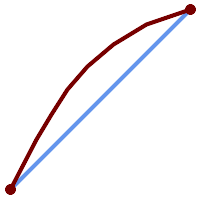
Une ligne géographique segmentée le long d'un arc de grand cercle
Voir aussi
Name
ST_SetPoint — Remplacer le point d'une ligne par un point donné.
Synopsis
geometry ST_SetPoint(geometry linestring, integer zerobasedposition, geometry point);
Description
Remplace le point N de la ligne par le point donné. L'index est basé sur 0. Les index négatifs sont comptés à rebours, de sorte que -1 est le dernier point. Cette fonction est particulièrement utile dans les triggers lorsqu'il s'agit de maintenir la relation entre les articulations lorsqu'un sommet se déplace.
Disponibilité : 1.1.0
Mise à jour 2.3.0 : indexation négative
 Cette fonction prend en charge la 3D et ne supprime pas l'indice z.
Cette fonction prend en charge la 3D et ne supprime pas l'indice z.
Exemples
--Change first point in line string from -1 3 to -1 1
SELECT ST_AsText(ST_SetPoint('LINESTRING(-1 2,-1 3)', 0, 'POINT(-1 1)'));
st_astext
-----------------------
LINESTRING(-1 1,-1 3)
---Change last point in a line string (lets play with 3d linestring this time)
SELECT ST_AsEWKT(ST_SetPoint(foo.geom, ST_NumPoints(foo.geom) - 1, ST_GeomFromEWKT('POINT(-1 1 3)')))
FROM (SELECT ST_GeomFromEWKT('LINESTRING(-1 2 3,-1 3 4, 5 6 7)') As geom) As foo;
st_asewkt
-----------------------
LINESTRING(-1 2 3,-1 3 4,-1 1 3)
SELECT ST_AsText(ST_SetPoint(g, -3, p))
FROM ST_GEomFromText('LINESTRING(0 0, 1 1, 2 2, 3 3, 4 4)') AS g
, ST_PointN(g,1) as p;
st_astext
-----------------------
LINESTRING(0 0,1 1,0 0,3 3,4 4)
Voir aussi
ST_AddPoint, ST_NPoints, ST_NumPoints, ST_PointN, ST_RemovePoint
Name
ST_ShiftLongitude — Décale les coordonnées de longitude d'une géométrie entre -180..180 et 0..360.
Synopsis
geometry ST_ShiftLongitude(geometry geom);
Description
Lit chaque point/vertex d'une géométrie et déplace sa coordonnée de longitude de -180..0 à 180..360 et vice versa si elle se trouve entre ces plages. Cette fonction est symétrique, de sorte que le résultat est une représentation 0..360 d'une donnée -180..180 et une représentation -180..180 d'une donnée 0..360.
![[Note]](images/note.png) | |
Ceci n'est utile que pour les données dont les coordonnées sont exprimées en longitude/latitude ; par exemple, SRID 4326 (WGS 84 géographique) |
![[Warning]](images/warning.png) | |
Un bug antérieur à la version 1.3.4 empêchait le fonctionnement pour MULTIPOINT. La version 1.3.4+ fonctionne également avec MULTIPOINT. |
 Cette fonction prend en charge la 3D et ne supprime pas l'indice z.
Cette fonction prend en charge la 3D et ne supprime pas l'indice z.
Amélioration : 2.0.0 introduction du support TIN et surfaces polyédriques.
NOTE : cette fonction a été renommée "ST_Shift_Longitude" dans la version 2.2.0
 Cette fonction prend en charge les surfaces Polyhedral.
Cette fonction prend en charge les surfaces Polyhedral.
 Cette fonction prend en charge les triangles et les réseaux irréguliers triangulés (TIN).
Cette fonction prend en charge les triangles et les réseaux irréguliers triangulés (TIN).
Exemples
--single point forward transformation
SELECT ST_AsText(ST_ShiftLongitude('SRID=4326;POINT(270 0)'::geometry))
st_astext
----------
POINT(-90 0)
--single point reverse transformation
SELECT ST_AsText(ST_ShiftLongitude('SRID=4326;POINT(-90 0)'::geometry))
st_astext
----------
POINT(270 0)
--for linestrings the functions affects only to the sufficient coordinates
SELECT ST_AsText(ST_ShiftLongitude('SRID=4326;LINESTRING(174 12, 182 13)'::geometry))
st_astext
----------
LINESTRING(174 12,-178 13)
Voir aussi
Name
ST_WrapX — Enveloppe une géométrie autour d'une valeur X.
Synopsis
geometry ST_WrapX(geometry geom, float8 wrap, float8 move);
Description
Cette fonction divise les géométries d'entrée et déplace ensuite chaque composant résultant tombant à droite (pour un "move" négatif) ou à gauche (pour un "move" positif) de la ligne "wrap" donnée dans la direction spécifiée par le paramètre "move", pour finalement réassembler les morceaux.
![[Note]](images/note.png) | |
Cette fonction est utile pour "recentrer" les données à long terme afin que les caractéristiques intéressantes ne soient pas produites d'un côté à l'autre. |
Disponibilité : 2.3.0 nécessite GEOS
 Cette fonction prend en charge la 3D et ne supprime pas l'indice z.
Cette fonction prend en charge la 3D et ne supprime pas l'indice z.
Exemples
-- Move all components of the given geometries whose bounding box
-- falls completely on the left of x=0 to +360
select ST_WrapX(geom, 0, 360);
-- Move all components of the given geometries whose bounding box
-- falls completely on the left of x=-30 to +360
select ST_WrapX(geom, -30, 360);
Voir aussi
Name
ST_SnapToGrid — Accrocher tous les points de la géométrie d'entrée à une grille régulière.
Synopsis
geometry ST_SnapToGrid(geometry geomA, float originX, float originY, float sizeX, float sizeY);
geometry ST_SnapToGrid(geometry geomA, float sizeX, float sizeY);
geometry ST_SnapToGrid(geometry geomA, float size);
geometry ST_SnapToGrid(geometry geomA, geometry pointOrigin, float sizeX, float sizeY, float sizeZ, float sizeM);
Description
Variante 1,2,3 : Accrocher tous les points de la géométrie d'entrée à la grille définie par l'origine et la taille des cellules. Supprime les points consécutifs tombant sur la même cellule, et renvoie éventuellement NULL si les points de sortie ne sont pas suffisants pour définir une géométrie du type donné. Les géométries écrasées d'une collection sont supprimées de celle-ci. Utile pour réduire la précision.
Variante 4 : Introduite dans la version 1.1.0 - Accroche tous les points de la géométrie d'entrée à la grille définie par son origine (le deuxième argument doit être un point) et la taille des cellules. Spécifiez 0 comme taille pour toute dimension que vous ne voulez pas accrocher à une grille.
![[Note]](images/note.png) | |
La géométrie renvoyée peut perdre sa simplicité (voir ST_IsSimple). |
![[Note]](images/note.png) | |
Avant la version 1.1.0, cette fonction renvoyait toujours une géométrie 2D. A partir de la version 1.1.0, la géométrie renvoyée aura la même dimensionnalité que la géométrie d'entrée, les valeurs de dimensions supérieures n'étant pas modifiées. Utilisez la version prenant un second argument géométrique pour définir toutes les dimensions de la grille. |
Disponibilité : 1.0.0RC1
Disponibilité : 1.1.0 - Prise en charge des Z et M
 Cette fonction prend en charge la 3D et ne supprime pas l'indice z.
Cette fonction prend en charge la 3D et ne supprime pas l'indice z.
Exemples
--Snap your geometries to a precision grid of 10^-3
UPDATE mytable
SET geom = ST_SnapToGrid(geom, 0.001);
SELECT ST_AsText(ST_SnapToGrid(
ST_GeomFromText('LINESTRING(1.1115678 2.123, 4.111111 3.2374897, 4.11112 3.23748667)'),
0.001)
);
st_astext
-------------------------------------
LINESTRING(1.112 2.123,4.111 3.237)
--Snap a 4d geometry
SELECT ST_AsEWKT(ST_SnapToGrid(
ST_GeomFromEWKT('LINESTRING(-1.1115678 2.123 2.3456 1.11111,
4.111111 3.2374897 3.1234 1.1111, -1.11111112 2.123 2.3456 1.1111112)'),
ST_GeomFromEWKT('POINT(1.12 2.22 3.2 4.4444)'),
0.1, 0.1, 0.1, 0.01) );
st_asewkt
------------------------------------------------------------------------------
LINESTRING(-1.08 2.12 2.3 1.1144,4.12 3.22 3.1 1.1144,-1.08 2.12 2.3 1.1144)
--With a 4d geometry - the ST_SnapToGrid(geom,size) only touches x and y coords but keeps m and z the same
SELECT ST_AsEWKT(ST_SnapToGrid(ST_GeomFromEWKT('LINESTRING(-1.1115678 2.123 3 2.3456,
4.111111 3.2374897 3.1234 1.1111)'),
0.01) );
st_asewkt
---------------------------------------------------------
LINESTRING(-1.11 2.12 3 2.3456,4.11 3.24 3.1234 1.1111)
Voir aussi
ST_Snap, ST_AsEWKT, ST_AsText, ST_GeomFromText, ST_GeomFromEWKT, ST_Simplify
Name
ST_Snap — Accrocher les segments et les sommets de la géométrie d'entrée aux sommets d'une géométrie de référence.
Synopsis
geometry ST_Snap(geometry input, geometry reference, float tolerance);
Description
Accroche les sommets et les segments d'une géométrie aux sommets d'une autre géométrie. Une tolérance de distance d'accrochage est utilisée pour contrôler l'endroit où l'accrochage est effectué. La géométrie résultante est la géométrie d'entrée avec les sommets accrochés. Si aucun accrochage n'a lieu, la géométrie d'entrée est renvoyée inchangée.
L'accrochage d'une géométrie à une autre peut améliorer la robustesse des opérations de superposition en éliminant les arêtes presque coïncidentes (qui posent des problèmes lors du noding et du calcul de l'intersection).
Un accrochage trop important peut entraîner la création d'une topologie non valide, c'est pourquoi le nombre et l'emplacement des sommets accrochés sont décidés à l'aide d'une heuristique pour déterminer quand il est sûr d'accrocher. Cela peut toutefois entraîner l'omission de certains accrochages potentiels.
![[Note]](images/note.png) | |
La géométrie renvoyée peut perdre sa simplicité (voir ST_IsSimple) et sa validité (voir ST_IsValid). |
Effectué par le module GEOS.
Disponibilité : 2.0.0
Exemples
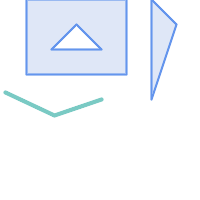 Un multipolygone représenté par une ligne (avant tout accrochage) | |
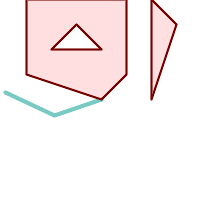 Un multipolygone est accroché à une ligne de référence avec une tolérance de 1,01 de la distance. Le nouveau multipolygone est représenté avec la ligne de référence
SELECT ST_AsText(ST_Snap(poly,line, ST_Distance(poly,line)*1.01)) AS polysnapped
FROM (SELECT
ST_GeomFromText('MULTIPOLYGON(
((26 125, 26 200, 126 200, 126 125, 26 125 ),
( 51 150, 101 150, 76 175, 51 150 )),
(( 151 100, 151 200, 176 175, 151 100 )))') As poly,
ST_GeomFromText('LINESTRING (5 107, 54 84, 101 100)') As line
) As foo;
polysnapped
---------------------------------------------------------------------
MULTIPOLYGON(((26 125,26 200,126 200,126 125,101 100,26 125),
(51 150,101 150,76 175,51 150)),((151 100,151 200,176 175,151 100)))
| 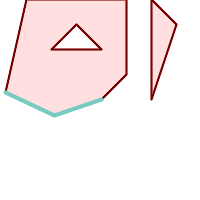 Un multipolygone est accroché à une ligne de référence avec une tolérance de 1,25 de la distance. Le nouveau multipolygone est représenté avec la ligne de référence
SELECT ST_AsText(
ST_Snap(poly,line, ST_Distance(poly,line)*1.25)
) AS polysnapped
FROM (SELECT
ST_GeomFromText('MULTIPOLYGON(
(( 26 125, 26 200, 126 200, 126 125, 26 125 ),
( 51 150, 101 150, 76 175, 51 150 )),
(( 151 100, 151 200, 176 175, 151 100 )))') As poly,
ST_GeomFromText('LINESTRING (5 107, 54 84, 101 100)') As line
) As foo;
polysnapped
---------------------------------------------------------------------
MULTIPOLYGON(((5 107,26 200,126 200,126 125,101 100,54 84,5 107),
(51 150,101 150,76 175,51 150)),((151 100,151 200,176 175,151 100)))
|
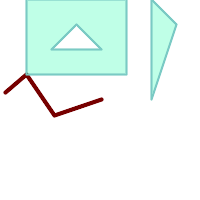 La ligne s'est accrochée au multipolygone d'origine avec une tolérance de 1,01 de la distance. La nouvelle ligne est représentée avec le multipolygone de référence
SELECT ST_AsText(
ST_Snap(line, poly, ST_Distance(poly,line)*1.01)
) AS linesnapped
FROM (SELECT
ST_GeomFromText('MULTIPOLYGON(
((26 125, 26 200, 126 200, 126 125, 26 125),
(51 150, 101 150, 76 175, 51 150 )),
((151 100, 151 200, 176 175, 151 100)))') As poly,
ST_GeomFromText('LINESTRING (5 107, 54 84, 101 100)') As line
) As foo;
linesnapped
----------------------------------------
LINESTRING(5 107,26 125,54 84,101 100)
| 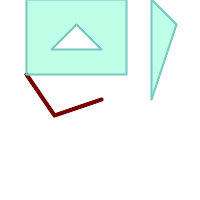 La ligne s'est accrochée au multipolygone d'origine avec une tolérance de 1,25 de la distance. La nouvelle ligne est représentée avec le multipolygone de référence
SELECT ST_AsText(
ST_Snap(line, poly, ST_Distance(poly,line)*1.25)
) AS linesnapped
FROM (SELECT
ST_GeomFromText('MULTIPOLYGON(
(( 26 125, 26 200, 126 200, 126 125, 26 125 ),
(51 150, 101 150, 76 175, 51 150 )),
((151 100, 151 200, 176 175, 151 100 )))') As poly,
ST_GeomFromText('LINESTRING (5 107, 54 84, 101 100)') As line
) As foo;
linesnapped
---------------------------------------
LINESTRING(26 125,54 84,101 100)
|
Voir aussi
Name
ST_SwapOrdinates — Renvoie une version de la géométrie donnée avec les valeurs d'ordonnées permutées.
Synopsis
geometry ST_SwapOrdinates(geometry geom, cstring ords);
Description
Renvoie une version de la géométrie donnée dont les ordonnées ont été interverties.
Le paramètre ords est une chaîne de 2 caractères désignant les ordonnées à permuter. Les noms valides sont : x, y, z et m.
Disponibilité : 2.2.0
 Cette méthode prend en charge les types Circular String et Curve.
Cette méthode prend en charge les types Circular String et Curve.
 Cette fonction prend en charge la 3D et ne supprime pas l'indice z.
Cette fonction prend en charge la 3D et ne supprime pas l'indice z.
 Cette fonction prend en charge les coordonnées M.
Cette fonction prend en charge les coordonnées M.
 Cette fonction prend en charge les surfaces Polyhedral.
Cette fonction prend en charge les surfaces Polyhedral.
 Cette fonction prend en charge les triangles et les réseaux irréguliers triangulés (TIN).
Cette fonction prend en charge les triangles et les réseaux irréguliers triangulés (TIN).
Exemple
-- Scale M value by 2
SELECT ST_AsText(
ST_SwapOrdinates(
ST_Scale(
ST_SwapOrdinates(g,'xm'),
2, 1
),
'xm')
) FROM ( SELECT 'POINT ZM (0 0 0 2)'::geometry g ) foo;
st_astext
--------------------
POINT ZM (0 0 0 4)
Voir aussi
7.6. Validation de la géométrie
Ces fonctions vérifient si les géométries sont valides selon la norme SFS de l'OGC. Elles fournissent également des informations sur la nature et la localisation de l'invalidité. Il existe également une fonction permettant de créer une géométrie valide à partir d'une géométrie invalide.
- ST_IsValid — Teste si une géométrie est bien formée en 2D.
- ST_IsValidDetail — Renvoie une ligne
valid_detailindiquant si une géométrie est valide ou sinon une raison et une localisation. - ST_IsValidReason — Renvoie un texte indiquant si une géométrie est valide, ou la raison de son invalidité.
- ST_MakeValid — Tente de rendre valide une géométrie invalide sans perdre de sommets.
Name
ST_IsValid — Teste si une géométrie est bien formée en 2D.
Synopsis
boolean ST_IsValid(geometry g);
boolean ST_IsValid(geometry g, integer flags);
Description
Teste si une valeur ST_Geometry est bien formée et valide en 2D selon les règles de l'OGC. Pour les géométries à 3 et 4 dimensions, la validité est toujours testée uniquement en 2 dimensions. Pour les géométries qui ne sont pas valides, une NOTICE PostgreSQL est émise fournissant les détails de la raison pour laquelle elle n'est pas valide.
Pour la version avec le paramètre flags, les valeurs prises en charge sont documentées dans ST_IsValidDetail Cette version n'imprime pas de NOTICE expliquant l'invalidité.
Pour plus d'informations sur la définition de la validité des géométries, reportez-vous à Section 4.4, “Validation de la géométrie”
![[Note]](images/note.png) | |
SQL-MM définit le résultat de ST_IsValid(NULL) comme étant 0, alors que PostGIS renvoie NULL. |
Effectué par le module GEOS.
La version acceptant les flags est disponible à partir de la version 2.0.0.
 Cette méthode implémente la spécification OGC Simple Features Implementation Specification for SQL 1.1.
Cette méthode implémente la spécification OGC Simple Features Implementation Specification for SQL 1.1.
 Cette méthode implémente la spécification SQL/MM. SQL-MM 3 : 5.1.9
Cette méthode implémente la spécification SQL/MM. SQL-MM 3 : 5.1.9
![[Note]](images/note.png) | |
Les spécifications de l'OGC-SFS et de SQL-MM ne comprennent pas d'argument de type flag pour ST_IsValid. L'indicateur est une extension de PostGIS. |
Exemples
SELECT ST_IsValid(ST_GeomFromText('LINESTRING(0 0, 1 1)')) As good_line,
ST_IsValid(ST_GeomFromText('POLYGON((0 0, 1 1, 1 2, 1 1, 0 0))')) As bad_poly
--results
NOTICE: Self-intersection at or near point 0 0
good_line | bad_poly
-----------+----------
t | f
Voir aussi
Name
ST_IsValidDetail — Renvoie une ligne valid_detail indiquant si une géométrie est valide ou sinon une raison et une localisation.
Synopsis
valid_detail ST_IsValidDetail(geometry geom, integer flags);
Description
Renvoie une ligne valid_detail, contenant un booléen (valid) indiquant si une géométrie est valide, un varchar (reason) indiquant une raison pour laquelle elle est invalide et une géométrie (location) indiquant où elle est invalide.
Utile pour améliorer la combinaison de ST_IsValid et ST_IsValidReason afin de générer un rapport détaillé des géométries invalides.
Le paramètre facultatif flags est un champ de type bit. Il peut avoir les valeurs suivantes :
0 : utiliser la sémantique de validité habituelle de l'OGC SFS.
1 : Considérer certains types d'anneaux auto-touchants (coquilles inversées et trous exverts) comme valides. Ceci est également connu sous le nom de "flag ESRI", car c'est le modèle de validité utilisé par ces outils. Notez que cela n'est pas valide selon le modèle OGC.
Effectué par le module GEOS.
Disponibilité : 2.0.0
Exemples
--First 3 Rejects from a successful quintuplet experiment
SELECT gid, reason(ST_IsValidDetail(geom)), ST_AsText(location(ST_IsValidDetail(geom))) as location
FROM
(SELECT ST_MakePolygon(ST_ExteriorRing(e.buff), array_agg(f.line)) As geom, gid
FROM (SELECT ST_Buffer(ST_Point(x1*10,y1), z1) As buff, x1*10 + y1*100 + z1*1000 As gid
FROM generate_series(-4,6) x1
CROSS JOIN generate_series(2,5) y1
CROSS JOIN generate_series(1,8) z1
WHERE x1
> y1*0.5 AND z1 < x1*y1) As e
INNER JOIN (SELECT ST_Translate(ST_ExteriorRing(ST_Buffer(ST_Point(x1*10,y1), z1)),y1*1, z1*2) As line
FROM generate_series(-3,6) x1
CROSS JOIN generate_series(2,5) y1
CROSS JOIN generate_series(1,10) z1
WHERE x1
> y1*0.75 AND z1 < x1*y1) As f
ON (ST_Area(e.buff)
> 78 AND ST_Contains(e.buff, f.line))
GROUP BY gid, e.buff) As quintuplet_experiment
WHERE ST_IsValid(geom) = false
ORDER BY gid
LIMIT 3;
gid | reason | location
------+-------------------+-------------
5330 | Self-intersection | POINT(32 5)
5340 | Self-intersection | POINT(42 5)
5350 | Self-intersection | POINT(52 5)
--simple example
SELECT * FROM ST_IsValidDetail('LINESTRING(220227 150406,2220227 150407,222020 150410)');
valid | reason | location
-------+--------+----------
t | |
Voir aussi
Name
ST_IsValidReason — Renvoie un texte indiquant si une géométrie est valide, ou la raison de son invalidité.
Synopsis
text ST_IsValidReason(geometry geomA);
text ST_IsValidReason(geometry geomA, integer flags);
Description
Renvoie un texte indiquant si une géométrie est valide ou, si elle est invalide, une raison pour laquelle elle l'est.
Utile en combinaison avec ST_IsValid pour générer un rapport détaillé des géométries invalides et des raisons.
Les flags autorisés sont documentés dans ST_IsValidDetail.
Effectué par le module GEOS.
Disponibilité : 1.4
Disponibilité : la version 2.0 prend des flags.
Exemples
-- invalid bow-tie polygon
SELECT ST_IsValidReason(
'POLYGON ((100 200, 100 100, 200 200,
200 100, 100 200))'::geometry) as validity_info;
validity_info
--------------------------
Self-intersection[150 150]
--First 3 Rejects from a successful quintuplet experiment
SELECT gid, ST_IsValidReason(geom) as validity_info
FROM
(SELECT ST_MakePolygon(ST_ExteriorRing(e.buff), array_agg(f.line)) As geom, gid
FROM (SELECT ST_Buffer(ST_Point(x1*10,y1), z1) As buff, x1*10 + y1*100 + z1*1000 As gid
FROM generate_series(-4,6) x1
CROSS JOIN generate_series(2,5) y1
CROSS JOIN generate_series(1,8) z1
WHERE x1
> y1*0.5 AND z1 < x1*y1) As e
INNER JOIN (SELECT ST_Translate(ST_ExteriorRing(ST_Buffer(ST_Point(x1*10,y1), z1)),y1*1, z1*2) As line
FROM generate_series(-3,6) x1
CROSS JOIN generate_series(2,5) y1
CROSS JOIN generate_series(1,10) z1
WHERE x1
> y1*0.75 AND z1 < x1*y1) As f
ON (ST_Area(e.buff)
> 78 AND ST_Contains(e.buff, f.line))
GROUP BY gid, e.buff) As quintuplet_experiment
WHERE ST_IsValid(geom) = false
ORDER BY gid
LIMIT 3;
gid | validity_info
------+--------------------------
5330 | Self-intersection [32 5]
5340 | Self-intersection [42 5]
5350 | Self-intersection [52 5]
--simple example
SELECT ST_IsValidReason('LINESTRING(220227 150406,2220227 150407,222020 150410)');
st_isvalidreason
------------------
Valid Geometry
Voir aussi
Name
ST_MakeValid — Tente de rendre valide une géométrie invalide sans perdre de sommets.
Synopsis
geometry ST_MakeValid(geometry input);
geometry ST_MakeValid(geometry input, text params);
Description
La fonction tente de créer une représentation valide d'une géométrie invalide donnée sans perdre aucun des sommets d'entrée. Les géométries valides sont retournées inchangées.
Les types de données pris en charge sont : POINTS, MULTIPOINTS, LINESTRINGS, MULTILINESTRINGS, POLYGONS, MULTIPOLYGONS et GEOMETRYCOLLECTIONS contenant n'importe quel mélange de ces éléments.
En cas de diminution de dimension (total ou partiel), la géométrie de sortie peut être une collection de géométries de dimension inférieure à égale, ou une géométrie de dimension inférieure.
Les polygones simples peuvent devenir des multigéométries en cas d'auto-intersections.
L'argument params peut être utilisé pour fournir une chaîne d'options permettant de sélectionner la méthode à utiliser pour construire une géométrie valide. La chaîne d'options est au format "method=linework|structure keepcollapsed=true|false". Si aucun argument "params" n'est fourni, l'algorithme "linework" sera utilisé par défaut.
La clé "method" a deux valeurs.
"linework" is the default algorithm, and builds valid geometries by first extracting all lines, noding that linework together, then building a value output from the linework. The requirement that no vertices are lost can generate complex collections as outputs.
"structure" is an algorithm that distinguishes between interior and exterior rings, building new geometry by unioning exterior rings, and then differencing all interior rings. The results tend to be more intuitive, where collapsed lines are discarded in the output.
The "keepcollapsed" key is only valid for the "structure" algorithm, and takes a value of "true" or "false".
Keep collapsed of "false" is the default, and means that geometry components that collapse to a lower dimensionality, for example a one-point linestring will be dropped.
Keep collapsed of "true" means geometry components that collapse to a lower dimensionality will be retained.
Effectué par le module GEOS.
Disponibilité : 2.0.0
Amélioré : 2.0.1, améliorations de la vitesse
Amélioration : 2.1.0, ajout du support pour GEOMETRYCOLLECTION et MULTIPOINT.
Amélioration : 3.1.0, suppression des coordonnées avec des valeurs NaN.
Amélioration : 3.2.0, ajout d'options d'algorithme, 'linework' et 'structure' qui nécessite GEOS >= 3.10.0.
 Cette fonction prend en charge la 3D et ne supprime pas l'indice z.
Cette fonction prend en charge la 3D et ne supprime pas l'indice z.
Exemples
 before_geom : MULTIPOLYGON de 2 polygones qui se superposent
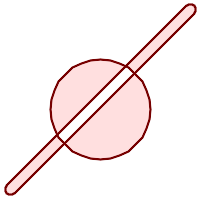 after_geom : MULTIPOLYGON de 4 polygones qui ne se superposent pas
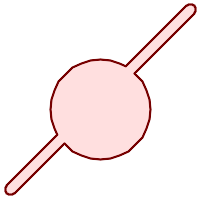 after_geom_structure : MULTIPOLYGON de 1 polygone qui ne se chevauche pas
SELECT f.geom AS before_geom, ST_MakeValid(f.geom) AS after_geom, ST_MakeValid(f.geom, 'method=structure') AS after_geom_structure FROM (SELECT 'MULTIPOLYGON(((186 194,187 194,188 195,189 195,190 195, 191 195,192 195,193 194,194 194,194 193,195 192,195 191, 195 190,195 189,195 188,194 187,194 186,14 6,13 6,12 5,11 5, 10 5,9 5,8 5,7 6,6 6,6 7,5 8,5 9,5 10,5 11,5 12,6 13,6 14,186 194)), ((150 90,149 80,146 71,142 62,135 55,128 48,119 44,110 41,100 40, 90 41,81 44,72 48,65 55,58 62,54 71,51 80,50 90,51 100, 54 109,58 118,65 125,72 132,81 136,90 139,100 140,110 139, 119 136,128 132,135 125,142 118,146 109,149 100,150 90)))'::geometry AS geom) AS f;
|
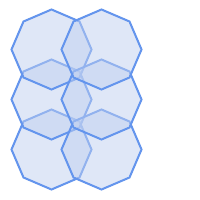 before_geom : MULTIPOLYGON de 6 polygones qui se superposent
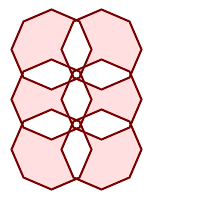 after_geom : MULTIPOLYGON de 14 polygones qui ne se superposent pas
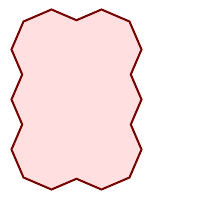 after_geom_structure : MULTIPOLYGON de 1 polygone qui ne se chevauche pas
SELECT c.geom AS before_geom,
ST_MakeValid(c.geom) AS after_geom,
ST_MakeValid(c.geom, 'method=structure') AS after_geom_structure
FROM (SELECT 'MULTIPOLYGON(((91 50,79 22,51 10,23 22,11 50,23 78,51 90,79 78,91 50)),
((91 100,79 72,51 60,23 72,11 100,23 128,51 140,79 128,91 100)),
((91 150,79 122,51 110,23 122,11 150,23 178,51 190,79 178,91 150)),
((141 50,129 22,101 10,73 22,61 50,73 78,101 90,129 78,141 50)),
((141 100,129 72,101 60,73 72,61 100,73 128,101 140,129 128,141 100)),
((141 150,129 122,101 110,73 122,61 150,73 178,101 190,129 178,141 150)))'::geometry AS geom) AS c;
|
Exemples
SELECT ST_AsText(ST_MakeValid(
'LINESTRING(0 0, 0 0)',
'method=structure keepcollapsed=true'
));
st_astext
------------
POINT(0 0)
SELECT ST_AsText(ST_MakeValid(
'LINESTRING(0 0, 0 0)',
'method=structure keepcollapsed=false'
));
st_astext
------------------
LINESTRING EMPTYVoir aussi
7.7. Fonctions des systèmes de référence spatiale
Ces fonctions fonctionnent avec le système de référence spatiale des géométries défini dans la table spatial_ref_sys.
- ST_InverseTransformPipeline — Renvoie une nouvelle géométrie dont les coordonnées ont été transformées dans un système de référence spatial différent en utilisant l'inverse d'un pipeline de transformation de coordonnées défini.
- ST_SetSRID — Définir le SRID d'une géométrie.
- ST_SRID — Renvoie l'identifiant de référence spatiale d'une géométrie.
- ST_Transform — Renvoie une nouvelle géométrie dont les coordonnées ont été transformées dans un système de référence spatial différent.
- ST_TransformPipeline — Retourner une nouvelle géométrie avec des coordonnées transformées dans un système de référence spatial différent à l'aide d'un pipeline de transformation de coordonnées défini.
- postgis_srs_codes — Renvoie la liste des codes SRS associés à l'autorité donnée.
- postgis_srs — Renvoyer une fiche de métadonnées pour l'autorité et le srid demandés.
- postgis_srs_all — Renvoie des enregistrements de métadonnées pour chaque système de référence spatiale dans la base de données Proj sous-jacente.
- postgis_srs_search — Renvoyer les enregistrements de métadonnées pour les systèmes de coordonnées projetées dont les zones d'utilisation contiennent entièrement le paramètre bounds.
Name
ST_InverseTransformPipeline — Renvoie une nouvelle géométrie dont les coordonnées ont été transformées dans un système de référence spatial différent en utilisant l'inverse d'un pipeline de transformation de coordonnées défini.
Synopsis
geometry ST_InverseTransformPipeline(geometry geom, text pipeline, integer to_srid);
Description
Renvoie une nouvelle géométrie dont les coordonnées ont été transformées dans un système de référence spatial différent à l'aide d'un pipeline de transformation de coordonnées défini pour aller dans la direction inverse.
Voir ST_TransformPipeline pour plus de détails sur l'écriture d'un pipeline de transformation.
Disponibilité : 3.4.0
Le SRID de la géométrie en entrée est ignoré et le SRID de la géométrie de sortie sera mis à zéro à moins qu'une valeur ne soit fournie via le paramètre facultatif to_srid. Lors de l'utilisation de ST_TransformPipeline, le pipeline est exécuté dans le sens direct. En utilisant `ST_InverseTransformPipeline()`, le pipeline est exécuté dans le sens inverse.
Les transformations utilisant des pipelines sont une version spéciale de ST_Transform. Dans la plupart des cas, `ST_Transform` choisira les opérations correctes pour convertir entre les systèmes de coordonnées, et devrait être préféré.
Exemples
Changer WGS 84 long lat en UTM 31N en utilisant la conversion EPSG:16031
-- Inverse direction
SELECT ST_AsText(ST_InverseTransformPipeline('POINT(426857.9877165967 5427937.523342293)'::geometry,
'urn:ogc:def:coordinateOperation:EPSG::16031')) AS wgs_geom;
wgs_geom
----------------------------
POINT(2 48.99999999999999)
(1 row)
Exemple GDA2020.
-- using ST_Transform with automatic selection of a conversion pipeline.
SELECT ST_AsText(ST_Transform('SRID=4939;POINT(143.0 -37.0)'::geometry, 7844)) AS gda2020_auto;
gda2020_auto
-----------------------------------------------
POINT(143.00000635638918 -36.999986706128176)
(1 row)
Voir aussi
Name
ST_SetSRID — Définir le SRID d'une géométrie.
Synopsis
geometry ST_SetSRID(geometry geom, integer srid);
Description
Définit le SRID d'une géométrie à une valeur entière particulière. Utile pour construire des boîtes de délimitation pour les requêtes.
![[Note]](images/note.png) | |
Cette fonction ne transforme en aucune façon les coordonnées de la géométrie - elle définit simplement les métadonnées définissant le système de référence spatiale dans lequel la géométrie est supposée se trouver. Utilisez ST_Transform si vous souhaitez transformer la géométrie dans une nouvelle projection. |
 Cette méthode implémente la spécification OGC Simple Features Implementation Specification for SQL 1.1.
Cette méthode implémente la spécification OGC Simple Features Implementation Specification for SQL 1.1.
 Cette méthode prend en charge les types Circular String et Curve.
Cette méthode prend en charge les types Circular String et Curve.
Exemples
-- Marquer un point comme WGS 84 long lat --
SELECT ST_SetSRID(ST_Point(-123.365556, 48.428611),4326) As wgs84long_lat;
-- the ewkt representation (wrap with ST_AsEWKT) -
SRID=4326;POINT(-123.365556 48.428611)
-- Marquer un point comme WGS 84 long lat puis le transformer en mercator web (Mercator Sphérique) --
SELECT ST_Transform(ST_SetSRID(ST_Point(-123.365556, 48.428611),4326),3785) As spere_merc;
-- the ewkt representation (wrap with ST_AsEWKT) -
SRID=3785;POINT(-13732990.8753491 6178458.96425423)
Name
ST_SRID — Renvoie l'identifiant de référence spatiale d'une géométrie.
Synopsis
integer ST_SRID(geometry g1);
Description
Renvoie l'identifiant de référence spatiale pour la ST_Geometry tel que défini dans la table spatial_ref_sys. Section 4.5, “Systèmes de référence spatiale”
![[Note]](images/note.png) | |
La table spatial_ref_sys est une table qui répertorie tous les systèmes de référence spatiale connus de PostGIS et qui est utilisée pour les transformations d'un système de référence spatiale à un autre. Il est donc important de vérifier que vous disposez du bon identifiant de système de référence spatiale si vous envisagez de transformer vos géométries. |
 Cette méthode implémente la spécification OGC Simple Features Implementation Specification for SQL 1.1. s2.1.1.1
Cette méthode implémente la spécification OGC Simple Features Implementation Specification for SQL 1.1. s2.1.1.1
 Cette méthode implémente la spécification SQL/MM. SQL-MM 3 : 5.1.5
Cette méthode implémente la spécification SQL/MM. SQL-MM 3 : 5.1.5
 Cette méthode prend en charge les types Circular String et Curve.
Cette méthode prend en charge les types Circular String et Curve.
Exemples
SELECT ST_SRID(ST_GeomFromText('POINT(-71.1043 42.315)',4326));
--result
4326
Name
ST_Transform — Renvoie une nouvelle géométrie dont les coordonnées ont été transformées dans un système de référence spatial différent.
Synopsis
geometry ST_Transform(geometry g1, integer srid);
geometry ST_Transform(geometry geom, text to_proj);
geometry ST_Transform(geometry geom, text from_proj, text to_proj);
geometry ST_Transform(geometry geom, text from_proj, integer to_srid);
Description
Renvoie une nouvelle géométrie dont les coordonnées ont été transformées dans un système de référence spatiale différent. La référence spatiale de destination to_srid peut être identifiée par un paramètre entier SRID valide (c'est-à-dire qu'elle doit exister dans la table spatial_ref_sys). Il est également possible d'utiliser une référence spatiale définie comme une chaîne PROJ.4 pour to_proj et/ou from_proj, mais ces méthodes ne sont pas optimisées. Si le système de référence spatiale de destination est exprimé avec une chaîne PROJ.4 au lieu d'un SRID, le SRID de la géométrie de sortie sera mis à zéro. A l'exception des fonctions avec from_proj, les géométries d'entrée doivent avoir un SRID défini.
ST_Transform est souvent confondu avec ST_SetSRID. ST_Transform modifie en fait les coordonnées d'une géométrie d'un système de référence spatiale à un autre, tandis que ST_SetSRID() modifie simplement l'identifiant SRID de la géométrie.
ST_Transform sélectionne automatiquement un pipeline de conversion approprié en fonction des systèmes de référence spatiale source et cible. Pour utiliser une méthode de conversion spécifique, utilisez ST_TransformPipeline.
![[Note]](images/note.png) | |
PostGIS doit être compilé avec le support PROJ. Utilisez PostGIS_Full_Version pour confirmer que vous avez compilé le support PROJ. |
![[Note]](images/note.png) | |
Si l'on utilise plus d'une transformation, il est utile de disposer d'un index fonctionnel sur les transformations les plus couramment utilisées afin de tirer parti de l'utilisation de l'index. |
![[Note]](images/note.png) | |
Avant la version 1.3.4, cette fonction se bloquait si elle était utilisée avec des géométries contenant des CURVES. Ce problème est corrigé dans la version 1.3.4+ |
Amélioration : 2.0.0 introduction du support des surfaces polyédriques.
Amélioration : la version 2.3.0 a introduit la prise en charge du texte PROJ.4 direct.
 Cette méthode implémente la spécification SQL/MM. SQL-MM 3: 5.1.6
Cette méthode implémente la spécification SQL/MM. SQL-MM 3: 5.1.6
 Cette méthode prend en charge les types Circular String et Curve.
Cette méthode prend en charge les types Circular String et Curve.
 Cette fonction prend en charge les surfaces Polyhedral.
Cette fonction prend en charge les surfaces Polyhedral.
Exemples
Changer la géométrie des pieds US du plan de l'État du Massachusetts en WGS 84 long lat
SELECT ST_AsText(ST_Transform(ST_GeomFromText('POLYGON((743238 2967416,743238 2967450,
743265 2967450,743265.625 2967416,743238 2967416))',2249),4326)) As wgs_geom;
wgs_geom
---------------------------
POLYGON((-71.1776848522251 42.3902896512902,-71.1776843766326 42.3903829478009,
-71.1775844305465 42.3903826677917,-71.1775825927231 42.3902893647987,-71.177684
8522251 42.3902896512902));
(1 row)
--3D Circular String example
SELECT ST_AsEWKT(ST_Transform(ST_GeomFromEWKT('SRID=2249;CIRCULARSTRING(743238 2967416 1,743238 2967450 2,743265 2967450 3,743265.625 2967416 3,743238 2967416 4)'),4326));
st_asewkt
--------------------------------------------------------------------------------------
SRID=4326;CIRCULARSTRING(-71.1776848522251 42.3902896512902 1,-71.1776843766326 42.3903829478009 2,
-71.1775844305465 42.3903826677917 3,
-71.1775825927231 42.3902893647987 3,-71.1776848522251 42.3902896512902 4)
Exemple de création d'un index fonctionnel partiel. Pour les tables dont vous n'êtes pas sûr que toutes les géométries seront renseignées, il est préférable d'utiliser un index partiel qui laisse de côté les géométries nulles, ce qui permet à la fois de conserver de l'espace et de rendre votre index plus petit et plus efficace.
CREATE INDEX idx_geom_26986_parcels
ON parcels
USING gist
(ST_Transform(geom, 26986))
WHERE geom IS NOT NULL;
Exemples d'utilisation du texte PROJ.4 pour transformer avec des références spatiales personnalisées.
-- Find intersection of two polygons near the North pole, using a custom Gnomic projection
-- See http://boundlessgeo.com/2012/02/flattening-the-peel/
WITH data AS (
SELECT
ST_GeomFromText('POLYGON((170 50,170 72,-130 72,-130 50,170 50))', 4326) AS p1,
ST_GeomFromText('POLYGON((-170 68,-170 90,-141 90,-141 68,-170 68))', 4326) AS p2,
'+proj=gnom +ellps=WGS84 +lat_0=70 +lon_0=-160 +no_defs'::text AS gnom
)
SELECT ST_AsText(
ST_Transform(
ST_Intersection(ST_Transform(p1, gnom), ST_Transform(p2, gnom)),
gnom, 4326))
FROM data;
st_astext
--------------------------------------------------------------------------------
POLYGON((-170 74.053793645338,-141 73.4268621378904,-141 68,-170 68,-170 74.053793645338))
Configurer le comportement de transformation
Parfois, la transformation de coordonnées impliquant un décalage de grille peut échouer, par exemple si PROJ.4 n'a pas été construit avec des fichiers de décalage de grille ou si la coordonnée ne se trouve pas dans la plage pour laquelle le décalage de grille est défini. Par défaut, PostGIS génère une erreur si un fichier de décalage de grille n'est pas présent, mais ce comportement peut être configuré pour chaque SRID, soit en testant différentes valeurs to_proj de texte PROJ.4, soit en modifiant la valeur proj4text dans la table spatial_ref_sys.
Par exemple, le paramètre proj4text +datum=NAD87 est une forme abrégée du paramètre +nadgrids suivant :
+nadgrids=@conus,@alaska,@ntv2_0.gsb,@ntv1_can.dat
Le préfixe @ signifie qu'aucune erreur n'est signalée si les fichiers ne sont pas présents, mais si la fin de la liste est atteinte sans qu'aucun fichier n'ait été approprié (c'est-à-dire trouvé et se chevauchant), une erreur est émise.
Si, à l'inverse, vous voulez vous assurer qu'au moins les fichiers standard sont présents, mais que si tous les fichiers ont été analysés sans résultat, une transformation nulle est appliquée, vous pouvez utiliser :
+nadgrids=@conus,@alaska,@ntv2_0.gsb,@ntv1_can.dat,null
Le fichier de décalage de grille nul est un fichier de décalage de grille valide couvrant le monde entier et n'appliquant aucun décalage. Ainsi, pour un exemple complet, si vous vouliez modifier PostGIS de manière à ce que les transformations du SRID 4267 qui ne se situent pas dans la plage correcte n'entraînent pas d'ERREUR, vous utiliseriez ce qui suit :
UPDATE spatial_ref_sys SET proj4text = '+proj=longlat +ellps=clrk66 +nadgrids=@conus,@alaska,@ntv2_0.gsb,@ntv1_can.dat,null +no_defs' WHERE srid = 4267;
Name
ST_TransformPipeline — Retourner une nouvelle géométrie avec des coordonnées transformées dans un système de référence spatial différent à l'aide d'un pipeline de transformation de coordonnées défini.
Synopsis
geometry ST_TransformPipeline(geometry g1, text pipeline, integer to_srid);
Description
Retourner une nouvelle géométrie dont les coordonnées ont été transformées dans un système de référence spatial différent à l'aide d'un pipeline de transformation de coordonnées défini.
Les pipelines de transformation sont définis à l'aide de l'un des formats de texte suivants :
urn:ogc:def:coordinateOperation:AUTHORITY::CODE. Notez qu'une simple chaîne de caractèreEPSG:CODEn'identifie pas de manière unique une opération de coordonnées : le même code EPSG peut être utilisé pour une définition CRS.Une chaîne de caractères de pipeline PROJ de la forme :
+proj=pipeline .... La normalisation automatique des axes ne sera pas appliquée et, si nécessaire, l'appelant devra ajouter une étape de pipeline supplémentaire ou supprimer les étapesaxisswap.Opérations concaténées de la forme :
urn:ogc:def:coordinateOperation,coordinateOperation:EPSG::3895,coordinateOperation:EPSG::1618.
Disponibilité : 3.4.0
Le SRID de la géométrie d'entrée est ignoré, et le SRID de la géométrie de sortie sera mis à zéro à moins qu'une valeur ne soit fournie via le paramètre optionnel to_srid. Lors de l'utilisation de `ST_TransformPipeline()`, le pipeline est exécuté dans la direction avant. En utilisant ST_InverseTransformPipeline le pipeline est exécuté dans le sens inverse.
Les transformations utilisant des pipelines sont une version spéciale de ST_Transform. Dans la plupart des cas, `ST_Transform` choisira les opérations correctes pour convertir entre les systèmes de coordonnées, et devrait être préféré.
Exemples
Changer WGS 84 long lat en UTM 31N en utilisant la conversion EPSG:16031
-- Forward direction
SELECT ST_AsText(ST_TransformPipeline('SRID=4326;POINT(2 49)'::geometry,
'urn:ogc:def:coordinateOperation:EPSG::16031')) AS utm_geom;
utm_geom
--------------------------------------------
POINT(426857.9877165967 5427937.523342293)
(1 row)
-- Inverse direction
SELECT ST_AsText(ST_InverseTransformPipeline('POINT(426857.9877165967 5427937.523342293)'::geometry,
'urn:ogc:def:coordinateOperation:EPSG::16031')) AS wgs_geom;
wgs_geom
----------------------------
POINT(2 48.99999999999999)
(1 row)
Exemple GDA2020.
-- using ST_Transform with automatic selection of a conversion pipeline.
SELECT ST_AsText(ST_Transform('SRID=4939;POINT(143.0 -37.0)'::geometry, 7844)) AS gda2020_auto;
gda2020_auto
-----------------------------------------------
POINT(143.00000635638918 -36.999986706128176)
(1 row)
-- using a defined conversion (EPSG:8447)
SELECT ST_AsText(ST_TransformPipeline('SRID=4939;POINT(143.0 -37.0)'::geometry,
'urn:ogc:def:coordinateOperation:EPSG::8447')) AS gda2020_code;
gda2020_code
----------------------------------------------
POINT(143.0000063280214 -36.999986718287545)
(1 row)
-- using a PROJ pipeline definition matching EPSG:8447, as returned from
-- 'projinfo -s EPSG:4939 -t EPSG:7844'.
-- NOTE: any 'axisswap' steps must be removed.
SELECT ST_AsText(ST_TransformPipeline('SRID=4939;POINT(143.0 -37.0)'::geometry,
'+proj=pipeline
+step +proj=unitconvert +xy_in=deg +xy_out=rad
+step +proj=hgridshift +grids=au_icsm_GDA94_GDA2020_conformal_and_distortion.tif
+step +proj=unitconvert +xy_in=rad +xy_out=deg')) AS gda2020_pipeline;
gda2020_pipeline
----------------------------------------------
POINT(143.0000063280214 -36.999986718287545)
(1 row)
Voir aussi
Name
postgis_srs_codes — Renvoie la liste des codes SRS associés à l'autorité donnée.
Synopsis
setof text postgis_srs_codes(text auth_name);
Description
Renvoie un ensemble de tous les auth_srid pour le auth_name donné.
Disponibilité : 3.4.0
Proj version 6+
Exemples
Indiquez les dix premiers codes associés à l'autorité EPSG.
SELECT * FROM postgis_srs_codes('EPSG') LIMIT 10;
postgis_srs_codes
-------------------
2000
20004
20005
20006
20007
20008
20009
2001
20010
20011
Voir aussi
Name
postgis_srs — Renvoyer une fiche de métadonnées pour l'autorité et le srid demandés.
Synopsis
setof record postgis_srs(text auth_name, text auth_srid);
Description
Renvoie un enregistrement de métadonnées pour le auth_srid demandé pour le auth_name donné. L'enregistrement contiendra les éléments suivants : auth_name, auth_srid, srname, srtext, proj4text, et les angles de la zone d'utilisation, point_sw et point_ne.
Disponibilité : 3.4.0
Proj version 6+
Exemples
Obtenir les métadonnées pour EPSG:3005.
SELECT * FROM postgis_srs('EPSG', '3005');
auth_name | EPSG
auth_srid | 3005
srname | NAD83 / BC Albers
srtext | PROJCS["NAD83 / BC Albers", ... ]]
proj4text | +proj=aea +lat_0=45 +lon_0=-126 +lat_1=50 +lat_2=58.5 +x_0=1000000 +y_0=0 +datum=NAD83 +units=m +no_defs +type=crs
point_sw | 0101000020E6100000E17A14AE476161C00000000000204840
point_ne | 0101000020E610000085EB51B81E855CC0E17A14AE47014E40
Voir aussi
Name
postgis_srs_all — Renvoie des enregistrements de métadonnées pour chaque système de référence spatiale dans la base de données Proj sous-jacente.
Synopsis
setof record postgis_srs_all(void);
Description
Renvoie un ensemble d'enregistrements de métadonnées dans la base de données Proj sous-jacente. Les enregistrements auront le auth_name, auth_srid, srname, srtext, proj4text, et les angles de la zone d'utilisation, point_sw et point_ne.
Disponibilité : 3.4.0
Proj version 6+
Exemples
Obtenir les 10 premiers enregistrements de métadonnées de la base de données Proj.
SELECT auth_name, auth_srid, srname FROM postgis_srs_all() LIMIT 10; auth_name | auth_srid | srname -----------+-----------+------------------------------------------ EPSG | 2000 | Anguilla 1957 / British West Indies Grid EPSG | 20004 | Pulkovo 1995 / Gauss-Kruger zone 4 EPSG | 20005 | Pulkovo 1995 / Gauss-Kruger zone 5 EPSG | 20006 | Pulkovo 1995 / Gauss-Kruger zone 6 EPSG | 20007 | Pulkovo 1995 / Gauss-Kruger zone 7 EPSG | 20008 | Pulkovo 1995 / Gauss-Kruger zone 8 EPSG | 20009 | Pulkovo 1995 / Gauss-Kruger zone 9 EPSG | 2001 | Antigua 1943 / British West Indies Grid EPSG | 20010 | Pulkovo 1995 / Gauss-Kruger zone 10 EPSG | 20011 | Pulkovo 1995 / Gauss-Kruger zone 11
Voir aussi
Name
postgis_srs_search — Renvoyer les enregistrements de métadonnées pour les systèmes de coordonnées projetées dont les zones d'utilisation contiennent entièrement le paramètre bounds.
Synopsis
setof record postgis_srs_search(geometry bounds, text auth_name=EPSG);
Description
Renvoie un ensemble d'enregistrements de métadonnées pour les systèmes de coordonnées projetées dont les zones d'utilisation contiennent entièrement le paramètre bounds. Chaque enregistrement contiendra le auth_name, auth_srid, srname, srtext, proj4text, et les angles de la zone d'utilisation, point_sw et point_ne.
La recherche ne porte que sur les systèmes de coordonnées projetées et vise à permettre aux utilisateurs d'explorer les systèmes possibles en fonction de l'étendue de leurs données.
Disponibilité : 3.4.0
Proj version 6+
Exemples
Recherche de systèmes de coordonnées projetées en Louisiane.
SELECT auth_name, auth_srid, srname,
ST_AsText(point_sw) AS point_sw,
ST_AsText(point_ne) AS point_ne
FROM postgis_srs_search('SRID=4326;LINESTRING(-90 30, -91 31)')
LIMIT 3;
auth_name | auth_srid | srname | point_sw | point_ne
-----------+-----------+--------------------------------------+---------------------+---------------------
EPSG | 2801 | NAD83(HARN) / Louisiana South | POINT(-93.94 28.85) | POINT(-88.75 31.07)
EPSG | 3452 | NAD83 / Louisiana South (ftUS) | POINT(-93.94 28.85) | POINT(-88.75 31.07)
EPSG | 3457 | NAD83(HARN) / Louisiana South (ftUS) | POINT(-93.94 28.85) | POINT(-88.75 31.07)
Examinez une table pour connaître l'étendue maximale et trouvez les systèmes de coordonnées projetées qui pourraient convenir.
WITH ext AS ( SELECT ST_Extent(geom) AS geom, Max(ST_SRID(geom)) AS srid FROM foo ) SELECT auth_name, auth_srid, srname, ST_AsText(point_sw) AS point_sw, ST_AsText(point_ne) AS point_ne FROM ext CROSS JOIN postgis_srs_search(ST_SetSRID(ext.geom, ext.srid)) LIMIT 3;
Voir aussi
7.8. Import de géométrie
Ces fonctions créent des objets géométriques à partir de divers formats textuels ou binaires.
7.8.1. Well-Known Text (WKT)
- ST_BdPolyFromText — Construit un Polygon à partir d'une collection de lignes fermées, exprimées sous forme de MultiLineString en représentation Well-Known text.
- ST_BdMPolyFromText — Construit un MultiPolygon à partir d'une collection de lignes fermées, exprimées sous forme de MultiLineString en représentation Well-Known text.
- ST_GeogFromText — Retourne un objet de type geography à partir de sa représentation Well-Know Text (WKT ou EWKT).
- ST_GeographyFromText — Retourne un objet de type geography à partir de sa représentation Well-Know Text (WKT ou EWKT).
- ST_GeomCollFromText — Crée une collection Geometry à partir de la collection WKT avec le SRID donné. Si le SRID n'est pas donné, la valeur par défaut est 0.
- ST_GeomFromEWKT — Retourne un objet ST_Geometry à partir de sa représentation textuelle étendue (Extended Well-Known Text representation, EWKT).
- ST_GeomFromMARC21 — Prend les données géographiques MARC21/XML en entrée et renvoie un objet géométrique PostGIS.
- ST_GeometryFromText — Retourne un objet ST_Geometry à partir de sa représentation textuelle Well-Known Text (WKT). Alias pour ST_GeomFromText
- ST_GeomFromText — Retourne un objet ST_Geometry à partir de sa représentation textuelle Well-Known Text (WKT).
- ST_LineFromText — Construit une géométrie à partir d'une représentation WKT avec le SRID donné. Si aucun SRID n'est donné, la valeur par défaut est 0.
- ST_MLineFromText — Retourne un objet de type ST_MultiLineString à partir de sa représentation WKT.
- ST_MPointFromText — Créé une Geometry depuis un WKT avec le SRID donné. Si le SRID n'est pas fourni, il sera défini par défaut à 0.
- ST_MPolyFromText — Crée une géométrie multi-polygone à partir de WKT avec le SRID donné. Si le SRID n'est pas donné, la valeur par défaut est 0.
- ST_PointFromText — Construit une géométrie point à partir d'une représentation WKT et le SRID donné. Si aucun SRID n'est donné, la valeur par défaut est 0.
- ST_PolygonFromText — Créé une Geometry depuis un WKT avec le SRID donné. Si le SRID n'est pas fourni, il sera défini par défaut à 0.
- ST_WKTToSQL — Retourne un objet ST_Geometry à partir de sa représentation textuelle Well-Known Text (WKT). Alias pour ST_GeomFromText
Name
ST_BdPolyFromText — Construit un Polygon à partir d'une collection de lignes fermées, exprimées sous forme de MultiLineString en représentation Well-Known text.
Synopsis
geometry ST_BdPolyFromText(text WKT, integer srid);
Description
Construit un Polygon à partir d'une collection de lignes fermées, exprimées sous forme de MultiLineString en représentation Well-Known text.
![[Note]](images/note.png) | |
Renvoie une erreur si le WKT n'est pas une MULTILINESTRING. Renvoie une erreur si le résultat est un MULTIPOLYGON. Utiliser ST_BdMPolyFromText dans ce cas, ou voir ST_BuildArea() pour une approche basée sur une fonction spécifique. |
 Cette méthode implémente la spécification OGC Simple Features Implementation Specification for SQL 1.1. s3.2.6.2
Cette méthode implémente la spécification OGC Simple Features Implementation Specification for SQL 1.1. s3.2.6.2
Effectué par le module GEOS.
Disponibilité : 1.1.0
Voir aussi
Name
ST_BdMPolyFromText — Construit un MultiPolygon à partir d'une collection de lignes fermées, exprimées sous forme de MultiLineString en représentation Well-Known text.
Synopsis
geometry ST_BdMPolyFromText(text WKT, integer srid);
Description
Construit un Polygon à partir d'une collection de lignes fermées, de polygones ou de MultiLineStrings exprimés en représentation Well-Known text.
![[Note]](images/note.png) | |
Renvoie une erreur si le WKT n'est pas une MULTILINESTRING. Force le type de retour en MULTIPOLYGON même si le résultat est en fait composé d'un seul POLYGON. Utiliser ST_BdPolyFromText si l'on est sûr que le résultat produit des Polygon, ou voir la fonction spécifique PostGIS ST_BuildArea(). |
 Cette méthode implémente la spécification OGC Simple Features Implementation Specification for SQL 1.1. s3.2.6.2
Cette méthode implémente la spécification OGC Simple Features Implementation Specification for SQL 1.1. s3.2.6.2
Effectué par le module GEOS.
Disponibilité : 1.1.0
Voir aussi
Name
ST_GeogFromText — Retourne un objet de type geography à partir de sa représentation Well-Know Text (WKT ou EWKT).
Synopsis
geography ST_GeogFromText(text EWKT);
Description
Retourne un objet de type geography à partir de sa représentation Well-Know Text (WKT ou EWKT). Le SRID 4326 est pris par défaut. Ceci est un alias pour ST_GeographyFromText. Les coordonnées des points sont exprimées en longitude latitude.
Exemples
--- converting lon lat coords to geography
ALTER TABLE sometable ADD COLUMN geog geography(POINT,4326);
UPDATE sometable SET geog = ST_GeogFromText('SRID=4326;POINT(' || lon || ' ' || lat || ')');
--- specify a geography point using EPSG:4267, NAD27
SELECT ST_AsEWKT(ST_GeogFromText('SRID=4267;POINT(-77.0092 38.889588)'));
Voir aussi
Name
ST_GeographyFromText — Retourne un objet de type geography à partir de sa représentation Well-Know Text (WKT ou EWKT).
Synopsis
geography ST_GeographyFromText(text EWKT);
Description
Retourne un objet de type geography à partir de sa représentation Well-Know Text (WKT ou EWKT). SRID 4326 par défaut.
Voir aussi
Name
ST_GeomCollFromText — Crée une collection Geometry à partir de la collection WKT avec le SRID donné. Si le SRID n'est pas donné, la valeur par défaut est 0.
Synopsis
geometry ST_GeomCollFromText(text WKT, integer srid);
geometry ST_GeomCollFromText(text WKT);
Description
Crée une géométrie de collection à partir de la représentation Well-Known-Text (WKT) avec le SRID donné. Si le SRID n'est pas donné, la valeur par défaut est 0.
OGC SPEC 3.2.6.2 - l'option SRID est issue des tests de conformité
Retourne null si le WKT n'est pas une GEOMETRYCOLLECTION
![[Note]](images/note.png) | |
Si vous êtes absolument sûrs que toutes les géométries WKT sont des collections, ne pas utiliser cette fonction. Elle est plus lente que ST_GeomFromText à cause d'une étape de validation supplémentaire. |
 Cette méthode implémente la spécification OGC Simple Features Implementation Specification for SQL 1.1. s3.2.6.2
Cette méthode implémente la spécification OGC Simple Features Implementation Specification for SQL 1.1. s3.2.6.2
 Cette méthode implémente la spécification SQL/MM.
Cette méthode implémente la spécification SQL/MM.
Exemples
SELECT ST_GeomCollFromText('GEOMETRYCOLLECTION(POINT(1 2),LINESTRING(1 2, 3 4))');
Voir aussi
Name
ST_GeomFromEWKT — Retourne un objet ST_Geometry à partir de sa représentation textuelle étendue (Extended Well-Known Text representation, EWKT).
Synopsis
geometry ST_GeomFromEWKT(text EWKT);
Description
Retourne un objet ST_Geometry à partir de sa représentation textuelle étendue OGC (Extended Well-Known Text representation, EWKT).
![[Note]](images/note.png) | |
Le format EWKT n'est pas une norme OGC, mais un format spécifique à PostGIS incluant l'identifiant du système de référence des coordonnées (SRID) |
Amélioration : 2.0.0 introduction du support TIN et surfaces polyédriques.
 Cette fonction prend en charge la 3D et ne supprime pas l'indice z.
Cette fonction prend en charge la 3D et ne supprime pas l'indice z.
 Cette méthode prend en charge les types Circular String et Curve.
Cette méthode prend en charge les types Circular String et Curve.
 Cette fonction prend en charge les surfaces Polyhedral.
Cette fonction prend en charge les surfaces Polyhedral.
 Cette fonction prend en charge les triangles et les réseaux irréguliers triangulés (TIN).
Cette fonction prend en charge les triangles et les réseaux irréguliers triangulés (TIN).
Exemples
SELECT ST_GeomFromEWKT('SRID=4269;LINESTRING(-71.160281 42.258729,-71.160837 42.259113,-71.161144 42.25932)');
SELECT ST_GeomFromEWKT('SRID=4269;MULTILINESTRING((-71.160281 42.258729,-71.160837 42.259113,-71.161144 42.25932))');
SELECT ST_GeomFromEWKT('SRID=4269;POINT(-71.064544 42.28787)');
SELECT ST_GeomFromEWKT('SRID=4269;POLYGON((-71.1776585052917 42.3902909739571,-71.1776820268866 42.3903701743239,
-71.1776063012595 42.3903825660754,-71.1775826583081 42.3903033653531,-71.1776585052917 42.3902909739571))');
SELECT ST_GeomFromEWKT('SRID=4269;MULTIPOLYGON(((-71.1031880899493 42.3152774590236,
-71.1031627617667 42.3152960829043,-71.102923838298 42.3149156848307,
-71.1023097974109 42.3151969047397,-71.1019285062273 42.3147384934248,
-71.102505233663 42.3144722937587,-71.10277487471 42.3141658254797,
-71.103113945163 42.3142739188902,-71.10324876416 42.31402489987,
-71.1033002961013 42.3140393340215,-71.1033488797549 42.3139495090772,
-71.103396240451 42.3138632439557,-71.1041521907712 42.3141153348029,
-71.1041411411543 42.3141545014533,-71.1041287795912 42.3142114839058,
-71.1041188134329 42.3142693656241,-71.1041112482575 42.3143272556118,
-71.1041072845732 42.3143851580048,-71.1041057218871 42.3144430686681,
-71.1041065602059 42.3145009876017,-71.1041097995362 42.3145589148055,
-71.1041166403905 42.3146168544148,-71.1041258822717 42.3146748022936,
-71.1041375307579 42.3147318674446,-71.1041492906949 42.3147711126569,
-71.1041598612795 42.314808571739,-71.1042515013869 42.3151287620809,
-71.1041173835118 42.3150739481917,-71.1040809891419 42.3151344119048,
-71.1040438678912 42.3151191367447,-71.1040194562988 42.3151832057859,
-71.1038734225584 42.3151140942995,-71.1038446938243 42.3151006300338,
-71.1038315271889 42.315094347535,-71.1037393329282 42.315054824985,
-71.1035447555574 42.3152608696313,-71.1033436658644 42.3151648370544,
-71.1032580383161 42.3152269126061,-71.103223066939 42.3152517403219,
-71.1031880899493 42.3152774590236)),
((-71.1043632495873 42.315113108546,-71.1043583974082 42.3151211109857,
-71.1043443253471 42.3150676015829,-71.1043850704575 42.3150793250568,-71.1043632495873 42.315113108546)))');
--3d circular string
SELECT ST_GeomFromEWKT('CIRCULARSTRING(220268 150415 1,220227 150505 2,220227 150406 3)');
--Polyhedral Surface example
SELECT ST_GeomFromEWKT('POLYHEDRALSURFACE(
((0 0 0, 0 0 1, 0 1 1, 0 1 0, 0 0 0)),
((0 0 0, 0 1 0, 1 1 0, 1 0 0, 0 0 0)),
((0 0 0, 1 0 0, 1 0 1, 0 0 1, 0 0 0)),
((1 1 0, 1 1 1, 1 0 1, 1 0 0, 1 1 0)),
((0 1 0, 0 1 1, 1 1 1, 1 1 0, 0 1 0)),
((0 0 1, 1 0 1, 1 1 1, 0 1 1, 0 0 1))
)');
Voir aussi
Name
ST_GeomFromMARC21 — Prend les données géographiques MARC21/XML en entrée et renvoie un objet géométrique PostGIS.
Synopsis
geometry ST_GeomFromMARC21 ( text marcxml );
Description
Cette fonction crée une géométrie PostGIS à partir d'un enregistrement MARC21/XML, qui peut contenir un POINT ou un POLYGON. En cas d'entrées de données géographiques multiples dans le même enregistrement MARC21/XML, un MULTIPOINT ou MULTIPOLYGON sera renvoyé. Si la notice contient des types de géométrie mixtes, une GEOMETRYCOLLECTION sera retournée. Il renvoie NULL si l'enregistrement MARC21/XML ne contient pas de données géographiques (datafield :034).
Prise en charge des versions LOC MARC21/XML :
Disponibilité : 3.3.0, nécessite libxml2 2.6+
![[Note]](images/note.png) | |
Les données mathématiques cartographiques codées MARC21/XML ne fournissent actuellement aucun moyen de décrire le système de référence spatiale des coordonnées codées, de sorte que cette fonction retournera toujours une géométrie avec |
![[Note]](images/note.png) | |
Les géométries |
Exemples
Conversion de données géographiques MARC21/XML contenant un seul POINT encodé en hddd.dddddd
SELECT
ST_AsText(
ST_GeomFromMARC21('
<record xmlns="http://www.loc.gov/MARC21/slim">
<leader
>00000nz a2200000nc 4500</leader>
<controlfield tag="001"
>040277569</controlfield>
<datafield tag="034" ind1=" " ind2=" ">
<subfield code="d"
>W004.500000</subfield>
<subfield code="e"
>W004.500000</subfield>
<subfield code="f"
>N054.250000</subfield>
<subfield code="g"
>N054.250000</subfield>
</datafield>
</record
>'));
st_astext
-------------------
POINT(-4.5 54.25)
(1 row)
Conversion de données géographiques MARC21/XML contenant un seul POLYGON encodé en hdddmmss
SELECT
ST_AsText(
ST_GeomFromMARC21('
<record xmlns="http://www.loc.gov/MARC21/slim">
<leader
>01062cem a2200241 a 4500</leader>
<controlfield tag="001"
> 84696781 </controlfield>
<datafield tag="034" ind1="1" ind2=" ">
<subfield code="a"
>a</subfield>
<subfield code="b"
>50000</subfield>
<subfield code="d"
>E0130600</subfield>
<subfield code="e"
>E0133100</subfield>
<subfield code="f"
>N0523900</subfield>
<subfield code="g"
>N0522300</subfield>
</datafield>
</record
>'));
st_astext
-----------------------------------------------------------------------------------------------------------------------
POLYGON((13.1 52.65,13.516666666666667 52.65,13.516666666666667 52.38333333333333,13.1 52.38333333333333,13.1 52.65))
(1 row)
Conversion de données géographiques MARC21/XML contenant un POLYGON et un POINT :
SELECT
ST_AsText(
ST_GeomFromMARC21('
<record xmlns="http://www.loc.gov/MARC21/slim">
<datafield tag="034" ind1="1" ind2=" ">
<subfield code="a"
>a</subfield>
<subfield code="b"
>50000</subfield>
<subfield code="d"
>E0130600</subfield>
<subfield code="e"
>E0133100</subfield>
<subfield code="f"
>N0523900</subfield>
<subfield code="g"
>N0522300</subfield>
</datafield>
<datafield tag="034" ind1=" " ind2=" ">
<subfield code="d"
>W004.500000</subfield>
<subfield code="e"
>W004.500000</subfield>
<subfield code="f"
>N054.250000</subfield>
<subfield code="g"
>N054.250000</subfield>
</datafield>
</record
>'));
st_astext
-------------------------------------------------------------------------------------------------------------------------------------------------------------
GEOMETRYCOLLECTION(POLYGON((13.1 52.65,13.516666666666667 52.65,13.516666666666667 52.38333333333333,13.1 52.38333333333333,13.1 52.65)),POINT(-4.5 54.25))
(1 row)
Voir aussi
Name
ST_GeometryFromText — Retourne un objet ST_Geometry à partir de sa représentation textuelle Well-Known Text (WKT). Alias pour ST_GeomFromText
Synopsis
geometry ST_GeometryFromText(text WKT);
geometry ST_GeometryFromText(text WKT, integer srid);
Description
 Cette méthode implémente la spécification OGC Simple Features Implementation Specification for SQL 1.1.
Cette méthode implémente la spécification OGC Simple Features Implementation Specification for SQL 1.1.
 Cette méthode implémente la spécification SQL/MM. SQL-MM 3 : 5.1.40
Cette méthode implémente la spécification SQL/MM. SQL-MM 3 : 5.1.40
Voir aussi
Name
ST_GeomFromText — Retourne un objet ST_Geometry à partir de sa représentation textuelle Well-Known Text (WKT).
Synopsis
geometry ST_GeomFromText(text WKT);
geometry ST_GeomFromText(text WKT, integer srid);
Description
Construit un objet Postgis de type geometry à partir d'une représentation OGC Well-Known Text WKT.
![[Note]](images/note.png) | |
Il existe deux variantes de la fonction ST_GeomFromText. La première ne prend pas de SRID et renvoie une géométrie sans système de référence spatiale défini (SRID=0). La seconde prend un SRID comme deuxième argument et renvoie une géométrie qui inclut ce SRID comme partie de ses métadonnées. |
 Cette méthode implémente la spécification OGC Simple Features Implementation Specification for SQL 1.1. s3.2.6.2 - l'option SRID est issue des tests de conformité.
Cette méthode implémente la spécification OGC Simple Features Implementation Specification for SQL 1.1. s3.2.6.2 - l'option SRID est issue des tests de conformité.
 Cette méthode implémente la spécification SQL/MM. SQL-MM 3 : 5.1.40
Cette méthode implémente la spécification SQL/MM. SQL-MM 3 : 5.1.40
 Cette méthode prend en charge les types Circular String et Curve.
Cette méthode prend en charge les types Circular String et Curve.
![[Note]](images/note.png) | |
Bien que non conforme à l'OGC, ST_MakePoint est plus rapide que ST_GeomFromText et ST_PointFromText. Il est également plus facile à utiliser pour les valeurs de coordonnées numériques. ST_Point est une autre option similaire en vitesse à ST_MakePoint et est conforme à l'OGC, mais ne prend pas en charge autre chose que les points 2D. |
![[Warning]](images/warning.png) | |
Changement : 2.0.0 dans les version précédentes de PostGIS ST_GeomFromText('GEOMETRYCOLLECTION(EMPTY)') etait autorisé. C'est désormais interdit dans PostGIS 2.0.0 pour respecter la norme SQL/MM. La forme privilégiée désormais est : ST_GeomFromText('GEOMETRYCOLLECTION EMPTY') |
Exemples
SELECT ST_GeomFromText('LINESTRING(-71.160281 42.258729,-71.160837 42.259113,-71.161144 42.25932)');
SELECT ST_GeomFromText('LINESTRING(-71.160281 42.258729,-71.160837 42.259113,-71.161144 42.25932)',4269);
SELECT ST_GeomFromText('MULTILINESTRING((-71.160281 42.258729,-71.160837 42.259113,-71.161144 42.25932))');
SELECT ST_GeomFromText('POINT(-71.064544 42.28787)');
SELECT ST_GeomFromText('POLYGON((-71.1776585052917 42.3902909739571,-71.1776820268866 42.3903701743239,
-71.1776063012595 42.3903825660754,-71.1775826583081 42.3903033653531,-71.1776585052917 42.3902909739571))');
SELECT ST_GeomFromText('MULTIPOLYGON(((-71.1031880899493 42.3152774590236,
-71.1031627617667 42.3152960829043,-71.102923838298 42.3149156848307,
-71.1023097974109 42.3151969047397,-71.1019285062273 42.3147384934248,
-71.102505233663 42.3144722937587,-71.10277487471 42.3141658254797,
-71.103113945163 42.3142739188902,-71.10324876416 42.31402489987,
-71.1033002961013 42.3140393340215,-71.1033488797549 42.3139495090772,
-71.103396240451 42.3138632439557,-71.1041521907712 42.3141153348029,
-71.1041411411543 42.3141545014533,-71.1041287795912 42.3142114839058,
-71.1041188134329 42.3142693656241,-71.1041112482575 42.3143272556118,
-71.1041072845732 42.3143851580048,-71.1041057218871 42.3144430686681,
-71.1041065602059 42.3145009876017,-71.1041097995362 42.3145589148055,
-71.1041166403905 42.3146168544148,-71.1041258822717 42.3146748022936,
-71.1041375307579 42.3147318674446,-71.1041492906949 42.3147711126569,
-71.1041598612795 42.314808571739,-71.1042515013869 42.3151287620809,
-71.1041173835118 42.3150739481917,-71.1040809891419 42.3151344119048,
-71.1040438678912 42.3151191367447,-71.1040194562988 42.3151832057859,
-71.1038734225584 42.3151140942995,-71.1038446938243 42.3151006300338,
-71.1038315271889 42.315094347535,-71.1037393329282 42.315054824985,
-71.1035447555574 42.3152608696313,-71.1033436658644 42.3151648370544,
-71.1032580383161 42.3152269126061,-71.103223066939 42.3152517403219,
-71.1031880899493 42.3152774590236)),
((-71.1043632495873 42.315113108546,-71.1043583974082 42.3151211109857,
-71.1043443253471 42.3150676015829,-71.1043850704575 42.3150793250568,-71.1043632495873 42.315113108546)))',4326);
SELECT ST_GeomFromText('CIRCULARSTRING(220268 150415,220227 150505,220227 150406)');
Voir aussi
Name
ST_LineFromText — Construit une géométrie à partir d'une représentation WKT avec le SRID donné. Si aucun SRID n'est donné, la valeur par défaut est 0.
Synopsis
geometry ST_LineFromText(text WKT);
geometry ST_LineFromText(text WKT, integer srid);
Description
Crée une géométrie à partir de WKT avec le SRID donné. Si le SRID n'est pas donné, la valeur par défaut est 0. Si le WKT passé n'est pas un LINESTRING, null est retourné.
![[Note]](images/note.png) | |
OGC SPEC 3.2.6.2 - option SRID issue des tests de conformité. |
![[Note]](images/note.png) | |
Si vous êtes sûrs que toutes les géométries WKT sont des LINESTRINGS, la fonction ST_GeomFromText est plus efficace car elle ne contrôle pas le type de la géométrie renvoyée. |
 Cette méthode implémente la spécification OGC Simple Features Implementation Specification for SQL 1.1. s3.2.6.2
Cette méthode implémente la spécification OGC Simple Features Implementation Specification for SQL 1.1. s3.2.6.2
 Cette méthode implémente la spécification SQL/MM. SQL-MM 3 : 7.2.8
Cette méthode implémente la spécification SQL/MM. SQL-MM 3 : 7.2.8
Exemples
SELECT ST_LineFromText('LINESTRING(1 2, 3 4)') AS aline, ST_LineFromText('POINT(1 2)') AS null_return;
aline | null_return
------------------------------------------------
010200000002000000000000000000F ... | t
Voir aussi
Name
ST_MLineFromText — Retourne un objet de type ST_MultiLineString à partir de sa représentation WKT.
Synopsis
geometry ST_MLineFromText(text WKT, integer srid);
geometry ST_MLineFromText(text WKT);
Description
Crée une géométrie à partir du texte connu (WKT) avec le SRID donné. Si le SRID n'est pas donné, la valeur par défaut est 0.
OGC SPEC 3.2.6.2 - l'option SRID est issue des tests de conformité
Retourne NULL si le WKT n'est pas une MULTILINESTRING
![[Note]](images/note.png) | |
Si vous êtes absolument sûrs que toutes les géométries WKT sont des points, ne pas utiliser cette fonction. Elle est plus lente que ST_GeomFromText à cause d'une étape de validation supplémentaire. |
 Cette méthode implémente la spécification OGC Simple Features Implementation Specification for SQL 1.1. s3.2.6.2
Cette méthode implémente la spécification OGC Simple Features Implementation Specification for SQL 1.1. s3.2.6.2
 Cette méthode implémente la spécification SQL/MM. SQL-MM 3 : 9.4.4
Cette méthode implémente la spécification SQL/MM. SQL-MM 3 : 9.4.4
Exemples
SELECT ST_MLineFromText('MULTILINESTRING((1 2, 3 4), (4 5, 6 7))');Voir aussi
Name
ST_MPointFromText — Créé une Geometry depuis un WKT avec le SRID donné. Si le SRID n'est pas fourni, il sera défini par défaut à 0.
Synopsis
geometry ST_MPointFromText(text WKT, integer srid);
geometry ST_MPointFromText(text WKT);
Description
Créé une Geometry depuis un WKT avec le SRID donné. Si le SRID n'est pas fourni, il sera défini par défaut à 0.
OGC SPEC 3.2.6.2 - l'option SRID est issue des tests de conformité
Retourne NULL si le WKT n'est pas une MULTIPOINT
![[Note]](images/note.png) | |
Si vous êtes absolument sûrs que toutes les géométries WKT sont des points, ne pas utiliser cette fonction. Elle est plus lente que ST_GeomFromText à cause d'une étape de validation supplémentaire. |
 Cette méthode implémente la spécification OGC Simple Features Implementation Specification for SQL 1.1. 3.2.6.2
Cette méthode implémente la spécification OGC Simple Features Implementation Specification for SQL 1.1. 3.2.6.2
 Cette méthode implémente la spécification SQL/MM. SQL-MM 3 : 9.2.4
Cette méthode implémente la spécification SQL/MM. SQL-MM 3 : 9.2.4
Exemples
SELECT ST_MPointFromText('MULTIPOINT((1 2),(3 4))');
SELECT ST_MPointFromText('MULTIPOINT((-70.9590 42.1180),(-70.9611 42.1223))', 4326);Voir aussi
Name
ST_MPolyFromText — Crée une géométrie multi-polygone à partir de WKT avec le SRID donné. Si le SRID n'est pas donné, la valeur par défaut est 0.
Synopsis
geometry ST_MPolyFromText(text WKT, integer srid);
geometry ST_MPolyFromText(text WKT);
Description
Crée un MultiPolygone à partir de WKT avec le SRID donné. Si le SRID n'est pas donné, la valeur par défaut est 0.
OGC SPEC 3.2.6.2 - l'option SRID est issue des tests de conformité
Retourne une erreur si le WKT n'est pas un MULTIPOLYGON
![[Note]](images/note.png) | |
Si vous êtes absolument sûrs que toutes les géométries WKT sont des multipolygones, ne pas utiliser cette fonction. Elle est plus lente que ST_GeomFromText à cause d'une étape de validation supplémentaire. |
 Cette méthode implémente la spécification OGC Simple Features Implementation Specification for SQL 1.1. s3.2.6.2
Cette méthode implémente la spécification OGC Simple Features Implementation Specification for SQL 1.1. s3.2.6.2
 Cette méthode implémente la spécification SQL/MM. SQL-MM 3 : 9.6.4
Cette méthode implémente la spécification SQL/MM. SQL-MM 3 : 9.6.4
Exemples
SELECT ST_MPolyFromText('MULTIPOLYGON(((0 0 1,20 0 1,20 20 1,0 20 1,0 0 1),(5 5 3,5 7 3,7 7 3,7 5 3,5 5 3)))');
SELECt ST_MPolyFromText('MULTIPOLYGON(((-70.916 42.1002,-70.9468 42.0946,-70.9765 42.0872,-70.9754 42.0875,-70.9749 42.0879,-70.9752 42.0881,-70.9754 42.0891,-70.9758 42.0894,-70.9759 42.0897,-70.9759 42.0899,-70.9754 42.0902,-70.9756 42.0906,-70.9753 42.0907,-70.9753 42.0917,-70.9757 42.0924,-70.9755 42.0928,-70.9755 42.0942,-70.9751 42.0948,-70.9755 42.0953,-70.9751 42.0958,-70.9751 42.0962,-70.9759 42.0983,-70.9767 42.0987,-70.9768 42.0991,-70.9771 42.0997,-70.9771 42.1003,-70.9768 42.1005,-70.977 42.1011,-70.9766 42.1019,-70.9768 42.1026,-70.9769 42.1033,-70.9775 42.1042,-70.9773 42.1043,-70.9776 42.1043,-70.9778 42.1048,-70.9773 42.1058,-70.9774 42.1061,-70.9779 42.1065,-70.9782 42.1078,-70.9788 42.1085,-70.9798 42.1087,-70.9806 42.109,-70.9807 42.1093,-70.9806 42.1099,-70.9809 42.1109,-70.9808 42.1112,-70.9798 42.1116,-70.9792 42.1127,-70.979 42.1129,-70.9787 42.1134,-70.979 42.1139,-70.9791 42.1141,-70.9987 42.1116,-71.0022 42.1273,
-70.9408 42.1513,-70.9315 42.1165,-70.916 42.1002)))',4326);
Voir aussi
Name
ST_PointFromText — Construit une géométrie point à partir d'une représentation WKT et le SRID donné. Si aucun SRID n'est donné, la valeur par défaut est 0.
Synopsis
geometry ST_PointFromText(text WKT);
geometry ST_PointFromText(text WKT, integer srid);
Description
Construit un objet point ST_Geometry de PostGIS à partir de la représentation textuelle Well-Known de l'OGC. Si le SRID n'est pas donné, il prend par défaut la valeur inconnue (actuellement 0). Si la géométrie n'est pas une représentation de point WKT, retourne null. Si la représentation WKT n'est pas du tout valide, une erreur est générée.
![[Note]](images/note.png) | |
Il existe 2 versions de la fonction ST_PointFromText : la première ne prend pas de SRID en paramètre et retourne une geometry sans système de coordonnées. La seconde prend un SRID en second paramètre et retourne une ST_Geometry incluant un SRID dans ses métadonnées. Ce SRID doit obligatoirement exister dans la table spatial_ref_sys. |
![[Note]](images/note.png) | |
Si vous êtes absolument sûrs que toutes les géométries WKT sont des points, ne pas utiliser cette fonction. Elle est plus lente que ST_GeomFromText à cause d'une étape de validation supplémentaire. Si le point doit être construit à partir de coordonnées latitude longitude et que la performance est recherchée, utiliser la fonction ST_MakePoint ou son équivalent OGC ST_Point. |
 Cette méthode implémente la spécification OGC Simple Features Implementation Specification for SQL 1.1. s3.2.6.2 - l'option SRID est issue des tests de conformité.
Cette méthode implémente la spécification OGC Simple Features Implementation Specification for SQL 1.1. s3.2.6.2 - l'option SRID est issue des tests de conformité.
 Cette méthode implémente la spécification SQL/MM. SQL-MM 3 : 6.1.8
Cette méthode implémente la spécification SQL/MM. SQL-MM 3 : 6.1.8
Exemples
SELECT ST_PointFromText('POINT(-71.064544 42.28787)');
SELECT ST_PointFromText('POINT(-71.064544 42.28787)', 4326);
Voir aussi
Name
ST_PolygonFromText — Créé une Geometry depuis un WKT avec le SRID donné. Si le SRID n'est pas fourni, il sera défini par défaut à 0.
Synopsis
geometry ST_PolygonFromText(text WKT);
geometry ST_PolygonFromText(text WKT, integer srid);
Description
Crée une géométrie à partir de WKT avec le SRID donné. Si le SRID n'est pas donné, la valeur par défaut est 0. Retourne null si WKT n'est pas un polygone.
OGC SPEC 3.2.6.2 - l'option SRID est issue des tests de conformité
![[Note]](images/note.png) | |
Si vous êtes absolument sûrs que toutes les géométries WKT sont des polygones, ne pas utiliser cette fonction. Elle est plus lente que ST_GeomFromText à cause d'une étape de validation supplémentaire. |
 Cette méthode implémente la spécification OGC Simple Features Implementation Specification for SQL 1.1. s3.2.6.2
Cette méthode implémente la spécification OGC Simple Features Implementation Specification for SQL 1.1. s3.2.6.2
 Cette méthode implémente la spécification SQL/MM. SQL-MM 3 : 8.3.6
Cette méthode implémente la spécification SQL/MM. SQL-MM 3 : 8.3.6
Exemples
SELECT ST_PolygonFromText('POLYGON((-71.1776585052917 42.3902909739571,-71.1776820268866 42.3903701743239,
-71.1776063012595 42.3903825660754,-71.1775826583081 42.3903033653531,-71.1776585052917 42.3902909739571))');
st_polygonfromtext
------------------
010300000001000000050000006...
SELECT ST_PolygonFromText('POINT(1 2)') IS NULL as point_is_notpoly;
point_is_not_poly
----------
t
Voir aussi
Name
ST_WKTToSQL — Retourne un objet ST_Geometry à partir de sa représentation textuelle Well-Known Text (WKT). Alias pour ST_GeomFromText
Synopsis
geometry ST_WKTToSQL(text WKT);
Description
 Cette méthode implémente la spécification SQL/MM. SQL-MM 3 : 5.1.34
Cette méthode implémente la spécification SQL/MM. SQL-MM 3 : 5.1.34
Voir aussi
7.8.2. Well-Known Binary (WKB)
- ST_GeogFromWKB — Retourne un objet de type geography à partir de sa représentation binaire Well-Know Binary (WKB ou EWKB).
- ST_GeomFromEWKB — Retourne un objet ST_Geometry à partir de sa représentation binaire étendue (Extended Well-Known Binary representation, EWKB).
- ST_GeomFromWKB — Retourne un objet de type geometry à partir de sa représentation binaire Well-Know Binary (WKB) et d'un SRID optionnel.
- ST_LineFromWKB — Construit une
LINESTRINGdepuis la représentation binaire WKB et le srid donné - ST_LinestringFromWKB — Construit une géométrie depuis la représentation binaire WKB et le SRID donné.
- ST_PointFromWKB — Construit une géométrie depuis la représentation binaire WKB et le SRID donné
- ST_WKBToSQL — Retourne un objet ST_Geometry à partir de sa représentation textuelle Well-Known Binary (WKB). Alias pour ST_GeomFromWKB sans SRID
Name
ST_GeogFromWKB — Retourne un objet de type geography à partir de sa représentation binaire Well-Know Binary (WKB ou EWKB).
Synopsis
geography ST_GeogFromWKB(bytea wkb);
Description
ST_GeogFromWKB prend en paramètre une représentation binaire d'une géométrie (WKB ou EWKB) et crée une instance de type geography. Cette fonction assure le rôle de Geometry Factory en SQL.
Si le SRID n'est pas spécifié, la valeur 4326 est prise (WGS 84 long lat).
 Cette méthode prend en charge les types Circular String et Curve.
Cette méthode prend en charge les types Circular String et Curve.
Exemples
--Although bytea rep contains single \, these need to be escaped when inserting into a table
SELECT ST_AsText(
ST_GeogFromWKB(E'\\001\\002\\000\\000\\000\\002\\000\\000\\000\\037\\205\\353Q\\270~\\\\\\300\\323Mb\\020X\\231C@\\020X9\\264\\310~\\\\\\300)\\\\\\217\\302\\365\\230C@')
);
st_astext
------------------------------------------------------
LINESTRING(-113.98 39.198,-113.981 39.195)
(1 row)
Voir aussi
Name
ST_GeomFromEWKB — Retourne un objet ST_Geometry à partir de sa représentation binaire étendue (Extended Well-Known Binary representation, EWKB).
Synopsis
geometry ST_GeomFromEWKB(bytea EWKB);
Description
Retourne un objet ST_Geometry à partir de sa représentation textuelle étendue OGC (Extended Well-Known Text representation, EWKT).
![[Note]](images/note.png) | |
Le format EWKB n'est pas une norme OGC, mais un format spécifique à PostGIS incluant l'identifiant du système de référence des coordonnées (SRID) |
Amélioration : 2.0.0 introduction du support TIN et surfaces polyédriques.
 Cette fonction prend en charge la 3D et ne supprime pas l'indice z.
Cette fonction prend en charge la 3D et ne supprime pas l'indice z.
 Cette méthode prend en charge les types Circular String et Curve.
Cette méthode prend en charge les types Circular String et Curve.
 Cette fonction prend en charge les surfaces Polyhedral.
Cette fonction prend en charge les surfaces Polyhedral.
 Cette fonction prend en charge les triangles et les réseaux irréguliers triangulés (TIN).
Cette fonction prend en charge les triangles et les réseaux irréguliers triangulés (TIN).
Exemples
line string binary rep 0f LINESTRING(-71.160281 42.258729,-71.160837 42.259113,-71.161144 42.25932) in NAD 83 long lat (4269).
![[Note]](images/note.png) | |
NOTE : Si le paramètre standard_conforming_strings est à la valeur off, il est nécessaire d'échapper les caractères \ et ' avec \ et ". Ceci diffère de la représentation AsEWKB. |
SELECT ST_GeomFromEWKB(E'\\001\\002\\000\\000 \\255\\020\\000\\000\\003\\000\\000\\000\\344J=
\\013B\\312Q\\300n\\303(\\010\\036!E@''\\277E''K
\\312Q\\300\\366{b\\235*!E@\\225|\\354.P\\312Q
\\300p\\231\\323e1!E@');![[Note]](images/note.png) | |
In PostgreSQL, standard_conforming_strings is set to on by default. You can change the default as needed for a single query or at the database or server level. Below is how you would do it with standard_conforming_strings = on. In this case we escape the ' with standard ANSI ', but slashes are not escaped |
set standard_conforming_strings = on;
SELECT ST_GeomFromEWKB('\001\002\000\000 \255\020\000\000\003\000\000\000\344J=\012\013B
\312Q\300n\303(\010\036!E@''\277E''K\012\312Q\300\366{b\235*!E@\225|\354.P\312Q\012\300p\231\323e1')Voir aussi
Name
ST_GeomFromWKB — Retourne un objet de type geometry à partir de sa représentation binaire Well-Know Binary (WKB) et d'un SRID optionnel.
Synopsis
geometry ST_GeomFromWKB(bytea geom);
geometry ST_GeomFromWKB(bytea geom, integer srid);
Description
ST_GeomFromWKB prend en paramètre une représentation binaire d'une géométrie (WKB ou EWKB) et un SRID optionnel (SRID) et crée une instance de type geometry. Cette fonction assure le rôle de Geometry Factory en SQL. Alias pour ST_WKBToSQL.
Si le SRID n'est pas précisé, la valeur 0 (indéfini) est prise par défaut.
 Cette méthode implémente la spécification OGC Simple Features Implementation Specification for SQL 1.1. s3.2.7.2 - le paramètre optionnel est issu des tests de conformité
Cette méthode implémente la spécification OGC Simple Features Implementation Specification for SQL 1.1. s3.2.7.2 - le paramètre optionnel est issu des tests de conformité
 Cette méthode implémente la spécification SQL/MM. SQL-MM 3 : 5.1.41
Cette méthode implémente la spécification SQL/MM. SQL-MM 3 : 5.1.41
 Cette méthode prend en charge les types Circular String et Curve.
Cette méthode prend en charge les types Circular String et Curve.
Exemples
--Although bytea rep contains single \, these need to be escaped when inserting into a table
-- unless standard_conforming_strings is set to on.
SELECT ST_AsEWKT(
ST_GeomFromWKB(E'\\001\\002\\000\\000\\000\\002\\000\\000\\000\\037\\205\\353Q\\270~\\\\\\300\\323Mb\\020X\\231C@\\020X9\\264\\310~\\\\\\300)\\\\\\217\\302\\365\\230C@',4326)
);
st_asewkt
------------------------------------------------------
SRID=4326;LINESTRING(-113.98 39.198,-113.981 39.195)
(1 row)
SELECT
ST_AsText(
ST_GeomFromWKB(
ST_AsEWKB('POINT(2 5)'::geometry)
)
);
st_astext
------------
POINT(2 5)
(1 row)Voir aussi
Name
ST_LineFromWKB — Construit une LINESTRING depuis la représentation binaire WKB et le srid donné
Synopsis
geometry ST_LineFromWKB(bytea WKB);
geometry ST_LineFromWKB(bytea WKB, integer srid);
Description
ST_LineFromWKB prend en paramètre une représentation binaire d'une géométrie (WKB ou EWKB) et un SRID (SRID) et crée une instance du bon type géométrique, en l'occurence une LINESTRING. Cette fonction assure le rôle de Geometry Factory en SQL.
Si le SRID n'est pas précisé, la valeur 0 est prise par défaut. NULL est retourné si le paramètre bytea donné ne représente pas une LINESTRING.
![[Note]](images/note.png) | |
OGC SPEC 3.2.6.2 - option SRID issue des tests de conformité. |
![[Note]](images/note.png) | |
Si vous savez que toutes vos géométries sont des |
 Cette méthode implémente la spécification OGC Simple Features Implementation Specification for SQL 1.1. s3.2.6.2
Cette méthode implémente la spécification OGC Simple Features Implementation Specification for SQL 1.1. s3.2.6.2
 Cette méthode implémente la spécification SQL/MM. SQL-MM 3 : 7.2.9
Cette méthode implémente la spécification SQL/MM. SQL-MM 3 : 7.2.9
Exemples
SELECT ST_LineFromWKB(ST_AsBinary(ST_GeomFromText('LINESTRING(1 2, 3 4)'))) AS aline,
ST_LineFromWKB(ST_AsBinary(ST_GeomFromText('POINT(1 2)'))) IS NULL AS null_return;
aline | null_return
------------------------------------------------
010200000002000000000000000000F ... | t
Voir aussi
Name
ST_LinestringFromWKB — Construit une géométrie depuis la représentation binaire WKB et le SRID donné.
Synopsis
geometry ST_LinestringFromWKB(bytea WKB);
geometry ST_LinestringFromWKB(bytea WKB, integer srid);
Description
La fonction ST_LinestringFromWKB prend en paramètre une représentation binaire d'une géométrie (WKB ou EWKB) et un SRID (SRID) et crée une instance du bon type géométrique, en l'occurence une LINESTRING. Cette fonction assure le rôle de Geometry Factory en SQL.
Si le SRID n'est pas précisé, la valeur 0 est prise par défaut. NULL est retourné si le paramètre bytea donné ne représente pas une LINESTRING. Alias pour ST_LineFromWKB.
![[Note]](images/note.png) | |
OGC SPEC 3.2.6.2 - SRID optionnel issu des tests de conformité. |
![[Note]](images/note.png) | |
Si vous savez que toutes vos géométries sont des |
 Cette méthode implémente la spécification OGC Simple Features Implementation Specification for SQL 1.1. s3.2.6.2
Cette méthode implémente la spécification OGC Simple Features Implementation Specification for SQL 1.1. s3.2.6.2
 Cette méthode implémente la spécification SQL/MM. SQL-MM 3 : 7.2.9
Cette méthode implémente la spécification SQL/MM. SQL-MM 3 : 7.2.9
Exemples
SELECT
ST_LineStringFromWKB(
ST_AsBinary(ST_GeomFromText('LINESTRING(1 2, 3 4)'))
) AS aline,
ST_LinestringFromWKB(
ST_AsBinary(ST_GeomFromText('POINT(1 2)'))
) IS NULL AS null_return;
aline | null_return
------------------------------------------------
010200000002000000000000000000F ... | tVoir aussi
Name
ST_PointFromWKB — Construit une géométrie depuis la représentation binaire WKB et le SRID donné
Synopsis
geometry ST_GeomFromWKB(bytea geom);
geometry ST_GeomFromWKB(bytea geom, integer srid);
Description
ST_PointFromWKB prend en paramètre une représentation binaire d'une géométrie et un SRID (SRID) et crée une instance du bon type géométrique, en l'occurence une POINT . Cette fonction assure le rôle de Geometry Factory en SQL.
Si le SRID n'est pas précisé, la valeur 0 est prise par défaut. NULL est retourné si le paramètre bytea donné ne représente pas une géométrie POINT.
 Cette méthode implémente la spécification OGC Simple Features Implementation Specification for SQL 1.1. s3.2.7.2
Cette méthode implémente la spécification OGC Simple Features Implementation Specification for SQL 1.1. s3.2.7.2
 Cette méthode implémente la spécification SQL/MM. SQL-MM 3 : 6.1.9
Cette méthode implémente la spécification SQL/MM. SQL-MM 3 : 6.1.9
 Cette fonction prend en charge la 3D et ne supprime pas l'indice z.
Cette fonction prend en charge la 3D et ne supprime pas l'indice z.
 Cette méthode prend en charge les types Circular String et Curve.
Cette méthode prend en charge les types Circular String et Curve.
Exemples
SELECT
ST_AsText(
ST_PointFromWKB(
ST_AsEWKB('POINT(2 5)'::geometry)
)
);
st_astext
------------
POINT(2 5)
(1 row)
SELECT
ST_AsText(
ST_PointFromWKB(
ST_AsEWKB('LINESTRING(2 5, 2 6)'::geometry)
)
);
st_astext
-----------
(1 row)Voir aussi
Name
ST_WKBToSQL — Retourne un objet ST_Geometry à partir de sa représentation textuelle Well-Known Binary (WKB). Alias pour ST_GeomFromWKB sans SRID
Synopsis
geometry ST_WKBToSQL(bytea WKB);
Description
 Cette méthode implémente la spécification SQL/MM. SQL-MM 3 : 5.1.36
Cette méthode implémente la spécification SQL/MM. SQL-MM 3 : 5.1.36
Voir aussi
7.8.3. Autres formats
- ST_Box2dFromGeoHash — Retourne une BOX2D à partir d'une chaîne GeoHash.
- ST_GeomFromGeoHash — Retourne une geometry depuis une chaîne GeoHash.
- ST_GeomFromGML — Prend en paramètre une représentation GML d'une géométrie et renvoie un objet PostGIS de type geometry
- ST_GeomFromGeoJSON — Prend en entrée une géométrie au format geojson et renvoie un objet Postgis de type geometry
- ST_GeomFromKML — Prend en entrée une géométrie au format KML et renvoie un objet Postgis de type geometry
- ST_GeomFromTWKB — Crée une instance de geometry depuis une représentation de géométrie en TWKB ("Tiny Well-Known Binary").
- ST_GMLToSQL — Retourne un objet de type ST_Geometry à partir de sa représentation GML. Alias pour ST_GeomFromGML
- ST_LineFromEncodedPolyline — Crée une LineString depuis une polyligne encodée ( "Encoded Polyline" ).
- ST_PointFromGeoHash — Retourne un point à partir d'une chaîne GeoHash.
- ST_FromFlatGeobufToTable — Crée une table basée sur la structure des données FlatGeobuf.
- ST_FromFlatGeobuf — Lit les données FlatGeobuf.
Name
ST_Box2dFromGeoHash — Retourne une BOX2D à partir d'une chaîne GeoHash.
Synopsis
box2d ST_Box2dFromGeoHash(text geohash, integer precision=full_precision_of_geohash);
Description
Retourne une BOX2D à partir d'une chaîne GeoHash.
Si aucune precision n'est spécifiée, ST_Box2dFromGeoHash retourne un BOX2D basé sur la précision complète de la chaîne GeoHash d'entrée.
Si precision est spécifié, ST_Box2dFromGeoHash utilise autant de caractère du GeoHash pour créer la BOX2D. Une précision plus basse retourne des BOXD2 plus grandes, et une valeur plus haute améliore la précision.
Disponibilité : 2.1.0
Exemples
SELECT ST_Box2dFromGeoHash('9qqj7nmxncgyy4d0dbxqz0');
st_geomfromgeohash
--------------------------------------------------
BOX(-115.172816 36.114646,-115.172816 36.114646)
SELECT ST_Box2dFromGeoHash('9qqj7nmxncgyy4d0dbxqz0', 0);
st_box2dfromgeohash
----------------------
BOX(-180 -90,180 90)
SELECT ST_Box2dFromGeoHash('9qqj7nmxncgyy4d0dbxqz0', 10);
st_box2dfromgeohash
---------------------------------------------------------------------------
BOX(-115.17282128334 36.1146408319473,-115.172810554504 36.1146461963654)
Voir aussi
Name
ST_GeomFromGeoHash — Retourne une geometry depuis une chaîne GeoHash.
Synopsis
geometry ST_GeomFromGeoHash(text geohash, integer precision=full_precision_of_geohash);
Description
Retourne une Geometry à partir d'une chaîne GeoHash. La géométrie sera un polygone représentant les limites du GeoHash.
Si aucune precision n'est spécifiée, ST_GeomFromGeoHash retourne un polygone basé sur la précision complète de la chaîne GeoHash en entrée.
Si precision est spécifié, ST_GeomFromGeoHash utilise autant de caractère du GeoHash pour créer le polygone.
Disponibilité : 2.1.0
Exemples
SELECT ST_AsText(ST_GeomFromGeoHash('9qqj7nmxncgyy4d0dbxqz0'));
st_astext
--------------------------------------------------------------------------------------------------------------------------
POLYGON((-115.172816 36.114646,-115.172816 36.114646,-115.172816 36.114646,-115.172816 36.114646,-115.172816 36.114646))
SELECT ST_AsText(ST_GeomFromGeoHash('9qqj7nmxncgyy4d0dbxqz0', 4));
st_astext
------------------------------------------------------------------------------------------------------------------------------
POLYGON((-115.3125 36.03515625,-115.3125 36.2109375,-114.9609375 36.2109375,-114.9609375 36.03515625,-115.3125 36.03515625))
SELECT ST_AsText(ST_GeomFromGeoHash('9qqj7nmxncgyy4d0dbxqz0', 10));
st_astext
----------------------------------------------------------------------------------------------------------------------------------------------------------------------------------------
POLYGON((-115.17282128334 36.1146408319473,-115.17282128334 36.1146461963654,-115.172810554504 36.1146461963654,-115.172810554504 36.1146408319473,-115.17282128334 36.1146408319473))
Voir aussi
Name
ST_GeomFromGML — Prend en paramètre une représentation GML d'une géométrie et renvoie un objet PostGIS de type geometry
Synopsis
geometry ST_GeomFromGML(text geomgml);
geometry ST_GeomFromGML(text geomgml, integer srid);
Description
Construit un objet PostGIS ST_Geometry à partir d'une représentation GML OGC.
La fonction ST_GeomFromGML fonctionne uniquement avec le fragment GML représentant la géométrie. Elle renvoie une error si un document GML complet est utilisé.
version OGC GML supportée :
GML 3.2.1 Namespace
GML 3.1.1 Simple Features profile SF-2 (with GML 3.1.0 and 3.0.0 backward compatibility)
GML 2.1.2
OGC GML standards, cf : http://www.opengeospatial.org/standards/gml :
Disponibilité : 1.5, nécessite libxml2 1.6+
Amélioration : 2.0.0 introduction du support TIN et surfaces polyédriques.
Amélioration : 2.0.0 paramètre optionnel de srid par défaut ajouté.
 Cette fonction prend en charge la 3D et ne supprime pas l'indice z.
Cette fonction prend en charge la 3D et ne supprime pas l'indice z.
 Cette fonction prend en charge les surfaces Polyhedral.
Cette fonction prend en charge les surfaces Polyhedral.
 Cette fonction prend en charge les triangles et les réseaux irréguliers triangulés (TIN).
Cette fonction prend en charge les triangles et les réseaux irréguliers triangulés (TIN).
Le format GML supporte des objets de dimensions différentes (2D et 3D dans la même MultiGeometry par exemple). PostGIS ne supportant pas cela, la fonction convertit toute la géometrie en 2D si une seule coordonnée Z manque.
Le format GML supporte des objets ayant des SRID différents dans la même MultiGeometry. PostGIS ne supportant pas cela, ST_GeomFromGML reprojète toutes les sous géométries dans le SRS du noeud racine. Si aucun attribut srsName n'est disponible pour le noeud racine GML, la fonction renvoie une erreur.
La fonction ST_GeomFromGML n'impose pas d'utiliser un espace de noms GML explicite. Pour les usages courants, il peut être ignoré. Il est en revanche nécessaire en cas d'utilisation de la fonctionnalité XLink dans le GML.
![[Note]](images/note.png) | |
La fonction ST_GeomFromGML ne supporte pas les géométries de type SQL/MM courbes. |
Exemple : une géométrie unique avec srsName
SELECT ST_GeomFromGML($$
<gml:LineString xmlns:gml="http://www.opengis.net/gml"
srsName="EPSG:4269">
<gml:coordinates>
-71.16028,42.258729 -71.160837,42.259112 -71.161143,42.25932
</gml:coordinates>
</gml:LineString>
$$);
Exemple - utilisation de XLink
SELECT ST_GeomFromGML($$
<gml:LineString xmlns:gml="http://www.opengis.net/gml"
xmlns:xlink="http://www.w3.org/1999/xlink"
srsName="urn:ogc:def:crs:EPSG::4269">
<gml:pointProperty>
<gml:Point gml:id="p1"
><gml:pos
>42.258729 -71.16028</gml:pos
></gml:Point>
</gml:pointProperty>
<gml:pos
>42.259112 -71.160837</gml:pos>
<gml:pointProperty>
<gml:Point xlink:type="simple" xlink:href="#p1"/>
</gml:pointProperty>
</gml:LineString>
$$);
Exemple - Surface Polyédrique
SELECT ST_AsEWKT(ST_GeomFromGML('
<gml:PolyhedralSurface xmlns:gml="http://www.opengis.net/gml">
<gml:polygonPatches>
<gml:PolygonPatch>
<gml:exterior>
<gml:LinearRing
><gml:posList srsDimension="3"
>0 0 0 0 0 1 0 1 1 0 1 0 0 0 0</gml:posList
></gml:LinearRing>
</gml:exterior>
</gml:PolygonPatch>
<gml:PolygonPatch>
<gml:exterior>
<gml:LinearRing
><gml:posList srsDimension="3"
>0 0 0 0 1 0 1 1 0 1 0 0 0 0 0</gml:posList
></gml:LinearRing>
</gml:exterior>
</gml:PolygonPatch>
<gml:PolygonPatch>
<gml:exterior>
<gml:LinearRing
><gml:posList srsDimension="3"
>0 0 0 1 0 0 1 0 1 0 0 1 0 0 0</gml:posList
></gml:LinearRing>
</gml:exterior>
</gml:PolygonPatch>
<gml:PolygonPatch>
<gml:exterior>
<gml:LinearRing
><gml:posList srsDimension="3"
>1 1 0 1 1 1 1 0 1 1 0 0 1 1 0</gml:posList
></gml:LinearRing>
</gml:exterior>
</gml:PolygonPatch>
<gml:PolygonPatch>
<gml:exterior>
<gml:LinearRing
><gml:posList srsDimension="3"
>0 1 0 0 1 1 1 1 1 1 1 0 0 1 0</gml:posList
></gml:LinearRing>
</gml:exterior>
</gml:PolygonPatch>
<gml:PolygonPatch>
<gml:exterior>
<gml:LinearRing
><gml:posList srsDimension="3"
>0 0 1 1 0 1 1 1 1 0 1 1 0 0 1</gml:posList
></gml:LinearRing>
</gml:exterior>
</gml:PolygonPatch>
</gml:polygonPatches>
</gml:PolyhedralSurface
>'));
-- result --
POLYHEDRALSURFACE(((0 0 0,0 0 1,0 1 1,0 1 0,0 0 0)),
((0 0 0,0 1 0,1 1 0,1 0 0,0 0 0)),
((0 0 0,1 0 0,1 0 1,0 0 1,0 0 0)),
((1 1 0,1 1 1,1 0 1,1 0 0,1 1 0)),
((0 1 0,0 1 1,1 1 1,1 1 0,0 1 0)),
((0 0 1,1 0 1,1 1 1,0 1 1,0 0 1)))
Name
ST_GeomFromGeoJSON — Prend en entrée une géométrie au format geojson et renvoie un objet Postgis de type geometry
Synopsis
geometry ST_GeomFromGeoJSON(text geomjson);
geometry ST_GeomFromGeoJSON(json geomjson);
geometry ST_GeomFromGeoJSON(jsonb geomjson);
Description
Construit un objet Postgis de type geometry à partir d'une représentation GeoJSON.
La fonction ST_GeomFromGeoJSON fonctionne uniquement avec le fragment JSON représentant la géométrie. Elle renvoie une erreur si un document JSON complet est utilisé.
Amélioré : 3.0.0 La géométrie parsée prend par défaut la valeur SRID=4326 si elle n'est pas spécifiée autrement.
Amélioration : 2.5.0 peut maintenant accepter json et jsonb comme entrées.
Disponibilité : 2.0.0 nécessite JSON-C >= 0.9
![[Note]](images/note.png) | |
Si JSON-C n'est pas disponible sur le système, une erreur est renvoyée. Pour activer JSON-C, lancer configure --with-jsondir=/path/to/json-c. Cf. Section 2.2.3, “Configuration de la compilation” pour plus de détails. |
 Cette fonction prend en charge la 3D et ne supprime pas l'indice z.
Cette fonction prend en charge la 3D et ne supprime pas l'indice z.
Exemples
SELECT ST_AsText(ST_GeomFromGeoJSON('{"type":"Point","coordinates":[-48.23456,20.12345]}')) As wkt;
wkt
------
POINT(-48.23456 20.12345)
-- a 3D linestring
SELECT ST_AsText(ST_GeomFromGeoJSON('{"type":"LineString","coordinates":[[1,2,3],[4,5,6],[7,8,9]]}')) As wkt;
wkt
-------------------
LINESTRING(1 2,4 5,7 8)
Name
ST_GeomFromKML — Prend en entrée une géométrie au format KML et renvoie un objet Postgis de type geometry
Synopsis
geometry ST_GeomFromKML(text geomkml);
Description
Construit un objet Postgis de type geometry à partir d'une représentation OGC KML.
La fonction ST_GeomFromKML fonctionne uniquement avec le fragment KML représentant la géométrie. Elle renvoie une erreur si un document KML complet est utilisé.
versions OGC KML supportées :
KML 2.2.0 Namespace
OGC KML standards, cf : http://www.opengeospatial.org/standards/kml :
Disponibilité : 1.5, nécessite libxml2 2.6+
 Cette fonction prend en charge la 3D et ne supprime pas l'indice z.
Cette fonction prend en charge la 3D et ne supprime pas l'indice z.
![[Note]](images/note.png) | |
La fonction ST_GeomFromGML ne supporte pas les géométries de type SQL/MM courbes. |
Exemple : une géométrie unique avec srsName
SELECT ST_GeomFromKML($$
<LineString>
<coordinates
>-71.1663,42.2614
-71.1667,42.2616</coordinates>
</LineString>
$$);
Name
ST_GeomFromTWKB — Crée une instance de geometry depuis une représentation de géométrie en TWKB ("Tiny Well-Known Binary").
Synopsis
geometry ST_GeomFromTWKB(bytea twkb);
Description
La fonction ST_GeomFromTWKB prend une représentation de géométrie TWKB ("Tiny Well-Known Binary") et crée une instance du type de géométrie approprié.
Exemples
SELECT ST_AsText(ST_GeomFromTWKB(ST_AsTWKB('LINESTRING(126 34, 127 35)'::geometry)));
st_astext
-----------------------------
LINESTRING(126 34, 127 35)
(1 row)
SELECT ST_AsEWKT(
ST_GeomFromTWKB(E'\\x620002f7f40dbce4040105')
);
st_asewkt
------------------------------------------------------
LINESTRING(-113.98 39.198,-113.981 39.195)
(1 row)
Voir aussi
Name
ST_GMLToSQL — Retourne un objet de type ST_Geometry à partir de sa représentation GML. Alias pour ST_GeomFromGML
Synopsis
geometry ST_GMLToSQL(text geomgml);
geometry ST_GMLToSQL(text geomgml, integer srid);
Description
 Cette méthode implémente la spécification SQL/MM. SQL-MM 3 : 5.1.50 (sauf pour le support des courbes).
Cette méthode implémente la spécification SQL/MM. SQL-MM 3 : 5.1.50 (sauf pour le support des courbes).
Disponibilité : 1.5, nécessite libxml2 1.6+
Amélioration : 2.0.0 introduction du support TIN et surfaces polyédriques.
Amélioration : 2.0.0 paramètre optionnel de srid par défaut ajouté.
Name
ST_LineFromEncodedPolyline — Crée une LineString depuis une polyligne encodée ( "Encoded Polyline" ).
Synopsis
geometry ST_LineFromEncodedPolyline(text polyline, integer precision=5);
Description
Crée une LineString à partir d'une chaîne de polyligne encodée ( "Encoded Polyline").
L'option precision spécifie le nombre de décimales qui seront préservées dans la polyligne encodée. La valeur doit être la même à l'encodage et au décodage, sinon les coordonnées seront incorrectes.
Voir http://developers.google.com/maps/documentation/utilities/polylinealgorithm
Disponibilité : 2.2.0
Exemples
-- Create a line string from a polyline
SELECT ST_AsEWKT(ST_LineFromEncodedPolyline('_p~iF~ps|U_ulLnnqC_mqNvxq`@'));
-- result --
SRID=4326;LINESTRING(-120.2 38.5,-120.95 40.7,-126.453 43.252)
-- Select different precision that was used for polyline encoding
SELECT ST_AsEWKT(ST_LineFromEncodedPolyline('_p~iF~ps|U_ulLnnqC_mqNvxq`@',6));
-- result --
SRID=4326;LINESTRING(-12.02 3.85,-12.095 4.07,-12.6453 4.3252)
Voir aussi
Name
ST_PointFromGeoHash — Retourne un point à partir d'une chaîne GeoHash.
Synopsis
point ST_PointFromGeoHash(text geohash, integer precision=full_precision_of_geohash);
Description
Retourne une point à partir d'une chaîne GeoHash. Le point représente le centre du GeoHash.
Si aucune precision n'est spécifiée, ST_PointFromGeoHash retourne une un point basé sur la précision complète de la chaîne GeoHash en entrée.
Si precision est spécifié, ST_PointFromGeoHash utilise autant de caractère du GeoHash pour créer le point.
Disponibilité : 2.1.0
Exemples
SELECT ST_AsText(ST_PointFromGeoHash('9qqj7nmxncgyy4d0dbxqz0'));
st_astext
------------------------------
POINT(-115.172816 36.114646)
SELECT ST_AsText(ST_PointFromGeoHash('9qqj7nmxncgyy4d0dbxqz0', 4));
st_astext
-----------------------------------
POINT(-115.13671875 36.123046875)
SELECT ST_AsText(ST_PointFromGeoHash('9qqj7nmxncgyy4d0dbxqz0', 10));
st_astext
-------------------------------------------
POINT(-115.172815918922 36.1146435141563)
Voir aussi
Name
ST_FromFlatGeobufToTable — Crée une table basée sur la structure des données FlatGeobuf.
Synopsis
void ST_FromFlatGeobufToTable(text schemaname, text tablename, bytea FlatGeobuf input data);
Description
Crée une table basée sur la structure des données FlatGeobuf. (http://flatgeobuf.org).
schema Nom du schéma.
table Nom de la table.
data Données FlatGeobuf en entrée.
Disponibilité : 3.2.0
Name
ST_FromFlatGeobuf — Lit les données FlatGeobuf.
Synopsis
setof anyelement ST_FromFlatGeobuf(anyelement Table reference, bytea FlatGeobuf input data);
Description
Lit les données FlatGeobuf (http://flatgeobuf.org). REMARQUE : les chaînes binaires de PostgreSQL ne peuvent pas dépasser 1 Go.
tabletype référence à un type de table.
data données d'entrée FlatGeobuf.
Disponibilité : 3.2.0
7.9. Export de géométrie
Ces fonctions convertissent les objets géométriques en divers formats textuels ou binaires.
7.9.1. Well-Known Text (WKT)
Name
ST_AsEWKT — Renvoie la représentation Well-Known Text (WKT) de la géométrie avec les métadonnées SRID.
Synopsis
text ST_AsEWKT(geometry g1);
text ST_AsEWKT(geometry g1, integer maxdecimaldigits=15);
text ST_AsEWKT(geography g1);
text ST_AsEWKT(geography g1, integer maxdecimaldigits=15);
Description
Renvoie la représentation Well-Known Text de la géométrie préfixée par le SRID. L'argument facultatif maxdecimaldigits peut être utilisé pour réduire le nombre maximal de chiffres décimaux après la virgule flottante utilisés dans la sortie (valeur par défaut : 15).
Pour effectuer la conversion inverse de la représentation EWKT en géométrie PostGIS, utilisez ST_GeomFromEWKT.
![[Warning]](images/warning.png) | |
L'utilisation du paramètre |
![[Note]](images/note.png) | |
La spécification WKT ne comprend pas le SRID. Pour obtenir le format WKT de l'OGC, utilisez ST_AsText. |
![[Warning]](images/warning.png) | |
Le format WKT ne maintient pas la précision. Pour éviter la troncature flottante, utilisez le format ST_AsBinary ou ST_AsEWKB pour le transport. |
Amélioré : support du paramètre optionnel de précision dans la version 3.1.0.
Amélioration : la version 2.0.0 a introduit la prise en charge de la geography, des surfaces polyédriques, des triangles et des TIN.
 Cette fonction prend en charge la 3D et ne supprime pas l'indice z.
Cette fonction prend en charge la 3D et ne supprime pas l'indice z.
 Cette méthode prend en charge les types Circular String et Curve.
Cette méthode prend en charge les types Circular String et Curve.
 Cette fonction prend en charge les surfaces Polyhedral.
Cette fonction prend en charge les surfaces Polyhedral.
 Cette fonction prend en charge les triangles et les réseaux irréguliers triangulés (TIN).
Cette fonction prend en charge les triangles et les réseaux irréguliers triangulés (TIN).
Exemples
SELECT ST_AsEWKT('0103000020E61000000100000005000000000000
000000000000000000000000000000000000000000000000000000
F03F000000000000F03F000000000000F03F000000000000F03
F000000000000000000000000000000000000000000000000'::geometry);
st_asewkt
--------------------------------
SRID=4326;POLYGON((0 0,0 1,1 1,1 0,0 0))
(1 row)
SELECT ST_AsEWKT('0108000080030000000000000060E30A4100000000785C0241000000000000F03F0000000018
E20A4100000000485F024100000000000000400000000018
E20A4100000000305C02410000000000000840')
--st_asewkt---
CIRCULARSTRING(220268 150415 1,220227 150505 2,220227 150406 3)
Voir aussi
Name
ST_AsText — Renvoie la représentation Well-Known Text (WKT) de la géométrie/geography sans métadonnées SRID.
Synopsis
text ST_AsText(geometry g1);
text ST_AsText(geometry g1, integer maxdecimaldigits = 15);
text ST_AsText(geography g1);
text ST_AsText(geography g1, integer maxdecimaldigits = 15);
Description
Renvoie la représentation OGC Well-Known Text (WKT) de la géométrie/geography. L'argument facultatif maxdecimaldigits peut être utilisé pour limiter le nombre de chiffres après la virgule dans les ordonnées de sortie (valeur par défaut : 15).
Pour effectuer la conversion inverse de la représentation WKT en géométrie PostGIS, utilisez ST_GeomFromText.
![[Note]](images/note.png) | |
La représentation WKT standard de l'OGC n'inclut pas le SRID. Pour inclure le SRID dans la représentation de sortie, utilisez la fonction PostGIS non standard ST_AsEWKT |
![[Warning]](images/warning.png) | |
La représentation textuelle des nombres en WKT peut ne pas maintenir une précision totale en virgule flottante. Pour garantir une précision totale pour le stockage ou le transport des données, il est préférable d'utiliser le format Well-Known Binary (WKB) (voir ST_AsBinary et |
![[Warning]](images/warning.png) | |
L'utilisation du paramètre |
Disponibilité : 1.5 - le support de la geography a été introduit.
Amélioration : 2.5 - introduction de la précision des paramètres optionnels.
 Cette méthode implémente la spécification OGC Simple Features Implementation Specification for SQL 1.1. s2.1.1.1
Cette méthode implémente la spécification OGC Simple Features Implementation Specification for SQL 1.1. s2.1.1.1
 Cette méthode implémente la spécification SQL/MM. SQL-MM 3 : 5.1.25
Cette méthode implémente la spécification SQL/MM. SQL-MM 3 : 5.1.25
 Cette méthode prend en charge les types Circular String et Curve.
Cette méthode prend en charge les types Circular String et Curve.
Exemples
SELECT ST_AsText('01030000000100000005000000000000000000
000000000000000000000000000000000000000000000000
F03F000000000000F03F000000000000F03F000000000000F03
F000000000000000000000000000000000000000000000000');
st_astext
--------------------------------
POLYGON((0 0,0 1,1 1,1 0,0 0))
La sortie de précision complète est la valeur par défaut.
SELECT ST_AsText('POINT(111.1111111 1.1111111)'));
st_astext
------------------------------
POINT(111.1111111 1.1111111)
L'argument maxdecimaldigits peut être utilisé pour limiter la précision de la sortie.
SELECT ST_AsText('POINT(111.1111111 1.1111111)'), 2);
st_astext
--------------------
POINT(111.11 1.11)
Voir aussi
7.9.2. Well-Known Binary (WKB)
- ST_AsBinary — Renvoie la représentation OGC/ISO Well-Known Binary (WKB) de la géométrie/geography sans les métadonnées SRID.
- ST_AsEWKB — Renvoie la représentation Extended Well-Known Binary (EWKB) de la géométrie avec les métadonnées SRID.
- ST_AsHEXEWKB — Renvoie une géométrie au format HEXEWKB (en tant que texte) en utilisant l'encodage little-endian (NDR) ou big-endian (XDR).
Name
ST_AsBinary — Renvoie la représentation OGC/ISO Well-Known Binary (WKB) de la géométrie/geography sans les métadonnées SRID.
Synopsis
bytea ST_AsBinary(geometry g1);
bytea ST_AsBinary(geometry g1, text NDR_or_XDR);
bytea ST_AsBinary(geography g1);
bytea ST_AsBinary(geography g1, text NDR_or_XDR);
Description
Returns the OGC/ISO Well-Known Binary (WKB) representation of the geometry. The first function variant defaults to encoding using server machine endian. The second function variant takes a text argument specifying the endian encoding: either 'NDR' for little-endian; or 'XDR' for big-endian. Supplying unknown arguments will result in little-endian output.
Le format WKB est utile pour lire les données géométriques de la base de données et maintenir une précision numérique totale. Cela permet d'éviter les arrondis de précision qui peuvent se produire avec les formats texte tels que WKT.
Pour effectuer la conversion inverse de la géométrie WKB en géométrie PostGIS, utilisez ST_GeomFromWKB.
![[Note]](images/note.png) | |
Le format WKB de l'OGC/ISO ne comprend pas le SRID. Pour obtenir le format EWKB qui inclut le SRID, utilisez ST_AsEWKB |
![[Note]](images/note.png) | |
PostgreSQL outputs |
Amélioration : 2.0.0 introduction du support TIN, Triangles et surfaces polyédriques.
Amélioration : 2.0.0 le support pour des dimensions de coordonnées plus élevées a été introduit.
Amélioration : 2.0.0 le support pour spécifier endian avec geography a été introduit.
Disponibilité : 1.5.0 Le support de la géographie a été introduit.
Modifié : 2.0.0 Les entrées de cette fonction ne peuvent pas être inconnues, elles doivent être des géométries. Des constructions telles que ST_AsBinary('POINT(1 2)') ne sont plus valides et vous obtiendrez une erreur de type n st_asbinary(unknown) is not unique. Un code comme celui-là doit être changé en ST_AsBinary('POINT(1 2)'::geometry);. Si cela n'est pas possible, alors installez legacy.sql.
 Cette méthode implémente la spécification OGC Simple Features Implementation Specification for SQL 1.1. s2.1.1.1
Cette méthode implémente la spécification OGC Simple Features Implementation Specification for SQL 1.1. s2.1.1.1
 Cette méthode implémente la spécification SQL/MM. SQL-MM 3 : 5.1.37
Cette méthode implémente la spécification SQL/MM. SQL-MM 3 : 5.1.37
 Cette méthode prend en charge les types Circular String et Curve.
Cette méthode prend en charge les types Circular String et Curve.
 Cette fonction prend en charge les surfaces Polyhedral.
Cette fonction prend en charge les surfaces Polyhedral.
 Cette fonction prend en charge les triangles et les réseaux irréguliers triangulés (TIN).
Cette fonction prend en charge les triangles et les réseaux irréguliers triangulés (TIN).
 Cette fonction prend en charge la 3D et ne supprime pas l'indice z.
Cette fonction prend en charge la 3D et ne supprime pas l'indice z.
Exemples
SELECT ST_AsBinary(ST_GeomFromText('POLYGON((0 0,0 1,1 1,1 0,0 0))',4326));
st_asbinary
--------------------------------
\x01030000000100000005000000000000000000000000000000000000000000000000000000000000
000000f03f000000000000f03f000000000000f03f000000000000f03f0000000000000000000000
00000000000000000000000000
SELECT ST_AsBinary(ST_GeomFromText('POLYGON((0 0,0 1,1 1,1 0,0 0))',4326), 'XDR');
st_asbinary
--------------------------------
\x000000000300000001000000050000000000000000000000000000000000000000000000003ff000
00000000003ff00000000000003ff00000000000003ff00000000000000000000000000000000000
00000000000000000000000000
Voir aussi
Name
ST_AsEWKB — Renvoie la représentation Extended Well-Known Binary (EWKB) de la géométrie avec les métadonnées SRID.
Synopsis
bytea ST_AsEWKB(geometry g1);
bytea ST_AsEWKB(geometry g1, text NDR_or_XDR);
Description
Returns the Extended Well-Known Binary (EWKB) representation of the geometry with SRID metadata. The first function variant defaults to encoding using server machine endian. The second function variant takes a text argument specifying the endian encoding: either 'NDR' for little-endian; or 'XDR' for big-endian. Supplying unknown arguments will result in little-endian output.
Le format WKB est utile pour lire les données géométriques de la base de données et maintenir une précision numérique totale. Cela permet d'éviter les arrondis de précision qui peuvent se produire avec les formats texte tels que WKT.
Pour effectuer la conversion inverse de la géométrie EWKB en géométrie PostGIS, utilisez ST_GeomFromEWKB.
![[Note]](images/note.png) | |
Pour obtenir le format OGC/ISO WKB, utilisez ST_AsBinary. Notez que le format OGC/ISO WKB ne comprend pas le SRID. |
Amélioration : 2.0.0 introduction du support TIN, Triangles et surfaces polyédriques.
 Cette fonction prend en charge la 3D et ne supprime pas l'indice z.
Cette fonction prend en charge la 3D et ne supprime pas l'indice z.
 Cette méthode prend en charge les types Circular String et Curve.
Cette méthode prend en charge les types Circular String et Curve.
 Cette fonction prend en charge les surfaces Polyhedral.
Cette fonction prend en charge les surfaces Polyhedral.
 Cette fonction prend en charge les triangles et les réseaux irréguliers triangulés (TIN).
Cette fonction prend en charge les triangles et les réseaux irréguliers triangulés (TIN).
Exemples
SELECT ST_AsEWKB(ST_GeomFromText('POLYGON((0 0,0 1,1 1,1 0,0 0))',4326));
st_asewkb
--------------------------------
\x0103000020e610000001000000050000000000000000000000000000000000000000000000000000
00000000000000f03f000000000000f03f000000000000f03f000000000000f03f00000000000000
0000000000000000000000000000000000
SELECT ST_AsEWKB(ST_GeomFromText('POLYGON((0 0,0 1,1 1,1 0,0 0))',4326), 'XDR');
st_asewkb
--------------------------------
\x0020000003000010e600000001000000050000000000000000000000000000000000000000000000
003ff00000000000003ff00000000000003ff00000000000003ff000000000000000000000000000
0000000000000000000000000000000000
Voir aussi
Name
ST_AsHEXEWKB — Renvoie une géométrie au format HEXEWKB (en tant que texte) en utilisant l'encodage little-endian (NDR) ou big-endian (XDR).
Synopsis
text ST_AsHEXEWKB(geometry g1, text NDRorXDR);
text ST_AsHEXEWKB(geometry g1);
Description
Renvoie une géométrie au format HEXEWKB (en tant que texte) en utilisant l'encodage little-endian (NDR) ou big-endian (XDR). Si aucun encodage n'est spécifié, NDR est utilisé.
![[Note]](images/note.png) | |
Disponibilité : 1.2.2 |
 Cette fonction prend en charge la 3D et ne supprime pas l'indice z.
Cette fonction prend en charge la 3D et ne supprime pas l'indice z.
 Cette méthode prend en charge les types Circular String et Curve.
Cette méthode prend en charge les types Circular String et Curve.
Exemples
SELECT ST_AsHEXEWKB(ST_GeomFromText('POLYGON((0 0,0 1,1 1,1 0,0 0))',4326));
which gives same answer as
SELECT ST_GeomFromText('POLYGON((0 0,0 1,1 1,1 0,0 0))',4326)::text;
st_ashexewkb
--------
0103000020E6100000010000000500
00000000000000000000000000000000
00000000000000000000000000000000F03F
000000000000F03F000000000000F03F000000000000F03
F0000000000000000000000000000000000000000000000007.9.3. Autres formats
- ST_AsEncodedPolyline — Renvoie une polyligne encodée à partir d'une géométrie LineString.
- ST_AsFlatGeobuf — Renvoie une représentation FlatGeobuf d'un ensemble de lignes.
- ST_AsGeobuf — Retourne une représentation Geobuf d'un ensemble de lignes.
- ST_AsGeoJSON — Renvoyer une géométrie ou un élément au format GeoJSON.
- ST_AsGML — Renvoyer la géométrie en tant qu'élément GML version 2 ou 3.
- ST_AsKML — Renvoyer la géométrie sous forme d'élément KML.
- ST_AsLatLonText — Renvoie la représentation en degrés, minutes et secondes du point donné.
- ST_AsMARC21 — Renvoie la géométrie sous forme d'enregistrement MARC21/XML avec un champ de données géographiques (034).
- ST_AsMVTGeom — Transforme une géométrie dans l'espace de coordonnées d'une tuile MVT.
- ST_AsMVT — Fonction d'agrégation renvoyant une représentation MVT d'un ensemble de lignes.
- ST_AsSVG — Renvoie les données de chemin SVG pour une géométrie.
- ST_AsTWKB — Renvoie la géométrie sous forme de TWKB, diminutif de "Tiny Well-Known Binary"
- ST_AsX3D — Renvoie une géométrie au format X3D xml node element : ISO-IEC-19776-1.2-X3DEncodings-XML
- ST_GeoHash — Retourne une représentation GeoHash de la géométrie.
Name
ST_AsEncodedPolyline — Renvoie une polyligne encodée à partir d'une géométrie LineString.
Synopsis
text ST_AsEncodedPolyline(geometry geom, integer precision=5);
Description
Renvoie la géométrie sous forme de polyligne encodée. Ce format est utilisé par Google Maps avec précision=5 et par Open Source Routing Machine avec précision=5 et 6.
L'option precision spécifie le nombre de décimales qui seront préservées dans la polyligne encodée. La valeur doit être la même à l'encodage et au décodage, sinon les coordonnées seront incorrectes.
Disponibilité : 2.2.0
Exemples
Base
SELECT ST_AsEncodedPolyline(GeomFromEWKT('SRID=4326;LINESTRING(-120.2 38.5,-120.95 40.7,-126.453 43.252)'));
--result--
|_p~iF~ps|U_ulLnnqC_mqNvxq`@
Utiliser en conjonction avec geography linestring et geography segmentize, et mettre sur google maps
-- the SQL for Boston to San Francisco, segments every 100 KM
SELECT ST_AsEncodedPolyline(
ST_Segmentize(
ST_GeogFromText('LINESTRING(-71.0519 42.4935,-122.4483 37.64)'),
100000)::geometry) As encodedFlightPath;Le javascript ressemblera à quelque chose comme ceci où la variable $ est remplacée par le résultat de la requête
<script type="text/javascript" src="http://maps.googleapis.com/maps/api/js?libraries=geometry"
></script>
<script type="text/javascript">
flightPath = new google.maps.Polyline({
path: google.maps.geometry.encoding.decodePath("$encodedFlightPath"),
map: map,
strokeColor: '#0000CC',
strokeOpacity: 1.0,
strokeWeight: 4
});
</script>
Voir aussi
Name
ST_AsFlatGeobuf — Renvoie une représentation FlatGeobuf d'un ensemble de lignes.
Synopsis
bytea ST_AsFlatGeobuf(anyelement set row);
bytea ST_AsFlatGeobuf(anyelement row, bool index);
bytea ST_AsFlatGeobuf(anyelement row, bool index, text geom_name);
Description
Renvoie une représentation FlatGeobuf (http://flatgeobuf.org) d'un ensemble de lignes correspondant à une FeatureCollection. REMARQUE : les octets PostgreSQL ne peuvent pas dépasser 1 Go.
row données de ligne avec au moins une colonne de géométrie.
index basculer la création d'un index spatial. La valeur par défaut est false.
geom_name est le nom de la colonne de géométrie dans les données de la ligne. Si elle est NULL, elle prendra par défaut la première colonne de géométrie trouvée.
Disponibilité : 3.2.0
Name
ST_AsGeobuf — Retourne une représentation Geobuf d'un ensemble de lignes.
Synopsis
bytea ST_AsGeobuf(anyelement set row);
bytea ST_AsGeobuf(anyelement row, text geom_name);
Description
Renvoie une représentation Geobuf (https://github.com/mapbox/geobuf) d'un ensemble de lignes correspondant à une FeatureCollection. Chaque géométrie en entrée est analysée afin de déterminer la précision maximale pour un stockage optimal. Notez que Geobuf dans sa forme actuelle ne peut pas être streamé, donc la sortie complète sera assemblée en mémoire.
row données de ligne avec au moins une colonne de géométrie.
geom_name est le nom de la colonne de géométrie dans les données de la ligne. Si elle est NULL, elle prendra par défaut la première colonne de géométrie trouvée.
Disponibilité : 2.4.0
Exemples
SELECT encode(ST_AsGeobuf(q, 'geom'), 'base64')
FROM (SELECT ST_GeomFromText('POLYGON((0 0,0 1,1 1,1 0,0 0))') AS geom) AS q;
st_asgeobuf
----------------------------------
GAAiEAoOCgwIBBoIAAAAAgIAAAE=
Name
ST_AsGeoJSON — Renvoyer une géométrie ou un élément au format GeoJSON.
Synopsis
text ST_AsGeoJSON(record feature, text geom_column="", integer maxdecimaldigits=9, boolean pretty_bool=false, text id_column='');
text ST_AsGeoJSON(geometry geom, integer maxdecimaldigits=9, integer options=8);
text ST_AsGeoJSON(geography geog, integer maxdecimaldigits=9, integer options=0);
Description
Renvoie une géométrie sous forme d'objet GeoJSON "geometry", ou une ligne sous forme d'objet GeoJSON "feature".
Les représentations de géométrie et d'entités GeoJSON résultantes sont conformes aux spécifications GeoJSON RFC 7946, sauf lorsque les géométries analysées sont référencées avec un CRS autre que la longitude et la latitude WGS84 (EPSG:4326, urn:ogc:def:crs:OGC::CRS84) ; l'objet géométrique GeoJSON aura alors un identifiant SRID CRS court attaché par défaut. Les géométries 2D et 3D sont toutes deux supportées. GeoJSON ne supporte que les types de géométrie SFS 1.1 (pas de support pour les courbes par exemple).
Le paramètre geom_column est utilisé pour faire la distinction entre plusieurs colonnes géométriques. S'il est omis, la première colonne géométrique de l'enregistrement sera déterminée. Inversement, l'utilisation de ce paramètre permet d'économiser les recherches sur le type de colonne.
L'argument maxdecimaldigits peut être utilisé pour réduire le nombre maximum de décimales utilisées dans la sortie (par défaut 9). Si vous utilisez EPSG:4326 et que vous sortez la géométrie uniquement pour l'affichage, maxdecimaldigits=6 peut être un bon choix pour de nombreuses cartes.
![[Warning]](images/warning.png) | |
L'utilisation du paramètre |
L'argument options peut être utilisé pour ajouter BBOX ou CRS dans la sortie GeoJSON :
0 : signifie aucune option
1 : GeoJSON BBOX
2 : GeoJSON Short CRS (e.g. EPSG:4326)
4 : GeoJSON Long CRS (e.g. urn:ogc:def:crs:EPSG::4326)
8 : GeoJSON Short CRS si pas EPSG:4326 (par défaut)
Le paramètre id_column est utilisé pour définir le membre "id" des caractéristiques GeoJSON renvoyées. Conformément à la RFC GeoJSON, ce paramètre DEVRAIT être utilisé chaque fois qu'un élément a un identifiant couramment utilisé, tel qu'une clé primaire. Si elle n'est pas spécifiée, les entités produites n'auront pas de membre "id" et toutes les colonnes autres que la géométrie, y compris les clés potentielles, se retrouveront dans le membre "properties" de l'entité.
When the input record includes duplicate column names, the resulting "properties" object will contain repeated keys. ST_AsGeoJSON raises a warning in that case because PostgreSQL jsonb keeps only the last value for duplicate keys.
La spécification GeoJSON indique que les polygones sont orientés selon la règle de la main droite, et certains clients exigent cette orientation. Ceci peut être assuré en utilisant ST_ForcePolygonCCW . La spécification exige également que la géométrie soit dans le système de coordonnées WGS84 (SRID = 4326). Si nécessaire, la géométrie peut être projetée en WGS84 en utilisant ST_Transform : ST_Transform( geom, 4326 ).
GeoJSON peut être testé et visualisé en ligne sur geojson.io et geojsonlint.com. Il est largement pris en charge par les frameworks de cartographie web :
Disponibilité : 1.3.4
Disponibilité : 1.5.0 Le support de la géographie a été introduit.
Modifié : 2.0.0 supporte les args par défaut et les args nommés.
Modifié : la version 3.0.0 prend en charge les enregistrements en tant que données d'entrée
Modifié : 3.0.0 SRID de sortie si ce n'est pas EPSG:4326.
Modifié : la version 3.5.0 permet de spécifier la colonne contenant l'identifiant de l'élément
Changed: 3.7.0 added warning about duplicate keys
 Cette fonction prend en charge la 3D et ne supprime pas l'indice z.
Cette fonction prend en charge la 3D et ne supprime pas l'indice z.
Exemples
Générer une FeatureCollection :
SELECT json_build_object(
'type', 'FeatureCollection',
'features', json_agg(ST_AsGeoJSON(t.*, id_column =
> 'id')::json)
)
FROM ( VALUES (1, 'one', 'POINT(1 1)'::geometry),
(2, 'two', 'POINT(2 2)'),
(3, 'three', 'POINT(3 3)')
) as t(id, name, geom);{"type" : "FeatureCollection", "features" : [{"type": "Feature", "geometry": {"type":"Point","coordinates":[1,1]}, "id": 1, "properties": {"name": "one"}}, {"type": "Feature", "geometry": {"type":"Point","coordinates":[2,2]}, "id": 2, "properties": {"name": "two"}}, {"type": "Feature", "geometry": {"type":"Point","coordinates":[3,3]}, "id": 3, "properties": {"name": "three"}}]}Génère une Feature :
SELECT ST_AsGeoJSON(t.*, id_column = > 'id') FROM (VALUES (1, 'one', 'POINT(1 1)'::geometry)) AS t(id, name, geom);
st_asgeojson
-----------------------------------------------------------------------------------------------------------------
{"type": "Feature", "geometry": {"type":"Point","coordinates":[1,1]}, "id": 1, "properties": {"name": "one"}}
N'oubliez pas de transformer vos données en longitude et latitude WGS84 pour vous conformer à la spécification GeoJSON :
SELECT ST_AsGeoJSON(ST_Transform(geom,4326)) from fe_edges limit 1;
st_asgeojson
-----------------------------------------------------------------------------------------------------------
{"type":"MultiLineString","coordinates":[[[-89.734634999999997,31.492072000000000],
[-89.734955999999997,31.492237999999997]]]}
Les géométries 3D sont prises en charge :
SELECT ST_AsGeoJSON('LINESTRING(1 2 3, 4 5 6)');{"type":"LineString","coordinates":[[1,2,3],[4,5,6]]}L'argument Options peut être utilisé pour ajouter BBOX et CRS dans la sortie GeoJSON :
SELECT ST_AsGeoJSON(ST_SetSRID('POINT(1 1)'::geometry, 4326), 9, 4|1);{"type":"Point","crs":{"type":"name","properties":{"name":"urn:ogc:def:crs:EPSG::4326"}},"bbox":[1.000000000,1.000000000,1.000000000,1.000000000],"coordinates":[1,1]}
Voir aussi
Name
ST_AsGML — Renvoyer la géométrie en tant qu'élément GML version 2 ou 3.
Synopsis
text ST_AsGML(geometry geom, integer maxdecimaldigits=15, integer options=0);
text ST_AsGML(geography geog, integer maxdecimaldigits=15, integer options=0, text nprefix=null, text id=null);
text ST_AsGML(integer version, geometry geom, integer maxdecimaldigits=15, integer options=0, text nprefix=null, text id=null);
text ST_AsGML(integer version, geography geog, integer maxdecimaldigits=15, integer options=0, text nprefix=null, text id=null);
Description
Renvoie la géométrie sous la forme d'un élément GML (Geography Markup Language). Le paramètre de version, s'il est spécifié, peut être 2 ou 3. Si aucun paramètre de version n'est spécifié, la valeur par défaut est 2. L'argument maxdecimaldigits peut être utilisé pour réduire le nombre maximum de décimales utilisées dans la sortie (15 par défaut).
![[Warning]](images/warning.png) | |
L'utilisation du paramètre |
GML 2 fait référence à la version 2.1.2, GML 3 à la version 3.1.1
L'argument "options" est un champ de bits. Il peut être utilisé pour définir le type de sortie CRS dans la sortie GML, et pour déclarer les données comme lat/lon :
0 : GML Short CRS (e.g. EPSG:4326), valeur par défaut
1: GML Long CRS (e.g urn:ogc:def:crs:EPSG::4326)
2 : Pour GML 3 uniquement, supprimer l'attribut srsDimension de la sortie.
4 : Pour GML 3 uniquement, utilisez la balise <LineString> plutôt que la balise <Curve> pour les lignes.
16 : Déclare que les données sont des lat/lon (par exemple srid=4326). Par défaut, on suppose que les données sont planaires. Cette option n'est utile que pour la sortie GML 3.1.1, en ce qui concerne l'ordre des axes. Ainsi, si vous la définissez, les coordonnées seront échangées pour que l'ordre soit lat lon au lieu de lon lat dans la base de données.
32 : Sortie de la boîte de la géométrie (enveloppe).
L'argument 'namespace prefix' peut être utilisé pour spécifier un préfixe d'espace de noms personnalisé ou aucun préfixe (s'il est vide). Si l'argument est nul ou omis, le préfixe 'gml' est utilisé
Disponibilité : 1.3.2
Disponibilité : 1.5.0 Le support de la géographie a été introduit.
Amélioration : la prise en charge du préfixe 2.0.0 a été introduite. L'option 4 pour GML3 a été introduite pour permettre l'utilisation de LineString au lieu de Curve tag pour les lignes. La prise en charge GML3 des surfaces polyédriques et des TINS a été introduite. L'option 32 a été introduite pour produire la boîte.
Modifié : 2.0.0 utiliser les args nommés par défaut
Amélioration : 2.1.0 La prise en charge des identifiants a été introduite pour GML 3.
![[Note]](images/note.png) | |
Seule la version 3+ de ST_AsGML prend en charge les surfaces polyédriques et les TINS. |
 Cette méthode implémente la spécification SQL/MM. SQL-MM IEC 13249-3: 17.2
Cette méthode implémente la spécification SQL/MM. SQL-MM IEC 13249-3: 17.2
 Cette fonction prend en charge la 3D et ne supprime pas l'indice z.
Cette fonction prend en charge la 3D et ne supprime pas l'indice z.
 Cette fonction prend en charge les surfaces Polyhedral.
Cette fonction prend en charge les surfaces Polyhedral.
 Cette fonction prend en charge les triangles et les réseaux irréguliers triangulés (TIN).
Cette fonction prend en charge les triangles et les réseaux irréguliers triangulés (TIN).
Exemples : Version 2
SELECT ST_AsGML(ST_GeomFromText('POLYGON((0 0,0 1,1 1,1 0,0 0))',4326));
st_asgml
--------
<gml:Polygon srsName="EPSG:4326"
><gml:outerBoundaryIs
><gml:LinearRing
><gml:coordinates
>0,0 0,1 1,1 1,0 0,0</gml:coordinates
></gml:LinearRing
></gml:outerBoundaryIs
></gml:Polygon>
Exemples : Version 3
-- Flip coordinates and output extended EPSG (16 | 1)--
SELECT ST_AsGML(3, ST_GeomFromText('POINT(5.234234233242 6.34534534534)',4326), 5, 17);
st_asgml
--------
<gml:Point srsName="urn:ogc:def:crs:EPSG::4326"
><gml:pos
>6.34535 5.23423</gml:pos
></gml:Point>
-- Output the envelope (32) --
SELECT ST_AsGML(3, ST_GeomFromText('LINESTRING(1 2, 3 4, 10 20)',4326), 5, 32);
st_asgml
--------
<gml:Envelope srsName="EPSG:4326">
<gml:lowerCorner
>1 2</gml:lowerCorner>
<gml:upperCorner
>10 20</gml:upperCorner>
</gml:Envelope>
-- Output the envelope (32) , reverse (lat lon instead of lon lat) (16), long srs (1)= 32 | 16 | 1 = 49 --
SELECT ST_AsGML(3, ST_GeomFromText('LINESTRING(1 2, 3 4, 10 20)',4326), 5, 49);
st_asgml
--------
<gml:Envelope srsName="urn:ogc:def:crs:EPSG::4326">
<gml:lowerCorner
>2 1</gml:lowerCorner>
<gml:upperCorner
>20 10</gml:upperCorner>
</gml:Envelope>
-- Polyhedral Example --
SELECT ST_AsGML(3, ST_GeomFromEWKT('POLYHEDRALSURFACE( ((0 0 0, 0 0 1, 0 1 1, 0 1 0, 0 0 0)),
((0 0 0, 0 1 0, 1 1 0, 1 0 0, 0 0 0)), ((0 0 0, 1 0 0, 1 0 1, 0 0 1, 0 0 0)),
((1 1 0, 1 1 1, 1 0 1, 1 0 0, 1 1 0)),
((0 1 0, 0 1 1, 1 1 1, 1 1 0, 0 1 0)), ((0 0 1, 1 0 1, 1 1 1, 0 1 1, 0 0 1)) )'));
st_asgml
--------
<gml:PolyhedralSurface>
<gml:polygonPatches>
<gml:PolygonPatch>
<gml:exterior>
<gml:LinearRing>
<gml:posList srsDimension="3"
>0 0 0 0 0 1 0 1 1 0 1 0 0 0 0</gml:posList>
</gml:LinearRing>
</gml:exterior>
</gml:PolygonPatch>
<gml:PolygonPatch>
<gml:exterior>
<gml:LinearRing>
<gml:posList srsDimension="3"
>0 0 0 0 1 0 1 1 0 1 0 0 0 0 0</gml:posList>
</gml:LinearRing>
</gml:exterior>
</gml:PolygonPatch>
<gml:PolygonPatch>
<gml:exterior>
<gml:LinearRing>
<gml:posList srsDimension="3"
>0 0 0 1 0 0 1 0 1 0 0 1 0 0 0</gml:posList>
</gml:LinearRing>
</gml:exterior>
</gml:PolygonPatch>
<gml:PolygonPatch>
<gml:exterior>
<gml:LinearRing>
<gml:posList srsDimension="3"
>1 1 0 1 1 1 1 0 1 1 0 0 1 1 0</gml:posList>
</gml:LinearRing>
</gml:exterior>
</gml:PolygonPatch>
<gml:PolygonPatch>
<gml:exterior>
<gml:LinearRing>
<gml:posList srsDimension="3"
>0 1 0 0 1 1 1 1 1 1 1 0 0 1 0</gml:posList>
</gml:LinearRing>
</gml:exterior>
</gml:PolygonPatch>
<gml:PolygonPatch>
<gml:exterior>
<gml:LinearRing>
<gml:posList srsDimension="3"
>0 0 1 1 0 1 1 1 1 0 1 1 0 0 1</gml:posList>
</gml:LinearRing>
</gml:exterior>
</gml:PolygonPatch>
</gml:polygonPatches>
</gml:PolyhedralSurface>
Voir aussi
Name
ST_AsKML — Renvoyer la géométrie sous forme d'élément KML.
Synopsis
text ST_AsKML(geometry geom, integer maxdecimaldigits=15, text nprefix=NULL);
text ST_AsKML(geography geog, integer maxdecimaldigits=15, text nprefix=NULL);
Description
Renvoie la géométrie sous la forme d'un élément KML (Keyhole Markup Language). Le nombre maximal de décimales par défaut est de 15, la valeur par défaut du namespace est sans préfixe.
![[Warning]](images/warning.png) | |
L'utilisation du paramètre |
![[Note]](images/note.png) | |
Exige que PostGIS soit compilé avec le support Proj. Utilisez PostGIS_Full_Version pour confirmer que vous avez compilé le support Proj. |
![[Note]](images/note.png) | |
Disponibilité : 1.2.2 - les variantes ultérieures qui incluent le paramétrage de la version sont disponibles dans la version 1.3.2 |
![[Note]](images/note.png) | |
Amélioré : 2.0.0 - Ajout d'un préfixe namespace, utilisation d'arguments par défaut et d'arguments nommés |
![[Note]](images/note.png) | |
Modifié : 3.0.0 - Suppression de la signature de la variante "versioned" |
![[Note]](images/note.png) | |
La sortie AsKML ne fonctionnera pas avec les géométries qui n'ont pas de SRID |
 Cette fonction prend en charge la 3D et ne supprime pas l'indice z.
Cette fonction prend en charge la 3D et ne supprime pas l'indice z.
Exemples
SELECT ST_AsKML(ST_GeomFromText('POLYGON((0 0,0 1,1 1,1 0,0 0))',4326));
st_askml
--------
<Polygon
><outerBoundaryIs
><LinearRing
><coordinates
>0,0 0,1 1,1 1,0 0,0</coordinates
></LinearRing
></outerBoundaryIs
></Polygon>
--3d linestring
SELECT ST_AsKML('SRID=4326;LINESTRING(1 2 3, 4 5 6)');
<LineString
><coordinates
>1,2,3 4,5,6</coordinates
></LineString>
Name
ST_AsLatLonText — Renvoie la représentation en degrés, minutes et secondes du point donné.
Synopsis
text ST_AsLatLonText(geometry pt, text format='');
Description
Renvoie la représentation en degrés, minutes et secondes du point.
![[Note]](images/note.png) | |
On suppose que le point se trouve dans une projection lat/lon. Les coordonnées X (lon) et Y (lat) sont normalisées dans la sortie à la plage "normale" (-180 à +180 pour lon, -90 à +90 pour lat). |
Le paramètre text est une chaîne de caractères contenant le format du texte résultant, similaire à une chaîne de caractères de date. Les symboles autorisés sont "D" pour les degrés, "M" pour les minutes, "S" pour les secondes et "C" pour la direction cardinale (NSEW). Les jetons DMS peuvent être répétés pour indiquer la largeur et la précision souhaitées ("SSS.SSSS" signifie "1,0023").
Les lettres "M", "S" et "C" sont facultatives. Si "C" est omis, les degrés sont indiqués avec un signe "-" s'il s'agit du sud ou de l'ouest. Si "S" est omis, les minutes sont affichées sous forme décimale avec autant de chiffres de précision que vous le spécifiez. Si "M" est également omis, les degrés sont affichés sous forme décimale avec autant de chiffres de précision que vous le spécifiez.
Si la chaîne de caractères format est omise (ou de longueur nulle), un format par défaut sera utilisé.
Disponibilité : 2.0
Exemples
Format par défaut.
SELECT (ST_AsLatLonText('POINT (-3.2342342 -2.32498)'));
st_aslatlontext
----------------------------
2°19'29.928"S 3°14'3.243"W
Fournir un format (identique au format par défaut).
SELECT (ST_AsLatLonText('POINT (-3.2342342 -2.32498)', 'D°M''S.SSS"C'));
st_aslatlontext
----------------------------
2°19'29.928"S 3°14'3.243"W
Les caractères autres que D, M, S, C et . ne sont pas pris en compte.
SELECT (ST_AsLatLonText('POINT (-3.2342342 -2.32498)', 'D degrees, M minutes, S seconds to the C'));
st_aslatlontext
--------------------------------------------------------------------------------------
2 degrees, 19 minutes, 30 seconds to the S 3 degrees, 14 minutes, 3 seconds to the W
Les degrés signés au lieu des directions cardinales.
SELECT (ST_AsLatLonText('POINT (-3.2342342 -2.32498)', 'D°M''S.SSS"'));
st_aslatlontext
----------------------------
-2°19'29.928" -3°14'3.243"
Degrés décimaux.
SELECT (ST_AsLatLonText('POINT (-3.2342342 -2.32498)', 'D.DDDD degrees C'));
st_aslatlontext
-----------------------------------
2.3250 degrees S 3.2342 degrees W
Les valeurs trop importantes sont normalisées.
SELECT (ST_AsLatLonText('POINT (-302.2342342 -792.32498)'));
st_aslatlontext
-------------------------------
72°19'29.928"S 57°45'56.757"E
Name
ST_AsMARC21 — Renvoie la géométrie sous forme d'enregistrement MARC21/XML avec un champ de données géographiques (034).
Synopsis
text ST_AsMARC21 ( geometry geom , text format='hdddmmss' );
Description
Cette fonction renvoie un enregistrement MARC21/XML avec Coded Cartographic Mathematical Data représentant la boîte de délimitation d'une géométrie donnée. Le paramètre format permet de coder les coordonnées dans les sous-champs $d,$e,$f et $g dans tous les formats pris en charge par la norme MARC21/XML. Les formats valides sont les suivants :
la direction cardinale, en degrés, minutes et secondes (par défaut) :
hdddmmssdegrés décimaux avec la direction cardinale :
hddd.dddddddegrés décimaux sans direction cardinale :
ddd.ddddddminutes décimales avec la direction cardinale :
hdddmm.mmmmminutes décimales sans direction cardinale :
dddmm.mmmmsecondes décimales avec la direction cardinale :
hdddmmss.sss
Le signe décimal peut également être une virgule, par exemple hdddmm,mmmm.
La précision des formats décimaux peut être limitée par le nombre de caractères après le signe décimal, par exemple hdddmm.mm pour des minutes décimales avec une précision de deux décimales.
Cette fonction ignore les dimensions Z et M.
Prise en charge des versions LOC MARC21/XML :
Disponibilité : 3.3.0
![[Note]](images/note.png) | |
Cette fonction ne prend pas en charge les géométries non lon/lat, car elles ne sont pas prises en charge par la norme MARC21/XML (Coded Cartographic Mathematical Data). |
![[Note]](images/note.png) | |
La norme MARC21/XML ne prévoit aucun moyen d'annoter le système de référence spatiale pour les données mathématiques cartographiques codées, ce qui signifie que cette information sera perdue après la conversion au format MARC21/XML. |
Exemples
Conversion d'un POINT en MARC21/XML au format hdddmmss (par défaut)
SELECT ST_AsMARC21('SRID=4326;POINT(-4.504289 54.253312)'::geometry);
st_asmarc21
-------------------------------------------------
<record xmlns="http://www.loc.gov/MARC21/slim">
<datafield tag="034" ind1="1" ind2=" ">
<subfield code="a"
>a</subfield>
<subfield code="d"
>W0043015</subfield>
<subfield code="e"
>W0043015</subfield>
<subfield code="f"
>N0541512</subfield>
<subfield code="g"
>N0541512</subfield>
</datafield>
</record>
Conversion d'un POLYGON en MARC21/XML formaté en degrés décimaux
SELECT ST_AsMARC21('SRID=4326;POLYGON((-4.5792388916015625 54.18172660239091,-4.56756591796875 54.196993557130355,-4.546623229980469 54.18313300502024,-4.5792388916015625 54.18172660239091))'::geometry,'hddd.dddd');
<record xmlns="http://www.loc.gov/MARC21/slim">
<datafield tag="034" ind1="1" ind2=" ">
<subfield code="a"
>a</subfield>
<subfield code="d"
>W004.5792</subfield>
<subfield code="e"
>W004.5466</subfield>
<subfield code="f"
>N054.1970</subfield>
<subfield code="g"
>N054.1817</subfield>
</datafield>
</record>
Conversion d'une GEOMETRYCOLLECTION en MARC21/XML en minutes décimales. L'ordre des géométries dans la sortie MARC21/XML correspond à leur ordre dans la collection.
SELECT ST_AsMARC21('SRID=4326;GEOMETRYCOLLECTION(POLYGON((13.1 52.65,13.516666666666667 52.65,13.516666666666667 52.38333333333333,13.1 52.38333333333333,13.1 52.65)),POINT(-4.5 54.25))'::geometry,'hdddmm.mmmm');
st_asmarc21
-------------------------------------------------
<record xmlns="http://www.loc.gov/MARC21/slim">
<datafield tag="034" ind1="1" ind2=" ">
<subfield code="a"
>a</subfield>
<subfield code="d"
>E01307.0000</subfield>
<subfield code="e"
>E01331.0000</subfield>
<subfield code="f"
>N05240.0000</subfield>
<subfield code="g"
>N05224.0000</subfield>
</datafield>
<datafield tag="034" ind1="1" ind2=" ">
<subfield code="a"
>a</subfield>
<subfield code="d"
>W00430.0000</subfield>
<subfield code="e"
>W00430.0000</subfield>
<subfield code="f"
>N05415.0000</subfield>
<subfield code="g"
>N05415.0000</subfield>
</datafield>
</record>
Voir aussi
Name
ST_AsMVTGeom — Transforme une géométrie dans l'espace de coordonnées d'une tuile MVT.
Synopsis
geometry ST_AsMVTGeom(geometry geom, box2d bounds, integer extent=4096, integer buffer=256, boolean clip_geom=true);
Description
Transforme une géométrie dans l'espace de coordonnées d'une tuile MVT (Mapbox Vector Tile), en l'ajustant aux limites de la tuile si nécessaire. La géométrie doit être dans le système de coordonnées de la carte cible (en utilisant ST_Transform si nécessaire). Il s'agit généralement de Web Mercator (SRID:3857).
La fonction tente de préserver la validité de la géométrie et la corrige si nécessaire. Cela peut entraîner l'effondrement de la géométrie résultante à une dimension inférieure.
Les limites rectangulaires de la tuile dans l'espace de coordonnées de la carte cible doivent être fournies, afin que la géométrie puisse être transformée et coupée si nécessaire. Les limites peuvent être générées à l'aide de ST_TileEnvelope.
Cette fonction est utilisée pour convertir la géométrie dans l'espace de coordonnées de la tuile requis par ST_AsMVT.
geom est la géométrie à transformer, dans le système de coordonnées de la carte cible.
bounds est la limite rectangulaire de la tuile dans l'espace de coordonnées de la carte, sans tampon.
extent est la taille de l'étendue de la tuile dans l'espace de coordonnées de la tuile tel que défini par la spécification MVT. La valeur par défaut est 4096.
buffer est la taille du tampon dans l'espace de coordonnées de la tuile pour le découpage de la géométrie. La valeur par défaut est 256.
clip_geom est un booléen qui contrôle si les géométries sont découpées ou encodées telles quelles. La valeur par défaut est true.
Disponibilité : 2.4.0
![[Note]](images/note.png) | |
A partir de la version 3.0, Wagyu peut être choisi au moment de la configuration pour découper et valider les polygones MVT. Cette bibliothèque est plus rapide et produit des résultats plus corrects que la bibliothèque par défaut de GEOS, mais elle peut mettre de côté de petits polygones. |
Exemples
SELECT ST_AsText(ST_AsMVTGeom(
ST_GeomFromText('POLYGON ((0 0, 10 0, 10 5, 0 -5, 0 0))'),
ST_MakeBox2D(ST_Point(0, 0), ST_Point(4096, 4096)),
4096, 0, false));
st_astext
--------------------------------------------------------------------
MULTIPOLYGON(((5 4096,10 4091,10 4096,5 4096)),((5 4096,0 4101,0 4096,5 4096)))
Canonical example for a Web Mercator tile using a computed tile bounds to query and clip geometry. This assumes the data.geom column has srid of 4326.
SELECT ST_AsMVTGeom(
ST_Transform( geom, 3857 ),
ST_TileEnvelope(12, 513, 412), extent =
> 4096, buffer =
> 64) AS geom
FROM data
WHERE geom && ST_Transform(ST_TileEnvelope(12, 513, 412, margin =
> (64.0 / 4096)),4326)
Voir aussi
Name
ST_AsMVT — Fonction d'agrégation renvoyant une représentation MVT d'un ensemble de lignes.
Synopsis
bytea ST_AsMVT(anyelement set row);
bytea ST_AsMVT(anyelement row, text name);
bytea ST_AsMVT(anyelement row, text name, integer extent);
bytea ST_AsMVT(anyelement row, text name, integer extent, text geom_name);
bytea ST_AsMVT(anyelement row, text name, integer extent, text geom_name, text feature_id_name);
Description
Une fonction agrégée qui renvoie une représentation binaire Mapbox Vector Tile d'un ensemble de lignes correspondant à une couche de tuiles. Les lignes doivent contenir une colonne de géométrie qui sera encodée comme une géométrie d'élément. La géométrie doit être dans l'espace de coordonnées de la tuile et valide conformément à la spécification MVT. ST_AsMVTGeom peut être utilisé pour transformer la géométrie dans l'espace de coordonnées des tuiles. Les autres colonnes de la ligne sont encodées en tant qu'attributs de caractéristiques.
Le format Mapbox Vector Tile peut stocker des éléments avec différents ensembles d'attributs. Pour utiliser cette fonctionnalité, il convient de fournir une colonne JSONB dans les données de la ligne contenant des objets Json à un niveau de profondeur. Les clés et les valeurs des valeurs JSONB seront encodées en tant qu'attributs d'entités.
Les tuiles à couches multiples peuvent être créées en concaténant plusieurs appels à cette fonction en utilisant || ou STRING_AGG.
![[Important]](images/important.png) | |
Ne pas appeler avec un |
row données de ligne avec au moins une colonne de géométrie.
name est le nom de la couche. La valeur par défaut est la chaîne de caractères "default".
extent est l'étendue de la tuile dans l'espace de l'écran tel que défini par la spécification. La valeur par défaut est 4096.
geom_name est le nom de la colonne géométrique dans les données de la ligne. La valeur par défaut est la première colonne géométrique. Notez que PostgreSQL, par défaut, plie automatiquement les identifiants non cités en minuscules, ce qui signifie qu'à moins que la colonne géométrique ne soit citée, par exemple "MyMVTGeom", ce paramètre doit être fourni en minuscules.
feature_id_name est le nom de la colonne Feature ID dans les données de la ligne. S'il est NULL ou négatif, l'identifiant de la caractéristique n'est pas défini. La première colonne correspondant au nom et au type valide (smallint, integer, bigint) sera utilisée comme Feature ID, et toute colonne suivante sera ajoutée en tant que propriété. Les propriétés JSON ne sont pas prises en charge.
Amélioration : 3.0 - ajout de la prise en charge du Feature ID.
Amélioration : 2.5.0 - ajout de la prise en charge des requêtes parallèles.
Disponibilité : 2.4.0
Exemples
WITH mvtgeom AS
(
SELECT ST_AsMVTGeom(geom, ST_TileEnvelope(12, 513, 412), extent =
> 4096, buffer =
> 64) AS geom, name, description
FROM points_of_interest
WHERE geom && ST_TileEnvelope(12, 513, 412, margin =
> (64.0 / 4096))
)
SELECT ST_AsMVT(mvtgeom.*)
FROM mvtgeom;
Voir aussi
Name
ST_AsSVG — Renvoie les données de chemin SVG pour une géométrie.
Synopsis
text ST_AsSVG(geometry geom, integer rel=0, integer maxdecimaldigits=15);
text ST_AsSVG(geography geog, integer rel=0, integer maxdecimaldigits=15);
Description
Renvoie la géométrie sous forme de données de chemin SVG (Scalar Vector Graphics). Utilisez 1 comme deuxième argument pour que les données de chemin soient implémentées en termes de déplacements relatifs, la valeur par défaut (ou 0) utilise des déplacements absolus. Le troisième argument peut être utilisé pour réduire le nombre maximal de chiffres décimaux utilisés dans la sortie (15 par défaut). Les géométries ponctuelles seront rendues sous la forme cx/cy lorsque l'argument 'rel' est 0, x/y lorsque 'rel' est 1. Les géométries multipoints sont délimitées par des virgules (","), les géométries GeometryCollection sont délimitées par des points-virgules (" ;").
Pour travailler avec les graphiques PostGIS SVG, consultez la bibliothèque pg_svg qui fournit des fonctions plpgsql pour travailler avec les résultats de ST_AsSVG.
Amélioration : 3.4.0 pour prendre en charge tous les types de courbes
Modifié : 2.0.0 pour utiliser les args par défaut et supporter les args nommés
![[Note]](images/note.png) | |
Disponibilité : 1.2.2. Disponibilité : 1.4.0 Modifié dans PostGIS 1.4.0 pour inclure la commande L dans le chemin absolu afin de se conformer à http://www.w3.org/TR/SVG/paths.html#PathDataBNF |
 Cette méthode prend en charge les types Circular String et Curve.
Cette méthode prend en charge les types Circular String et Curve.
Exemples
SELECT ST_AsSVG('POLYGON((0 0,0 1,1 1,1 0,0 0))'::geometry);
st_assvg
--------
M 0 0 L 0 -1 1 -1 1 0 ZCircular string
SELECT ST_AsSVG( ST_GeomFromText('CIRCULARSTRING(-2 0,0 2,2 0,0 2,2 4)') );
st_assvg
--------
M -2 0 A 2 2 0 0 1 2 0 A 2 2 0 0 1 2 -4Multi-curve
SELECT ST_AsSVG('MULTICURVE((5 5,3 5,3 3,0 3),
CIRCULARSTRING(0 0,2 1,2 2))'::geometry, 0, 0);
st_assvg
------------------------------------------------
M 5 -5 L 3 -5 3 -3 0 -3 M 0 0 A 2 2 0 0 0 2 -2
Multi-surface
SELECT ST_AsSVG('MULTISURFACE(
CURVEPOLYGON(CIRCULARSTRING(-2 0,-1 -1,0 0,1 -1,2 0,0 2,-2 0),
(-1 0,0 0.5,1 0,0 1,-1 0)),
((7 8,10 10,6 14,4 11,7 8)))'::geometry, 0, 2);
st_assvg
---------------------------------------------------------
M -2 0 A 1 1 0 0 0 0 0 A 1 1 0 0 0 2 0 A 2 2 0 0 0 -2 0 Z
M -1 0 L 0 -0.5 1 0 0 -1 -1 0 Z
M 7 -8 L 10 -10 6 -14 4 -11 Z
Name
ST_AsTWKB — Renvoie la géométrie sous forme de TWKB, diminutif de "Tiny Well-Known Binary"
Synopsis
bytea ST_AsTWKB(geometry geom, integer prec=0, integer prec_z=0, integer prec_m=0, boolean with_sizes=false, boolean with_boxes=false);
bytea ST_AsTWKB(geometry[] geom, bigint[] ids, integer prec=0, integer prec_z=0, integer prec_m=0, boolean with_sizes=false, boolean with_boxes=false);
Description
Renvoie la géométrie au format TWKB (Tiny Well-Known Binary). TWKB est un format binaire compressé dont l'objectif est de minimiser la taille de la sortie.
Les paramètres relatifs aux chiffres décimaux déterminent le degré de précision stocké dans la sortie. Par défaut, les valeurs sont arrondies à l'unité la plus proche avant l'encodage. Si vous souhaitez transférer plus de précision, augmentez le nombre. Par exemple, une valeur de 1 implique que le premier chiffre à droite du point décimal sera préservé.
Les paramètres "sizes" et "bounding boxes" déterminent si les informations optionnelles concernant la longueur encodée de l'objet et les limites de l'objet sont incluses dans la sortie. Par défaut, elles ne le sont pas. Ne les activez pas à moins que votre logiciel client n'en ait l'utilité, car ils ne font qu'utiliser de l'espace (et économiser de l'espace est l'objectif de TWKB).
La forme tableau de la fonction est utilisée pour convertir une collection de géométries et d'identifiants uniques en une collection TWKB qui préserve les identifiants. Cette fonction est utile pour les clients qui souhaitent décompresser une collection et accéder ensuite à d'autres informations sur les objets qu'elle contient. Vous pouvez créer les tableaux à l'aide de la fonction array_agg. Les autres paramètres sont les mêmes que pour la forme simple de la fonction.
![[Note]](images/note.png) | |
La spécification du format est disponible en ligne à l'adresse https://github.com/TWKB/Specification, et le code permettant de créer un client JavaScript est disponible à l'adresse https://github.com/TWKB/twkb.js. |
Amélioration : 2.4.0 amélioration de la mémoire et de la vitesse.
Disponibilité : 2.2.0
Exemples
SELECT ST_AsTWKB('LINESTRING(1 1,5 5)'::geometry);
st_astwkb
--------------------------------------------
\x02000202020808
Pour créer un objet TWKB agrégé comprenant des identifiants, il faut d'abord agréger les géométries et les objets souhaités en utilisant "array_agg()", puis appeler la fonction TWKB appropriée.
SELECT ST_AsTWKB(array_agg(geom), array_agg(gid)) FROM mytable;
st_astwkb
--------------------------------------------
\x040402020400000202
Voir aussi
ST_GeomFromTWKB, ST_AsBinary, ST_AsEWKB, ST_AsEWKT, ST_GeomFromText
Name
ST_AsX3D — Renvoie une géométrie au format X3D xml node element : ISO-IEC-19776-1.2-X3DEncodings-XML
Synopsis
text ST_AsX3D(geometry g1, integer maxdecimaldigits=15, integer options=0);
Description
Renvoie une géométrie sous la forme d'un élément de nœud X3D xml formaté http://www.web3d.org/standards/number/19776-1. Si maxdecimaldigits (précision) n'est pas spécifié, la valeur par défaut est 15.
![[Note]](images/note.png) | |
Il existe plusieurs options pour traduire les géométries PostGIS en X3D, car les types de géométrie X3D ne correspondent pas directement aux types de géométrie PostGIS, et nous avons évité certains types X3D plus récents qui pourraient constituer de meilleures correspondances, car la plupart des outils de rendu ne les prennent pas en charge actuellement. Ce sont les correspondances que nous avons choisies. N'hésitez pas à poster un ticket de bug si vous avez des idées sur l'idée ou sur la façon dont nous pouvons permettre aux gens de dénoter leurs correspondances préférées. Voici comment nous faisons actuellement correspondre les types 2D/3D de PostGIS aux types X3D |
The 'options' argument is a bitfield that denotes whether to represent coordinates with the X3D GeoCoordinates geospatial node and whether to flip the x/y axis. By default, ST_AsX3D outputs in database form (long,lat or X,Y), but the X3D default of lat/lon, y/x may be preferred.
0 : X/Y dans l'ordre de la base de données (par exemple long/lat = X,Y est l'ordre standard de la base de données), valeur par défaut, et coordonnées non spatiales (juste un bon vieux Coordinate tag).
1 : Inverser X et Y. Si cette option est utilisée en conjonction avec l'option GeoCoordinate, la sortie sera par défaut "latitude_first" et les coordonnées seront également inversées.
2 : Sortie des coordonnées enGeoSpatial GeoCoordinates. Cette option génère une erreur si les géométries ne sont pas en WGS 84 long lat (srid : 4326). C'est actuellement le seul type de GeoCoordinate pris en charge. Référence aux spécifications X3D spécifiant un système de référence spatiale.. La sortie par défaut sera
GeoCoordinate geoSystem='"GD" "WE" "longitude_first"'. Si vous préférez la sortie par défaut X3D deGeoCoordinate geoSystem='"GD" "WE" "latitude_first"', utilisez(2 + 1)=3
| Type PostGIS | Type 2D X3D | Type 3D X3D |
|---|---|---|
| LINESTRING | pas encore implémenté - sera PolyLine2D | LineSet |
| MULTILINESTRING | pas encore implémenté - sera PolyLine2D | IndexedLineSet |
| MULTIPOINT | Polypoint2D | PointSet |
| POINT | produit les coordonnées délimitées par l'espace | produit les coordonnées délimitées par l'espace |
| (MULTI) POLYGON, POLYHEDRALSURFACE | Balises X3D non valides | IndexedFaceSet (les anneaux intérieurs sont actuellement édités sous la forme d'un autre jeu de faces) |
| TIN | TriangleSet2D (Pas encore implémenté) | IndexedTriangleSet |
![[Note]](images/note.png) | |
La prise en charge de la géométrie 2D n'est pas encore terminée. Les anneaux intérieurs sont actuellement dessinés comme des polygones séparés. Nous y travaillons. |
De nombreuses avancées ont lieu dans l'espace 3D, en particulier avec X3D Integration with HTML5
Il existe également une visionneuse X3D open source que vous pouvez utiliser pour visualiser les géométries rendues. Des binaires Wrl http://freewrl.sourceforge.net/ gratuits sont disponibles pour Mac, Linux et Windows. Utilisez le FreeWRL_Launcher pour visualiser les géométries.
Consultez également PostGIS minimalist X3D viewer qui utilise cette fonction et x3dDom html/js open source toolkit.
Disponibilité : 2.0.0: ISO-IEC-19776-1.2-X3DEncodings-XML
Amélioration : 2.2.0 : Prise en charge des coordonnées géographiques et de l'inversion des axes (x/y, long/lat). Voir les options pour plus de détails.
 Cette fonction prend en charge la 3D et ne supprime pas l'indice z.
Cette fonction prend en charge la 3D et ne supprime pas l'indice z.
 Cette fonction prend en charge les surfaces Polyhedral.
Cette fonction prend en charge les surfaces Polyhedral.
 Cette fonction prend en charge les triangles et les réseaux irréguliers triangulés (TIN).
Cette fonction prend en charge les triangles et les réseaux irréguliers triangulés (TIN).
Exemple : Créer un document X3D entièrement fonctionnel - Cela permet de générer un cube qui peut être visualisé dans FreeWrl et d'autres visionneuses X3D.
SELECT '<?xml version="1.0" encoding="UTF-8"?>
<!DOCTYPE X3D PUBLIC "ISO//Web3D//DTD X3D 3.0//EN" "http://www.web3d.org/specifications/x3d-3.0.dtd">
<X3D>
<Scene>
<Transform>
<Shape>
<Appearance>
<Material emissiveColor=''0 0 1''/>
</Appearance
> ' ||
ST_AsX3D( ST_GeomFromEWKT('POLYHEDRALSURFACE( ((0 0 0, 0 0 1, 0 1 1, 0 1 0, 0 0 0)),
((0 0 0, 0 1 0, 1 1 0, 1 0 0, 0 0 0)), ((0 0 0, 1 0 0, 1 0 1, 0 0 1, 0 0 0)),
((1 1 0, 1 1 1, 1 0 1, 1 0 0, 1 1 0)),
((0 1 0, 0 1 1, 1 1 1, 1 1 0, 0 1 0)), ((0 0 1, 1 0 1, 1 1 1, 0 1 1, 0 0 1)) )')) ||
'</Shape>
</Transform>
</Scene>
</X3D
>' As x3ddoc;
x3ddoc
--------
<?xml version="1.0" encoding="UTF-8"?>
<!DOCTYPE X3D PUBLIC "ISO//Web3D//DTD X3D 3.0//EN" "http://www.web3d.org/specifications/x3d-3.0.dtd">
<X3D>
<Scene>
<Transform>
<Shape>
<Appearance>
<Material emissiveColor='0 0 1'/>
</Appearance>
<IndexedFaceSet coordIndex='0 1 2 3 -1 4 5 6 7 -1 8 9 10 11 -1 12 13 14 15 -1 16 17 18 19 -1 20 21 22 23'>
<Coordinate point='0 0 0 0 0 1 0 1 1 0 1 0 0 0 0 0 1 0 1 1 0 1 0 0 0 0 0 1 0 0 1 0 1 0 0 1 1 1 0 1 1 1 1 0 1 1 0 0 0 1 0 0 1 1 1 1 1 1 1 0 0 0 1 1 0 1 1 1 1 0 1 1' />
</IndexedFaceSet>
</Shape>
</Transform>
</Scene>
</X3D>
Bâtiments PostGIS
Copiez et collez le résultat de cette requête dans x3d scene viewer et cliquez sur Show
SELECT string_agg('<Shape
>' || ST_AsX3D(ST_Extrude(geom, 0,0, i*0.5)) ||
'<Appearance>
<Material diffuseColor="' || (0.01*i)::text || ' 0.8 0.2" specularColor="' || (0.05*i)::text || ' 0 0.5"/>
</Appearance>
</Shape
>', '')
FROM ST_Subdivide(ST_Letters('PostGIS'),20) WITH ORDINALITY AS f(geom,i);
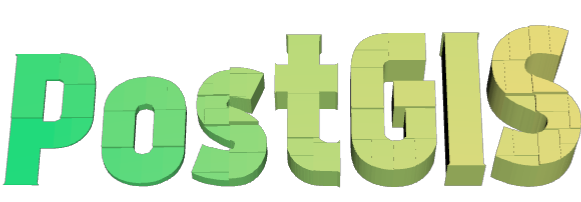
Bâtiments formés par subdivision PostGIS et extrusion
Exemple : Un octogone élevé à 3 unités et une précision décimale de 6
SELECT ST_AsX3D(
ST_Translate(
ST_Force_3d(
ST_Buffer(ST_Point(10,10),5, 'quad_segs=2')), 0,0,
3)
,6) As x3dfrag;
x3dfrag
--------
<IndexedFaceSet coordIndex="0 1 2 3 4 5 6 7">
<Coordinate point="15 10 3 13.535534 6.464466 3 10 5 3 6.464466 6.464466 3 5 10 3 6.464466 13.535534 3 10 15 3 13.535534 13.535534 3 " />
</IndexedFaceSet>
Exemple : TIN
SELECT ST_AsX3D(ST_GeomFromEWKT('TIN (((
0 0 0,
0 0 1,
0 1 0,
0 0 0
)), ((
0 0 0,
0 1 0,
1 1 0,
0 0 0
))
)')) As x3dfrag;
x3dfrag
--------
<IndexedTriangleSet index='0 1 2 3 4 5'
><Coordinate point='0 0 0 0 0 1 0 1 0 0 0 0 0 1 0 1 1 0'/></IndexedTriangleSet>
Exemple : multiligne fermée (la limite d'un polygone avec des trous)
SELECT ST_AsX3D(
ST_GeomFromEWKT('MULTILINESTRING((20 0 10,16 -12 10,0 -16 10,-12 -12 10,-20 0 10,-12 16 10,0 24 10,16 16 10,20 0 10),
(12 0 10,8 8 10,0 12 10,-8 8 10,-8 0 10,-8 -4 10,0 -8 10,8 -4 10,12 0 10))')
) As x3dfrag;
x3dfrag
--------
<IndexedLineSet coordIndex='0 1 2 3 4 5 6 7 0 -1 8 9 10 11 12 13 14 15 8'>
<Coordinate point='20 0 10 16 -12 10 0 -16 10 -12 -12 10 -20 0 10 -12 16 10 0 24 10 16 16 10 12 0 10 8 8 10 0 12 10 -8 8 10 -8 0 10 -8 -4 10 0 -8 10 8 -4 10 ' />
</IndexedLineSet>
Name
ST_GeoHash — Retourne une représentation GeoHash de la géométrie.
Synopsis
text ST_GeoHash(geometry geom, integer maxchars=full_precision_of_point);
Description
Calcule une représentation GeoHash d'une géométrie. Un GeoHash encode un point géographique sous forme de texte qui peut être trié et recherché en fonction du préfixe. Un GeoHash plus court est une représentation moins précise d'un point. Il peut être considéré comme une boîte qui contient le point.
Les valeurs géométriques non ponctuelles dont l'étendue n'est pas nulle peuvent également être mises en correspondance avec des codes GeoHash. La précision du code dépend de l'étendue géographique de la géométrie.
Si maxchars n'est pas spécifié, le code GeoHash renvoyé correspond à la plus petite cellule contenant la géométrie d'entrée. Les points renvoient un GeoHash avec 20 caractères de précision (ce qui est suffisant pour contenir la double précision de l'entrée). D'autres types géométriques peuvent renvoyer un GeoHash avec moins de précision, en fonction de l'étendue de la géométrie. Les géométries plus grandes sont représentées avec moins de précision, les plus petites avec plus de précision. La boîte déterminée par le code GeoHash contient toujours l'élément d'entrée.
Si maxchars est spécifié, le code GeoHash renvoyé comporte au maximum ce nombre de caractères. Il correspond à une représentation (éventuellement) de moindre précision de la géométrie d'entrée. Pour les non-points, le point de départ du calcul est le centre de la boîte de délimitation de la géométrie.
Disponibilité : 1.4.0
![[Note]](images/note.png) | |
ST_GeoHash exige que la géométrie d'entrée soit en coordonnées géographiques (lon/lat). |
 Cette méthode prend en charge les types Circular String et Curve.
Cette méthode prend en charge les types Circular String et Curve.
Exemples
SELECT ST_GeoHash( ST_Point(-126,48) );
st_geohash
----------------------
c0w3hf1s70w3hf1s70w3
SELECT ST_GeoHash( ST_Point(-126,48), 5);
st_geohash
------------
c0w3h
-- This line contains the point, so the GeoHash is a prefix of the point code
SELECT ST_GeoHash('LINESTRING(-126 48, -126.1 48.1)'::geometry);
st_geohash
------------
c0w3
Voir aussi
ST_GeomFromGeoHash, ST_PointFromGeoHash, ST_Box2dFromGeoHash
7.10. Opérateurs
These entries document the spatial operators defined by PostGIS. Operators complement the function catalogue by supplying concise symbolic predicates for bounding-box interactions and spatial relationships. Their semantics follow the same geometric rules as the corresponding functions but are optimised for use in SQL expressions and index-supported filtering.
7.10.1. Opérateurs de Bounding Box
- && — Renvoi
VRAIsi la boite englobante 2D de A intersecte la boite englobante 2D de B. - &&(geometry,box2df) — Renvoie
TRUEsi la boîte de délimitation 2D (en cache) d'une géométrie intersecte une boîte de délimitation 2D de précision flottante (BOX2DF). - &&(box2df,geometry) — Renvoie
TRUEsi une boîte de délimitation 2D de précision flottante (BOX2DF) intersecte la boîte de délimitation 2D (mise en cache) d'une géométrie. - &&(box2df,box2df) — Renvoie
TRUEsi deux boîtes de délimitation 2D à précision flottante (BOX2DF) se croisent. - &&& — Renvoie
TRUEsi la boîte de délimitation n-D de A intersecte la boîte de délimitation n-D de B. - &&&(geometry,gidx) — Renvoie
TRUEsi la boîte de délimitation n-D (en cache) d'une géométrie intersecte une boîte de délimitation de précision flottante n-D (GIDX). - &&&(gidx,geometry) — Renvoie
TRUEsi une boîte de délimitation de précision flottante n-D (GIDX) intersecte la boîte de délimitation n-D (mise en cache) d'une géométrie. - &&&(gidx,gidx) — Renvoie
TRUEsi deux boîtes de délimitation (GIDX) de précision flottante n-D se croisent. - &< — Renvoie
TRUEsi la boîte englobante de A chevauche ou est à gauche de celle de B. - &<| — Renvoie
TRUEsi la boîte englobante de A chevauche ou est inférieure à celle de B. - &> — Renvoie
TRUEsi la boîte de délimitation de A chevauche ou est à droite de celle de B. - << — Renvoie
TRUEsi la boîte de délimitation de A est strictement à gauche de celle de B. - <<| — Renvoie
TRUEsi la boîte de délimitation de A est strictement inférieure à celle de B. - = — Renvoie
TRUEsi les coordonnées et l'ordre des coordonnées de la géométrie/géographie A sont les mêmes que les coordonnées et l'ordre des coordonnées de la géométrie/géographie B. - >> — Renvoie
TRUEsi la boîte de délimitation de A est strictement à droite de celle de B. - @ — Renvoie
TRUEsi la boîte de délimitation de A est contenue par celle de B. - @(geometry,box2df) — Renvoie
TRUEsi la boîte de délimitation 2D d'une géométrie est contenue dans une boîte de délimitation 2D à précision flottante (BOX2DF). - @(box2df,geometry) — Renvoie
TRUEsi une boîte de délimitation de précision flottante 2D (BOX2DF) est contenue dans la boîte de délimitation 2D d'une géométrie. - @(box2df,box2df) — Renvoie
TRUEsi une boîte de délimitation de précision flottante 2D (BOX2DF) est contenue dans une autre boîte de délimitation de précision flottante 2D. - |&> — Renvoie
TRUEsi la boîte de délimitation de A chevauche ou est au-dessus de celle de B. - |>> — Renvoie
TRUEsi la boîte de délimitation de A est strictement au-dessus de celle de B. - ~ — Renvoie
TRUEsi la boîte de délimitation de A contient celle de B. - ~(geometry,box2df) — Renvoie
TRUEsi la boîte de délimitation 2D d'une géométrie contient une boîte de délimitation de précision flottante 2D (GIDX). - ~(box2df,geometry) — Renvoie
TRUEsi une boîte de délimitation de précision flottante 2D (BOX2DF) contient la boîte de délimitation 2D d'une géométrie. - ~(box2df,box2df) — Renvoie
TRUEsi une boîte de délimitation de précision flottante 2D (BOX2DF) contient une autre boîte de délimitation de précision flottante 2D (BOX2DF). - ~= — Renvoie
TRUEsi la boîte de délimitation de A est la même que celle de B.
Name
&& — Renvoi VRAI si la boite englobante 2D de A intersecte la boite englobante 2D de B.
Synopsis
boolean &&( geometry A , geometry B );
boolean &&( geography A , geography B );
Description
L'opérateur && renvoi VRAI si la boite englobante 2D de la géométrie A intersecte la boite englobante 2D de la géométrie B.
![[Note]](images/note.png) | |
Cette opérande utilisera tous les index qui peuvent être disponibles sur les géométries. |
Amélioration : 2.0.0 introduction du support des surfaces polyédriques.
Disponibilité : 1.5.0 le support de la géographie a été introduit.
 Cette méthode prend en charge les types Circular String et Curve.
Cette méthode prend en charge les types Circular String et Curve.
 Cette fonction prend en charge les surfaces Polyhedral.
Cette fonction prend en charge les surfaces Polyhedral.
Exemples
SELECT tbl1.column1, tbl2.column1, tbl1.column2 && tbl2.column2 AS overlaps
FROM ( VALUES
(1, 'LINESTRING(0 0, 3 3)'::geometry),
(2, 'LINESTRING(0 1, 0 5)'::geometry)) AS tbl1,
( VALUES
(3, 'LINESTRING(1 2, 4 6)'::geometry)) AS tbl2;
column1 | column1 | overlaps
---------+---------+----------
1 | 3 | t
2 | 3 | f
(2 rows)
Name
&&(geometry,box2df) — Renvoie TRUE si la boîte de délimitation 2D (en cache) d'une géométrie intersecte une boîte de délimitation 2D de précision flottante (BOX2DF).
Synopsis
boolean &&( geometry A , box2df B );
Description
L'opérateur && renvoie TRUE si la boîte de délimitation 2D mise en cache de la géométrie A intersecte la boîte de délimitation 2D B, en utilisant la précision float. Cela signifie que si B est un box2d (double précision), il sera converti en interne en une boîte de délimitation 2D à précision flottante (BOX2DF)
![[Note]](images/note.png) | |
Cet opérande est destiné à être utilisé en interne par les index BRIN, plus que par les utilisateurs. |
Availability: 2.3.0 support for Block Range INdexes (BRIN) was introduced.
 Cette méthode prend en charge les types Circular String et Curve.
Cette méthode prend en charge les types Circular String et Curve.
 Cette fonction prend en charge les surfaces Polyhedral.
Cette fonction prend en charge les surfaces Polyhedral.
Exemples
SELECT ST_Point(1,1) && ST_MakeBox2D(ST_Point(0,0), ST_Point(2,2)) AS overlaps; overlaps ---------- t (1 row)
Name
&&(box2df,geometry) — Renvoie TRUE si une boîte de délimitation 2D de précision flottante (BOX2DF) intersecte la boîte de délimitation 2D (mise en cache) d'une géométrie.
Synopsis
boolean &&( box2df A , geometry B );
Description
L'opérateur && renvoie TRUE si la boîte de délimitation 2D A intersecte la boîte de délimitation 2D mise en cache de la géométrie B, en utilisant la précision float. Cela signifie que si A est un box2d (double précision), il sera converti en interne en une boîte de délimitation 2D à précision flottante (BOX2DF)
![[Note]](images/note.png) | |
Cet opérande est destiné à être utilisé en interne par les index BRIN, plus que par les utilisateurs. |
Availability: 2.3.0 support for Block Range INdexes (BRIN) was introduced.
 Cette méthode prend en charge les types Circular String et Curve.
Cette méthode prend en charge les types Circular String et Curve.
 Cette fonction prend en charge les surfaces Polyhedral.
Cette fonction prend en charge les surfaces Polyhedral.
Exemples
SELECT ST_MakeBox2D(ST_Point(0,0), ST_Point(2,2)) && ST_Point(1,1) AS overlaps; overlaps ---------- t (1 row)
Name
&&(box2df,box2df) — Renvoie TRUE si deux boîtes de délimitation 2D à précision flottante (BOX2DF) se croisent.
Synopsis
boolean &&( box2df A , box2df B );
Description
L'opérateur && renvoie TRUE si deux boîtes de délimitation 2D A et B se croisent, en utilisant la précision float. Cela signifie que si A (ou B) est un box2d (double précision), il sera converti en interne en une boîte de délimitation 2D de précision flottante (BOX2DF)
![[Note]](images/note.png) | |
Cet opérateur est destiné à être utilisé en interne par les index BRIN, plus que par les utilisateurs. |
Availability: 2.3.0 support for Block Range INdexes (BRIN) was introduced.
 Cette méthode prend en charge les types Circular String et Curve.
Cette méthode prend en charge les types Circular String et Curve.
 Cette fonction prend en charge les surfaces Polyhedral.
Cette fonction prend en charge les surfaces Polyhedral.
Exemples
SELECT ST_MakeBox2D(ST_Point(0,0), ST_Point(2,2)) && ST_MakeBox2D(ST_Point(1,1), ST_Point(3,3)) AS overlaps; overlaps ---------- t (1 row)
Name
&&& — Renvoie TRUE si la boîte de délimitation n-D de A intersecte la boîte de délimitation n-D de B.
Synopsis
boolean &&&( geometry A , geometry B );
Description
L'opérateur &&& renvoie TRUE si la boîte de délimitation n-D de la géométrie A intersecte la boîte de délimitation n-D de la géométrie B.
![[Note]](images/note.png) | |
Cette opérande utilisera tous les index qui peuvent être disponibles sur les géométries. |
Disponibilité : 2.0.0
 Cette méthode prend en charge les types Circular String et Curve.
Cette méthode prend en charge les types Circular String et Curve.
 Cette fonction prend en charge les surfaces Polyhedral.
Cette fonction prend en charge les surfaces Polyhedral.
 Cette fonction prend en charge les triangles et les réseaux irréguliers triangulés (TIN).
Cette fonction prend en charge les triangles et les réseaux irréguliers triangulés (TIN).
 Cette fonction prend en charge la 3D et ne supprime pas l'indice z.
Cette fonction prend en charge la 3D et ne supprime pas l'indice z.
Exemples : LineStrings 3D
SELECT tbl1.column1, tbl2.column1, tbl1.column2 &&& tbl2.column2 AS overlaps_3d,
tbl1.column2 && tbl2.column2 AS overlaps_2d
FROM ( VALUES
(1, 'LINESTRING Z(0 0 1, 3 3 2)'::geometry),
(2, 'LINESTRING Z(1 2 0, 0 5 -1)'::geometry)) AS tbl1,
( VALUES
(3, 'LINESTRING Z(1 2 1, 4 6 1)'::geometry)) AS tbl2;
column1 | column1 | overlaps_3d | overlaps_2d
---------+---------+-------------+-------------
1 | 3 | t | t
2 | 3 | f | t
Exemples : LineStrings 3M
SELECT tbl1.column1, tbl2.column1, tbl1.column2 &&& tbl2.column2 AS overlaps_3zm,
tbl1.column2 && tbl2.column2 AS overlaps_2d
FROM ( VALUES
(1, 'LINESTRING M(0 0 1, 3 3 2)'::geometry),
(2, 'LINESTRING M(1 2 0, 0 5 -1)'::geometry)) AS tbl1,
( VALUES
(3, 'LINESTRING M(1 2 1, 4 6 1)'::geometry)) AS tbl2;
column1 | column1 | overlaps_3zm | overlaps_2d
---------+---------+-------------+-------------
1 | 3 | t | t
2 | 3 | f | t
Voir aussi
Name
&&&(geometry,gidx) — Renvoie TRUE si la boîte de délimitation n-D (en cache) d'une géométrie intersecte une boîte de délimitation de précision flottante n-D (GIDX).
Synopsis
boolean &&&( geometry A , gidx B );
Description
L'opérateur &&& renvoie TRUE si la boîte de délimitation n-D mise en cache de la géométrie A intersecte la boîte de délimitation n-D B, en utilisant la précision float. Cela signifie que si B est un box3d (double précision), il sera converti en interne en une boîte de délimitation 3D de précision flottante (GIDX)
![[Note]](images/note.png) | |
Cet opérateur est destiné à être utilisé en interne par les index BRIN, plus que par les utilisateurs. |
Availability: 2.3.0 support for Block Range INdexes (BRIN) was introduced.
 Cette méthode prend en charge les types Circular String et Curve.
Cette méthode prend en charge les types Circular String et Curve.
 Cette fonction prend en charge les surfaces Polyhedral.
Cette fonction prend en charge les surfaces Polyhedral.
 Cette fonction prend en charge les triangles et les réseaux irréguliers triangulés (TIN).
Cette fonction prend en charge les triangles et les réseaux irréguliers triangulés (TIN).
 Cette fonction prend en charge la 3D et ne supprime pas l'indice z.
Cette fonction prend en charge la 3D et ne supprime pas l'indice z.
Exemples
SELECT ST_MakePoint(1,1,1) &&& ST_3DMakeBox(ST_MakePoint(0,0,0), ST_MakePoint(2,2,2)) AS overlaps; overlaps ---------- t (1 row)
Voir aussi
Name
&&&(gidx,geometry) — Renvoie TRUE si une boîte de délimitation de précision flottante n-D (GIDX) intersecte la boîte de délimitation n-D (mise en cache) d'une géométrie.
Synopsis
boolean &&&( gidx A , geometry B );
Description
L'opérateur &&& renvoie TRUE si la boîte de délimitation n-D A intersecte la boîte de délimitation n-D mise en cache de la géométrie B, en utilisant la précision float. Cela signifie que si A est un box3d (à double précision), il sera converti en interne en une boîte de délimitation 3D à précision flottante (GIDX)
![[Note]](images/note.png) | |
Cet opérateur est destiné à être utilisé en interne par les index BRIN, plus que par les utilisateurs. |
Availability: 2.3.0 support for Block Range INdexes (BRIN) was introduced.
 Cette méthode prend en charge les types Circular String et Curve.
Cette méthode prend en charge les types Circular String et Curve.
 Cette fonction prend en charge les surfaces Polyhedral.
Cette fonction prend en charge les surfaces Polyhedral.
 Cette fonction prend en charge les triangles et les réseaux irréguliers triangulés (TIN).
Cette fonction prend en charge les triangles et les réseaux irréguliers triangulés (TIN).
 Cette fonction prend en charge la 3D et ne supprime pas l'indice z.
Cette fonction prend en charge la 3D et ne supprime pas l'indice z.
Exemples
SELECT ST_3DMakeBox(ST_MakePoint(0,0,0), ST_MakePoint(2,2,2)) &&& ST_MakePoint(1,1,1) AS overlaps; overlaps ---------- t (1 row)
Voir aussi
Name
&&&(gidx,gidx) — Renvoie TRUE si deux boîtes de délimitation (GIDX) de précision flottante n-D se croisent.
Synopsis
boolean &&&( gidx A , gidx B );
Description
L'opérateur &&& renvoie TRUE si deux boîtes de délimitation n-D A et B se croisent, en utilisant la précision float. Cela signifie que si A (ou B) est un box3d (double précision), il sera converti en interne en une boîte de délimitation 3D de précision flottante (GIDX)
![[Note]](images/note.png) | |
Cet opérateur est destiné à être utilisé en interne par les index BRIN, plus que par les utilisateurs. |
Availability: 2.3.0 support for Block Range INdexes (BRIN) was introduced.
 Cette méthode prend en charge les types Circular String et Curve.
Cette méthode prend en charge les types Circular String et Curve.
 Cette fonction prend en charge les surfaces Polyhedral.
Cette fonction prend en charge les surfaces Polyhedral.
 Cette fonction prend en charge les triangles et les réseaux irréguliers triangulés (TIN).
Cette fonction prend en charge les triangles et les réseaux irréguliers triangulés (TIN).
 Cette fonction prend en charge la 3D et ne supprime pas l'indice z.
Cette fonction prend en charge la 3D et ne supprime pas l'indice z.
Exemples
SELECT ST_3DMakeBox(ST_MakePoint(0,0,0), ST_MakePoint(2,2,2)) &&& ST_3DMakeBox(ST_MakePoint(1,1,1), ST_MakePoint(3,3,3)) AS overlaps; overlaps ---------- t (1 row)
Voir aussi
Name
&< — Renvoie TRUE si la boîte englobante de A chevauche ou est à gauche de celle de B.
Synopsis
boolean &<( geometry A , geometry B );
Description
L'opérateur &< renvoie TRUE si la boîte de délimitation de la géométrie A chevauche ou est à gauche de la boîte de délimitation de la géométrie B, ou plus exactement, chevauche ou n'est PAS à droite de la boîte de délimitation de la géométrie B.
![[Note]](images/note.png) | |
Cette opérande utilisera tous les index qui peuvent être disponibles sur les géométries. |
Exemples
SELECT tbl1.column1, tbl2.column1, tbl1.column2 &< tbl2.column2 AS overleft
FROM
( VALUES
(1, 'LINESTRING(1 2, 4 6)'::geometry)) AS tbl1,
( VALUES
(2, 'LINESTRING(0 0, 3 3)'::geometry),
(3, 'LINESTRING(0 1, 0 5)'::geometry),
(4, 'LINESTRING(6 0, 6 1)'::geometry)) AS tbl2;
column1 | column1 | overleft
---------+---------+----------
1 | 2 | f
1 | 3 | f
1 | 4 | t
(3 rows)
Name
&<| — Renvoie TRUE si la boîte englobante de A chevauche ou est inférieure à celle de B.
Synopsis
boolean &<|( geometry A , geometry B );
Description
L'opérateur &<| renvoie TRUE si la boîte de délimitation de la géométrie A chevauche ou est en dessous de la boîte de délimitation de la géométrie B, ou plus exactement, chevauche ou n'est PAS au-dessus de la boîte de délimitation de la géométrie B.
 Cette méthode prend en charge les types Circular String et Curve.
Cette méthode prend en charge les types Circular String et Curve.
 Cette fonction prend en charge les surfaces Polyhedral.
Cette fonction prend en charge les surfaces Polyhedral.
![[Note]](images/note.png) | |
Cette opérande utilisera tous les index qui peuvent être disponibles sur les géométries. |
Exemples
SELECT tbl1.column1, tbl2.column1, tbl1.column2 &<| tbl2.column2 AS overbelow
FROM
( VALUES
(1, 'LINESTRING(6 0, 6 4)'::geometry)) AS tbl1,
( VALUES
(2, 'LINESTRING(0 0, 3 3)'::geometry),
(3, 'LINESTRING(0 1, 0 5)'::geometry),
(4, 'LINESTRING(1 2, 4 6)'::geometry)) AS tbl2;
column1 | column1 | overbelow
---------+---------+-----------
1 | 2 | f
1 | 3 | t
1 | 4 | t
(3 rows)
Name
&> — Renvoie TRUE si la boîte de délimitation de A chevauche ou est à droite de celle de B.
Synopsis
boolean &>( geometry A , geometry B );
Description
L'opérateur &> renvoie TRUE si la boîte de délimitation de la géométrie A chevauche ou est à droite de la boîte de délimitation de la géométrie B, ou plus exactement, chevauche ou n'est PAS à gauche de la boîte de délimitation de la géométrie B.
![[Note]](images/note.png) | |
Cette opérande utilisera tous les index qui peuvent être disponibles sur les géométries. |
Exemples
SELECT tbl1.column1, tbl2.column1, tbl1.column2 &
> tbl2.column2 AS overright
FROM
( VALUES
(1, 'LINESTRING(1 2, 4 6)'::geometry)) AS tbl1,
( VALUES
(2, 'LINESTRING(0 0, 3 3)'::geometry),
(3, 'LINESTRING(0 1, 0 5)'::geometry),
(4, 'LINESTRING(6 0, 6 1)'::geometry)) AS tbl2;
column1 | column1 | overright
---------+---------+-----------
1 | 2 | t
1 | 3 | t
1 | 4 | f
(3 rows)
Name
<< — Renvoie TRUE si la boîte de délimitation de A est strictement à gauche de celle de B.
Synopsis
boolean <<( geometry A , geometry B );
Description
L'opérateur << renvoie TRUE si la boîte de délimitation de la géométrie A est strictement à gauche de la boîte de délimitation de la géométrie B.
![[Note]](images/note.png) | |
Cette opérande utilisera tous les index qui peuvent être disponibles sur les géométries. |
Exemples
SELECT tbl1.column1, tbl2.column1, tbl1.column2 << tbl2.column2 AS left
FROM
( VALUES
(1, 'LINESTRING (1 2, 1 5)'::geometry)) AS tbl1,
( VALUES
(2, 'LINESTRING (0 0, 4 3)'::geometry),
(3, 'LINESTRING (6 0, 6 5)'::geometry),
(4, 'LINESTRING (2 2, 5 6)'::geometry)) AS tbl2;
column1 | column1 | left
---------+---------+------
1 | 2 | f
1 | 3 | t
1 | 4 | t
(3 rows)
Name
<<| — Renvoie TRUE si la boîte de délimitation de A est strictement inférieure à celle de B.
Synopsis
boolean <<|( geometry A , geometry B );
Description
L'opérateur <<| renvoie TRUE si la boîte de délimitation de la géométrie A est strictement inférieure à la boîte de délimitation de la géométrie B.
![[Note]](images/note.png) | |
Cette opérande utilisera tous les index qui peuvent être disponibles sur les géométries. |
Exemples
SELECT tbl1.column1, tbl2.column1, tbl1.column2 <<| tbl2.column2 AS below
FROM
( VALUES
(1, 'LINESTRING (0 0, 4 3)'::geometry)) AS tbl1,
( VALUES
(2, 'LINESTRING (1 4, 1 7)'::geometry),
(3, 'LINESTRING (6 1, 6 5)'::geometry),
(4, 'LINESTRING (2 3, 5 6)'::geometry)) AS tbl2;
column1 | column1 | below
---------+---------+-------
1 | 2 | t
1 | 3 | f
1 | 4 | f
(3 rows)
Name
= — Renvoie TRUE si les coordonnées et l'ordre des coordonnées de la géométrie/géographie A sont les mêmes que les coordonnées et l'ordre des coordonnées de la géométrie/géographie B.
Synopsis
boolean =( geometry A , geometry B );
boolean =( geography A , geography B );
Description
L'opérateur = renvoie TRUE si les coordonnées et l'ordre des coordonnées de la géométrie/géographie A sont les mêmes que les coordonnées et l'ordre des coordonnées de la géométrie/géographie B. PostgreSQL utilise les opérateurs =, <, et > définis pour les géométries pour effectuer des classements internes et des comparaisons de géométries (c'est-à-dire dans une clause GROUP BY ou ORDER BY).
![[Note]](images/note.png) | |
Seules les géométries/géographies qui sont exactement égales à tous égards, avec les mêmes coordonnées, dans le même ordre, sont considérées comme égales par cet opérateur. Pour une "égalité spatiale", qui ignore des choses comme l'ordre des coordonnées, et peut détecter des caractéristiques qui couvrent la même zone spatiale avec des représentations différentes, utilisez ST_OrderingEquals ou ST_Equals |
![[Caution]](images/caution.png) | |
Cet opérande n'utilisera PAS les index qui peuvent être disponibles sur les géométries. Pour un test d'égalité exact assisté par index, combinez = avec &&. |
Modifié : 2.4.0, dans les versions précédentes, il s'agissait d'une égalité de boîte de délimitation et non d'une égalité géométrique. Si vous avez besoin d'une égalité de boîte de délimitation, utilisez ~= à la place.
 Cette méthode prend en charge les types Circular String et Curve.
Cette méthode prend en charge les types Circular String et Curve.
 Cette fonction prend en charge les surfaces Polyhedral.
Cette fonction prend en charge les surfaces Polyhedral.
Exemples
SELECT 'LINESTRING(0 0, 0 1, 1 0)'::geometry = 'LINESTRING(1 1, 0 0)'::geometry;
?column?
----------
f
(1 row)
SELECT ST_AsText(column1)
FROM ( VALUES
('LINESTRING(0 0, 1 1)'::geometry),
('LINESTRING(1 1, 0 0)'::geometry)) AS foo;
st_astext
---------------------
LINESTRING(0 0,1 1)
LINESTRING(1 1,0 0)
(2 rows)
-- Note: the GROUP BY uses the "=" to compare for geometry equivalency.
SELECT ST_AsText(column1)
FROM ( VALUES
('LINESTRING(0 0, 1 1)'::geometry),
('LINESTRING(1 1, 0 0)'::geometry)) AS foo
GROUP BY column1;
st_astext
---------------------
LINESTRING(0 0,1 1)
LINESTRING(1 1,0 0)
(2 rows)
-- In versions prior to 2.0, this used to return true --
SELECT ST_GeomFromText('POINT(1707296.37 4820536.77)') =
ST_GeomFromText('POINT(1707296.27 4820536.87)') As pt_intersect;
--pt_intersect --
f
Voir aussi
Name
>> — Renvoie TRUE si la boîte de délimitation de A est strictement à droite de celle de B.
Synopsis
boolean >>( geometry A , geometry B );
Description
L'opérateur >> renvoie TRUE si la boîte de délimitation de la géométrie A est strictement à droite de la boîte de délimitation de la géométrie B.
![[Note]](images/note.png) | |
Cette opérande utilisera tous les index qui peuvent être disponibles sur les géométries. |
Exemples
SELECT tbl1.column1, tbl2.column1, tbl1.column2
>
> tbl2.column2 AS right
FROM
( VALUES
(1, 'LINESTRING (2 3, 5 6)'::geometry)) AS tbl1,
( VALUES
(2, 'LINESTRING (1 4, 1 7)'::geometry),
(3, 'LINESTRING (6 1, 6 5)'::geometry),
(4, 'LINESTRING (0 0, 4 3)'::geometry)) AS tbl2;
column1 | column1 | right
---------+---------+-------
1 | 2 | t
1 | 3 | f
1 | 4 | f
(3 rows)
Name
@ — Renvoie TRUE si la boîte de délimitation de A est contenue par celle de B.
Synopsis
boolean @( geometry A , geometry B );
Description
L'opérateur @ renvoie TRUE si la boîte de délimitation de la géométrie A est complètement contenue par la boîte de délimitation de la géométrie B.
![[Note]](images/note.png) | |
Cette opérande utilisera tous les index qui peuvent être disponibles sur les géométries. |
Exemples
SELECT tbl1.column1, tbl2.column1, tbl1.column2 @ tbl2.column2 AS contained
FROM
( VALUES
(1, 'LINESTRING (1 1, 3 3)'::geometry)) AS tbl1,
( VALUES
(2, 'LINESTRING (0 0, 4 4)'::geometry),
(3, 'LINESTRING (2 2, 4 4)'::geometry),
(4, 'LINESTRING (1 1, 3 3)'::geometry)) AS tbl2;
column1 | column1 | contained
---------+---------+-----------
1 | 2 | t
1 | 3 | f
1 | 4 | t
(3 rows)
Name
@(geometry,box2df) — Renvoie TRUE si la boîte de délimitation 2D d'une géométrie est contenue dans une boîte de délimitation 2D à précision flottante (BOX2DF).
Synopsis
boolean @( geometry A , box2df B );
Description
L'opérateur @ renvoie TRUE si la boîte de délimitation 2D de la géométrie A est contenue dans la boîte de délimitation 2D B, en utilisant la précision float. Cela signifie que si B est un box2d (double précision), il sera converti en interne en une boîte de délimitation 2D de précision flottante (BOX2DF)
![[Note]](images/note.png) | |
Cet opérande est destiné à être utilisé en interne par les index BRIN, plus que par les utilisateurs. |
Availability: 2.3.0 support for Block Range INdexes (BRIN) was introduced.
 Cette méthode prend en charge les types Circular String et Curve.
Cette méthode prend en charge les types Circular String et Curve.
 Cette fonction prend en charge les surfaces Polyhedral.
Cette fonction prend en charge les surfaces Polyhedral.
Exemples
SELECT ST_Buffer(ST_GeomFromText('POINT(2 2)'), 1) @ ST_MakeBox2D(ST_Point(0,0), ST_Point(5,5)) AS is_contained;
is_contained
--------------
t
(1 row)Name
@(box2df,geometry) — Renvoie TRUE si une boîte de délimitation de précision flottante 2D (BOX2DF) est contenue dans la boîte de délimitation 2D d'une géométrie.
Synopsis
boolean @( box2df A , geometry B );
Description
L'opérateur @ renvoie TRUE si la boîte de délimitation 2D A est contenue dans la boîte de délimitation 2D de la géométrie B, en utilisant la précision float. Cela signifie que si B est un box2d (double précision), il sera converti en interne en une boîte de délimitation 2D de précision flottante (BOX2DF)
![[Note]](images/note.png) | |
Cet opérande est destiné à être utilisé en interne par les index BRIN, plus que par les utilisateurs. |
Availability: 2.3.0 support for Block Range INdexes (BRIN) was introduced.
 Cette méthode prend en charge les types Circular String et Curve.
Cette méthode prend en charge les types Circular String et Curve.
 Cette fonction prend en charge les surfaces Polyhedral.
Cette fonction prend en charge les surfaces Polyhedral.
Exemples
SELECT ST_MakeBox2D(ST_Point(2,2), ST_Point(3,3)) @ ST_Buffer(ST_GeomFromText('POINT(1 1)'), 10) AS is_contained;
is_contained
--------------
t
(1 row)Name
@(box2df,box2df) — Renvoie TRUE si une boîte de délimitation de précision flottante 2D (BOX2DF) est contenue dans une autre boîte de délimitation de précision flottante 2D.
Synopsis
boolean @( box2df A , box2df B );
Description
L'opérateur @ renvoie TRUE si la boîte de délimitation 2D A est contenue dans la boîte de délimitation 2D B, en utilisant la précision float. Cela signifie que si A (ou B) est un box2d (double précision), il sera converti en interne en une boîte de délimitation 2D à précision flottante (BOX2DF)
![[Note]](images/note.png) | |
Cet opérande est destiné à être utilisé en interne par les index BRIN, plus que par les utilisateurs. |
Availability: 2.3.0 support for Block Range INdexes (BRIN) was introduced.
 Cette méthode prend en charge les types Circular String et Curve.
Cette méthode prend en charge les types Circular String et Curve.
 Cette fonction prend en charge les surfaces Polyhedral.
Cette fonction prend en charge les surfaces Polyhedral.
Exemples
SELECT ST_MakeBox2D(ST_Point(2,2), ST_Point(3,3)) @ ST_MakeBox2D(ST_Point(0,0), ST_Point(5,5)) AS is_contained; is_contained -------------- t (1 row)
Name
|&> — Renvoie TRUE si la boîte de délimitation de A chevauche ou est au-dessus de celle de B.
Synopsis
boolean |&>( geometry A , geometry B );
Description
L'opérateur |&> renvoie TRUE si la boîte de délimitation de la géométrie A chevauche ou est au-dessus de la boîte de délimitation de la géométrie B, ou plus exactement, chevauche ou n'est PAS au-dessous de la boîte de délimitation de la géométrie B.
![[Note]](images/note.png) | |
Cette opérande utilisera tous les index qui peuvent être disponibles sur les géométries. |
Exemples
SELECT tbl1.column1, tbl2.column1, tbl1.column2 |&
> tbl2.column2 AS overabove
FROM
( VALUES
(1, 'LINESTRING(6 0, 6 4)'::geometry)) AS tbl1,
( VALUES
(2, 'LINESTRING(0 0, 3 3)'::geometry),
(3, 'LINESTRING(0 1, 0 5)'::geometry),
(4, 'LINESTRING(1 2, 4 6)'::geometry)) AS tbl2;
column1 | column1 | overabove
---------+---------+-----------
1 | 2 | t
1 | 3 | f
1 | 4 | f
(3 rows)
Name
|>> — Renvoie TRUE si la boîte de délimitation de A est strictement au-dessus de celle de B.
Synopsis
boolean |>>( geometry A , geometry B );
Description
L'opérateur |>> renvoie TRUE si la boîte de délimitation de la géométrie A est strictement au-dessus de la boîte de délimitation de la géométrie B.
![[Note]](images/note.png) | |
Cette opérande utilisera tous les index qui peuvent être disponibles sur les géométries. |
Exemples
SELECT tbl1.column1, tbl2.column1, tbl1.column2 |>> tbl2.column2 AS above
FROM
( VALUES
(1, 'LINESTRING (1 4, 1 7)'::geometry)) AS tbl1,
( VALUES
(2, 'LINESTRING (0 0, 4 2)'::geometry),
(3, 'LINESTRING (6 1, 6 5)'::geometry),
(4, 'LINESTRING (2 3, 5 6)'::geometry)) AS tbl2;
column1 | column1 | above
---------+---------+-------
1 | 2 | t
1 | 3 | f
1 | 4 | f
(3 rows)Name
~ — Renvoie TRUE si la boîte de délimitation de A contient celle de B.
Synopsis
boolean ~( geometry A , geometry B );
Description
L'opérateur ~ renvoie TRUE si la boîte de délimitation de la géométrie A contient complètement la boîte de délimitation de la géométrie B.
![[Note]](images/note.png) | |
Cette opérande utilisera tous les index qui peuvent être disponibles sur les géométries. |
Exemples
SELECT tbl1.column1, tbl2.column1, tbl1.column2 ~ tbl2.column2 AS contains
FROM
( VALUES
(1, 'LINESTRING (0 0, 3 3)'::geometry)) AS tbl1,
( VALUES
(2, 'LINESTRING (0 0, 4 4)'::geometry),
(3, 'LINESTRING (1 1, 2 2)'::geometry),
(4, 'LINESTRING (0 0, 3 3)'::geometry)) AS tbl2;
column1 | column1 | contains
---------+---------+----------
1 | 2 | f
1 | 3 | t
1 | 4 | t
(3 rows)Name
~(geometry,box2df) — Renvoie TRUE si la boîte de délimitation 2D d'une géométrie contient une boîte de délimitation de précision flottante 2D (GIDX).
Synopsis
boolean ~( geometry A , box2df B );
Description
L'opérateur ~ renvoie TRUE si la boîte de délimitation 2D d'une géométrie A contient la boîte de délimitation 2D B, en utilisant la précision float. Cela signifie que si B est un box2d (double précision), il sera converti en interne en une boîte de délimitation 2D de précision flottante (BOX2DF)
![[Note]](images/note.png) | |
Cet opérande est destiné à être utilisé en interne par les index BRIN, plus que par les utilisateurs. |
Availability: 2.3.0 support for Block Range INdexes (BRIN) was introduced.
 Cette méthode prend en charge les types Circular String et Curve.
Cette méthode prend en charge les types Circular String et Curve.
 Cette fonction prend en charge les surfaces Polyhedral.
Cette fonction prend en charge les surfaces Polyhedral.
Exemples
SELECT ST_Buffer(ST_GeomFromText('POINT(1 1)'), 10) ~ ST_MakeBox2D(ST_Point(0,0), ST_Point(2,2)) AS contains;
contains
----------
t
(1 row)Name
~(box2df,geometry) — Renvoie TRUE si une boîte de délimitation de précision flottante 2D (BOX2DF) contient la boîte de délimitation 2D d'une géométrie.
Synopsis
boolean ~( box2df A , geometry B );
Description
L'opérateur ~ renvoie TRUE si la boîte de délimitation 2D A contient la boîte de délimitation de la géométrie B, en utilisant la précision float. Cela signifie que si A est un box2d (double précision), il sera converti en interne en une boîte de délimitation 2D de précision flottante (BOX2DF)
![[Note]](images/note.png) | |
Cet opérande est destiné à être utilisé en interne par les index BRIN, plus que par les utilisateurs. |
Availability: 2.3.0 support for Block Range INdexes (BRIN) was introduced.
 Cette méthode prend en charge les types Circular String et Curve.
Cette méthode prend en charge les types Circular String et Curve.
 Cette fonction prend en charge les surfaces Polyhedral.
Cette fonction prend en charge les surfaces Polyhedral.
Exemples
SELECT ST_MakeBox2D(ST_Point(0,0), ST_Point(5,5)) ~ ST_Buffer(ST_GeomFromText('POINT(2 2)'), 1) AS contains;
contains
----------
t
(1 row)Name
~(box2df,box2df) — Renvoie TRUE si une boîte de délimitation de précision flottante 2D (BOX2DF) contient une autre boîte de délimitation de précision flottante 2D (BOX2DF).
Synopsis
boolean ~( box2df A , box2df B );
Description
L'opérateur ~ renvoie TRUE si la boîte de délimitation 2D A contient la boîte de délimitation 2D B, en utilisant la précision float. Cela signifie que si A est un box2d (double précision), il sera converti en interne en une boîte de délimitation 2D de précision flottante (BOX2DF)
![[Note]](images/note.png) | |
Cet opérande est destiné à être utilisé en interne par les index BRIN, plus que par les utilisateurs. |
Availability: 2.3.0 support for Block Range INdexes (BRIN) was introduced.
 Cette méthode prend en charge les types Circular String et Curve.
Cette méthode prend en charge les types Circular String et Curve.
 Cette fonction prend en charge les surfaces Polyhedral.
Cette fonction prend en charge les surfaces Polyhedral.
Exemples
SELECT ST_MakeBox2D(ST_Point(0,0), ST_Point(5,5)) ~ ST_MakeBox2D(ST_Point(2,2), ST_Point(3,3)) AS contains; contains ---------- t (1 row)
Name
~= — Renvoie TRUE si la boîte de délimitation de A est la même que celle de B.
Synopsis
boolean ~=( geometry A , geometry B );
Description
L'opérateur ~= renvoie TRUE si la boîte de délimitation de la géométrie/géographie A est la même que la boîte de délimitation de la géométrie/géographie B.
![[Note]](images/note.png) | |
Cette opérande utilisera tous les index qui peuvent être disponibles sur les géométries. |
Disponibilité : 1.5.0 comportement changé
 Cette fonction prend en charge les surfaces Polyhedral.
Cette fonction prend en charge les surfaces Polyhedral.
![[Warning]](images/warning.png) | |
Cet opérateur a changé de comportement dans PostGIS 1.5, passant de la vérification de l'égalité géométrique réelle à la vérification de l'égalité du rectangle de délimitation. Pour compliquer les choses, le comportement de votre base de données dépend également du type de mise à niveau (hard ou soft) que vous avez effectué. Pour savoir quel est le comportement de votre base de données, vous pouvez exécuter la requête ci-dessous. Pour vérifier l'égalité réelle, utilisez ST_OrderingEquals ou ST_Equals. |
Exemples
select 'LINESTRING(0 0, 1 1)'::geometry ~= 'LINESTRING(0 1, 1 0)'::geometry as equality;
equality |
-----------------+
t |
Voir aussi
7.10.2. Opérateurs de distance
Name
<-> — Renvoie la distance en 2D entre A et B.
Synopsis
double precision <->( geometry A , geometry B );
double precision <->( geography A , geography B );
Description
The <-> operator returns the 2D distance between two geometries. Used in the "ORDER BY" clause provides index-assisted nearest-neighbor result sets with true KNN distance search for geometries, and distance on the sphere for geographies.
![[Note]](images/note.png) | |
Cet opérande utilise les index 2D GiST qui peuvent être disponibles sur les géométries. Il est différent des autres opérateurs qui utilisent des index spatiaux en ce sens que l'index spatial n'est utilisé que lorsque l'opérateur est dans la clause ORDER BY. |
![[Note]](images/note.png) | |
L'index n'intervient que si l'une des géométries est une constante (pas dans une sous-requête/cte). Par exemple, 'SRID=3005;POINT(1011102 450541)'::geometry au lieu de a.geom |
Reportez-vous à l'atelier PostGIS : La recherche du plus proche voisin pour un exemple détaillé.
Enhanced: 2.2.0 -- True KNN ("K nearest neighbor") behavior for geometry and geography. Note for geography KNN is based on sphere rather than spheroid.
Changed: 2.2.0 -- Old hybrid-syntax workarounds may be slower once true KNN is available. See examples below.
Availability: 2.0.0 -- Weak KNN provides nearest neighbors based on geometry centroid distances instead of true distances. Exact results for points, inexact for all other types.
Exemples
SELECT ST_Distance(geom, 'SRID=3005;POINT(1011102 450541)'::geometry) as d,edabbr, vaabbr
FROM va2005
ORDER BY d limit 10;
d | edabbr | vaabbr
------------------+--------+--------
0 | ALQ | 128
5541.57712511724 | ALQ | 129A
5579.67450712005 | ALQ | 001
6083.4207708641 | ALQ | 131
7691.2205404848 | ALQ | 003
7900.75451037313 | ALQ | 122
8694.20710669982 | ALQ | 129B
9564.24289057111 | ALQ | 130
12089.665931705 | ALQ | 127
18472.5531479404 | ALQ | 002
(10 rows)
Puis la réponse brute KNN :
SELECT st_distance(geom, 'SRID=3005;POINT(1011102 450541)'::geometry) as d,edabbr, vaabbr
FROM va2005
ORDER BY geom <-> 'SRID=3005;POINT(1011102 450541)'::geometry limit 10;
d | edabbr | vaabbr
------------------+--------+--------
0 | ALQ | 128
5541.57712511724 | ALQ | 129A
5579.67450712005 | ALQ | 001
6083.4207708641 | ALQ | 131
7691.2205404848 | ALQ | 003
7900.75451037313 | ALQ | 122
8694.20710669982 | ALQ | 129B
9564.24289057111 | ALQ | 130
12089.665931705 | ALQ | 127
18472.5531479404 | ALQ | 002
(10 rows)
Si vous exécutez "EXPLAIN ANALYZE" sur les deux requêtes, vous constaterez une amélioration des performances pour la seconde.
When a plan cannot produce exact distances directly, use a hybrid query to find the true nearest neighbors. First a CTE query using the index-assisted KNN, then an exact query to get correct ordering:
WITH index_query AS (
SELECT ST_Distance(geom, 'SRID=3005;POINT(1011102 450541)'::geometry) as d,edabbr, vaabbr
FROM va2005
ORDER BY geom <-> 'SRID=3005;POINT(1011102 450541)'::geometry LIMIT 100)
SELECT *
FROM index_query
ORDER BY d limit 10;
d | edabbr | vaabbr
------------------+--------+--------
0 | ALQ | 128
5541.57712511724 | ALQ | 129A
5579.67450712005 | ALQ | 001
6083.4207708641 | ALQ | 131
7691.2205404848 | ALQ | 003
7900.75451037313 | ALQ | 122
8694.20710669982 | ALQ | 129B
9564.24289057111 | ALQ | 130
12089.665931705 | ALQ | 127
18472.5531479404 | ALQ | 002
(10 rows)
Voir aussi
Name
|=| — Renvoie la distance entre les trajectoires A et B à leur point d'approche le plus proche.
Synopsis
double precision |=|( geometry A , geometry B );
Description
The |=| operator returns the 3D distance between two trajectories (See ST_IsValidTrajectory). This is the same as ST_DistanceCPA but as an operator it can be used for doing nearest neighbor searches using an N-dimensional index.
![[Note]](images/note.png) | |
Cet opérande utilisera les index ND GiST qui peuvent être disponibles sur les géométries. Il est différent des autres opérateurs qui utilisent des index spatiaux en ce sens que l'index spatial n'est utilisé que lorsque l'opérateur est dans la clause ORDER BY. |
![[Note]](images/note.png) | |
L'index n'intervient que si l'une des géométries est une constante (pas dans une sous-requête/cte). Par exemple, 'SRID=3005;LINESTRINGM(0 0 0,0 0 1)'::geometry au lieu de a.geom |
Availability: 2.2.0.
Exemples
-- Save a literal query trajectory in a psql variable...
\set qt 'ST_AddMeasure(ST_MakeLine(ST_MakePointM(-350,300,0),ST_MakePointM(-410,490,0)),10,20)'
-- Run the query !
SELECT track_id, dist FROM (
SELECT track_id, ST_DistanceCPA(tr,:qt) dist
FROM trajectories
ORDER BY tr |=| :qt
LIMIT 5
) foo;
track_id dist
----------+-------------------
395 | 0.576496831518066
380 | 5.06797130410151
390 | 7.72262293958322
385 | 9.8004461358071
405 | 10.9534397988433
(5 rows)
Name
<#> — Renvoie la distance 2D entre les boîtes de délimitation A et B.
Synopsis
double precision <#>( geometry A , geometry B );
Description
The <#> operator returns distance between two floating point bounding boxes, possibly reading them from a spatial index. Useful for doing nearest neighbor approximate distance ordering.
![[Note]](images/note.png) | |
Cet opérande utilisera tous les index qui peuvent être disponibles sur les géométries. Il est différent des autres opérateurs qui utilisent des index spatiaux en ce sens que l'index spatial n'est utilisé que lorsque l'opérateur est dans la clause ORDER BY. |
![[Note]](images/note.png) | |
L'index n'intervient que si l'une des géométries est une constante, par exemple ORDER BY (ST_GeomFromText('POINT(1 2)') <#> geom) au lieu de g1.geom <#>. |
Availability: 2.0.0.
Exemples
SELECT *
FROM (
SELECT b.tlid, b.mtfcc,
b.geom <#
> ST_GeomFromText('LINESTRING(746149 2948672,745954 2948576,
745787 2948499,745740 2948468,745712 2948438,
745690 2948384,745677 2948319)',2249) As b_dist,
ST_Distance(b.geom, ST_GeomFromText('LINESTRING(746149 2948672,745954 2948576,
745787 2948499,745740 2948468,745712 2948438,
745690 2948384,745677 2948319)',2249)) As act_dist
FROM bos_roads As b
ORDER BY b_dist, b.tlid
LIMIT 100) As foo
ORDER BY act_dist, tlid LIMIT 10;
tlid | mtfcc | b_dist | act_dist
-----------+-------+------------------+------------------
85732027 | S1400 | 0 | 0
85732029 | S1400 | 0 | 0
85732031 | S1400 | 0 | 0
85734335 | S1400 | 0 | 0
85736037 | S1400 | 0 | 0
624683742 | S1400 | 0 | 128.528874268666
85719343 | S1400 | 260.839270432962 | 260.839270432962
85741826 | S1400 | 164.759294123275 | 260.839270432962
85732032 | S1400 | 277.75 | 311.830282365264
85735592 | S1400 | 222.25 | 311.830282365264
(10 rows)
Voir aussi
Name
<<->> — Renvoie la distance n-D entre les géométries A et B ou les boîtes englobantes
Synopsis
double precision <<->>( geometry A , geometry B );
Description
L'opérateur <<->> renvoie la distance n-D (euclidienne) entre les centroïdes des boîtes englobantes de deux géométries. Utile pour effectuer le classement par distance du plus proche voisin approximate.
![[Note]](images/note.png) | |
Cet opérande utilise les index GiST n-D qui peuvent être disponibles sur les géométries. Il est différent des autres opérateurs qui utilisent des index spatiaux en ce sens que l'index spatial n'est utilisé que lorsque l'opérateur est dans la clause ORDER BY. |
![[Note]](images/note.png) | |
L'index n'intervient que si l'une des géométries est une constante (pas dans une sous-requête/cte). Par exemple, 'SRID=3005;POINT(1011102 450541)'::geometry au lieu de a.geom |
Availability: 2.2.0.
Voir aussi
7.11. Relations spatiales
Ces fonctions déterminent les relations spatiales entre les géométries.
7.11.1. Relations topologiques
- ST_3DIntersects — Teste si deux géométries se croisent dans l'espace en 3D - uniquement pour les points, les lignes, les polygones, les surfaces polyédriques (aire)
- ST_Contains — Tests si chaque point de B est situé dans A, et que leurs intérieurs ont un point commun
- ST_ContainsProperly — Tests si chaque point de B se trouve à l'intérieur de A
- ST_CoveredBy — Tests si chaque point de A se trouve dans B
- ST_Covers — Tests si chaque point de B est situé dans A
- ST_Crosses — Teste si deux géométries ont en commun certains points intérieurs, mais pas tous
- ST_Disjoint — Teste si deux géométries n'ont pas de points communs
- ST_Equals — Teste si deux géométries comprennent le même ensemble de points
- ST_Intersects — Teste si deux géométries se croisent (elles ont au moins un point en commun)
- ST_LineCrossingDirection — Renvoie un nombre indiquant le comportement de croisement de deux LineStrings
- ST_OrderingEquals — Teste si deux géométries représentent la même géométrie et ont des points dans le même ordre directionnel
- ST_Overlaps — Teste si deux géométries ont la même dimension et se croisent, mais si chacune a au moins un point qui n'est pas dans l'autre
- ST_Relate — Teste si deux géométries ont une relation topologique correspondant à un modèle de matrice d'intersection, ou calcule leur matrice d'intersection
- ST_RelateMatch — Teste si une matrice d'intersection DE-9IM correspond à un modèle de matrice d'intersection
- ST_Touches — Teste si deux géométries ont au moins un point en commun, mais que leurs intérieurs ne se croisent pas
- ST_Within — Tests si chaque point de A se trouve dans B, et que leurs intérieurs ont un point commun
Name
ST_3DIntersects — Teste si deux géométries se croisent dans l'espace en 3D - uniquement pour les points, les lignes, les polygones, les surfaces polyédriques (aire)
Synopsis
boolean ST_3DIntersects( geometry geomA , geometry geomB );
Description
Overlaps, Touches, Within impliquent tous une intersection spatiale. Si l'un des éléments susmentionnés renvoie un résultat positif, les géométries se recoupent également dans l'espace. Disjoint implique faux pour l'intersection spatiale.
![[Note]](images/note.png) | |
Cette fonction inclut une comparaison de la boîte englobante qui utilise tous les index disponibles sur les géométries. |
![[Note]](images/note.png) | |
En raison des défaillances de la robustesse flottante, les géométries ne se croisent pas toujours comme on s'y attendrait après le traitement géométrique. Par exemple, le point le plus proche d'une géométrie sur une ligne peut ne pas se trouver sur la ligne. Pour ce type de problèmes, lorsqu'une distance d'un centimètre est considérée comme une intersection, utilisez ST_3DDWithin. |
Modifié : 3.0.0 SFCGAL backend supprimé, GEOS backend supporte les TINs.
Disponibilité : 2.0.0
 Cette fonction prend en charge la 3D et ne supprime pas l'indice z.
Cette fonction prend en charge la 3D et ne supprime pas l'indice z.
 Cette fonction prend en charge les surfaces Polyhedral.
Cette fonction prend en charge les surfaces Polyhedral.
 Cette fonction prend en charge les triangles et les réseaux irréguliers triangulés (TIN).
Cette fonction prend en charge les triangles et les réseaux irréguliers triangulés (TIN).
 Cette méthode implémente la spécification SQL/MM. SQL-MM IEC 13249-3: 5.1
Cette méthode implémente la spécification SQL/MM. SQL-MM IEC 13249-3: 5.1
Exemples de géométrie
SELECT ST_3DIntersects(pt, line), ST_Intersects(pt, line)
FROM (SELECT 'POINT(0 0 2)'::geometry As pt, 'LINESTRING (0 0 1, 0 2 3)'::geometry As line) As foo;
st_3dintersects | st_intersects
-----------------+---------------
f | t
(1 row)
Exemples TIN
SELECT ST_3DIntersects('TIN(((0 0 0,1 0 0,0 1 0,0 0 0)))'::geometry, 'POINT(.1 .1 0)'::geometry);
st_3dintersects
-----------------
tVoir aussi
Name
ST_Contains — Tests si chaque point de B est situé dans A, et que leurs intérieurs ont un point commun
Synopsis
boolean ST_Contains(geometry geomA, geometry geomB);
Description
Renvoie TRUE si la géométrie A contient la géométrie B. A contient B si et seulement si tous les points de B se trouvent à l'intérieur (c'est-à-dire à l'intérieur ou à la limite) de A (ou, de manière équivalente, si aucun point de B ne se trouve à l'extérieur de A), et si les intérieurs de A et de B ont au moins un point en commun.
En termes mathématiques : ST_Contains(A, B) ⇔ (A ⋂ B = B) ∧ (Int(A) ⋂ Int(B) ≠ ∅).
La relation contains est réflexive : toute géométrie se contient elle-même. (En revanche, dans le prédicat ST_ContainsProperly, une géométrie ne se contientpas elle-même correctement). La relation est antisymétrique : si ST_Contains(A,B) = true et ST_Contains(B,A) = true, alors les deux géométries doivent être topologiquement égales (ST_Equals(A,B) = true).
ST_Contains est le contraire de ST_Within. Ainsi, ST_Contains(A,B) = ST_Within(B,A).
![[Note]](images/note.png) | |
Comme les intérieurs doivent avoir un point commun, une subtilité de la définition est que les polygones et les lignes ne contiennent pas de lignes et de points se trouvant entièrement dans leur limite. Pour plus de détails, voir Subtleties of OGC Covers, Contains, Within. Le prédicat ST_Covers fournit une relation plus inclusive. |
![[Note]](images/note.png) | |
Cette fonction inclut une comparaison de la boîte englobante qui utilise tous les index disponibles sur les géométries. Pour éviter l'utilisation d'un index, utilisez la fonction |
Effectué par le module GEOS
Amélioré : 2.3.0 Amélioration du court-circuit PIP étendu à la prise en charge des multipoints avec peu de points. Les versions précédentes ne prenaient en charge que les points dans les polygones.
![[Important]](images/important.png) | |
Amélioration : 3.0.0 a permis la prise en charge de |
![[Important]](images/important.png) | |
N'utilisez pas cette fonction avec des géométries non valides. Vous obtiendrez des résultats inattendus. |
NOTE : il s'agit de la version "autorisée" qui renvoie un booléen et non un entier.
 Cette méthode implémente la spécification OGC Simple Features Implementation Specification for SQL 1.1. s2.1.1.2 // s2.1.13.3 - identique à within(geometry B, geometry A)
Cette méthode implémente la spécification OGC Simple Features Implementation Specification for SQL 1.1. s2.1.1.2 // s2.1.13.3 - identique à within(geometry B, geometry A)
 Cette méthode implémente la spécification SQL/MM. SQL-MM 3: 5.1.31
Cette méthode implémente la spécification SQL/MM. SQL-MM 3: 5.1.31
Exemples
ST_Contains renvoie TRUE dans les situations suivantes :

| 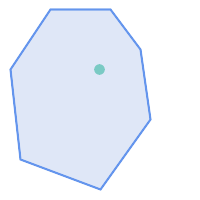
|
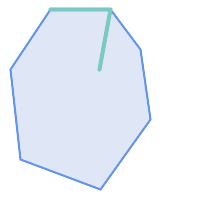
| 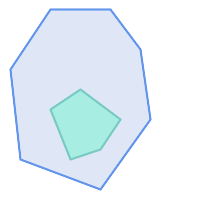
|
La ST_Contains renvoie FALSE dans les situations suivantes :
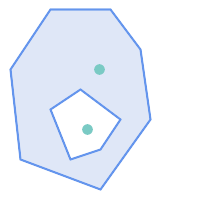
| 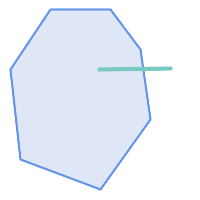
|
En raison de la condition d'intersection intérieure, la ST_Contains renvoie FALSE dans les situations suivantes (alors que la ST_Covers renvoie TRUE) :

| 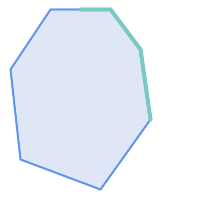
|
-- A circle within a circle
SELECT ST_Contains(smallc, bigc) As smallcontainsbig,
ST_Contains(bigc,smallc) As bigcontainssmall,
ST_Contains(bigc, ST_Union(smallc, bigc)) as bigcontainsunion,
ST_Equals(bigc, ST_Union(smallc, bigc)) as bigisunion,
ST_Covers(bigc, ST_ExteriorRing(bigc)) As bigcoversexterior,
ST_Contains(bigc, ST_ExteriorRing(bigc)) As bigcontainsexterior
FROM (SELECT ST_Buffer(ST_GeomFromText('POINT(1 2)'), 10) As smallc,
ST_Buffer(ST_GeomFromText('POINT(1 2)'), 20) As bigc) As foo;
-- Result
smallcontainsbig | bigcontainssmall | bigcontainsunion | bigisunion | bigcoversexterior | bigcontainsexterior
------------------+------------------+------------------+------------+-------------------+---------------------
f | t | t | t | t | f
-- Example demonstrating difference between contains and contains properly
SELECT ST_GeometryType(geomA) As geomtype, ST_Contains(geomA,geomA) AS acontainsa, ST_ContainsProperly(geomA, geomA) AS acontainspropa,
ST_Contains(geomA, ST_Boundary(geomA)) As acontainsba, ST_ContainsProperly(geomA, ST_Boundary(geomA)) As acontainspropba
FROM (VALUES ( ST_Buffer(ST_Point(1,1), 5,1) ),
( ST_MakeLine(ST_Point(1,1), ST_Point(-1,-1) ) ),
( ST_Point(1,1) )
) As foo(geomA);
geomtype | acontainsa | acontainspropa | acontainsba | acontainspropba
--------------+------------+----------------+-------------+-----------------
ST_Polygon | t | f | f | f
ST_LineString | t | f | f | f
ST_Point | t | t | f | f
Voir aussi
ST_Boundary, ST_ContainsProperly, ST_Covers, ST_CoveredBy, ST_Equals, ST_Within
Name
ST_ContainsProperly — Tests si chaque point de B se trouve à l'intérieur de A
Synopsis
boolean ST_ContainsProperly(geometry geomA, geometry geomB);
Description
Retourne vrai si chaque point de B se trouve à l'intérieur de A (ou, de façon équivalente, si aucun point de B ne se trouve à la limite ou à l'extérieur de A).
En termes mathématiques : ST_ContainsProperly(A, B) ⇔ Int(A) ⋂ B = B
A contient B correctement si la matrice d'intersection DE-9IM pour les deux géométries correspond à [T**FF*FF*]
A ne se contient pas proprement, mais se contient.
Ce prédicat peut être utilisé pour calculer les intersections d'un ensemble de géométries avec une grande géométrie polygonale. L'intersection étant une opération assez lente, il peut être plus efficace d'utiliser containsProperly pour filtrer les géométries de test qui se trouvent entièrement à l'intérieur de la zone. Dans ce cas, on sait a priori que l'intersection correspond exactement à la géométrie d'essai originale.
![[Note]](images/note.png) | |
Cette fonction inclut une comparaison de la boîte englobante qui utilise tous les index disponibles sur les géométries. Pour éviter l'utilisation d'un index, utilisez la fonction |
![[Note]](images/note.png) | |
L'avantage de ce prédicat par rapport à ST_Contains et ST_Intersects est qu'il peut être calculé plus efficacement, sans qu'il soit nécessaire de calculer la topologie en des points individuels. |
Effectué par le module GEOS.
Disponibilité : 1.4.0
![[Important]](images/important.png) | |
Amélioration : 3.0.0 a permis la prise en charge de |
![[Important]](images/important.png) | |
N'utilisez pas cette fonction avec des géométries non valides. Vous obtiendrez des résultats inattendus. |
Exemples
--a circle within a circle
SELECT ST_ContainsProperly(smallc, bigc) As smallcontainspropbig,
ST_ContainsProperly(bigc,smallc) As bigcontainspropsmall,
ST_ContainsProperly(bigc, ST_Union(smallc, bigc)) as bigcontainspropunion,
ST_Equals(bigc, ST_Union(smallc, bigc)) as bigisunion,
ST_Covers(bigc, ST_ExteriorRing(bigc)) As bigcoversexterior,
ST_ContainsProperly(bigc, ST_ExteriorRing(bigc)) As bigcontainsexterior
FROM (SELECT ST_Buffer(ST_GeomFromText('POINT(1 2)'), 10) As smallc,
ST_Buffer(ST_GeomFromText('POINT(1 2)'), 20) As bigc) As foo;
--Result
smallcontainspropbig | bigcontainspropsmall | bigcontainspropunion | bigisunion | bigcoversexterior | bigcontainsexterior
------------------+------------------+------------------+------------+-------------------+---------------------
f | t | f | t | t | f
--example demonstrating difference between contains and contains properly
SELECT ST_GeometryType(geomA) As geomtype, ST_Contains(geomA,geomA) AS acontainsa, ST_ContainsProperly(geomA, geomA) AS acontainspropa,
ST_Contains(geomA, ST_Boundary(geomA)) As acontainsba, ST_ContainsProperly(geomA, ST_Boundary(geomA)) As acontainspropba
FROM (VALUES ( ST_Buffer(ST_Point(1,1), 5,1) ),
( ST_MakeLine(ST_Point(1,1), ST_Point(-1,-1) ) ),
( ST_Point(1,1) )
) As foo(geomA);
geomtype | acontainsa | acontainspropa | acontainsba | acontainspropba
--------------+------------+----------------+-------------+-----------------
ST_Polygon | t | f | f | f
ST_LineString | t | f | f | f
ST_Point | t | t | f | f
Voir aussi
ST_GeometryType, ST_Boundary, ST_Contains, ST_Covers, ST_CoveredBy, ST_Equals, ST_Relate, ST_Within
Name
ST_CoveredBy — Tests si chaque point de A se trouve dans B
Synopsis
boolean ST_CoveredBy(geometry geomA, geometry geomB);
boolean ST_CoveredBy(geography geogA, geography geogB);
Description
Renvoie true si chaque point de la geometry/geography A se trouve à l'intérieur (c'est-à-dire coupe l'intérieur ou la limite) de la geometry/geography B. De manière équivalente, teste qu'aucun point de A ne se trouve à l'extérieur (dans l'extérieur) de B.
En termes mathématiques : ST_CoveredBy(A, B) ⇔ A ⋂ B = A
ST_CoveredBy est le contraire de ST_Covers. Ainsi, ST_CoveredBy(A,B) = ST_Covers(B,A).
En général, cette fonction devrait être utilisée à la place de ST_Within, car elle a une définition plus simple qui n'a pas la particularité que "les limites ne sont pas à l'intérieur de leur géométrie".
![[Note]](images/note.png) | |
Cette fonction inclut une comparaison de la boîte englobante qui utilise tous les index disponibles sur les géométries. Pour éviter l'utilisation d'un index, utilisez la fonction |
![[Important]](images/important.png) | |
Amélioration : 3.0.0 a permis la prise en charge de |
![[Important]](images/important.png) | |
N'utilisez pas cette fonction avec des géométries non valides. Vous obtiendrez des résultats inattendus. |
Effectué par le module GEOS
Disponibilité : 1.2.2
NOTE : il s'agit de la version "autorisée" qui renvoie un booléen et non un entier.
Il ne s'agit pas d'une norme de l'OGC, mais Oracle l'a également.
Exemples
--a circle coveredby a circle
SELECT ST_CoveredBy(smallc,smallc) As smallinsmall,
ST_CoveredBy(smallc, bigc) As smallcoveredbybig,
ST_CoveredBy(ST_ExteriorRing(bigc), bigc) As exteriorcoveredbybig,
ST_Within(ST_ExteriorRing(bigc),bigc) As exeriorwithinbig
FROM (SELECT ST_Buffer(ST_GeomFromText('POINT(1 2)'), 10) As smallc,
ST_Buffer(ST_GeomFromText('POINT(1 2)'), 20) As bigc) As foo;
--Result
smallinsmall | smallcoveredbybig | exteriorcoveredbybig | exeriorwithinbig
--------------+-------------------+----------------------+------------------
t | t | t | f
(1 row) Voir aussi
Name
ST_Covers — Tests si chaque point de B est situé dans A
Synopsis
boolean ST_Covers(geometry geomA, geometry geomB);
boolean ST_Covers(geography geogpolyA, geography geogpointB);
Description
Renvoie true si chaque point de la geometry/geography B se trouve à l'intérieur (c'est-à-dire qu'il coupe l'intérieur ou la limite) de la geometry/geography A. De façon équivalente, teste qu'aucun point de B ne se trouve à l'extérieur (dans l'extérieur) de A.
En termes mathématiques : ST_Covers(A, B) ⇔ A ⋂ B = B
ST_Covers est le contraire de ST_CoveredBy. Ainsi, ST_Covers(A,B) = ST_CoveredBy(B,A).
En général, cette fonction devrait être utilisée à la place de ST_Contains, car elle a une définition plus simple qui n'a pas la particularité que "les géométries ne contiennent pas leur frontière".
![[Note]](images/note.png) | |
Cette fonction inclut une comparaison de la boîte englobante qui utilise tous les index disponibles sur les géométries. Pour éviter l'utilisation d'un index, utilisez la fonction |
![[Important]](images/important.png) | |
Amélioration : 3.0.0 a permis la prise en charge de |
![[Important]](images/important.png) | |
N'utilisez pas cette fonction avec des géométries non valides. Vous obtiendrez des résultats inattendus. |
Effectué par le module GEOS
Amélioration : 2.4.0 Ajout de la prise en charge des polygones dans les polygones et des lignes dans les polygones pour le type geography
Amélioration : 2.3.0 Amélioration du court-circuit PIP pour la géométrie étendue à la prise en charge des multipoints avec peu de points. Les versions précédentes ne prenaient en charge que les points dans les polygones.
Disponibilité : 1.5 - le support de la geography a été introduit.
Disponibilité : 1.2.2
NOTE : il s'agit de la version "autorisée" qui renvoie un booléen et non un entier.
Il ne s'agit pas d'une norme de l'OGC, mais Oracle l'a également.
Exemples
Exemple géométrique
--a circle covering a circle
SELECT ST_Covers(smallc,smallc) As smallinsmall,
ST_Covers(smallc, bigc) As smallcoversbig,
ST_Covers(bigc, ST_ExteriorRing(bigc)) As bigcoversexterior,
ST_Contains(bigc, ST_ExteriorRing(bigc)) As bigcontainsexterior
FROM (SELECT ST_Buffer(ST_GeomFromText('POINT(1 2)'), 10) As smallc,
ST_Buffer(ST_GeomFromText('POINT(1 2)'), 20) As bigc) As foo;
--Result
smallinsmall | smallcoversbig | bigcoversexterior | bigcontainsexterior
--------------+----------------+-------------------+---------------------
t | f | t | f
(1 row) Exemple géographique
-- a point with a 300 meter buffer compared to a point, a point and its 10 meter buffer
SELECT ST_Covers(geog_poly, geog_pt) As poly_covers_pt,
ST_Covers(ST_Buffer(geog_pt,10), geog_pt) As buff_10m_covers_cent
FROM (SELECT ST_Buffer(ST_GeogFromText('SRID=4326;POINT(-99.327 31.4821)'), 300) As geog_poly,
ST_GeogFromText('SRID=4326;POINT(-99.33 31.483)') As geog_pt ) As foo;
poly_covers_pt | buff_10m_covers_cent
----------------+------------------
f | t
Voir aussi
Name
ST_Crosses — Teste si deux géométries ont en commun certains points intérieurs, mais pas tous
Synopsis
boolean ST_Crosses(geometry g1, geometry g2);
Description
Compare deux objets géométriques et renvoie true si leur intersection "se croise spatialement", c'est-à-dire que les géométries ont certains points intérieurs en commun, mais pas tous. L'intersection des intérieurs des géométries doit être non vide et doit avoir une dimension inférieure à la dimension maximale des deux géométries d'entrée, et l'intersection des deux géométries ne doit pas être égale à l'une ou l'autre géométrie. Sinon, il renvoie false. La relation entre les croix est symétrique et irréflexive.
En termes mathématiques : ST_Crosses(A, B) ⇔ (dim( Int(A) ⋂ Int(B) ) < max( dim( Int(A) ), dim( Int(B) ) )) ∧ (A ⋂ B ≠ A) ∧ (A ⋂ B ≠ B)
Les géométries se croisent si leur matrice d'intersection DE-9IM correspond :
T*T******pour les situations point/ligne, point/zone et ligne/zoneT*****T**pour les situations Ligne/Point, Zone/Point et Zone/Ligne0********pour les situations ligne/lignele résultat est
falsepour les situations Point/Point et Area/Area
![[Note]](images/note.png) | |
La spécification OpenGIS Simple Features définit ce prédicat uniquement pour les situations Point/Ligne, Point/Zone, Ligne/Ligne et Ligne/Zone. Le STC / GEOS étend la définition pour qu'elle s'applique également aux situations Ligne/Point, Zone/Point et Zone/Ligne. Cela rend la relation symétrique. |
![[Note]](images/note.png) | |
Cette fonction inclut une comparaison de la boîte englobante qui utilise tous les index disponibles sur les géométries. |
![[Important]](images/important.png) | |
Amélioration : 3.0.0 a permis la prise en charge de |
 Cette méthode implémente la spécification OGC Simple Features Implementation Specification for SQL 1.1. s2.1.13.3
Cette méthode implémente la spécification OGC Simple Features Implementation Specification for SQL 1.1. s2.1.13.3
 Cette méthode implémente la spécification SQL/MM. SQL-MM 3: 5.1.29
Cette méthode implémente la spécification SQL/MM. SQL-MM 3: 5.1.29
Exemples
Les situations suivantes renvoient toutes true.
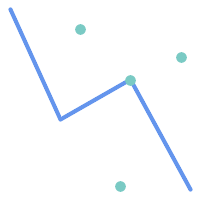
| 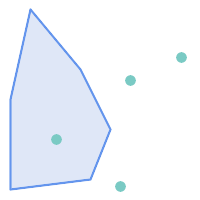
|
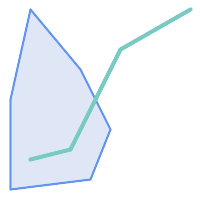
| 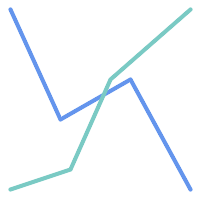
|
Prenons le cas d'un utilisateur qui dispose de deux tables : une table de routes et une table d'autoroutes.
CREATE TABLE roads ( id serial NOT NULL, geom geometry, CONSTRAINT roads_pkey PRIMARY KEY (road_id) );
|
CREATE TABLE highways ( id serial NOT NULL, the_gem geometry, CONSTRAINT roads_pkey PRIMARY KEY (road_id) );
|
Pour obtenir une liste des routes qui traversent une autoroute, utilisez une requête similaire à :
SELECT roads.id FROM roads, highways WHERE ST_Crosses(roads.geom, highways.geom);
Voir aussi
Name
ST_Disjoint — Teste si deux géométries n'ont pas de points communs
Synopsis
boolean ST_Disjoint( geometry A , geometry B );
Description
Renvoie true si deux géométries sont disjointes. Les géométries sont disjointes si elles n'ont aucun point en commun.
Si une autre relation spatiale est vraie pour une paire de géométries, celles-ci ne sont pas disjointes. La disjonction implique que ST_Intersects est fausse.
En termes mathématiques : ST_Disjoint(A, B) ⇔ A ⋂ B = ∅
![[Important]](images/important.png) | |
Amélioration : 3.0.0 a permis la prise en charge de |
Effectué par le module GEOS
![[Note]](images/note.png) | |
Cet appel de fonction n'utilise pas d'index. Un prédicat négatif ST_Intersects peut être utilisé comme une alternative plus performante qui utilise des index : |
![[Note]](images/note.png) | |
NOTE : il s'agit de la version "autorisée" qui renvoie un booléen et non un entier. |
 Cette méthode implémente la spécification OGC Simple Features Implementation Specification for SQL 1.1. s2.1.1.2 //s2.1.13.3 - a.Relate(b, 'FF*FF****')
Cette méthode implémente la spécification OGC Simple Features Implementation Specification for SQL 1.1. s2.1.1.2 //s2.1.13.3 - a.Relate(b, 'FF*FF****')
 Cette méthode implémente la spécification SQL/MM. SQL-MM 3: 5.1.26
Cette méthode implémente la spécification SQL/MM. SQL-MM 3: 5.1.26
Exemples
SELECT ST_Disjoint('POINT(0 0)'::geometry, 'LINESTRING ( 2 0, 0 2 )'::geometry);
st_disjoint
---------------
t
(1 row)
SELECT ST_Disjoint('POINT(0 0)'::geometry, 'LINESTRING ( 0 0, 0 2 )'::geometry);
st_disjoint
---------------
f
(1 row)
Voir aussi
Name
ST_Equals — Teste si deux géométries comprennent le même ensemble de points
Synopsis
boolean ST_Equals(geometry A, geometry B);
Description
Renvoie true si les géométries données sont "topologiquement égales". Utilisez ceci pour une "meilleure" réponse que "=". L'égalité topologique signifie que les géométries ont la même dimension et que leurs ensembles de points occupent le même espace. Cela signifie que l'ordre des sommets peut être différent dans des géométries topologiquement égales. Pour vérifier que l'ordre des points est cohérent, utilisez ST_OrderingEquals (il convient de noter que ST_OrderingEquals est un peu plus strict que la simple vérification de l'ordre des points).
En termes mathématiques : ST_Equals(A, B) ⇔ A = B
La relation suivante est valable : ST_Equals(A, B) ⇔ ST_Within(A,B) ∧ ST_Within(B,A)
![[Important]](images/important.png) | |
Amélioration : 3.0.0 a permis la prise en charge de |
 Cette méthode implémente la spécification OGC Simple Features Implementation Specification for SQL 1.1. s2.1.1.2
Cette méthode implémente la spécification OGC Simple Features Implementation Specification for SQL 1.1. s2.1.1.2
 Cette méthode implémente la spécification SQL/MM. SQL-MM 3: 5.1.24
Cette méthode implémente la spécification SQL/MM. SQL-MM 3: 5.1.24
Modifié : 2.2.0 Retourne vrai même pour les géométries invalides si elles sont binairement égales
Exemples
SELECT ST_Equals(ST_GeomFromText('LINESTRING(0 0, 10 10)'),
ST_GeomFromText('LINESTRING(0 0, 5 5, 10 10)'));
st_equals
-----------
t
(1 row)
SELECT ST_Equals(ST_Reverse(ST_GeomFromText('LINESTRING(0 0, 10 10)')),
ST_GeomFromText('LINESTRING(0 0, 5 5, 10 10)'));
st_equals
-----------
t
(1 row)
Voir aussi
Name
ST_Intersects — Teste si deux géométries se croisent (elles ont au moins un point en commun)
Synopsis
boolean ST_Intersects( geometry geomA , geometry geomB );
boolean ST_Intersects( geography geogA , geography geogB );
Description
Renvoie true si deux géométries se croisent. Les géométries se croisent si elles ont un point commun.
Pour les objets de type geography, une tolérance de distance de 0,00001 mètre est utilisée (les points très proches sont donc considérés comme se croisant).
En termes mathématiques : ST_Intersects(A, B) ⇔ A ⋂ B ≠ ∅
Les géométries se croisent si leur matrice d'intersection DE-9IM correspond à l'un des éléments suivants :
T*********T**********T*********T****
L'intersection spatiale est impliquée par tous les autres tests de relations spatiales, à l'exception de ST_Disjoint, qui teste que les géométries ne se croisent PAS.
![[Note]](images/note.png) | |
Cette fonction inclut une comparaison de la boîte englobante qui utilise tous les index disponibles sur les géométries. |
Modifié : 3.0.0 La version SFCGAL a été supprimée et la prise en charge native des TINS 2D a été ajoutée.
Amélioré : 2.5.0 Supporte GEOMETRYCOLLECTION.
Amélioré : 2.3.0 Amélioration du court-circuit PIP étendu à la prise en charge des multipoints avec peu de points. Les versions précédentes ne prenaient en charge que les points dans les polygones.
Effectuée par le module GEOS (pour geometry), la geography est native
Disponibilité : la version 1.5 a introduit la prise en charge du type geography.
![[Note]](images/note.png) | |
Pour geography, cette fonction a une tolérance de distance d'environ 0,00001 mètre et utilise la sphère plutôt que le calcul du sphéroïde. |
![[Note]](images/note.png) | |
NOTE : il s'agit de la version "autorisée" qui renvoie un booléen et non un entier. |
 Cette méthode implémente la spécification OGC Simple Features Implementation Specification for SQL 1.1. s2.1.1.2 //s2.1.13.3 - ST_Intersects(g1, g2 ) --> Not (ST_Disjoint(g1, g2 ))
Cette méthode implémente la spécification OGC Simple Features Implementation Specification for SQL 1.1. s2.1.1.2 //s2.1.13.3 - ST_Intersects(g1, g2 ) --> Not (ST_Disjoint(g1, g2 ))
 Cette méthode implémente la spécification SQL/MM. SQL-MM 3: 5.1.27
Cette méthode implémente la spécification SQL/MM. SQL-MM 3: 5.1.27
 Cette méthode prend en charge les types Circular String et Curve.
Cette méthode prend en charge les types Circular String et Curve.
 Cette fonction prend en charge les triangles et les réseaux irréguliers triangulés (TIN).
Cette fonction prend en charge les triangles et les réseaux irréguliers triangulés (TIN).
Exemples de géométrie
SELECT ST_Intersects('POINT(0 0)'::geometry, 'LINESTRING ( 2 0, 0 2 )'::geometry);
st_intersects
---------------
f
(1 row)
SELECT ST_Intersects('POINT(0 0)'::geometry, 'LINESTRING ( 0 0, 0 2 )'::geometry);
st_intersects
---------------
t
(1 row)
-- Look up in table. Make sure table has a GiST index on geometry column for faster lookup.
SELECT id, name FROM cities WHERE ST_Intersects(geom, 'SRID=4326;POLYGON((28 53,27.707 52.293,27 52,26.293 52.293,26 53,26.293 53.707,27 54,27.707 53.707,28 53))');
id | name
----+-------
2 | Minsk
(1 row)
Exemples géographiques
SELECT ST_Intersects(
'SRID=4326;LINESTRING(-43.23456 72.4567,-43.23456 72.4568)'::geography,
'SRID=4326;POINT(-43.23456 72.4567772)'::geography
);
st_intersects
---------------
t
Voir aussi
Name
ST_LineCrossingDirection — Renvoie un nombre indiquant le comportement de croisement de deux LineStrings
Synopsis
integer ST_LineCrossingDirection(geometry linestringA, geometry linestringB);
Description
En ayant 2 lignes en entrée, renvoie un nombre entier entre -3 et 3 indiquant le type de croisement qui existe entre elles. 0 indique qu'il n'y a pas de croisement. Cette fonction n'est prise en charge que pour les LINESTRINGs.
Le numéro de croisement a la signification suivante :
0 : LIGNE SANS CROISEMENT
-1 : LIGNE CROISÉE À GAUCHE
-1 : LIGNE CROISÉE À DROITE
-2 : LIGNE MULTICROISEMENT EXTRÉMITÉ GAUCHE
-2 : LIGNE MULTICROISEMENT EXTRÉMITÉ DROITE
-3 : LIGNE MULTICROISEMENT FIN IDENTIQUE AU PREMIER GAUCHE
-3 : LIGNE MULTICROISEMENT FIN IDENTIQUE AU PREMIER DROITE
Disponibilité : 1.4
Exemples
Exemple: LIGNE CROISEE A GAUCHE et LIGNE CROISEE A DROITE
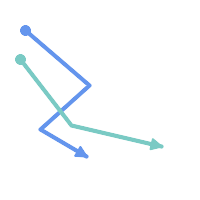
Bleu : Ligne A ; Vert : Ligne B
SELECT ST_LineCrossingDirection(lineA, lineB) As A_cross_B,
ST_LineCrossingDirection(lineB, lineA) As B_cross_A
FROM (SELECT
ST_GeomFromText('LINESTRING(25 169,89 114,40 70,86 43)') As lineA,
ST_GeomFromText('LINESTRING (20 140, 71 74, 161 53)') As lineB
) As foo;
A_cross_B | B_cross_A
-----------+-----------
-1 | 1
Exemple: LIGNE MULTICROISEMENT FIN IDENTIQUE AU PREMIER GAUCHE et LIGNE MULTICROISEMENT FIN IDENTIQUE AU PREMIER DROITE
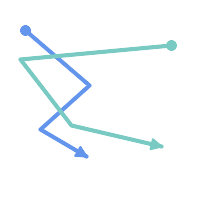
Bleu : Ligne A ; Vert : Ligne B
SELECT ST_LineCrossingDirection(lineA, lineB) As A_cross_B,
ST_LineCrossingDirection(lineB, lineA) As B_cross_A
FROM (SELECT
ST_GeomFromText('LINESTRING(25 169,89 114,40 70,86 43)') As lineA,
ST_GeomFromText('LINESTRING(171 154,20 140,71 74,161 53)') As lineB
) As foo;
A_cross_B | B_cross_A
-----------+-----------
3 | -3
Exemple: LIGNE MULTICROISEMENT EXTRÉMITÉ GAUCHE et LIGNE MULTICROISEMENT EXTRÉMITÉ DROITE
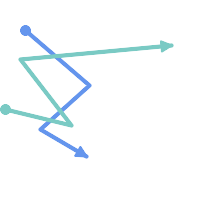
Bleu : Ligne A ; Vert : Ligne B
SELECT ST_LineCrossingDirection(lineA, lineB) As A_cross_B,
ST_LineCrossingDirection(lineB, lineA) As B_cross_A
FROM (SELECT
ST_GeomFromText('LINESTRING(25 169,89 114,40 70,86 43)') As lineA,
ST_GeomFromText('LINESTRING(5 90, 71 74, 20 140, 171 154)') As lineB
) As foo;
A_cross_B | B_cross_A
-----------+-----------
-2 | 2
Exemple: Trouve toutes les rues qui se croisent
SELECT s1.gid, s2.gid, ST_LineCrossingDirection(s1.geom, s2.geom)
FROM streets s1 CROSS JOIN streets s2
ON (s1.gid != s2.gid AND s1.geom && s2.geom )
WHERE ST_LineCrossingDirection(s1.geom, s2.geom)
> 0;
Voir aussi
Name
ST_OrderingEquals — Teste si deux géométries représentent la même géométrie et ont des points dans le même ordre directionnel
Synopsis
boolean ST_OrderingEquals(geometry A, geometry B);
Description
ST_OrderingEquals compare deux géométries et renvoie t (TRUE) si les géométries sont égales et si les coordonnées sont dans le même ordre ; sinon, il renvoie f (FALSE).
![[Note]](images/note.png) | |
Cette fonction est mise en œuvre conformément à la spécification SQL d'ArcSDE plutôt que SQL-MM. http://edndoc.esri.com/arcsde/9.1/sql_api/sqlapi3.htm#ST_OrderingEquals |
 Cette méthode implémente la spécification SQL/MM. SQL-MM 3: 5.1.43
Cette méthode implémente la spécification SQL/MM. SQL-MM 3: 5.1.43
Exemples
SELECT ST_OrderingEquals( 'LINESTRING(0 0, 10 10)', 'LINESTRING(0 0, 5 5, 10 10)'); st_orderingequals ----------- f SELECT ST_OrderingEquals( 'LINESTRING(0 0, 10 10)', 'LINESTRING(0 0, 10 10)'); st_orderingequals ----------- t SELECT ST_OrderingEquals( 'POLYGON((0 0, 0 1, 1 1, 1 0, 0 0))', 'POLYGON((0 0, 1 0, 1 1, 0 1, 0 0))'); st_orderingequals ----------- f
Voir aussi
Name
ST_Overlaps — Teste si deux géométries ont la même dimension et se croisent, mais si chacune a au moins un point qui n'est pas dans l'autre
Synopsis
boolean ST_Overlaps(geometry A, geometry B);
Description
Renvoie TRUE si les géométries A et B se "chevauchent spatialement". Deux géométries se chevauchent si elles ont la même dimension, si leurs intérieurs se croisent dans cette dimension et si chacune a au moins un point à l'intérieur de l'autre (ou, de manière équivalente, si aucune des deux ne recouvre l'autre). La relation de chevauchement est symétrique et irréflexive.
En termes mathématiques : ST_Overlaps(A, B) ⇔ ( dim(A) = dim(B) = dim( Int(A) ⋂ Int(B) )). ∧ (A ⋂ B ≠ A) ∧ (A ⋂ B ≠ B)
![[Note]](images/note.png) | |
Cette fonction inclut une comparaison de la boîte englobante qui utilise tous les index disponibles sur les géométries. Pour éviter l'utilisation d'un index, utilisez la fonction |
Effectué par le module GEOS
![[Important]](images/important.png) | |
Amélioration : 3.0.0 a permis la prise en charge de |
NOTE : il s'agit de la version "autorisée" qui renvoie un booléen et non un entier.
 Cette méthode implémente la spécification OGC Simple Features Implementation Specification for SQL 1.1. s2.1.1.2 // s2.1.13.3
Cette méthode implémente la spécification OGC Simple Features Implementation Specification for SQL 1.1. s2.1.1.2 // s2.1.13.3
 Cette méthode implémente la spécification SQL/MM. SQL-MM 3: 5.1.32
Cette méthode implémente la spécification SQL/MM. SQL-MM 3: 5.1.32
Exemples
ST_Overlaps renvoie TRUE dans les situations suivantes :
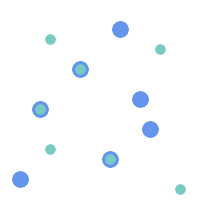
| 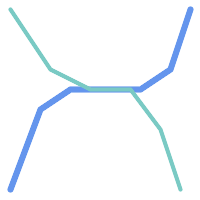
| 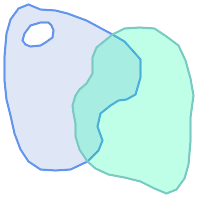
|

Un point sur une LineString est contenu, mais comme il a une dimension inférieure, il ne se chevauche pas et ne se croise pas.
SELECT ST_Overlaps(a,b) AS overlaps, ST_Crosses(a,b) AS crosses,
ST_Intersects(a, b) AS intersects, ST_Contains(b,a) AS b_contains_a
FROM (SELECT ST_GeomFromText('POINT (100 100)') As a,
ST_GeomFromText('LINESTRING (30 50, 40 160, 160 40, 180 160)') AS b) AS t
overlaps | crosses | intersects | b_contains_a
---------+----------------------+--------------
f | f | t | t
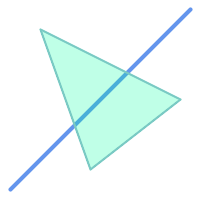
Une chaîne de lignes qui recouvre partiellement un polygone l'intersecte et le traverse, mais ne se chevauche pas car elle a des dimensions différentes.
SELECT ST_Overlaps(a,b) AS overlaps, ST_Crosses(a,b) AS crosses,
ST_Intersects(a, b) AS intersects, ST_Contains(a,b) AS contains
FROM (SELECT ST_GeomFromText('POLYGON ((40 170, 90 30, 180 100, 40 170))') AS a,
ST_GeomFromText('LINESTRING(10 10, 190 190)') AS b) AS t;
overlap | crosses | intersects | contains
---------+---------+------------+--------------
f | t | t | f
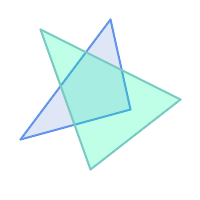
Deux polygones qui se croisent mais dont aucun n'est contenu par l'autre se chevauchent, mais ne se croisent pas car leur intersection a la même dimension.
SELECT ST_Overlaps(a,b) AS overlaps, ST_Crosses(a,b) AS crosses,
ST_Intersects(a, b) AS intersects, ST_Contains(b, a) AS b_contains_a,
ST_Dimension(a) AS dim_a, ST_Dimension(b) AS dim_b,
ST_Dimension(ST_Intersection(a,b)) AS dim_int
FROM (SELECT ST_GeomFromText('POLYGON ((40 170, 90 30, 180 100, 40 170))') AS a,
ST_GeomFromText('POLYGON ((110 180, 20 60, 130 90, 110 180))') AS b) As t;
overlaps | crosses | intersects | b_contains_a | dim_a | dim_b | dim_int
----------+---------+------------+--------------+-------+-------+-----------
t | f | t | f | 2 | 2 | 2
Voir aussi
Name
ST_Relate — Teste si deux géométries ont une relation topologique correspondant à un modèle de matrice d'intersection, ou calcule leur matrice d'intersection
Synopsis
boolean ST_Relate(geometry geomA, geometry geomB, text intersectionMatrixPattern);
text ST_Relate(geometry geomA, geometry geomB);
text ST_Relate(geometry geomA, geometry geomB, integer boundaryNodeRule);
Description
Ces fonctions permettent de tester et d'évaluer la relation spatiale (topologique) entre deux géométries, telle que définie par le Dimensionally Extended 9-Intersection Model (DE-9IM).
Le DE-9IM est une matrice à 9 éléments indiquant la dimension des intersections entre l'intérieur, la frontière et l'extérieur de deux géométries. Elle est représentée par une chaîne de texte de 9 caractères utilisant les symboles "F", "0", "1", "2" (par exemple, 'FF1FF0102').
Un type spécifique de relation spatiale peut être testé en faisant correspondre la matrice d'intersection à un motif de matrice d'intersection. Les motifs peuvent inclure les symboles supplémentaires "T" (signifiant "l'intersection est non vide") et "*" (signifiant "n'importe quelle valeur"). Les relations spatiales communes sont fournies par les fonctions nommées ST_Contains, ST_ContainsProperly, ST_Covers, ST_CoveredBy, ST_Crosses, ST_Disjoint, ST_Equals, ST_Intersects, ST_Overlaps, ST_Touches, et ST_Within. L'utilisation d'un modèle explicite permet de tester plusieurs conditions d'intersection, de croisement, etc. en une seule étape. Elle permet également de tester des relations spatiales qui n'ont pas de fonction de relation spatiale nommée. Par exemple, la relation "Interior-Intersects" possède le motif DE-9IM T********, qui n'est évalué par aucun prédicat nommé.
Pour plus d'informations, voir Section 5.1, “Déterminer les relations spatiales”.
Variante 1: Teste si deux géométries sont spatialement liées selon le intersectionMatrixPattern donné.
![[Note]](images/note.png) | |
Contrairement à la plupart des prédicats de relations spatiales nommées, ce prédicat n'inclut PAS automatiquement un appel d'index. La raison en est que certaines relations sont vraies pour des géométries qui ne s'intersectent PAS (par exemple Disjoint). Si vous utilisez un modèle de relation qui nécessite une intersection, incluez l'appel à l'index &&. |
![[Note]](images/note.png) | |
Il est préférable d'utiliser une fonction de relation nommée si elle est disponible, car elle utilise automatiquement un index spatial lorsqu'il existe. En outre, elles peuvent mettre en œuvre des optimisations de performance qui ne sont pas disponibles avec l'évaluation de la relation complète. |
Variante 2: Renvoie la chaîne matricielle DE-9IM pour la relation spatiale entre les deux géométries d'entrée. La chaîne matricielle peut être testée pour vérifier si elle correspond à un modèle DE-9IM en utilisant ST_RelateMatch.
Variante 3: Comme la variante 2, mais permet de spécifier une Boundary Node Rule. Une boundary node rule permet de contrôler plus finement si les extrémités des multilignes sont considérées comme se situant à l'intérieur ou à la limite du DE-9IM. Les valeurs de boundaryNodeRule sont les suivantes :
1: OGC-Mod2 - les extrémités des lignes sont dans la frontière si elles apparaissent un nombre impair de fois. C'est la règle définie par la norme SFS de l'OGC, et c'est la valeur par défaut de laST_Relate.2: Endpoint - tous les points d'extrémité sont dans la frontière.3: MultivalentEndpoint - les points d'extrémité sont dans la frontière s'ils apparaissent plus d'une fois. En d'autres termes, la frontière est constituée de tous les points d'extrémité "attachés" ou "internes" (mais pas des points d'extrémité "non attachés/externes").4: MonovalentEndpoint - les points d'extrémité sont dans la frontière s'ils n'apparaissent qu'une seule fois. En d'autres termes, la frontière est constituée de tous les points d'extrémité "non attachés" ou "extérieurs".
Cette fonction ne figure pas dans la spécification de l'OGC, mais elle est implicite. voir s2.1.13.2
 Cette méthode implémente la spécification OGC Simple Features Implementation Specification for SQL 1.1. s2.1.1.2 // s2.1.13.3
Cette méthode implémente la spécification OGC Simple Features Implementation Specification for SQL 1.1. s2.1.1.2 // s2.1.13.3
 Cette méthode implémente la spécification SQL/MM. SQL-MM 3 : 5.1.25
Cette méthode implémente la spécification SQL/MM. SQL-MM 3 : 5.1.25
Effectué par le module GEOS
Amélioration : 2.0.0 - ajout de la prise en charge de la spécification de boundary node rule.
![[Important]](images/important.png) | |
Amélioration : 3.0.0 a permis la prise en charge de |
Exemples
Utilisation de la fonction booléenne pour tester les relations spatiales.
SELECT ST_Relate('POINT(1 2)', ST_Buffer( 'POINT(1 2)', 2), '0FFFFF212');
st_relate
-----------
t
SELECT ST_Relate(POINT(1 2)', ST_Buffer( 'POINT(1 2)', 2), '*FF*FF212');
st_relate
-----------
t
Test d'un modèle de relation spatiale personnalisé comme condition de requête, avec && pour permettre l'utilisation d'un index spatial.
-- Find compounds that properly intersect (not just touch) a poly (Interior Intersects)
SELECT c.* , p.name As poly_name
FROM polys AS p
INNER JOIN compounds As c
ON c.geom && p.geom
AND ST_Relate(p.geom, c.geom,'T********');
Calcul de la matrice d'intersection pour les relations spatiales.
SELECT ST_Relate( 'POINT(1 2)',
ST_Buffer( 'POINT(1 2)', 2));
-----------
0FFFFF212
SELECT ST_Relate( 'LINESTRING(1 2, 3 4)',
'LINESTRING(5 6, 7 8)' );
-----------
FF1FF0102
Utilisation de différentes Boundary Node Rules pour calculer la relation spatiale entre une LineString et une MultiLineString avec une extrémité dupliquée (3 3) :
En utilisant la règle OGC-Mod2 (1), l'extrémité dupliquée se trouve dans l' intérieur de la MultiLineString, de sorte que l'entrée de la matrice DE-9IM [aB:bI] est
0et [aB:bB] estF.En utilisant la règle Endpoint (2), l'extrémité dupliquée se trouve dans la limite de la MultiLineString, de sorte que l'entrée de la matrice DE-9IM [aB:bI] est
Fet [aB:bB] est0.
WITH data AS (SELECT
'LINESTRING(1 1, 3 3)'::geometry AS a_line,
'MULTILINESTRING((3 3, 3 5), (3 3, 5 3))':: geometry AS b_multiline
)
SELECT ST_Relate( a_line, b_multiline, 1) AS bnr_mod2,
ST_Relate( a_line, b_multiline, 2) AS bnr_endpoint
FROM data;
bnr_mod2 | bnr_endpoint
-----------+--------------
FF10F0102 | FF1F00102
Name
ST_RelateMatch — Teste si une matrice d'intersection DE-9IM correspond à un modèle de matrice d'intersection
Synopsis
boolean ST_RelateMatch(text intersectionMatrix, text intersectionMatrixPattern);
Description
Teste si une Dimensionally Extended 9-Intersection Model (DE-9IM) intersectionMatrix satisfait un intersectionMatrixPattern. Les valeurs de la matrice d'intersection peuvent être calculées par ST_Relate.
Pour plus d'informations, voir Section 5.1, “Déterminer les relations spatiales”.
Effectué par le module GEOS
Disponibilité : 2.0.0
Exemples
SELECT ST_RelateMatch('101202FFF', 'TTTTTTFFF') ;
-- result --
t
Modèles de relations spatiales communes mis en correspondance avec les valeurs de la matrice d'intersection, pour une ligne dans différentes positions par rapport à un polygone
SELECT pat.name AS relationship, pat.val AS pattern,
mat.name AS position, mat.val AS matrix,
ST_RelateMatch(mat.val, pat.val) AS match
FROM (VALUES ( 'Equality', 'T1FF1FFF1' ),
( 'Overlaps', 'T*T***T**' ),
( 'Within', 'T*F**F***' ),
( 'Disjoint', 'FF*FF****' )) AS pat(name,val)
CROSS JOIN
(VALUES ('non-intersecting', 'FF1FF0212'),
('overlapping', '1010F0212'),
('inside', '1FF0FF212')) AS mat(name,val);
relationship | pattern | position | matrix | match
--------------+-----------+------------------+-----------+-------
Equality | T1FF1FFF1 | non-intersecting | FF1FF0212 | f
Equality | T1FF1FFF1 | overlapping | 1010F0212 | f
Equality | T1FF1FFF1 | inside | 1FF0FF212 | f
Overlaps | T*T***T** | non-intersecting | FF1FF0212 | f
Overlaps | T*T***T** | overlapping | 1010F0212 | t
Overlaps | T*T***T** | inside | 1FF0FF212 | f
Within | T*F**F*** | non-intersecting | FF1FF0212 | f
Within | T*F**F*** | overlapping | 1010F0212 | f
Within | T*F**F*** | inside | 1FF0FF212 | t
Disjoint | FF*FF**** | non-intersecting | FF1FF0212 | t
Disjoint | FF*FF**** | overlapping | 1010F0212 | f
Disjoint | FF*FF**** | inside | 1FF0FF212 | f
Name
ST_Touches — Teste si deux géométries ont au moins un point en commun, mais que leurs intérieurs ne se croisent pas
Synopsis
boolean ST_Touches(geometry A, geometry B);
Description
Retourne TRUE si A et B se croisent, mais que leurs intérieurs ne se croisent pas. De manière équivalente, A et B ont au moins un point en commun, et les points communs se situent dans au moins une frontière. Pour les entrées point/point, la relation est toujours FALSE, puisque les points n'ont pas de frontière.
En termes mathématiques : ST_Touches(A, B) ⇔ (Int(A) ⋂ Int(B) = ∅) ∧ (A ⋂ B ≠ ∅).
Cette relation est valable si la matrice d'intersection DE-9IM pour les deux géométries correspond à l'une d'entre elles :
FT*******
F**T*****
F***T****
![[Note]](images/note.png) | |
Cette fonction inclut une comparaison de la boîte englobante qui utilise tous les index disponibles sur les géométries. Pour éviter d'utiliser un index, utilisez plutôt la |
![[Important]](images/important.png) | |
Amélioration : 3.0.0 a permis la prise en charge de |
 Cette méthode implémente la spécification OGC Simple Features Implementation Specification for SQL 1.1. s2.1.1.2 // s2.1.13.3
Cette méthode implémente la spécification OGC Simple Features Implementation Specification for SQL 1.1. s2.1.1.2 // s2.1.13.3
 Cette méthode implémente la spécification SQL/MM. SQL-MM 3: 5.1.28
Cette méthode implémente la spécification SQL/MM. SQL-MM 3: 5.1.28
Exemples
Le prédicat ST_Touches renvoie TRUE dans les exemples suivants.
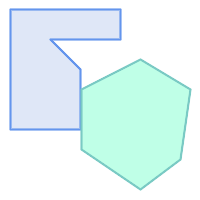
| 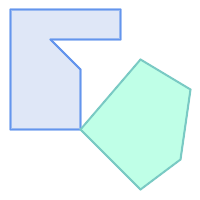
| 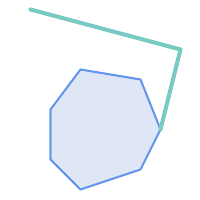
|
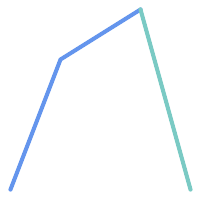
| 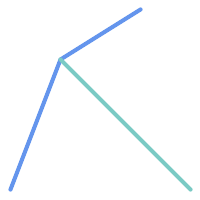
| 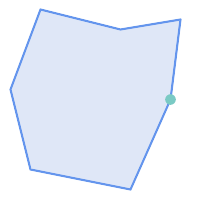
|
SELECT ST_Touches('LINESTRING(0 0, 1 1, 0 2)'::geometry, 'POINT(1 1)'::geometry);
st_touches
------------
f
(1 row)
SELECT ST_Touches('LINESTRING(0 0, 1 1, 0 2)'::geometry, 'POINT(0 2)'::geometry);
st_touches
------------
t
(1 row)Name
ST_Within — Tests si chaque point de A se trouve dans B, et que leurs intérieurs ont un point commun
Synopsis
boolean ST_Within(geometry A, geometry B);
Description
Renvoie TRUE si la géométrie A est à l'intérieur de la géométrie B. A est à l'intérieur de B si et seulement si tous les points de A se trouvent à l'intérieur (c'est-à-dire à l'intérieur ou à la limite) de B (ou de manière équivalente, aucun point de A ne se trouve à l'extérieur de B), et si les intérieurs de A et de B ont au moins un point en commun.
Pour que cette fonction ait un sens, les géométries sources doivent toutes deux avoir la même projection de coordonnées et le même SRID.
En termes mathématiques : ST_Within(A, B) ⇔ (A ⋂ B = A) ∧ (Int(A) ⋂ Int(B) ≠ ∅).
La relation within est réflexive : toute géométrie est à l'intérieur d'elle-même. La relation est antisymétrique : si ST_Within(A,B) = true et ST_Within(B,A) = true, alors les deux géométries doivent être topologiquement égales (ST_Equals(A,B) = true).
ST_Within est le contraire de ST_Contains. Ainsi, ST_Within(A,B) = ST_Contains(B,A).
![[Note]](images/note.png) | |
Comme les intérieurs doivent avoir un point commun, une subtilité de la définition est que les lignes et les points situés entièrement dans la limite des polygones ou des lignes ne sont pas à l'intérieur de la géométrie. Pour plus de détails, voir Subtleties of OGC Covers, Contains, Within. Le prédicat ST_CoveredBy fournit une relation plus inclusive. |
![[Note]](images/note.png) | |
Cette fonction inclut une comparaison de la boîte englobante qui utilise tous les index disponibles sur les géométries. Pour éviter l'utilisation d'un index, utilisez la fonction |
Effectué par le module GEOS
Amélioration : 2.3.0 Amélioration du court-circuit PIP pour la géométrie étendue à la prise en charge des multipoints avec peu de points. Les versions précédentes ne prenaient en charge que les points dans les polygones.
![[Important]](images/important.png) | |
Amélioration : 3.0.0 a permis la prise en charge de |
![[Important]](images/important.png) | |
N'utilisez pas cette fonction avec des géométries non valides. Vous obtiendrez des résultats inattendus. |
NOTE : il s'agit de la version "autorisée" qui renvoie un booléen et non un entier.
 Cette méthode implémente la spécification OGC Simple Features Implementation Specification for SQL 1.1. s2.1.1.2 // s2.1.13.3 - a.Relate(b, 'T*F**F***')
Cette méthode implémente la spécification OGC Simple Features Implementation Specification for SQL 1.1. s2.1.1.2 // s2.1.13.3 - a.Relate(b, 'T*F**F***')
 Cette méthode implémente la spécification SQL/MM. SQL-MM 3: 5.1.30
Cette méthode implémente la spécification SQL/MM. SQL-MM 3: 5.1.30
Exemples
--a circle within a circle
SELECT ST_Within(smallc,smallc) As smallinsmall,
ST_Within(smallc, bigc) As smallinbig,
ST_Within(bigc,smallc) As biginsmall,
ST_Within(ST_Union(smallc, bigc), bigc) as unioninbig,
ST_Within(bigc, ST_Union(smallc, bigc)) as biginunion,
ST_Equals(bigc, ST_Union(smallc, bigc)) as bigisunion
FROM
(
SELECT ST_Buffer(ST_GeomFromText('POINT(50 50)'), 20) As smallc,
ST_Buffer(ST_GeomFromText('POINT(50 50)'), 40) As bigc) As foo;
--Result
smallinsmall | smallinbig | biginsmall | unioninbig | biginunion | bigisunion
--------------+------------+------------+------------+------------+------------
t | t | f | t | t | t
(1 row)

Voir aussi
7.11.2. Relations de distance
- ST_3DDWithin — Teste si deux géométries 3D se trouvent à une distance 3D donnée
- ST_3DDFullyWithin — Teste si deux géométries 3D sont entièrement comprises dans une distance 3D donnée
- ST_DFullyWithin — Teste si une géométrie se trouve entièrement à une distance d'une autre géométrie
- ST_DWithin — Teste si deux géométries se trouvent à une distance donnée
- ST_PointInsideCircle — Teste si un point géométrique se trouve à l'intérieur d'un cercle défini par un centre et un rayon
Name
ST_3DDWithin — Teste si deux géométries 3D se trouvent à une distance 3D donnée
Synopsis
boolean ST_3DDWithin(geometry g1, geometry g2, double precision distance_of_srid);
Description
Renvoie true si la distance 3D entre deux valeurs géométriques n'est pas supérieure à la distance distance_of_srid. La distance est spécifiée en unités définies par le système de référence spatial des géométries. Pour que cette fonction ait un sens, les géométries sources doivent se trouver dans le même système de coordonnées (avoir le même SRID).
![[Note]](images/note.png) | |
Cette fonction inclut une comparaison de la boîte englobante qui utilise tous les index disponibles sur les géométries. |
 Cette fonction prend en charge la 3D et ne supprime pas l'indice z.
Cette fonction prend en charge la 3D et ne supprime pas l'indice z.
 Cette fonction prend en charge les surfaces Polyhedral.
Cette fonction prend en charge les surfaces Polyhedral.
 Cette méthode implémente la spécification SQL/MM. SQL-MM ?
Cette méthode implémente la spécification SQL/MM. SQL-MM ?
Disponibilité : 2.0.0
Exemples
-- Geometry example - units in meters (SRID: 2163 US National Atlas Equal area) (3D point and line compared 2D point and line)
-- Note: currently no vertical datum support so Z is not transformed and assumed to be same units as final.
SELECT ST_3DDWithin(
ST_Transform(ST_GeomFromEWKT('SRID=4326;POINT(-72.1235 42.3521 4)'),2163),
ST_Transform(ST_GeomFromEWKT('SRID=4326;LINESTRING(-72.1260 42.45 15, -72.123 42.1546 20)'),2163),
126.8
) As within_dist_3d,
ST_DWithin(
ST_Transform(ST_GeomFromEWKT('SRID=4326;POINT(-72.1235 42.3521 4)'),2163),
ST_Transform(ST_GeomFromEWKT('SRID=4326;LINESTRING(-72.1260 42.45 15, -72.123 42.1546 20)'),2163),
126.8
) As within_dist_2d;
within_dist_3d | within_dist_2d
----------------+----------------
f | t
Name
ST_3DDFullyWithin — Teste si deux géométries 3D sont entièrement comprises dans une distance 3D donnée
Synopsis
boolean ST_3DDFullyWithin(geometry g1, geometry g2, double precision distance);
Description
Renvoie true si les géométries 3D se trouvent à la distance spécifiée l'une de l'autre. La distance est spécifiée en unités définies par le système de référence spatiale des géométries. Pour que cette fonction ait un sens, les géométries sources doivent toutes deux avoir la même projection de coordonnées et le même SRID.
![[Note]](images/note.png) | |
Cette fonction inclut une comparaison de la boîte englobante qui utilise tous les index disponibles sur les géométries. |
Disponibilité : 2.0.0
 Cette fonction prend en charge la 3D et ne supprime pas l'indice z.
Cette fonction prend en charge la 3D et ne supprime pas l'indice z.
 Cette fonction prend en charge les surfaces Polyhedral.
Cette fonction prend en charge les surfaces Polyhedral.
Exemples
-- This compares the difference between fully within and distance within as well
-- as the distance fully within for the 2D footprint of the line/point vs. the 3d fully within
SELECT ST_3DDFullyWithin(geom_a, geom_b, 10) as D3DFullyWithin10, ST_3DDWithin(geom_a, geom_b, 10) as D3DWithin10,
ST_DFullyWithin(geom_a, geom_b, 20) as D2DFullyWithin20,
ST_3DDFullyWithin(geom_a, geom_b, 20) as D3DFullyWithin20 from
(select ST_GeomFromEWKT('POINT(1 1 2)') as geom_a,
ST_GeomFromEWKT('LINESTRING(1 5 2, 2 7 20, 1 9 100, 14 12 3)') as geom_b) t1;
d3dfullywithin10 | d3dwithin10 | d2dfullywithin20 | d3dfullywithin20
------------------+-------------+------------------+------------------
f | t | t | f Voir aussi
Name
ST_DFullyWithin — Teste si une géométrie se trouve entièrement à une distance d'une autre géométrie
Synopsis
boolean ST_DFullyWithin(geometry g1, geometry g2, double precision distance);
Description
Retourne vrai si g2 se trouve entièrement à une distance distance de g1. Visuellement, la condition est vraie si g2 est contenu dans un tampon de distance de g1. La distance est spécifiée en unités définies par le système de référence spatial des géométries.
![[Note]](images/note.png) | |
Cette fonction inclut une comparaison de la boîte englobante qui utilise tous les index disponibles sur les géométries. |
Disponibilité : 1.5.0
Modifié : 3.5.0 : la logique implémentée utilise désormais un test de confinement dans un tampon, plutôt que l'algorithme ST_MaxDistance. Les résultats seront différents de ceux des versions précédentes, mais devraient être plus proches des attentes de l'utilisateur.
Exemples
SELECT
ST_DFullyWithin(geom_a, geom_b, 10) AS DFullyWithin10,
ST_DWithin(geom_a, geom_b, 10) AS DWithin10,
ST_DFullyWithin(geom_a, geom_b, 20) AS DFullyWithin20
FROM (VALUES
('POINT(1 1)', 'LINESTRING(1 5, 2 7, 1 9, 14 12)')
) AS v(geom_a, geom_b)
dfullywithin10 | dwithin10 | dfullywithin20
----------------+-----------+----------------
f | t | t
Voir aussi
Name
ST_DWithin — Teste si deux géométries se trouvent à une distance donnée
Synopsis
boolean ST_DWithin(geometry g1, geometry g2, double precision distance_of_srid);
boolean ST_DWithin(geography gg1, geography gg2, double precision distance_meters, boolean use_spheroid = true);
Description
Renvoie true si les géométries se trouvent à une distance donnée
Pour le type geometry : la distance est spécifiée en unités définies par le système de référence spatiale des géométries. Pour que cette fonction ait un sens, les géométries sources doivent se trouver dans le même système de coordonnées (avoir le même SRID).
Pour le type geography : les unités sont en mètres et la mesure de la distance est par défaut use_spheroid = true. Pour une évaluation plus rapide, utilisez use_spheroid = false pour mesurer sur la sphère.
![[Note]](images/note.png) | |
Utilisez ST_3DDWithin pour les géométries 3D. |
![[Note]](images/note.png) | |
Cet appel de fonction inclut une comparaison de la boîte de délimitation qui utilise tous les index disponibles sur les géométries. |
 Cette méthode implémente la spécification OGC Simple Features Implementation Specification for SQL 1.1.
Cette méthode implémente la spécification OGC Simple Features Implementation Specification for SQL 1.1.
Disponibilité : la prise en charge du type geography a été introduite dans la version 1.5.0
Amélioration : la version 2.1.0 a amélioré la vitesse pour le type geography. Voir Making Geography faster pour plus de détails.
Amélioration : la prise en charge des géométries courbes a été introduite dans la version 2.1.0.
Avant la version 1.3, ST_Expand était couramment utilisé en conjonction avec && et ST_Distance pour tester la distance, et avant la version 1.3.4, cette fonction utilisait cette logique. À partir de la version 1.3.4, ST_DWithin utilise une fonction de distance de court-circuit plus rapide.
Exemples
-- Find the nearest hospital to each school
-- that is within 3000 units of the school.
-- We do an ST_DWithin search to utilize indexes to limit our search list
-- that the non-indexable ST_Distance needs to process
-- If the units of the spatial reference is meters then units would be meters
SELECT DISTINCT ON (s.gid) s.gid, s.school_name, s.geom, h.hospital_name
FROM schools s
LEFT JOIN hospitals h ON ST_DWithin(s.geom, h.geom, 3000)
ORDER BY s.gid, ST_Distance(s.geom, h.geom);
-- The schools with no close hospitals
-- Find all schools with no hospital within 3000 units
-- away from the school. Units is in units of spatial ref (e.g. meters, feet, degrees)
SELECT s.gid, s.school_name
FROM schools s
LEFT JOIN hospitals h ON ST_DWithin(s.geom, h.geom, 3000)
WHERE h.gid IS NULL;
-- Find broadcasting towers that receiver with limited range can receive.
-- Data is geometry in Spherical Mercator (SRID=3857), ranges are approximate.
-- Create geometry index that will check proximity limit of user to tower
CREATE INDEX ON broadcasting_towers using gist (geom);
-- Create geometry index that will check proximity limit of tower to user
CREATE INDEX ON broadcasting_towers using gist (ST_Expand(geom, sending_range));
-- Query towers that 4-kilometer receiver in Minsk Hackerspace can get
-- Note: two conditions, because shorter LEAST(b.sending_range, 4000) will not use index.
SELECT b.tower_id, b.geom
FROM broadcasting_towers b
WHERE ST_DWithin(b.geom, 'SRID=3857;POINT(3072163.4 7159374.1)', 4000)
AND ST_DWithin(b.geom, 'SRID=3857;POINT(3072163.4 7159374.1)', b.sending_range);
Voir aussi
Name
ST_PointInsideCircle — Teste si un point géométrique se trouve à l'intérieur d'un cercle défini par un centre et un rayon
Synopsis
boolean ST_PointInsideCircle(geometry a_point, float center_x, float center_y, float radius);
Description
Retourne true si la géométrie est un point et se trouve à l'intérieur du cercle de centre center_x,center_y et de rayon radius.
![[Warning]](images/warning.png) | |
N'utilise pas les index spatiaux. Utilisez plutôt ST_DWithin. |
Disponibilité : 1.2
Modifié : 2.2.0 Dans les versions précédentes, cette fonction était appelée ST_Point_Inside_Circle
Exemples
SELECT ST_PointInsideCircle(ST_Point(1,2), 0.5, 2, 3); st_pointinsidecircle ------------------------ t
Voir aussi
7.12. Fonctions de mesure
Ces fonctions permettent de calculer des mesures de distance, de surface et d'angle. Il existe également des fonctions permettant de calculer les valeurs géométriques déterminées par les mesures.
- ST_Area — Renvoie l'aire d'une géométrie polygonale.
- ST_Azimuth — Renvoie l'azimut basé sur le nord d'une ligne entre deux points.
- ST_Angle — Renvoie l'angle entre deux vecteurs définis par 3 ou 4 points, ou 2 lignes.
- ST_ClosestPoint — Renvoie le point 2D sur g1 qui est le plus proche de g2. Il s'agit du premier point de la ligne la plus courte d'une géométrie à l'autre.
- ST_3DClosestPoint — Renvoie le point 3D sur g1 qui est le plus proche de g2. Il s'agit du premier point de la ligne 3D la plus courte.
- ST_Distance — Renvoie la distance entre deux valeurs de geometry ou geography.
- ST_3DDistance — Renvoie la distance cartésienne minimale en 3D (basée sur la référence spatiale) entre deux géométries en unités projetées.
- ST_DistanceSphere — Renvoie la distance minimale en mètres entre deux géométries lon/lat en utilisant un modèle de terre sphérique.
- ST_DistanceSpheroid — Renvoie la distance minimale entre deux géométries lon/lat en utilisant un modèle de terre sphéroïdale.
- ST_FrechetDistance — Renvoie la distance de Fréchet entre deux géométries.
- ST_HausdorffDistance — Renvoie la distance de Hausdorff entre deux géométries.
- ST_Length — Renvoie la longueur 2D d'une géométrie linéaire.
- ST_Length2D — Renvoie la longueur 2D d'une géométrie linéaire. Alias de
ST_Length - ST_3DLength — Renvoie la longueur 3D d'une géométrie linéaire.
- ST_LengthSpheroid — Renvoie la longueur/périmètre 2D ou 3D d'une géométrie lon/lat sur un sphéroïde.
- ST_LongestLine — Renvoie la ligne 2D la plus longue entre deux géométries.
- ST_3DLongestLine — Renvoie la ligne 3D la plus longue entre deux géométries
- ST_MaxDistance — Renvoie la plus grande distance 2D entre deux géométries en unités projetées.
- ST_3DMaxDistance — Renvoie la distance maximale cartésienne 3D (basée sur la référence spatiale) entre deux géométries en unités projetées.
- ST_MinimumClearance — Renvoie la clearance (le dégagement) d'une géométrie, une mesure de la robustesse d'une géométrie.
- ST_MinimumClearanceLine — Renvoie la chaîne de lignes à deux points couvrant le dégagement (clearance) minimum d'une géométrie.
- ST_Perimeter — Renvoie la longueur de la limite d'une géométrie polygonale ou d'une géographie.
- ST_Perimeter2D — Renvoie le périmètre 2D d'une géométrie polygonale. Alias de
ST_Perimeter. - ST_3DPerimeter — Renvoie le périmètre 3D d'une géométrie polygonale.
- ST_ShortestLine — Renvoie la ligne 2D la plus courte entre deux géométries
- ST_3DShortestLine — Renvoie la ligne 3D la plus courte entre deux géométries
Name
ST_Area — Renvoie l'aire d'une géométrie polygonale.
Synopsis
float ST_Area(geometry g1);
float ST_Area(geography geog, boolean use_spheroid = true);
Description
Renvoie l'aire d'une géométrie polygonale. Pour les types geometry, une surface cartésienne 2D (planaire) est calculée, avec des unités spécifiées par le SRID. Pour les types geography, la surface est déterminée par défaut sur un sphéroïde avec des unités en mètres carrés. Pour calculer la surface en utilisant le modèle sphérique, plus rapide mais moins précis, utilisez ST_Area(geog,false).
Amélioration : 2.0.0 - la prise en charge des surfaces polyédriques 2D a été introduite.
Amélioration : 2.2.0 - mesure sur sphéroïde effectuée avec GeographicLib pour une meilleure précision et robustesse. Nécessite PROJ >= 4.9.0 pour profiter de la nouvelle fonctionnalité.
Modifié : 3.0.0 - ne dépend plus de SFCGAL.
 Cette méthode implémente la spécification OGC Simple Features Implementation Specification for SQL 1.1.
Cette méthode implémente la spécification OGC Simple Features Implementation Specification for SQL 1.1.
 Cette méthode implémente la spécification SQL/MM. SQL-MM 3: 8.1.2, 9.5.3
Cette méthode implémente la spécification SQL/MM. SQL-MM 3: 8.1.2, 9.5.3
 Cette fonction prend en charge les surfaces Polyhedral.
Cette fonction prend en charge les surfaces Polyhedral.
![[Note]](images/note.png) | |
Pour les surfaces polyédriques, ne prend en charge que les surfaces polyédriques 2D (pas 2.5D). Pour les surfaces 2.5D, la réponse peut être différente de zéro, mais uniquement pour les faces qui se trouvent entièrement dans le plan XY. |
Exemples
Retourne la superficie en pieds carrés d'un terrain du Massachusetts et multipliez par la conversion pour obtenir des mètres carrés. Notez que la surface est exprimée en pieds carrés, car EPSG:2249 correspond aux pieds de plan de l'État du Massachusetts
select ST_Area(geom) sqft,
ST_Area(geom) * 0.3048 ^ 2 sqm
from (
select 'SRID=2249;POLYGON((743238 2967416,743238 2967450,
743265 2967450,743265.625 2967416,743238 2967416))' :: geometry geom
) subquery;
┌─────────┬─────────────┐
│ sqft │ sqm │
├─────────┼─────────────┤
│ 928.625 │ 86.27208552 │
└─────────┴─────────────┘
Retourne la surface en pieds carrés et transformez-la en mètres du plan de l'État du Massachusetts (EPSG:26986) pour obtenir des mètres carrés. Notez qu'il s'agit de pieds carrés car 2249 est le plan de l'État du Massachusetts en pieds et que la surface transformée est en mètres carrés car EPSG:26986 est le plan de l'État du Massachusetts en mètres
select ST_Area(geom) sqft,
ST_Area(ST_Transform(geom, 26986)) As sqm
from (
select
'SRID=2249;POLYGON((743238 2967416,743238 2967450,
743265 2967450,743265.625 2967416,743238 2967416))' :: geometry geom
) subquery;
┌─────────┬─────────────────┐
│ sqft │ sqm │
├─────────┼─────────────────┤
│ 928.625 │ 86.272430607008 │
└─────────┴─────────────────┘
Retourne la surface en pieds carrés et en mètres carrés en utilisant le type de données geography. Notez que nous transformons notre geometry en geography (avant de pouvoir le faire, assurez-vous que votre géométrie est en WGS 84 long lat 4326). La geography se mesure toujours en mètres. Il s'agit d'une démonstration à des fins de comparaison. Normalement, votre table sera déjà stockée dans le type de données geography.
select ST_Area(geog) / 0.3048 ^ 2 sqft_spheroid,
ST_Area(geog, false) / 0.3048 ^ 2 sqft_sphere,
ST_Area(geog) sqm_spheroid
from (
select ST_Transform(
'SRID=2249;POLYGON((743238 2967416,743238 2967450,743265 2967450,743265.625 2967416,743238 2967416))'::geometry,
4326
) :: geography geog
) as subquery;
┌──────────────────┬──────────────────┬──────────────────┐
│ sqft_spheroid │ sqft_sphere │ sqm_spheroid │
├──────────────────┼──────────────────┼──────────────────┤
│ 928.684405784452 │ 927.049336105925 │ 86.2776044979692 │
└──────────────────┴──────────────────┴──────────────────┘
Si vos données sont déjà dans le type geography :
select ST_Area(geog) / 0.3048 ^ 2 sqft,
ST_Area(the_geog) sqm
from somegeogtable;Voir aussi
ST_3DArea, ST_GeomFromText, ST_GeographyFromText, ST_SetSRID, ST_Transform
Name
ST_Azimuth — Renvoie l'azimut basé sur le nord d'une ligne entre deux points.
Synopsis
float ST_Azimuth(geometry origin, geometry target);
float ST_Azimuth(geography origin, geography target);
Description
Renvoie l'azimut en radians du point cible par rapport au point d'origine, ou NULL si les deux points coïncident. L'angle d'azimut est un angle positif dans le sens des aiguilles d'une montre, référencé à partir de l'axe Y positif (geometry) ou du méridien Nord (geography) : North = 0; Northeast = π/4; East = π/2; Southeast = 3π/4; South = π; Southwest 5π/4; West = 3π/2; Northwest = 7π/4.
Pour le type geography, la solution azimutale est connue sous le nom de inverse geodesic problem.
L'azimut est un concept mathématique défini comme l'angle entre un vecteur de référence et un point, avec des unités angulaires en radians. La valeur du résultat en radians peut être convertie en degrés à l'aide de la fonction PostgreSQL degrees().
L'azimut peut être utilisé conjointement avec ST_Translate pour déplacer un objet le long de son axe perpendiculaire. Voir la fonction upgis_lineshift() dans le PostGIS wiki pour une implémentation de ceci.
Disponibilité : 1.1.0
Amélioration : la prise en charge du type geography a été introduite dans la version 2.0.0.
Amélioration : 2.2.0 mesure sur sphéroïde effectuée avec GeographicLib pour améliorer la précision et la robustesse. Nécessite PROJ >= 4.9.0 pour profiter de la nouvelle fonctionnalité.
Exemples
Geometry Azimut en degrés
SELECT degrees(ST_Azimuth( ST_Point(25, 45), ST_Point(75, 100))) AS degA_B,
degrees(ST_Azimuth( ST_Point(75, 100), ST_Point(25, 45) )) AS degB_A;
dega_b | degb_a
------------------+------------------
42.2736890060937 | 222.273689006094
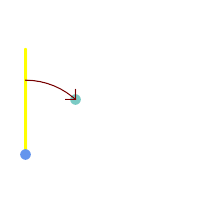 Bleu : origine Point(25,45) ; Vert : cible Point(75, 100) ; Jaune : axe Y ou Nord ; Rouge : angle d'azimut.
| 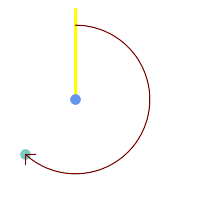 Bleu : origine Point(75, 100) ; Vert : cible Point(25, 45) ; Jaune : axe Y ou Nord ; Rouge : angle d'azimut.
|
Voir aussi
ST_Angle, ST_Point, ST_Translate, ST_Project, PostgreSQL Math Functions
Name
ST_Angle — Renvoie l'angle entre deux vecteurs définis par 3 ou 4 points, ou 2 lignes.
Synopsis
float ST_Angle(geometry point1, geometry point2, geometry point3, geometry point4);
float ST_Angle(geometry line1, geometry line2);
Description
Calcule l'angle dans le sens des aiguilles d'une montre entre deux vecteurs.
Variante 1: calcule l'angle formé par les points P1-P2-P3. Si un quatrième point est fourni, elle calcule l'angle formé par les points P1-P2 et P3-P4
Variante 2: calcule l'angle entre deux vecteurs S1-E1 et S2-E2, définis par les points de départ et d'arrivée des lignes d'entrée
Le résultat est un angle positif compris entre 0 et 2π radians. Le résultat en radians peut être converti en degrés à l'aide de la fonction PostgreSQL degrees().
Notez que ST_Angle(P1,P2,P3) = ST_Angle(P2,P1,P2,P3).
Disponibilité : 2.5.0
Exemples
Angle entre trois points
SELECT degrees( ST_Angle('POINT(0 0)', 'POINT(10 10)', 'POINT(20 0)') );
degrees
---------
270
Angle entre les vecteurs définis par quatre points
SELECT degrees( ST_Angle('POINT (10 10)', 'POINT (0 0)', 'POINT(90 90)', 'POINT (100 80)') );
degrees
-------------------
269.9999999999999
Angle entre les vecteurs définis par les points de départ et d'arrivée des lignes
SELECT degrees( ST_Angle('LINESTRING(0 0, 0.3 0.7, 1 1)', 'LINESTRING(0 0, 0.2 0.5, 1 0)') );
degrees
--------------
45
Voir aussi
Name
ST_ClosestPoint — Renvoie le point 2D sur g1 qui est le plus proche de g2. Il s'agit du premier point de la ligne la plus courte d'une géométrie à l'autre.
Synopsis
geometry ST_ClosestPoint(geometry geom1, geometry geom2);
geography ST_ClosestPoint(geography geom1, geography geom2, boolean use_spheroid = true);
Description
Renvoie le point bidimensionnel sur geom1 qui est le plus proche de geom2. Il s'agit du premier point de la ligne la plus courte entre les géométries (telle que calculée par ST_ShortestLine).
![[Note]](images/note.png) | |
Si vous avez une géométrie 3D, vous préférerez peut-être utiliser ST_3DClosestPoint. |
Amélioré : 3.4.0 - Prise en charge de la geography.
Disponibilité : 1.5.0
Exemples
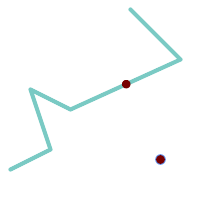
Le point le plus proche d'un point et d'une LineString est le point lui-même. Le point le plus proche d'une LineString et d'un Point est un point de la ligne.
SELECT ST_AsText( ST_ClosestPoint(pt,line)) AS cp_pt_line,
ST_AsText( ST_ClosestPoint(line,pt)) AS cp_line_pt
FROM (SELECT 'POINT (160 40)'::geometry AS pt,
'LINESTRING (10 30, 50 50, 30 110, 70 90, 180 140, 130 190)'::geometry AS line ) AS t;
cp_pt_line | cp_line_pt
----------------+------------------------------------------
POINT(160 40) | POINT(125.75342465753425 115.34246575342466)
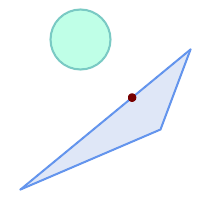
Le point du polygone A le plus proche du polygone B
SELECT ST_AsText( ST_ClosestPoint(
'POLYGON ((190 150, 20 10, 160 70, 190 150))',
ST_Buffer('POINT(80 160)', 30) )) As ptwkt;
------------------------------------------
POINT(131.59149149528952 101.89887534906197)
Voir aussi
ST_3DClosestPoint, ST_Distance, ST_LongestLine, ST_ShortestLine, ST_MaxDistance
Name
ST_3DClosestPoint — Renvoie le point 3D sur g1 qui est le plus proche de g2. Il s'agit du premier point de la ligne 3D la plus courte.
Synopsis
geometry ST_3DClosestPoint(geometry g1, geometry g2);
Description
Renvoie le point tridimensionnel de g1 le plus proche de g2. Il s'agit du premier point de la ligne 3D la plus courte. La longueur 3D de la ligne 3D la plus courte est la distance 3D.
 Cette fonction prend en charge la 3D et ne supprime pas l'indice z.
Cette fonction prend en charge la 3D et ne supprime pas l'indice z.
 Cette fonction prend en charge les surfaces Polyhedral.
Cette fonction prend en charge les surfaces Polyhedral.
Disponibilité : 2.0.0
Modifié : 2.2.0 - si 2 géométries 2D sont saisies, un point 2D est renvoyé (au lieu de l'ancien comportement supposant 0 pour Z manquant). Dans le cas de 2D et 3D, Z n'est plus supposé être 0 pour Z manquant.
Exemples
ligne et point -- point le plus proche en 3d et 2d SELECT ST_AsEWKT(ST_3DClosestPoint(line,pt)) AS cp3d_line_pt,
ST_AsEWKT(ST_ClosestPoint(line,pt)) As cp2d_line_pt
FROM (SELECT 'POINT(100 100 30)'::geometry As pt,
'LINESTRING (20 80 20, 98 190 1, 110 180 3, 50 75 1000)'::geometry As line
) As foo;
cp3d_line_pt | cp2d_line_pt
-----------------------------------------------------------+------------------------------------------
POINT(54.6993798867619 128.935022917228 11.5475869506606) | POINT(73.0769230769231 115.384615384615)
|
ligne et multipoint - point le plus proche en 3d et en 2d SELECT ST_AsEWKT(ST_3DClosestPoint(line,pt)) AS cp3d_line_pt,
ST_AsEWKT(ST_ClosestPoint(line,pt)) As cp2d_line_pt
FROM (SELECT 'MULTIPOINT(100 100 30, 50 74 1000)'::geometry As pt,
'LINESTRING (20 80 20, 98 190 1, 110 180 3, 50 75 900)'::geometry As line
) As foo;
cp3d_line_pt | cp2d_line_pt
-----------------------------------------------------------+--------------
POINT(54.6993798867619 128.935022917228 11.5475869506606) | POINT(50 75)
|
Multilignes et polygones en 3d et 2d point le plus proche SELECT ST_AsEWKT(ST_3DClosestPoint(poly, mline)) As cp3d,
ST_AsEWKT(ST_ClosestPoint(poly, mline)) As cp2d
FROM (SELECT ST_GeomFromEWKT('POLYGON((175 150 5, 20 40 5, 35 45 5, 50 60 5, 100 100 5, 175 150 5))') As poly,
ST_GeomFromEWKT('MULTILINESTRING((175 155 2, 20 40 20, 50 60 -2, 125 100 1, 175 155 1),
(1 10 2, 5 20 1))') As mline ) As foo;
cp3d | cp2d
-------------------------------------------+--------------
POINT(39.993580415989 54.1889925532825 5) | POINT(20 40)
|
Voir aussi
ST_AsEWKT, ST_ClosestPoint, ST_3DDistance, ST_3DShortestLine
Name
ST_Distance — Renvoie la distance entre deux valeurs de geometry ou geography.
Synopsis
float ST_Distance(geometry g1, geometry g2);
float ST_Distance(geography geog1, geography geog2, boolean use_spheroid = true);
Description
Pour les types geometry, renvoie la distance cartésienne (planaire) minimale en 2D entre deux géométries, en unités projetées (unités de référence spatiales).
Pour les types geography, la valeur par défaut est la distance géodésique minimale entre deux géographies en mètres, calculée sur le sphéroïde déterminé par le SRID. Si use_spheroid est faux, un calcul sphérique plus rapide est utilisé.
 Cette méthode implémente la spécification OGC Simple Features Implementation Specification for SQL 1.1.
Cette méthode implémente la spécification OGC Simple Features Implementation Specification for SQL 1.1.
 Cette méthode implémente la spécification SQL/MM. SQL-MM 3: 5.1.23
Cette méthode implémente la spécification SQL/MM. SQL-MM 3: 5.1.23
 Cette méthode prend en charge les types Circular String et Curve.
Cette méthode prend en charge les types Circular String et Curve.
Disponibilité : 1.5.0 La prise en charge du type geography a été introduite dans la version 1.5. Amélioration de la vitesse pour les géométries planaires afin de mieux gérer les géométries de grande taille ou à nombreux sommets
Amélioration : la version 2.1.0 a amélioré la vitesse pour le type geography. Voir Making Geography faster pour plus de détails.
Amélioration : 2.1.0 - la prise en charge des géométries courbes a été introduite.
Amélioration : 2.2.0 - mesure sur sphéroïde effectuée avec GeographicLib pour une meilleure précision et robustesse. Nécessite PROJ >= 4.9.0 pour profiter de la nouvelle fonctionnalité.
Modifié : 3.0.0 - ne dépend plus de SFCGAL.
Exemples de géométrie
Exemple de géométrie - unités en degrés planaires 4326 est le long lat WGS 84, les unités sont des degrés.
SELECT ST_Distance(
'SRID=4326;POINT(-72.1235 42.3521)'::geometry,
'SRID=4326;LINESTRING(-72.1260 42.45, -72.123 42.1546)'::geometry );
-----------------
0.00150567726382282Exemple de géométrie - unités en mètres (SRID : 3857, proportionnel aux pixels sur les cartes web populaires). Bien que la valeur soit erronée, les valeurs proches peuvent être comparées correctement, ce qui en fait un bon choix pour des algorithmes tels que KNN ou KMeans.
SELECT ST_Distance(
ST_Transform('SRID=4326;POINT(-72.1235 42.3521)'::geometry, 3857),
ST_Transform('SRID=4326;LINESTRING(-72.1260 42.45, -72.123 42.1546)'::geometry, 3857) );
-----------------
167.441410065196Exemple de géométrie - unités en mètres (SRID : 3857 comme ci-dessus, mais corrigé par cos(lat) pour tenir compte de la distorsion)
SELECT ST_Distance(
ST_Transform('SRID=4326;POINT(-72.1235 42.3521)'::geometry, 3857),
ST_Transform('SRID=4326;LINESTRING(-72.1260 42.45, -72.123 42.1546)'::geometry, 3857)
) * cosd(42.3521);
-----------------
123.742351254151Exemple de géométrie - unités en mètres (SRID : 26986 Massachusetts state plane meters) (plus précis pour le Massachusetts)
SELECT ST_Distance(
ST_Transform('SRID=4326;POINT(-72.1235 42.3521)'::geometry, 26986),
ST_Transform('SRID=4326;LINESTRING(-72.1260 42.45, -72.123 42.1546)'::geometry, 26986) );
-----------------
123.797937878454Exemple de géométrie - unités en mètres (SRID : 2163 US National Atlas Equal area) (moins précis)
SELECT ST_Distance(
ST_Transform('SRID=4326;POINT(-72.1235 42.3521)'::geometry, 2163),
ST_Transform('SRID=4326;LINESTRING(-72.1260 42.45, -72.123 42.1546)'::geometry, 2163) );
------------------
126.664256056812Exemples géographiques
Identique à l'exemple du type geometry, mais avec des unités en mètres - utiliser la sphère pour un calcul légèrement plus rapide et moins précis.
SELECT ST_Distance(gg1, gg2) As spheroid_dist, ST_Distance(gg1, gg2, false) As sphere_dist
FROM (SELECT
'SRID=4326;POINT(-72.1235 42.3521)'::geography as gg1,
'SRID=4326;LINESTRING(-72.1260 42.45, -72.123 42.1546)'::geography as gg2
) As foo ;
spheroid_dist | sphere_dist
------------------+------------------
123.802076746848 | 123.475736916397Name
ST_3DDistance — Renvoie la distance cartésienne minimale en 3D (basée sur la référence spatiale) entre deux géométries en unités projetées.
Synopsis
float ST_3DDistance(geometry g1, geometry g2);
Description
Renvoie la distance cartésienne minimale tridimensionnelle entre deux géométries en unités projetées (unités de référence spatiales).
 Cette fonction prend en charge la 3D et ne supprime pas l'indice z.
Cette fonction prend en charge la 3D et ne supprime pas l'indice z.
 Cette fonction prend en charge les surfaces Polyhedral.
Cette fonction prend en charge les surfaces Polyhedral.
 Cette méthode implémente la spécification SQL/MM. SQL-MM ISO/IEC 13249-3
Cette méthode implémente la spécification SQL/MM. SQL-MM ISO/IEC 13249-3
Disponibilité : 2.0.0
Modifié : 2.2.0 - Dans le cas de la 2D et de la 3D, Z n'est plus considéré comme égal à 0 en cas de Z manquant.
Modifié : 3.0.0 - Version SFCGAL supprimée
Exemples
-- Geometry example - units in meters (SRID: 2163 US National Atlas Equal area) (3D point and line compared 2D point and line)
-- Note: currently no vertical datum support so Z is not transformed and assumed to be same units as final.
SELECT ST_3DDistance(
ST_Transform('SRID=4326;POINT(-72.1235 42.3521 4)'::geometry,2163),
ST_Transform('SRID=4326;LINESTRING(-72.1260 42.45 15, -72.123 42.1546 20)'::geometry,2163)
) As dist_3d,
ST_Distance(
ST_Transform('SRID=4326;POINT(-72.1235 42.3521)'::geometry,2163),
ST_Transform('SRID=4326;LINESTRING(-72.1260 42.45, -72.123 42.1546)'::geometry,2163)
) As dist_2d;
dist_3d | dist_2d
------------------+-----------------
127.295059324629 | 126.66425605671
-- Multilinestring and polygon both 3d and 2d distance
-- Same example as 3D closest point example
SELECT ST_3DDistance(poly, mline) As dist3d,
ST_Distance(poly, mline) As dist2d
FROM (SELECT 'POLYGON((175 150 5, 20 40 5, 35 45 5, 50 60 5, 100 100 5, 175 150 5))'::geometry as poly,
'MULTILINESTRING((175 155 2, 20 40 20, 50 60 -2, 125 100 1, 175 155 1), (1 10 2, 5 20 1))'::geometry as mline) as foo;
dist3d | dist2d
-------------------+--------
0.716635696066337 | 0
Name
ST_DistanceSphere — Renvoie la distance minimale en mètres entre deux géométries lon/lat en utilisant un modèle de terre sphérique.
Synopsis
float ST_DistanceSphere(geometry geomlonlatA, geometry geomlonlatB, float8 radius=6371008);
Description
Renvoie la distance minimale en mètres entre deux points lon/lat. Utilise une terre sphérique et un rayon dérivé du sphéroïde défini par le SRID. Plus rapide que ST_DistanceSpheroid, mais moins précis. PostGIS Versions antérieures à la version 1.5 uniquement pour les points.
Disponibilité : 1.5 - la prise en charge d'autres types de géométrie que les points a été introduite. Les versions précédentes ne fonctionnaient qu'avec des points.
Modifié : 2.2.0 Dans les versions antérieures, cette fonction s'appelait ST_Distance_Sphere
Exemples
SELECT round(CAST(ST_DistanceSphere(ST_Centroid(geom), ST_GeomFromText('POINT(-118 38)',4326)) As numeric),2) As dist_meters,
round(CAST(ST_Distance(ST_Transform(ST_Centroid(geom),32611),
ST_Transform(ST_GeomFromText('POINT(-118 38)', 4326),32611)) As numeric),2) As dist_utm11_meters,
round(CAST(ST_Distance(ST_Centroid(geom), ST_GeomFromText('POINT(-118 38)', 4326)) As numeric),5) As dist_degrees,
round(CAST(ST_Distance(ST_Transform(geom,32611),
ST_Transform(ST_GeomFromText('POINT(-118 38)', 4326),32611)) As numeric),2) As min_dist_line_point_meters
FROM
(SELECT ST_GeomFromText('LINESTRING(-118.584 38.374,-118.583 38.5)', 4326) As geom) as foo;
dist_meters | dist_utm11_meters | dist_degrees | min_dist_line_point_meters
-------------+-------------------+--------------+----------------------------
70424.47 | 70438.00 | 0.72900 | 65871.18
Voir aussi
Name
ST_DistanceSpheroid — Renvoie la distance minimale entre deux géométries lon/lat en utilisant un modèle de terre sphéroïdale.
Synopsis
float ST_DistanceSpheroid(geometry geomlonlatA, geometry geomlonlatB, spheroid measurement_spheroid=WGS84);
Description
Renvoie la distance minimale en mètres entre deux géométries lon/lat pour un sphéroïde donné. Voir l'explication des sphéroïdes donnée pour ST_LengthSpheroid.
![[Note]](images/note.png) | |
Cette fonction ne prend pas en compte le SRID de la géométrie. Elle suppose que les coordonnées de la géométrie sont basées sur le sphéroïde fourni. |
Disponibilité : 1.5 - la prise en charge d'autres types de géométrie que les points a été introduite. Les versions précédentes ne fonctionnaient qu'avec des points.
Modifié : 2.2.0 Dans les versions précédentes, cette fonction était appelée ST_Distance_Sphéroïde
Exemples
SELECT round(CAST(
ST_DistanceSpheroid(ST_Centroid(geom), ST_GeomFromText('POINT(-118 38)',4326), 'SPHEROID["WGS 84",6378137,298.257223563]')
As numeric),2) As dist_meters_spheroid,
round(CAST(ST_DistanceSphere(ST_Centroid(geom), ST_GeomFromText('POINT(-118 38)',4326)) As numeric),2) As dist_meters_sphere,
round(CAST(ST_Distance(ST_Transform(ST_Centroid(geom),32611),
ST_Transform(ST_GeomFromText('POINT(-118 38)', 4326),32611)) As numeric),2) As dist_utm11_meters
FROM
(SELECT ST_GeomFromText('LINESTRING(-118.584 38.374,-118.583 38.5)', 4326) As geom) as foo;
dist_meters_spheroid | dist_meters_sphere | dist_utm11_meters
----------------------+--------------------+-------------------
70454.92 | 70424.47 | 70438.00
Voir aussi
Name
ST_FrechetDistance — Renvoie la distance de Fréchet entre deux géométries.
Synopsis
float ST_FrechetDistance(geometry g1, geometry g2, float densifyFrac = -1);
Description
Implémente l'algorithme de calcul de la distance de Fréchet limitée aux points discrets pour les deux géométries, basé sur Computing Discrete Fréchet Distance. La distance de Fréchet est une mesure de similarité entre les courbes qui tient compte de l'emplacement et de l'ordre des points le long des courbes. Elle est donc souvent meilleure que la distance de Hausdorff.
Lorsque le paramètre optionnel densifyFrac est spécifié, cette fonction effectue une densification des segments avant de calculer la distance de Fréchet discrète. Le paramètre densifyFrac définit la fraction par laquelle chaque segment doit être densifié. Chaque segment sera divisé en un certain nombre de sous-segments de longueur égale, dont la fraction de la longueur totale est la plus proche de la fraction donnée.
Les unités sont celles du système de référence spatiale des géométries.
![[Note]](images/note.png) | |
L'implémentation actuelle ne prend en charge que les sommets en tant qu'emplacements discrets. Elle pourrait être étendue pour permettre l'utilisation d'une densité arbitraire de points. |
![[Note]](images/note.png) | |
Plus la valeur de densifyFrac spécifiée est petite, plus la distance de Fréchet est précise. Mais le temps de calcul et l'utilisation de la mémoire augmentent avec le carré du nombre de sous-segments. |
Effectué par le module GEOS.
Disponibilité : 2.4.0 - nécessite GEOS >= 3.7.0
Exemples
postgres=# SELECT st_frechetdistance('LINESTRING (0 0, 100 0)'::geometry, 'LINESTRING (0 0, 50 50, 100 0)'::geometry);
st_frechetdistance
--------------------
70.7106781186548
(1 row)
SELECT st_frechetdistance('LINESTRING (0 0, 100 0)'::geometry, 'LINESTRING (0 0, 50 50, 100 0)'::geometry, 0.5);
st_frechetdistance
--------------------
50
(1 row)
Voir aussi
Name
ST_HausdorffDistance — Renvoie la distance de Hausdorff entre deux géométries.
Synopsis
float ST_HausdorffDistance(geometry g1, geometry g2);
float ST_HausdorffDistance(geometry g1, geometry g2, float densifyFrac);
Description
Renvoie la distance de Hausdorff entre deux géométries. La distance de Hausdorff est une mesure de la similarité ou de la dissemblance de deux géométries.
La fonction calcule en fait la "Discrete Hausdorff Distance". Il s'agit de la distance de Hausdorff calculée en des points discrets des géométries. Le paramètre densifyFrac peut être spécifié pour fournir une réponse plus précise en densifiant les segments avant de calculer la distance discrète de Hausdorff. Chaque segment est divisé en un certain nombre de sous-segments de longueur égale dont la fraction de la longueur du segment est la plus proche de la fraction donnée.
Les unités sont celles du système de référence spatiale des géométries.
![[Note]](images/note.png) | |
Cet algorithme n'est PAS équivalent à la distance standard de Hausdorff. Cependant, il calcule une approximation qui est correcte pour un large sous-ensemble de cas utiles. Un cas important est celui des lignes qui sont à peu près parallèles les unes aux autres et dont la longueur est à peu près égale. Il s'agit d'une métrique utile pour l'appariement des lignes. |
Disponibilité : 1.5.0
Exemples
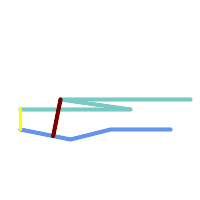
Distance de Hausdorff (rouge) et distance (jaune) entre deux lignes
SELECT ST_HausdorffDistance(geomA, geomB),
ST_Distance(geomA, geomB)
FROM (SELECT 'LINESTRING (20 70, 70 60, 110 70, 170 70)'::geometry AS geomA,
'LINESTRING (20 90, 130 90, 60 100, 190 100)'::geometry AS geomB) AS t;
st_hausdorffdistance | st_distance
----------------------+-------------
37.26206567625497 | 20
Exemple: Distance de Hausdorff avec densification.
SELECT ST_HausdorffDistance(
'LINESTRING (130 0, 0 0, 0 150)'::geometry,
'LINESTRING (10 10, 10 150, 130 10)'::geometry,
0.5);
----------------------
70
Exemple: Pour chaque bâtiment, trouvez la parcelle qui le représente le mieux. Tout d'abord, nous exigeons que la parcelle intersecte la géométrie du bâtiment. DISTINCT ON garantit que chaque bâtiment ne sera listé qu'une seule fois. ORDER BY .. ST_HausdorffDistance sélectionne la parcelle qui est la plus similaire au bâtiment.
SELECT DISTINCT ON (buildings.gid) buildings.gid, parcels.parcel_id
FROM buildings
INNER JOIN parcels
ON ST_Intersects(buildings.geom, parcels.geom)
ORDER BY buildings.gid, ST_HausdorffDistance(buildings.geom, parcels.geom);
Voir aussi
Name
ST_Length — Renvoie la longueur 2D d'une géométrie linéaire.
Synopsis
float ST_Length(geometry a_2dlinestring);
float ST_Length(geography geog, boolean use_spheroid = true);
Description
Pour les types geometry : renvoie la longueur cartésienne 2D de la géométrie s'il s'agit d'une LineString, MultiLineString, ST_Curve, ST_MultiCurve. Pour les géométries aréolaires, 0 est renvoyé ; utilisez ST_Perimeter à la place. Les unités de longueur sont déterminées par le système de référence spatial de la géométrie.
For geography types: computation is performed using the inverse geodesic calculation. Units of length are in meters. The spheroid is specified by the SRID; when no SRID is provided, WGS84 is used. If use_spheroid = false, then the calculation is based on a sphere instead of a spheroid.
Actuellement, pour la géométrie, il s'agit d'un alias de ST_Length2D, mais cela pourrait changer pour prendre en charge des dimensions plus élevées.
![[Warning]](images/warning.png) | |
Modifié : 2.0.0 Rupture -- dans les versions précédentes, appliquer ceci à un MULTI/POLYGONE de type geography donnait le périmètre du POLYGONE/MULTIPOLYGONE. Dans la version 2.0.0, cette fonction a été modifiée pour retourner 0 afin d'être en ligne avec le comportement de la géométrie. Veuillez utiliser ST_Perimeter si vous souhaitez obtenir le périmètre d'un polygone |
![[Note]](images/note.png) | |
Pour geography, le calcul utilise par défaut un modèle sphéroïdal. Pour utiliser le calcul sphérique, plus rapide mais moins précis, utilisez ST_Length(gg,false) ; |
 Cette méthode implémente la spécification OGC Simple Features Implementation Specification for SQL 1.1. s2.1.5.1
Cette méthode implémente la spécification OGC Simple Features Implementation Specification for SQL 1.1. s2.1.5.1
 Cette méthode implémente la spécification SQL/MM. SQL-MM 3: 7.1.2, 9.3.4
Cette méthode implémente la spécification SQL/MM. SQL-MM 3: 7.1.2, 9.3.4
Disponibilité : 1.5.0 La prise en charge du type geography a été introduite dans la version 1.5.
Exemples de géométrie
Renvoie la longueur en pieds de la ligne. Notez que cette longueur est exprimée en pieds car EPSG:2249 correspond aux pieds du plan de l'État du Massachusetts
SELECT ST_Length(ST_GeomFromText('LINESTRING(743238 2967416,743238 2967450,743265 2967450,
743265.625 2967416,743238 2967416)',2249));
st_length
---------
122.630744000095
--Transforming WGS 84 LineString to Massachusetts state plane meters
SELECT ST_Length(
ST_Transform(
ST_GeomFromEWKT('SRID=4326;LINESTRING(-72.1260 42.45, -72.1240 42.45666, -72.123 42.1546)'),
26986
)
);
st_length
---------
34309.4563576191
Exemples géographiques
Retourne la longueur d'une ligne de type geography avec le SRID WGS 84
-- the default calculation uses a spheroid
SELECT ST_Length(the_geog) As length_spheroid, ST_Length(the_geog,false) As length_sphere
FROM (SELECT ST_GeographyFromText(
'SRID=4326;LINESTRING(-72.1260 42.45, -72.1240 42.45666, -72.123 42.1546)') As the_geog)
As foo;
length_spheroid | length_sphere
------------------+------------------
34310.5703627288 | 34346.2060960742
Name
ST_Length2D — Renvoie la longueur 2D d'une géométrie linéaire. Alias de ST_Length
Synopsis
float ST_Length2D(geometry a_2dlinestring);
Description
Renvoie la longueur 2D de la géométrie s'il s'agit d'une ligne ou d'une multiligne. C'est un alias de ST_Length
Voir aussi
Name
ST_3DLength — Renvoie la longueur 3D d'une géométrie linéaire.
Synopsis
float ST_3DLength(geometry a_3dlinestring);
Description
Renvoie la longueur tridimensionnelle ou bidimensionnelle de la géométrie s'il s'agit d'une LineString ou d'une MultiLineString. Pour les lignes à 2 dimensions, la longueur à 2 dimensions est renvoyée (comme ST_Length et ST_Length2D)
 Cette fonction prend en charge la 3D et ne supprime pas l'indice z.
Cette fonction prend en charge la 3D et ne supprime pas l'indice z.
 Cette méthode implémente la spécification SQL/MM. SQL-MM IEC 13249-3: 7.1, 10.3
Cette méthode implémente la spécification SQL/MM. SQL-MM IEC 13249-3: 7.1, 10.3
Modifié : 2.0.0 Dans les versions précédentes, cette fonction était appelée ST_Length3D
Exemples
Longueur de retour en pieds pour un câble 3D. Notez que cette longueur est exprimée en pieds car EPSG:2249 correspond aux pieds du plan de l'État du Massachusetts
SELECT ST_3DLength(ST_GeomFromText('LINESTRING(743238 2967416 1,743238 2967450 1,743265 2967450 3,
743265.625 2967416 3,743238 2967416 3)',2249));
ST_3DLength
-----------
122.704716741457
Voir aussi
Name
ST_LengthSpheroid — Renvoie la longueur/périmètre 2D ou 3D d'une géométrie lon/lat sur un sphéroïde.
Synopsis
float ST_LengthSpheroid(geometry a_geometry, spheroid a_spheroid);
Description
Calcule la longueur ou le périmètre d'une géométrie sur un ellipsoïde. Ceci est utile si les coordonnées de la géométrie sont en longitude/latitude et qu'une longueur est souhaitée sans reprojection. Le sphéroïde est spécifié par une valeur textuelle comme suit :
SPHEROID[<NAME
>,<SEMI-MAJOR AXIS
>,<INVERSE FLATTENING
>]
Par exemple :
SPHEROID["GRS_1980",6378137,298.257222101]
Disponibilité : 1.2.2
Modifié : 2.2.0 Dans les versions précédentes, cette fonction s'appelait ST_Length_Spheroid et avait l'alias ST_3DLength_Spheroid
 Cette fonction prend en charge la 3D et ne supprime pas l'indice z.
Cette fonction prend en charge la 3D et ne supprime pas l'indice z.
Exemples
SELECT ST_LengthSpheroid( geometry_column,
'SPHEROID["GRS_1980",6378137,298.257222101]' )
FROM geometry_table;
SELECT ST_LengthSpheroid( geom, sph_m ) As tot_len,
ST_LengthSpheroid(ST_GeometryN(geom,1), sph_m) As len_line1,
ST_LengthSpheroid(ST_GeometryN(geom,2), sph_m) As len_line2
FROM (SELECT ST_GeomFromText('MULTILINESTRING((-118.584 38.374,-118.583 38.5),
(-71.05957 42.3589 , -71.061 43))') As geom,
CAST('SPHEROID["GRS_1980",6378137,298.257222101]' As spheroid) As sph_m) as foo;
tot_len | len_line1 | len_line2
------------------+------------------+------------------
85204.5207562955 | 13986.8725229309 | 71217.6482333646
--3D
SELECT ST_LengthSpheroid( geom, sph_m ) As tot_len,
ST_LengthSpheroid(ST_GeometryN(geom,1), sph_m) As len_line1,
ST_LengthSpheroid(ST_GeometryN(geom,2), sph_m) As len_line2
FROM (SELECT ST_GeomFromEWKT('MULTILINESTRING((-118.584 38.374 20,-118.583 38.5 30),
(-71.05957 42.3589 75, -71.061 43 90))') As geom,
CAST('SPHEROID["GRS_1980",6378137,298.257222101]' As spheroid) As sph_m) as foo;
tot_len | len_line1 | len_line2
------------------+-----------------+------------------
85204.5259107402 | 13986.876097711 | 71217.6498130292
Voir aussi
Name
ST_LongestLine — Renvoie la ligne 2D la plus longue entre deux géométries.
Synopsis
geometry ST_LongestLine(geometry g1, geometry g2);
Description
Renvoie la plus longue ligne bidimensionnelle entre les points de deux géométries. La ligne renvoyée commence sur g1 et se termine sur g2.
La ligne la plus longue se trouve toujours entre deux sommets. La fonction renvoie la première ligne la plus longue si plusieurs sont trouvées. La longueur de la ligne est égale à la distance renvoyée par ST_MaxDistance.
Si g1 et g2 sont la même géométrie, renvoie la ligne entre les deux sommets les plus éloignés l'un de l'autre dans la géométrie. Les extrémités de la ligne se trouvent sur le cercle calculé par ST_MinimumBoundingCircle.
Disponibilité : 1.5.0
Exemples
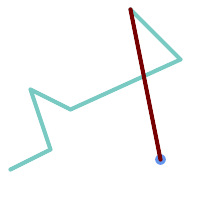
Ligne la plus longue entre un point et une ligne
SELECT ST_AsText( ST_LongestLine(
'POINT (160 40)',
'LINESTRING (10 30, 50 50, 30 110, 70 90, 180 140, 130 190)' )
) AS lline;
-----------------
LINESTRING(160 40,130 190)
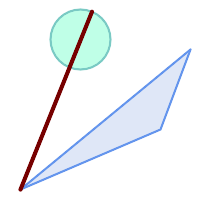
Ligne la plus longue entre deux polygones
SELECT ST_AsText( ST_LongestLine(
'POLYGON ((190 150, 20 10, 160 70, 190 150))',
ST_Buffer('POINT(80 160)', 30)
) ) AS llinewkt;
-----------------
LINESTRING(20 10,105.3073372946034 186.95518130045156)

Ligne la plus longue traversant une seule géométrie. La longueur de la ligne est égale à la distance maximale. Les extrémités de la ligne sont situées sur le cercle de délimitation minimal.
SELECT ST_AsText( ST_LongestLine( geom, geom)) AS llinewkt,
ST_MaxDistance( geom, geom) AS max_dist,
ST_Length( ST_LongestLine(geom, geom)) AS lenll
FROM (SELECT 'POLYGON ((40 180, 110 160, 180 180, 180 120, 140 90, 160 40, 80 10, 70 40, 20 50, 40 180),
(60 140, 99 77.5, 90 140, 60 140))'::geometry AS geom) AS t;
llinewkt | max_dist | lenll
---------------------------+--------------------+--------------------
LINESTRING(20 50,180 180) | 206.15528128088303 | 206.15528128088303
Name
ST_3DLongestLine — Renvoie la ligne 3D la plus longue entre deux géométries
Synopsis
geometry ST_3DLongestLine(geometry g1, geometry g2);
Description
Renvoie la ligne tridimensionnelle la plus longue entre deux géométries. La fonction renvoie la première ligne la plus longue s'il y en a plusieurs. La ligne retournée commence en g1 et se termine en g2. La longueur 3D de la ligne est égale à la distance renvoyée par ST_3DMaxDistance.
Disponibilité : 2.0.0
Modifié : 2.2.0 - si 2 géométries 2D sont saisies, un point 2D est renvoyé (au lieu de l'ancien comportement supposant 0 pour Z manquant). Dans le cas de 2D et 3D, Z n'est plus supposé être 0 pour Z manquant.
 Cette fonction prend en charge la 3D et ne supprime pas l'indice z.
Cette fonction prend en charge la 3D et ne supprime pas l'indice z.
 Cette fonction prend en charge les surfaces Polyhedral.
Cette fonction prend en charge les surfaces Polyhedral.
Exemples
linestring et point -- ligne la plus longue 3d et 2d SELECT ST_AsEWKT(ST_3DLongestLine(line,pt)) AS lol3d_line_pt,
ST_AsEWKT(ST_LongestLine(line,pt)) As lol2d_line_pt
FROM (SELECT 'POINT(100 100 30)'::geometry As pt,
'LINESTRING (20 80 20, 98 190 1, 110 180 3, 50 75 1000)'::geometry As line
) As foo;
lol3d_line_pt | lol2d_line_pt
-----------------------------------+----------------------------
LINESTRING(50 75 1000,100 100 30) | LINESTRING(98 190,100 100)
|
ligne et multipoint - ligne la plus longue en 3d et 2d SELECT ST_AsEWKT(ST_3DLongestLine(line,pt)) AS lol3d_line_pt,
ST_AsEWKT(ST_LongestLine(line,pt)) As lol2d_line_pt
FROM (SELECT 'MULTIPOINT(100 100 30, 50 74 1000)'::geometry As pt,
'LINESTRING (20 80 20, 98 190 1, 110 180 3, 50 75 900)'::geometry As line
) As foo;
lol3d_line_pt | lol2d_line_pt
---------------------------------+--------------------------
LINESTRING(98 190 1,50 74 1000) | LINESTRING(98 190,50 74)
|
MultiLineString et Polygon ligne la plus longue 3d et 2d SELECT ST_AsEWKT(ST_3DLongestLine(poly, mline)) As lol3d,
ST_AsEWKT(ST_LongestLine(poly, mline)) As lol2d
FROM (SELECT ST_GeomFromEWKT('POLYGON((175 150 5, 20 40 5, 35 45 5, 50 60 5, 100 100 5, 175 150 5))') As poly,
ST_GeomFromEWKT('MULTILINESTRING((175 155 2, 20 40 20, 50 60 -2, 125 100 1, 175 155 1),
(1 10 2, 5 20 1))') As mline ) As foo;
lol3d | lol2d
------------------------------+--------------------------
LINESTRING(175 150 5,1 10 2) | LINESTRING(175 150,1 10)
|
Name
ST_MaxDistance — Renvoie la plus grande distance 2D entre deux géométries en unités projetées.
Synopsis
float ST_MaxDistance(geometry g1, geometry g2);
Description
Renvoie la distance maximale en 2D entre deux géométries, en unités projetées. La distance maximale se situe toujours entre deux sommets. C'est la longueur de la ligne renvoyée par ST_LongestLine.
Si g1 et g2 sont la même géométrie, renvoie la distance entre les deux sommets les plus éloignés dans cette géométrie.
Disponibilité : 1.5.0
Exemples
Distance maximale entre un point et des lignes.
SELECT ST_MaxDistance('POINT(0 0)'::geometry, 'LINESTRING ( 2 0, 0 2 )'::geometry);
-----------------
2
SELECT ST_MaxDistance('POINT(0 0)'::geometry, 'LINESTRING ( 2 2, 2 2 )'::geometry);
------------------
2.82842712474619
Distance maximale entre les sommets d'une même géométrie.
SELECT ST_MaxDistance('POLYGON ((10 10, 10 0, 0 0, 10 10))'::geometry,
'POLYGON ((10 10, 10 0, 0 0, 10 10))'::geometry);
------------------
14.142135623730951
Voir aussi
Name
ST_3DMaxDistance — Renvoie la distance maximale cartésienne 3D (basée sur la référence spatiale) entre deux géométries en unités projetées.
Synopsis
float ST_3DMaxDistance(geometry g1, geometry g2);
Description
Renvoie la distance cartésienne maximale tridimensionnelle entre deux géométries en unités projetées (unités de référence spatiales).
 Cette fonction prend en charge la 3D et ne supprime pas l'indice z.
Cette fonction prend en charge la 3D et ne supprime pas l'indice z.
 Cette fonction prend en charge les surfaces Polyhedral.
Cette fonction prend en charge les surfaces Polyhedral.
Disponibilité : 2.0.0
Modifié : 2.2.0 - Dans le cas de la 2D et de la 3D, Z n'est plus considéré comme égal à 0 en cas de Z manquant.
Exemples
-- Geometry example - units in meters (SRID: 2163 US National Atlas Equal area) (3D point and line compared 2D point and line)
-- Note: currently no vertical datum support so Z is not transformed and assumed to be same units as final.
SELECT ST_3DMaxDistance(
ST_Transform(ST_GeomFromEWKT('SRID=4326;POINT(-72.1235 42.3521 10000)'),2163),
ST_Transform(ST_GeomFromEWKT('SRID=4326;LINESTRING(-72.1260 42.45 15, -72.123 42.1546 20)'),2163)
) As dist_3d,
ST_MaxDistance(
ST_Transform(ST_GeomFromEWKT('SRID=4326;POINT(-72.1235 42.3521 10000)'),2163),
ST_Transform(ST_GeomFromEWKT('SRID=4326;LINESTRING(-72.1260 42.45 15, -72.123 42.1546 20)'),2163)
) As dist_2d;
dist_3d | dist_2d
------------------+------------------
24383.7467488441 | 22247.8472107251
Voir aussi
Name
ST_MinimumClearance — Renvoie la clearance (le dégagement) d'une géométrie, une mesure de la robustesse d'une géométrie.
Synopsis
float ST_MinimumClearance(geometry g);
Description
Il est possible qu'une géométrie réponde aux critères de validité selon ST_IsValid (polygones) ou ST_IsSimple (lignes), mais qu'elle devienne invalide si l'un de ses sommets est déplacé d'une petite distance. Cela peut se produire en raison d'une perte de précision lors de la conversion vers des formats texte (tels que WKT, KML, GML, GeoJSON) ou des formats binaires qui n'utilisent pas de coordonnées en virgule flottante à double précision (par exemple, MapInfo TAB).
La clearance (le dégagement) minimum est une mesure quantitative de la résistance d'une géométrie aux changements de précision des coordonnées. Il s'agit de la plus grande distance à laquelle les sommets de la géométrie peuvent être déplacés sans créer une géométrie invalide. Des valeurs plus élevées de l'espace libre minimum indiquent une plus grande robustesse.
Si une géométrie a un dégagement minimal de e, alors.. :
Aucun des deux sommets distincts de la géométrie n'est plus proche que la distance
e.Aucun sommet n'est plus proche que
ed'un segment de ligne dont il n'est pas l'extrémité.
S'il n'existe pas de dégagement minimum pour une géométrie (par exemple un point unique ou un MultiPoint dont les points sont identiques), la valeur de retour est Infinity.
Pour éviter les problèmes de validité causés par la perte de précision, ST_ReducePrecision peut réduire la précision des coordonnées tout en s'assurant que la géométrie polygonale reste valide.
Disponibilité : 2.3.0
Exemples
SELECT ST_MinimumClearance('POLYGON ((0 0, 1 0, 1 1, 0.5 3.2e-4, 0 0))');
st_minimumclearance
---------------------
0.00032
Voir aussi
ST_MinimumClearanceLine, ST_IsSimple, ST_IsValid, ST_ReducePrecision
Name
ST_MinimumClearanceLine — Renvoie la chaîne de lignes à deux points couvrant le dégagement (clearance) minimum d'une géométrie.
Synopsis
Geometry ST_MinimumClearanceLine(geometry g);
Description
Renvoie les 2 points d'une LineString couvrant le dégagement (clearance) minimum d'une géométrie. Si la géométrie n'a pas de dégagement (clearance) minimum, LINESTRING EMPTY est retourné.
Effectué par le module GEOS.
Disponibilité : 2.3.0 - nécessite GEOS >= 3.6.0
Exemples
SELECT ST_AsText(ST_MinimumClearanceLine('POLYGON ((0 0, 1 0, 1 1, 0.5 3.2e-4, 0 0))'));
-------------------------------
LINESTRING(0.5 0.00032,0.5 0)
Voir aussi
Name
ST_Perimeter — Renvoie la longueur de la limite d'une géométrie polygonale ou d'une géographie.
Synopsis
float ST_Perimeter(geometry g1);
float ST_Perimeter(geography geog, boolean use_spheroid = true);
Description
Renvoie le périmètre 2D d'une geometry/geography s'il s'agit d'une ST_Surface, ST_MultiSurface (Polygone, MultiPolygone). 0 est retourné pour les géométries non réelles. Pour les géométries linéaires, utiliser ST_Length. Pour les types geometry, les unités de mesure du périmètre sont spécifiées par le système de référence spatiale de la géométrie.
For geography types, the calculations are performed using the inverse geodesic problem, where perimeter units are in meters. The spheroid is specified by the SRID; when no SRID is provided, WGS84 is used. If use_spheroid = false, then calculations will approximate a sphere instead of a spheroid.
Il s'agit actuellement d'un alias de ST_Perimeter2D, mais cela pourrait changer pour prendre en charge des dimensions plus élevées.
 Cette méthode implémente la spécification OGC Simple Features Implementation Specification for SQL 1.1. s2.1.5.1
Cette méthode implémente la spécification OGC Simple Features Implementation Specification for SQL 1.1. s2.1.5.1
 Cette méthode implémente la spécification SQL/MM. SQL-MM 3: 8.1.3, 9.5.4
Cette méthode implémente la spécification SQL/MM. SQL-MM 3: 8.1.3, 9.5.4
Disponibilité 2.0.0 : La prise en charge du type geography a été introduite
Exemple : Géométrie
Retourne le périmètre en pieds pour les polygones et les multi-polygones. Notez que ce périmètre est en pieds car EPSG:2249 est le plan de l'État du Massachusetts en pieds
SELECT ST_Perimeter(ST_GeomFromText('POLYGON((743238 2967416,743238 2967450,743265 2967450,
743265.625 2967416,743238 2967416))', 2249));
st_perimeter
---------
122.630744000095
(1 row)
SELECT ST_Perimeter(ST_GeomFromText('MULTIPOLYGON(((763104.471273676 2949418.44119003,
763104.477769673 2949418.42538203,
763104.189609677 2949418.22343004,763104.471273676 2949418.44119003)),
((763104.471273676 2949418.44119003,763095.804579742 2949436.33850239,
763086.132105649 2949451.46730207,763078.452329651 2949462.11549407,
763075.354136904 2949466.17407812,763064.362142565 2949477.64291974,
763059.953961626 2949481.28983009,762994.637609571 2949532.04103014,
762990.568508415 2949535.06640477,762986.710889563 2949539.61421415,
763117.237897679 2949709.50493431,763235.236617789 2949617.95619822,
763287.718121842 2949562.20592617,763111.553321674 2949423.91664605,
763104.471273676 2949418.44119003)))', 2249));
st_perimeter
---------
845.227713366825
(1 row)
Exemples : Géographie
Renvoie le périmètre en mètres et en pieds pour les polygones et les multi-polygones. Notez qu'il s'agit de geography (WGS 84 long lat)
SELECT ST_Perimeter(geog) As per_meters, ST_Perimeter(geog)/0.3048 As per_ft
FROM ST_GeogFromText('POLYGON((-71.1776848522251 42.3902896512902,-71.1776843766326 42.3903829478009,
-71.1775844305465 42.3903826677917,-71.1775825927231 42.3902893647987,-71.1776848522251 42.3902896512902))') As geog;
per_meters | per_ft
-----------------+------------------
37.3790462565251 | 122.634666195949
-- MultiPolygon example --
SELECT ST_Perimeter(geog) As per_meters, ST_Perimeter(geog,false) As per_sphere_meters, ST_Perimeter(geog)/0.3048 As per_ft
FROM ST_GeogFromText('MULTIPOLYGON(((-71.1044543107478 42.340674480411,-71.1044542869917 42.3406744369506,
-71.1044553562977 42.340673886454,-71.1044543107478 42.340674480411)),
((-71.1044543107478 42.340674480411,-71.1044860600303 42.3407237015564,-71.1045215770124 42.3407653385914,
-71.1045498002983 42.3407946553165,-71.1045611902745 42.3408058316308,-71.1046016507427 42.340837442371,
-71.104617893173 42.3408475056957,-71.1048586153981 42.3409875993595,-71.1048736143677 42.3409959528211,
-71.1048878050242 42.3410084812078,-71.1044020965803 42.3414730072048,
-71.1039672113619 42.3412202916693,-71.1037740497748 42.3410666421308,
-71.1044280218456 42.3406894151355,-71.1044543107478 42.340674480411)))') As geog;
per_meters | per_sphere_meters | per_ft
------------------+-------------------+------------------
257.634283683311 | 257.412311446337 | 845.256836231335
Voir aussi
Name
ST_Perimeter2D — Renvoie le périmètre 2D d'une géométrie polygonale. Alias de ST_Perimeter.
Synopsis
float ST_Perimeter2D(geometry geomA);
Description
Renvoie le périmètre bidimensionnel d'une géométrie polygonale.
![[Note]](images/note.png) | |
Il s'agit actuellement d'un alias de ST_Perimeter. Dans les versions futures, ST_Perimeter pourrait renvoyer le périmètre de la dimension la plus élevée pour une géométrie. Cette possibilité est encore à l'étude |
Voir aussi
Name
ST_3DPerimeter — Renvoie le périmètre 3D d'une géométrie polygonale.
Synopsis
float ST_3DPerimeter(geometry geomA);
Description
Renvoie le périmètre tridimensionnel de la géométrie, s'il s'agit d'un polygone ou d'un multi-polygone. Si la géométrie est bidimensionnelle, le périmètre bidimensionnel est renvoyé.
 Cette fonction prend en charge la 3D et ne supprime pas l'indice z.
Cette fonction prend en charge la 3D et ne supprime pas l'indice z.
 Cette méthode implémente la spécification SQL/MM. SQL-MM ISO/IEC 13249-3: 8.1, 10.5
Cette méthode implémente la spécification SQL/MM. SQL-MM ISO/IEC 13249-3: 8.1, 10.5
Modifié : 2.0.0 Dans les versions antérieures, il s'appelait ST_Perimeter3D
Exemples
Périmètre d'un polygone légèrement surélevé en l'air dans l'état du Massachusetts, en pieds de plan
SELECT ST_3DPerimeter(geom), ST_Perimeter2d(geom), ST_Perimeter(geom) FROM
(SELECT ST_GeomFromEWKT('SRID=2249;POLYGON((743238 2967416 2,743238 2967450 1,
743265.625 2967416 1,743238 2967416 2))') As geom) As foo;
ST_3DPerimeter | st_perimeter2d | st_perimeter
------------------+------------------+------------------
105.465793597674 | 105.432997272188 | 105.432997272188
Voir aussi
Name
ST_ShortestLine — Renvoie la ligne 2D la plus courte entre deux géométries
Synopsis
geometry ST_ShortestLine(geometry geom1, geometry geom2);
geography ST_ShortestLine(geography geom1, geography geom2, boolean use_spheroid = true);
Description
Renvoie la ligne bidimensionnelle la plus courte entre deux géométries. La ligne renvoyée commence dans geom1 et se termine dans geom2. Si geom1 et geom2 se croisent, le résultat est une ligne dont le début et la fin se situent à un point d'intersection. La longueur de la ligne est la même que celle que ST_Distance renvoie pour g1 et g2.
Amélioré : 3.4.0 - Prise en charge de la geography.
Disponibilité : 1.5.0
Exemples
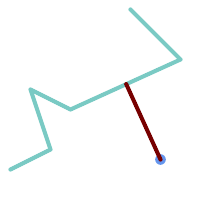
Ligne la plus courte entre un point et une ligne
SELECT ST_AsText( ST_ShortestLine(
'POINT (160 40)',
'LINESTRING (10 30, 50 50, 30 110, 70 90, 180 140, 130 190)')
) As sline;
---------------------------------------------------------
LINESTRING(160 40,125.75342465753425 115.34246575342466)

Ligne la plus courte entre les polygones
SELECT ST_AsText( ST_ShortestLine(
'POLYGON ((190 150, 20 10, 160 70, 190 150))',
ST_Buffer('POINT(80 160)', 30)
) ) AS llinewkt;
-----------------
LINESTRING(131.59149149528952 101.89887534906197,101.21320343559644 138.78679656440357)
Voir aussi
ST_ClosestPoint, ST_Distance, ST_LongestLine, ST_MaxDistance
Name
ST_3DShortestLine — Renvoie la ligne 3D la plus courte entre deux géométries
Synopsis
geometry ST_3DShortestLine(geometry g1, geometry g2);
Description
Renvoie la ligne tridimensionnelle la plus courte entre deux géométries. La fonction ne renvoie que la première ligne la plus courte, si la fonction en trouve plusieurs. Si g1 et g2 se croisent en un seul point, la fonction renvoie une ligne dont le début et la fin se trouvent à ce point d'intersection. Si g1 et g2 se croisent en plus d'un point, la fonction renvoie une ligne dont le début et la fin se situent au même point, mais qui peut être n'importe lequel des points d'intersection. La ligne renvoyée commencera toujours en g1 et se terminera en g2. La longueur 3D de la ligne renvoyée par cette fonction sera toujours la même que ST_3DDistance renvoie pour g1 et g2.
Disponibilité : 2.0.0
Modifié : 2.2.0 - si 2 géométries 2D sont saisies, un point 2D est renvoyé (au lieu de l'ancien comportement supposant 0 pour Z manquant). Dans le cas de 2D et 3D, Z n'est plus supposé être 0 pour Z manquant.
 Cette fonction prend en charge la 3D et ne supprime pas l'indice z.
Cette fonction prend en charge la 3D et ne supprime pas l'indice z.
 Cette fonction prend en charge les surfaces Polyhedral.
Cette fonction prend en charge les surfaces Polyhedral.
Exemples
ligne et point -- ligne la plus courte 3d et 2d SELECT ST_AsEWKT(ST_3DShortestLine(line,pt)) AS shl3d_line_pt,
ST_AsEWKT(ST_ShortestLine(line,pt)) As shl2d_line_pt
FROM (SELECT 'POINT(100 100 30)'::geometry As pt,
'LINESTRING (20 80 20, 98 190 1, 110 180 3, 50 75 1000)'::geometry As line
) As foo;
shl3d_line_pt | shl2d_line_pt
----------------------------------------------------------------------------+------------------------------------------------------
LINESTRING(54.6993798867619 128.935022917228 11.5475869506606,100 100 30) | LINESTRING(73.0769230769231 115.384615384615,100 100)
|
ligne et multipoint -- ligne la plus courte en 3d et 2d SELECT ST_AsEWKT(ST_3DShortestLine(line,pt)) AS shl3d_line_pt,
ST_AsEWKT(ST_ShortestLine(line,pt)) As shl2d_line_pt
FROM (SELECT 'MULTIPOINT(100 100 30, 50 74 1000)'::geometry As pt,
'LINESTRING (20 80 20, 98 190 1, 110 180 3, 50 75 900)'::geometry As line
) As foo;
shl3d_line_pt | shl2d_line_pt
---------------------------------------------------------------------------+------------------------
LINESTRING(54.6993798867619 128.935022917228 11.5475869506606,100 100 30) | LINESTRING(50 75,50 74)
|
MultiLineString et polygone -- ligne la plus courte 3d et 2d SELECT ST_AsEWKT(ST_3DShortestLine(poly, mline)) As shl3d,
ST_AsEWKT(ST_ShortestLine(poly, mline)) As shl2d
FROM (SELECT ST_GeomFromEWKT('POLYGON((175 150 5, 20 40 5, 35 45 5, 50 60 5, 100 100 5, 175 150 5))') As poly,
ST_GeomFromEWKT('MULTILINESTRING((175 155 2, 20 40 20, 50 60 -2, 125 100 1, 175 155 1),
(1 10 2, 5 20 1))') As mline ) As foo;
shl3d | shl2d
---------------------------------------------------------------------------------------------------+------------------------
LINESTRING(39.993580415989 54.1889925532825 5,40.4078575708294 53.6052383805529 5.03423778139177) | LINESTRING(20 40,20 40)
|
7.13. Fonctions de superposition
Ces fonctions calculent les résultats découlant de la superposition de deux géométries. Elles sont également connues sous le nom d'opérations booléennes de la théorie des ensembles de points. Certaines fonctions connexes sont également fournies.
- ST_ClipByBox2D — Calcule la partie d'une géométrie située à l'intérieur d'un rectangle.
- ST_Difference — Calcule une géométrie représentant la partie de la géométrie A qui n'intersecte pas la géométrie B.
- ST_Intersection — Calcule une géométrie représentant la partie partagée des géométries A et B.
- ST_MemUnion — Fonction d'agrégation qui fusionne les géométries d'une manière efficace sur le plan de la mémoire mais plus lente
- ST_Node — Nœuds d'une collection de lignes.
- ST_Split — Renvoie une collection de géométries créées en divisant une géométrie par une autre géométrie.
- ST_Subdivide — Calcule une subdivision rectiligne d'une géométrie.
- ST_SymDifference — Calcule une géométrie représentant les parties des géométries A et B qui ne s'intersectent pas.
- ST_UnaryUnion — Calcule l'union des composantes d'une seule géométrie.
- ST_Union — Calcule une géométrie représentant l'union des ensembles de points des géométries d'entrée.
Name
ST_ClipByBox2D — Calcule la partie d'une géométrie située à l'intérieur d'un rectangle.
Synopsis
geometry ST_ClipByBox2D(geometry geom, box2d box);
Description
Coupe une géométrie par une boîte 2D d'une manière rapide et tolérante, mais qui peut être invalide. Les géométries d'entrée topologiquement invalides n'entraînent pas la levée d'exceptions. La géométrie de sortie n'est pas garantie valide (en particulier, des auto-intersections pour un polygone peuvent être introduites).
Effectué par le module GEOS.
Disponibilité : 2.2.0
Exemples
-- Rely on implicit cast from geometry to box2d for the second parameter
SELECT ST_ClipByBox2D(geom, ST_MakeEnvelope(0,0,10,10)) FROM mytab;
Voir aussi
Name
ST_Difference — Calcule une géométrie représentant la partie de la géométrie A qui n'intersecte pas la géométrie B.
Synopsis
geometry ST_Difference(geometry geomA, geometry geomB, float8 gridSize = -1);
Description
Renvoie une géométrie représentant la partie de la géométrie A qui n'intersecte pas la géométrie B. Ceci est équivalent à A - ST_Intersection(A,B). Si A est entièrement contenue dans B, une géométrie atomique vide du type approprié est renvoyée.
![[Note]](images/note.png) | |
Il s'agit de la seule fonction de superposition pour laquelle l'ordre d'entrée est important. ST_Difference(A, B) renvoie toujours une partie de A. |
If the optional gridSize parameter is given (GEOS-3.9.0 or higher required), all result vertices are guaranteed to fall on a grid of the specified size. For the operation to give predictable results all the input vertices must fall already on the specified grid, see ST_ReducePrecision.
Effectué par le module GEOS
Amélioration : 3.1.0 accepte un paramètre gridSize.
Nécessite GEOS >= 3.9.0 pour utiliser le paramètre gridSize.
 Cette méthode implémente la spécification OGC Simple Features Implementation Specification for SQL 1.1. s2.1.1.3
Cette méthode implémente la spécification OGC Simple Features Implementation Specification for SQL 1.1. s2.1.1.3
 Cette méthode implémente la spécification SQL/MM. SQL-MM 3: 5.1.20
Cette méthode implémente la spécification SQL/MM. SQL-MM 3: 5.1.20
 Cette fonction prend en charge la 3D et ne supprime pas l'indice z. Cependant, le résultat est calculé en utilisant uniquement XY. Les valeurs Z résultantes sont copiées, moyennées ou interpolées.
Cette fonction prend en charge la 3D et ne supprime pas l'indice z. Cependant, le résultat est calculé en utilisant uniquement XY. Les valeurs Z résultantes sont copiées, moyennées ou interpolées.
Exemples
|
 Les lignes en entrée
|
 La différence entre les deux lignes
|
La différence entre les lignes 2D.
SELECT ST_AsText(
ST_Difference(
'LINESTRING(50 100, 50 200)'::geometry,
'LINESTRING(50 50, 50 150)'::geometry
)
);
st_astext
---------
LINESTRING(50 150,50 200)
La différence entre les points 3D.
SELECT ST_AsEWKT( ST_Difference(
'MULTIPOINT(-118.58 38.38 5,-118.60 38.329 6,-118.614 38.281 7)' :: geometry,
'POINT(-118.614 38.281 5)' :: geometry
) );
st_asewkt
---------
MULTIPOINT(-118.6 38.329 6,-118.58 38.38 5)
Voir aussi
ST_SymDifference, ST_Intersection, ST_Union, ST_ReducePrecision
Name
ST_Intersection — Calcule une géométrie représentant la partie partagée des géométries A et B.
Synopsis
geometry ST_Intersection( geometry geomA , geometry geomB , float8 gridSize = -1 );
geography ST_Intersection( geography geogA , geography geogB );
Description
Renvoie une géométrie représentant l'intersection des points de deux géométries. En d'autres termes, la partie de la géométrie A et de la géométrie B qui est partagée entre les deux géométries.
Si les géométries n'ont aucun point commun (c'est-à-dire qu'elles sont disjointes), une géométrie atomique vide du type approprié est renvoyée.
If the optional gridSize parameter is given (GEOS-3.9.0 or higher required), all result vertices are guaranteed to fall on a grid of the specified size. For the operation to give predictable results all the input vertices must fall already on the specified grid, see ST_ReducePrecision.
ST_Intersection en conjonction avec ST_Intersects est utile pour découper les géométries, comme dans les requêtes sur les boîtes de délimitation, les tampons ou les régions, lorsque vous n'avez besoin que de la partie d'une géométrie qui se trouve à l'intérieur d'un pays ou d'une région d'intérêt.
![[Note]](images/note.png) | |
|
![[Warning]](images/warning.png) | |
Cette fonction abandonne les valeurs de coordonnées M si elles sont présentes. |
![[Warning]](images/warning.png) | |
Si vous travaillez avec des géométries 3D, vous pouvez utiliser la fonction ST_3DIntersection basée sur SFGCAL qui réalise une intersection 3D correcte pour les géométries 3D. Bien que cette fonction fonctionne avec la coordonnée Z, elle effectue une moyenne de la coordonnée Z. |
Effectué par le module GEOS
Amélioration : 3.1.0 accepte un paramètre gridSize
Nécessite GEOS >= 3.9.0 pour utiliser le paramètre gridSize
Modifié : 3.0.0 ne dépend pas de SFCGAL.
Disponibilité : La version 1.5 a introduit la prise en charge du type de données geography.
 Cette méthode implémente la spécification OGC Simple Features Implementation Specification for SQL 1.1. s2.1.1.3
Cette méthode implémente la spécification OGC Simple Features Implementation Specification for SQL 1.1. s2.1.1.3
 Cette méthode implémente la spécification SQL/MM. SQL-MM 3: 5.1.18
Cette méthode implémente la spécification SQL/MM. SQL-MM 3: 5.1.18
 Cette fonction prend en charge la 3D et ne supprime pas l'indice z. Cependant, le résultat est calculé en utilisant uniquement XY. Les valeurs Z résultantes sont copiées, moyennées ou interpolées.
Cette fonction prend en charge la 3D et ne supprime pas l'indice z. Cependant, le résultat est calculé en utilisant uniquement XY. Les valeurs Z résultantes sont copiées, moyennées ou interpolées.
Exemples
SELECT ST_AsText(ST_Intersection('POINT(0 0)'::geometry, 'LINESTRING ( 2 0, 0 2 )'::geometry));
st_astext
---------------
GEOMETRYCOLLECTION EMPTY
SELECT ST_AsText(ST_Intersection('POINT(0 0)'::geometry, 'LINESTRING ( 0 0, 0 2 )'::geometry));
st_astext
---------------
POINT(0 0)Découper toutes les lignes (pistes) par pays. Nous supposons ici que les géométries des pays sont des POLYGONES ou des MULTIPOLYGONES. NOTE : nous ne gardons que les intersections qui résultent en un LINESTRING ou MULTILINESTRING car nous ne nous soucions pas des tracés qui partagent juste un point. Le dump est nécessaire pour étendre une collection géométrique en parties individuelles MULT*. La méthode ci-dessous est assez générique et fonctionnera pour les polys, etc. en changeant simplement la clause where.
select clipped.gid, clipped.f_name, clipped_geom
from (
select trails.gid, trails.f_name,
(ST_Dump(ST_Intersection(country.geom, trails.geom))).geom clipped_geom
from country
inner join trails on ST_Intersects(country.geom, trails.geom)
) as clipped
where ST_Dimension(clipped.clipped_geom) = 1;Pour les polys, par exemple les repères polygonaux, vous pouvez également utiliser la méthode parfois plus rapide qui consiste à mettre en mémoire tampon tout ce qui a une valeur de 0,0, à l'exception d'un polygone, afin d'obtenir une collection géométrique vide. (Ainsi, une collection géométrique contenant des polygones, des lignes et des points mis en mémoire tampon par 0.0 ne laisserait que les polygones et dissoudrait l'enveloppe de la collection.)
select poly.gid,
ST_Multi(
ST_Buffer(
ST_Intersection(country.geom, poly.geom),
0.0
)
) clipped_geom
from country
inner join poly on ST_Intersects(country.geom, poly.geom)
where not ST_IsEmpty(ST_Buffer(ST_Intersection(country.geom, poly.geom), 0.0));Exemples : 2.5Dish
Notez qu'il ne s'agit pas d'une véritable intersection, comparez avec le même exemple en utilisant ST_3DIntersection.
select ST_AsText(ST_Intersection(linestring, polygon)) As wkt
from ST_GeomFromText('LINESTRING Z (2 2 6,1.5 1.5 7,1 1 8,0.5 0.5 8,0 0 10)') AS linestring
CROSS JOIN ST_GeomFromText('POLYGON((0 0 8, 0 1 8, 1 1 8, 1 0 8, 0 0 8))') AS polygon;
st_astext
---------------------------------------
LINESTRING Z (1 1 8,0.5 0.5 8,0 0 10)
Name
ST_MemUnion — Fonction d'agrégation qui fusionne les géométries d'une manière efficace sur le plan de la mémoire mais plus lente
Synopsis
geometry ST_MemUnion(geometry set geomfield);
Description
Une fonction d'agrégation qui fusionne les géométries en entrée, en les fusionnant pour produire une géométrie de résultat sans chevauchement. Le résultat peut être une géométrie unique, une MultiGéométrie ou une Collection de Géométries.
![[Note]](images/note.png) | |
Produit le même résultat que ST_Union, mais utilise moins de mémoire et plus de temps processeur. Cette fonction d'agrégation fonctionne par l'union des géométries de manière incrémentale, contrairement à l'agrégation ST_Union qui accumule d'abord un tableau et en unit ensuite le contenu à l'aide d'un algorithme rapide. |
 Cette fonction prend en charge la 3D et ne supprime pas l'indice z. Cependant, le résultat est calculé en utilisant uniquement XY. Les valeurs Z résultantes sont copiées, moyennées ou interpolées.
Cette fonction prend en charge la 3D et ne supprime pas l'indice z. Cependant, le résultat est calculé en utilisant uniquement XY. Les valeurs Z résultantes sont copiées, moyennées ou interpolées.
Exemples
SELECT id,
ST_MemUnion(geom) as singlegeom
FROM sometable f
GROUP BY id;
Voir aussi
Name
ST_Node — Nœuds d'une collection de lignes.
Synopsis
geometry ST_Node(geometry geom);
Description
Renvoie une (Multi)LineString représentant la version entièrement "nodée" d'une collection de lignes. Le "noding" préserve tous les nœuds d'entrée et introduit le plus petit nombre possible de nouveaux nœuds. La ligne résultante est dissoute (les lignes en double sont supprimées).
Il s'agit d'un bon moyen de créer des lignes entièrement "nodées" pouvant être utilisées dans ST_Polygonize.
ST_UnaryUnion peut également être utilisé pour créer des nœuds et dissoudre des lignes. Il est possible de spécifier une taille de grille, ce qui permet d'obtenir des résultats plus simples et plus robustes. Voir aussi ST_Union pour une variante agrégée.
 Cette fonction prend en charge la 3D et ne supprime pas l'indice z.
Cette fonction prend en charge la 3D et ne supprime pas l'indice z.
Effectué par le module GEOS.
Disponibilité : 2.0.0
Modifié : 2.4.0 cette fonction utilise GEOSNode en interne au lieu de GEOSUnaryUnion. Cela peut entraîner un ordre et une direction différents des lignes résultantes par rapport à PostGIS < 2.4.
Exemples
"Noding" d'une LineString 3D qui s'auto-intersecte
SELECT ST_AsText(
ST_Node('LINESTRINGZ(0 0 0, 10 10 10, 0 10 5, 10 0 3)'::geometry)
) As output;
output
-----------
MULTILINESTRING Z ((0 0 0,5 5 4.5),(5 5 4.5,10 10 10,0 10 5,5 5 4.5),(5 5 4.5,10 0 3))
"Noding" de deux lignes qui partagent une structure linéaire commune. Notez que la ligne de résultat est dissoute.
SELECT ST_AsText(
ST_Node('MULTILINESTRING ((2 5, 2 1, 7 1), (6 1, 4 1, 2 3, 2 5))'::geometry)
) As output;
output
-----------
MULTILINESTRING((2 5,2 3),(2 3,2 1,4 1),(4 1,2 3),(4 1,6 1),(6 1,7 1))
Voir aussi
Name
ST_Split — Renvoie une collection de géométries créées en divisant une géométrie par une autre géométrie.
Synopsis
geometry ST_Split(geometry input, geometry blade);
Description
Cette fonction permet de diviser une ligne par un (Multi)Point, une (Multi)Ligne ou un (Multi)Polygone, ou un (Multi)Polygone par une ligne. Lorsqu'un (Multi)Polygone est utilisé, ses composantes linéaires (la frontière) sont utilisées pour diviser l'entrée. La géométrie résultante est toujours une collection.
Cette fonction est en quelque sorte l'inverse de ST_Union. L'application de ST_Union à la collection retournée devrait théoriquement donner la géométrie originale (bien qu'en raison de l'arrondi numérique, cela puisse ne pas être exactement le cas).
![[Note]](images/note.png) | |
Si l'entrée et la "lame" ne se croisent pas en raison de problèmes de précision numérique, l'entrée peut ne pas être divisée comme prévu. Pour éviter cette situation, il peut être nécessaire d'accrocher d'abord l'entrée à la "lame", en utilisant ST_Snap avec une petite tolérance. |
Disponibilité : 2.0.0 nécessite GEOS
Amélioration : la version 2.2.0 prend en charge la division d'une ligne par une limite multiligne, multipoint ou (multi)polygone.
Amélioration : la prise en charge de la division d'un polygone par une ligne multiple a été introduite dans la version 2.5.0.
Exemples
Diviser un polygone par une ligne.
|
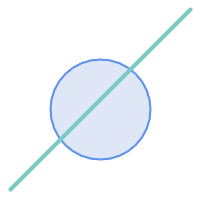 Avant la division
|
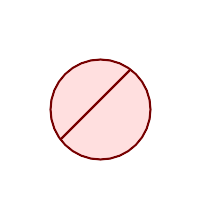 Après la division
|
SELECT ST_AsText( ST_Split(
ST_Buffer(ST_GeomFromText('POINT(100 90)'), 50), -- circle
ST_MakeLine(ST_Point(10, 10),ST_Point(190, 190)) -- line
));
-- result --
GEOMETRYCOLLECTION(
POLYGON((150 90,149.039264020162 80.2454838991936,146.193976625564 70.8658283817455,..),
POLYGON(..))
)
Divise une MultiLineString par un point, où le point se trouve exactement sur les deux éléments de la LineString.
|
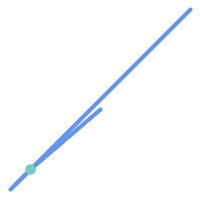 Avant la division
|
 Après la division
|
SELECT ST_AsText(ST_Split(
'MULTILINESTRING((10 10, 190 190), (15 15, 30 30, 100 90))',
ST_Point(30,30))) As split;
split
------
GEOMETRYCOLLECTION(
LINESTRING(10 10,30 30),
LINESTRING(30 30,190 190),
LINESTRING(15 15,30 30),
LINESTRING(30 30,100 90)
)
Diviser une ligne par un point, lorsque le point ne se trouve pas exactement sur la ligne. Montre l'utilisation de ST_Snap pour accrocher la ligne au point afin de permettre son découpage.
WITH data AS (SELECT
'LINESTRING(0 0, 100 100)'::geometry AS line,
'POINT(51 50)':: geometry AS point
)
SELECT ST_AsText( ST_Split( ST_Snap(line, point, 1), point)) AS snapped_split,
ST_AsText( ST_Split(line, point)) AS not_snapped_not_split
FROM data;
snapped_split | not_snapped_not_split
---------------------------------------------------------------------+---------------------------------------------
GEOMETRYCOLLECTION(LINESTRING(0 0,51 50),LINESTRING(51 50,100 100)) | GEOMETRYCOLLECTION(LINESTRING(0 0,100 100))
Name
ST_Subdivide — Calcule une subdivision rectiligne d'une géométrie.
Synopsis
setof geometry ST_Subdivide(geometry geom, integer max_vertices=256, float8 gridSize = -1);
Description
Renvoie un ensemble de géométries résultant de la division de geom en parties à l'aide de lignes rectilignes, chaque partie ne contenant pas plus de max_vertices.
max_vertices must be 5 or more, as 5 points are needed to represent a closed box.
If the optional gridSize parameter is given (GEOS-3.9.0 or higher required), all result vertices are guaranteed to fall on a grid of the specified size. For the operation to give predictable results all the input vertices must fall already on the specified grid, see ST_ReducePrecision.
Les opérations "point dans polygone" et autres opérations spatiales sont normalement plus rapides pour les ensembles de données subdivisés et indexés. Étant donné que les boîtes de délimitation des parties couvrent généralement une zone plus petite que la boîte b de la géométrie d'origine, les requêtes d'index produisent moins de cas "hit". Les cas "hit" sont plus rapides car les opérations spatiales exécutées par la revérification de l'index traitent moins de points.
![[Note]](images/note.png) | |
When casting a subdivided geometry to geography, the resulting geography may differ from the original. Subdivision adds vertices in planar (geometry) space. If vertices are inserted along the boundary, they will alter the geographical representation, where edges are interpreted as geodesic segments. To minimize distortion, first densify the geography using ST_Segmentize to add geodesic vertices, then cast to geometry before subdivision. |
![[Note]](images/note.png) | |
Il s'agit d'une fonction de retour d'ensemble (SRF) qui renvoie un ensemble de lignes contenant des valeurs de géométrie uniques. Elle peut être utilisée dans une liste SELECT ou une clause FROM pour produire un ensemble de résultats avec un enregistrement pour chaque géométrie de résultat. |
Effectué par le module GEOS.
Disponibilité : 2.2.0
Amélioration : 2.5.0 réutilise les points existants lors de la division d'un polygone, le nombre de vertex est réduit de 8 à 5.
Amélioration : 3.1.0 accepte un paramètre gridSize.
Nécessite GEOS >= 3.9.0 pour utiliser le paramètre gridSize
Exemples
Exemple: Subdivisez un polygone en parties ne comportant pas plus de 10 sommets et attribuez à chaque partie un identifiant unique.

Subdivisé en un maximum de 10 sommets
SELECT row_number() OVER() As rn, ST_AsText(geom) As wkt
FROM (SELECT ST_SubDivide(
'POLYGON((132 10,119 23,85 35,68 29,66 28,49 42,32 56,22 64,32 110,40 119,36 150,
57 158,75 171,92 182,114 184,132 186,146 178,176 184,179 162,184 141,190 122,
190 100,185 79,186 56,186 52,178 34,168 18,147 13,132 10))'::geometry,10)) AS f(geom);
rn │ wkt ────┼──────────────────────────────────────────────────────────────────────────────────────────────────────────────── 1 │ POLYGON((119 23,85 35,68 29,66 28,32 56,22 64,29.8260869565217 100,119 100,119 23)) 2 │ POLYGON((132 10,119 23,119 56,186 56,186 52,178 34,168 18,147 13,132 10)) 3 │ POLYGON((119 56,119 100,190 100,185 79,186 56,119 56)) 4 │ POLYGON((29.8260869565217 100,32 110,40 119,36 150,57 158,75 171,92 182,114 184,114 100,29.8260869565217 100)) 5 │ POLYGON((114 184,132 186,146 178,176 184,179 162,184 141,190 122,190 100,114 100,114 184))
Example: Densify a long geography line using ST_Segmentize(geography, distance), and use ST_Subdivide to split the resulting line into sublines of 8 vertices. Densification minimizes the impact of changes to the geography representation of a geometry when subdividing.
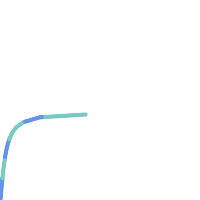
Les lignes densifiées et divisées.
SELECT ST_AsText( ST_Subdivide(
ST_Segmentize('LINESTRING(0 0, 85 85)'::geography,
1200000)::geometry, 8));
LINESTRING(0 0,0.487578359029357 5.57659056746196,0.984542144675897 11.1527721155093,1.50101059639722 16.7281035483571,1.94532113630331 21.25) LINESTRING(1.94532113630331 21.25,2.04869538062779 22.3020741387339,2.64204641967673 27.8740533545155,3.29994062412787 33.443216802941,4.04836719489742 39.0084282520239,4.59890468420694 42.5) LINESTRING(4.59890468420694 42.5,4.92498503922732 44.5680389206321,5.98737409390639 50.1195229244701,7.3290919767674 55.6587646879025,8.79638749938413 60.1969505994924) LINESTRING(8.79638749938413 60.1969505994924,9.11375579533779 61.1785363177625,11.6558166691368 66.6648504160202,15.642041247655 72.0867690601745,22.8716627200212 77.3609628116894,24.6991785131552 77.8939011989848) LINESTRING(24.6991785131552 77.8939011989848,39.4046096622744 82.1822848017636,44.7994523421035 82.5156766227011) LINESTRING(44.7994523421035 82.5156766227011,85 85)
Exemple: Subdiviser les géométries complexes d'une table existante. Les enregistrements de la géométrie d'origine sont supprimés de la table source et de nouveaux enregistrements sont insérés pour chaque géométrie de résultat subdivisée.
WITH complex_areas_to_subdivide AS (
DELETE from polygons_table
WHERE ST_NPoints(geom)
> 255
RETURNING id, column1, column2, column3, geom
)
INSERT INTO polygons_table (fid, column1, column2, column3, geom)
SELECT fid, column1, column2, column3,
ST_Subdivide(geom, 255) as geom
FROM complex_areas_to_subdivide;
Exemple: Créer une nouvelle table contenant les géométries subdivisées, en conservant la clé de la géométrie d'origine afin que la nouvelle table puisse être jointe à la table source. Étant donné que ST_Subdivide est une fonction (tableau) qui renvoie un ensemble de lignes à valeur unique, cette syntaxe produit automatiquement un tableau avec une ligne pour chaque partie du résultat.
CREATE TABLE subdivided_geoms AS
SELECT pkey, ST_Subdivide(geom) AS geom
FROM original_geoms;
Voir aussi
ST_ClipByBox2D, ST_Segmentize, ST_Split, ST_NPoints, ST_ReducePrecision
Name
ST_SymDifference — Calcule une géométrie représentant les parties des géométries A et B qui ne s'intersectent pas.
Synopsis
geometry ST_SymDifference(geometry geomA, geometry geomB, float8 gridSize = -1);
Description
Renvoie une géométrie représentant les parties des géométries A et B qui ne s'intersectent pas. Ceci est équivalent à ST_Union(A,B) - ST_Intersection(A,B). On parle de différence symétrique car ST_SymDifférence(A,B) = ST_SymDifférence(B,A).
If the optional gridSize parameter is given (GEOS-3.9.0 or higher required), all result vertices are guaranteed to fall on a grid of the specified size. For the operation to give predictable results all the input vertices must fall already on the specified grid, see ST_ReducePrecision.
Effectué par le module GEOS
Amélioration : 3.1.0 accepte un paramètre gridSize.
Nécessite GEOS >= 3.9.0 pour utiliser le paramètre gridSize
 Cette méthode implémente la spécification OGC Simple Features Implementation Specification for SQL 1.1. s2.1.1.3
Cette méthode implémente la spécification OGC Simple Features Implementation Specification for SQL 1.1. s2.1.1.3
 Cette méthode implémente la spécification SQL/MM. SQL-MM 3: 5.1.21
Cette méthode implémente la spécification SQL/MM. SQL-MM 3: 5.1.21
 Cette fonction prend en charge la 3D et ne supprime pas l'indice z. Cependant, le résultat est calculé en utilisant uniquement XY. Les valeurs Z résultantes sont copiées, moyennées ou interpolées.
Cette fonction prend en charge la 3D et ne supprime pas l'indice z. Cependant, le résultat est calculé en utilisant uniquement XY. Les valeurs Z résultantes sont copiées, moyennées ou interpolées.
Exemples
|
 Les lignes originales présentées ensemble
|
 La différence symétrique des deux lignes
|
--Safe for 2d - symmetric difference of 2 linestrings
SELECT ST_AsText(
ST_SymDifference(
ST_GeomFromText('LINESTRING(50 100, 50 200)'),
ST_GeomFromText('LINESTRING(50 50, 50 150)')
)
);
st_astext
---------
MULTILINESTRING((50 150,50 200),(50 50,50 100))
--When used in 3d doesn't quite do the right thing
SELECT ST_AsEWKT(ST_SymDifference(ST_GeomFromEWKT('LINESTRING(1 2 1, 1 4 2)'),
ST_GeomFromEWKT('LINESTRING(1 1 3, 1 3 4)')))
st_astext
------------
MULTILINESTRING((1 3 2.75,1 4 2),(1 1 3,1 2 2.25))
Voir aussi
ST_Difference, ST_Intersection, ST_Union, ST_ReducePrecision
Name
ST_UnaryUnion — Calcule l'union des composantes d'une seule géométrie.
Synopsis
geometry ST_UnaryUnion(geometry geom, float8 gridSize = -1);
Description
Variante à entrée unique de ST_Union. L'entrée peut être une géométrie unique, une MultiGeometry ou une GeometryCollection. L'union est appliquée aux éléments individuels de l'entrée.
Cette fonction peut être utilisée pour corriger les MultiPolygones qui ne sont pas valides en raison du chevauchement de leurs composants. Toutefois, les composants d'entrée doivent tous être valides. Un composant d'entrée non valide, tel qu'un polygone en nœud papillon, peut provoquer une erreur. Pour cette raison, il peut être préférable d'utiliser ST_MakeValid.
Une autre utilisation de cette fonction est de nouer et de dissoudre une collection de lignes qui se croisent ou se chevauchent pour les rendre simple. (ST_Node fait également cela, mais ne fournit pas l'option gridSize.)
Il est possible de combiner ST_UnaryUnion avec ST_Collect pour affiner le nombre de géométries à unir en une seule fois. Cela permet de faire un compromis entre l'utilisation de la mémoire et le temps de calcul, en trouvant un équilibre entre ST_Union et ST_MemUnion.
If the optional gridSize parameter is given (GEOS-3.9.0 or higher required), all result vertices are guaranteed to fall on a grid of the specified size. For the operation to give predictable results all the input vertices must fall already on the specified grid, see ST_ReducePrecision.
 Cette fonction prend en charge la 3D et ne supprime pas l'indice z. Cependant, le résultat est calculé en utilisant uniquement XY. Les valeurs Z résultantes sont copiées, moyennées ou interpolées.
Cette fonction prend en charge la 3D et ne supprime pas l'indice z. Cependant, le résultat est calculé en utilisant uniquement XY. Les valeurs Z résultantes sont copiées, moyennées ou interpolées.
Amélioration : 3.1.0 accepte un paramètre gridSize.
Nécessite GEOS >= 3.9.0 pour utiliser le paramètre gridSize
Disponibilité : 2.0.0
Voir aussi
ST_Union, ST_MemUnion, ST_MakeValid, ST_Collect, ST_Node, ST_ReducePrecision
Name
ST_Union — Calcule une géométrie représentant l'union des ensembles de points des géométries d'entrée.
Synopsis
geometry ST_Union(geometry g1, geometry g2);
geometry ST_Union(geometry g1, geometry g2, float8 gridSize);
geometry ST_Union(geometry[] g1_array);
geometry ST_Union(geometry set g1field);
geometry ST_Union(geometry set g1field, float8 gridSize);
Description
Unifie les géométries d'entrée, fusionne les géométries pour produire une géométrie de résultat sans chevauchement. Le résultat peut être une géométrie atomique, une MultiGeometry ou une Geometry Collection. Il existe plusieurs variantes :
Variante à deux entrées: renvoie une géométrie qui est l'union de deux géométries d'entrée. Si l'une des entrées est NULL, NULL est renvoyé.
Variante tableau: renvoie une géométrie qui est l'union d'un tableau de géométries.
Variante agrégée: renvoie une géométrie qui est l'union d'un ensemble de géométries. La fonction ST_Union() est une fonction "agrégée" dans la terminologie de PostgreSQL. Cela signifie qu'elle opère sur des lignes de données, de la même manière que les fonctions SUM() et AVG() et, comme la plupart des agrégats, elle ignore les géométries NULL.
Voir ST_UnaryUnion pour une variante non agrégée, à entrée unique.
Le tableau ST_Union et ses variantes utilisent l'algorithme rapide d'union en cascade décrit dans http://blog.cleverelephant.ca/2009/01/must-faster-unions-in-postgis-14.html
If the optional gridSize parameter is given (GEOS-3.9.0 or higher required), all result vertices are guaranteed to fall on a grid of the specified size. For the operation to give predictable results all the input vertices must fall already on the specified grid, see ST_ReducePrecision.
![[Note]](images/note.png) | |
ST_Collect peut parfois être utilisé à la place de ST_Union, si le résultat n'a pas besoin d'être non chevauchant. ST_Collect est généralement plus rapide que ST_Union car il n'effectue aucun traitement sur les géométries collectées. |
Effectué par le module GEOS.
ST_Union crée une MultiLineString et ne fusionne pas les LineStrings en une seule LineString. Utilisez ST_LineMerge pour fusionner les LineStrings.
NOTE : cette fonction s'appelait auparavant GeomUnion(), qui a été renommée "Union" car UNION est un mot réservé de SQL.
Amélioration : 3.1.0 accepte un paramètre gridSize.
Nécessite GEOS >= 3.9.0 pour utiliser le paramètre gridSize
Modifié : 3.0.0 ne dépend pas de SFCGAL.
Disponibilité : 1.4.0 - ST_Union a été amélioré. ST_Union(geomarray) a été introduit ainsi qu'une collecte d'agrégats plus rapide dans PostgreSQL.
 Cette méthode implémente la spécification OGC Simple Features Implementation Specification for SQL 1.1. s2.1.1.3
Cette méthode implémente la spécification OGC Simple Features Implementation Specification for SQL 1.1. s2.1.1.3
![[Note]](images/note.png) | |
La version agrégée n'est pas explicitement définie dans l'OGC SPEC. |
 Cette méthode implémente la spécification SQL/MM. SQL-MM 3 : 5.1.19 l'indice z (élévation) lorsque des polygones sont impliqués.
Cette méthode implémente la spécification SQL/MM. SQL-MM 3 : 5.1.19 l'indice z (élévation) lorsque des polygones sont impliqués.
 Cette fonction prend en charge la 3D et ne supprime pas l'indice z. Cependant, le résultat est calculé en utilisant uniquement XY. Les valeurs Z résultantes sont copiées, moyennées ou interpolées.
Cette fonction prend en charge la 3D et ne supprime pas l'indice z. Cependant, le résultat est calculé en utilisant uniquement XY. Les valeurs Z résultantes sont copiées, moyennées ou interpolées.
Exemples
Exemple d'agrégat
SELECT id,
ST_Union(geom) as singlegeom
FROM sometable f
GROUP BY id;
Exemple non agrégé
select ST_AsText(ST_Union('POINT(1 2)' :: geometry, 'POINT(-2 3)' :: geometry))
st_astext
----------
MULTIPOINT(-2 3,1 2)
select ST_AsText(ST_Union('POINT(1 2)' :: geometry, 'POINT(1 2)' :: geometry))
st_astext
----------
POINT(1 2)Exemple 3D - en quelque sorte des supports 3D (et avec des dimensions mixtes !)
select ST_AsEWKT(ST_Union(geom))
from (
select 'POLYGON((-7 4.2,-7.1 4.2,-7.1 4.3, -7 4.2))'::geometry geom
union all
select 'POINT(5 5 5)'::geometry geom
union all
select 'POINT(-2 3 1)'::geometry geom
union all
select 'LINESTRING(5 5 5, 10 10 10)'::geometry geom
) as foo;
st_asewkt
---------
GEOMETRYCOLLECTION(POINT(-2 3 1),LINESTRING(5 5 5,10 10 10),POLYGON((-7 4.2 5,-7.1 4.2 5,-7.1 4.3 5,-7 4.2 5)));
Exemple en 3D ne mélangeant pas les dimensions
select ST_AsEWKT(ST_Union(geom))
from (
select 'POLYGON((-7 4.2 2,-7.1 4.2 3,-7.1 4.3 2, -7 4.2 2))'::geometry geom
union all
select 'POINT(5 5 5)'::geometry geom
union all
select 'POINT(-2 3 1)'::geometry geom
union all
select 'LINESTRING(5 5 5, 10 10 10)'::geometry geom
) as foo;
st_asewkt
---------
GEOMETRYCOLLECTION(POINT(-2 3 1),LINESTRING(5 5 5,10 10 10),POLYGON((-7 4.2 2,-7.1 4.2 3,-7.1 4.3 2,-7 4.2 2)))
--Examples using new Array construct
SELECT ST_Union(ARRAY(SELECT geom FROM sometable));
SELECT ST_AsText(ST_Union(ARRAY[ST_GeomFromText('LINESTRING(1 2, 3 4)'),
ST_GeomFromText('LINESTRING(3 4, 4 5)')])) As wktunion;
--wktunion---
MULTILINESTRING((3 4,4 5),(1 2,3 4))
7.14. Traitement des géométries
Ces fonctions permettent de calculer des constructions géométriques ou de modifier la taille ou la forme d'une géométrie.
- ST_Buffer — Calcule une géométrie couvrant tous les points situés à une distance donnée d'une géométrie.
- ST_BuildArea — Crée une géométrie polygonale formée par le tracé d'une géométrie.
- ST_Centroid — Renvoie le centre géométrique d'une géométrie.
- ST_ChaikinSmoothing — Renvoie une version lissée d'une géométrie, en utilisant l'algorithme Chaikin
- ST_ConcaveHull — Calcule une géométrie éventuellement concave qui contient tous les sommets de la géométrie d'entrée
- ST_ConvexHull — Calcule l'enveloppe convexe d'une géométrie.
- ST_DelaunayTriangles — Renvoie la triangulation de Delaunay des sommets d'une géométrie.
- ST_FilterByM — Supprime les vertices en fonction de leur valeur M
- ST_GeneratePoints — Génère un multipoint de points aléatoires contenus dans un polygone ou un multipolygone.
- ST_GeometricMedian — Renvoie la médiane géométrique d'un MultiPoint.
- ST_LineMerge — Renvoie les lignes formées par la couture d'une MultiLineString.
- ST_MaximumInscribedCircle — Calcule le plus grand cercle contenu dans une géométrie.
- ST_LargestEmptyCircle — Calcule le plus grand cercle ne recouvrant pas une géométrie.
- ST_MinimumBoundingCircle — Retourne le plus petit cercle polygonal qui contient une géométrie.
- ST_MinimumBoundingRadius — Renvoie le point central et le rayon du plus petit cercle contenant une géométrie.
- ST_OrientedEnvelope — Renvoie un rectangle de surface minimale contenant une géométrie.
- ST_OffsetCurve — Renvoie une ligne décalée par rapport à une distance et un côté donnés à partir d'une ligne en entrée.
- ST_PointOnSurface — Calcule un point dont on garantit qu'il se trouve dans un polygone ou sur une géométrie.
- ST_Polygonize — Calcule une collection de polygones formés à partir du tracé d'un ensemble de géométries.
- ST_ReducePrecision — Renvoie une géométrie valide dont les points sont arrondis en fonction de la tolérance de la grille.
- ST_SharedPaths — Renvoie une collection contenant les chemins partagés par les deux lignes/multilignes en entrée.
- ST_Simplify — Renvoie une représentation simplifiée d'une géométrie, en utilisant l'algorithme de Douglas-Peucker.
- ST_SimplifyPreserveTopology — Renvoie une représentation simplifiée et valide d'une géométrie, en utilisant l'algorithme de Douglas-Peucker.
- ST_SimplifyPolygonHull — Calcule une enveloppe extérieure ou intérieure simplifiée préservant la topologie d'une géométrie polygonale.
- ST_SimplifyVW — Renvoie une représentation simplifiée d'une géométrie, en utilisant l'algorithme de Visvalingam-Whyatt
- ST_SetEffectiveArea — Définit la surface effective de chaque sommet, en utilisant l'algorithme Visvalingam-Whyatt.
- ST_TriangulatePolygon — Calcule la triangulation de Delaunay contrainte des polygones
- ST_VoronoiLines — Renvoie les limites des polygones de Voronoï des sommets d'une géométrie.
- ST_VoronoiPolygons — Renvoie les cellules de la représentation de Voronoï des sommets d'une géométrie.
Name
ST_Buffer — Calcule une géométrie couvrant tous les points situés à une distance donnée d'une géométrie.
Synopsis
geometry ST_Buffer(geometry g1, float radius_of_buffer, text buffer_style_parameters = '');
geometry ST_Buffer(geometry g1, float radius_of_buffer, integer num_seg_quarter_circle);
geography ST_Buffer(geography g1, float radius_of_buffer, text buffer_style_parameters);
geography ST_Buffer(geography g1, float radius_of_buffer, integer num_seg_quarter_circle);
Description
Calcule un POLYGONE ou un MULTIPOLYGONE représentant tous les points dont la distance par rapport à une geometry/geography est inférieure ou égale à une distance donnée. Une distance négative rétrécit la géométrie au lieu de l'étendre. Une distance négative peut réduire complètement un polygone, auquel cas POLYGON EMPTY est renvoyé. Pour les points et les lignes, les distances négatives renvoient toujours des résultats vides.
Pour les types geometry, la distance est spécifiée dans les unités du système de référence spatiale de la géométrie. Pour les types geography, la distance est spécifiée en mètres.
Le troisième paramètre facultatif contrôle la précision et le style du tampon. La précision des arcs de cercle dans le tampon est spécifiée en tant que nombre de segments de ligne utilisés pour approximer un quart de cercle (la valeur par défaut est de 8). Le style du tampon peut être spécifié en fournissant une liste de paires clé=valeur séparées par des blancs, comme suit :
'quad_segs=#' : nombre de segments de ligne utilisés pour approximer un quart de cercle (8 par défaut).
'endcap=round|flat|square' : style d'endcap (la valeur par défaut est "round"). 'butt' est accepté comme synonyme de 'flat'.
'join=round|mitre|bevel' : style de jointure (la valeur par défaut est "round"). 'miter' est accepté comme synonyme de 'mitre'.
'mitre_limit=#.#' : limite du rapport d'angle (n'affecte que le style d'assemblage en angle). 'miter_limit' est accepté comme synonyme de 'mitre_limit'.
'side=both|left|right' : defaults to 'both'. 'left' or 'right' performs a single-sided buffer on the geometry, with the buffered side relative to the direction of the line. This is only applicable to LINESTRING geometry and does not affect POINT or POLYGON geometries. By default end caps are square when 'left' or 'right' are specified.
![[Note]](images/note.png) | |
|
![[Note]](images/note.png) | |
Buffer can handle invalid inputs and the output is always a valid polygonal geometry. Buffering by distance 0 is sometimes used as a way of repairing invalid polygons. ST_MakeValid is more suitable for this process as it can handle multi-polygons. |
![[Note]](images/note.png) | |
La mise en mémoire tampon est parfois utilisée pour effectuer une recherche à l'intérieur de la distance. Dans ce cas, il est plus efficace d'utiliser ST_DWithin. |
![[Note]](images/note.png) | |
Cette fonction ignore la dimension Z. Elle donne toujours un résultat en 2D, même lorsqu'elle est utilisée sur une géométrie en 3D. |
Amélioration : 2.5.0 - La prise en charge de la géométrie ST_Buffer a été améliorée pour permettre la spécification de la mise en mémoire tampon latérale side=both|left|right.
Disponibilité : 1.5 - ST_Buffer a été amélioré pour prendre en charge différents types de terminaisons et de jointures. Ceux-ci sont utiles, par exemple, pour convertir les lignes de route en routes polygonales avec des bords plats ou carrés au lieu de bords arrondis. Un petit wrapper pour la geography a été ajouté.
Effectué par le module GEOS.
 Cette méthode implémente la spécification OGC Simple Features Implementation Specification for SQL 1.1. s2.1.1.3
Cette méthode implémente la spécification OGC Simple Features Implementation Specification for SQL 1.1. s2.1.1.3
 Cette méthode implémente la spécification SQL/MM. SQL-MM IEC 13249-3: 5.1.30
Cette méthode implémente la spécification SQL/MM. SQL-MM IEC 13249-3: 5.1.30
Exemples
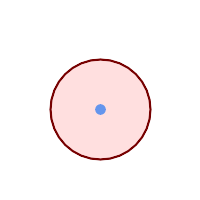 quad_segs=8 (par défaut)
SELECT ST_Buffer(
ST_GeomFromText('POINT(100 90)'),
50, 'quad_segs=8');
| 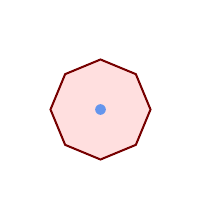 quad_segs=2 (faible)
SELECT ST_Buffer(
ST_GeomFromText('POINT(100 90)'),
50, 'quad_segs=2');
| |
 endcap=round join=round (par défaut)
SELECT ST_Buffer(
ST_GeomFromText(
'LINESTRING(50 50,150 150,150 50)'
), 10, 'endcap=round join=round');
| 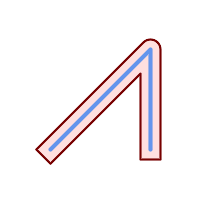 endcap=square
SELECT ST_Buffer(
ST_GeomFromText(
'LINESTRING(50 50,150 150,150 50)'
), 10, 'endcap=square join=round');
| 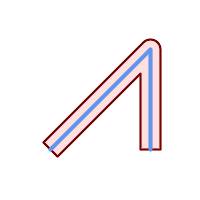 endcap=flat
SELECT ST_Buffer(
ST_GeomFromText(
'LINESTRING(50 50,150 150,150 50)'
), 10, 'endcap=flat join=round');
|
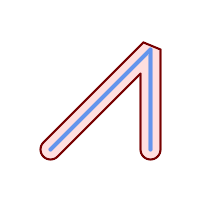 join=bevel
SELECT ST_Buffer(
ST_GeomFromText(
'LINESTRING(50 50,150 150,150 50)'
), 10, 'join=bevel');
|  join=mitre mitre_limit=5.0 (limite de mitre par défaut)
SELECT ST_Buffer(
ST_GeomFromText(
'LINESTRING(50 50,150 150,150 50)'
), 10, 'join=mitre mitre_limit=5.0');
|  join=mitre mitre_limit=1
SELECT ST_Buffer(
ST_GeomFromText(
'LINESTRING(50 50,150 150,150 50)'
), 10, 'join=mitre mitre_limit=1.0');
|
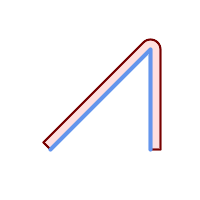 side=left
SELECT ST_Buffer(
ST_GeomFromText(
'LINESTRING(50 50,150 150,150 50)'
), 10, 'side=left');
| 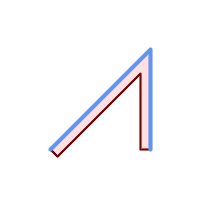 side=right
SELECT ST_Buffer(
ST_GeomFromText(
'LINESTRING(50 50,150 150,150 50)'
), 10, 'side=right');
| 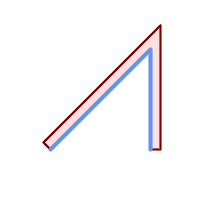 side=left join=mitre
SELECT ST_Buffer(
ST_GeomFromText(
'LINESTRING(50 50,150 150,150 50)'
), 10, 'side=left join=mitre');
|
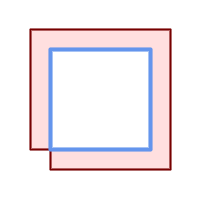 enroulement à droite, limite du polygone side=left
SELECT ST_Buffer(
ST_ForceRHR(
ST_Boundary(
ST_GeomFromText(
'POLYGON ((50 50, 50 150, 150 150, 150 50, 50 50))'))),
), 20, 'side=left');
| 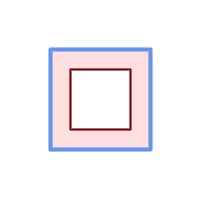 enroulement à droite, limite du polygone side=right
SELECT ST_Buffer(
ST_ForceRHR(
ST_Boundary(
ST_GeomFromText(
'POLYGON ((50 50, 50 150, 150 150, 150 50, 50 50))'))
), 20,'side=right')
|
--A buffered point approximates a circle
-- A buffered point forcing approximation of (see diagram)
-- 2 points per quarter circle is poly with 8 sides (see diagram)
SELECT ST_NPoints(ST_Buffer(ST_GeomFromText('POINT(100 90)'), 50)) As promisingcircle_pcount,
ST_NPoints(ST_Buffer(ST_GeomFromText('POINT(100 90)'), 50, 2)) As lamecircle_pcount;
promisingcircle_pcount | lamecircle_pcount
------------------------+-------------------
33 | 9
--A lighter but lamer circle
-- only 2 points per quarter circle is an octagon
--Below is a 100 meter octagon
-- Note coordinates are in NAD 83 long lat which we transform
to Mass state plane meter and then buffer to get measurements in meters;
SELECT ST_AsText(ST_Buffer(
ST_Transform(
ST_SetSRID(ST_Point(-71.063526, 42.35785),4269), 26986)
,100,2)) As octagon;
----------------------
POLYGON((236057.59057465 900908.759918696,236028.301252769 900838.049240578,235
957.59057465 900808.759918696,235886.879896532 900838.049240578,235857.59057465
900908.759918696,235886.879896532 900979.470596815,235957.59057465 901008.759918
696,236028.301252769 900979.470596815,236057.59057465 900908.759918696))
Voir aussi
ST_Collect, ST_DWithin, ST_SetSRID, ST_Transform, ST_Union, ST_MakeValid
Name
ST_BuildArea — Crée une géométrie polygonale formée par le tracé d'une géométrie.
Synopsis
geometry ST_BuildArea(geometry geom);
Description
Crée une géométrie aréolaire formée par les lignes constitutives de la géométrie d'entrée. L'entrée peut être une LineString, MultiLineString, Polygon, MultiPolygon ou une GeometryCollection. Le résultat est un Polygone ou un MultiPolygone, en fonction de l'entrée. Si la ligne d'entrée ne forme pas de polygone, NULL est renvoyé.
Contrairement à ST_MakePolygon, cette fonction accepte les anneaux formés par plusieurs lignes et peut former un nombre quelconque de polygones.
Cette fonction convertit les anneaux intérieurs en trous. Pour transformer les anneaux intérieurs en polygones, utilisez ST_Polygonize.
![[Note]](images/note.png) | |
Les lignes d'entrée doivent être correctement nouées pour que cette fonction fonctionne correctement. ST_Node peut être utilisé pour nouer des lignes. Si le réseau de lignes d'entrée est croisé, cette fonction produira des polygones non valides. ST_MakeValid peut être utilisé pour s'assurer que la sortie est valide. |
Disponibilité : 1.1.0
Exemples
 Lignes en entrée
|
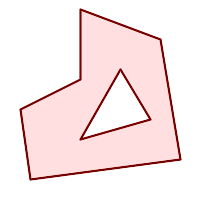 Résultat de la zone
|
WITH data(geom) AS (VALUES
('LINESTRING (180 40, 30 20, 20 90)'::geometry)
,('LINESTRING (180 40, 160 160)'::geometry)
,('LINESTRING (160 160, 80 190, 80 120, 20 90)'::geometry)
,('LINESTRING (80 60, 120 130, 150 80)'::geometry)
,('LINESTRING (80 60, 150 80)'::geometry)
)
SELECT ST_AsText( ST_BuildArea( ST_Collect( geom )))
FROM data;
------------------------------------------------------------------------------------------
POLYGON((180 40,30 20,20 90,80 120,80 190,160 160,180 40),(150 80,120 130,80 60,150 80))

Créer un donut à partir de deux polygones circulaires
SELECT ST_BuildArea(ST_Collect(inring,outring))
FROM (SELECT
ST_Buffer('POINT(100 90)', 25) As inring,
ST_Buffer('POINT(100 90)', 50) As outring) As t;
Voir aussi
ST_Collect, ST_MakePolygon, ST_MakeValid, ST_Node, ST_Polygonize, ST_BdPolyFromText, ST_BdMPolyFromText (wrappers de cette fonction avec l'interface standard de l'OGC)
Name
ST_Centroid — Renvoie le centre géométrique d'une géométrie.
Synopsis
geometry ST_Centroid(geometry g1);
geography ST_Centroid(geography g1, boolean use_spheroid = true);
Description
Calcule un point qui est le centre de masse géométrique d'une géométrie. Pour [MULTI]POINTs, le centroïde est la moyenne arithmétique des coordonnées entrées. Pour les [MULTI]LINESTRINGs, le centroïde est calculé en utilisant la longueur pondérée de chaque segment de ligne. Pour les [MULTI]POLYGONs, le centroïde est calculé en termes de surface. Si une géométrie vide est fournie, une GEOMETRYCOLLECTION vide est renvoyée. Si NULL est fourni, NULL est renvoyé. Si CIRCULARSTRING ou COMPOUNDCURVE sont fournis, ils sont convertis en linestring avec CurveToLine d'abord, puis de la même manière que pour LINESTRING
Pour les entrées de dimensions mixtes, le résultat est égal au centroïde de la composante Géométries de la dimension la plus élevée (puisque les géométries de dimension inférieure n'apportent aucun "poids" au centroïde).
Notez que pour les géométries polygonales, le centroïde n'est pas nécessairement situé à l'intérieur du polygone. Par exemple, voir le diagramme ci-dessous du centroïde d'un polygone en forme de C. Pour construire un point garanti à l'intérieur d'un polygone, utilisez ST_PointOnSurface.
Nouveau dans la version 2.3.0 : prend en charge CIRCULARSTRING et COMPOUNDCURVE (en utilisant CurveToLine)
Disponibilité : la prise en charge du type geography a été introduite dans la version 2.4.0.
 Cette méthode implémente la spécification OGC Simple Features Implementation Specification for SQL 1.1.
Cette méthode implémente la spécification OGC Simple Features Implementation Specification for SQL 1.1.
 Cette méthode implémente la spécification SQL/MM. SQL-MM 3: 8.1.4, 9.5.5
Cette méthode implémente la spécification SQL/MM. SQL-MM 3: 8.1.4, 9.5.5
Exemples
Dans les illustrations suivantes, le point rouge est le centroïde de la géométrie de la source.
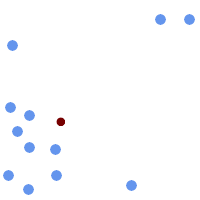 Centroïde d'un | 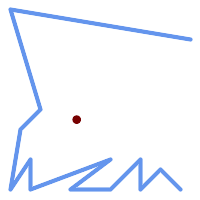 Centroïde d'une |
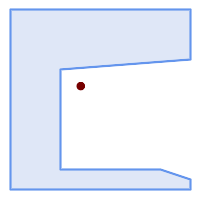 Centroïde d'un | 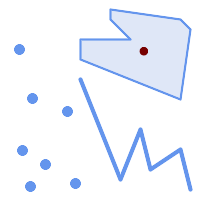 Centroïde d'une |
SELECT ST_AsText(ST_Centroid('MULTIPOINT ( -1 0, -1 2, -1 3, -1 4, -1 7, 0 1, 0 3, 1 1, 2 0, 6 0, 7 8, 9 8, 10 6 )'));
st_astext
------------------------------------------
POINT(2.30769230769231 3.30769230769231)
(1 row)
SELECT ST_AsText(ST_centroid(g))
FROM ST_GeomFromText('CIRCULARSTRING(0 2, -1 1,0 0, 0.5 0, 1 0, 2 1, 1 2, 0.5 2, 0 2)') AS g ;
------------------------------------------
POINT(0.5 1)
SELECT ST_AsText(ST_centroid(g))
FROM ST_GeomFromText('COMPOUNDCURVE(CIRCULARSTRING(0 2, -1 1,0 0),(0 0, 0.5 0, 1 0),CIRCULARSTRING( 1 0, 2 1, 1 2),(1 2, 0.5 2, 0 2))' ) AS g;
------------------------------------------
POINT(0.5 1)
Voir aussi
Name
ST_ChaikinSmoothing — Renvoie une version lissée d'une géométrie, en utilisant l'algorithme Chaikin
Synopsis
geometry ST_ChaikinSmoothing(geometry geom, integer nIterations = 1, boolean preserveEndPoints = false);
Description
Lisse une géométrie linéaire ou polygonale en utilisant Chaikin's algorithm. Le degré de lissage est contrôlé par le paramètre nIterations. À chaque itération, chaque sommet intérieur est remplacé par deux sommets situés à 1/4 de la longueur des segments de ligne précédant et suivant le sommet. Un degré raisonnable de lissage est fourni par 3 itérations ; le maximum est limité à 5.
Si preserveEndPoints est égal à true, les extrémités des anneaux de polygone ne sont pas lissées. Les extrémités des lignes sont toujours préservées.
![[Note]](images/note.png) | |
Le nombre de sommets double à chaque itération, de sorte que la géométrie résultante peut comporter beaucoup plus de points que la géométrie d'entrée. Pour réduire le nombre de points, utilisez une fonction de simplification sur le résultat (voir ST_Simplify, ST_SimplifyPreserveTopology et ST_SimplifyVW). |
Le résultat comporte des valeurs interpolées pour les dimensions Z et M lorsqu'elles sont présentes.
 Cette fonction prend en charge la 3D et ne supprime pas l'indice z.
Cette fonction prend en charge la 3D et ne supprime pas l'indice z.
Disponibilité : 2.5.0
Exemples
Lissage d'un triangle :
SELECT ST_AsText(ST_ChaikinSmoothing(geom)) smoothed
FROM (SELECT 'POLYGON((0 0, 8 8, 0 16, 0 0))'::geometry geom) AS foo;
smoothed
───────────────────────────────────────────
POLYGON((2 2,6 6,6 10,2 14,0 12,0 4,2 2))
Lissage d'un polygone en utilisant 1, 2 et 3 itérations :
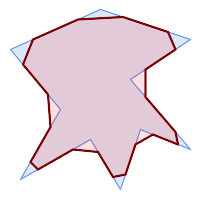 nIterations = 1 | 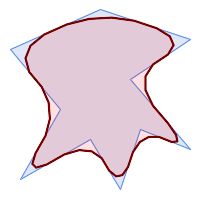 nIterations = 2 | 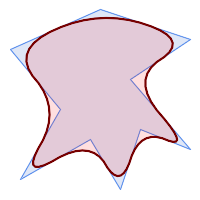 nIterations = 3 |
SELECT ST_ChaikinSmoothing(
'POLYGON ((20 20, 60 90, 10 150, 100 190, 190 160, 130 120, 190 50, 140 70, 120 10, 90 60, 20 20))',
generate_series(1, 3) );
Lissage d'une LineString en utilisant 1, 2 et 3 itérations :
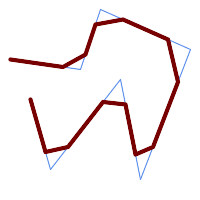 nIterations = 1 | 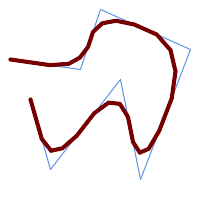 nIterations = 2 | 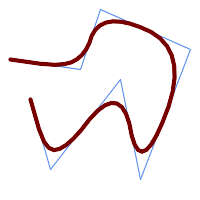 nIterations = 3 |
SELECT ST_ChaikinSmoothing(
'LINESTRING (10 140, 80 130, 100 190, 190 150, 140 20, 120 120, 50 30, 30 100)',
generate_series(1, 3) );
Voir aussi
Name
ST_ConcaveHull — Calcule une géométrie éventuellement concave qui contient tous les sommets de la géométrie d'entrée
Synopsis
geometry ST_ConcaveHull(geometry param_geom, float param_pctconvex, boolean param_allow_holes = false);
Description
Une enveloppe concave est une géométrie (généralement) concave qui contient l'entrée et dont les sommets sont un sous-ensemble des sommets de l'entrée. Dans le cas général, l'enveloppe concave est un polygone. L'enveloppe concave de deux ou plusieurs points colinéaires est une ligne à deux points. L'enveloppe concave d'un ou plusieurs points identiques est un Point. Le polygone ne contiendra pas de trous à moins que l'argument facultatif param_allow_holes ne soit spécifié comme vrai.
On peut considérer qu'une enveloppe concave "rétrécit" un ensemble de points. Cela diffère de la convex hull, qui revient à enrouler un élastique autour des points. Une enveloppe concave a généralement une surface plus petite et représente une limite plus naturelle pour les points d'entrée.
La param_pctconvex contrôle la concavité de l'enveloppe calculée. Une valeur de 1 produit une enveloppe convexe. Les valeurs comprises entre 1 et 0 produisent des enveloppes de concavité croissante. Une valeur de 0 produit une enveloppe avec une concavité maximale (mais toujours un polygone unique). Le choix d'une valeur appropriée dépend de la nature des données d'entrée, mais des valeurs comprises entre 0,3 et 0,1 produisent souvent des résultats raisonnables.
![[Note]](images/note.png) | |
Techniquement, la |
Pour les entrées ponctuelles et linéaires, l'enveloppe englobe tous les points de l'entrée. Pour les entrées polygonales, l'enveloppe englobera tous les points de l'entrée et aussi toutes les zones couvertes par l'entrée. Si vous souhaitez obtenir une enveloppe ponctuelle d'une entrée polygonale, convertissez-la d'abord en points à l'aide de ST_Points.
Il ne s'agit pas d'une fonction d'agrégation. Pour calculer l'enveloppe concave d'un ensemble de géométries, utilisez ST_Collect (par exemple ST_ConcaveHull( ST_Collect( geom ), 0.80).
Disponibilité : 2.0.0
Amélioré : 3.3.0, implémentation native de GEOS activée pour GEOS 3.11+
Exemples
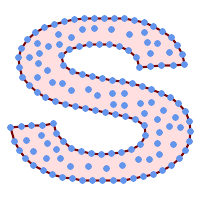
Enveloppe concave d'un MultiPoint
SELECT ST_AsText( ST_ConcaveHull(
'MULTIPOINT ((10 72), (53 76), (56 66), (63 58), (71 51), (81 48), (91 46), (101 45), (111 46), (121 47), (131 50), (140 55), (145 64), (144 74), (135 80), (125 83), (115 85), (105 87), (95 89), (85 91), (75 93), (65 95), (55 98), (45 102), (37 107), (29 114), (22 122), (19 132), (18 142), (21 151), (27 160), (35 167), (44 172), (54 175), (64 178), (74 180), (84 181), (94 181), (104 181), (114 181), (124 181), (134 179), (144 177), (153 173), (162 168), (171 162), (177 154), (182 145), (184 135), (139 132), (136 142), (128 149), (119 153), (109 155), (99 155), (89 155), (79 153), (69 150), (61 144), (63 134), (72 128), (82 125), (92 123), (102 121), (112 119), (122 118), (132 116), (142 113), (151 110), (161 106), (170 102), (178 96), (185 88), (189 78), (190 68), (189 58), (185 49), (179 41), (171 34), (162 29), (153 25), (143 23), (133 21), (123 19), (113 19), (102 19), (92 19), (82 19), (72 21), (62 22), (52 25), (43 29), (33 34), (25 41), (19 49), (14 58), (21 73), (31 74), (42 74), (173 134), (161 134), (150 133), (97 104), (52 117), (157 156), (94 171), (112 106), (169 73), (58 165), (149 40), (70 33), (147 157), (48 153), (140 96), (47 129), (173 55), (144 86), (159 67), (150 146), (38 136), (111 170), (124 94), (26 59), (60 41), (71 162), (41 64), (88 110), (122 34), (151 97), (157 56), (39 146), (88 33), (159 45), (47 56), (138 40), (129 165), (33 48), (106 31), (169 147), (37 122), (71 109), (163 89), (37 156), (82 170), (180 72), (29 142), (46 41), (59 155), (124 106), (157 80), (175 82), (56 50), (62 116), (113 95), (144 167))',
0.1 ) );
---st_astext--
POLYGON ((18 142, 21 151, 27 160, 35 167, 44 172, 54 175, 64 178, 74 180, 84 181, 94 181, 104 181, 114 181, 124 181, 134 179, 144 177, 153 173, 162 168, 171 162, 177 154, 182 145, 184 135, 173 134, 161 134, 150 133, 139 132, 136 142, 128 149, 119 153, 109 155, 99 155, 89 155, 79 153, 69 150, 61 144, 63 134, 72 128, 82 125, 92 123, 102 121, 112 119, 122 118, 132 116, 142 113, 151 110, 161 106, 170 102, 178 96, 185 88, 189 78, 190 68, 189 58, 185 49, 179 41, 171 34, 162 29, 153 25, 143 23, 133 21, 123 19, 113 19, 102 19, 92 19, 82 19, 72 21, 62 22, 52 25, 43 29, 33 34, 25 41, 19 49, 14 58, 10 72, 21 73, 31 74, 42 74, 53 76, 56 66, 63 58, 71 51, 81 48, 91 46, 101 45, 111 46, 121 47, 131 50, 140 55, 145 64, 144 74, 135 80, 125 83, 115 85, 105 87, 95 89, 85 91, 75 93, 65 95, 55 98, 45 102, 37 107, 29 114, 22 122, 19 132, 18 142))
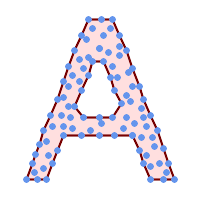
Enveloppe concave d'un MultiPoint, autorisant des trous
SELECT ST_AsText( ST_ConcaveHull(
'MULTIPOINT ((132 64), (114 64), (99 64), (81 64), (63 64), (57 49), (52 36), (46 20), (37 20), (26 20), (32 36), (39 55), (43 69), (50 84), (57 100), (63 118), (68 133), (74 149), (81 164), (88 180), (101 180), (112 180), (119 164), (126 149), (132 131), (139 113), (143 100), (150 84), (157 69), (163 51), (168 36), (174 20), (163 20), (150 20), (143 36), (139 49), (132 64), (99 151), (92 138), (88 124), (81 109), (74 93), (70 82), (83 82), (99 82), (112 82), (126 82), (121 96), (114 109), (110 122), (103 138), (99 151), (34 27), (43 31), (48 44), (46 58), (52 73), (63 73), (61 84), (72 71), (90 69), (101 76), (123 71), (141 62), (166 27), (150 33), (159 36), (146 44), (154 53), (152 62), (146 73), (134 76), (143 82), (141 91), (130 98), (126 104), (132 113), (128 127), (117 122), (112 133), (119 144), (108 147), (119 153), (110 171), (103 164), (92 171), (86 160), (88 142), (79 140), (72 124), (83 131), (79 118), (68 113), (63 102), (68 93), (35 45))',
0.15, true ) );
---st_astext--
POLYGON ((43 69, 50 84, 57 100, 63 118, 68 133, 74 149, 81 164, 88 180, 101 180, 112 180, 119 164, 126 149, 132 131, 139 113, 143 100, 150 84, 157 69, 163 51, 168 36, 174 20, 163 20, 150 20, 143 36, 139 49, 132 64, 114 64, 99 64, 81 64, 63 64, 57 49, 52 36, 46 20, 37 20, 26 20, 32 36, 35 45, 39 55, 43 69), (88 124, 81 109, 74 93, 83 82, 99 82, 112 82, 121 96, 114 109, 110 122, 103 138, 92 138, 88 124))
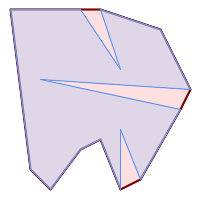
| 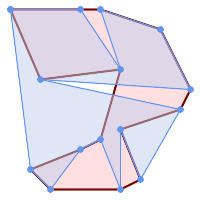
|
Comparaison entre l'enveloppe concave d'un polygone et l'enveloppe concave des points qui le composent. L'enveloppe respecte les limites du polygone, ce qui n'est pas le cas de l'enveloppe basée sur les points.
WITH data(geom) AS (VALUES
('POLYGON ((10 90, 39 85, 61 79, 50 90, 80 80, 95 55, 25 60, 90 45, 70 16, 63 38, 60 10, 50 30, 43 27, 30 10, 20 20, 10 90))'::geometry)
)
SELECT ST_ConcaveHull( geom, 0.1) AS polygon_hull,
ST_ConcaveHull( ST_Points(geom), 0.1) AS points_hull
FROM data;
Utilisation avec ST_Collect pour calculer l'enveloppe concave d'un ensemble géométrique.
-- Compute estimate of infected area based on point observations
SELECT disease_type,
ST_ConcaveHull( ST_Collect(obs_pnt), 0.3 ) AS geom
FROM disease_obs
GROUP BY disease_type;
Voir aussi
ST_ConvexHull, ST_Collect, ST_AlphaShape, ST_OptimalAlphaShape
Name
ST_ConvexHull — Calcule l'enveloppe convexe d'une géométrie.
Synopsis
geometry ST_ConvexHull(geometry geomA);
Description
Calcule l'enveloppe convexe d'une géométrie. L'enveloppe convexe est la plus petite géométrie convexe qui englobe toutes les géométries de l'entrée.
On peut considérer l'enveloppe convexe comme la géométrie obtenue en enroulant un élastique autour d'un ensemble de géométries. Ceci est différent d'une concave hull qui est analogue à un "rétrécissement" des géométries. Une enveloppe convexe est souvent utilisée pour déterminer une zone affectée sur la base d'un ensemble d'observations ponctuelles.
Dans le cas général, l'enveloppe convexe est un polygone. L'enveloppe convexe de deux ou plusieurs points colinéaires est une LineString à deux points. L'enveloppe convexe d'un ou plusieurs points identiques est un Point.
Il ne s'agit pas d'une fonction d'agrégation. Pour calculer l'enveloppe convexe d'un ensemble de géométries, utilisez ST_Collect pour les agréger dans une collection de géométries (par exemple ST_ConvexHull(ST_Collect(geom)).
Effectué par le module GEOS
 Cette méthode implémente la spécification OGC Simple Features Implementation Specification for SQL 1.1. s2.1.1.3
Cette méthode implémente la spécification OGC Simple Features Implementation Specification for SQL 1.1. s2.1.1.3
 Cette méthode implémente la spécification SQL/MM. SQL-MM IEC 13249-3: 5.1.16
Cette méthode implémente la spécification SQL/MM. SQL-MM IEC 13249-3: 5.1.16
 Cette fonction prend en charge la 3D et ne supprime pas l'indice z.
Cette fonction prend en charge la 3D et ne supprime pas l'indice z.
Exemples
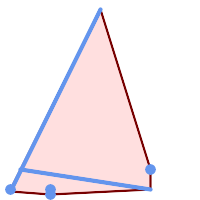
Enveloppe convexe d'une MultiLinestring et d'un MultiPoint
SELECT ST_AsText(ST_ConvexHull(
ST_Collect(
ST_GeomFromText('MULTILINESTRING((100 190,10 8),(150 10, 20 30))'),
ST_GeomFromText('MULTIPOINT(50 5, 150 30, 50 10, 10 10)')
)) );
---st_astext--
POLYGON((50 5,10 8,10 10,100 190,150 30,150 10,50 5))
Utilisation avec ST_Collect pour calculer les enveloppes convexes des ensembles géométriques.
--Get estimate of infected area based on point observations
SELECT d.disease_type,
ST_ConvexHull(ST_Collect(d.geom)) As geom
FROM disease_obs As d
GROUP BY d.disease_type;
Voir aussi
Name
ST_DelaunayTriangles — Renvoie la triangulation de Delaunay des sommets d'une géométrie.
Synopsis
geometry ST_DelaunayTriangles(geometry g1, float tolerance = 0.0, int4 flags = 0);
Description
Calcule la Delaunay triangulation des sommets de la géométrie d'entrée. La tolerance optionnelle peut être utilisée pour regrouper les sommets proches, ce qui améliore la robustesse dans certaines situations. La géométrie résultante est délimitée par l'enveloppe convexe des sommets de la géométrie d'entrée. La représentation de la géométrie résultante est déterminée par le code flags :
0- une collection de géométries de POLYGONES triangulaires (par défaut)1- une MULTILINESTRING des arêtes de la triangulation2- Un TIN de la triangulation
Effectué par le module GEOS.
Disponibilité : 2.1.0
 Cette fonction prend en charge la 3D et ne supprime pas l'indice z.
Cette fonction prend en charge la 3D et ne supprime pas l'indice z.
 Cette fonction prend en charge les triangles et les réseaux irréguliers triangulés (TIN).
Cette fonction prend en charge les triangles et les réseaux irréguliers triangulés (TIN).
Exemples
 Polygones d'origine our original geometry
ST_Union(ST_GeomFromText('POLYGON((175 150, 20 40,
50 60, 125 100, 175 150))'),
ST_Buffer(ST_GeomFromText('POINT(110 170)'), 20)
) |
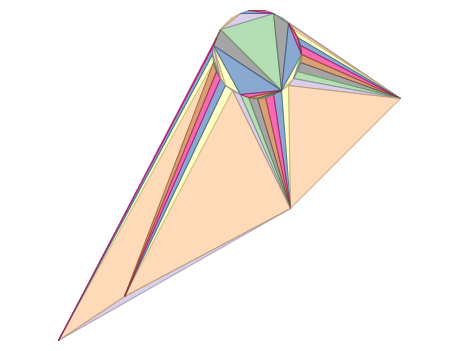 ST_DelaunayTriangles de 2 polygones : polygones de triangle delaunay, chaque triangle est thématisé dans une couleur différente
geometries overlaid multilinestring triangles
SELECT
ST_DelaunayTriangles(
ST_Union(ST_GeomFromText('POLYGON((175 150, 20 40,
50 60, 125 100, 175 150))'),
ST_Buffer(ST_GeomFromText('POINT(110 170)'), 20)
))
As dtriag;
|
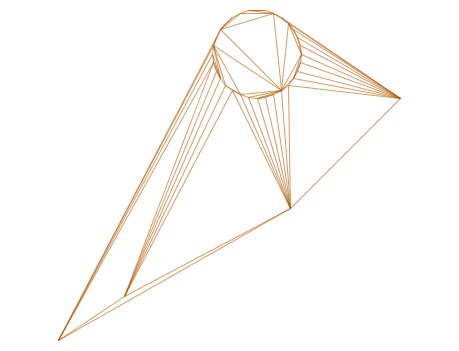 -- triangles de delaunay en tant que multilignes
SELECT
ST_DelaunayTriangles(
ST_Union(ST_GeomFromText('POLYGON((175 150, 20 40,
50 60, 125 100, 175 150))'),
ST_Buffer(ST_GeomFromText('POINT(110 170)'), 20)
),0.001,1)
As dtriag;
|
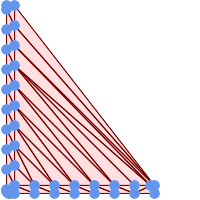 -- triangles de delaunay de 45 points sous forme de 55 polygones triangulaires
this produces a table of 42 points that form an L shape SELECT (ST_DumpPoints(ST_GeomFromText( 'MULTIPOINT(14 14,34 14,54 14,74 14,94 14,114 14,134 14, 150 14,154 14,154 6,134 6,114 6,94 6,74 6,54 6,34 6, 14 6,10 6,8 6,7 7,6 8,6 10,6 30,6 50,6 70,6 90,6 110,6 130, 6 150,6 170,6 190,6 194,14 194,14 174,14 154,14 134,14 114, 14 94,14 74,14 54,14 34,14 14)'))).geom INTO TABLE l_shape; output as individual polygon triangles SELECT ST_AsText((ST_Dump(geom)).geom) As wkt FROM ( SELECT ST_DelaunayTriangles(ST_Collect(geom)) As geom FROM l_shape) As foo; wkt POLYGON((6 194,6 190,14 194,6 194)) POLYGON((14 194,6 190,14 174,14 194)) POLYGON((14 194,14 174,154 14,14 194)) POLYGON((154 14,14 174,14 154,154 14)) POLYGON((154 14,14 154,150 14,154 14)) POLYGON((154 14,150 14,154 6,154 14))
|
Exemple utilisant des sommets avec des valeurs Z.
3D multipoint SELECT ST_AsText(ST_DelaunayTriangles(ST_GeomFromText( 'MULTIPOINT Z(14 14 10, 150 14 100,34 6 25, 20 10 150)'))) As wkt; wkt GEOMETRYCOLLECTION Z (POLYGON Z ((14 14 10,20 10 150,34 6 25,14 14 10)) ,POLYGON Z ((14 14 10,34 6 25,150 14 100,14 14 10)))
Name
ST_FilterByM — Supprime les vertices en fonction de leur valeur M
Synopsis
geometry ST_FilterByM(geometry geom, double precision min, double precision max = null, boolean returnM = false);
Description
Filtre les points de sommet en fonction de leur valeur M. Renvoie une géométrie contenant uniquement les points de sommet dont la valeur M est supérieure ou égale à la valeur min et inférieure ou égale à la valeur max. Si l'argument max-value est omis, seule la valeur min est prise en compte. Si le quatrième argument est omis, la valeur m ne figurera pas dans la géométrie résultante. Si la géométrie résultante a trop peu de points de vertex pour son type de géométrie, une géométrie vide sera renvoyée. Dans une collection de géométries, les géométries qui n'ont pas assez de points seront simplement éliminées silencieusement.
Cette fonction est principalement destinée à être utilisée en conjonction avec ST_SetEffectiveArea. ST_EffectiveArea définit la surface effective d'un sommet dans sa valeur m. Avec ST_FilterByM, il est possible d'obtenir une version simplifiée de la géométrie sans aucun calcul, simplement en filtrant
![[Note]](images/note.png) | |
Il existe une différence entre ST_SimplifyVW et ST_FilterByM en ce qui concerne la géométrie renvoyée lorsque le nombre de points répondant aux critères n'est pas suffisant. ST_SimplifyVW renvoie la géométrie avec suffisamment de points alors que ST_FilterByM renvoie une géométrie vide |
![[Note]](images/note.png) | |
Notez que la géométrie renvoyée peut être invalide |
![[Note]](images/note.png) | |
Cette fonction renvoie toutes les dimensions, y compris les valeurs Z et M |
Disponibilité : 2.5.0
Exemples
Une ligne est filtrée
SELECT ST_AsText(ST_FilterByM(geom,30)) simplified
FROM (SELECT ST_SetEffectiveArea('LINESTRING(5 2, 3 8, 6 20, 7 25, 10 10)'::geometry) geom) As foo;
result
simplified
----------------------------
LINESTRING(5 2,7 25,10 10)
Voir aussi
Name
ST_GeneratePoints — Génère un multipoint de points aléatoires contenus dans un polygone ou un multipolygone.
Synopsis
geometry ST_GeneratePoints(geometry g, integer npoints, integer seed = 0);
Description
ST_GeneratePoints génère un multipoint composé d'un nombre donné de points pseudo-aléatoires situés dans la zone d'entrée. Le paramètre facultatif seed est utilisé pour régénérer une séquence déterministe de points et doit être supérieur à zéro.
Disponibilité : 2.3.0
Amélioration : 3.0.0, ajout du paramètre seed
Exemples
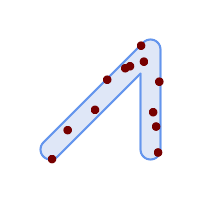
Génération d'un multipoint composé de 12 points superposés au polygone d'origine en utilisant une valeur de départ aléatoire 1996
SELECT ST_GeneratePoints(geom, 12, 1996)
FROM (
SELECT ST_Buffer(
ST_GeomFromText(
'LINESTRING(50 50,150 150,150 50)'),
10, 'endcap=round join=round') AS geom
) AS s;
Etant donné un tableau de polygones s, retourner 12 points individuels par polygone. Les résultats seront différents à chaque exécution.
SELECT s.id, dp.path[1] AS pt_id, dp.geom FROM s, ST_DumpPoints(ST_GeneratePoints(s.geom,12)) AS dp;
Voir aussi
Name
ST_GeometricMedian — Renvoie la médiane géométrique d'un MultiPoint.
Synopsis
geometry ST_GeometricMedian ( geometry geom, float8 tolerance = NULL, int max_iter = 10000, boolean fail_if_not_converged = false);
Description
Calcule la médiane géométrique approximative d'une géométrie MultiPoint à l'aide de l'algorithme de Weiszfeld. La médiane géométrique est le point qui minimise la somme des distances aux points d'entrée. Elle fournit une mesure de centralité moins sensible aux points aberrants que le centroïde (centre de masse).
L'algorithme itère jusqu'à ce que la variation de la distance entre les itérations successives soit inférieure au paramètre tolerance fourni. Si cette condition n'est pas remplie après max_iterations itérations, la fonction produit une erreur et se termine, à moins que fail_fif_not_converged ne soit fixé à false (par défaut).
Si l'argument tolerance n'est pas fourni, la valeur de la tolérance est calculée sur la base de l'étendue de la géométrie d'entrée.
Si elle est présente, les valeurs M des points d'entrée sont interprétées comme leurs poids relatifs.
Disponibilité : 2.3.0
Amélioré : 2.5.0 Ajout de la prise en charge de M comme poids des points.
 Cette fonction prend en charge la 3D et ne supprime pas l'indice z.
Cette fonction prend en charge la 3D et ne supprime pas l'indice z.
 Cette fonction prend en charge les coordonnées M.
Cette fonction prend en charge les coordonnées M.
Exemples
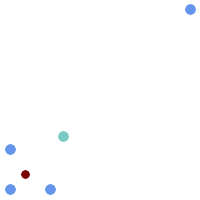
Comparaison de la médiane géométrique (rouge) et du centroïde (turquoise) d'un MultiPoint.
WITH test AS (
SELECT 'MULTIPOINT((10 10), (10 40), (40 10), (190 190))'::geometry geom)
SELECT
ST_AsText(ST_Centroid(geom)) centroid,
ST_AsText(ST_GeometricMedian(geom)) median
FROM test;
centroid | median
--------------------+----------------------------------------
POINT(62.5 62.5) | POINT(25.01778421249728 25.01778421249728)
(1 row)
Voir aussi
Name
ST_LineMerge — Renvoie les lignes formées par la couture d'une MultiLineString.
Synopsis
geometry ST_LineMerge(geometry amultilinestring);
geometry ST_LineMerge(geometry amultilinestring, boolean directed);
Description
Renvoie une LineString ou une MultiLineString formée par l'assemblage des éléments de ligne d'une MultiLineString. Les lignes sont jointes à leurs extrémités aux intersections à 2 voies. Les lignes ne sont pas jointes aux intersections à 3 voies ou plus.
Si directed est TRUE, ST_LineMerge ne modifiera pas l'ordre des points dans les LineStrings, de sorte que les lignes ayant des directions opposées ne seront pas fusionnées
![[Note]](images/note.png) | |
A n'utiliser qu'avec les MultiLineString/LineStrings. Les autres types de géométrie renvoient une GeometryCollection vide |
Effectué par le module GEOS.
Amélioration : 3.3.0 accepte un paramètre direct.
GEOS >= 3.11.0 est nécessaire pour utiliser le paramètre direct.
Disponibilité : 1.1.0
![[Warning]](images/warning.png) | |
Cette fonction supprime la dimension M. |
Exemples
Cardinality 2
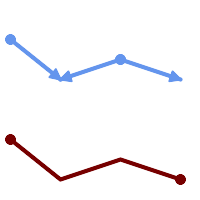
Nodes with cardinality 2 are merged away.
SELECT ST_AsText(ST_LineMerge(
'MULTILINESTRING((10 160, 60 120), (120 140, 60 120), (120 140, 180 120))'
));
--------------------------------------------
LINESTRING(10 160,60 120,120 140,180 120)
Cardinality 3 or More
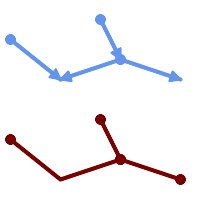
Les lignes ne sont pas fusionnées aux intersections de degré > 2.
SELECT ST_AsText(ST_LineMerge(
'MULTILINESTRING((10 160, 60 120), (120 140, 60 120), (120 140, 180 120), (100 180, 120 140))'
));
--------------------------------------------
MULTILINESTRING((10 160,60 120,120 140),(100 180,120 140),(120 140,180 120))
Non-Touching Lines
Si la fusion n'est pas possible en raison de lignes qui ne se touchent pas, la MultiLineString d'origine est renvoyée.
SELECT ST_AsText(ST_LineMerge( 'MULTILINESTRING((-29 -27,-30 -29.7,-36 -31,-45 -33),(-45.2 -33.2,-46 -32))' )); ---------------- MULTILINESTRING((-45.2 -33.2,-46 -32),(-29 -27,-30 -29.7,-36 -31,-45 -33))
Directed Parameter
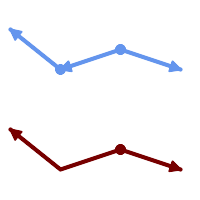
Les lignes de directions opposées ne sont pas fusionnées si directed = TRUE.
SELECT ST_AsText(ST_LineMerge( 'MULTILINESTRING((60 30, 10 70), (120 50, 60 30), (120 50, 180 30))', TRUE)); ------------------------------------------------------- MULTILINESTRING((120 50,60 30,10 70),(120 50,180 30))
Z-dimension Handling
SELECT ST_AsText(ST_LineMerge(
'MULTILINESTRING((-29 -27 11,-30 -29.7 10,-36 -31 5,-45 -33 6), (-29 -27 12,-30 -29.7 5), (-45 -33 1,-46 -32 11))'
));
---------------------------------------------------------------------------------
LINESTRING Z (-30 -29.7 5,-29 -27 11,-30 -29.7 10,-36 -31 5,-45 -33 1,-46 -32 11)
Voir aussi
Name
ST_MaximumInscribedCircle — Calcule le plus grand cercle contenu dans une géométrie.
Synopsis
(geometry, geometry, double precision) ST_MaximumInscribedCircle(geometry geom);
Description
Trouve le plus grand cercle contenu dans un (multi)polygone, ou qui ne chevauche aucune ligne ni aucun point. Renvoie un enregistrement avec des champs :
center- point central du cerclenearest- un point de la géométrie le plus proche du centreradius- rayon du cercle
Pour les entrées polygonales, le cercle est inscrit dans les anneaux de délimitation, en utilisant les anneaux internes comme limites. Pour les entrées linéaires et ponctuelles, le cercle est inscrit dans l'enveloppe convexe de l'entrée, en utilisant les lignes et les points de l'entrée comme autres limites.
Disponibilité : 3.1.0.
Nécessite GEOS >= 3.9.0.
Exemples
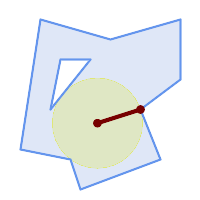
Cercle inscrit maximal d'un polygone. Le centre, le point le plus proche et le rayon sont renvoyés.
SELECT radius, ST_AsText(center) AS center, ST_AsText(nearest) AS nearest
FROM ST_MaximumInscribedCircle(
'POLYGON ((40 180, 110 160, 180 180, 180 120, 140 90, 160 40, 80 10, 70 40, 20 50, 40 180),
(60 140, 50 90, 90 140, 60 140))');
radius | center | nearest
-----------------+----------------------------+---------------
45.165845650018 | POINT(96.953125 76.328125) | POINT(140 90)
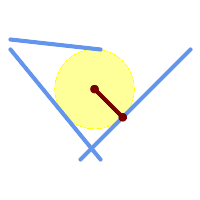
Cercle inscrit maximal d'une multiligne. Le centre, le point le plus proche et le rayon sont renvoyés.
Voir aussi
Name
ST_LargestEmptyCircle — Calcule le plus grand cercle ne recouvrant pas une géométrie.
Synopsis
(geometry, geometry, double precision) ST_LargestEmptyCircle(geometry geom, double precision tolerance=0.0, geometry boundary=POINT EMPTY);
Description
Trouve le plus grand cercle qui ne chevauche pas un ensemble d'obstacles de points et de lignes. (Les géométries polygonales peuvent être incluses en tant qu'obstacles, mais seules leurs lignes de démarcation sont utilisées). Le centre du cercle est contraint de se situer à l'intérieur d'une limite polygonale, qui par défaut est l'enveloppe convexe de la géométrie d'entrée. Le centre du cercle est le point à l'intérieur de la frontière qui est le plus éloigné des obstacles. Le cercle lui-même est fourni par le point central et un point le plus proche situé sur un obstacle déterminant le rayon du cercle.
Le centre du cercle est déterminé avec une précision donnée, spécifiée par une tolérance de distance, à l'aide d'un algorithme itératif. Si la distance de précision n'est pas spécifiée, une valeur par défaut raisonnable est utilisée.
Renvoie un enregistrement avec des champs :
center- point central du cerclenearest- un point de la géométrie le plus proche du centreradius- rayon du cercle
Pour trouver le plus grand cercle vide à l'intérieur d'un polygone, voir ST_MaximumInscribedCircle.
Disponibilité : 3.4.0.
Nécessite GEOS >= 3.9.0.
Exemples
SELECT radius,
center,
nearest
FROM ST_LargestEmptyCircle(
'MULTILINESTRING (
(10 100, 60 180, 130 150, 190 160),
(20 50, 70 70, 90 20, 110 40),
(160 30, 100 100, 180 100))');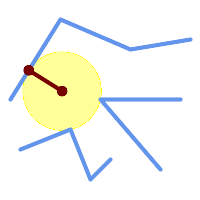
Le plus grand cercle vide à l'intérieur d'un ensemble de lignes.
SELECT radius,
center,
nearest
FROM ST_LargestEmptyCircle(
ST_Collect(
'MULTIPOINT ((70 50), (60 130), (130 150), (80 90))'::geometry,
'POLYGON ((90 190, 10 100, 60 10, 190 40, 120 100, 190 180, 90 190))'::geometry),
0,
'POLYGON ((90 190, 10 100, 60 10, 190 40, 120 100, 190 180, 90 190))'::geometry
);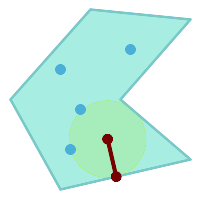
Le plus grand cercle vide à l'intérieur d'un ensemble de points, contraint à se situer dans un polygone. La limite du polygone de contrainte doit être incluse en tant qu'obstacle et spécifiée en tant que contrainte pour le centre du cercle.
Voir aussi
Name
ST_MinimumBoundingCircle — Retourne le plus petit cercle polygonal qui contient une géométrie.
Synopsis
geometry ST_MinimumBoundingCircle(geometry geomA, integer num_segs_per_qt_circ=48);
Description
Retourne le plus petit cercle polygonal qui contient une géométrie.
![[Note]](images/note.png) | |
Le cercle de délimitation est approximé par un polygone avec une valeur par défaut de 48 segments par quart de cercle. Le polygone étant une approximation du cercle de délimitation minimal, certains points de la géométrie d'entrée peuvent ne pas être contenus dans le polygone. L'approximation peut être améliorée en augmentant le nombre de segments. Pour les applications où une approximation ne convient pas, on peut utiliser ST_MinimumBoundingRadius. |
A utiliser avec ST_Collect pour obtenir le cercle minimal de délimitation d'un ensemble de géométries.
Pour calculer deux points situés sur le cercle minimum (le "diamètre maximum"), utilisez ST_LongestLine.
Le rapport de la surface d'un polygone divisée par la surface de son cercle circonscrit minimal est appelé Score de compacité de Reock.
Effectué par le module GEOS.
Disponibilité : 1.4.0
Exemples
SELECT d.disease_type,
ST_MinimumBoundingCircle(ST_Collect(d.geom)) As geom
FROM disease_obs As d
GROUP BY d.disease_type;
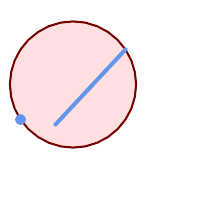
Cercle minimal de délimitation d'un point et d'une ligne de démarcation. Utilisation de 8 segments pour approximer un quart de cercle
SELECT ST_AsText(ST_MinimumBoundingCircle(
ST_Collect(
ST_GeomFromText('LINESTRING(55 75,125 150)'),
ST_Point(20, 80)), 8
)) As wktmbc;
wktmbc
-----------
POLYGON((135.59714732062 115,134.384753327498 102.690357210921,130.79416296937 90.8537670908995,124.963360620072 79.9451031602111,117.116420743937 70.3835792560632,107.554896839789 62.5366393799277,96.6462329091006 56.70583703063,84.8096427890789 53.115246672502,72.5000000000001 51.9028526793802,60.1903572109213 53.1152466725019,48.3537670908996 56.7058370306299,37.4451031602112 62.5366393799276,27.8835792560632 70.383579256063,20.0366393799278 79.9451031602109,14.20583703063 90.8537670908993,10.615246672502 102.690357210921,9.40285267938019 115,10.6152466725019 127.309642789079,14.2058370306299 139.1462329091,20.0366393799275 150.054896839789,27.883579256063 159.616420743937,
37.4451031602108 167.463360620072,48.3537670908992 173.29416296937,60.190357210921 176.884753327498,
72.4999999999998 178.09714732062,84.8096427890786 176.884753327498,96.6462329091003 173.29416296937,107.554896839789 167.463360620072,
117.116420743937 159.616420743937,124.963360620072 150.054896839789,130.79416296937 139.146232909101,134.384753327498 127.309642789079,135.59714732062 115))
Name
ST_MinimumBoundingRadius — Renvoie le point central et le rayon du plus petit cercle contenant une géométrie.
Synopsis
(geometry, double precision) ST_MinimumBoundingRadius(geometry geom);
Description
Calcule le point central et le rayon du plus petit cercle contenant une géométrie. Retourne un enregistrement avec des champs :
center- point central du cercleradius- rayon du cercle
A utiliser avec ST_Collect pour obtenir le cercle minimal de délimitation d'un ensemble de géométries.
Pour calculer deux points situés sur le cercle minimum (le "diamètre maximum"), utilisez ST_LongestLine.
Disponibilité - 2.3.0
Exemples
SELECT ST_AsText(center), radius FROM ST_MinimumBoundingRadius('POLYGON((26426 65078,26531 65242,26075 65136,26096 65427,26426 65078))');
st_astext | radius
------------------------------------------+------------------
POINT(26284.8418027133 65267.1145090825) | 247.436045591407
Voir aussi
Name
ST_OrientedEnvelope — Renvoie un rectangle de surface minimale contenant une géométrie.
Synopsis
geometry ST_OrientedEnvelope( geometry geom );
Description
Renvoie le rectangle rotatif de surface minimale entourant une géométrie. Notez qu'il peut exister plus d'un rectangle de ce type. Peut renvoyer un point ou une ligne dans le cas d'entrées dégénérées.
Disponibilité : 2.5.0.
Nécessite GEOS >= 3.6.0.
Exemples
SELECT ST_AsText(ST_OrientedEnvelope('MULTIPOINT ((0 0), (-1 -1), (3 2))'));
st_astext
------------------------------------------------
POLYGON((3 2,2.88 2.16,-1.12 -0.84,-1 -1,3 2))
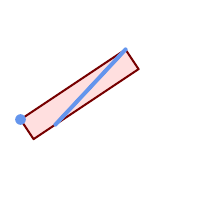
Enveloppe orientée d'un point et d'une ligne.
SELECT ST_AsText(ST_OrientedEnvelope(
ST_Collect(
ST_GeomFromText('LINESTRING(55 75,125 150)'),
ST_Point(20, 80))
)) As wktenv;
wktenv
-----------
POLYGON((19.9999999999997 79.9999999999999,33.0769230769229 60.3846153846152,138.076923076924 130.384615384616,125.000000000001 150.000000000001,19.9999999999997 79.9999999999999))
Voir aussi
Name
ST_OffsetCurve — Renvoie une ligne décalée par rapport à une distance et un côté donnés à partir d'une ligne en entrée.
Synopsis
geometry ST_OffsetCurve(geometry line, float signed_distance, text style_parameters='');
Description
Renvoie une ligne décalée par rapport à une distance et un côté donnés à partir d'une ligne en entrée. Tous les points des géométries renvoyées ne sont pas plus éloignés que la distance donnée de la géométrie d'entrée. Utile pour calculer des lignes parallèles autour d'une ligne centrale.
Pour une distance positive, le décalage se situe à gauche de la ligne d'entrée et conserve la même direction. Pour une distance négative, il se trouve sur le côté droit et dans la direction opposée.
Les unités de distance sont mesurées en unités du système de référence spatiale.
Notez que la sortie peut être un MULTILINESTRING ou un EMPTY pour certaines géométries d'entrée en forme de puzzle.
Le troisième paramètre facultatif permet de spécifier une liste de paires clé/valeur séparées par des blancs afin de modifier les opérations comme suit :
'quad_segs=#' : nombre de segments utilisés pour approximer un quart de cercle (8 par défaut).
'join=round|mitre|bevel' : style de jointure (la valeur par défaut est "round"). 'miter' est également accepté comme synonyme de 'mitre'.
'mitre_limit=#.#' : limite du rapport de "mitre" (n'affecte que le style d'assemblage "mitred"). 'miter_limit' est également accepté comme synonyme de 'mitre_limit'.
Effectué par le module GEOS.
Comportement modifié dans GEOS 3.11 de sorte que les courbes de décalage ont désormais la même direction que la ligne d'entrée, tant pour les décalages positifs que négatifs.
Disponibilité : 2.0
Amélioration : 2.5 - ajout de la prise en charge de GEOMETRYCOLLECTION et MULTILINESTRING
![[Note]](images/note.png) | |
Cette fonction ignore la dimension Z. Elle donne toujours un résultat en 2D, même lorsqu'elle est utilisée sur une géométrie en 3D. |
Exemples
Calculer une zone tampon ouverte autour des routes
SELECT ST_Union(
ST_OffsetCurve(f.geom, f.width/2, 'quad_segs=4 join=round'),
ST_OffsetCurve(f.geom, -f.width/2, 'quad_segs=4 join=round')
) as track
FROM someroadstable;
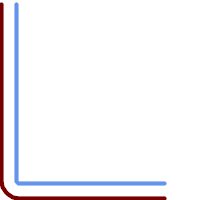 15, 'quad_segs=4 join=round' ligne originale et son décalage de 15 unités.
SELECT ST_AsText(ST_OffsetCurve(ST_GeomFromText(
'LINESTRING(164 16,144 16,124 16,104 16,84 16,64 16,
44 16,24 16,20 16,18 16,17 17,
16 18,16 20,16 40,16 60,16 80,16 100,
16 120,16 140,16 160,16 180,16 195)'),
15, 'quad_segs=4 join=round'));
output
LINESTRING(164 1,18 1,12.2597485145237 2.1418070123307,
7.39339828220179 5.39339828220179,
5.39339828220179 7.39339828220179,
2.14180701233067 12.2597485145237,1 18,1 195)
| 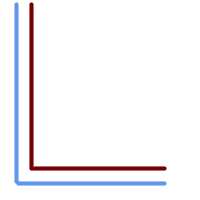 -15, 'quad_segs=4 join=round' ligne originale et son décalage de -15 unités
SELECT ST_AsText(ST_OffsetCurve(geom,
-15, 'quad_segs=4 join=round')) As notsocurvy
FROM ST_GeomFromText(
'LINESTRING(164 16,144 16,124 16,104 16,84 16,64 16,
44 16,24 16,20 16,18 16,17 17,
16 18,16 20,16 40,16 60,16 80,16 100,
16 120,16 140,16 160,16 180,16 195)') As geom;
notsocurvy
LINESTRING(31 195,31 31,164 31)
|
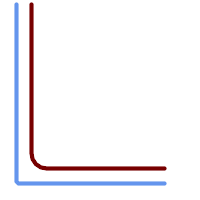 double décalage pour obtenir plus de courbes, notez que le premier inverse la direction, donc -30 + 15 = -15
SELECT ST_AsText(ST_OffsetCurve(ST_OffsetCurve(geom,
-30, 'quad_segs=4 join=round'), -15, 'quad_segs=4 join=round')) As morecurvy
FROM ST_GeomFromText(
'LINESTRING(164 16,144 16,124 16,104 16,84 16,64 16,
44 16,24 16,20 16,18 16,17 17,
16 18,16 20,16 40,16 60,16 80,16 100,
16 120,16 140,16 160,16 180,16 195)') As geom;
morecurvy
LINESTRING(164 31,46 31,40.2597485145236 32.1418070123307,
35.3933982822018 35.3933982822018,
32.1418070123307 40.2597485145237,31 46,31 195)
| 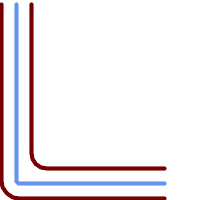 Double décalage pour obtenir des courbes plus prononcées, combiné avec le décalage régulier 15 pour obtenir des lignes parallèles. Superposition avec l'original.
SELECT ST_AsText(ST_Collect(
ST_OffsetCurve(geom, 15, 'quad_segs=4 join=round'),
ST_OffsetCurve(ST_OffsetCurve(geom,
-30, 'quad_segs=4 join=round'), -15, 'quad_segs=4 join=round')
)
) As parallel_curves
FROM ST_GeomFromText(
'LINESTRING(164 16,144 16,124 16,104 16,84 16,64 16,
44 16,24 16,20 16,18 16,17 17,
16 18,16 20,16 40,16 60,16 80,16 100,
16 120,16 140,16 160,16 180,16 195)') As geom;
parallel curves
MULTILINESTRING((164 1,18 1,12.2597485145237 2.1418070123307,
7.39339828220179 5.39339828220179,5.39339828220179 7.39339828220179,
2.14180701233067 12.2597485145237,1 18,1 195),
(164 31,46 31,40.2597485145236 32.1418070123307,35.3933982822018 35.3933982822018,
32.1418070123307 40.2597485145237,31 46,31 195))
|
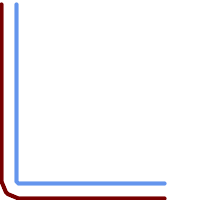 15, "quad_segs=4 join=bevel" montré avec la ligne originale
SELECT ST_AsText(ST_OffsetCurve(ST_GeomFromText(
'LINESTRING(164 16,144 16,124 16,104 16,84 16,64 16,
44 16,24 16,20 16,18 16,17 17,
16 18,16 20,16 40,16 60,16 80,16 100,
16 120,16 140,16 160,16 180,16 195)'),
15, 'quad_segs=4 join=bevel'));
output
LINESTRING(164 1,18 1,7.39339828220179 5.39339828220179,
5.39339828220179 7.39339828220179,1 18,1 195)
| 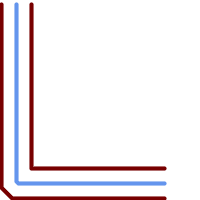 15,-15 collecté, join=mitre mitre_limit=2.1
SELECT ST_AsText(ST_Collect(
ST_OffsetCurve(geom, 15, 'quad_segs=4 join=mitre mitre_limit=2.2'),
ST_OffsetCurve(geom, -15, 'quad_segs=4 join=mitre mitre_limit=2.2')
) )
FROM ST_GeomFromText(
'LINESTRING(164 16,144 16,124 16,104 16,84 16,64 16,
44 16,24 16,20 16,18 16,17 17,
16 18,16 20,16 40,16 60,16 80,16 100,
16 120,16 140,16 160,16 180,16 195)') As geom;
output
MULTILINESTRING((164 1,11.7867965644036 1,1 11.7867965644036,1 195),
(31 195,31 31,164 31))
|
Voir aussi
Name
ST_PointOnSurface — Calcule un point dont on garantit qu'il se trouve dans un polygone ou sur une géométrie.
Synopsis
geometry ST_PointOnSurface(geometry g1);
Description
Renvoie un POINT qui est garanti de se trouver à l'intérieur d'une surface (POLYGON, MULTIPOLYGON, et CURVEPOLYGON). Dans PostGIS, cette fonction fonctionne également pour les géométries de lignes et de points.
 Cette méthode implémente la spécification OGC Simple Features Implementation Specification for SQL 1.1. s3.2.14.2 // s3.2.18.2
Cette méthode implémente la spécification OGC Simple Features Implementation Specification for SQL 1.1. s3.2.14.2 // s3.2.18.2
 Cette méthode implémente la spécification SQL/MM. SQL-MM 3: 8.1.5, 9.5.6. Les spécifications définissent ST_PointOnSurface pour les géométries de surface uniquement. PostGIS étend la fonction pour prendre en charge tous les types de géométrie courants. D'autres bases de données (Oracle, DB2, ArcSDE) semblent ne prendre en charge cette fonction que pour les surfaces. SQL Server 2008 prend en charge tous les types de géométrie courants.
Cette méthode implémente la spécification SQL/MM. SQL-MM 3: 8.1.5, 9.5.6. Les spécifications définissent ST_PointOnSurface pour les géométries de surface uniquement. PostGIS étend la fonction pour prendre en charge tous les types de géométrie courants. D'autres bases de données (Oracle, DB2, ArcSDE) semblent ne prendre en charge cette fonction que pour les surfaces. SQL Server 2008 prend en charge tous les types de géométrie courants.
 Cette fonction prend en charge la 3D et ne supprime pas l'indice z.
Cette fonction prend en charge la 3D et ne supprime pas l'indice z.
Exemples
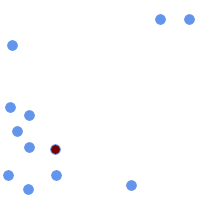 Point sur la surface d'un | 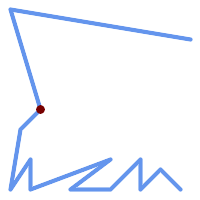 Point sur la surface d'une |
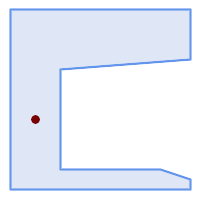 Point sur la surface d'un | 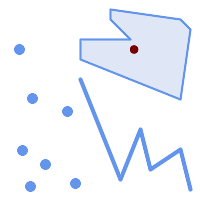 Point sur la surface d'une |
SELECT ST_AsText(ST_PointOnSurface('POINT(0 5)'::geometry));
------------
POINT(0 5)
SELECT ST_AsText(ST_PointOnSurface('LINESTRING(0 5, 0 10)'::geometry));
------------
POINT(0 5)
SELECT ST_AsText(ST_PointOnSurface('POLYGON((0 0, 0 5, 5 5, 5 0, 0 0))'::geometry));
----------------
POINT(2.5 2.5)
SELECT ST_AsEWKT(ST_PointOnSurface(ST_GeomFromEWKT('LINESTRING(0 5 1, 0 0 1, 0 10 2)')));
----------------
POINT(0 0 1)
Exemple: Le résultat de ST_PointOnSurface est garanti à l'intérieur des polygones, alors que le point calculé par ST_Centroid peut se trouver à l'extérieur.
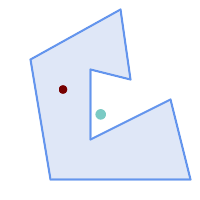
Rouge : point sur la surface ; Vert : centroïde
SELECT ST_AsText(ST_PointOnSurface(geom)) AS pt_on_surf,
ST_AsText(ST_Centroid(geom)) AS centroid
FROM (SELECT 'POLYGON ((130 120, 120 190, 30 140, 50 20, 190 20,
170 100, 90 60, 90 130, 130 120))'::geometry AS geom) AS t;
pt_on_surf | centroid
-----------------+---------------------------------------------
POINT(62.5 110) | POINT(100.18264840182648 85.11415525114155)
Voir aussi
Name
ST_Polygonize — Calcule une collection de polygones formés à partir du tracé d'un ensemble de géométries.
Synopsis
geometry ST_Polygonize(geometry set geomfield);
geometry ST_Polygonize(geometry[] geom_array);
Description
Crée une GeometryCollection contenant les polygones formés par le tracé d'un ensemble de géométries. Si le tracé en entrée ne forme aucun polygone, une GeometryCollection vide est renvoyée.
Cette fonction crée des polygones couvrant toutes les zones délimitées. Si le résultat est destiné à former une géométrie polygonale valide, utilisez ST_BuildArea pour éviter que des trous ne soient remplis.
![[Note]](images/note.png) | |
La géométrie d'entrée doit être correctement nouée pour que cette fonction fonctionne correctement. Pour s'assurer que l'entrée est nouée, utilisez ST_Node sur la géométrie d'entrée avant de la polygoniser. |
![[Note]](images/note.png) | |
Les collections de géométries peuvent être difficiles à manipuler avec des outils externes. Utilisez ST_Dump pour convertir le résultat polygonisé en polygones séparés. |
Effectué par le module GEOS.
Disponibilité : 1.0.0RC1
Exemples
 Lignes en entrée
|
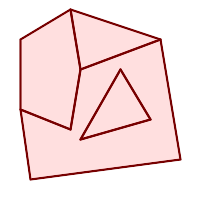 Résultat polygonisé
|
WITH data(geom) AS (VALUES
('LINESTRING (180 40, 30 20, 20 90)'::geometry)
,('LINESTRING (180 40, 160 160)'::geometry)
,('LINESTRING (80 60, 120 130, 150 80)'::geometry)
,('LINESTRING (80 60, 150 80)'::geometry)
,('LINESTRING (20 90, 70 70, 80 130)'::geometry)
,('LINESTRING (80 130, 160 160)'::geometry)
,('LINESTRING (20 90, 20 160, 70 190)'::geometry)
,('LINESTRING (70 190, 80 130)'::geometry)
,('LINESTRING (70 190, 160 160)'::geometry)
)
SELECT ST_AsText( ST_Polygonize( geom ))
FROM data;
------------------------------------------------------------------------------------------
GEOMETRYCOLLECTION (POLYGON ((180 40, 30 20, 20 90, 70 70, 80 130, 160 160, 180 40), (150 80, 120 130, 80 60, 150 80)),
POLYGON ((20 90, 20 160, 70 190, 80 130, 70 70, 20 90)),
POLYGON ((160 160, 80 130, 70 190, 160 160)),
POLYGON ((80 60, 120 130, 150 80, 80 60)))
Polygonisation d'une table de lignes :
SELECT ST_AsEWKT(ST_Polygonize(geom_4269)) As geomtextrep
FROM (SELECT geom_4269 FROM ma.suffolk_edges) As foo;
-------------------------------------
SRID=4269;GEOMETRYCOLLECTION(POLYGON((-71.040878 42.285678,-71.040943 42.2856,-71.04096 42.285752,-71.040878 42.285678)),
POLYGON((-71.17166 42.353675,-71.172026 42.354044,-71.17239 42.354358,-71.171794 42.354971,-71.170511 42.354855,
-71.17112 42.354238,-71.17166 42.353675)))
--Use ST_Dump to dump out the polygonize geoms into individual polygons
SELECT ST_AsEWKT((ST_Dump(t.polycoll)).geom) AS geomtextrep
FROM (SELECT ST_Polygonize(geom_4269) AS polycoll
FROM (SELECT geom_4269 FROM ma.suffolk_edges)
As foo) AS t;
------------------------
SRID=4269;POLYGON((-71.040878 42.285678,-71.040943 42.2856,-71.04096 42.285752,
-71.040878 42.285678))
SRID=4269;POLYGON((-71.17166 42.353675,-71.172026 42.354044,-71.17239 42.354358
,-71.171794 42.354971,-71.170511 42.354855,-71.17112 42.354238,-71.17166 42.353675))
Voir aussi
Name
ST_ReducePrecision — Renvoie une géométrie valide dont les points sont arrondis en fonction de la tolérance de la grille.
Synopsis
geometry ST_ReducePrecision(geometry g, float8 gridsize);
Description
Renvoie une géométrie valide dont tous les points sont arrondis à la tolérance de grille fournie, et dont les caractéristiques inférieures à la tolérance sont supprimées.
Contrairement à ST_SnapToGrid, la géométrie renvoyée sera valide, sans auto-intersections d'anneaux ni composants réduits.
La réduction de précision peut être utilisée pour :
faire correspondre la précision des coordonnées à la précision des données
réduire le nombre de coordonnées nécessaires pour représenter une géométrie
garantir une sortie géométrique valide vers des formats qui utilisent une précision moindre (par exemple, des formats de texte tels que WKT, GeoJSON ou KML lorsque le nombre de décimales de sortie est limité).
exporter une géométrie valide vers des systèmes qui utilisent une précision plus faible ou limitée (par exemple, SDE, valeur de tolérance Oracle)
Disponibilité : 3.1.0.
Nécessite GEOS >= 3.9.0.
Exemples
SELECT ST_AsText(ST_ReducePrecision('POINT(1.412 19.323)', 0.1));
st_astext
-----------------
POINT(1.4 19.3)
SELECT ST_AsText(ST_ReducePrecision('POINT(1.412 19.323)', 1.0));
st_astext
-------------
POINT(1 19)
SELECT ST_AsText(ST_ReducePrecision('POINT(1.412 19.323)', 10));
st_astext
-------------
POINT(0 20)
La réduction de la précision permet de réduire le nombre de sommets
SELECT ST_AsText(ST_ReducePrecision('LINESTRING (10 10, 19.6 30.1, 20 30, 20.3 30, 40 40)', 1));
st_astext
-------------
LINESTRING (10 10, 20 30, 40 40)
La réduction de la précision divise les polygones si nécessaire pour garantir la validité
SELECT ST_AsText(ST_ReducePrecision('POLYGON ((10 10, 60 60.1, 70 30, 40 40, 50 10, 10 10))', 10));
st_astext
-------------
MULTIPOLYGON (((60 60, 70 30, 40 40, 60 60)), ((40 40, 50 10, 10 10, 40 40)))
Voir aussi
Name
ST_Simplify — Renvoie une représentation simplifiée d'une géométrie, en utilisant l'algorithme de Douglas-Peucker.
Synopsis
geometry ST_Simplify(geometry geom, float tolerance);
geometry ST_Simplify(geometry geom, float tolerance, boolean preserveCollapsed);
Description
Calcule une représentation simplifiée d'une géométrie en utilisant l'algorithme Douglas-Peucker. La variable tolerance de simplification est une valeur de distance, dans les unités du SRS d'entrée. La simplification supprime les sommets dont la distance au réseau simplifié est inférieure à la distance de tolérance. Le résultat peut ne pas être valide même si l'entrée l'est.
La fonction peut être appelée avec n'importe quel type de géométrie (y compris les GeometryCollections), mais seuls les lignes et polygones sont simplifiés. Les extrémités des lignes sont préservées.
L'indicateur preserveCollapsed permet de conserver les petites géométries qui seraient autrement supprimées à la tolérance donnée. Par exemple, si une ligne de 1 m de long est simplifiée avec une tolérance de 10 m, lorsque preserveCollapsed est vrai, la ligne ne disparaîtra pas. Cette option est utile pour le rendu, afin d'éviter que de très petits éléments ne disparaissent de la carte.
![[Note]](images/note.png) | |
La géométrie renvoyée peut perdre sa simplicité (voir ST_IsSimple), la topologie peut ne pas être préservée et les résultats polygonaux peuvent être invalides (voir ST_IsValid). Utilisez ST_SimplifyPreserveTopology pour préserver la topologie et garantir la validité. |
![[Note]](images/note.png) | |
Cette fonction ne préserve pas les limites partagées entre les polygones. Utilisez ST_CoverageSimplify si cela est nécessaire. |
Disponibilité : 1.2.2
Exemples
Un cercle trop simplifié devient un triangle, moyennement un octogone,
SELECT ST_Npoints(geom) AS np_before,
ST_NPoints(ST_Simplify(geom, 0.1)) AS np01_notbadcircle,
ST_NPoints(ST_Simplify(geom, 0.5)) AS np05_notquitecircle,
ST_NPoints(ST_Simplify(geom, 1)) AS np1_octagon,
ST_NPoints(ST_Simplify(geom, 10)) AS np10_triangle,
(ST_Simplify(geom, 100) is null) AS np100_geometrygoesaway
FROM (SELECT ST_Buffer('POINT(1 3)', 10,12) As geom) AS t;
np_before | np01_notbadcircle | np05_notquitecircle | np1_octagon | np10_triangle | np100_geometrygoesaway
-----------+-------------------+---------------------+-------------+---------------+------------------------
49 | 33 | 17 | 9 | 4 | t
Simplification d'un ensemble de lignes. Les lignes peuvent s'intersecter après simplification.
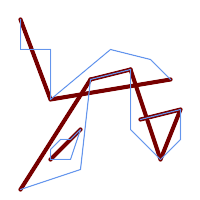
SELECT ST_Simplify(
'MULTILINESTRING ((20 180, 20 150, 50 150, 50 100, 110 150, 150 140, 170 120), (20 10, 80 30, 90 120), (90 120, 130 130), (130 130, 130 70, 160 40, 180 60, 180 90, 140 80), (50 40, 70 40, 80 70, 70 60, 60 60, 50 50, 50 40))',
40);
Simplification d'un polygone multiple. Les résultats polygonaux peuvent être invalides.
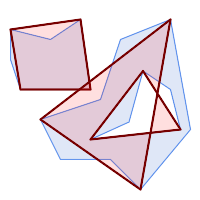
SELECT ST_Simplify(
'MULTIPOLYGON (((90 110, 80 180, 50 160, 10 170, 10 140, 20 110, 90 110)), ((40 80, 100 100, 120 160, 170 180, 190 70, 140 10, 110 40, 60 40, 40 80), (180 70, 170 110, 142.5 128.5, 128.5 77.5, 90 60, 180 70)))',
40);
Voir aussi
ST_IsSimple, ST_SimplifyPreserveTopology, ST_SimplifyVW, ST_CoverageSimplify, Topologie ST_Simplify
Name
ST_SimplifyPreserveTopology — Renvoie une représentation simplifiée et valide d'une géométrie, en utilisant l'algorithme de Douglas-Peucker.
Synopsis
geometry ST_SimplifyPreserveTopology(geometry geom, float tolerance);
Description
Calcule une représentation simplifiée d'une géométrie en utilisant une variante de l'algorithme Douglas-Peucker qui limite la simplification pour garantir que le résultat a la même topologie que l'entrée. Le paramètre de tolerance de simplification est une valeur de distance, dans les unités du SRS d'entrée. La simplification supprime les sommets dont la distance au réseau simplifiée est inférieure à la distance de tolérance, tant que la topologie est préservée. Le résultat sera valide et simple si l'entrée est.
La fonction peut être appelée avec n'importe quel type de géométrie (y compris les GeometryCollections), mais seuls les éléments linéaires et polygonaux sont simplifiés. Pour les éléments polygonaux, le résultat aura le même nombre d'anneaux (coquilles et trous), et les anneaux ne se croiseront pas. Les extrémités des anneaux peuvent être simplifiées. Pour les entrées linéaires, le résultat aura le même nombre de lignes et les lignes ne se croiseront pas si elles ne le faisaient pas dans la géométrie d'origine. Les extrémités de la géométrie linéaire sont préservées.
![[Note]](images/note.png) | |
Cette fonction ne préserve pas les limites partagées entre les polygones. Utilisez ST_CoverageSimplify si cela est nécessaire. |
Effectué par le module GEOS.
Disponibilité : 1.3.3
Exemples
Pour le même exemple que ST_Simplify, ST_SimplifyPreserveTopology empêche toute simplification excessive. Le cercle peut au maximum devenir un carré.
SELECT ST_Npoints(geom) AS np_before,
ST_NPoints(ST_SimplifyPreserveTopology(geom, 0.1)) AS np01_notbadcircle,
ST_NPoints(ST_SimplifyPreserveTopology(geom, 0.5)) AS np05_notquitecircle,
ST_NPoints(ST_SimplifyPreserveTopology(geom, 1)) AS np1_octagon,
ST_NPoints(ST_SimplifyPreserveTopology(geom, 10)) AS np10_square,
ST_NPoints(ST_SimplifyPreserveTopology(geom, 100)) AS np100_stillsquare
FROM (SELECT ST_Buffer('POINT(1 3)', 10,12) AS geom) AS t;
np_before | np01_notbadcircle | np05_notquitecircle | np1_octagon | np10_square | np100_stillsquare
-----------+-------------------+---------------------+-------------+-------------+-------------------
49 | 33 | 17 | 9 | 5 | 5
Simplification d'un ensemble de lignes, en préservant la topologie des lignes qui ne se croisent pas.
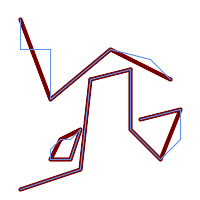
SELECT ST_SimplifyPreserveTopology(
'MULTILINESTRING ((20 180, 20 150, 50 150, 50 100, 110 150, 150 140, 170 120), (20 10, 80 30, 90 120), (90 120, 130 130), (130 130, 130 70, 160 40, 180 60, 180 90, 140 80), (50 40, 70 40, 80 70, 70 60, 60 60, 50 50, 50 40))',
40);
Simplification d'un multipolygone, en préservant la topologie des coquilles et des trous.
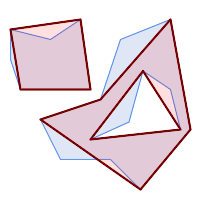
SELECT ST_SimplifyPreserveTopology(
'MULTIPOLYGON (((90 110, 80 180, 50 160, 10 170, 10 140, 20 110, 90 110)), ((40 80, 100 100, 120 160, 170 180, 190 70, 140 10, 110 40, 60 40, 40 80), (180 70, 170 110, 142.5 128.5, 128.5 77.5, 90 60, 180 70)))',
40);
Voir aussi
Name
ST_SimplifyPolygonHull — Calcule une enveloppe extérieure ou intérieure simplifiée préservant la topologie d'une géométrie polygonale.
Synopsis
geometry ST_SimplifyPolygonHull(geometry param_geom, float vertex_fraction, boolean is_outer = true);
Description
Calcule une enveloppe extérieure ou intérieure simplifiée préservant la topologie d'une géométrie polygonale. Une enveloppe extérieure couvre complètement la géométrie d'entrée. Une enveloppe intérieure est entièrement couverte par la géométrie d'entrée. Le résultat est une géométrie polygonale formée par un sous-ensemble de sommets d'entrée. Les multipolygones et les trous sont gérés et produisent un résultat ayant la même structure que la géométrie d'entrée.
La réduction du nombre de sommets est contrôlée par le paramètre vertex_fraction, qui est un nombre compris entre 0 et 1. Les valeurs inférieures produisent des résultats plus simples, avec un nombre de vertex plus faible et une concavité moindre. Pour les enveloppes extérieures et intérieures, une fraction de sommet de 1,0 produit la géométrie originale. Pour les enveloppes extérieures, une valeur de 0,0 produit l'enveloppe convexe (pour un polygone unique) ; pour les enveloppes intérieures, elle produit un triangle.
Le processus de simplification consiste à supprimer progressivement les angles concaves qui contiennent le moins de surface, jusqu'à ce que l'objectif de nombre de vertex soit atteint. Il empêche les arêtes de se croiser, de sorte que le résultat est toujours une géométrie polygonale valide.
Pour obtenir de meilleurs résultats avec des géométries contenant des segments de ligne relativement longs, il peut être nécessaire de "segmenter" l'entrée, comme indiqué ci-dessous.
Effectué par le module GEOS.
Disponibilité : 3.3.0.
Nécessite GEOS >= 3.11.0.
Exemples
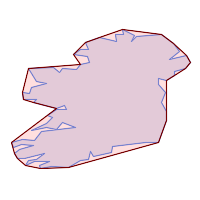
Enveloppe extérieure d'un polygone
SELECT ST_SimplifyPolygonHull(
'POLYGON ((131 158, 136 163, 161 165, 173 156, 179 148, 169 140, 186 144, 190 137, 185 131, 174 128, 174 124, 166 119, 158 121, 158 115, 165 107, 161 97, 166 88, 166 79, 158 57, 145 57, 112 53, 111 47, 93 43, 90 48, 88 40, 80 39, 68 32, 51 33, 40 31, 39 34, 49 38, 34 38, 25 34, 28 39, 36 40, 44 46, 24 41, 17 41, 14 46, 19 50, 33 54, 21 55, 13 52, 11 57, 22 60, 34 59, 41 68, 75 72, 62 77, 56 70, 46 72, 31 69, 46 76, 52 82, 47 84, 56 90, 66 90, 64 94, 56 91, 33 97, 36 100, 23 100, 22 107, 29 106, 31 112, 46 116, 36 118, 28 131, 53 132, 59 127, 62 131, 76 130, 80 135, 89 137, 87 143, 73 145, 80 150, 88 150, 85 157, 99 162, 116 158, 115 165, 123 165, 122 170, 134 164, 131 158))',
0.3);
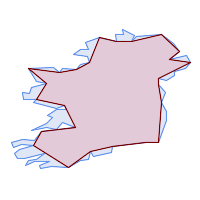
Enveloppe intérieure d'un polygone
SELECT ST_SimplifyPolygonHull(
'POLYGON ((131 158, 136 163, 161 165, 173 156, 179 148, 169 140, 186 144, 190 137, 185 131, 174 128, 174 124, 166 119, 158 121, 158 115, 165 107, 161 97, 166 88, 166 79, 158 57, 145 57, 112 53, 111 47, 93 43, 90 48, 88 40, 80 39, 68 32, 51 33, 40 31, 39 34, 49 38, 34 38, 25 34, 28 39, 36 40, 44 46, 24 41, 17 41, 14 46, 19 50, 33 54, 21 55, 13 52, 11 57, 22 60, 34 59, 41 68, 75 72, 62 77, 56 70, 46 72, 31 69, 46 76, 52 82, 47 84, 56 90, 66 90, 64 94, 56 91, 33 97, 36 100, 23 100, 22 107, 29 106, 31 112, 46 116, 36 118, 28 131, 53 132, 59 127, 62 131, 76 130, 80 135, 89 137, 87 143, 73 145, 80 150, 88 150, 85 157, 99 162, 116 158, 115 165, 123 165, 122 170, 134 164, 131 158))',
0.3, false);
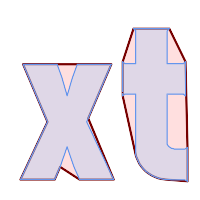
Simplification de l'enveloppe extérieure d'un MultiPolygone, avec segmentation
SELECT ST_SimplifyPolygonHull(
ST_Segmentize(ST_Letters('xt'), 2.0),
0.1);
Voir aussi
Name
ST_SimplifyVW — Renvoie une représentation simplifiée d'une géométrie, en utilisant l'algorithme de Visvalingam-Whyatt
Synopsis
geometry ST_SimplifyVW(geometry geom, float tolerance);
Description
Renvoie une représentation simplifiée d'une géométrie à l'aide de l'algorithme Visvalingam-Whyatt. La tolérance de simplification est une valeur de surface, dans les unités du SRS d'entrée. La simplification supprime les sommets qui forment des "coins" dont la surface est inférieure à la tolérance. Le résultat peut ne pas être valide même si l'entrée l'est.
La fonction peut être appelée avec n'importe quel type de géométrie (y compris les GeometryCollections), mais seuls les lignes et polygones sont simplifiés. Les extrémités des lignes sont préservées.
![[Note]](images/note.png) | |
La géométrie renvoyée peut perdre sa simplicité (voir ST_IsSimple), la topologie peut ne pas être préservée et les résultats polygonaux peuvent être invalides (voir ST_IsValid). Utilisez ST_SimplifyPreserveTopology pour préserver la topologie et garantir la validité. ST_CoverageSimplify préserve également la topologie et la validité. |
![[Note]](images/note.png) | |
Cette fonction ne préserve pas les limites partagées entre les polygones. Utilisez ST_CoverageSimplify si cela est nécessaire. |
![[Note]](images/note.png) | |
Cette fonction gère la 3D et la troisième dimension affectera le résultat. |
Disponibilité : 2.2.0
Exemples
Une LineString est simplifiée avec une tolérance de surface minimale de 30.
SELECT ST_AsText(ST_SimplifyVW(geom,30)) simplified FROM (SELECT 'LINESTRING(5 2, 3 8, 6 20, 7 25, 10 10)'::geometry AS geom) AS t; simplified ------------------------------ LINESTRING(5 2,7 25,10 10)
Simplification d'une ligne.
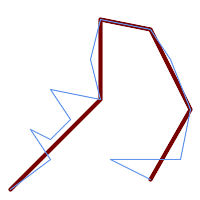
SELECT ST_SimplifyVW(
'LINESTRING (10 10, 50 40, 30 70, 50 60, 70 80, 50 110, 100 100, 90 140, 100 180, 150 170, 170 140, 190 90, 180 40, 110 40, 150 20)',
1600);
Simplification d'un polygone.
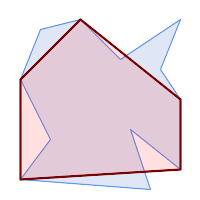
SELECT ST_SimplifyVW(
'MULTIPOLYGON (((90 110, 80 180, 50 160, 10 170, 10 140, 20 110, 90 110)), ((40 80, 100 100, 120 160, 170 180, 190 70, 140 10, 110 40, 60 40, 40 80), (180 70, 170 110, 142.5 128.5, 128.5 77.5, 90 60, 180 70)))',
40);
Voir aussi
ST_SetEffectiveArea, ST_Simplify, ST_SimplifyPreserveTopology, ST_CoverageSimplify, Topologie ST_Simplify
Name
ST_SetEffectiveArea — Définit la surface effective de chaque sommet, en utilisant l'algorithme Visvalingam-Whyatt.
Synopsis
geometry ST_SetEffectiveArea(geometry geom, float threshold = 0, integer set_area = 1);
Description
Définit la surface effective de chaque sommet, en utilisant l'algorithme Visvalingam-Whyatt. La surface effective est stockée comme la valeur M du sommet. Si le paramètre optionnel "threshold" est utilisé, une géométrie simplifiée sera renvoyée, contenant uniquement les sommets dont la surface effective est supérieure ou égale à la valeur seuil.
Cette fonction peut être utilisée pour la simplification côté serveur lorsqu'un seuil est spécifié. Une autre option consiste à utiliser une valeur seuil de zéro. Dans ce cas, la géométrie complète sera renvoyée avec les surfaces effectives sous forme de valeurs M, qui peuvent être utilisées par le client pour simplifier très rapidement.
Cette fonction n'agit qu'avec des (multi)lignes et des (multi)polygones, mais vous pouvez l'appeler en toute sécurité avec n'importe quel type de géométrie. Comme la simplification se produit objet par objet, vous pouvez également utiliser une collection de géométries dans cette fonction.
![[Note]](images/note.png) | |
Notez que la géométrie retournée peut perdre sa simplicité (voir ST_IsSimple) |
![[Note]](images/note.png) | |
Notez que la topologie peut ne pas être préservée et donner lieu à des géométries non valides. Utilisez (voir ST_SimplifyPreserveTopology) pour préserver la topologie. |
![[Note]](images/note.png) | |
La géométrie de sortie perdra toutes les informations précédentes concernant les valeurs M |
![[Note]](images/note.png) | |
Cette fonction gère la 3D et la troisième dimension affecte la surface effective |
Disponibilité : 2.2.0
Exemples
Calcul de la surface effective d'une LineString. Comme nous utilisons une valeur seuil de zéro, tous les sommets de la géométrie d'entrée sont renvoyés.
select ST_AsText(ST_SetEffectiveArea(geom)) all_pts, ST_AsText(ST_SetEffectiveArea(geom,30) ) thrshld_30
FROM (SELECT 'LINESTRING(5 2, 3 8, 6 20, 7 25, 10 10)'::geometry geom) As foo;
-result
all_pts | thrshld_30
-----------+-------------------+
LINESTRING M (5 2 3.40282346638529e+38,3 8 29,6 20 1.5,7 25 49.5,10 10 3.40282346638529e+38) | LINESTRING M (5 2 3.40282346638529e+38,7 25 49.5,10 10 3.40282346638529e+38)
Voir aussi
Name
ST_TriangulatePolygon — Calcule la triangulation de Delaunay contrainte des polygones
Synopsis
geometry ST_TriangulatePolygon(geometry geom);
Description
Calcule la triangulation de Delaunay contrainte des polygones. Les trous et les multipolygones sont pris en charge.
La "constrained Delaunay triangulation" d'un polygone est un ensemble de triangles formés à partir des sommets du polygone et le couvrant exactement, avec l'angle intérieur total maximal parmi toutes les triangulations possibles. Elle constitue la triangulation de "meilleure qualité" du polygone.
Disponibilité : 3.3.0.
Nécessite GEOS >= 3.11.0.
Exemple
Triangulation d'un carré.
SELECT ST_AsText(
ST_TriangulatePolygon('POLYGON((0 0, 0 1, 1 1, 1 0, 0 0))'));
st_astext
---------------------------------------------------------------------------
GEOMETRYCOLLECTION(POLYGON((0 0,0 1,1 1,0 0)),POLYGON((1 1,1 0,0 0,1 1)))
Exemple
Triangulation de la lettre P.
SELECT ST_AsText(ST_TriangulatePolygon(
'POLYGON ((26 17, 31 19, 34 21, 37 24, 38 29, 39 43, 39 161, 38 172, 36 176, 34 179, 30 181, 25 183, 10 185, 10 190, 100 190, 121 189, 139 187, 154 182, 167 177, 177 169, 184 161, 189 152, 190 141, 188 128, 186 123, 184 117, 180 113, 176 108, 170 104, 164 101, 151 96, 136 92, 119 89, 100 89, 86 89, 73 89, 73 39, 74 32, 75 27, 77 23, 79 20, 83 18, 89 17, 106 15, 106 10, 10 10, 10 15, 26 17), (152 147, 151 152, 149 157, 146 162, 142 166, 137 169, 132 172, 126 175, 118 177, 109 179, 99 180, 89 180, 80 179, 76 178, 74 176, 73 171, 73 100, 85 99, 91 99, 102 99, 112 100, 121 102, 128 104, 134 107, 139 110, 143 114, 147 118, 149 123, 151 128, 153 141, 152 147))'
));
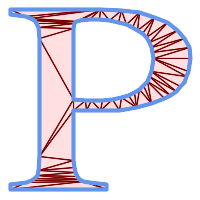
Triangulation de polygone
Même exemple que ST_Tesselate
SELECT ST_TriangulatePolygon(
'POLYGON (( 10 190, 10 70, 80 70, 80 130, 50 160, 120 160, 120 190, 10 190 ))'::geometry
);Sortie ST_AsText
GEOMETRYCOLLECTION(POLYGON((50 160,120 190,120 160,50 160))
,POLYGON((10 70,80 130,80 70,10 70))
,POLYGON((50 160,10 70,10 190,50 160))
,POLYGON((120 190,50 160,10 190,120 190))
,POLYGON((80 130,10 70,50 160,80 130)))
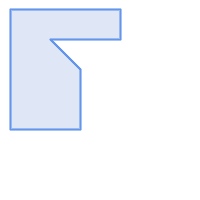 Polygone d'origine |
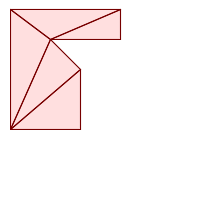 Polygone triangulé |
Name
ST_VoronoiLines — Renvoie les limites des polygones de Voronoï des sommets d'une géométrie.
Synopsis
geometry ST_VoronoiLines( geometry geom , float8 tolerance = 0.0 , geometry extend_to = NULL );
Description
Calcule un Voronoi diagram bidimensionnel à partir des sommets de la géométrie fournie et renvoie les limites entre les cellules de la représentation sous la forme d'une MultiLineString. Renvoie null si la géométrie d'entrée est null. Renvoie une collection de géométries vide si la géométrie d'entrée ne contient qu'un seul sommet. Renvoie une collection de géométries vide si l'enveloppe extend_to a une surface nulle.
Paramètres optionnels :
tolerance: distance à laquelle les sommets seront considérés comme équivalents. La robustesse de l'algorithme peut être améliorée en fournissant une distance de tolérance non nulle. (par défaut = 0.0)extend_to: S'il est présent, la représentation est étendue pour couvrir l'enveloppe de la géométrie fournie, à moins qu'elle ne soit plus petite que l'enveloppe par défaut (default = NULL, l'enveloppe par défaut est la boîte de délimitation de l'entrée élargie d'environ 50 %).
Effectué par le module GEOS.
Disponibilité : 2.3.0
Exemples
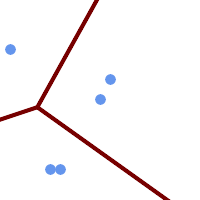
Lignes de la représentation de Voronoï, avec une tolérance de 30 unités
SELECT ST_VoronoiLines(
'MULTIPOINT (50 30, 60 30, 100 100,10 150, 110 120)'::geometry,
30) AS geom;
ST_AsText output
MULTILINESTRING((135.555555555556 270,36.8181818181818 92.2727272727273),(36.8181818181818 92.2727272727273,-110 43.3333333333333),(230 -45.7142857142858,36.8181818181818 92.2727272727273))
Voir aussi
Name
ST_VoronoiPolygons — Renvoie les cellules de la représentation de Voronoï des sommets d'une géométrie.
Synopsis
geometry ST_VoronoiPolygons( geometry geom , float8 tolerance = 0.0 , geometry extend_to = NULL );
Description
Calcule un diagramme de Voronoï bidimensionnel à partir des sommets de la géométrie fournie. Le résultat est une GEOMETRYCOLLECTION de POLYGONES qui couvre une enveloppe plus grande que l'étendue des sommets d'entrée. Renvoie null si la géométrie d'entrée est null. Renvoie une collection de géométries vide si la géométrie d'entrée ne contient qu'un seul sommet. Renvoie une collection de géométries vide si l'enveloppe extend_to a une surface nulle.
Paramètres optionnels :
tolerance: distance à laquelle les sommets seront considérés comme équivalents. La robustesse de l'algorithme peut être améliorée en fournissant une distance de tolérance non nulle. (par défaut = 0.0)extend_to: S'il est présent, la représentation est étendue pour couvrir l'enveloppe de la géométrie fournie, à moins qu'elle ne soit plus petite que l'enveloppe par défaut (default = NULL, l'enveloppe par défaut est la boîte de délimitation de l'entrée élargie d'environ 50 %).
Effectué par le module GEOS.
Disponibilité : 2.3.0
Exemples
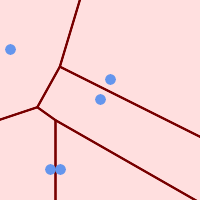
Points superposés à la représentation de Voronoï
SELECT ST_VoronoiPolygons(
'MULTIPOINT (50 30, 60 30, 100 100,10 150, 110 120)'::geometry
) AS geom;
ST_AsText output
GEOMETRYCOLLECTION(POLYGON((-110 43.3333333333333,-110 270,100.5 270,59.3478260869565 132.826086956522,36.8181818181818 92.2727272727273,-110 43.3333333333333)),
POLYGON((55 -90,-110 -90,-110 43.3333333333333,36.8181818181818 92.2727272727273,55 79.2857142857143,55 -90)),
POLYGON((230 47.5,230 -20.7142857142857,55 79.2857142857143,36.8181818181818 92.2727272727273,59.3478260869565 132.826086956522,230 47.5)),POLYGON((230 -20.7142857142857,230 -90,55 -90,55 79.2857142857143,230 -20.7142857142857)),
POLYGON((100.5 270,230 270,230 47.5,59.3478260869565 132.826086956522,100.5 270)))
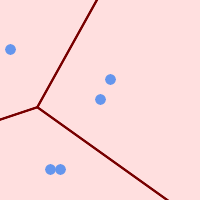
Représentation de Voronoï, avec une tolérance de 30 unités
SELECT ST_VoronoiPolygons(
'MULTIPOINT (50 30, 60 30, 100 100,10 150, 110 120)'::geometry,
30) AS geom;
ST_AsText output
GEOMETRYCOLLECTION(POLYGON((-110 43.3333333333333,-110 270,100.5 270,59.3478260869565 132.826086956522,36.8181818181818 92.2727272727273,-110 43.3333333333333)),
POLYGON((230 47.5,230 -45.7142857142858,36.8181818181818 92.2727272727273,59.3478260869565 132.826086956522,230 47.5)),POLYGON((230 -45.7142857142858,230 -90,-110 -90,-110 43.3333333333333,36.8181818181818 92.2727272727273,230 -45.7142857142858)),
POLYGON((100.5 270,230 270,230 47.5,59.3478260869565 132.826086956522,100.5 270)))
Voir aussi
7.15. Couvertures
Ces fonctions opèrent sur des ensembles de géométries polygonales qui forment des "couvertures implicites". Pour former une couverture valide, les polygones ne doivent pas se chevaucher et les sommets des arêtes adjacentes doivent correspondre exactement. Les couvertures sont rapides à traiter et peuvent être exploitées avec des fonctions window, qui conservent la topologie de la couverture à l'intérieur de la partition de la fenêtre tout en modifiant les arêtes.
- ST_CoverageInvalidEdges — Fonction window qui trouve les endroits où les polygones ne forment pas une couverture valide.
- ST_CoverageClean — Computes a clean (edge matched, non-overlapping, gap-cleared) polygonal coverage, given a non-clean input.
- ST_CoverageSimplify — Fonction window qui simplifie les bords d'une couverture polygonale.
- ST_CoverageUnion — Calcule l'union d'un ensemble de polygones formant une couverture en supprimant les arêtes communes.
Name
ST_CoverageInvalidEdges — Fonction window qui trouve les endroits où les polygones ne forment pas une couverture valide.
Synopsis
geometry ST_CoverageInvalidEdges(geometry winset geom, float8 tolerance = 0);
Description
Une fonction window qui vérifie si les polygones de la partition window forment une couverture polygonale valide. Elle renvoie des indicateurs linéaires indiquant l'emplacement des arêtes non valides (le cas échéant) dans chaque polygone.
Un ensemble de polygones valides est une couverture valide si les conditions suivantes sont remplies :
Non-overlapping - les polygones ne se chevauchent pas (leurs intérieurs ne s'intersectent pas)
Edge-Matched - les sommets situés le long d'arêtes communes sont identiques
En tant que fonction window, une valeur est renvoyée pour chaque polygone d'entrée. Pour les polygones qui ne respectent pas une ou plusieurs des conditions de validité, la valeur renvoyée est un MULTILINESTRING contenant les arêtes problématiques. Les polygones valides du point de vue de la couverture renvoient la valeur NULL. Les géométries non polygonales ou vides produisent également des valeurs NULL.
Les conditions permettent à une couverture valide de contenir des trous (espaces entre les polygones), pour autant que les polygones environnants soient adaptés aux bords. Toutefois, des espaces très étroits ne sont souvent pas souhaitables. Si le paramètre tolérance est spécifié avec une distance non nulle, les arêtes formant des espaces plus étroits seront également renvoyées comme non valides.
Les polygones dont la validité de la couverture est vérifiée doivent également être des géométries valides. Ceci peut être vérifié avec ST_IsValid.
Disponibilité : 3.4.0
Nécessite GEOS >= 3.12.0
Exemples
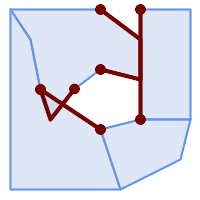
Arêtes non valides dues au chevauchement et à la non-concordance des sommets
WITH coverage(id, geom) AS (VALUES
(1, 'POLYGON ((10 190, 30 160, 40 110, 100 70, 120 10, 10 10, 10 190))'::geometry),
(2, 'POLYGON ((100 190, 10 190, 30 160, 40 110, 50 80, 74 110.5, 100 130, 140 120, 140 160, 100 190))'::geometry),
(3, 'POLYGON ((140 190, 190 190, 190 80, 140 80, 140 190))'::geometry),
(4, 'POLYGON ((180 40, 120 10, 100 70, 140 80, 190 80, 180 40))'::geometry)
)
SELECT id, ST_AsText(ST_CoverageInvalidEdges(geom) OVER ())
FROM coverage;
id | st_astext
----+---------------------------------------
1 | LINESTRING (40 110, 100 70)
2 | MULTILINESTRING ((100 130, 140 120, 140 160, 100 190), (40 110, 50 80, 74 110.5))
3 | LINESTRING (140 80, 140 190)
4 | null
-- Test entire table for coverage validity
SELECT true = ALL (
SELECT ST_CoverageInvalidEdges(geom) OVER () IS NULL
FROM coverage
);
Voir aussi
ST_IsValid, ST_CoverageUnion, ST_CoverageClean, ST_CoverageSimplify
Name
ST_CoverageClean — Computes a clean (edge matched, non-overlapping, gap-cleared) polygonal coverage, given a non-clean input.
Synopsis
geometry ST_CoverageClean(geometry winset geom, float8 gapMaximumWidth = 0, float8 snappingDistance = -1, text overlapMergeStrategy = 'MERGE_LONGEST_BORDER');
Description
A window function which adjusts the edges of a set of valid polygonal geometries to produce a clean coverage. Cleaning involves:
snapping vertices and edges to remove small discrepancies and ensure common edges are identically noded
merging overlaps into a parent polygon
merging narrow gaps into adjacent polygons
gapMaximumWidth controls which gaps between polygons are merged. Gaps with width <= this distance are merged into an adjacent polygon.
snappingDistance controls snapping of vertices and edges. The default (-1) automatically determines a snapping distance based on the input extent. Set to 0.0 to turn off snapping.
overlapMergeStrategy specifies how overlaps are merged into a parent polygon:
MERGE_LONGEST_BORDER- merges into polygon with longest common borderMERGE_MAX_AREA- merges into polygon with maximum areaMERGE_MIN_AREA- merges into polygon with minimum areaMERGE_MIN_INDEX- merges into polygon with smallest input index (defined by order of input polygons)
The result is a clean polygonal coverage that will pass validation by ST_CoverageInvalidEdges and can be input to coverage processing functions.
![[Note]](images/note.png) | |
To aid in determining a maximum gap width, gaps can be computed by cleaning with |
Availability: 3.6.0 - requires GEOS >= 3.14.0
Exemples
-- Populate input table CREATE TABLE example AS SELECT * FROM (VALUES (1, 'POLYGON ((10 190, 30 160, 27 134.5, 40 110, 122 47, 120 10, 10 10, 10 190))'::geometry), (2, 'POLYGON ((150 190, 10 190, 30 160, 50 140, 40 110, 50 80, 130 70, 135 111, 140 130, 140 160, 150 190))'::geometry), (3, 'POLYGON ((140 190, 190 190, 190 80, 140 80, 140 190))'::geometry), (4, 'POLYGON ((190 10, 120 10, 97 77, 160 90, 170 70, 190 80, 190 10))'::geometry) ) AS v(id, geom);

Polygons with overlaps and gaps
-- Show it is an invalid coverage SELECT ST_AsText(ST_CoverageInvalidEdges(geom) OVER ()) FROM example;

Invalid coverage edges
-- Clean the coverage, merging gaps with width <= 1 CREATE TABLE example_clean AS SELECT id, ST_CoverageClean(geom, 1) OVER () AS GEOM FROM example;

Clean polygonal coverage, with overlaps and narrow gaps removed
Name
ST_CoverageSimplify — Fonction window qui simplifie les bords d'une couverture polygonale.
Synopsis
geometry ST_CoverageSimplify(geometry winset geom, float8 tolerance, boolean simplifyBoundary = true);
Description
Une fonction window qui simplifie les bords des polygones dans une couverture polygonale. La simplification préserve la topologie de la couverture. Cela signifie que les polygones de sortie simplifiés sont cohérents le long des arêtes communes et forment toujours une couverture valide.
La simplification utilise une variante de l'algorithme Visvalingam-Whyatt. Le paramètre tolérance a des unités de distance et est approximativement égal à la racine carrée des zones triangulaires à simplifier.
Pour simplifier uniquement les bords "internes" de la couverture (ceux qui sont partagés par deux polygones), définissez le paramètre simplifyBoundary à false.
![[Note]](images/note.png) | |
Si l'entrée n'est pas une couverture valide, il peut y avoir des artefacts inattendus dans la sortie (tels que des intersections de frontières, ou des frontières séparées qui semblaient être partagées). Utilisez ST_CoverageInvalidEdges pour déterminer si une couverture est valide. |
Disponibilité : 3.4.0
Nécessite GEOS >= 3.12.0
Exemples
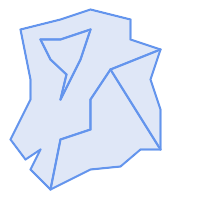 Couverture d'entrée
|
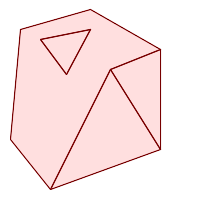 Couverture simplifiée
|
WITH coverage(id, geom) AS (VALUES
(1, 'POLYGON ((160 150, 110 130, 90 100, 90 70, 60 60, 50 10, 30 30, 40 50, 25 40, 10 60, 30 100, 30 120, 20 170, 60 180, 90 190, 130 180, 130 160, 160 150), (40 160, 50 140, 66 125, 60 100, 80 140, 90 170, 60 160, 40 160))'::geometry),
(2, 'POLYGON ((40 160, 60 160, 90 170, 80 140, 60 100, 66 125, 50 140, 40 160))'::geometry),
(3, 'POLYGON ((110 130, 160 50, 140 50, 120 33, 90 30, 50 10, 60 60, 90 70, 90 100, 110 130))'::geometry),
(4, 'POLYGON ((160 150, 150 120, 160 90, 160 50, 110 130, 160 150))'::geometry)
)
SELECT id, ST_AsText(ST_CoverageSimplify(geom, 30) OVER ())
FROM coverage;
id | st_astext
----+---------------------------------------
1 | POLYGON ((160 150, 110 130, 50 10, 10 60, 20 170, 90 190, 160 150), (40 160, 66 125, 90 170, 40 160))
2 | POLYGON ((40 160, 66 125, 90 170, 40 160))
3 | POLYGON ((110 130, 160 50, 50 10, 110 130))
4 | POLYGON ((160 150, 160 50, 110 130, 160 150))
Voir aussi
Name
ST_CoverageUnion — Calcule l'union d'un ensemble de polygones formant une couverture en supprimant les arêtes communes.
Synopsis
geometry ST_CoverageUnion(geometry set geom);
Description
Une fonction agrégée qui réunit un ensemble de polygones formant une couverture polygonale. Le résultat est une géométrie polygonale couvrant la même zone que la couverture. Cette fonction produit le même résultat que ST_Union, mais utilise la structure de la couverture pour calculer l'union beaucoup plus rapidement.
![[Note]](images/note.png) | |
Si l'entrée n'est pas une couverture valide, il peut y avoir des artefacts inattendus dans la sortie (tels que des polygones non fusionnés ou se chevauchant). Utilisez ST_CoverageInvalidEdges pour déterminer si une couverture est valide. |
Disponibilité : 3.4.0 - nécessite GEOS >= 3.8.0
Exemples
 Couverture d'entrée
|
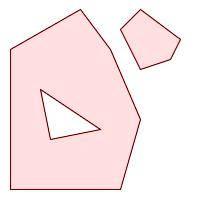 Résultat de l'union
|
WITH coverage(id, geom) AS (VALUES
(1, 'POLYGON ((10 10, 10 150, 80 190, 110 150, 90 110, 40 110, 50 60, 10 10))'::geometry),
(2, 'POLYGON ((120 10, 10 10, 50 60, 100 70, 120 10))'::geometry),
(3, 'POLYGON ((140 80, 120 10, 100 70, 40 110, 90 110, 110 150, 140 80))'::geometry),
(4, 'POLYGON ((140 190, 120 170, 140 130, 160 150, 140 190))'::geometry),
(5, 'POLYGON ((180 160, 170 140, 140 130, 160 150, 140 190, 180 160))'::geometry)
)
SELECT ST_AsText(ST_CoverageUnion(geom))
FROM coverage;
--------------------------------------
MULTIPOLYGON (((10 150, 80 190, 110 150, 140 80, 120 10, 10 10, 10 150), (50 60, 100 70, 40 110, 50 60)), ((120 170, 140 190, 180 160, 170 140, 140 130, 120 170)))
7.16. Transformations affines
Ces fonctions modifient la position et la forme des géométries à l'aide de transformations affines.
- ST_Affine — Appliquer une transformation affine 3D à une géométrie.
- ST_Rotate — Fait pivoter une géométrie autour d'un point d'origine.
- ST_RotateX — Fait pivoter une géométrie autour de l'axe X.
- ST_RotateY — Fait pivoter une géométrie autour de l'axe Y.
- ST_RotateZ — Fait pivoter une géométrie autour de l'axe Z.
- ST_Scale — Met à l'échelle une géométrie en fonction de facteurs donnés.
- ST_Translate — Traduit une géométrie en fonction de décalages donnés.
- ST_TransScale — Traduit et met à l'échelle une géométrie en fonction des paramètres offset et factor spécifiés.
Name
ST_Affine — Appliquer une transformation affine 3D à une géométrie.
Synopsis
geometry ST_Affine(geometry geomA, float a, float b, float c, float d, float e, float f, float g, float h, float i, float xoff, float yoff, float zoff);
geometry ST_Affine(geometry geomA, float a, float b, float d, float e, float xoff, float yoff);
Description
Applique une transformation affine 3D à la géométrie pour effectuer des opérations telles que la translation, la rotation et la mise à l'échelle en une seule étape.
Version 1: L'appel
ST_Affine(geom, a, b, c, d, e, f, g, h, i, xoff, yoff, zoff)
représente la matrice de transformation
/ a b c xoff \ | d e f yoff | | g h i zoff | \ 0 0 0 1 /
et les sommets sont transformés comme suit :
x' = a*x + b*y + c*z + xoff y' = d*x + e*y + f*z + yoff z' = g*x + h*y + i*z + zoff
Toutes les fonctions de translation / mise à l'échelle ci-dessous sont exprimées par une telle transformation affine.
Version 2: Applique une transformation affine 2d à la géométrie. L'appel
ST_Affine(geom, a, b, d, e, xoff, yoff)
représente la matrice de transformation
/ a b 0 xoff \ / a b xoff \ | d e 0 yoff | rsp. | d e yoff | | 0 0 1 0 | \ 0 0 1 / \ 0 0 0 1 /
et les sommets sont transformés comme suit :
x' = a*x + b*y + xoff y' = d*x + e*y + yoff z' = z
Cette méthode est un sous-cas de la méthode 3D ci-dessus.
Amélioration : 2.0.0 introduction du support TIN, Triangles et surfaces polyédriques.
Disponibilité : 1.1.2. Le nom a été changé de Affine à ST_Affine dans la version 1.2.2
![[Note]](images/note.png) | |
Avant la version 1.3.4, cette fonction se bloquait si elle était utilisée avec des géométries contenant des CURVES. Ce problème est corrigé dans la version 1.3.4+ |
 Cette fonction prend en charge les surfaces Polyhedral.
Cette fonction prend en charge les surfaces Polyhedral.
 Cette fonction prend en charge les triangles et les réseaux irréguliers triangulés (TIN).
Cette fonction prend en charge les triangles et les réseaux irréguliers triangulés (TIN).
 Cette fonction prend en charge la 3D et ne supprime pas l'indice z.
Cette fonction prend en charge la 3D et ne supprime pas l'indice z.
 Cette méthode prend en charge les types Circular String et Curve.
Cette méthode prend en charge les types Circular String et Curve.
Exemples
--Rotate a 3d line 180 degrees about the z axis. Note this is long-hand for doing ST_Rotate();
SELECT ST_AsEWKT(ST_Affine(geom, cos(pi()), -sin(pi()), 0, sin(pi()), cos(pi()), 0, 0, 0, 1, 0, 0, 0)) As using_affine,
ST_AsEWKT(ST_Rotate(geom, pi())) As using_rotate
FROM (SELECT ST_GeomFromEWKT('LINESTRING(1 2 3, 1 4 3)') As geom) As foo;
using_affine | using_rotate
-----------------------------+-----------------------------
LINESTRING(-1 -2 3,-1 -4 3) | LINESTRING(-1 -2 3,-1 -4 3)
(1 row)
--Rotate a 3d line 180 degrees in both the x and z axis
SELECT ST_AsEWKT(ST_Affine(geom, cos(pi()), -sin(pi()), 0, sin(pi()), cos(pi()), -sin(pi()), 0, sin(pi()), cos(pi()), 0, 0, 0))
FROM (SELECT ST_GeomFromEWKT('LINESTRING(1 2 3, 1 4 3)') As geom) As foo;
st_asewkt
-------------------------------
LINESTRING(-1 -2 -3,-1 -4 -3)
(1 row)
Voir aussi
Name
ST_Rotate — Fait pivoter une géométrie autour d'un point d'origine.
Synopsis
geometry ST_Rotate(geometry geomA, float rotRadians);
geometry ST_Rotate(geometry geomA, float rotRadians, float x0, float y0);
geometry ST_Rotate(geometry geomA, float rotRadians, geometry pointOrigin);
Description
Fait pivoter la géométrie rotRadians dans le sens inverse des aiguilles d'une montre autour du point d'origine. Le point d'origine de la rotation peut être spécifié sous la forme d'une géométrie POINT, ou sous la forme de coordonnées x et y. Si l'origine n'est pas spécifiée, la géométrie est tournée autour de POINT(0 0).
Amélioration : 2.0.0 introduction du support TIN, Triangles et surfaces polyédriques.
Amélioration : 2.0.0 des paramètres supplémentaires ont été ajoutés pour spécifier l'origine de la rotation.
Disponibilité : 1.1.2. Nom modifié de Rotate en ST_Rotate dans la version 1.2.2
 Cette fonction prend en charge la 3D et ne supprime pas l'indice z.
Cette fonction prend en charge la 3D et ne supprime pas l'indice z.
 Cette méthode prend en charge les types Circular String et Curve.
Cette méthode prend en charge les types Circular String et Curve.
 Cette fonction prend en charge les surfaces Polyhedral.
Cette fonction prend en charge les surfaces Polyhedral.
 Cette fonction prend en charge les triangles et les réseaux irréguliers triangulés (TIN).
Cette fonction prend en charge les triangles et les réseaux irréguliers triangulés (TIN).
Exemples
--Rotate 180 degrees
SELECT ST_AsEWKT(ST_Rotate('LINESTRING (50 160, 50 50, 100 50)', pi()));
st_asewkt
---------------------------------------
LINESTRING(-50 -160,-50 -50,-100 -50)
(1 row)
--Rotate 30 degrees counter-clockwise at x=50, y=160
SELECT ST_AsEWKT(ST_Rotate('LINESTRING (50 160, 50 50, 100 50)', pi()/6, 50, 160));
st_asewkt
---------------------------------------------------------------------------
LINESTRING(50 160,105 64.7372055837117,148.301270189222 89.7372055837117)
(1 row)
--Rotate 60 degrees clockwise from centroid
SELECT ST_AsEWKT(ST_Rotate(geom, -pi()/3, ST_Centroid(geom)))
FROM (SELECT 'LINESTRING (50 160, 50 50, 100 50)'::geometry AS geom) AS foo;
st_asewkt
--------------------------------------------------------------
LINESTRING(116.4225 130.6721,21.1597 75.6721,46.1597 32.3708)
(1 row)
Voir aussi
Name
ST_RotateX — Fait pivoter une géométrie autour de l'axe X.
Synopsis
geometry ST_RotateX(geometry geomA, float rotRadians);
Description
Fait pivoter une géométrie geomA - rotRadians autour de l'axe X.
![[Note]](images/note.png) | |
|
Amélioration : 2.0.0 introduction du support TIN, Triangles et surfaces polyédriques.
Disponibilité : 1.1.2. Nom modifié de RotateX en ST_RotateX dans la version 1.2.2
 Cette fonction prend en charge les surfaces Polyhedral.
Cette fonction prend en charge les surfaces Polyhedral.
 Cette fonction prend en charge la 3D et ne supprime pas l'indice z.
Cette fonction prend en charge la 3D et ne supprime pas l'indice z.
 Cette fonction prend en charge les triangles et les réseaux irréguliers triangulés (TIN).
Cette fonction prend en charge les triangles et les réseaux irréguliers triangulés (TIN).
Exemples
--Rotate a line 90 degrees along x-axis
SELECT ST_AsEWKT(ST_RotateX(ST_GeomFromEWKT('LINESTRING(1 2 3, 1 1 1)'), pi()/2));
st_asewkt
---------------------------
LINESTRING(1 -3 2,1 -1 1)
Voir aussi
Name
ST_RotateY — Fait pivoter une géométrie autour de l'axe Y.
Synopsis
geometry ST_RotateY(geometry geomA, float rotRadians);
Description
Fait pivoter une géométrie geomA - rotRadians autour de l'axe y.
![[Note]](images/note.png) | |
|
Disponibilité : 1.1.2. Nom modifié de RotateY en ST_RotateY dans la version 1.2.2
Amélioration : 2.0.0 introduction du support TIN, Triangles et surfaces polyédriques.
 Cette fonction prend en charge les surfaces Polyhedral.
Cette fonction prend en charge les surfaces Polyhedral.
 Cette fonction prend en charge la 3D et ne supprime pas l'indice z.
Cette fonction prend en charge la 3D et ne supprime pas l'indice z.
 Cette fonction prend en charge les triangles et les réseaux irréguliers triangulés (TIN).
Cette fonction prend en charge les triangles et les réseaux irréguliers triangulés (TIN).
Exemples
--Rotate a line 90 degrees along y-axis
SELECT ST_AsEWKT(ST_RotateY(ST_GeomFromEWKT('LINESTRING(1 2 3, 1 1 1)'), pi()/2));
st_asewkt
---------------------------
LINESTRING(3 2 -1,1 1 -1)
Voir aussi
Name
ST_RotateZ — Fait pivoter une géométrie autour de l'axe Z.
Synopsis
geometry ST_RotateZ(geometry geomA, float rotRadians);
Description
Fait pivoter une géométrie geomA - rotRadians autour de l'axe Z.
![[Note]](images/note.png) | |
C'est un synonyme de ST_Rotate |
![[Note]](images/note.png) | |
|
Amélioration : 2.0.0 introduction du support TIN, Triangles et surfaces polyédriques.
Disponibilité : 1.1.2. Nom modifié de RotateZ en ST_RotateZ dans la version 1.2.2
![[Note]](images/note.png) | |
Avant la version 1.3.4, cette fonction se bloquait si elle était utilisée avec des géométries contenant des CURVES. Ce problème est corrigé dans la version 1.3.4+ |
 Cette fonction prend en charge la 3D et ne supprime pas l'indice z.
Cette fonction prend en charge la 3D et ne supprime pas l'indice z.
 Cette méthode prend en charge les types Circular String et Curve.
Cette méthode prend en charge les types Circular String et Curve.
 Cette fonction prend en charge les surfaces Polyhedral.
Cette fonction prend en charge les surfaces Polyhedral.
 Cette fonction prend en charge les triangles et les réseaux irréguliers triangulés (TIN).
Cette fonction prend en charge les triangles et les réseaux irréguliers triangulés (TIN).
Exemples
--Rotate a line 90 degrees along z-axis
SELECT ST_AsEWKT(ST_RotateZ(ST_GeomFromEWKT('LINESTRING(1 2 3, 1 1 1)'), pi()/2));
st_asewkt
---------------------------
LINESTRING(-2 1 3,-1 1 1)
--Rotate a curved circle around z-axis
SELECT ST_AsEWKT(ST_RotateZ(geom, pi()/2))
FROM (SELECT ST_LineToCurve(ST_Buffer(ST_GeomFromText('POINT(234 567)'), 3)) As geom) As foo;
st_asewkt
----------------------------------------------------------------------------------------------------------------------------
CURVEPOLYGON(CIRCULARSTRING(-567 237,-564.87867965644 236.12132034356,-564 234,-569.12132034356 231.87867965644,-567 237))
Voir aussi
Name
ST_Scale — Met à l'échelle une géométrie en fonction de facteurs donnés.
Synopsis
geometry ST_Scale(geometry geomA, float XFactor, float YFactor, float ZFactor);
geometry ST_Scale(geometry geomA, float XFactor, float YFactor);
geometry ST_Scale(geometry geom, geometry factor);
geometry ST_Scale(geometry geom, geometry factor, geometry origin);
Description
Met la géométrie à l'échelle en multipliant les ordonnées par les paramètres factor correspondants.
La version prenant une géométrie comme paramètre factor permet de passer un point 2d, 3dm, 3dz ou 4d pour définir le facteur d'échelle pour toutes les dimensions prises en charge. Les dimensions manquantes dans le point factor sont équivalentes à l'absence de mise à l'échelle de la dimension correspondante.
La variante à trois géométries permet de transmettre une "fausse origine" pour la mise à l'échelle. Cela permet une "mise à l'échelle sur place", par exemple en utilisant le centroïde de la géométrie comme fausse origine. Sans fausse origine, la mise à l'échelle s'effectue par rapport à l'origine réelle, de sorte que toutes les coordonnées sont simplement multipliées par le facteur d'échelle.
![[Note]](images/note.png) | |
Avant la version 1.3.4, cette fonction se bloquait si elle était utilisée avec des géométries contenant des CURVES. Ce problème est corrigé dans la version 1.3.4+ |
Disponibilité : 1.1.0.
Amélioration : 2.0.0 introduction du support TIN, Triangles et surfaces polyédriques.
Amélioration : La prise en charge de la mise à l'échelle de toutes les dimensions (paramètre factor) a été introduite dans la version 2.2.0.
Amélioration : la prise en charge de la mise à l'échelle par rapport à une origine locale (paramètre origin) a été introduite dans la version 2.5.0.
 Cette fonction prend en charge les surfaces Polyhedral.
Cette fonction prend en charge les surfaces Polyhedral.
 Cette fonction prend en charge la 3D et ne supprime pas l'indice z.
Cette fonction prend en charge la 3D et ne supprime pas l'indice z.
 Cette méthode prend en charge les types Circular String et Curve.
Cette méthode prend en charge les types Circular String et Curve.
 Cette fonction prend en charge les triangles et les réseaux irréguliers triangulés (TIN).
Cette fonction prend en charge les triangles et les réseaux irréguliers triangulés (TIN).
 Cette fonction prend en charge les coordonnées M.
Cette fonction prend en charge les coordonnées M.
Exemples
--Version 1: scale X, Y, Z
SELECT ST_AsEWKT(ST_Scale(ST_GeomFromEWKT('LINESTRING(1 2 3, 1 1 1)'), 0.5, 0.75, 0.8));
st_asewkt
--------------------------------------
LINESTRING(0.5 1.5 2.4,0.5 0.75 0.8)
--Version 2: Scale X Y
SELECT ST_AsEWKT(ST_Scale(ST_GeomFromEWKT('LINESTRING(1 2 3, 1 1 1)'), 0.5, 0.75));
st_asewkt
----------------------------------
LINESTRING(0.5 1.5 3,0.5 0.75 1)
--Version 3: Scale X Y Z M
SELECT ST_AsEWKT(ST_Scale(ST_GeomFromEWKT('LINESTRING(1 2 3 4, 1 1 1 1)'),
ST_MakePoint(0.5, 0.75, 2, -1)));
st_asewkt
----------------------------------------
LINESTRING(0.5 1.5 6 -4,0.5 0.75 2 -1)
--Version 4: Scale X Y using false origin
SELECT ST_AsText(ST_Scale('LINESTRING(1 1, 2 2)', 'POINT(2 2)', 'POINT(1 1)'::geometry));
st_astext
---------------------
LINESTRING(1 1,3 3)
Voir aussi
Name
ST_Translate — Traduit une géométrie en fonction de décalages donnés.
Synopsis
geometry ST_Translate(geometry g1, float deltax, float deltay);
geometry ST_Translate(geometry g1, float deltax, float deltay, float deltaz);
Description
Renvoie une nouvelle géométrie dont les coordonnées sont des unités de translation delta x,delta y,delta z. Les unités sont basées sur les unités définies dans la référence spatiale (SRID) pour cette géométrie. Les unités sont basées sur les unités définies dans la référence spatiale (SRID) pour cette géométrie.
![[Note]](images/note.png) | |
Avant la version 1.3.4, cette fonction se bloquait si elle était utilisée avec des géométries contenant des CURVES. Ce problème est corrigé dans la version 1.3.4+ |
Disponibilité : 1.2.2
 Cette fonction prend en charge la 3D et ne supprime pas l'indice z.
Cette fonction prend en charge la 3D et ne supprime pas l'indice z.
 Cette méthode prend en charge les types Circular String et Curve.
Cette méthode prend en charge les types Circular String et Curve.
Exemples
Déplacer un point de 1 degré de longitude
SELECT ST_AsText(ST_Translate(ST_GeomFromText('POINT(-71.01 42.37)',4326),1,0)) As wgs_transgeomtxt;
wgs_transgeomtxt
---------------------
POINT(-70.01 42.37)
Déplacer une ligne d'un degré de longitude et d'un demi-degré de latitude
SELECT ST_AsText(ST_Translate(ST_GeomFromText('LINESTRING(-71.01 42.37,-71.11 42.38)',4326),1,0.5)) As wgs_transgeomtxt;
wgs_transgeomtxt
---------------------------------------
LINESTRING(-70.01 42.87,-70.11 42.88)
Déplacer un point 3D
SELECT ST_AsEWKT(ST_Translate(CAST('POINT(0 0 0)' As geometry), 5, 12,3));
st_asewkt
---------
POINT(5 12 3)
Déplacer une courbe et un point
SELECT ST_AsText(ST_Translate(ST_Collect('CURVEPOLYGON(CIRCULARSTRING(4 3,3.12 0.878,1 0,-1.121 5.1213,6 7, 8 9,4 3))','POINT(1 3)'),1,2));
st_astext
------------------------------------------------------------------------------------------------------------
GEOMETRYCOLLECTION(CURVEPOLYGON(CIRCULARSTRING(5 5,4.12 2.878,2 2,-0.121 7.1213,7 9,9 11,5 5)),POINT(2 5))
Voir aussi
Name
ST_TransScale — Traduit et met à l'échelle une géométrie en fonction des paramètres offset et factor spécifiés.
Synopsis
geometry ST_TransScale(geometry geomA, float deltaX, float deltaY, float XFactor, float YFactor);
Description
Traduit la géométrie à l'aide des paramètres deltaX et deltaY, puis la met à l'échelle à l'aide des paramètres XFactor et YFactor, uniquement en 2D.
![[Note]](images/note.png) | |
|
![[Note]](images/note.png) | |
Avant la version 1.3.4, cette fonction se bloquait si elle était utilisée avec des géométries contenant des CURVES. Ce problème est corrigé dans la version 1.3.4+ |
Disponibilité : 1.1.0.
 Cette fonction prend en charge la 3D et ne supprime pas l'indice z.
Cette fonction prend en charge la 3D et ne supprime pas l'indice z.
 Cette méthode prend en charge les types Circular String et Curve.
Cette méthode prend en charge les types Circular String et Curve.
Exemples
SELECT ST_AsEWKT(ST_TransScale(ST_GeomFromEWKT('LINESTRING(1 2 3, 1 1 1)'), 0.5, 1, 1, 2));
st_asewkt
-----------------------------
LINESTRING(1.5 6 3,1.5 4 1)
--Buffer a point to get an approximation of a circle, convert to curve and then translate 1,2 and scale it 3,4
SELECT ST_AsText(ST_Transscale(ST_LineToCurve(ST_Buffer('POINT(234 567)', 3)),1,2,3,4));
st_astext
------------------------------------------------------------------------------------------------------------------------------
CURVEPOLYGON(CIRCULARSTRING(714 2276,711.363961030679 2267.51471862576,705 2264,698.636038969321 2284.48528137424,714 2276))
Voir aussi
7.17. Fonctions de clustering
Ces fonctions mettent en œuvre des algorithmes de regroupement pour des ensembles de géométries.
- ST_ClusterDBSCAN — Fonction Window qui renvoie un identifiant de cluster pour chaque géométrie d'entrée en utilisant l'algorithme DBSCAN.
- ST_ClusterIntersecting — Fonction d'agrégation qui regroupe les géométries en entrée en ensembles connectés.
- ST_ClusterIntersectingWin — Fonction Window qui renvoie un identifiant de cluster pour chaque géométrie en entrée, en regroupant les géométries en entrée en ensembles connectés.
- ST_ClusterKMeans — Fonction Window qui renvoie un identifiant de cluster pour chaque géométrie en entrée en utilisant l'algorithme K-means.
- ST_ClusterWithin — Fonction agrégée qui regroupe les géométries en fonction de la distance de séparation.
- ST_ClusterWithinWin — Fonction Window qui renvoie un identifiant de cluster pour chaque géométrie en entrée, regroupement en utilisant la distance de séparation.
Name
ST_ClusterDBSCAN — Fonction Window qui renvoie un identifiant de cluster pour chaque géométrie d'entrée en utilisant l'algorithme DBSCAN.
Synopsis
integer ST_ClusterDBSCAN(geometry winset geom, float8 eps, integer minpoints);
Description
Une fonction window qui renvoie un numéro de cluster pour chaque géométrie d'entrée, en utilisant l'algorithme 2D Density-based spatial clustering of applications with noise (DBSCAN). Contrairement à ST_ClusterKMeans, elle ne nécessite pas la spécification du nombre de clusters, mais utilise les paramètres de distance (eps) et de densité (minpoints) pour déterminer chaque cluster.
Une géométrie d'entrée est ajoutée à un cluster si elle est l'une ou l'autre :
Notez que les géométries situés en bordure peuvent se trouver à eps distance des géométries centrales dans plus d'un cluster. L'une ou l'autre assignation serait correcte, de sorte que la géométrie de bordure sera arbitrairement assignée à l'un des clusters disponibles. Dans cette situation, il est possible qu'un cluster correct soit généré avec moins de géométries minpoints. Pour garantir une affectation déterministe des géométries de bordure (de sorte que des appels répétés à ST_ClusterDBSCAN produisent des résultats identiques), utilisez une clause ORDER BY dans la définition de la fonction window. Les affectations de clusters ambigus peuvent différer d'autres implémentations DBSCAN.
![[Note]](images/note.png) | |
Les géométries qui ne répondent pas aux critères d'appartenance à un cluster se voient attribuer un numéro de cluster NULL. |
Disponibilité : 2.3.0
 Cette méthode prend en charge les types Circular String et Curve.
Cette méthode prend en charge les types Circular String et Curve.
Exemples
Regroupement des polygones à moins de 50 mètres les uns des autres, et nécessité d'avoir au moins 2 polygones par cluster.
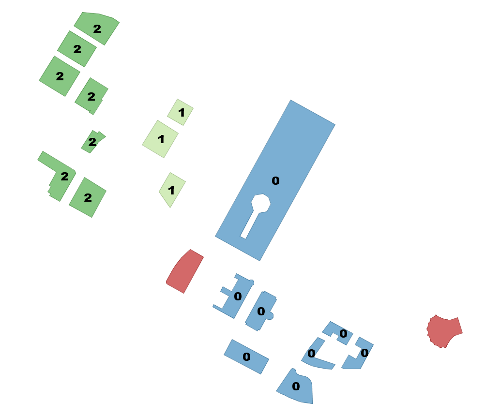 Clusters dans un rayon de 50 mètres avec au moins 2 éléments par cluster. Les singletons ont NULL pour cid
SELECT name, ST_ClusterDBSCAN(geom, eps =
> 50, minpoints =
> 2) over () AS cid
FROM boston_polys
WHERE name
> '' AND building
> ''
AND ST_DWithin(geom,
ST_Transform(
ST_GeomFromText('POINT(-71.04054 42.35141)', 4326), 26986),
500);
|
name | bucket
-------------------------------------+--------
Manulife Tower | 0
Park Lane Seaport I | 0
Park Lane Seaport II | 0
Renaissance Boston Waterfront Hotel | 0
Seaport Boston Hotel | 0
Seaport Hotel & World Trade Center | 0
Waterside Place | 0
World Trade Center East | 0
100 Northern Avenue | 1
100 Pier 4 | 1
The Institute of Contemporary Art | 1
101 Seaport | 2
District Hall | 2
One Marina Park Drive | 2
Twenty Two Liberty | 2
Vertex | 2
Vertex | 2
Watermark Seaport | 2
Blue Hills Bank Pavilion | NULL
World Trade Center West | NULL
(20 rows)
|
Un exemple montrant la combinaison de parcelles ayant le même numéro de cluster dans des collections géométriques.
SELECT cid, ST_Collect(geom) AS cluster_geom, array_agg(parcel_id) AS ids_in_cluster FROM (
SELECT parcel_id, ST_ClusterDBSCAN(geom, eps => 0.5, minpoints => 5) over () AS cid, geom
FROM parcels) sq
GROUP BY cid;
Name
ST_ClusterIntersecting — Fonction d'agrégation qui regroupe les géométries en entrée en ensembles connectés.
Synopsis
geometry[] ST_ClusterIntersecting(geometry set g);
Description
Une fonction agrégée qui renvoie un tableau de GeometryCollections partitionnant les géométries d'entrée en clusters connectés et disjoints. Chaque géométrie d'un cluster intersecte au moins une autre géométrie du cluster et n'intersecte aucune géométrie d'autre cluster.
Disponibilité : 2.2.0
Exemples
WITH testdata AS
(SELECT unnest(ARRAY['LINESTRING (0 0, 1 1)'::geometry,
'LINESTRING (5 5, 4 4)'::geometry,
'LINESTRING (6 6, 7 7)'::geometry,
'LINESTRING (0 0, -1 -1)'::geometry,
'POLYGON ((0 0, 4 0, 4 4, 0 4, 0 0))'::geometry]) AS geom)
SELECT ST_AsText(unnest(ST_ClusterIntersecting(geom))) FROM testdata;
--result
st_astext
---------
GEOMETRYCOLLECTION(LINESTRING(0 0,1 1),LINESTRING(5 5,4 4),LINESTRING(0 0,-1 -1),POLYGON((0 0,4 0,4 4,0 4,0 0)))
GEOMETRYCOLLECTION(LINESTRING(6 6,7 7))
Name
ST_ClusterIntersectingWin — Fonction Window qui renvoie un identifiant de cluster pour chaque géométrie en entrée, en regroupant les géométries en entrée en ensembles connectés.
Synopsis
integer ST_ClusterIntersectingWin(geometry winset geom);
Description
Une fonction window qui construit des clusters connectés de géométries qui se croisent. Il est possible de parcourir toutes les géométries d'un cluster sans quitter le cluster. La valeur de retour est le numéro du cluster à laquelle participe l'argument géométrie, ou null pour les entrées nulles.
Disponibilité : 3.4.0
Exemples
WITH testdata AS (
SELECT id, geom::geometry FROM (
VALUES (1, 'LINESTRING (0 0, 1 1)'),
(2, 'LINESTRING (5 5, 4 4)'),
(3, 'LINESTRING (6 6, 7 7)'),
(4, 'LINESTRING (0 0, -1 -1)'),
(5, 'POLYGON ((0 0, 4 0, 4 4, 0 4, 0 0))')) AS t(id, geom)
)
SELECT id,
ST_AsText(geom),
ST_ClusterIntersectingWin(geom) OVER () AS cluster
FROM testdata;
id | st_astext | cluster
----+--------------------------------+---------
1 | LINESTRING(0 0,1 1) | 0
2 | LINESTRING(5 5,4 4) | 0
3 | LINESTRING(6 6,7 7) | 1
4 | LINESTRING(0 0,-1 -1) | 0
5 | POLYGON((0 0,4 0,4 4,0 4,0 0)) | 0
Name
ST_ClusterKMeans — Fonction Window qui renvoie un identifiant de cluster pour chaque géométrie en entrée en utilisant l'algorithme K-means.
Synopsis
integer ST_ClusterKMeans( geometry winset geom , integer k , float8 max_radius );
Description
Renvoie le numéro de cluster K-means pour chaque géométrie en entrée. La distance utilisée pour le clustering est la distance entre les centroïdes pour les géométries 2D, et la distance entre les centres des boîtes de délimitation pour les géométries 3D. Pour les entrées POINT, la coordonnée M sera traitée comme le poids de l'entrée et doit être supérieure à 0.
max_radius, si elle est définie, fera en sorte que ST_ClusterKMeans génère plus de clusters que k en s'assurant qu'aucun cluster en sortie n'a un rayon plus grand que max_radius. Ceci est utile dans l'analyse d'accessibilité.
Amélioré : 3.2.0 Support pour max_radius
Amélioration : 3.1.0 Prise en charge des géométries et des poids en 3D
Disponibilité : 2.3.0
Exemples
Générer un ensemble de parcelles fictives pour les exemples :
CREATE TABLE parcels AS
SELECT lpad((row_number() over())::text,3,'0') As parcel_id, geom,
('{residential, commercial}'::text[])[1 + mod(row_number()OVER(),2)] As type
FROM
ST_Subdivide(ST_Buffer('SRID=3857;LINESTRING(40 100, 98 100, 100 150, 60 90)'::geometry,
40, 'endcap=square'),12) As geom;
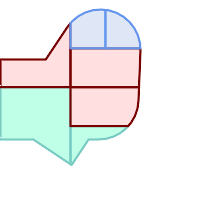
Parcelles codées en couleur par numéro de cluster (cid)
SELECT ST_ClusterKMeans(geom, 3) OVER() AS cid, parcel_id, geom
FROM parcels;
cid | parcel_id | geom -----+-----------+--------------- 0 | 001 | 0103000000... 0 | 002 | 0103000000... 1 | 003 | 0103000000... 0 | 004 | 0103000000... 1 | 005 | 0103000000... 2 | 006 | 0103000000... 2 | 007 | 0103000000...
Partitionnement des clusters de parcelles par type :
SELECT ST_ClusterKMeans(geom, 3) over (PARTITION BY type) AS cid, parcel_id, type
FROM parcels;cid | parcel_id | type -----+-----------+------------- 1 | 005 | commercial 1 | 003 | commercial 2 | 007 | commercial 0 | 001 | commercial 1 | 004 | residential 0 | 002 | residential 2 | 006 | residential
Exemple : Regroupement d'un ensemble de données de population préagrégées à l'échelle planétaire en utilisant le clusering 3D et la pondération. Identifiez au moins 20 régions basées sur Kontur Population Data qui ne s'étendent pas à plus de 3000 km de leur centre :
create table kontur_population_3000km_clusters as
select
geom,
ST_ClusterKMeans(
ST_Force4D(
ST_Transform(ST_Force3D(geom), 4978), -- cluster in 3D XYZ CRS
mvalue => population -- set clustering to be weighed by population
),
20, -- aim to generate at least 20 clusters
max_radius => 3000000 -- but generate more to make each under 3000 km radius
) over () as cid
from
kontur_population;
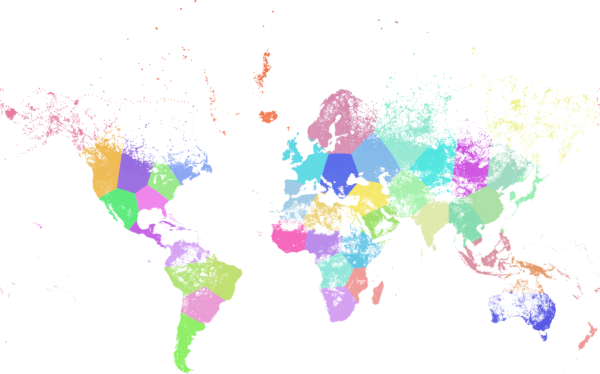
La population mondiale regroupée selon les spécifications ci-dessus produit 46 clusters. Les clusters sont centrés sur des régions bien peuplées (New York, Moscou). Le Groenland est un cluster. Il y a des groupes d'îles qui s'étendent sur l'antiméridien. Les bords des clusters suivent la courbure de la Terre.
Name
ST_ClusterWithin — Fonction agrégée qui regroupe les géométries en fonction de la distance de séparation.
Synopsis
geometry[] ST_ClusterWithin(geometry set g, float8 distance);
Description
Une fonction agrégée qui renvoie un tableau de GeometryCollections, où chaque collection est un cluster contenant certaines géométries d'entrée. Le regroupement partitionne les géométries d'entrée en ensembles dans lesquels chaque géométrie se trouve dans la distance spécifiée d'au moins une autre géométrie dans le même cluster. Les distances sont des distances cartésiennes dans les unités de l'ISDR.
ST_ClusterWithin est équivalent à l'exécution de ST_ClusterDBSCAN avec minpoints => 0.
Disponibilité : 2.2.0
 Cette méthode prend en charge les types Circular String et Curve.
Cette méthode prend en charge les types Circular String et Curve.
Exemples
WITH testdata AS
(SELECT unnest(ARRAY['LINESTRING (0 0, 1 1)'::geometry,
'LINESTRING (5 5, 4 4)'::geometry,
'LINESTRING (6 6, 7 7)'::geometry,
'LINESTRING (0 0, -1 -1)'::geometry,
'POLYGON ((0 0, 4 0, 4 4, 0 4, 0 0))'::geometry]) AS geom)
SELECT ST_AsText(unnest(ST_ClusterWithin(geom, 1.4))) FROM testdata;
--result
st_astext
---------
GEOMETRYCOLLECTION(LINESTRING(0 0,1 1),LINESTRING(5 5,4 4),LINESTRING(0 0,-1 -1),POLYGON((0 0,4 0,4 4,0 4,0 0)))
GEOMETRYCOLLECTION(LINESTRING(6 6,7 7))
Name
ST_ClusterWithinWin — Fonction Window qui renvoie un identifiant de cluster pour chaque géométrie en entrée, regroupement en utilisant la distance de séparation.
Synopsis
integer ST_ClusterWithinWin(geometry winset geom, float8 distance);
Description
Une fonction window qui renvoie un numéro de cluster pour chaque géométrie d'entrée. Le regroupement partitionne les géométries en ensembles dans lesquels chaque géométrie se trouve dans la distance spécifiée d'au moins une autre géométrie dans le même groupe. Les distances sont des distances cartésiennes dans les unités du SRID.
ST_ClusterWithinWin est équivalent à l'exécution de ST_ClusterDBSCAN avec minpoints => 0.
Disponibilité : 3.4.0
 Cette méthode prend en charge les types Circular String et Curve.
Cette méthode prend en charge les types Circular String et Curve.
Exemples
WITH testdata AS (
SELECT id, geom::geometry FROM (
VALUES (1, 'LINESTRING (0 0, 1 1)'),
(2, 'LINESTRING (5 5, 4 4)'),
(3, 'LINESTRING (6 6, 7 7)'),
(4, 'LINESTRING (0 0, -1 -1)'),
(5, 'POLYGON ((0 0, 4 0, 4 4, 0 4, 0 0))')) AS t(id, geom)
)
SELECT id,
ST_AsText(geom),
ST_ClusterWithinWin(geom, 1.4) OVER () AS cluster
FROM testdata;
id | st_astext | cluster
----+--------------------------------+---------
1 | LINESTRING(0 0,1 1) | 0
2 | LINESTRING(5 5,4 4) | 0
3 | LINESTRING(6 6,7 7) | 1
4 | LINESTRING(0 0,-1 -1) | 0
5 | POLYGON((0 0,4 0,4 4,0 4,0 0)) | 0
7.18. Fonctions des boîtes de délimitation
Ces fonctions produisent ou utilisent des boîtes de délimitation. Elles peuvent également fournir et accepter des valeurs géométriques, en utilisant des transformations automatiques ou explicites.
Voir aussi Section 13.7, “Fonctions Box de PostGIS”.
- Box2D — Renvoie une BOX2D représentant l'étendue 2D d'une géométrie.
- Box3D — Renvoie une BOX3D représentant l'étendue 3D d'une géométrie.
- ST_EstimatedExtent — Renvoie l'étendue estimée d'une table spatiale.
- ST_Expand — Renvoie une boîte de délimitation développée à partir d'une autre boîte de délimitation ou d'une géométrie.
- ST_Extent — Fonction agrégée qui renvoie la boîte de délimitation des géométries.
- ST_3DExtent — Fonction d'agrégation qui renvoie la boîte de délimitation 3D des géométries.
- ST_MakeBox2D — Crée un BOX2D défini par deux géométries de points 2D.
- ST_3DMakeBox — Crée un BOX3D défini par deux géométries de points 3D.
- ST_XMax — Retourne les maxima X d'une boîte de délimitation 2D ou 3D ou d'une géométrie.
- ST_XMin — Retourne les minima X d'une boîte de délimitation 2D ou 3D ou d'une géométrie.
- ST_YMax — Retourne les maxima Y d'une boîte de délimitation 2D ou 3D ou d'une géométrie.
- ST_YMin — Retourne les minima Y d'une boîte de délimitation 2D ou 3D ou d'une géométrie.
- ST_ZMax — Retourne les maxima Z d'une boîte de délimitation 2D ou 3D ou d'une géométrie.
- ST_ZMin — Retourne les minima Z d'une boîte de délimitation 2D ou 3D ou d'une géométrie.
- ST_MMin — Returns the M minima of a geometry.
- ST_MMax — Returns the M minima of a geometry.
Name
Box2D — Renvoie une BOX2D représentant l'étendue 2D d'une géométrie.
Synopsis
box2d Box2D(geometry geom);
Description
Renvoie une box2d représentant l'étendue 2D de la géométrie.
Amélioration : 2.0.0 introduction du support TIN, Triangles et surfaces polyédriques.
 Cette méthode prend en charge les types Circular String et Curve.
Cette méthode prend en charge les types Circular String et Curve.
 Cette fonction prend en charge les surfaces Polyhedral.
Cette fonction prend en charge les surfaces Polyhedral.
 Cette fonction prend en charge les triangles et les réseaux irréguliers triangulés (TIN).
Cette fonction prend en charge les triangles et les réseaux irréguliers triangulés (TIN).
Exemples
SELECT Box2D(ST_GeomFromText('LINESTRING(1 2, 3 4, 5 6)'));
box2d
---------
BOX(1 2,5 6)
SELECT Box2D(ST_GeomFromText('CIRCULARSTRING(220268 150415,220227 150505,220227 150406)'));
box2d
--------
BOX(220186.984375 150406,220288.25 150506.140625)
Voir aussi
Name
Box3D — Renvoie une BOX3D représentant l'étendue 3D d'une géométrie.
Synopsis
box3d Box3D(geometry geom);
Description
Renvoie une box3d représentant l'étendue 3D de la géométrie.
Amélioration : 2.0.0 introduction du support TIN, Triangles et surfaces polyédriques.
 Cette méthode prend en charge les types Circular String et Curve.
Cette méthode prend en charge les types Circular String et Curve.
 Cette fonction prend en charge les surfaces Polyhedral.
Cette fonction prend en charge les surfaces Polyhedral.
 Cette fonction prend en charge les triangles et les réseaux irréguliers triangulés (TIN).
Cette fonction prend en charge les triangles et les réseaux irréguliers triangulés (TIN).
 Cette fonction prend en charge la 3D et ne supprime pas l'indice z.
Cette fonction prend en charge la 3D et ne supprime pas l'indice z.
Exemples
SELECT Box3D(ST_GeomFromEWKT('LINESTRING(1 2 3, 3 4 5, 5 6 5)'));
Box3d
---------
BOX3D(1 2 3,5 6 5)
SELECT Box3D(ST_GeomFromEWKT('CIRCULARSTRING(220268 150415 1,220227 150505 1,220227 150406 1)'));
Box3d
--------
BOX3D(220227 150406 1,220268 150415 1)
Voir aussi
Name
ST_EstimatedExtent — Renvoie l'étendue estimée d'une table spatiale.
Synopsis
box2d ST_EstimatedExtent(text schema_name, text table_name, text geocolumn_name, boolean parent_only);
box2d ST_EstimatedExtent(text schema_name, text table_name, text geocolumn_name);
box2d ST_EstimatedExtent(text table_name, text geocolumn_name);
Description
Renvoie l'étendue estimée d'une table spatiale sous la forme d'une box2d. Le schéma actuel est utilisé s'il n'est pas spécifié. L'étendue estimée est tirée des statistiques de la colonne géométrique. Cette méthode est généralement plus rapide que le calcul de l'étendue exacte de la table à l'aide de ST_Extent ou ST_3DExtent.
Le comportement par défaut est d'utiliser également les statistiques collectées à partir des tables enfants (tables avec INHERITS) si elles sont disponibles. Si parent_only est défini à VRAI, seules les statistiques de la table donnée sont utilisées et les tables enfants sont ignorées.
Pour PostgreSQL >= 8.0.0 les statistiques sont collectées par VACUUM ANALYZE et l'étendue du résultat sera d'environ 95% de l'étendue réelle. Pour PostgreSQL < 8.0.0 les statistiques sont collectées en exécutant update_geometry_stats() et l'étendue du résultat sera exacte.
![[Note]](images/note.png) | |
En l'absence de statistiques (table vide ou pas d'ANALYZE), cette fonction renvoie NULL. Avant la version 1.5.4, une exception était levée. |
![[Note]](images/note.png) | |
L'échappement des noms de tables et/ou d'espaces de noms qui comprennent des caractères spéciaux et des guillemets peut nécessiter un traitement particulier. Un utilisateur note : "Pour les schémas et les tables, utiliser les règles d'échappement des identificateurs pour produire une chaîne de caractères entre guillemets, puis supprimer le premier et le dernier caractère entre guillemets. Pour les colonnes géométriques, laissez-les telles quelles. |
Disponibilité : 1.0.0
Modifié : 2.1.0. Jusqu'à la version 2.0.x, cette fonction était appelée ST_Estimated_Extent.
 Cette méthode prend en charge les types Circular String et Curve.
Cette méthode prend en charge les types Circular String et Curve.
Exemples
SELECT ST_EstimatedExtent('ny', 'edges', 'geom');
--result--
BOX(-8877653 4912316,-8010225.5 5589284)
SELECT ST_EstimatedExtent('feature_poly', 'geom');
--result--
BOX(-124.659652709961 24.6830825805664,-67.7798080444336 49.0012092590332)
Voir aussi
Name
ST_Expand — Renvoie une boîte de délimitation développée à partir d'une autre boîte de délimitation ou d'une géométrie.
Synopsis
geometry ST_Expand(geometry geom, float units_to_expand);
geometry ST_Expand(geometry geom, float dx, float dy, float dz=0, float dm=0);
box2d ST_Expand(box2d box, float units_to_expand);
box2d ST_Expand(box2d box, float dx, float dy);
box3d ST_Expand(box3d box, float units_to_expand);
box3d ST_Expand(box3d box, float dx, float dy, float dz=0);
Description
Renvoie une boîte de délimitation développée à partir de la boîte de délimitation de l'entrée, soit en spécifiant une distance unique avec laquelle la boîte doit être développée sur les deux axes, soit en spécifiant une distance de développement pour chaque axe. Utilise la double précision. Peut être utilisé pour les requêtes de distance, ou pour ajouter un filtre de boîte de délimitation à une requête afin de tirer parti d'un index spatial.
Outre la version de ST_Expand acceptant et renvoyant une géométrie, des variantes sont fournies qui acceptent et renvoient des types de données box2d et box3d.
Les distances sont exprimées dans les unités du système de référence spatiale de l'entrée.
ST_Expand est similaire à ST_Buffer, mais alors que la mise en mémoire tampon étend une géométrie dans toutes les directions, ST_Expand étend la boîte de délimitation le long de chaque axe.
![[Note]](images/note.png) | |
Avant la version 1.3, ST_Expand était utilisé en conjonction avec ST_Distance pour effectuer des requêtes de distance indexables. Par exemple, |
Disponibilité : 1.5.0 comportement modifié pour afficher les coordonnées en double précision au lieu des coordonnées float4.
Amélioration : 2.0.0 introduction du support TIN, Triangles et surfaces polyédriques.
Amélioration : 2.3.0 : prise en charge de l'expansion d'une boîte par différentes quantités dans différentes dimensions.
 Cette fonction prend en charge les surfaces Polyhedral.
Cette fonction prend en charge les surfaces Polyhedral.
 Cette fonction prend en charge les triangles et les réseaux irréguliers triangulés (TIN).
Cette fonction prend en charge les triangles et les réseaux irréguliers triangulés (TIN).
Exemples
![[Note]](images/note.png) | |
Les exemples ci-dessous utilisent l'Atlas national américain Equal Area (SRID=2163) qui est une projection en mètres |
--10 meter expanded box around bbox of a linestring
SELECT CAST(ST_Expand(ST_GeomFromText('LINESTRING(2312980 110676,2312923 110701,2312892 110714)', 2163),10) As box2d);
st_expand
------------------------------------
BOX(2312882 110666,2312990 110724)
--10 meter expanded 3D box of a 3D box
SELECT ST_Expand(CAST('BOX3D(778783 2951741 1,794875 2970042.61545891 10)' As box3d),10)
st_expand
-----------------------------------------------------
BOX3D(778773 2951731 -9,794885 2970052.61545891 20)
--10 meter geometry astext rep of a expand box around a point geometry
SELECT ST_AsEWKT(ST_Expand(ST_GeomFromEWKT('SRID=2163;POINT(2312980 110676)'),10));
st_asewkt
-------------------------------------------------------------------------------------------------
SRID=2163;POLYGON((2312970 110666,2312970 110686,2312990 110686,2312990 110666,2312970 110666))
Voir aussi
Name
ST_Extent — Fonction agrégée qui renvoie la boîte de délimitation des géométries.
Synopsis
box2d ST_Extent(geometry set geomfield);
Description
Une fonction agrégée qui renvoie une box2d boîte de délimitation qui délimite un ensemble de géométries.
Les coordonnées de la boîte de délimitation sont dans le système de référence spatiale des géométries d'entrée.
Le concept de ST_Extent est similaire à celui de SDO_AGGR_MBR d'Oracle Spatial/Locator.
![[Note]](images/note.png) | |
ST_Extent renvoie des boîtes avec seulement les coordonnées X et Y, même avec des géométries 3D. Pour renvoyer les coordonnées XYZ, utilisez ST_3DExtent. |
![[Note]](images/note.png) | |
La valeur |
Amélioration : 2.0.0 introduction du support TIN, Triangles et surfaces polyédriques.
 Cette fonction prend en charge les surfaces Polyhedral.
Cette fonction prend en charge les surfaces Polyhedral.
 Cette fonction prend en charge les triangles et les réseaux irréguliers triangulés (TIN).
Cette fonction prend en charge les triangles et les réseaux irréguliers triangulés (TIN).
Exemples
![[Note]](images/note.png) | |
Les exemples ci-dessous utilisent le plan de l'État du Massachusetts (SRID=2249) |
SELECT ST_Extent(geom) as bextent FROM sometable;
st_bextent
------------------------------------
BOX(739651.875 2908247.25,794875.8125 2970042.75)
--Return extent of each category of geometries
SELECT ST_Extent(geom) as bextent
FROM sometable
GROUP BY category ORDER BY category;
bextent | name
----------------------------------------------------+----------------
BOX(778783.5625 2951741.25,794875.8125 2970042.75) | A
BOX(751315.8125 2919164.75,765202.6875 2935417.25) | B
BOX(739651.875 2917394.75,756688.375 2935866) | C
--Force back into a geometry
-- and render the extended text representation of that geometry
SELECT ST_SetSRID(ST_Extent(geom),2249) as bextent FROM sometable;
bextent
--------------------------------------------------------------------------------
SRID=2249;POLYGON((739651.875 2908247.25,739651.875 2970042.75,794875.8125 2970042.75,
794875.8125 2908247.25,739651.875 2908247.25))
Voir aussi
Name
ST_3DExtent — Fonction d'agrégation qui renvoie la boîte de délimitation 3D des géométries.
Synopsis
box3d ST_3DExtent(geometry set geomfield);
Description
Une fonction d'agrégation qui renvoie une box3d (y compris l'ordonnée Z) qui délimite un ensemble de géométries.
Les coordonnées de la boîte de délimitation sont dans le système de référence spatiale des géométries d'entrée.
![[Note]](images/note.png) | |
La valeur |
Amélioration : 2.0.0 introduction du support TIN, Triangles et surfaces polyédriques.
Modifié : 2.0.0 Dans les versions précédentes, cette fonction était appelée ST_Extent3D
 Cette fonction prend en charge la 3D et ne supprime pas l'indice z.
Cette fonction prend en charge la 3D et ne supprime pas l'indice z.
 Cette méthode prend en charge les types Circular String et Curve.
Cette méthode prend en charge les types Circular String et Curve.
 Cette fonction prend en charge les surfaces Polyhedral.
Cette fonction prend en charge les surfaces Polyhedral.
 Cette fonction prend en charge les triangles et les réseaux irréguliers triangulés (TIN).
Cette fonction prend en charge les triangles et les réseaux irréguliers triangulés (TIN).
Exemples
SELECT ST_3DExtent(foo.geom) As b3extent
FROM (SELECT ST_MakePoint(x,y,z) As geom
FROM generate_series(1,3) As x
CROSS JOIN generate_series(1,2) As y
CROSS JOIN generate_series(0,2) As Z) As foo;
b3extent
--------------------
BOX3D(1 1 0,3 2 2)
--Get the extent of various elevated circular strings
SELECT ST_3DExtent(foo.geom) As b3extent
FROM (SELECT ST_Translate(ST_Force_3DZ(ST_LineToCurve(ST_Buffer(ST_Point(x,y),1))),0,0,z) As geom
FROM generate_series(1,3) As x
CROSS JOIN generate_series(1,2) As y
CROSS JOIN generate_series(0,2) As Z) As foo;
b3extent
--------------------
BOX3D(1 0 0,4 2 2)
Voir aussi
Name
ST_MakeBox2D — Crée un BOX2D défini par deux géométries de points 2D.
Synopsis
box2d ST_MakeBox2D(geometry pointLowLeft, geometry pointUpRight);
Description
Crée une box2d définie par deux géométries de points. Ceci est utile pour effectuer des requêtes sur des intervalles.
Exemples
--Return all features that fall reside or partly reside in a US national atlas coordinate bounding box
--It is assumed here that the geometries are stored with SRID = 2163 (US National atlas equal area)
SELECT feature_id, feature_name, geom
FROM features
WHERE geom && ST_SetSRID(ST_MakeBox2D(ST_Point(-989502.1875, 528439.5625),
ST_Point(-987121.375 ,529933.1875)),2163)
Voir aussi
Name
ST_3DMakeBox — Crée un BOX3D défini par deux géométries de points 3D.
Synopsis
box3d ST_3DMakeBox(geometry point3DLowLeftBottom, geometry point3DUpRightTop);
Description
Crée une box3d définie par deux géométries de points 3D.
 Cette fonction prend en charge la 3D et ne supprime pas l'indice z.
Cette fonction prend en charge la 3D et ne supprime pas l'indice z.
Modifié : 2.0.0 Dans les versions précédentes, cette fonction s'appelait ST_MakeBox3D
Exemples
SELECT ST_3DMakeBox(ST_MakePoint(-989502.1875, 528439.5625, 10),
ST_MakePoint(-987121.375 ,529933.1875, 10)) As abb3d
--bb3d--
--------
BOX3D(-989502.1875 528439.5625 10,-987121.375 529933.1875 10)
Voir aussi
Name
ST_XMax — Retourne les maxima X d'une boîte de délimitation 2D ou 3D ou d'une géométrie.
Synopsis
float ST_XMax(box3d aGeomorBox2DorBox3D);
Description
Retourne les maxima X d'une boîte de délimitation 2D ou 3D ou d'une géométrie.
![[Note]](images/note.png) | |
Bien que cette fonction ne soit définie que pour box3d, elle fonctionne également pour box2d et les valeurs géométriques en raison du moulage automatique. Cependant, elle n'acceptera pas de représentation textuelle de la géométrie ou de la box2d, car ces dernières ne sont pas soumises à la conversion automatique. |
 Cette fonction prend en charge la 3D et ne supprime pas l'indice z.
Cette fonction prend en charge la 3D et ne supprime pas l'indice z.
 Cette méthode prend en charge les types Circular String et Curve.
Cette méthode prend en charge les types Circular String et Curve.
Exemples
SELECT ST_XMax('BOX3D(1 2 3, 4 5 6)');
st_xmax
-------
4
SELECT ST_XMax(ST_GeomFromText('LINESTRING(1 3 4, 5 6 7)'));
st_xmax
-------
5
SELECT ST_XMax(CAST('BOX(-3 2, 3 4)' As box2d));
st_xmax
-------
3
--Observe THIS DOES NOT WORK because it will try to auto-cast the string representation to a BOX3D
SELECT ST_XMax('LINESTRING(1 3, 5 6)');
--ERROR: BOX3D parser - doesn't start with BOX3D(
SELECT ST_XMax(ST_GeomFromEWKT('CIRCULARSTRING(220268 150415 1,220227 150505 2,220227 150406 3)'));
st_xmax
--------
220288.248780547
Name
ST_XMin — Retourne les minima X d'une boîte de délimitation 2D ou 3D ou d'une géométrie.
Synopsis
float ST_XMin(box3d aGeomorBox2DorBox3D);
Description
Retourne les minima X d'une boîte de délimitation 2D ou 3D ou d'une géométrie.
![[Note]](images/note.png) | |
Bien que cette fonction ne soit définie que pour box3d, elle fonctionne également pour box2d et les valeurs géométriques en raison du moulage automatique. Cependant, elle n'acceptera pas de représentation textuelle de la géométrie ou de la box2d, car celles-ci ne sont pas coulées automatiquement. |
 Cette fonction prend en charge la 3D et ne supprime pas l'indice z.
Cette fonction prend en charge la 3D et ne supprime pas l'indice z.
 Cette méthode prend en charge les types Circular String et Curve.
Cette méthode prend en charge les types Circular String et Curve.
Exemples
SELECT ST_XMin('BOX3D(1 2 3, 4 5 6)');
st_xmin
-------
1
SELECT ST_XMin(ST_GeomFromText('LINESTRING(1 3 4, 5 6 7)'));
st_xmin
-------
1
SELECT ST_XMin(CAST('BOX(-3 2, 3 4)' As box2d));
st_xmin
-------
-3
--Observe THIS DOES NOT WORK because it will try to auto-cast the string representation to a BOX3D
SELECT ST_XMin('LINESTRING(1 3, 5 6)');
--ERROR: BOX3D parser - doesn't start with BOX3D(
SELECT ST_XMin(ST_GeomFromEWKT('CIRCULARSTRING(220268 150415 1,220227 150505 2,220227 150406 3)'));
st_xmin
--------
220186.995121892
Name
ST_YMax — Retourne les maxima Y d'une boîte de délimitation 2D ou 3D ou d'une géométrie.
Synopsis
float ST_YMax(box3d aGeomorBox2DorBox3D);
Description
Retourne les maxima Y d'une boîte de délimitation 2D ou 3D ou d'une géométrie.
![[Note]](images/note.png) | |
Bien que cette fonction ne soit définie que pour box3d, elle fonctionne également pour box2d et les valeurs géométriques en raison du moulage automatique. Cependant, elle n'acceptera pas de représentation textuelle de la géométrie ou de la box2d, car celles-ci ne sont pas coulées automatiquement. |
 Cette fonction prend en charge la 3D et ne supprime pas l'indice z.
Cette fonction prend en charge la 3D et ne supprime pas l'indice z.
 Cette méthode prend en charge les types Circular String et Curve.
Cette méthode prend en charge les types Circular String et Curve.
Exemples
SELECT ST_YMax('BOX3D(1 2 3, 4 5 6)');
st_ymax
-------
5
SELECT ST_YMax(ST_GeomFromText('LINESTRING(1 3 4, 5 6 7)'));
st_ymax
-------
6
SELECT ST_YMax(CAST('BOX(-3 2, 3 4)' As box2d));
st_ymax
-------
4
--Observe THIS DOES NOT WORK because it will try to auto-cast the string representation to a BOX3D
SELECT ST_YMax('LINESTRING(1 3, 5 6)');
--ERROR: BOX3D parser - doesn't start with BOX3D(
SELECT ST_YMax(ST_GeomFromEWKT('CIRCULARSTRING(220268 150415 1,220227 150505 2,220227 150406 3)'));
st_ymax
--------
150506.126829327
Name
ST_YMin — Retourne les minima Y d'une boîte de délimitation 2D ou 3D ou d'une géométrie.
Synopsis
float ST_YMin(box3d aGeomorBox2DorBox3D);
Description
Retourne les minima Y d'une boîte englobante 2D ou 3D ou d'une géométrie.
![[Note]](images/note.png) | |
Bien que cette fonction ne soit définie que pour box3d, elle fonctionne également pour box2d et les valeurs géométriques en raison du moulage automatique. Cependant, elle n'acceptera pas de représentation textuelle de la géométrie ou de la box2d, car celles-ci ne sont pas coulées automatiquement. |
 Cette fonction prend en charge la 3D et ne supprime pas l'indice z.
Cette fonction prend en charge la 3D et ne supprime pas l'indice z.
 Cette méthode prend en charge les types Circular String et Curve.
Cette méthode prend en charge les types Circular String et Curve.
Exemples
SELECT ST_YMin('BOX3D(1 2 3, 4 5 6)');
st_ymin
-------
2
SELECT ST_YMin(ST_GeomFromText('LINESTRING(1 3 4, 5 6 7)'));
st_ymin
-------
3
SELECT ST_YMin(CAST('BOX(-3 2, 3 4)' As box2d));
st_ymin
-------
2
--Observe THIS DOES NOT WORK because it will try to auto-cast the string representation to a BOX3D
SELECT ST_YMin('LINESTRING(1 3, 5 6)');
--ERROR: BOX3D parser - doesn't start with BOX3D(
SELECT ST_YMin(ST_GeomFromEWKT('CIRCULARSTRING(220268 150415 1,220227 150505 2,220227 150406 3)'));
st_ymin
--------
150406
Name
ST_ZMax — Retourne les maxima Z d'une boîte de délimitation 2D ou 3D ou d'une géométrie.
Synopsis
float ST_ZMax(box3d aGeomorBox2DorBox3D);
Description
Retourne les maxima Z d'une boîte de délimitation 2D ou 3D ou d'une géométrie.
![[Note]](images/note.png) | |
Bien que cette fonction ne soit définie que pour box3d, elle fonctionne également pour box2d et les valeurs géométriques en raison du moulage automatique. Cependant, elle n'acceptera pas de représentation textuelle de la géométrie ou de la box2d, car celles-ci ne sont pas coulées automatiquement. |
 Cette fonction prend en charge la 3D et ne supprime pas l'indice z.
Cette fonction prend en charge la 3D et ne supprime pas l'indice z.
 Cette méthode prend en charge les types Circular String et Curve.
Cette méthode prend en charge les types Circular String et Curve.
Exemples
SELECT ST_ZMax('BOX3D(1 2 3, 4 5 6)');
st_zmax
-------
6
SELECT ST_ZMax(ST_GeomFromEWKT('LINESTRING(1 3 4, 5 6 7)'));
st_zmax
-------
7
SELECT ST_ZMax('BOX3D(-3 2 1, 3 4 1)' );
st_zmax
-------
1
--Observe THIS DOES NOT WORK because it will try to auto-cast the string representation to a BOX3D
SELECT ST_ZMax('LINESTRING(1 3 4, 5 6 7)');
--ERROR: BOX3D parser - doesn't start with BOX3D(
SELECT ST_ZMax(ST_GeomFromEWKT('CIRCULARSTRING(220268 150415 1,220227 150505 2,220227 150406 3)'));
st_zmax
--------
3
Name
ST_ZMin — Retourne les minima Z d'une boîte de délimitation 2D ou 3D ou d'une géométrie.
Synopsis
float ST_ZMin(box3d aGeomorBox2DorBox3D);
Description
Retourne les minima Z d'une boîte de délimitation 2D ou 3D ou d'une géométrie.
![[Note]](images/note.png) | |
Bien que cette fonction ne soit définie que pour box3d, elle fonctionne également pour box2d et les valeurs géométriques en raison du moulage automatique. Cependant, elle n'acceptera pas de représentation textuelle de la géométrie ou de la box2d, car celles-ci ne sont pas coulées automatiquement. |
 Cette fonction prend en charge la 3D et ne supprime pas l'indice z.
Cette fonction prend en charge la 3D et ne supprime pas l'indice z.
 Cette méthode prend en charge les types Circular String et Curve.
Cette méthode prend en charge les types Circular String et Curve.
Exemples
SELECT ST_ZMin('BOX3D(1 2 3, 4 5 6)');
st_zmin
-------
3
SELECT ST_ZMin(ST_GeomFromEWKT('LINESTRING(1 3 4, 5 6 7)'));
st_zmin
-------
4
SELECT ST_ZMin('BOX3D(-3 2 1, 3 4 1)' );
st_zmin
-------
1
--Observe THIS DOES NOT WORK because it will try to auto-cast the string representation to a BOX3D
SELECT ST_ZMin('LINESTRING(1 3 4, 5 6 7)');
--ERROR: BOX3D parser - doesn't start with BOX3D(
SELECT ST_ZMin(ST_GeomFromEWKT('CIRCULARSTRING(220268 150415 1,220227 150505 2,220227 150406 3)'));
st_zmin
--------
1
Voir aussi
ST_GeomFromEWKT, ST_GeomFromText, ST_XMin, ST_XMax, ST_YMin, ST_YMax, ST_ZMax, ST_MMin, ST_MMax
Name
ST_MMin — Returns the M minima of a geometry.
Synopsis
float ST_MMin(geometry geom);
Description
Returns the M minima of a geometry, or null of the geometry lacks M values.
 Cette fonction prend en charge la 3D et ne supprime pas l'indice z.
Cette fonction prend en charge la 3D et ne supprime pas l'indice z.
 Cette méthode prend en charge les types Circular String et Curve.
Cette méthode prend en charge les types Circular String et Curve.
Exemples
SELECT ST_MMin('POINT M (1 2 3)');
st_mmin
-------
3
Name
ST_MMax — Returns the M minima of a geometry.
Synopsis
float ST_MMax(geometry geom);
Description
Returns the M minima of a geometry, or null of the geometry lacks M values.
 Cette fonction prend en charge la 3D et ne supprime pas l'indice z.
Cette fonction prend en charge la 3D et ne supprime pas l'indice z.
 Cette méthode prend en charge les types Circular String et Curve.
Cette méthode prend en charge les types Circular String et Curve.
Exemples
SELECT ST_MMax('POINT M (1 2 3)');
st_mmax
-------
3 7.19. Référencement linéaire
These functions measure and locate events along linear features. They support the classic linear referencing workflow of expressing positions as fractions or measures along routes and of projecting those measures back into spatial coordinates.
- ST_LineInterpolatePoint — Renvoie un point interpolé le long d'une ligne à un emplacement fractionnaire.
- ST_3DLineInterpolatePoint — Renvoie un point interpolé le long d'une ligne 3D à un emplacement fractionnaire.
- ST_LineInterpolatePoints — Renvoie des points interpolés le long d'une ligne à un intervalle fractionnaire.
- ST_LineLocatePoint — Renvoie l'emplacement fractionnaire du point le plus proche d'un point sur une ligne.
- ST_LineSubstring — Renvoie la partie d'une ligne située entre deux emplacements fractionnaires.
- ST_LocateAlong — Renvoie le(s) point(s) d'une géométrie qui correspond(ent) à une valeur de mesure.
- ST_LocateBetween — Renvoie les parties d'une géométrie qui correspondent à un intervalle de mesure.
- ST_LocateBetweenElevations — Renvoie les parties d'une géométrie qui se trouvent dans un intervalle d'élévation (Z).
- ST_InterpolatePoint — Renvoie la mesure interpolée d'une géométrie la plus proche d'un point.
- ST_AddMeasure — Interpole les mesures le long d'une géométrie linéaire.
Name
ST_LineInterpolatePoint — Renvoie un point interpolé le long d'une ligne à un emplacement fractionnaire.
Synopsis
geometry ST_LineInterpolatePoint(geometry a_linestring, float8 a_fraction);
geography ST_LineInterpolatePoint(geography a_linestring, float8 a_fraction, boolean use_spheroid = true);
Description
Retourne un point interpolé sur une ligne. Le premier argument doit être une LINESTRING. Le second argument est un float8 entre 0 et 1 représentant la fraction de la longueur totale de la ligne où le point doit être situé.
Voir ST_LineLocatePoint pour calculer l'emplacement de la ligne la plus proche d'un point.
![[Note]](images/note.png) | |
Cette fonction calcule des points en 2D et interpole ensuite les valeurs de Z et M, tandis que ST_3DLineInterpolatePoint calcule des points en 3D et n'interpole que la valeur M. |
![[Note]](images/note.png) | |
Depuis la version 1.1.1 cette fonction interpole aussi les valeurs M et Z (lorsqu'elles sont présentes), les versions précédentes renvoient des valeurs M et Z à 0.0. |
Disponibilité : 0.8.2, support de Z et M ajouté en 1.1.1
Modifié : 2.1.0. Jusqu'à la version 2.0.x, cette fonction était appelée ST_Line_Interpolate_Point.
 Cette fonction prend en charge la 3D et ne supprime pas l'indice z.
Cette fonction prend en charge la 3D et ne supprime pas l'indice z.
Exemples
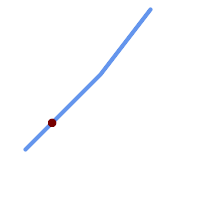
Une ligne avec le point interpolé à la position 20% (0.20)
-- The point 20% along a line
SELECT ST_AsEWKT( ST_LineInterpolatePoint(
'LINESTRING(25 50, 100 125, 150 190)',
0.2 ));
----------------
POINT(51.5974135047432 76.5974135047432)
Le point central d'une ligne 3D :
SELECT ST_AsEWKT( ST_LineInterpolatePoint('
LINESTRING(1 2 3, 4 5 6, 6 7 8)',
0.5 ));
--------------------
POINT(3.5 4.5 5.5)
Le point le plus proche d'un point sur une ligne :
SELECT ST_AsText( ST_LineInterpolatePoint( line.geom,
ST_LineLocatePoint( line.geom, 'POINT(4 3)')))
FROM (SELECT ST_GeomFromText('LINESTRING(1 2, 4 5, 6 7)') As geom) AS line;
------------
POINT(3 4)
Name
ST_3DLineInterpolatePoint — Renvoie un point interpolé le long d'une ligne 3D à un emplacement fractionnaire.
Synopsis
geometry ST_3DLineInterpolatePoint(geometry a_linestring, float8 a_fraction);
Description
Retourne un point interpolé sur une ligne. Le premier argument doit être une LINESTRING. Le second argument est un float8 entre 0 et 1 représentant la fraction de la longueur totale de la ligne où le point doit être situé.
![[Note]](images/note.png) | |
ST_LineInterpolatePoint calcule des points en 2D et interpole ensuite les valeurs de Z et M, alors que cette fonction calcule des points en 3D et n'interpole que la valeur M. |
Disponibilité : 3.0.0
 Cette fonction prend en charge la 3D et ne supprime pas l'indice z.
Cette fonction prend en charge la 3D et ne supprime pas l'indice z.
Exemples
Point de retour 20% le long de la ligne 3D
SELECT ST_AsText(
ST_3DLineInterpolatePoint('LINESTRING(25 50 70, 100 125 90, 150 190 200)',
0.20));
st_asetext
----------------
POINT Z (59.0675892910822 84.0675892910822 79.0846904776219)
Name
ST_LineInterpolatePoints — Renvoie des points interpolés le long d'une ligne à un intervalle fractionnaire.
Synopsis
geometry ST_LineInterpolatePoints(geometry a_linestring, float8 a_fraction, boolean repeat);
geography ST_LineInterpolatePoints(geography a_linestring, float8 a_fraction, boolean use_spheroid = true, boolean repeat = true);
Description
Renvoie un ou plusieurs points interpolés le long d'une ligne à un intervalle fractionnaire. Le premier argument doit être une LINESTRING. Le second argument est un float8 entre 0 et 1 représentant l'espacement entre les points en tant que fraction de la longueur de la ligne. Si le troisième argument est faux, un seul point sera construit (ce qui est équivalent à ST_LineInterpolatePoint.)
Si le résultat a zéro ou un point, il est retourné sous forme de POINT. S'il a deux points ou plus, il est retourné sous la forme d'un MULTIPOINT.
Disponibilité : 2.5.0
 Cette fonction prend en charge la 3D et ne supprime pas l'indice z.
Cette fonction prend en charge la 3D et ne supprime pas l'indice z.
 Cette fonction prend en charge les coordonnées M.
Cette fonction prend en charge les coordonnées M.
Exemples
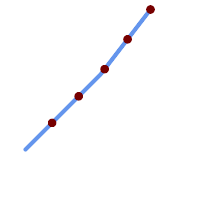
Une ligne avec des points interpolés tous les 20 %
--Return points each 20% along a 2D line
SELECT ST_AsText(ST_LineInterpolatePoints('LINESTRING(25 50, 100 125, 150 190)', 0.20))
----------------
MULTIPOINT((51.5974135047432 76.5974135047432),(78.1948270094864 103.194827009486),(104.132163186446 130.37181214238),(127.066081593223 160.18590607119),(150 190))
Voir aussi
Name
ST_LineLocatePoint — Renvoie l'emplacement fractionnaire du point le plus proche d'un point sur une ligne.
Synopsis
float8 ST_LineLocatePoint(geometry a_linestring, geometry a_point);
float8 ST_LineLocatePoint(geography a_linestring, geography a_point, boolean use_spheroid = true);
Description
Renvoie un flottant compris entre 0 et 1 représentant l'emplacement du point le plus proche du point donné sur une LineString, en tant que fraction de la ligne 2D longueur.
Vous pouvez utiliser l'emplacement renvoyé pour extraire un point (ST_LineInterpolatePoint) ou une sous-ligne (ST_LineSubstring).
Cette méthode est utile pour calculer approximativement le nombre d'adresses
Disponibilité : 1.1.0
Modifié : 2.1.0. Jusqu'à la version 2.0.x, cette fonction était appelée ST_Line_Locate_Point.
Exemples
--Rough approximation of finding the street number of a point along the street
--Note the whole foo thing is just to generate dummy data that looks
--like house centroids and street
--We use ST_DWithin to exclude
--houses too far away from the street to be considered on the street
SELECT ST_AsText(house_loc) As as_text_house_loc,
startstreet_num +
CAST( (endstreet_num - startstreet_num)
* ST_LineLocatePoint(street_line, house_loc) As integer) As street_num
FROM
(SELECT ST_GeomFromText('LINESTRING(1 2, 3 4)') As street_line,
ST_Point(x*1.01,y*1.03) As house_loc, 10 As startstreet_num,
20 As endstreet_num
FROM generate_series(1,3) x CROSS JOIN generate_series(2,4) As y)
As foo
WHERE ST_DWithin(street_line, house_loc, 0.2);
as_text_house_loc | street_num
-------------------+------------
POINT(1.01 2.06) | 10
POINT(2.02 3.09) | 15
POINT(3.03 4.12) | 20
--find closest point on a line to a point or other geometry
SELECT ST_AsText(ST_LineInterpolatePoint(foo.the_line, ST_LineLocatePoint(foo.the_line, ST_GeomFromText('POINT(4 3)'))))
FROM (SELECT ST_GeomFromText('LINESTRING(1 2, 4 5, 6 7)') As the_line) As foo;
st_astext
----------------
POINT(3 4)
Voir aussi
ST_DWithin, ST_Length2D, ST_LineInterpolatePoint, ST_LineSubstring
Name
ST_LineSubstring — Renvoie la partie d'une ligne située entre deux emplacements fractionnaires.
Synopsis
geometry ST_LineSubstring(geometry a_linestring, float8 startfraction, float8 endfraction);
geography ST_LineSubstring(geography a_linestring, float8 startfraction, float8 endfraction);
Description
Calcule la ligne qui est la section de la ligne d'entrée commençant et se terminant aux emplacements fractionnaires donnés. Le premier argument doit être un LINESTRING. Les deuxième et troisième arguments sont des valeurs dans l'intervalle [0, 1] représentant les emplacements de début et de fin en tant que fractions de la longueur de la ligne. Les valeurs Z et M sont interpolées pour les points d'extrémité ajoutés, le cas échéant.
Si startfraction et endfraction ont la même valeur, cela équivaut à ST_LineInterpolatePoint.
![[Note]](images/note.png) | |
Cette méthode ne fonctionne qu'avec les LINESTRING. Pour l'utiliser sur des MULTILINESTRINGs contigues, il faut d'abord les joindre avec ST_LineMerge. |
![[Note]](images/note.png) | |
Depuis la version 1.1.1, cette fonction interpole les valeurs de M et Z. Les versions précédentes fixent Z et M à des valeurs non spécifiées. |
Amélioration : 3.4.0 - La prise en charge de la géographie a été introduite.
Modifié : 2.1.0. Jusqu'à la version 2.0.x, cette fonction était appelée ST_Line_Substring.
Disponibilité : 1.1.0, prise en charge des Z et M ajoutée dans la 1.1.1
 Cette fonction prend en charge la 3D et ne supprime pas l'indice z.
Cette fonction prend en charge la 3D et ne supprime pas l'indice z.
Exemples
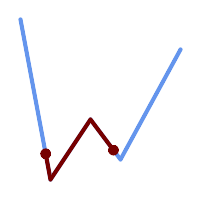
Une LineString vue avec un intervalle tous les 1/3 (0.333, 0.666)
SELECT ST_AsText(ST_LineSubstring( 'LINESTRING (20 180, 50 20, 90 80, 120 40, 180 150)', 0.333, 0.666)); ------------------------------------------------------------------------------------------------ LINESTRING (45.17311810399485 45.74337011202746, 50 20, 90 80, 112.97593050157862 49.36542599789519)
Si les points de départ et d'arrivée sont identiques, le résultat est un POINT.
SELECT ST_AsText(ST_LineSubstring( 'LINESTRING(25 50, 100 125, 150 190)', 0.333, 0.333)); ------------------------------------------ POINT(69.2846934853974 94.2846934853974)
Une requête pour découper une LineString en sections de longueur 100 ou moins. Elle utilise generate_series() avec un CROSS JOIN LATERAL pour produire l'équivalent d'une boucle FOR.
WITH data(id, geom) AS (VALUES
( 'A', 'LINESTRING( 0 0, 200 0)'::geometry ),
( 'B', 'LINESTRING( 0 100, 350 100)'::geometry ),
( 'C', 'LINESTRING( 0 200, 50 200)'::geometry )
)
SELECT id, i,
ST_AsText( ST_LineSubstring( geom, startfrac, LEAST( endfrac, 1 )) ) AS geom
FROM (
SELECT id, geom, ST_Length(geom) len, 100 sublen FROM data
) AS d
CROSS JOIN LATERAL (
SELECT i, (sublen * i) / len AS startfrac,
(sublen * (i+1)) / len AS endfrac
FROM generate_series(0, floor( len / sublen )::integer ) AS t(i)
-- skip last i if line length is exact multiple of sublen
WHERE (sublen * i) / len <
> 1.0
) AS d2;
id | i | geom
----+---+-----------------------------
A | 0 | LINESTRING(0 0,100 0)
A | 1 | LINESTRING(100 0,200 0)
B | 0 | LINESTRING(0 100,100 100)
B | 1 | LINESTRING(100 100,200 100)
B | 2 | LINESTRING(200 100,300 100)
B | 3 | LINESTRING(300 100,350 100)
C | 0 | LINESTRING(0 200,50 200)
Mesures de mise en œuvre de la geography le long d'un sphéroïde, geometry le long d'une ligne
SELECT ST_AsText(ST_LineSubstring( 'LINESTRING(-118.2436 34.0522, -71.0570 42.3611)'::geography, 0.333, 0.666),6) AS geog_sub
, ST_AsText(ST_LineSubstring('LINESTRING(-118.2436 34.0522, -71.0570 42.3611)'::geometry, 0.333, 0.666),6) AS geom_sub;
---------------------------------------------------------------
geog_sub | LINESTRING(-104.167064 38.854691,-87.674646 41.849854)
geom_sub | LINESTRING(-102.530462 36.819064,-86.817324 39.585927)
Voir aussi
ST_Length, ST_LineExtend, ST_LineInterpolatePoint, ST_LineMerge
Name
ST_LocateAlong — Renvoie le(s) point(s) d'une géométrie qui correspond(ent) à une valeur de mesure.
Synopsis
geometry ST_LocateAlong(geometry geom_with_measure, float8 measure, float8 offset = 0);
Description
Renvoie le(s) emplacement(s) le long d'une géométrie mesurée qui possède(nt) les valeurs de mesure données. Le résultat est un point ou un multipoint. Les entrées polygonales ne sont pas prises en charge.
Si offset est fourni, le résultat est décalé à gauche ou à droite de la ligne d'entrée de la distance spécifiée. Un décalage positif se fera vers la gauche, et un décalage négatif vers la droite.
![[Note]](images/note.png) | |
Cette fonction n'est utilisée que pour les géométries linéaires avec une composante M |
La sémantique est spécifiée par la norme ISO/IEC 13249-3 SQL/MM Spatial.
Disponibilité : 1.1.0 sous l'ancien nom ST_Locate_Along_Measure.
Modifié : 2.0.0 dans les versions précédentes, cette fonction était appelée ST_Locate_Along_Measure.
 Cette fonction prend en charge les coordonnées M.
Cette fonction prend en charge les coordonnées M.
 Cette méthode implémente la spécification SQL/MM. SQL-MM IEC 13249-3: 5.1.13
Cette méthode implémente la spécification SQL/MM. SQL-MM IEC 13249-3: 5.1.13
Exemples
SELECT ST_AsText(
ST_LocateAlong(
'MULTILINESTRINGM((1 2 3, 3 4 2, 9 4 3),(1 2 3, 5 4 5))'::geometry,
3 ));
----------------------------------
MULTIPOINT M ((1 2 3),(9 4 3),(1 2 3))
Name
ST_LocateBetween — Renvoie les parties d'une géométrie qui correspondent à un intervalle de mesure.
Synopsis
geometry ST_LocateBetween(geometry geom, float8 measure_start, float8 measure_end, float8 offset = 0);
Description
Renvoie une géométrie (collection) contenant les parties de la géométrie mesurée en entrée qui correspondent à l'intervalle de mesure spécifié (inclusivement).
Si le offset est fourni, le résultat est décalé à gauche ou à droite de la ligne d'entrée de la distance spécifiée. Un décalage positif se fera vers la gauche, et un décalage négatif vers la droite.
Couper un POLYGONE non convexe peut produire une géométrie non valide.
La sémantique est spécifiée par la norme ISO/IEC 13249-3 SQL/MM Spatial.
Disponibilité : 1.1.0 sous l'ancien nom ST_Locate_Between_Measures.
Modifié : 2.0.0 - dans les versions précédentes, cette fonction s'appelait ST_Locate_Between_Measures.
Amélioration : 3.0.0 - ajout de la prise en charge du POLYGONE, du TIN et du TRIANGLE.
 Cette fonction prend en charge les coordonnées M.
Cette fonction prend en charge les coordonnées M.
 Cette méthode implémente la spécification SQL/MM. SQL-MM IEC 13249-3: 5.1
Cette méthode implémente la spécification SQL/MM. SQL-MM IEC 13249-3: 5.1
Exemples
SELECT ST_AsText(
ST_LocateBetween(
'MULTILINESTRING M ((1 2 3, 3 4 2, 9 4 3),(1 2 3, 5 4 5))':: geometry,
1.5, 3 ));
------------------------------------------------------------------------
GEOMETRYCOLLECTION M (LINESTRING M (1 2 3,3 4 2,9 4 3),POINT M (1 2 3))
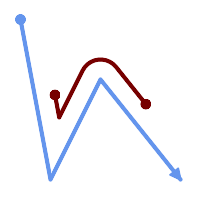
Une LineString avec la section entre les mesures 2 et 8, décalée vers la gauche
SELECT ST_AsText( ST_LocateBetween(
ST_AddMeasure('LINESTRING (20 180, 50 20, 100 120, 180 20)', 0, 10),
2, 8,
20
));
------------------------------------------------------------------------
MULTILINESTRING((54.49835019899045 104.53426957938231,58.70056060327303 82.12248075654186,69.16695286779743 103.05526528559065,82.11145618000168 128.94427190999915,84.24893681714357 132.32493442618113,87.01636951231555 135.21267035596549,90.30307285299679 137.49198684843182,93.97759758337769 139.07172433557758,97.89298381958797 139.8887023914453,101.89263860095893 139.9102465862721,105.81659870902816 139.13549527600819,109.50792827749828 137.5954340631298,112.81899532549731 135.351656550512,115.6173761888606 132.49390095108848,145.31017306064817 95.37790486135405))
Voir aussi
Name
ST_LocateBetweenElevations — Renvoie les parties d'une géométrie qui se trouvent dans un intervalle d'élévation (Z).
Synopsis
geometry ST_LocateBetweenElevations(geometry geom, float8 elevation_start, float8 elevation_end);
Description
Renvoie une géométrie (collection) contenant les parties d'une géométrie qui se trouvent dans une plage d'élévation (Z).
Couper un POLYGONE non convexe peut produire une géométrie non valide.
Disponibilité : 1.4.0
Amélioration : 3.0.0 - ajout de la prise en charge du POLYGONE, du TIN et du TRIANGLE.
 Cette fonction prend en charge la 3D et ne supprime pas l'indice z.
Cette fonction prend en charge la 3D et ne supprime pas l'indice z.
Exemples
SELECT ST_AsText(
ST_LocateBetweenElevations(
'LINESTRING(1 2 3, 4 5 6)'::geometry,
2, 4 ));
st_astext
-----------------------------------
MULTILINESTRING Z ((1 2 3,2 3 4))
SELECT ST_AsText(
ST_LocateBetweenElevations(
'LINESTRING(1 2 6, 4 5 -1, 7 8 9)',
6, 9)) As ewelev;
ewelev
-----------------------------------------------------------------------
GEOMETRYCOLLECTION Z (POINT Z (1 2 6),LINESTRING Z (6.1 7.1 6,7 8 9))
Voir aussi
Name
ST_InterpolatePoint — Renvoie la mesure interpolée d'une géométrie la plus proche d'un point.
Synopsis
float8 ST_InterpolatePoint(geometry linear_geom_with_measure, geometry point);
Description
Renvoie une valeur de mesure interpolée d'une géométrie linéaire mesurée à l'emplacement le plus proche du point donné.
![[Note]](images/note.png) | |
Cette fonction n'est utilisée que pour les géométries linéaires avec une composante M |
Disponibilité : 2.0.0
 Cette fonction prend en charge la 3D et ne supprime pas l'indice z.
Cette fonction prend en charge la 3D et ne supprime pas l'indice z.
Exemples
SELECT ST_InterpolatePoint('LINESTRING M (0 0 0, 10 0 20)', 'POINT(5 5)');
---------------------
10
Voir aussi
Name
ST_AddMeasure — Interpole les mesures le long d'une géométrie linéaire.
Synopsis
geometry ST_AddMeasure(geometry geom_mline, float8 measure_start, float8 measure_end);
Description
Renvoie une géométrie dérivée avec des valeurs de mesure interpolées linéairement entre les points de départ et d'arrivée. Si la géométrie n'a pas de dimension de mesure, une dimension est ajoutée. Si la géométrie a une dimension de mesure, elle est remplacée par de nouvelles valeurs. Seuls les LINESTRINGS et MULTILINESTRINGS sont pris en charge.
Disponibilité : 1.5.0
 Cette fonction prend en charge la 3D et ne supprime pas l'indice z.
Cette fonction prend en charge la 3D et ne supprime pas l'indice z.
Exemples
SELECT ST_AsText(ST_AddMeasure(
ST_GeomFromEWKT('LINESTRING(1 0, 2 0, 4 0)'),1,4)) As ewelev;
ewelev
--------------------------------
LINESTRINGM(1 0 1,2 0 2,4 0 4)
SELECT ST_AsText(ST_AddMeasure(
ST_GeomFromEWKT('LINESTRING(1 0 4, 2 0 4, 4 0 4)'),10,40)) As ewelev;
ewelev
----------------------------------------
LINESTRING(1 0 4 10,2 0 4 20,4 0 4 40)
SELECT ST_AsText(ST_AddMeasure(
ST_GeomFromEWKT('LINESTRINGM(1 0 4, 2 0 4, 4 0 4)'),10,40)) As ewelev;
ewelev
----------------------------------------
LINESTRINGM(1 0 10,2 0 20,4 0 40)
SELECT ST_AsText(ST_AddMeasure(
ST_GeomFromEWKT('MULTILINESTRINGM((1 0 4, 2 0 4, 4 0 4),(1 0 4, 2 0 4, 4 0 4))'),10,70)) As ewelev;
ewelev
-----------------------------------------------------------------
MULTILINESTRINGM((1 0 10,2 0 20,4 0 40),(1 0 40,2 0 50,4 0 70))
7.20. Fonctions de trajectoire
Ces fonctions permettent de travailler avec des trajectoires. Une trajectoire est une géométrie linéaire avec des mesures croissantes (valeur M) sur chaque coordonnée. Les données spatio-temporelles peuvent être modélisées en utilisant des temps relatifs (comme l'époque) comme valeurs de mesure.
- ST_IsValidTrajectory — Teste si la géométrie est une trajectoire valide.
- ST_ClosestPointOfApproach — Renvoie une mesure au point d'approche le plus proche de deux trajectoires.
- ST_DistanceCPA — Renvoie la distance entre le point d'approche le plus proche de deux trajectoires.
- ST_CPAWithin — Teste si le point d'approche le plus proche de deux trajectoires se trouve dans la distance spécifiée.
Name
ST_IsValidTrajectory — Teste si la géométrie est une trajectoire valide.
Synopsis
boolean ST_IsValidTrajectory(geometry line);
Description
Teste si une géométrie encode une trajectoire valide. Une trajectoire valide est représentée comme une LINESTRING avec des mesures (valeurs M). Les valeurs de mesure doivent augmenter de chaque sommet au suivant.
Les trajectoires valides sont attendues comme entrées pour des fonctions spatio-temporelles telles que ST_ClosestPointOfApproach
Disponibilité : 2.2.0
 Cette fonction prend en charge la 3D et ne supprime pas l'indice z.
Cette fonction prend en charge la 3D et ne supprime pas l'indice z.
Exemples
-- A valid trajectory SELECT ST_IsValidTrajectory(ST_MakeLine( ST_MakePointM(0,0,1), ST_MakePointM(0,1,2)) ); t -- An invalid trajectory SELECT ST_IsValidTrajectory(ST_MakeLine(ST_MakePointM(0,0,1), ST_MakePointM(0,1,0))); NOTICE: Measure of vertex 1 (0) not bigger than measure of vertex 0 (1) st_isvalidtrajectory ---------------------- f
Voir aussi
Name
ST_ClosestPointOfApproach — Renvoie une mesure au point d'approche le plus proche de deux trajectoires.
Synopsis
float8 ST_ClosestPointOfApproach(geometry track1, geometry track2);
Description
Renvoie la plus petite mesure pour laquelle les points interpolés le long des trajectoires données sont les moins éloignés les uns des autres.
Les entrées doivent être des trajectoires valides comme vérifié par ST_IsValidTrajectory. Null est retourné si les trajectoires ne se chevauchent pas dans leurs plages M.
Pour obtenir les points réels à la mesure calculée, utilisez ST_LocateAlong .
Disponibilité : 2.2.0
 Cette fonction prend en charge la 3D et ne supprime pas l'indice z.
Cette fonction prend en charge la 3D et ne supprime pas l'indice z.
Exemples
-- Return the time in which two objects moving between 10:00 and 11:00
-- are closest to each other and their distance at that point
WITH inp AS ( SELECT
ST_AddMeasure('LINESTRING Z (0 0 0, 10 0 5)'::geometry,
extract(epoch from '2015-05-26 10:00'::timestamptz),
extract(epoch from '2015-05-26 11:00'::timestamptz)
) a,
ST_AddMeasure('LINESTRING Z (0 2 10, 12 1 2)'::geometry,
extract(epoch from '2015-05-26 10:00'::timestamptz),
extract(epoch from '2015-05-26 11:00'::timestamptz)
) b
), cpa AS (
SELECT ST_ClosestPointOfApproach(a,b) m FROM inp
), points AS (
SELECT ST_GeometryN(ST_LocateAlong(a,m),1) pa,
ST_GeometryN(ST_LocateAlong(b,m),1) pb
FROM inp, cpa
)
SELECT to_timestamp(m) t,
ST_3DDistance(pa,pb) distance,
ST_AsText(pa, 2) AS pa, ST_AsText(pb, 2) AS pb
FROM points, cpa;
t | distance | pa | pb
-------------------------------+--------------------+--------------------------------------+----------------------------------------
2015-05-26 10:45:31.034483-07 | 1.9652147377620688 | POINT ZM (7.59 0 3.79 1432662331.03) | POINT ZM (9.1 1.24 3.93 1432662331.03)
Voir aussi
ST_IsValidTrajectory, ST_DistanceCPA, ST_LocateAlong, ST_AddMeasure
Name
ST_DistanceCPA — Renvoie la distance entre le point d'approche le plus proche de deux trajectoires.
Synopsis
float8 ST_DistanceCPA(geometry track1, geometry track2);
Description
Renvoie la distance (en 2D) entre deux trajectoires à leur point d'approche le plus proche.
Les entrées doivent être des trajectoires valides comme vérifié par ST_IsValidTrajectory. Null est retourné si les trajectoires ne se chevauchent pas dans leurs plages M.
Disponibilité : 2.2.0
 Cette fonction prend en charge la 3D et ne supprime pas l'indice z.
Cette fonction prend en charge la 3D et ne supprime pas l'indice z.
Exemples
-- Return the minimum distance of two objects moving between 10:00 and 11:00
WITH inp AS ( SELECT
ST_AddMeasure('LINESTRING Z (0 0 0, 10 0 5)'::geometry,
extract(epoch from '2015-05-26 10:00'::timestamptz),
extract(epoch from '2015-05-26 11:00'::timestamptz)
) a,
ST_AddMeasure('LINESTRING Z (0 2 10, 12 1 2)'::geometry,
extract(epoch from '2015-05-26 10:00'::timestamptz),
extract(epoch from '2015-05-26 11:00'::timestamptz)
) b
)
SELECT ST_DistanceCPA(a,b) distance FROM inp;
distance
-------------------
1.965214737762069
Voir aussi
ST_IsValidTrajectory, ST_ClosestPointOfApproach, ST_AddMeasure, |=|
Name
ST_CPAWithin — Teste si le point d'approche le plus proche de deux trajectoires se trouve dans la distance spécifiée.
Synopsis
boolean ST_CPAWithin(geometry track1, geometry track2, float8 dist);
Description
Teste si deux objets en mouvement ont déjà été plus proches que la distance spécifiée.
Les entrées doivent être des trajectoires valides comme vérifié par ST_IsValidTrajectory. False est retourné si les trajectoires ne se chevauchent pas dans leurs plages M.
Disponibilité : 2.2.0
 Cette fonction prend en charge la 3D et ne supprime pas l'indice z.
Cette fonction prend en charge la 3D et ne supprime pas l'indice z.
Exemples
WITH inp AS ( SELECT
ST_AddMeasure('LINESTRING Z (0 0 0, 10 0 5)'::geometry,
extract(epoch from '2015-05-26 10:00'::timestamptz),
extract(epoch from '2015-05-26 11:00'::timestamptz)
) a,
ST_AddMeasure('LINESTRING Z (0 2 10, 12 1 2)'::geometry,
extract(epoch from '2015-05-26 10:00'::timestamptz),
extract(epoch from '2015-05-26 11:00'::timestamptz)
) b
)
SELECT ST_CPAWithin(a,b,2), ST_DistanceCPA(a,b) distance FROM inp;
st_cpawithin | distance
--------------+------------------
t | 1.96521473776207
Voir aussi
ST_IsValidTrajectory, ST_ClosestPointOfApproach, ST_DistanceCPA, |=|
7.21. Fonctions de version
Ces fonctions permettent de signaler et de mettre à jour les versions de PostGIS.
- PostGIS_Extensions_Upgrade — Packages et mises à jour des extensions PostGIS (par exemple postgis_raster, postgis_topology, postgis_sfcgal) vers la version donnée ou la plus récente.
- PostGIS_Full_Version — Donne des informations complètes sur la version de PostGIS et la configuration du packaging.
- PostGIS_GEOS_Version — Renvoie le numéro de version de la librairie GEOS.
- PostGIS_GEOS_Compiled_Version — Renvoie le numéro de version de la librairie GEOS avec laquelle PostGIS a été construit.
- PostGIS_Liblwgeom_Version — Renvoie le numéro de version de la librairie liblwgeom. Cela devrait correspondre à la version de PostGIS.
- PostGIS_LibXML_Version — Renvoie le numéro de version de la librairie libxml2.
- PostGIS_LibJSON_Version — Renvoie le numéro de version de la bibliothèque libjson-c.
- PostGIS_Lib_Build_Date — Retourne la date de packaging de l'extension PostGIS.
- PostGIS_Lib_Version — Retourne le numéro de version de l'extension PostGIS.
- PostGIS_PROJ_Version — Renvoie le numéro de version de la librairie PROJ4.
- PostGIS_PROJ_Compiled_Version — Renvoie le numéro de version de la bibliothèque PROJ avec laquelle PostGIS a été construit.
- PostGIS_Wagyu_Version — Renvoie le numéro de version de la librairie interne de Wagyu.
- PostGIS_Scripts_Build_Date — Retourne la date de packaging des scripts PostGIS.
- PostGIS_Scripts_Installed — Retourne la version des scripts PostGIS installés dans cette base de données.
- PostGIS_Scripts_Released — Retourne le numéro de version du script postgis.sql publié avec la librairie PostGIS installée.
- PostGIS_Version — Retourne le numéro de version de PostGIS et les options de compilation.
Name
PostGIS_Extensions_Upgrade — Packages et mises à jour des extensions PostGIS (par exemple postgis_raster, postgis_topology, postgis_sfcgal) vers la version donnée ou la plus récente.
Synopsis
text PostGIS_Extensions_Upgrade(text target_version=null);
Description
Packages et mises à jour des extensions PostGIS vers la version donnée ou la plus récente. Seules les extensions que vous avez installées dans la base de données seront packagées et mises à jour si nécessaire. Rapporte la version complète de PostGIS et les informations sur la configuration de la compilation. C'est un raccourci pour faire plusieurs CREATE EXTENSION ... FROM non packagée et ALTER EXTENSION ... UPDATE pour chaque extension PostGIS. Actuellement, il n'essaie de mettre à jour que les extensions postgis, postgis_raster, postgis_sfcgal, postgis_topology, et postgis_tiger_geocoder.
Disponibilité : 2.5.0
![[Note]](images/note.png) | |
Modifié : 3.4.0 pour ajouter l'argument target_version. Modifié : 3.3.0 support pour les mises à jour à partir de n'importe quelle version de PostGIS. Ne fonctionne pas sur tous les systèmes. Modifié : 3.0.0 pour repackager les extensions libres et supporter postgis_raster. |
Exemples
SELECT PostGIS_Extensions_Upgrade();
NOTICE: Packaging extension postgis
NOTICE: Packaging extension postgis_raster
NOTICE: Packaging extension postgis_sfcgal
NOTICE: Extension postgis_topology is not available or not packagable for some reason
NOTICE: Extension postgis_tiger_geocoder is not available or not packagable for some reason
postgis_extensions_upgrade
-------------------------------------------------------------------
Upgrade completed, run SELECT postgis_full_version(); for details
(1 row)Name
PostGIS_Full_Version — Donne des informations complètes sur la version de PostGIS et la configuration du packaging.
Synopsis
text PostGIS_Full_Version();
Description
Donne des informations complètes sur la version de PostGIS et la configuration du packaging. Il fournit également des informations sur la synchronisation entre les bibliothèques et les scripts, suggérant des mises à niveau si nécessaire.
Amélioration : 3.4.0 inclut désormais les configurations supplémentaires PROJ NETWORK_ENABLED, URL_ENDPOINT et DATABASE_PATH pour l'emplacement proj.db
Exemples
SELECT PostGIS_Full_Version();
postgis_full_version
----------------------------------------------------------------------------------
POSTGIS="3.4.0dev 3.3.0rc2-993-g61bdf43a7" [EXTENSION] PGSQL="160" GEOS="3.12.0dev-CAPI-1.18.0" SFCGAL="1.3.8" PROJ="7.2.1 NETWORK_ENABLED=OFF URL_ENDPOINT=https://cdn.proj.org USER_WRITABLE_DIRECTORY=/tmp/proj DATABASE_PATH=/usr/share/proj/proj.db" GDAL="GDAL 3.2.2, released 2021/03/05" LIBXML="2.9.10" LIBJSON="0.15" LIBPROTOBUF="1.3.3" WAGYU="0.5.0 (Internal)" TOPOLOGY RASTER
(1 row)
Name
PostGIS_GEOS_Version — Renvoie le numéro de version de la librairie GEOS.
Synopsis
text PostGIS_GEOS_Version();
Description
Renvoie le numéro de version de la librairie GEOS, ou NULL si le support GEOS n'est pas activé.
Exemples
SELECT PostGIS_GEOS_Version(); postgis_geos_version ---------------------- 3.12.0dev-CAPI-1.18.0 (1 row)
Name
PostGIS_GEOS_Compiled_Version — Renvoie le numéro de version de la librairie GEOS avec laquelle PostGIS a été construit.
Synopsis
text PostGIS_GEOS_Compiled_Version();
Description
Renvoie le numéro de version de la librairie GEOS, ou par rapport à laquelle PostGIS a été construit.
Disponibilité : 3.4.0
Exemples
SELECT PostGIS_GEOS_Compiled_Version(); postgis_geos_compiled_version ------------------------------- 3.12.0 (1 row)
Voir aussi
Name
PostGIS_Liblwgeom_Version — Renvoie le numéro de version de la librairie liblwgeom. Cela devrait correspondre à la version de PostGIS.
Synopsis
text PostGIS_Liblwgeom_Version();
Description
Renvoie le numéro de version de la librairie liblwgeom
Exemples
SELECT PostGIS_Liblwgeom_Version(); postgis_liblwgeom_version -------------------------- 3.4.0dev 3.3.0rc2-993-g61bdf43a7 (1 row)
Name
PostGIS_LibXML_Version — Renvoie le numéro de version de la librairie libxml2.
Synopsis
text PostGIS_LibXML_Version();
Description
Renvoie le numéro de version de la librairie LibXML2.
Disponibilité : 1.5
Exemples
SELECT PostGIS_LibXML_Version(); postgis_libxml_version ---------------------- 2.9.10 (1 row)
Name
PostGIS_LibJSON_Version — Renvoie le numéro de version de la bibliothèque libjson-c.
Synopsis
text PostGIS_LibJSON_Version();
Description
Renvoie le numéro de version de la bibliothèque LibJSON-C.
Exemples
SELECT PostGIS_LibJSON_Version(); postgis_libjson_version ------------------------- 0.17
Name
PostGIS_Lib_Build_Date — Retourne la date de packaging de l'extension PostGIS.
Synopsis
text PostGIS_Lib_Build_Date();
Description
Retourne la date de packaging de l'extension PostGIS.
Exemples
SELECT PostGIS_Lib_Build_Date(); postgis_lib_build_date ------------------------ 2023-06-22 03:56:11 (1 row)
Name
PostGIS_Lib_Version — Retourne le numéro de version de l'extension PostGIS.
Synopsis
text PostGIS_Lib_Version();
Description
Retourne le numéro de version de l'extension PostGIS.
Exemples
SELECT PostGIS_Lib_Version(); postgis_lib_version --------------------- 3.4.0dev (1 row)
Name
PostGIS_PROJ_Version — Renvoie le numéro de version de la librairie PROJ4.
Synopsis
text PostGIS_PROJ_Version();
Description
Retourne le numéro de version de la bibliothèque PROJ et certaines options de configuration de proj.
Amélioration : 3.4.0 inclut désormais PROJ NETWORK_ENABLED, URL_ENDPOINT et DATABASE_PATH pour l'emplacement proj.db
Exemples
SELECT PostGIS_PROJ_Version(); postgis_proj_version ------------------------- 7.2.1 NETWORK_ENABLED=OFF URL_ENDPOINT=https://cdn.proj.org USER_WRITABLE_DIRECTORY=/tmp/proj DATABASE_PATH=/usr/share/proj/proj.db (1 row)
Name
PostGIS_PROJ_Compiled_Version — Renvoie le numéro de version de la bibliothèque PROJ avec laquelle PostGIS a été construit.
Synopsis
text PostGIS_PROJ_Compiled_Version();
Description
Renvoie le numéro de version de la bibliothèque PROJ, ou par rapport à laquelle PostGIS a été buildé.
Disponibilité : 3.5.0
Exemples
SELECT PostGIS_PROJ_Compiled_Version(); postgis_proj_compiled_version ------------------------------- 9.1.1 (1 row)
Voir aussi
Name
PostGIS_Wagyu_Version — Renvoie le numéro de version de la librairie interne de Wagyu.
Synopsis
text PostGIS_Wagyu_Version();
Description
Renvoie le numéro de version de la librairie interne Wagyu, ou NULL si le support Wagyu n'est pas activé.
Exemples
SELECT PostGIS_Wagyu_Version(); postgis_wagyu_version ----------------------- 0.5.0 (Internal) (1 row)
Name
PostGIS_Scripts_Build_Date — Retourne la date de packaging des scripts PostGIS.
Synopsis
text PostGIS_Scripts_Build_Date();
Description
Retourne la date de packaging des scripts PostGIS.
Disponibilité : 1.0.0RC1
Exemples
SELECT PostGIS_Scripts_Build_Date(); postgis_scripts_build_date ------------------------- 2023-06-22 03:56:11 (1 row)
Name
PostGIS_Scripts_Installed — Retourne la version des scripts PostGIS installés dans cette base de données.
Synopsis
text PostGIS_Scripts_Installed();
Description
Retourne la version des scripts PostGIS installés dans cette base de données.
![[Note]](images/note.png) | |
Si la sortie de cette fonction ne correspond pas à la sortie de PostGIS_Scripts_Released, vous avez probablement manqué de mettre correctement à niveau une base de données existante. Consultez la section Upgrading pour plus d'informations. |
Disponibilité : 0.9.0
Exemples
SELECT PostGIS_Scripts_Installed(); postgis_scripts_installed ------------------------- 3.4.0dev 3.3.0rc2-993-g61bdf43a7 (1 row)
Name
PostGIS_Scripts_Released — Retourne le numéro de version du script postgis.sql publié avec la librairie PostGIS installée.
Synopsis
text PostGIS_Scripts_Released();
Description
Retourne le numéro de version du script postgis.sql publié avec la librairie PostGIS installée.
![[Note]](images/note.png) | |
À partir de la version 1.1.0, cette fonction renvoie la même valeur de PostGIS_Lib_Version. Conservée pour des raisons de rétrocompatibilité. |
Disponibilité : 0.9.0
Exemples
SELECT PostGIS_Scripts_Released(); postgis_scripts_released ------------------------- 3.4.0dev 3.3.0rc2-993-g61bdf43a7 (1 row)
Name
PostGIS_Version — Retourne le numéro de version de PostGIS et les options de compilation.
Synopsis
text PostGIS_Version();
Description
Retourne le numéro de version de PostGIS et les options de compilation.
Exemples
SELECT PostGIS_Version();
postgis_version
---------------------------------------
3.4 USE_GEOS=1 USE_PROJ=1 USE_STATS=1
(1 row)7.22. Variables PostGIS GUC (Grand Unified Custom Variables)
Cette section liste les variables globales spécifiques de PostGIS appelées GUC : Grand Unified Custom Variables. Elles peuvent être réglées globalement, par base de données, par session ou par transaction. Il est préférable de les régler au niveau global ou au niveau de la base de donnée.
Pour plus d'exemples d'utilisation, voir SQL SET et SQL ALTER SYSTEM
- postgis.gdal_datapath — Une option de configuration pour régler la valeur de l'option GDAL_DATA de GDAL. Si elle n'est pas assignée, la valeur de la variable d'environnement GDAL_DATA est utilisée.
- postgis.gdal_enabled_drivers — Option de configuration permettant de définir les drivers GDAL activés dans l'environnement PostGIS. Affecte la variable de configuration GDAL GDAL_SKIP.
- postgis.enable_outdb_rasters — Une option de configuration booléenne pour permettre l'accès aux bandes matricielles de out-db.
- postgis.gdal_vsi_options — Une chaîne de configuration pour définir les options utilisées lors de l'utilisation d'un raster out-db.
- postgis.gdal_cpl_debug — A boolean configuration to turn logging of GDAL debug messages on and off.
Name
postgis.gdal_datapath — Une option de configuration pour régler la valeur de l'option GDAL_DATA de GDAL. Si elle n'est pas assignée, la valeur de la variable d'environnement GDAL_DATA est utilisée.
Description
Une variable GUC PostgreSQL pour régler la valeur de l'option GDAL_DATA de GDAL. La valeur postgis.gdal_datapath devrait être le chemin physique complet vers les fichiers de données de GDAL.
Cette option de configuration est principalement destinée aux plateformes Windows où le chemin des fichiers de données de GDAL n'est pas codé en dur. Cette option devrait aussi être réglée lorsque les fichiers de données GDAL ne sont pas situés dans le chemin attendu par GDAL.
![[Note]](images/note.png) | |
Cette option peut être réglée dans le fichier de configuration postgresql.conf de PostgreSQL. Elle peut aussi être réglée par connexion ou par transaction. |
Disponibilité : 2.2.0
![[Note]](images/note.png) | |
Des informations complémentaires sur GDAL_DATA sont disponibles dans la description des Options de configuration. |
Exemples
Régler et remettre à la valeur par défaut postgis.gdal_datapath
SET postgis.gdal_datapath TO '/usr/local/share/gdal.hidden';
SET postgis.gdal_datapath TO default;
Réglage pour une base de données spécifique, sous Windows
ALTER DATABASE gisdb SET postgis.gdal_datapath = 'C:/Program Files/PostgreSQL/9.3/gdal-data';
Voir aussi
Name
postgis.gdal_enabled_drivers — Option de configuration permettant de définir les drivers GDAL activés dans l'environnement PostGIS. Affecte la variable de configuration GDAL GDAL_SKIP.
Description
Option de configuration permettant de définir les drivers GDAL activés dans l'environnement PostGIS. Affecte la variable de configuration GDAL GDAL_SKIP. Cette option peut être définie dans le fichier de configuration de PostgreSQL : postgresql.conf. Elle peut également être définie par connexion ou transaction.
La valeur initiale de postgis.gdal_enabled_drivers peut aussi être définie en passant la variable d'environnement POSTGIS_GDAL_ENABLED_DRIVERS avec la liste des drivers activés au processus de démarrage de PostgreSQL.
Les drivers GDAL activés peuvent être spécifiés par leur nom abrégé ou leur code. Les noms courts ou les codes des drivers sont disponibles sur GDAL Raster Formats. Il est possible de spécifier plusieurs drivers en insérant un espace entre chacun d'eux.
![[Note]](images/note.png) | |
Trois codes spéciaux sont disponibles pour
Lorsque |
![[Note]](images/note.png) | |
Dans l'installation standard de PostGIS, |
![[Note]](images/note.png) | |
Des informations supplémentaires sur GDAL_SKIP sont disponibles sur le site GDAL Configuration Options. |
Disponibilité : 2.2.0
Exemples
Pour définir et réinitialiser postgis.gdal_enabled_drivers pour la session en cours
SET postgis.gdal_enabled_drivers = 'ENABLE_ALL';
SET postgis.gdal_enabled_drivers = default;
Définir pour toutes les nouvelles connexions à une base de données spécifique des pilotes spécifiques
ALTER DATABASE mygisdb SET postgis.gdal_enabled_drivers TO 'GTiff PNG JPEG';
Paramètre pour l'ensemble du cluster de bases de données afin d'activer tous les pilotes. Nécessite l'accès d'un super utilisateur. Notez également que les paramètres de la base de données, de la session et de l'utilisateur sont prioritaires.
--writes to postgres.auto.conf
ALTER SYSTEM SET postgis.gdal_enabled_drivers TO 'ENABLE_ALL';
--Reloads postgres conf
SELECT pg_reload_conf();
Name
postgis.enable_outdb_rasters — Une option de configuration booléenne pour permettre l'accès aux bandes matricielles de out-db.
Description
Une option de configuration booléenne pour permettre l'accès aux bandes matricielles de out-db. Cette option peut être définie dans le fichier de configuration de PostgreSQL : postgresql.conf. Elle peut également être définie par connexion ou transaction.
La valeur initiale de postgis.enable_outdb_rasters peut également être définie en passant la variable d'environnement POSTGIS_ENABLE_OUTDB_RASTERS avec une valeur non nulle au processus de démarrage de PostgreSQL.
![[Note]](images/note.png) | |
Même si |
![[Note]](images/note.png) | |
Dans l'installation standard de PostGIS, |
Disponibilité : 2.2.0
Exemples
Définir et réinitialiser postgis.enable_outdb_rasters pour la session actuelle
SET postgis.enable_outdb_rasters TO True;
SET postgis.enable_outdb_rasters = default;
SET postgis.enable_outdb_rasters = True;
SET postgis.enable_outdb_rasters = False;
Défini pour toutes les nouvelles connexions à une base de données spécifique
ALTER DATABASE gisdb SET postgis.enable_outdb_rasters = true;
Paramètre pour l'ensemble du cluster de bases de données. Nécessite l'accès d'un super-utilisateur. Notez également que les paramètres de la base de données, de la session et de l'utilisateur sont prioritaires.
--writes to postgres.auto.conf
ALTER SYSTEM SET postgis.enable_outdb_rasters = true;
--Reloads postgres conf
SELECT pg_reload_conf();
Name
postgis.gdal_vsi_options — Une chaîne de configuration pour définir les options utilisées lors de l'utilisation d'un raster out-db.
Description
Une chaîne de configuration pour définir les options utilisées lors de l'utilisation d'un raster out-db. Les options de configuration contrôlent des éléments tels que l'espace alloué par GDAL au cache des données locales, la lecture ou non des aperçus et les clés d'accès à utiliser pour les sources de données out-db distantes.
Disponibilité : 3.2.0
Exemples
Définit postgis.gdal_vsi_options pour la session actuelle :
SET postgis.gdal_vsi_options = 'AWS_ACCESS_KEY_ID=xxxxxxxxxxxxxxx AWS_SECRET_ACCESS_KEY=yyyyyyyyyyyyyyyyyyyyyyyyyy';
Définissez postgis.gdal_vsi_options uniquement pour la transaction courante en utilisant le mot clé LOCAL :
SET LOCAL postgis.gdal_vsi_options = 'AWS_ACCESS_KEY_ID=xxxxxxxxxxxxxxx AWS_SECRET_ACCESS_KEY=yyyyyyyyyyyyyyyyyyyyyyyyyy';
Name
postgis.gdal_cpl_debug — A boolean configuration to turn logging of GDAL debug messages on and off.
Description
By default, GDAL logging is printed to stderr, and lower level debug messages are not printed at all. Turning this GUC to true will cause GDAL logging to be sent into the PostgreSQL logging stream, so you can see more or less of it by altering the client_min_message PostgreSQL GUC.
Disponibilité : 3.6.0
7.23. Fonctions de dépannage
Ces fonctions sont des utilitaires de dépannage et de réparation des données géométriques. Elles ne sont nécessaires que si les données géométriques sont corrompues d'une manière ou d'une autre, ce qui ne devrait jamais se produire dans des circonstances normales.
- PostGIS_AddBBox — Ajoute une bounding box à la géométrie.
- PostGIS_DropBBox — Supprime le cache de la boîte de délimitation de la géométrie.
- PostGIS_HasBBox — Renvoie TRUE si la bbox de cette géométrie est en cache, sinon FALSE.
Name
PostGIS_AddBBox — Ajoute une bounding box à la géométrie.
Synopsis
geometry PostGIS_AddBBox(geometry geomA);
Description
Ajouter une boîte de délimitation à la géométrie. Cela rendrait les requêtes basées sur la boîte de délimitation plus rapides, mais augmenterait la taille de la géométrie.
![[Note]](images/note.png) | |
Les boîtes de délimitation sont automatiquement ajoutées aux géométries, de sorte qu'en général, cela n'est pas nécessaire, à moins que la boîte de délimitation générée ne soit corrompue d'une manière ou d'une autre ou que vous ayez une ancienne installation qui ne contient pas les boîtes de délimitation. Dans ce cas, vous devez supprimer l'ancienne et ajouter la nouvelle. |
 Cette méthode prend en charge les types Circular String et Curve.
Cette méthode prend en charge les types Circular String et Curve.
Exemples
UPDATE sometable SET geom = PostGIS_AddBBox(geom) WHERE PostGIS_HasBBox(geom) = false;
Voir aussi
Name
PostGIS_DropBBox — Supprime le cache de la boîte de délimitation de la géométrie.
Synopsis
geometry PostGIS_DropBBox(geometry geomA);
Description
Supprime le cache de la boîte de délimitation de la géométrie. Cela réduit la taille de la géométrie, mais rend les requêtes basées sur les boîtes de délimitation plus lentes. Elle est également utilisée pour supprimer une boîte de délimitation corrompue. Un signe révélateur d'une boîte de délimitation corrompue dans le cache est lorsque vos ST_Intersects et autres requêtes de relations laissent de côté des géométries qui devraient légitimement renvoyer un résultat vrai.
![[Note]](images/note.png) | |
Les boîtes de délimitation sont automatiquement ajoutées aux géométries et améliorent la vitesse des requêtes. En général, cela n'est donc pas nécessaire, sauf si le boîte de délimitation générée est corrompue d'une manière ou d'une autre ou si vous avez une ancienne installation qui ne contient pas de boîtes de délimitation. Dans ce cas, il est nécessaire de supprimer l'ancienne installation et de la remplacer par une nouvelle. Ce type de corruption a été observé dans les séries 8.3-8.3.6 où les bboxes mises en cache n'étaient pas toujours recalculées lorsqu'une géométrie changeait et lors des mises à jour vers une version plus récente où le dump non rechargé ne corrigeait pas les bboxes déjà corrompues. La mise à jour vers une version plus récente sans rechargement du dump ne corrigera pas les boîtes déjà corrompues. Il est donc possible de corriger manuellement en utilisant la méthode ci-dessous et de lire la bbox ou de recharger le dump. |
 Cette méthode prend en charge les types Circular String et Curve.
Cette méthode prend en charge les types Circular String et Curve.
Exemples
--This example drops bounding boxes where the cached box is not correct
--The force to ST_AsBinary before applying Box2D forces a recalculation of the box, and Box2D applied to the table geometry always
-- returns the cached bounding box.
UPDATE sometable
SET geom = PostGIS_DropBBox(geom)
WHERE Not (Box2D(ST_AsBinary(geom)) = Box2D(geom));
UPDATE sometable
SET geom = PostGIS_AddBBox(geom)
WHERE Not PostGIS_HasBBOX(geom);
Voir aussi
Name
PostGIS_HasBBox — Renvoie TRUE si la bbox de cette géométrie est en cache, sinon FALSE.
Synopsis
boolean PostGIS_HasBBox(geometry geomA);
Description
Renvoie TRUE si la boîte de délimitation de cette géométrie est mise en cache, FALSE dans le cas contraire. Utilisez PostGIS_AddBBox et PostGIS_DropBBox pour contrôler la mise en cache.
 Cette méthode prend en charge les types Circular String et Curve.
Cette méthode prend en charge les types Circular String et Curve.
Exemples
SELECT geom FROM sometable WHERE PostGIS_HasBBox(geom) = false;
Voir aussi
Chapter 8. Référence des fonctions SFCGAL
SFCGAL est une bibliothèque C++ autour de CGAL qui fournit des fonctions spatiales avancées en 2D et 3D. Pour des raisons de robustesse, les coordonnées géométriques sont représentées par des nombres rationnels exacts.
Les instructions d'installation de la bibliothèque se trouvent sur la page d'accueil de SFCGAL (http://www.sfcgal.org). Pour activer les fonctions, utilisez create extension postgis_sfcgal.
8.1. Fonctions de gestion de SFCGAL
Cette section énumère les fonctions permettant de déterminer la version de SFCGAL et les dépendances de la bibliothèque que vous utilisez.
- postgis_sfcgal_version — Retourne la version de SFCGAL utilisée
- postgis_sfcgal_full_version — Retourne la version complète de SFCGAL en cours d'utilisation, y compris les versions CGAL et Boost
Name
postgis_sfcgal_version — Retourne la version de SFCGAL utilisée
Synopsis
text postgis_sfcgal_version(void);
Description
Retourne la version de SFCGAL utilisée
Disponibilité : 2.1.0
 Cette méthode nécessite le backend SFCGAL.
Cette méthode nécessite le backend SFCGAL.
Voir aussi
Name
postgis_sfcgal_full_version — Retourne la version complète de SFCGAL en cours d'utilisation, y compris les versions CGAL et Boost
Synopsis
text postgis_sfcgal_full_version(void);
Description
Retourne la version complète de SFCGAL utilisée, y compris les versions CGAL et Boost
Disponibilité : 3.3.0
 Cette méthode nécessite le backend SFCGAL.
Cette méthode nécessite le backend SFCGAL.
Voir aussi
8.2. Fonctions d'accès et de modifications SFCGAL
Ces fonctions permettent d'accéder aux propriétés des géométries ou de les définir. Les géométries principalement prises en charge par ces fonctions sont les TINS et les surfaces polyédriques.
- CG_ForceLHR — Force l'orientation LHR d'un objet
- CG_IsPlanar — Vérifie si une surface est planaire ou non
- CG_IsSolid — Teste si la géométrie est un solide. Aucun contrôle de validité n'est effectué.
- CG_MakeSolid — Transformer la géométrie dans un solide. Aucune vérification n'est effectuée. Pour obtenir un solide valide, la géométrie d'entrée doit être une surface polyédrique fermée ou un TIN fermé.
- CG_Orientation — Détermine l'orientation d'une surface
- CG_Area — Calcule la surface d'une géométrie
- CG_3DArea — Calcule la surface des géométries de surface 3D. Retourne 0 pour les solides.
- CG_Volume — Calcule le volume d'un solide 3D. S'il est appliqué à des géométries de surface (même fermées), il renvoie 0.
- ST_ForceLHR — Force l'orientation LHR d'un objet
- ST_IsPlanar — Vérifie si une surface est planaire ou non
- ST_IsSolid — Teste si la géométrie est un solide. Aucun contrôle de validité n'est effectué.
- ST_MakeSolid — Transformer la géométrie dans un solide. Aucune vérification n'est effectuée. Pour obtenir un solide valide, la géométrie d'entrée doit être une surface polyédrique fermée ou un TIN fermé.
- ST_Orientation — Détermine l'orientation d'une surface
- ST_3DArea — Calcule la surface des géométries de surface 3D. Retourne 0 pour les solides.
- ST_Volume — Calcule le volume d'un solide 3D. S'il est appliqué à des géométries de surface (même fermées), il renvoie 0.
Name
CG_ForceLHR — Force l'orientation LHR d'un objet
Synopsis
geometry CG_ForceLHR(geometry geom);
Description
Disponibilité : 3.5.0
 Cette méthode nécessite le backend SFCGAL.
Cette méthode nécessite le backend SFCGAL.
 Cette fonction prend en charge la 3D et ne supprime pas l'indice z.
Cette fonction prend en charge la 3D et ne supprime pas l'indice z.
 Cette fonction prend en charge les surfaces Polyhedral.
Cette fonction prend en charge les surfaces Polyhedral.
 Cette fonction prend en charge les triangles et les réseaux irréguliers triangulés (TIN).
Cette fonction prend en charge les triangles et les réseaux irréguliers triangulés (TIN).
Name
CG_IsPlanar — Vérifie si une surface est planaire ou non
Synopsis
boolean CG_IsPlanar(geometry geom);
Description
Disponibilité : 3.5.0
 Cette méthode nécessite le backend SFCGAL.
Cette méthode nécessite le backend SFCGAL.
 Cette fonction prend en charge la 3D et ne supprime pas l'indice z.
Cette fonction prend en charge la 3D et ne supprime pas l'indice z.
 Cette fonction prend en charge les surfaces Polyhedral.
Cette fonction prend en charge les surfaces Polyhedral.
 Cette fonction prend en charge les triangles et les réseaux irréguliers triangulés (TIN).
Cette fonction prend en charge les triangles et les réseaux irréguliers triangulés (TIN).
Name
CG_IsSolid — Teste si la géométrie est un solide. Aucun contrôle de validité n'est effectué.
Synopsis
boolean CG_IsSolid(geometry geom1);
Description
Disponibilité : 3.5.0
 Cette méthode nécessite le backend SFCGAL.
Cette méthode nécessite le backend SFCGAL.
 Cette fonction prend en charge la 3D et ne supprime pas l'indice z.
Cette fonction prend en charge la 3D et ne supprime pas l'indice z.
 Cette fonction prend en charge les surfaces Polyhedral.
Cette fonction prend en charge les surfaces Polyhedral.
 Cette fonction prend en charge les triangles et les réseaux irréguliers triangulés (TIN).
Cette fonction prend en charge les triangles et les réseaux irréguliers triangulés (TIN).
Name
CG_MakeSolid — Transformer la géométrie dans un solide. Aucune vérification n'est effectuée. Pour obtenir un solide valide, la géométrie d'entrée doit être une surface polyédrique fermée ou un TIN fermé.
Synopsis
geometry CG_MakeSolid(geometry geom1);
Description
Disponibilité : 3.5.0
 Cette méthode nécessite le backend SFCGAL.
Cette méthode nécessite le backend SFCGAL.
 Cette fonction prend en charge la 3D et ne supprime pas l'indice z.
Cette fonction prend en charge la 3D et ne supprime pas l'indice z.
 Cette fonction prend en charge les surfaces Polyhedral.
Cette fonction prend en charge les surfaces Polyhedral.
 Cette fonction prend en charge les triangles et les réseaux irréguliers triangulés (TIN).
Cette fonction prend en charge les triangles et les réseaux irréguliers triangulés (TIN).
Name
CG_Orientation — Détermine l'orientation d'une surface
Synopsis
integer CG_Orientation(geometry geom);
Description
Cette fonction ne s'applique qu'aux polygones. Elle renvoie -1 si le polygone est orienté dans le sens inverse des aiguilles d'une montre et 1 s'il est orienté dans le sens des aiguilles d'une montre.
Disponibilité : 3.5.0
 Cette méthode nécessite le backend SFCGAL.
Cette méthode nécessite le backend SFCGAL.
 Cette fonction prend en charge la 3D et ne supprime pas l'indice z.
Cette fonction prend en charge la 3D et ne supprime pas l'indice z.
Name
CG_Area — Calcule la surface d'une géométrie
Synopsis
double precision CG_Area( geometry geom );
Description
Calcule la surface d'une géométrie.
Réalisé par le module SFCGAL
![[Note]](images/note.png) | |
NOTE : cette fonction renvoie une valeur en double précision représentant la surface. |
Disponibilité : 3.5.0
 Cette méthode nécessite le backend SFCGAL.
Cette méthode nécessite le backend SFCGAL.
Exemples de géométrie
SELECT CG_Area('Polygon ((0 0, 0 5, 5 5, 5 0, 0 0), (1 1, 2 1, 2 2, 1 2, 1 1), (3 3, 4 3, 4 4, 3 4, 3 3))');
cg_area
--------
25
(1 row)Name
CG_3DArea — Calcule la surface des géométries de surface 3D. Retourne 0 pour les solides.
Synopsis
floatCG_3DArea(geometry geom1);
Description
Disponibilité : 3.5.0
 Cette méthode nécessite le backend SFCGAL.
Cette méthode nécessite le backend SFCGAL.
 Cette méthode implémente la spécification SQL/MM. SQL-MM IEC 13249-3: 8.1, 10.5
Cette méthode implémente la spécification SQL/MM. SQL-MM IEC 13249-3: 8.1, 10.5
 Cette fonction prend en charge la 3D et ne supprime pas l'indice z.
Cette fonction prend en charge la 3D et ne supprime pas l'indice z.
 Cette fonction prend en charge les surfaces Polyhedral.
Cette fonction prend en charge les surfaces Polyhedral.
 Cette fonction prend en charge les triangles et les réseaux irréguliers triangulés (TIN).
Cette fonction prend en charge les triangles et les réseaux irréguliers triangulés (TIN).
Exemples
Remarque : par défaut, une PolyhedralSurface construite à partir de WKT est une géométrie de surface, et non un solide. Elle possède donc une surface. Une fois convertie en solide, elle n'a plus de surface.
SELECT CG_3DArea(geom) As cube_surface_area,
CG_3DArea(CG_MakeSolid(geom)) As solid_surface_area
FROM (SELECT 'POLYHEDRALSURFACE( ((0 0 0, 0 0 1, 0 1 1, 0 1 0, 0 0 0)),
((0 0 0, 0 1 0, 1 1 0, 1 0 0, 0 0 0)),
((0 0 0, 1 0 0, 1 0 1, 0 0 1, 0 0 0)),
((1 1 0, 1 1 1, 1 0 1, 1 0 0, 1 1 0)),
((0 1 0, 0 1 1, 1 1 1, 1 1 0, 0 1 0)),
((0 0 1, 1 0 1, 1 1 1, 0 1 1, 0 0 1)) )'::geometry) As f(geom);
cube_surface_area | solid_surface_area
-------------------+--------------------
6 | 0 Voir aussi
Name
CG_Volume — Calcule le volume d'un solide 3D. S'il est appliqué à des géométries de surface (même fermées), il renvoie 0.
Synopsis
float CG_Volume(geometry geom1);
Description
Disponibilité : 3.5.0
 Cette méthode nécessite le backend SFCGAL.
Cette méthode nécessite le backend SFCGAL.
 Cette fonction prend en charge la 3D et ne supprime pas l'indice z.
Cette fonction prend en charge la 3D et ne supprime pas l'indice z.
 Cette fonction prend en charge les surfaces Polyhedral.
Cette fonction prend en charge les surfaces Polyhedral.
 Cette fonction prend en charge les triangles et les réseaux irréguliers triangulés (TIN).
Cette fonction prend en charge les triangles et les réseaux irréguliers triangulés (TIN).
 Cette méthode implémente la spécification SQL/MM. SQL-MM IEC 13249-3 : 9.1 (identique à CG_3DVolume)
Cette méthode implémente la spécification SQL/MM. SQL-MM IEC 13249-3 : 9.1 (identique à CG_3DVolume)
Exemple
Lorsque des surfaces fermées sont créées avec WKT, elles sont traitées comme des surfaces aréolaires et non comme des surfaces solides. Pour les rendre solides, vous devez utiliser CG_MakeSolid. Les géométries aréolaires n'ont pas de volume. Voici un exemple de démonstration.
SELECT CG_Volume(geom) As cube_surface_vol,
CG_Volume(CG_MakeSolid(geom)) As solid_surface_vol
FROM (SELECT 'POLYHEDRALSURFACE( ((0 0 0, 0 0 1, 0 1 1, 0 1 0, 0 0 0)),
((0 0 0, 0 1 0, 1 1 0, 1 0 0, 0 0 0)),
((0 0 0, 1 0 0, 1 0 1, 0 0 1, 0 0 0)),
((1 1 0, 1 1 1, 1 0 1, 1 0 0, 1 1 0)),
((0 1 0, 0 1 1, 1 1 1, 1 1 0, 0 1 0)),
((0 0 1, 1 0 1, 1 1 1, 0 1 1, 0 0 1)) )'::geometry) As f(geom);
cube_surface_vol | solid_surface_vol
------------------+-------------------
0 | 1
Voir aussi
Name
ST_ForceLHR — Force l'orientation LHR d'un objet
Synopsis
geometry ST_ForceLHR(geometry geom);
Description
![[Warning]](images/warning.png) | |
ST_ForceLHR est obsolète depuis la version 3.5.0. Utilisez CG_ForceLHR à la place. |
Disponibilité : 2.1.0
 Cette méthode nécessite le backend SFCGAL.
Cette méthode nécessite le backend SFCGAL.
 Cette fonction prend en charge la 3D et ne supprime pas l'indice z.
Cette fonction prend en charge la 3D et ne supprime pas l'indice z.
 Cette fonction prend en charge les surfaces Polyhedral.
Cette fonction prend en charge les surfaces Polyhedral.
 Cette fonction prend en charge les triangles et les réseaux irréguliers triangulés (TIN).
Cette fonction prend en charge les triangles et les réseaux irréguliers triangulés (TIN).
Name
ST_IsPlanar — Vérifie si une surface est planaire ou non
Synopsis
boolean ST_IsPlanar(geometry geom);
Description
![[Warning]](images/warning.png) | |
ST_IsPlanar est obsolète depuis la version 3.5.0. Utilisez CG_IsPlanar à la place. |
Disponibilité : 2.2.0 : Ce point était documenté dans la version 2.1.0 mais a été accidentellement omis dans la version 2.1.
 Cette méthode nécessite le backend SFCGAL.
Cette méthode nécessite le backend SFCGAL.
 Cette fonction prend en charge la 3D et ne supprime pas l'indice z.
Cette fonction prend en charge la 3D et ne supprime pas l'indice z.
 Cette fonction prend en charge les surfaces Polyhedral.
Cette fonction prend en charge les surfaces Polyhedral.
 Cette fonction prend en charge les triangles et les réseaux irréguliers triangulés (TIN).
Cette fonction prend en charge les triangles et les réseaux irréguliers triangulés (TIN).
Name
ST_IsSolid — Teste si la géométrie est un solide. Aucun contrôle de validité n'est effectué.
Synopsis
boolean ST_IsSolid(geometry geom1);
Description
![[Warning]](images/warning.png) | |
ST_IsSolid est obsolète depuis la version 3.5.0. Utilisez CG_IsSolid à la place. |
Disponibilité : 2.2.0
 Cette méthode nécessite le backend SFCGAL.
Cette méthode nécessite le backend SFCGAL.
 Cette fonction prend en charge la 3D et ne supprime pas l'indice z.
Cette fonction prend en charge la 3D et ne supprime pas l'indice z.
 Cette fonction prend en charge les surfaces Polyhedral.
Cette fonction prend en charge les surfaces Polyhedral.
 Cette fonction prend en charge les triangles et les réseaux irréguliers triangulés (TIN).
Cette fonction prend en charge les triangles et les réseaux irréguliers triangulés (TIN).
Name
ST_MakeSolid — Transformer la géométrie dans un solide. Aucune vérification n'est effectuée. Pour obtenir un solide valide, la géométrie d'entrée doit être une surface polyédrique fermée ou un TIN fermé.
Synopsis
geometry ST_MakeSolid(geometry geom1);
Description
![[Warning]](images/warning.png) | |
ST_MakeSolid est obsolète depuis la version 3.5.0. Utilisez CG_MakeSolid à la place. |
Disponibilité : 2.2.0
 Cette méthode nécessite le backend SFCGAL.
Cette méthode nécessite le backend SFCGAL.
 Cette fonction prend en charge la 3D et ne supprime pas l'indice z.
Cette fonction prend en charge la 3D et ne supprime pas l'indice z.
 Cette fonction prend en charge les surfaces Polyhedral.
Cette fonction prend en charge les surfaces Polyhedral.
 Cette fonction prend en charge les triangles et les réseaux irréguliers triangulés (TIN).
Cette fonction prend en charge les triangles et les réseaux irréguliers triangulés (TIN).
Name
ST_Orientation — Détermine l'orientation d'une surface
Synopsis
integer ST_Orientation(geometry geom);
Description
![[Warning]](images/warning.png) | |
ST_Orientation est obsolète depuis la version 3.5.0. Utilisez CG_Orientation à la place. |
Cette fonction ne s'applique qu'aux polygones. Elle renvoie -1 si le polygone est orienté dans le sens inverse des aiguilles d'une montre et 1 s'il est orienté dans le sens des aiguilles d'une montre.
Disponibilité : 2.1.0
 Cette méthode nécessite le backend SFCGAL.
Cette méthode nécessite le backend SFCGAL.
 Cette fonction prend en charge la 3D et ne supprime pas l'indice z.
Cette fonction prend en charge la 3D et ne supprime pas l'indice z.
Name
ST_3DArea — Calcule la surface des géométries de surface 3D. Retourne 0 pour les solides.
Synopsis
floatST_3DArea(geometry geom1);
Description
Disponibilité : 2.1.0
 Cette méthode nécessite le backend SFCGAL.
Cette méthode nécessite le backend SFCGAL.
 Cette méthode implémente la spécification SQL/MM. SQL-MM IEC 13249-3: 8.1, 10.5
Cette méthode implémente la spécification SQL/MM. SQL-MM IEC 13249-3: 8.1, 10.5
 Cette fonction prend en charge la 3D et ne supprime pas l'indice z.
Cette fonction prend en charge la 3D et ne supprime pas l'indice z.
 Cette fonction prend en charge les surfaces Polyhedral.
Cette fonction prend en charge les surfaces Polyhedral.
 Cette fonction prend en charge les triangles et les réseaux irréguliers triangulés (TIN).
Cette fonction prend en charge les triangles et les réseaux irréguliers triangulés (TIN).
Exemples
Remarque : par défaut, une PolyhedralSurface construite à partir de WKT est une géométrie de surface, et non un solide. Elle possède donc une surface. Une fois convertie en solide, elle n'a plus de surface.
SELECT ST_3DArea(geom) As cube_surface_area,
ST_3DArea(ST_MakeSolid(geom)) As solid_surface_area
FROM (SELECT 'POLYHEDRALSURFACE( ((0 0 0, 0 0 1, 0 1 1, 0 1 0, 0 0 0)),
((0 0 0, 0 1 0, 1 1 0, 1 0 0, 0 0 0)),
((0 0 0, 1 0 0, 1 0 1, 0 0 1, 0 0 0)),
((1 1 0, 1 1 1, 1 0 1, 1 0 0, 1 1 0)),
((0 1 0, 0 1 1, 1 1 1, 1 1 0, 0 1 0)),
((0 0 1, 1 0 1, 1 1 1, 0 1 1, 0 0 1)) )'::geometry) As f(geom);
cube_surface_area | solid_surface_area
-------------------+--------------------
6 | 0 Voir aussi
Name
ST_Volume — Calcule le volume d'un solide 3D. S'il est appliqué à des géométries de surface (même fermées), il renvoie 0.
Synopsis
float ST_Volume(geometry geom1);
Description
Disponibilité : 2.2.0
 Cette méthode nécessite le backend SFCGAL.
Cette méthode nécessite le backend SFCGAL.
 Cette fonction prend en charge la 3D et ne supprime pas l'indice z.
Cette fonction prend en charge la 3D et ne supprime pas l'indice z.
 Cette fonction prend en charge les surfaces Polyhedral.
Cette fonction prend en charge les surfaces Polyhedral.
 Cette fonction prend en charge les triangles et les réseaux irréguliers triangulés (TIN).
Cette fonction prend en charge les triangles et les réseaux irréguliers triangulés (TIN).
 Cette méthode implémente la spécification SQL/MM. SQL-MM IEC 13249-3 : 9.1 (identique à ST_3DVolume)
Cette méthode implémente la spécification SQL/MM. SQL-MM IEC 13249-3 : 9.1 (identique à ST_3DVolume)
Exemple
Lorsque des surfaces fermées sont créées avec WKT, elles sont traitées comme des surfaces aréolaires plutôt que comme des surfaces solides. Pour les rendre solides, vous devez utiliser ST_MakeSolid. Les géométries aréolaires n'ont pas de volume. Voici un exemple pour le démontrer.
SELECT ST_Volume(geom) As cube_surface_vol,
ST_Volume(ST_MakeSolid(geom)) As solid_surface_vol
FROM (SELECT 'POLYHEDRALSURFACE( ((0 0 0, 0 0 1, 0 1 1, 0 1 0, 0 0 0)),
((0 0 0, 0 1 0, 1 1 0, 1 0 0, 0 0 0)),
((0 0 0, 1 0 0, 1 0 1, 0 0 1, 0 0 0)),
((1 1 0, 1 1 1, 1 0 1, 1 0 0, 1 1 0)),
((0 1 0, 0 1 1, 1 1 1, 1 1 0, 0 1 0)),
((0 0 1, 1 0 1, 1 1 1, 0 1 1, 0 0 1)) )'::geometry) As f(geom);
cube_surface_vol | solid_surface_vol
------------------+-------------------
0 | 1
Voir aussi
8.3. Fonctions de traitement et de relation SFCGAL
- CG_Intersection — Calcul l'intersection de deux géométries
- CG_Intersects — Teste si deux géométries se croisent (elles ont au moins un point en commun)
- CG_3DIntersects — Teste si deux géométries 3D intersectent
- CG_Difference — Calcul la différence géométrique entre deux géométries
- ST_3DDifference — Effectuer une différence 3D
- CG_3DDifference — Effectuer une différence 3D
- CG_Distance — Calcule la distance minimale entre deux géométries
- CG_3DDistance — Calcule la distance 3D minimale entre deux géométries
- ST_3DConvexHull — Calcule l'enveloppe convexe 3D d'une géométrie.
- CG_3DConvexHull — Calcule l'enveloppe convexe 3D d'une géométrie.
- ST_3DIntersection — Réaliser une intersection 3D
- CG_3DIntersection — Réaliser une intersection 3D
- CG_Union — Calcule l'union de deux géométries
- ST_3DUnion — Effectuer l'union 3D.
- CG_3DUnion — Réaliser l'union 3D en utilisant postgis_sfcgal.
- ST_AlphaShape — Calcul d'une forme Alpha entourant une géométrie
- CG_AlphaShape — Calcul d'une forme Alpha entourant une géométrie
- CG_ApproxConvexPartition — Calcul de la partition convexe approximative de la géométrie du polygone
- ST_ApproximateMedialAxis — Calculer l'axe médian approximatif d'une géométrie aréolaire.
- CG_ApproximateMedialAxis — Calculer l'axe médian approximatif d'une géométrie aréolaire.
- ST_ConstrainedDelaunayTriangles — Renvoie une triangulation de Delaunay contrainte autour de la géométrie d'entrée donnée.
- CG_ConstrainedDelaunayTriangles — Renvoie une triangulation de Delaunay contrainte autour de la géométrie d'entrée donnée.
- ST_Extrude — Extruder une surface vers un volume
- CG_Extrude — Extruder une surface vers un volume
- CG_ExtrudeStraightSkeleton — Extrusion de squelette droit
- CG_GreeneApproxConvexPartition — Calcul de la partition convexe approximative de la géométrie du polygone
- ST_MinkowskiSum — Effectue la somme de Minkowski
- CG_MinkowskiSum — Effectue la somme de Minkowski
- ST_OptimalAlphaShape — Calcule une forme alpha entourant une géométrie en utilisant une valeur alpha "optimale".
- CG_OptimalAlphaShape — Calcule une forme alpha entourant une géométrie en utilisant une valeur alpha "optimale".
- CG_OptimalConvexPartition — Calcul d'une partition convexe optimale de la géométrie du polygone
- CG_StraightSkeleton — Calcule un squelette (straight skeleton) à partir d'une géométrie
- ST_StraightSkeleton — Calcule un squelette (straight skeleton) à partir d'une géométrie
- ST_Tesselate — Effectue la tessellation de la surface d'un polygone ou d'une surface polyédrique et renvoie un TIN ou une collection de TINS
- CG_Tesselate — Effectue la tessellation de la surface d'un polygone ou d'une surface polyédrique et renvoie un TIN ou une collection de TINS
- CG_Triangulate — Triangule une géométrie polygonale
- CG_Visibility — Calculer un polygone de visibilité à partir d'un point ou d'un segment dans une géométrie polygonale
- CG_YMonotonePartition — Calcul de la partition y-monotone de la géométrie du polygone
- CG_StraightSkeletonPartition — Calcule la partition du squelette droit d'un polygone.
- CG_3DBuffer — Calcule un tampon 3D autour d'une géométrie.
- CG_Rotate — Fait pivoter une géométrie d'un angle donné autour de l'origine (0,0).
- CG_2DRotate — Fait pivoter une géométrie d'un angle donné autour d'un point spécifié en 2D.
- CG_3DRotate — Fait pivoter une géométrie dans l'espace 3D autour d'un vecteur d'axe.
- CG_RotateX — Fait pivoter une géométrie autour de l'axe X d'un angle donné.
- CG_RotateY — Fait pivoter une géométrie autour de l'axe Y d'un angle donné.
- CG_RotateZ — Fait pivoter une géométrie autour de l'axe Z d'un angle donné.
- CG_Scale — Met à l'échelle une géométrie uniformément dans toutes les dimensions selon un facteur donné.
- CG_3DScale — Met à l'échelle une géométrie en fonction de facteurs distincts le long des axes X, Y et Z.
- CG_3DScaleAroundCenter — Met à l'échelle une géométrie dans l'espace 3D autour d'un point central spécifié.
- CG_Translate — Déplace une géométrie en fonction de décalages donnés dans l'espace 2D.
- CG_3DTranslate — Déplace une géométrie en fonction de décalages donnés dans l'espace 3D.
- CG_Simplify — Reduces the complexity of a geometry while preserving essential features and Z/M values.
- CG_3DAlphaWrapping — Computes a 3D Alpha-wrapping strictly enclosing a geometry.
Name
CG_Intersection — Calcul l'intersection de deux géométries
Synopsis
geometry CG_Intersection( geometry geomA , geometry geomB );
Description
Calcule l'intersection de deux géométries.
Réalisé par le module SFCGAL
![[Note]](images/note.png) | |
NOTE : cette fonction renvoie une géométrie représentant l'intersection. |
Disponibilité : 3.5.0
 Cette méthode nécessite le backend SFCGAL.
Cette méthode nécessite le backend SFCGAL.
Exemples de géométrie
SELECT ST_AsText(CG_Intersection('LINESTRING(0 0, 5 5)', 'LINESTRING(5 0, 0 5)'));
cg_intersection
-----------------
POINT(2.5 2.5)
(1 row)Voir aussi
Name
CG_Intersects — Teste si deux géométries se croisent (elles ont au moins un point en commun)
Synopsis
boolean CG_Intersects( geometry geomA , geometry geomB );
Description
Renvoie true si deux géométries se croisent. Les géométries se croisent si elles ont un point commun.
Réalisé par le module SFCGAL
![[Note]](images/note.png) | |
NOTE : il s'agit de la version "autorisée" qui renvoie un booléen et non un entier. |
Disponibilité : 3.5.0
 Cette méthode nécessite le backend SFCGAL.
Cette méthode nécessite le backend SFCGAL.
 Cette fonction prend en charge les triangles et les réseaux irréguliers triangulés (TIN).
Cette fonction prend en charge les triangles et les réseaux irréguliers triangulés (TIN).
Exemples de géométrie
SELECT CG_Intersects('POINT(0 0)'::geometry, 'LINESTRING ( 2 0, 0 2 )'::geometry);
cg_intersects
---------------
f
(1 row)
SELECT CG_Intersects('POINT(0 0)'::geometry, 'LINESTRING ( 0 0, 0 2 )'::geometry);
cg_intersects
---------------
t
(1 row)
Voir aussi
CG_3DIntersects, ST_3DIntersects, ST_Intersects, ST_Disjoint
Name
CG_3DIntersects — Teste si deux géométries 3D intersectent
Synopsis
boolean CG_3DIntersects( geometry geomA , geometry geomB );
Description
Teste si deux géométries 3D intersectent. Les géométries 3D intersectent si elles ont au moins un point commun dans l'espace tridimensionnel.
Réalisé par le module SFCGAL
![[Note]](images/note.png) | |
NOTE : il s'agit de la version "autorisée" qui renvoie un booléen et non un entier. |
Disponibilité : 3.5.0
 Cette méthode nécessite le backend SFCGAL.
Cette méthode nécessite le backend SFCGAL.
 Cette fonction prend en charge les triangles et les réseaux irréguliers triangulés (TIN).
Cette fonction prend en charge les triangles et les réseaux irréguliers triangulés (TIN).
Exemples de géométrie
SELECT CG_3DIntersects('POINT(1.2 0.1 0)','POLYHEDRALSURFACE(((0 0 0,0.5 0.5 0,1 0 0,1 1 0,0 1 0,0 0 0)),((1 0 0,2 0 0,2 1 0,1 1 0,1 0 0),(1.2 0.2 0,1.2 0.8 0,1.8 0.8 0,1.8 0.2 0,1.2 0.2 0)))');
cg_3dintersects
---------------
t
(1 row)
Voir aussi
Name
CG_Difference — Calcul la différence géométrique entre deux géométries
Synopsis
geometry CG_Difference( geometry geomA , geometry geomB );
Description
Calcule la différence géométrique entre deux géométries. La géométrie résultante est un ensemble de points présents dans la géométrie A mais pas dans la géométrie B.
Réalisé par le module SFCGAL
![[Note]](images/note.png) | |
NOTE : cette fonction renvoie une géométrie. |
Disponibilité : 3.5.0
 Cette méthode nécessite le backend SFCGAL.
Cette méthode nécessite le backend SFCGAL.
 Cette fonction prend en charge les triangles et les réseaux irréguliers triangulés (TIN).
Cette fonction prend en charge les triangles et les réseaux irréguliers triangulés (TIN).
Exemples de géométrie
SELECT ST_AsText(CG_Difference('POLYGON((0 0, 0 1, 1 1, 1 0, 0 0))'::geometry, 'LINESTRING(0 0, 2 2)'::geometry));
cg_difference
---------------
POLYGON((0 0,1 0,1 1,0 1,0 0))
(1 row)Voir aussi
Name
ST_3DDifference — Effectuer une différence 3D
Synopsis
geometry ST_3DDifference(geometry geom1, geometry geom2);
Description
![[Warning]](images/warning.png) | |
ST_3DDifference est obsolète depuis la version 3.5.0. Utilisez CG_3DDifference à la place. |
Renvoie la partie de geom1 qui ne fait pas partie de geom2.
Disponibilité : 2.2.0
 Cette méthode nécessite le backend SFCGAL.
Cette méthode nécessite le backend SFCGAL.
 Cette méthode implémente la spécification SQL/MM. SQL-MM IEC 13249-3: 5.1
Cette méthode implémente la spécification SQL/MM. SQL-MM IEC 13249-3: 5.1
 Cette fonction prend en charge la 3D et ne supprime pas l'indice z.
Cette fonction prend en charge la 3D et ne supprime pas l'indice z.
 Cette fonction prend en charge les surfaces Polyhedral.
Cette fonction prend en charge les surfaces Polyhedral.
 Cette fonction prend en charge les triangles et les réseaux irréguliers triangulés (TIN).
Cette fonction prend en charge les triangles et les réseaux irréguliers triangulés (TIN).
Name
CG_3DDifference — Effectuer une différence 3D
Synopsis
geometry CG_3DDifference(geometry geom1, geometry geom2);
Description
Renvoie la partie de geom1 qui ne fait pas partie de geom2.
Disponibilité : 3.5.0
 Cette méthode nécessite le backend SFCGAL.
Cette méthode nécessite le backend SFCGAL.
 Cette méthode implémente la spécification SQL/MM. SQL-MM IEC 13249-3: 5.1
Cette méthode implémente la spécification SQL/MM. SQL-MM IEC 13249-3: 5.1
 Cette fonction prend en charge la 3D et ne supprime pas l'indice z.
Cette fonction prend en charge la 3D et ne supprime pas l'indice z.
 Cette fonction prend en charge les surfaces Polyhedral.
Cette fonction prend en charge les surfaces Polyhedral.
 Cette fonction prend en charge les triangles et les réseaux irréguliers triangulés (TIN).
Cette fonction prend en charge les triangles et les réseaux irréguliers triangulés (TIN).
Exemples
Les images 3D ont été générées à l'aide de PostGIS ST_AsX3D et rendues en HTML à l'aide de X3Dom HTML Javascript rendering library.
SELECT CG_Extrude(ST_Buffer(ST_GeomFromText('POINT(100 90)'),
50, 'quad_segs=2'),0,0,30) AS geom1,
CG_Extrude(ST_Buffer(ST_GeomFromText('POINT(80 80)'),
50, 'quad_segs=1'),0,0,30) AS geom2;
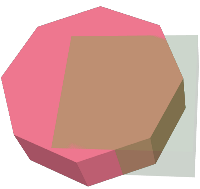 Géométries 3D originales superposées. geom2 est la partie qui sera retirée. |
SELECT CG_3DDifference(geom1,geom2)
FROM ( SELECT CG_Extrude(ST_Buffer(ST_GeomFromText('POINT(100 90)'),
50, 'quad_segs=2'),0,0,30) AS geom1,
CG_Extrude(ST_Buffer(ST_GeomFromText('POINT(80 80)'),
50, 'quad_segs=1'),0,0,30) AS geom2 ) As t;
 Ce qui reste après la suppression de geom2 |
Voir aussi
Name
CG_Distance — Calcule la distance minimale entre deux géométries
Synopsis
double precision CG_Distance( geometry geomA , geometry geomB );
Description
Calcule la distance minimale entre deux géométries.
Réalisé par le module SFCGAL
![[Note]](images/note.png) | |
NOTE : cette fonction renvoie une valeur double précision représentant la distance. |
Disponibilité : 3.5.0
 Cette méthode nécessite le backend SFCGAL.
Cette méthode nécessite le backend SFCGAL.
 Cette fonction prend en charge les triangles et les réseaux irréguliers triangulés (TIN).
Cette fonction prend en charge les triangles et les réseaux irréguliers triangulés (TIN).
Exemples de géométrie
SELECT CG_Distance('LINESTRING(0.0 0.0,-1.0 -1.0)', 'LINESTRING(3.0 4.0,4.0 5.0)');
cg_distance
-------------
2.0
(1 row)Voir aussi
Name
CG_3DDistance — Calcule la distance 3D minimale entre deux géométries
Synopsis
double precision CG_3DDistance( geometry geomA , geometry geomB );
Description
Calcule la distance 3D minimale entre deux géométries.
Réalisé par le module SFCGAL
![[Note]](images/note.png) | |
NOTE : cette fonction renvoie une valeur double précision représentant la distance 3D. |
Disponibilité : 3.5.0
 Cette méthode nécessite le backend SFCGAL.
Cette méthode nécessite le backend SFCGAL.
 Cette fonction prend en charge les triangles et les réseaux irréguliers triangulés (TIN).
Cette fonction prend en charge les triangles et les réseaux irréguliers triangulés (TIN).
Exemples de géométrie
SELECT CG_3DDistance('LINESTRING(-1.0 0.0 2.0,1.0 0.0 3.0)', 'TRIANGLE((-4.0 0.0 1.0,4.0 0.0 1.0,0.0 4.0 1.0,-4.0 0.0 1.0))');
cg_3ddistance
----------------
1
(1 row)Voir aussi
Name
ST_3DConvexHull — Calcule l'enveloppe convexe 3D d'une géométrie.
Synopsis
geometry ST_3DConvexHull(geometry geom1);
Description
![[Warning]](images/warning.png) | |
ST_3DConvexHull est obsolète depuis la version 3.5.0. Utilisez CG_3DConvexHull à la place. |
Disponibilité : 3.3.0
 Cette méthode nécessite le backend SFCGAL.
Cette méthode nécessite le backend SFCGAL.
 Cette fonction prend en charge la 3D et ne supprime pas l'indice z.
Cette fonction prend en charge la 3D et ne supprime pas l'indice z.
 Cette fonction prend en charge les surfaces Polyhedral.
Cette fonction prend en charge les surfaces Polyhedral.
 Cette fonction prend en charge les triangles et les réseaux irréguliers triangulés (TIN).
Cette fonction prend en charge les triangles et les réseaux irréguliers triangulés (TIN).
Name
CG_3DConvexHull — Calcule l'enveloppe convexe 3D d'une géométrie.
Synopsis
geometry CG_3DConvexHull(geometry geom1);
Description
Disponibilité : 3.5.0
 Cette méthode nécessite le backend SFCGAL.
Cette méthode nécessite le backend SFCGAL.
 Cette fonction prend en charge la 3D et ne supprime pas l'indice z.
Cette fonction prend en charge la 3D et ne supprime pas l'indice z.
 Cette fonction prend en charge les surfaces Polyhedral.
Cette fonction prend en charge les surfaces Polyhedral.
 Cette fonction prend en charge les triangles et les réseaux irréguliers triangulés (TIN).
Cette fonction prend en charge les triangles et les réseaux irréguliers triangulés (TIN).
Exemples
SELECT ST_AsText(CG_3DConvexHull('LINESTRING Z(0 0 5, 1 5 3, 5 7 6, 9 5 3 , 5 7 5, 6 3 5)'::geometry));POLYHEDRALSURFACE Z (((1 5 3,9 5 3,0 0 5,1 5 3)),((1 5 3,0 0 5,5 7 6,1 5 3)),((5 7 6,5 7 5,1 5 3,5 7 6)),((0 0 5,6 3 5,5 7 6,0 0 5)),((6 3 5,9 5 3,5 7 6,6 3 5)),((0 0 5,9 5 3,6 3 5,0 0 5)),((9 5 3,5 7 5,5 7 6,9 5 3)),((1 5 3,5 7 5,9 5 3,1 5 3)))
WITH f AS (SELECT i, CG_Extrude(geom, 0,0, i ) AS geom
FROM ST_Subdivide(ST_Letters('CH'),5) WITH ORDINALITY AS sd(geom,i)
)
SELECT CG_3DConvexHull(ST_Collect(f.geom) )
FROM f;
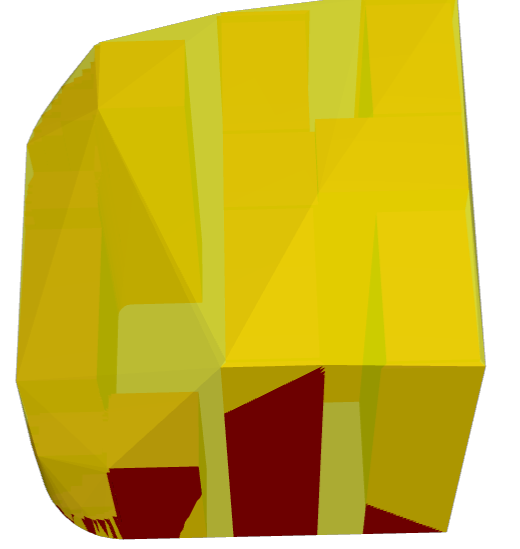
Géométrie originale superposée à l'enveloppe convexe 3D
Voir aussi
Name
ST_3DIntersection — Réaliser une intersection 3D
Synopsis
geometry ST_3DIntersection(geometry geom1, geometry geom2);
Description
![[Warning]](images/warning.png) | |
ST_3DIntersection est obsolète depuis la version 3.5.0. Utilisez CG_3DIntersection à la place. |
Renvoie une géométrie qui est la partie partagée entre geom1 et geom2.
Disponibilité : 2.1.0
 Cette méthode nécessite le backend SFCGAL.
Cette méthode nécessite le backend SFCGAL.
 Cette méthode implémente la spécification SQL/MM. SQL-MM IEC 13249-3: 5.1
Cette méthode implémente la spécification SQL/MM. SQL-MM IEC 13249-3: 5.1
 Cette fonction prend en charge la 3D et ne supprime pas l'indice z.
Cette fonction prend en charge la 3D et ne supprime pas l'indice z.
 Cette fonction prend en charge les surfaces Polyhedral.
Cette fonction prend en charge les surfaces Polyhedral.
 Cette fonction prend en charge les triangles et les réseaux irréguliers triangulés (TIN).
Cette fonction prend en charge les triangles et les réseaux irréguliers triangulés (TIN).
Name
CG_3DIntersection — Réaliser une intersection 3D
Synopsis
geometry CG_3DIntersection(geometry geom1, geometry geom2);
Description
Renvoie une géométrie qui est la partie partagée entre geom1 et geom2.
Disponibilité : 3.5.0
 Cette méthode nécessite le backend SFCGAL.
Cette méthode nécessite le backend SFCGAL.
 Cette méthode implémente la spécification SQL/MM. SQL-MM IEC 13249-3: 5.1
Cette méthode implémente la spécification SQL/MM. SQL-MM IEC 13249-3: 5.1
 Cette fonction prend en charge la 3D et ne supprime pas l'indice z.
Cette fonction prend en charge la 3D et ne supprime pas l'indice z.
 Cette fonction prend en charge les surfaces Polyhedral.
Cette fonction prend en charge les surfaces Polyhedral.
 Cette fonction prend en charge les triangles et les réseaux irréguliers triangulés (TIN).
Cette fonction prend en charge les triangles et les réseaux irréguliers triangulés (TIN).
Exemples
Les images 3D ont été générées à l'aide de PostGIS ST_AsX3D et rendues en HTML à l'aide de X3Dom HTML Javascript rendering library.
SELECT CG_Extrude(ST_Buffer(ST_GeomFromText('POINT(100 90)'),
50, 'quad_segs=2'),0,0,30) AS geom1,
CG_Extrude(ST_Buffer(ST_GeomFromText('POINT(80 80)'),
50, 'quad_segs=1'),0,0,30) AS geom2;
 Géométries 3D originales superposées. geom2 est représentée en semi-transparence |
SELECT CG_3DIntersection(geom1,geom2)
FROM ( SELECT CG_Extrude(ST_Buffer(ST_GeomFromText('POINT(100 90)'),
50, 'quad_segs=2'),0,0,30) AS geom1,
CG_Extrude(ST_Buffer(ST_GeomFromText('POINT(80 80)'),
50, 'quad_segs=1'),0,0,30) AS geom2 ) As t;
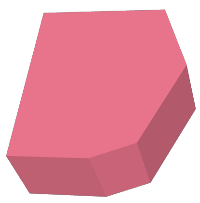 Intersection de geom1 et geom2 |
Lignes et polygones en 3D
SELECT ST_AsText(CG_3DIntersection(linestring, polygon)) As wkt
FROM ST_GeomFromText('LINESTRING Z (2 2 6,1.5 1.5 7,1 1 8,0.5 0.5 8,0 0 10)') AS linestring
CROSS JOIN ST_GeomFromText('POLYGON((0 0 8, 0 1 8, 1 1 8, 1 0 8, 0 0 8))') AS polygon;
wkt
--------------------------------
LINESTRING Z (1 1 8,0.5 0.5 8)
Cube (surface polyédrique fermée) et polygone Z
SELECT ST_AsText(CG_3DIntersection(
ST_GeomFromText('POLYHEDRALSURFACE Z( ((0 0 0, 0 0 1, 0 1 1, 0 1 0, 0 0 0)),
((0 0 0, 0 1 0, 1 1 0, 1 0 0, 0 0 0)), ((0 0 0, 1 0 0, 1 0 1, 0 0 1, 0 0 0)),
((1 1 0, 1 1 1, 1 0 1, 1 0 0, 1 1 0)),
((0 1 0, 0 1 1, 1 1 1, 1 1 0, 0 1 0)), ((0 0 1, 1 0 1, 1 1 1, 0 1 1, 0 0 1)) )'),
'POLYGON Z ((0 0 0, 0 0 0.5, 0 0.5 0.5, 0 0.5 0, 0 0 0))'::geometry))TIN Z (((0 0 0,0 0 0.5,0 0.5 0.5,0 0 0)),((0 0.5 0,0 0 0,0 0.5 0.5,0 0.5 0)))
L'intersection de 2 solides qui résulte en une intersection volumétrique est également un solide (ST_Dimension renvoie 3)
SELECT ST_AsText(CG_3DIntersection( CG_Extrude(ST_Buffer('POINT(10 20)'::geometry,10,1),0,0,30),
CG_Extrude(ST_Buffer('POINT(10 20)'::geometry,10,1),2,0,10) ));POLYHEDRALSURFACE Z (((13.3333333333333 13.3333333333333 10,20 20 0,20 20 10,13.3333333333333 13.3333333333333 10)),
((20 20 10,16.6666666666667 23.3333333333333 10,13.3333333333333 13.3333333333333 10,20 20 10)),
((20 20 0,16.6666666666667 23.3333333333333 10,20 20 10,20 20 0)),
((13.3333333333333 13.3333333333333 10,10 10 0,20 20 0,13.3333333333333 13.3333333333333 10)),
((16.6666666666667 23.3333333333333 10,12 28 10,13.3333333333333 13.3333333333333 10,16.6666666666667 23.3333333333333 10)),
((20 20 0,9.99999999999995 30 0,16.6666666666667 23.3333333333333 10,20 20 0)),
((10 10 0,9.99999999999995 30 0,20 20 0,10 10 0)),((13.3333333333333 13.3333333333333 10,12 12 10,10 10 0,13.3333333333333 13.3333333333333 10)),
((12 28 10,12 12 10,13.3333333333333 13.3333333333333 10,12 28 10)),
((16.6666666666667 23.3333333333333 10,9.99999999999995 30 0,12 28 10,16.6666666666667 23.3333333333333 10)),
((10 10 0,0 20 0,9.99999999999995 30 0,10 10 0)),
((12 12 10,11 11 10,10 10 0,12 12 10)),((12 28 10,11 11 10,12 12 10,12 28 10)),
((9.99999999999995 30 0,11 29 10,12 28 10,9.99999999999995 30 0)),((0 20 0,2 20 10,9.99999999999995 30 0,0 20 0)),
((10 10 0,2 20 10,0 20 0,10 10 0)),((11 11 10,2 20 10,10 10 0,11 11 10)),((12 28 10,11 29 10,11 11 10,12 28 10)),
((9.99999999999995 30 0,2 20 10,11 29 10,9.99999999999995 30 0)),((11 11 10,11 29 10,2 20 10,11 11 10)))Name
CG_Union — Calcule l'union de deux géométries
Synopsis
geometry CG_Union( geometry geomA , geometry geomB );
Description
Calcule l'union de deux géométries.
Réalisé par le module SFCGAL
![[Note]](images/note.png) | |
NOTE : cette fonction renvoie une géométrie représentant l'union. |
Disponibilité : 3.5.0
 Cette méthode nécessite le backend SFCGAL.
Cette méthode nécessite le backend SFCGAL.
Exemples de géométrie
SELECT CG_Union('POINT(.5 0)', 'LINESTRING(-1 0,1 0)');
cg_union
-----------
LINESTRING(-1 0,0.5 0,1 0)
(1 row)Voir aussi
Name
ST_3DUnion — Effectuer l'union 3D.
Synopsis
geometry ST_3DUnion(geometry geom1, geometry geom2);
geometry ST_3DUnion(geometry set g1field);
Description
![[Warning]](images/warning.png) | |
ST_3DUnion est obsolète depuis la version 3.5.0. Utilisez CG_3DUnion à la place. |
Disponibilité : 2.2.0
Disponibilité : 3.3.0 la variante agrégée a été ajoutée
 Cette méthode nécessite le backend SFCGAL.
Cette méthode nécessite le backend SFCGAL.
 Cette méthode implémente la spécification SQL/MM. SQL-MM IEC 13249-3: 5.1
Cette méthode implémente la spécification SQL/MM. SQL-MM IEC 13249-3: 5.1
 Cette fonction prend en charge la 3D et ne supprime pas l'indice z.
Cette fonction prend en charge la 3D et ne supprime pas l'indice z.
 Cette fonction prend en charge les surfaces Polyhedral.
Cette fonction prend en charge les surfaces Polyhedral.
 Cette fonction prend en charge les triangles et les réseaux irréguliers triangulés (TIN).
Cette fonction prend en charge les triangles et les réseaux irréguliers triangulés (TIN).
Variante agrégée: renvoie une géométrie qui est l'union 3D d'un ensemble de géométries. La fonction ST_3DUnion() est une fonction "agrégée" dans la terminologie de PostgreSQL. Cela signifie qu'elle opère sur des lignes de données, de la même manière que les fonctions SUM() et AVG() et, comme la plupart des agrégats, elle ignore les géométries NULL.
Name
CG_3DUnion — Réaliser l'union 3D en utilisant postgis_sfcgal.
Synopsis
geometry CG_3DUnion(geometry geom1, geometry geom2);
geometry CG_3DUnion(geometry set g1field);
Description
Disponibilité : 3.5.0
 Cette méthode nécessite le backend SFCGAL.
Cette méthode nécessite le backend SFCGAL.
 Cette méthode implémente la spécification SQL/MM. SQL-MM IEC 13249-3: 5.1
Cette méthode implémente la spécification SQL/MM. SQL-MM IEC 13249-3: 5.1
 Cette fonction prend en charge la 3D et ne supprime pas l'indice z.
Cette fonction prend en charge la 3D et ne supprime pas l'indice z.
 Cette fonction prend en charge les surfaces Polyhedral.
Cette fonction prend en charge les surfaces Polyhedral.
 Cette fonction prend en charge les triangles et les réseaux irréguliers triangulés (TIN).
Cette fonction prend en charge les triangles et les réseaux irréguliers triangulés (TIN).
Variante aggregate : renvoie une géométrie qui est l'union 3D d'un ensemble de géométries. La fonction CG_3DUnion() est une fonction "aggregate" dans la terminologie de PostgreSQL. Cela signifie qu'elle opère sur des lignes de données, de la même manière que les fonctions SUM() et AVG() et, comme la plupart des agrégats, elle ignore les géométries NULL.
Exemples
Les images 3D ont été générées à l'aide de PostGIS ST_AsX3D et rendues en HTML à l'aide de X3Dom HTML Javascript rendering library.
SELECT CG_Extrude(ST_Buffer(ST_GeomFromText('POINT(100 90)'),
50, 'quad_segs=2'),0,0,30) AS geom1,
CG_Extrude(ST_Buffer(ST_GeomFromText('POINT(80 80)'),
50, 'quad_segs=1'),0,0,30) AS geom2;
 Géométries 3D originales superposées. geom2 est celle qui est transparente. |
SELECT CG_3DUnion(geom1,geom2)
FROM ( SELECT CG_Extrude(ST_Buffer(ST_GeomFromText('POINT(100 90)'),
50, 'quad_segs=2'),0,0,30) AS geom1,
CG_Extrude(ST_Buffer(ST_GeomFromText('POINT(80 80)'),
50, 'quad_segs=1'),0,0,30) AS geom2 ) As t;
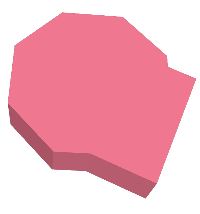 Union de geom1 et geom2 |
Voir aussi
Name
ST_AlphaShape — Calcul d'une forme Alpha entourant une géométrie
Synopsis
geometry ST_AlphaShape(geometry geom, float alpha, boolean allow_holes = false);
Description
![[Warning]](images/warning.png) | |
ST_AlphaShape est obsolète depuis la version 3.5.0. Utilisez CG_AlphaShape à la place. |
Calcule la forme alpha des points d'une géométrie. Une forme alpha est une géométrie polygonale (généralement) concave qui contient tous les sommets de l'entrée et dont les sommets sont un sous-ensemble des sommets de l'entrée. Une forme alpha permet de se rapprocher davantage de la forme de l'entrée que la forme produite par l' enveloppe convexe.
Name
CG_AlphaShape — Calcul d'une forme Alpha entourant une géométrie
Synopsis
geometry CG_AlphaShape(geometry geom, float alpha, boolean allow_holes = false);
Description
Calcule la forme alpha des points d'une géométrie. Une forme alpha est une géométrie polygonale (généralement) concave qui contient tous les sommets de l'entrée et dont les sommets sont un sous-ensemble des sommets de l'entrée. Une forme alpha permet de se rapprocher davantage de la forme de l'entrée que la forme produite par l' enveloppe convexe.
La "proximité de l'ajustement" est contrôlée par le paramètre alpha, qui peut prendre des valeurs comprises entre 0 et l'infini. Des valeurs alpha plus petites produisent des résultats plus concaves. Les valeurs alpha supérieures à une certaine valeur dépendant des données produisent l'enveloppe convexe de l'entrée.
![[Note]](images/note.png) | |
Conformément à l'implémentation du CGAL, la valeur alpha est le carré du rayon du disque utilisé dans l'algorithme Alpha-Shape pour "éroder" la triangulation de Delaunay des points d'entrée. Voir CGAL Alpha-Shapes pour plus d'informations. Cela diffère de la définition originale des formes alpha, qui définit alpha comme le rayon du disque d'érosion. |
La forme calculée ne contient pas de trous, sauf si l'argument facultatif allow_holes est spécifié comme true.
Cette fonction calcule effectivement une enveloppe concave d'une géométrie d'une manière similaire à ST_ConcaveHull, mais utilise CGAL et un algorithme différent.
Disponibilité : 3.5.0 - nécessite SFCGAL >= 1.4.1.
 Cette méthode nécessite le backend SFCGAL.
Cette méthode nécessite le backend SFCGAL.
Exemples
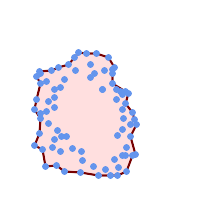
Forme alpha d'un MultiPoint (même exemple que CG_OptimalAlphaShape)
SELECT ST_AsText(CG_AlphaShape('MULTIPOINT((63 84),(76 88),(68 73),(53 18),(91 50),(81 70),
(88 29),(24 82),(32 51),(37 23),(27 54),(84 19),(75 87),(44 42),(77 67),(90 30),(36 61),(32 65),
(81 47),(88 58),(68 73),(49 95),(81 60),(87 50),
(78 16),(79 21),(30 22),(78 43),(26 85),(48 34),(35 35),(36 40),(31 79),(83 29),(27 84),(52 98),(72 95),(85 71),
(75 84),(75 77),(81 29),(77 73),(41 42),(83 72),(23 36),(89 53),(27 57),(57 97),(27 77),(39 88),(60 81),
(80 72),(54 32),(55 26),(62 22),(70 20),(76 27),(84 35),(87 42),(82 54),(83 64),(69 86),(60 90),(50 86),(43 80),(36 73),
(36 68),(40 75),(24 67),(23 60),(26 44),(28 33),(40 32),(43 19),(65 16),(73 16),(38 46),(31 59),(34 86),(45 90),(64 97))'::geometry,80.2));
POLYGON((89 53,91 50,87 42,90 30,88 29,84 19,78 16,73 16,65 16,53 18,43 19,
37 23,30 22,28 33,23 36,26 44,27 54,23 60,24 67,27 77,
24 82,26 85,34 86,39 88,45 90,49 95,52 98,57 97,
64 97,72 95,76 88,75 84,83 72,85 71,88 58,89 53))
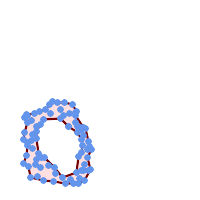
Forme alpha d'un MultiPoint, autorisant les trous (même exemple que CG_OptimalAlphaShape)
SELECT ST_AsText(CG_AlphaShape('MULTIPOINT((63 84),(76 88),(68 73),(53 18),(91 50),(81 70),(88 29),(24 82),(32 51),(37 23),(27 54),(84 19),(75 87),(44 42),(77 67),(90 30),(36 61),(32 65),(81 47),(88 58),(68 73),(49 95),(81 60),(87 50),
(78 16),(79 21),(30 22),(78 43),(26 85),(48 34),(35 35),(36 40),(31 79),(83 29),(27 84),(52 98),(72 95),(85 71),
(75 84),(75 77),(81 29),(77 73),(41 42),(83 72),(23 36),(89 53),(27 57),(57 97),(27 77),(39 88),(60 81),
(80 72),(54 32),(55 26),(62 22),(70 20),(76 27),(84 35),(87 42),(82 54),(83 64),(69 86),(60 90),(50 86),(43 80),(36 73),
(36 68),(40 75),(24 67),(23 60),(26 44),(28 33),(40 32),(43 19),(65 16),(73 16),(38 46),(31 59),(34 86),(45 90),(64 97))'::geometry, 100.1,true))
POLYGON((89 53,91 50,87 42,90 30,84 19,78 16,73 16,65 16,53 18,43 19,30 22,28 33,23 36, 26 44,27 54,23 60,24 67,27 77,24 82,26 85,34 86,39 88,45 90,49 95,52 98,57 97,64 97,72 95, 76 88,75 84,83 72,85 71,88 58,89 53),(36 61,36 68,40 75,43 80,60 81,68 73,77 67, 81 60,82 54,81 47,78 43,76 27,62 22,54 32,44 42,38 46,36 61))
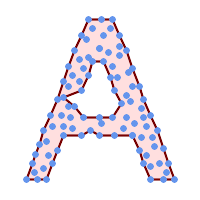
Forme alpha d'un MultiPoint, autorisant les trous (même exemple que ST_ConcaveHull)
SELECT ST_AsText(CG_AlphaShape(
'MULTIPOINT ((132 64), (114 64), (99 64), (81 64), (63 64), (57 49), (52 36), (46 20), (37 20), (26 20), (32 36), (39 55), (43 69), (50 84), (57 100), (63 118), (68 133), (74 149), (81 164), (88 180), (101 180), (112 180), (119 164), (126 149), (132 131), (139 113), (143 100), (150 84), (157 69), (163 51), (168 36), (174 20), (163 20), (150 20), (143 36), (139 49), (132 64), (99 151), (92 138), (88 124), (81 109), (74 93), (70 82), (83 82), (99 82), (112 82), (126 82), (121 96), (114 109), (110 122), (103 138), (99 151), (34 27), (43 31), (48 44), (46 58), (52 73), (63 73), (61 84), (72 71), (90 69), (101 76), (123 71), (141 62), (166 27), (150 33), (159 36), (146 44), (154 53), (152 62), (146 73), (134 76), (143 82), (141 91), (130 98), (126 104), (132 113), (128 127), (117 122), (112 133), (119 144), (108 147), (119 153), (110 171), (103 164), (92 171), (86 160), (88 142), (79 140), (72 124), (83 131), (79 118), (68 113), (63 102), (68 93), (35 45))'::geometry,102.2, true));
POLYGON((26 20,32 36,35 45,39 55,43 69,50 84,57 100,63 118,68 133,74 149,81 164,88 180,
101 180,112 180,119 164,126 149,132 131,139 113,143 100,150 84,157 69,163 51,168 36,
174 20,163 20,150 20,143 36,139 49,132 64,114 64,99 64,90 69,81 64,63 64,57 49,52 36,46 20,37 20,26 20),
(74 93,81 109,88 124,92 138,103 138,110 122,114 109,121 96,112 82,99 82,83 82,74 93))
Voir aussi
Name
CG_ApproxConvexPartition — Calcul de la partition convexe approximative de la géométrie du polygone
Synopsis
geometry CG_ApproxConvexPartition(geometry geom);
Description
Calcule la partition convexe approximative de la géométrie du polygone (à l'aide d'une triangulation).
![[Note]](images/note.png) | |
Une partition d'un polygone P est un ensemble de polygones tels que les intérieurs des polygones ne se coupent pas et que l'union des polygones est égale à l'intérieur du polygone original P. Les fonctions CG_ApproxConvexPartition et CG_GreeneApproxConvexPartition produisent des partitions convexes approximativement optimales. Ces deux fonctions produisent des décompositions convexes en décomposant d'abord le polygone en polygones plus simples ; CG_ApproxConvexPartition utilise une triangulation et CG_GreeneApproxConvexPartition une partition monotone. Ces deux fonctions garantissent toutes deux qu'elles ne produiront pas plus de quatre fois le nombre optimal de pièces convexes, mais elles diffèrent par leur complexité d'exécution. Bien que l'algorithme d'approximation basé sur la triangulation produise souvent moins de pièces convexes, ce n'est pas toujours le cas. |
Disponibilité : 3.5.0 - nécessite SFCGAL >= 1.5.0.
Nécessite SFCGAL >= 1.5.0
 Cette méthode nécessite le backend SFCGAL.
Cette méthode nécessite le backend SFCGAL.
Exemples
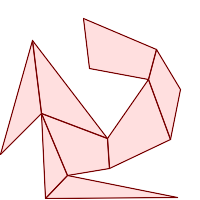
Partition convexe approximative (même exemple que CG_YMonotonePartition, CG_GreeneApproxConvexPartition et CG_OptimalConvexPartition)
SELECT ST_AsText(CG_ApproxConvexPartition('POLYGON((156 150,83 181,89 131,148 120,107 61,32 159,0 45,41 86,45 1,177 2,67 24,109 31,170 60,180 110,156 150))'::geometry));
GEOMETRYCOLLECTION(POLYGON((156 150,83 181,89 131,148 120,156 150)),POLYGON((32 159,0 45,41 86,32 159)),POLYGON((107 61,32 159,41 86,107 61)),POLYGON((45 1,177 2,67 24,45 1)),POLYGON((41 86,45 1,67 24,41 86)),POLYGON((107 61,41 86,67 24,109 31,107 61)),POLYGON((148 120,107 61,109 31,170 60,148 120)),POLYGON((156 150,148 120,170 60,180 110,156 150)))
Name
ST_ApproximateMedialAxis — Calculer l'axe médian approximatif d'une géométrie aréolaire.
Synopsis
geometry ST_ApproximateMedialAxis(geometry geom);
Description
![[Warning]](images/warning.png) | |
ST_ApproximateMedialAxis est obsolète depuis la version 3.5.0. Utilisez CG_ApproximateMedialAxis à la place. |
Retourne un axe médian approximatif pour l'entrée aréolaire en se basant sur son squelette (straight skeleton). Utilise une API spécifique à SFCGAL lorsque compilée avec une version compatible (1.2.0+). Sinon, la fonction est juste un wrapper de CG_StraightSkeleton (cas le plus lent).
Disponibilité : 2.2.0
 Cette méthode nécessite le backend SFCGAL.
Cette méthode nécessite le backend SFCGAL.
 Cette fonction prend en charge la 3D et ne supprime pas l'indice z.
Cette fonction prend en charge la 3D et ne supprime pas l'indice z.
 Cette fonction prend en charge les surfaces Polyhedral.
Cette fonction prend en charge les surfaces Polyhedral.
 Cette fonction prend en charge les triangles et les réseaux irréguliers triangulés (TIN).
Cette fonction prend en charge les triangles et les réseaux irréguliers triangulés (TIN).
Name
CG_ApproximateMedialAxis — Calculer l'axe médian approximatif d'une géométrie aréolaire.
Synopsis
geometry CG_ApproximateMedialAxis(geometry geom);
Description
Retourne un axe médian approximatif pour l'entrée aréolaire en se basant sur son squelette (straight skeleton). Utilise une API spécifique à SFCGAL lorsque compilée avec une version compatible (1.2.0+). Sinon, la fonction est juste un wrapper de CG_StraightSkeleton (cas le plus lent).
Disponibilité : 3.5.0
![[Note]](images/note.png) | |
Cette fonction ignore la dimension Z. Elle donne toujours un résultat en 2D, même lorsqu'elle est utilisée sur une géométrie en 3D. |
 Cette méthode nécessite le backend SFCGAL.
Cette méthode nécessite le backend SFCGAL.
 Cette fonction prend en charge les surfaces Polyhedral.
Cette fonction prend en charge les surfaces Polyhedral.
 Cette fonction prend en charge les triangles et les réseaux irréguliers triangulés (TIN).
Cette fonction prend en charge les triangles et les réseaux irréguliers triangulés (TIN).
Exemples
SELECT CG_ApproximateMedialAxis(ST_GeomFromText('POLYGON (( 190 190, 10 190, 10 10, 190 10, 190 20, 160 30, 60 30, 60 130, 190 140, 190 190 ))'));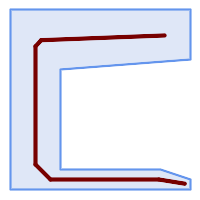 Un polygone et son axe médian approximatif |
Voir aussi
Name
ST_ConstrainedDelaunayTriangles — Renvoie une triangulation de Delaunay contrainte autour de la géométrie d'entrée donnée.
Synopsis
geometry ST_ConstrainedDelaunayTriangles(geometry g1);
Description
![[Warning]](images/warning.png) | |
ST_ConstrainedDelaunayTriangles est obsolète depuis la version 3.5.0. Utilisez CG_ConstrainedDelaunayTriangles à la place. |
Renvoie un Constrained Delaunay triangulation autour des sommets de la géométrie d'entrée. Le résultat est un TIN.
 Cette méthode nécessite le backend SFCGAL.
Cette méthode nécessite le backend SFCGAL.
Disponibilité : 3.0.0
 Cette fonction prend en charge la 3D et ne supprime pas l'indice z.
Cette fonction prend en charge la 3D et ne supprime pas l'indice z.
Name
CG_ConstrainedDelaunayTriangles — Renvoie une triangulation de Delaunay contrainte autour de la géométrie d'entrée donnée.
Synopsis
geometry CG_ConstrainedDelaunayTriangles(geometry g1);
Description
Renvoie un Constrained Delaunay triangulation autour des sommets de la géométrie d'entrée. Le résultat est un TIN.
 Cette méthode nécessite le backend SFCGAL.
Cette méthode nécessite le backend SFCGAL.
Disponibilité : 3.0.0
 Cette fonction prend en charge la 3D et ne supprime pas l'indice z.
Cette fonction prend en charge la 3D et ne supprime pas l'indice z.
Exemples
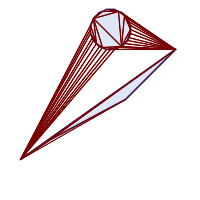 CG_ConstrainedDelaunayTriangles de 2 polygones
select CG_ConstrainedDelaunayTriangles(
ST_Union(
'POLYGON((175 150, 20 40, 50 60, 125 100, 175 150))'::geometry,
ST_Buffer('POINT(110 170)'::geometry, 20)
)
);
| 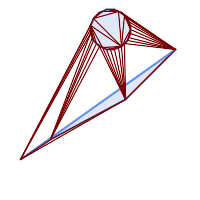 ST_DelaunayTriangles de 2 polygones. Les arêtes des triangles traversent les limites des polygones.
select ST_DelaunayTriangles(
ST_Union(
'POLYGON((175 150, 20 40, 50 60, 125 100, 175 150))'::geometry,
ST_Buffer('POINT(110 170)'::geometry, 20)
)
);
|
Name
ST_Extrude — Extruder une surface vers un volume
Synopsis
geometry ST_Extrude(geometry geom, float x, float y, float z);
Description
![[Warning]](images/warning.png) | |
ST_Extrude est obsolète depuis la version 3.5.0. Utilisez CG_Extrude à la place. |
Disponibilité : 2.1.0
 Cette méthode nécessite le backend SFCGAL.
Cette méthode nécessite le backend SFCGAL.
 Cette fonction prend en charge la 3D et ne supprime pas l'indice z.
Cette fonction prend en charge la 3D et ne supprime pas l'indice z.
 Cette fonction prend en charge les surfaces Polyhedral.
Cette fonction prend en charge les surfaces Polyhedral.
 Cette fonction prend en charge les triangles et les réseaux irréguliers triangulés (TIN).
Cette fonction prend en charge les triangles et les réseaux irréguliers triangulés (TIN).
Name
CG_Extrude — Extruder une surface vers un volume
Synopsis
geometry CG_Extrude(geometry geom, float x, float y, float z);
Description
Disponibilité : 3.5.0
 Cette méthode nécessite le backend SFCGAL.
Cette méthode nécessite le backend SFCGAL.
 Cette fonction prend en charge la 3D et ne supprime pas l'indice z.
Cette fonction prend en charge la 3D et ne supprime pas l'indice z.
 Cette fonction prend en charge les surfaces Polyhedral.
Cette fonction prend en charge les surfaces Polyhedral.
 Cette fonction prend en charge les triangles et les réseaux irréguliers triangulés (TIN).
Cette fonction prend en charge les triangles et les réseaux irréguliers triangulés (TIN).
Exemples
Les images 3D ont été générées à l'aide de PostGIS ST_AsX3D et rendues en HTML à l'aide de X3Dom HTML Javascript rendering library.
SELECT ST_Buffer(ST_GeomFromText('POINT(100 90)'),
50, 'quad_segs=2'),0,0,30);
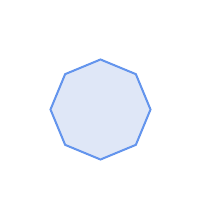 Octogone original formé à partir du point tampon |
CG_Extrude(ST_Buffer(ST_GeomFromText('POINT(100 90)'),
50, 'quad_segs=2'),0,0,30);
 Un hexagone extrudé de 30 unités le long de Z produit une PolyhedralSurfaceZ |
SELECT ST_GeomFromText('LINESTRING(50 50, 100 90, 95 150)')
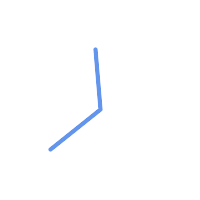 Ligne d'origine |
SELECT CG_Extrude(
ST_GeomFromText('LINESTRING(50 50, 100 90, 95 150)'),0,0,10));
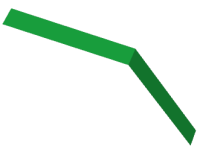 LineString extrudé le long de Z produit une PolyhedralSurfaceZ |
Voir aussi
Name
CG_ExtrudeStraightSkeleton — Extrusion de squelette droit
Synopsis
geometry CG_ExtrudeStraightSkeleton(geometry geom, float roof_height, float body_height = 0);
Description
Calcule une extrusion avec une hauteur maximale de la géométrie du polygone.
![[Note]](images/note.png) | |
Il s'agit peut-être du premier cas d'utilisation (historique) des squelettes droits : étant donné un toit polygonal, le squelette droit donne directement la disposition de chaque tente. Si chaque arête du squelette est soulevée du plan d'une hauteur égale à sa distance de décalage, le toit résultant est "correct" en ce sens que l'eau tombera toujours vers les bords du contour (la bordure du toit), quel que soit l'endroit où elle tombe sur le toit. La fonction calcule cette extrusion ou "toit" sur un polygone. Si l'argument body_height > 0, alors le polygone est extrudé comme avec CG_Extrude(polygon, 0, 0, body_height). Le résultat est une union de ces polyedres surfaciques. |
Disponibilité : 3.5.0 - nécessite SFCGAL >= 1.5.0.
Nécessite SFCGAL >= 1.5.0
 Cette méthode nécessite le backend SFCGAL.
Cette méthode nécessite le backend SFCGAL.
Exemples
SELECT ST_AsText(CG_ExtrudeStraightSkeleton('POLYGON (( 0 0, 5 0, 5 5, 4 5, 4 4, 0 4, 0 0 ), (1 1, 1 2,2 2, 2 1, 1 1))', 3.0, 2.0));
POLYHEDRALSURFACE Z (((0 0 0,0 4 0,4 4 0,4 5 0,5 5 0,5 0 0,0 0 0),(1 1 0,2 1 0,2 2 0,1 2 0,1 1 0)),((0 0 0,0 0 2,0 4 2,0 4 0,0 0 0)),((0 4 0,0 4 2,4 4 2,4 4 0,0 4 0)),((4 4 0,4 4 2,4 5 2,4 5 0,4 4 0)),((4 5 0,4 5 2,5 5 2,5 5 0,4 5 0)),((5 5 0,5 5 2,5 0 2,5 0 0,5 5 0)),((5 0 0,5 0 2,0 0 2,0 0 0,5 0 0)),((1 1 0,1 1 2,2 1 2,2 1 0,1 1 0)),((2 1 0,2 1 2,2 2 2,2 2 0,2 1 0)),((2 2 0,2 2 2,1 2 2,1 2 0,2 2 0)),((1 2 0,1 2 2,1 1 2,1 1 0,1 2 0)),((0.5 2.5 2.5,0 0 2,0.5 0.5 2.5,0.5 2.5 2.5)),((1 3 3,0 4 2,0.5 2.5 2.5,1 3 3)),((0.5 2.5 2.5,0 4 2,0 0 2,0.5 2.5 2.5)),((2.5 0.5 2.5,5 0 2,3.5 1.5 3.5,2.5 0.5 2.5)),((0 0 2,5 0 2,2.5 0.5 2.5,0 0 2)),((0.5 0.5 2.5,0 0 2,2.5 0.5 2.5,0.5 0.5 2.5)),((4.5 3.5 2.5,5 5 2,4.5 4.5 2.5,4.5 3.5 2.5)),((3.5 2.5 3.5,3.5 1.5 3.5,4.5 3.5 2.5,3.5 2.5 3.5)),((4.5 3.5 2.5,5 0 2,5 5 2,4.5 3.5 2.5)),((3.5 1.5 3.5,5 0 2,4.5 3.5 2.5,3.5 1.5 3.5)),((5 5 2,4 5 2,4.5 4.5 2.5,5 5 2)),((4.5 4.5 2.5,4 4 2,4.5 3.5 2.5,4.5 4.5 2.5)),((4.5 4.5 2.5,4 5 2,4 4 2,4.5 4.5 2.5)),((3 3 3,0 4 2,1 3 3,3 3 3)),((3.5 2.5 3.5,4.5 3.5 2.5,3 3 3,3.5 2.5 3.5)),((3 3 3,4 4 2,0 4 2,3 3 3)),((4.5 3.5 2.5,4 4 2,3 3 3,4.5 3.5 2.5)),((2 1 2,1 1 2,0.5 0.5 2.5,2 1 2)),((2.5 0.5 2.5,2 1 2,0.5 0.5 2.5,2.5 0.5 2.5)),((1 1 2,1 2 2,0.5 2.5 2.5,1 1 2)),((0.5 0.5 2.5,1 1 2,0.5 2.5 2.5,0.5 0.5 2.5)),((1 3 3,2 2 2,3 3 3,1 3 3)),((0.5 2.5 2.5,1 2 2,1 3 3,0.5 2.5 2.5)),((1 3 3,1 2 2,2 2 2,1 3 3)),((2 2 2,2 1 2,2.5 0.5 2.5,2 2 2)),((3.5 2.5 3.5,3 3 3,3.5 1.5 3.5,3.5 2.5 3.5)),((3.5 1.5 3.5,2 2 2,2.5 0.5 2.5,3.5 1.5 3.5)),((3 3 3,2 2 2,3.5 1.5 3.5,3 3 3)))
Name
CG_GreeneApproxConvexPartition — Calcul de la partition convexe approximative de la géométrie du polygone
Synopsis
geometry CG_GreeneApproxConvexPartition(geometry geom);
Description
Calcule une partition convexe approximative monotone de la géométrie du polygone.
![[Note]](images/note.png) | |
Une partition d'un polygone P est un ensemble de polygones tels que les intérieurs des polygones ne se coupent pas et que l'union des polygones est égale à l'intérieur du polygone original P. Les fonctions CG_ApproxConvexPartition et CG_GreeneApproxConvexPartition produisent des partitions convexes approximativement optimales. Ces deux fonctions produisent des décompositions convexes en décomposant d'abord le polygone en polygones plus simples ; CG_ApproxConvexPartition utilise une triangulation et CG_GreeneApproxConvexPartition une partition monotone. Ces deux fonctions garantissent toutes deux qu'elles ne produiront pas plus de quatre fois le nombre optimal de pièces convexes, mais elles diffèrent par leur complexité d'exécution. Bien que l'algorithme d'approximation basé sur la triangulation produise souvent moins de pièces convexes, ce n'est pas toujours le cas. |
Disponibilité : 3.5.0 - nécessite SFCGAL >= 1.5.0.
Nécessite SFCGAL >= 1.5.0
 Cette méthode nécessite le backend SFCGAL.
Cette méthode nécessite le backend SFCGAL.
Exemples
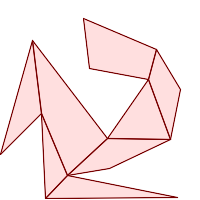
Partition convexe approximative de Greene (même exemple que CG_YMonotonePartition, CG_ApproxConvexPartition et CG_OptimalConvexPartition)
SELECT ST_AsText(CG_GreeneApproxConvexPartition('POLYGON((156 150,83 181,89 131,148 120,107 61,32 159,0 45,41 86,45 1,177 2,67 24,109 31,170 60,180 110,156 150))'::geometry));
GEOMETRYCOLLECTION(POLYGON((32 159,0 45,41 86,32 159)),POLYGON((45 1,177 2,67 24,45 1)),POLYGON((67 24,109 31,170 60,107 61,67 24)),POLYGON((41 86,45 1,67 24,41 86)),POLYGON((107 61,32 159,41 86,67 24,107 61)),POLYGON((148 120,107 61,170 60,148 120)),POLYGON((148 120,170 60,180 110,156 150,148 120)),POLYGON((156 150,83 181,89 131,148 120,156 150)))
Name
ST_MinkowskiSum — Effectue la somme de Minkowski
Synopsis
geometry ST_MinkowskiSum(geometry geom1, geometry geom2);
Description
![[Warning]](images/warning.png) | |
ST_MinkowskiSum est obsolète depuis la version 3.5.0. Utilisez CG_MinkowskiSum à la place. |
Cette fonction effectue une somme de minkowski en 2D d'un point, d'une ligne ou d'un polygone avec un polygone.
Une somme de minkowski de deux géométries A et B est l'ensemble de tous les points qui sont la somme de n'importe quel point de A et B. Les sommes de minkowski sont souvent utilisées dans la planification des mouvements et la conception assistée par ordinateur. Plus de détails sur Wikipedia Addition de Minkowski.
Le premier paramètre peut être n'importe quelle géométrie 2D (point, ligne, polygone). Si une géométrie 3D est transmise, elle sera convertie en 2D en forçant Z à 0, ce qui peut entraîner des cas d'invalidité. Le second paramètre doit être un polygone 2D.
La mise en œuvre utilise CGAL 2D Minkowskisum.
Disponibilité : 2.1.0
 Cette méthode nécessite le backend SFCGAL.
Cette méthode nécessite le backend SFCGAL.
Name
CG_MinkowskiSum — Effectue la somme de Minkowski
Synopsis
geometry CG_MinkowskiSum(geometry geom1, geometry geom2);
Description
Cette fonction effectue une somme de minkowski en 2D d'un point, d'une ligne ou d'un polygone avec un polygone.
Une somme de minkowski de deux géométries A et B est l'ensemble de tous les points qui sont la somme de n'importe quel point de A et B. Les sommes de minkowski sont souvent utilisées dans la planification des mouvements et la conception assistée par ordinateur. Plus de détails sur Wikipedia Addition de Minkowski.
Le premier paramètre peut être n'importe quelle géométrie 2D (point, ligne, polygone). Si une géométrie 3D est transmise, elle sera convertie en 2D en forçant Z à 0, ce qui peut entraîner des cas d'invalidité. Le second paramètre doit être un polygone 2D.
La mise en œuvre utilise CGAL 2D Minkowskisum.
Disponibilité : 3.5.0
 Cette méthode nécessite le backend SFCGAL.
Cette méthode nécessite le backend SFCGAL.
Exemples
Somme de Minkowski d'une ligne et d'un cercle polygonal où la ligne traverse le cercle
|
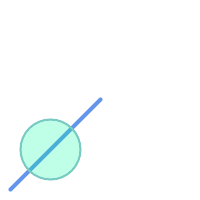 Avant la somme
|
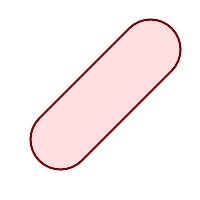 Après la somme
|
SELECT CG_MinkowskiSum(line, circle))
FROM (SELECT
ST_MakeLine(ST_Point(10, 10),ST_Point(100, 100)) As line,
ST_Buffer(ST_GeomFromText('POINT(50 50)'), 30) As circle) As foo;
-- wkt --
MULTIPOLYGON(((30 59.9999999999999,30.5764415879031 54.1472903395161,32.2836140246614 48.5194970290472,35.0559116309237 43.3328930094119,38.7867965644036 38.7867965644035,43.332893009412 35.0559116309236,48.5194970290474 32.2836140246614,54.1472903395162 30.5764415879031,60.0000000000001 30,65.8527096604839 30.5764415879031,71.4805029709527 32.2836140246614,76.6671069905881 35.0559116309237,81.2132034355964 38.7867965644036,171.213203435596 128.786796564404,174.944088369076 133.332893009412,177.716385975339 138.519497029047,179.423558412097 144.147290339516,180 150,179.423558412097 155.852709660484,177.716385975339 161.480502970953,174.944088369076 166.667106990588,171.213203435596 171.213203435596,166.667106990588 174.944088369076,
161.480502970953 177.716385975339,155.852709660484 179.423558412097,150 180,144.147290339516 179.423558412097,138.519497029047 177.716385975339,133.332893009412 174.944088369076,128.786796564403 171.213203435596,38.7867965644035 81.2132034355963,35.0559116309236 76.667106990588,32.2836140246614 71.4805029709526,30.5764415879031 65.8527096604838,30 59.9999999999999)))
Somme de Minkowski d'un polygone et d'un multipoint
|
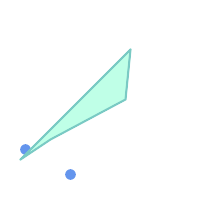 Avant la somme
|
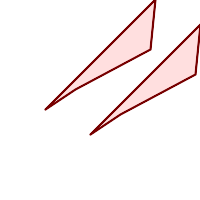 Après la somme : le polygone est dupliqué et traduit en position de points
|
SELECT CG_MinkowskiSum(mp, poly)
FROM (SELECT 'MULTIPOINT(25 50,70 25)'::geometry As mp,
'POLYGON((130 150, 20 40, 50 60, 125 100, 130 150))'::geometry As poly
) As foo
-- wkt --
MULTIPOLYGON(
((70 115,100 135,175 175,225 225,70 115)),
((120 65,150 85,225 125,275 175,120 65))
)
Name
ST_OptimalAlphaShape — Calcule une forme alpha entourant une géométrie en utilisant une valeur alpha "optimale".
Synopsis
geometry ST_OptimalAlphaShape(geometry geom, boolean allow_holes = false, integer nb_components = 1);
Description
![[Warning]](images/warning.png) | |
ST_OptimalAlphaShape est obsolète depuis la version 3.5.0. Utilisez CG_OptimalAlphaShape à la place. |
Calcule la forme alpha "optimale" des points d'une géométrie. La forme alpha est calculée en utilisant une valeur de α choisie de telle sorte que :
le nombre d'éléments du polygone est égal ou inférieur à
nb_components(qui vaut 1 par défaut)tous les points d'entrée sont contenus dans la forme
Le résultat ne contiendra pas de trous à moins que l'argument facultatif allow_holes ne soit spécifié comme true.
Disponibilité : 3.3.0 - nécessite SFCGAL >= 1.4.1.
 Cette méthode nécessite le backend SFCGAL.
Cette méthode nécessite le backend SFCGAL.
Name
CG_OptimalAlphaShape — Calcule une forme alpha entourant une géométrie en utilisant une valeur alpha "optimale".
Synopsis
geometry CG_OptimalAlphaShape(geometry geom, boolean allow_holes = false, integer nb_components = 1);
Description
Calcule la forme alpha "optimale" des points d'une géométrie. La forme alpha est calculée en utilisant une valeur de α choisie de telle sorte que :
le nombre d'éléments du polygone est égal ou inférieur à
nb_components(qui vaut 1 par défaut)tous les points d'entrée sont contenus dans la forme
Le résultat ne contiendra pas de trous à moins que l'argument facultatif allow_holes ne soit spécifié comme true.
Disponibilité : 3.5.0 - nécessite SFCGAL >= 1.4.1.
 Cette méthode nécessite le backend SFCGAL.
Cette méthode nécessite le backend SFCGAL.
Exemples
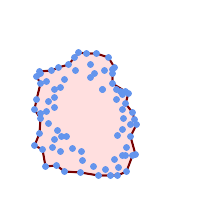
Forme alpha optimale d'un MultiPoint (même exemple que CG_AlphaShape)
SELECT ST_AsText(CG_OptimalAlphaShape('MULTIPOINT((63 84),(76 88),(68 73),(53 18),(91 50),(81 70),
(88 29),(24 82),(32 51),(37 23),(27 54),(84 19),(75 87),(44 42),(77 67),(90 30),(36 61),(32 65),
(81 47),(88 58),(68 73),(49 95),(81 60),(87 50),
(78 16),(79 21),(30 22),(78 43),(26 85),(48 34),(35 35),(36 40),(31 79),(83 29),(27 84),(52 98),(72 95),(85 71),
(75 84),(75 77),(81 29),(77 73),(41 42),(83 72),(23 36),(89 53),(27 57),(57 97),(27 77),(39 88),(60 81),
(80 72),(54 32),(55 26),(62 22),(70 20),(76 27),(84 35),(87 42),(82 54),(83 64),(69 86),(60 90),(50 86),(43 80),(36 73),
(36 68),(40 75),(24 67),(23 60),(26 44),(28 33),(40 32),(43 19),(65 16),(73 16),(38 46),(31 59),(34 86),(45 90),(64 97))'::geometry));
POLYGON((89 53,91 50,87 42,90 30,88 29,84 19,78 16,73 16,65 16,53 18,43 19,37 23,30 22,28 33,23 36,
26 44,27 54,23 60,24 67,27 77,24 82,26 85,34 86,39 88,45 90,49 95,52 98,57 97,64 97,72 95,76 88,75 84,75 77,83 72,85 71,83 64,88 58,89 53))
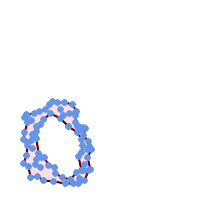
Forme alpha optimale d'un MultiPoint, autorisant les trous (même exemple que CG_AlphaShape)
SELECT ST_AsText(CG_OptimalAlphaShape('MULTIPOINT((63 84),(76 88),(68 73),(53 18),(91 50),(81 70),(88 29),(24 82),(32 51),(37 23),(27 54),(84 19),(75 87),(44 42),(77 67),(90 30),(36 61),(32 65),(81 47),(88 58),(68 73),(49 95),(81 60),(87 50),
(78 16),(79 21),(30 22),(78 43),(26 85),(48 34),(35 35),(36 40),(31 79),(83 29),(27 84),(52 98),(72 95),(85 71),
(75 84),(75 77),(81 29),(77 73),(41 42),(83 72),(23 36),(89 53),(27 57),(57 97),(27 77),(39 88),(60 81),
(80 72),(54 32),(55 26),(62 22),(70 20),(76 27),(84 35),(87 42),(82 54),(83 64),(69 86),(60 90),(50 86),(43 80),(36 73),
(36 68),(40 75),(24 67),(23 60),(26 44),(28 33),(40 32),(43 19),(65 16),(73 16),(38 46),(31 59),(34 86),(45 90),(64 97))'::geometry, allow_holes => true));
POLYGON((89 53,91 50,87 42,90 30,88 29,84 19,78 16,73 16,65 16,53 18,43 19,37 23,30 22,28 33,23 36,26 44,27 54,23 60,24 67,27 77,24 82,26 85,34 86,39 88,45 90,49 95,52 98,57 97,64 97,72 95,76 88,75 84,75 77,83 72,85 71,83 64,88 58,89 53),(36 61,36 68,40 75,43 80,50 86,60 81,68 73,77 67,81 60,82 54,81 47,78 43,81 29,76 27,70 20,62 22,55 26,54 32,48 34,44 42,38 46,36 61))
Voir aussi
Name
CG_OptimalConvexPartition — Calcul d'une partition convexe optimale de la géométrie du polygone
Synopsis
geometry CG_OptimalConvexPartition(geometry geom);
Description
Calcul d'une partition convexe optimale de la géométrie du polygone.
![[Note]](images/note.png) | |
Une partition d'un polygone P est un ensemble de polygones tels que les intérieurs des polygones ne se croisent pas et que l'union des polygones est égale à l'intérieur du polygone original P. CG_OptimalConvexPartition produit une partition optimale en termes de nombre de morceaux. |
Disponibilité : 3.5.0 - nécessite SFCGAL >= 1.5.0.
Nécessite SFCGAL >= 1.5.0
 Cette méthode nécessite le backend SFCGAL.
Cette méthode nécessite le backend SFCGAL.
Exemples
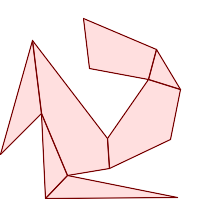
Partition convexe optimale (même exemple que CG_YMonotonePartition, CG_ApproxConvexPartition et CG_GreeneApproxConvexPartition)
SELECT ST_AsText(CG_OptimalConvexPartition('POLYGON((156 150,83 181,89 131,148 120,107 61,32 159,0 45,41 86,45 1,177 2,67 24,109 31,170 60,180 110,156 150))'::geometry));
GEOMETRYCOLLECTION(POLYGON((156 150,83 181,89 131,148 120,156 150)),POLYGON((32 159,0 45,41 86,32 159)),POLYGON((45 1,177 2,67 24,45 1)),POLYGON((41 86,45 1,67 24,41 86)),POLYGON((107 61,32 159,41 86,67 24,109 31,107 61)),POLYGON((148 120,107 61,109 31,170 60,180 110,148 120)),POLYGON((156 150,148 120,180 110,156 150)))
Name
CG_StraightSkeleton — Calcule un squelette (straight skeleton) à partir d'une géométrie
Synopsis
geometry CG_StraightSkeleton(geometry geom, boolean use_distance_as_m = false);
Description
Disponibilité : 3.5.0
Nécessite SFCGAL >= 1.3.8 pour l'option use_distance_as_m
 Cette méthode nécessite le backend SFCGAL.
Cette méthode nécessite le backend SFCGAL.
 Cette fonction prend en charge la 3D et ne supprime pas l'indice z.
Cette fonction prend en charge la 3D et ne supprime pas l'indice z.
 Cette fonction prend en charge les surfaces Polyhedral.
Cette fonction prend en charge les surfaces Polyhedral.
 Cette fonction prend en charge les triangles et les réseaux irréguliers triangulés (TIN).
Cette fonction prend en charge les triangles et les réseaux irréguliers triangulés (TIN).
Exemples
SELECT CG_StraightSkeleton(ST_GeomFromText('POLYGON (( 190 190, 10 190, 10 10, 190 10, 190 20, 160 30, 60 30, 60 130, 190 140, 190 190 ))'));SELECT ST_AsText(CG_StraightSkeleton('POLYGON((0 0,1 0,1 1,0 1,0 0))', true);
MULTILINESTRING M ((0 0 0,0.5 0.5 0.5),(1 0 0,0.5 0.5 0.5),(1 1 0,0.5 0.5 0.5),(0 1 0,0.5 0.5 0.5))Note that valid inputs with rings that touch at a single point will raise an error.
SELECT CG_StraightSkeleton( 'POLYGON((0 0, 3 0, 3 3, 0 3, 0 0), (0 0, 1 2, 2 1, 0 0))')); NOTICE: During straight_skeleton(A) : NOTICE: with A: POLYGON((0/1 0/1,3/1 0/1,3/1 3/1,0/1 3/1,0/1 0/1),(0/1 0/1,1/1 2/1,2/1 1/1,0/1 0/1)) ERROR: straight skeleton of Polygon with point touching rings is not implemented.
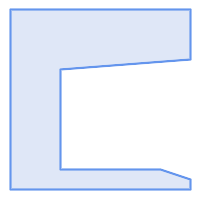 Polygone d'origine | 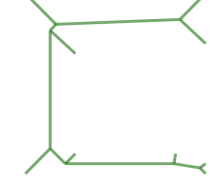 Squelette d'un polygone |
Name
ST_StraightSkeleton — Calcule un squelette (straight skeleton) à partir d'une géométrie
Synopsis
geometry ST_StraightSkeleton(geometry geom);
Description
![[Warning]](images/warning.png) | |
ST_StraightSkeleton est obsolète depuis la version 3.5.0. Utilisez CG_StraightSkeleton à la place. |
Disponibilité : 2.1.0
 Cette méthode nécessite le backend SFCGAL.
Cette méthode nécessite le backend SFCGAL.
 Cette fonction prend en charge la 3D et ne supprime pas l'indice z.
Cette fonction prend en charge la 3D et ne supprime pas l'indice z.
 Cette fonction prend en charge les surfaces Polyhedral.
Cette fonction prend en charge les surfaces Polyhedral.
 Cette fonction prend en charge les triangles et les réseaux irréguliers triangulés (TIN).
Cette fonction prend en charge les triangles et les réseaux irréguliers triangulés (TIN).
Exemples
SELECT ST_StraightSkeleton(ST_GeomFromText('POLYGON (( 190 190, 10 190, 10 10, 190 10, 190 20, 160 30, 60 30, 60 130, 190 140, 190 190 ))')); Polygone d'origine |  Squelette d'un polygone |
Voir aussi
Name
ST_Tesselate — Effectue la tessellation de la surface d'un polygone ou d'une surface polyédrique et renvoie un TIN ou une collection de TINS
Synopsis
geometry ST_Tesselate(geometry geom);
Description
![[Warning]](images/warning.png) | |
ST_Tesselate est obsolète depuis la version 3.5.0. Utilisez CG_Tesselate à la place. |
Prend en entrée une surface telle que MULTI(POLYGON) ou POLYHEDRALSURFACE et renvoie une représentation TIN via le processus de tessellation à l'aide de triangles.
![[Note]](images/note.png) | |
ST_TriangulatePolygon est similaire à cette fonction, sauf qu'elle renvoie une collection géométrique de polygones au lieu d'un TIN et qu'elle ne fonctionne qu'avec des géométries 2D. |
Disponibilité : 2.1.0
 Cette méthode nécessite le backend SFCGAL.
Cette méthode nécessite le backend SFCGAL.
 Cette fonction prend en charge la 3D et ne supprime pas l'indice z.
Cette fonction prend en charge la 3D et ne supprime pas l'indice z.
 Cette fonction prend en charge les surfaces Polyhedral.
Cette fonction prend en charge les surfaces Polyhedral.
 Cette fonction prend en charge les triangles et les réseaux irréguliers triangulés (TIN).
Cette fonction prend en charge les triangles et les réseaux irréguliers triangulés (TIN).
Name
CG_Tesselate — Effectue la tessellation de la surface d'un polygone ou d'une surface polyédrique et renvoie un TIN ou une collection de TINS
Synopsis
geometry CG_Tesselate(geometry geom);
Description
Prend en entrée une surface telle que MULTI(POLYGON) ou POLYHEDRALSURFACE et renvoie une représentation TIN via le processus de tessellation à l'aide de triangles.
![[Note]](images/note.png) | |
ST_TriangulatePolygon est similaire à cette fonction, sauf qu'elle renvoie une collection géométrique de polygones au lieu d'un TIN et qu'elle ne fonctionne qu'avec des géométries 2D. |
Disponibilité : 3.5.0
 Cette méthode nécessite le backend SFCGAL.
Cette méthode nécessite le backend SFCGAL.
 Cette fonction prend en charge la 3D et ne supprime pas l'indice z.
Cette fonction prend en charge la 3D et ne supprime pas l'indice z.
 Cette fonction prend en charge les surfaces Polyhedral.
Cette fonction prend en charge les surfaces Polyhedral.
 Cette fonction prend en charge les triangles et les réseaux irréguliers triangulés (TIN).
Cette fonction prend en charge les triangles et les réseaux irréguliers triangulés (TIN).
Exemples
SELECT ST_GeomFromText('POLYHEDRALSURFACE Z( ((0 0 0, 0 0 1, 0 1 1, 0 1 0, 0 0 0)),
((0 0 0, 0 1 0, 1 1 0, 1 0 0, 0 0 0)), ((0 0 0, 1 0 0, 1 0 1, 0 0 1, 0 0 0)),
((1 1 0, 1 1 1, 1 0 1, 1 0 0, 1 1 0)),
((0 1 0, 0 1 1, 1 1 1, 1 1 0, 0 1 0)), ((0 0 1, 1 0 1, 1 1 1, 0 1 1, 0 0 1)) )');
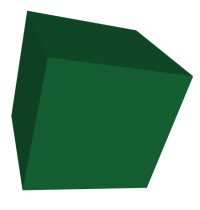 Cube d'origine |
SELECT CG_Tesselate(ST_GeomFromText('POLYHEDRALSURFACE Z( ((0 0 0, 0 0 1, 0 1 1, 0 1 0, 0 0 0)),
((0 0 0, 0 1 0, 1 1 0, 1 0 0, 0 0 0)), ((0 0 0, 1 0 0, 1 0 1, 0 0 1, 0 0 0)),
((1 1 0, 1 1 1, 1 0 1, 1 0 0, 1 1 0)),
((0 1 0, 0 1 1, 1 1 1, 1 1 0, 0 1 0)), ((0 0 1, 1 0 1, 1 1 1, 0 1 1, 0 0 1)) )'));
Sortie ST_AsText : TIN Z (((0 0 0,0 0 1,0 1 1,0 0 0)),((0 1 0,0 0 0,0 1 1,0 1 0)),
((0 0 0,0 1 0,1 1 0,0 0 0)),
((1 0 0,0 0 0,1 1 0,1 0 0)),((0 0 1,1 0 0,1 0 1,0 0 1)),
((0 0 1,0 0 0,1 0 0,0 0 1)),
((1 1 0,1 1 1,1 0 1,1 1 0)),((1 0 0,1 1 0,1 0 1,1 0 0)),
((0 1 0,0 1 1,1 1 1,0 1 0)),((1 1 0,0 1 0,1 1 1,1 1 0)),
((0 1 1,1 0 1,1 1 1,0 1 1)),((0 1 1,0 0 1,1 0 1,0 1 1)))
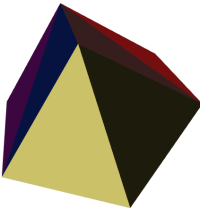 Cube tessellé avec triangles colorés |
SELECT 'POLYGON (( 10 190, 10 70, 80 70, 80 130, 50 160, 120 160, 120 190, 10 190 ))'::geometry;
 Polygone d'origine |
SELECT
CG_Tesselate('POLYGON (( 10 190, 10 70, 80 70, 80 130, 50 160, 120 160, 120 190, 10 190 ))'::geometry);
Sortie ST_AsText TIN(((80 130,50 160,80 70,80 130)),((50 160,10 190,10 70,50 160)),
((80 70,50 160,10 70,80 70)),((120 160,120 190,50 160,120 160)),
((120 190,10 190,50 160,120 190)))
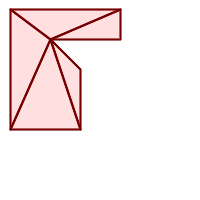 Polygone tessellé |
Name
CG_Triangulate — Triangule une géométrie polygonale
Synopsis
geometry CG_Triangulate( geometry geom );
Description
Triangule une géométrie polygonale.
Réalisé par le module SFCGAL
![[Note]](images/note.png) | |
NOTE : cette fonction renvoie une géométrie représentant le résultat de la triangulation. |
Disponibilité : 3.5.0
 Cette méthode nécessite le backend SFCGAL.
Cette méthode nécessite le backend SFCGAL.
Exemples de géométrie
SELECT CG_Triangulate('POLYGON((0.0 0.0,1.0 0.0,1.0 1.0,0.0 1.0,0.0 0.0),(0.2 0.2,0.2 0.8,0.8 0.8,0.8 0.2,0.2 0.2))');
cg_triangulate
----------------
TIN(((0.8 0.2,0.2 0.2,1 0,0.8 0.2)),((0.2 0.2,0 0,1 0,0.2 0.2)),((1 1,0.8 0.8,0.8 0.2,1 1)),((0 1,0 0,0.2 0.2,0 1)),((0 1,0.2 0.8,1 1,0 1)),((0 1,0.2 0.2,0.2 0.8,0 1)),((0.2 0.8,0.8 0.8,1 1,0.2 0.8)),((0.2 0.8,0.2 0.2,0.8 0.2,0.2 0.8)),((1 1,0.8 0.2,1 0,1 1)),((0.8 0.8,0.2 0.8,0.8 0.2,0.8 0.8)))
(1 row)Name
CG_Visibility — Calculer un polygone de visibilité à partir d'un point ou d'un segment dans une géométrie polygonale
Synopsis
geometry CG_Visibility(geometry polygon, geometry point);
geometry CG_Visibility(geometry polygon, geometry pointA, geometry pointB);
Description
Disponibilité : 3.5.0 - nécessite SFCGAL >= 1.5.0.
Nécessite SFCGAL >= 1.5.0
 Cette méthode nécessite le backend SFCGAL.
Cette méthode nécessite le backend SFCGAL.
 Cette fonction prend en charge la 3D et ne supprime pas l'indice z.
Cette fonction prend en charge la 3D et ne supprime pas l'indice z.
 Cette fonction prend en charge les surfaces Polyhedral.
Cette fonction prend en charge les surfaces Polyhedral.
 Cette fonction prend en charge les triangles et les réseaux irréguliers triangulés (TIN).
Cette fonction prend en charge les triangles et les réseaux irréguliers triangulés (TIN).
Exemples
SELECT CG_Visibility('POLYGON((23.5 23.5,23.5 173.5,173.5 173.5,173.5 23.5,23.5 23.5),(108 98,108 36,156 37,155 99,108 98),(107 157.5,107 106.5,135 107.5,133 127.5,143.5 127.5,143.5 108.5,153.5 109.5,151.5 166,107 157.5),(41 95.5,41 35,100.5 36,98.5 68,78.5 68,77.5 96.5,41 95.5),(39 150,40 104,97.5 106.5,95.5 152,39 150))'::geometry, 'POINT(91 87)'::geometry);SELECT CG_Visibility('POLYGON((23.5 23.5,23.5 173.5,173.5 173.5,173.5 23.5,23.5 23.5),(108 98,108 36,156 37,155 99,108 98),(107 157.5,107 106.5,135 107.5,133 127.5,143.5 127.5,143.5 108.5,153.5 109.5,151.5 166,107 157.5),(41 95.5,41 35,100.5 36,98.5 68,78.5 68,77.5 96.5,41 95.5),(39 150,40 104,97.5 106.5,95.5 152,39 150))'::geometry,'POINT(78.5 68)'::geometry, 'POINT(98.5 68)'::geometry); Polygone d'origine |  Visibilité depuis le point | 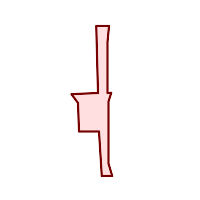 Visibilité depuis le segment |
Name
CG_YMonotonePartition — Calcul de la partition y-monotone de la géométrie du polygone
Synopsis
geometry CG_YMonotonePartition(geometry geom);
Description
Calcul de la partition y-monotone de la géométrie du polygone.
![[Note]](images/note.png) | |
Une partition d'un polygone P est un ensemble de polygones tels que les intérieurs des polygones ne se croisent pas et que l'union des polygones est égale à l'intérieur du polygone original P. Un polygone y-monotone est un polygone dont les sommets v1,...,vn peuvent être divisés en deux chaînes v1,...,vk et vk,...,vn,v1, de sorte que toute ligne horizontale croise l'une ou l'autre chaîne au plus une fois. Cet algorithme ne garantit pas de limite au nombre de polygones produits par rapport au nombre optimal. |
Disponibilité : 3.5.0 - nécessite SFCGAL >= 1.5.0.
Nécessite SFCGAL >= 1.5.0
 Cette méthode nécessite le backend SFCGAL.
Cette méthode nécessite le backend SFCGAL.
Exemples
 Polygone d'origine | 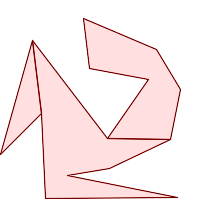 Partition Y-Monotone (même exemple que CG_ApproxConvexPartition, CG_GreeneApproxConvexPartition et CG_OptimalConvexPartition) |
SELECT ST_AsText(CG_YMonotonePartition('POLYGON((156 150,83 181,89 131,148 120,107 61,32 159,0 45,41 86,45 1,177 2,67 24,109 31,170 60,180 110,156 150))'::geometry));
GEOMETRYCOLLECTION(POLYGON((32 159,0 45,41 86,32 159)),POLYGON((107 61,32 159,41 86,45 1,177 2,67 24,109 31,170 60,107 61)),POLYGON((156 150,83 181,89 131,148 120,107 61,170 60,180 110,156 150)))
Name
CG_StraightSkeletonPartition — Calcule la partition du squelette droit d'un polygone.
Synopsis
geometry CG_StraightSkeletonPartition(geometry geom, boolean auto_orientation);
Description
Calcule la partition du squelette droit du polygone d'entrée geometry geom. Le squelette droit est une partition du polygone en faces formées en traçant l'effondrement de ses arêtes. Si auto_orientation vaut true, la fonction ajustera automatiquement l'orientation du polygone d'entrée pour garantir des résultats corrects.
Disponibilité : 3.6.0 - nécessite SFCGAL >= 2.0.0.
 Cette méthode nécessite le backend SFCGAL.
Cette méthode nécessite le backend SFCGAL.
Exemples
SELECT ST_AsText(CG_StraightSkeletonPartition('POLYGON((0 0, 4 0, 2 2, 0 0))', true));
-- Result: MULTIPOLYGON(((0 0,2 0.83,2 2)),((4 0,2 0.83,0 0)),((2 2,2 0.83,4 0)))SELECT CG_StraightSkeletonPartition(ST_GeomFromText('POLYGON (( 190 190, 10 190, 10 10, 190 10, 190 20
, 160 30, 60 30, 60 130, 190 140, 190 190 ))')
, true ); Polygone d'origine |  Straight Skeleton Partition of polygon |
Voir aussi
Name
CG_3DBuffer — Calcule un tampon 3D autour d'une géométrie.
Synopsis
geometry CG_3DBuffer(geometry geom, float8 radius, integer segments, integer buffer_type);
Description
Generates a 3D buffer around the input geometry geom with a specified radius. The buffer is constructed in 3D space, creating a volumetric representation of the geometry's surroundings. The segments parameter defines the number of segments used to approximate the curved sections of the buffer, with a minimum value of 4 segments required. The buffer_type specifies the type of buffer to create: 0: Rounded buffer (default) 1: Flat buffer 2: Square buffer
Input geometry must be a Point or LineString.
Disponibilité : 3.6.0 - nécessite SFCGAL >= 2.0.0
 Cette méthode nécessite le backend SFCGAL.
Cette méthode nécessite le backend SFCGAL.
Exemples
SELECT ST_AsText(CG_3DBuffer('POINT(0 0 0)', 1, 8, 0));
-- Result: POLYHEDRALSURFACE Z (((0 0 1, 0.5 -0.5 0.71, 0 -0.71 0.71, 0 0 1)), ... )Les images suivantes ont été obtenues en collant le résultat de la requête ST_AsX3D dans X3D Viewer.
SELECT string_agg('<Shape
>' || ST_AsX3D(cgbuffer3d_output) || '<Appearance>
<Material diffuseColor="0 0.8 0.2" specularColor="0 1 0"/>
</Appearance>
</Shape
>', ''); segments=32 (tampon arrondi)
SELECT CG_3DBuffer(ST_GeomFromText('POINT(100 90)'), 50,32,0);
|  5 segments arrondis
SELECT CG_3DBuffer(
ST_GeomFromText('POINT(100 90)'),
50,5,0);
|
 32 segments, ronds
SELECT CG_3DBuffer(
ST_GeomFromText(
'LINESTRING(50 50,150 150,150 50)'
),
10,32,0);
|  32 segments, carrés
SELECT CG_3DBuffer(
ST_GeomFromText(
'LINESTRING(50 50,150 150,150 50)'
),
10,32,2);
|
Voir aussi
Name
CG_Rotate — Fait pivoter une géométrie d'un angle donné autour de l'origine (0,0).
Synopsis
geometry CG_Rotate(geometry geom, float8 angle);
Description
Fait pivoter la géométrie d'entrée geom de angle radians autour du point d'origine (0,0). La rotation est effectuée dans l'espace 2D ; les coordonnées Z ne sont pas modifiées. Les angles positifs font tourner la géométrie dans le sens inverse des aiguilles d'une montre.
Disponibilité : 3.6.0 - nécessite SFCGAL >= 2.0.0
 Cette méthode nécessite le backend SFCGAL.
Cette méthode nécessite le backend SFCGAL.
Exemples
SELECT ST_AsText(CG_Rotate('LINESTRING(1 0, 0 1)', pi()/2));
-- Result: LINESTRING(0 1, -1 0)Voir aussi
Name
CG_2DRotate — Fait pivoter une géométrie d'un angle donné autour d'un point spécifié en 2D.
Synopsis
geometry CG_2DRotate(geometry geom, float8 angle, float8 cx, float8 cy);
Description
Fait pivoter la géométrie d'entrée geom de angle radians autour du point (cx, cy). La rotation est effectuée dans l'espace 2D ; les coordonnées Z ne sont pas prises en compte. Les angles positifs font tourner la géométrie dans le sens inverse des aiguilles d'une montre.
Disponibilité : 3.6.0 - nécessite SFCGAL >= 2.0.0
 Cette méthode nécessite le backend SFCGAL.
Cette méthode nécessite le backend SFCGAL.
Exemples
SELECT ST_AsText(CG_2DRotate('POINT(1 0)', pi()/2, 1, 1));
-- Result: POINT(2 1)Voir aussi
Name
CG_3DRotate — Fait pivoter une géométrie dans l'espace 3D autour d'un vecteur d'axe.
Synopsis
geometry CG_3DRotate(geometry geom, float8 angle, float8 ax, float8 ay, float8 az);
Description
Fait pivoter la géométrie d'entrée geom de angle radians autour d'un axe défini par le vecteur (ax, ay, az) passant par l'origine (0,0,0).
Disponibilité : 3.6.0 - nécessite SFCGAL >= 2.0.0
 Cette méthode nécessite le backend SFCGAL.
Cette méthode nécessite le backend SFCGAL.
 Cette fonction prend en charge la 3D et ne supprime pas l'indice z.
Cette fonction prend en charge la 3D et ne supprime pas l'indice z.
Exemples
SELECT ST_AsText(CG_3DRotate('POINT(1 0 0)', pi()/2, 0, 0, 1));
-- Result: POINT(0 1 0)Voir aussi
Name
CG_RotateX — Fait pivoter une géométrie autour de l'axe X d'un angle donné.
Synopsis
geometry CG_RotateX(geometry geom, float8 angle);
Description
Fait pivoter la géométrie d'entrée geom de angle radians autour de l'axe X.
Disponibilité : 3.6.0 - nécessite SFCGAL >= 2.0.0
 Cette méthode nécessite le backend SFCGAL.
Cette méthode nécessite le backend SFCGAL.
 Cette fonction prend en charge la 3D et ne supprime pas l'indice z.
Cette fonction prend en charge la 3D et ne supprime pas l'indice z.
Exemples
SELECT ST_AsText(CG_RotateX('POINT(0 1 0)', pi()/2));
-- Result: POINT(0 0 1)Voir aussi
Name
CG_RotateY — Fait pivoter une géométrie autour de l'axe Y d'un angle donné.
Synopsis
geometry CG_RotateY(geometry geom, float8 angle);
Description
Fait pivoter la géométrie d'entrée geom de angle radians autour de l'axe Y.
Disponibilité : 3.6.0 - nécessite SFCGAL >= 2.0.0
 Cette méthode nécessite le backend SFCGAL.
Cette méthode nécessite le backend SFCGAL.
 Cette fonction prend en charge la 3D et ne supprime pas l'indice z.
Cette fonction prend en charge la 3D et ne supprime pas l'indice z.
Exemples
SELECT ST_AsText(CG_RotateY('POINT(1 0 0)', pi()/2));
-- Result: POINT(0 0 -1)Voir aussi
Name
CG_RotateZ — Fait pivoter une géométrie autour de l'axe Z d'un angle donné.
Synopsis
geometry CG_RotateZ(geometry geom, float8 angle);
Description
Fait pivoter la géométrie d'entrée geom de angle radians autour de l'axe Z.
Disponibilité : 3.6.0 - nécessite SFCGAL >= 2.0.0
 Cette méthode nécessite le backend SFCGAL.
Cette méthode nécessite le backend SFCGAL.
 Cette fonction prend en charge la 3D et ne supprime pas l'indice z.
Cette fonction prend en charge la 3D et ne supprime pas l'indice z.
Exemples
SELECT ST_AsText(CG_RotateZ('POINT(1 0 0)', pi()/2));
-- Result: POINT(0 1 0)Voir aussi
Name
CG_Scale — Met à l'échelle une géométrie uniformément dans toutes les dimensions selon un facteur donné.
Synopsis
geometry CG_Scale(geometry geom, float8 factor);
Description
Met à l'échelle la géométrie d'entrée geom par un facteur d'échelle uniforme dans toutes les dimensions (X, Y et Z). La mise à l'échelle est effectuée par rapport au point d'origine (0,0,0).
Disponibilité : 3.6.0 - nécessite SFCGAL >= 2.0.0
 Cette méthode nécessite le backend SFCGAL.
Cette méthode nécessite le backend SFCGAL.
Exemples
SELECT ST_AsText(CG_Scale('LINESTRING(1 1, 2 2)', 2));
-- Result: LINESTRING(2 2, 4 4)Voir aussi
Name
CG_3DScale — Met à l'échelle une géométrie en fonction de facteurs distincts le long des axes X, Y et Z.
Synopsis
geometry CG_3DScale(geometry geom, float8 factorX, float8 factorY, float8 factorZ);
Description
Met à l'échelle la géométrie d'entrée geom en fonction de différents facteurs le long des axes X, Y et Z. La mise à l'échelle est effectuée par rapport au point d'origine (0,0,0). La mise à l'échelle est effectuée par rapport au point d'origine (0,0,0).
Disponibilité : 3.6.0 - nécessite SFCGAL >= 2.0.0
 Cette méthode nécessite le backend SFCGAL.
Cette méthode nécessite le backend SFCGAL.
 Cette fonction prend en charge la 3D et ne supprime pas l'indice z.
Cette fonction prend en charge la 3D et ne supprime pas l'indice z.
Exemples
SELECT ST_AsText(CG_3DScale('POINT(1 1 1)', 2, 3, 4));
-- Result: POINT(2 3 4)Voir aussi
Name
CG_3DScaleAroundCenter — Met à l'échelle une géométrie dans l'espace 3D autour d'un point central spécifié.
Synopsis
geometry CG_3DScaleAroundCenter(geometry geom, float8 factorX, float8 factorY, float8 factorZ, float8 centerX, float8 centerY, float8 centerZ);
Description
Met à l'échelle la géométrie d'entrée geom par différents facteurs le long des axes X, Y et Z, par rapport à un point central spécifié (centerX, centerY, centerZ).
Disponibilité : 3.6.0 - nécessite SFCGAL >= 2.0.0
 Cette méthode nécessite le backend SFCGAL.
Cette méthode nécessite le backend SFCGAL.
 Cette fonction prend en charge la 3D et ne supprime pas l'indice z.
Cette fonction prend en charge la 3D et ne supprime pas l'indice z.
Exemples
SELECT ST_AsText(CG_3DScaleAroundCenter('POINT(2 2 2)', 0.5, 0.5, 0.5, 1, 1, 1));
-- Result: POINT(1.5 1.5 1.5)Voir aussi
Name
CG_Translate — Déplace une géométrie en fonction de décalages donnés dans l'espace 2D.
Synopsis
geometry CG_Translate(geometry geom, float8 deltaX, float8 deltaY);
Description
Déplace la géométrie d'entrée geom en ajoutant deltaX aux coordonnées X et deltaY aux coordonnées Y. Les coordonnées Z sont supprimées. Les coordonnées Z ne sont pas prises en compte.
Disponibilité : 3.6.0 - nécessite SFCGAL >= 2.0.0
 Cette méthode nécessite le backend SFCGAL.
Cette méthode nécessite le backend SFCGAL.
Exemples
SELECT ST_AsText(CG_Translate('LINESTRING(1 1, 2 2)', 1, -1));
-- Result: LINESTRING(2 0, 3 1)Voir aussi
Name
CG_3DTranslate — Déplace une géométrie en fonction de décalages donnés dans l'espace 3D.
Synopsis
geometry CG_3DTranslate(geometry geom, float8 deltaX, float8 deltaY, float8 deltaZ);
Description
Déplace la géométrie d'entrée geom en ajoutant deltaX aux coordonnées X, deltaY aux coordonnées Y et deltaZ aux coordonnées Z.
Disponibilité : 3.6.0 - nécessite SFCGAL >= 2.0.0
 Cette méthode nécessite le backend SFCGAL.
Cette méthode nécessite le backend SFCGAL.
 Cette fonction prend en charge la 3D et ne supprime pas l'indice z.
Cette fonction prend en charge la 3D et ne supprime pas l'indice z.
Exemples
SELECT ST_AsText(CG_3DTranslate('POINT(1 1 1)', 1, -1, 2));
-- Result: POINT(2 0 3)Voir aussi
Name
CG_Simplify — Reduces the complexity of a geometry while preserving essential features and Z/M values.
Synopsis
geometry CG_Simplify(geometry geom, double precision threshold, boolean preserveTopology = false);
Description
Simplifies a geometry using SFCGAL's simplification algorithm, which reduces the number of points or vertices while preserving the essential features of the geometry. This function preserves Z and M values during simplification.
The algorithm is based on constrained triangulation and uses the CGAL Polyline Simplification 2 library with additional handling to preserve Z and M coordinates. When topology is preserved and geometries intersect, Z and M values are interpolated at intersection points.
This function works well with 3D terrain-like geometries (2.5D) but is not designed for vertical surfaces like walls.
Availability: 3.6.0 - requires SFCGAL >= 2.1.0
 Cette méthode nécessite le backend SFCGAL.
Cette méthode nécessite le backend SFCGAL.
 Cette fonction prend en charge la 3D et ne supprime pas l'indice z.
Cette fonction prend en charge la 3D et ne supprime pas l'indice z.
 Cette fonction prend en charge les coordonnées M.
Cette fonction prend en charge les coordonnées M.
Paramètres
geomInput geometry
thresholdMaximum distance threshold (in geometry unit) for simplification. The higher this value, the more simplified the resulting geometry will be.
preserveTopologyIf set to true, the function ensures that the topology of the geometry is preserved. When geometries intersect in this mode, Z and M values at intersection points are interpolated. The default value is false.
Return Value
Returns a simplified geometry with preserved Z and M values.
Exemples
-- Simplify a polygon with a threshold of 0.5
SELECT ST_AsText(CG_Simplify(ST_GeomFromText('POLYGON((0 0, 0 1, 0.1 1, 0.2 1, 0.3 1, 0.4 1, 0.5 1, 1 1, 1 0, 0 0))'), 0.5));
-- Simplify a 3D terrain geometry while preserving topology and Z values
SELECT ST_AsText(CG_Simplify(ST_GeomFromText('LINESTRING Z(0 0 0, 0 1 1, 0.1 1 1, 0.2 1 1, 0.3 1 1, 1 1 2)'), 0.2, true));
-- Simplify a geometry with both Z and M values
SELECT ST_AsText(CG_Simplify(ST_GeomFromText('LINESTRING ZM(0 0 0 1, 0 1 1 2, 0.1 1 1 3, 0.2 1 1 4, 0.3 1 1 5, 1 1 2 6)'), 0.2));
-- Simplify two geometry together preserving Z and M values, without topology
SELECT ST_AsText(CG_Simplify('GEOMETRYCOLLECTION ZM(LINESTRING ZM(-1 -1 3 4, 0 0 10 100, 1 1 20 200, 0 2 15 150, 0 5 30 300, 2 19 25 250, -4 20 15 150), POLYGON ZM((0 0 10 100, 1 1 20 200, 0 2 15 150, 0 5 30 300, 2 19 25 250, -4 20 15 150, 0 0 10 100)))', 2, false));
-- Simplify two geometry together preserving Z and M values, with topology
SELECT ST_AsText(CG_Simplify('GEOMETRYCOLLECTION ZM(LINESTRING ZM(-1 -1 3 4, 0 0 10 100, 1 1 20 200, 0 2 15 150, 0 5 30 300, 2 19 25 250, -4 20 15 150), POLYGON ZM((0 0 10 100, 1 1 20 200, 0 2 15 150, 0 5 30 300, 2 19 25 250, -4 20 15 150, 0 0 10 100)))', 2, true));
WITH depts_pds as (SELECT ST_GeomFromText('GEOMETRYCOLLECTION(
POLYGON((88.46 158.85,90.77 171.54,147.31 173.85,146.15 145,173.85 119.62,146.15 103.46,112.69 118.46,91.92 93.08,65.38 101.15,34.23 121.92,41.15 142.69,49.23 143.85,88.46 158.85)),
POLYGON((112.69 118.46,146.15 103.46,190 60.77,185.38 43.46,126.54 26.15,83.85 28.46,67.69 64.23,43.46 58.46,10 83.85,34.23 121.92,65.38 101.15,91.92 93.08,112.69 118.46)))
') as geom)
SELECT geom FROM depts_pds;
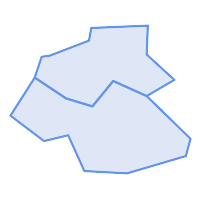
Originals geometries
WITH depts_pds as (SELECT ST_GeomFromText('GEOMETRYCOLLECTION(
POLYGON((88.46 158.85,90.77 171.54,147.31 173.85,146.15 145,173.85 119.62,146.15 103.46,112.69 118.46,91.92 93.08,65.38 101.15,34.23 121.92,41.15 142.69,49.23 143.85,88.46 158.85)),
POLYGON((112.69 118.46,146.15 103.46,190 60.77,185.38 43.46,126.54 26.15,83.85 28.46,67.69 64.23,43.46 58.46,10 83.85,34.23 121.92,65.38 101.15,91.92 93.08,112.69 118.46)))
') as geom)
SELECT (ST_Dump(CG_Simplify(geom, 0.5, true))).geom FROM depts_pds;
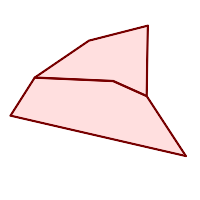
Simplification with 0.5 and topology preserved
WITH depts_pds as (SELECT ST_GeomFromText('GEOMETRYCOLLECTION(
POLYGON((88.46 158.85,90.77 171.54,147.31 173.85,146.15 145,173.85 119.62,146.15 103.46,112.69 118.46,91.92 93.08,65.38 101.15,34.23 121.92,41.15 142.69,49.23 143.85,88.46 158.85)),
POLYGON((112.69 118.46,146.15 103.46,190 60.77,185.38 43.46,126.54 26.15,83.85 28.46,67.69 64.23,43.46 58.46,10 83.85,34.23 121.92,65.38 101.15,91.92 93.08,112.69 118.46)))
') as geom)
SELECT (ST_Dump(CG_Simplify(geom, 0.5, false))).geom FROM depts_pds;

Simplification with 0.5 without topology preservation
Voir aussi
Name
CG_3DAlphaWrapping — Computes a 3D Alpha-wrapping strictly enclosing a geometry.
Synopsis
geometry CG_3DAlphaWrapping(geometry geom, integer relative_alpha, integer relative_offset);
Description
Computes the 3D Alpha Wrapping of the points in a geometry. An alpha wrapping is a watertight and orientable surface mesh that strictly encloses the input. It can be seen as an extension or refinement of an alpha-shape.
The relative_alpha parameter controls which features will appear in the output. It can can have values from 0 to infinity. Smaller relative_alpha values result in simpler outputs, but they are less accurate representations of the original input.
The relative_offset parameter controls the tightness of the result. It can can have values from 0 to infinity. If this parameter is set to 0, its value is automatically determined based on the relative_alpha parameter.
Availability: 3.6.0 - requires SFCGAL >= 2.1.0
 Cette méthode nécessite le backend SFCGAL.
Cette méthode nécessite le backend SFCGAL.
 Cette fonction prend en charge la 3D et ne supprime pas l'indice z.
Cette fonction prend en charge la 3D et ne supprime pas l'indice z.
Exemples
SELECT CG_3DAlphaWrapping('MULTIPOINT((63 84),(76 88),(68 73),(53 18),(91 50),(81 70),
(88 29),(24 82),(32 51),(37 23),(27 54),(84 19),(75 87),(44 42),(77 67),(90 30),(36 61),(32 65),
(81 47),(88 58),(68 73),(49 95),(81 60),(87 50),(78 16),(79 21),(30 22),(78 43),(26 85),(48 34),
(35 35),(36 40),(31 79),(83 29),(27 84),(52 98),(72 95),(85 71),(75 84),(75 77),(81 29),(77 73),
(41 42),(83 72),(23 36),(89 53),(27 57),(57 97),(27 77),(39 88),(60 81),(80 72),(54 32),(55 26),
(62 22),(70 20),(76 27),(84 35),(87 42),(82 54),(83 64),(69 86),(60 90),(50 86),(43 80),(36 73),
(36 68),(40 75),(24 67),(23 60),(26 44),(28 33),(40 32),(43 19),(65 16),(73 16),(38 46),(31 59),
(34 86),(45 90),(64 97))'::geometry,10);
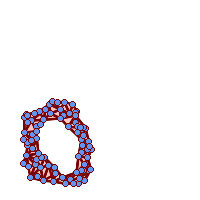
Alpha wrapping of a MultiPoint (same example As CG_OptimalAlphaShape)
SELECT CG_3DAlphaWrapping('MULTIPOINT((132 64),(114 64),(99 64),(81 64),(63 64),(57 49),
(52 36),(46 20),(37 20),(26 20),(32 36),(39 55),(43 69),(50 84),(57 100),(63 118),(68 133),(74 149),
(81 164),(88 180),(101 180),(112 180),(119 164),(126 149),(132 131),(139 113),(143 100),(150 84),(157 69),(163 51),
(168 36),(174 20),(163 20),(150 20),(143 36),(139 49),(132 64),(99 151),(92 138),(88 124),(81 109),(74 93),(70 82),
(83 82),(99 82),(112 82),(126 82),(121 96),(114 109),(110 122),(103 138),(99 151),(34 27),(43 31),(48 44),(46 58),
(52 73),(63 73),(61 84),(72 71),(90 69),(101 76),(123 71),(141 62),(166 27),(150 33),(159 36),(146 44),(154 53),
(152 62),(146 73),(134 76),(143 82),(141 91),(130 98),(126 104),(132 113),(128 127),(117 122),(112 133),(119 144),
(108 147),(119 153),(110 171),(103 164),(92 171),(86 160),(88 142),(79 140),(72 124),(83 131),(79 118),(68 113),
(63 102),(68 93),(35 45))'::geometry,14);
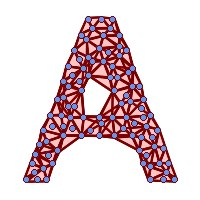
Alpha wrapping of a MultiPoint (same example as ST_ConcaveHull)
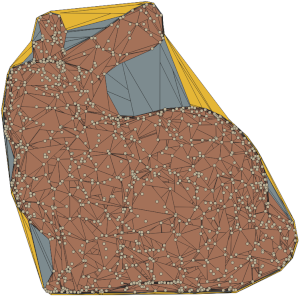
Effect of the relative_alpha parameter with values 5, 10 and 20. A value of 5 results in a coarse output. Increasing the parameter up to 20 significantly improves the precision and granularity of the result.
Voir aussi
Chapter 9. Topologie
- 9.1. Topology Primitive Tables
- 9.2. Les types associés à "Topology"
- 9.3. Domaines de topologie
- 9.4. Gestion de la topologie et de TopoGeometry
- 9.5. Gestion des statistiques de topologie
- 9.6. Constructeurs de topologie
- 9.7. Éditeurs de topologie
- 9.8. Accès à la topologie
- 9.9. Traitement de la topologie
- 9.10. Constructeurs de TopoGeometry
- 9.11. Editeurs de TopoGeometry
- 9.12. Accès aux TopoGeometry
- 9.13. Sorties TopoGeometry
- 9.14. Relations spatiales de topologie
- 9.15. Importer et exporter des topologies
Les types et fonctions topologiques de PostGIS sont utilisés pour gérer les objets topologiques tels que les faces, les arêtes et les des noeuds.
La présentation de Sandro Santilli à la conférence PostGIS Day Paris 2011 donne un bon aperçu de PostGIS Topology et de son évolution Topology with PostGIS 2.0 slide deck.
Vincent Picavet fournit un bon résumé et une vue d'ensemble de ce qu'est la topologie, comment elle est utilisée, et divers outils FOSS4G qui la supportent dans PostGIS Topology PGConf EU 2012.
Un exemple de base de données SIG topologique est la base de données US Census Topologically Integrated Geographic Encoding and Referencing System (TIGER). Si vous souhaitez expérimenter la topologie PostGIS et avez besoin de quelques données, consultez Topology_Load_Tiger.
The PostGIS topology module has existed for a long time but was not always part of the official documentation. Extensive cleanup removed deprecated functions, fixed known usability issues, documented the features and functions, added new functionality, and improved SQL-MM compliance.
Les détails sur ce projet peuvent être trouvés à PostGIS Topology Wiki
Toutes les fonctions et toutes les tables associées à ce module sont installées dans un schéma appelé topology.
Les fonctions qui sont définies dans le standard SQL/MM sont préfixées par ST_ et les fonctions spécifiques à PostGIS ne sont pas préfixées.
Topology support is built by default and can be disabled by specifying the --without-topology configure option at build time as described in Chapter 2, Installation de PostGIS
9.1. Topology Primitive Tables
The core primitives of any topology are stored in the edge_data, node, and face tables that live in the schema created by CreateTopology. Each row of edge_data represents an oriented edge: it records a directed curve from start_node to end_node together with the identifier of the face encountered on the left of that direction (left_face) and the face encountered on the right (right_face). The same geometric segment may therefore appear twice—once for each orientation—when it belongs to two faces.
The next_left_edge and next_right_edge columns complete this orientation information by encoding how to keep walking around a face. They store signed integers whose absolute value is the identifier of the next oriented edge and whose sign determines whether the stored orientation has to be followed as-is or reversed when traversing. Formally, the following rules hold for every edge e:
abs(next_left_edge)is the identifier of the edge reached by continuing around the face that lies to the left ofe. If the value is positive the walk continues from the end node ofealong the stored orientation of the referenced edge; if it is negative the referenced edge must be followed backwards so that the shared face remains on the walker’s left.abs(next_right_edge)analogously follows the boundary of the face located on the right ofe. A positive value means that the next edge is taken with its recorded orientation starting from the end node ofe, whereas a negative value instructs to traverse the referenced edge in reverse, starting from its end node, so that the right-hand face is preserved.A zero value indicates that the edge is dangling on the corresponding side (for example an isolated edge whose incident face is the universal face
0). Theabs_next_left_edgeandabs_next_right_edgecolumns exposed by theedgeview are convenience projections of these absolute values.
This representation is a variant of a doubly connected edge list and is exploited by many topology routines. Functions such as GetRingEdges and ValidateTopology rely on it to reconstruct face boundaries and to diagnose inconsistencies—hence the “invalid next_left_edge” and “invalid next_right_edge” diagnostics reported during validation. Constructors like AddEdge initialise the next_* attributes with trivial self references, while editing routines including ST_AddEdgeModFace and ST_RemEdgeModFace update the links as edges are inserted or removed. Other bulk operations (for example Polygonize) may intentionally leave the fields unset, which is why the documentation flags their behaviour explicitly.
9.2. Les types associés à "Topology"
Cette section liste les types de données de PostgreSQL installés par "PostGIS Topology". Notez que nous décrivons leurs comportements de transtypage, ce qui est très important en particulièrement lorsque l'on définit ses propres fonctions.
- getfaceedges_returntype — Type composite composé d'un numéro de séquence et d'un numéro d'arête.
- TopoGeometry — Un type composite représentant une géométrie topologiquement définie.
- validatetopology_returntype — Un type composite composé d'un message d'erreur et de id1 et id2 pour indiquer l'emplacement de l'erreur. Il s'agit du type de retour pour
ValidateTopology.
Name
getfaceedges_returntype — Type composite composé d'un numéro de séquence et d'un numéro d'arête.
Description
Type composite composé d'un numéro de séquence et d'un numéro d'arête. Il s'agit du type de retour pour les fonctions ST_GetFaceEdges et GetNodeEdges.
sequenceest un entier. Il fait référence à un élément topologique défini dans la table topology.topology qui définit le schéma de la topologie et le srid.edgeest un entier : c'est l'identifiant d'une arête.
Name
TopoGeometry — Un type composite représentant une géométrie topologiquement définie.
Description
Un type composite qui fait référence à une géométrie topologique dans une couche topologique spécifique, ayant un type et un identifiant spécifiques. Les éléments d'une TopoGeometry ont les propriétés suivantes : topology_id, layer_id, id integer, type integer.
topology_idest un entier : il fait référence à un élément topologique défini dans la table topology.topology qui définit le schéma de la topologie et le srid.layer_idest un entier : L'identifiant de la couche dans la table des couches à laquelle la TopoGeometry appartient. La combinaison de topology_id, layer_id fournit une référence unique dans la table topology.layers.idest un nombre entier : L'id est le numéro de séquence autogénéré qui définit de manière unique la topogeometry dans la couche topologique correspondante.typeun entier entre 1 et 4 qui définit le type de la géométrie : 1 : [multi]point, 2 : [multi]line, 3 : [multi]poly, 4 : collection
Transtypages
Cette section liste les transtypages autorisés pour ce type de donnée, qu'ils soient automatiques ou bien explicites
| Transtypage vers | Comportement |
| geometry | automatique |
Voir aussi
Name
validatetopology_returntype — Un type composite composé d'un message d'erreur et de id1 et id2 pour indiquer l'emplacement de l'erreur. Il s'agit du type de retour pour ValidateTopology.
Description
Un type composite composé d'un message d'erreur et de deux nombres entiers. La fonction ValidateTopology renvoie un ensemble d'entiers pour indiquer les erreurs de validation et les id1 et id2 pour indiquer les id des objets topologiques concernés par l'erreur.
errorest une variable : Indique le type d'erreur.Les descripteurs d'erreurs actuels sont les suivants : nœuds coïncidents, arête traversant un nœud, arête non simple, mauvaise correspondance de la géométrie de l'extrémité du nœud, mauvaise correspondance de la géométrie du début du nœud, face chevauchant la face, face à l'intérieur de la face,
id1est un nombre entier : Indique l'identifiant de l'arête / de la face / des nœuds en erreur.id2est un nombre entier : Pour les erreurs qui impliquent 2 objets, indique l'arête / ou le nœud secondaire
Voir aussi
9.3. Domaines de topologie
Cette section énumère les domaines PostgreSQL installés par PostGIS Topology. Les domaines peuvent être utilisés comme des types d'objets, en tant qu'objets de retour de fonctions ou de colonnes de tables. La distinction entre un domaine et un type est qu'un domaine est un type existant avec une contrainte de vérification liée à lui.
- TopoElement — Un tableau de 2 entiers généralement utilisé pour identifier un composant TopoGeometry.
- TopoElementArray — Un tableau d'objets TopoElement.
Name
TopoElement — Un tableau de 2 entiers généralement utilisé pour identifier un composant TopoGeometry.
Description
Un tableau de 2 entiers utilisé pour représenter une composante d'une TopoGeometry simple ou hiérarchique.
Dans le cas d'une TopoGeometry simple, le premier élément du tableau représente l'identifiant d'une primitive topologique et le deuxième élément représente son type (1:nœud, 2:arête, 3:face). Dans le cas d'une TopoGeometry hiérarchique, le premier élément du tableau représente l'identifiant d'une TopoGeometry enfant et le deuxième élément représente son identifiant de couche.
![[Note]](images/note.png) | |
Pour une TopoGeometry hiérarchique donnée, tous les éléments TopoGeometry enfants proviendront de la même couche enfant, comme spécifié dans l'enregistrement topology.layer pour la couche de la TopoGeometry en cours de définition. |
Exemples
SELECT te[1] AS id, te[2] AS type FROM
( SELECT ARRAY[1,2]::topology.topoelement AS te ) f;
id | type
----+------
1 | 2
SELECT ARRAY[1,2]::topology.topoelement;
te
-------
{1,2}
--Example of what happens when you try to case a 3 element array to topoelement
-- NOTE: topoement has to be a 2 element array so fails dimension check
SELECT ARRAY[1,2,3]::topology.topoelement;
ERROR: value for domain topology.topoelement violates check constraint "dimensions"
Name
TopoElementArray — Un tableau d'objets TopoElement.
Description
Un tableau de 1 ou plusieurs objets TopoElement, généralement utilisé pour transmettre des composants d'objets TopoGeometry.
Exemples
SELECT '{{1,2},{4,3}}'::topology.topoelementarray As tea;
tea
-------
{{1,2},{4,3}}
-- more verbose equivalent --
SELECT ARRAY[ARRAY[1,2], ARRAY[4,3]]::topology.topoelementarray As tea;
tea
-------
{{1,2},{4,3}}
--using the array agg function packaged with topology --
SELECT topology.TopoElementArray_Agg(ARRAY[e,t]) As tea
FROM generate_series(1,4) As e CROSS JOIN generate_series(1,3) As t;
tea
--------------------------------------------------------------------------
{{1,1},{1,2},{1,3},{2,1},{2,2},{2,3},{3,1},{3,2},{3,3},{4,1},{4,2},{4,3}}
SELECT '{{1,2,4},{3,4,5}}'::topology.topoelementarray As tea;
ERROR: value for domain topology.topoelementarray violates check constraint "dimensions"
Voir aussi
9.4. Gestion de la topologie et de TopoGeometry
Cette section énumère les fonctions topologiques permettant de créer de nouveaux schémas topologiques, de valider les topologies et de gérer les colonnes TopoGeometry
- AddTopoGeometryColumn — Ajoute une colonne topogeometry à une table existante, enregistre cette nouvelle colonne en tant que couche dans topology.layer et renvoie le nouveau numéro d'identification de la couche.
- RenameTopoGeometryColumn — Renomme une colonne topogeometry
- DropTopology — À utiliser avec précaution : Abandonne un schéma de topologie et supprime sa référence dans la table topology.topology et les références aux tables de ce schéma dans la table geometry_columns.
- RenameTopology — Renomme une topologie
- DropTopoGeometryColumn — Supprime la colonne topogeometry de la table nommée
table_namedans le schémaschema_nameet désenregistre les colonnes de la table topology.layer. - FixCorruptTopoGeometryColumn — Fixes topogeometry corruption caused by upgrade to postgis_topology 3.6.0 and higher
- Populate_Topology_Layer — Ajoute les entrées manquantes à la table topology.layer en lisant les métadonnées des tables topo.
- TopologySummary — Prend un nom de topologie et fournit des totaux récapitulatifs des types d'objets dans la topologie.
- ValidateTopology — Renvoie un ensemble d'objets validatetopology_returntype détaillant les problèmes liés à la topologie.
- ValidateTopologyRelation — Renvoie des informations sur les enregistrements de relations topologiques non valides
- ValidateTopologyPrecision — Returns non-precise vertices in the topology.
- MakeTopologyPrecise — Snap topology vertices to precision grid.
- FindTopology — Renvoie un enregistrement topologique par différents moyens.
- FindLayer — Renvoie un enregistrement topology.layer par différents moyens.
- TotalTopologySize — Total disk space used by the specified topology, including all indexes and TOAST data.
- UpgradeTopology — Upgrades the specified topology to support large ids (int8) for topology and primitive ids.
Name
AddTopoGeometryColumn — Ajoute une colonne topogeometry à une table existante, enregistre cette nouvelle colonne en tant que couche dans topology.layer et renvoie le nouveau numéro d'identification de la couche.
Synopsis
integer AddTopoGeometryColumn(name topology_name, name schema_name, name table_name, name column_name, varchar feature_type, integer child_layer);
integer AddTopoGeometryColumn(name topology_name, regclass tab, name column_name, integer layer_id, varchar feature_type, integer child_layer);
Description
Chaque objet TopoGeometry appartient à une couche spécifique d'une topologie spécifique. Avant de créer un objet TopoGeometry, il faut créer sa couche topologique. Une couche topologique est une association d'une table de caractéristiques avec la topologie. Elle contient également des informations sur le type et la hiérarchie. Nous créons une couche à l'aide de la fonction AddTopoGeometryColumn() :
Cette fonction ajoutera la colonne demandée à la table et ajoutera un enregistrement à la table topology.layer avec toutes les informations données.
Si vous ne spécifiez pas [child_layer] (ou si vous lui attribuez la valeur NULL), cette couche contiendra des TopoGeometries basiques (composées d'éléments topologiques primitifs). Sinon, cette couche contiendra des TopoGeometries hiérarchiques (composées de TopoGéométries de la couche_enfant).
Une fois la couche créée (son identifiant est renvoyé par la fonction AddTopoGeometryColumn), vous êtes prêt à y construire des objets TopoGeometry
Les feature_type valides sont : POINT, MULTIPOINT, LINE, MULTILINE, POLYGON, MULTIPOLYGON, COLLECTION
DIsponibilité : 1.1
Exemples
-- Note for this example we created our new table in the ma_topo schema
-- though we could have created it in a different schema -- in which case topology_name and schema_name would be different
CREATE SCHEMA ma;
CREATE TABLE ma.parcels(gid serial, parcel_id varchar(20) PRIMARY KEY, address text);
SELECT topology.AddTopoGeometryColumn('ma_topo', 'ma', 'parcels', 'topo', 'POLYGON');CREATE SCHEMA ri;
CREATE TABLE ri.roads(gid serial PRIMARY KEY, road_name text);
SELECT topology.AddTopoGeometryColumn('ri_topo', 'ri', 'roads', 'topo', 'LINE');
Voir aussi
DropTopoGeometryColumn, toTopoGeom, CreateTopology, CreateTopoGeom
Name
RenameTopoGeometryColumn — Renomme une colonne topogeometry
Synopsis
topology.layer RenameTopoGeometryColumn(regclass layer_table, name feature_column, name new_name);
Description
Cette fonction modifie le nom d'une colonne TopoGeometry existante en veillant à ce que les informations de métadonnées la concernant soient mises à jour en conséquence.
Disponibilité : 3.4.0
Exemples
SELECT topology.RenameTopoGeometryColumn('public.parcels', 'topogeom', 'tgeom');
Voir aussi
Name
DropTopology — À utiliser avec précaution : Abandonne un schéma de topologie et supprime sa référence dans la table topology.topology et les références aux tables de ce schéma dans la table geometry_columns.
Synopsis
integer DropTopology(varchar topology_schema_name);
Description
Abandonne un schéma topologique et supprime sa référence dans la table topology.topology et les références aux tables de ce schéma dans la table geometry_columns. Cette fonction doit être utilisée avec précaution, car elle peut détruire des données qui vous sont chères. Si le schéma n'existe pas, elle supprime simplement les entrées de référence du schéma nommé.
DIsponibilité : 1.1
Exemples
Cascade abandonne le schéma ma_topo et supprime toutes les références à ce schéma dans topology.topology et geometry_columns.
SELECT topology.DropTopology('ma_topo');Voir aussi
Name
RenameTopology — Renomme une topologie
Synopsis
varchar RenameTopology(varchar old_name, varchar new_name);
Description
Renomme un schéma topologique, en mettant à jour son enregistrement de métadonnées dans la table topology.topology.
Disponibilité : 3.4.0
Exemples
Renommer une topologie de topo_stage à topo_prod.
SELECT topology.RenameTopology('topo_stage', 'topo_prod');Voir aussi
Name
DropTopoGeometryColumn — Supprime la colonne topogeometry de la table nommée table_name dans le schéma schema_name et désenregistre les colonnes de la table topology.layer.
Synopsis
text DropTopoGeometryColumn(varchar schema_name, varchar table_name, varchar column_name);
Description
Supprime la colonne topogeometry de la table nommée table_name dans le schéma schema_name et désenregistre les colonnes de la table topology.layer. Renvoie un résumé de l'état d'abandon. NOTE : il définit d'abord toutes les valeurs à NULL avant de procéder à l'abandon afin de contourner les contrôles d'intégrité référentielle.
DIsponibilité : 1.1
Exemples
SELECT topology.DropTopoGeometryColumn('ma_topo', 'parcel_topo', 'topo');Voir aussi
Name
FixCorruptTopoGeometryColumn — Fixes topogeometry corruption caused by upgrade to postgis_topology 3.6.0 and higher
Synopsis
text FixCorruptTopoGeometryColumn(name layerSchema, name layerTable, name layerColumn );
Description
When upgrading from PostGIS topology <3.6.0 to version >3.6.0+, the topogeometry column definition was changed. This caused corruption in topogeometries created before the upgrade. This function fixes this corruption in affected tables.
Availability: 3.6.1
Exemples
Fix all topology columns
SELECT topology.FixCorruptTopoGeometryColumn(schema_name, table_name, feature_column)
FROM topology.layer;
Voir aussi
Name
Populate_Topology_Layer — Ajoute les entrées manquantes à la table topology.layer en lisant les métadonnées des tables topo.
Synopsis
setof record Populate_Topology_Layer();
Description
Ajoute les entrées manquantes à la table topology.layer en inspectant les contraintes topologiques sur les tables. Cette fonction est utile pour corriger les entrées dans le catalogue topologique après la restauration de schémas contenant des données topographiques.
Elle renvoie la liste des entrées créées. Les colonnes retournées sont schema_name, table_name, feature_column.
Disponibilité : 2.3.0
Exemples
SELECT CreateTopology('strk_topo');
CREATE SCHEMA strk;
CREATE TABLE strk.parcels(gid serial, parcel_id varchar(20) PRIMARY KEY, address text);
SELECT topology.AddTopoGeometryColumn('strk_topo', 'strk', 'parcels', 'topo', 'POLYGON');
-- this will return no records because this feature is already registered
SELECT *
FROM topology.Populate_Topology_Layer();
-- let's rebuild
TRUNCATE TABLE topology.layer;
SELECT *
FROM topology.Populate_Topology_Layer();
SELECT topology_id,layer_id, schema_name As sn, table_name As tn, feature_column As fc
FROM topology.layer;
schema_name | table_name | feature_column
-------------+------------+----------------
strk | parcels | topo
(1 row)
topology_id | layer_id | sn | tn | fc
-------------+----------+------+---------+------
2 | 2 | strk | parcels | topo
(1 row)Voir aussi
Name
TopologySummary — Prend un nom de topologie et fournit des totaux récapitulatifs des types d'objets dans la topologie.
Synopsis
text TopologySummary(varchar topology_schema_name);
Description
Prend un nom de topologie et fournit des totaux récapitulatifs des types d'objets dans la topologie.
Disponibilité : 2.0.0
Exemples
SELECT topology.topologysummary('city_data');
topologysummary
--------------------------------------------------------
Topology city_data (329), SRID 4326, precision: 0
22 nodes, 24 edges, 10 faces, 29 topogeoms in 5 layers
Layer 1, type Polygonal (3), 9 topogeoms
Deploy: features.land_parcels.feature
Layer 2, type Puntal (1), 8 topogeoms
Deploy: features.traffic_signs.feature
Layer 3, type Lineal (2), 8 topogeoms
Deploy: features.city_streets.feature
Layer 4, type Polygonal (3), 3 topogeoms
Hierarchy level 1, child layer 1
Deploy: features.big_parcels.feature
Layer 5, type Puntal (1), 1 topogeoms
Hierarchy level 1, child layer 2
Deploy: features.big_signs.featureVoir aussi
Name
ValidateTopology — Renvoie un ensemble d'objets validatetopology_returntype détaillant les problèmes liés à la topologie.
Synopsis
setof validatetopology_returntype ValidateTopology(varchar toponame, geometry bbox);
Description
Renvoie un ensemble d'objets validatetopology_returntype détaillant les problèmes de topologie, en limitant éventuellement la vérification à la zone spécifiée par le paramètre bbox.
La liste des erreurs possibles, ce qu'elles signifient et ce que représentent les identifiants renvoyés est affichée ci-dessous :
| Erreur | id1 | id2 | Signification |
|---|---|---|---|
| nœuds coïncidents | Identifiant du premier nœud. | Identifiant du second nœud. | Deux nœuds ont la même géométrie. |
| l'arête croise le nœud | Identifiant de l'arête. | Identifiant du nœud. | Une arête a un nœud à l'intérieur. Voir ST_Relate. |
| arête invalide | Identifiant de l'arête. | La géométrie d'une arête n'est pas valide. Voir ST_IsValid. | |
| l'arête n'est pas simple | Identifiant de l'arête. | Une géométrie d'arête possède des auto-intersections. Voir ST_IsSimple. | |
| une arête croise une arête | Identifiant de la première arête. | Identifiant de la deuxième arête. | Deux arêtes ont une intersection intérieure. Voir ST_Relate. |
| arête début nœud géométrie inadéquate | Identifiant de l'arête. | Identifiant du nœud de départ indiqué. | La géométrie du nœud indiqué comme nœud de départ d'une arête ne correspond pas au premier point de la géométrie de l'arête. Voir ST_StartPoint. |
| arête extrémité nœud géométrie non conforme | Identifiant de l'arête. | Identifiant du nœud final indiqué. | La géométrie du nœud indiqué comme nœud final d'une arête ne correspond pas au dernier point de la géométrie de l'arête. Voir ST_EndPoint. |
| face sans arêtes | Identifiant de la face orpheline. | Aucune arête ne signale une face existante sur l'un ou l'autre de ses côtés (face_gauche, face_droite). | |
| la face n'a pas d'anneaux | Identifiant de la face partiellement définie. | Les arêtes rapportant une face sur leurs côtés ne forment pas un anneau. | |
| la face n'a pas le bon mbr (minimum bounding rectangle) | Identifiant de la face avec un cache mbr (minimum bounding rectangle) erroné. | Le rectangle minimal de délimitation d'une face ne correspond pas au rectangle minimal de délimitation de la collection d'arêtes rapportant la face sur leurs côtés. | |
| le trou n'est pas dans la face annoncée | Identifiant signé d'une arête, identifiant l'anneau. Voir GetRingEdges. | Un anneau d'arêtes rapportant une face sur son extérieur est contenu dans une face différente. | |
| le nœud non isolé a une face non-contenante | Identifiant du nœud mal défini. | Un nœud signalé comme étant à la limite d'une ou plusieurs arêtes indique une face contenante. | |
| le nœud isolé a une face contenante | Identifiant du nœud mal défini. | Un nœud qui n'est pas signalé comme étant à la limite d'une arête n'a pas l'indication d'une face contenante. | |
| Le nœud isolé n'a pas la bonne face contenante | Identifiant du nœud mal représenté. | Un nœud qui n'est pas signalé comme étant à la limite d'une arête indique une face contenante qui n'est pas la face réelle qui le contient. Voir GetFaceContainingPoint. | |
| next_right_edge invalide | Identifiant de l'arête mal représentée. | Identifiant signé de l'arête qui doit être indiqué comme la prochaine arête droite. | L'arête indiquée comme le prochaine arête rencontrée en évoluant sur le côté droit d'une arête est faux. |
| next_left_edge invalide | Identifiant de l'arête mal représentée. | Identifiant signé de l'arête qui doit être indiquée comme l'arête gauche suivante. | L'arête indiquée comme la prochaine arête rencontrée en évoluant sur le côté gauche d'une arête est faux. |
| étiquetage mixte des faces dans l'anneau | Identifiant signé d'une arête, identifiant l'anneau. Voir GetRingEdges. | Les arêtes d'un anneau indiquent des faces conflictuelles dans le sens de la progression. C'est ce que l'on appelle un "Side Location Conflict" (Conflit d'emplacement latéral). | |
| anneau non fermé | Identifiant signé d'une arête, identifiant l'anneau. Voir GetRingEdges. | Un anneau d'arêtes formé par les attributs next_left_edge/next_right_edge commence et se termine sur différents nœuds. | |
| la face a plusieurs enveloppes | Identifiant de la face contestée. | Identifiant signé d'une arête, identifiant l'anneau. Voir GetRingEdges. | Plus d'un anneau d'arêtes indique la même face à l'intérieur. |
Disponibilité : 1.0.0
Amélioration : 2.0.0 détection plus efficace des croisements d'arêtes et correction des faux positifs qui existaient dans les versions précédentes.
Modifié : 2.2.0 les valeurs pour id1 et id2 ont été échangées pour "edge crosses node" pour être cohérent avec la description de l'erreur.
Modifié : 3.2.0 a ajouté le paramètre optionnel bbox, effectuant des vérifications de l'étiquetage des faces et de la liaison des arêtes.
Exemples
SELECT * FROM topology.ValidateTopology('ma_topo');
error | id1 | id2
-------------------+-----+-----
face without edges | 1 |
Voir aussi
Name
ValidateTopologyRelation — Renvoie des informations sur les enregistrements de relations topologiques non valides
Synopsis
setof record ValidateTopologyRelation(varchar toponame);
Description
Renvoie un ensemble d'enregistrements donnant des informations sur les invalidités dans la table des relations de la topologie.
Disponibilité : 3.2.0
Voir aussi
Name
ValidateTopologyPrecision — Returns non-precise vertices in the topology.
Synopsis
geometry ValidateTopologyPrecision(name toponame, geometry bbox, float8 gridSize);
Description
Returns all vertices that are not rounded to the topology or given gridSize as a puntal geometry, optionally limiting the check to the area specified by the bbox parameter.
Disponibilité : 3.6.0
Exemples
SELECT ST_AsEWKT(g) FROM
topology.ValidateTopologyPrecision(
'city_data',
gridSize =
> 2,
bbox =
> ST_MakeEnvelope(0,0,20,20)
) g;
st_asewkt
----------------------
MULTIPOINT(9 6,9 14)
(1 row)
Voir aussi
Name
MakeTopologyPrecise — Snap topology vertices to precision grid.
Synopsis
void MakeTopologyPrecise(name toponame, geometry bbox, float8 gridSize);
Description
Snaps all vertices of a topology to the topology precision grid or to the grid whose size is specified with the gridSize parameter, optionally limiting the operation to the objects intersecting the area specified by the bbox parameter.
Using a gridSize larger than the smallest edge extent raises an exception rather than collapsing the edge into an empty geometry. This safeguards adjacent topological relationships by preventing precision snapping from removing primitives altogether.
![[Note]](images/note.png) | |
Snapping could make the topology invalid, so it is recommended to check the outcome of operation with ValidateTopology. |
Disponibilité : 3.6.0
Exemples
SELECT topology.MakeTopologyPrecise(
'city_data',
gridSize =
> 2
);
maketopologyprecise
---------------------
(1 row)
Voir aussi
Name
FindTopology — Renvoie un enregistrement topologique par différents moyens.
Synopsis
topology FindTopology(topogeometry topogeom);
topology FindTopology(regclass layerTable, name layerColumn);
topology FindTopology(name layerSchema, name layerTable, name layerColumn);
topology FindTopology(text topoName);
topology FindTopology(int id);
Description
Prend un identifiant de topologie ou l'identifiant d'un objet lié à la topologie et renvoie un enregistrement topology.topology.
Disponibilité : 3.2.0
Exemples
SELECT name(findTopology('features.land_parcels', 'feature'));
name
-----------
city_data
(1 row)
Voir aussi
Name
FindLayer — Renvoie un enregistrement topology.layer par différents moyens.
Synopsis
topology.layer FindLayer(topogeometry tg);
topology.layer FindLayer(regclass layer_table, name feature_column);
topology.layer FindLayer(name schema_name, name table_name, name feature_column);
topology.layer FindLayer(integer topology_id, integer layer_id);
Description
Prend un identifiant de couche ou l'identifiant d'un objet lié à la topologie et renvoie un enregistrement topology.layer.
Disponibilité : 3.2.0
Exemples
SELECT layer_id(findLayer('features.land_parcels', 'feature'));
layer_id
----------
1
(1 row)
Voir aussi
Name
TotalTopologySize — Total disk space used by the specified topology, including all indexes and TOAST data.
Synopsis
int8 TotalTopologySize(name toponame);
Description
Takes a topology name and provides the total disk space used by all its tables, including indexes and TOAST data.
Disponibilité : 3.6.0
Exemples
SELECT topology.topologysummary('city_data');
topologysummary
--------------------------------------------------------
Topology city_data (329), SRID 4326, precision: 0
22 nodes, 24 edges, 10 faces, 29 topogeoms in 5 layers
Layer 1, type Polygonal (3), 9 topogeoms
Deploy: features.land_parcels.feature
Layer 2, type Puntal (1), 8 topogeoms
Deploy: features.traffic_signs.feature
Layer 3, type Lineal (2), 8 topogeoms
Deploy: features.city_streets.feature
Layer 4, type Polygonal (3), 3 topogeoms
Hierarchy level 1, child layer 1
Deploy: features.big_parcels.feature
Layer 5, type Puntal (1), 1 topogeoms
Hierarchy level 1, child layer 2
Deploy: features.big_signs.featureVoir aussi
Name
UpgradeTopology — Upgrades the specified topology to support large ids (int8) for topology and primitive ids.
Synopsis
void UpgradeTopology(name toponame);
Description
Takes a topology name and upgrades it to support large ids (int8) for topology and primitive ids. The function upgrades the following: - face (face_id column from int4 to int8, face_id_seq from int4 to int8) - node (node_id column from int4 to int8, containing_face column from int4 to int8, node_id_seq from int4 to int8) - edge_data (edge_id column from int4 to int8, edge_data_edge_id_seq from int4 to int8, left_face and right_face columns from int4 to int8, start_node and end_node columns from int4 to int8, next_left_edge and next_right_edge columns from int4 to int8) - relation (topogeo_id column from int4 to int8, element_id from int4 to int8) - topology (useslargeids column set to true)
Disponibilité : 3.6.0
Exemples
SELECT topology.upgradetopology('city_data');
9.5. Gestion des statistiques de topologie
Cette section traite de la gestion des statistiques de la base de données pendant la construction de la topologie.
L'ajout d'éléments à une topologie déclenche de nombreuses requêtes dans la base de données pour trouver les arêtes existantes qui seront divisées, ajouter des nœuds et mettre à jour les arêtes qui formeront un nœud avec le nouveau réseau de lignes. C'est pourquoi il est utile que les statistiques relatives aux données contenues dans les tables de topologie soient à jour.
Les fonctions d'insertion et d'édition de topologie de PostGIS ne mettent pas automatiquement à jour les statistiques, car une mise à jour des statistiques après chaque changement dans une topologie serait exagérée, et c'est donc à l'appelant de s'en charger.
![[Note]](images/note.png) | |
Les statistiques mises à jour par autovacuum ne seront PAS visibles pour les transactions qui ont démarré avant la fin du processus d'autovacuum, de sorte que les transactions de longue durée devront exécuter ANALYZE elles-mêmes, pour utiliser les statistiques mises à jour. |
9.6. Constructeurs de topologie
Cette section couvre les fonctions de topologie permettant de créer de nouvelles topologies.
- CreateTopology — Crée un nouveau schéma topologique et l'enregistre dans la table topology.topology.
- CopyTopology — Copie une topologie (nœuds, arêtes, faces, couches et TopoGeometries) dans un nouveau schéma
- ST_InitTopoGeo — Crée un nouveau schéma topologique et l'enregistre dans la table topology.topology.
- ST_CreateTopoGeo — Ajoute une collection de géométries à une topologie vide donnée et renvoie un message détaillant le succès.
- TopoGeo_AddPoint — Ajoute un point à une topologie existante en utilisant une tolérance et en divisant éventuellement une arête existante.
- TopoGeo_AddLineString — Ajoute une ligne à une topologie existante en utilisant une tolérance et en divisant éventuellement les arêtes/faces existantes.
- TopoGeo_AddPolygon — Ajoute un polygone à une topologie existante en utilisant une tolérance et en divisant éventuellement les arêtes/faces existantes. Renvoie les identifiants des faces.
- TopoGeo_LoadGeometry — Charge une géométrie dans une topologie existante, en effectuant de l'accrochage et des divisions si nécessaire.
Name
CreateTopology — Crée un nouveau schéma topologique et l'enregistre dans la table topology.topology.
Synopsis
integer CreateTopology(name topology_schema_name, integer srid, double precision prec=0, boolean hasz=false, integer topoid=0, boolean useslargeids=false);
Description
Crée un nouveau schéma de topologie portant le nom topology_name et l'enregistre dans la table topology.topology. Les topologies doivent porter un nom unique. Les tables de topologie (edge_data, face, node et relation) sont créées dans le schéma. Elle renvoie l'identifiant de la topologie.
The srid is the spatial reference system SRID for the topology. The SRID defaults to -1 (unknown) if not specified.
La tolérance prec est mesurée dans les unités du système de référence spatiale. La tolérance est fixée par défaut à 0.
hasz La valeur par défaut est false si elle n'est pas spécifiée.
topoid optional explicit identifier (allows deterministic topology id assignment, needs to be unique)
useslargeids optional, defaults to false. If true, the topology will be created to support large ids (int8) for topology and primitive ids.
Cette fonction est similaire à la fonction SQL/MM ST_InitTopoGeo mais possède plus de fonctionnalités.
DIsponibilité : 1.1
Enhanced: 2.0 added support for hasZ.
Enhanced: 3.6.0 added topoid and usesLargeIDs parameters.
Exemples
Créez un schéma topologique appelé ma_topo qui stocke les arêtes et les nœuds en mètres de Massachusetts State Plane (SRID = 26986). La tolérance est de 0,5 mètre puisque le système de référence spatiale est basé sur le mètre.
SELECT topology.CreateTopology('ma_topo', 26986, 0.5);Créer une topologie pour Rhode Island appelée ri_topo dans le système de référence spatiale State Plane-feet (SRID = 3438)
SELECT topology.CreateTopology('ri_topo', 3438) AS topoid;
topoid
------
2Name
CopyTopology — Copie une topologie (nœuds, arêtes, faces, couches et TopoGeometries) dans un nouveau schéma
Synopsis
integer CopyTopology(varchar existing_topology_name, varchar new_name);
Description
Crée une nouvelle topologie avec le nom new_name, avec le SRID et la précision copiés à partir de existing_topology_name Les nœuds, les arêtes et les faces dans existing_topology_name sont copiés dans la nouvelle topologie, ainsi que les couches et leurs TopoGeometries associées.
![[Note]](images/note.png) | |
Les nouvelles lignes de la table |
Disponibilité : 2.0.0
Exemples
Faire une sauvegarde d'une topologie appelée ma_topo.
SELECT topology.CopyTopology('ma_topo', 'ma_topo_backup');Name
ST_InitTopoGeo — Crée un nouveau schéma topologique et l'enregistre dans la table topology.topology.
Synopsis
text ST_InitTopoGeo(varchar topology_schema_name);
Description
C'est l'équivalent SQL-MM de CreateTopology. Il manque des options pour le système de référence spatial et la tolérance. Il renvoie une description textuelle de la création de la topologie, au lieu de l'identifiant de la topologie.
DIsponibilité : 1.1
 Cette méthode implémente la spécification SQL/MM. SQL-MM 3 Topo-Geo et Topo-Net 3 : Routine Details : X.3.17
Cette méthode implémente la spécification SQL/MM. SQL-MM 3 Topo-Geo et Topo-Net 3 : Routine Details : X.3.17
Exemples
SELECT topology.ST_InitTopoGeo('topo_schema_to_create') AS topocreation;
astopocreation
------------------------------------------------------------
Topology-Geometry 'topo_schema_to_create' (id:7) created.
Voir aussi
Name
ST_CreateTopoGeo — Ajoute une collection de géométries à une topologie vide donnée et renvoie un message détaillant le succès.
Synopsis
text ST_CreateTopoGeo(varchar atopology, geometry acollection);
Description
Ajoute une collection de géométries à une topologie vide donnée et renvoie un message détaillant le succès.
Utile pour remplir une topologie vide.
Disponibilité : 2.0
 Cette méthode implémente la spécification SQL/MM. SQL-MM: Topo-Geo et Topo-Net 3: Routine Details -- X.3.18
Cette méthode implémente la spécification SQL/MM. SQL-MM: Topo-Geo et Topo-Net 3: Routine Details -- X.3.18
Exemples
-- Populate topology --
SELECT topology.ST_CreateTopoGeo('ri_topo',
ST_GeomFromText('MULTILINESTRING((384744 236928,384750 236923,384769 236911,384799 236895,384811 236890,384833 236884,
384844 236882,384866 236881,384879 236883,384954 236898,385087 236932,385117 236938,
385167 236938,385203 236941,385224 236946,385233 236950,385241 236956,385254 236971,
385260 236979,385268 236999,385273 237018,385273 237037,385271 237047,385267 237057,
385225 237125,385210 237144,385192 237161,385167 237192,385162 237202,385159 237214,
385159 237227,385162 237241,385166 237256,385196 237324,385209 237345,385234 237375,
385237 237383,385238 237399,385236 237407,385227 237419,385213 237430,385193 237439,
385174 237451,385170 237455,385169 237460,385171 237475,385181 237503,385190 237521,
385200 237533,385206 237538,385213 237541,385221 237542,385235 237540,385242 237541,
385249 237544,385260 237555,385270 237570,385289 237584,385292 237589,385291 237596,385284 237630))',3438)
);
st_createtopogeo
----------------------------
Topology ri_topo populated
-- create tables and topo geometries --
CREATE TABLE ri.roads(gid serial PRIMARY KEY, road_name text);
SELECT topology.AddTopoGeometryColumn('ri_topo', 'ri', 'roads', 'topo', 'LINE');
Name
TopoGeo_AddPoint — Ajoute un point à une topologie existante en utilisant une tolérance et en divisant éventuellement une arête existante.
Synopsis
bigint TopoGeo_AddPoint(varchar atopology, geometry apoint, float8 tolerance);
Description
Ajoute un point à une topologie existante et renvoie son identifiant. Le point donné s'accroche aux nœuds ou aux arêtes existants dans la limite d'une tolérance donnée. Une arête existante peut être divisée par le point accroché.
Disponibilité : 2.0.0
Name
TopoGeo_AddLineString — Ajoute une ligne à une topologie existante en utilisant une tolérance et en divisant éventuellement les arêtes/faces existantes.
Synopsis
SETOF bigint TopoGeo_AddLineString(varchar atopology, geometry aline, float8 tolerance, int max_edges);
Description
Adds a linestring to an existing topology and returns a set of signed edge identifiers forming it up (negative identifies mean the edge goes in the opposite direction of the input linestring).
The given line will snap to existing nodes or edges within given tolerance. Existing edges and faces may be split by the line. New nodes and faces may be added, in addition to new edges.
The returned edge identifiers may be either existing edges or newly created edges as needed to fully represent the input line as closely as possible.
The number of newly created edges (either covering space previously uncovered or resulting from split of existing edges) may be limited by the max_edges parameter.
![[Note]](images/note.png) | |
La mise à jour des statistiques sur les topologies chargées via cette fonction est du ressort de l'appelant, voir maintaining statistics during topology editing and population. |
Disponibilité : 2.0.0
Amélioration : la version 3.2.0 a ajouté la possibilité de renvoyer un identifiant signé.
Enhanced: 3.7.0 added support for limiting the number of new edges created in the topology.
Name
TopoGeo_AddPolygon — Ajoute un polygone à une topologie existante en utilisant une tolérance et en divisant éventuellement les arêtes/faces existantes. Renvoie les identifiants des faces.
Synopsis
SETOF bigint TopoGeo_AddPolygon(varchar atopology, geometry apoly, float8 tolerance);
Description
Ajoute un polygone à une topologie existante et renvoie un ensemble d'identifiants de face le constituant. La limite du polygone donné s'accrochera aux nœuds ou aux arêtes existants dans la limite d'une tolérance donnée. Les arêtes et les faces existantes peuvent être divisées par la limite du nouveau polygone.
![[Note]](images/note.png) | |
La mise à jour des statistiques sur les topologies chargées via cette fonction est du ressort de l'appelant, voir maintaining statistics during topology editing and population. |
Disponibilité : 2.0.0
Name
TopoGeo_LoadGeometry — Charge une géométrie dans une topologie existante, en effectuant de l'accrochage et des divisions si nécessaire.
Synopsis
void TopoGeo_LoadGeometry(varchar atopology, geometry ageom, float8 tolerance);
Description
Charge une géométrie dans une topologie existante. La géométrie donnée s'accrochera aux nœuds ou aux arêtes existantes dans la limite d'une tolérance donnée. Les arêtes et les faces existantes peuvent être divisées suite au chargement.
![[Note]](images/note.png) | |
La mise à jour des statistiques sur les topologies chargées via cette fonction est du ressort de l'appelant, voir maintaining statistics during topology editing and population. |
Disponibilité : 3.5.0
9.7. Éditeurs de topologie
Cette section traite des fonctions topologiques permettant d'ajouter, de déplacer, de supprimer et de diviser des arêtes, des faces et des nœuds. Toutes ces fonctions sont définies par ISO SQL/MM.
- ST_AddIsoNode — Ajoute un noeud isolé à une face dans une topologie et renvoie le nodeid du nouveau noeud. Si la face est nulle, le noeud est quand même créé.
- ST_AddIsoEdge — Ajoute une arête isolée définie par la géométrie
alinestringà une topologie reliant deux nœuds isolés existantsanodeetanothernodeet renvoie l'identifiant de l'arête de la nouvelle arête. - ST_AddEdgeNewFaces — Ajoutez une nouvelle arête et, si elle divise une face, supprimez la face d'origine et remplacez-la par deux nouvelles faces.
- ST_AddEdgeModFace — Ajoutez une nouvelle arête et, si elle divise une face, modifiez la face d'origine et ajoutez une nouvelle face.
- ST_RemEdgeNewFace — Enlève une arête et, si l'arête enlevée séparait deux faces, supprime les faces originales et les remplace par une nouvelle face.
- ST_RemEdgeModFace — Supprime une arête et, si l'arête sépare deux faces, supprime une face et modifie l'autre face pour couvrir l'espace des deux.
- ST_ChangeEdgeGeom — Modifie la forme d'une arête sans affecter la structure de la topologie.
- ST_ModEdgeSplit — Fractionner une arête en créant un nouveau nœud le long d'une arête existante, en modifiant l'arête d'origine et en ajoutant une nouvelle arête.
- ST_ModEdgeHeal — Répare deux arêtes en supprimant le nœud qui les relie, en modifiant la première arête et en supprimant la seconde. Renvoie l'identifiant du nœud supprimé.
- ST_NewEdgeHeal — Répare deux arêtes en supprimant le nœud qui les relie, en supprimant les deux arêtes et en les remplaçant par une arête dont la direction est la même que la première arête fournie.
- ST_MoveIsoNode — Déplace un nœud isolé dans une topologie d'un point à un autre. Si la nouvelle géométrie
apointexiste en tant que noeud, une erreur est générée. Retourne la description du déplacement. - ST_NewEdgesSplit — Fractionne une arête en créant un nouveau nœud le long d'une arête existante, en supprimant l'arête d'origine et en la remplaçant par deux nouvelles arêtes. Renvoie l'identifiant du nouveau nœud créé qui relie les nouvelles arêtes.
- ST_RemoveIsoNode — Supprime un noeud isolé et renvoie la description de l'action. Si le noeud n'est pas isolé (début ou fin d'une arête), une exception est levée.
- ST_RemoveIsoEdge — Supprime une arête isolée et renvoie la description de l'action. Si l'arête n'est pas isolée, une exception est levée.
Name
ST_AddIsoNode — Ajoute un noeud isolé à une face dans une topologie et renvoie le nodeid du nouveau noeud. Si la face est nulle, le noeud est quand même créé.
Synopsis
bigint ST_AddIsoNode(varchar atopology, bigint aface, geometry apoint);
Description
Ajoute un noeud isolé avec un point apoint à une face existante avec un faceid aface à une topologie atopology et renvoie le nodeid du nouveau noeud.
Si le système de référence spatiale (srid) de la géométrie du point n'est pas le même que la topologie, si le apoint n'est pas une géométrie de point, si le point est nul ou si le point croise une arête existante (même aux limites), une exception est levée. Si le point existe déjà en tant que nœud, une exception est levée.
Si aface n'est pas null et que le apoint n'est pas à l'intérieur de la face, une exception est levée.
DIsponibilité : 1.1
 Cette méthode implémente la spécification SQL/MM. SQL-MM: Topo-Net Routines : X+1.3.1
Cette méthode implémente la spécification SQL/MM. SQL-MM: Topo-Net Routines : X+1.3.1
Exemples
Voir aussi
Name
ST_AddIsoEdge — Ajoute une arête isolée définie par la géométrie alinestring à une topologie reliant deux nœuds isolés existants anode et anothernode et renvoie l'identifiant de l'arête de la nouvelle arête.
Synopsis
bigint ST_AddIsoEdge(varchar atopology, bigint anode, bigint anothernode, geometry alinestring);
Description
Ajoute une arête isolée définie par la géométrie alinestring à une topologie reliant deux nœuds isolés existants anode et anothernode et renvoie l'identifiant de l'arête de la nouvelle arête.
Si le système de référence spatiale (srid) de la géométrie alinestring n'est pas le même que la topologie, si l'un des arguments d'entrée est nul, si les noeuds sont contenus dans plus d'une face, ou si les noeuds sont des noeuds de départ ou d'arrivée d'une arête existante, une exception est levée.
Si le alinestring ne se trouve pas à l'intérieur de la face à laquelle appartiennent le anode et le anothernode, une exception est levée.
Si le anode et le anothernode ne sont pas les points de départ et d'arrivée du alinestring, une exception est levée.
DIsponibilité : 1.1
 Cette méthode implémente la spécification SQL/MM. SQL-MM: Topo-Geo et Topo-Net 3: Routine Details: X.3.4
Cette méthode implémente la spécification SQL/MM. SQL-MM: Topo-Geo et Topo-Net 3: Routine Details: X.3.4
Exemples
Voir aussi
Name
ST_AddEdgeNewFaces — Ajoutez une nouvelle arête et, si elle divise une face, supprimez la face d'origine et remplacez-la par deux nouvelles faces.
Synopsis
bigint ST_AddEdgeNewFaces(varchar atopology, bigint anode, bigint anothernode, geometry acurve);
Description
Ajoutez une nouvelle arête et, si elle divise une face, supprimez la face d'origine et remplacez-la par deux nouvelles faces. Renvoie l'identifiant de l'arête nouvellement ajoutée.
Met à jour toutes les arêtes jointes existantes et les relations en conséquence.
Si l'un des arguments est nul, les nœuds donnés sont inconnus (doivent déjà exister dans la table node du schéma topologique), la acurve n'est pas une LINESTRING, le anode et anothernode ne sont pas les points de départ et d'arrivée de acurve, une erreur est générée.
Si le système de référence spatiale (srid) de la géométrie acurve n'est pas le même que la topologie, une exception est levée.
Disponibilité : 2.0
 Cette méthode implémente la spécification SQL/MM. SQL-MM: Topo-Geo et Topo-Net 3: Routine Details: X.3.12
Cette méthode implémente la spécification SQL/MM. SQL-MM: Topo-Geo et Topo-Net 3: Routine Details: X.3.12
Exemples
Name
ST_AddEdgeModFace — Ajoutez une nouvelle arête et, si elle divise une face, modifiez la face d'origine et ajoutez une nouvelle face.
Synopsis
bigint ST_AddEdgeModFace(varchar atopology, bigint anode, bigint anothernode, geometry acurve);
Description
Ajouter une nouvelle arête et, si cela divise une face, modifier la face d'origine et en ajouter une nouvelle.
![[Note]](images/note.png) | |
Si possible, la nouvelle face sera créée sur le côté gauche de la nouvelle arête. Cela ne sera pas possible si la face du côté gauche doit être la face de l'univers (non borné). |
Renvoie l'identifiant de l'arête nouvellement ajoutée.
Met à jour toutes les arêtes jointes existantes et les relations en conséquence.
Si l'un des arguments est nul, les nœuds donnés sont inconnus (doivent déjà exister dans la table node du schéma topologique), la acurve n'est pas une LINESTRING, le anode et anothernode ne sont pas les points de départ et d'arrivée de acurve, une erreur est générée.
Si le système de référence spatiale (srid) de la géométrie acurve n'est pas le même que la topologie, une exception est levée.
Disponibilité : 2.0
 Cette méthode implémente la spécification SQL/MM. SQL-MM: Topo-Geo et Topo-Net 3: Routine Details: X.3.13
Cette méthode implémente la spécification SQL/MM. SQL-MM: Topo-Geo et Topo-Net 3: Routine Details: X.3.13
Exemples
Name
ST_RemEdgeNewFace — Enlève une arête et, si l'arête enlevée séparait deux faces, supprime les faces originales et les remplace par une nouvelle face.
Synopsis
bigint ST_RemEdgeNewFace(varchar atopology, bigint anedge);
Description
Supprime une arête et, si l'arête supprimée séparait deux faces, supprime les faces originales et les remplace par une nouvelle face.
Renvoie l'identifiant d'une face nouvellement créée ou NULL, si aucune nouvelle face n'est créée. Aucune nouvelle face n'est créée lorsque l'arête supprimée est pendante, isolée ou confinée avec la face de l'univers (ce qui peut entraîner "l'inondation de la face" de l'autre côté de l'univers).
Met à jour toutes les arêtes jointes existantes et les relations en conséquence.
Refuse de supprimer une arête participant à la définition d'une TopoGeometry existante. Refuse de recoller deux faces si une TopoGeometry n'est définie que par l'une d'entre elles (et non par l'autre).
Si l'un des arguments est nul, si l'arête donnée est inconnue (elle doit déjà exister dans la table edge du schéma topologique), si le nom de la topologie n'est pas valide, une erreur est générée.
Disponibilité : 2.0
 Cette méthode implémente la spécification SQL/MM. SQL-MM: Topo-Geo et Topo-Net 3: Routine Details: X.3.14
Cette méthode implémente la spécification SQL/MM. SQL-MM: Topo-Geo et Topo-Net 3: Routine Details: X.3.14
Exemples
Name
ST_RemEdgeModFace — Supprime une arête et, si l'arête sépare deux faces, supprime une face et modifie l'autre face pour couvrir l'espace des deux.
Synopsis
bigint ST_RemEdgeModFace(varchar atopology, bigint anedge);
Description
Supprime une arête et, si l'arête supprimée sépare deux faces, supprime une face et modifie l'autre face pour couvrir l'espace des deux. La face de droite est conservée de préférence, par souci de cohérence avec ST_AddEdgeModFace. Renvoie l'identifiant de la face conservée.
Met à jour toutes les arêtes jointes existantes et les relations en conséquence.
Refuse de supprimer une arête participant à la définition d'une TopoGeometry existante. Refuse de recoller deux faces si une TopoGeometry n'est définie que par l'une d'entre elles (et non par l'autre).
Si l'un des arguments est nul, si l'arête donnée est inconnue (elle doit déjà exister dans la table edge du schéma topologique), si le nom de la topologie n'est pas valide, une erreur est générée.
Disponibilité : 2.0
 Cette méthode implémente la spécification SQL/MM. SQL-MM: Topo-Geo et Topo-Net 3: Routine Details: X.3.15
Cette méthode implémente la spécification SQL/MM. SQL-MM: Topo-Geo et Topo-Net 3: Routine Details: X.3.15
Exemples
Name
ST_ChangeEdgeGeom — Modifie la forme d'une arête sans affecter la structure de la topologie.
Synopsis
text ST_ChangeEdgeGeom(varchar atopology, bigint anedge, geometry acurve);
Description
Modifie la forme d'une arête sans affecter la structure de la topologie.
Si l'un des arguments est nul, si l'arête donnée n'existe pas dans la table edge du schéma topologique, si la acurve n'est pas une LINESTRING, ou si la modification changerait la topologie sous-jacente, une erreur est déclenchée.
Si le système de référence spatiale (srid) de la géométrie acurve n'est pas le même que la topologie, une exception est levée.
Si la nouvelle acurve n'est pas simple, une erreur est générée.
Si le déplacement de l'arête de l'ancienne à la nouvelle position heurte un obstacle, une erreur est générée.
Disponibilité : 1.1.0
Amélioration : 2.0.0 ajoute l'application de la cohérence topologique
 Cette méthode implémente la spécification SQL/MM. SQL-MM: Topo-Geo et Topo-Net 3: Routine Details X.3.6
Cette méthode implémente la spécification SQL/MM. SQL-MM: Topo-Geo et Topo-Net 3: Routine Details X.3.6
Exemples
SELECT topology.ST_ChangeEdgeGeom('ma_topo', 1,
ST_GeomFromText('LINESTRING(227591.9 893900.4,227622.6 893844.3,227641.6 893816.6, 227704.5 893778.5)', 26986) );
----
Edge 1 changedName
ST_ModEdgeSplit — Fractionner une arête en créant un nouveau nœud le long d'une arête existante, en modifiant l'arête d'origine et en ajoutant une nouvelle arête.
Synopsis
bigint ST_ModEdgeSplit(varchar atopology, bigint anedge, geometry apoint);
Description
Fractionner une arête en créant un nouveau nœud le long d'une arête existante, en modifiant l'arête d'origine et en ajoutant une nouvelle arête. Cette opération met à jour toutes les arêtes jointes existantes et les relations en conséquence. Renvoie l'identifiant du nœud nouvellement ajouté.
DIsponibilité : 1.1
Modifié : 2.0 - Dans les versions antérieures, cette fonction était mal nommée ST_ModEdgesSplit
 Cette méthode implémente la spécification SQL/MM. SQL-MM: Topo-Geo et Topo-Net 3: Routine Details: X.3.9
Cette méthode implémente la spécification SQL/MM. SQL-MM: Topo-Geo et Topo-Net 3: Routine Details: X.3.9
Exemples
-- Add an edge --
SELECT topology.AddEdge('ma_topo', ST_GeomFromText('LINESTRING(227592 893910, 227600 893910)', 26986) ) As edgeid;
-- edgeid-
3
-- Split the edge --
SELECT topology.ST_ModEdgeSplit('ma_topo', 3, ST_SetSRID(ST_Point(227594,893910),26986) ) As node_id;
node_id
-------------------------
7
Voir aussi
Name
ST_ModEdgeHeal — Répare deux arêtes en supprimant le nœud qui les relie, en modifiant la première arête et en supprimant la seconde. Renvoie l'identifiant du nœud supprimé.
Synopsis
bigint ST_ModEdgeHeal(varchar atopology, bigint anedge, bigint anotheredge);
Description
Répare deux arêtes en supprimant le nœud qui les relie, en modifiant la première arête et en supprimant la seconde. Renvoie l'identifiant du nœud supprimé. Met à jour toutes les arêtes jointes existantes et les relations en conséquence.
Disponibilité : 2.0
 Cette méthode implémente la spécification SQL/MM. SQL-MM: Topo-Geo et Topo-Net 3: Routine Details: X.3.9
Cette méthode implémente la spécification SQL/MM. SQL-MM: Topo-Geo et Topo-Net 3: Routine Details: X.3.9
Voir aussi
Name
ST_NewEdgeHeal — Répare deux arêtes en supprimant le nœud qui les relie, en supprimant les deux arêtes et en les remplaçant par une arête dont la direction est la même que la première arête fournie.
Synopsis
bigint ST_NewEdgeHeal(varchar atopology, bigint anedge, bigint anotheredge);
Description
Répare deux arêtes en supprimant le nœud qui les relie, en supprimant les deux arêtes et en les remplaçant par une arête dont la direction est la même que la première arête fournie. Renvoie l'identifiant de la nouvelle arête remplaçant les arêtes réparées. Met à jour toutes les arêtes jointes existantes et les relations en conséquence.
Disponibilité : 2.0
 Cette méthode implémente la spécification SQL/MM. SQL-MM: Topo-Geo et Topo-Net 3: Routine Details: X.3.9
Cette méthode implémente la spécification SQL/MM. SQL-MM: Topo-Geo et Topo-Net 3: Routine Details: X.3.9
Voir aussi
Name
ST_MoveIsoNode — Déplace un nœud isolé dans une topologie d'un point à un autre. Si la nouvelle géométrie apoint existe en tant que noeud, une erreur est générée. Retourne la description du déplacement.
Synopsis
text ST_MoveIsoNode(varchar atopology, bigint anode, geometry apoint);
Description
Déplace un nœud isolé dans une topologie d'un point à un autre. Si la nouvelle géométrie apoint existe en tant que noeud, une erreur est générée.
Si l'un des arguments est nul, si le apoint n'est pas un point, si le noeud existant n'est pas isolé (c'est un point de départ ou d'arrivée d'une arête existante), si l'emplacement du nouveau noeud coupe une arête existante (même aux points d'arrivée) ou si le nouvel emplacement se trouve dans une face différente (depuis la version 3.2.0), une exception est levée.
Si le système de référence spatiale (srid) de la géométrie du point n'est pas le même que la topologie, une exception est levée.
Disponibilité : 2.0.0
Amélioration : la version 3.2.0 garantit que le nœud ne peut pas être déplacé vers une autre face
 Cette méthode implémente la spécification SQL/MM. SQL-MM: Topo-Net Routines: X.3.2
Cette méthode implémente la spécification SQL/MM. SQL-MM: Topo-Net Routines: X.3.2
Exemples
-- Add an isolated node with no face --
SELECT topology.ST_AddIsoNode('ma_topo', NULL, ST_GeomFromText('POINT(227579 893916)', 26986) ) As nodeid;
nodeid
--------
7
-- Move the new node --
SELECT topology.ST_MoveIsoNode('ma_topo', 7, ST_GeomFromText('POINT(227579.5 893916.5)', 26986) ) As descrip;
descrip
----------------------------------------------------
Isolated Node 7 moved to location 227579.5,893916.5Voir aussi
Name
ST_NewEdgesSplit — Fractionne une arête en créant un nouveau nœud le long d'une arête existante, en supprimant l'arête d'origine et en la remplaçant par deux nouvelles arêtes. Renvoie l'identifiant du nouveau nœud créé qui relie les nouvelles arêtes.
Synopsis
bigint ST_NewEdgesSplit(varchar atopology, bigint anedge, geometry apoint);
Description
Divise une arête avec l'identifiant anedge en créant un nouveau noeud avec l'emplacement du point apoint le long de l'arête actuelle, en supprimant l'arête d'origine et en la remplaçant par deux nouvelles arêtes. Renvoie l'identifiant du nouveau nœud créé qui relie les nouvelles arêtes. Met à jour toutes les arêtes jointes existantes et les relations en conséquence.
Si le système de référence spatiale (srid) de la géométrie du point n'est pas le même que la topologie, si le apoint n'est pas une géométrie de point, si le point est nul, si le point existe déjà en tant que nœud, si l'arête ne correspond pas à une arête existante ou si le point n'est pas à l'intérieur de l'arête, une exception est levée.
DIsponibilité : 1.1
 Cette méthode implémente la spécification SQL/MM. SQL-MM: Topo-Net Routines: X.3.8
Cette méthode implémente la spécification SQL/MM. SQL-MM: Topo-Net Routines: X.3.8
Exemples
-- Add an edge --
SELECT topology.AddEdge('ma_topo', ST_GeomFromText('LINESTRING(227575 893917,227592 893900)', 26986) ) As edgeid;
-- result-
edgeid
------
2
-- Split the new edge --
SELECT topology.ST_NewEdgesSplit('ma_topo', 2, ST_GeomFromText('POINT(227578.5 893913.5)', 26986) ) As newnodeid;
newnodeid
---------
6Voir aussi
Name
ST_RemoveIsoNode — Supprime un noeud isolé et renvoie la description de l'action. Si le noeud n'est pas isolé (début ou fin d'une arête), une exception est levée.
Synopsis
text ST_RemoveIsoNode(varchar atopology, bigint anode);
Description
Supprime un noeud isolé et renvoie la description de l'action. Si le nœud n'est pas isolé (est le début ou la fin d'une arête), une exception est levée.
DIsponibilité : 1.1
 Cette méthode implémente la spécification SQL/MM. SQL-MM: Topo-Geo et Topo-Net 3: Routine Details: X+1.3.3
Cette méthode implémente la spécification SQL/MM. SQL-MM: Topo-Geo et Topo-Net 3: Routine Details: X+1.3.3
Exemples
-- Remove an isolated node with no face --
SELECT topology.ST_RemoveIsoNode('ma_topo', 7 ) As result;
result
-------------------------
Isolated node 7 removed
Voir aussi
Name
ST_RemoveIsoEdge — Supprime une arête isolée et renvoie la description de l'action. Si l'arête n'est pas isolée, une exception est levée.
Synopsis
text ST_RemoveIsoEdge(varchar atopology, bigint anedge);
Description
Supprime une arête isolée et renvoie la description de l'action. Si l'arête n'est pas isolée, une exception est levée.
DIsponibilité : 1.1
 Cette méthode implémente la spécification SQL/MM. SQL-MM: Topo-Geo et Topo-Net 3: Routine Details: X+1.3.3
Cette méthode implémente la spécification SQL/MM. SQL-MM: Topo-Geo et Topo-Net 3: Routine Details: X+1.3.3
Exemples
-- Remove an isolated node with no face --
SELECT topology.ST_RemoveIsoNode('ma_topo', 7 ) As result;
result
-------------------------
Isolated node 7 removed
Voir aussi
9.8. Accès à la topologie
- GetEdgeByPoint — Trouve l'identifiant d'une arête qui coupe un point donné.
- GetFaceByPoint — Recherche la face intersectant un point donné.
- GetFaceContainingPoint — Recherche la face contenant un point.
- GetNodeByPoint — Recherche l'identifiant d'un nœud à un point donné.
- GetTopologyID — Retourne l'identifiant d'une topologie dans la table topology.topology étant donné le nom de la topologie.
- GetTopologySRID — Renvoie le SRID d'une topologie dans la table topology.topology en fonction du nom de la topologie.
- GetTopologyName — Renvoie le nom d'une topologie (schéma) en fonction de l'identifiant de la topologie.
- ST_GetFaceEdges — Renvoie un ensemble d'arêtes ordonnées qui délimitent
aface. - ST_GetFaceGeometry — Renvoie le polygone dans la topologie donnée avec l'identifiant de face spécifié.
- GetRingEdges — Renvoie l'ensemble ordonné des identifiants d'arêtes signés rencontrés en évoluant sur un côté d'arête donné.
- GetNodeEdges — Renvoie un ensemble ordonné d'arêtes incidentes au nœud donné.
Name
GetEdgeByPoint — Trouve l'identifiant d'une arête qui coupe un point donné.
Synopsis
bigint GetEdgeByPoint(varchar atopology, geometry apoint, float8 tol1);
Description
Récupère l'identifiant d'une arête qui coupe un point.
La fonction renvoie un entier (id-edge) à partir d'une topologie, d'un POINT et d'une tolérance. Si la tolérance = 0, le point doit couper l'arête.
Si apoint n'intersecte pas une arête, renvoie 0 (zéro).
Si la tolérance d'utilisation > 0 et qu'il y a plus d'une arête près du point, une exception est levée.
![[Note]](images/note.png) | |
Si la tolérance = 0, la fonction utilise ST_Intersects, sinon elle utilise ST_DWithin. |
Effectué par le module GEOS.
Disponibilité : 2.0.0
Exemples
Ces exemples utilisent les arêtes que nous avons créées dans AddEdge
SELECT topology.GetEdgeByPoint('ma_topo',geom, 1) As with1mtol, topology.GetEdgeByPoint('ma_topo',geom,0) As withnotol
FROM ST_GeomFromEWKT('SRID=26986;POINT(227622.6 893843)') As geom;
with1mtol | withnotol
-----------+-----------
2 | 0
SELECT topology.GetEdgeByPoint('ma_topo',geom, 1) As nearnode
FROM ST_GeomFromEWKT('SRID=26986;POINT(227591.9 893900.4)') As geom;
-- get error --
ERROR: Two or more edges foundVoir aussi
Name
GetFaceByPoint — Recherche la face intersectant un point donné.
Synopsis
bigint GetFaceByPoint(varchar atopology, geometry apoint, float8 tol1);
Description
Recherche une face référencée par un point, avec une tolérance donnée.
La fonction recherchera effectivement une face coupant un cercle dont le point est le centre et la tolérance le rayon.
Si aucune face n'intersecte l'emplacement de la requête, la valeur 0 est renvoyée (face universelle).
Si plus d'une face croise l'emplacement de la requête, une exception est levée.
Disponibilité : 2.0.0
Amélioration : 3.2.0 mise en œuvre plus efficace et contrat plus clair, arrêt du fonctionnement avec des topologies non valides.
Exemples
SELECT topology.GetFaceByPoint('ma_topo',geom, 10) As with1mtol, topology.GetFaceByPoint('ma_topo',geom,0) As withnotol
FROM ST_GeomFromEWKT('POINT(234604.6 899382.0)') As geom;
with1mtol | withnotol
-----------+-----------
1 | 0SELECT topology.GetFaceByPoint('ma_topo',geom, 1) As nearnode
FROM ST_GeomFromEWKT('POINT(227591.9 893900.4)') As geom;
-- get error --
ERROR: Two or more faces foundVoir aussi
GetFaceContainingPoint, AddFace, GetNodeByPoint, GetEdgeByPoint
Name
GetFaceContainingPoint — Recherche la face contenant un point.
Synopsis
bigint GetFaceContainingPoint(text atopology, geometry apoint);
Description
Renvoie l'identifiant de la face contenant un point.
Une exception est levée si le point tombe sur la limite d'une face.
![[Note]](images/note.png) | |
La fonction repose sur une topologie valide, utilisant la liaison des arêtes et l'étiquetage des faces. |
Disponibilité : 3.2.0
Voir aussi
Name
GetNodeByPoint — Recherche l'identifiant d'un nœud à un point donné.
Synopsis
bigint GetNodeByPoint(varchar atopology, geometry apoint, float8 tol1);
Description
Récupère l'identifiant d'un nœud à un point donné.
La fonction renvoie un entier (id-node) à partir d'une topologie, d'un POINT et d'une tolérance. Si tolérance = 0, il s'agit d'une intersection exacte, sinon le nœud est extrait d'un intervalle.
Si apoint n'intersecte pas un noeud, renvoie 0 (zéro).
Si la tolérance d'utilisation > 0 et qu'il y a plus d'un nœud près du point, une exception est levée.
![[Note]](images/note.png) | |
Si la tolérance = 0, la fonction utilise ST_Intersects, sinon elle utilise ST_DWithin. |
Effectué par le module GEOS.
Disponibilité : 2.0.0
Exemples
Ces exemples utilisent les arêtes que nous avons créées dans AddEdge
SELECT topology.GetNodeByPoint('ma_topo',geom, 1) As nearnode
FROM ST_GeomFromEWKT('SRID=26986;POINT(227591.9 893900.4)') As geom;
nearnode
----------
2
SELECT topology.GetNodeByPoint('ma_topo',geom, 1000) As too_much_tolerance
FROM ST_GeomFromEWKT('SRID=26986;POINT(227591.9 893900.4)') As geom;
----get error--
ERROR: Two or more nodes found
Voir aussi
Name
GetTopologyID — Retourne l'identifiant d'une topologie dans la table topology.topology étant donné le nom de la topologie.
Synopsis
integer GetTopologyID(varchar toponame);
Description
Retourne l'identifiant d'une topologie dans la table topology.topology en fonction du nom de la topologie.
DIsponibilité : 1.1
Exemples
SELECT topology.GetTopologyID('ma_topo') As topo_id;
topo_id
---------
1Voir aussi
CreateTopology, DropTopology, GetTopologyName, GetTopologySRID
Name
GetTopologySRID — Renvoie le SRID d'une topologie dans la table topology.topology en fonction du nom de la topologie.
Synopsis
integer GetTopologyID(varchar toponame);
Description
Renvoie l'identifiant de référence spatiale d'une topologie dans la table topology.topology en fonction du nom de la topologie.
Disponibilité : 2.0.0
Exemples
SELECT topology.GetTopologySRID('ma_topo') As SRID;
SRID
-------
4326Voir aussi
CreateTopology, DropTopology, GetTopologyName, GetTopologyID
Name
GetTopologyName — Renvoie le nom d'une topologie (schéma) en fonction de l'identifiant de la topologie.
Synopsis
varchar GetTopologyName(integer topology_id);
Description
Renvoie le nom de la topologie (schéma) d'une topologie de la table topology.topology en fonction de l'identifiant de la topologie.
DIsponibilité : 1.1
Exemples
SELECT topology.GetTopologyName(1) As topo_name; topo_name ----------- ma_topo
Voir aussi
CreateTopology, DropTopology, GetTopologyID, GetTopologySRID
Name
ST_GetFaceEdges — Renvoie un ensemble d'arêtes ordonnées qui délimitent aface.
Synopsis
getfaceedges_returntype ST_GetFaceEdges(varchar atopology, bigint aface);
Description
Renvoie un ensemble d'arêtes ordonnées qui délimitent aface. Chaque sortie se compose d'une séquence et d'un numéro d'arête. Les numéros de séquence commencent par la valeur 1.
L'énumération des arêtes de chaque anneau commence par l'arête dont l'identifiant est le plus petit. L'ordre des arêtes suit la règle de la main gauche (la face liée se trouve à gauche de chaque arête dirigée).
Disponibilité : 2.0
 Cette méthode implémente la spécification SQL/MM. SQL-MM 3 Topo-Geo et Topo-Net 3: Routine Details: X.3.5
Cette méthode implémente la spécification SQL/MM. SQL-MM 3 Topo-Geo et Topo-Net 3: Routine Details: X.3.5
Exemples
-- Returns the edges bounding face 1
SELECT (topology.ST_GetFaceEdges('tt', 1)).*;
-- result --
sequence | edge
----------+------
1 | -4
2 | 5
3 | 7
4 | -6
5 | 1
6 | 2
7 | 3
(7 rows)
-- Returns the sequence, edge id
-- and geometry of the edges that bound face 1
-- If you just need geom and seq, can use ST_GetFaceGeometry
SELECT t.seq, t.edge, geom
FROM topology.ST_GetFaceEdges('tt',1) As t(seq,edge)
INNER JOIN tt.edge AS e ON abs(t.edge) = e.edge_id;
Voir aussi
Name
ST_GetFaceGeometry — Renvoie le polygone dans la topologie donnée avec l'identifiant de face spécifié.
Synopsis
geometry ST_GetFaceGeometry(varchar atopology, bigint aface);
Description
Renvoie le polygone dans la topologie donnée avec l'identifiant de face spécifié. Construit le polygone à partir des arêtes composant la face.
DIsponibilité : 1.1
 Cette méthode implémente la spécification SQL/MM. SQL-MM 3 Topo-Geo et Topo-Net 3: Routine Details: X.3.16
Cette méthode implémente la spécification SQL/MM. SQL-MM 3 Topo-Geo et Topo-Net 3: Routine Details: X.3.16
Exemples
-- Returns the wkt of the polygon added with AddFace
SELECT ST_AsText(topology.ST_GetFaceGeometry('ma_topo', 1)) As facegeomwkt;
-- result --
facegeomwkt
--------------------------------------------------------------------------------
POLYGON((234776.9 899563.7,234896.5 899456.7,234914 899436.4,234946.6 899356.9,
234872.5 899328.7,234891 899285.4,234992.5 899145,234890.6 899069,
234755.2 899255.4,234612.7 899379.4,234776.9 899563.7))
Voir aussi
Name
GetRingEdges — Renvoie l'ensemble ordonné des identifiants d'arêtes signés rencontrés en évoluant sur un côté d'arête donné.
Synopsis
getfaceedges_returntype GetRingEdges(varchar atopology, bigint aring, integer max_edges=null);
Description
Renvoie l'ensemble ordonné des identifiants d'arêtes signés rencontrés en évoluant sur un côté d'arête donné. Chaque sortie se compose d'une séquence et d'un identifiant d'arête signé. Les numéros de séquence commencent par la valeur 1.
Si vous passez un identifiant d'arête positif, la marche commence du côté gauche de l'arête correspondante et suit la direction de l'arête. Si vous passez un identifiant d'arête négatif, la marche commence du côté droit de l'arête correspondante et va vers l'arrière.
Si max_edges n'est pas nul, cette fonction ne renvoie pas plus que ces enregistrements. Il s'agit d'un paramètre de sécurité dans le cas de topologies éventuellement non valides.
![[Note]](images/note.png) | |
Cette fonction utilise les métadonnées de liaison des anneaux des arêtes. |
Disponibilité : 2.0.0
Voir aussi
Name
GetNodeEdges — Renvoie un ensemble ordonné d'arêtes incidentes au nœud donné.
Synopsis
getfaceedges_returntype GetNodeEdges(varchar atopology, bigint anode);
Description
Renvoie un ensemble ordonné d'arêtes incidentes au nœud donné. Chaque sortie se compose d'une séquence et d'un numéro d'arête signé. Les numéros de séquence commencent par la valeur 1. Une arête positive commence au nœud donné. Une arête négative se termine au nœud donné. Les arêtes fermées apparaissent deux fois (avec les deux signes). L'ordre est celui des aiguilles d'une montre en partant du nord.
![[Note]](images/note.png) | |
Cette fonction calcule l'ordre plutôt que de dériver des métadonnées et peut donc être utilisée pour établir des liens entre les anneaux des arêtes. |
Disponibilité : 2.0
Voir aussi
9.9. Traitement de la topologie
Cette section couvre les fonctions permettant de traiter les topologies de manière non standard.
- Polygonize — Recherche et enregistre toutes les faces définies par les arêtes de la topologie.
- AddNode — Ajoute un nœud ponctuel à la table des nœuds dans le schéma topologique spécifié et renvoie le nodeid du nouveau nœud. Si le point existe déjà en tant que nœud, l'identifiant du nœud existant est renvoyé.
- AddEdge — Ajoute une arête linéaire à la table des arêtes et les points de départ et d'arrivée associés à la table des nœuds de points du schéma topologique spécifié en utilisant la géométrie linéaire spécifiée et renvoie l'identifiant de l'arête nouvelle (ou existante).
- AddFace — Enregistre une primitive de face dans une topologie et obtient son identifiant.
- ST_Simplify — Renvoie une version géométrique "simplifiée" de la TopoGeometry donnée en utilisant l'algorithme de Douglas-Peucker.
- RemoveUnusedPrimitives — Supprime les primitives topologiques qui ne sont pas nécessaires pour définir les objets TopoGeometry existants.
Name
Polygonize — Recherche et enregistre toutes les faces définies par les arêtes de la topologie.
Synopsis
text Polygonize(varchar toponame);
Description
Enregistre toutes les faces qui peuvent être construites à partir d'une primitive d'arête topologique.
La topologie cible est supposée ne pas contenir d'arêtes s'auto-intersectant.
![[Note]](images/note.png) | |
Les faces déjà connues sont reconnues, de sorte qu'il est possible d'appeler Polygonize plusieurs fois sur la même topologie. |
![[Note]](images/note.png) | |
Cette fonction n'utilise ni ne définit les champs next_left_edge et next_right_edge de la table des arêtes. |
Disponibilité : 2.0.0
Voir aussi
Name
AddNode — Ajoute un nœud ponctuel à la table des nœuds dans le schéma topologique spécifié et renvoie le nodeid du nouveau nœud. Si le point existe déjà en tant que nœud, l'identifiant du nœud existant est renvoyé.
Synopsis
bigint AddNode(varchar toponame, geometry apoint, boolean allowEdgeSplitting=false, boolean computeContainingFace=false);
Description
Ajoute un nœud ponctuel à la table des nœuds dans le schéma topologique spécifié. La fonction AddEdge ajoute automatiquement les points de départ et d'arrivée d'une arête lorsqu'elle est appelée, de sorte qu'il n'est pas nécessaire d'ajouter explicitement les nœuds d'une arête.
Si une arête traversant le nœud est trouvée, une exception est levée ou l'arête est scindée, en fonction de la valeur du paramètre allowEdgeSplitting.
Si computeContainingFace est true, un nœud nouvellement ajouté verra sa face contenante calculée correctement.
![[Note]](images/note.png) | |
Si la géométrie |
Disponibilité : 2.0.0
Exemples
SELECT topology.AddNode('ma_topo', ST_GeomFromText('POINT(227641.6 893816.5)', 26986) ) As nodeid;
-- result --
nodeid
--------
4
Voir aussi
Name
AddEdge — Ajoute une arête linéaire à la table des arêtes et les points de départ et d'arrivée associés à la table des nœuds de points du schéma topologique spécifié en utilisant la géométrie linéaire spécifiée et renvoie l'identifiant de l'arête nouvelle (ou existante).
Synopsis
bigint AddEdge(varchar toponame, geometry aline);
Description
Ajoute une arête à la table des arêtes et les nœuds associés à la table des nœuds du schéma toponame spécifié en utilisant la géométrie de ligne spécifiée et renvoie l'identifiant de l'arête du nouvel enregistrement ou de l'enregistrement existant. L'arête nouvellement ajoutée a une face "univers" des deux côtés et est liée à elle-même.
![[Note]](images/note.png) | |
Si la géométrie |
![[Note]](images/note.png) | |
La géométrie de |
Effectué par le module GEOS.
![[Warning]](images/warning.png) | |
AddEdge est obsolète depuis la version 3.5.0. Utilisez plutôt TopoGeo_AddLineString. |
Disponibilité : 2.0.0
Exemples
SELECT topology.AddEdge('ma_topo', ST_GeomFromText('LINESTRING(227575.8 893917.2,227591.9 893900.4)', 26986) ) As edgeid;
-- result-
edgeid
--------
1
SELECT topology.AddEdge('ma_topo', ST_GeomFromText('LINESTRING(227591.9 893900.4,227622.6 893844.2,227641.6 893816.5,
227704.5 893778.5)', 26986) ) As edgeid;
-- result --
edgeid
--------
2
SELECT topology.AddEdge('ma_topo', ST_GeomFromText('LINESTRING(227591.2 893900, 227591.9 893900.4,
227704.5 893778.5)', 26986) ) As edgeid;
-- gives error --
ERROR: Edge intersects (not on endpoints) with existing edge 1
Name
AddFace — Enregistre une primitive de face dans une topologie et obtient son identifiant.
Synopsis
bigint AddFace(varchar toponame, geometry apolygon, boolean force_new=false);
Description
Enregistre une primitive de face dans une topologie et obtient son identifiant.
Pour une face nouvellement ajoutée, les arêtes formant ses limites et celles contenues dans la face seront mises à jour pour que les valeurs des champs left_face et right_face soient correctes. Les nœuds isolés contenus dans la face seront également mis à jour pour que la valeur du champ containing_face soit correcte.
![[Note]](images/note.png) | |
Cette fonction n'utilise ni ne définit les champs next_left_edge et next_right_edge de la table des arêtes. |
La topologie cible est supposée valide (ne contenant pas d'arêtes se recoupant). Une exception est levée si : La limite du polygone n'est pas entièrement définie par les arêtes existantes ou le polygone chevauche une face existante.
Si la géométrie apolygon existe déjà en tant que face, alors : si force_new est false (par défaut), l'identifiant de la face existante est renvoyé ; si force_new est true, un nouvel identifiant sera attribué à la face nouvellement enregistrée.
![[Note]](images/note.png) | |
Lorsqu'un nouvel enregistrement d'une face existante est effectué (force_new=true), aucune action ne sera entreprise pour résoudre les références pendantes à la face existante dans les tables d'arêtes, de nœuds et de relations, et le champ MBR (Minimum Bounding Rectangle) de l'enregistrement de la face existante ne sera pas mis à jour. C'est à l'appelant de s'en occuper. |
![[Note]](images/note.png) | |
La géométrie |
Disponibilité : 2.0.0
Exemples
-- first add the edges we use generate_series as an iterator (the below
-- will only work for polygons with < 10000 points because of our max in gs)
SELECT topology.AddEdge('ma_topo', ST_MakeLine(ST_PointN(geom,i), ST_PointN(geom, i + 1) )) As edgeid
FROM (SELECT ST_NPoints(geom) AS npt, geom
FROM
(SELECT ST_Boundary(ST_GeomFromText('POLYGON((234896.5 899456.7,234914 899436.4,234946.6 899356.9,234872.5 899328.7,
234891 899285.4,234992.5 899145, 234890.6 899069,234755.2 899255.4,
234612.7 899379.4,234776.9 899563.7,234896.5 899456.7))', 26986) ) As geom
) As geoms) As facen CROSS JOIN generate_series(1,10000) As i
WHERE i < npt;
-- result --
edgeid
--------
3
4
5
6
7
8
9
10
11
12
(10 rows)
-- then add the face -
SELECT topology.AddFace('ma_topo',
ST_GeomFromText('POLYGON((234896.5 899456.7,234914 899436.4,234946.6 899356.9,234872.5 899328.7,
234891 899285.4,234992.5 899145, 234890.6 899069,234755.2 899255.4,
234612.7 899379.4,234776.9 899563.7,234896.5 899456.7))', 26986) ) As faceid;
-- result --
faceid
--------
1
Name
ST_Simplify — Renvoie une version géométrique "simplifiée" de la TopoGeometry donnée en utilisant l'algorithme de Douglas-Peucker.
Synopsis
geometry ST_Simplify(topogeometry tg, float8 tolerance);
Description
Renvoie une version géométrique "simplifiée" de la TopoGeometry donnée en utilisant l'algorithme de Douglas-Peucker sur chaque arête de la composante.
![[Note]](images/note.png) | |
La géométrie renvoyée peut être non simple ou non valide. La séparation des arêtes des composants peut contribuer à préserver la simplicité et la validité. |
Effectué par le module GEOS.
Disponibilité : 2.1.0
Voir aussi
Geometry ST_Simplify, ST_IsSimple, ST_IsValid, ST_ModEdgeSplit
Name
RemoveUnusedPrimitives — Supprime les primitives topologiques qui ne sont pas nécessaires pour définir les objets TopoGeometry existants.
Synopsis
bigint RemoveUnusedPrimitives(text topology_name, geometry bbox);
Description
Recherche toutes les primitives (nœuds, arêtes, faces) qui ne sont pas strictement nécessaires pour représenter les objets TopoGeometry existants et les supprime, en maintenant la validité de la topologie (liaison des arêtes, étiquetage des faces) et l'occupation de l'espace TopoGeometry.
Aucun nouvel identifiant de primitive n'est créé, mais les primitives existantes sont étendues pour inclure les faces fusionnées (en supprimant les arêtes) ou les arêtes réparées (en supprimant les nœuds).
Disponibilité : 3.3.0
Voir aussi
9.10. Constructeurs de TopoGeometry
Cette section couvre les fonctions de topologie permettant de créer de nouvelles topogéométries.
- CreateTopoGeom — Crée un nouvel objet géométrique topo à partir d'un tableau d'éléments topo - tg_type : 1 :[multi]point, 2 :[multi]ligne, 3 :[multi]poly, 4:collection
- toTopoGeom — Convertit une géométrie simple en une géométrie topographique.
- TopoElementArray_Agg — Renvoie un
topoelementarraypour un ensemble de tableaux de type, element_id (topoelements). - TopoElement — Convertit une topogeometry en un topoelement.
Name
CreateTopoGeom — Crée un nouvel objet géométrique topo à partir d'un tableau d'éléments topo - tg_type : 1 :[multi]point, 2 :[multi]ligne, 3 :[multi]poly, 4:collection
Synopsis
topogeometry CreateTopoGeom(varchar toponame, integer tg_type, integer layer_id, topoelementarray tg_objs, bigint tg_id);
topogeometry CreateTopoGeom(varchar toponame, integer tg_type, integer layer_id);
Description
Crée un objet topogéométrique pour la couche désignée par layer_id et l'enregistre dans la table des relations du schéma toponame.
tg_type est un nombre entier : 1 : [multi]point (ponctuel), 2 : [multi]ligne (linéaire), 3 : [multi]poly (aréolaire), 4:collection. layer_id est l'identifiant de la couche dans la table topology.layer.
Les couches ponctuelles sont formées à partir d'un ensemble de nœuds, les couches linéaires sont formées à partir d'un ensemble d'arêtes, les couches aréales sont formées à partir d'un ensemble de faces, et les collections peuvent être formées à partir d'un mélange de nœuds, d'arêtes et de faces.
L'omission du tableau de composants génère un objet TopoGeometry vide.
DIsponibilité : 1.1
Exemples : Forme à partir d'arêtes existantes
Créer un topogeom dans le schéma ri_topo pour la couche 2 (nos ri_roads), de type (2) LINE, pour la première arête (que nous avons chargée dans ST_CreateTopoGeo).
INSERT INTO ri.ri_roads(road_name, topo) VALUES('Unknown', topology.CreateTopoGeom('ri_topo',2,2,'{{1,2}}'::topology.topoelementarray);Exemples : Convertir une géométrie aréolaire en une topogeometry de meilleure qualité
Supposons que nous ayons des géométries qui doivent être formées à partir d'une collection de faces. Nous disposons par exemple d'un tableau de groupes de blocs et nous voulons connaître la géométrie topographique de chaque groupe de blocs. Si nos données étaient parfaitement alignées, nous pourrions le faire :
-- create our topo geometry column --
SELECT topology.AddTopoGeometryColumn(
'topo_boston',
'boston', 'blockgroups', 'topo', 'POLYGON');
-- addtopgeometrycolumn --
1
-- update our column assuming
-- everything is perfectly aligned with our edges
UPDATE boston.blockgroups AS bg
SET topo = topology.CreateTopoGeom('topo_boston'
,3,1
, foo.bfaces)
FROM (SELECT b.gid, topology.TopoElementArray_Agg(ARRAY[f.face_id,3]) As bfaces
FROM boston.blockgroups As b
INNER JOIN topo_boston.face As f ON b.geom && f.mbr
WHERE ST_Covers(b.geom, topology.ST_GetFaceGeometry('topo_boston', f.face_id))
GROUP BY b.gid) As foo
WHERE foo.gid = bg.gid;
--the world is rarely perfect allow for some error
--count the face if 50% of it falls
-- within what we think is our blockgroup boundary
UPDATE boston.blockgroups AS bg
SET topo = topology.CreateTopoGeom('topo_boston'
,3,1
, foo.bfaces)
FROM (SELECT b.gid, topology.TopoElementArray_Agg(ARRAY[f.face_id,3]) As bfaces
FROM boston.blockgroups As b
INNER JOIN topo_boston.face As f ON b.geom && f.mbr
WHERE ST_Covers(b.geom, topology.ST_GetFaceGeometry('topo_boston', f.face_id))
OR
( ST_Intersects(b.geom, topology.ST_GetFaceGeometry('topo_boston', f.face_id))
AND ST_Area(ST_Intersection(b.geom, topology.ST_GetFaceGeometry('topo_boston', f.face_id) ) ) >
ST_Area(topology.ST_GetFaceGeometry('topo_boston', f.face_id))*0.5
)
GROUP BY b.gid) As foo
WHERE foo.gid = bg.gid;
-- and if we wanted to convert our topogeometry back
-- to a denormalized geometry aligned with our faces and edges
-- cast the topo to a geometry
-- The really cool thing is my new geometries
-- are now aligned with my tiger street centerlines
UPDATE boston.blockgroups SET new_geom = topo::geometry;
Name
toTopoGeom — Convertit une géométrie simple en une géométrie topographique.
Synopsis
topogeometry toTopoGeom(geometry geom, varchar toponame, integer layer_id, float8 tolerance=-1);
topogeometry toTopoGeom(geometry geom, topogeometry topogeom, float8 tolerance=-1);
Description
Convertit une géométrie simple en une TopoGeometry.
Les primitives topologiques requises pour représenter la géométrie d'entrée seront ajoutées à la topologie sous-jacente, éventuellement en divisant les primitives existantes, et elles seront associées à la TopoGeometry de sortie dans la table relation.
Les objets TopoGeometry existants (à l'exception éventuelle de topogeom, s'il en existe) conserveront leur forme.
When tolerance is given it will be used to snap the input geometry to existing primitives. The special value -1 (default) means use the topology precision as tolerance.
Dans le premier formulaire, une nouvelle TopoGéométrie sera créée pour la couche donnée (layer_id) de la topologie donnée (toponame).
Dans la seconde forme, les primitives résultant de la conversion seront ajoutées à la TopoGeometry préexistante (topogeom), ajoutant éventuellement de l'espace à sa forme finale. Pour que la nouvelle forme remplace complètement l'ancienne, voir clearTopoGeom.
Disponibilité : 2.0
Amélioré : 2.1.0 ajoute la version d'une TopoGeometry existante.
Changed: 3.7.0 changes meaning of tolerance 0 to really mean 0 and -1 (new default) to request using the topology precision.
Exemples
Il s'agit d'un flux de travail complet et autonome
-- do this if you don't have a topology setup already
-- creates topology not allowing any tolerance
SELECT topology.CreateTopology('topo_boston_test', 2249);
-- create a new table
CREATE TABLE nei_topo(gid serial primary key, nei varchar(30));
--add a topogeometry column to it
SELECT topology.AddTopoGeometryColumn('topo_boston_test', 'public', 'nei_topo', 'topo', 'MULTIPOLYGON') As new_layer_id;
new_layer_id
-----------
1
-- use new layer id in populating the new topogeometry column
INSERT INTO nei_topo(nei, topo)
SELECT nei, topology.toTopoGeom(geom, 'topo_boston_test', 1)
FROM neighborhoods
WHERE gid BETWEEN 1 and 15;
--use to verify what has happened --
SELECT * FROM
topology.TopologySummary('topo_boston_test');
-- summary--
Topology topo_boston_test (5), SRID 2249, precision 0
61 nodes, 87 edges, 35 faces, 15 topogeoms in 1 layers
Layer 1, type Polygonal (3), 15 topogeoms
Deploy: public.nei_topo.topo
-- Shrink all TopoGeometry polygons by 10 meters
UPDATE nei_topo SET topo = toTopoGeom(ST_Buffer(topo, -10), clearTopoGeom(topo), 0);
-- Get the no-one-lands left by the above operation
-- I think GRASS calls this "polygon0 layer"
SELECT ST_GetFaceGeometry('topo_boston_test', f.face_id)
FROM topo_boston_test.face f
WHERE f.face_id
> 0 -- don't consider the universe face
AND NOT EXISTS ( -- check that no TopoGeometry references the face
SELECT * FROM topo_boston_test.relation
WHERE layer_id = 1 AND element_id = f.face_id
);
Name
TopoElementArray_Agg — Renvoie un topoelementarray pour un ensemble de tableaux de type, element_id (topoelements).
Synopsis
topoelementarray TopoElementArray_Agg(topoelement set tefield);
Description
Utilisé pour créer un TopoElementArray à partir d'un ensemble de TopoElement.
Disponibilité : 2.0.0
Exemples
SELECT topology.TopoElementArray_Agg(ARRAY[e,t]) As tea
FROM generate_series(1,3) As e CROSS JOIN generate_series(1,4) As t;
tea
--------------------------------------------------------------------------
{{1,1},{1,2},{1,3},{1,4},{2,1},{2,2},{2,3},{2,4},{3,1},{3,2},{3,3},{3,4}}Voir aussi
Name
TopoElement — Convertit une topogeometry en un topoelement.
Synopsis
topoelement TopoElement(topogeometry topo);
Exemples
Il s'agit d'un flux de travail complet et autonome
-- do this if you don't have a topology setup already -- Creates topology not allowing any tolerance SELECT TopoElement(topo) FROM neighborhoods;
-- using as cast SELECT topology.TopoElementArray_Agg(topo::topoelement) FROM neighborhoods GROUP BY city;
Voir aussi
9.11. Editeurs de TopoGeometry
Cette section couvre les fonctions de topologie permettant d'éditer les topogeometries existantes.
- clearTopoGeom — Efface le contenu d'une géométrie topo.
- TopoGeom_addElement — Ajoute un élément à la définition d'une TopoGeometry.
- TopoGeom_remElement — Supprime un élément de la définition d'une TopoGeometry.
- TopoGeom_addTopoGeom — Ajoute un élément d'une TopoGeometry à la définition d'une autre TopoGeometry.
- toTopoGeom — Ajoute une forme géométrique à une géométrie topographique existante.
Name
clearTopoGeom — Efface le contenu d'une géométrie topo.
Synopsis
topogeometry clearTopoGeom(topogeometry topogeom);
Description
Efface le contenu d'une TopoGeometry en la transformant en une vide. Principalement utile en conjonction avec toTopoGeom pour remplacer la forme des objets existants et de tout objet dépendant dans les niveaux hiérarchiques supérieurs.
Disponibilité : 2.1
Exemples
-- Shrink all TopoGeometry polygons by 10 meters
UPDATE nei_topo SET topo = toTopoGeom(ST_Buffer(topo, -10), clearTopoGeom(topo), 0);
Voir aussi
Name
TopoGeom_addElement — Ajoute un élément à la définition d'une TopoGeometry.
Synopsis
topogeometry TopoGeom_addElement(topogeometry tg, topoelement el);
Description
Ajoute un TopoElement à la définition d'un objet TopoGeometry. Il n'y a pas d'erreur si l'élément fait déjà partie de la définition.
Disponibilité : 2.3
Exemples
-- Add edge 5 to TopoGeometry tg
UPDATE mylayer SET tg = TopoGeom_addElement(tg, '{5,2}');
Voir aussi
Name
TopoGeom_remElement — Supprime un élément de la définition d'une TopoGeometry.
Synopsis
topogeometry TopoGeom_remElement(topogeometry tg, topoelement el);
Exemples
-- Remove face 43 from TopoGeometry tg
UPDATE mylayer SET tg = TopoGeom_remElement(tg, '{43,3}');
Voir aussi
Name
TopoGeom_addTopoGeom — Ajoute un élément d'une TopoGeometry à la définition d'une autre TopoGeometry.
Synopsis
topogeometry TopoGeom_addTopoGeom(topogeometry tgt, topogeometry src);
Description
Ajoute les éléments d'une TopoGeometry à la définition d'une autre TopoGeometry, en changeant éventuellement son type mis en cache (attribut type) en une collection, si nécessaire pour contenir tous les éléments de l'objet source.
Les deux objets TopoGeometry doivent être définis par rapport à la même topologie et, s'ils sont définis hiérarchiquement, ils doivent être composés d'éléments de la même couche enfant.
Disponibilité : 3.2
Exemples
-- Set an "overall" TopoGeometry value to be composed by all
-- elements of specific TopoGeometry values
UPDATE mylayer SET tg_overall = TopoGeom_addTopogeom(
TopoGeom_addTopoGeom(
clearTopoGeom(tg_overall),
tg_specific1
),
tg_specific2
);
Voir aussi
Name
toTopoGeom — Ajoute une forme géométrique à une géométrie topographique existante.
Description
Se référer à toTopoGeom.
9.12. Accès aux TopoGeometry
- GetTopoGeomElementArray — Renvoie un
topoelementarray(un tableau de topoelements) contenant les éléments topologiques et le type de la TopoGeometry donnée (éléments primitifs). - GetTopoGeomElements — Renvoie un ensemble d'objets
topoelementcontenant les éléments topologiques element_id,element_type de la TopoGeometry donnée (éléments primitifs). - ST_SRID — Renvoie l'identifiant de référence spatiale d'une topogeometry.
Name
GetTopoGeomElementArray — Renvoie un topoelementarray (un tableau de topoelements) contenant les éléments topologiques et le type de la TopoGeometry donnée (éléments primitifs).
Synopsis
topoelementarray GetTopoGeomElementArray(varchar toponame, integer layer_id, bigint tg_id);
topoelementarray GetTopoGeomElementArray(topogeometry tg);
Description
Renvoie un TopoElementArray contenant les éléments topologiques et le type de la TopoGeometry donnée (éléments primitifs). Cette fonction est similaire à GetTopoGeomElements, sauf qu'elle renvoie les éléments sous la forme d'un tableau plutôt que sous la forme d'un ensemble de données.
tg_id est l'identifiant topogeometry de l'objet topogeometry de la topologie dans la couche désignée par layer_id dans la table topology.layer.
DIsponibilité : 1.1
Exemples
Voir aussi
Name
GetTopoGeomElements — Renvoie un ensemble d'objets topoelement contenant les éléments topologiques element_id,element_type de la TopoGeometry donnée (éléments primitifs).
Synopsis
setof topoelement GetTopoGeomElements(varchar toponame, integer layer_id, bigint tg_id);
setof topoelement GetTopoGeomElements(topogeometry tg);
Description
Renvoie un ensemble de element_id,element_type (topoelements) correspondant aux éléments topologiques primitifs TopoElement (1 : noeuds, 2 : arêtes, 3 : faces) dont est composé un objet topogeometry donné dans le schéma toponame.
tg_id est l'identifiant topogeometry de l'objet topogeometry de la topologie dans la couche désignée par layer_id dans la table topology.layer.
Disponibilité : 2.0.0
Exemples
Name
ST_SRID — Renvoie l'identifiant de référence spatiale d'une topogeometry.
Synopsis
integer ST_SRID(topogeometry tg);
Description
Renvoie l'identifiant de référence spatiale pour la ST_Geometry tel que défini dans la table spatial_ref_sys. Section 4.5, “Systèmes de référence spatiale”
![[Note]](images/note.png) | |
La table spatial_ref_sys est une table qui répertorie tous les systèmes de référence spatiale connus de PostGIS et qui est utilisée pour les transformations d'un système de référence spatiale à un autre. Il est donc important de vérifier que vous disposez du bon identifiant de système de référence spatiale si vous envisagez de transformer vos géométries. |
Disponibilité : 3.2.0
 Cette méthode implémente la spécification SQL/MM. SQL-MM 3: 14.1.5
Cette méthode implémente la spécification SQL/MM. SQL-MM 3: 14.1.5
Exemples
SELECT ST_SRID(ST_GeomFromText('POINT(-71.1043 42.315)',4326));
--result
4326
9.13. Sorties TopoGeometry
- AsGML — Renvoie la représentation GML d'une topogeometry.
- AsTopoJSON — Renvoie la représentation TopoJSON d'une topogeometry.
Name
AsGML — Renvoie la représentation GML d'une topogeometry.
Synopsis
text AsGML(topogeometry tg);
text AsGML(topogeometry tg, text nsprefix_in);
text AsGML(topogeometry tg, regclass visitedTable);
text AsGML(topogeometry tg, regclass visitedTable, text nsprefix);
text AsGML(topogeometry tg, text nsprefix_in, integer precision, integer options);
text AsGML(topogeometry tg, text nsprefix_in, integer precision, integer options, regclass visitedTable);
text AsGML(topogeometry tg, text nsprefix_in, integer precision, integer options, regclass visitedTable, text idprefix);
text AsGML(topogeometry tg, text nsprefix_in, integer precision, integer options, regclass visitedTable, text idprefix, int gmlversion);
Description
Renvoie la représentation GML d'une topogeometry au format GML3. Si aucun nsprefix_in n'est spécifié, gml est utilisé. Fournir une chaîne de caractères vide pour nsprefix afin d'obtenir un espace de noms non qualifié. Les paramètres precision (par défaut : 15) et options (par défaut 1), s'ils sont donnés, sont transmis tels quels à l'appel sous-jacent à ST_AsGML.
Le paramètre visitedTable, s'il est donné, est utilisé pour garder une trace des éléments de nœud et d'arêtes visités afin d'utiliser des références croisées (xlink:xref) plutôt que de dupliquer les définitions. La table doit comporter (au moins) deux champs entiers : "element_type" et "element_id". L'utilisateur appelant doit avoir les privilèges de lecture et d'écriture sur la table donnée. Pour de meilleures performances, un index doit être défini sur element_type et element_id, dans cet ordre. Cet index sera créé automatiquement par l'ajout d'une contrainte d'unicité aux champs. Exemple :
CREATE TABLE visited ( element_type integer, element_id integer, unique(element_type, element_id) );
Le paramètre idprefix, s'il est indiqué, sera ajouté aux identifiants des balises Edge et Node.
Le paramètre gmlver, s'il est donné, sera transmis au ST_AsGML sous-jacent. La valeur par défaut est 3.
Disponibilité : 2.0.0
Exemples
Ceci utilise la géométrie topo que nous avons créée dans CreateTopoGeom
SELECT topology.AsGML(topo) As rdgml
FROM ri.roads
WHERE road_name = 'Unknown';
-- rdgml--
<gml:TopoCurve>
<gml:directedEdge>
<gml:Edge gml:id="E1">
<gml:directedNode orientation="-">
<gml:Node gml:id="N1"/>
</gml:directedNode>
<gml:directedNode
></gml:directedNode>
<gml:curveProperty>
<gml:Curve srsName="urn:ogc:def:crs:EPSG::3438">
<gml:segments>
<gml:LineStringSegment>
<gml:posList srsDimension="2"
>384744 236928 384750 236923 384769 236911 384799 236895 384811 236890
384833 236884 384844 236882 384866 236881 384879 236883 384954 236898 385087 236932 385117 236938
385167 236938 385203 236941 385224 236946 385233 236950 385241 236956 385254 236971
385260 236979 385268 236999 385273 237018 385273 237037 385271 237047 385267 237057 385225 237125
385210 237144 385192 237161 385167 237192 385162 237202 385159 237214 385159 237227 385162 237241
385166 237256 385196 237324 385209 237345 385234 237375 385237 237383 385238 237399 385236 237407
385227 237419 385213 237430 385193 237439 385174 237451 385170 237455 385169 237460 385171 237475
385181 237503 385190 237521 385200 237533 385206 237538 385213 237541 385221 237542 385235 237540 385242 237541
385249 237544 385260 237555 385270 237570 385289 237584 385292 237589 385291 237596 385284 237630</gml:posList>
</gml:LineStringSegment>
</gml:segments>
</gml:Curve>
</gml:curveProperty>
</gml:Edge>
</gml:directedEdge>
</gml:TopoCurve>
Même exercice que le précédent sans namespace
SELECT topology.AsGML(topo,'') As rdgml
FROM ri.roads
WHERE road_name = 'Unknown';
-- rdgml--
<TopoCurve>
<directedEdge>
<Edge id="E1">
<directedNode orientation="-">
<Node id="N1"/>
</directedNode>
<directedNode
></directedNode>
<curveProperty>
<Curve srsName="urn:ogc:def:crs:EPSG::3438">
<segments>
<LineStringSegment>
<posList srsDimension="2"
>384744 236928 384750 236923 384769 236911 384799 236895 384811 236890
384833 236884 384844 236882 384866 236881 384879 236883 384954 236898 385087 236932 385117 236938
385167 236938 385203 236941 385224 236946 385233 236950 385241 236956 385254 236971
385260 236979 385268 236999 385273 237018 385273 237037 385271 237047 385267 237057 385225 237125
385210 237144 385192 237161 385167 237192 385162 237202 385159 237214 385159 237227 385162 237241
385166 237256 385196 237324 385209 237345 385234 237375 385237 237383 385238 237399 385236 237407
385227 237419 385213 237430 385193 237439 385174 237451 385170 237455 385169 237460 385171 237475
385181 237503 385190 237521 385200 237533 385206 237538 385213 237541 385221 237542 385235 237540 385242 237541
385249 237544 385260 237555 385270 237570 385289 237584 385292 237589 385291 237596 385284 237630</posList>
</LineStringSegment>
</segments>
</Curve>
</curveProperty>
</Edge>
</directedEdge>
</TopoCurve>
Voir aussi
Name
AsTopoJSON — Renvoie la représentation TopoJSON d'une topogeometry.
Synopsis
text AsTopoJSON(topogeometry tg, regclass edgeMapTable);
Description
Renvoie la représentation TopoJSON d'une topogeometry. Si edgeMapTable n'est pas nul, il sera utilisé comme correspondance de consultation/stockage des identifiants d'arêtes aux indices d'arcs. Cela permet d'obtenir un tableau compact des "arcs" dans le document final.
La table, si elle est donnée, doit avoir un champ "arc_id" de type "serial" et un champ "edge_id" de type integer ; le code interrogera la table pour "edge_id" et il est donc recommandé d'ajouter un index sur ce champ.
![[Note]](images/note.png) | |
Les indices d'arc dans la sortie TopoJSON sont basés sur 0 mais ils sont basés sur 1 dans la table "edgeMapTable". |
Un document TopoJSON complet devra contenir, en plus des extraits renvoyés par cette fonction, les arcs proprement dits et quelques en-têtes. Voir le TopoJSON specification.
Disponibilité : 2.1.0
Amélioration : 2.2.1 ajout de la prise en charge des entrées "puntal"
Voir aussi
Exemples
CREATE TEMP TABLE edgemap(arc_id serial, edge_id int unique);
-- header
SELECT '{ "type": "Topology", "transform": { "scale": [1,1], "translate": [0,0] }, "objects": {'
-- objects
UNION ALL SELECT '"' || feature_name || '": ' || AsTopoJSON(feature, 'edgemap')
FROM features.big_parcels WHERE feature_name = 'P3P4';
-- arcs
WITH edges AS (
SELECT m.arc_id, e.geom FROM edgemap m, city_data.edge e
WHERE e.edge_id = m.edge_id
), points AS (
SELECT arc_id, (st_dumppoints(geom)).* FROM edges
), compare AS (
SELECT p2.arc_id,
CASE WHEN p1.path IS NULL THEN p2.geom
ELSE ST_Translate(p2.geom, -ST_X(p1.geom), -ST_Y(p1.geom))
END AS geom
FROM points p2 LEFT OUTER JOIN points p1
ON ( p1.arc_id = p2.arc_id AND p2.path[1] = p1.path[1]+1 )
ORDER BY arc_id, p2.path
), arcsdump AS (
SELECT arc_id, (regexp_matches( ST_AsGeoJSON(geom), '\[.*\]'))[1] as t
FROM compare
), arcs AS (
SELECT arc_id, '[' || array_to_string(array_agg(t), ',') || ']' as a FROM arcsdump
GROUP BY arc_id
ORDER BY arc_id
)
SELECT '}, "arcs": [' UNION ALL
SELECT array_to_string(array_agg(a), E',\n') from arcs
-- footer
UNION ALL SELECT ']}'::text as t;
-- Result:
{ "type": "Topology", "transform": { "scale": [1,1], "translate": [0,0] }, "objects": {
"P3P4": { "type": "MultiPolygon", "arcs": [[[-1]],[[6,5,-5,-4,-3,1]]]}
}, "arcs": [
[[25,30],[6,0],[0,10],[-14,0],[0,-10],[8,0]],
[[35,6],[0,8]],
[[35,6],[12,0]],
[[47,6],[0,8]],
[[47,14],[0,8]],
[[35,22],[12,0]],
[[35,14],[0,8]]
]}
9.14. Relations spatiales de topologie
Cette section énumère les fonctions de topologie utilisées pour vérifier les relations entre les topogeometries et les primitives topologiques
- Equals — Retourne vrai si deux topogeometries sont composées des mêmes primitives topologiques.
- Intersects — Retourne true si une paire de primitives des deux topogeometries s'intersectent.
Name
Equals — Retourne vrai si deux topogeometries sont composées des mêmes primitives topologiques.
Synopsis
boolean Equals(topogeometry tg1, topogeometry tg2);
Description
Retourne vrai si deux topogeometries sont composées des mêmes primitives topologiques : faces, arêtes, nœuds.
![[Note]](images/note.png) | |
Cette fonction n'est pas prise en charge pour les topogeometries qui sont des collections de géométries. Elle ne permet pas non plus de comparer des topogeometries issues de topologies différentes. |
Disponibilité : 1.1.0
 Cette fonction prend en charge la 3D et ne supprime pas l'indice z.
Cette fonction prend en charge la 3D et ne supprime pas l'indice z.
Exemples
Voir aussi
Name
Intersects — Retourne true si une paire de primitives des deux topogeometries s'intersectent.
Synopsis
boolean Intersects(topogeometry tg1, topogeometry tg2);
Description
Retourne true si une paire de primitives des deux topogeometries s'intersectent.
![[Note]](images/note.png) | |
Cette fonction n'est pas prise en charge pour les topogeometries qui sont des collections de géométries. Elle ne permet pas non plus de comparer des topogeometries issues de topologies différentes. Elle n'est pas non plus compatible avec les topogeometries hiérarchiques (topogeometries composées d'autres topogeometries). |
Disponibilité : 1.1.0
 Cette fonction prend en charge la 3D et ne supprime pas l'indice z.
Cette fonction prend en charge la 3D et ne supprime pas l'indice z.
Exemples
Voir aussi
9.15. Importer et exporter des topologies
Une fois que vous avez créé des topologies, et éventuellement des couches topologiques associées, vous pouvez les exporter dans un format de fichier pour les sauvegarder ou les transférer dans une autre base de données.
L'utilisation des outils standards de dump/restauration de PostgreSQL est problématique car les topologies sont composées d'un ensemble de tables (4 pour les primitives, un nombre arbitraire pour les couches) et d'enregistrements dans des tables de métadonnées (topology.topology et topology.layer). De plus, les identifiants de topologie ne sont pas univoques d'une base de données à l'autre, de sorte que les paramètres de votre topologie devront être modifiés lors de sa restauration.
Afin de simplifier l'exportation/la restauration des topologies, une paire d'exécutables est fournie : pgtopo_export et pgtopo_import. Exemple d'utilisation :
pgtopo_export dev_db topo1 | pgtopo_import topo1 | psql staging_db
9.15.1. Utiliser l'exportateur de topologie
Le script pgtopo_export prend le nom d'une base de données et d'une topologie et produit un fichier dump qui peut être utilisé pour importer la topologie (et les couches associées) dans une nouvelle base de données.
Par défaut, pgtopo_export écrit le fichier dump sur la sortie standard afin qu'il puisse être acheminé vers pgtopo_import ou redirigé vers un fichier (refusant d'écrire dans le terminal). Vous pouvez optionnellement spécifier un nom de fichier de sortie en utilisant l'argument -f dans la ligne de commandes.
Par défaut pgtopo_export inclut un dump de toutes les couches définies par rapport à la topologie donnée. Cela peut être plus de données que vous n'en avez besoin, ou peut ne pas fonctionner (dans le cas où vos tables de couches ont des dépendances complexes), auquel cas vous pouvez demander à ignorer les couches avec l'argument --skip-layers et les traiter séparément.
En utilisant pgtopo_export avec l'argument --help (ou -h en abrégé) affichera toujours une courte chaîne de caractères sur l'utilisation.
Le format du fichier dump est une archive tar compressée d'un répertoire pgtopo_export contenant au moins un fichier pgtopo_dump_version avec des informations sur la version du format. A partir de la version 1, le répertoire contient des fichiers CSV délimités par des tabulations avec les données des tables primitives de topologie (node, edge_data, face, relation), les enregistrements de topologie et de couche associés et (sauf si --skip-layers est donné) un dump PostgreSQL au format personnalisé des tables signalées comme étant des couches de la topologie donnée.
9.15.2. Utiliser l'importateur de topologie
Le script pgtopo_import prend un dump topologique au format pgtopo_export et un nom à donner à la topologie à créer et produit un script SQL reconstruisant la topologie et les couches associées.
Le fichier SQL généré contiendra des instructions qui créent une topologie avec le nom donné, chargent les données primitives, restaurent et enregistrent toutes les couches de la topologie en liant correctement toutes les valeurs TopoGeometry à leur topologie correcte.
Par défaut, pgtopo_import lit le dump depuis l'entrée standard afin qu'il puisse être utilisé en conjonction avec pgtopo_export dans une chaîne de traitement. Vous pouvez optionnellement spécifier un nom de fichier d'entrée avec l'argument -f en ligne de commande.
Par défaut, pgtopo_import inclut dans le fichier SQL de sortie le code permettant de restaurer toutes les couches trouvées dans le dump.
Ceci peut être indésirable ou ne pas fonctionner si votre base de données cible a déjà des tables avec le même nom que celles dans le dump. Dans ce cas, vous pouvez demander à ignorer les couches avec l'argument --skip-layers et les traiter séparément (ou plus tard).
SQL pour charger et lier uniquement les couches à une topologie nommée peut être généré en utilisant l'argument --only-layers. Cela peut être utile pour charger des couches APRÈS avoir résolu les conflits de noms ou pour lier des couches à une topologie différente (par exemple une version spatialement simplifiée de la topologie de départ).
If the target topology already exists and you want it dropped upfront you can pass the --drop-topology switch (since PostGIS-3.6.0).
Chapter 10. Gestion des données raster, requêtes et applications
10.1. Chargement et création de rasters
Dans la plupart des cas, vous créerez des rasters PostGIS en chargeant des fichiers raster existants à l'aide du chargeur de rasters raster2pgsql.
10.1.1. Utilisation de raster2pgsql pour charger des rasters
Le raster2pgsql est un exécutable de chargement de données raster qui charge les formats de données matricielles pris en charge par GDAL en SQL adapté au chargement dans une table raster PostGIS. Il est capable de charger des dossiers de fichiers raster ainsi que de créer des aperçus de rasters.
Comme raster2pgsql est le plus souvent compilé dans le cadre de PostGIS (à moins que vous ne compiliez votre propre bibliothèque GDAL), les types de données raster pris en charge par l'exécutable seront les mêmes que ceux compilés dans la bibliothèque de dépendance GDAL. Pour obtenir une liste des types de données raster que votre raster2pgsql supporte, utilisez l'argument -G.
![[Note]](images/note.png) | |
Lors de la création de vues d'ensemble d'un facteur spécifique à partir d'un ensemble de rasters alignés, il est possible que les vues d'ensemble ne soient pas alignées. Consultez http://trac.osgeo.org/postgis/ticket/1764 pour un exemple où les vues d'ensemble ne sont pas alignées. |
10.1.1.1. Exemple d'utilisation
Une session d'exemple utilisant le chargeur pour créer un fichier d'entrée et le charger en morceaux de 100 x 100 tuiles peut ressembler à ceci :
# -s use srid 4326 # -I create spatial index # -C use standard raster constraints # -M vacuum analyze after load # *.tif load all these files # -F include a filename column in the raster table # -t tile the output 100x100 # public.demelevation load into this table raster2pgsql -s 4326 -I -C -M -F -t 100x100 *.tif public.demelevation > elev.sql # -d connect to this database # -f read this file after connecting psql -d gisdb -f elev.sql
![[Note]](images/note.png) | |
Si vous ne spécifiez pas le schéma dans le nom de la table cible, la table sera créée dans le schéma par défaut de la base de données ou de l'utilisateur avec lequel vous vous connectez. |
Une conversion et un téléchargement peuvent être effectués en une seule étape à l'aide de commandes UNIX :
raster2pgsql -s 4326 -I -C -M *.tif -F -t 100x100 public.demelevation | psql -d gisdb
Charger les rasters Massachusetts state plane meters aerial tiles dans un schéma appelé aerial et créer une vue complète, des tables d'ensemble à 2 et 4 niveaux, utiliser le mode copy pour l'insertion (pas de fichier intermédiaire juste directement dans la base de données), et -e ne pas forcer tout dans une transaction (bien si vous voulez voir les données dans les tables tout de suite sans attendre). Décomposer les rasters en tuiles de 128x128 pixels et appliquer les contraintes des rasters. Utilisez le mode copy au lieu de l'insertion de table. (-F) Inclure un champ appelé filename pour contenir le nom du fichier à partir duquel les tuiles ont été découpées.
raster2pgsql -I -C -e -Y -F -s 26986 -t 128x128 -l 2,4 bostonaerials2008/*.jpg aerials.boston | psql -U postgres -d gisdb -h localhost -p 5432
--get a list of raster types supported: raster2pgsql -G
La commande -G génère une liste du type
Available GDAL raster formats: Virtual Raster GeoTIFF National Imagery Transmission Format Raster Product Format TOC format ECRG TOC format Erdas Imagine Images (.img) CEOS SAR Image CEOS Image ... Arc/Info Export E00 GRID ZMap Plus Grid NOAA NGS Geoid Height Grids
10.1.1.2. options raster2pgsql
-?Affiche l'écran d'aide. L'aide s'affichera également si vous ne fournissez aucun argument.
-GAffiche les formats raster pris en charge.
- (c|a|d|p) Ces options s'excluent mutuellement :
-cCréer une nouvelle table et la remplir de données raster, c'est le mode par défaut
-aAjouter des données raster à une table existante.
-dSupprimer la table, en créer une nouvelle et l'alimenter avec des données raster
-pEn mode préparation, ne créez que la table.
- Traitement des données raster : Application de contraintes pour un enregistrement correct dans les catalogues de données raster
-CAppliquer les contraintes du raster -- srid, pixelsize etc. pour s'assurer que le raster est correctement enregistré dans la vue
raster_columns.-xDésactive la contrainte d'étendue maximale. Ne s'applique que si l'option -C est également utilisée.
-rDéfinit les contraintes (espacement unique et tuiles de couverture) pour le blocage régulier. Ne s'applique que si l'option -C est également utilisée.
- Traitement des données raster : Paramètres facultatifs utilisés pour manipuler le jeu de données raster d'entrée
-s <SRID>Attribue au raster de sortie le SRID spécifié. S'il n'est pas fourni ou s'il est égal à zéro, les métadonnées du raster seront vérifiées pour déterminer un SRID approprié.
-b BANDIndice (basé sur 1) de la bande à extraire du raster. Pour plus d'un indice de bande, séparez-les par une virgule (,). Si rien n'est spécifié, toutes les bandes de l'image seront extraites.
-t TILE_SIZEDécoupe le raster en tuiles qui seront insérées une par une dans la table.
TILE_SIZEest exprimée en LARGEURxHAUTEUR ou fixée à la valeur "auto" pour permettre au chargeur de calculer une taille de tuile appropriée en utilisant le premier raster et en l'appliquant à tous les rasters.-PLes tuiles les plus à droite et les plus en bas sont remplacées pour garantir que toutes les tuiles ont la même largeur et la même hauteur.
-R, --registerEnregistrer le raster en tant que raster de système de fichiers (out-db).
Seules les métadonnées du raster et le chemin d'accès au raster sont stockés dans la base de données (pas les pixels).
-l OVERVIEW_FACTORCréer un aperçu du raster. Pour plus d'un facteur, séparez-les par une virgule (,). Le nom de la table de synthèse suit le modèle o_
facteur de synthèse_table, oùfacteur de synthèseest un espace réservé pour le facteur de synthèse numérique ettableest remplacé par le nom de la table de base. La vue d'ensemble créée est stockée dans la base de données et n'est pas affectée par -R. Notez que le fichier sql généré contiendra à la fois la table principale et les tables de synthèse.-N NODATAValeur NODATA à utiliser pour les bandes sans valeur NODATA.
- Paramètres facultatifs utilisés pour manipuler les objets de la base de données
-f COLUMNSpécifier le nom de la colonne raster de destination, la valeur par défaut étant "rast"
-FAjouter une colonne avec le nom du fichier
-n COLUMNSpécifier le nom de la colonne "nom de fichier". Implique -F.
-qMettre les identifiants PostgreSQL entre guillemets.
-ICréer un index GiST sur la colonne raster.
-MVacuum analyze la table raster.
-kConserve les tuiles vides et saute les vérifications des valeurs NODATA pour chaque bande de données matricielles. Vous gagnez du temps en vérifiant, mais vous risquez de vous retrouver avec beaucoup plus de lignes inutiles dans votre base de données et ces lignes inutiles ne sont pas marquées comme des tuiles vides.
-T tablespaceSpécifier le tablespace pour la nouvelle table. Notez que les index (y compris la clé primaire) utiliseront toujours le tablespace par défaut à moins que l'option -X ne soit également utilisée.
-X tablespaceSpécifier le tablespace pour le nouvel index de la table. Ceci s'applique à la clé primaire et à l'index spatial si l'option -I est utilisée.
-Y max_rows_per_copy=50Utiliser les instructions de copie au lieu des instructions d'insertion. Spécifier optionnellement
max_rows_per_copy; par défaut 50 si non spécifié.
-eExécutez chaque déclaration individuellement, n'utilisez pas de transaction.
-E ENDIANContrôle l'ordre des octets de la sortie binaire générée du raster ; spécifier 0 pour XDR et 1 pour NDR (par défaut) ; seule la sortie NDR est prise en charge actuellement
-V versionIndique la version du format de sortie. La valeur par défaut est 0. Seule la valeur 0 est prise en charge pour l'instant.
10.1.2. Création de rasters à l'aide des fonctions raster de PostGIS
Il arrive souvent que vous souhaitiez créer des rasters et des tables de rasters directement dans la base de données. Il existe une multitude de fonctions pour ce faire. Les étapes générales à suivre.
Créer une table avec une colonne raster pour contenir les nouveaux enregistrements raster, ce qui peut être fait avec :
CREATE TABLE myrasters(rid serial primary key, rast raster);
Il existe de nombreuses fonctions pour vous aider à atteindre cet objectif. Si vous créez des rasters qui ne sont pas des dérivés d'autres rasters, vous devrez commencer par ST_MakeEmptyRaster, suivi de ST_AddBand
Vous pouvez également créer des rasters à partir de géométries. Pour ce faire, vous devrez utiliser ST_AsRaster éventuellement accompagné d'autres fonctions telles que ST_Union ou ST_MapAlgebraFct ou n'importe quelle autre fonction d'algèbre de carte.
Il existe encore bien d'autres options pour créer de nouvelles tables raster à partir de tables existantes. Par exemple, vous pouvez créer une table raster dans une projection différente de celle d'une table existante en utilisant ST_Transform
Une fois que vous avez rempli votre table initialement, vous devez créer un index spatial sur la colonne des données raster avec quelque chose comme :
CREATE INDEX myrasters_rast_st_convexhull_idx ON myrasters USING gist( ST_ConvexHull(rast) );
Notez l'utilisation de ST_ConvexHull puisque la plupart des opérateurs de données raster sont basés sur l'enveloppe convexe des données raster.
![[Note]](images/note.png)
Les versions antérieures à la version 2.0 de PostGIS raster étaient basées sur l'enveloppe plutôt que sur l'enveloppe convexe. Pour que les index spatiaux fonctionnent correctement, vous devez les supprimer et les remplacer par des index basés sur l'enveloppe convexe.
Appliquer des contraintes raster en utilisant AddRasterConstraints
10.1.3. Utilisation de rasters "out db" stockés sur le cloud
L'outil raster2pgsql utilise GDAL pour accéder aux données raster et peut tirer parti d'une fonctionnalité clé de GDAL : la possibilité de lire des données raster qui sont stockées à distance dans des "magasins d'objets" en nuage (par exemple AWS S3, Google Cloud Storage).
L'utilisation efficace des rasters stockés dans le cloud nécessite l'utilisation d'un format "optimisé pour le cloud". Le plus connu et le plus largement utilisé est le format "cloud optimized GeoTIFF". L'utilisation d'un format non optimisé pour le cloud, comme un JPEG ou un TIFF non structuré, se traduira par des performances très médiocres, car le système devra télécharger l'intégralité du raster chaque fois qu'il devra accéder à un sous-ensemble.
Tout d'abord, chargez votre raster dans le service de stockage cloud de votre choix. Une fois qu'il est chargé, vous aurez un URI pour y accéder, soit un URI "http", soit parfois un URI spécifique au service (par exemple, "s3://bucket/object") Pour accéder aux buckets non publics, vous devrez fournir des options de configuration GDAL pour authentifier votre connexion. Notez que cette commande lit à partir du raster (stocké dans le cloud) et écrit dans la base de données.
AWS_ACCESS_KEY_ID=xxxxxxxxxxxxxxxxxxxx \ AWS_SECRET_ACCESS_KEY=xxxxxxxxxxxxxxxxxxxxxxxxxxxxxxxxxxxxxxxx \ raster2pgsql \ -s 990000 \ -t 256x256 \ -I \ -R \ /vsis3/your.bucket.com/your_file.tif \ your_table \ | psql your_db
Une fois la table chargée, vous devez donner à la base de données la permission de lire les rasters distants, en définissant deux permissions, postgis.enable_outdb_rasters et postgis.gdal_enabled_drivers.
SET postgis.enable_outdb_rasters = true;
SET postgis.gdal_enabled_drivers TO 'ENABLE_ALL';
Pour que les changements soient durables, définissez-les directement dans votre base de données. Vous devrez vous reconnecter pour bénéficier des nouveaux paramètres.
ALTER DATABASE your_db SET postgis.enable_outdb_rasters = true;
ALTER DATABASE your_db SET postgis.gdal_enabled_drivers TO 'ENABLE_ALL';
Pour les rasters non publics, il se peut que vous deviez fournir des clés d'accès pour lire les rasters stockés dans le cloud. Les mêmes clés que vous avez utilisées pour écrire l'appel raster2pgsql peuvent être définies pour être utilisées à l'intérieur de la base de données, avec la configuration postgis.gdal_vsi_options. Notez que plusieurs options peuvent être définies en séparant les paires key=value par des espaces.
SET postgis.gdal_vsi_options = 'AWS_ACCESS_KEY_ID=xxxxxxxxxxxxxxxxxxxx AWS_SECRET_ACCESS_KEY=xxxxxxxxxxxxxxxxxxxxxxxxxxxxxxxxxxxxxxxx';
Une fois les données chargées et les autorisations définies, vous pouvez interagir avec la table raster comme avec n'importe quelle autre table raster, en utilisant les mêmes fonctions. La base de données se chargera de tous les mécanismes de connexion aux données stockées dans le cloud lorsqu'elle aura besoin de lire les données des pixels.
10.2. Catalogues Raster
Deux vues de catalogue raster sont fournies avec PostGIS. Ces deux vues utilisent des informations intégrées dans les contraintes des tables raster. Par conséquent, les vues de catalogue sont toujours cohérentes avec les données raster des tables puisque les contraintes sont appliquées.
raster_columnscette vue répertorie toutes les colonnes des tables raster de votre base de données.raster_overviewscette vue répertorie toutes les colonnes des tables raster de votre base de données qui servent d'aperçu pour une table plus finement structurée. Les tables de ce type sont générées lorsque vous utilisez le commutateur-lpendant le chargement.
10.2.1. Catalogue des colonnes raster
Le raster_columns est un catalogue de toutes les colonnes des tables raster de votre base de données qui sont de type raster. Il s'agit d'une vue qui utilise les contraintes des tables afin que les informations soient toujours cohérentes, même si vous restaurez une table raster à partir d'une sauvegarde d'une autre base de données. Les colonnes suivantes existent dans le catalogue raster_columns.
Si vous n'avez pas créé vos tables avec le chargeur ou si vous avez oublié de spécifier l'option -C pendant le chargement, vous pouvez appliquer les contraintes après coup en utilisant AddRasterConstraints pour que le catalogue raster_columns enregistre les informations communes sur vos tuiles raster.
r_table_catalogLa base de données dans laquelle se trouve la table. La lecture se fera toujours dans la base de données actuelle.r_table_schemaSchéma de la base de données auquel appartient la table raster.r_table_nametable rasterr_raster_columnla colonne de la tabler_table_namequi est de type raster. Rien dans PostGIS ne vous empêche d'avoir plusieurs colonnes raster par table. Il est donc possible d'avoir une table raster listée plusieurs fois avec une colonne raster différente pour chacune d'entre elles.sridL'identifiant de référence spatiale du raster. Il doit s'agir d'une entrée dans le fichier Section 4.5, “Systèmes de référence spatiale”.scale_xL'échelle entre les coordonnées spatiales géométriques et le pixel. Elle n'est disponible que si toutes les tuiles de la colonne raster ont la mêmescale_xet que cette contrainte est appliquée. Se référer à ST_ScaleX pour plus de détails.scale_yL'échelle entre les coordonnées spatiales géométriques et le pixel. Elle n'est disponible que si toutes les tuiles de la colonne matricielle ont la mêmescale_yet que la contraintescale_yest appliquée. Voir ST_ScaleY pour plus de détails.blocksize_xLa largeur (nombre de pixels) de chaque tuile raster. Pour plus de détails, voir ST_Width.blocksize_yLa largeur (nombre de pixels vers le bas) de chaque tuile raster. Voir ST_Height pour plus de détails.same_alignmentUn booléen qui est vrai si toutes les tuiles raster ont le même alignement . Pour plus de détails, voir ST_SameAlignment.regular_blockingSi la colonne de données raster est soumise aux contraintes d'unicité spatiale et de couverture des tuiles, la valeur sera TRUE. Dans le cas contraire, la valeur sera FALSE.num_bandsLe nombre de bandes dans chaque tuile de votre jeu de données raster. Il s'agit de la même information que celle fournie par ST_NumBandspixel_typesUn tableau définissant le type de pixel pour chaque bande. Le nombre d'éléments de ce tableau est identique au nombre de bandes. Les types de pixels sont l'un des suivants, définis dans ST_BandPixelType.nodata_valuesUn tableau de nombres en double précision indiquant lanodata_valuepour chaque bande. Le nombre d'éléments de ce tableau est égal au nombre de bandes. Ces nombres définissent la valeur du pixel pour chaque bande qui doit être ignorée pour la plupart des opérations. Il s'agit d'informations similaires à celles fournies par ST_BandNoDataValue.out_dbUn tableau d'indicateurs booléens indiquant si les données des bandes raster sont conservées en dehors de la base de données. Le nombre d'éléments de ce tableau est égal au nombre de bandes.extentIl s'agit de l'étendue de toutes les lignes de votre jeu de données raster. Si vous prévoyez de charger d'autres données qui modifieront l'étendue de l'ensemble, vous devrez exécuter la fonction DropRasterConstraints avant le chargement, puis réappliquer les contraintes avec AddRasterConstraints après le chargement.spatial_indexUn booléen qui est vrai si la colonne raster a un index spatial.
10.2.2. Aperçu des données raster
raster_overviews catalogue des informations sur les colonnes des tables raster utilisées pour les aperçus et des informations supplémentaires à leur sujet qu'il est utile de connaître lors de l'utilisation des aperçus. Les tableaux de synthèse sont catalogués à la fois dans raster_columns et raster_overviews parce qu'il s'agit d'images raster à part entière, mais aussi parce qu'elles servent de caricature à plus faible résolution d'un tableau à plus haute résolution. Elles sont générées en même temps que la table raster principale lorsque vous utilisez le commutateur -l dans le chargement des données raster ou peuvent être générées manuellement en utilisant AddOverviewConstraints.
Les tableaux d'aperçus contiennent les mêmes contraintes que les autres tableaux raster, ainsi que des contraintes supplémentaires spécifiques aux aperçus.
![[Note]](images/note.png) | |
Les informations contenues dans |
Les deux principales raisons pour lesquelles les aperçus sont nécessaires sont les suivantes :
Représentation à basse résolution des tables centrales, couramment utilisée pour l'agrandissement rapide des cartes.
Les calculs y sont généralement plus rapides que sur leurs homologues à plus haute résolution, car il y a moins d'enregistrements et chaque pixel couvre un plus grand territoire. Bien que les calculs ne soient pas aussi précis que les tableaux à haute résolution qu'ils supportent, ils peuvent être suffisants pour de nombreux calculs empiriques.
Le catalogue raster_overviews contient les colonnes d'information suivantes.
o_table_catalogLa base de données dans laquelle se trouve l'aperçu. Il s'agit toujours de la base de données actuelle.o_table_schemaSchéma de la base de données auquel appartient l'aperçu de la table raster.o_table_namenom de la table d'aperçu du rastero_raster_columnla colonne raster dans le tableau de synthèse.r_table_catalogLa base de données dans laquelle se trouve la table raster pour laquelle cette vue d'ensemble est utilisée. Il s'agit toujours de la base de données actuelle.r_table_schemaSchéma de la base de données auquel appartient la table raster à laquelle ce service de vue d'ensemble est associé.r_table_nametable raster que cet aperçu dessert.r_raster_columnla colonne raster que cette colonne d'aperçu dessert.overview_factor- il s'agit du niveau pyramidal de l'aperçu. Plus le nombre est élevé, plus la résolution du tableau est faible. raster2pgsql, s'il reçoit un dossier d'images, calculera la vue d'ensemble de chaque fichier image et le chargera séparément. Le niveau 1 est supposé être le fichier original. Au niveau 2, chaque tuile représente 4 de l'original. Par exemple, si vous avez un dossier de fichiers images de 5000x5000 pixels que vous avez choisi de diviser en 125x125, pour chaque fichier image votre table de base aura (5000*5000)/(125*125) enregistrements = 1600, votre table (l=2)o_2aura un plafond(1600/Power(2,2)) = 400 lignes, votre (l=3)o_3aura un plafond(1600/Power(2,3) ) = 200 lignes. Si vos pixels ne sont pas divisibles par la taille de vos tuiles, vous obtiendrez des bouts de tuiles (tuiles non complètement remplies). Notez que chaque tuile d'aperçu générée par raster2pgsql a le même nombre de pixels que son parent, mais a une résolution inférieure, chaque pixel représentant (Puissance(2,facteur_d'aperçu) pixels de l'original).
10.3. Créer des applications personnalisées avec PostGIS Raster
- 10.3.1. Exemple de sortie PHP utilisant ST_AsPNG avec d'autres fonctions raster
- 10.3.2. Exemple ASP.NET C# Sortie utilisant ST_AsPNG en conjonction avec d'autres fonctions raster
- 10.3.3. Application console Java qui produit une requête raster sous forme de fichier image
- 10.3.4. Utiliser PLPython pour extraire des images via SQL
- 10.3.5. Sortie de données raster avec PSQL
Le fait que PostGIS raster vous fournisse des fonctions SQL pour rendre les rasters dans les formats d'image connus vous donne beaucoup d'options pour les rendre. Par exemple, vous pouvez utiliser OpenOffice / LibreOffice pour le rendu comme démontré dans Rendering PostGIS Raster graphics with LibreOffice Base Reports. En outre, vous pouvez utiliser une grande variété de langages, comme le montre cette section.
10.3.1. Exemple de sortie PHP utilisant ST_AsPNG avec d'autres fonctions raster
Dans cette section, nous allons montrer comment utiliser le driver PHP PostgreSQL et la famille de fonctions ST_AsGDALRaster pour produire les bandes 1,2,3 d'un raster dans un flux de requête PHP qui peut ensuite être incorporé dans une balise html img src.
L'exemple de requête montre comment combiner tout un ensemble de fonctions raster pour récupérer toutes les tuiles qui intersectent une boîte de délimitation wgs 84 particulière, puis unit avec ST_Union les tuiles intersectées en retournant toutes les bandes, transforme en projection spécifiée par l'utilisateur en utilisant ST_Transform, et sort les résultats au format png en utilisant ST_AsPNG.
Vous appellerez la commande ci-dessous en utilisant
http://mywebserver/test_raster.php?srid=2249
pour obtenir l'image raster en pieds de plan de l'État du Massachusetts.
<?php
/** contents of test_raster.php **/
$conn_str ='dbname=mydb host=localhost port=5432 user=myuser password=mypwd';
$dbconn = pg_connect($conn_str);
header('Content-Type: image/png');
/**If a particular projection was requested use it otherwise use mass state plane meters **/
if (!empty( $_REQUEST['srid'] ) && is_numeric( $_REQUEST['srid']) ){
$input_srid = intval($_REQUEST['srid']);
}
else { $input_srid = 26986; }
/** The set bytea_output ensures bytea values are returned using escape format. **/
$sql = "set bytea_output='escape';
SELECT ST_AsPNG(ST_Transform(
ST_AddBand(ST_Union(rast,1), ARRAY[ST_Union(rast,2),ST_Union(rast,3)])
,$input_srid) ) As new_rast
FROM aerials.boston
WHERE
ST_Intersects(rast, ST_Transform(ST_MakeEnvelope(-71.1217, 42.227, -71.1210, 42.218,4326),26986) )";
$result = pg_query($sql);
$row = pg_fetch_row($result);
pg_free_result($result);
if ($row === false) return;
echo pg_unescape_bytea($row[0]);
?>
10.3.2. Exemple ASP.NET C# Sortie utilisant ST_AsPNG en conjonction avec d'autres fonctions raster
Dans cette section, nous allons montrer comment utiliser le driver Npgsql PostgreSQL .NET et la famille de fonctions ST_AsGDALRaster pour produire les bandes 1,2,3 d'un raster dans un flux de requête PHP qui peut ensuite être incorporé dans une balise html img src.
Pour cet exercice, vous aurez besoin du driver PostgreSQL npgsql .NET dont vous pouvez obtenir la dernière version sur http://npgsql.projects.postgresql.org/. Il vous suffit de télécharger la dernière version et de la placer dans votre dossier ASP.NET bin.
L'exemple de requête montre comment combiner tout un ensemble de fonctions raster pour récupérer toutes les tuiles qui intersectent une boîte de délimitation wgs 84 particulière, puis unit avec ST_Union les tuiles intersectées en retournant toutes les bandes, transforme en projection spécifiée par l'utilisateur en utilisant ST_Transform, et sort les résultats au format png en utilisant ST_AsPNG.
Il s'agit du même exemple que Section 10.3.1, “Exemple de sortie PHP utilisant ST_AsPNG avec d'autres fonctions raster” sauf qu'il est implémenté en C#.
Vous appellerez la commande ci-dessous en utilisant
http://mywebserver/TestRaster.ashx?srid=2249
pour obtenir l'image raster en pieds de plan de l'État du Massachusetts.
-- web.config connection string section --
<connectionStrings>
<add name="DSN"
connectionString="server=localhost;database=mydb;Port=5432;User Id=myuser;password=mypwd"/>
</connectionStrings>
// Code for TestRaster.ashx
<%@ WebHandler Language="C#" Class="TestRaster" %>
using System;
using System.Data;
using System.Web;
using Npgsql;
public class TestRaster : IHttpHandler
{
public void ProcessRequest(HttpContext context)
{
context.Response.ContentType = "image/png";
context.Response.BinaryWrite(GetResults(context));
}
public bool IsReusable {
get { return false; }
}
public byte[] GetResults(HttpContext context)
{
byte[] result = null;
NpgsqlCommand command;
string sql = null;
int input_srid = 26986;
try {
using (NpgsqlConnection conn = new NpgsqlConnection(System.Configuration.ConfigurationManager.ConnectionStrings["DSN"].ConnectionString)) {
conn.Open();
if (context.Request["srid"] != null)
{
input_srid = Convert.ToInt32(context.Request["srid"]);
}
sql = @"SELECT ST_AsPNG(
ST_Transform(
ST_AddBand(
ST_Union(rast,1), ARRAY[ST_Union(rast,2),ST_Union(rast,3)])
,:input_srid) ) As new_rast
FROM aerials.boston
WHERE
ST_Intersects(rast,
ST_Transform(ST_MakeEnvelope(-71.1217, 42.227, -71.1210, 42.218,4326),26986) )";
command = new NpgsqlCommand(sql, conn);
command.Parameters.Add(new NpgsqlParameter("input_srid", input_srid));
result = (byte[]) command.ExecuteScalar();
conn.Close();
}
}
catch (Exception ex)
{
result = null;
context.Response.Write(ex.Message.Trim());
}
return result;
}
}
10.3.3. Application console Java qui produit une requête raster sous forme de fichier image
Il s'agit d'une simple application console Java qui prend une requête renvoyant une image et l'envoie dans le fichier spécifié.
Vous pouvez télécharger les derniers drivers JDBC de PostgreSQL à partir de http://jdbc.postgresql.org/download.html
Vous pouvez compiler le code suivant à l'aide d'une commande du type :
set env CLASSPATH .:..\postgresql-9.0-801.jdbc4.jar javac SaveQueryImage.java jar cfm SaveQueryImage.jar Manifest.txt *.class
Et l'appeler à partir de la ligne de commande avec quelque chose comme
java -jar SaveQueryImage.jar "SELECT ST_AsPNG(ST_AsRaster(ST_Buffer(ST_Point(1,5),10, 'quad_segs=2'),150, 150, '8BUI',100));" "test.png"
-- Manifest.txt -- Class-Path: postgresql-9.0-801.jdbc4.jar Main-Class: SaveQueryImage
// Code for SaveQueryImage.java
import java.sql.Connection;
import java.sql.SQLException;
import java.sql.PreparedStatement;
import java.sql.ResultSet;
import java.io.*;
public class SaveQueryImage {
public static void main(String[] argv) {
System.out.println("Checking if Driver is registered with DriverManager.");
try {
//java.sql.DriverManager.registerDriver (new org.postgresql.Driver());
Class.forName("org.postgresql.Driver");
}
catch (ClassNotFoundException cnfe) {
System.out.println("Couldn't find the driver!");
cnfe.printStackTrace();
System.exit(1);
}
Connection conn = null;
try {
conn = DriverManager.getConnection("jdbc:postgresql://localhost:5432/mydb","myuser", "mypwd");
conn.setAutoCommit(false);
PreparedStatement sGetImg = conn.prepareStatement(argv[0]);
ResultSet rs = sGetImg.executeQuery();
FileOutputStream fout;
try
{
rs.next();
/** Output to file name requested by user **/
fout = new FileOutputStream(new File(argv[1]) );
fout.write(rs.getBytes(1));
fout.close();
}
catch(Exception e)
{
System.out.println("Can't create file");
e.printStackTrace();
}
rs.close();
sGetImg.close();
conn.close();
}
catch (SQLException se) {
System.out.println("Couldn't connect: print out a stack trace and exit.");
se.printStackTrace();
System.exit(1);
}
}
}10.3.4. Utiliser PLPython pour extraire des images via SQL
Il s'agit d'une fonction stockée en plpython qui crée un fichier dans le répertoire du serveur pour chaque enregistrement. Nécessite l'installation de plpython. Elle devrait fonctionner correctement avec plpythonu et plpython3u.
CREATE OR REPLACE FUNCTION write_file (param_bytes bytea, param_filepath text) RETURNS text AS $$ f = open(param_filepath, 'wb+') f.write(param_bytes) return param_filepath $$ LANGUAGE plpythonu;
--write out 5 images to the PostgreSQL server in varying sizes
-- note the postgresql daemon account needs to have write access to folder
-- this echos back the file names created;
SELECT write_file(ST_AsPNG(
ST_AsRaster(ST_Buffer(ST_Point(1,5),j*5, 'quad_segs=2'),150*j, 150*j, '8BUI',100)),
'C:/temp/slices'|| j || '.png')
FROM generate_series(1,5) As j;
write_file
---------------------
C:/temp/slices1.png
C:/temp/slices2.png
C:/temp/slices3.png
C:/temp/slices4.png
C:/temp/slices5.png
10.3.5. Sortie de données raster avec PSQL
Malheureusement, PSQL n'a pas de fonctionnalité intégrée facile à utiliser pour produire des binaires. Il s'agit d'une astuce qui s'appuie sur le support des gros objets de PostgreSQL. Pour l'utiliser, lancez d'abord votre ligne de commande psql connectée à votre base de données.
Contrairement à l'approche python, cette approche crée le fichier sur votre ordinateur local.
SELECT oid, lowrite(lo_open(oid, 131072), png) As num_bytes
FROM
( VALUES (lo_create(0),
ST_AsPNG( (SELECT rast FROM aerials.boston WHERE rid=1) )
) ) As v(oid,png);
-- you'll get an output something like --
oid | num_bytes
---------+-----------
2630819 | 74860
-- next note the oid and do this replacing the c:/test.png to file path location
-- on your local computer
\lo_export 2630819 'C:/temp/aerial_samp.png'
-- this deletes the file from large object storage on db
SELECT lo_unlink(2630819);
Chapter 11. Référence Raster
- 11.1. Types de données pour la prise en charge raster
- 11.2. Gestion raster
- 11.3. Constructeurs de raster
- 11.4. Fonctions d'accès aux rasters
- 11.5. Fonctions d'accès aux bandes raster
- 11.6. Fonctions d'accès et de modifications des pixels raster
- 11.7. Éditeurs de raster
- 11.8. Éditeurs de bandes raster
- 11.9. Statistiques et analyses des bandes raster
- 11.10. Import de raster
- 11.11. Export de raster
- 11.12. Traitement des données raster : algèbre cartographique
- 11.13. Fonctions de rappel intégrées d'algèbre cartographique
- 11.14. Traitement des données raster : MNT (élévation)
- 11.15. Traitement des données raster : raster vers géométrie
- 11.16. Opérateurs raster
- 11.17. Relations spatiales entre raster et entre bandes raster
- 11.18. Astuces raster
raster is a PostGIS type for storing and analyzing raster data.
Pour charger des rasters depuis des fichiers, voir Section 10.1, “Chargement et création de rasters”
Some examples in this reference use a raster table of dummy data, created with the following code:
CREATE TABLE dummy_rast(rid integer, rast raster);
INSERT INTO dummy_rast(rid, rast)
VALUES (1,
('01' -- little endian (uint8 ndr)
||
'0000' -- version (uint16 0)
||
'0000' -- nBands (uint16 0)
||
'0000000000000040' -- scaleX (float64 2)
||
'0000000000000840' -- scaleY (float64 3)
||
'000000000000E03F' -- ipX (float64 0.5)
||
'000000000000E03F' -- ipY (float64 0.5)
||
'0000000000000000' -- skewX (float64 0)
||
'0000000000000000' -- skewY (float64 0)
||
'00000000' -- SRID (int32 0)
||
'0A00' -- width (uint16 10)
||
'1400' -- height (uint16 20)
)::raster
),
-- Raster: 5 x 5 pixels, 3 bands, PT_8BUI pixel type, NODATA = 0
(2, ('01000003009A9999999999A93F9A9999999999A9BF000000E02B274A' ||
'41000000007719564100000000000000000000000000000000FFFFFFFF050005000400FDFEFDFEFEFDFEFEFDF9FAFEF' ||
'EFCF9FBFDFEFEFDFCFAFEFEFE04004E627AADD16076B4F9FE6370A9F5FE59637AB0E54F58617087040046566487A1506CA2E3FA5A6CAFFBFE4D566DA4CB3E454C5665')::raster);The functions below are ones which a user of PostGIS Raster is likely to need. There are other raster support functions which are not of interest to a general user.
11.1. Types de données pour la prise en charge raster
Cette section liste les types de données PostgreSQL créés pour supporter les fonctionnalités raster.
- geomval — Un type spatial comportant deux champs : geom (stockant un objet géométrique) et val (stockant la valeur du pixel en double précision depuis une bande du raster).
- addbandarg — Un type composite utilisé comme entrée pour la fonction ST_AddBand pour définir les attributs et la valeur initiale d'une nouvelle bande.
- rastbandarg — Un type composite pour représenter à la fois un raster et un indice d'une bande de ce raster.
- raster — Type de données raster spatial.
- reclassarg — A composite type used as input into the ST_Reclass function defining the behavior of reclassification.
- summarystats — Un type composite retournée par les fonctions ST_SummaryStats et ST_SummaryStatsAgg.
- unionarg — Un type composite utilisé comme entrée de la fonction ST_Union pour définir les bandes à traiter et le comportement de l'opération d'union.
Name
geomval — Un type spatial comportant deux champs : geom (stockant un objet géométrique) et val (stockant la valeur du pixel en double précision depuis une bande du raster).
Description
geomval est un type composite, comprenant un objet géométrique dans le champ .geom et val, une valeur en double précision qui représente la valeur du pixel à un emplacement spécifique d'une bande raster. Ce type est utilisé par la fonction ST_DumpAsPolygon et la famille de fonctions d'intersection Raster, en tant que type de sortie pour éclater une bande raster en polygones.
Name
addbandarg — Un type composite utilisé comme entrée pour la fonction ST_AddBand pour définir les attributs et la valeur initiale d'une nouvelle bande.
Description
Un type composite utilisé comme entrée pour la fonction ST_AddBand pour définir les attributs et la valeur initiale d'une nouvelle bande.
index integerIndice (basé sur 1) où insérer la nouvelle bande dans la liste des bandes du raster. Si NULL, la nouvelle bande sera ajoutée en dernière position.
pixeltype textType de pixel pour la nouvelle bande. Doit être un des types de pixels définis, tels que décrits dans ST_BandPixelType.
initialvalue double precisionValeur initiale pour tous les pixels de la nouvelle bande.
nodataval double precisionValeur NODATA pour la nouvelle bande. Si NULL, la nouvelle bande n'aura pas de valeur NODATA attribuée.
Voir aussi
Name
rastbandarg — Un type composite pour représenter à la fois un raster et un indice d'une bande de ce raster.
Description
Un type composite pour représenter à la fois un raster et un indice d'une bande de ce raster.
rast rasterLe raster en question
nband integerIndice (basé sur 1) de la bande du raster
Voir aussi
Name
raster — Type de données raster spatial.
Description
raster est le type de données spatial pour représenter les données rasters, telles qu'importées depuis des fichiers JPEGs, TIFFs, PNGs, modèles d'élévation numérique. Chaque raster a une ou plusieurs bandes, chacune correspondant à un ensemble de valeurs de pixels. Les rasters peuvent être géo-référencés.
![[Note]](images/note.png) | |
PostGIS doit être compilé avec le support GDAL. Actuellement, les rasters peuvent être implicitement convertis en type geometry, mais la conversion retourne un ST_ConvexHull du raster. Ce transtypage implicite peut être supprimé dans le futur proche et ne devrait pas être utilisé. |
Transtypages
Cette section liste les transtypages autorisés pour ce type de donnée, qu'ils soient automatiques ou bien explicites
| Transtypage vers | Comportement |
| geometry | automatique |
Voir aussi
Name
reclassarg — A composite type used as input into the ST_Reclass function defining the behavior of reclassification.
Description
A composite type used as input into the ST_Reclass function defining the behavior of reclassification.
nband integerL'indice de bande à reclassifier.
reclassexpr textExpression des classes, sous forme de correspondance range:map_range séparés par des virgules pour définir les correspondances entre les anciennes valeurs de la bande et la nouvelle valeur. ( signifie plus grand que, ) signifie plus petit que, ] signifie inférieur ou égal, [ signifie supérieur ou égal
1. [a-b] = a <= x <= b 2. (a-b] = a < x <= b 3. [a-b) = a <= x < b 4. (a-b) = a < x < b
La notation ( est facultative : a-b est équivalent à (a-b)
pixeltype textUn des types de pixels définis, tels que décrits dans ST_BandPixelType
nodataval double precisionValeur à utiliser comme NODATA. Pour les formats d'images supportant la transparence, ces pixels seront transparents.
Exemple : Reclassifier la bande 2 en 8BUI avec 255 comme valeur NODATA
SELECT ROW(2, '0-100:1-10, 101-500:11-150,501 - 10000: 151-254', '8BUI', 255)::reclassarg;
Exemple : Reclassifier la bande 1 en 1BB sans valeur NODATA
SELECT ROW(1, '0-100]:0, (100-255:1', '1BB', NULL)::reclassarg;
Voir aussi
Name
summarystats — Un type composite retournée par les fonctions ST_SummaryStats et ST_SummaryStatsAgg.
Description
Un type composite retournée par les fonctions ST_SummaryStats et ST_SummaryStatsAgg.
- count integer
Nombre de pixels comptabilisés pour les résumés statistiques.
- sum double precision
Somme des valeurs de tous les pixels comptabilisés.
- mean double precision
Moyenne arithmétique des valeurs de tous les pixels comptabilisés.
- stddev double precision
Écart type des valeurs de tous les pixels comptabilisés.
- min double precision
Minimum des valeurs de tous les pixels comptabilisés.
- max double precision
Maximum des valeurs de tous les pixels comptabilisés.
Voir aussi
Name
unionarg — Un type composite utilisé comme entrée de la fonction ST_Union pour définir les bandes à traiter et le comportement de l'opération d'union.
Description
Un type composite utilisé comme entrée de la fonction ST_Union pour définir les bandes à traiter et le comportement de l'opération d'union.
nband integerIndice (basé sur 1) indiquant la bande de chaque raster d'entrée à traiter.
uniontype textType de l'opération d'union. Doit être un des types définis, tels que décrits dans ST_Union.
Voir aussi
11.2. Gestion raster
- AddRasterConstraints — Ajoute des contraintes raster à une table pour une colonne spécifique pour contraindre le système de référence spatial, l'échelle, la taille des blocs, l'alignement, le nombre de bandes, le type de pixels, la contrainte d'unicité spatiale. La table doit être chargée avec des données pour que les contraintes puissent être inférées. Retourne true si les contraintes ont été ajoutées, ou émet une notice sinon.
- DropRasterConstraints — Supprime des contraintes raster PostGIS raster sur une colonne raster d'une table. Utile pour recharger des données ou mettre à jour les données d'une colonne raster.
- AddOverviewConstraints — Marque une colonne raster comme étant un aperçu d'une autre colonne.
- DropOverviewConstraints — Supprime les contraintes d'aperçu de la colonne.
- PostGIS_GDAL_Version — Retourne la version de la bibliothèque GDAL utilisée par PostGIS.
- PostGIS_Raster_Lib_Build_Date — Retourne la date de compilation de la bibliothèque raster.
- PostGIS_Raster_Lib_Version — Retourne la version complète de la bibliothèque raster et les informations sur la configuration de la compilation.
- ST_GDALDrivers — Retourne la liste des formats raster supportés par PostGIS via GDAL. Seuls les formats avec can_write=True peuvent être utilisés par ST_AsGDALRaster
- UpdateRasterSRID — Change le SRID de tous les rasters dans la table et colonne en paramètres.
- ST_CreateOverview — Créé une version à plus faible résolution d'une colonne raster.
Name
AddRasterConstraints — Ajoute des contraintes raster à une table pour une colonne spécifique pour contraindre le système de référence spatial, l'échelle, la taille des blocs, l'alignement, le nombre de bandes, le type de pixels, la contrainte d'unicité spatiale. La table doit être chargée avec des données pour que les contraintes puissent être inférées. Retourne true si les contraintes ont été ajoutées, ou émet une notice sinon.
Synopsis
boolean AddRasterConstraints(name rasttable, name rastcolumn, boolean srid=true, boolean scale_x=true, boolean scale_y=true, boolean blocksize_x=true, boolean blocksize_y=true, boolean same_alignment=true, boolean regular_blocking=false, boolean num_bands=true , boolean pixel_types=true , boolean nodata_values=true , boolean out_db=true , boolean extent=true );
boolean AddRasterConstraints(name rasttable, name rastcolumn, text[] VARIADIC constraints);
boolean AddRasterConstraints(name rastschema, name rasttable, name rastcolumn, text[] VARIADIC constraints);
boolean AddRasterConstraints(name rastschema, name rasttable, name rastcolumn, boolean srid=true, boolean scale_x=true, boolean scale_y=true, boolean blocksize_x=true, boolean blocksize_y=true, boolean same_alignment=true, boolean regular_blocking=false, boolean num_bands=true, boolean pixel_types=true, boolean nodata_values=true , boolean out_db=true , boolean extent=true );
Description
Génère des contraintes pour une colonne raster, qui peuvent être utilisées pour afficher des informations depuis le catalogue raster raster_columns. rastschema est le nom du schéma de la table. srid doit être un entier défini dans la table SPATIAL_REF_SYS.
Le chargeur de rasters raster2pgsql utilise cette fonction pour enregistrer les tables raster
Noms de contraintes à passer en arguments : se référer à Section 10.2.1, “Catalogue des colonnes raster” pour plus de détails.
blocksizedéfini la largeur en X et en Yblocksize_xdéfini la largeur (nombre de pixels) de chaque tuile rasterblocksize_ydéfini la hauteur (nombre de pixels vers le bas) de chaque tuile rasterextentcalcule l'étendue de l'ensemble de la table et contraint tous les rasters à être inclus dans cette étenduenum_bandsnombre de bandespixel_typestableau de types de pixels pour chaque bande - contraint chaque bande n au même type de pixelsregular_blockingdéfini les contraintes d'unité spatiale (deux rasters ne peuvent pas être spatialement identiques) et de couverture de tuiles (raster est aligné sur une couverture)same_alignmentgarantie que toutes les tuiles ont le même alignement. Comparer n'importe quel couple de tuiles retournera true. Voir ST_SameAlignment pour plus de détails.sridgarantie que tous les rasters ont le même sridPlus -- n'importe quelle contrainte listée parmi les arguments des fonctions décrites ci-dessus
![[Note]](images/note.png) | |
Cette fonction infère les contraintes depuis les données déjà présentes dans la table. Ainsi, vous devez d'abord créer la colonne raster et charger des données dedans avant de pouvoir utiliser cette fonction. |
![[Note]](images/note.png) | |
Si vous avez besoin de charger plus de données dans la table après avoir défini les contraintes, vous pourrez avoir besoin d'exécuter la fonction DropRasterConstraints avant le chargement, en particulier si l'étendue des données est modifiée. |
Disponibilité : 2.0.0
Exemples : Appliquer toutes les contraintes possibles à partir des données présentes
CREATE TABLE myrasters(rid SERIAL primary key, rast raster);
INSERT INTO myrasters(rast)
SELECT ST_AddBand(ST_MakeEmptyRaster(1000, 1000, 0.3, -0.3, 2, 2, 0, 0,4326), 1, '8BSI'::text, -129, NULL);
SELECT AddRasterConstraints('myrasters'::name, 'rast'::name);
-- verify if registered correctly in the raster_columns view --
SELECT srid, scale_x, scale_y, blocksize_x, blocksize_y, num_bands, pixel_types, nodata_values
FROM raster_columns
WHERE r_table_name = 'myrasters';
srid | scale_x | scale_y | blocksize_x | blocksize_y | num_bands | pixel_types| nodata_values
------+---------+---------+-------------+-------------+-----------+-------------+---------------
4326 | 2 | 2 | 1000 | 1000 | 1 | {8BSI} | {0}
Exemples : Appliquer une seule contrainte
CREATE TABLE public.myrasters2(rid SERIAL primary key, rast raster);
INSERT INTO myrasters2(rast)
SELECT ST_AddBand(ST_MakeEmptyRaster(1000, 1000, 0.3, -0.3, 2, 2, 0, 0,4326), 1, '8BSI'::text, -129, NULL);
SELECT AddRasterConstraints('public'::name, 'myrasters2'::name, 'rast'::name,'regular_blocking', 'blocksize');
-- get notice--
NOTICE: Adding regular blocking constraint
NOTICE: Adding blocksize-X constraint
NOTICE: Adding blocksize-Y constraintName
DropRasterConstraints — Supprime des contraintes raster PostGIS raster sur une colonne raster d'une table. Utile pour recharger des données ou mettre à jour les données d'une colonne raster.
Synopsis
boolean DropRasterConstraints(name rasttable, name rastcolumn, boolean srid, boolean scale_x, boolean scale_y, boolean blocksize_x, boolean blocksize_y, boolean same_alignment, boolean regular_blocking, boolean num_bands=true, boolean pixel_types=true, boolean nodata_values=true, boolean out_db=true , boolean extent=true);
boolean DropRasterConstraints(name rastschema, name rasttable, name rastcolumn, boolean srid=true, boolean scale_x=true, boolean scale_y=true, boolean blocksize_x=true, boolean blocksize_y=true, boolean same_alignment=true, boolean regular_blocking=false, boolean num_bands=true, boolean pixel_types=true, boolean nodata_values=true, boolean out_db=true , boolean extent=true);
boolean DropRasterConstraints(name rastschema, name rasttable, name rastcolumn, text[] constraints);
Description
Supprime des contraintes raster PostGIS ajoutées via AddRasterConstraints sur une colonne raster d'une table. Utile pour recharger des données ou mettre à jour les données d'une colonne raster. Vous n'avez pas besoin d'appeler cette fonction si vous voulez supprimer une table raster ou une colonne raster.
Pour supprimer une table raster, utilisez la requête classique
DROP TABLE mytable
Pour supprimer une colonne raster et garder le reste de la table intacte, utilisez la requête classique
ALTER TABLE mytable DROP COLUMN rast
La table disparaîtra du catalogue raster_columns si la colonne ou la table est supprimée. Si seulement les contraintes ont été supprimées, la colonne raster sera toujours listée dans le catalogue raster_columns, mais il n'y aura pas d'autre information que les noms de la colonne et de la table.
Disponibilité : 2.0.0
Exemples
SELECT DropRasterConstraints ('myrasters','rast');
----RESULT output ---
t
-- verify change in raster_columns --
SELECT srid, scale_x, scale_y, blocksize_x, blocksize_y, num_bands, pixel_types, nodata_values
FROM raster_columns
WHERE r_table_name = 'myrasters';
srid | scale_x | scale_y | blocksize_x | blocksize_y | num_bands | pixel_types| nodata_values
------+---------+---------+-------------+-------------+-----------+-------------+---------------
0 | | | | | | |
Voir aussi
Name
AddOverviewConstraints — Marque une colonne raster comme étant un aperçu d'une autre colonne.
Synopsis
boolean AddOverviewConstraints(name ovschema, name ovtable, name ovcolumn, name refschema, name reftable, name refcolumn, int ovfactor);
boolean AddOverviewConstraints(name ovtable, name ovcolumn, name reftable, name refcolumn, int ovfactor);
Description
Ajoute des contraintes sur une colonne raster, qui peuvent être utilisées pour afficher des informations depuis le catalogue raster raster_overviews.
La paramètre ovfactor représente le facture de multiplication d'échelle pour la colonne d'aperçu : plus le facteur d'aperçu est élevé, plus résolution est basse.
Si les paramètres ovschema et refschema sont omis, la première table trouvée lors du scan de search_path sera utilisée.
Disponibilité : 2.0.0
Exemples
CREATE TABLE res1 AS SELECT
ST_AddBand(
ST_MakeEmptyRaster(1000, 1000, 0, 0, 2),
1, '8BSI'::text, -129, NULL
) r1;
CREATE TABLE res2 AS SELECT
ST_AddBand(
ST_MakeEmptyRaster(500, 500, 0, 0, 4),
1, '8BSI'::text, -129, NULL
) r2;
SELECT AddOverviewConstraints('res2', 'r2', 'res1', 'r1', 2);
-- verify if registered correctly in the raster_overviews view --
SELECT o_table_name ot, o_raster_column oc,
r_table_name rt, r_raster_column rc,
overview_factor f
FROM raster_overviews WHERE o_table_name = 'res2';
ot | oc | rt | rc | f
------+----+------+----+---
res2 | r2 | res1 | r1 | 2
(1 row)
Name
DropOverviewConstraints — Supprime les contraintes d'aperçu de la colonne.
Synopsis
boolean DropOverviewConstraints(name ovschema, name ovtable, name ovcolumn);
boolean DropOverviewConstraints(name ovtable, name ovcolumn);
Description
Supprime dans le catalogue raster raster_overviews les contraintes raster de la colonne indiquant que c'est un aperçu une autre colonne.
Si le paramètre ovschema est omis, la première table trouvée lors du scan de search_path sera utilisée.
Disponibilité : 2.0.0
Name
PostGIS_GDAL_Version — Retourne la version de la bibliothèque GDAL utilisée par PostGIS.
Synopsis
text PostGIS_GDAL_Version();
Description
Retourne la version de la bibliothèque GDAL utilisée par PostGIS. Vérifie également si GDAL peut accéder à ses fichiers de données et reportera une erreur si ce n'est pas le cas.
Exemples
SELECT PostGIS_GDAL_Version();
postgis_gdal_version
-----------------------------------
GDAL 1.11dev, released 2013/04/13
Voir aussi
Name
PostGIS_Raster_Lib_Build_Date — Retourne la date de compilation de la bibliothèque raster.
Synopsis
text PostGIS_Raster_Lib_Build_Date();
Description
Retourne la date de compilation de la bibliothèque raster
Exemples
SELECT PostGIS_Raster_Lib_Build_Date(); postgis_raster_lib_build_date ----------------------------- 2010-04-28 21:15:10
Voir aussi
Name
PostGIS_Raster_Lib_Version — Retourne la version complète de la bibliothèque raster et les informations sur la configuration de la compilation.
Synopsis
text PostGIS_Raster_Lib_Version();
Description
Retourne la version complète de la bibliothèque raster et les informations sur la configuration de la compilation.
Exemples
SELECT PostGIS_Raster_Lib_Version(); postgis_raster_lib_version ----------------------------- 2.0.0
Voir aussi
Name
ST_GDALDrivers — Retourne la liste des formats raster supportés par PostGIS via GDAL. Seuls les formats avec can_write=True peuvent être utilisés par ST_AsGDALRaster
Synopsis
setof record ST_GDALDrivers(integer OUT idx, text OUT short_name, text OUT long_name, text OUT can_read, text OUT can_write, text OUT create_options);
Description
Retourne la liste des formats raster supportés par GDAL, sous forme short_name, long_name et creator. Vous pouvez utiliser short_name comme paramètre format pour ST_AsGDALRaster. Les options peuvent varier selon les drivers compilés dans votre bibliothèque libgdal. create_options retourne un XML contenant un ensemble de CreationOptionList/Option avec comme attribut name et comme attributs optionnels type et description, ainsi qu'un ensemble de VALUE pour chaque option de création pour ce driver.
Changement : 2.5.0 - ajout des colonnes can_read et can_write.
Changement : 2.0.6, 2.1.3 - aucun driver n'est activé par défaut, sauf si la variable GUC ou d'environnement gdal_enabled_drivers est définie.
Disponibilité : 2.0.0 - nécessite GDAL >= 1.6.0.
Exemples : Liste des drivers
SET postgis.gdal_enabled_drivers = 'ENABLE_ALL'; SELECT short_name, long_name, can_write FROM st_gdaldrivers() ORDER BY short_name; short_name | long_name | can_write -----------------+-------------------------------------------------------------+----------- AAIGrid | Arc/Info ASCII Grid | t ACE2 | ACE2 | f ADRG | ARC Digitized Raster Graphics | f AIG | Arc/Info Binary Grid | f AirSAR | AirSAR Polarimetric Image | f ARG | Azavea Raster Grid format | t BAG | Bathymetry Attributed Grid | f BIGGIF | Graphics Interchange Format (.gif) | f BLX | Magellan topo (.blx) | t BMP | MS Windows Device Independent Bitmap | f BSB | Maptech BSB Nautical Charts | f PAux | PCI .aux Labelled | f PCIDSK | PCIDSK Database File | f PCRaster | PCRaster Raster File | f PDF | Geospatial PDF | f PDS | NASA Planetary Data System | f PDS4 | NASA Planetary Data System 4 | t PLMOSAIC | Planet Labs Mosaics API | f PLSCENES | Planet Labs Scenes API | f PNG | Portable Network Graphics | t PNM | Portable Pixmap Format (netpbm) | f PRF | Racurs PHOTOMOD PRF | f R | R Object Data Store | t Rasterlite | Rasterlite | t RDA | DigitalGlobe Raster Data Access driver | f RIK | Swedish Grid RIK (.rik) | f RMF | Raster Matrix Format | f ROI_PAC | ROI_PAC raster | f RPFTOC | Raster Product Format TOC format | f RRASTER | R Raster | f RS2 | RadarSat 2 XML Product | f RST | Idrisi Raster A.1 | t SAFE | Sentinel-1 SAR SAFE Product | f SAGA | SAGA GIS Binary Grid (.sdat, .sg-grd-z) | t SAR_CEOS | CEOS SAR Image | f SDTS | SDTS Raster | f SENTINEL2 | Sentinel 2 | f SGI | SGI Image File Format 1.0 | f SNODAS | Snow Data Assimilation System | f SRP | Standard Raster Product (ASRP/USRP) | f SRTMHGT | SRTMHGT File Format | t Terragen | Terragen heightfield | f TIL | EarthWatch .TIL | f TSX | TerraSAR-X Product | f USGSDEM | USGS Optional ASCII DEM (and CDED) | t VICAR | MIPL VICAR file | f VRT | Virtual Raster | t WCS | OGC Web Coverage Service | f WMS | OGC Web Map Service | t WMTS | OGC Web Map Tile Service | t XPM | X11 PixMap Format | t XYZ | ASCII Gridded XYZ | t ZMap | ZMap Plus Grid | t
Exemple : Liste des options pour chaque driver
-- Output the create options XML column of JPEG as a table --
-- Note you can use these creator options in ST_AsGDALRaster options argument
SELECT (xpath('@name', g.opt))[1]::text As oname,
(xpath('@type', g.opt))[1]::text As otype,
(xpath('@description', g.opt))[1]::text As descrip
FROM (SELECT unnest(xpath('/CreationOptionList/Option', create_options::xml)) As opt
FROM st_gdaldrivers()
WHERE short_name = 'JPEG') As g;
oname | otype | descrip
--------------------+---------+-------------------------------------------------
PROGRESSIVE | boolean | whether to generate a progressive JPEG
QUALITY | int | good=100, bad=0, default=75
WORLDFILE | boolean | whether to generate a worldfile
INTERNAL_MASK | boolean | whether to generate a validity mask
COMMENT | string | Comment
SOURCE_ICC_PROFILE | string | ICC profile encoded in Base64
EXIF_THUMBNAIL | boolean | whether to generate an EXIF thumbnail(overview).
By default its max dimension will be 128
THUMBNAIL_WIDTH | int | Forced thumbnail width
THUMBNAIL_HEIGHT | int | Forced thumbnail height
(9 rows)
-- raw xml output for creator options for GeoTiff --
SELECT create_options
FROM st_gdaldrivers()
WHERE short_name = 'GTiff';
<CreationOptionList>
<Option name="COMPRESS" type="string-select">
<Value
>NONE</Value>
<Value
>LZW</Value>
<Value
>PACKBITS</Value>
<Value
>JPEG</Value>
<Value
>CCITTRLE</Value>
<Value
>CCITTFAX3</Value>
<Value
>CCITTFAX4</Value>
<Value
>DEFLATE</Value>
</Option>
<Option name="PREDICTOR" type="int" description="Predictor Type"/>
<Option name="JPEG_QUALITY" type="int" description="JPEG quality 1-100" default="75"/>
<Option name="ZLEVEL" type="int" description="DEFLATE compression level 1-9" default="6"/>
<Option name="NBITS" type="int" description="BITS for sub-byte files (1-7), sub-uint16 (9-15), sub-uint32 (17-31)"/>
<Option name="INTERLEAVE" type="string-select" default="PIXEL">
<Value
>BAND</Value>
<Value
>PIXEL</Value>
</Option>
<Option name="TILED" type="boolean" description="Switch to tiled format"/>
<Option name="TFW" type="boolean" description="Write out world file"/>
<Option name="RPB" type="boolean" description="Write out .RPB (RPC) file"/>
<Option name="BLOCKXSIZE" type="int" description="Tile Width"/>
<Option name="BLOCKYSIZE" type="int" description="Tile/Strip Height"/>
<Option name="PHOTOMETRIC" type="string-select">
<Value
>MINISBLACK</Value>
<Value
>MINISWHITE</Value>
<Value
>PALETTE</Value>
<Value
>RGB</Value>
<Value
>CMYK</Value>
<Value
>YCBCR</Value>
<Value
>CIELAB</Value>
<Value
>ICCLAB</Value>
<Value
>ITULAB</Value>
</Option>
<Option name="SPARSE_OK" type="boolean" description="Can newly created files have missing blocks?" default="FALSE"/>
<Option name="ALPHA" type="boolean" description="Mark first extrasample as being alpha"/>
<Option name="PROFILE" type="string-select" default="GDALGeoTIFF">
<Value
>GDALGeoTIFF</Value>
<Value
>GeoTIFF</Value>
<Value
>BASELINE</Value>
</Option>
<Option name="PIXELTYPE" type="string-select">
<Value
>DEFAULT</Value>
<Value
>SIGNEDBYTE</Value>
</Option>
<Option name="BIGTIFF" type="string-select" description="Force creation of BigTIFF file">
<Value
>YES</Value>
<Value
>NO</Value>
<Value
>IF_NEEDED</Value>
<Value
>IF_SAFER</Value>
</Option>
<Option name="ENDIANNESS" type="string-select" default="NATIVE" description="Force endianness of created file. For DEBUG purpose mostly">
<Value
>NATIVE</Value>
<Value
>INVERTED</Value>
<Value
>LITTLE</Value>
<Value
>BIG</Value>
</Option>
<Option name="COPY_SRC_OVERVIEWS" type="boolean" default="NO" description="Force copy of overviews of source dataset (CreateCopy())"/>
</CreationOptionList>
-- Output the create options XML column for GTiff as a table --
SELECT (xpath('@name', g.opt))[1]::text As oname,
(xpath('@type', g.opt))[1]::text As otype,
(xpath('@description', g.opt))[1]::text As descrip,
array_to_string(xpath('Value/text()', g.opt),', ') As vals
FROM (SELECT unnest(xpath('/CreationOptionList/Option', create_options::xml)) As opt
FROM st_gdaldrivers()
WHERE short_name = 'GTiff') As g;
oname | otype | descrip | vals
--------------------+---------------+----------------------------------------------------------------------+---------------------------------------------------------------------------
COMPRESS | string-select | | NONE, LZW, PACKBITS, JPEG, CCITTRLE, CCITTFAX3, CCITTFAX4, DEFLATE
PREDICTOR | int | Predictor Type |
JPEG_QUALITY | int | JPEG quality 1-100 |
ZLEVEL | int | DEFLATE compression level 1-9 |
NBITS | int | BITS for sub-byte files (1-7), sub-uint16 (9-15), sub-uint32 (17-31) |
INTERLEAVE | string-select | | BAND, PIXEL
TILED | boolean | Switch to tiled format |
TFW | boolean | Write out world file |
RPB | boolean | Write out .RPB (RPC) file |
BLOCKXSIZE | int | Tile Width |
BLOCKYSIZE | int | Tile/Strip Height |
PHOTOMETRIC | string-select | | MINISBLACK, MINISWHITE, PALETTE, RGB, CMYK, YCBCR, CIELAB, ICCLAB, ITULAB
SPARSE_OK | boolean | Can newly created files have missing blocks? |
ALPHA | boolean | Mark first extrasample as being alpha |
PROFILE | string-select | | GDALGeoTIFF, GeoTIFF, BASELINE
PIXELTYPE | string-select | | DEFAULT, SIGNEDBYTE
BIGTIFF | string-select | Force creation of BigTIFF file | YES, NO, IF_NEEDED, IF_SAFER
ENDIANNESS | string-select | Force endianness of created file. For DEBUG purpose mostly | NATIVE, INVERTED, LITTLE, BIG
COPY_SRC_OVERVIEWS | boolean | Force copy of overviews of source dataset (CreateCopy()) |
(19 rows)
Voir aussi
Name
UpdateRasterSRID — Change le SRID de tous les rasters dans la table et colonne en paramètres.
Synopsis
raster UpdateRasterSRID(name schema_name, name table_name, name column_name, integer new_srid);
raster UpdateRasterSRID(name table_name, name column_name, integer new_srid);
Description
Change le SRID de tous les rasters dans la table et colonne en paramètres. Cette fonction supprimera toutes les contraintes nécessaires (étendue, alignement et SRID) avant de changer le SRID de la colonne raster.
![[Note]](images/note.png) | |
Les données (les valeurs des pixels) des rasters ne sont pas changées par cette fonction. Seules les métadonnées du rasters sont modifiées. |
Disponibilité : 2.1.0
Voir aussi
Name
ST_CreateOverview — Créé une version à plus faible résolution d'une colonne raster.
Synopsis
regclass ST_CreateOverview(regclass tab, name col, int factor, text algo='NearestNeighbor');
Description
Créé une table d'aperçu avec les tuiles rééchantillonnées depuis la table source. Les tuiles de sortie auront la même taille que les tuiles d'entrées et couvriront la même étendue, mais avec une résolution plus faible (la taille d'un pixel sera 1/factor dans les deux directions).
La table d'aperçu sera disponible dans le catalogue raster_overviews avec les contraintes rasters ajoutées.
Les algorithmes disponibles sont : 'NearestNeighbor' (plus proche voisin), 'Bilinear' (Bilinéaire), 'Cubic' (Cubique), 'CubicSpline' (Cubique Spline) et 'Lanczos'. Voir GDAL Warp resampling methods pour plus de détails.
Disponibilité : 2.2.0
Exemple
Sortie de meilleure qualité en général, mais plus lent à générer
SELECT ST_CreateOverview('mydata.mytable'::regclass, 'rast', 2, 'Lanczos');Sortie plus rapide, via la méthode de plus proche voisin
SELECT ST_CreateOverview('mydata.mytable'::regclass, 'rast', 2);11.3. Constructeurs de raster
- ST_AddBand — Retourne un raster avec la/les nouvelle(s) bande(s) ajouté(s) à un index donné, de type et valeur initiale donnés. Si aucun index n'est spécifié, la bande est ajoutée à la fin.
- ST_AsRaster — Convertit une géométrie PostGIS en un raster PostGIS.
- ST_AsRasterAgg — Aggregate. Rend les géométries PostGIS dans un nouveau raster.
- ST_Band — Retourne une ou plusieurs bandes d'un raster existant en tant que nouveau raster. Utile pour construire de nouveaux rasters à partir de rasters existants.
- ST_MakeEmptyCoverage — Couvre une zone géo-référencée avec une grille raster de tuiles vides.
- ST_MakeEmptyRaster — Retourne un raster vide (sans aucune bande) de dimension donnée (width & height), de coin supérieur gauche à X et Y, de paramètres de taille de pixel données (scalex, scaley, skewx & skewy) et de système de référence spatial (srid) donné. Si un raster est spécifié, retourne un nouveau raster de même taille, alignement et SRID. Si srid n'est pas spécifié, le système de référence spatial est défini à inconnu (0).
- ST_Tile — Retourne un ensemble de rasters issus de la division d'un raster d'entrée selon les dimensions spécifiées pour les rasters de sortie.
- ST_Retile — Retourne un ensemble de tuiles configurées à partir d'une couverture raster composée de tuiles arbitraires.
- ST_FromGDALRaster — Retourne un raster depuis un fichier raster supporté par GDAL.
Name
ST_AddBand — Retourne un raster avec la/les nouvelle(s) bande(s) ajouté(s) à un index donné, de type et valeur initiale donnés. Si aucun index n'est spécifié, la bande est ajoutée à la fin.
Synopsis
(1) raster ST_AddBand(raster rast, addbandarg[] addbandargset);
(2) raster ST_AddBand(raster rast, integer index, text pixeltype, double precision initialvalue=0, double precision nodataval=NULL);
(3) raster ST_AddBand(raster rast, text pixeltype, double precision initialvalue=0, double precision nodataval=NULL);
(4) raster ST_AddBand(raster torast, raster fromrast, integer fromband=1, integer torastindex=at_end);
(5) raster ST_AddBand(raster torast, raster[] fromrasts, integer fromband=1, integer torastindex=at_end);
(6) raster ST_AddBand(raster rast, integer index, text outdbfile, integer[] outdbindex, double precision nodataval=NULL);
(7) raster ST_AddBand(raster rast, text outdbfile, integer[] outdbindex, integer index=at_end, double precision nodataval=NULL);
Description
Renvoie un raster avec une nouvelle bande ajoutée à la position donnée (index), du type donné, de la valeur initiale donnée et de la valeur de nodata donnée. Si aucun index n'est spécifié, la bande est ajoutée à la fin. Si aucun fromband n'est spécifié, la bande 1 est supposée. Le type de pixel est une représentation sous forme de chaîne de l'un des types de pixels spécifiés dans ST_BandPixelType. Si un index existant est spécifié, toutes les bandes suivantes >= cet index sont incrémentées de 1. Si une valeur initiale supérieure à la valeur maximale du type de pixel est spécifiée, la valeur initiale est fixée à la valeur la plus élevée autorisée par le type de pixel.
Pour la variante acceptant un tableau de addbandarg en paramètre (Variante 1), un index spécifique au paramètre addbandarg est relative au raster au moment où la bande décrite par ce paramètre addbandarg est ajoutée au raster. Voir l'exemple Multiples nouvelles bandes ci-dessous.
Pour la variante acceptant un tableau de rasters (Variante 5), si torast est NULL, alors la bande fromband de chaque raster est accumulée dans le nouveau raster.
Pour les variantes acceptant un paramètre outdbfile (Variantes 6 et 7), la valeur doit correspondre au chemin complet vers le fichier raster. Ce fichier doit être accessible par le processus du serveur postgres.
Amélioration : 2.1.0 ajout du paramètre addbandarg.
Amélioration : 2.1.0 introduction du support des bandes out-db.
Exemples : Nouvelle bande
-- Add another band of type 8 bit unsigned integer with pixels initialized to 200
UPDATE dummy_rast
SET rast = ST_AddBand(rast,'8BUI'::text,200)
WHERE rid = 1;
-- Create an empty raster 100x100 units, with upper left right at 0, add 2 bands (band 1 is 0/1 boolean bit switch, band2 allows values 0-15)
-- uses addbandargs
INSERT INTO dummy_rast(rid,rast)
VALUES(10, ST_AddBand(ST_MakeEmptyRaster(100, 100, 0, 0, 1, -1, 0, 0, 0),
ARRAY[
ROW(1, '1BB'::text, 0, NULL),
ROW(2, '4BUI'::text, 0, NULL)
]::addbandarg[]
)
);
-- output meta data of raster bands to verify all is right --
SELECT (bmd).*
FROM (SELECT ST_BandMetaData(rast,generate_series(1,2)) As bmd
FROM dummy_rast WHERE rid = 10) AS foo;
--result --
pixeltype | nodatavalue | isoutdb | path
-----------+----------------+-------------+---------+------
1BB | | f |
4BUI | | f |
-- output meta data of raster -
SELECT (rmd).width, (rmd).height, (rmd).numbands
FROM (SELECT ST_MetaData(rast) As rmd
FROM dummy_rast WHERE rid = 10) AS foo;
-- result --
upperleftx | upperlefty | width | height | scalex | scaley | skewx | skewy | srid | numbands
------------+------------+-------+--------+------------+------------+-------+-------+------+----------
0 | 0 | 100 | 100 | 1 | -1 | 0 | 0 | 0 | 2
Exemples : Multiples nouvelles bandes
SELECT
*
FROM ST_BandMetadata(
ST_AddBand(
ST_MakeEmptyRaster(10, 10, 0, 0, 1, -1, 0, 0, 0),
ARRAY[
ROW(NULL, '8BUI', 255, 0),
ROW(NULL, '16BUI', 1, 2),
ROW(2, '32BUI', 100, 12),
ROW(2, '32BF', 3.14, -1)
]::addbandarg[]
),
ARRAY[]::integer[]
);
bandnum | pixeltype | nodatavalue | isoutdb | path
---------+-----------+-------------+---------+------
1 | 8BUI | 0 | f |
2 | 32BF | -1 | f |
3 | 32BUI | 12 | f |
4 | 16BUI | 2 | f |
-- Aggregate the 1st band of a table of like rasters into a single raster
-- with as many bands as there are test_types and as many rows (new rasters) as there are mice
-- NOTE: The ORDER BY test_type clause relies on aggregate ORDER BY support.
-- The resulting raster will have a band for each test_type alphabetical by test_type
-- For mouse lovers: No mice were harmed in this exercise
SELECT
mouse,
ST_AddBand(NULL, array_agg(rast ORDER BY test_type), 1) As rast
FROM mice_studies
GROUP BY mouse;
Exemples : Nouvelle bande Out-db
SELECT
*
FROM ST_BandMetadata(
ST_AddBand(
ST_MakeEmptyRaster(10, 10, 0, 0, 1, -1, 0, 0, 0),
'/home/raster/mytestraster.tif'::text, NULL::int[]
),
ARRAY[]::integer[]
);
bandnum | pixeltype | nodatavalue | isoutdb | path
---------+-----------+-------------+---------+------
1 | 8BUI | | t | /home/raster/mytestraster.tif
2 | 8BUI | | t | /home/raster/mytestraster.tif
3 | 8BUI | | t | /home/raster/mytestraster.tif
Name
ST_AsRaster — Convertit une géométrie PostGIS en un raster PostGIS.
Synopsis
raster ST_AsRaster(geometry geom, raster ref, text pixeltype, double precision value=1, double precision nodataval=0, boolean touched=false);
raster ST_AsRaster(geometry geom, raster ref, text[] pixeltype=ARRAY['8BUI'], double precision[] value=ARRAY[1], double precision[] nodataval=ARRAY[0], boolean touched=false);
raster ST_AsRaster(geometry geom, double precision scalex, double precision scaley, double precision gridx, double precision gridy, text pixeltype, double precision value=1, double precision nodataval=0, double precision skewx=0, double precision skewy=0, boolean touched=false);
raster ST_AsRaster(geometry geom, double precision scalex, double precision scaley, double precision gridx=NULL, double precision gridy=NULL, text[] pixeltype=ARRAY['8BUI'], double precision[] value=ARRAY[1], double precision[] nodataval=ARRAY[0], double precision skewx=0, double precision skewy=0, boolean touched=false);
raster ST_AsRaster(geometry geom, double precision scalex, double precision scaley, text pixeltype, double precision value=1, double precision nodataval=0, double precision upperleftx=NULL, double precision upperlefty=NULL, double precision skewx=0, double precision skewy=0, boolean touched=false);
raster ST_AsRaster(geometry geom, double precision scalex, double precision scaley, text[] pixeltype, double precision[] value=ARRAY[1], double precision[] nodataval=ARRAY[0], double precision upperleftx=NULL, double precision upperlefty=NULL, double precision skewx=0, double precision skewy=0, boolean touched=false);
raster ST_AsRaster(geometry geom, integer width, integer height, double precision gridx, double precision gridy, text pixeltype, double precision value=1, double precision nodataval=0, double precision skewx=0, double precision skewy=0, boolean touched=false);
raster ST_AsRaster(geometry geom, integer width, integer height, double precision gridx=NULL, double precision gridy=NULL, text[] pixeltype=ARRAY['8BUI'], double precision[] value=ARRAY[1], double precision[] nodataval=ARRAY[0], double precision skewx=0, double precision skewy=0, boolean touched=false);
raster ST_AsRaster(geometry geom, integer width, integer height, text pixeltype, double precision value=1, double precision nodataval=0, double precision upperleftx=NULL, double precision upperlefty=NULL, double precision skewx=0, double precision skewy=0, boolean touched=false);
raster ST_AsRaster(geometry geom, integer width, integer height, text[] pixeltype, double precision[] value=ARRAY[1], double precision[] nodataval=ARRAY[0], double precision upperleftx=NULL, double precision upperlefty=NULL, double precision skewx=0, double precision skewy=0, boolean touched=false);
Description
Convertit une géométrie PostGIS en un raster PostGIS. Les nombreuses variantes permettent trois groupes de possibilités pour définir l'alignement et la taille des pixels du raster en sortie.
Le premier groupe, constitué des deux premières variantes, produit un raster avec le même alignement (scalex, scaley, gridx et gridy), le même type de pixels et la même valeur nodata que le raster donné en référence. En général, vous passerez cette référence en faisant une jointure entre la table contenant la géométrie avec la table contenant le raster de référence.
Le second groupe, composé de quatre variantes, vous permettent de spécifier les dimensions du raster via les paramètres de taille de pixel (scalex & scaley et skewx & skewy). Les dimensions width & height du raster résultant seront ajustés pour s'adapter à l'étendu de la géométrie. Dans la plupart des cas, vous devrez transtyper les paramètres scalex & scaley de integer à double precision pour que PostgreSQL choisisse la variante correcte.
Le troisième groupe, composé de quatre variantes, vous permettent de spécifier les dimensions du raster directement (width & height). Les paramètres de taille de pixel (scalex & scaley et skewx & skewy) du raster résultant seront ajustés pour s'adapter à l'étendue de la géométrie.
Les deux premières variantes des deux derniers groupes vous permettent de spécifier l'alignement avec un coin arbitraire de la grille d'alignement (gridx & gridy) et les deux dernières variantes via le coin haut-gauche (upperleftx & upperlefty).
Chaque groupe de variantes permet de produire un raster à une ou plusieurs bandes. Pour plusieurs bandes, vous devez fournir un tableau de types de pixels (pixeltype[]), un tableau de valeurs initiales (value) et un tableau de valeurs nodata (nodataval). Si non fournis, pixeltype est par défaut à 8BUI, value à 1 et nodataval à 0.
Le raster en sortie aura le même système de référence spatial que la géométrie source, sauf pour les variantes utilisant un raster de référence. Dans ce cas, le raster en sortie aura le même SRID que le raster de référence.
Le paramètre optionnel touched est par défaut à false et correspond à l'option GDAL ALL_TOUCHED, qui détermine si les pixels touchés par des lignes ou polygones seront mis à jour, et pas seulement ceux sur le chemin de la ligne ou dont le point central est dans le polygone.
Ceci est particulièrement utile pour le rendu de JPEGs et de PNGs directement depuis la base de données en utilisant une combinaison de ST_AsPNG et des fonctions de la famille de ST_AsGDALRaster.
Disponibilité : 2.0.0 - nécessite GDAL >= 1.6.0.
![[Note]](images/note.png) | |
Pas encore en mesure de faire le rendu de géométries complexes comme les CURVES, TIN et PolyhedralSurfaces, mais cela devrait être le cas lorsque GDAL le supportera. |
Exemples : Rendu de géométries en fichiers PNG

cercle noir
-- this will output a black circle taking up 150 x 150 pixels -- SELECT ST_AsPNG(ST_AsRaster(ST_Buffer(ST_Point(1,5),10),150, 150));

exemple d'un buffer rendu via PostGIS
-- the bands map to RGB bands - the value (118,154,118) - teal --
SELECT ST_AsPNG(
ST_AsRaster(
ST_Buffer(
ST_GeomFromText('LINESTRING(50 50,150 150,150 50)'), 10,'join=bevel'),
200,200,ARRAY['8BUI', '8BUI', '8BUI'], ARRAY[118,154,118], ARRAY[0,0,0]));Voir aussi
ST_BandPixelType, ST_Buffer, ST_GDALDrivers, ST_AsGDALRaster, ST_AsPNG, ST_AsJPEG, ST_SRID
Name
ST_AsRasterAgg — Aggregate. Rend les géométries PostGIS dans un nouveau raster.
Synopsis
raster ST_AsRasterAgg(geometry geom, double precision val, raster ref, text pixeltype, double precision nodataval, text uniontype, boolean touched);
Description
Renvoie un raster à bande unique contenant la version rendue de toutes les géométries entrantes, chacune avec sa valeur associée.
Disponibilité : 3.6.0
Exemples
WITH inp(g,v) AS (
VALUES
( ST_Buffer(ST_MakePoint(10,0), 10), 1 ),
( ST_Buffer(ST_MakePoint(20,0), 10), 2 )
),
agg AS (
SELECT ST_AsRasterAgg(
g,
v,
ST_MakeEmptyRaster(0,0,0,0,1.0),
'8BUI',
99,
'SUM',
true
) r
FROM inp
)
SELECT
ST_Width(r) w,
ST_Height(r) h,
ST_Value(r,'POINT(5 0)') v5_0,
ST_Value(r,'POINT(15 0)') v15_0,
ST_Value(r,'POINT(25 0)') v25_0
FROM agg;
w | h | v5_0 | v15_0 | v25_0
----+----+------+-------+-------
30 | 20 | 1 | 3 | 2
(1 row)
Voir aussi
Name
ST_Band — Retourne une ou plusieurs bandes d'un raster existant en tant que nouveau raster. Utile pour construire de nouveaux rasters à partir de rasters existants.
Synopsis
raster ST_Band(raster rast, integer[] nbands = ARRAY[1]);
raster ST_Band(raster rast, integer nband);
raster ST_Band(raster rast, text nbands, character delimiter=,);
Description
Retourne une ou plusieurs bandes d'un raster existant en tant que nouveau raster. Utile pour construire de nouveaux rasters à partir de rasters existants ou pour exporter certaines bandes d'un raster, ou pour réarranger l'ordre des bandes d'un raster. Si aucune bande n'est spécifiée, ou si aucune des bandes spécifiées n'existent dans le raster, alors toutes les bandes sont retournées. Cette fonction est utilisée en interne par diverses fonctions, comme pour supprimer une bande.
![[Warning]](images/warning.png) | |
Pour les variantes avec le paramètre |
Disponibilité : 2.0.0
Exemples
-- Make 2 new rasters: 1 containing band 1 of dummy, second containing band 2 of dummy and then reclassified as a 2BUI
SELECT ST_NumBands(rast1) As numb1, ST_BandPixelType(rast1) As pix1,
ST_NumBands(rast2) As numb2, ST_BandPixelType(rast2) As pix2
FROM (
SELECT ST_Band(rast) As rast1, ST_Reclass(ST_Band(rast,3), '100-200):1, [200-254:2', '2BUI') As rast2
FROM dummy_rast
WHERE rid = 2) As foo;
numb1 | pix1 | numb2 | pix2
-------+------+-------+------
1 | 8BUI | 1 | 2BUI
-- Return bands 2 and 3. Using array cast syntax
SELECT ST_NumBands(ST_Band(rast, '{2,3}'::int[])) As num_bands
FROM dummy_rast WHERE rid=2;
num_bands
----------
2
-- Return bands 2 and 3. Use array to define bands
SELECT ST_NumBands(ST_Band(rast, ARRAY[2,3])) As num_bands
FROM dummy_rast
WHERE rid=2;
 originale (colonne rast) | 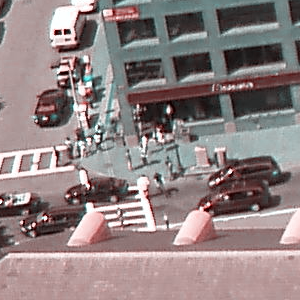 dupe_band | 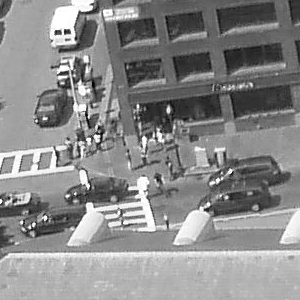 sing_band |
--Make a new raster with 2nd band of original and 1st band repeated twice,
and another with just the third band
SELECT rast, ST_Band(rast, ARRAY[2,1,1]) As dupe_band,
ST_Band(rast, 3) As sing_band
FROM samples.than_chunked
WHERE rid=35;
Voir aussi
ST_AddBand, ST_NumBands, ST_Reclass, Chapter 11, Référence Raster
Name
ST_MakeEmptyCoverage — Couvre une zone géo-référencée avec une grille raster de tuiles vides.
Synopsis
raster ST_MakeEmptyCoverage(integer tilewidth, integer tileheight, integer width, integer height, double precision upperleftx, double precision upperlefty, double precision scalex, double precision scaley, double precision skewx, double precision skewy, integer srid=unknown);
Description
Créé un ensemble de tuiles rasters via ST_MakeEmptyRaster. La dimension de la grille est définie par width & height. La dimension des tuiles est définie par tilewidth & tileheight. La zone géo-référencée couverte démarre au coin supérieur gauche (upperleftx, upperlefty) jusqu'au coin inférieur droit (upperleftx + width * scalex, upperlefty + height * scaley).
![[Note]](images/note.png) | |
A noter que scaley est généralement négatif pour les rasters, alors que scalex est généralement positif. Le coin inférieur droit aura une valeur Y inférieure et une valeur X supérieure au coin supérieur gauche. |
Disponibilité : 2.4.0
Exemples de base
Créer 16 tuiles de 1x1px dans une grille 4x4 pour couvrir une zone WGS84 du coin supérieur gauche (22, 77) jusqu'au coin inférieur droit (55, 33).
SELECT (ST_MetaData(tile)).* FROM ST_MakeEmptyCoverage(1, 1, 4, 4, 22, 33, (55 - 22)/(4)::float, (33 - 77)/(4)::float, 0., 0., 4326) tile;
upperleftx | upperlefty | width | height | scalex | scaley | skewx | skewy | srid | numbands
-------------------------------------------------------------------------------------
22 | 33 | 1 | 1 | 8.25 | -11 | 0 | 0 | 4326 | 0
30.25 | 33 | 1 | 1 | 8.25 | -11 | 0 | 0 | 4326 | 0
38.5 | 33 | 1 | 1 | 8.25 | -11 | 0 | 0 | 4326 | 0
46.75 | 33 | 1 | 1 | 8.25 | -11 | 0 | 0 | 4326 | 0
22 | 22 | 1 | 1 | 8.25 | -11 | 0 | 0 | 4326 | 0
30.25 | 22 | 1 | 1 | 8.25 | -11 | 0 | 0 | 4326 | 0
38.5 | 22 | 1 | 1 | 8.25 | -11 | 0 | 0 | 4326 | 0
46.75 | 22 | 1 | 1 | 8.25 | -11 | 0 | 0 | 4326 | 0
22 | 11 | 1 | 1 | 8.25 | -11 | 0 | 0 | 4326 | 0
30.25 | 11 | 1 | 1 | 8.25 | -11 | 0 | 0 | 4326 | 0
38.5 | 11 | 1 | 1 | 8.25 | -11 | 0 | 0 | 4326 | 0
46.75 | 11 | 1 | 1 | 8.25 | -11 | 0 | 0 | 4326 | 0
22 | 0 | 1 | 1 | 8.25 | -11 | 0 | 0 | 4326 | 0
30.25 | 0 | 1 | 1 | 8.25 | -11 | 0 | 0 | 4326 | 0
38.5 | 0 | 1 | 1 | 8.25 | -11 | 0 | 0 | 4326 | 0
46.75 | 0 | 1 | 1 | 8.25 | -11 | 0 | 0 | 4326 | 0Voir aussi
Name
ST_MakeEmptyRaster — Retourne un raster vide (sans aucune bande) de dimension donnée (width & height), de coin supérieur gauche à X et Y, de paramètres de taille de pixel données (scalex, scaley, skewx & skewy) et de système de référence spatial (srid) donné. Si un raster est spécifié, retourne un nouveau raster de même taille, alignement et SRID. Si srid n'est pas spécifié, le système de référence spatial est défini à inconnu (0).
Synopsis
raster ST_MakeEmptyRaster(raster rast);
raster ST_MakeEmptyRaster(integer width, integer height, float8 upperleftx, float8 upperlefty, float8 scalex, float8 scaley, float8 skewx, float8 skewy, integer srid=unknown);
raster ST_MakeEmptyRaster(integer width, integer height, float8 upperleftx, float8 upperlefty, float8 pixelsize);
Description
Retourne un raster vide (sans aucune bande) de dimension donnée (width & height), géo-référencé via le coin supérieur gauche (upperleftx & upperlefty), via les paramètres de taille de pixel données (scalex, scaley, skewx & skewy) et via le système de référence spatial (srid) donné.
La dernière variante utilise un seul paramètre pour spécifier la taille des pixels (pixelsize). scalex est défini à la valeur de ce paramètre et scaley est défini à la valeur négative de ce paramètre. skewx et skewy sont définis à 0.
Si un raster existant est spécifié, retourne un nouveau raster avec les mêmes métadonnées (sans aucune bande).
Si aucun srid n'est spécifié, la valeur 0 est utilisée. Après avoir créé un raster vide, vous voudrez probablement ajouter des bandes ou l'éditer. Voir ST_AddBand pour définir des bandes et ST_SetValue pour initialiser des valeurs.
Exemples
INSERT INTO dummy_rast(rid,rast)
VALUES(3, ST_MakeEmptyRaster( 100, 100, 0.0005, 0.0005, 1, 1, 0, 0, 4326) );
--use an existing raster as template for new raster
INSERT INTO dummy_rast(rid,rast)
SELECT 4, ST_MakeEmptyRaster(rast)
FROM dummy_rast WHERE rid = 3;
-- output meta data of rasters we just added
SELECT rid, (md).*
FROM (SELECT rid, ST_MetaData(rast) As md
FROM dummy_rast
WHERE rid IN(3,4)) As foo;
-- output --
rid | upperleftx | upperlefty | width | height | scalex | scaley | skewx | skewy | srid | numbands
-----+------------+------------+-------+--------+------------+------------+-------+-------+------+----------
3 | 0.0005 | 0.0005 | 100 | 100 | 1 | 1 | 0 | 0 | 4326 | 0
4 | 0.0005 | 0.0005 | 100 | 100 | 1 | 1 | 0 | 0 | 4326 | 0
Voir aussi
ST_AddBand, ST_MetaData, ST_ScaleX, ST_ScaleY, ST_SetValue, ST_SkewX, , ST_SkewY
Name
ST_Tile — Retourne un ensemble de rasters issus de la division d'un raster d'entrée selon les dimensions spécifiées pour les rasters de sortie.
Synopsis
setof raster ST_Tile(raster rast, int[] nband, integer width, integer height, boolean padwithnodata=FALSE, double precision nodataval=NULL);
setof raster ST_Tile(raster rast, integer nband, integer width, integer height, boolean padwithnodata=FALSE, double precision nodataval=NULL);
setof raster ST_Tile(raster rast, integer width, integer height, boolean padwithnodata=FALSE, double precision nodataval=NULL);
Description
Retourne un ensemble de rasters issus de la division d'un raster d'entrée selon les dimensions spécifiées pour les rasters de sortie.
Si padwithnodata est FALSE, les tuiles des bords droits et bas peuvent avoir des dimensions différentes du reste des tuiles. Si padwithnodata est TRUE, toutes les tuiles auront les mêmes dimensions, potentiellement avec les tuiles des bords complétées par la valeur NODATA. Si la bande raster n'a pas de valeur NODATA définie, cette valeur peut être spécifiée via le paramètre nodataval.
![[Note]](images/note.png) | |
Si une bande spécifiée du raster d'entrée est out-of-db, la bande correspondant dans les rasters de sortie sera aussi out-of-db. |
Disponibilité : 2.1.0
Exemples
WITH foo AS (
SELECT ST_AddBand(ST_AddBand(ST_MakeEmptyRaster(3, 3, 0, 0, 1, -1, 0, 0, 0), 1, '8BUI', 1, 0), 2, '8BUI', 10, 0) AS rast UNION ALL
SELECT ST_AddBand(ST_AddBand(ST_MakeEmptyRaster(3, 3, 3, 0, 1, -1, 0, 0, 0), 1, '8BUI', 2, 0), 2, '8BUI', 20, 0) AS rast UNION ALL
SELECT ST_AddBand(ST_AddBand(ST_MakeEmptyRaster(3, 3, 6, 0, 1, -1, 0, 0, 0), 1, '8BUI', 3, 0), 2, '8BUI', 30, 0) AS rast UNION ALL
SELECT ST_AddBand(ST_AddBand(ST_MakeEmptyRaster(3, 3, 0, -3, 1, -1, 0, 0, 0), 1, '8BUI', 4, 0), 2, '8BUI', 40, 0) AS rast UNION ALL
SELECT ST_AddBand(ST_AddBand(ST_MakeEmptyRaster(3, 3, 3, -3, 1, -1, 0, 0, 0), 1, '8BUI', 5, 0), 2, '8BUI', 50, 0) AS rast UNION ALL
SELECT ST_AddBand(ST_AddBand(ST_MakeEmptyRaster(3, 3, 6, -3, 1, -1, 0, 0, 0), 1, '8BUI', 6, 0), 2, '8BUI', 60, 0) AS rast UNION ALL
SELECT ST_AddBand(ST_AddBand(ST_MakeEmptyRaster(3, 3, 0, -6, 1, -1, 0, 0, 0), 1, '8BUI', 7, 0), 2, '8BUI', 70, 0) AS rast UNION ALL
SELECT ST_AddBand(ST_AddBand(ST_MakeEmptyRaster(3, 3, 3, -6, 1, -1, 0, 0, 0), 1, '8BUI', 8, 0), 2, '8BUI', 80, 0) AS rast UNION ALL
SELECT ST_AddBand(ST_AddBand(ST_MakeEmptyRaster(3, 3, 6, -6, 1, -1, 0, 0, 0), 1, '8BUI', 9, 0), 2, '8BUI', 90, 0) AS rast
), bar AS (
SELECT ST_Union(rast) AS rast FROM foo
), baz AS (
SELECT ST_Tile(rast, 3, 3, TRUE) AS rast FROM bar
)
SELECT
ST_DumpValues(rast)
FROM baz;
st_dumpvalues
------------------------------------------
(1,"{{1,1,1},{1,1,1},{1,1,1}}")
(2,"{{10,10,10},{10,10,10},{10,10,10}}")
(1,"{{2,2,2},{2,2,2},{2,2,2}}")
(2,"{{20,20,20},{20,20,20},{20,20,20}}")
(1,"{{3,3,3},{3,3,3},{3,3,3}}")
(2,"{{30,30,30},{30,30,30},{30,30,30}}")
(1,"{{4,4,4},{4,4,4},{4,4,4}}")
(2,"{{40,40,40},{40,40,40},{40,40,40}}")
(1,"{{5,5,5},{5,5,5},{5,5,5}}")
(2,"{{50,50,50},{50,50,50},{50,50,50}}")
(1,"{{6,6,6},{6,6,6},{6,6,6}}")
(2,"{{60,60,60},{60,60,60},{60,60,60}}")
(1,"{{7,7,7},{7,7,7},{7,7,7}}")
(2,"{{70,70,70},{70,70,70},{70,70,70}}")
(1,"{{8,8,8},{8,8,8},{8,8,8}}")
(2,"{{80,80,80},{80,80,80},{80,80,80}}")
(1,"{{9,9,9},{9,9,9},{9,9,9}}")
(2,"{{90,90,90},{90,90,90},{90,90,90}}")
(18 rows)
WITH foo AS (
SELECT ST_AddBand(ST_AddBand(ST_MakeEmptyRaster(3, 3, 0, 0, 1, -1, 0, 0, 0), 1, '8BUI', 1, 0), 2, '8BUI', 10, 0) AS rast UNION ALL
SELECT ST_AddBand(ST_AddBand(ST_MakeEmptyRaster(3, 3, 3, 0, 1, -1, 0, 0, 0), 1, '8BUI', 2, 0), 2, '8BUI', 20, 0) AS rast UNION ALL
SELECT ST_AddBand(ST_AddBand(ST_MakeEmptyRaster(3, 3, 6, 0, 1, -1, 0, 0, 0), 1, '8BUI', 3, 0), 2, '8BUI', 30, 0) AS rast UNION ALL
SELECT ST_AddBand(ST_AddBand(ST_MakeEmptyRaster(3, 3, 0, -3, 1, -1, 0, 0, 0), 1, '8BUI', 4, 0), 2, '8BUI', 40, 0) AS rast UNION ALL
SELECT ST_AddBand(ST_AddBand(ST_MakeEmptyRaster(3, 3, 3, -3, 1, -1, 0, 0, 0), 1, '8BUI', 5, 0), 2, '8BUI', 50, 0) AS rast UNION ALL
SELECT ST_AddBand(ST_AddBand(ST_MakeEmptyRaster(3, 3, 6, -3, 1, -1, 0, 0, 0), 1, '8BUI', 6, 0), 2, '8BUI', 60, 0) AS rast UNION ALL
SELECT ST_AddBand(ST_AddBand(ST_MakeEmptyRaster(3, 3, 0, -6, 1, -1, 0, 0, 0), 1, '8BUI', 7, 0), 2, '8BUI', 70, 0) AS rast UNION ALL
SELECT ST_AddBand(ST_AddBand(ST_MakeEmptyRaster(3, 3, 3, -6, 1, -1, 0, 0, 0), 1, '8BUI', 8, 0), 2, '8BUI', 80, 0) AS rast UNION ALL
SELECT ST_AddBand(ST_AddBand(ST_MakeEmptyRaster(3, 3, 6, -6, 1, -1, 0, 0, 0), 1, '8BUI', 9, 0), 2, '8BUI', 90, 0) AS rast
), bar AS (
SELECT ST_Union(rast) AS rast FROM foo
), baz AS (
SELECT ST_Tile(rast, 3, 3, 2) AS rast FROM bar
)
SELECT
ST_DumpValues(rast)
FROM baz;
st_dumpvalues
------------------------------------------
(1,"{{10,10,10},{10,10,10},{10,10,10}}")
(1,"{{20,20,20},{20,20,20},{20,20,20}}")
(1,"{{30,30,30},{30,30,30},{30,30,30}}")
(1,"{{40,40,40},{40,40,40},{40,40,40}}")
(1,"{{50,50,50},{50,50,50},{50,50,50}}")
(1,"{{60,60,60},{60,60,60},{60,60,60}}")
(1,"{{70,70,70},{70,70,70},{70,70,70}}")
(1,"{{80,80,80},{80,80,80},{80,80,80}}")
(1,"{{90,90,90},{90,90,90},{90,90,90}}")
(9 rows)
Name
ST_Retile — Retourne un ensemble de tuiles configurées à partir d'une couverture raster composée de tuiles arbitraires.
Synopsis
SETOF raster ST_Retile(regclass tab, name col, geometry ext, float8 sfx, float8 sfy, int tw, int th, text algo='NearestNeighbor');
Description
Retourne un ensemble de tuiles ayant l'échelle spécifiée (sfx, sfy), de taille maximale (tw, th) et couvrant l'étendue spécifiée (ext), et avec les données provenant de la couverture raster spécifiée (tab, col).
Les algorithmes disponibles sont : 'NearestNeighbor' (plus proche voisin), 'Bilinear' (Bilinéaire), 'Cubic' (Cubique), 'CubicSpline' (Cubique Spline) et 'Lanczos'. Voir GDAL Warp resampling methods pour plus de détails.
Disponibilité : 2.2.0
Voir aussi
Name
ST_FromGDALRaster — Retourne un raster depuis un fichier raster supporté par GDAL.
Synopsis
raster ST_FromGDALRaster(bytea gdaldata, integer srid=NULL);
Description
Retourne un raster depuis un fichier raster supporté par GDAL. Le paramètre gdaldata de type bytea est le contenu du fichier raster GDAL.
Si srid est NULL, la fonction essaye de déterminer le SRID depuis le raster GDAL. Si srid est spécifié, la valeur spécifiée écrase tout SRID déterminé automatiquement.
Disponibilité : 2.1.0
Exemples
WITH foo AS (
SELECT ST_AsPNG(ST_AddBand(ST_AddBand(ST_AddBand(ST_MakeEmptyRaster(2, 2, 0, 0, 0.1, -0.1, 0, 0, 4326), 1, '8BUI', 1, 0), 2, '8BUI', 2, 0), 3, '8BUI', 3, 0)) AS png
),
bar AS (
SELECT 1 AS rid, ST_FromGDALRaster(png) AS rast FROM foo
UNION ALL
SELECT 2 AS rid, ST_FromGDALRaster(png, 3310) AS rast FROM foo
)
SELECT
rid,
ST_Metadata(rast) AS metadata,
ST_SummaryStats(rast, 1) AS stats1,
ST_SummaryStats(rast, 2) AS stats2,
ST_SummaryStats(rast, 3) AS stats3
FROM bar
ORDER BY rid;
rid | metadata | stats1 | stats2 | stats3
-----+---------------------------+---------------+---------------+----------------
1 | (0,0,2,2,1,-1,0,0,0,3) | (4,4,1,0,1,1) | (4,8,2,0,2,2) | (4,12,3,0,3,3)
2 | (0,0,2,2,1,-1,0,0,3310,3) | (4,4,1,0,1,1) | (4,8,2,0,2,2) | (4,12,3,0,3,3)
(2 rows)
Voir aussi
11.4. Fonctions d'accès aux rasters
- ST_GeoReference — Retourne les méta-données de géo-référencement au format GDAL (par défaut) ou ESRI, tel qu'utilisé généralement dans les fichiers world file.
- ST_Height — Retourne la hauteur du raster en pixels.
- ST_IsEmpty — Retourne true si le raster est vide (largeur = 0 et hauteur = 0). Sinon, retourne false.
- ST_MemSize — Retourne l'espace utilisé par le raster (en octets).
- ST_MetaData — Retourne les méta-données de base de l'objet raster : taille des pixels, rotation, coin haut/bas gauche, etc.
- ST_NumBands — Retourne le nombre de bandes de l'objet raster.
- ST_PixelHeight — Retourne la hauteur d'un pixel, dans l'unité du système de référence spatial.
- ST_PixelWidth — Retourne la largeur d'un pixel, dans l'unité du système de référence spatial.
- ST_ScaleX — Renvoie la composante X de la largeur du pixel dans l'unité du système de référence spatial.
- ST_ScaleY — Renvoie la composante Y de la hauteur du pixel dans l'unité du système de référence spatial.
- ST_RasterToWorldCoord — Retourne le coin supérieur gauche du raster, sous forme de coordonnées X et Y (longitude et latitude) d'un colonne et d'une ligne. Les numéros de colonne et de ligne commencent à 1.
- ST_RasterToWorldCoordX — Retourne la coordonnée X du coin supérieur gauche du raster à column et row. Les numéros de colonne et de ligne commencent à 1.
- ST_RasterToWorldCoordY — Retourne la coordonnée Y du coin supérieur gauche du raster à column et row. Les numéros de colonne et de ligne commencent à 1.
- ST_Rotation — Retourne l'angle de rotation du raster en radians.
- ST_SkewX — Retourne l'obliquité géo-référencée X (paramètre de rotation).
- ST_SkewY — Retourne l'obliquité géo-référencée Y (paramètre de rotation).
- ST_SRID — Retourne l'identifiant du système de référence spatial du raster, tel que défini dans la table spatial_ref_sys.
- ST_Summary — Retourne un résumé du contenu du raster sous forme de texte.
- ST_UpperLeftX — Retourne la coordonnée X du coin supérieur gauche du raster projeté dans le système de référence spatial.
- ST_UpperLeftY — Retourne la coordonnée Y du coin supérieur gauche du raster projeté dans le système de référence spatial.
- ST_Width — Retourne la largeur du raster en pixels.
- ST_WorldToRasterCoord — Retourne le coin supérieur gauche comme colonne et ligne, en fonction de coordonnées géométriques X et Y (longitude et latitude) ou un point géométrique dans le système de référence spatial du raster.
- ST_WorldToRasterCoordX — Retourne la colonne dans le raster du point géométrique (pt) ou des coordonnées X et Y (xw, yw) exprimés dans le système de référence spatial du raster.
- ST_WorldToRasterCoordY — Retourne la ligne dans le raster du point géométrique (pt) ou des coordonnées X et Y (xw, yw) exprimés dans le système de référence spatial du raster.
Name
ST_GeoReference — Retourne les méta-données de géo-référencement au format GDAL (par défaut) ou ESRI, tel qu'utilisé généralement dans les fichiers world file.
Synopsis
text ST_GeoReference(raster rast, text format=GDAL);
Description
Retourne les méta-données de géo-référencement au format GDAL ou ESRI, tel qu'utilisé généralement dans les fichiers world file. Si aucun type n'est spécifié, utilise le format GDAL par défaut. type est une chaîne 'GDAL' ou 'ESRI'.
La différence entre les représentations de format est la suivante :
GDAL :
scalex skewy skewx scaley upperleftx upperlefty
ESRI :
scalex skewy skewx scaley upperleftx + scalex*0.5 upperlefty + scaley*0.5
Exemples
SELECT ST_GeoReference(rast, 'ESRI') As esri_ref, ST_GeoReference(rast, 'GDAL') As gdal_ref
FROM dummy_rast WHERE rid=1;
esri_ref | gdal_ref
--------------+--------------
2.0000000000 | 2.0000000000
0.0000000000 : 0.0000000000
0.0000000000 : 0.0000000000
3.0000000000 : 3.0000000000
1.5000000000 : 0.5000000000
2.0000000000 : 0.5000000000
Voir aussi
Name
ST_Height — Retourne la hauteur du raster en pixels.
Synopsis
integer ST_Height(raster rast);
Description
Retourne la hauteur du raster en pixels.
Exemples
SELECT rid, ST_Height(rast) As rastheight
FROM dummy_rast;
rid | rastheight
-----+------------
1 | 20
2 | 5
Voir aussi
Name
ST_IsEmpty — Retourne true si le raster est vide (largeur = 0 et hauteur = 0). Sinon, retourne false.
Synopsis
boolean ST_IsEmpty(raster rast);
Description
Retourne true si le raster est vide (largeur = 0 et hauteur = 0). Sinon, retourne false.
Disponibilité : 2.0.0
Exemples
SELECT ST_IsEmpty(ST_MakeEmptyRaster(100, 100, 0, 0, 0, 0, 0, 0))
st_isempty |
-----------+
f |
SELECT ST_IsEmpty(ST_MakeEmptyRaster(0, 0, 0, 0, 0, 0, 0, 0))
st_isempty |
-----------+
t |
Voir aussi
Name
ST_MemSize — Retourne l'espace utilisé par le raster (en octets).
Synopsis
integer ST_MemSize(raster rast);
Description
Retourne l'espace utilisé par le raster (en octets).
Cette fonction est un bon complément aux fonctions PostgreSQL natives pg_column_size, pg_size_pretty, pg_relation_size, pg_total_relation_size.
![[Note]](images/note.png) | |
pg_relation_size qui donne la taille en octets d'une table peut renvoyer une taille en octets inférieure à ST_MemSize. Cela est dû au fait que pg_relation_size n'ajoute pas la contribution des tables toasted et que les grandes géométries sont stockées dans les tables TOAST. pg_column_size peut retourner une valeur inférieure parce qu'elle retourne la taille compressée. pg_total_relation_size - comprend la table, les tables toasted et les index. |
Disponibilité : 2.2.0
Exemples
SELECT ST_MemSize(ST_AsRaster(ST_Buffer(ST_Point(1,5),10,1000),150, 150, '8BUI')) As rast_mem;
rast_mem
--------
22568
Voir aussi
Name
ST_MetaData — Retourne les méta-données de base de l'objet raster : taille des pixels, rotation, coin haut/bas gauche, etc.
Synopsis
record ST_MetaData(raster rast);
Description
Retourne les méta-données de base de l'objet raster : taille des pixels, rotation, coin haut/bas gauche, etc. Les colonnes retournées sont : upperleftx | upperlefty | width | height | scalex | scaley | skewx | skewy | srid | numbands
Exemples
SELECT rid, (foo.md).*
FROM (SELECT rid, ST_MetaData(rast) As md
FROM dummy_rast) As foo;
rid | upperleftx | upperlefty | width | height | scalex | scaley | skewx | skewy | srid | numbands
----+------------+------------+-------+--------+--------+-----------+-------+-------+------+-------
1 | 0.5 | 0.5 | 10 | 20 | 2 | 3 | 0 | 0 | 0 | 0
2 | 3427927.75 | 5793244 | 5 | 5 | 0.05 | -0.05 | 0 | 0 | 0 | 3
Voir aussi
Name
ST_NumBands — Retourne le nombre de bandes de l'objet raster.
Synopsis
integer ST_NumBands(raster rast);
Description
Retourne le nombre de bandes de l'objet raster.
Exemples
SELECT rid, ST_NumBands(rast) As numbands
FROM dummy_rast;
rid | numbands
----+----------
1 | 0
2 | 3
Voir aussi
Name
ST_PixelHeight — Retourne la hauteur d'un pixel, dans l'unité du système de référence spatial.
Synopsis
double precision ST_PixelHeight(raster rast);
Description
Retourne la hauteur d'un pixel, dans l'unité du système de référence spatial. Dans le cas général où il n'y a pas d'obliquité (skew), la hauteur d'un pixel est simplement l'échelle entre les coordonnées géométriques et les pixels rasters.
Voir ST_PixelWidth pour une représentation schématique de la relation.
Exemples : Rasters sans obliquité (skew)
SELECT ST_Height(rast) As rastheight, ST_PixelHeight(rast) As pixheight,
ST_ScaleX(rast) As scalex, ST_ScaleY(rast) As scaley, ST_SkewX(rast) As skewx,
ST_SkewY(rast) As skewy
FROM dummy_rast;
rastheight | pixheight | scalex | scaley | skewx | skewy
------------+-----------+--------+--------+-------+----------
20 | 3 | 2 | 3 | 0 | 0
5 | 0.05 | 0.05 | -0.05 | 0 | 0
Exemples : Rasters avec obliquité (skew) différent de 0
SELECT ST_Height(rast) As rastheight, ST_PixelHeight(rast) As pixheight,
ST_ScaleX(rast) As scalex, ST_ScaleY(rast) As scaley, ST_SkewX(rast) As skewx,
ST_SkewY(rast) As skewy
FROM (SELECT ST_SetSKew(rast,0.5,0.5) As rast
FROM dummy_rast) As skewed;
rastheight | pixheight | scalex | scaley | skewx | skewy
-----------+-------------------+--------+--------+-------+----------
20 | 3.04138126514911 | 2 | 3 | 0.5 | 0.5
5 | 0.502493781056044 | 0.05 | -0.05 | 0.5 | 0.5
Voir aussi
Name
ST_PixelWidth — Retourne la largeur d'un pixel, dans l'unité du système de référence spatial.
Synopsis
double precision ST_PixelWidth(raster rast);
Description
Retourne la largeur d'un pixel, dans l'unité du système de référence spatial. Dans le cas général où il n'y a pas d'obliquité (skew), la largeur d'un pixel est simplement l'échelle entre les coordonnées géométriques et les pixels rasters.
Le diagramme suivant illustre cette relation :
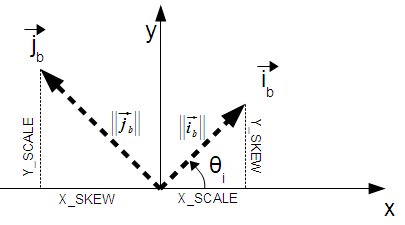
Largeur du pixel : taille du pixel dans la direction i
Hauteur du pixel : taille du pixel dans la direction j
Exemples : Rasters sans obliquité (skew)
SELECT ST_Width(rast) As rastwidth, ST_PixelWidth(rast) As pixwidth,
ST_ScaleX(rast) As scalex, ST_ScaleY(rast) As scaley, ST_SkewX(rast) As skewx,
ST_SkewY(rast) As skewy
FROM dummy_rast;
rastwidth | pixwidth | scalex | scaley | skewx | skewy
-----------+----------+--------+--------+-------+----------
10 | 2 | 2 | 3 | 0 | 0
5 | 0.05 | 0.05 | -0.05 | 0 | 0
Exemples : Rasters avec obliquité (skew) différent de 0
SELECT ST_Width(rast) As rastwidth, ST_PixelWidth(rast) As pixwidth,
ST_ScaleX(rast) As scalex, ST_ScaleY(rast) As scaley, ST_SkewX(rast) As skewx,
ST_SkewY(rast) As skewy
FROM (SELECT ST_SetSkew(rast,0.5,0.5) As rast
FROM dummy_rast) As skewed;
rastwidth | pixwidth | scalex | scaley | skewx | skewy
-----------+-------------------+--------+--------+-------+----------
10 | 2.06155281280883 | 2 | 3 | 0.5 | 0.5
5 | 0.502493781056044 | 0.05 | -0.05 | 0.5 | 0.5
Voir aussi
Name
ST_ScaleX — Renvoie la composante X de la largeur du pixel dans l'unité du système de référence spatial.
Synopsis
float8 ST_ScaleX(raster rast);
Description
Renvoie la composante X de la largeur du pixel dans l'unité du système de référence spatial. Voir World File pour plus de détails.
Changement : 2.0.0. Dans les versions WKTRaster, cette fonction était appelée ST_PixelSizeX.
Exemples
SELECT rid, ST_ScaleX(rast) As rastpixwidth
FROM dummy_rast;
rid | rastpixwidth
-----+--------------
1 | 2
2 | 0.05
Voir aussi
Name
ST_ScaleY — Renvoie la composante Y de la hauteur du pixel dans l'unité du système de référence spatial.
Synopsis
float8 ST_ScaleY(raster rast);
Description
Renvoie la composante Y de la hauteur du pixel dans l'unité du système de référence spatial. Peut être négative. Voir World File pour plus de détails.
Changement : 2.0.0. Dans les versions WKTRaster, cette fonction était appelée ST_PixelSizeY.
Exemples
SELECT rid, ST_ScaleY(rast) As rastpixheight
FROM dummy_rast;
rid | rastpixheight
-----+---------------
1 | 3
2 | -0.05
Voir aussi
Name
ST_RasterToWorldCoord — Retourne le coin supérieur gauche du raster, sous forme de coordonnées X et Y (longitude et latitude) d'un colonne et d'une ligne. Les numéros de colonne et de ligne commencent à 1.
Synopsis
record ST_RasterToWorldCoord(raster rast, integer xcolumn, integer yrow);
Description
Retourne le coin supérieur gauche du raster, sous forme de coordonnées X et Y (longitude et latitude) d'un colonne et d'une ligne. Les valeurs X et Y retournées sont dans l'unité du système de référence spatial du raster géo-référencé. Les numéros de colonne et de ligne commencent à 1, mais si l'un des deux paramètres est 0, un nombre négatif ou supérieur à la dimension du raster, la fonction retourne des coordonnées en dehors du raster, en supposant que la grille du raster est applicable en dehors de son étendue.
Disponibilité : 2.1.0
Exemples
-- non-skewed raster
SELECT
rid,
(ST_RasterToWorldCoord(rast,1, 1)).*,
(ST_RasterToWorldCoord(rast,2, 2)).*
FROM dummy_rast
rid | longitude | latitude | longitude | latitude
-----+------------+----------+-----------+------------
1 | 0.5 | 0.5 | 2.5 | 3.5
2 | 3427927.75 | 5793244 | 3427927.8 | 5793243.95
-- skewed raster
SELECT
rid,
(ST_RasterToWorldCoord(rast, 1, 1)).*,
(ST_RasterToWorldCoord(rast, 2, 3)).*
FROM (
SELECT
rid,
ST_SetSkew(rast, 100.5, 0) As rast
FROM dummy_rast
) As foo
rid | longitude | latitude | longitude | latitude
-----+------------+----------+-----------+-----------
1 | 0.5 | 0.5 | 203.5 | 6.5
2 | 3427927.75 | 5793244 | 3428128.8 | 5793243.9
Voir aussi
Name
ST_RasterToWorldCoordX — Retourne la coordonnée X du coin supérieur gauche du raster à column et row. Les numéros de colonne et de ligne commencent à 1.
Synopsis
float8 ST_RasterToWorldCoordX(raster rast, integer xcolumn);
float8 ST_RasterToWorldCoordX(raster rast, integer xcolumn, integer yrow);
Description
Retourne la coordonnée X du coin supérieur gauche du raster à column et row dans l'unité du système de référence spatial du raster géo-référencé. Les numéros de colonne et de ligne commencent à 1, mais si l'un des deux paramètres est 0, un nombre négatif ou supérieur à la dimension du raster, la fonction retourne des coordonnées en dehors du raster, en supposant que la grille du raster est applicable en dehors de son étendue (même taille de pixel et skew).
![[Note]](images/note.png) | |
Pour des rasters sans obliquité (skew), fournir le numéro de colonne X est suffisant. Pour des rasters avec obliquité, les coordonnées géo-référencées sont fonction de ST_ScaleX et ST_SkewX et de la ligne et colonne. Une erreur sera émise si seulement la colonne X est fournie pour une raster avec obliquité. |
Changement : 2.1.0 Jusqu'à la version 2.0.x, cette fonction était appelée ST_Raster2WorldCoordX
Exemples
-- non-skewed raster providing column is sufficient
SELECT rid, ST_RasterToWorldCoordX(rast,1) As x1coord,
ST_RasterToWorldCoordX(rast,2) As x2coord,
ST_ScaleX(rast) As pixelx
FROM dummy_rast;
rid | x1coord | x2coord | pixelx
-----+------------+-----------+--------
1 | 0.5 | 2.5 | 2
2 | 3427927.75 | 3427927.8 | 0.05
-- for fun lets skew it
SELECT rid, ST_RasterToWorldCoordX(rast, 1, 1) As x1coord,
ST_RasterToWorldCoordX(rast, 2, 3) As x2coord,
ST_ScaleX(rast) As pixelx
FROM (SELECT rid, ST_SetSkew(rast, 100.5, 0) As rast FROM dummy_rast) As foo;
rid | x1coord | x2coord | pixelx
-----+------------+-----------+--------
1 | 0.5 | 203.5 | 2
2 | 3427927.75 | 3428128.8 | 0.05
Voir aussi
Name
ST_RasterToWorldCoordY — Retourne la coordonnée Y du coin supérieur gauche du raster à column et row. Les numéros de colonne et de ligne commencent à 1.
Synopsis
float8 ST_RasterToWorldCoordY(raster rast, integer yrow);
float8 ST_RasterToWorldCoordY(raster rast, integer xcolumn, integer yrow);
Description
Retourne la coordonnée Y du coin supérieur gauche du raster à column et row dans l'unité du système de référence spatial du raster géo-référencé. Les numéros de colonne et de ligne commencent à 1, mais si l'un des deux paramètres est 0, un nombre négatif ou supérieur à la dimension du raster, la fonction retourne des coordonnées en dehors du raster, en supposant que la grille du raster est applicable en dehors de son étendue (même taille de pixel et skew).
![[Note]](images/note.png) | |
Pour des rasters sans obliquité (skew), fournir le numéro de ligne Y est suffisant. Pour des rasters avec obliquité, les coordonnées géo-référencées sont fonction de ST_ScaleY et ST_SkewY et de la ligne et colonne. Une erreur sera émise si seulement la ligne Y est fournie pour une raster avec obliquité. |
Changement : 2.1.0 Jusqu'à la version 2.0.x, cette fonction était appelée ST_Raster2WorldCoordY
Exemples
-- non-skewed raster providing row is sufficient
SELECT rid, ST_RasterToWorldCoordY(rast,1) As y1coord,
ST_RasterToWorldCoordY(rast,3) As y2coord,
ST_ScaleY(rast) As pixely
FROM dummy_rast;
rid | y1coord | y2coord | pixely
-----+---------+-----------+--------
1 | 0.5 | 6.5 | 3
2 | 5793244 | 5793243.9 | -0.05
-- for fun lets skew it
SELECT rid, ST_RasterToWorldCoordY(rast,1,1) As y1coord,
ST_RasterToWorldCoordY(rast,2,3) As y2coord,
ST_ScaleY(rast) As pixely
FROM (SELECT rid, ST_SetSkew(rast,0,100.5) As rast FROM dummy_rast) As foo;
rid | y1coord | y2coord | pixely
-----+---------+-----------+--------
1 | 0.5 | 107 | 3
2 | 5793244 | 5793344.4 | -0.05
Voir aussi
Name
ST_Rotation — Retourne l'angle de rotation du raster en radians.
Synopsis
float8 ST_Rotation(raster rast);
Description
Retourne la rotation uniforme du raster en radians. Si le raster n'a pas de rotation uniforme, retourne NaN. Voir World File pour plus de détails.
Exemples
SELECT rid, ST_Rotation(ST_SetScale(ST_SetSkew(rast, sqrt(2)), sqrt(2))) as rot FROM dummy_rast;
rid | rot
-----+-------------------
1 | 0.785398163397448
2 | 0.785398163397448
Voir aussi
Name
ST_SkewX — Retourne l'obliquité géo-référencée X (paramètre de rotation).
Synopsis
float8 ST_SkewX(raster rast);
Description
Retourne l'obliquité géo-référencée X (paramètre de rotation). Voir World File pour plus de détails.
Exemples
SELECT rid, ST_SkewX(rast) As skewx, ST_SkewY(rast) As skewy,
ST_GeoReference(rast) as georef
FROM dummy_rast;
rid | skewx | skewy | georef
-----+-------+-------+--------------------
1 | 0 | 0 | 2.0000000000
: 0.0000000000
: 0.0000000000
: 3.0000000000
: 0.5000000000
: 0.5000000000
:
2 | 0 | 0 | 0.0500000000
: 0.0000000000
: 0.0000000000
: -0.0500000000
: 3427927.7500000000
: 5793244.0000000000
Voir aussi
Name
ST_SkewY — Retourne l'obliquité géo-référencée Y (paramètre de rotation).
Synopsis
float8 ST_SkewY(raster rast);
Description
Retourne l'obliquité géo-référencée Y (paramètre de rotation). Voir World File pour plus de détails.
Exemples
SELECT rid, ST_SkewX(rast) As skewx, ST_SkewY(rast) As skewy,
ST_GeoReference(rast) as georef
FROM dummy_rast;
rid | skewx | skewy | georef
-----+-------+-------+--------------------
1 | 0 | 0 | 2.0000000000
: 0.0000000000
: 0.0000000000
: 3.0000000000
: 0.5000000000
: 0.5000000000
:
2 | 0 | 0 | 0.0500000000
: 0.0000000000
: 0.0000000000
: -0.0500000000
: 3427927.7500000000
: 5793244.0000000000
Voir aussi
Name
ST_SRID — Retourne l'identifiant du système de référence spatial du raster, tel que défini dans la table spatial_ref_sys.
Synopsis
integer ST_SRID(raster rast);
Description
Retourne l'identifiant du système de référence spatial du raster, tel que défini dans la table spatial_ref_sys.
![[Note]](images/note.png) | |
Non-georeferenced rasters and geometries use SRID 0. |
Exemples
SELECT ST_SRID(rast) As srid
FROM dummy_rast WHERE rid=1;
srid
----------------
0
Name
ST_Summary — Retourne un résumé du contenu du raster sous forme de texte.
Synopsis
text ST_Summary(raster rast);
Description
Retourne un résumé du contenu du raster sous forme de texte.
Disponibilité : 2.1.0
Exemples
SELECT ST_Summary(
ST_AddBand(
ST_AddBand(
ST_AddBand(
ST_MakeEmptyRaster(10, 10, 0, 0, 1, -1, 0, 0, 0)
, 1, '8BUI', 1, 0
)
, 2, '32BF', 0, -9999
)
, 3, '16BSI', 0, NULL
)
);
st_summary
------------------------------------------------------------------
Raster of 10x10 pixels has 3 bands and extent of BOX(0 -10,10 0)+
band 1 of pixtype 8BUI is in-db with NODATA value of 0 +
band 2 of pixtype 32BF is in-db with NODATA value of -9999 +
band 3 of pixtype 16BSI is in-db with no NODATA value
(1 row)
Voir aussi
Name
ST_UpperLeftX — Retourne la coordonnée X du coin supérieur gauche du raster projeté dans le système de référence spatial.
Synopsis
float8 ST_UpperLeftX(raster rast);
Description
Retourne la coordonnée X du coin supérieur gauche du raster projeté dans le système de référence spatial.
Exemples
SELECt rid, ST_UpperLeftX(rast) As ulx
FROM dummy_rast;
rid | ulx
-----+------------
1 | 0.5
2 | 3427927.75
Voir aussi
Name
ST_UpperLeftY — Retourne la coordonnée Y du coin supérieur gauche du raster projeté dans le système de référence spatial.
Synopsis
float8 ST_UpperLeftY(raster rast);
Description
Retourne la coordonnée Y du coin supérieur gauche du raster projeté dans le système de référence spatial.
Exemples
SELECT rid, ST_UpperLeftY(rast) As uly
FROM dummy_rast;
rid | uly
-----+---------
1 | 0.5
2 | 5793244
Voir aussi
Name
ST_Width — Retourne la largeur du raster en pixels.
Synopsis
integer ST_Width(raster rast);
Description
Retourne la largeur du raster en pixels.
Exemples
SELECT ST_Width(rast) As rastwidth
FROM dummy_rast WHERE rid=1;
rastwidth
----------------
10
Voir aussi
Name
ST_WorldToRasterCoord — Retourne le coin supérieur gauche comme colonne et ligne, en fonction de coordonnées géométriques X et Y (longitude et latitude) ou un point géométrique dans le système de référence spatial du raster.
Synopsis
record ST_WorldToRasterCoord(raster rast, geometry pt);
record ST_WorldToRasterCoord(raster rast, double precision longitude, double precision latitude);
Description
Retourne le coin supérieur gauche comme colonne et ligne, en fonction de coordonnées géométriques X et Y (longitude et latitude) ou un point géométrique. Cette fonction fonctionne aussi bien si X et Y ou le point sont dans l'étendue du raster ou non. Les coordonnées géométriques X et Y ou les coordonnées du point doivent être dans le système de référence spatial du raster.
Disponibilité : 2.1.0
Exemples
SELECT
rid,
(ST_WorldToRasterCoord(rast,3427927.8,20.5)).*,
(ST_WorldToRasterCoord(rast,ST_GeomFromText('POINT(3427927.8 20.5)',ST_SRID(rast)))).*
FROM dummy_rast;
rid | columnx | rowy | columnx | rowy
-----+---------+-----------+---------+-----------
1 | 1713964 | 7 | 1713964 | 7
2 | 2 | 115864471 | 2 | 115864471
Name
ST_WorldToRasterCoordX — Retourne la colonne dans le raster du point géométrique (pt) ou des coordonnées X et Y (xw, yw) exprimés dans le système de référence spatial du raster.
Synopsis
integer ST_WorldToRasterCoordX(raster rast, geometry pt);
integer ST_WorldToRasterCoordX(raster rast, double precision xw);
integer ST_WorldToRasterCoordX(raster rast, double precision xw, double precision yw);
Description
Retourne la colonne dans le raster du point géométrique (pt) ou des coordonnées X et Y (xw, yw). Un point, ou le couple (xw, yw) sont requis pour un raster avec obliquité (skew). Sinon, xw est suffisant. Les coordonnées sont exprimées dans le système de référence spatial du raster.
Changement : 2.1.0 Dans les versions précédentes, cette fonctionne était appelée ST_World2RasterCoordX
Exemples
SELECT rid, ST_WorldToRasterCoordX(rast,3427927.8) As xcoord,
ST_WorldToRasterCoordX(rast,3427927.8,20.5) As xcoord_xwyw,
ST_WorldToRasterCoordX(rast,ST_GeomFromText('POINT(3427927.8 20.5)',ST_SRID(rast))) As ptxcoord
FROM dummy_rast;
rid | xcoord | xcoord_xwyw | ptxcoord
-----+---------+---------+----------
1 | 1713964 | 1713964 | 1713964
2 | 1 | 1 | 1
Voir aussi
Name
ST_WorldToRasterCoordY — Retourne la ligne dans le raster du point géométrique (pt) ou des coordonnées X et Y (xw, yw) exprimés dans le système de référence spatial du raster.
Synopsis
integer ST_WorldToRasterCoordY(raster rast, geometry pt);
integer ST_WorldToRasterCoordY(raster rast, double precision xw);
integer ST_WorldToRasterCoordY(raster rast, double precision xw, double precision yw);
Description
Retourne la ligne dans le raster du point géométrique (pt) ou des coordonnées X et Y (xw, yw). Un point, ou le couple (xw, yw) sont requis pour un raster avec obliquité (skew). Sinon, xw est suffisant. Les coordonnées sont exprimées dans le système de référence spatial du raster.
Changement : 2.1.0 Dans les versions précédentes, cette fonctionne était appelée ST_World2RasterCoordY
Exemples
SELECT rid, ST_WorldToRasterCoordY(rast,20.5) As ycoord,
ST_WorldToRasterCoordY(rast,3427927.8,20.5) As ycoord_xwyw,
ST_WorldToRasterCoordY(rast,ST_GeomFromText('POINT(3427927.8 20.5)',ST_SRID(rast))) As ptycoord
FROM dummy_rast;
rid | ycoord | ycoord_xwyw | ptycoord
-----+-----------+-------------+-----------
1 | 7 | 7 | 7
2 | 115864471 | 115864471 | 115864471
Voir aussi
11.5. Fonctions d'accès aux bandes raster
- ST_BandMetaData — Retourne les méta-données de base d'une bande raster spécifique. Si aucune bande n'est spécifiée, la bande 1 est utilisée.
- ST_BandNoDataValue — Retourne la valeur qui représente l'absence de valeur (nodata) pour cette bande. Si aucune bande n'est spécifiée, la bande 1 est utilisée.
- ST_BandIsNoData — Retourne true si la bande ne contient que des valeurs nodata.
- ST_BandPath — Retourne le chemin système du fichier d'une bande stockée sur le système de fichier. Si aucune bande n'est spécifiée, la bande 1 est utilisée.
- ST_BandFileSize — Retourne la taille du fichier d'une bande stockée sur le système de fichier. Si aucune bande n'est spécifiée, la bande 1 est utilisée.
- ST_BandFileTimestamp — Retourne le timestamp du fichier d'une bande stockée sur le système de fichier. Si aucune bande n'est spécifiée, la bande 1 est utilisée.
- ST_BandPixelType — Retourne le type de pixel d'une bande. Si aucune bande n'est spécifiée, la bande 1 est utilisée.
- ST_MinPossibleValue — Retourne la valeur minimale supportée par le type de pixel pixeltype.
- ST_HasNoBand — Retourne true si le raster n'a pas la bande spécifiée. Si aucune bande n'est spécifiée, la bande 1 est utilisée.
Name
ST_BandMetaData — Retourne les méta-données de base d'une bande raster spécifique. Si aucune bande n'est spécifiée, la bande 1 est utilisée.
Synopsis
(1) record ST_BandMetaData(raster rast, integer band=1);
(2) record ST_BandMetaData(raster rast, integer[] band);
Description
Retourne les méta-données de base d'une bande raster spécifique. Les colonnes retournées sont : pixeltype, nodatavalue, isoutdb, path, outdbbandnum, filesize, filetimestamp.
![[Note]](images/note.png) | |
Si le raster ne contient aucune bande, une erreur est émise. |
![[Note]](images/note.png) | |
Si la bande n'a pas de valeur NODATA, nodatavalue est NULL. |
![[Note]](images/note.png) | |
Si isoutdb est False, alors path, outdbbandnum, filesize et filetimestamp sont NULL. Si l'accès outdb est désactivé, filesize et filetimestamp sont également NULL. |
Amélioration : 2.5.0 ajout de outdbbandnum, filesize et filetimestamp pour les rasters outdb.
Exemples : Variante 1
SELECT
rid,
(foo.md).*
FROM (
SELECT
rid,
ST_BandMetaData(rast, 1) AS md
FROM dummy_rast
WHERE rid=2
) As foo;
rid | pixeltype | nodatavalue | isoutdb | path | outdbbandnum
-----+-----------+---- --------+---------+------+--------------
2 | 8BUI | 0 | f | |
Exemples : Variante 2
WITH foo AS (
SELECT
ST_AddBand(NULL::raster, '/home/pele/devel/geo/postgis-git/raster/test/regress/loader/Projected.tif', NULL::int[]) AS rast
)
SELECT
*
FROM ST_BandMetadata(
(SELECT rast FROM foo),
ARRAY[1,3,2]::int[]
);
bandnum | pixeltype | nodatavalue | isoutdb | path | outdbbandnum | filesize | filetimestamp |
---------+-----------+-------------+---------+--------------------------------------------------------------------------------+---------------+----------+---------------+-
1 | 8BUI | | t | /home/pele/devel/geo/postgis-git/raster/test/regress/loader/Projected.tif | 1 | 12345 | 1521807257 |
3 | 8BUI | | t | /home/pele/devel/geo/postgis-git/raster/test/regress/loader/Projected.tif | 3 | 12345 | 1521807257 |
2 | 8BUI | | t | /home/pele/devel/geo/postgis-git/raster/test/regress/loader/Projected.tif | 2 | 12345 | 1521807257 |
Voir aussi
Name
ST_BandNoDataValue — Retourne la valeur qui représente l'absence de valeur (nodata) pour cette bande. Si aucune bande n'est spécifiée, la bande 1 est utilisée.
Synopsis
double precision ST_BandNoDataValue(raster rast, integer bandnum=1);
Description
Retourne la valeur qui représente l'absence de valeur (nodata) pour cette bande
Exemples
SELECT ST_BandNoDataValue(rast,1) As bnval1,
ST_BandNoDataValue(rast,2) As bnval2, ST_BandNoDataValue(rast,3) As bnval3
FROM dummy_rast
WHERE rid = 2;
bnval1 | bnval2 | bnval3
--------+--------+--------
0 | 0 | 0
Voir aussi
Name
ST_BandIsNoData — Retourne true si la bande ne contient que des valeurs nodata.
Synopsis
boolean ST_BandIsNoData(raster rast, integer band, boolean forceChecking=true);
boolean ST_BandIsNoData(raster rast, boolean forceChecking=true);
Description
Retourne true si la bande ne contient que des valeurs nodata. Si aucune bande n'est spécifiée, la bande 1 est utilisée. Si le dernier paramètre est TRUE, la bande entière est vérifiée pixel par pixel. Sinon, la fonction retourne simplement la valeur du flag isnodata pour cette bande. La valeur par défaut pour ce paramètre est FALSE.
Disponibilité : 2.0.0
![[Note]](images/note.png) | |
Si le flag est obsolète (c'est à dire si le résultat est différent selon qu'on utilise TRUE ou non comme dernier paramètre), vous devriez mettre à jour le raster pour mettre à jour ce flag, en utilisant ST_SetBandIsNodata(), ou ST_SetBandNodataValue() avec TRUE en dernier paramètre. Voir ST_SetBandIsNoData. |
Exemples
-- Create dummy table with one raster column
create table dummy_rast (rid integer, rast raster);
-- Add raster with two bands, one pixel/band. In the first band, nodatavalue = pixel value = 3.
-- In the second band, nodatavalue = 13, pixel value = 4
insert into dummy_rast values(1,
(
'01' -- little endian (uint8 ndr)
||
'0000' -- version (uint16 0)
||
'0200' -- nBands (uint16 0)
||
'17263529ED684A3F' -- scaleX (float64 0.000805965234044584)
||
'F9253529ED684ABF' -- scaleY (float64 -0.00080596523404458)
||
'1C9F33CE69E352C0' -- ipX (float64 -75.5533328537098)
||
'718F0E9A27A44840' -- ipY (float64 49.2824585505576)
||
'ED50EB853EC32B3F' -- skewX (float64 0.000211812383858707)
||
'7550EB853EC32B3F' -- skewY (float64 0.000211812383858704)
||
'E6100000' -- SRID (int32 4326)
||
'0100' -- width (uint16 1)
||
'0100' -- height (uint16 1)
||
'6' -- hasnodatavalue and isnodata value set to true.
||
'2' -- first band type (4BUI)
||
'03' -- novalue==3
||
'03' -- pixel(0,0)==3 (same that nodata)
||
'0' -- hasnodatavalue set to false
||
'5' -- second band type (16BSI)
||
'0D00' -- novalue==13
||
'0400' -- pixel(0,0)==4
)::raster
);
select st_bandisnodata(rast, 1) from dummy_rast where rid = 1; -- Expected true
select st_bandisnodata(rast, 2) from dummy_rast where rid = 1; -- Expected false
Name
ST_BandPath — Retourne le chemin système du fichier d'une bande stockée sur le système de fichier. Si aucune bande n'est spécifiée, la bande 1 est utilisée.
Synopsis
text ST_BandPath(raster rast, integer bandnum=1);
Description
Retourne le chemin système du fichier d'une bande. Renvoie une erreur si la bande n'est pas outofdb.
Exemples
Voir aussi
Name
ST_BandFileSize — Retourne la taille du fichier d'une bande stockée sur le système de fichier. Si aucune bande n'est spécifiée, la bande 1 est utilisée.
Synopsis
bigint ST_BandFileSize(raster rast, integer bandnum=1);
Description
Retourne la taille du fichier d'une bande stockée sur le système de fichier. Renvoie une erreur si la bande n'est pas outofdb, ou si l'accès outdb est désactivé.
Cette fonction est généralement utilisée conjointement à ST_BandPath() et ST_BandFileTimestamp(), pour qu'un client puisse déterminer le nom du fichier d'un raster outdb, tel que vu par le serveur.
Disponibilité : 2.5.0
Exemples
SELECT ST_BandFileSize(rast,1) FROM dummy_rast WHERE rid = 1;
st_bandfilesize
-----------------
240574
Name
ST_BandFileTimestamp — Retourne le timestamp du fichier d'une bande stockée sur le système de fichier. Si aucune bande n'est spécifiée, la bande 1 est utilisée.
Synopsis
bigint ST_BandFileTimestamp(raster rast, integer bandnum=1);
Description
Retourne le timestamp (nombre de secondes depuis Jan 1st 1970 00:00:00 UTC) du fichier d'une bande stockée sur le système de fichier. Renvoie une erreur si la bande n'est pas outofdb, ou si l'accès outdb est désactivé.
Cette fonction est généralement utilisée conjointement à ST_BandPath() et ST_BandFileSize(), pour qu'un client puisse déterminer le nom du fichier d'un raster outdb, tel que vu par le serveur.
Disponibilité : 2.5.0
Exemples
SELECT ST_BandFileTimestamp(rast,1) FROM dummy_rast WHERE rid = 1;
st_bandfiletimestamp
----------------------
1521807257
Name
ST_BandPixelType — Retourne le type de pixel d'une bande. Si aucune bande n'est spécifiée, la bande 1 est utilisée.
Synopsis
text ST_BandPixelType(raster rast, integer bandnum=1);
Description
Retourne le nom décrivant le type de données et la taille des valeurs stockées pour chaque pixel de la bande spécifiée.
Il existe 11 types de pixels. Les types de pixels supportés sont :
1BB - booléen 1-bit
2BUI - entier non signé 2-bits
4BUI - entier non signé 4-bits
8BSI - entier signé 8-bits
8BUI - entier non signé 8-bits
16BSI - entier signé 16-bits
16BUI - entier non signé 16-bits
32BSI - entier signé 32-bits
32BUI - entier non signé 32-bits
32BF - flottant 32-bits
64BF - flottant 64-bits
Exemples
SELECT ST_BandPixelType(rast,1) As btype1,
ST_BandPixelType(rast,2) As btype2, ST_BandPixelType(rast,3) As btype3
FROM dummy_rast
WHERE rid = 2;
btype1 | btype2 | btype3
--------+--------+--------
8BUI | 8BUI | 8BUI
Voir aussi
Name
ST_MinPossibleValue — Retourne la valeur minimale supportée par le type de pixel pixeltype.
Synopsis
integer ST_MinPossibleValue(text pixeltype);
Description
Retourne la valeur minimale supportée par le type de pixel pixeltype.
Exemples
SELECT ST_MinPossibleValue('16BSI');
st_minpossiblevalue
---------------------
-32768
SELECT ST_MinPossibleValue('8BUI');
st_minpossiblevalue
---------------------
0
Voir aussi
Name
ST_HasNoBand — Retourne true si le raster n'a pas la bande spécifiée. Si aucune bande n'est spécifiée, la bande 1 est utilisée.
Synopsis
boolean ST_HasNoBand(raster rast, integer bandnum=1);
Description
Retourne true si le raster n'a pas la bande spécifiée. Si aucune bande n'est spécifiée, la bande 1 est utilisée.
Disponibilité : 2.0.0
Exemples
SELECT rid, ST_HasNoBand(rast) As hb1, ST_HasNoBand(rast,2) as hb2,
ST_HasNoBand(rast,4) as hb4, ST_NumBands(rast) As numbands
FROM dummy_rast;
rid | hb1 | hb2 | hb4 | numbands
-----+-----+-----+-----+----------
1 | t | t | t | 0
2 | f | f | t | 3
Voir aussi
11.6. Fonctions d'accès et de modifications des pixels raster
- ST_PixelAsPolygon — Retourne la géométrie polygonale qui délimite le pixel pour une ligne et colonne spécifiées.
- ST_PixelAsPolygons — Retourne la géométrie polygonale qui délimite chaque pixel de la bande raster, avec la valeur et les coordonnées raster X et Y de chaque pixel.
- ST_PixelAsPoint — Retourne le point géométrique du coin supérieur gauche du pixel.
- ST_PixelAsPoints — Retourne un point géométrique pour chaque pixel de la bande raster, avec sa valeur et ses coordonnées raster X et Y. Les coordonnées du points sont ceux du coin supérieur gauche du pixel.
- ST_PixelAsCentroid — Retourne le centroïde (point géométrique) de la zone représentée par un pixel.
- ST_PixelAsCentroids — Retourne le centroïde (point géométrique) pour chaque pixel de la bande raster, avec sa valeur et les coordonnées raster X et Y. Le point géométrique est le centroïde de la zone représentée par un pixel.
- ST_Value — Retourne la valeur d'une bande raster spécifiée au pixel donné par columnx, rowy, ou à un point géométrique spécifié. Le numéro de bande démarre à 1, et la bande 1 est utilisée si non spécifié. Si
exclude_nodata_valuevaut false, tous les pixels y compris ceux ayant la valeurnodatasont considérés comme intersectés et leur valeur sera retournée. Siexclude_nodata_valuen'est pas spécifié, la valeur est lue depuis les méta-données du raster. - ST_NearestValue — Retourne la valeur la plus proche différent de
NODATApour une bande raster spécifiée au pixel donné par columnx et rowy, ou à un point géométrique spécifié dans le même système de référence spatial que le raster. - ST_SetZ — Retourne une géométrie avec les mêmes coordonnées X/Y que la géométrie d'entrée, et avec la coordonnée Z copiée depuis les valeurs du raster selon l'algorithme d'interpolation en paramètre.
- ST_SetM — Retourne une géométrie avec les mêmes coordonnées X/Y que la géométrie d'entrée, et avec la coordonnée M copiée depuis les valeurs du raster selon l'algorithme d'interpolation en paramètre.
- ST_Neighborhood — Retourne un tableau 2-D de double avec les valeurs non
NODATAautour du pixel de la bande spécifiée, aux coordonnées spécifiées par columnX & rowY ou par un point géométrique dans le même système de référence spatial que le raster. - ST_SetValue — Retourne un nouveau raster en modifiant la valeur du pixel pour la bande spécifiée et aux coordonnées columnx, rowy, ou pour tous les pixels qui intersectent une géométrie spécifiée. Le numéro de bande démarre à 1, et la bande 1 est utilisée si non spécifié.
- ST_SetValues — Retourne un nouveau raster en modifiant les valeurs de certains pixels d'une bande spécifiée.
- ST_DumpValues — Retourne les valeurs d'une bande raster spécifiée, sous forme d'un tableau à deux dimensions.
- ST_PixelOfValue — Retourne les coordonnées columnx, rowy du pixel dont la valeur est égale à la valeur recherchée.
Name
ST_PixelAsPolygon — Retourne la géométrie polygonale qui délimite le pixel pour une ligne et colonne spécifiées.
Synopsis
geometry ST_PixelAsPolygon(raster rast, integer columnx, integer rowy);
Description
Retourne la géométrie polygonale qui délimite le pixel pour une ligne et colonne spécifiées.
Disponibilité : 2.0.0
Exemples
-- get raster pixel polygon
SELECT i,j, ST_AsText(ST_PixelAsPolygon(foo.rast, i,j)) As b1pgeom
FROM dummy_rast As foo
CROSS JOIN generate_series(1,2) As i
CROSS JOIN generate_series(1,1) As j
WHERE rid=2;
i | j | b1pgeom
---+---+-----------------------------------------------------------------------------
1 | 1 | POLYGON((3427927.75 5793244,3427927.8 5793244,3427927.8 5793243.95,...
2 | 1 | POLYGON((3427927.8 5793244,3427927.85 5793244,3427927.85 5793243.95, ..
Name
ST_PixelAsPolygons — Retourne la géométrie polygonale qui délimite chaque pixel de la bande raster, avec la valeur et les coordonnées raster X et Y de chaque pixel.
Synopsis
setof record ST_PixelAsPolygons(raster rast, integer band=1, boolean exclude_nodata_value=TRUE);
Description
Retourne la géométrie polygonale qui délimite chaque pixel de la bande raster, avec la valeur (double précision) et les coordonnées raster X et Y (entiers) de chaque pixel.
Format de l'enregistrement de retour : geom geometry, val double precision, x entier, y entier.
![[Note]](images/note.png) | |
Si |
![[Note]](images/note.png) | |
ST_PixelAsPolygons retourne un polygone pour chaque pixel. Ce comportement est différent de ST_DumpAsPolygons, où chaque géométrie représente un ou plusieurs pixels de même valeur. |
Disponibilité : 2.0.0
Amélioration : 2.1.0 ajout du paramètre optionnel exclude_nodata_value.
Changement : 2.1.1 Changement du comportement de behavior of exclude_nodata_value.
Exemples
-- get raster pixel polygon
SELECT (gv).x, (gv).y, (gv).val, ST_AsText((gv).geom) geom
FROM (SELECT ST_PixelAsPolygons(
ST_SetValue(ST_SetValue(ST_AddBand(ST_MakeEmptyRaster(2, 2, 0, 0, 0.001, -0.001, 0.001, 0.001, 4269),
'8BUI'::text, 1, 0),
2, 2, 10),
1, 1, NULL)
) gv
) foo;
x | y | val | geom
---+---+-----------------------------------------------------------------------------
1 | 1 | | POLYGON((0 0,0.001 0.001,0.002 0,0.001 -0.001,0 0))
1 | 2 | 1 | POLYGON((0.001 -0.001,0.002 0,0.003 -0.001,0.002 -0.002,0.001 -0.001))
2 | 1 | 1 | POLYGON((0.001 0.001,0.002 0.002,0.003 0.001,0.002 0,0.001 0.001))
2 | 2 | 10 | POLYGON((0.002 0,0.003 0.001,0.004 0,0.003 -0.001,0.002 0))
Name
ST_PixelAsPoint — Retourne le point géométrique du coin supérieur gauche du pixel.
Synopsis
geometry ST_PixelAsPoint(raster rast, integer columnx, integer rowy);
Description
Retourne le point géométrique du coin supérieur gauche du pixel.
Disponibilité : 2.1.0
Exemples
SELECT ST_AsText(ST_PixelAsPoint(rast, 1, 1)) FROM dummy_rast WHERE rid = 1;
st_astext
----------------
POINT(0.5 0.5)
Name
ST_PixelAsPoints — Retourne un point géométrique pour chaque pixel de la bande raster, avec sa valeur et ses coordonnées raster X et Y. Les coordonnées du points sont ceux du coin supérieur gauche du pixel.
Synopsis
setof record ST_PixelAsPoints(raster rast, integer band=1, boolean exclude_nodata_value=TRUE);
Description
Retourne un point géométrique pour chaque pixel de la bande raster, avec sa valeur et ses coordonnées raster X et Y. Les coordonnées du points sont ceux du coin supérieur gauche du pixel.
Format de l'enregistrement de retour : geom geometry, val double precision, x entier, y entier.
![[Note]](images/note.png) | |
Si |
Disponibilité : 2.1.0
Changement : 2.1.1 Changement du comportement de behavior of exclude_nodata_value.
Exemples
SELECT x, y, val, ST_AsText(geom) FROM (SELECT (ST_PixelAsPoints(rast, 1)).* FROM dummy_rast WHERE rid = 2) foo;
x | y | val | st_astext
---+---+-----+------------------------------
1 | 1 | 253 | POINT(3427927.75 5793244)
2 | 1 | 254 | POINT(3427927.8 5793244)
3 | 1 | 253 | POINT(3427927.85 5793244)
4 | 1 | 254 | POINT(3427927.9 5793244)
5 | 1 | 254 | POINT(3427927.95 5793244)
1 | 2 | 253 | POINT(3427927.75 5793243.95)
2 | 2 | 254 | POINT(3427927.8 5793243.95)
3 | 2 | 254 | POINT(3427927.85 5793243.95)
4 | 2 | 253 | POINT(3427927.9 5793243.95)
5 | 2 | 249 | POINT(3427927.95 5793243.95)
1 | 3 | 250 | POINT(3427927.75 5793243.9)
2 | 3 | 254 | POINT(3427927.8 5793243.9)
3 | 3 | 254 | POINT(3427927.85 5793243.9)
4 | 3 | 252 | POINT(3427927.9 5793243.9)
5 | 3 | 249 | POINT(3427927.95 5793243.9)
1 | 4 | 251 | POINT(3427927.75 5793243.85)
2 | 4 | 253 | POINT(3427927.8 5793243.85)
3 | 4 | 254 | POINT(3427927.85 5793243.85)
4 | 4 | 254 | POINT(3427927.9 5793243.85)
5 | 4 | 253 | POINT(3427927.95 5793243.85)
1 | 5 | 252 | POINT(3427927.75 5793243.8)
2 | 5 | 250 | POINT(3427927.8 5793243.8)
3 | 5 | 254 | POINT(3427927.85 5793243.8)
4 | 5 | 254 | POINT(3427927.9 5793243.8)
5 | 5 | 254 | POINT(3427927.95 5793243.8)
Name
ST_PixelAsCentroid — Retourne le centroïde (point géométrique) de la zone représentée par un pixel.
Synopsis
geometry ST_PixelAsCentroid(raster rast, integer x, integer y);
Description
Retourne le centroïde (point géométrique) de la zone représentée par un pixel.
Amélioration : 3.2.0 Plus rapide, désormais implémenté en C.
Disponibilité : 2.1.0
Exemples
SELECT ST_AsText(ST_PixelAsCentroid(rast, 1, 1)) FROM dummy_rast WHERE rid = 1;
st_astext
--------------
POINT(1.5 2)
Name
ST_PixelAsCentroids — Retourne le centroïde (point géométrique) pour chaque pixel de la bande raster, avec sa valeur et les coordonnées raster X et Y. Le point géométrique est le centroïde de la zone représentée par un pixel.
Synopsis
setof record ST_PixelAsCentroids(raster rast, integer band=1, boolean exclude_nodata_value=TRUE);
Description
Retourne le centroïde (point géométrique) pour chaque pixel de la bande raster, avec sa valeur et les coordonnées raster X et Y. Le point géométrique est le centroïde de la zone représentée par un pixel.
Format de l'enregistrement de retour : geom geometry, val double precision, x entier, y entier.
![[Note]](images/note.png) | |
Si |
Amélioration : 3.2.0 Plus rapide, désormais implémenté en C.
Changement : 2.1.1 Changement du comportement de behavior of exclude_nodata_value.
Disponibilité : 2.1.0
Exemples
-- Uses LATERAL syntax
SELECT x, y, val, ST_AsText(geom)
FROM (SELECT dp.* FROM dummy_rast, LATERAL ST_PixelAsCentroids(rast, 1) AS dp WHERE rid = 2) foo;
x | y | val | st_astext
---+---+-----+--------------------------------
1 | 1 | 253 | POINT(3427927.775 5793243.975)
2 | 1 | 254 | POINT(3427927.825 5793243.975)
3 | 1 | 253 | POINT(3427927.875 5793243.975)
4 | 1 | 254 | POINT(3427927.925 5793243.975)
5 | 1 | 254 | POINT(3427927.975 5793243.975)
1 | 2 | 253 | POINT(3427927.775 5793243.925)
2 | 2 | 254 | POINT(3427927.825 5793243.925)
3 | 2 | 254 | POINT(3427927.875 5793243.925)
4 | 2 | 253 | POINT(3427927.925 5793243.925)
5 | 2 | 249 | POINT(3427927.975 5793243.925)
1 | 3 | 250 | POINT(3427927.775 5793243.875)
2 | 3 | 254 | POINT(3427927.825 5793243.875)
3 | 3 | 254 | POINT(3427927.875 5793243.875)
4 | 3 | 252 | POINT(3427927.925 5793243.875)
5 | 3 | 249 | POINT(3427927.975 5793243.875)
1 | 4 | 251 | POINT(3427927.775 5793243.825)
2 | 4 | 253 | POINT(3427927.825 5793243.825)
3 | 4 | 254 | POINT(3427927.875 5793243.825)
4 | 4 | 254 | POINT(3427927.925 5793243.825)
5 | 4 | 253 | POINT(3427927.975 5793243.825)
1 | 5 | 252 | POINT(3427927.775 5793243.775)
2 | 5 | 250 | POINT(3427927.825 5793243.775)
3 | 5 | 254 | POINT(3427927.875 5793243.775)
4 | 5 | 254 | POINT(3427927.925 5793243.775)
5 | 5 | 254 | POINT(3427927.975 5793243.775)
Name
ST_Value — Retourne la valeur d'une bande raster spécifiée au pixel donné par columnx, rowy, ou à un point géométrique spécifié. Le numéro de bande démarre à 1, et la bande 1 est utilisée si non spécifié. Si exclude_nodata_value vaut false, tous les pixels y compris ceux ayant la valeur nodata sont considérés comme intersectés et leur valeur sera retournée. Si exclude_nodata_value n'est pas spécifié, la valeur est lue depuis les méta-données du raster.
Synopsis
double precision ST_Value(raster rast, geometry pt, boolean exclude_nodata_value=true);
double precision ST_Value(raster rast, integer band, geometry pt, boolean exclude_nodata_value=true, text resample='nearest');
double precision ST_Value(raster rast, integer x, integer y, boolean exclude_nodata_value=true);
double precision ST_Value(raster rast, integer band, integer x, integer y, boolean exclude_nodata_value=true);
Description
Retourne la valeur d'une bande raster spécifiée au pixel donné par columnx, rowy, ou à un point géométrique spécifié. Le numéro de bande démarre à 1, et la bande 1 est utilisée si non spécifié.
Si exclude_nodata_value vaut true, seulement les pixels différents de la valeur nodata seront utilisés. Si exclude_nodata_value vaut false, tous les pixels seront utilisés.
Les valeurs possibles pour le paramètre resample sont : "nearest" (interpolation par plus proche voisin) et "bilinear" (interpolation bilinéaire). Ce paramètre est utilisé pour estimer la valeur entre les centres des pixels.
Amélioration : 3.2.0 ajout du paramètre optionnel resample.
Amélioration : 2.0.0 ajout du paramètre optionnel exclude_nodata_value.
Exemples
-- get raster values at particular postgis geometry points
-- the srid of your geometry should be same as for your raster
SELECT rid, ST_Value(rast, foo.pt_geom) As b1pval, ST_Value(rast, 2, foo.pt_geom) As b2pval
FROM dummy_rast CROSS JOIN (SELECT ST_SetSRID(ST_Point(3427927.77, 5793243.76), 0) As pt_geom) As foo
WHERE rid=2;
rid | b1pval | b2pval
-----+--------+--------
2 | 252 | 79
-- general fictitious example using a real table
SELECT rid, ST_Value(rast, 3, sometable.geom) As b3pval
FROM sometable
WHERE ST_Intersects(rast,sometable.geom);
SELECT rid, ST_Value(rast, 1, 1, 1) As b1pval,
ST_Value(rast, 2, 1, 1) As b2pval, ST_Value(rast, 3, 1, 1) As b3pval
FROM dummy_rast
WHERE rid=2;
rid | b1pval | b2pval | b3pval
-----+--------+--------+--------
2 | 253 | 78 | 70
--- Get all values in bands 1,2,3 of each pixel --
SELECT x, y, ST_Value(rast, 1, x, y) As b1val,
ST_Value(rast, 2, x, y) As b2val, ST_Value(rast, 3, x, y) As b3val
FROM dummy_rast CROSS JOIN
generate_series(1, 1000) As x CROSS JOIN generate_series(1, 1000) As y
WHERE rid = 2 AND x <= ST_Width(rast) AND y <= ST_Height(rast);
x | y | b1val | b2val | b3val
---+---+-------+-------+-------
1 | 1 | 253 | 78 | 70
1 | 2 | 253 | 96 | 80
1 | 3 | 250 | 99 | 90
1 | 4 | 251 | 89 | 77
1 | 5 | 252 | 79 | 62
2 | 1 | 254 | 98 | 86
2 | 2 | 254 | 118 | 108
:
:
--- Get all values in bands 1,2,3 of each pixel same as above but returning the upper left point point of each pixel --
SELECT ST_AsText(ST_SetSRID(
ST_Point(ST_UpperLeftX(rast) + ST_ScaleX(rast)*x,
ST_UpperLeftY(rast) + ST_ScaleY(rast)*y),
ST_SRID(rast))) As uplpt
, ST_Value(rast, 1, x, y) As b1val,
ST_Value(rast, 2, x, y) As b2val, ST_Value(rast, 3, x, y) As b3val
FROM dummy_rast CROSS JOIN
generate_series(1,1000) As x CROSS JOIN generate_series(1,1000) As y
WHERE rid = 2 AND x <= ST_Width(rast) AND y <= ST_Height(rast);
uplpt | b1val | b2val | b3val
-----------------------------+-------+-------+-------
POINT(3427929.25 5793245.5) | 253 | 78 | 70
POINT(3427929.25 5793247) | 253 | 96 | 80
POINT(3427929.25 5793248.5) | 250 | 99 | 90
:
--- Get a polygon formed by union of all pixels
that fall in a particular value range and intersect particular polygon --
SELECT ST_AsText(ST_Union(pixpolyg)) As shadow
FROM (SELECT ST_Translate(ST_MakeEnvelope(
ST_UpperLeftX(rast), ST_UpperLeftY(rast),
ST_UpperLeftX(rast) + ST_ScaleX(rast),
ST_UpperLeftY(rast) + ST_ScaleY(rast), 0
), ST_ScaleX(rast)*x, ST_ScaleY(rast)*y
) As pixpolyg, ST_Value(rast, 2, x, y) As b2val
FROM dummy_rast CROSS JOIN
generate_series(1,1000) As x CROSS JOIN generate_series(1,1000) As y
WHERE rid = 2
AND x <= ST_Width(rast) AND y <= ST_Height(rast)) As foo
WHERE
ST_Intersects(
pixpolyg,
ST_GeomFromText('POLYGON((3427928 5793244,3427927.75 5793243.75,3427928 5793243.75,3427928 5793244))',0)
) AND b2val != 254;
shadow
------------------------------------------------------------------------------------
MULTIPOLYGON(((3427928 5793243.9,3427928 5793243.85,3427927.95 5793243.85,3427927.95 5793243.9,
3427927.95 5793243.95,3427928 5793243.95,3427928.05 5793243.95,3427928.05 5793243.9,3427928 5793243.9)),((3427927.95 5793243.9,3427927.95 579324
3.85,3427927.9 5793243.85,3427927.85 5793243.85,3427927.85 5793243.9,3427927.9 5793243.9,3427927.9 5793243.95,
3427927.95 5793243.95,3427927.95 5793243.9)),((3427927.85 5793243.75,3427927.85 5793243.7,3427927.8 5793243.7,3427927.8 5793243.75
,3427927.8 5793243.8,3427927.8 5793243.85,3427927.85 5793243.85,3427927.85 5793243.8,3427927.85 5793243.75)),
((3427928.05 5793243.75,3427928.05 5793243.7,3427928 5793243.7,3427927.95 5793243.7,3427927.95 5793243.75,3427927.95 5793243.8,3427
927.95 5793243.85,3427928 5793243.85,3427928 5793243.8,3427928.05 5793243.8,
3427928.05 5793243.75)),((3427927.95 5793243.75,3427927.95 5793243.7,3427927.9 5793243.7,3427927.85 5793243.7,
3427927.85 5793243.75,3427927.85 5793243.8,3427927.85 5793243.85,3427927.9 5793243.85,
3427927.95 5793243.85,3427927.95 5793243.8,3427927.95 5793243.75)))
--- Checking all the pixels of a large raster tile can take a long time.
--- You can dramatically improve speed at some lose of precision by orders of magnitude
-- by sampling pixels using the step optional parameter of generate_series.
-- This next example does the same as previous but by checking 1 for every 4 (2x2) pixels and putting in the last checked
-- putting in the checked pixel as the value for subsequent 4
SELECT ST_AsText(ST_Union(pixpolyg)) As shadow
FROM (SELECT ST_Translate(ST_MakeEnvelope(
ST_UpperLeftX(rast), ST_UpperLeftY(rast),
ST_UpperLeftX(rast) + ST_ScaleX(rast)*2,
ST_UpperLeftY(rast) + ST_ScaleY(rast)*2, 0
), ST_ScaleX(rast)*x, ST_ScaleY(rast)*y
) As pixpolyg, ST_Value(rast, 2, x, y) As b2val
FROM dummy_rast CROSS JOIN
generate_series(1,1000,2) As x CROSS JOIN generate_series(1,1000,2) As y
WHERE rid = 2
AND x <= ST_Width(rast) AND y <= ST_Height(rast) ) As foo
WHERE
ST_Intersects(
pixpolyg,
ST_GeomFromText('POLYGON((3427928 5793244,3427927.75 5793243.75,3427928 5793243.75,3427928 5793244))',0)
) AND b2val != 254;
shadow
------------------------------------------------------------------------------------
MULTIPOLYGON(((3427927.9 5793243.85,3427927.8 5793243.85,3427927.8 5793243.95,
3427927.9 5793243.95,3427928 5793243.95,3427928.1 5793243.95,3427928.1 5793243.85,3427928 5793243.85,3427927.9 5793243.85)),
((3427927.9 5793243.65,3427927.8 5793243.65,3427927.8 5793243.75,3427927.8 5793243.85,3427927.9 5793243.85,
3427928 5793243.85,3427928 5793243.75,3427928.1 5793243.75,3427928.1 5793243.65,3427928 5793243.65,3427927.9 5793243.65)))
Name
ST_NearestValue — Retourne la valeur la plus proche différent de NODATA pour une bande raster spécifiée au pixel donné par columnx et rowy, ou à un point géométrique spécifié dans le même système de référence spatial que le raster.
Synopsis
double precision ST_NearestValue(raster rast, integer bandnum, geometry pt, boolean exclude_nodata_value=true);
double precision ST_NearestValue(raster rast, geometry pt, boolean exclude_nodata_value=true);
double precision ST_NearestValue(raster rast, integer bandnum, integer columnx, integer rowy, boolean exclude_nodata_value=true);
double precision ST_NearestValue(raster rast, integer columnx, integer rowy, boolean exclude_nodata_value=true);
Description
Retourne la valeur la plus proche différent de NODATA pour une bande raster spécifiée au pixel donné par columnx et rowy, ou à un point géométrique spécifié. Si le pixel donné par columnx, rowy ou par le point géométrique est de valeur NODATA, la fonction trouve le plus proche pixel dont la valeur est différente de NODATA.
Le numéro de bande démarre à 1, et la bande 1 est utilisée si bandnum non spécifié. Si exclude_nodata_value vaut false, tous les pixels y compris ceux ayant la valeur nodata sont considérés comme intersectés et leur valeur sera retournée. Si exclude_nodata_value n'est pas spécifié, la valeur est lue depuis les méta-données du raster.
Disponibilité : 2.1.0
![[Note]](images/note.png) | |
ST_NearestValue remplace directement ST_Value. |
Exemples
-- pixel 2x2 has value
SELECT
ST_Value(rast, 2, 2) AS value,
ST_NearestValue(rast, 2, 2) AS nearestvalue
FROM (
SELECT
ST_SetValue(
ST_SetValue(
ST_SetValue(
ST_SetValue(
ST_SetValue(
ST_AddBand(
ST_MakeEmptyRaster(5, 5, -2, 2, 1, -1, 0, 0, 0),
'8BUI'::text, 1, 0
),
1, 1, 0.
),
2, 3, 0.
),
3, 5, 0.
),
4, 2, 0.
),
5, 4, 0.
) AS rast
) AS foo
value | nearestvalue
-------+--------------
1 | 1
-- pixel 2x3 is NODATA
SELECT
ST_Value(rast, 2, 3) AS value,
ST_NearestValue(rast, 2, 3) AS nearestvalue
FROM (
SELECT
ST_SetValue(
ST_SetValue(
ST_SetValue(
ST_SetValue(
ST_SetValue(
ST_AddBand(
ST_MakeEmptyRaster(5, 5, -2, 2, 1, -1, 0, 0, 0),
'8BUI'::text, 1, 0
),
1, 1, 0.
),
2, 3, 0.
),
3, 5, 0.
),
4, 2, 0.
),
5, 4, 0.
) AS rast
) AS foo
value | nearestvalue
-------+--------------
| 1
Voir aussi
Name
ST_SetZ — Retourne une géométrie avec les mêmes coordonnées X/Y que la géométrie d'entrée, et avec la coordonnée Z copiée depuis les valeurs du raster selon l'algorithme d'interpolation en paramètre.
Synopsis
geometry ST_SetZ(raster rast, geometry geom, text resample=nearest, integer band=1);
Description
Retourne une géométrie avec les mêmes coordonnées X/Y que la géométrie d'entrée, et avec la coordonnée Z copiée depuis les valeurs du raster selon l'algorithme d'interpolation en paramètre.
Le paramètre resample peut être "nearest" (plus proche) pour copier les valeurs de chaque pixel auquel le vertex correspond, ou "bilinear" pour utiliser une interpolation bilinéaire pour calculer une valeur qui prend aussi en compte les pixels voisins.
Disponibilité : 3.2.0
Exemples
--
-- 2x2 test raster with values
--
-- 10 50
-- 40 20
--
WITH test_raster AS (
SELECT
ST_SetValues(
ST_AddBand(
ST_MakeEmptyRaster(width => 2, height => 2,
upperleftx => 0, upperlefty => 2,
scalex => 1.0, scaley => -1.0,
skewx => 0, skewy => 0, srid => 4326),
index => 1, pixeltype => '16BSI',
initialvalue => 0,
nodataval => -999),
1,1,1,
newvalueset =>ARRAY[ARRAY[10.0::float8, 50.0::float8], ARRAY[40.0::float8, 20.0::float8]]) AS rast
)
SELECT
ST_AsText(
ST_SetZ(
rast,
band => 1,
geom => 'SRID=4326;LINESTRING(1.0 1.9, 1.0 0.2)'::geometry,
resample => 'bilinear'
))
FROM test_raster
st_astext
----------------------------------
LINESTRING Z (1 1.9 38,1 0.2 27)Name
ST_SetM — Retourne une géométrie avec les mêmes coordonnées X/Y que la géométrie d'entrée, et avec la coordonnée M copiée depuis les valeurs du raster selon l'algorithme d'interpolation en paramètre.
Synopsis
geometry ST_SetM(raster rast, geometry geom, text resample=nearest, integer band=1);
Description
Retourne une géométrie avec les mêmes coordonnées X/Y que la géométrie d'entrée, et avec la coordonnée M copiée depuis les valeurs du raster selon l'algorithme d'interpolation en paramètre.
Le paramètre resample peut être "nearest" (plus proche) pour copier les valeurs de chaque pixel auquel le vertex correspond, ou "bilinear" pour utiliser une interpolation bilinéaire pour calculer une valeur qui prend aussi en compte les pixels voisins.
Disponibilité : 3.2.0
Exemples
--
-- 2x2 test raster with values
--
-- 10 50
-- 40 20
--
WITH test_raster AS (
SELECT
ST_SetValues(
ST_AddBand(
ST_MakeEmptyRaster(width => 2, height => 2,
upperleftx => 0, upperlefty => 2,
scalex => 1.0, scaley => -1.0,
skewx => 0, skewy => 0, srid => 4326),
index => 1, pixeltype => '16BSI',
initialvalue => 0,
nodataval => -999),
1,1,1,
newvalueset =>ARRAY[ARRAY[10.0::float8, 50.0::float8], ARRAY[40.0::float8, 20.0::float8]]) AS rast
)
SELECT
ST_AsText(
ST_SetM(
rast,
band => 1,
geom => 'SRID=4326;LINESTRING(1.0 1.9, 1.0 0.2)'::geometry,
resample => 'bilinear'
))
FROM test_raster
st_astext
----------------------------------
LINESTRING M (1 1.9 38,1 0.2 27)Name
ST_Neighborhood — Retourne un tableau 2-D de double avec les valeurs non NODATA autour du pixel de la bande spécifiée, aux coordonnées spécifiées par columnX & rowY ou par un point géométrique dans le même système de référence spatial que le raster.
Synopsis
double precision[][] ST_Neighborhood(raster rast, integer bandnum, integer columnX, integer rowY, integer distanceX, integer distanceY, boolean exclude_nodata_value=true);
double precision[][] ST_Neighborhood(raster rast, integer columnX, integer rowY, integer distanceX, integer distanceY, boolean exclude_nodata_value=true);
double precision[][] ST_Neighborhood(raster rast, integer bandnum, geometry pt, integer distanceX, integer distanceY, boolean exclude_nodata_value=true);
double precision[][] ST_Neighborhood(raster rast, geometry pt, integer distanceX, integer distanceY, boolean exclude_nodata_value=true);
Description
Retourne un tableau 2-D de double avec les valeurs non NODATA autour du pixel de la bande spécifiée, aux coordonnées spécifiées par columnX & rowY ou par un point géométrique dans le même système de référence spatial que le raster. Les paramètres distanceX et distanceY définissent le nombre de pixels autour du pixel spécifié sur les axes X et Y. Exemple : vous pouvez récupérer toutes les valeurs autour du pixel souhaité, à une distance de 3 pixels selon l'axe X et à une distance de 2 pixels selon l'axe Y. La valeur centrale du tableau 2-D sera la valeur du pixel spécifié par columnX et rowY ou par le point géométrique.
Le numéro de bande démarre à 1, et la bande 1 est utilisée si bandnum non spécifié. Si exclude_nodata_value vaut false, tous les pixels y compris ceux ayant la valeur nodata sont considérés comme intersectés et leur valeur sera retournée. Si exclude_nodata_value n'est pas spécifié, la valeur est lue depuis les méta-données du raster.
![[Note]](images/note.png) | |
Le nombre d'éléments retournés dans le tableau 2-D sur chaque axe sera 2 * ( |
![[Note]](images/note.png) | |
Le tableau 2-D en sortie peut être passé à n'importe quelle fonction de traitement raster, comme ST_Min4ma, ST_Sum4ma, ST_Mean4ma. |
Disponibilité : 2.1.0
Exemples
-- pixel 2x2 has value
SELECT
ST_Neighborhood(rast, 2, 2, 1, 1)
FROM (
SELECT
ST_SetValues(
ST_AddBand(
ST_MakeEmptyRaster(5, 5, -2, 2, 1, -1, 0, 0, 0),
'8BUI'::text, 1, 0
),
1, 1, 1, ARRAY[
[0, 1, 1, 1, 1],
[1, 1, 1, 0, 1],
[1, 0, 1, 1, 1],
[1, 1, 1, 1, 0],
[1, 1, 0, 1, 1]
]::double precision[],
1
) AS rast
) AS foo
st_neighborhood
---------------------------------
{{NULL,1,1},{1,1,1},{1,NULL,1}}
-- pixel 2x3 is NODATA
SELECT
ST_Neighborhood(rast, 2, 3, 1, 1)
FROM (
SELECT
ST_SetValues(
ST_AddBand(
ST_MakeEmptyRaster(5, 5, -2, 2, 1, -1, 0, 0, 0),
'8BUI'::text, 1, 0
),
1, 1, 1, ARRAY[
[0, 1, 1, 1, 1],
[1, 1, 1, 0, 1],
[1, 0, 1, 1, 1],
[1, 1, 1, 1, 0],
[1, 1, 0, 1, 1]
]::double precision[],
1
) AS rast
) AS foo
st_neighborhood
------------------------------
{{1,1,1},{1,NULL,1},{1,1,1}}
-- pixel 3x3 has value
-- exclude_nodata_value = FALSE
SELECT
ST_Neighborhood(rast, 3, 3, 1, 1, false)
FROM ST_SetValues(
ST_AddBand(
ST_MakeEmptyRaster(5, 5, -2, 2, 1, -1, 0, 0, 0),
'8BUI'::text, 1, 0
),
1, 1, 1, ARRAY[
[0, 1, 1, 1, 1],
[1, 1, 1, 0, 1],
[1, 0, 1, 1, 1],
[1, 1, 1, 1, 0],
[1, 1, 0, 1, 1]
]::double precision[],
1
) AS rast
st_neighborhood
---------------------------
{{1,1,0},{0,1,1},{1,1,1}}
Voir aussi
ST_NearestValue, ST_Min4ma, ST_Max4ma, ST_Sum4ma, ST_Mean4ma, ST_Range4ma, ST_Distinct4ma, ST_StdDev4ma
Name
ST_SetValue — Retourne un nouveau raster en modifiant la valeur du pixel pour la bande spécifiée et aux coordonnées columnx, rowy, ou pour tous les pixels qui intersectent une géométrie spécifiée. Le numéro de bande démarre à 1, et la bande 1 est utilisée si non spécifié.
Synopsis
raster ST_SetValue(raster rast, integer bandnum, geometry geom, double precision newvalue);
raster ST_SetValue(raster rast, geometry geom, double precision newvalue);
raster ST_SetValue(raster rast, integer bandnum, integer columnx, integer rowy, double precision newvalue);
raster ST_SetValue(raster rast, integer columnx, integer rowy, double precision newvalue);
Description
Retourne un nouveau raster en modifiant la valeur du pixel pour la bande spécifiée et aux coordonnées columnx, rowy, ou pour tous les pixels qui intersectent une géométrie spécifiée. Le numéro de bande démarre à 1, et la bande 1 est utilisée si non spécifié.
Amélioration : 2.1.0 La variante de ST_SetValue() avec la géométrie supporte n'importe quelle type de géométrie, pas uniquement des points. La variante avec la géométrie est une enveloppe autour de la variante de ST_SetValues() avec geomval[]
Exemples
-- Geometry example
SELECT (foo.geomval).val, ST_AsText(ST_Union((foo.geomval).geom))
FROM (SELECT ST_DumpAsPolygons(
ST_SetValue(rast,1,
ST_Point(3427927.75, 5793243.95),
50)
) As geomval
FROM dummy_rast
where rid = 2) As foo
WHERE (foo.geomval).val < 250
GROUP BY (foo.geomval).val;
val | st_astext
-----+-------------------------------------------------------------------
50 | POLYGON((3427927.75 5793244,3427927.75 5793243.95,3427927.8 579324 ...
249 | POLYGON((3427927.95 5793243.95,3427927.95 5793243.85,3427928 57932 ...
-- Store the changed raster --
UPDATE dummy_rast SET rast = ST_SetValue(rast,1, ST_Point(3427927.75, 5793243.95),100)
WHERE rid = 2 ;
Voir aussi
Name
ST_SetValues — Retourne un nouveau raster en modifiant les valeurs de certains pixels d'une bande spécifiée.
Synopsis
raster ST_SetValues(raster rast, integer nband, integer columnx, integer rowy, double precision[][] newvalueset, boolean[][] noset=NULL, boolean keepnodata=FALSE);
raster ST_SetValues(raster rast, integer nband, integer columnx, integer rowy, double precision[][] newvalueset, double precision nosetvalue, boolean keepnodata=FALSE);
raster ST_SetValues(raster rast, integer nband, integer columnx, integer rowy, integer width, integer height, double precision newvalue, boolean keepnodata=FALSE);
raster ST_SetValues(raster rast, integer columnx, integer rowy, integer width, integer height, double precision newvalue, boolean keepnodata=FALSE);
raster ST_SetValues(raster rast, integer nband, geomval[] geomvalset, boolean keepnodata=FALSE);
Description
Retourne un nouveau raster en modifiant les valeurs de certains pixels d'une bande spécifiée. Les paramètres columnx et rowy démarrent à 1.
Si keepnodata est TRUE, les pixels qui sont NODATA ne seront pas mis à jour avec la valeur donnée par newvalueset.
Pour la variante 1, les pixels sont déterminés par les coordonnées du pixel columnx et rowy, ainsi que la dimension du tableau newvalueset. noset peut être utilisé pour s'assurer qu'aucun pixel présent dans newvalueset et ayant déjà une valeur soient modifiés (PostgreSQL ne supportant pas les tableaux irréguliers/agglomérés). Voir l'exemple Variante 1.
La variante 2 est similaire à la variante 1, mais avec une valeur unique en double precision nosetvalue au lieu du tableau de booléens noset. Les éléments dans newvalueset avec la valeur nosetvalue seront ignorés. Voir l'exemple Variante 2.
Pour la variante 3, les pixels à modifier doivent être explicitement spécifiés par les coordonnées columnx, rowy, ainsi que les tailles width (largeur) et height (hauteur). Voir l'exemple Variante 3.
La variante 4 est identique à la variante 3, en modifiant la bande raster 1 du raster rast.
Pour la variante 5, un tableau de geomval est utilisé pour déterminer les pixels à modifier. Si toutes les géométries du tableau sont de type POINT ou MULTIPOINT, la fonction utilise un raccourci où la longitude et la latitude du chaque point sont utilisés pour modifier directement le pixel. Sinon, les géométries sont converties en raster, puis itérés en une passe. Voir l'exemple Variante 5.
Disponibilité : 2.1.0
Exemples : Variante 1
/*
The ST_SetValues() does the following...
+ - + - + - + + - + - + - +
| 1 | 1 | 1 | | 1 | 1 | 1 |
+ - + - + - + + - + - + - +
| 1 | 1 | 1 | =
> | 1 | 9 | 9 |
+ - + - + - + + - + - + - +
| 1 | 1 | 1 | | 1 | 9 | 9 |
+ - + - + - + + - + - + - +
*/
SELECT
(poly).x,
(poly).y,
(poly).val
FROM (
SELECT
ST_PixelAsPolygons(
ST_SetValues(
ST_AddBand(
ST_MakeEmptyRaster(3, 3, 0, 0, 1, -1, 0, 0, 0),
1, '8BUI', 1, 0
),
1, 2, 2, ARRAY[[9, 9], [9, 9]]::double precision[][]
)
) AS poly
) foo
ORDER BY 1, 2;
x | y | val
---+---+-----
1 | 1 | 1
1 | 2 | 1
1 | 3 | 1
2 | 1 | 1
2 | 2 | 9
2 | 3 | 9
3 | 1 | 1
3 | 2 | 9
3 | 3 | 9
/*
The ST_SetValues() does the following...
+ - + - + - + + - + - + - +
| 1 | 1 | 1 | | 9 | 9 | 9 |
+ - + - + - + + - + - + - +
| 1 | 1 | 1 | =
> | 9 | | 9 |
+ - + - + - + + - + - + - +
| 1 | 1 | 1 | | 9 | 9 | 9 |
+ - + - + - + + - + - + - +
*/
SELECT
(poly).x,
(poly).y,
(poly).val
FROM (
SELECT
ST_PixelAsPolygons(
ST_SetValues(
ST_AddBand(
ST_MakeEmptyRaster(3, 3, 0, 0, 1, -1, 0, 0, 0),
1, '8BUI', 1, 0
),
1, 1, 1, ARRAY[[9, 9, 9], [9, NULL, 9], [9, 9, 9]]::double precision[][]
)
) AS poly
) foo
ORDER BY 1, 2;
x | y | val
---+---+-----
1 | 1 | 9
1 | 2 | 9
1 | 3 | 9
2 | 1 | 9
2 | 2 |
2 | 3 | 9
3 | 1 | 9
3 | 2 | 9
3 | 3 | 9
/*
The ST_SetValues() does the following...
+ - + - + - + + - + - + - +
| 1 | 1 | 1 | | 9 | 9 | 9 |
+ - + - + - + + - + - + - +
| 1 | 1 | 1 | => | 1 | | 9 |
+ - + - + - + + - + - + - +
| 1 | 1 | 1 | | 9 | 9 | 9 |
+ - + - + - + + - + - + - +
*/
SELECT
(poly).x,
(poly).y,
(poly).val
FROM (
SELECT
ST_PixelAsPolygons(
ST_SetValues(
ST_AddBand(
ST_MakeEmptyRaster(3, 3, 0, 0, 1, -1, 0, 0, 0),
1, '8BUI', 1, 0
),
1, 1, 1,
ARRAY[[9, 9, 9], [9, NULL, 9], [9, 9, 9]]::double precision[][],
ARRAY[[false], [true]]::boolean[][]
)
) AS poly
) foo
ORDER BY 1, 2;
x | y | val
---+---+-----
1 | 1 | 9
1 | 2 | 1
1 | 3 | 9
2 | 1 | 9
2 | 2 |
2 | 3 | 9
3 | 1 | 9
3 | 2 | 9
3 | 3 | 9
/*
The ST_SetValues() does the following...
+ - + - + - + + - + - + - +
| | 1 | 1 | | | 9 | 9 |
+ - + - + - + + - + - + - +
| 1 | 1 | 1 | => | 1 | | 9 |
+ - + - + - + + - + - + - +
| 1 | 1 | 1 | | 9 | 9 | 9 |
+ - + - + - + + - + - + - +
*/
SELECT
(poly).x,
(poly).y,
(poly).val
FROM (
SELECT
ST_PixelAsPolygons(
ST_SetValues(
ST_SetValue(
ST_AddBand(
ST_MakeEmptyRaster(3, 3, 0, 0, 1, -1, 0, 0, 0),
1, '8BUI', 1, 0
),
1, 1, 1, NULL
),
1, 1, 1,
ARRAY[[9, 9, 9], [9, NULL, 9], [9, 9, 9]]::double precision[][],
ARRAY[[false], [true]]::boolean[][],
TRUE
)
) AS poly
) foo
ORDER BY 1, 2;
x | y | val
---+---+-----
1 | 1 |
1 | 2 | 1
1 | 3 | 9
2 | 1 | 9
2 | 2 |
2 | 3 | 9
3 | 1 | 9
3 | 2 | 9
3 | 3 | 9
Exemples : Variante 2
/*
The ST_SetValues() does the following...
+ - + - + - + + - + - + - +
| 1 | 1 | 1 | | 1 | 1 | 1 |
+ - + - + - + + - + - + - +
| 1 | 1 | 1 | => | 1 | 9 | 9 |
+ - + - + - + + - + - + - +
| 1 | 1 | 1 | | 1 | 9 | 9 |
+ - + - + - + + - + - + - +
*/
SELECT
(poly).x,
(poly).y,
(poly).val
FROM (
SELECT
ST_PixelAsPolygons(
ST_SetValues(
ST_AddBand(
ST_MakeEmptyRaster(3, 3, 0, 0, 1, -1, 0, 0, 0),
1, '8BUI', 1, 0
),
1, 1, 1, ARRAY[[-1, -1, -1], [-1, 9, 9], [-1, 9, 9]]::double precision[][], -1
)
) AS poly
) foo
ORDER BY 1, 2;
x | y | val
---+---+-----
1 | 1 | 1
1 | 2 | 1
1 | 3 | 1
2 | 1 | 1
2 | 2 | 9
2 | 3 | 9
3 | 1 | 1
3 | 2 | 9
3 | 3 | 9
/*
This example is like the previous one. Instead of nosetvalue = -1, nosetvalue = NULL
The ST_SetValues() does the following...
+ - + - + - + + - + - + - +
| 1 | 1 | 1 | | 1 | 1 | 1 |
+ - + - + - + + - + - + - +
| 1 | 1 | 1 | => | 1 | 9 | 9 |
+ - + - + - + + - + - + - +
| 1 | 1 | 1 | | 1 | 9 | 9 |
+ - + - + - + + - + - + - +
*/
SELECT
(poly).x,
(poly).y,
(poly).val
FROM (
SELECT
ST_PixelAsPolygons(
ST_SetValues(
ST_AddBand(
ST_MakeEmptyRaster(3, 3, 0, 0, 1, -1, 0, 0, 0),
1, '8BUI', 1, 0
),
1, 1, 1, ARRAY[[NULL, NULL, NULL], [NULL, 9, 9], [NULL, 9, 9]]::double precision[][], NULL::double precision
)
) AS poly
) foo
ORDER BY 1, 2;
x | y | val
---+---+-----
1 | 1 | 1
1 | 2 | 1
1 | 3 | 1
2 | 1 | 1
2 | 2 | 9
2 | 3 | 9
3 | 1 | 1
3 | 2 | 9
3 | 3 | 9
Exemples : Variante 3
/*
The ST_SetValues() does the following...
+ - + - + - + + - + - + - +
| 1 | 1 | 1 | | 1 | 1 | 1 |
+ - + - + - + + - + - + - +
| 1 | 1 | 1 | => | 1 | 9 | 9 |
+ - + - + - + + - + - + - +
| 1 | 1 | 1 | | 1 | 9 | 9 |
+ - + - + - + + - + - + - +
*/
SELECT
(poly).x,
(poly).y,
(poly).val
FROM (
SELECT
ST_PixelAsPolygons(
ST_SetValues(
ST_AddBand(
ST_MakeEmptyRaster(3, 3, 0, 0, 1, -1, 0, 0, 0),
1, '8BUI', 1, 0
),
1, 2, 2, 2, 2, 9
)
) AS poly
) foo
ORDER BY 1, 2;
x | y | val
---+---+-----
1 | 1 | 1
1 | 2 | 1
1 | 3 | 1
2 | 1 | 1
2 | 2 | 9
2 | 3 | 9
3 | 1 | 1
3 | 2 | 9
3 | 3 | 9
/*
The ST_SetValues() does the following...
+ - + - + - + + - + - + - +
| 1 | 1 | 1 | | 1 | 1 | 1 |
+ - + - + - + + - + - + - +
| 1 | | 1 | => | 1 | | 9 |
+ - + - + - + + - + - + - +
| 1 | 1 | 1 | | 1 | 9 | 9 |
+ - + - + - + + - + - + - +
*/
SELECT
(poly).x,
(poly).y,
(poly).val
FROM (
SELECT
ST_PixelAsPolygons(
ST_SetValues(
ST_SetValue(
ST_AddBand(
ST_MakeEmptyRaster(3, 3, 0, 0, 1, -1, 0, 0, 0),
1, '8BUI', 1, 0
),
1, 2, 2, NULL
),
1, 2, 2, 2, 2, 9, TRUE
)
) AS poly
) foo
ORDER BY 1, 2;
x | y | val
---+---+-----
1 | 1 | 1
1 | 2 | 1
1 | 3 | 1
2 | 1 | 1
2 | 2 |
2 | 3 | 9
3 | 1 | 1
3 | 2 | 9
3 | 3 | 9
Exemples : Variante 5
WITH foo AS (
SELECT 1 AS rid, ST_AddBand(ST_MakeEmptyRaster(5, 5, 0, 0, 1, -1, 0, 0, 0), 1, '8BUI', 0, 0) AS rast
), bar AS (
SELECT 1 AS gid, 'SRID=0;POINT(2.5 -2.5)'::geometry geom UNION ALL
SELECT 2 AS gid, 'SRID=0;POLYGON((1 -1, 4 -1, 4 -4, 1 -4, 1 -1))'::geometry geom UNION ALL
SELECT 3 AS gid, 'SRID=0;POLYGON((0 0, 5 0, 5 -1, 1 -1, 1 -4, 0 -4, 0 0))'::geometry geom UNION ALL
SELECT 4 AS gid, 'SRID=0;MULTIPOINT(0 0, 4 4, 4 -4)'::geometry
)
SELECT
rid, gid, ST_DumpValues(ST_SetValue(rast, 1, geom, gid))
FROM foo t1
CROSS JOIN bar t2
ORDER BY rid, gid;
rid | gid | st_dumpvalues
-----+-----+---------------------------------------------------------------------------------------------------------------------------------------------
1 | 1 | (1,"{{NULL,NULL,NULL,NULL,NULL},{NULL,NULL,NULL,NULL,NULL},{NULL,NULL,1,NULL,NULL},{NULL,NULL,NULL,NULL,NULL},{NULL,NULL,NULL,NULL,NULL}}")
1 | 2 | (1,"{{NULL,NULL,NULL,NULL,NULL},{NULL,2,2,2,NULL},{NULL,2,2,2,NULL},{NULL,2,2,2,NULL},{NULL,NULL,NULL,NULL,NULL}}")
1 | 3 | (1,"{{3,3,3,3,3},{3,NULL,NULL,NULL,NULL},{3,NULL,NULL,NULL,NULL},{3,NULL,NULL,NULL,NULL},{NULL,NULL,NULL,NULL,NULL}}")
1 | 4 | (1,"{{4,NULL,NULL,NULL,NULL},{NULL,NULL,NULL,NULL,NULL},{NULL,NULL,NULL,NULL,NULL},{NULL,NULL,NULL,NULL,NULL},{NULL,NULL,NULL,NULL,4}}")
(4 rows)
L'exemple suivant montre qu'une géométrie située plus loin dans le tableau peut écraser une valeur issue d'une géométrie précédente
WITH foo AS (
SELECT 1 AS rid, ST_AddBand(ST_MakeEmptyRaster(5, 5, 0, 0, 1, -1, 0, 0, 0), 1, '8BUI', 0, 0) AS rast
), bar AS (
SELECT 1 AS gid, 'SRID=0;POINT(2.5 -2.5)'::geometry geom UNION ALL
SELECT 2 AS gid, 'SRID=0;POLYGON((1 -1, 4 -1, 4 -4, 1 -4, 1 -1))'::geometry geom UNION ALL
SELECT 3 AS gid, 'SRID=0;POLYGON((0 0, 5 0, 5 -1, 1 -1, 1 -4, 0 -4, 0 0))'::geometry geom UNION ALL
SELECT 4 AS gid, 'SRID=0;MULTIPOINT(0 0, 4 4, 4 -4)'::geometry
)
SELECT
t1.rid, t2.gid, t3.gid, ST_DumpValues(ST_SetValues(rast, 1, ARRAY[ROW(t2.geom, t2.gid), ROW(t3.geom, t3.gid)]::geomval[]))
FROM foo t1
CROSS JOIN bar t2
CROSS JOIN bar t3
WHERE t2.gid = 1
AND t3.gid = 2
ORDER BY t1.rid, t2.gid, t3.gid;
rid | gid | gid | st_dumpvalues
-----+-----+-----+---------------------------------------------------------------------------------------------------------------------
1 | 1 | 2 | (1,"{{NULL,NULL,NULL,NULL,NULL},{NULL,2,2,2,NULL},{NULL,2,2,2,NULL},{NULL,2,2,2,NULL},{NULL,NULL,NULL,NULL,NULL}}")
(1 row)
Cet exemple est le contraire de l'exemple précédent
WITH foo AS (
SELECT 1 AS rid, ST_AddBand(ST_MakeEmptyRaster(5, 5, 0, 0, 1, -1, 0, 0, 0), 1, '8BUI', 0, 0) AS rast
), bar AS (
SELECT 1 AS gid, 'SRID=0;POINT(2.5 -2.5)'::geometry geom UNION ALL
SELECT 2 AS gid, 'SRID=0;POLYGON((1 -1, 4 -1, 4 -4, 1 -4, 1 -1))'::geometry geom UNION ALL
SELECT 3 AS gid, 'SRID=0;POLYGON((0 0, 5 0, 5 -1, 1 -1, 1 -4, 0 -4, 0 0))'::geometry geom UNION ALL
SELECT 4 AS gid, 'SRID=0;MULTIPOINT(0 0, 4 4, 4 -4)'::geometry
)
SELECT
t1.rid, t2.gid, t3.gid, ST_DumpValues(ST_SetValues(rast, 1, ARRAY[ROW(t2.geom, t2.gid), ROW(t3.geom, t3.gid)]::geomval[]))
FROM foo t1
CROSS JOIN bar t2
CROSS JOIN bar t3
WHERE t2.gid = 2
AND t3.gid = 1
ORDER BY t1.rid, t2.gid, t3.gid;
rid | gid | gid | st_dumpvalues
-----+-----+-----+---------------------------------------------------------------------------------------------------------------------
1 | 2 | 1 | (1,"{{NULL,NULL,NULL,NULL,NULL},{NULL,2,2,2,NULL},{NULL,2,1,2,NULL},{NULL,2,2,2,NULL},{NULL,NULL,NULL,NULL,NULL}}")
(1 row)
Voir aussi
Name
ST_DumpValues — Retourne les valeurs d'une bande raster spécifiée, sous forme d'un tableau à deux dimensions.
Synopsis
setof record ST_DumpValues( raster rast , integer[] nband=NULL , boolean exclude_nodata_value=true );
double precision[][] ST_DumpValues( raster rast , integer nband , boolean exclude_nodata_value=true );
Description
Retour les valeurs d'une bande, sous forme d'un tableau à 2 dimensions (le premier index étant la ligne, le second étant la colonne). Si nband est NULL ou non spécifié, toutes les bandes raster sont traitées.
Disponibilité : 2.1.0
Exemples
WITH foo AS (
SELECT ST_AddBand(ST_AddBand(ST_AddBand(ST_MakeEmptyRaster(3, 3, 0, 0, 1, -1, 0, 0, 0), 1, '8BUI'::text, 1, 0), 2, '32BF'::text, 3, -9999), 3, '16BSI', 0, 0) AS rast
)
SELECT
(ST_DumpValues(rast)).*
FROM foo;
nband | valarray
-------+------------------------------------------------------
1 | {{1,1,1},{1,1,1},{1,1,1}}
2 | {{3,3,3},{3,3,3},{3,3,3}}
3 | {{NULL,NULL,NULL},{NULL,NULL,NULL},{NULL,NULL,NULL}}
(3 rows)
WITH foo AS (
SELECT ST_AddBand(ST_AddBand(ST_AddBand(ST_MakeEmptyRaster(3, 3, 0, 0, 1, -1, 0, 0, 0), 1, '8BUI'::text, 1, 0), 2, '32BF'::text, 3, -9999), 3, '16BSI', 0, 0) AS rast
)
SELECT
(ST_DumpValues(rast, ARRAY[3, 1])).*
FROM foo;
nband | valarray
-------+------------------------------------------------------
3 | {{NULL,NULL,NULL},{NULL,NULL,NULL},{NULL,NULL,NULL}}
1 | {{1,1,1},{1,1,1},{1,1,1}}
(2 rows)
WITH foo AS (
SELECT ST_SetValue(ST_AddBand(ST_MakeEmptyRaster(3, 3, 0, 0, 1, -1, 0, 0, 0), 1, '8BUI', 1, 0), 1, 2, 5) AS rast
)
SELECT
(ST_DumpValues(rast, 1))[2][1]
FROM foo;
st_dumpvalues
---------------
5
(1 row)
Voir aussi
Name
ST_PixelOfValue — Retourne les coordonnées columnx, rowy du pixel dont la valeur est égale à la valeur recherchée.
Synopsis
setof record ST_PixelOfValue( raster rast , integer nband , double precision[] search , boolean exclude_nodata_value=true );
setof record ST_PixelOfValue( raster rast , double precision[] search , boolean exclude_nodata_value=true );
setof record ST_PixelOfValue( raster rast , integer nband , double precision search , boolean exclude_nodata_value=true );
setof record ST_PixelOfValue( raster rast , double precision search , boolean exclude_nodata_value=true );
Description
Retourne les coordonnées columnx, rowy du pixel dont la valeur est égale à la valeur recherchée. Si aucune bande n'est spécifiée, la bande 1 est utilisée.
Disponibilité : 2.1.0
Exemples
SELECT
(pixels).*
FROM (
SELECT
ST_PixelOfValue(
ST_SetValue(
ST_SetValue(
ST_SetValue(
ST_SetValue(
ST_SetValue(
ST_AddBand(
ST_MakeEmptyRaster(5, 5, -2, 2, 1, -1, 0, 0, 0),
'8BUI'::text, 1, 0
),
1, 1, 0
),
2, 3, 0
),
3, 5, 0
),
4, 2, 0
),
5, 4, 255
)
, 1, ARRAY[1, 255]) AS pixels
) AS foo
val | x | y
-----+---+---
1 | 1 | 2
1 | 1 | 3
1 | 1 | 4
1 | 1 | 5
1 | 2 | 1
1 | 2 | 2
1 | 2 | 4
1 | 2 | 5
1 | 3 | 1
1 | 3 | 2
1 | 3 | 3
1 | 3 | 4
1 | 4 | 1
1 | 4 | 3
1 | 4 | 4
1 | 4 | 5
1 | 5 | 1
1 | 5 | 2
1 | 5 | 3
255 | 5 | 4
1 | 5 | 5
11.7. Éditeurs de raster
- ST_SetGeoReference — Définit les 6 paramètres de géo-référencement en un seul appel. Les nombres doivent être séparés par un espace. Accepte les formats GDAL (par défaut) ou ESRI.
- ST_SetRotation — Définit la rotation du raster en radians.
- ST_SetScale — Définit la résolution des pixels en X et Y en unité du système de référence spatial : nombre d'unités/pixel en largeur/hauteur.
- ST_SetSkew — Définit l'obliquité X et Y (skew, ou paramètre de rotation). Si une seule valeur est spécifiée, la même valeur est utilisée pour X et pour Y.
- ST_SetSRID — Modifie le SRID d'un raster à une valeur définie dans la table spatial_ref_sys.
- ST_SetUpperLeft — Modifie les coordonnées du pixel du coin supérieur gauche du raster, selon les coordonnées X et Y projetées.
- ST_Resample — Rééchantillonne un raster, en utilisant l'algorithme spécifié, les nouvelles dimensions, un coin arbitraire de la grille et un ensemble de paramètres de géo-référencement définis ou empruntés à un autre raster.
- ST_Rescale — Rééchantillonne un raster en ajustant juste son échelle (ou la taille des pixels). Les nouvelles valeurs des pixels sont calculées en utilisant l'algorithme de rééchantillonnage NearestNeighbor (plus proche voisin), Bilinear (Bilinéaire), Cubic (Cubique), CubicSpline (Cubique Spline), Lanczos, Max ou Min. La valeur par défaut est NearestNeighbor.
- ST_Reskew — Rééchantillonne un raster en ajustant simplement son obliquité (skew, ou paramètre de rotation). Les nouvelles valeurs des pixels sont calculées en utilisant l'algorithme de rééchantillonnage NearestNeighbor (plus proche voisin), Bilinear (Bilinéaire), Cubic (Cubique), CubicSpline (Cubique Spline) ou Lanczos. La valeur par défaut est NearestNeighbor.
- ST_SnapToGrid — Rééchantillonne un raster en l'accrochant sur une grille. Les nouvelles valeurs des pixels sont calculées en utilisant l'algorithme de rééchantillonnage NearestNeighbor (plus proche voisin), Bilinear (Bilinéaire), Cubic (Cubique), CubicSpline (Cubique Spline) ou Lanczos. La valeur par défaut est NearestNeighbor.
- ST_Resize — Redimensionne un raster à une nouvelle largeur/hauteur
- ST_Transform — Reprojette un raster depuis un système de référence spatial vers un autre, en utilisant l'algorithme de rééchantillonnage spécifié. Les algorithmes possibles sont NearestNeighbor (plus proche voisin), Bilinear (Bilinéaire), Cubic (Cubique), CubicSpline (Cubique Spline) ou Lanczos. La valeur par défaut est NearestNeighbor.
Name
ST_SetGeoReference — Définit les 6 paramètres de géo-référencement en un seul appel. Les nombres doivent être séparés par un espace. Accepte les formats GDAL (par défaut) ou ESRI.
Synopsis
raster ST_SetGeoReference(raster rast, text georefcoords, text format=GDAL);
raster ST_SetGeoReference(raster rast, double precision upperleftx, double precision upperlefty, double precision scalex, double precision scaley, double precision skewx, double precision skewy);
Description
Définit les 6 paramètres de géo-référencement en un seul appel. Accepte les formats 'GDAL' (par défaut) ou 'ESRI'. Si les 6 coordonnées ne sont pas spécifiées, retourne null.
La différence entre les représentations de format est la suivante :
GDAL :
scalex skewy skewx scaley upperleftx upperlefty
ESRI :
scalex skewy skewx scaley upperleftx + scalex*0.5 upperlefty + scaley*0.5
![[Note]](images/note.png) | |
Si le raster a des bandes out-db, modifier le géoréférencement peut entraîner un accès incorrect aux données de la bande out-db. |
Amélioration : 2.1.0 Ajout de la variante ST_SetGeoReference(raster, double precision, ...)
Exemples
WITH foo AS (
SELECT ST_MakeEmptyRaster(5, 5, 0, 0, 1, -1, 0, 0, 0) AS rast
)
SELECT
0 AS rid, (ST_Metadata(rast)).*
FROM foo
UNION ALL
SELECT
1, (ST_Metadata(ST_SetGeoReference(rast, '10 0 0 -10 0.1 0.1', 'GDAL'))).*
FROM foo
UNION ALL
SELECT
2, (ST_Metadata(ST_SetGeoReference(rast, '10 0 0 -10 5.1 -4.9', 'ESRI'))).*
FROM foo
UNION ALL
SELECT
3, (ST_Metadata(ST_SetGeoReference(rast, 1, 1, 10, -10, 0.001, 0.001))).*
FROM foo
rid | upperleftx | upperlefty | width | height | scalex | scaley | skewx | skewy | srid | numbands
-----+--------------------+--------------------+-------+--------+--------+--------+-------+-------+------+----------
0 | 0 | 0 | 5 | 5 | 1 | -1 | 0 | 0 | 0 | 0
1 | 0.1 | 0.1 | 5 | 5 | 10 | -10 | 0 | 0 | 0 | 0
2 | 0.0999999999999996 | 0.0999999999999996 | 5 | 5 | 10 | -10 | 0 | 0 | 0 | 0
3 | 1 | 1 | 5 | 5 | 10 | -10 | 0.001 | 0.001 | 0 | 0
Voir aussi
ST_GeoReference, ST_ScaleX, ST_ScaleY, ST_UpperLeftX, ST_UpperLeftY
Name
ST_SetRotation — Définit la rotation du raster en radians.
Synopsis
raster ST_SetRotation(raster rast, float8 rotation);
Description
Applique une rotation uniforme du raster. L'angle de rotation est en radians. Voir World File pour plus de détails.
Exemples
SELECT
ST_ScaleX(rast1), ST_ScaleY(rast1), ST_SkewX(rast1), ST_SkewY(rast1),
ST_ScaleX(rast2), ST_ScaleY(rast2), ST_SkewX(rast2), ST_SkewY(rast2)
FROM (
SELECT ST_SetRotation(rast, 15) AS rast1, rast as rast2 FROM dummy_rast
) AS foo;
st_scalex | st_scaley | st_skewx | st_skewy | st_scalex | st_scaley | st_skewx | st_skewy
---------------------+---------------------+--------------------+--------------------+-----------+-----------+----------+----------
-1.51937582571764 | -2.27906373857646 | 1.95086352047135 | 1.30057568031423 | 2 | 3 | 0 | 0
-0.0379843956429411 | -0.0379843956429411 | 0.0325143920078558 | 0.0325143920078558 | 0.05 | -0.05 | 0 | 0
Voir aussi
Name
ST_SetScale — Définit la résolution des pixels en X et Y en unité du système de référence spatial : nombre d'unités/pixel en largeur/hauteur.
Synopsis
raster ST_SetScale(raster rast, float8 xy);
raster ST_SetScale(raster rast, float8 x, float8 y);
Description
Définit la résolution des pixels en X et Y en unité du système de référence spatial : nombre d'unités/pixel en largeur/hauteur. Si une seule unité est spécifiée, la même résolution est utilisée pour X et pour Y.
![[Note]](images/note.png) | |
ST_SetScale est différent de ST_Rescale : ST_SetScale ne rééchantillonne pas le raster pour correspondre à l'étendue du raster. La fonction modifie seulement les méta-données (ou la géo-référence) d'un raster pour corriger une échelle incorrecte. ST_Rescale produit un raster de taille différente pour correspondre à l'étendue spatiale du raster d'entrée. ST_SetScale ne modifie pas la largeur ou hauteur du raster. |
Changement : 2.0.0 Dans les versions WKTRaster, cette fonction était appelée ST_SetPixelSize.
Exemples
UPDATE dummy_rast
SET rast = ST_SetScale(rast, 1.5)
WHERE rid = 2;
SELECT ST_ScaleX(rast) As pixx, ST_ScaleY(rast) As pixy, Box3D(rast) As newbox
FROM dummy_rast
WHERE rid = 2;
pixx | pixy | newbox
------+------+----------------------------------------------
1.5 | 1.5 | BOX(3427927.75 5793244 0, 3427935.25 5793251.5 0)
UPDATE dummy_rast
SET rast = ST_SetScale(rast, 1.5, 0.55)
WHERE rid = 2;
SELECT ST_ScaleX(rast) As pixx, ST_ScaleY(rast) As pixy, Box3D(rast) As newbox
FROM dummy_rast
WHERE rid = 2;
pixx | pixy | newbox
------+------+--------------------------------------------
1.5 | 0.55 | BOX(3427927.75 5793244 0,3427935.25 5793247 0)
Name
ST_SetSkew — Définit l'obliquité X et Y (skew, ou paramètre de rotation). Si une seule valeur est spécifiée, la même valeur est utilisée pour X et pour Y.
Synopsis
raster ST_SetSkew(raster rast, float8 skewxy);
raster ST_SetSkew(raster rast, float8 skewx, float8 skewy);
Description
Définit l'obliquité X et Y (skew, ou paramètre de rotation). Si une seule valeur est spécifiée, la même valeur est utilisée pour X et pour Y. Voir World File pour plus de détails.
Exemples
-- Example 1
UPDATE dummy_rast SET rast = ST_SetSkew(rast,1,2) WHERE rid = 1;
SELECT rid, ST_SkewX(rast) As skewx, ST_SkewY(rast) As skewy,
ST_GeoReference(rast) as georef
FROM dummy_rast WHERE rid = 1;
rid | skewx | skewy | georef
----+-------+-------+--------------
1 | 1 | 2 | 2.0000000000
: 2.0000000000
: 1.0000000000
: 3.0000000000
: 0.5000000000
: 0.5000000000
-- Example 2 set both to same number:
UPDATE dummy_rast SET rast = ST_SetSkew(rast,0) WHERE rid = 1;
SELECT rid, ST_SkewX(rast) As skewx, ST_SkewY(rast) As skewy,
ST_GeoReference(rast) as georef
FROM dummy_rast WHERE rid = 1;
rid | skewx | skewy | georef
-----+-------+-------+--------------
1 | 0 | 0 | 2.0000000000
: 0.0000000000
: 0.0000000000
: 3.0000000000
: 0.5000000000
: 0.5000000000
Voir aussi
Name
ST_SetSRID — Modifie le SRID d'un raster à une valeur définie dans la table spatial_ref_sys.
Synopsis
raster ST_SetSRID(raster rast, integer srid);
Description
Modifie le SRID d'un raster à une valeur spécifiée.
![[Note]](images/note.png) | |
Cette fonction ne modifie pas le raster en lui-même : elle définit juste la méta-données définissant le système de référence spatial. Ceci est utile pour ensuite effectuer des transformations. |
Name
ST_SetUpperLeft — Modifie les coordonnées du pixel du coin supérieur gauche du raster, selon les coordonnées X et Y projetées.
Synopsis
raster ST_SetUpperLeft(raster rast, double precision x, double precision y);
Description
Modifie les coordonnées du pixel du coin supérieur gauche du raster aux coordonnées X et Y projetées
Exemples
SELECT ST_SetUpperLeft(rast,-71.01,42.37)
FROM dummy_rast
WHERE rid = 2;
Voir aussi
Name
ST_Resample — Rééchantillonne un raster, en utilisant l'algorithme spécifié, les nouvelles dimensions, un coin arbitraire de la grille et un ensemble de paramètres de géo-référencement définis ou empruntés à un autre raster.
Synopsis
raster ST_Resample(raster rast, integer width, integer height, double precision gridx=NULL, double precision gridy=NULL, double precision skewx=0, double precision skewy=0, text algorithm=NearestNeighbor, double precision maxerr=0.125);
raster ST_Resample(raster rast, double precision scalex=0, double precision scaley=0, double precision gridx=NULL, double precision gridy=NULL, double precision skewx=0, double precision skewy=0, text algorithm=NearestNeighbor, double precision maxerr=0.125);
raster ST_Resample(raster rast, raster ref, text algorithm=NearestNeighbor, double precision maxerr=0.125, boolean usescale=true);
raster ST_Resample(raster rast, raster ref, boolean usescale, text algorithm=NearestNeighbor, double precision maxerr=0.125);
Description
Rééchantillonne un raster, en utilisant l'algorithme spécifié, les nouvelles dimensions (width & height), un coin de la grille (gridx & gridy) et un ensemble de paramètres de géo-référencement (scalex, scaley, skewx & skewy) définis ou empruntés à un autre raster. Si un raster de référence est spécifié, les deux rasters doivent avoir le même SRID.
Les nouvelles valeurs des pixels sont calculées par un des algorithmes de rééchantillonnage suivants :
NearestNeighbor (plus proche voisin)
Bilinear (Bilinéaire)
Cubic (Cubique)
CubicSpline (Cubique Spline)
Lanczos
Max
Min
L'algorithme par défaut est NearestNeighbor, qui est le plus rapide mais donne le moins bon résultat.
Une erreur maximale de 0.125 est utilisée si le paramètre maxerr n'est pas spécifié.
![[Note]](images/note.png) | |
Voir GDAL Warp resampling methods pour plus de détails. |
Disponibilité : 2.0.0 Nécessite GDAL 1.6.1+
Améliration : 3.4.0 ajout des options de rééchantillonnage max et min
Exemples
SELECT
ST_Width(orig) AS orig_width,
ST_Width(reduce_100) AS new_width
FROM (
SELECT
rast AS orig,
ST_Resample(rast,100,100) AS reduce_100
FROM aerials.boston
WHERE ST_Intersects(rast,
ST_Transform(
ST_MakeEnvelope(-71.128, 42.2392,-71.1277, 42.2397, 4326),26986)
)
LIMIT 1
) AS foo;
orig_width | new_width
------------+-------------
200 | 100
Voir aussi
Name
ST_Rescale — Rééchantillonne un raster en ajustant juste son échelle (ou la taille des pixels). Les nouvelles valeurs des pixels sont calculées en utilisant l'algorithme de rééchantillonnage NearestNeighbor (plus proche voisin), Bilinear (Bilinéaire), Cubic (Cubique), CubicSpline (Cubique Spline), Lanczos, Max ou Min. La valeur par défaut est NearestNeighbor.
Synopsis
raster ST_Rescale(raster rast, double precision scalexy, text algorithm=NearestNeighbor, double precision maxerr=0.125);
raster ST_Rescale(raster rast, double precision scalex, double precision scaley, text algorithm=NearestNeighbor, double precision maxerr=0.125);
Description
Rééchantillonne un raster en ajustant juste son échelle (ou la taille des pixels). Les nouvelles valeurs des pixels sont calculées en utilisant un des algorithmes de rééchantillonnage suivants :
NearestNeighbor (plus proche voisin)
Bilinear (Bilinéaire)
Cubic (Cubique)
CubicSpline (Cubique Spline)
Lanczos
Max
Min
L'algorithme par défaut est NearestNeighbor, qui est le plus rapide mais donne le moins bon résultat.
scalex et scaley définissent la nouvelle taille des pixels. scaley est souvent négatif pour obtenir un raster correctement orienté.
Quand la nouvelle valeur de scalex (respectivement scaley) n'est pas un diviseur de la hauteur (respectivement largeur) du raster, l'étendue du raster résultant est agrandie pour englober l'étendue du raster d'entrée. Si vous voulez conserver l'étendue exacte du raster d'entrée, utilisez ST_Resize
maxerr est le seuil pour l'approximation de l'algorithme de rééchantillonnage (en pixels). La valeur de 0.125 est utilisée si le paramètre maxerr n'est pas spécifié, qui est la même valeur que celle utilisée par l'utilitaire GDAL gdalwarp. Si définie à 0, aucune approximation n'est effectuée.
![[Note]](images/note.png) | |
Voir GDAL Warp resampling methods pour plus de détails. |
![[Note]](images/note.png) | |
ST_Rescale est différent de ST_SetScale : ST_SetScale ne rééchantillonne pas le raster pour correspondre à l'étendue du raster. ST_SetScale modifie seulement les méta-données (ou lagéo-référence) d'un raster pour corriger une échelle incorrecte. ST_Rescale produit un raster de taille différente pour correspondre à l'étendue spatiale du raster d'entrée. ST_SetScale ne modifie pas la largeur ou hauteur du raster. |
Disponibilité : 2.0.0 Nécessite GDAL 1.6.1+
Améliration : 3.4.0 ajout des options de rééchantillonnage max et min
Changement : 2.1.0 Fonctionne avec les rasters sans SRID
Exemples
Exemple simple de rééchantillonnage d'un raster d'une taille de pixel de 0.001 degrés vers une taille de pixel de 0.0015 degrés.
-- the original raster pixel size SELECT ST_PixelWidth(ST_AddBand(ST_MakeEmptyRaster(100, 100, 0, 0, 0.001, -0.001, 0, 0, 4269), '8BUI'::text, 1, 0)) width width ---------- 0.001 -- the rescaled raster raster pixel size SELECT ST_PixelWidth(ST_Rescale(ST_AddBand(ST_MakeEmptyRaster(100, 100, 0, 0, 0.001, -0.001, 0, 0, 4269), '8BUI'::text, 1, 0), 0.0015)) width width ---------- 0.0015
Voir aussi
ST_Resize, ST_Resample, ST_SetScale, ST_ScaleX, ST_ScaleY, ST_Transform
Name
ST_Reskew — Rééchantillonne un raster en ajustant simplement son obliquité (skew, ou paramètre de rotation). Les nouvelles valeurs des pixels sont calculées en utilisant l'algorithme de rééchantillonnage NearestNeighbor (plus proche voisin), Bilinear (Bilinéaire), Cubic (Cubique), CubicSpline (Cubique Spline) ou Lanczos. La valeur par défaut est NearestNeighbor.
Synopsis
raster ST_Reskew(raster rast, double precision skewxy, text algorithm=NearestNeighbor, double precision maxerr=0.125);
raster ST_Reskew(raster rast, double precision skewx, double precision skewy, text algorithm=NearestNeighbor, double precision maxerr=0.125);
Description
Rééchantillonne un raster en ajustant simplement son obliquité (skew, ou paramètre de rotation). Les nouvelles valeurs des pixels sont calculées en utilisant l'algorithme de rééchantillonnage NearestNeighbor (plus proche voisin), Bilinear (Bilinéaire), Cubic (Cubique), CubicSpline (Cubique Spline) ou Lanczos. La valeur par défaut est NearestNeighbor, qui est le plus rapide mais donne le moins bon résultat.
skewx et skewy définissent la nouvelle obliquité.
L'étendue du nouveau raster englobe l'étendu du raster en entrée.
Un pourcentage maximal d'erreur de 0.125 % est utilisé si le paramètre maxerr n'est pas spécifié.
![[Note]](images/note.png) | |
Voir GDAL Warp resampling methods pour plus de détails. |
![[Note]](images/note.png) | |
ST_Reskew est différent de ST_SetSkew : ST_SetSkew ne rééchantillonne pas le raster pour correspondre à l'étendue du raster. ST_SetSkew modifie seulement les méta-données (ou la géo-référence) du raster pour corriger une obliquité incorrecte. ST_Reskew produit un raster de taille différente pour correspondre à l'étendue spatiale du raster d'entrée. ST_SetSkew ne modifie pas la largeur ou hauteur du raster. |
Disponibilité : 2.0.0 Nécessite GDAL 1.6.1+
Changement : 2.1.0 Fonctionne avec les rasters sans SRID
Exemples
Exemple simple de rééchantillonnage d'un raster d'une obliquité de 0.0 à 0.0015.
-- the original raster non-rotated SELECT ST_Rotation(ST_AddBand(ST_MakeEmptyRaster(100, 100, 0, 0, 0.001, -0.001, 0, 0, 4269), '8BUI'::text, 1, 0)); -- result 0 -- the reskewed raster raster rotation SELECT ST_Rotation(ST_Reskew(ST_AddBand(ST_MakeEmptyRaster(100, 100, 0, 0, 0.001, -0.001, 0, 0, 4269), '8BUI'::text, 1, 0), 0.0015)); -- result -0.982793723247329
Voir aussi
ST_Resample, ST_Rescale, ST_SetSkew, ST_SetRotation, ST_SkewX, ST_SkewY, ST_Transform
Name
ST_SnapToGrid — Rééchantillonne un raster en l'accrochant sur une grille. Les nouvelles valeurs des pixels sont calculées en utilisant l'algorithme de rééchantillonnage NearestNeighbor (plus proche voisin), Bilinear (Bilinéaire), Cubic (Cubique), CubicSpline (Cubique Spline) ou Lanczos. La valeur par défaut est NearestNeighbor.
Synopsis
raster ST_SnapToGrid(raster rast, double precision gridx, double precision gridy, text algorithm=NearestNeighbor, double precision maxerr=0.125, double precision scalex=DEFAULT 0, double precision scaley=DEFAULT 0);
raster ST_SnapToGrid(raster rast, double precision gridx, double precision gridy, double precision scalex, double precision scaley, text algorithm=NearestNeighbor, double precision maxerr=0.125);
raster ST_SnapToGrid(raster rast, double precision gridx, double precision gridy, double precision scalexy, text algorithm=NearestNeighbor, double precision maxerr=0.125);
Description
Rééchantillonne un raster en l'accrochant sur une grille définie par un coin arbitraire (gridx & gridy) et une taille de pixel optionnelle (scalex & scaley). Les nouvelles valeurs des pixels sont calculées en utilisant l'algorithme de rééchantillonnage NearestNeighbor (plus proche voisin), Bilinear (Bilinéaire), Cubic (Cubique), CubicSpline (Cubique Spline) ou Lanczos. La valeur par défaut est NearestNeighbor, qui est le plus rapide mais donne le moins bon résultat.
gridx et gridy définissent le pixel d'un coin arbitraire de la nouvelle grille. Ce n'est pas nécessairement le coin supérieur gauche du nouveau raster, et n'a pas besoin d'être à l'intérieur ou sur les bords de l'emprise du nouveau raster.
Il est possible de définir une taille de pixel pour la nouvelle grille avec les paramètres optionnels scalex et scaley.
L'étendue du nouveau raster englobe l'étendu du raster en entrée.
Un pourcentage maximal d'erreur de 0.125 % est utilisé si le paramètre maxerr n'est pas spécifié.
![[Note]](images/note.png) | |
Voir GDAL Warp resampling methods pour plus de détails. |
![[Note]](images/note.png) | |
Voir ST_Resample pour plus de contrôle sur les paramètres de la grille. |
Disponibilité : 2.0.0 Nécessite GDAL 1.6.1+
Changement : 2.1.0 Fonctionne avec les rasters sans SRID
Exemples
Exemple simple d'accrochage d'un raster sur une grille légèrement différente.
-- the original raster upper left X SELECT ST_UpperLeftX(ST_AddBand(ST_MakeEmptyRaster(10, 10, 0, 0, 0.001, -0.001, 0, 0, 4269), '8BUI'::text, 1, 0)); -- result 0 -- the upper left of raster after snapping SELECT ST_UpperLeftX(ST_SnapToGrid(ST_AddBand(ST_MakeEmptyRaster(10, 10, 0, 0, 0.001, -0.001, 0, 0, 4269), '8BUI'::text, 1, 0), 0.0002, 0.0002)); --result -0.0008
Voir aussi
Name
ST_Resize — Redimensionne un raster à une nouvelle largeur/hauteur
Synopsis
raster ST_Resize(raster rast, integer width, integer height, text algorithm=NearestNeighbor, double precision maxerr=0.125);
raster ST_Resize(raster rast, double precision percentwidth, double precision percentheight, text algorithm=NearestNeighbor, double precision maxerr=0.125);
raster ST_Resize(raster rast, text width, text height, text algorithm=NearestNeighbor, double precision maxerr=0.125);
Description
Redimensionne un raster à une nouvelle largeur/hauteur. La nouvelle largeur/hauteur peut être spécifiée comme un nombre exact de pixels ou un pourcentage de la taille du raster. L'étendue du nouveau raster est la même que le raster d'entrée.
Les nouvelles valeurs des pixels sont calculées en utilisant l'algorithme de rééchantillonnage NearestNeighbor (plus proche voisin), Bilinear (Bilinéaire), Cubic (Cubique), CubicSpline (Cubique Spline) ou Lanczos. La valeur par défaut est NearestNeighbor, qui est le plus rapide mais donne le moins bon résultat.
La variante 1 attend la largeur/hauteur réelle du raster de sortie.
La variante 2 attend des valeurs décimales entre zéro (0) et un (1) indiquant le pourcentage de la largeur/hauteur du raster d'entrée.
La variante 3 prend en compte soit la largeur/hauteur réelle du raster de sortie ou un pourcentage sous forme de texte ("20%") indiquant le pourcentage de la largeur/hauteur du raster d'entrée.
Disponibilité : 2.1.0 Nécessite GDAL 1.6.1+
Exemples
WITH foo AS(
SELECT
1 AS rid,
ST_Resize(
ST_AddBand(
ST_MakeEmptyRaster(1000, 1000, 0, 0, 1, -1, 0, 0, 0)
, 1, '8BUI', 255, 0
)
, '50%', '500') AS rast
UNION ALL
SELECT
2 AS rid,
ST_Resize(
ST_AddBand(
ST_MakeEmptyRaster(1000, 1000, 0, 0, 1, -1, 0, 0, 0)
, 1, '8BUI', 255, 0
)
, 500, 100) AS rast
UNION ALL
SELECT
3 AS rid,
ST_Resize(
ST_AddBand(
ST_MakeEmptyRaster(1000, 1000, 0, 0, 1, -1, 0, 0, 0)
, 1, '8BUI', 255, 0
)
, 0.25, 0.9) AS rast
), bar AS (
SELECT rid, ST_Metadata(rast) AS meta, rast FROM foo
)
SELECT rid, (meta).* FROM bar
rid | upperleftx | upperlefty | width | height | scalex | scaley | skewx | skewy | srid | numbands
-----+------------+------------+-------+--------+--------+--------+-------+-------+------+----------
1 | 0 | 0 | 500 | 500 | 1 | -1 | 0 | 0 | 0 | 1
2 | 0 | 0 | 500 | 100 | 1 | -1 | 0 | 0 | 0 | 1
3 | 0 | 0 | 250 | 900 | 1 | -1 | 0 | 0 | 0 | 1
(3 rows)
Voir aussi
Name
ST_Transform — Reprojette un raster depuis un système de référence spatial vers un autre, en utilisant l'algorithme de rééchantillonnage spécifié. Les algorithmes possibles sont NearestNeighbor (plus proche voisin), Bilinear (Bilinéaire), Cubic (Cubique), CubicSpline (Cubique Spline) ou Lanczos. La valeur par défaut est NearestNeighbor.
Synopsis
raster ST_Transform(raster rast, integer srid, text algorithm=NearestNeighbor, double precision maxerr=0.125, double precision scalex, double precision scaley);
raster ST_Transform(raster rast, integer srid, double precision scalex, double precision scaley, text algorithm=NearestNeighbor, double precision maxerr=0.125);
raster ST_Transform(raster rast, raster alignto, text algorithm=NearestNeighbor, double precision maxerr=0.125);
Description
Reprojette un raster depuis un système de référence spatial vers un autre, en utilisant l'algorithme de rééchantillonnage spécifié. L'algorithme utilisé par défaut est NearestNeighbor si aucun n'est spécifié. Le pourcentage d'erreur maximal est 0.125 si maxerr n'est pas spécifié.
Les algorithmes disponibles sont : 'NearestNeighbor' (plus proche voisin), 'Bilinear' (Bilinéaire), 'Cubic' (Cubique), 'CubicSpline' (Cubique Spline) et 'Lanczos'. Voir GDAL Warp resampling methods pour plus de détails.
ST_Transform est souvent confondu avec ST_SetSRID(). ST_Transform modifie réellement les coordonnées du raster (et rééchantillonne les valeurs des pixels) d'un système de référence spatial vers un autre, alors que ST_SetSRID() change uniquement l'identifiant SRID du raster.
Contrairement aux autres variantes, la variante 3 nécessite un raster de référence alignto. Le raster de sortie sera transformé dans le système de référence spatial (SRID) du raster de référence et sera aligné (ST_SameAlignment = TRUE) avec le raster de référence.
![[Note]](images/note.png) | |
If you find your transformation support is not working right, you may need to set the environment variable PROJSO to the projection library your PostGIS build is using. This just needs to have the name of the file. So for example on windows, you would in Control Panel -> System -> Environment Variables add a system variable called |
![[Warning]](images/warning.png) | |
Lors de la transformation d'une couverture tuilée, vous voudrez en général utiliser un raster de référence pour garantir le même alignement et sans lacunes dans les tuiles, comme le montre l'exemple Variante 3. |
Disponibilité : 2.0.0 Nécessite GDAL 1.6.1+
Amélioration : 2.1.0 Ajout de la variante ST_Transform(rast, alignto)
Exemples
SELECT ST_Width(mass_stm) As w_before, ST_Width(wgs_84) As w_after,
ST_Height(mass_stm) As h_before, ST_Height(wgs_84) As h_after
FROM
( SELECT rast As mass_stm, ST_Transform(rast,4326) As wgs_84
, ST_Transform(rast,4326, 'Bilinear') AS wgs_84_bilin
FROM aerials.o_2_boston
WHERE ST_Intersects(rast,
ST_Transform(ST_MakeEnvelope(-71.128, 42.2392,-71.1277, 42.2397, 4326),26986) )
LIMIT 1) As foo;
w_before | w_after | h_before | h_after
----------+---------+----------+---------
200 | 228 | 200 | 170
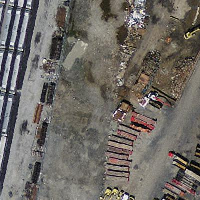 mass_stm original | 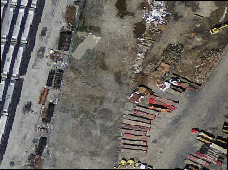 Après transformation en WGS84 long lat (wgs_84) | 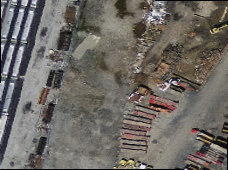 Après transformation en WGS84 long lat avec interpolation bilinéaire au lieu de NN par défaut (wgs_84_bilin) |
Exemples : Variante 3
L'exemple suivant montre la différence entre ST_Transform(raster, srid) et ST_Transform(raster, alignto)
WITH foo AS (
SELECT 0 AS rid, ST_AddBand(ST_MakeEmptyRaster(2, 2, -500000, 600000, 100, -100, 0, 0, 2163), 1, '16BUI', 1, 0) AS rast UNION ALL
SELECT 1, ST_AddBand(ST_MakeEmptyRaster(2, 2, -499800, 600000, 100, -100, 0, 0, 2163), 1, '16BUI', 2, 0) AS rast UNION ALL
SELECT 2, ST_AddBand(ST_MakeEmptyRaster(2, 2, -499600, 600000, 100, -100, 0, 0, 2163), 1, '16BUI', 3, 0) AS rast UNION ALL
SELECT 3, ST_AddBand(ST_MakeEmptyRaster(2, 2, -500000, 599800, 100, -100, 0, 0, 2163), 1, '16BUI', 10, 0) AS rast UNION ALL
SELECT 4, ST_AddBand(ST_MakeEmptyRaster(2, 2, -499800, 599800, 100, -100, 0, 0, 2163), 1, '16BUI', 20, 0) AS rast UNION ALL
SELECT 5, ST_AddBand(ST_MakeEmptyRaster(2, 2, -499600, 599800, 100, -100, 0, 0, 2163), 1, '16BUI', 30, 0) AS rast UNION ALL
SELECT 6, ST_AddBand(ST_MakeEmptyRaster(2, 2, -500000, 599600, 100, -100, 0, 0, 2163), 1, '16BUI', 100, 0) AS rast UNION ALL
SELECT 7, ST_AddBand(ST_MakeEmptyRaster(2, 2, -499800, 599600, 100, -100, 0, 0, 2163), 1, '16BUI', 200, 0) AS rast UNION ALL
SELECT 8, ST_AddBand(ST_MakeEmptyRaster(2, 2, -499600, 599600, 100, -100, 0, 0, 2163), 1, '16BUI', 300, 0) AS rast
), bar AS (
SELECT
ST_Transform(rast, 4269) AS alignto
FROM foo
LIMIT 1
), baz AS (
SELECT
rid,
rast,
ST_Transform(rast, 4269) AS not_aligned,
ST_Transform(rast, alignto) AS aligned
FROM foo
CROSS JOIN bar
)
SELECT
ST_SameAlignment(rast) AS rast,
ST_SameAlignment(not_aligned) AS not_aligned,
ST_SameAlignment(aligned) AS aligned
FROM baz
rast | not_aligned | aligned
------+-------------+---------
t | f | t
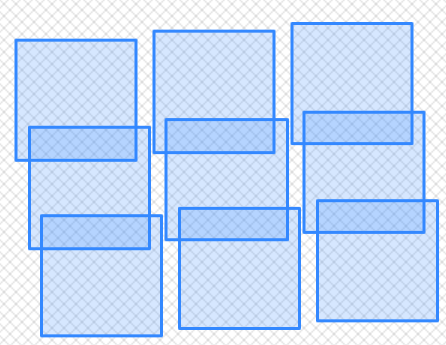 Non aligné (not_aligned)
| 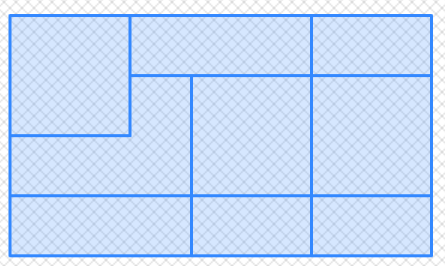 Aligné (aligned)
|
Voir aussi
11.8. Éditeurs de bandes raster
- ST_SetBandNoDataValue — Définit la valeur pour l'absence de données (nodata) pour la bande spécifiée. Si aucune bande n'est spécifiée, la bande 1 est utilisée. Pour indiquer qu'une bande n'a pas de valeur nodata, définir la valeur nodata = NULL.
- ST_SetBandIsNoData — Définit la valeur du flag isnodata de la bande à TRUE.
- ST_SetBandPath — Met à jour le chemin externe et le numéro de bande d'une bande out-db
- ST_SetBandIndex — Met à jour le numéro de bande externe d'une bande out-db
Name
ST_SetBandNoDataValue — Définit la valeur pour l'absence de données (nodata) pour la bande spécifiée. Si aucune bande n'est spécifiée, la bande 1 est utilisée. Pour indiquer qu'une bande n'a pas de valeur nodata, définir la valeur nodata = NULL.
Synopsis
raster ST_SetBandNoDataValue(raster rast, double precision nodatavalue);
raster ST_SetBandNoDataValue(raster rast, integer band, double precision nodatavalue, boolean forcechecking=false);
Description
Définit la valeur pour l'absence de données (nodata) pour la bande spécifiée. Si aucune bande n'est spécifiée, la bande 1 est utilisée. Cette valeur affecte les résultats de ST_Polygon, ST_DumpAsPolygons, ainsi que les fonctions ST_PixelAs...().
Exemples
-- change just first band no data value
UPDATE dummy_rast
SET rast = ST_SetBandNoDataValue(rast,1, 254)
WHERE rid = 2;
-- change no data band value of bands 1,2,3
UPDATE dummy_rast
SET rast =
ST_SetBandNoDataValue(
ST_SetBandNoDataValue(
ST_SetBandNoDataValue(
rast,1, 254)
,2,99),
3,108)
WHERE rid = 2;
-- wipe out the nodata value this will ensure all pixels are considered for all processing functions
UPDATE dummy_rast
SET rast = ST_SetBandNoDataValue(rast,1, NULL)
WHERE rid = 2;
Voir aussi
Name
ST_SetBandIsNoData — Définit la valeur du flag isnodata de la bande à TRUE.
Synopsis
raster ST_SetBandIsNoData(raster rast, integer band=1);
Description
Définit la valeur du flag isnodata de la bande à TRUE. Si aucune bande n'est spécifiée, la bande 1 est utilisée. Cette fonction ne devrait être appelée que si le flag est considéré comme obsolète, i.e. si le résultat de ST_BandIsNoData est différent selon qu'on utilise TRUE comme dernier argument ou non
Disponibilité : 2.0.0
Exemples
-- Create dummy table with one raster column
create table dummy_rast (rid integer, rast raster);
-- Add raster with two bands, one pixel/band. In the first band, nodatavalue = pixel value = 3.
-- In the second band, nodatavalue = 13, pixel value = 4
insert into dummy_rast values(1,
(
'01' -- little endian (uint8 ndr)
||
'0000' -- version (uint16 0)
||
'0200' -- nBands (uint16 0)
||
'17263529ED684A3F' -- scaleX (float64 0.000805965234044584)
||
'F9253529ED684ABF' -- scaleY (float64 -0.00080596523404458)
||
'1C9F33CE69E352C0' -- ipX (float64 -75.5533328537098)
||
'718F0E9A27A44840' -- ipY (float64 49.2824585505576)
||
'ED50EB853EC32B3F' -- skewX (float64 0.000211812383858707)
||
'7550EB853EC32B3F' -- skewY (float64 0.000211812383858704)
||
'E6100000' -- SRID (int32 4326)
||
'0100' -- width (uint16 1)
||
'0100' -- height (uint16 1)
||
'4' -- hasnodatavalue set to true, isnodata value set to false (when it should be true)
||
'2' -- first band type (4BUI)
||
'03' -- novalue==3
||
'03' -- pixel(0,0)==3 (same that nodata)
||
'0' -- hasnodatavalue set to false
||
'5' -- second band type (16BSI)
||
'0D00' -- novalue==13
||
'0400' -- pixel(0,0)==4
)::raster
);
select st_bandisnodata(rast, 1) from dummy_rast where rid = 1; -- Expected false
select st_bandisnodata(rast, 1, TRUE) from dummy_rast where rid = 1; -- Expected true
-- The isnodata flag is dirty. We are going to set it to true
update dummy_rast set rast = st_setbandisnodata(rast, 1) where rid = 1;
select st_bandisnodata(rast, 1) from dummy_rast where rid = 1; -- Expected true
Name
ST_SetBandPath — Met à jour le chemin externe et le numéro de bande d'une bande out-db
Synopsis
raster ST_SetBandPath(raster rast, integer band, text outdbpath, integer outdbindex, boolean force=false);
Description
Met à jour le chemin externe et le numéro de bande d'une bande externe out-db.
![[Note]](images/note.png) | |
Si |
Disponibilité : 2.5.0
Exemples
WITH foo AS (
SELECT
ST_AddBand(NULL::raster, '/home/pele/devel/geo/postgis-git/raster/test/regress/loader/Projected.tif', NULL::int[]) AS rast
)
SELECT
1 AS query,
*
FROM ST_BandMetadata(
(SELECT rast FROM foo),
ARRAY[1,3,2]::int[]
)
UNION ALL
SELECT
2,
*
FROM ST_BandMetadata(
(
SELECT
ST_SetBandPath(
rast,
2,
'/home/pele/devel/geo/postgis-git/raster/test/regress/loader/Projected2.tif',
1
) AS rast
FROM foo
),
ARRAY[1,3,2]::int[]
)
ORDER BY 1, 2;
query | bandnum | pixeltype | nodatavalue | isoutdb | path | outdbbandnum
-------+---------+-----------+-------------+---------+---------------------------------------------------------------------------------+--------------
1 | 1 | 8BUI | | t | /home/pele/devel/geo/postgis-git/raster/test/regress/loader/Projected.tif | 1
1 | 2 | 8BUI | | t | /home/pele/devel/geo/postgis-git/raster/test/regress/loader/Projected.tif | 2
1 | 3 | 8BUI | | t | /home/pele/devel/geo/postgis-git/raster/test/regress/loader/Projected.tif | 3
2 | 1 | 8BUI | | t | /home/pele/devel/geo/postgis-git/raster/test/regress/loader/Projected.tif | 1
2 | 2 | 8BUI | | t | /home/pele/devel/geo/postgis-git/raster/test/regress/loader/Projected2.tif | 1
2 | 3 | 8BUI | | t | /home/pele/devel/geo/postgis-git/raster/test/regress/loader/Projected.tif | 3
Voir aussi
Name
ST_SetBandIndex — Met à jour le numéro de bande externe d'une bande out-db
Synopsis
raster ST_SetBandIndex(raster rast, integer band, integer outdbindex, boolean force=false);
Description
Met à jour le numéro de bande externe d'une bande out-db. Cette opération n'affecte pas le fichier raster externe associé à la bande out-db
![[Note]](images/note.png) | |
Si |
![[Note]](images/note.png) | |
En interne, cette méthode remplacement la bande du raster PostGIS à l'index |
Disponibilité : 2.5.0
Exemples
WITH foo AS (
SELECT
ST_AddBand(NULL::raster, '/home/pele/devel/geo/postgis-git/raster/test/regress/loader/Projected.tif', NULL::int[]) AS rast
)
SELECT
1 AS query,
*
FROM ST_BandMetadata(
(SELECT rast FROM foo),
ARRAY[1,3,2]::int[]
)
UNION ALL
SELECT
2,
*
FROM ST_BandMetadata(
(
SELECT
ST_SetBandIndex(
rast,
2,
1
) AS rast
FROM foo
),
ARRAY[1,3,2]::int[]
)
ORDER BY 1, 2;
query | bandnum | pixeltype | nodatavalue | isoutdb | path | outdbbandnum
-------+---------+-----------+-------------+---------+---------------------------------------------------------------------------------+--------------
1 | 1 | 8BUI | | t | /home/pele/devel/geo/postgis-git/raster/test/regress/loader/Projected.tif | 1
1 | 2 | 8BUI | | t | /home/pele/devel/geo/postgis-git/raster/test/regress/loader/Projected.tif | 2
1 | 3 | 8BUI | | t | /home/pele/devel/geo/postgis-git/raster/test/regress/loader/Projected.tif | 3
2 | 1 | 8BUI | | t | /home/pele/devel/geo/postgis-git/raster/test/regress/loader/Projected.tif | 1
2 | 2 | 8BUI | | t | /home/pele/devel/geo/postgis-git/raster/test/regress/loader/Projected.tif | 1
2 | 3 | 8BUI | | t | /home/pele/devel/geo/postgis-git/raster/test/regress/loader/Projected.tif | 3
Voir aussi
11.9. Statistiques et analyses des bandes raster
- ST_Count — Renvoie le nombre de pixels dans une bande donnée d'un raster ou d'une couverture raster. Si aucune bande n'est spécifiée, la valeur par défaut est la bande 1. Si exclude_nodata_value est true, seuls les pixels dont la valeur est différente de la valeur nodata seront comptés.
- ST_CountAgg — Agrégat. Renvoie le nombre de pixels dans une bande donnée d'un ensemble de rasters. Si aucune bande n'est spécifiée, la valeur par défaut est la bande 1. Si exclude_nodata_value est true, seuls les pixels différents de la valeur NODATA seront comptés.
- ST_Histogram — Retourne un ensemble d'enregistrements résumant une distribution de données raster ou de couverture raster, dans des classes distinctes. Le nombre de classes est calculé automatiquement s'il n'est pas spécifié.
- ST_Quantile — Calcule les quantiles d'un raster ou d'une couverture raster, dans le contexte de l'échantillon ou de la population. Ainsi, une valeur peut être examinée pour se situer au percentile de 25%, 50% ou 75% du raster.
- ST_SummaryStats — Returns summarystats consisting of count, sum, mean, stddev, min, max for a given raster band of a raster or raster coverage. Band 1 is assumed if no band is specified.
- ST_SummaryStatsAgg — Aggregate. Returns summarystats consisting of count, sum, mean, stddev, min, max for a given raster band of a set of raster. Band 1 is assumed if no band is specified.
- ST_ValueCount — Retourne un ensemble d'enregistrements contenant une valeur de pixels et le nombre de pixels ayant cette valeur dans la bande du raster spécifié (ou de la couverture raster). Si aucune bande n'est spécifiée, la bande 1 est utilisée. Par défaut, les pixels de valeur nodata ne sont pas comptés, et toutes les autres valeurs sont retournées, avec leur valeur arrondies à l'entier le plus proche.
Name
ST_Count — Renvoie le nombre de pixels dans une bande donnée d'un raster ou d'une couverture raster. Si aucune bande n'est spécifiée, la valeur par défaut est la bande 1. Si exclude_nodata_value est true, seuls les pixels dont la valeur est différente de la valeur nodata seront comptés.
Synopsis
bigint ST_Count(raster rast, integer nband=1, boolean exclude_nodata_value=true);
bigint ST_Count(raster rast, boolean exclude_nodata_value);
Description
Renvoie le nombre de pixels dans une bande donnée d'un raster ou d'une couverture raster. Si aucune bande nband n'est spécifiée, la valeur par défaut est 1.
![[Note]](images/note.png) | |
Si |
Changement : 3.1.0 - Suppression des variantes ST_Count(rastertable, rastercolumn, ...). Utiliser ST_CountAgg à la place.
Disponibilité : 2.0.0
Exemples
--example will count all pixels not 249 and one will count all pixels. --
SELECT rid, ST_Count(ST_SetBandNoDataValue(rast,249)) As exclude_nodata,
ST_Count(ST_SetBandNoDataValue(rast,249),false) As include_nodata
FROM dummy_rast WHERE rid=2;
rid | exclude_nodata | include_nodata
-----+----------------+----------------
2 | 23 | 25
Voir aussi
Name
ST_CountAgg — Agrégat. Renvoie le nombre de pixels dans une bande donnée d'un ensemble de rasters. Si aucune bande n'est spécifiée, la valeur par défaut est la bande 1. Si exclude_nodata_value est true, seuls les pixels différents de la valeur NODATA seront comptés.
Synopsis
bigint ST_CountAgg(raster rast, integer nband, boolean exclude_nodata_value, double precision sample_percent);
bigint ST_CountAgg(raster rast, integer nband, boolean exclude_nodata_value);
bigint ST_CountAgg(raster rast, boolean exclude_nodata_value);
Description
Renvoie le nombre de pixels dans une bande donnée d'un ensemble de rasters. Si aucune bande nband n'est spécifiée, la valeur par défaut est 1.
Si exclude_nodata_value est true, seuls les pixels dont la valeur est différente de la valeur nodata du raster seront comptés. Définir exclude_nodata_value à false pour compter tous les pixels
Par défaut, tous les pixels sont échantillonnés. Pour obtenir une réponse plus rapide, définir sample_percent à une valeur comprise entre zéro (0) et un (1)
Disponibilité : 2.2.0
Exemples
WITH foo AS (
SELECT
rast.rast
FROM (
SELECT ST_SetValue(
ST_SetValue(
ST_SetValue(
ST_AddBand(
ST_MakeEmptyRaster(10, 10, 10, 10, 2, 2, 0, 0,0)
, 1, '64BF', 0, 0
)
, 1, 1, 1, -10
)
, 1, 5, 4, 0
)
, 1, 5, 5, 3.14159
) AS rast
) AS rast
FULL JOIN (
SELECT generate_series(1, 10) AS id
) AS id
ON 1 = 1
)
SELECT
ST_CountAgg(rast, 1, TRUE)
FROM foo;
st_countagg
-------------
20
(1 row)
Voir aussi
Name
ST_Histogram — Retourne un ensemble d'enregistrements résumant une distribution de données raster ou de couverture raster, dans des classes distinctes. Le nombre de classes est calculé automatiquement s'il n'est pas spécifié.
Synopsis
SETOF record ST_Histogram(raster rast, integer nband=1, boolean exclude_nodata_value=true, integer bins=autocomputed, double precision[] width=NULL, boolean right=false);
SETOF record ST_Histogram(raster rast, integer nband, integer bins, double precision[] width=NULL, boolean right=false);
SETOF record ST_Histogram(raster rast, integer nband, boolean exclude_nodata_value, integer bins, boolean right);
SETOF record ST_Histogram(raster rast, integer nband, integer bins, boolean right);
Description
Retourne un ensemble d'enregistrements composés de min, max, count, percent pour une bande raster donnée pour chaque classe. Si aucune bande nband n'est spécifiée, la bande 1 est utilisée.
![[Note]](images/note.png) | |
Par défaut, seules les valeurs de pixels différentes de la valeur |
widthwidth : un tableau indiquant la largeur de chaque classe. Si le nombre de classes est supérieur au nombre de largeurs, les largeurs sont répétées.
Exemple : 9 classes, les largeurs étant [a, b, c], le résultat sera [a, b, c, a, b, c, a, b, c]
binsNombre de classes -- c'est le nombre d'enregistrements retournés par la fonction si spécifié. Si non spécifié, le nombre de classes est calculé automatiquement.
rightcalcule l'histogramme à partir de la droite plutôt que de la gauche (par défaut). Cela modifie les critères d'évaluation d'une valeur x de [a, b) à (a, b]
Changement : 3.1.0 Suppression de la variante ST_Histogram(table_name, column_name).
Disponibilité : 2.0.0
Exemple : Une seule tuile raster - calcul des histogrames pour les bandes 1, 2, 3 avec calcul automatique des classes
SELECT band, (stats).*
FROM (SELECT rid, band, ST_Histogram(rast, band) As stats
FROM dummy_rast CROSS JOIN generate_series(1,3) As band
WHERE rid=2) As foo;
band | min | max | count | percent
------+-------+-------+-------+---------
1 | 249 | 250 | 2 | 0.08
1 | 250 | 251 | 2 | 0.08
1 | 251 | 252 | 1 | 0.04
1 | 252 | 253 | 2 | 0.08
1 | 253 | 254 | 18 | 0.72
2 | 78 | 113.2 | 11 | 0.44
2 | 113.2 | 148.4 | 4 | 0.16
2 | 148.4 | 183.6 | 4 | 0.16
2 | 183.6 | 218.8 | 1 | 0.04
2 | 218.8 | 254 | 5 | 0.2
3 | 62 | 100.4 | 11 | 0.44
3 | 100.4 | 138.8 | 5 | 0.2
3 | 138.8 | 177.2 | 4 | 0.16
3 | 177.2 | 215.6 | 1 | 0.04
3 | 215.6 | 254 | 4 | 0.16Exemple : Seulement la bande 2, mais avec 6 classes
SELECT (stats).*
FROM (SELECT rid, ST_Histogram(rast, 2,6) As stats
FROM dummy_rast
WHERE rid=2) As foo;
min | max | count | percent
------------+------------+-------+---------
78 | 107.333333 | 9 | 0.36
107.333333 | 136.666667 | 6 | 0.24
136.666667 | 166 | 0 | 0
166 | 195.333333 | 4 | 0.16
195.333333 | 224.666667 | 1 | 0.04
224.666667 | 254 | 5 | 0.2
(6 rows)
-- Same as previous but we explicitly control the pixel value range of each bin.
SELECT (stats).*
FROM (SELECT rid, ST_Histogram(rast, 2,6,ARRAY[0.5,1,4,100,5]) As stats
FROM dummy_rast
WHERE rid=2) As foo;
min | max | count | percent
-------+-------+-------+----------
78 | 78.5 | 1 | 0.08
78.5 | 79.5 | 1 | 0.04
79.5 | 83.5 | 0 | 0
83.5 | 183.5 | 17 | 0.0068
183.5 | 188.5 | 0 | 0
188.5 | 254 | 6 | 0.003664
(6 rows)Voir aussi
Name
ST_Quantile — Calcule les quantiles d'un raster ou d'une couverture raster, dans le contexte de l'échantillon ou de la population. Ainsi, une valeur peut être examinée pour se situer au percentile de 25%, 50% ou 75% du raster.
Synopsis
SETOF record ST_Quantile(raster rast, integer nband=1, boolean exclude_nodata_value=true, double precision[] quantiles=NULL);
SETOF record ST_Quantile(raster rast, double precision[] quantiles);
SETOF record ST_Quantile(raster rast, integer nband, double precision[] quantiles);
double precision ST_Quantile(raster rast, double precision quantile);
double precision ST_Quantile(raster rast, boolean exclude_nodata_value, double precision quantile=NULL);
double precision ST_Quantile(raster rast, integer nband, double precision quantile);
double precision ST_Quantile(raster rast, integer nband, boolean exclude_nodata_value, double precision quantile);
double precision ST_Quantile(raster rast, integer nband, double precision quantile);
Description
Calcule les quantiles d'un raster ou d'une couverture raster, dans le contexte de l'échantillon ou de la population. Ainsi, une valeur peut être examinée pour se situer au percentile de 25%, 50% ou 75% du raster.
![[Note]](images/note.png) | |
Si |
Changement : 3.1.0 Suppression de la variante ST_Quantile(table_name, column_name).
Disponibilité : 2.0.0
Exemples
UPDATE dummy_rast SET rast = ST_SetBandNoDataValue(rast,249) WHERE rid=2;
--Example will consider only pixels of band 1 that are not 249 and in named quantiles --
SELECT (pvq).*
FROM (SELECT ST_Quantile(rast, ARRAY[0.25,0.75]) As pvq
FROM dummy_rast WHERE rid=2) As foo
ORDER BY (pvq).quantile;
quantile | value
----------+-------
0.25 | 253
0.75 | 254
SELECT ST_Quantile(rast, 0.75) As value
FROM dummy_rast WHERE rid=2;
value
------
254
--real live example. Quantile of all pixels in band 2 intersecting a geometry
SELECT rid, (ST_Quantile(rast,2)).* As pvc
FROM o_4_boston
WHERE ST_Intersects(rast,
ST_GeomFromText('POLYGON((224486 892151,224486 892200,224706 892200,224706 892151,224486 892151))',26986)
)
ORDER BY value, quantile,rid
;
rid | quantile | value
-----+----------+-------
1 | 0 | 0
2 | 0 | 0
14 | 0 | 1
15 | 0 | 2
14 | 0.25 | 37
1 | 0.25 | 42
15 | 0.25 | 47
2 | 0.25 | 50
14 | 0.5 | 56
1 | 0.5 | 64
15 | 0.5 | 66
2 | 0.5 | 77
14 | 0.75 | 81
15 | 0.75 | 87
1 | 0.75 | 94
2 | 0.75 | 106
14 | 1 | 199
1 | 1 | 244
2 | 1 | 255
15 | 1 | 255
Voir aussi
ST_Count, ST_SummaryStats, ST_SummaryStatsAgg, ST_SetBandNoDataValue
Name
ST_SummaryStats — Returns summarystats consisting of count, sum, mean, stddev, min, max for a given raster band of a raster or raster coverage. Band 1 is assumed if no band is specified.
Synopsis
summarystats ST_SummaryStats(raster rast, boolean exclude_nodata_value);
summarystats ST_SummaryStats(raster rast, integer nband, boolean exclude_nodata_value);
Description
Retourne un résumé statistique summarystats composé de count, sum, mean, stddev, min, max pour une bande raster ou une couverture raster spécifiée. Si aucune bande nband n'est spécifiée, la bande 1 est utilisée.
![[Note]](images/note.png) | |
Par défaut, seules les valeurs de pixels différentes de la valeur |
![[Note]](images/note.png) | |
Par défaut, tous les pixels sont échantillonnés. Pour obtenir une réponse plus rapide, définir |
Changement : 3.1.0 Suppression des variantes ST_SummaryStats(rastertable, rastercolumn, ...). Utiliser ST_SummaryStatsAgg à la place.
Disponibilité : 2.0.0
Exemple : Une seule tuile raster
SELECT rid, band, (stats).*
FROM (SELECT rid, band, ST_SummaryStats(rast, band) As stats
FROM dummy_rast CROSS JOIN generate_series(1,3) As band
WHERE rid=2) As foo;
rid | band | count | sum | mean | stddev | min | max
-----+------+-------+------+------------+-----------+-----+-----
2 | 1 | 23 | 5821 | 253.086957 | 1.248061 | 250 | 254
2 | 2 | 25 | 3682 | 147.28 | 59.862188 | 78 | 254
2 | 3 | 25 | 3290 | 131.6 | 61.647384 | 62 | 254
Exemple : Statistiques des pixels qui intersectent des bâtiments d'intérêt
Cet exemple a pris 574 ms sur PostGIS Windows 64-bit avec tous les bâtiments de Boston et les tuiles aériennes (tuiles de 150x150 pixels chacune ~ 134 000 tuiles), ~102 000 enregistrements de bâtiments
WITH
-- our features of interest
feat AS (SELECT gid As building_id, geom_26986 As geom FROM buildings AS b
WHERE gid IN(100, 103,150)
),
-- clip band 2 of raster tiles to boundaries of builds
-- then get stats for these clipped regions
b_stats AS
(SELECT building_id, (stats).*
FROM (SELECT building_id, ST_SummaryStats(ST_Clip(rast,2,geom)) As stats
FROM aerials.boston
INNER JOIN feat
ON ST_Intersects(feat.geom,rast)
) As foo
)
-- finally summarize stats
SELECT building_id, SUM(count) As num_pixels
, MIN(min) As min_pval
, MAX(max) As max_pval
, SUM(mean*count)/SUM(count) As avg_pval
FROM b_stats
WHERE count
> 0
GROUP BY building_id
ORDER BY building_id;
building_id | num_pixels | min_pval | max_pval | avg_pval
-------------+------------+----------+----------+------------------
100 | 1090 | 1 | 255 | 61.0697247706422
103 | 655 | 7 | 182 | 70.5038167938931
150 | 895 | 2 | 252 | 185.642458100559
Exemple : Couverture raster
-- stats for each band --
SELECT band, (stats).*
FROM (SELECT band, ST_SummaryStats('o_4_boston','rast', band) As stats
FROM generate_series(1,3) As band) As foo;
band | count | sum | mean | stddev | min | max
------+---------+--------+------------------+------------------+-----+-----
1 | 8450000 | 725799 | 82.7064349112426 | 45.6800222638537 | 0 | 255
2 | 8450000 | 700487 | 81.4197705325444 | 44.2161184161765 | 0 | 255
3 | 8450000 | 575943 | 74.682739408284 | 44.2143885481407 | 0 | 255
-- For a table -- will get better speed if set sampling to less than 100%
-- Here we set to 25% and get a much faster answer
SELECT band, (stats).*
FROM (SELECT band, ST_SummaryStats('o_4_boston','rast', band,true,0.25) As stats
FROM generate_series(1,3) As band) As foo;
band | count | sum | mean | stddev | min | max
------+---------+--------+------------------+------------------+-----+-----
1 | 2112500 | 180686 | 82.6890480473373 | 45.6961043857248 | 0 | 255
2 | 2112500 | 174571 | 81.448503668639 | 44.2252623171821 | 0 | 255
3 | 2112500 | 144364 | 74.6765884023669 | 44.2014869384578 | 0 | 255
Voir aussi
Name
ST_SummaryStatsAgg — Aggregate. Returns summarystats consisting of count, sum, mean, stddev, min, max for a given raster band of a set of raster. Band 1 is assumed if no band is specified.
Synopsis
summarystats ST_SummaryStatsAgg(raster rast, integer nband, boolean exclude_nodata_value, double precision sample_percent);
summarystats ST_SummaryStatsAgg(raster rast, boolean exclude_nodata_value, double precision sample_percent);
summarystats ST_SummaryStatsAgg(raster rast, integer nband, boolean exclude_nodata_value);
Description
Retourne un résumé statistique summarystats composé de count, sum, mean, stddev, min, max pour une bande raster ou une couverture raster spécifiée. Si aucune bande nband n'est spécifiée, la bande 1 est utilisée.
![[Note]](images/note.png) | |
Par défaut, seules les valeurs de pixels différentes de la valeur |
![[Note]](images/note.png) | |
Par défaut, tous les pixels sont échantillonnés. Pour obtenir une réponse plus rapide, définir |
Disponibilité : 2.2.0
Exemples
WITH foo AS (
SELECT
rast.rast
FROM (
SELECT ST_SetValue(
ST_SetValue(
ST_SetValue(
ST_AddBand(
ST_MakeEmptyRaster(10, 10, 10, 10, 2, 2, 0, 0,0)
, 1, '64BF', 0, 0
)
, 1, 1, 1, -10
)
, 1, 5, 4, 0
)
, 1, 5, 5, 3.14159
) AS rast
) AS rast
FULL JOIN (
SELECT generate_series(1, 10) AS id
) AS id
ON 1 = 1
)
SELECT
(stats).count,
round((stats).sum::numeric, 3),
round((stats).mean::numeric, 3),
round((stats).stddev::numeric, 3),
round((stats).min::numeric, 3),
round((stats).max::numeric, 3)
FROM (
SELECT
ST_SummaryStatsAgg(rast, 1, TRUE, 1) AS stats
FROM foo
) bar;
count | round | round | round | round | round
-------+---------+--------+-------+---------+-------
20 | -68.584 | -3.429 | 6.571 | -10.000 | 3.142
(1 row)
Voir aussi
Name
ST_ValueCount — Retourne un ensemble d'enregistrements contenant une valeur de pixels et le nombre de pixels ayant cette valeur dans la bande du raster spécifié (ou de la couverture raster). Si aucune bande n'est spécifiée, la bande 1 est utilisée. Par défaut, les pixels de valeur nodata ne sont pas comptés, et toutes les autres valeurs sont retournées, avec leur valeur arrondies à l'entier le plus proche.
Synopsis
SETOF record ST_ValueCount(raster rast, integer nband=1, boolean exclude_nodata_value=true, double precision[] searchvalues=NULL, double precision roundto=0, double precision OUT value, integer OUT count);
SETOF record ST_ValueCount(raster rast, integer nband, double precision[] searchvalues, double precision roundto=0, double precision OUT value, integer OUT count);
SETOF record ST_ValueCount(raster rast, double precision[] searchvalues, double precision roundto=0, double precision OUT value, integer OUT count);
bigint ST_ValueCount(raster rast, double precision searchvalue, double precision roundto=0);
bigint ST_ValueCount(raster rast, integer nband, boolean exclude_nodata_value, double precision searchvalue, double precision roundto=0);
bigint ST_ValueCount(raster rast, integer nband, double precision searchvalue, double precision roundto=0);
SETOF record ST_ValueCount(text rastertable, text rastercolumn, integer nband=1, boolean exclude_nodata_value=true, double precision[] searchvalues=NULL, double precision roundto=0, double precision OUT value, integer OUT count);
SETOF record ST_ValueCount(text rastertable, text rastercolumn, double precision[] searchvalues, double precision roundto=0, double precision OUT value, integer OUT count);
SETOF record ST_ValueCount(text rastertable, text rastercolumn, integer nband, double precision[] searchvalues, double precision roundto=0, double precision OUT value, integer OUT count);
bigintST_ValueCount(text rastertable, text rastercolumn, integer nband, boolean exclude_nodata_value, double precision searchvalue, double precision roundto=0);
bigint ST_ValueCount(text rastertable, text rastercolumn, double precision searchvalue, double precision roundto=0);
bigint ST_ValueCount(text rastertable, text rastercolumn, integer nband, double precision searchvalue, double precision roundto=0);
Description
Retourne un ensemble d'enregistrements contenant les colonnes value count, correspondant à la valeur de pixel dans la bande et le nombre de pixels ayant cette valeur dans la bande du raster spécifié (ou de la couverture raster).
Si aucune bande nband n'est spécifiée, la bande 1 est utilisée. Si aucune valeur searchvalues n'est spécifiée, retourne toutes les valeurs de pixel trouvées dans le raster ou dans la couverture raster. Si une valeur searchvalue est spécifiée, retourne un entier au lieu d'enregistrements, correspondant au nombre de pixels ayant la valeur recherchée
![[Note]](images/note.png) | |
Si |
Disponibilité : 2.0.0
Exemples
UPDATE dummy_rast SET rast = ST_SetBandNoDataValue(rast,249) WHERE rid=2;
--Example will count only pixels of band 1 that are not 249. --
SELECT (pvc).*
FROM (SELECT ST_ValueCount(rast) As pvc
FROM dummy_rast WHERE rid=2) As foo
ORDER BY (pvc).value;
value | count
-------+-------
250 | 2
251 | 1
252 | 2
253 | 6
254 | 12
-- Example will coount all pixels of band 1 including 249 --
SELECT (pvc).*
FROM (SELECT ST_ValueCount(rast,1,false) As pvc
FROM dummy_rast WHERE rid=2) As foo
ORDER BY (pvc).value;
value | count
-------+-------
249 | 2
250 | 2
251 | 1
252 | 2
253 | 6
254 | 12
-- Example will count only non-nodata value pixels of band 2
SELECT (pvc).*
FROM (SELECT ST_ValueCount(rast,2) As pvc
FROM dummy_rast WHERE rid=2) As foo
ORDER BY (pvc).value;
value | count
-------+-------
78 | 1
79 | 1
88 | 1
89 | 1
96 | 1
97 | 1
98 | 1
99 | 2
112 | 2
:
--real live example. Count all the pixels in an aerial raster tile band 2 intersecting a geometry
-- and return only the pixel band values that have a count > 500
SELECT (pvc).value, SUM((pvc).count) As total
FROM (SELECT ST_ValueCount(rast,2) As pvc
FROM o_4_boston
WHERE ST_Intersects(rast,
ST_GeomFromText('POLYGON((224486 892151,224486 892200,224706 892200,224706 892151,224486 892151))',26986)
)
) As foo
GROUP BY (pvc).value
HAVING SUM((pvc).count) > 500
ORDER BY (pvc).value;
value | total
-------+-----
51 | 502
54 | 521
-- Just return count of pixels in each raster tile that have value of 100 of tiles that intersect a specific geometry --
SELECT rid, ST_ValueCount(rast,2,100) As count
FROM o_4_boston
WHERE ST_Intersects(rast,
ST_GeomFromText('POLYGON((224486 892151,224486 892200,224706 892200,224706 892151,224486 892151))',26986)
) ;
rid | count
-----+-------
1 | 56
2 | 95
14 | 37
15 | 64
Voir aussi
11.10. Import de raster
- ST_RastFromWKB — Retourne un raster à partir d'un raster Well-Known Binary (WKB).
- ST_RastFromHexWKB — Retourne un raster à partir d'un raster Well-Known Binary (WKB) en hexadécimal.
Name
ST_RastFromWKB — Retourne un raster à partir d'un raster Well-Known Binary (WKB).
Synopsis
raster ST_RastFromWKB(bytea wkb);
Description
Construit un raster PostGIS à partir d'une représentation raster Well-Known Binary (WKB).
Disponibilité : 2.5.0
Exemples
SELECT (ST_Metadata(
ST_RastFromWKB(
'\001\000\000\000\000\000\000\000\000\000\000\000@\000\000\000\000\000\000\010@\000\000\000\000\000\000\340?\000\000\000\000\000\000\340?\000\000\000\000\000\000\000\000\000\000\000\000\000\000\000\000\012\000\000\000\012\000\024\000'::bytea
)
)).* AS metadata;
upperleftx | upperlefty | width | height | scalex | scaley | skewx | skewy | srid | numbands
------------+------------+-------+--------+--------+--------+-------+-------+------+----------
0.5 | 0.5 | 10 | 20 | 2 | 3 | 0 | 0 | 10 | 0
Voir aussi
ST_MetaData, ST_RastFromHexWKB, ST_AsBinary/ST_AsWKB, ST_AsHexWKB
Name
ST_RastFromHexWKB — Retourne un raster à partir d'un raster Well-Known Binary (WKB) en hexadécimal.
Synopsis
raster ST_RastFromHexWKB(text wkb);
Description
Construit un raster PostGIS à partir d'une représentation hexadécimale raster Well-Known Binary (WKB).
Disponibilité : 2.5.0
Exemples
SELECT (ST_Metadata(
ST_RastFromHexWKB(
'010000000000000000000000400000000000000840000000000000E03F000000000000E03F000000000000000000000000000000000A0000000A001400'
)
)).* AS metadata;
upperleftx | upperlefty | width | height | scalex | scaley | skewx | skewy | srid | numbands
------------+------------+-------+--------+--------+--------+-------+-------+------+----------
0.5 | 0.5 | 10 | 20 | 2 | 3 | 0 | 0 | 10 | 0
Voir aussi
ST_MetaData, ST_RastFromWKB, ST_AsBinary/ST_AsWKB, ST_AsHexWKB
11.11. Export de raster
- ST_AsBinary/ST_AsWKB — Retourne la représentation Well-Known Binary (WKB) de ce raster.
- ST_AsHexWKB — Retourne la représentation hexadécimale Well-Known Binary (WKB) de ce raster.
- ST_AsGDALRaster — Retourne la tuile raster dans le format GDAL raster spécifié. Les formats raster disponibles sont ceux supportés par votre bibliothèque compilée. Utilisez ST_GDALDrivers() pour obtenir la liste des formats supportés par votre bibliothèque.
- ST_AsJPEG — Retourne les bandes sélectionnées du raster sous la forme d'une image JPEG (sous forme de tableau d'octets). Si aucune bande n'est spécifiée, et que le raster a 1 ou plus de 3 bandes, seule la première bande est utilisée. Si le raster a exactement 3 bandes, les 3 bandes sont utilisées et mappées en RGB.
- ST_AsPNG — Retourne les bandes sélectionnées du raster sous la forme d'une image PNG (sous forme de tableau d'octets). Si aucune bande n'est spécifiée et que le raster a 1, 3 ou 4 bandes, toutes les bandes sont utilisées. Si aucune bande n'est spécifiée et que le raster a 2 ou plus de 4 bandes, seule la bande 1 est utilisée. Les bandes sont mappées en RGB ou RGBA.
- ST_AsTIFF — Retourne les bandes sélectionnées du raster sous la forme d'une seule image TIFF (sous forme de tableau d'octets). Si aucune bande n'est spécifiée ou si l'une des bandes spécifiées n'existe pas dans le raster, toutes les bandes sont utilisées.
Name
ST_AsBinary/ST_AsWKB — Retourne la représentation Well-Known Binary (WKB) de ce raster.
Synopsis
bytea ST_AsBinary(raster rast, boolean outasin=FALSE);
bytea ST_AsWKB(raster rast, boolean outasin=FALSE);
Description
Retourne la représentation binaire du raster. Si outasin est TRUE, les bandes out-db sont traitées comme in-db. Voir raster/doc/RFC2-WellKnownBinaryFormat situé dans le dossier source de PostGIS pour plus de détails sur la représentation.
Cette fonction est utile dans les curseurs binaires pour extraire des données de la base de données sans les convertir en une représentation sous forme de chaîne de caractères.
![[Note]](images/note.png) | |
Par défaut, la sortie WKB contient le chemin d'accès au fichier externe pour les bandes out-db. Si le client n'a pas accès au fichier raster sous-jacent d'une bande out-db, définir |
Amélioration : 2.1.0 Ajout de outasin
Amélioration : 2.5.0 Ajout de ST_AsWKB
Exemples
SELECT ST_AsBinary(rast) As rastbin FROM dummy_rast WHERE rid=1;
rastbin
---------------------------------------------------------------------------------
\001\000\000\000\000\000\000\000\000\000\000\000@\000\000\000\000\000\000\010@\000\000\000\000\000\000\340?\000\000\000\000\000\000\340?\000\000\000\000\000\000\000\000\000\000\000\000\000\000\000\000\012\000\000\000\012\000\024\000
Voir aussi
Name
ST_AsHexWKB — Retourne la représentation hexadécimale Well-Known Binary (WKB) de ce raster.
Synopsis
bytea ST_AsHexWKB(raster rast, boolean outasin=FALSE);
Description
Retourne la représentation binaire en hexadécimal du raster. Si outasin est TRUE, les bandes out-db sont traitées comme in-db. Voir raster/doc/RFC2-WellKnownBinaryFormat situé dans le dossier source de PostGIS pour les détails de la représentation.
![[Note]](images/note.png) | |
Par défaut, la sortie Hex WKB contient le chemin d'accès au fichier externe pour les bandes out-db. Si le client n'a pas accès au fichier raster sous-jacent de la bande out-db, définir |
Disponibilité : 2.5.0
Exemples
SELECT ST_AsHexWKB(rast) As rastbin FROM dummy_rast WHERE rid=1;
st_ashexwkb
----------------------------------------------------------------------------------------------------------------------------
010000000000000000000000400000000000000840000000000000E03F000000000000E03F000000000000000000000000000000000A0000000A001400
Voir aussi
Name
ST_AsGDALRaster — Retourne la tuile raster dans le format GDAL raster spécifié. Les formats raster disponibles sont ceux supportés par votre bibliothèque compilée. Utilisez ST_GDALDrivers() pour obtenir la liste des formats supportés par votre bibliothèque.
Synopsis
bytea ST_AsGDALRaster(raster rast, text format, text[] options=NULL, integer srid=sameassource);
Description
Retourne la tuile raster dans le format spécifié. Les paramètres sont détaillés ci-dessous :
formatformat de sortie. Cela dépend des drivers compilés dans votre bibliothèque libgdal. Les formats généralement disponibles sont 'JPEG', 'GTIff', 'PNG'. Utilisez ST_GDALDrivers pour obtenir une liste des formats pris en charge par votre bibliothèque.optionstableau textuel d'options GDAL. Les options valides dépendent du format. Pour plus de détails, voir GDAL Raster format options.srsLa chaîne proj4text ou srtext (issue de spatial_ref_sys) à incorporer dans l'image
Disponibilité : 2.0.0 - nécessite GDAL >= 1.6.0.
Exemple de sortie JPEG, plusieurs tuiles en un seul raster
SELECT ST_AsGDALRaster(ST_Union(rast), 'JPEG', ARRAY['QUALITY=50']) As rastjpg FROM dummy_rast WHERE rast && ST_MakeEnvelope(10, 10, 11, 11);
Utilisation de PostgreSQL Large Object Support pour exporter des données raster
Une façon d'exporter des données raster vers un autre format est d'utiliser les fonctions d'exportation de grands objets de PostgreSQL. Nous allons reprendre l'exemple précédent en ajoutant l'export. Notez que vous devrez avoir un accès super utilisateur à la base de données car elle utilise les fonctions lo côté serveur. L'exportation se fera également vers un chemin d'accès sur le réseau du serveur. Si vous avez besoin d'exporter localement, utilisez les fonctions lo_ équivalentes de psql qui exportent vers le système de fichiers local au lieu du système de fichiers du serveur.
DROP TABLE IF EXISTS tmp_out ;
CREATE TABLE tmp_out AS
SELECT lo_from_bytea(0,
ST_AsGDALRaster(ST_Union(rast), 'JPEG', ARRAY['QUALITY=50'])
) AS loid
FROM dummy_rast
WHERE rast && ST_MakeEnvelope(10, 10, 11, 11);
SELECT lo_export(loid, '/tmp/dummy.jpg')
FROM tmp_out;
SELECT lo_unlink(loid)
FROM tmp_out;
Exemples de sorties GTIFF
SELECT ST_AsGDALRaster(rast, 'GTiff') As rastjpg
FROM dummy_rast WHERE rid=2;
-- Out GeoTiff with jpeg compression, 90% quality
SELECT ST_AsGDALRaster(rast, 'GTiff',
ARRAY['COMPRESS=JPEG', 'JPEG_QUALITY=90'],
4269) As rasttiff
FROM dummy_rast WHERE rid=2;
Name
ST_AsJPEG — Retourne les bandes sélectionnées du raster sous la forme d'une image JPEG (sous forme de tableau d'octets). Si aucune bande n'est spécifiée, et que le raster a 1 ou plus de 3 bandes, seule la première bande est utilisée. Si le raster a exactement 3 bandes, les 3 bandes sont utilisées et mappées en RGB.
Synopsis
bytea ST_AsJPEG(raster rast, text[] options=NULL);
bytea ST_AsJPEG(raster rast, integer nband, integer quality);
bytea ST_AsJPEG(raster rast, integer nband, text[] options=NULL);
bytea ST_AsJPEG(raster rast, integer[] nbands, text[] options=NULL);
bytea ST_AsJPEG(raster rast, integer[] nbands, integer quality);
Description
Retourne les bandes sélectionnées du raster sous la forme d'une seule image JPEG (Joint Photographic Exports Group Image). Utilisez ST_AsGDALRaster si vous avez besoin d'exporter vers des types de raster moins courants. Si aucune bande n'est spécifiée, et que le raster a 1 ou plus de 3 bandes, seule la première bande est utilisée. Si le raster a exactement 3 bandes, les 3 bandes sont utilisées. Il existe de nombreuses variantes de la fonction avec de nombreuses options. Celles-ci sont détaillées ci-dessous :
nbandpour exporter une seule bande.nbandsspécifie un tableau des bandes à exporter (à noter que JPEG ne supporte que 3 bandes aux maximum). L'ordre des bandes est RGB. Par exemple, ARRAY[3,2,1] signifie que la bande 3 est la rouge, la bande 2 est la verte et la bande 1 est la bleuequalitynombre de 0 à 100. Plus le chiffre est élevé, plus l'image est nette.optionstableau textuel d'options GDAL, parmi les options définies pour JPEG (voir create_options pour JPEG de ST_GDALDrivers). Pour JPEG, les options disponibles sontPROGRESSIVEON ou OFF etQUALITYune valeur de 0 à 100 et par défaut 75. Voir GDAL Raster format options pour plus de détails.
Disponibilité : 2.0.0 - nécessite GDAL >= 1.6.0.
Exemples : Export
-- output first 3 bands 75% quality
SELECT ST_AsJPEG(rast) As rastjpg
FROM dummy_rast WHERE rid=2;
-- output only first band as 90% quality
SELECT ST_AsJPEG(rast,1,90) As rastjpg
FROM dummy_rast WHERE rid=2;
-- output first 3 bands (but make band 2 Red, band 1 green, and band 3 blue, progressive and 90% quality
SELECT ST_AsJPEG(rast,ARRAY[2,1,3],ARRAY['QUALITY=90','PROGRESSIVE=ON']) As rastjpg
FROM dummy_rast WHERE rid=2;Name
ST_AsPNG — Retourne les bandes sélectionnées du raster sous la forme d'une image PNG (sous forme de tableau d'octets). Si aucune bande n'est spécifiée et que le raster a 1, 3 ou 4 bandes, toutes les bandes sont utilisées. Si aucune bande n'est spécifiée et que le raster a 2 ou plus de 4 bandes, seule la bande 1 est utilisée. Les bandes sont mappées en RGB ou RGBA.
Synopsis
bytea ST_AsPNG(raster rast, text[] options=NULL);
bytea ST_AsPNG(raster rast, integer nband, integer compression);
bytea ST_AsPNG(raster rast, integer nband, text[] options=NULL);
bytea ST_AsPNG(raster rast, integer[] nbands, integer compression);
bytea ST_AsPNG(raster rast, integer[] nbands, text[] options=NULL);
Description
Retourne les bandes sélectionnées du raster sous la forme d'une seule PNG (image graphique portable). Utilisez ST_AsGDALRaster si vous avez besoin d'exporter vers des types de raster moins courants. Si aucune bande n'est spécifiée, les 3 premières bandes sont exportées. Il existe de nombreuses variantes de cette fonction avec de nombreuses options. Si aucun srid n'est spécifié, c'est le srid du raster qui est utilisé. Ces options sont détaillées ci-dessous :
nbandpour exporter une seule bande.nbandsspécifie un tableau des bandes à exporter (à noter que PNG ne supporte que 4 bandes aux maximum). L'ordre des bandes est RGBA. Par exemple, ARRAY[3,2,1] signifie que la bande 3 est la rouge, la bande 2 est la verte et la bande 1 est la bleuecompressionnombre de 1 à 9. Plus le chiffre est élevé, plus la compression est importante.optionstableau textuel d'options GDAL, parmi les options définies pour PNG (voir create_options pour PNG de ST_GDALDrivers). Pour PNG, seule l'option ZLEVEL est valide (temps à consacrer à la compression -- par défaut 6), par exemple ARRAY['ZLEVEL=9']. WORLDFILE n'est pas autorisé car la fonction devrait produire deux sorties. Voir GDAL Raster format options pour plus de détails.
Disponibilité : 2.0.0 - nécessite GDAL >= 1.6.0.
Exemples
SELECT ST_AsPNG(rast) As rastpng
FROM dummy_rast WHERE rid=2;
-- export the first 3 bands and map band 3 to Red, band 1 to Green, band 2 to blue
SELECT ST_AsPNG(rast, ARRAY[3,1,2]) As rastpng
FROM dummy_rast WHERE rid=2;
Name
ST_AsTIFF — Retourne les bandes sélectionnées du raster sous la forme d'une seule image TIFF (sous forme de tableau d'octets). Si aucune bande n'est spécifiée ou si l'une des bandes spécifiées n'existe pas dans le raster, toutes les bandes sont utilisées.
Synopsis
bytea ST_AsTIFF(raster rast, text[] options='', integer srid=sameassource);
bytea ST_AsTIFF(raster rast, text compression='', integer srid=sameassource);
bytea ST_AsTIFF(raster rast, integer[] nbands, text compression='', integer srid=sameassource);
bytea ST_AsTIFF(raster rast, integer[] nbands, text[] options, integer srid=sameassource);
Description
Retourne les bandes sélectionnées du raster sous la forme d'un fichier TIFF (Tagged Image File Format). Si aucune bande n'est spécifiée, toutes les bandes seront utilisées. Cette fonction est une enveloppe autour de ST_AsGDALRaster. Utilisez ST_AsGDALRaster si vous avez besoin d'exporter vers des types de raster moins courants. Il existe de nombreuses variantes de la fonction avec de nombreuses options. Si aucun texte SRS de référence spatiale n'est présent, la référence spatiale du raster est utilisée. Ces options sont détaillées ci-dessous :
nbandsspécifie un tableau des bandes à exporter (à noter que PNG ne supporte que 3 bandes aux maximum). L'ordre des bandes est RGB. Par exemple, ARRAY[3,2,1] signifie que la bande 3 est la rouge, la bande 2 est la verte et la bande 1 est la bleuecompressionExpression de compression -- JPEG90 (ou un autre pourcentage), LZW, JPEG, DEFLATE9.optionstableau textuel d'options GDAL, parmi les options définies pour GTiff (voir create_options pour GTiff de ST_GDALDrivers). Voir GDAL Raster format options pour plus de détails.sridsrid du système de référence spatial du raster. Il est utilisé pour remplir les informations de géo-référence
Disponibilité : 2.0.0 - nécessite GDAL >= 1.6.0.
Exemple : Utiliser la compression jpeg à 90%
SELECT ST_AsTIFF(rast, 'JPEG90') As rasttiff
FROM dummy_rast WHERE rid=2;
Voir aussi
11.12. Traitement des données raster : algèbre cartographique
- ST_Clip — Renvoie le raster découpé par la géométrie d'entrée. Si le numéro de bande n'est pas spécifié, toutes les bandes sont traitées. Si
cropn'est pas spécifié ou est TRUE, le raster de sortie est rogné. Sitouchedest défini sur TRUE, les pixels touchés sont inclus, sinon seulement si le centre du pixel est dans la géométrie, il est inclus. - ST_ColorMap — Crée un nouveau raster comprenant jusqu'à quatre bandes 8BUI (niveaux de gris, RGB, RGBA) à partir du raster source et d'une bande spécifiée. Si aucune bande n'est spécifiée, la bande 1 est utilisée.
- ST_Grayscale — Crée un nouveau raster à 1 bande 8BUI à partir du raster source et des bandes spécifiées représentant les composantes rouge, vert et bleu
- ST_Intersection — Retourne un raster ou un ensemble de paires (géométrie, valeur de pixel) représentant la partie partagée de deux rasters ou l'intersection géométrique d'une vectorisation du raster et d'une géométrie.
- ST_MapAlgebra (callback function version) — Version avec fonction de rappel - Retourne un raster à une bande à partir d'un ou plusieurs rasters d'entrée, d'index de bandes et d'une fonction de rappel spécifiée par l'utilisateur.
- ST_MapAlgebra (expression version) — Version avec expression - Retourne un raster à une bande à partir d'un ou deux rasters d'entrée, d'index de bandes et d'une ou plusieurs expressions SQL spécifiées par l'utilisateur.
- ST_MapAlgebraExpr — Version avec raster à 1 bande : Crée un nouveau raster à une bande formé par l'application d'une opération algébrique PostgreSQL valide sur la bande d'entrée du raster et du type de pixel fourni. Si aucune bande n'est spécifiée, la bande 1 est utilisée.
- ST_MapAlgebraExpr — Version avec 2 bandes : Crée un nouveau raster à une bande formé en appliquant une opération algébrique PostgreSQL valide sur les deux bandes du raster d'entrée et du type de pixel fourni. La bande 1 de chaque raster est utilisée si aucun numéro de bande n'est spécifié. Le raster résultant sera aligné (échelle, obliquité et coins) sur la grille définie par le premier raster et aura son étendue définie par le paramètre "extenttype". Les valeurs de "extenttype" peuvent être : INTERSECTION, UNION, FIRST, SECOND.
- ST_MapAlgebraFct — Version à 1 bande - Crée un nouveau raster à une bande formé par l'application d'une fonction PostgreSQL valide sur la bande d'entrée du raster et sur le type de pixel fourni. La bande 1 est utilisée si aucune bande n'est spécifiée.
- ST_MapAlgebraFct — Version à 2 bandes - Crée un nouveau raster à une bande formé par l'application d'une fonction PostgreSQL valide sur les 2 bandes d'entrée du raster et sur le type de pixel fourni. La bande 1 est utilisée si aucune bande n'est spécifiée. Le type d'étendue INTERSECTION est utilisé si non spécifié.
- ST_MapAlgebraFctNgb — Version à 1 bande : Algèbre cartographique Plus proche voisin en utilisant une fonction PostgreSQL définie par l'utilisateur. Retourne un raster dont les valeurs sont le résultat d'une fonction utilisateur PLPGSQL prenant un voisinage des valeurs de la bande raster d'entrée.
- ST_Reclass — Crée un nouveau raster composé de types de bandes reclassifiés par rapport à l'original. La bande n est la bande à modifier. Si nband n'est pas spécifié, la bande 1 est utilisée. Toutes les autres bandes sont retournées inchangées. Cas d'utilisation : convertir une bande 16BUI en 8BUI et ainsi de suite pour un rendu plus simple en tant que formats visualisables.
- ST_ReclassExact — Creates a new raster composed of bands reclassified from original, using a 1:1 mapping from values in the original band to new values in the destination band.
- ST_Union — Retourne l'union d'un ensemble de tuiles raster, en un seul raster composé de 1 ou plusieurs bandes.
Name
ST_Clip — Renvoie le raster découpé par la géométrie d'entrée. Si le numéro de bande n'est pas spécifié, toutes les bandes sont traitées. Si crop n'est pas spécifié ou est TRUE, le raster de sortie est rogné. Si touched est défini sur TRUE, les pixels touchés sont inclus, sinon seulement si le centre du pixel est dans la géométrie, il est inclus.
Synopsis
raster ST_Clip(raster rast, integer[] nband, geometry geom, double precision[] nodataval=NULL, boolean crop=TRUE, boolean touched=FALSE);
raster ST_Clip(raster rast, integer nband, geometry geom, double precision nodataval, boolean crop=TRUE, boolean touched=FALSE);
raster ST_Clip(raster rast, integer nband, geometry geom, boolean crop, boolean touched=FALSE);
raster ST_Clip(raster rast, geometry geom, double precision[] nodataval=NULL, boolean crop=TRUE, boolean touched=FALSE);
raster ST_Clip(raster rast, geometry geom, double precision nodataval, boolean crop=TRUE, boolean touched=FALSE);
raster ST_Clip(raster rast, geometry geom, boolean crop, boolean touched=FALSE);
Description
Retourne un raster coupé par la géométrie d'entrée geom. Si l'index des bandes n'est pas spécifié, toutes les bandes sont traitées.
Les rasters résultant de ST_Clip doivent avoir une valeur de nodata assignée pour les zones découpées, une pour chaque bande. Si aucune valeur n'est fournie et que le raster d'entrée n'a pas de valeur de nodata définie, les valeurs de nodata du raster résultant sont fixées à ST_MinPossibleValue(ST_BandPixelType(rast, band)). Lorsque la taille du tableau nodata inférieure au nombre de bandes, la dernière valeur du tableau est utilisée pour les bandes restantes. Si la taille du tableau nodata est supérieure au nombre de bandes, les valeurs de nodata supplémentaires sont ignorées. Toutes les variantes acceptant un tableau de valeurs de nodata acceptent également une valeur unique qui sera assignée à chaque bande.
Si crop n'est pas spécifié ou si défini à true, le raster de sortie est recadré à l'intersection des extensions geomet rast. Si crop est défini à false, le nouveau raster a la même étendue que rast. Si touched est défini comme vrai, tous les pixels de rast qui intersectent la géométrie sont sélectionnés.
![[Note]](images/note.png) | |
Le comportement par défaut est touched=false, ce qui sélectionnera uniquement les pixels dont le centre est couvert par la géométrie. |
Amélioration : 3.5.0 - ajout de l'argument touched.
Disponibilité : 2.0.0
Amélioration : 2.1.0 Réécrit en C
Les exemples présentés ici utilisent les données aériennes du Massachusetts disponibles sur le site de MassGIS MassGIS Aerial Orthos.
Exemples : Comparaison entre la sélection des pixels intersectés et non
SELECT ST_Count(rast) AS count_pixels_in_orig, ST_Count(rast_touched) AS all_touched_pixels, ST_Count(rast_not_touched) AS default_clip
FROM ST_AsRaster(ST_Letters('R'), scalex =
> 1.0, scaley =
> -1.0) AS r(rast)
INNER JOIN ST_GeomFromText('LINESTRING(0 1, 5 6, 10 10)') AS g(geom)
ON ST_Intersects(r.rast,g.geom)
, ST_Clip(r.rast, g.geom, touched =
> true) AS rast_touched
, ST_Clip(r.rast, g.geom, touched =
> false) AS rast_not_touched;
count_pixels_in_orig | all_touched_pixels | default_clip
----------------------+--------------------+--------------
2605 | 16 | 10
(1 row)
Exemples : Coupe d'une bande (non modifiée)
-- Clip the first band of an aerial tile by a 20 meter buffer.
SELECT ST_Clip(rast, 1,
ST_Buffer(ST_Centroid(ST_Envelope(rast)),20)
) from aerials.boston
WHERE rid = 4;
-- Demonstrate effect of crop on final dimensions of raster
-- Note how final extent is clipped to that of the geometry
-- if crop = true
SELECT ST_XMax(ST_Envelope(ST_Clip(rast, 1, clipper, true))) As xmax_w_trim,
ST_XMax(clipper) As xmax_clipper,
ST_XMax(ST_Envelope(ST_Clip(rast, 1, clipper, false))) As xmax_wo_trim,
ST_XMax(ST_Envelope(rast)) As xmax_rast_orig
FROM (SELECT rast, ST_Buffer(ST_Centroid(ST_Envelope(rast)),6) As clipper
FROM aerials.boston
WHERE rid = 6) As foo;
xmax_w_trim | xmax_clipper | xmax_wo_trim | xmax_rast_orig
------------------+------------------+------------------+------------------
230657.436173996 | 230657.436173996 | 230666.436173996 | 230666.436173996
|
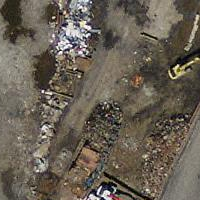 Tuile raster complète avant découpe
|
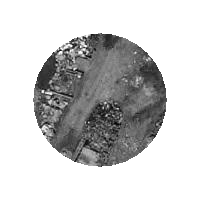 Après découpe
|
Exemples : Coupe d'une bande sans recadrage et ajout d'autres bandes inchangées
-- Same example as before, but we need to set crop to false to be able to use ST_AddBand
-- because ST_AddBand requires all bands be the same Width and height
SELECT ST_AddBand(ST_Clip(rast, 1,
ST_Buffer(ST_Centroid(ST_Envelope(rast)),20),false
), ARRAY[ST_Band(rast,2),ST_Band(rast,3)] ) from aerials.boston
WHERE rid = 6;
|
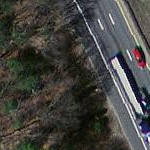 Tuile raster complète avant découpe
|
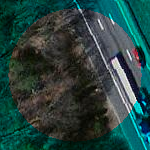 Après découpe - surréaliste
|
Exemples : Coupe de toutes les bandes
-- Clip all bands of an aerial tile by a 20 meter buffer.
-- Only difference is we don't specify a specific band to clip
-- so all bands are clipped
SELECT ST_Clip(rast,
ST_Buffer(ST_Centroid(ST_Envelope(rast)), 20),
false
) from aerials.boston
WHERE rid = 4;
|
 Tuile raster complète avant découpe
|
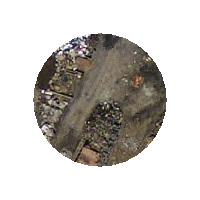 Après découpe
|
Name
ST_ColorMap — Crée un nouveau raster comprenant jusqu'à quatre bandes 8BUI (niveaux de gris, RGB, RGBA) à partir du raster source et d'une bande spécifiée. Si aucune bande n'est spécifiée, la bande 1 est utilisée.
Synopsis
raster ST_ColorMap(raster rast, integer nband=1, text colormap=grayscale, text method=INTERPOLATE);
raster ST_ColorMap(raster rast, text colormap, text method=INTERPOLATE);
Description
Appliquer une palette de couleurs colormap à la bande nband du raster rast, pour obtenir un nouveau raster comprenant jusqu'à quatre bandes 8BUI. Le nombre de bandes 8BUI dans le nouveau raster est déterminé par le nombre de composantes de couleur définies dans colormap.
Si nband n'est pas spécifié, la bande 1 est utilisée.
colormap peut être un mot-clé d'une palette de couleurs prédéfinie, ou un ensemble de lignes définissant la valeur et les composants de couleur.
Valeurs prédéfinies disponibles pour colormap :
grayscaleougreyscalepour un raster à 1 bande 8BUI en nuances de gris.pseudocolorpour un raster à 4 bandes 8BUI (RGBA) avec des couleurs allant du bleu au rouge en passant par le vert.firepour un raster à 4 bandes 8BUI (RGBA) avec des couleurs allant du noir au rouge en passant par le jaune pâle.blueredpour un raster à 4 bandes 8BUI (RGBA) avec des couleurs allant du bleu au rouge en passant par le blanc pâle.
Vous pouvez passer un ensemble d'entrées (une par ligne) à colormap pour spécifier des palettes de couleurs personnalisées. Chaque entrée se compose généralement de cinq valeurs : la valeur du pixel et les composantes rouge, verte, bleue et alpha correspondantes (composantes de couleur comprises entre 0 et 255). Des valeurs en pourcentage peuvent être utilisées à la place des valeurs en pixels, où 0% et 100% sont les valeurs minimales et maximales trouvées dans la bande raster. Les valeurs peuvent être séparées par des virgules (','), des tabulations, des deux-points (':') et/ou des espaces. La valeur du pixel peut être fixée à nv, null ou nodata pour la valeur NODATA. Un exemple est fourni ci-dessous.
5 0 0 0 255
4 100:50 55 255
1 150,100 150 255
0% 255 255 255 255
nv 0 0 0 0
La syntaxe de colormap est similaire à celle du mode couleur du relief de GDAL gdaldem.
Valeurs disponibles pour method :
INTERPOLATEpour utiliser l'interpolation linéaire afin de mélanger les couleurs entre les valeurs de pixels donnéesEXACTpour correspondre strictement aux valeurs des pixels trouvés dans la palette de couleurs. Les pixels dont la valeur ne correspond pas à une entrée de la palette de couleurs seront mis à 0 0 0 0 (RGBA)NEARESTpour utiliser l'entrée de la palette de couleurs dont la valeur est la plus proche de la valeur du pixel
![[Note]](images/note.png) | |
Une excellente référence pour les palette de couleurs est ColorBrewer. |
![[Warning]](images/warning.png) | |
Les bandes résultantes du nouveau raster n'auront pas de valeur NODATA définie. Utilisez ST_SetBandNoDataValue pour définir une valeur NODATA si nécessaire. |
Disponibilité : 2.1.0
Exemples
Définit une table de bric-à-brac pour jouer
-- setup test raster table --
DROP TABLE IF EXISTS funky_shapes;
CREATE TABLE funky_shapes(rast raster);
INSERT INTO funky_shapes(rast)
WITH ref AS (
SELECT ST_MakeEmptyRaster( 200, 200, 0, 200, 1, -1, 0, 0) AS rast
)
SELECT
ST_Union(rast)
FROM (
SELECT
ST_AsRaster(
ST_Rotate(
ST_Buffer(
ST_GeomFromText('LINESTRING(0 2,50 50,150 150,125 50)'),
i*2
),
pi() * i * 0.125, ST_Point(50,50)
),
ref.rast, '8BUI'::text, i * 5
) AS rast
FROM ref
CROSS JOIN generate_series(1, 10, 3) AS i
) AS shapes;
SELECT
ST_NumBands(rast) As n_orig,
ST_NumBands(ST_ColorMap(rast,1, 'greyscale')) As ngrey,
ST_NumBands(ST_ColorMap(rast,1, 'pseudocolor')) As npseudo,
ST_NumBands(ST_ColorMap(rast,1, 'fire')) As nfire,
ST_NumBands(ST_ColorMap(rast,1, 'bluered')) As nbluered,
ST_NumBands(ST_ColorMap(rast,1, '
100% 255 0 0
80% 160 0 0
50% 130 0 0
30% 30 0 0
20% 60 0 0
0% 0 0 0
nv 255 255 255
')) As nred
FROM funky_shapes;
n_orig | ngrey | npseudo | nfire | nbluered | nred
--------+-------+---------+-------+----------+------
1 | 1 | 4 | 4 | 4 | 3
Exemples : Comparaison de différentes palettes de couleurs via ST_AsPNG
SELECT
ST_AsPNG(rast) As orig_png,
ST_AsPNG(ST_ColorMap(rast,1,'greyscale')) As grey_png,
ST_AsPNG(ST_ColorMap(rast,1, 'pseudocolor')) As pseudo_png,
ST_AsPNG(ST_ColorMap(rast,1, 'nfire')) As fire_png,
ST_AsPNG(ST_ColorMap(rast,1, 'bluered')) As bluered_png,
ST_AsPNG(ST_ColorMap(rast,1, '
100% 255 0 0
80% 160 0 0
50% 130 0 0
30% 30 0 0
20% 60 0 0
0% 0 0 0
nv 255 255 255
')) As red_png
FROM funky_shapes;
|
 orig_png
|
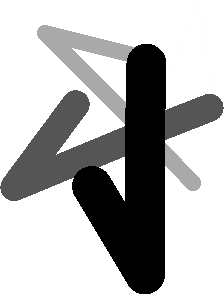 grey_png
|
 pseudo_png
|
|
 fire_png
|
 bluered_png
|
 red_png
|
Name
ST_Grayscale — Crée un nouveau raster à 1 bande 8BUI à partir du raster source et des bandes spécifiées représentant les composantes rouge, vert et bleu
Synopsis
(1) raster ST_Grayscale(raster rast, integer redband=1, integer greenband=2, integer blueband=3, text extenttype=INTERSECTION);
(2) raster ST_Grayscale(rastbandarg[] rastbandargset, text extenttype=INTERSECTION);
Description
Crée un raster à 1 bande 8BUI à partir de trois bandes d'entrée (provenant d'un ou plusieurs rasters). Toute bande d'entrée dont le type de pixel n'est pas 8BUI sera reclassée avec ST_Reclass.
![[Note]](images/note.png) | |
Cette fonction est différente de ST_ColorMap avec le mot-clé |
Disponibilité : 2.5.0
Exemples : Variante 1
SET postgis.gdal_enabled_drivers = 'ENABLE_ALL';
SET postgis.enable_outdb_rasters = True;
WITH apple AS (
SELECT ST_AddBand(
ST_MakeEmptyRaster(350, 246, 0, 0, 1, -1, 0, 0, 0),
'/tmp/apple.png'::text,
NULL::int[]
) AS rast
)
SELECT
ST_AsPNG(rast) AS original_png,
ST_AsPNG(ST_Grayscale(rast)) AS grayscale_png
FROM apple;
|
 original_png
|
 grayscale_png
|
Exemples : Variante 2
SET postgis.gdal_enabled_drivers = 'ENABLE_ALL';
SET postgis.enable_outdb_rasters = True;
WITH apple AS (
SELECT ST_AddBand(
ST_MakeEmptyRaster(350, 246, 0, 0, 1, -1, 0, 0, 0),
'/tmp/apple.png'::text,
NULL::int[]
) AS rast
)
SELECT
ST_AsPNG(rast) AS original_png,
ST_AsPNG(ST_Grayscale(
ARRAY[
ROW(rast, 1)::rastbandarg, -- red
ROW(rast, 2)::rastbandarg, -- green
ROW(rast, 3)::rastbandarg, -- blue
]::rastbandarg[]
)) AS grayscale_png
FROM apple;
Voir aussi
Name
ST_Intersection — Retourne un raster ou un ensemble de paires (géométrie, valeur de pixel) représentant la partie partagée de deux rasters ou l'intersection géométrique d'une vectorisation du raster et d'une géométrie.
Synopsis
setof geomval ST_Intersection(geometry geom, raster rast, integer band_num=1);
setof geomval ST_Intersection(raster rast, geometry geom);
setof geomval ST_Intersection(raster rast, integer band, geometry geomin);
raster ST_Intersection(raster rast1, raster rast2, double precision[] nodataval);
raster ST_Intersection(raster rast1, raster rast2, text returnband, double precision[] nodataval);
raster ST_Intersection(raster rast1, integer band1, raster rast2, integer band2, double precision[] nodataval);
raster ST_Intersection(raster rast1, integer band1, raster rast2, integer band2, text returnband, double precision[] nodataval);
Description
Retourne un raster ou un ensemble de paires (géométrie, valeur de pixel) représentant la partie partagée de deux rasters ou l'intersection géométrique d'une vectorisation du raster et d'une géométrie.
Les trois premières variantes, qui retournent un ensemble de géométries, fonctionnent dans l'espace vectoriel. Le raster est d'abord vectorisé (via ST_DumpAsPolygons) en un ensemble de lignes geomval, et ces lignes sont ensuite intersectées avec la géométrie via la fonction PostGIS ST_Intersection (geometry, geometry). Les géométries intersectant uniquement une zone de valeur nodata d'un raster renvoient une géométrie vide. Elles sont normalement exclues des résultats par l'utilisation correcte de ST_Intersects dans la clause WHERE.
Vous pouvez accéder aux parties géométrie et valeur de l'ensemble résultant de geomval en les entourant de parenthèses et en ajoutant '.geom' ou '.val' à la fin de l'expression. par exemple (ST_Intersection(rast, geom)).geom
Les autres variantes, qui retournent un raster, fonctionnent dans l'espace raster. Elles utilisent la variante de ST_MapAlgebraExpr utilisant deux rasters pour réaliser l'intersection.
L'étendue du raster résultant correspond à l'intersection géométrique des deux étendues des rasters. Le raster résultant inclut les bandes 'BAND1', 'BAND2' ou 'BOTH', en fonction du paramètre returnband. Les zones de valeurs nodata présentes dans n'importe quelle bande se traduisent par des zones de valeurs nodata dans toutes les bandes du résultat. En d'autres termes, tout pixel croisant un pixel à valeur nodata devient un pixel à valeur nodata dans le résultat.
Les rasters résultant de ST_Intersection doivent avoir une valeur nodata assignée pour les zones non intersectées. Vous pouvez définir ou remplacer la valeur nodata pour toute bande résultante en fournissant un tableau nodataval[] d'une ou deux valeurs nodata selon que vous demandez les bandes 'BAND1', 'BAND2' ou 'BOTH'. La première valeur du tableau remplace la valeur nodata dans la première bande et la deuxième valeur remplace la valeur nodata dans la deuxième bande. Si une bande d'entrée n'a pas de valeur nodata définie et qu'aucune n'est fournie sous forme de tableau, une valeur est choisie via la fonction ST_MinPossibleValue. Toutes les variantes acceptant un tableau de valeurs nodata peuvent également accepter une valeur unique qui sera assignée à chaque bande demandée.
Dans toutes les variantes, si aucune bande n'est spécifiée, la bande 1 est utilisée. Si vous avez besoin d'une intersection entre un raster et une géométrie qui retourne un raster, utilisez ST_Clip.
![[Note]](images/note.png) | |
Pour mieux contrôler l'étendue résultante, ou ce qu'il faut retourner lorsqu'une valeur nodata est rencontrée, utilisez la variante à deux rasters de ST_MapAlgebraExpr. |
![[Note]](images/note.png) | |
Pour calculer l'intersection d'une bande raster avec une géométrie dans l'espace raster, utilisez ST_Clip. ST_Clip travaille sur des bandes rasters multiples et ne retourne pas de bande correspondant à la géométrie rasterisée. |
![[Note]](images/note.png) | |
ST_Intersection devrait être utilisée conjointement avec ST_Intersects et un index sur la colonne raster et/ou la colonne géométrique. |
Amélioration : 2.0.0 - Ajout de l'intersection dans l'espace raster. Dans les versions antérieures à la version 2.0.0, seules les intersections réalisées dans l'espace vectoriel étaient prises en charge.
Exemples : Géométrie, Raster -- avec pour résultat des geomval
SELECT
foo.rid,
foo.gid,
ST_AsText((foo.geomval).geom) As geomwkt,
(foo.geomval).val
FROM (
SELECT
A.rid,
g.gid,
ST_Intersection(A.rast, g.geom) As geomval
FROM dummy_rast AS A
CROSS JOIN (
VALUES
(1, ST_Point(3427928, 5793243.85) ),
(2, ST_GeomFromText('LINESTRING(3427927.85 5793243.75,3427927.8 5793243.75,3427927.8 5793243.8)')),
(3, ST_GeomFromText('LINESTRING(1 2, 3 4)'))
) As g(gid,geom)
WHERE A.rid = 2
) As foo;
rid | gid | geomwkt | val
-----+-----+---------------------------------------------------------------------------------------------
2 | 1 | POINT(3427928 5793243.85) | 249
2 | 1 | POINT(3427928 5793243.85) | 253
2 | 2 | POINT(3427927.85 5793243.75) | 254
2 | 2 | POINT(3427927.8 5793243.8) | 251
2 | 2 | POINT(3427927.8 5793243.8) | 253
2 | 2 | LINESTRING(3427927.8 5793243.75,3427927.8 5793243.8) | 252
2 | 2 | MULTILINESTRING((3427927.8 5793243.8,3427927.8 5793243.75),...) | 250
2 | 3 | GEOMETRYCOLLECTION EMPTY
Voir aussi
geomval, ST_Intersects, ST_MapAlgebraExpr, ST_Clip, ST_AsText
Name
ST_MapAlgebra (callback function version) — Version avec fonction de rappel - Retourne un raster à une bande à partir d'un ou plusieurs rasters d'entrée, d'index de bandes et d'une fonction de rappel spécifiée par l'utilisateur.
Synopsis
raster ST_MapAlgebra(rastbandarg[] rastbandargset, regprocedure callbackfunc, text pixeltype=NULL, text extenttype=INTERSECTION, raster customextent=NULL, integer distancex=0, integer distancey=0, text[] VARIADIC userargs=NULL);
raster ST_MapAlgebra(raster rast, integer[] nband, regprocedure callbackfunc, text pixeltype=NULL, text extenttype=FIRST, raster customextent=NULL, integer distancex=0, integer distancey=0, text[] VARIADIC userargs=NULL);
raster ST_MapAlgebra(raster rast, integer nband, regprocedure callbackfunc, text pixeltype=NULL, text extenttype=FIRST, raster customextent=NULL, integer distancex=0, integer distancey=0, text[] VARIADIC userargs=NULL);
raster ST_MapAlgebra(raster rast1, integer nband1, raster rast2, integer nband2, regprocedure callbackfunc, text pixeltype=NULL, text extenttype=INTERSECTION, raster customextent=NULL, integer distancex=0, integer distancey=0, text[] VARIADIC userargs=NULL);
raster ST_MapAlgebra(raster rast, integer nband, regprocedure callbackfunc, float8[] mask, boolean weighted, text pixeltype=NULL, text extenttype=INTERSECTION, raster customextent=NULL, text[] VARIADIC userargs=NULL);
Description
Retourne un raster à une bande à partir d'un ou plusieurs rasters d'entrée, d'index de bandes et d'une fonction de rappel spécifiée par l'utilisateur.
rast,rast1,rast2, rastbandargsetRasters sur lesquels le traitement d'algèbre cartographique est évalué.
rastbandargsetpermet d'utiliser une opération d'algèbre cartographique sur plusieurs rasters et/ou plusieurs bandes. Voir l'exemple Variante 1.nband, nband1, nband2Numéros de bande du raster à évaluer. nband peut être un entier ou un tableau d'entiers désignant les bandes. nband1 est la bande sur rast1 et nband2 est la bande sur rast2 pour le cas de 2 rasters/2 bandes.
callbackfuncLe paramètre
callbackfuncdoit être le nom et la signature d'une fonction SQL ou PL/pgSQL, transformée en une regprocedure. Un exemple de fonction PL/pgSQL est le suivant :CREATE OR REPLACE FUNCTION sample_callbackfunc(value double precision[][][], position integer[][], VARIADIC userargs text[]) RETURNS double precision AS $$ BEGIN RETURN 0; END; $$ LANGUAGE 'plpgsql' IMMUTABLE;Le
callbackfuncdoit avoir trois arguments : un tableau de double précision à 3 dimensions, un tableau d'entiers à 2 dimensions et un tableau de texte variadique à 1 dimension. Le premier argumentvaleurest l'ensemble des valeurs (en double précision) de toutes les matrices d'entrée. Les trois dimensions (où les index sont basés sur 1) sont : trame #, ligne y, colonne x. Le deuxième argumentpositionest l'ensemble des positions des pixels de la trame de sortie et des trames d'entrée. La dimension extérieure (où les indices sont basés sur 0) est la trame #. La position à l'indice 0 de la dimension extérieure est la position en pixels de la trame de sortie. Pour chaque dimension extérieure, il y a deux éléments dans la dimension intérieure pour X et Y. Le troisième argumentuserargssert à transmettre les arguments spécifiés par l'utilisateur.Passer un argument de type regprocedure à une fonction SQL nécessite de passer la signature complète de la fonction, puis de la convertir en un type regprocedure. Pour passer la fonction PL/pgSQL ci-dessus en tant qu'argument, le code SQL de l'argument est le suivant :
'sample_callbackfunc(double precision[], integer[], text[])'::regprocedureNotez que l'argument contient le nom de la fonction, les types des arguments de la fonction, des guillemets autour du nom et des types d'arguments, ainsi qu'un cast vers un regprocedure.
maskUn tableau à n dimensions (matrice) de nombres utilisés pour filtrer les cellules transmises à la fonction de rappel de l'algèbre cartographique. 0 signifie que la valeur d'une cellule voisine doit être traitée comme une absence de données et 1 signifie que la valeur doit être traitée comme une donnée. Si weight est définit à true, les valeurs sont utilisées comme multiplicateurs pour multiplier la valeur du pixel par cette valeur dans la position de voisinage.
weightedbooléen (true/false) indiquant si la valeur d'un masque doit être pondérée (multipliée par la valeur originale) ou non (ne s'applique qu'aux variantes qui prennent un masque).
pixeltypeSi
pixeltypeest spécifié, l'unique bande du nouveau raster sera de ce type de pixel. Si pixeltype est NULL ou omis, la nouvelle bande du raster aura le même pixeltype que la bande spécifiée du premier raster (pour les types d'étendue : INTERSECTION, UNION, FIRST, CUSTOM) ou que la bande spécifiée du raster approprié (pour les types d'étendue : SECOND, LAST). En cas de doute, spécifiez toujourspixeltype.Le type de pixel résultant du raster de sortie doit correspondre à l'un des types énumérés dans ST_BandPixelType, ou être omis ou défini à NULL.
extenttypeLes valeurs possibles sont INTERSECTION (par défaut), UNION, FIRST (premier, par défaut pour les variantes à un seul raster), SECOND, LAST (dernier), CUSTOM (personnalisé).
customextentSi
extentypeest CUSTOM, un raster doit être spécifié par le paramètrecustomextent. Voir l'exemple 4 de la variante 1.distancexLa distance en pixels de la cellule de référence dans la direction x. La largeur de la matrice résultante sera donc
2*distancex + 1. Si elle n'est pas spécifiée, seule la cellule de référence est prise en compte (voisinage de 0).distanceyLa distance en pixels de la cellule de référence dans la direction y. La hauteur de la matrice résultante sera
2*distancey + 1Si elle n'est pas spécifiée, seule la cellule de référence est prise en compte (voisinage de 0).userargsLe troisième paramètre de la fonction
callbackfuncest un tableau variadic text . Tous les arguments textuels supplémentaires sont transmis àcallbackfunc, et sont contenus dans l'argumentuserargs.
![[Note]](images/note.png) | |
Pour plus d'informations sur le mot-clé VARIADIC, veuillez vous référer à la documentation PostgreSQL et à la section "SQL Functions with Variable Numbers of Arguments" de Query Language (SQL) Functions. |
![[Note]](images/note.png) | |
Le paramètre text[] de la fonction |
La variante 1 accepte un tableau de rastbandarg permettant l'utilisation d'une opération d'algèbre cartographique sur de nombreux masters et/ou de nombreuses bandes. Voir l'exemple de la variante 1.
Les variantes 2 et 3 agissent sur une ou plusieurs bandes d'un même raster. Voir l'exemple des variantes 2 et 3.
La variante 4 utilise deux rasters avec une bande par raster. Voir l'exemple de la variante 4.
Disponibilité : 2.2.0 : Possibilité d'ajouter un masque
Disponibilité : 2.1.0
Exemples : Variante 1
Un raster, une bande
WITH foo AS (
SELECT 1 AS rid, ST_AddBand(ST_MakeEmptyRaster(2, 2, 0, 0, 1, -1, 0, 0, 0), 1, '16BUI', 1, 0) AS rast
)
SELECT
ST_MapAlgebra(
ARRAY[ROW(rast, 1)]::rastbandarg[],
'sample_callbackfunc(double precision[], int[], text[])'::regprocedure
) AS rast
FROM foo
Un raster, plusieurs bandes
WITH foo AS (
SELECT 1 AS rid, ST_AddBand(ST_AddBand(ST_AddBand(ST_MakeEmptyRaster(2, 2, 0, 0, 1, -1, 0, 0, 0), 1, '16BUI', 1, 0), 2, '8BUI', 10, 0), 3, '32BUI', 100, 0) AS rast
)
SELECT
ST_MapAlgebra(
ARRAY[ROW(rast, 3), ROW(rast, 1), ROW(rast, 3), ROW(rast, 2)]::rastbandarg[],
'sample_callbackfunc(double precision[], int[], text[])'::regprocedure
) AS rast
FROM foo
Plusieurs rasters, plusieurs bandes
WITH foo AS (
SELECT 1 AS rid, ST_AddBand(ST_AddBand(ST_AddBand(ST_MakeEmptyRaster(2, 2, 0, 0, 1, -1, 0, 0, 0), 1, '16BUI', 1, 0), 2, '8BUI', 10, 0), 3, '32BUI', 100, 0) AS rast UNION ALL
SELECT 2 AS rid, ST_AddBand(ST_AddBand(ST_AddBand(ST_MakeEmptyRaster(2, 2, 0, 1, 1, -1, 0, 0, 0), 1, '16BUI', 2, 0), 2, '8BUI', 20, 0), 3, '32BUI', 300, 0) AS rast
)
SELECT
ST_MapAlgebra(
ARRAY[ROW(t1.rast, 3), ROW(t2.rast, 1), ROW(t2.rast, 3), ROW(t1.rast, 2)]::rastbandarg[],
'sample_callbackfunc(double precision[], int[], text[])'::regprocedure
) AS rast
FROM foo t1
CROSS JOIN foo t2
WHERE t1.rid = 1
AND t2.rid = 2
Complete example of tiles of a coverage with neighborhood.
WITH foo AS (
SELECT 0 AS rid, ST_AddBand(ST_MakeEmptyRaster(2, 2, 0, 0, 1, -1, 0, 0, 0), 1, '16BUI', 1, 0) AS rast UNION ALL
SELECT 1, ST_AddBand(ST_MakeEmptyRaster(2, 2, 2, 0, 1, -1, 0, 0, 0), 1, '16BUI', 2, 0) AS rast UNION ALL
SELECT 2, ST_AddBand(ST_MakeEmptyRaster(2, 2, 4, 0, 1, -1, 0, 0, 0), 1, '16BUI', 3, 0) AS rast UNION ALL
SELECT 3, ST_AddBand(ST_MakeEmptyRaster(2, 2, 0, -2, 1, -1, 0, 0, 0), 1, '16BUI', 10, 0) AS rast UNION ALL
SELECT 4, ST_AddBand(ST_MakeEmptyRaster(2, 2, 2, -2, 1, -1, 0, 0, 0), 1, '16BUI', 20, 0) AS rast UNION ALL
SELECT 5, ST_AddBand(ST_MakeEmptyRaster(2, 2, 4, -2, 1, -1, 0, 0, 0), 1, '16BUI', 30, 0) AS rast UNION ALL
SELECT 6, ST_AddBand(ST_MakeEmptyRaster(2, 2, 0, -4, 1, -1, 0, 0, 0), 1, '16BUI', 100, 0) AS rast UNION ALL
SELECT 7, ST_AddBand(ST_MakeEmptyRaster(2, 2, 2, -4, 1, -1, 0, 0, 0), 1, '16BUI', 200, 0) AS rast UNION ALL
SELECT 8, ST_AddBand(ST_MakeEmptyRaster(2, 2, 4, -4, 1, -1, 0, 0, 0), 1, '16BUI', 300, 0) AS rast
)
SELECT
t1.rid,
ST_MapAlgebra(
ARRAY[ROW(ST_Union(t2.rast), 1)]::rastbandarg[],
'sample_callbackfunc(double precision[], int[], text[])'::regprocedure,
'32BUI',
'CUSTOM', t1.rast,
1, 1
) AS rast
FROM foo t1
CROSS JOIN foo t2
WHERE t1.rid = 4
AND t2.rid BETWEEN 0 AND 8
AND ST_Intersects(t1.rast, t2.rast)
GROUP BY t1.rid, t1.rast
Example like the prior one for tiles of a coverage with neighborhood but using only basic SQL features.
WITH src AS (
SELECT 0 AS rid, ST_AddBand(ST_MakeEmptyRaster(2, 2, 0, 0, 1, -1, 0, 0, 0), 1, '16BUI', 1, 0) AS rast UNION ALL
SELECT 1, ST_AddBand(ST_MakeEmptyRaster(2, 2, 2, 0, 1, -1, 0, 0, 0), 1, '16BUI', 2, 0) AS rast UNION ALL
SELECT 2, ST_AddBand(ST_MakeEmptyRaster(2, 2, 4, 0, 1, -1, 0, 0, 0), 1, '16BUI', 3, 0) AS rast UNION ALL
SELECT 3, ST_AddBand(ST_MakeEmptyRaster(2, 2, 0, -2, 1, -1, 0, 0, 0), 1, '16BUI', 10, 0) AS rast UNION ALL
SELECT 4, ST_AddBand(ST_MakeEmptyRaster(2, 2, 2, -2, 1, -1, 0, 0, 0), 1, '16BUI', 20, 0) AS rast UNION ALL
SELECT 5, ST_AddBand(ST_MakeEmptyRaster(2, 2, 4, -2, 1, -1, 0, 0, 0), 1, '16BUI', 30, 0) AS rast UNION ALL
SELECT 6, ST_AddBand(ST_MakeEmptyRaster(2, 2, 0, -4, 1, -1, 0, 0, 0), 1, '16BUI', 100, 0) AS rast UNION ALL
SELECT 7, ST_AddBand(ST_MakeEmptyRaster(2, 2, 2, -4, 1, -1, 0, 0, 0), 1, '16BUI', 200, 0) AS rast UNION ALL
SELECT 8, ST_AddBand(ST_MakeEmptyRaster(2, 2, 4, -4, 1, -1, 0, 0, 0), 1, '16BUI', 300, 0) AS rast
)
WITH foo AS (
SELECT
t1.rid,
ST_Union(t2.rast) AS rast
FROM src t1
JOIN src t2
ON ST_Intersects(t1.rast, t2.rast)
AND t2.rid BETWEEN 0 AND 8
WHERE t1.rid = 4
GROUP BY t1.rid
), bar AS (
SELECT
t1.rid,
ST_MapAlgebra(
ARRAY[ROW(t2.rast, 1)]::rastbandarg[],
'raster_nmapalgebra_test(double precision[], int[], text[])'::regprocedure,
'32BUI',
'CUSTOM', t1.rast,
1, 1
) AS rast
FROM src t1
JOIN foo t2
ON t1.rid = t2.rid
)
SELECT
rid,
(ST_Metadata(rast)),
(ST_BandMetadata(rast, 1)),
ST_Value(rast, 1, 1, 1)
FROM bar;
Exemples : Variantes 2 et 3
Un raster, plusieurs bandes
WITH foo AS (
SELECT 1 AS rid, ST_AddBand(ST_AddBand(ST_AddBand(ST_MakeEmptyRaster(2, 2, 0, 0, 1, -1, 0, 0, 0), 1, '16BUI', 1, 0), 2, '8BUI', 10, 0), 3, '32BUI', 100, 0) AS rast
)
SELECT
ST_MapAlgebra(
rast, ARRAY[3, 1, 3, 2]::integer[],
'sample_callbackfunc(double precision[], int[], text[])'::regprocedure
) AS rast
FROM foo
Un raster, une bande
WITH foo AS (
SELECT 1 AS rid, ST_AddBand(ST_AddBand(ST_AddBand(ST_MakeEmptyRaster(2, 2, 0, 0, 1, -1, 0, 0, 0), 1, '16BUI', 1, 0), 2, '8BUI', 10, 0), 3, '32BUI', 100, 0) AS rast
)
SELECT
ST_MapAlgebra(
rast, 2,
'sample_callbackfunc(double precision[], int[], text[])'::regprocedure
) AS rast
FROM foo
Exemples : Variante 4
Deux rasters, deux bandes
WITH foo AS (
SELECT 1 AS rid, ST_AddBand(ST_AddBand(ST_AddBand(ST_MakeEmptyRaster(2, 2, 0, 0, 1, -1, 0, 0, 0), 1, '16BUI', 1, 0), 2, '8BUI', 10, 0), 3, '32BUI', 100, 0) AS rast UNION ALL
SELECT 2 AS rid, ST_AddBand(ST_AddBand(ST_AddBand(ST_MakeEmptyRaster(2, 2, 0, 1, 1, -1, 0, 0, 0), 1, '16BUI', 2, 0), 2, '8BUI', 20, 0), 3, '32BUI', 300, 0) AS rast
)
SELECT
ST_MapAlgebra(
t1.rast, 2,
t2.rast, 1,
'sample_callbackfunc(double precision[], int[], text[])'::regprocedure
) AS rast
FROM foo t1
CROSS JOIN foo t2
WHERE t1.rid = 1
AND t2.rid = 2
Exemples : Utilisation de masques
WITH foo AS (SELECT
ST_SetBandNoDataValue(
ST_SetValue(ST_SetValue(ST_AsRaster(
ST_Buffer(
ST_GeomFromText('LINESTRING(50 50,100 90,100 50)'), 5,'join=bevel'),
200,200,ARRAY['8BUI'], ARRAY[100], ARRAY[0]), ST_Buffer('POINT(70 70)'::geometry,10,'quad_segs=1') ,50),
'LINESTRING(20 20, 100 100, 150 98)'::geometry,1),0) AS rast )
SELECT 'original' AS title, rast
FROM foo
UNION ALL
SELECT 'no mask mean value' AS title, ST_MapAlgebra(rast,1,'ST_mean4ma(double precision[], int[], text[])'::regprocedure) AS rast
FROM foo
UNION ALL
SELECT 'mask only consider neighbors, exclude center' AS title, ST_MapAlgebra(rast,1,'ST_mean4ma(double precision[], int[], text[])'::regprocedure,
'{{1,1,1}, {1,0,1}, {1,1,1}}'::double precision[], false) As rast
FROM foo
UNION ALL
SELECT 'mask weighted only consider neighbors, exclude center multi other pixel values by 2' AS title, ST_MapAlgebra(rast,1,'ST_mean4ma(double precision[], int[], text[])'::regprocedure,
'{{2,2,2}, {2,0,2}, {2,2,2}}'::double precision[], true) As rast
FROM foo;
|
 original
|
 valeur moyenne, sans masque (ce qui revient à avoir que des 1 dans la matrice du masque)
|
|
 masque uniquement sur les voisins, en excluant le centre
|
 masque pondéré, uniquement sur les voisins en excluant le centre, multiplier les autres pixels par 2
|
Voir aussi
Name
ST_MapAlgebra (expression version) — Version avec expression - Retourne un raster à une bande à partir d'un ou deux rasters d'entrée, d'index de bandes et d'une ou plusieurs expressions SQL spécifiées par l'utilisateur.
Synopsis
raster ST_MapAlgebra(raster rast, integer nband, text pixeltype, text expression, double precision nodataval=NULL);
raster ST_MapAlgebra(raster rast, text pixeltype, text expression, double precision nodataval=NULL);
raster ST_MapAlgebra(raster rast1, integer nband1, raster rast2, integer nband2, text expression, text pixeltype=NULL, text extenttype=INTERSECTION, text nodata1expr=NULL, text nodata2expr=NULL, double precision nodatanodataval=NULL);
raster ST_MapAlgebra(raster rast1, raster rast2, text expression, text pixeltype=NULL, text extenttype=INTERSECTION, text nodata1expr=NULL, text nodata2expr=NULL, double precision nodatanodataval=NULL);
Description
Version avec expression - Retourne un raster à une bande à partir d'un ou deux rasters d'entrée, d'index de bandes et d'une ou plusieurs expressions SQL spécifiées par l'utilisateur.
Disponibilité : 2.1.0
Description : Variantes 1 et 2 (un raster)
Crée un nouveau raster à une bande formé en appliquant une opération algébrique PostgreSQL valide définie par expression sur le raster d'entrée (rast). Si nband n'est pas fourni, la bande 1 est utilisée. Le nouveau raster aura la même géoréférence, la même largeur et la même hauteur que le raster original mais n'aura qu'une seule bande.
Si pixeltype est fourni, le nouveau raster aura une bande de ce type de pixel. Si pixeltype est NULL, la nouvelle bande raster aura le même type de pixel que la bande d'entrée de rast.
Mots clés possibles pour
expression[rast]- Valeur du pixel d'intérêt[rast.val]- Valeur du pixel d'intérêt[rast.x]- colonne du pixel d'intérêt (démarrant à 1)[rast.y]- ligne du pixel d'intérêt (démarrant à 1)
Description : Variantes 3 et 4 (deux rasters)
Crée un nouveau raster à une bande formé en appliquant une opération algébrique PostgreSQL valide aux deux bandes définies par expression sur les deux bandes d'entrée rast1 (et optionnellement rast2). Si aucune bande band1, band2 n'est spécifiée, la bande 1 est utilisée. Le raster résultant sera aligné (échelle, obliquité et coins) sur la grille définie par le premier raster. Le raster résultant aura l'étendue définie par le paramètre extenttype.
expressionUne expression algébrique PostgreSQL impliquant les deux rasters et les fonctions/opérateurs définis par PostgreSQL qui définiront la valeur du pixel lorsque les pixels intersectent, par exemple (([rast1] + [rast2])/2.0)::integer
pixeltypeLe type de pixel résultant du raster de sortie. Doit être l'un de ceux listés dans ST_BandPixelType, omis ou NULL. S'il n'est pas fourni ou NULL, le type de pixel du premier raster sera utilisé par défaut.
extenttypeContrôle l'étendue du raster de sortie
INTERSECTION- L'étendue du nouveau raster est l'intersection des deux rasters. Il s'agit de la valeur par défaut.UNION- L'étendue du nouveau raster est l'union des deux rasters.FIRST- L'étendue du nouveau raster est la même que celle du premier raster.SECOND- L'étendue du nouveau raster est la même que celle du second raster.
nodata1exprUne expression algébrique impliquant uniquement
rast2, ou une constante qui définit la valeur à retourner lorsque les pixels derast1sont des valeurs nodata et que les pixels correspondants dans rast2 ont des valeurs.nodata2exprUne expression algébrique impliquant uniquement
rast1, ou une constante qui définit la valeur à retourner lorsque les pixels derast2sont des valeurs nodata et que les pixels correspondants dans rast1 ont des valeurs.nodatanodatavalConstante numérique à retourner lorsque les pixels de rast1 et de rast2 sont tous deux des valeurs nodata.
Mots clés possibles dans
expression,nodata1expretnodata2expr[rast1]- Valeur du pixel d'intérêt surrast1[rast1.val]- Valeur du pixel d'intérêt derast1[rast1.x]- Colonne du pixel d'intérêt derast1(démarrant à 1)[rast1.y]- Ligne du pixel d'intérêt derast1(démarrant à 1)[rast2]- Valeur du pixel d'intérêt surrast2[rast2.val]- Valeur du pixel d'intérêt derast2[rast2.x]- Colonne du pixel d'intérêt derast2(démarrant à 1)[rast2.y]- Ligne du pixel d'intérêt derast2(démarrant à 1)
Exemples : Variantes 1 et 2
WITH foo AS (
SELECT ST_AddBand(ST_MakeEmptyRaster(10, 10, 0, 0, 1, 1, 0, 0, 0), '32BF'::text, 1, -1) AS rast
)
SELECT
ST_MapAlgebra(rast, 1, NULL, 'ceil([rast]*[rast.x]/[rast.y]+[rast.val])')
FROM foo;
Exemples : Variantes 3 et 4
WITH foo AS (
SELECT 1 AS rid, ST_AddBand(ST_AddBand(ST_AddBand(ST_MakeEmptyRaster(2, 2, 0, 0, 1, -1, 0, 0, 0), 1, '16BUI', 1, 0), 2, '8BUI', 10, 0), 3, '32BUI'::text, 100, 0) AS rast UNION ALL
SELECT 2 AS rid, ST_AddBand(ST_AddBand(ST_AddBand(ST_MakeEmptyRaster(2, 2, 0, 1, 1, -1, 0, 0, 0), 1, '16BUI', 2, 0), 2, '8BUI', 20, 0), 3, '32BUI'::text, 300, 0) AS rast
)
SELECT
ST_MapAlgebra(
t1.rast, 2,
t2.rast, 1,
'([rast2] + [rast1.val]) / 2'
) AS rast
FROM foo t1
CROSS JOIN foo t2
WHERE t1.rid = 1
AND t2.rid = 2;
Name
ST_MapAlgebraExpr — Version avec raster à 1 bande : Crée un nouveau raster à une bande formé par l'application d'une opération algébrique PostgreSQL valide sur la bande d'entrée du raster et du type de pixel fourni. Si aucune bande n'est spécifiée, la bande 1 est utilisée.
Synopsis
raster ST_MapAlgebraExpr(raster rast, integer band, text pixeltype, text expression, double precision nodataval=NULL);
raster ST_MapAlgebraExpr(raster rast, text pixeltype, text expression, double precision nodataval=NULL);
Description
![[Warning]](images/warning.png) | |
ST_MapAlgebraExpr est obsolète depuis 2.1.0. Utilisez plutôt ST_MapAlgebra (expression version). |
Crée un nouveau raster à une bande formé par l'application d'une opération algébrique PostgreSQL valide définie par expression sur le raster d'entrée (rast). Si aucune band n'est spécifiée, la bande 1 est utilisée. Le nouveau raster aura la même géoréférence, la même largeur et la même hauteur que le raster original mais n'aura qu'une seule bande.
Si pixeltype est fourni, le nouveau raster aura une bande de ce type de pixel. Si pixeltype est NULL, la nouvelle bande raster aura le même type de pixel que la bande d'entrée de rast.
Dans l'expression, vous pouvez utiliser le mot clé [rast] pour faire référence à la valeur en pixels de la bande originale, [rast.x] pour faire référence à l'indice de colonne de pixels (basé sur 1), [rast.y] pour faire référence à l'indice de ligne de pixels (basé sur 1).
Disponibilité : 2.0.0
Exemples
Crée une nouveau raster à 1 bande qui est une fonction modulo 2 de la bande du raster original.
ALTER TABLE dummy_rast ADD COLUMN map_rast raster;
UPDATE dummy_rast SET map_rast = ST_MapAlgebraExpr(rast,NULL,'mod([rast]::numeric,2)') WHERE rid = 2;
SELECT
ST_Value(rast,1,i,j) As origval,
ST_Value(map_rast, 1, i, j) As mapval
FROM dummy_rast
CROSS JOIN generate_series(1, 3) AS i
CROSS JOIN generate_series(1,3) AS j
WHERE rid = 2;
origval | mapval
---------+--------
253 | 1
254 | 0
253 | 1
253 | 1
254 | 0
254 | 0
250 | 0
254 | 0
254 | 0
Crée un nouveau raster à 1 bande de type de pixel 2BUI à partir d'un raster original reclassifié et avec la valeur nodata à 0.
ALTER TABLE dummy_rast ADD COLUMN map_rast2 raster;
UPDATE dummy_rast SET
map_rast2 = ST_MapAlgebraExpr(rast,'2BUI'::text,'CASE WHEN [rast] BETWEEN 100 and 250 THEN 1 WHEN [rast] = 252 THEN 2 WHEN [rast] BETWEEN 253 and 254 THEN 3 ELSE 0 END'::text, '0')
WHERE rid = 2;
SELECT DISTINCT
ST_Value(rast,1,i,j) As origval,
ST_Value(map_rast2, 1, i, j) As mapval
FROM dummy_rast
CROSS JOIN generate_series(1, 5) AS i
CROSS JOIN generate_series(1,5) AS j
WHERE rid = 2;
origval | mapval
---------+--------
249 | 1
250 | 1
251 |
252 | 2
253 | 3
254 | 3
SELECT
ST_BandPixelType(map_rast2) As b1pixtyp
FROM dummy_rast
WHERE rid = 2;
b1pixtyp
----------
2BUI
|
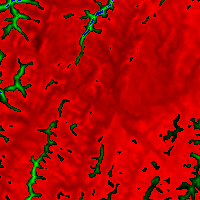 original (colonne rast_view)
|
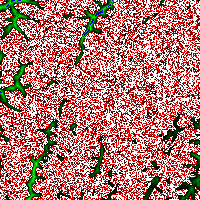 rast_view_ma
|
Crée un nouveau raster à 3 bandes de même type de pixel que le raster original à 3 bandes, la première bande étant modifiée par l'algèbre cartographique et les 2 bandes restantes n'étant pas modifiées.
SELECT
ST_AddBand(
ST_AddBand(
ST_AddBand(
ST_MakeEmptyRaster(rast_view),
ST_MapAlgebraExpr(rast_view,1,NULL,'tan([rast])*[rast]')
),
ST_Band(rast_view,2)
),
ST_Band(rast_view, 3)
) As rast_view_ma
FROM wind
WHERE rid=167;
Voir aussi
ST_MapAlgebraExpr, ST_MapAlgebraFct, ST_BandPixelType, ST_GeoReference, ST_Value
Name
ST_MapAlgebraExpr — Version avec 2 bandes : Crée un nouveau raster à une bande formé en appliquant une opération algébrique PostgreSQL valide sur les deux bandes du raster d'entrée et du type de pixel fourni. La bande 1 de chaque raster est utilisée si aucun numéro de bande n'est spécifié. Le raster résultant sera aligné (échelle, obliquité et coins) sur la grille définie par le premier raster et aura son étendue définie par le paramètre "extenttype". Les valeurs de "extenttype" peuvent être : INTERSECTION, UNION, FIRST, SECOND.
Synopsis
raster ST_MapAlgebraExpr(raster rast1, raster rast2, text expression, text pixeltype=same_as_rast1_band, text extenttype=INTERSECTION, text nodata1expr=NULL, text nodata2expr=NULL, double precision nodatanodataval=NULL);
raster ST_MapAlgebraExpr(raster rast1, integer band1, raster rast2, integer band2, text expression, text pixeltype=same_as_rast1_band, text extenttype=INTERSECTION, text nodata1expr=NULL, text nodata2expr=NULL, double precision nodatanodataval=NULL);
Description
![[Warning]](images/warning.png) | |
ST_MapAlgebraExpr est obsolète depuis 2.1.0. Utilisez plutôt ST_MapAlgebra (expression version). |
Crée un nouveau raster à une bande formé en appliquant une opération algébrique PostgreSQL valide aux deux bandes définies par expression sur les deux bandes d'entrée rast1 (et optionnellement rast2). Si aucune bande band1, band2 n'est spécifiée, la bande 1 est utilisée. Le raster résultant sera aligné (échelle, obliquité et coins) sur la grille définie par le premier raster. Le raster résultant aura l'étendue définie par le paramètre extenttype.
expressionUne expression algébrique PostgreSQL impliquant les deux rasters et les fonctions/opérateurs définis par PostgreSQL qui définiront la valeur du pixel lorsque les pixels intersectent, par exemple (([rast1] + [rast2])/2.0)::integer
pixeltypeLe type de pixel résultant du raster de sortie. Doit être l'un de ceux listés dans ST_BandPixelType, omis ou NULL. S'il n'est pas fourni ou NULL, le type de pixel du premier raster sera utilisé par défaut.
extenttypeContrôle l'étendue du raster de sortie
INTERSECTION- L'étendue du nouveau raster est l'intersection des deux rasters. Il s'agit de la valeur par défaut.UNION- L'étendue du nouveau raster est l'union des deux rasters.FIRST- L'étendue du nouveau raster est la même que celle du premier raster.SECOND- L'étendue du nouveau raster est la même que celle du second raster.
nodata1exprUne expression algébrique impliquant uniquement
rast2, ou une constante qui définit la valeur à retourner lorsque les pixels derast1sont des valeurs nodata et que les pixels correspondants dans rast2 ont des valeurs.nodata2exprUne expression algébrique impliquant uniquement
rast1, ou une constante qui définit la valeur à retourner lorsque les pixels derast2sont des valeurs nodata et que les pixels correspondants dans rast1 ont des valeurs.nodatanodatavalConstante numérique à retourner lorsque les pixels de rast1 et de rast2 sont tous deux des valeurs nodata.
Si le pixeltype est fourni, le nouveau raster aura une bande de ce type de pixel. Si le type de pixel est NULL ou si aucun type de pixel n'est spécifié, la nouvelle bande raster aura le même type de pixel que la bande d'entrée de rast1.
Utilisez le mot clé [rast1.val] [rast2.val] pour désigner la valeur en pixels des bandes raster d'origine et [rast1.x], [rast1.y] etc. pour désigner la position des pixels dans les colonnes et les lignes.
Disponibilité : 2.0.0
Exemple : Intersection et Union avec 2 bandes
Crée une nouveau raster à 1 bande qui est une fonction modulo 2 de la bande du raster original.
--Create a cool set of rasters --
DROP TABLE IF EXISTS fun_shapes;
CREATE TABLE fun_shapes(rid serial PRIMARY KEY, fun_name text, rast raster);
-- Insert some cool shapes around Boston in Massachusetts state plane meters --
INSERT INTO fun_shapes(fun_name, rast)
VALUES ('ref', ST_AsRaster(ST_MakeEnvelope(235229, 899970, 237229, 901930,26986),200,200,'8BUI',0,0));
INSERT INTO fun_shapes(fun_name,rast)
WITH ref(rast) AS (SELECT rast FROM fun_shapes WHERE fun_name = 'ref' )
SELECT 'area' AS fun_name, ST_AsRaster(ST_Buffer(ST_SetSRID(ST_Point(236229, 900930),26986), 1000),
ref.rast,'8BUI', 10, 0) As rast
FROM ref
UNION ALL
SELECT 'rand bubbles',
ST_AsRaster(
(SELECT ST_Collect(geom)
FROM (SELECT ST_Buffer(ST_SetSRID(ST_Point(236229 + i*random()*100, 900930 + j*random()*100),26986), random()*20) As geom
FROM generate_series(1,10) As i, generate_series(1,10) As j
) As foo ), ref.rast,'8BUI', 200, 0)
FROM ref;
--map them -
SELECT ST_MapAlgebraExpr(
area.rast, bub.rast, '[rast2.val]', '8BUI', 'INTERSECTION', '[rast2.val]', '[rast1.val]') As interrast,
ST_MapAlgebraExpr(
area.rast, bub.rast, '[rast2.val]', '8BUI', 'UNION', '[rast2.val]', '[rast1.val]') As unionrast
FROM
(SELECT rast FROM fun_shapes WHERE
fun_name = 'area') As area
CROSS JOIN (SELECT rast
FROM fun_shapes WHERE
fun_name = 'rand bubbles') As bub
|
 intersection
|
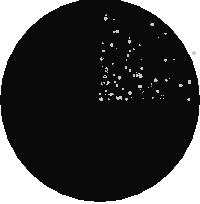 union
|
Exemple : Superposition de rasters sur un canevas sous forme de bandes distinctes
-- we use ST_AsPNG to render the image so all single band ones look grey --
WITH mygeoms
AS ( SELECT 2 As bnum, ST_Buffer(ST_Point(1,5),10) As geom
UNION ALL
SELECT 3 AS bnum,
ST_Buffer(ST_GeomFromText('LINESTRING(50 50,150 150,150 50)'), 10,'join=bevel') As geom
UNION ALL
SELECT 1 As bnum,
ST_Buffer(ST_GeomFromText('LINESTRING(60 50,150 150,150 50)'), 5,'join=bevel') As geom
),
-- define our canvas to be 1 to 1 pixel to geometry
canvas
AS (SELECT ST_AddBand(ST_MakeEmptyRaster(200,
200,
ST_XMin(e)::integer, ST_YMax(e)::integer, 1, -1, 0, 0) , '8BUI'::text,0) As rast
FROM (SELECT ST_Extent(geom) As e,
Max(ST_SRID(geom)) As srid
from mygeoms
) As foo
),
rbands AS (SELECT ARRAY(SELECT ST_MapAlgebraExpr(canvas.rast, ST_AsRaster(m.geom, canvas.rast, '8BUI', 100),
'[rast2.val]', '8BUI', 'FIRST', '[rast2.val]', '[rast1.val]') As rast
FROM mygeoms AS m CROSS JOIN canvas
ORDER BY m.bnum) As rasts
)
SELECT rasts[1] As rast1 , rasts[2] As rast2, rasts[3] As rast3, ST_AddBand(
ST_AddBand(rasts[1],rasts[2]), rasts[3]) As final_rast
FROM rbands;
|
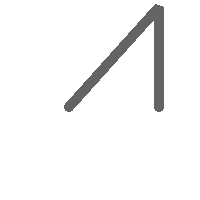 rast1
|
 rast2
|
|
 rast3
|
 final_rast
|
Exemple : Superposition d'une délimitation de 2 mètres de certaines parcelles sur une image aérienne
-- Create new 3 band raster composed of first 2 clipped bands, and overlay of 3rd band with our geometry
-- This query took 3.6 seconds on PostGIS windows 64-bit install
WITH pr AS
-- Note the order of operation: we clip all the rasters to dimensions of our region
(SELECT ST_Clip(rast,ST_Expand(geom,50) ) As rast, g.geom
FROM aerials.o_2_boston AS r INNER JOIN
-- union our parcels of interest so they form a single geometry we can later intersect with
(SELECT ST_Union(ST_Transform(geom,26986)) AS geom
FROM landparcels WHERE pid IN('0303890000', '0303900000')) As g
ON ST_Intersects(rast::geometry, ST_Expand(g.geom,50))
),
-- we then union the raster shards together
-- ST_Union on raster is kinda of slow but much faster the smaller you can get the rasters
-- therefore we want to clip first and then union
prunion AS
(SELECT ST_AddBand(NULL, ARRAY[ST_Union(rast,1),ST_Union(rast,2),ST_Union(rast,3)] ) As clipped,geom
FROM pr
GROUP BY geom)
-- return our final raster which is the unioned shard with
-- with the overlay of our parcel boundaries
-- add first 2 bands, then mapalgebra of 3rd band + geometry
SELECT ST_AddBand(ST_Band(clipped,ARRAY[1,2])
, ST_MapAlgebraExpr(ST_Band(clipped,3), ST_AsRaster(ST_Buffer(ST_Boundary(geom),2),clipped, '8BUI',250),
'[rast2.val]', '8BUI', 'FIRST', '[rast2.val]', '[rast1.val]') ) As rast
FROM prunion;
|
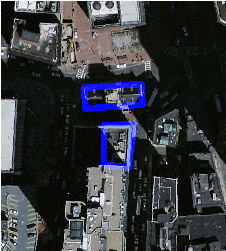 Les lignes bleues représentent les limites des parcelles sélectionnées
|
Name
ST_MapAlgebraFct — Version à 1 bande - Crée un nouveau raster à une bande formé par l'application d'une fonction PostgreSQL valide sur la bande d'entrée du raster et sur le type de pixel fourni. La bande 1 est utilisée si aucune bande n'est spécifiée.
Synopsis
raster ST_MapAlgebraFct(raster rast, regprocedure onerasteruserfunc);
raster ST_MapAlgebraFct(raster rast, regprocedure onerasteruserfunc, text[] VARIADIC args);
raster ST_MapAlgebraFct(raster rast, text pixeltype, regprocedure onerasteruserfunc);
raster ST_MapAlgebraFct(raster rast, text pixeltype, regprocedure onerasteruserfunc, text[] VARIADIC args);
raster ST_MapAlgebraFct(raster rast, integer band, regprocedure onerasteruserfunc);
raster ST_MapAlgebraFct(raster rast, integer band, regprocedure onerasteruserfunc, text[] VARIADIC args);
raster ST_MapAlgebraFct(raster rast, integer band, text pixeltype, regprocedure onerasteruserfunc);
raster ST_MapAlgebraFct(raster rast, integer band, text pixeltype, regprocedure onerasteruserfunc, text[] VARIADIC args);
Description
![[Warning]](images/warning.png) | |
ST_MapAlgebraFct est obsolète depuis 2.1.0. Utilisez plutôt ST_MapAlgebra (callback function version). |
Crée un nouveau raster à une bande formé en appliquant une fonction PostgreSQL valide spécifiée par onerasteruserfunc sur le raster d'entrée (rast). Si aucune bande band n'est spécifiée, la bande 1 est utilisée. Le nouveau raster aura la même géoréférence, la même largeur et la même hauteur que le raster original mais n'aura qu'une seule bande.
Si pixeltype est fourni, le nouveau raster aura une bande de ce type de pixel. Si pixeltype est NULL, la nouvelle bande raster aura le même type de pixel que la bande d'entrée de rast.
Le paramètre onerasteruserfunc doit être le nom et la signature d'une fonction SQL ou PL/pgSQL, transformée en regprocedure. Un exemple de fonction PL/pgSQL très simple et assez inutile est le suivant :
CREATE OR REPLACE FUNCTION simple_function(pixel FLOAT, pos INTEGER[], VARIADIC args TEXT[])
RETURNS FLOAT
AS $$ BEGIN
RETURN 0.0;
END; $$
LANGUAGE 'plpgsql' IMMUTABLE;La fonction utilisateur peut accepter deux ou trois arguments : une valeur flottante, un tableau d'entiers facultatif et un tableau de texte variable. Le premier argument est la valeur d'une cellule matricielle individuelle (quel que soit le type de données matricielles). Le deuxième argument est la position de la cellule de traitement actuelle sous la forme '{x,y}'. Le troisième argument indique que tous les paramètres restants de ST_MapAlgebraFct doivent être transmis à la fonction utilisateur.
Passer un argument de type regprodedure à une fonction SQL nécessite de passer la signature complète de la fonction, puis de la convertir en un type regprocedure. Pour passer la fonction PL/pgSQL ci-dessus en tant qu'argument, le code SQL de l'argument est le suivant :
'simple_function(float,integer[],text[])'::regprocedure
Notez que l'argument contient le nom de la fonction, les types des arguments de la fonction, des guillemets autour du nom et des types d'arguments, ainsi qu'un cast vers un regprocedure.
Le troisième paramètre de la fonction userfunction est un tableau variadic text . Tous les arguments textuels supplémentaires de l'appel à ST_MapAlgebraFct sont transmis à userfunction, et sont contenus dans l'argument args.
![[Note]](images/note.png) | |
Pour plus d'informations sur le mot-clé VARIADIC, veuillez vous référer à la documentation PostgreSQL et à la section "SQL Functions with Variable Numbers of Arguments" de Query Language (SQL) Functions. |
![[Note]](images/note.png) | |
Le paramètre text[] de la fonction |
Disponibilité : 2.0.0
Exemples
Crée une nouveau raster à 1 bande qui est une fonction modulo 2 de la bande du raster original.
ALTER TABLE dummy_rast ADD COLUMN map_rast raster;
CREATE FUNCTION mod_fct(pixel float, pos integer[], variadic args text[])
RETURNS float
AS $$
BEGIN
RETURN pixel::integer % 2;
END;
$$
LANGUAGE 'plpgsql' IMMUTABLE;
UPDATE dummy_rast SET map_rast = ST_MapAlgebraFct(rast,NULL,'mod_fct(float,integer[],text[])'::regprocedure) WHERE rid = 2;
SELECT ST_Value(rast,1,i,j) As origval, ST_Value(map_rast, 1, i, j) As mapval
FROM dummy_rast CROSS JOIN generate_series(1, 3) AS i CROSS JOIN generate_series(1,3) AS j
WHERE rid = 2;
origval | mapval
---------+--------
253 | 1
254 | 0
253 | 1
253 | 1
254 | 0
254 | 0
250 | 0
254 | 0
254 | 0
Crée un nouveau raster à 1 bande de type de pixel 2BUI à partir d'un raster reclassifié avec la valeur nodata fixée via un paramètre passé à la fonction utilisateur (0).
ALTER TABLE dummy_rast ADD COLUMN map_rast2 raster;
CREATE FUNCTION classify_fct(pixel float, pos integer[], variadic args text[])
RETURNS float
AS
$$
DECLARE
nodata float := 0;
BEGIN
IF NOT args[1] IS NULL THEN
nodata := args[1];
END IF;
IF pixel < 251 THEN
RETURN 1;
ELSIF pixel = 252 THEN
RETURN 2;
ELSIF pixel
> 252 THEN
RETURN 3;
ELSE
RETURN nodata;
END IF;
END;
$$
LANGUAGE 'plpgsql';
UPDATE dummy_rast SET map_rast2 = ST_MapAlgebraFct(rast,'2BUI','classify_fct(float,integer[],text[])'::regprocedure, '0') WHERE rid = 2;
SELECT DISTINCT ST_Value(rast,1,i,j) As origval, ST_Value(map_rast2, 1, i, j) As mapval
FROM dummy_rast CROSS JOIN generate_series(1, 5) AS i CROSS JOIN generate_series(1,5) AS j
WHERE rid = 2;
origval | mapval
---------+--------
249 | 1
250 | 1
251 |
252 | 2
253 | 3
254 | 3
SELECT ST_BandPixelType(map_rast2) As b1pixtyp
FROM dummy_rast WHERE rid = 2;
b1pixtyp
----------
2BUI
 original (colonne rast-view) |  rast_view_ma |
Crée un nouveau raster à 3 bandes de même type de pixel que le raster original à 3 bandes, la première bande étant modifiée par l'algèbre cartographique et les 2 bandes restantes n'étant pas modifiées.
CREATE FUNCTION rast_plus_tan(pixel float, pos integer[], variadic args text[])
RETURNS float
AS
$$
BEGIN
RETURN tan(pixel) * pixel;
END;
$$
LANGUAGE 'plpgsql';
SELECT ST_AddBand(
ST_AddBand(
ST_AddBand(
ST_MakeEmptyRaster(rast_view),
ST_MapAlgebraFct(rast_view,1,NULL,'rast_plus_tan(float,integer[],text[])'::regprocedure)
),
ST_Band(rast_view,2)
),
ST_Band(rast_view, 3) As rast_view_ma
)
FROM wind
WHERE rid=167;
Voir aussi
ST_MapAlgebraExpr, ST_BandPixelType, ST_GeoReference, ST_SetValue
Name
ST_MapAlgebraFct — Version à 2 bandes - Crée un nouveau raster à une bande formé par l'application d'une fonction PostgreSQL valide sur les 2 bandes d'entrée du raster et sur le type de pixel fourni. La bande 1 est utilisée si aucune bande n'est spécifiée. Le type d'étendue INTERSECTION est utilisé si non spécifié.
Synopsis
raster ST_MapAlgebraFct(raster rast1, raster rast2, regprocedure tworastuserfunc, text pixeltype=same_as_rast1, text extenttype=INTERSECTION, text[] VARIADIC userargs);
raster ST_MapAlgebraFct(raster rast1, integer band1, raster rast2, integer band2, regprocedure tworastuserfunc, text pixeltype=same_as_rast1, text extenttype=INTERSECTION, text[] VARIADIC userargs);
Description
![[Warning]](images/warning.png) | |
ST_MapAlgebraFct est obsolète depuis 2.1.0. Utilisez plutôt ST_MapAlgebra (callback function version). |
Crée un nouveau raster à une bande formé par l'application d'une fonction PostgreSQL valide spécifiée par tworastuserfunc sur les rasters d'entrée rast1, rast2. Si aucune bande band1 ou band2 n'est spécifiée, la bande 1 est utilisée. Le nouveau raster aura la même géoréférence, la même largeur et la même hauteur que les rasters originaux, mais il n'aura qu'une seule bande.
Si pixeltype est fourni, le nouveau raster aura une bande de ce type de pixel. Si pixeltype est NULL ou omis, la nouvelle bande raster aura le même type de pixel que la bande d'entrée de rast1.
Le paramètre tworastuserfunc doit être le nom et la signature d'une fonction SQL ou PL/pgSQL, transformée en une regprocedure. Un exemple de fonction PL/pgSQL est le suivant :
CREATE OR REPLACE FUNCTION simple_function_for_two_rasters(pixel1 FLOAT, pixel2 FLOAT, pos INTEGER[], VARIADIC args TEXT[])
RETURNS FLOAT
AS $$ BEGIN
RETURN 0.0;
END; $$
LANGUAGE 'plpgsql' IMMUTABLE;La tworastuserfunc peut accepter trois ou quatre arguments : une valeur de double précision, une valeur de double précision, un tableau d'entiers facultatif et un tableau de texte variable. Le premier argument est la valeur d'une cellule matricielle individuelle dans rast1 (quel que soit le type de données matricielles). Le deuxième argument est la valeur d'une cellule de trame individuelle dans rast2. Le troisième argument est la position de la cellule de traitement actuelle sous la forme '{x,y}'. Le quatrième argument indique que tous les paramètres restants de ST_MapAlgebraFct doivent être transmis au tworastuserfunc.
Passer un argument de type regprodedure à une fonction SQL nécessite de passer la signature complète de la fonction, puis de la convertir en un type regprocedure. Pour passer la fonction PL/pgSQL ci-dessus en tant qu'argument, le code SQL de l'argument est le suivant :
'simple_function(double precision, double precision, integer[], text[])'::regprocedure
Notez que l'argument contient le nom de la fonction, les types des arguments de la fonction, des guillemets autour du nom et des types d'arguments, ainsi qu'un cast vers un regprocedure.
Le quatrième paramètre de la fonction tworastuserfunc est un tableau variadic text . Tous les arguments textuels supplémentaires de l'appel à ST_MapAlgebraFct sont transmis à tworastuserfunc, et sont contenus dans l'argument userargs.
![[Note]](images/note.png) | |
Pour plus d'informations sur le mot-clé VARIADIC, veuillez vous référer à la documentation PostgreSQL et à la section "SQL Functions with Variable Numbers of Arguments" de Query Language (SQL) Functions. |
![[Note]](images/note.png) | |
Le paramètre text[] de la fonction |
Disponibilité : 2.0.0
Exemple : Superposition de rasters sur un canevas sous forme de bandes distinctes
-- define our user defined function --
CREATE OR REPLACE FUNCTION raster_mapalgebra_union(
rast1 double precision,
rast2 double precision,
pos integer[],
VARIADIC userargs text[]
)
RETURNS double precision
AS $$
DECLARE
BEGIN
CASE
WHEN rast1 IS NOT NULL AND rast2 IS NOT NULL THEN
RETURN ((rast1 + rast2)/2.);
WHEN rast1 IS NULL AND rast2 IS NULL THEN
RETURN NULL;
WHEN rast1 IS NULL THEN
RETURN rast2;
ELSE
RETURN rast1;
END CASE;
RETURN NULL;
END;
$$ LANGUAGE 'plpgsql' IMMUTABLE COST 1000;
-- prep our test table of rasters
DROP TABLE IF EXISTS map_shapes;
CREATE TABLE map_shapes(rid serial PRIMARY KEY, rast raster, bnum integer, descrip text);
INSERT INTO map_shapes(rast,bnum, descrip)
WITH mygeoms
AS ( SELECT 2 As bnum, ST_Buffer(ST_Point(90,90),30) As geom, 'circle' As descrip
UNION ALL
SELECT 3 AS bnum,
ST_Buffer(ST_GeomFromText('LINESTRING(50 50,150 150,150 50)'), 15) As geom, 'big road' As descrip
UNION ALL
SELECT 1 As bnum,
ST_Translate(ST_Buffer(ST_GeomFromText('LINESTRING(60 50,150 150,150 50)'), 8,'join=bevel'), 10,-6) As geom, 'small road' As descrip
),
-- define our canvas to be 1 to 1 pixel to geometry
canvas
AS ( SELECT ST_AddBand(ST_MakeEmptyRaster(250,
250,
ST_XMin(e)::integer, ST_YMax(e)::integer, 1, -1, 0, 0 ) , '8BUI'::text,0) As rast
FROM (SELECT ST_Extent(geom) As e,
Max(ST_SRID(geom)) As srid
from mygeoms
) As foo
)
-- return our rasters aligned with our canvas
SELECT ST_AsRaster(m.geom, canvas.rast, '8BUI', 240) As rast, bnum, descrip
FROM mygeoms AS m CROSS JOIN canvas
UNION ALL
SELECT canvas.rast, 4, 'canvas'
FROM canvas;
-- Map algebra on single band rasters and then collect with ST_AddBand
INSERT INTO map_shapes(rast,bnum,descrip)
SELECT ST_AddBand(ST_AddBand(rasts[1], rasts[2]),rasts[3]), 4, 'map bands overlay fct union (canvas)'
FROM (SELECT ARRAY(SELECT ST_MapAlgebraFct(m1.rast, m2.rast,
'raster_mapalgebra_union(double precision, double precision, integer[], text[])'::regprocedure, '8BUI', 'FIRST')
FROM map_shapes As m1 CROSS JOIN map_shapes As m2
WHERE m1.descrip = 'canvas' AND m2.descrip <
> 'canvas' ORDER BY m2.bnum) As rasts) As foo;
|
 superposition des bandes de la carte (canevas) (R : small road, G : circle, B : big road)
|
Fonction définie par l'utilisateur avec arguments supplémentaires
CREATE OR REPLACE FUNCTION raster_mapalgebra_userargs(
rast1 double precision,
rast2 double precision,
pos integer[],
VARIADIC userargs text[]
)
RETURNS double precision
AS $$
DECLARE
BEGIN
CASE
WHEN rast1 IS NOT NULL AND rast2 IS NOT NULL THEN
RETURN least(userargs[1]::integer,(rast1 + rast2)/2.);
WHEN rast1 IS NULL AND rast2 IS NULL THEN
RETURN userargs[2]::integer;
WHEN rast1 IS NULL THEN
RETURN greatest(rast2,random()*userargs[3]::integer)::integer;
ELSE
RETURN greatest(rast1, random()*userargs[4]::integer)::integer;
END CASE;
RETURN NULL;
END;
$$ LANGUAGE 'plpgsql' VOLATILE COST 1000;
SELECT ST_MapAlgebraFct(m1.rast, 1, m1.rast, 3,
'raster_mapalgebra_userargs(double precision, double precision, integer[], text[])'::regprocedure,
'8BUI', 'INTERSECT', '100','200','200','0')
FROM map_shapes As m1
WHERE m1.descrip = 'map bands overlay fct union (canvas)';
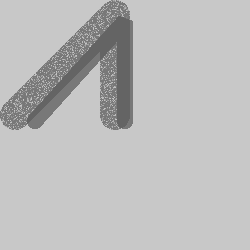
Fonction définie par l'utilisateur avec arguments supplémentaires et plusieurs bandes issus du même raster
Voir aussi
ST_MapAlgebraExpr, ST_BandPixelType, ST_GeoReference, ST_SetValue
Name
ST_MapAlgebraFctNgb — Version à 1 bande : Algèbre cartographique Plus proche voisin en utilisant une fonction PostgreSQL définie par l'utilisateur. Retourne un raster dont les valeurs sont le résultat d'une fonction utilisateur PLPGSQL prenant un voisinage des valeurs de la bande raster d'entrée.
Synopsis
raster ST_MapAlgebraFctNgb(raster rast, integer band, text pixeltype, integer ngbwidth, integer ngbheight, regprocedure onerastngbuserfunc, text nodatamode, text[] VARIADIC args);
Description
![[Warning]](images/warning.png) | |
ST_MapAlgebraFctNgb est obsolète depuis 2.1.0. Utilisez plutôt ST_MapAlgebra (callback function version). |
(version à un raster) Retourne un raster dont les valeurs sont le résultat d'une fonction utilisateur PLPGSQL prenant un voisinage de valeurs de la bande du raster d'entrée. La fonction utilisateur prend le voisinage des valeurs des pixels sous la forme d'un tableau de nombres. Pour chaque pixel, elle renvoie le résultat de la fonction utilisateur, en remplaçant la valeur du pixel actuellement traité par le résultat de la fonction utilisateur.
rastRaster sur lequel la fonction utilisateur est évaluée.
bandNuméro de bande du raster à évaluer. La valeur par défaut est 1.
pixeltypeLe type de pixel résultant du raster de sortie. Doit être l'un de ceux listés dans ST_BandPixelType, ou être omis ou défini à NULL. S'il n'est pas spécifié ou s'il est défini à NULL, le type de pixel du raster
rastsera utilisé par défaut. Les résultats sont tronqués s'ils sont plus grands que ce qui est autorisé pour le type de pixel.ngbwidthLa largeur du voisinage, en nombre de cellules.
ngbheightLa hauteur du voisinage, en nombre de cellules.
onerastngbuserfuncFonction utilisateur PLPGSQL/psql à appliquer aux pixels du voisinage de la bande du raster. Le premier élément est un tableau bidimensionnel de nombres, représentant le voisinage rectangulaire du pixel
nodatamodeDéfinit la valeur à transmettre à la fonction pour un pixel de voisinage qui est nodata ou NULL
'ignore' : toutes les valeurs NODATA rencontrées dans le voisinage sont ignorées par le calcul -- ce drapeau doit être envoyé à la fonction de rappel de l'utilisateur, et c'est la fonction de l'utilisateur qui décide comment l'ignorer.
'NULL' : toute valeur NODATA rencontrée dans le voisinage aura pour conséquence que le pixel résultant sera NULL -- la fonction de rappel de l'utilisateur est ignorée dans ce cas.
'value' : toutes les valeurs NODATA rencontrées dans le voisinage sont remplacées par le pixel de référence (celui qui se trouve au centre du voisinage). Notez que si cette valeur est NODATA, le comportement est le même que 'NULL' (pour le voisinage concerné)
argsArguments à transmettre à la fonction utilisateur.
Disponibilité : 2.0.0
Exemples
Les exemples utilisent le raster katrina chargé comme une seule tuile, tel que décrit dans https://gdal.org/user/drivers/raster/postgisraster.html et ensuite traitée dans les exemples ST_Rescale
--
-- A simple 'callback' user function that averages up all the values in a neighborhood.
--
CREATE OR REPLACE FUNCTION rast_avg(matrix float[][], nodatamode text, variadic args text[])
RETURNS float AS
$$
DECLARE
_matrix float[][];
x1 integer;
x2 integer;
y1 integer;
y2 integer;
sum float;
BEGIN
_matrix := matrix;
sum := 0;
FOR x in array_lower(matrix, 1)..array_upper(matrix, 1) LOOP
FOR y in array_lower(matrix, 2)..array_upper(matrix, 2) LOOP
sum := sum + _matrix[x][y];
END LOOP;
END LOOP;
RETURN (sum*1.0/(array_upper(matrix,1)*array_upper(matrix,2) ))::integer ;
END;
$$
LANGUAGE 'plpgsql' IMMUTABLE COST 1000;
-- now we apply to our raster averaging pixels within 2 pixels of each other in X and Y direction --
SELECT ST_MapAlgebraFctNgb(rast, 1, '8BUI', 4,4,
'rast_avg(float[][], text, text[])'::regprocedure, 'NULL', NULL) As nn_with_border
FROM katrinas_rescaled
limit 1;
|
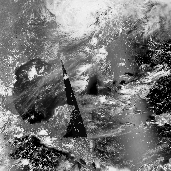 Première bande du raster
|
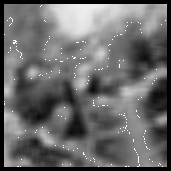 nouveau raster après calcul de la moyenne des pixels situés à moins de 4x4 pixels les uns des autres
|
Voir aussi
Name
ST_Reclass — Crée un nouveau raster composé de types de bandes reclassifiés par rapport à l'original. La bande n est la bande à modifier. Si nband n'est pas spécifié, la bande 1 est utilisée. Toutes les autres bandes sont retournées inchangées. Cas d'utilisation : convertir une bande 16BUI en 8BUI et ainsi de suite pour un rendu plus simple en tant que formats visualisables.
Synopsis
raster ST_Reclass(raster rast, integer nband, text reclassexpr, text pixeltype, double precision nodataval=NULL);
raster ST_Reclass(raster rast, reclassarg[] VARIADIC reclassargset);
raster ST_Reclass(raster rast, text reclassexpr, text pixeltype);
Description
Creates a new raster formed by applying a reclassification operation defined by the reclassexpr on the input raster (rast). Refer to reclassarg for the description of reclassification expressions. If no band is specified band 1 is assumed.
The new raster will have the same georeference, width, and height as the original raster. The bands of the new raster have pixel type of pixeltype. If reclassargset is specified then each reclassarg defines the type of the target band. Bands not designated are returned unchanged.
Disponibilité : 2.0.0
Example: Basic
Crée un nouveau raster à partir de l'original où la bande 2 est convertie de 8BUI à 4BUI et où toutes les valeurs entre 101 et 254 sont fixées à nodata.
ALTER TABLE dummy_rast ADD COLUMN reclass_rast raster;
UPDATE dummy_rast SET reclass_rast = ST_Reclass(rast,2,'0-87:1-10, 88-100:11-15, 101-254:0-0', '4BUI',0) WHERE rid = 2;
SELECT i as col, j as row, ST_Value(rast,2,i,j) As origval,
ST_Value(reclass_rast, 2, i, j) As reclassval,
ST_Value(reclass_rast, 2, i, j, false) As reclassval_include_nodata
FROM dummy_rast CROSS JOIN generate_series(1, 3) AS i CROSS JOIN generate_series(1,3) AS j
WHERE rid = 2;
col | row | origval | reclassval | reclassval_include_nodata
-----+-----+---------+------------+---------------------------
1 | 1 | 78 | 9 | 9
2 | 1 | 98 | 14 | 14
3 | 1 | 122 | | 0
1 | 2 | 96 | 14 | 14
2 | 2 | 118 | | 0
3 | 2 | 180 | | 0
1 | 3 | 99 | 15 | 15
2 | 3 | 112 | | 0
3 | 3 | 169 | | 0
Exemple avancé : utiliser plusieurs reclassargs
Crée un nouveau raster à partir de l'original où les bandes 1, 2, 3 sont respectivement converties en 1BB, 4BUI, 4BUI et reclassifiées. Cette opération utilise l'argument variadique reclassarg qui peut prendre en entrée un nombre variable de reclassargs (théoriquement autant de bandes que vous avez)
UPDATE dummy_rast SET reclass_rast =
ST_Reclass(rast,
ROW(2,'0-87]:1-10, (87-100]:11-15, (101-254]:0-0', '4BUI',NULL)::reclassarg,
ROW(1,'0-253]:1, 254:0', '1BB', NULL)::reclassarg,
ROW(3,'0-70]:1, (70-86:2, [86-150):3, [150-255:4', '4BUI', NULL)::reclassarg
) WHERE rid = 2;
SELECT i as col, j as row,ST_Value(rast,1,i,j) As ov1, ST_Value(reclass_rast, 1, i, j) As rv1,
ST_Value(rast,2,i,j) As ov2, ST_Value(reclass_rast, 2, i, j) As rv2,
ST_Value(rast,3,i,j) As ov3, ST_Value(reclass_rast, 3, i, j) As rv3
FROM dummy_rast CROSS JOIN generate_series(1, 3) AS i CROSS JOIN generate_series(1,3) AS j
WHERE rid = 2;
col | row | ov1 | rv1 | ov2 | rv2 | ov3 | rv3
----+-----+-----+-----+-----+-----+-----+-----
1 | 1 | 253 | 1 | 78 | 9 | 70 | 1
2 | 1 | 254 | 0 | 98 | 14 | 86 | 3
3 | 1 | 253 | 1 | 122 | 0 | 100 | 3
1 | 2 | 253 | 1 | 96 | 14 | 80 | 2
2 | 2 | 254 | 0 | 118 | 0 | 108 | 3
3 | 2 | 254 | 0 | 180 | 0 | 162 | 4
1 | 3 | 250 | 1 | 99 | 15 | 90 | 3
2 | 3 | 254 | 0 | 112 | 0 | 108 | 3
3 | 3 | 254 | 0 | 169 | 0 | 175 | 4
Exemple avancé : Mapping d'un raster 32BF à bande unique en plusieurs bandes visualisables
Crée un nouveau raster à 3 bandes (8BUI, 8BUI, 8BUI visualisable) à partir d'un raster qui n'a qu'une seule bande de 32bf
ALTER TABLE wind ADD COLUMN rast_view raster;
UPDATE wind
set rast_view = ST_AddBand( NULL,
ARRAY[
ST_Reclass(rast, 1,'0.1-10]:1-10,9-10]:11,(11-33:0'::text, '8BUI'::text,0),
ST_Reclass(rast,1, '11-33):0-255,[0-32:0,(34-1000:0'::text, '8BUI'::text,0),
ST_Reclass(rast,1,'0-32]:0,(32-100:100-255'::text, '8BUI'::text,0)
]
);
Voir aussi
ST_AddBand, ST_Band, ST_BandPixelType, ST_MakeEmptyRaster, reclassarg, ST_Value
Name
ST_ReclassExact — Creates a new raster composed of bands reclassified from original, using a 1:1 mapping from values in the original band to new values in the destination band.
Synopsis
raster ST_ReclassExact(raster rast, double precision[] inputvalues, double precision[] outputvalues, integer bandnumber=1, text pixeltype=32BF, double precision nodatavalue=NULL);
Description
Creates a new raster formed by applying a reclassification operation defined by the inputvalues and outputvalues arrays. Pixel values found in the input array are mapped to the corresponding value in the output array. All other pixel values are mapped to the nodatavalue.
The output pixel type defaults to float, but can be specified using the pixeltype parameter. If no bandnumber is specified band 1 is assumed.
The new raster will have the same georeference, width, and height as the original raster. Bands not designated are returned unchanged.
Disponibilité : 3.6.0
Example: Basic
Create a small raster and map its pixels to new values.
CREATE TABLE reclassexact (
id integer,
rast raster
);
--
-- Create a raster with just four pixels
-- [1 2]
-- [3 4]
--
INSERT INTO reclassexact (id, rast)
SELECT 1, ST_SetValues(
ST_AddBand(
ST_MakeEmptyRaster(
2, -- width in pixels
2, -- height in pixels
0, -- upper-left x-coordinate
0, -- upper-left y-coordinate
1, -- pixel size in x-direction
-1, -- pixel size in y-direction (negative for north-up)
0, -- skew in x-direction
0, -- skew in y-direction
4326 -- SRID (e.g., WGS 84)
),
'32BUI'::text, -- pixel type (e.g., '32BF' for float, '8BUI' for unsigned 8-bit int)
0.0, -- initial value for the band (e.g., 0.0 or a no-data value)
-99 -- nodatavalue
),
1, -- band number (usually 1 for single-band rasters)
1, -- x origin for setting values (usually 1)
1, -- y origin for setting values (usually 1)
ARRAY[
ARRAY[1, 2],
ARRAY[3, 4]
]::double precision[][] -- 2D array of values
);
-- Reclass the values to new values
-- and dump the values of the new raster for display
WITH rc AS (
SELECT ST_ReclassExact(
rast, -- input raster
ARRAY[4,3,2,1], -- input map
ARRAY[14,13,12,11], -- output map
1, -- band number to remap
'32BUI' -- output raster pixtype
) AS rast
FROM reclassexact
WHERE id = 1
)
SELECT 'rce-1', (ST_DumpValues(rc.rast)).*
FROM rc;
Voir aussi
Name
ST_Union — Retourne l'union d'un ensemble de tuiles raster, en un seul raster composé de 1 ou plusieurs bandes.
Synopsis
raster ST_Union(setof raster rast);
raster ST_Union(setof raster rast, unionarg[] unionargset);
raster ST_Union(setof raster rast, integer nband);
raster ST_Union(setof raster rast, text uniontype);
raster ST_Union(setof raster rast, integer nband, text uniontype);
Description
Retourne l'union d'un ensemble de tuiles raster en un seul raster, composé d'au moins une bande. L'étendue du raster résultant est l'étendue de l'ensemble. Dans le cas d'une intersection, la valeur résultante est définie par uniontype parmi : LAST (par défaut), FIRST, MIN, MAX, COUNT, SUM, MEAN, RANGE.
![[Note]](images/note.png) | |
Pour pouvoir calculer l'union de raster, tous les rasters doivent avoir le même alignement. Voir ST_SameAlignment et ST_NotSameAlignmentReason pour plus de détails. Une façon de résoudre les problèmes d'alignement est d'utiliser ST_Resample et d'utiliser le même raster de référence pour l'alignement. |
Disponibilité : 2.0.0
Amélioration : 2.1.0 Vitesse améliorée (entièrement en C).
Disponibilité : 2.1.0 Ajout de la variante ST_Union(rast, unionarg).
Amélioration : 2.1.0 ST_Union(rast) (variante 1) permet l'union sur toutes les bandes de tous les rasters d'entrée. Les versions précédentes de PostGIS ne prenaient en compte que la première bande.
Amélioration : 2.1.0 ST_Union(rast, uniontype) (variante 4) permet l'union de toutes les bandes de tous les rasters d'entrée.
Exemples : Reconstituer une tuile raster à partir d'une tuile raster fragmentée d'une seule bande
-- this creates a single band from first band of raster tiles
-- that form the original file system tile
SELECT filename, ST_Union(rast,1) As file_rast
FROM sometable WHERE filename IN('dem01', 'dem02') GROUP BY filename;
Exemples : Retourne un raster multi-bandes qui est l'union de tuiles intersectant une géométrie
-- this creates a multi band raster collecting all the tiles that intersect a line
-- Note: In 2.0, this would have just returned a single band raster
-- , new union works on all bands by default
-- this is equivalent to unionarg: ARRAY[ROW(1, 'LAST'), ROW(2, 'LAST'), ROW(3, 'LAST')]::unionarg[]
SELECT ST_Union(rast)
FROM aerials.boston
WHERE ST_Intersects(rast, ST_GeomFromText('LINESTRING(230486 887771, 230500 88772)',26986) );
Exemples : Retourne un raster multi-bandes qui est l'union de tuiles intersectant une géométrie
Nous utilisons ici la syntaxe plus longue si nous ne voulons qu'un sous-ensemble de bandes ou si nous voulons changer l'ordre des bandes
-- this creates a multi band raster collecting all the tiles that intersect a line
SELECT ST_Union(rast,ARRAY[ROW(2, 'LAST'), ROW(1, 'LAST'), ROW(3, 'LAST')]::unionarg[])
FROM aerials.boston
WHERE ST_Intersects(rast, ST_GeomFromText('LINESTRING(230486 887771, 230500 88772)',26986) );
Voir aussi
11.13. Fonctions de rappel intégrées d'algèbre cartographique
- ST_Distinct4ma — Fonction de traitement des données raster qui calcule le nombre de valeurs de pixels uniques dans un voisinage.
- ST_InvDistWeight4ma — Fonction de traitement des données raster qui interpole la valeur d'un pixel à partir de son voisinage.
- ST_Max4ma — Fonction de traitement des données raster qui calcule la valeur maximale d'un pixel dans un voisinage.
- ST_Mean4ma — Fonction de traitement des données raster qui calcule la valeur moyenne d'un pixel dans un voisinage.
- ST_Min4ma — Fonction de traitement des données raster qui calcule la valeur minimale d'un pixel dans un voisinage.
- ST_MinDist4ma — Fonction de traitement des données raster qui renvoie la distance minimale (en nombre de pixels) entre le pixel d'intérêt et un pixel voisin ayant une valeur.
- ST_Range4ma — Fonction de traitement des données raster qui calcule la plage de valeurs des pixels dans un voisinage.
- ST_StdDev4ma — Fonction de traitement des données raster qui calcule l'écart type des valeurs des pixels dans un voisinage.
- ST_Sum4ma — Fonction de traitement des données raster qui calcule la somme de toutes les valeurs de pixels dans un voisinage.
Name
ST_Distinct4ma — Fonction de traitement des données raster qui calcule le nombre de valeurs de pixels uniques dans un voisinage.
Synopsis
float8 ST_Distinct4ma(float8[][] matrix, text nodatamode, text[] VARIADIC args);
double precision ST_Distinct4ma(double precision[][][] value, integer[][] pos, text[] VARIADIC userargs);
Description
Calcule le nombre de valeurs de pixels uniques dans un voisinage de pixels.
![[Note]](images/note.png) | |
La variante 1 est une fonction de rappel spécialisée à utiliser comme paramètre de rappel pour ST_MapAlgebraFctNgb. |
![[Note]](images/note.png) | |
La variante 2 est une fonction de rappel spécialisée à utiliser comme paramètre de rappel pour ST_MapAlgebra (callback function version). |
![[Warning]](images/warning.png) | |
L'utilisation de la variante 1 est non recommandée, ST_MapAlgebraFctNgb étant dépréciée depuis 2.1.0. |
Disponibilité : 2.0.0
Amélioration : 2.1.0 Ajout de la variante 2
Exemples
SELECT
rid,
st_value(
st_mapalgebrafctngb(rast, 1, NULL, 1, 1, 'st_distinct4ma(float[][],text,text[])'::regprocedure, 'ignore', NULL), 2, 2
)
FROM dummy_rast
WHERE rid = 2;
rid | st_value
-----+----------
2 | 3
(1 row)
Name
ST_InvDistWeight4ma — Fonction de traitement des données raster qui interpole la valeur d'un pixel à partir de son voisinage.
Synopsis
double precision ST_InvDistWeight4ma(double precision[][][] value, integer[][] pos, text[] VARIADIC userargs);
Description
Calcule une valeur interpolée pour un pixel en utilisant la méthode de la distance inverse pondérée.
Deux paramètres facultatifs peuvent être fournis par l'intermédiaire de userargs. Le premier paramètre est le facteur de puissance (variable k dans l'équation ci-dessous) entre 0 et 1, utilisé dans l'équation de la pondération de la distance inverse. S'il n'est pas spécifié, la valeur par défaut est 1. Le second paramètre est le pourcentage de pondération, appliqué uniquement lorsque la valeur du pixel d'intérêt est incluse dans la valeur interpolée du voisinage. S'il n'est pas spécifié et que le pixel d'intérêt a une valeur, cette valeur est retournée.
L'équation de base de la distance inverse pondérée est :
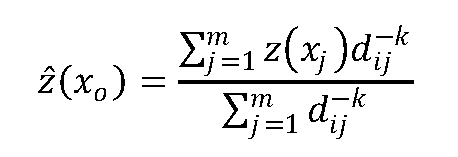
k = facteur de puissance, un nombre réel entre 0 et 1
![[Note]](images/note.png) | |
Cette fonction est une fonction de rappel spécialisée à utiliser comme paramètre de rappel pour ST_MapAlgebra (callback function version). |
Disponibilité : 2.1.0
Exemples
-- NEEDS EXAMPLE
Name
ST_Max4ma — Fonction de traitement des données raster qui calcule la valeur maximale d'un pixel dans un voisinage.
Synopsis
float8 ST_Max4ma(float8[][] matrix, text nodatamode, text[] VARIADIC args);
double precision ST_Max4ma(double precision[][][] value, integer[][] pos, text[] VARIADIC userargs);
Description
Calcule la valeur maximale d'un pixel dans un voisinage de pixels.
Pour la variante 2, une valeur de substitution pour les pixels NODATA peut être spécifiée en passant cette valeur à userargs.
![[Note]](images/note.png) | |
La variante 1 est une fonction de rappel spécialisée à utiliser comme paramètre de rappel pour ST_MapAlgebraFctNgb. |
![[Note]](images/note.png) | |
La variante 2 est une fonction de rappel spécialisée à utiliser comme paramètre de rappel pour ST_MapAlgebra (callback function version). |
![[Warning]](images/warning.png) | |
L'utilisation de la variante 1 est non recommandée, ST_MapAlgebraFctNgb étant dépréciée depuis 2.1.0. |
Disponibilité : 2.0.0
Amélioration : 2.1.0 Ajout de la variante 2
Exemples
SELECT
rid,
st_value(
st_mapalgebrafctngb(rast, 1, NULL, 1, 1, 'st_max4ma(float[][],text,text[])'::regprocedure, 'ignore', NULL), 2, 2
)
FROM dummy_rast
WHERE rid = 2;
rid | st_value
-----+----------
2 | 254
(1 row)
Name
ST_Mean4ma — Fonction de traitement des données raster qui calcule la valeur moyenne d'un pixel dans un voisinage.
Synopsis
float8 ST_Mean4ma(float8[][] matrix, text nodatamode, text[] VARIADIC args);
double precision ST_Mean4ma(double precision[][][] value, integer[][] pos, text[] VARIADIC userargs);
Description
Calcule la valeur moyenne d'un pixel dans un voisinage de pixels.
Pour la variante 2, une valeur de substitution pour les pixels NODATA peut être spécifiée en passant cette valeur à userargs.
![[Note]](images/note.png) | |
La variante 1 est une fonction de rappel spécialisée à utiliser comme paramètre de rappel pour ST_MapAlgebraFctNgb. |
![[Note]](images/note.png) | |
La variante 2 est une fonction de rappel spécialisée à utiliser comme paramètre de rappel pour ST_MapAlgebra (callback function version). |
![[Warning]](images/warning.png) | |
L'utilisation de la variante 1 est non recommandée, ST_MapAlgebraFctNgb étant dépréciée depuis 2.1.0. |
Disponibilité : 2.0.0
Amélioration : 2.1.0 Ajout de la variante 2
Exemples : Variante 1
SELECT
rid,
st_value(
st_mapalgebrafctngb(rast, 1, '32BF', 1, 1, 'st_mean4ma(float[][],text,text[])'::regprocedure, 'ignore', NULL), 2, 2
)
FROM dummy_rast
WHERE rid = 2;
rid | st_value
-----+------------------
2 | 253.222229003906
(1 row)
Exemples : Variante 2
SELECT
rid,
st_value(
ST_MapAlgebra(rast, 1, 'st_mean4ma(double precision[][][], integer[][], text[])'::regprocedure,'32BF', 'FIRST', NULL, 1, 1)
, 2, 2)
FROM dummy_rast
WHERE rid = 2;
rid | st_value
-----+------------------
2 | 253.222229003906
(1 row)Name
ST_Min4ma — Fonction de traitement des données raster qui calcule la valeur minimale d'un pixel dans un voisinage.
Synopsis
float8 ST_Min4ma(float8[][] matrix, text nodatamode, text[] VARIADIC args);
double precision ST_Min4ma(double precision[][][] value, integer[][] pos, text[] VARIADIC userargs);
Description
Calcule la valeur minimale d'un pixel dans un voisinage de pixels.
Pour la variante 2, une valeur de substitution pour les pixels NODATA peut être spécifiée en passant cette valeur à userargs.
![[Note]](images/note.png) | |
La variante 1 est une fonction de rappel spécialisée à utiliser comme paramètre de rappel pour ST_MapAlgebraFctNgb. |
![[Note]](images/note.png) | |
La variante 2 est une fonction de rappel spécialisée à utiliser comme paramètre de rappel pour ST_MapAlgebra (callback function version). |
![[Warning]](images/warning.png) | |
L'utilisation de la variante 1 est non recommandée, ST_MapAlgebraFctNgb étant dépréciée depuis 2.1.0. |
Disponibilité : 2.0.0
Amélioration : 2.1.0 Ajout de la variante 2
Exemples
SELECT
rid,
st_value(
st_mapalgebrafctngb(rast, 1, NULL, 1, 1, 'st_min4ma(float[][],text,text[])'::regprocedure, 'ignore', NULL), 2, 2
)
FROM dummy_rast
WHERE rid = 2;
rid | st_value
-----+----------
2 | 250
(1 row)
Name
ST_MinDist4ma — Fonction de traitement des données raster qui renvoie la distance minimale (en nombre de pixels) entre le pixel d'intérêt et un pixel voisin ayant une valeur.
Synopsis
double precision ST_MinDist4ma(double precision[][][] value, integer[][] pos, text[] VARIADIC userargs);
Description
Retourne la plus petite distance (en nombre de pixels) entre le pixel d'intérêt et le pixel le plus proche ayant une valeur dans le voisinage.
![[Note]](images/note.png) | |
Le but de cette fonction est de fournir un point de données informatif qui aide à déduire l'utilité de la valeur interpolée du pixel d'intérêt à partir de ST_InvDistWeight4ma. Cette fonction est particulièrement utile lorsque le voisinage est peu peuplé. |
![[Note]](images/note.png) | |
Cette fonction est une fonction de rappel spécialisée à utiliser comme paramètre de rappel pour ST_MapAlgebra (callback function version). |
Disponibilité : 2.1.0
Exemples
-- NEEDS EXAMPLE
Name
ST_Range4ma — Fonction de traitement des données raster qui calcule la plage de valeurs des pixels dans un voisinage.
Synopsis
float8 ST_Range4ma(float8[][] matrix, text nodatamode, text[] VARIADIC args);
double precision ST_Range4ma(double precision[][][] value, integer[][] pos, text[] VARIADIC userargs);
Description
Calcule la plage de valeurs des pixels dans un voisinage de pixels.
Pour la variante 2, une valeur de substitution pour les pixels NODATA peut être spécifiée en passant cette valeur à userargs.
![[Note]](images/note.png) | |
La variante 1 est une fonction de rappel spécialisée à utiliser comme paramètre de rappel pour ST_MapAlgebraFctNgb. |
![[Note]](images/note.png) | |
La variante 2 est une fonction de rappel spécialisée à utiliser comme paramètre de rappel pour ST_MapAlgebra (callback function version). |
![[Warning]](images/warning.png) | |
L'utilisation de la variante 1 est non recommandée, ST_MapAlgebraFctNgb étant dépréciée depuis 2.1.0. |
Disponibilité : 2.0.0
Amélioration : 2.1.0 Ajout de la variante 2
Exemples
SELECT
rid,
st_value(
st_mapalgebrafctngb(rast, 1, NULL, 1, 1, 'st_range4ma(float[][],text,text[])'::regprocedure, 'ignore', NULL), 2, 2
)
FROM dummy_rast
WHERE rid = 2;
rid | st_value
-----+----------
2 | 4
(1 row)
Name
ST_StdDev4ma — Fonction de traitement des données raster qui calcule l'écart type des valeurs des pixels dans un voisinage.
Synopsis
float8 ST_StdDev4ma(float8[][] matrix, text nodatamode, text[] VARIADIC args);
double precision ST_StdDev4ma(double precision[][][] value, integer[][] pos, text[] VARIADIC userargs);
Description
Calcule l'écart type des valeurs des pixels dans un voisinage de pixels.
![[Note]](images/note.png) | |
La variante 1 est une fonction de rappel spécialisée à utiliser comme paramètre de rappel pour ST_MapAlgebraFctNgb. |
![[Note]](images/note.png) | |
La variante 2 est une fonction de rappel spécialisée à utiliser comme paramètre de rappel pour ST_MapAlgebra (callback function version). |
![[Warning]](images/warning.png) | |
L'utilisation de la variante 1 est non recommandée, ST_MapAlgebraFctNgb étant dépréciée depuis 2.1.0. |
Disponibilité : 2.0.0
Amélioration : 2.1.0 Ajout de la variante 2
Exemples
SELECT
rid,
st_value(
st_mapalgebrafctngb(rast, 1, '32BF', 1, 1, 'st_stddev4ma(float[][],text,text[])'::regprocedure, 'ignore', NULL), 2, 2
)
FROM dummy_rast
WHERE rid = 2;
rid | st_value
-----+------------------
2 | 1.30170822143555
(1 row)
Name
ST_Sum4ma — Fonction de traitement des données raster qui calcule la somme de toutes les valeurs de pixels dans un voisinage.
Synopsis
float8 ST_Sum4ma(float8[][] matrix, text nodatamode, text[] VARIADIC args);
double precision ST_Sum4ma(double precision[][][] value, integer[][] pos, text[] VARIADIC userargs);
Description
Calcule la somme de toutes les valeurs des pixels dans un voisinage de pixels.
Pour la variante 2, une valeur de substitution pour les pixels NODATA peut être spécifiée en passant cette valeur à userargs.
![[Note]](images/note.png) | |
La variante 1 est une fonction de rappel spécialisée à utiliser comme paramètre de rappel pour ST_MapAlgebraFctNgb. |
![[Note]](images/note.png) | |
La variante 2 est une fonction de rappel spécialisée à utiliser comme paramètre de rappel pour ST_MapAlgebra (callback function version). |
![[Warning]](images/warning.png) | |
L'utilisation de la variante 1 est non recommandée, ST_MapAlgebraFctNgb étant dépréciée depuis 2.1.0. |
Disponibilité : 2.0.0
Amélioration : 2.1.0 Ajout de la variante 2
Exemples
SELECT
rid,
st_value(
st_mapalgebrafctngb(rast, 1, '32BF', 1, 1, 'st_sum4ma(float[][],text,text[])'::regprocedure, 'ignore', NULL), 2, 2
)
FROM dummy_rast
WHERE rid = 2;
rid | st_value
-----+----------
2 | 2279
(1 row)
11.14. Traitement des données raster : MNT (élévation)
- ST_Aspect — Retourne l'exposition (par défaut, en degrés) d'une bande raster d'élévation. Utile pour l'analyse de terrain.
- ST_HillShade — Retourne l'hypothétique éclairage d'une bande raster d'élévation en utilisant les valeurs d'azimut, d'altitude, de luminosité et d'échelle fournies.
- ST_Roughness — Retourne un raster avec la rugosité d'un MNT.
- ST_Slope — Retourne la pente (par défaut, en degrés) d'une bande raster d'élévation. Utile pour l'analyse de terrain.
- ST_TPI — Retourne un raster avec l'index de position topographique (TPI) calculé.
- ST_TRI — Retourne un raster avec l'indice de rugosité du terrain (TRI) calculé.
- ST_InterpolateRaster — Interpole une surface quadrillée à partir d'un ensemble de points 3-d, en utilisant les coordonnées X et Y des points sur la grille et la coordonnée Z des points pour l'élévation des points.
- ST_Contour — Génère un ensemble de courbes de niveau vectorielles depuis la bande raster spécifiée, en utilisant l'algorithme de contour GDAL.
Name
ST_Aspect — Retourne l'exposition (par défaut, en degrés) d'une bande raster d'élévation. Utile pour l'analyse de terrain.
Synopsis
raster ST_Aspect(raster rast, integer band=1, text pixeltype=32BF, text units=DEGREES, boolean interpolate_nodata=FALSE);
raster ST_Aspect(raster rast, integer band, raster customextent, text pixeltype=32BF, text units=DEGREES, boolean interpolate_nodata=FALSE);
Description
Retourne l'exposition (par défaut, en degrés) d'une bande raster d'élévation. Utilise l'algèbre cartographique et applique l'équation d'exposition aux pixels voisins.
units indique l'unité de l'exposition. Les valeurs possibles sont : RADIANS, DEGREES (par défaut).
Lorsque units = RADIANS, les valeurs sont comprises entre 0 et 2 * pi radians, mesurés dans le sens des aiguilles d'une montre à partir du nord.
Lorsque units = DEGREES, les valeurs sont comprises entre 0 et 360 degrés, mesurés dans le sens des aiguilles d'une montre à partir du nord.
Si la pente du pixel est nulle, l'exposition du pixel est -1.
![[Note]](images/note.png) | |
Pour plus d'informations sur la pente, l'exposition et l'ombrage, veuillez consulter ESRI - How hillshade works et ERDAS Field Guide - Aspect Images. |
Disponibilité : 2.0.0
Amélioration : 2.1.0 Utilise ST_MapAlgebra() et ajout du paramètre optionnel interpolate_nodata
Changement : 2.1.0 Dans les versions précédentes, les valeurs retournées étaient en radians. Désormais, les valeurs retournées sont par défaut en degrés
Exemples : Variante 1
WITH foo AS (
SELECT ST_SetValues(
ST_AddBand(ST_MakeEmptyRaster(5, 5, 0, 0, 1, -1, 0, 0, 0), 1, '32BF', 0, -9999),
1, 1, 1, ARRAY[
[1, 1, 1, 1, 1],
[1, 2, 2, 2, 1],
[1, 2, 3, 2, 1],
[1, 2, 2, 2, 1],
[1, 1, 1, 1, 1]
]::double precision[][]
) AS rast
)
SELECT
ST_DumpValues(ST_Aspect(rast, 1, '32BF'))
FROM foo
st_dumpvalues
------------------------------------------------------------------------------------------------------------------------------------------------------------------------------------
----------------------------------
(1,"{{315,341.565063476562,0,18.4349479675293,45},{288.434936523438,315,0,45,71.5650482177734},{270,270,-1,90,90},{251.565048217773,225,180,135,108.434951782227},{225,198.43495178
2227,180,161.565048217773,135}}")
(1 row)
Exemples : Variante 2
Complete example of tiles of a coverage.
WITH foo AS (
SELECT ST_Tile(
ST_SetValues(
ST_AddBand(
ST_MakeEmptyRaster(6, 6, 0, 0, 1, -1, 0, 0, 0),
1, '32BF', 0, -9999
),
1, 1, 1, ARRAY[
[1, 1, 1, 1, 1, 1],
[1, 1, 1, 1, 2, 1],
[1, 2, 2, 3, 3, 1],
[1, 1, 3, 2, 1, 1],
[1, 2, 2, 1, 2, 1],
[1, 1, 1, 1, 1, 1]
]::double precision[]
),
2, 2
) AS rast
)
SELECT
t1.rast,
ST_Aspect(ST_Union(t2.rast), 1, t1.rast)
FROM foo t1
CROSS JOIN foo t2
WHERE ST_Intersects(t1.rast, t2.rast)
GROUP BY t1.rast;
Name
ST_HillShade — Retourne l'hypothétique éclairage d'une bande raster d'élévation en utilisant les valeurs d'azimut, d'altitude, de luminosité et d'échelle fournies.
Synopsis
raster ST_HillShade(raster rast, integer band=1, text pixeltype=32BF, double precision azimuth=315, double precision altitude=45, double precision max_bright=255, double precision scale=1.0, boolean interpolate_nodata=FALSE);
raster ST_HillShade(raster rast, integer band, raster customextent, text pixeltype=32BF, double precision azimuth=315, double precision altitude=45, double precision max_bright=255, double precision scale=1.0, boolean interpolate_nodata=FALSE);
Description
Retourne l'hypothétique éclairage d'une bande raster d'élévation en utilisant les données d'entrée d'azimut, d'altitude, de luminosité et d'échelle. Utilise l'algèbre cartographique et applique l'équation d'ombrage aux pixels voisins. Les valeurs des pixels retournées sont comprises entre 0 et 255.
azimuth est une valeur comprise entre 0 et 360 degrés, mesurée dans le sens des aiguilles d'une montre à partir du nord.
altitude est une valeur comprise entre 0 et 90 degrés, où 0 degré correspond à l'horizon et 90 degrés à la verticale.
max_bright est une valeur comprise entre 0 et 255, 0 correspondant à une absence de luminosité et 255 à une luminosité maximale.
scale est le rapport entre les unités verticales et les unités horizontales. Pour Feet:LatLon, utiliser scale=370400, pour Meters:LatLon utiliser scale=111120.
Si interpolate_nodata est TRUE, les valeurs des pixels NODATA du raster d'entrée seront interpolées à l'aide de ST_InvDistWeight4ma avant de calculer l'éclairage.
![[Note]](images/note.png) | |
Pour plus d'informations sur l'ombrage, veuillez consulter How hillshade works. |
Disponibilité : 2.0.0
Amélioration : 2.1.0 Utilise ST_MapAlgebra() et ajout du paramètre optionnel interpolate_nodata
Changement : 2.1.0 Dans les versions précédentes, l'azimut et l'altitude étaient exprimés en radians. Désormais, l'azimut et l'altitude sont exprimés en degrés
Exemples : Variante 1
WITH foo AS (
SELECT ST_SetValues(
ST_AddBand(ST_MakeEmptyRaster(5, 5, 0, 0, 1, -1, 0, 0, 0), 1, '32BF', 0, -9999),
1, 1, 1, ARRAY[
[1, 1, 1, 1, 1],
[1, 2, 2, 2, 1],
[1, 2, 3, 2, 1],
[1, 2, 2, 2, 1],
[1, 1, 1, 1, 1]
]::double precision[][]
) AS rast
)
SELECT
ST_DumpValues(ST_Hillshade(rast, 1, '32BF'))
FROM foo
st_dumpvalues
------------------------------------------------------------------------------------------------------------------------------------------------------------------------------------
-----------------------------------------------------------------------
(1,"{{NULL,NULL,NULL,NULL,NULL},{NULL,251.32763671875,220.749786376953,147.224319458008,NULL},{NULL,220.749786376953,180.312225341797,67.7497863769531,NULL},{NULL,147.224319458008
,67.7497863769531,43.1210060119629,NULL},{NULL,NULL,NULL,NULL,NULL}}")
(1 row)
Exemples : Variante 2
Complete example of tiles of a coverage.
WITH foo AS (
SELECT ST_Tile(
ST_SetValues(
ST_AddBand(
ST_MakeEmptyRaster(6, 6, 0, 0, 1, -1, 0, 0, 0),
1, '32BF', 0, -9999
),
1, 1, 1, ARRAY[
[1, 1, 1, 1, 1, 1],
[1, 1, 1, 1, 2, 1],
[1, 2, 2, 3, 3, 1],
[1, 1, 3, 2, 1, 1],
[1, 2, 2, 1, 2, 1],
[1, 1, 1, 1, 1, 1]
]::double precision[]
),
2, 2
) AS rast
)
SELECT
t1.rast,
ST_Hillshade(ST_Union(t2.rast), 1, t1.rast)
FROM foo t1
CROSS JOIN foo t2
WHERE ST_Intersects(t1.rast, t2.rast)
GROUP BY t1.rast;
Name
ST_Roughness — Retourne un raster avec la rugosité d'un MNT.
Synopsis
raster ST_Roughness(raster rast, integer nband, raster customextent, text pixeltype="32BF" , boolean interpolate_nodata=FALSE );
Description
Calcule la rugosité d'un MNT en soustrayant le maximum du minimum pour une zone donnée.
Disponibilité : 2.1.0
Exemples
-- needs examples
Name
ST_Slope — Retourne la pente (par défaut, en degrés) d'une bande raster d'élévation. Utile pour l'analyse de terrain.
Synopsis
raster ST_Slope(raster rast, integer nband=1, text pixeltype=32BF, text units=DEGREES, double precision scale=1.0, boolean interpolate_nodata=FALSE);
raster ST_Slope(raster rast, integer nband, raster customextent, text pixeltype=32BF, text units=DEGREES, double precision scale=1.0, boolean interpolate_nodata=FALSE);
Description
Retourne la pente (par défaut, en degrés) d'une bande raster d'élévation. Utilise l'algèbre cartographique et applique l'équation de pente aux pixels voisins.
units indique l'unité de la pente. Les valeurs possibles sont : RADIANS, DEGREES (par défaut), PERCENT.
scale est le rapport entre les unités verticales et les unités horizontales. Pour Feet:LatLon, utiliser scale=370400, pour Meters:LatLon utiliser scale=111120.
Si interpolate_nodata est TRUE, les valeurs des pixels NODATA du raster d'entrée seront interpolées à l'aide de ST_InvDistWeight4ma avant de calculer la pente de la surface.
![[Note]](images/note.png) | |
Pour plus d'informations sur la pente, l'exposition et l'ombrage, veuillez consulter ESRI - How hillshade works et ERDAS Field Guide - Slope Images. |
Disponibilité : 2.0.0
Amélioration : 2.1.0 Utilise ST_MapAlgebra() et ajout des paramètres optionnels units, scale, interpolate_nodata
Changement : 2.1.0 Dans les versions précédentes, les valeurs retournées étaient en radians. Désormais, les valeurs retournées sont par défaut en degrés
Exemples : Variante 1
WITH foo AS (
SELECT ST_SetValues(
ST_AddBand(ST_MakeEmptyRaster(5, 5, 0, 0, 1, -1, 0, 0, 0), 1, '32BF', 0, -9999),
1, 1, 1, ARRAY[
[1, 1, 1, 1, 1],
[1, 2, 2, 2, 1],
[1, 2, 3, 2, 1],
[1, 2, 2, 2, 1],
[1, 1, 1, 1, 1]
]::double precision[][]
) AS rast
)
SELECT
ST_DumpValues(ST_Slope(rast, 1, '32BF'))
FROM foo
st_dumpvalues
------------------------------------------------------------------------------------------------------------------------------------------------------------------------------------
------------------------------------------------------------------------------------------------------------------------------------------------------------------------------------
---------------------------------------------------------------------
(1,"{{10.0249881744385,21.5681285858154,26.5650520324707,21.5681285858154,10.0249881744385},{21.5681285858154,35.2643890380859,36.8698959350586,35.2643890380859,21.5681285858154},
{26.5650520324707,36.8698959350586,0,36.8698959350586,26.5650520324707},{21.5681285858154,35.2643890380859,36.8698959350586,35.2643890380859,21.5681285858154},{10.0249881744385,21.
5681285858154,26.5650520324707,21.5681285858154,10.0249881744385}}")
(1 row)
Exemples : Variante 2
Complete example of tiles of a coverage.
WITH foo AS (
SELECT ST_Tile(
ST_SetValues(
ST_AddBand(
ST_MakeEmptyRaster(6, 6, 0, 0, 1, -1, 0, 0, 0),
1, '32BF', 0, -9999
),
1, 1, 1, ARRAY[
[1, 1, 1, 1, 1, 1],
[1, 1, 1, 1, 2, 1],
[1, 2, 2, 3, 3, 1],
[1, 1, 3, 2, 1, 1],
[1, 2, 2, 1, 2, 1],
[1, 1, 1, 1, 1, 1]
]::double precision[]
),
2, 2
) AS rast
)
SELECT
t1.rast,
ST_Slope(ST_Union(t2.rast), 1, t1.rast)
FROM foo t1
CROSS JOIN foo t2
WHERE ST_Intersects(t1.rast, t2.rast)
GROUP BY t1.rast;
Name
ST_TPI — Retourne un raster avec l'index de position topographique (TPI) calculé.
Synopsis
raster ST_TPI(raster rast, integer nband, raster customextent, text pixeltype="32BF" , boolean interpolate_nodata=FALSE );
Description
Calcule l'index de position topographique (TPI), qui est défini comme la moyenne focale avec un rayon de un moins la cellule centrale.
![[Note]](images/note.png) | |
Cette fonction ne prend en charge qu'un rayon focal de un. |
Disponibilité : 2.1.0
Exemples
-- needs examples
Name
ST_TRI — Retourne un raster avec l'indice de rugosité du terrain (TRI) calculé.
Synopsis
raster ST_TRI(raster rast, integer nband, raster customextent, text pixeltype="32BF" , boolean interpolate_nodata=FALSE );
Description
L'indice de rugosité du terrain est calculé en comparant le pixel central à ses voisins, en prenant les valeurs absolues des différences et en faisant la moyenne du résultat.
![[Note]](images/note.png) | |
Cette fonction ne prend en charge qu'un rayon focal de un. |
Disponibilité : 2.1.0
Exemples
-- needs examples
Name
ST_InterpolateRaster — Interpole une surface quadrillée à partir d'un ensemble de points 3-d, en utilisant les coordonnées X et Y des points sur la grille et la coordonnée Z des points pour l'élévation des points.
Synopsis
raster ST_InterpolateRaster(geometry input_points, text algorithm_options, raster template, integer template_band_num=1);
Description
Interpole une surface quadrillée à partir d'un ensemble de points 3-d, en utilisant les coordonnées X et Y des points sur la grille et la coordonnée Z des points pour l'élévation des points. 5 algorithmes d'interpolations sont disponibles : inverse de la distance, inverse de la distance avec plus proche voisin, moyenne mobile, plus proche voisin, et interpolation linéaire. Voir gdal_grid documentation pour plus de détails sur ces algorithmes et leurs paramètres. Pour plus d'informations sur le calcul des interpolations, voir le tutorial GDAL grid.
Les paramètres d'entrée sont :
input_pointsLes points pour effectuer l'interpolation. Toute géometrie avec une dimension Z est acceptée ; tous les points de la géométrie seront utilisés.
algorithm_optionsUne chaîne définissant l'algorithme et ses options, au format utilisable par gdal_grid. Par exemple, pour une interpolation en inverse de la distance avec un lissage de 2, la valeur sera "invdist:smoothing=2.0"
templateUn gabarit raster pour la création du raster de sortie. Les largeur, hauteur, taille des pixels, étendue spatiale et type des pixels seront définis à partir de ce gabarit.
template_band_numIndice de la bande raster du gabarit raster à utiliser ; par défaut, la première bande sera utilisée.
Disponibilité : 3.2.0
Exemple
SELECT ST_InterpolateRaster(
'MULTIPOINT(10.5 9.5 1000, 11.5 8.5 1000, 10.5 8.5 500, 11.5 9.5 500)'::geometry,
'invdist:smoothing:2.0',
ST_AddBand(ST_MakeEmptyRaster(200, 400, 10, 10, 0.01, -0.005, 0, 0), '16BSI')
)Voir aussi
Name
ST_Contour — Génère un ensemble de courbes de niveau vectorielles depuis la bande raster spécifiée, en utilisant l'algorithme de contour GDAL.
Synopsis
setof record ST_Contour(raster rast, integer bandnumber=1, double precision level_interval=100.0, double precision level_base=0.0, double precision[] fixed_levels=ARRAY[], boolean polygonize=false);
Description
Génère un ensemble de courbes de niveau vectorielles depuis la bande raster spécifiée, en utilisant l'algorithme de contour GDAL.
Si le paramètre fixed_levels est un tableau non vide, les paramètres level_interval et level_base sont ignorés.
Les paramètres d'entrée sont :
rastLe raster pour générer le contour de
bandnumberLa bande pour générer le contour de
level_intervalIntervalle d'élévation entre les courbes de niveau générées
level_baseLa "base" par rapport à laquelle les intervalles de contour sont appliqués ; elle est normalement égale à zéro, mais peut être différente. Pour générer des courbes de niveau de 10 m à 5, 15, 25, ... le LEVEL_BASE serait de 5.
fixed_levelsIntervalle d'élévation entre les courbes de niveau générées
polygonizeSi
true, des polygones de contour seront créés, plutôt que des lignes de polygone.
La valeur de retour est un ensemble de résultats avec les attributs suivants :
geomLa géométrie de la ligne de contour.
idUn identifiant unique de la ligne de contour, déterminée par GDAL.
valueLa valeur raster représentée par la ligne. Pour un modèle numérique de terrain, la valeur correspond à l'élévation du contour.
Disponibilité : 3.2.0
Exemple
WITH c AS ( SELECT (ST_Contour(rast, 1, fixed_levels => ARRAY[100.0, 200.0, 300.0])).* FROM dem_grid WHERE rid = 1 ) SELECT st_astext(geom), id, value FROM c;
Voir aussi
11.15. Traitement des données raster : raster vers géométrie
- Box3D — Retourne la représentation 3d de la boîte englobante du raster.
- ST_ConvexHull — Retourne l'enveloppe convexe du raster, en incluant les valeurs de pixels égales à BandNoDataValue. Pour les données raster de forme régulière et sans obliquité, cette fonction donne le même résultat que ST_Envelope ; elle n'est donc utile que pour les données raster de forme irrégulière ou inclinée.
- ST_DumpAsPolygons — Retourne un ensemble d'enregistrements de type geomval (geom, val), à partir d'une bande raster donnée. Si aucune bande bandnum n'est spécifiée, la bande 1 est utilisée.
- ST_Envelope — Retourne la représentation polygonale de l'étendue du raster.
- ST_MinConvexHull — Retourne la géométrie de l'enveloppe convexe du raster en excluant les pixels NODATA.
- ST_Polygon — Retourne une géométrie multipolygonale formée par l'union des pixels dont la valeur est différente de nodata. Si aucune bande bandnum n'est spécifiée, la bande 1 est utilisée.
- ST_IntersectionFractions — Calculates the fraction of each raster cell that is covered by a given geometry.
Name
Box3D — Retourne la représentation 3d de la boîte englobante du raster.
Synopsis
box3d Box3D(raster rast);
Description
Retourne la boîte représentant l'étendue du raster.
Le polygone est défini par les points des coins de la boîte englobante ((MINX, MINY), (MAXX, MAXY))
Changement : 2.0.0 Dans les versions antérieures à la version 2.0, utilisait le type box2d au lieu de box3d. Comme box2d est un type obsolète, il a été remplacé par box3d.
Exemples
SELECT
rid,
Box3D(rast) AS rastbox
FROM dummy_rast;
rid | rastbox
----+-------------------------------------------------
1 | BOX3D(0.5 0.5 0,20.5 60.5 0)
2 | BOX3D(3427927.75 5793243.5 0,3427928 5793244 0)
Voir aussi
Name
ST_ConvexHull — Retourne l'enveloppe convexe du raster, en incluant les valeurs de pixels égales à BandNoDataValue. Pour les données raster de forme régulière et sans obliquité, cette fonction donne le même résultat que ST_Envelope ; elle n'est donc utile que pour les données raster de forme irrégulière ou inclinée.
Synopsis
geometry ST_ConvexHull(raster rast);
Description
Retourne l'enveloppe convexe du raster, en incluant les valeurs de pixels égales à BandNoDataValue. Pour les données raster de forme régulière et sans obliquité, cette fonction donne plus ou moins le même résultat que ST_Envelope ; elle n'est donc utile que pour les données raster de forme irrégulière ou inclinée.
![[Note]](images/note.png) | |
ST_Envelope arrondit les coordonnées à l'inférieur, et ajoute donc un petit tampon autour du raster. La réponse est donc subtilement différente de ST_ConvexHull qui n'arrondit pas les coordonnées. |
Exemples
Voir PostGIS Raster Specification pour un diagramme de ceci.
-- Note envelope and convexhull are more or less the same
SELECT ST_AsText(ST_ConvexHull(rast)) As convhull,
ST_AsText(ST_Envelope(rast)) As env
FROM dummy_rast WHERE rid=1;
convhull | env
--------------------------------------------------------+------------------------------------
POLYGON((0.5 0.5,20.5 0.5,20.5 60.5,0.5 60.5,0.5 0.5)) | POLYGON((0 0,20 0,20 60,0 60,0 0))
-- now we skew the raster
-- note how the convex hull and envelope are now different
SELECT ST_AsText(ST_ConvexHull(rast)) As convhull,
ST_AsText(ST_Envelope(rast)) As env
FROM (SELECT ST_SetRotation(rast, 0.1, 0.1) As rast
FROM dummy_rast WHERE rid=1) As foo;
convhull | env
--------------------------------------------------------+------------------------------------
POLYGON((0.5 0.5,20.5 1.5,22.5 61.5,2.5 60.5,0.5 0.5)) | POLYGON((0 0,22 0,22 61,0 61,0 0))
Voir aussi
Name
ST_DumpAsPolygons — Retourne un ensemble d'enregistrements de type geomval (geom, val), à partir d'une bande raster donnée. Si aucune bande bandnum n'est spécifiée, la bande 1 est utilisée.
Synopsis
setof geomval ST_DumpAsPolygons(raster rast, integer band_num=1, boolean exclude_nodata_value=TRUE);
Description
Il s'agit d'une fonction de retour d'ensemble (SRF). Elle retourne un ensemble d'enregistrements geomval, composés par une géométrie (geom) et une valeur de bande de pixels (val). Chaque polygone est l'union de tous les pixels de cette bande qui ont la même valeur de pixel, indiquée par val.
ST_DumpAsPolygon est utile pour polygoniser les données raster. C'est l'inverse d'un GROUP BY, en ce sens qu'elle crée de nouvelles lignes. Par exemple, cette fonction peut être utilisée pour décomposer un seul raster en plusieurs POLYGONS/MULTIPOLYGONS.
Changement 3.3.0, la validation et la correction sont désactivées pour améliorer les performances. Peut donc retourner des géométries non valides.
Changed 3.7.0, the polygonization honours PostgreSQL interrupts so cancellations and statement timeouts halt processing promptly.
Disponibilité : Nécessite GDAL 1.7 ou plus.
![[Note]](images/note.png) | |
Si une valeur nodata est définie pour une bande, les pixels ayant cette valeur ne seront pas retournés, sauf si exclude_nodata_value=false. |
![[Note]](images/note.png) | |
Si vous ne voulez que le nombre de pixels ayant une valeur donnée dans un raster, il est plus rapide d'utiliser ST_ValueCount. |
![[Note]](images/note.png) | |
Cette fonction est différente de ST_PixelAsPolygons, où une géométrie est retournée pour chaque pixel, quelle que soit la valeur du pixel. |
Exemples
-- this syntax uses a LATERAL join
SELECT val, ST_AsText(geom) As geomwkt
FROM (
SELECT dp.*
FROM dummy_rast, LATERAL ST_DumpAsPolygons(rast) AS dp
WHERE rid = 2
) As foo
WHERE val BETWEEN 249 and 251
ORDER BY val;
val | geomwkt
-----+--------------------------------------------------------------------------
249 | POLYGON((3427927.95 5793243.95,3427927.95 5793243.85,3427928 5793243.85,
3427928 5793243.95,3427927.95 5793243.95))
250 | POLYGON((3427927.75 5793243.9,3427927.75 5793243.85,3427927.8 5793243.85,
3427927.8 5793243.9,3427927.75 5793243.9))
250 | POLYGON((3427927.8 5793243.8,3427927.8 5793243.75,3427927.85 5793243.75,
3427927.85 5793243.8, 3427927.8 5793243.8))
251 | POLYGON((3427927.75 5793243.85,3427927.75 5793243.8,3427927.8 5793243.8,
3427927.8 5793243.85,3427927.75 5793243.85))
Voir aussi
geomval, ST_AsRasterAgg, ST_Value, ST_Polygon, ST_ValueCount
Name
ST_Envelope — Retourne la représentation polygonale de l'étendue du raster.
Synopsis
geometry ST_Envelope(raster rast);
Description
Retourne la représentation polygonale de l'étendue du raster, dans les unités du système de référence spatial défini par srid. Il s'agit d'une boîte de délimitation minimale float8 représentée sous la forme d'un polygone.
Le polygone est défini par les points des coins de la boîte englobante ((MINX, MINY), (MINX, MAXY), (MAXX, MAXY), (MAXX, MINY), (MINX, MINY))
Exemples
SELECT rid, ST_AsText(ST_Envelope(rast)) As envgeomwkt
FROM dummy_rast;
rid | envgeomwkt
-----+--------------------------------------------------------------------
1 | POLYGON((0 0,20 0,20 60,0 60,0 0))
2 | POLYGON((3427927 5793243,3427928 5793243,
3427928 5793244,3427927 5793244, 3427927 5793243))
Voir aussi
Name
ST_MinConvexHull — Retourne la géométrie de l'enveloppe convexe du raster en excluant les pixels NODATA.
Synopsis
geometry ST_MinConvexHull(raster rast, integer nband=NULL);
Description
Retourne la géométrie de l'enveloppe convexe du raster en excluant les pixels NODATA. Si nband est NULL, toutes les bandes du raster sont prises en compte.
Disponibilité : 2.1.0
Exemples
WITH foo AS (
SELECT
ST_SetValues(
ST_SetValues(
ST_AddBand(ST_AddBand(ST_MakeEmptyRaster(9, 9, 0, 0, 1, -1, 0, 0, 0), 1, '8BUI', 0, 0), 2, '8BUI', 1, 0),
1, 1, 1,
ARRAY[
[0, 0, 0, 0, 0, 0, 0, 0, 0],
[0, 0, 0, 0, 0, 0, 0, 0, 0],
[0, 0, 0, 0, 0, 0, 0, 0, 0],
[0, 0, 0, 1, 0, 0, 0, 0, 1],
[0, 0, 0, 1, 1, 0, 0, 0, 0],
[0, 0, 0, 1, 0, 0, 0, 0, 0],
[0, 0, 0, 0, 0, 0, 0, 0, 0],
[0, 0, 0, 0, 0, 0, 0, 0, 0],
[0, 0, 0, 0, 0, 0, 0, 0, 0]
]::double precision[][]
),
2, 1, 1,
ARRAY[
[0, 0, 0, 0, 0, 0, 0, 0, 0],
[0, 0, 0, 0, 0, 0, 0, 0, 0],
[0, 0, 0, 0, 0, 0, 0, 0, 0],
[1, 0, 0, 0, 0, 1, 0, 0, 0],
[0, 0, 0, 0, 1, 1, 0, 0, 0],
[0, 0, 0, 0, 0, 1, 0, 0, 0],
[0, 0, 0, 0, 0, 0, 0, 0, 0],
[0, 0, 0, 0, 0, 0, 0, 0, 0],
[0, 0, 1, 0, 0, 0, 0, 0, 0]
]::double precision[][]
) AS rast
)
SELECT
ST_AsText(ST_ConvexHull(rast)) AS hull,
ST_AsText(ST_MinConvexHull(rast)) AS mhull,
ST_AsText(ST_MinConvexHull(rast, 1)) AS mhull_1,
ST_AsText(ST_MinConvexHull(rast, 2)) AS mhull_2
FROM foo
hull | mhull | mhull_1 | mhull_2
----------------------------------+-------------------------------------+-------------------------------------+-------------------------------------
POLYGON((0 0,9 0,9 -9,0 -9,0 0)) | POLYGON((0 -3,9 -3,9 -9,0 -9,0 -3)) | POLYGON((3 -3,9 -3,9 -6,3 -6,3 -3)) | POLYGON((0 -3,6 -3,6 -9,0 -9,0 -3))
Voir aussi
Name
ST_Polygon — Retourne une géométrie multipolygonale formée par l'union des pixels dont la valeur est différente de nodata. Si aucune bande bandnum n'est spécifiée, la bande 1 est utilisée.
Synopsis
geometry ST_Polygon(raster rast, integer band_num=1);
Description
Changement 3.3.0, la validation et la correction sont désactivées pour améliorer les performances. Peut donc retourner des géométries non valides.
Disponibilité : 0.1.6 Nécessite GDAL 1.7 ou plus.
Amélioration : 2.1.0 Vitesse améliorée (entièrement en C) et le multipolygone retourné est garanti d'être valide.
Changement : 2.1.0 Dans les versions précédentes, retournait parfois un polygone, retourne désormais toujours un multipolygon.
Exemples
-- by default no data band value is 0 or not set, so polygon will return a square polygon
SELECT ST_AsText(ST_Polygon(rast)) As geomwkt
FROM dummy_rast
WHERE rid = 2;
geomwkt
--------------------------------------------
MULTIPOLYGON(((3427927.75 5793244,3427928 5793244,3427928 5793243.75,3427927.75 5793243.75,3427927.75 5793244)))
-- now we change the no data value of first band
UPDATE dummy_rast SET rast = ST_SetBandNoDataValue(rast,1,254)
WHERE rid = 2;
SELECt rid, ST_BandNoDataValue(rast)
from dummy_rast where rid = 2;
-- ST_Polygon excludes the pixel value 254 and returns a multipolygon
SELECT ST_AsText(ST_Polygon(rast)) As geomwkt
FROM dummy_rast
WHERE rid = 2;
geomwkt
---------------------------------------------------------
MULTIPOLYGON(((3427927.9 5793243.95,3427927.85 5793243.95,3427927.85 5793244,3427927.9 5793244,3427927.9 5793243.95)),((3427928 5793243.85,3427928 5793243.8,3427927.95 5793243.8,3427927.95 5793243.85,3427927.9 5793243.85,3427927.9 5793243.9,3427927.9 5793243.95,3427927.95 5793243.95,3427928 5793243.95,3427928 5793243.85)),((3427927.8 5793243.75,3427927.75 5793243.75,3427927.75 5793243.8,3427927.75 5793243.85,3427927.75 5793243.9,3427927.75 5793244,3427927.8 5793244,3427927.8 5793243.9,3427927.8 5793243.85,3427927.85 5793243.85,3427927.85 5793243.8,3427927.85 5793243.75,3427927.8 5793243.75)))
-- Or if you want the no data value different for just one time
SELECT ST_AsText(
ST_Polygon(
ST_SetBandNoDataValue(rast,1,252)
)
) As geomwkt
FROM dummy_rast
WHERE rid =2;
geomwkt
---------------------------------
MULTIPOLYGON(((3427928 5793243.85,3427928 5793243.8,3427928 5793243.75,3427927.85 5793243.75,3427927.8 5793243.75,3427927.8 5793243.8,3427927.75 5793243.8,3427927.75 5793243.85,3427927.75 5793243.9,3427927.75 5793244,3427927.8 5793244,3427927.85 5793244,3427927.9 5793244,3427928 5793244,3427928 5793243.95,3427928 5793243.85),(3427927.9 5793243.9,3427927.9 5793243.85,3427927.95 5793243.85,3427927.95 5793243.9,3427927.9 5793243.9)))
Voir aussi
Name
ST_IntersectionFractions — Calculates the fraction of each raster cell that is covered by a given geometry.
Synopsis
raster ST_IntersectionFractions(raster rast, geometry geom);
Description
Calculates the fraction of each raster cell that is covered by a given geometry. The first argument is a raster, which defines the grid geometry to use for the calculation. The extent and cell size are read from the raster parameter. The second argument is a geometry, which is overlaid with the grid, and each grid populated based on overlaying the geometry on the grid. For polygons, the value returned for each cell is the proportion of its area that is covered by the geometry. For linestrings, the value returned for each cell is the length contained in the cell.
Availability: 3.6.0 Requires GEOS 3.14 or higher.
Exemples
CREATE TABLE raster_proportions_rast (
name text,
rast raster
);
INSERT INTO raster_proportions_rast (name, rast) VALUES (
'2x2 raster covering 0,0 to 10,10',
ST_MakeEmptyRaster(
2, 2, -- raster width/height in pixels
0, 10, -- upper-left corner x/y coordinates
5, -5, -- pixel width/height in ground units
0, 0, -- skew x/y
0 -- SRID
));
--
-- This rotated square polygon covers half of each cell in the
-- raster.
--
SELECT name, ST_DumpValues(
ST_IntersectionFractions(
rast,
'POLYGON((5 0, 0 5, 5 10, 10 5, 5 0))'::geometry),1)
FROM raster_proportions_rast;
2x2 raster covering 0,0 to 10,10
---------------------------------
{{0.5,0.5},{0.5,0.5}}
Voir aussi
11.16. Opérateurs raster
- && — Retourne
TRUEsi la boite englobante de A intersecte la boite englobante de B. - &< — Retourne
TRUEsi la boîte englobante de A est à gauche de celle de B. - &> — Retourne
TRUEsi la boîte englobante de A est à droite de celle de B. - = — Retourne
TRUEsi la boîte englobante de A est la même que celle de B. Utilise des boîtes englobantes en double précision. - @ — Retourne
TRUEsi la boîte englobante de A est contenue dans celle de B. Utilise des boîtes englobantes en double précision. - ~= — Renvoie
TRUEsi la boîte de délimitation de A est la même que celle de B. - ~ — Retourne
TRUEsi la boîte englobante de A contient celle de B. Utilise des boîtes englobantes en double précision.
Name
&& — Retourne TRUE si la boite englobante de A intersecte la boite englobante de B.
Synopsis
boolean &&( raster A , raster B );
boolean &&( raster A , geometry B );
boolean &&( geometry B , raster A );
Description
L'opérateur && retourne TRUE si la boîte englobante du raster/géométrie A intersecte la boîte englobante du raster/géométrie B.
![[Note]](images/note.png) | |
Cet opérande utilisera tous les index qui peuvent être disponibles sur les données raster. |
Disponibilité : 2.0.0
Exemples
SELECT A.rid As a_rid, B.rid As b_rid, A.rast && B.rast As intersect
FROM dummy_rast AS A CROSS JOIN dummy_rast AS B LIMIT 3;
a_rid | b_rid | intersect
-------+-------+---------
2 | 2 | t
2 | 3 | f
2 | 1 | f
Name
&< — Retourne TRUE si la boîte englobante de A est à gauche de celle de B.
Synopsis
boolean &<( raster A , raster B );
Description
L'opérateur &< retourne TRUE si la boîte englobante du raster A chevauche ou est à gauche de la boîte englobante de B ou, plus précisément, si elle chevauche ou n'est PAS à droite de la boîte englobante de B.
![[Note]](images/note.png) | |
Cet opérande utilisera tous les index qui peuvent être disponibles sur les données raster. |
Exemples
SELECT A.rid As a_rid, B.rid As b_rid, A.rast &< B.rast As overleft
FROM dummy_rast AS A CROSS JOIN dummy_rast AS B;
a_rid | b_rid | overleft
------+-------+----------
2 | 2 | t
2 | 3 | f
2 | 1 | f
3 | 2 | t
3 | 3 | t
3 | 1 | f
1 | 2 | t
1 | 3 | t
1 | 1 | t
Name
&> — Retourne TRUE si la boîte englobante de A est à droite de celle de B.
Synopsis
boolean &>( raster A , raster B );
Description
L'opérateur &> retourne TRUE si la boîte englobante du raster A chevauche ou est à droite de la boîte englobante du raster B ou, plus précisément, si elle chevauche ou n'est PAS à gauche de la boîte englobante du raster B.
![[Note]](images/note.png) | |
Cette opérande utilisera tous les index qui peuvent être disponibles sur les géométries. |
Exemples
SELECT A.rid As a_rid, B.rid As b_rid, A.rast &
> B.rast As overright
FROM dummy_rast AS A CROSS JOIN dummy_rast AS B;
a_rid | b_rid | overright
-------+-------+----------
2 | 2 | t
2 | 3 | t
2 | 1 | t
3 | 2 | f
3 | 3 | t
3 | 1 | f
1 | 2 | f
1 | 3 | t
1 | 1 | t
Name
= — Retourne TRUE si la boîte englobante de A est la même que celle de B. Utilise des boîtes englobantes en double précision.
Synopsis
boolean =( raster A , raster B );
Description
L'opérateur = retourne TRUE si la boîte englobante du raster A est la même que celle du raster B. PostgreSQL utilise les opérateurs =, <, et > définis pour les rasters pour effectuer des tris et comparaisons internes sur les rasters (par exemple, dans une clause GROUP BY ou ORDER BY).
![[Caution]](images/caution.png) | |
Cet opérande n'utilisera PAS les index éventuellement disponibles sur les données raster. Utilisez plutôt ~=. Cet opérateur existe principalement pour permettre le regroupement par colonne raster. |
Disponibilité : 2.1.0
Voir aussi
Name
@ — Retourne TRUE si la boîte englobante de A est contenue dans celle de B. Utilise des boîtes englobantes en double précision.
Synopsis
boolean @( raster A , raster B );
boolean @( geometry A , raster B );
boolean @( raster B , geometry A );
Description
L'opérateur @ retourne TRUE si la boîte englobante du raster/géométrie A est contenue dans la boîte englobante du raster/géométrie B.
![[Note]](images/note.png) | |
Cet opérande utilisera des index spatiaux sur les données raster. |
Disponibilité : 2.0.0 ajout de raster @ raster, raster @ geometry
Disponibilité : 2.0.5 ajout de geometry @ raster
Voir aussi
Name
~= — Renvoie TRUE si la boîte de délimitation de A est la même que celle de B.
Synopsis
boolean ~=( raster A , raster B );
Description
L'opérateur ~= retourne TRUE si la boîte englobante du raster A est la même que la boîte englobante du raster B.
![[Note]](images/note.png) | |
Cet opérande utilisera tous les index qui peuvent être disponibles sur les données raster. |
Disponibilité : 2.0.0
Exemples
Un cas d'utilisation très utile est celui où l'on prend deux ensembles de rasters à bande unique qui sont du même morceau mais représentent des thèmes différents, et où l'on crée un raster multi-bandes
SELECT ST_AddBand(prec.rast, alt.rast) As new_rast
FROM prec INNER JOIN alt ON (prec.rast ~= alt.rast);
Voir aussi
Name
~ — Retourne TRUE si la boîte englobante de A contient celle de B. Utilise des boîtes englobantes en double précision.
Synopsis
boolean ~( raster A , raster B );
boolean ~( geometry A , raster B );
boolean ~( raster B , geometry A );
Description
L'opérateur ~ retourne TRUE si la boîte englobante du raster/géométrie A contient la boîte englobante du raster/géométrie B.
![[Note]](images/note.png) | |
Cet opérande utilisera des index spatiaux sur les données raster. |
Disponibilité : 2.0.0
Voir aussi
11.17. Relations spatiales entre raster et entre bandes raster
- ST_Contains — Retourne true si aucun point du raster rastB ne se trouve à l'extérieur du raster rastA et si au moins un point de l'intérieur du raster rastB se trouve à l'intérieur du raster rastA.
- ST_ContainsProperly — Retourne true si rastB intersecte l'intérieur de rastA, mais pas la frontière ou l'extérieur de rastA.
- ST_Covers — Retourne true si aucun point du raster rastB ne se trouve à l'extérieur du raster rastA.
- ST_CoveredBy — Retourne true si aucun point du raster rastA ne se trouve à l'extérieur du raster rastB.
- ST_Disjoint — Retourne true si le raster rastA n'intersecte pas spatialement le rastB.
- ST_Intersects — Retourne vrai si le raster rastA intersecte spatialement le raster rastB.
- ST_Overlaps — Retourne true si les raster rastA et rastB intersectent mais que l'un ne contient pas complètement l'autre.
- ST_Touches — Retourne true si les raster rastA et rastB ont au moins un point en commun mais que leurs intérieurs n'intersectent pas.
- ST_SameAlignment — Retourne true si les rasters ont les mêmes skew, scale, spatial ref, et offset (les pixels peuvent être placés sur la même grille sans être coupés) et false si ce n'est pas le cas, avec une NOTICE détaillant le problème.
- ST_NotSameAlignmentReason — Retourne un texte indiquant si les rasters sont alignés et, s'ils ne le sont pas, la raison du problème.
- ST_Within — Retourne true si aucun point du raster rastA ne se trouve à l'extérieur du raster rastB et si au moins un point de l'intérieur du raster rastA se trouve à l'intérieur du raster rastB.
- ST_DWithin — Retourne true si les rasters rastA et rastB se trouvent à une distance donnée l'un de l'autre.
- ST_DFullyWithin — Retourne true si les rasters rastA et rastB se trouvent entièrement à une distance donnée l'un de l'autre.
Name
ST_Contains — Retourne true si aucun point du raster rastB ne se trouve à l'extérieur du raster rastA et si au moins un point de l'intérieur du raster rastB se trouve à l'intérieur du raster rastA.
Synopsis
boolean ST_Contains( raster rastA , integer nbandA , raster rastB , integer nbandB );
boolean ST_Contains( raster rastA , raster rastB );
Description
Le raster rastA contient rastB si et seulement si aucun point de rastB ne se trouve à l'extérieur de rastA et si au moins un point de l'intérieur de rastB se trouve à l'intérieur de rastA. Si le numéro de bande n'est pas spécifié (ou si NULL), seule l'enveloppe convexe du raster est prise en compte dans le test. Si un numéro de bande est spécifié, seuls les pixels ayant une valeur (différente de NODATA) sont pris en compte dans le test.
![[Note]](images/note.png) | |
Cette fonction utilisera tous les index qui peuvent être disponibles sur les données raster. |
![[Note]](images/note.png) | |
Pour tester la relation spatiale entre un raster et une géométrie, utilisez ST_Polygon sur le raster, par exemple ST_Contains(ST_Polygon(raster), geometry) ou ST_Contains(geometry, ST_Polygon(raster)). |
![[Note]](images/note.png) | |
ST_Contains() est l'inverse de ST_Within(). Ainsi, ST_Contains(rastA, rastB) implique ST_Within(rastB, rastA). |
Disponibilité : 2.1.0
Exemples
-- specified band numbers
SELECT r1.rid, r2.rid, ST_Contains(r1.rast, 1, r2.rast, 1) FROM dummy_rast r1 CROSS JOIN dummy_rast r2 WHERE r1.rid = 1;
NOTICE: The first raster provided has no bands
rid | rid | st_contains
-----+-----+-------------
1 | 1 |
1 | 2 | f
-- no band numbers specified
SELECT r1.rid, r2.rid, ST_Contains(r1.rast, r2.rast) FROM dummy_rast r1 CROSS JOIN dummy_rast r2 WHERE r1.rid = 1;
rid | rid | st_contains
-----+-----+-------------
1 | 1 | t
1 | 2 | f
Voir aussi
Name
ST_ContainsProperly — Retourne true si rastB intersecte l'intérieur de rastA, mais pas la frontière ou l'extérieur de rastA.
Synopsis
boolean ST_ContainsProperly( raster rastA , integer nbandA , raster rastB , integer nbandB );
boolean ST_ContainsProperly( raster rastA , raster rastB );
Description
Le raster rastA contient proprement rastB si rastB intersecte l'intérieur de rastA mais pas la limite ou l'extérieur de rastA. Si le numéro de bande n'est pas spécifié (ou si NULL), seule l'enveloppe convexe du raster est prise en compte dans le test. Si le numéro de bande est spécifié, seuls les pixels ayant une valeur (différente de NODATA) sont pris en compte dans le test.
Le raster rastA ne contient pas proprement lui-même, mais il se contient lui-même.
![[Note]](images/note.png) | |
Cette fonction utilisera tous les index qui peuvent être disponibles sur les données raster. |
![[Note]](images/note.png) | |
Pour tester la relation spatiale entre un raster et une géométrie, utilisez ST_Polygon sur le raster, par exemple ST_ContainsProperly(ST_Polygon(raster), geometry) ou ST_ContainsProperly(geometry, ST_Polygon(raster)). |
Disponibilité : 2.1.0
Exemples
SELECT r1.rid, r2.rid, ST_ContainsProperly(r1.rast, 1, r2.rast, 1) FROM dummy_rast r1 CROSS JOIN dummy_rast r2 WHERE r1.rid = 2;
rid | rid | st_containsproperly
-----+-----+---------------------
2 | 1 | f
2 | 2 | f
Voir aussi
Name
ST_Covers — Retourne true si aucun point du raster rastB ne se trouve à l'extérieur du raster rastA.
Synopsis
boolean ST_Covers( raster rastA , integer nbandA , raster rastB , integer nbandB );
boolean ST_Covers( raster rastA , raster rastB );
Description
Le raster rastA recouvre le raster rastB si et seulement si aucun point du raster rastB ne se trouve à l'extérieur du raster rastA. Si le numéro de bande n'est pas spécifié (ou si NULL), seule l'enveloppe convexe du raster est prise en compte dans le test. Si le numéro de bande est spécifié, seuls les pixels ayant une valeur (différente de NODATA) sont pris en compte dans le test.
![[Note]](images/note.png) | |
Cette fonction utilisera tous les index qui peuvent être disponibles sur les données raster. |
![[Note]](images/note.png) | |
Pour tester la relation spatiale entre un raster et une géométrie, utilisez ST_Polygon sur le raster, par exemple ST_Covers(ST_Polygon(raster), geometry) ou ST_Covers(geometry, ST_Polygon(raster)). |
Disponibilité : 2.1.0
Exemples
SELECT r1.rid, r2.rid, ST_Covers(r1.rast, 1, r2.rast, 1) FROM dummy_rast r1 CROSS JOIN dummy_rast r2 WHERE r1.rid = 2;
rid | rid | st_covers
-----+-----+-----------
2 | 1 | f
2 | 2 | t
Voir aussi
Name
ST_CoveredBy — Retourne true si aucun point du raster rastA ne se trouve à l'extérieur du raster rastB.
Synopsis
boolean ST_CoveredBy( raster rastA , integer nbandA , raster rastB , integer nbandB );
boolean ST_CoveredBy( raster rastA , raster rastB );
Description
Le raster rastA est couvert par rastB si et seulement si aucun point de rastA ne se trouve à l'extérieur de rastB. Si le numéro de bande n'est pas spécifié (ou si NULL), seule l'enveloppe convexe du raster est prise en compte dans le test. Si le numéro de bande est spécifié, seuls les pixels ayant une valeur (différente de NODATA) sont pris en compte dans le test.
![[Note]](images/note.png) | |
Cette fonction utilisera tous les index qui peuvent être disponibles sur les données raster. |
![[Note]](images/note.png) | |
Pour tester la relation spatiale entre un raster et une géométrie, utilisez ST_Polygon sur le raster, par exemple ST_CoveredBy(ST_Polygon(raster), geometry) ou ST_CoveredBy(geometry, ST_Polygon(raster)). |
Disponibilité : 2.1.0
Exemples
SELECT r1.rid, r2.rid, ST_CoveredBy(r1.rast, 1, r2.rast, 1) FROM dummy_rast r1 CROSS JOIN dummy_rast r2 WHERE r1.rid = 2;
rid | rid | st_coveredby
-----+-----+--------------
2 | 1 | f
2 | 2 | t
Voir aussi
Name
ST_Disjoint — Retourne true si le raster rastA n'intersecte pas spatialement le rastB.
Synopsis
boolean ST_Disjoint( raster rastA , integer nbandA , raster rastB , integer nbandB );
boolean ST_Disjoint( raster rastA , raster rastB );
Description
Les rasters rastA et rastB sont disjoints s'ils ne partagent aucun espace. Si le numéro de bande n'est pas spécifié (ou si NULL), seule l'enveloppe convexe du raster est prise en compte dans le test. Si le numéro de bande est spécifié, seuls les pixels ayant une valeur (différente de NODATA) sont pris en compte dans le test.
![[Note]](images/note.png) | |
Cette fonction n'utilise PAS d'index. |
![[Note]](images/note.png) | |
Pour tester la relation spatiale entre un raster et une géométrie, utilisez ST_Polygon sur le raster, par exemple ST_Disjoint(ST_Polygon(raster), geometry). |
Disponibilité : 2.1.0
Exemples
-- rid = 1 has no bands, hence the NOTICE and the NULL value for st_disjoint
SELECT r1.rid, r2.rid, ST_Disjoint(r1.rast, 1, r2.rast, 1) FROM dummy_rast r1 CROSS JOIN dummy_rast r2 WHERE r1.rid = 2;
NOTICE: The second raster provided has no bands
rid | rid | st_disjoint
-----+-----+-------------
2 | 1 |
2 | 2 | f
-- this time, without specifying band numbers
SELECT r1.rid, r2.rid, ST_Disjoint(r1.rast, r2.rast) FROM dummy_rast r1 CROSS JOIN dummy_rast r2 WHERE r1.rid = 2;
rid | rid | st_disjoint
-----+-----+-------------
2 | 1 | t
2 | 2 | f
Voir aussi
Name
ST_Intersects — Retourne vrai si le raster rastA intersecte spatialement le raster rastB.
Synopsis
boolean ST_Intersects( raster rastA , integer nbandA , raster rastB , integer nbandB );
boolean ST_Intersects( raster rastA , raster rastB );
boolean ST_Intersects( raster rast , integer nband , geometry geommin );
boolean ST_Intersects( raster rast , geometry geommin , integer nband=NULL );
boolean ST_Intersects( geometry geommin , raster rast , integer nband=NULL );
Description
Retourne vrai si le raster rastA intersecte spatialement le raster rastB. Si le numéro de bande n'est pas spécifié (ou si NULL), seule l'enveloppe convexe du raster est prise en compte dans le test. Si le numéro de bande est spécifié, seuls les pixels ayant une valeur (différente de NODATA) sont pris en compte dans le test.
![[Note]](images/note.png) | |
Cette fonction utilisera tous les index qui peuvent être disponibles sur les données raster. |
Amélioration : 2.0.0 ajout de l'intersection raster/raster.
![[Warning]](images/warning.png) | |
Changement : 2.1.0 Le fonctionnement des variantes ST_Intersects(raster, geometry) a changé pour correspondre au fonctionnement de ST_Intersects(geometry, raster). |
Exemples
-- different bands of same raster
SELECT ST_Intersects(rast, 2, rast, 3) FROM dummy_rast WHERE rid = 2;
st_intersects
---------------
t
Voir aussi
Name
ST_Overlaps — Retourne true si les raster rastA et rastB intersectent mais que l'un ne contient pas complètement l'autre.
Synopsis
boolean ST_Overlaps( raster rastA , integer nbandA , raster rastB , integer nbandB );
boolean ST_Overlaps( raster rastA , raster rastB );
Description
Retourne true si le raster rastA recouvre spatialement le raster rastB. Cela signifie que rastA et rastB intersectent mais que l'un ne contient pas complètement l'autre. Si le numéro de bande n'est pas spécifié (ou si NULL), seule l'enveloppe convexe du raster est prise en compte dans le test. Si le numéro de bande est spécifié, seuls les pixels ayant une valeur (différente de NODATA) sont pris en compte dans le test.
![[Note]](images/note.png) | |
Cette fonction utilisera tous les index qui peuvent être disponibles sur les données raster. |
![[Note]](images/note.png) | |
Pour tester la relation spatiale entre un raster et une géométrie, utilisez ST_Polygon sur le raster, par exemple ST_Overlaps(ST_Polygon(raster), geometry). |
Disponibilité : 2.1.0
Exemples
-- comparing different bands of same raster
SELECT ST_Overlaps(rast, 1, rast, 2) FROM dummy_rast WHERE rid = 2;
st_overlaps
-------------
f
Voir aussi
Name
ST_Touches — Retourne true si les raster rastA et rastB ont au moins un point en commun mais que leurs intérieurs n'intersectent pas.
Synopsis
boolean ST_Touches( raster rastA , integer nbandA , raster rastB , integer nbandB );
boolean ST_Touches( raster rastA , raster rastB );
Description
Retourne true si le raster rastA touche spatialement le raster rastB. Cela signifie que rastA et rastB ont au moins un point en commun mais que leurs intérieurs n’intersectent pas. Si le numéro de bande n'est pas spécifié (ou si NULL), seule l'enveloppe convexe du raster est prise en compte dans le test. Si le numéro de bande est spécifié, seuls les pixels ayant une valeur (différente de NODATA) sont pris en compte dans le test.
![[Note]](images/note.png) | |
Cette fonction utilisera tous les index qui peuvent être disponibles sur les données raster. |
![[Note]](images/note.png) | |
Pour tester la relation spatiale entre un raster et une géométrie, utilisez ST_Polygon sur le raster, par exemple ST_Touches(ST_Polygon(raster), geometry). |
Disponibilité : 2.1.0
Exemples
SELECT r1.rid, r2.rid, ST_Touches(r1.rast, 1, r2.rast, 1) FROM dummy_rast r1 CROSS JOIN dummy_rast r2 WHERE r1.rid = 2;
rid | rid | st_touches
-----+-----+------------
2 | 1 | f
2 | 2 | f
Voir aussi
Name
ST_SameAlignment — Retourne true si les rasters ont les mêmes skew, scale, spatial ref, et offset (les pixels peuvent être placés sur la même grille sans être coupés) et false si ce n'est pas le cas, avec une NOTICE détaillant le problème.
Synopsis
boolean ST_SameAlignment( raster rastA , raster rastB );
boolean ST_SameAlignment( double precision ulx1 , double precision uly1 , double precision scalex1 , double precision scaley1 , double precision skewx1 , double precision skewy1 , double precision ulx2 , double precision uly2 , double precision scalex2 , double precision scaley2 , double precision skewx2 , double precision skewy2 );
boolean ST_SameAlignment( raster set rastfield );
Description
Version non agrégée (variantes 1 et 2) : Retourne true si les deux rasters (fournis directement ou créés en utilisant les valeurs pour upperleft, scale, skew et srid) ont la même échelle, le même skew, le même srid et si au moins un des quatre coins de n'importe quel pixel d'un raster tombe sur n'importe quel coin de la grille de l'autre raster. Retourne false si ce n'est pas le cas et un NOTICE détaillant le problème d'alignement.
Version agrégée (variante 3) : A partir d'un ensemble de rasters, retourne vrai si tous les rasters de l'ensemble sont alignés. La fonction ST_SameAlignment() est une fonction "agrégée" dans la terminologie de PostgreSQL. Cela signifie qu'elle opère sur des lignes de données, de la même manière que les fonctions SUM() et AVG().
Disponibilité : 2.0.0
Amélioration : 2.1.0 ajout de la variante agrégée
Exemples : Rasters
SELECT ST_SameAlignment(
ST_MakeEmptyRaster(1, 1, 0, 0, 1, 1, 0, 0),
ST_MakeEmptyRaster(1, 1, 0, 0, 1, 1, 0, 0)
) as sm;
sm
----
t
SELECT ST_SameAlignment(A.rast,b.rast) FROM dummy_rast AS A CROSS JOIN dummy_rast AS B; NOTICE: The two rasters provided have different SRIDs NOTICE: The two rasters provided have different SRIDs st_samealignment ------------------ t f f f
Name
ST_NotSameAlignmentReason — Retourne un texte indiquant si les rasters sont alignés et, s'ils ne le sont pas, la raison du problème.
Synopsis
text ST_NotSameAlignmentReason(raster rastA, raster rastB);
Description
Retourne un texte indiquant si les rasters sont alignés et, s'ils ne le sont pas, la raison du problème.
![[Note]](images/note.png) | |
S'il y a plusieurs raisons pour lesquelles les rasters ne sont pas alignés, une seule raison (le premier test qui a échoué) sera retournée. |
Disponibilité : 2.1.0
Exemples
SELECT
ST_SameAlignment(
ST_MakeEmptyRaster(1, 1, 0, 0, 1, 1, 0, 0),
ST_MakeEmptyRaster(1, 1, 0, 0, 1.1, 1.1, 0, 0)
),
ST_NotSameAlignmentReason(
ST_MakeEmptyRaster(1, 1, 0, 0, 1, 1, 0, 0),
ST_MakeEmptyRaster(1, 1, 0, 0, 1.1, 1.1, 0, 0)
)
;
st_samealignment | st_notsamealignmentreason
------------------+-------------------------------------------------
f | The rasters have different scales on the X axis
(1 row)
Name
ST_Within — Retourne true si aucun point du raster rastA ne se trouve à l'extérieur du raster rastB et si au moins un point de l'intérieur du raster rastA se trouve à l'intérieur du raster rastB.
Synopsis
boolean ST_Within( raster rastA , integer nbandA , raster rastB , integer nbandB );
boolean ST_Within( raster rastA , raster rastB );
Description
Le raster rastA est compris dans rastB si et seulement si aucun point de rastA ne se trouve à l'extérieur de rastB et si au moins un point de l'intérieur de rastA se trouve à l'intérieur de rastB. Si le numéro de bande n'est pas spécifié (ou si NULL), seule l'enveloppe convexe du raster est prise en compte dans le test. Si le numéro de bande est spécifié, seuls les pixels ayant une valeur (différente de NODATA) sont pris en compte dans le test.
![[Note]](images/note.png) | |
Cet opérande utilisera tous les index qui peuvent être disponibles sur les données raster. |
![[Note]](images/note.png) | |
Pour tester la relation spatiale entre un raster et une géométrie, utilisez ST_Polygon sur le raster, par exemple ST_Within(ST_Polygon(raster), geometry) ou ST_Within(geometry, ST_Polygon(raster)). |
![[Note]](images/note.png) | |
ST_Within() est l'inverse de ST_Contains(). Ainsi, ST_Within(rastA, rastB) implique ST_Contains(rastB, rastA). |
Disponibilité : 2.1.0
Exemples
SELECT r1.rid, r2.rid, ST_Within(r1.rast, 1, r2.rast, 1) FROM dummy_rast r1 CROSS JOIN dummy_rast r2 WHERE r1.rid = 2;
rid | rid | st_within
-----+-----+-----------
2 | 1 | f
2 | 2 | t
Voir aussi
Name
ST_DWithin — Retourne true si les rasters rastA et rastB se trouvent à une distance donnée l'un de l'autre.
Synopsis
boolean ST_DWithin( raster rastA , integer nbandA , raster rastB , integer nbandB , double precision distance_of_srid );
boolean ST_DWithin( raster rastA , raster rastB , double precision distance_of_srid );
Description
Retourne true si les rasters rastA et rastB sont à la distance spécifiée l'un de l'autre. Si le numéro de bande n'est pas spécifié (ou si NULL), seule l'enveloppe convexe du raster est prise en compte dans le test. Si le numéro de bande est spécifié, seuls les pixels ayant une valeur (différente de NODATA) sont pris en compte dans le test.
La distance est spécifiée en unités définies par le système de référence spatiale des rasters. Pour que cette fonction ait un sens, les rasters sources doivent avoir la même projection de coordonnées et le même SRID.
![[Note]](images/note.png) | |
Cet opérande utilisera tous les index qui peuvent être disponibles sur les données raster. |
![[Note]](images/note.png) | |
Pour tester la relation spatiale entre un raster et une géométrie, utilisez ST_Polygon sur le raster, par exemple ST_DWithin(ST_Polygon(raster), geometry). |
Disponibilité : 2.1.0
Exemples
SELECT r1.rid, r2.rid, ST_DWithin(r1.rast, 1, r2.rast, 1, 3.14) FROM dummy_rast r1 CROSS JOIN dummy_rast r2 WHERE r1.rid = 2;
rid | rid | st_dwithin
-----+-----+------------
2 | 1 | f
2 | 2 | t
Voir aussi
Name
ST_DFullyWithin — Retourne true si les rasters rastA et rastB se trouvent entièrement à une distance donnée l'un de l'autre.
Synopsis
boolean ST_DFullyWithin( raster rastA , integer nbandA , raster rastB , integer nbandB , double precision distance_of_srid );
boolean ST_DFullyWithin( raster rastA , raster rastB , double precision distance_of_srid );
Description
Retourne true si les rasters rastA et rastB sont entièrement à une distance donnée l'un de l'autre. Si le numéro de bande n'est pas spécifié (ou si NULL), seule l'enveloppe convexe du raster est prise en compte dans le test. Si le numéro de bande est spécifié, seuls les pixels ayant une valeur (différente de NODATA) sont pris en compte dans le test.
La distance est spécifiée en unités définies par le système de référence spatiale des rasters. Pour que cette fonction ait un sens, les rasters sources doivent avoir la même projection de coordonnées et le même SRID.
![[Note]](images/note.png) | |
Cet opérande utilisera tous les index qui peuvent être disponibles sur les données raster. |
![[Note]](images/note.png) | |
Pour tester la relation spatiale entre un raster et une géométrie, utilisez ST_Polygon sur le raster, par exemple ST_DFullyWithin(ST_Polygon(raster), geometry). |
Disponibilité : 2.1.0
Exemples
SELECT r1.rid, r2.rid, ST_DFullyWithin(r1.rast, 1, r2.rast, 1, 3.14) FROM dummy_rast r1 CROSS JOIN dummy_rast r2 WHERE r1.rid = 2;
rid | rid | st_dfullywithin
-----+-----+-----------------
2 | 1 | f
2 | 2 | t
Voir aussi
11.18. Astuces raster
Cette section présente divers pièges et astuces liés à PostGIS raster.
11.18.1. Rasters out-DB
11.18.1.1. Répertoire contenant de nombreux fichiers
Lorsque GDAL ouvre un fichier, il parcourt l'entièreté du répertoire du fichier pour construire un catalogue d'autres fichiers. Si ce répertoire contient de nombreux fichiers (par exemple des milliers, des millions), l'ouverture de ce fichier devient extrêmement lente (en particulier si ce fichier se trouve sur un lecteur réseau tel que NFS).
Pour contrôler ce comportement, GDAL fournit la variable d'environnement suivante : GDAL_DISABLE_READDIR_ON_OPEN. Définissez GDAL_DISABLE_READDIR_ON_OPEN à TRUE pour désactiver l'analyse des répertoires.
Sous Ubuntu (et en supposant que vous utilisez les paquets PostgreSQL pour Ubuntu), GDAL_DISABLE_READDIR_ON_OPEN peut être défini dans /etc/postgresql/POSTGRESQL_VERSION/CLUSTER_NAME/environment (où POSTGRESQL_VERSION est la version de PostgreSQL, par ex.9.6 et CLUSTER_NAME est le nom du cluster, par exemple maindb). Vous pouvez également définir les variables d'environnement PostGIS ici.
# environment variables for postmaster process
# This file has the same syntax as postgresql.conf:
# VARIABLE = simple_value
# VARIABLE2 = 'any value!'
# I. e. you need to enclose any value which does not only consist of letters,
# numbers, and '-', '_', '.' in single quotes. Shell commands are not
# evaluated.
POSTGIS_GDAL_ENABLED_DRIVERS = 'ENABLE_ALL'
POSTGIS_ENABLE_OUTDB_RASTERS = 1
GDAL_DISABLE_READDIR_ON_OPEN = 'TRUE'
11.18.1.2. Nombre maximum de fichiers ouverts
Le nombre maximum de fichiers ouverts autorisé par Linux et PostgreSQL est généralement prudent (typiquement 1024 fichiers ouverts par processus), étant donné l'hypothèse que le système est utilisé par des utilisateurs humains. Pour les rasters Out-DB, une seule requête valide peut facilement dépasser cette limite (par exemple, un jeu de données de 10 ans avec un raster pour chaque jour contenant les températures minimales et maximales et nous voulons connaître les valeurs min et max absolues pour un pixel dans ce jeu de données).
Le changement le plus simple à effectuer est le paramètre suivant de PostgreSQL : max_files_per_process. La valeur par défaut est de 1000, ce qui est beaucoup trop faible pour les données raster Out-DB. Une valeur de départ sûre pourrait être 65536, mais cela dépend vraiment de vos ensembles de données et des requêtes exécutées sur ces ensembles de données. Ce paramètre ne peut être défini qu'au démarrage du serveur et probablement uniquement dans le fichier de configuration de PostgreSQL (par exemple /etc/postgresql/POSTGRESQL_VERSION/CLUSTER_NAME/postgresql.conf dans les environnements Ubuntu).
...
# - Kernel Resource Usage -
max_files_per_process = 65536 # min 25
# (change requires restart)
...
La principale modification à apporter concerne les limites des fichiers ouverts du noyau Linux. Il y a deux parties à cela :
Nombre maximal de fichiers ouverts pour l'ensemble du système
Nombre maximal de fichiers ouverts par processus
11.18.1.2.1. Nombre maximal de fichiers ouverts pour l'ensemble du système
L'exemple suivant vous permet de connaître le nombre maximum de fichiers ouverts sur l'ensemble du système :
$ sysctl -a | grep fs.file-max
fs.file-max = 131072
Si la valeur retournée n'est pas assez importante, ajoutez un fichier dans /etc/sysctl.d/ comme dans l'exemple suivant :
$ echo "fs.file-max = 6145324" >> /etc/sysctl.d/fs.conf
$ cat /etc/sysctl.d/fs.conf
fs.file-max = 6145324
$ sysctl -p --system
* Applying /etc/sysctl.d/fs.conf ...
fs.file-max = 2097152
* Applying /etc/sysctl.conf ...
$ sysctl -a | grep fs.file-max
fs.file-max = 6145324
11.18.1.2.2. Nombre maximal de fichiers ouverts par processus
Nous devons augmenter le nombre maximum de fichiers ouverts par processus pour les processus du serveur PostgreSQL.
Pour connaître le nombre maximal de fichiers ouverts utilisé par les processus de service PostgreSQL, suivez l'exemple suivant (assurez-vous que PostgreSQL est en cours d'exécution) :
$ ps aux | grep postgres
postgres 31713 0.0 0.4 179012 17564 pts/0 S Dec26 0:03 /home/dustymugs/devel/postgresql/sandbox/10/usr/local/bin/postgres -D /home/dustymugs/devel/postgresql/sandbox/10/pgdata
postgres 31716 0.0 0.8 179776 33632 ? Ss Dec26 0:01 postgres: checkpointer process
postgres 31717 0.0 0.2 179144 9416 ? Ss Dec26 0:05 postgres: writer process
postgres 31718 0.0 0.2 179012 8708 ? Ss Dec26 0:06 postgres: wal writer process
postgres 31719 0.0 0.1 179568 7252 ? Ss Dec26 0:03 postgres: autovacuum launcher process
postgres 31720 0.0 0.1 34228 4124 ? Ss Dec26 0:09 postgres: stats collector process
postgres 31721 0.0 0.1 179308 6052 ? Ss Dec26 0:00 postgres: bgworker: logical replication launcher
$ cat /proc/31718/limits
Limit Soft Limit Hard Limit Units
Max cpu time unlimited unlimited seconds
Max file size unlimited unlimited bytes
Max data size unlimited unlimited bytes
Max stack size 8388608 unlimited bytes
Max core file size 0 unlimited bytes
Max resident set unlimited unlimited bytes
Max processes 15738 15738 processes
Max open files 1024 4096 files
Max locked memory 65536 65536 bytes
Max address space unlimited unlimited bytes
Max file locks unlimited unlimited locks
Max pending signals 15738 15738 signals
Max msgqueue size 819200 819200 bytes
Max nice priority 0 0
Max realtime priority 0 0
Max realtime timeout unlimited unlimited us
Dans l'exemple ci-dessus, nous avons inspecté la limite des fichiers ouverts pour le processus 31718. Peu importe le processus PostgreSQL, n'importe lequel fera l'affaire. La réponse qui nous intéresse est Max open files.
Nous voulons augmenter Soft Limit et Hard Limit de Max open files pour qu'il soit supérieur à la valeur que nous avons spécifiée pour le paramètre PostgreSQL max_files_per_process. Dans notre exemple, nous avons fixé max_files_per_process à 65536.
Sous Ubuntu (et en supposant que vous utilisez les paquets PostgreSQL pour Ubuntu), la façon la plus simple de changer les paramètres Soft Limit et Hard Limit est d'éditer /etc/init.d/postgresql (SysV) ou /lib/systemd/system/postgresql*.service (systemd).
Commençons par le cas de SysV Ubuntu où nous ajoutons ulimit -H -n 262144 et ulimit -n 131072 à /etc/init.d/postgresql.
...
case "$1" in
start|stop|restart|reload)
if [ "$1" = "start" ]; then
create_socket_directory
fi
if [ -z "`pg_lsclusters -h`" ]; then
log_warning_msg 'No PostgreSQL clusters exist; see "man pg_createcluster"'
exit 0
fi
ulimit -H -n 262144
ulimit -n 131072
for v in $versions; do
$1 $v || EXIT=$?
done
exit ${EXIT:-0}
;;
status)
...
Passons maintenant au cas de systemd Ubuntu. Nous ajouterons LimitNOFILE=131072 à chaque fichier /lib/systemd/system/postgresql*.service dans la section [Service].
...
[Service]
LimitNOFILE=131072
...
[Install]
WantedBy=multi-user.target
...
Après avoir effectué les changements nécessaires à systemd, assurez-vous de recharger le démon
systemctl daemon-reload
Chapter 12. PostGIS Extras
Ce chapitre documente les fonctionnalités trouvées dans le dossier extras des fichiers tarballs et du dépôt de sources de PostGIS. Celles-ci ne sont pas toujours packagées avec les versions binaires de PostGIS, mais sont généralement basées sur PL/pgSQL ou des scripts shell standard qui peuvent être exécutés tels quels.
12.1. Address Standardizer
Il s'agit d'un fork du PAGC standardizer (le code original de cette partie était PAGC PostgreSQL Address Standardizer).
Address standardizer est un analyseur d'adresses qui prend une adresse en entrée et la normalise sur la base d'un ensemble de règles stockées dans une table et des tables d'aide lex et gaz.
Le code est intégré dans une seule bibliothèque d'extension PostgreSQL appelée address_standardizer qui peut être installée avec CREATE EXTENSION address_standardizer;. En plus de l'extension address_standardizer, une extension de données d'exemple appelée address_standardizer_data_us extensions est construite, qui contient des tables de gaz, de lex et de règles pour les données américaines. Cette extension peut être installée via : CREATE EXTENSION address_standardizer_data_us;
Le code de cette extension se trouve dans le extensions/address_standardizer de PostGIS et est actuellement indépendant.
Pour les instructions d'installation, voir : Section 2.3, “Installation et utilisation de l'extension address standardize”.
12.1.1. Fonctionnement de l'analyseur
L'analyseur fonctionne de droite à gauche en examinant d'abord les macroéléments (code postal, état/province, ville), puis les microéléments afin de déterminer s'il s'agit d'un numéro de maison, d'une rue, d'une intersection ou d'un point de repère. Pour l'instant, il ne recherche pas le code ou le nom du pays, mais cela pourrait être introduit à l'avenir.
- Code pays
On suppose qu'il s'agit des États-Unis ou du Canada sur la base des éléments suivants : code postal (États-Unis ou Canada), état/province (États-Unis ou Canada), autre (États-Unis)
- Code postal
Ils sont reconnus à l'aide d'expressions régulières compatibles avec Perl. Ces expressions régulières se trouvent actuellement dans le fichier parseaddress-api.c et sont relativement simples à modifier si nécessaire.
- État/province
Ils sont reconnus à l'aide d'expressions régulières compatibles avec Perl. Ces expressions régulières sont actuellement dans le fichier parseaddress-api.c mais pourraient être déplacées dans includes dans le futur pour faciliter la maintenance.
12.1.2. Types de normalisateurs d'adresses
Cette section liste les types de données PostgreSQL installés par l'extension Address Standardizer. Notez que nous décrivons le comportement de casting (transformation du type) de ces types de données, ce qui est très important, en particulier lors de la conception de vos propres fonctions.
- stdaddr — Type composite composé des éléments d'une adresse. Il s'agit du type de retour de la fonction
standardize_address.
Name
stdaddr — Type composite composé des éléments d'une adresse. Il s'agit du type de retour de la fonction standardize_address.
Description
Type composite composé d'éléments d'une adresse. Il s'agit du type de retour pour la fonction standardize_address. Certaines descriptions d'éléments sont empruntées à PAGC Postal Attributes.
Les numéros de jetons indiquent le numéro de référence de la sortie dans le rules table.
 Cette méthode nécessite l'extension address_standardizer.
Cette méthode nécessite l'extension address_standardizer.
buildingest un texte (jeton numéro
0) : Fait référence au numéro ou au nom du bâtiment. Identifiants et types de bâtiments non analysés. Généralement vide pour la plupart des adresses.house_numest un texte (jeton numéro
1) : Il s'agit du numéro d'une rue. Exemple 75 dans75 State Street.predirest un texte (jeton numéro
2) : NOM DE RUE PRÉDIRECTIONNEL tel que Nord, Sud, Est, Ouest, etc.qualest un texte (jeton numéro
3) : NOM DE RUE PRE-MODIFIER Exemple OLD dans3715 OLD HIGHWAY 99.pretypeest un texte (jeton numéro
4) : TYPE DE PRÉFIXE DE RUEnameest un texte (jeton numéro
5) : NOM DE RUEsuftypeest un texte (jeton numéro
6) : STREET POST TYPE e.g. St, Ave, Cir. Un type de rue suivant le nom de la rue racine. Exemple STREET dans75 State Street.sufdirest un texte (jeton numéro
7) : STREET POST-DIRECTIONAL Un modificateur directionnel qui suit le nom de la rue. Exemple WEST dans3715 TENTH AVENUE WEST.ruralrouteest un texte (jeton numéro
8) : RURAL ROUTE . Exemple 7 dansRR 7.extraest un texte : Informations supplémentaires telles que le numéro d'étage.
cityest un texte (jeton numéro
10) : Exemple Boston.stateest un texte (jeton numéro
11) : ExempleMASSACHUSETTScountryest un texte (jeton numéro
12) : ExempleUSApostcodeest le texte POSTAL CODE (ZIP CODE) (numéro de jeton
13) : Exemple02109boxest le texte POSTAL BOX NUMBER (numéro de jeton
14 et 15) : Exemple02109unitest le texte Numéro d'appartement ou numéro de suite (numéro de jeton
17) : Exemple 3B dansAPT 3B.
12.1.3. Tables Address Standardizer
Cette section liste les formats de tables PostgreSQL utilisés par address_standardizer pour la normalisation des adresses. Notez que ces tables n'ont pas besoin d'être nommées de la même manière que ce qui est référencé ici. Vous pouvez avoir des tables lex, gaz, rules différentes pour chaque pays par exemple ou pour votre géocodeur personnalisé. Les noms de ces tables sont transmis aux fonctions de normalisation des adresses.
L'extension packagée address_standardizer_data_us contient des données pour la normalisation des adresses américaines.
- rules table — La table rules contient un ensemble de règles qui établit une correspondance entre les jetons de la séquence d'entrée de l'adresse et la séquence de sortie normalisée. Une règle est définie comme un ensemble de jetons d'entrée suivi de -1 (terminateur) suivi d'un ensemble de jetons de sortie suivi de -1 suivi d'un nombre indiquant le type de règle suivi du classement de la règle.
- lex table — La table lex est utilisée pour classer les entrées alphanumériques et les associer (a) à des jetons d'entrée (voir the section called “Jetons d'entrée”) et (b) à des représentations normalisées.
- gaz table — La table gaz est utilisée pour normaliser les noms de lieux et associer cette entrée avec (a) des tokens d'entrée ( Voir the section called “Jetons d'entrée”) et (b) des représentations normalisées.
Name
rules table — La table rules contient un ensemble de règles qui établit une correspondance entre les jetons de la séquence d'entrée de l'adresse et la séquence de sortie normalisée. Une règle est définie comme un ensemble de jetons d'entrée suivi de -1 (terminateur) suivi d'un ensemble de jetons de sortie suivi de -1 suivi d'un nombre indiquant le type de règle suivi du classement de la règle.
Description
La table rules doit comporter au moins les colonnes suivantes, mais vous pouvez en ajouter d'autres pour vos propres besoins.
idClé primaire de la table
rulechamp de texte indiquant la règle. Pour plus de détails, voir PAGC Address Standardizer Rule records.
Une règle se compose d'un ensemble d'entiers non négatifs représentant les jetons d'entrée, terminés par un -1, suivis d'un nombre égal d'entiers non négatifs représentant les attributs postaux, terminés par un -1, suivis d'un entier représentant un type de règle, suivi d'un entier représentant le rang de la règle. Les règles sont classées de 0 (la plus basse) à 17 (la plus haute).
Ainsi, par exemple, la règle
2 0 2 22 3 -1 5 5 6 7 3 -1 2 6associe la séquence de jetons de sortie TYPE NUMBER TYPE DIRECT QUALIF à la séquence de sortie STREET STREET SUFTYP SUFDIR QUALIF. La règle est une règle ARC_C de rang 6.Les numéros des jetons de sortie correspondants sont énumérés dans stdaddr.
Jetons d'entrée
Chaque règle commence par un ensemble de jetons d'entrée suivi d'un terminateur -1. Les jetons d'entrée valides extraits de Tokens d'entrée du PAGC sont les suivants :
Jetons de saisie basés sur la forme
AMPERS(13). L'esperluette (&) est fréquemment utilisée pour abréger le mot "et".
DASH(9). Un caractère de ponctuation.
DOUBLE(21). Séquence de deux lettres. Souvent utilisé comme identifiant.
FRACT(25). Les fractions sont parfois utilisées dans les nombres civiques ou les nombres unitaires.
MIXED(23). Chaîne alphanumérique contenant à la fois des lettres et des chiffres. Utilisée pour les identifiants.
NUMBER(0). Une chaîne de chiffres.
ORD(15). Représentations telles que First or 1st. Souvent utilisé dans les noms de rue.
ORD(18). Une seule lettre.
WORD(1). Un mot est une chaîne de lettres de longueur arbitraire. Une même lettre peut être à la fois SINGLE et WORD.
Jetons d'entrée basés sur des fonctions
BOXH(14). Mots utilisés pour désigner les boîtes postales. Par exemple Box ou PO Box.
BUILDH(19). Mots utilisés pour désigner des bâtiments ou des ensembles de bâtiments, généralement sous forme de préfixe. Par exemple : Tower dans Tower 7A.
BUILDT(24). Mots et abréviations utilisés pour désigner des bâtiments ou des ensembles de bâtiments, généralement sous forme de suffixe. Par exemple : Shopping Centre.
DIRECT(22). Mots utilisés pour indiquer des directions, par exemple Nord.
MILE(20). Mots utilisés pour indiquer les adresses des points kilométriques.
ROAD(6). Mots et abréviations utilisés pour désigner les autoroutes et les routes. Par exemple : l'Interstate dans Interstate 5
RR(8). Mots et abréviations utilisés pour désigner les routes rurales. RR.
TYPE(2). Mots et abréviations utilisés pour désigner les types de rues. Par exemple : ST ou AVE.
UNITH(16). Mots et abréviations utilisés pour désigner les sous-adresses internes. Par exemple, APT ou UNIT.
Type de poste Jetons d'entrée
QUINT(28). A 5 digit number. Identifies a ZIP code
QUAD(29). Un numéro à 4 chiffres. Identifie le ZIP4.
PCH(27). Séquence de 3 caractères composée d'une lettre, d'un numéro et d'une lettre. Identifie un FSA, les 3 premiers caractères d'un code postal canadien.
PCT(26). Séquence de 3 caractères composée d'un numéro, d'une lettre et d'un chiffre. Identifie un LDU, les 3 derniers caractères d'un code postal canadien.
Stopwords
STOPWORDS se combinent avec WORDS. Dans les règles, une chaîne de plusieurs WORDs et STOPWORDs sera représentée par un seul mot-clé WORD.
STOPWORD(7). Un mot de faible importance lexicale, qui peut être omis dans l'analyse syntaxique. Par exemple : THE.
Jetons de sortie
Après le premier -1 (terminateur), suivent les jetons de sortie et leur ordre, suivis d'un terminateur -1. Les numéros des jetons de sortie correspondants sont énumérés dans stdaddr. Les éléments autorisés dépendent du type de règle. Les jetons de sortie valables pour chaque type de règle sont énumérés dans the section called “Types de règles et rangs”.
Types de règles et rangs
La dernière partie de la règle est le type de règle qui est désigné par l'un des éléments suivants, suivi du rang de la règle. Les règles sont classées de 0 (la plus faible) à 17 (la plus élevée).
MACRO_C
(numéro du jeton = "0"). La classe de règles pour l'analyse des clauses MACRO telles que PLACE STATE ZIP
MACRO_C jetons de sortie ("output tokens") (excepté pour http://www.pagcgeo.org/docs/html/pagc-12.html#--r-typ--.
CITY(jeton numéro "10"). Exemple "Albany"
STATE(jeton numéro "11"). Exemple "NY"
NATION(numéro de jeton "12"). Cet attribut n'est pas utilisé dans la plupart des fichiers de référence. Exemple "USA"
POSTAL(token number "13"). (SADS elements "ZIP CODE" , "PLUS 4" ). This attribute is used for both the US ZIP and the Canadian postal codes.
MICRO_C
(numéro du jeton = "1"). La classe de règles pour l'analyse des clauses MICRO complètes (telles que House, street, sufdir, predir, pretyp, suftype, qualif) (c'est-à-dire ARC_C plus CIVIC_C). Ces règles ne sont pas utilisées dans la phase de construction.
MICRO_C jetons de sortie ("output tokens") (exceptés pour http://www.pagcgeo.org/docs/html/pagc-12.html#--r-typ--.
HOUSEest un texte (jeton numéro
1) : Il s'agit du numéro d'une rue. Exemple 75 dans75 State Street.predirest un texte (jeton numéro
2) : NOM DE RUE PRÉDIRECTIONNEL tel que Nord, Sud, Est, Ouest, etc.qualest un texte (jeton numéro
3) : NOM DE RUE PRE-MODIFIER Exemple OLD dans3715 OLD HIGHWAY 99.pretypeest un texte (jeton numéro
4) : TYPE DE PRÉFIXE DE RUEstreetest un texte (jeton numéro
5) : NOM DE RUEsuftypeest un texte (jeton numéro
6) : STREET POST TYPE e.g. St, Ave, Cir. Un type de rue suivant le nom de la rue racine. Exemple STREET dans75 State Street.sufdirest un texte (jeton numéro
7) : STREET POST-DIRECTIONAL Un modificateur directionnel qui suit le nom de la rue. Exemple WEST dans3715 TENTH AVENUE WEST.
ARC_C
(numéro de jeton = "2"). Classe de règles pour l'analyse des clauses MICRO, à l'exclusion de l'attribut HOUSE. En tant que telle, elle utilise le même ensemble de jetons de sortie que MICRO_C, à l'exception du jeton HOUSE.
CIVIC_C
(numéro du jeton = "3"). La classe de règles pour l'analyse de l'attribut HOUSE.
EXTRA_C
(numéro du jeton = "4"). La classe de règles pour l'analyse des attributs EXTRA - attributs exclus du géocodage. Ces règles ne sont pas utilisées dans la phase de construction.
EXTRA_C jetons de sortie ("output tokens") (excepté pour http://www.pagcgeo.org/docs/html/pagc-12.html#--r-typ--.
BLDNG(numéro de jeton
0) : Identifiants et types de bâtiments non analysés.BOXH(numéro de jeton
14) : Le BOX dansBOX 3BBOXT(token number
15) : La 3B dansBOX 3BRR(token number
8) : Le RR dansRR 7UNITH(numéro de jeton
16) : L'APT dansAPT 3BUNITT(numéro de jeton
17) : La 3B dansAPT 3BUNKNWN(numéro de jeton
9) : Une sortie non classée par ailleurs.
Name
lex table — La table lex est utilisée pour classer les entrées alphanumériques et les associer (a) à des jetons d'entrée (voir the section called “Jetons d'entrée”) et (b) à des représentations normalisées.
Description
La table lex (abréviation de lexicon) est utilisée pour classer les entrées alphanumériques et les associer à des the section called “Jetons d'entrée” et (b) à des représentations normalisées. Les éléments que vous trouverez dans ces tables sont ONE mappé à stdword : 1.
La table lex comporte au moins les colonnes suivantes. Vous pouvez ajouter
idClé primaire de la table
seqentier : définition du nombre ?
wordtexte : le mot en entrée
stdwordtexte : le mot de remplacement normalisé
tokenentier : le type de mot dont il s'agit. Il ne sera remplacé que s'il est utilisé dans ce contexte. Voir Tokens PAGC.
Name
gaz table — La table gaz est utilisée pour normaliser les noms de lieux et associer cette entrée avec (a) des tokens d'entrée ( Voir the section called “Jetons d'entrée”) et (b) des représentations normalisées.
Description
La table gaz (abréviation de gazeteer) est utilisée pour normaliser les noms de lieux et associer cette entrée à des the section called “Jetons d'entrée” et (b) à des représentations normalisées. Par exemple, si vous êtes aux États-Unis, vous pouvez charger ces tableaux avec les noms des États et les abréviations associées.
La table gaz comporte au moins les colonnes suivantes. Vous pouvez ajouter d'autres colonnes si vous le souhaitez pour vos propres besoins.
idClé primaire de la table
seqentier : définition nombre ? - identificateur utilisé pour cette instance du mot
wordtexte : le mot en entrée
stdwordtexte : le mot de remplacement normalisé
tokenentier : le type de mot dont il s'agit. Il ne sera remplacé que s'il est utilisé dans ce contexte. Voir Tokens PAGC.
12.1.4. Fonctions Address Standardizer
- debug_standardize_address — Retourne une chaîne au format json avec les jetons d'entrée et les normalisations
- parse_address — Prend une adresse d'une ligne et la décompose en plusieurs parties
- standardize_address — Renvoie une forme stdaddr d'une adresse d'entrée en utilisant les tables lex, gaz et rule.
Name
debug_standardize_address — Retourne une chaîne au format json avec les jetons d'entrée et les normalisations
Synopsis
text debug_standardize_address(text lextab, text gaztab, text rultab, text micro, text macro=NULL);
Description
Ceci est une fonction pour déboguer les règles de normalisation des adresses et les correspondances lex/gaz. Cette fonction retourne une chaîne au format json qui inclut les règles correspondantes, la correspondance des jetons d'entrées et la meilleure adresse normalisée selon stdaddr, en utilisant les tables lex table, gaz table et rules table, ainsi qu'une adresse.
Pour une adresse sur une seule ligne, utiliser micro
Pour une adresse sur deux lignes, utiliser micro pour la première ligne standard d'une adresse postale par exemple house_num street, et macro pour la deuxième ligne postale standard de l'adresse, par exemple city, state postal_code country.
Les éléments retournées dans le document json sont
input_tokensPour chaque mot de l'adresse d'entrée, retourne la position du mot, la catégorisation du jeton correspondant au mot, et le mot standard correspondant. A noter que pour certains mots d'entrée, vous pouvez obtenir plusieurs enregistrements car certaines entrées peuvent correspondre à plusieurs catégories à la fois.
rulesL'ensemble des règles correspondant à l'entrée, et le score de correspondance pour chacune. La première règle (avec le plus haut score) est celle utilisée pour la normalisation
stdaddrLes éléments de l'adresse normalisée stdaddr, qui seraient retournés par standardize_address
Disponibilité : 3.4.0
 Cette méthode nécessite l'extension address_standardizer.
Cette méthode nécessite l'extension address_standardizer.
Exemples
Utilisation de l'extension address_standardizer_data_us
CREATE EXTENSION address_standardizer_data_us; -- only needs to be done once
Variante 1 : prend une adresse sur une seule ligne et retourne les jetons d'entrée
SELECT it->>'pos' AS position, it->>'word' AS word, it->>'stdword' AS standardized_word,
it->>'token' AS token, it->>'token-code' AS token_code
FROM jsonb(
debug_standardize_address('us_lex',
'us_gaz', 'us_rules', 'One Devonshire Place, PH 301, Boston, MA 02109')
) AS s, jsonb_array_elements(s->'input_tokens') AS it;position | word | standardized_word | token | token_code ----------+------------+-------------------+--------+------------ 0 | ONE | 1 | NUMBER | 0 0 | ONE | 1 | WORD | 1 1 | DEVONSHIRE | DEVONSHIRE | WORD | 1 2 | PLACE | PLACE | TYPE | 2 3 | PH | PATH | TYPE | 2 3 | PH | PENTHOUSE | UNITT | 17 4 | 301 | 301 | NUMBER | 0 (7 rows)
Variante 2 : Adresse en deux parties et retourne la première règle de correspondance et son score
SELECT (s->'rules'->0->>'score')::numeric AS score, it->>'pos' AS position,
it->>'input-word' AS word, it->>'input-token' AS input_token, it->>'mapped-word' AS standardized_word,
it->>'output-token' AS output_token
FROM jsonb(
debug_standardize_address('us_lex',
'us_gaz', 'us_rules', 'One Devonshire Place, PH 301', 'Boston, MA 02109')
) AS s, jsonb_array_elements(s->'rules'->0->'rule_tokens') AS it;score | position | word | input_token | standardized_word | output_token ----------+----------+------------+-------------+-------------------+-------------- 0.876250 | 0 | ONE | NUMBER | 1 | HOUSE 0.876250 | 1 | DEVONSHIRE | WORD | DEVONSHIRE | STREET 0.876250 | 2 | PLACE | TYPE | PLACE | SUFTYP 0.876250 | 3 | PH | UNITT | PENTHOUSE | UNITT 0.876250 | 4 | 301 | NUMBER | 301 | UNITT (5 rows)
Voir aussi
stdaddr, rules table, lex table, gaz table, Pagc_Normalize_Address
Name
parse_address — Prend une adresse d'une ligne et la décompose en plusieurs parties
Synopsis
record parse_address(text address);
Description
Prend une adresse en entrée et renvoie un enregistrement composé des champs num, street, street2, address1, city, state, zip, zipplus, country.
Disponibilité : 2.2.0
 Cette méthode nécessite l'extension address_standardizer.
Cette méthode nécessite l'extension address_standardizer.
Exemples
Une seule adresse
SELECT num, street, city, zip, zipplus
FROM parse_address('1 Devonshire Place, Boston, MA 02109-1234') AS a;num | street | city | zip | zipplus -----+------------------+--------+-------+--------- 1 | Devonshire Place | Boston | 02109 | 1234
Table des adresses
-- basic table
CREATE TABLE places(addid serial PRIMARY KEY, address text);
INSERT INTO places(address)
VALUES ('529 Main Street, Boston MA, 02129'),
('77 Massachusetts Avenue, Cambridge, MA 02139'),
('25 Wizard of Oz, Walaford, KS 99912323'),
('26 Capen Street, Medford, MA'),
('124 Mount Auburn St, Cambridge, Massachusetts 02138'),
('950 Main Street, Worcester, MA 01610');
-- parse the addresses
-- if you want all fields you can use (a).*
SELECT addid, (a).num, (a).street, (a).city, (a).state, (a).zip, (a).zipplus
FROM (SELECT addid, parse_address(address) As a
FROM places) AS p;addid | num | street | city | state | zip | zipplus
-------+-----+----------------------+-----------+-------+-------+---------
1 | 529 | Main Street | Boston | MA | 02129 |
2 | 77 | Massachusetts Avenue | Cambridge | MA | 02139 |
3 | 25 | Wizard of Oz | Walaford | KS | 99912 | 323
4 | 26 | Capen Street | Medford | MA | |
5 | 124 | Mount Auburn St | Cambridge | MA | 02138 |
6 | 950 | Main Street | Worcester | MA | 01610 |
(6 rows)Voir aussi
Name
standardize_address — Renvoie une forme stdaddr d'une adresse d'entrée en utilisant les tables lex, gaz et rule.
Synopsis
stdaddr standardize_address(text lextab, text gaztab, text rultab, text address);
stdaddr standardize_address(text lextab, text gaztab, text rultab, text micro, text macro);
Description
Renvoie une forme stdaddr d'une adresse d'entrée utilisant des lex table noms de tables, gaz table, et rules table noms de tables et une adresse.
Variante 1 : prend une adresse sur une seule ligne.
Variante 2 : prend une adresse en deux parties. Une micro constituée de la première ligne standard d'une adresse postale, par exemple house_num street, et une macro constituée de la deuxième ligne postale standard d'une adresse, par exemple city, state postal_code country.
Disponibilité : 2.2.0
 Cette méthode nécessite l'extension address_standardizer.
Cette méthode nécessite l'extension address_standardizer.
Exemples
Utilisation de l'extension address_standardizer_data_us
CREATE EXTENSION address_standardizer_data_us; -- only needs to be done once
Variante 1 : adresse sur une seule ligne. Cela ne fonctionne pas bien avec les adresses non américaines
SELECT house_num, name, suftype, city, country, state, unit FROM standardize_address('us_lex',
'us_gaz', 'us_rules', 'One Devonshire Place, PH 301, Boston, MA 02109');house_num | name | suftype | city | country | state | unit ----------+------------+---------+--------+---------+---------------+----------------- 1 | DEVONSHIRE | PLACE | BOSTON | USA | MASSACHUSETTS | # PENTHOUSE 301
Utilisation des tables fournies avec tiger geocoder. Cet exemple ne fonctionne que si vous avez installé postgis_tiger_geocoder.
SELECT * FROM standardize_address('tiger.pagc_lex',
'tiger.pagc_gaz', 'tiger.pagc_rules', 'One Devonshire Place, PH 301, Boston, MA 02109-1234');Pour faciliter la lecture, nous utiliserons l'extension hstore CREATE EXTENSION hstore ; vous devez installer
SELECT (each(hstore(p))).*
FROM standardize_address('tiger.pagc_lex', 'tiger.pagc_gaz',
'tiger.pagc_rules', 'One Devonshire Place, PH 301, Boston, MA 02109') As p;key | value
------------+-----------------
box |
city | BOSTON
name | DEVONSHIRE
qual |
unit | # PENTHOUSE 301
extra |
state | MA
predir |
sufdir |
country | USA
pretype |
suftype | PL
building |
postcode | 02109
house_num | 1
ruralroute |
(16 rows)
Variante 2 : adresse en deux parties
SELECT (each(hstore(p))).*
FROM standardize_address('tiger.pagc_lex', 'tiger.pagc_gaz',
'tiger.pagc_rules', 'One Devonshire Place, PH 301', 'Boston, MA 02109, US') As p;key | value ------------+----------------- box | city | BOSTON name | DEVONSHIRE qual | unit | # PENTHOUSE 301 extra | state | MA predir | sufdir | country | USA pretype | suftype | PL building | postcode | 02109 house_num | 1 ruralroute | (16 rows)
Voir aussi
stdaddr, rules table, lex table, gaz table, Pagc_Normalize_Address
12.2. Géocodeur Tiger
A plpgsql based geocoder written to work with the TIGER (Topologically Integrated Geographic Encoding and Referencing system ) / Line and Master Address database export released by the US Census Bureau.
Le géocodeur se compose de quatre éléments : les fonctions de chargement des données, le normalisateur d'adresses, le géocodeur d'adresses et le géocodeur inverse.
Bien qu'il soit conçu spécifiquement pour les États-Unis, un grand nombre de concepts et de fonctions sont applicables et peuvent être adaptés pour fonctionner avec les adresses et les réseaux routiers d'autres pays.
The script builds a schema called tiger to house all the TIGER-related functions, reusable lookup data such as road type prefixes, suffixes, states, various control tables for managing data load, and skeleton base tables from which all the TIGER-loaded tables inherit.
Another schema called tiger_data is also created which houses all the census data for each state that the loader downloads from the Census site and loads into the database. In the current model, each set of state tables is prefixed with the state code e.g ma_addr, ma_edges etc with constraints to enforce only that state data. Each of these tables inherits from the tables addr, faces, edges, etc located in the tiger schema.
All the geocode functions only reference the base tables, so there is no requirement that the data schema be called tiger_data or that data can't be further partitioned into other schemas -- e.g. a different schema for each state, as long as all the tables inherit from the tables in the tiger schema.
Pour savoir comment activer l'extension dans votre base de données et charger des données à l'aide de celle-ci, consultez Section 2.4.1, “Tiger Geocoder Activation de votre base de données PostGIS”.
![[Note]](images/note.png) | |
If you are using the TIGER Geocoder (tiger_2010), you can upgrade the scripts using the accompanying upgrade_geocoder.bat / .sh scripts in extras/tiger. One major change between |
![[Note]](images/note.png) | |
You can install the TIGER Geocoder with the PostgreSQL extension model. Refer to Section 2.4.1, “Tiger Geocoder Activation de votre base de données PostGIS” for details. |
Le Pagc_Normalize_Address remplace directement le Normalize_Address intégré. Référez-vous à Section 2.3, “Installation et utilisation de l'extension address standardize” pour les instructions de compilation et d'installation.
Conception :
L'objectif de ce projet est de construire un géocodeur entièrement fonctionnel capable de traiter une chaîne d'adresses arbitraires aux États-Unis et, à l'aide des données normalisées du recensement TIGER, de produire une géométrie de points et une évaluation reflétant la localisation de l'adresse donnée et la vraisemblance de la localisation. Plus l'indice est élevé, plus le résultat est mauvais.
The reverse_geocode function is useful for deriving the street address and cross streets of a GPS location.
Le géocodeur doit être simple à installer et à utiliser pour toute personne familiarisée avec PostGIS, et doit être facilement installable et utilisable sur toutes les plateformes supportées par PostGIS.
Il doit être suffisamment robuste pour fonctionner correctement malgré les erreurs de formatage et d'orthographe.
Il doit être suffisamment extensible pour pouvoir être utilisé avec de futures mises à jour de données ou d'autres sources de données avec un minimum de changements de codage.
![[Note]](images/note.png) | |
Le schéma |
- Drop_Indexes_Generate_Script — Génère un script qui supprime toutes les clés non primaires et les index non uniques sur le schéma tiger et le schéma spécifié par l'utilisateur. Le schéma par défaut est
tiger_datasi aucun schéma n'est spécifié. - Drop_Nation_Tables_Generate_Script — Génère un script qui supprime toutes les tables du schéma spécifié qui commencent par
county_all,state_allou code d'état suivi decountyoustate. - Drop_State_Tables_Generate_Script — Génère un script qui supprime toutes les tables du schéma spécifié qui sont préfixées par l'abréviation de l'état. La valeur par défaut du schéma est
tiger_datasi aucun schéma n'est spécifié. - Geocode — Prend une adresse sous forme de chaîne de caractères (ou autre adresse normalisée) et produit un ensemble de lieux possibles comprenant une géométrie de point en NAD 83 long lat, une adresse normalisée pour chacun d'entre eux et l'évaluation. Plus la note est basse, plus la correspondance est probable. Les résultats sont triés par ordre décroissant. Il est possible d'indiquer en option le nombre maximum de résultats (10 par défaut) et la restriction de la région (NULL par défaut)
- Geocode_Intersection — Prend 2 rues qui s'intersectent et un état, une ville, un code postal, et produit un ensemble d'emplacements possibles sur la première rue croisée qui est à l'intersection, comprend également un "geomout" comme emplacement du point en NAD 83 long lat, une
adresse_normalisée(addy) pour chaque emplacement, et l'évaluation. Plus la note est basse, plus la correspondance est probable. Les résultats sont triés en fonction de la note la plus basse. Il est possible d'indiquer le nombre maximum de résultats, la valeur par défaut étant de 10. Utilise les données Tiger (edges, faces, addr), la correspondance floue de PostgreSQL (soundex, levenshtein). - Get_Geocode_Setting — Renvoie la valeur d'un paramètre spécifique stocké dans la table tiger.geocode_settings.
- Get_Tract — Renvoie le secteur de recensement ou le champ de la table des secteurs où se trouve la géométrie. Par défaut, le nom court du secteur est renvoyé.
- Install_Missing_Indexes — Recherche toutes les tables dont les colonnes clés sont utilisées dans les jointures du géocodeur et les conditions de filtrage qui n'ont pas d'index utilisés sur ces colonnes et les ajoute.
- Loader_Generate_Census_Script — Génère un script shell pour la plate-forme spécifiée et les états spécifiés qui téléchargera les tables de données Tiger census state tract, bg et tabblocks, les structurera et les chargera dans le schéma
tiger_data. Chaque script d'état est renvoyé sous la forme d'un enregistrement distinct. - Loader_Generate_Script — Génère un script shell pour la plateforme spécifiée et les états spécifiés qui téléchargera les données Tiger, les structurera et les chargera dans le schéma
tiger_data. Chaque script d'état est renvoyé sous la forme d'un enregistrement séparé. La dernière version prend en charge les modifications structurelles de Tiger 2010 et charge également les tableaux de secteurs de recensement, de groupes d'îlots et d'îlots. - Loader_Generate_Nation_Script — Génère un script shell pour la plate-forme spécifiée qui charge les données dans les tables county et state.
- Missing_Indexes_Generate_Script — Recherche toutes les tables dont les colonnes clés sont utilisées dans les jointures du géocodeur et qui n'ont pas d'index sur ces colonnes, et génère le DDL SQL permettant de définir l'index pour ces tables.
- Normalize_Address — Étant donné une adresse textuelle, cette fonction renvoie un type composite
norm_addyqui contient le suffixe de la route, le préfixe et le type normalisé, la rue, le nom de la rue, etc. divisés en champs distincts. Cette fonction fonctionne uniquement avec les données de recherche fournies avec le géocodeur tiger (pas besoin pour les données de recensement tiger). - Pagc_Normalize_Address — Étant donné une adresse textuelle, cette fonction renvoie un type composite
norm_addyqui contient le suffixe de la route, le préfixe et le type normalisé, la rue, le nom de la rue, etc. divisés en champs distincts. Cette fonction fonctionne uniquement avec les données de recherche fournies avec le géocodeur tiger (pas besoin pour les données de recensement tiger). Nécessite l'extension address_standardizer. - Pprint_Addy — Étant donné un objet de type composite
norm_addy, renvoie une jolie représentation de celui-ci. Généralement utilisé en conjonction avec normalize_address. - Reverse_Geocode — Prend un point géométrique dans un système spatial connu et renvoie un enregistrement contenant un tableau d'adresses théoriquement possibles et un tableau de rues transversales. Si include_strnum_range = true, la plage de rues est incluse dans les rues transversales.
- Topology_Load_Tiger — Charge une région définie de données tiger dans une topologie PostGIS et transforme les données tiger en référence spatiale de la topologie et en s'adaptant à la tolérance de précision de la topologie.
- Set_Geocode_Setting — Définit un paramètre qui affecte le comportement des fonctions du géocodeur.
There are a couple other open source geocoders for PostGIS, that unlike the TIGER Geocoder have the advantage of multi-country geocoding support
Nominatim uses OpenStreetMap gazeteer formatted data. It requires osm2pgsql for loading the data together with PostgreSQL and PostGIS. It is packaged as a webservice interface and seems designed to be called as a webservice. Just like the TIGER Geocoder, it has both a geocoder and a reverse geocoder component. From the documentation, it is unclear if it has a pure SQL interface like the TIGER Geocoder, or if a good deal of the logic is implemented in the web interface.
GIS Graphy can utilize PostGIS and like Nominatim uses OpenStreetMap (OSM) data along with some other sources. It comes with a loader to load OSM data and similar to Nominatim is capable of geocoding not just US. Much like Nominatim, it runs as a webservice and relies on Java 1.5, Servlet apps, Solr. GisGraphy is cross-platform and also has a reverse geocoder among some other neat features.
Name
Drop_Indexes_Generate_Script — Génère un script qui supprime toutes les clés non primaires et les index non uniques sur le schéma tiger et le schéma spécifié par l'utilisateur. Le schéma par défaut est tiger_data si aucun schéma n'est spécifié.
Synopsis
text Drop_Indexes_Generate_Script(text param_schema=tiger_data);
Description
Génère un script qui supprime toutes les clés non primaires et les index non uniques sur le schéma tiger et le schéma spécifié par l'utilisateur. Le schéma par défaut est tiger_data si aucun schéma n'est spécifié.
Ceci est utile pour minimiser le gonflement de l'index qui peut perturber le planificateur de requêtes ou prendre de l'espace inutilement. A utiliser en combinaison avec Install_Missing_Indexes pour ajouter uniquement les index utilisés par le géocodeur.
Disponibilité : 2.0.0
Exemples
SELECT drop_indexes_generate_script() As actionsql; actionsql --------------------------------------------------------- DROP INDEX tiger.idx_tiger_countysub_lookup_lower_name; DROP INDEX tiger.idx_tiger_edges_countyfp; DROP INDEX tiger.idx_tiger_faces_countyfp; DROP INDEX tiger.tiger_place_the_geom_gist; DROP INDEX tiger.tiger_edges_the_geom_gist; DROP INDEX tiger.tiger_state_the_geom_gist; DROP INDEX tiger.idx_tiger_addr_least_address; DROP INDEX tiger.idx_tiger_addr_tlid; DROP INDEX tiger.idx_tiger_addr_zip; DROP INDEX tiger.idx_tiger_county_countyfp; DROP INDEX tiger.idx_tiger_county_lookup_lower_name; DROP INDEX tiger.idx_tiger_county_lookup_snd_name; DROP INDEX tiger.idx_tiger_county_lower_name; DROP INDEX tiger.idx_tiger_county_snd_name; DROP INDEX tiger.idx_tiger_county_the_geom_gist; DROP INDEX tiger.idx_tiger_countysub_lookup_snd_name; DROP INDEX tiger.idx_tiger_cousub_countyfp; DROP INDEX tiger.idx_tiger_cousub_cousubfp; DROP INDEX tiger.idx_tiger_cousub_lower_name; DROP INDEX tiger.idx_tiger_cousub_snd_name; DROP INDEX tiger.idx_tiger_cousub_the_geom_gist; DROP INDEX tiger_data.idx_tiger_data_ma_addr_least_address; DROP INDEX tiger_data.idx_tiger_data_ma_addr_tlid; DROP INDEX tiger_data.idx_tiger_data_ma_addr_zip; DROP INDEX tiger_data.idx_tiger_data_ma_county_countyfp; DROP INDEX tiger_data.idx_tiger_data_ma_county_lookup_lower_name; DROP INDEX tiger_data.idx_tiger_data_ma_county_lookup_snd_name; DROP INDEX tiger_data.idx_tiger_data_ma_county_lower_name; DROP INDEX tiger_data.idx_tiger_data_ma_county_snd_name; : :
Name
Drop_Nation_Tables_Generate_Script — Génère un script qui supprime toutes les tables du schéma spécifié qui commencent par county_all, state_all ou code d'état suivi de county ou state.
Synopsis
text Drop_Nation_Tables_Generate_Script(text param_schema=tiger_data);
Description
Génère un script qui supprime toutes les tables du schéma spécifié qui commencent par county_all, state_all ou code d'état suivi de county ou state. Ceci est nécessaire si vous mettez à jour les données de tiger_2010 vers tiger_2011.
Disponibilité : 2.1.0
Exemples
SELECT drop_nation_tables_generate_script(); DROP TABLE tiger_data.county_all; DROP TABLE tiger_data.county_all_lookup; DROP TABLE tiger_data.state_all; DROP TABLE tiger_data.ma_county; DROP TABLE tiger_data.ma_state;
Voir aussi
Name
Drop_State_Tables_Generate_Script — Génère un script qui supprime toutes les tables du schéma spécifié qui sont préfixées par l'abréviation de l'état. La valeur par défaut du schéma est tiger_data si aucun schéma n'est spécifié.
Synopsis
text Drop_State_Tables_Generate_Script(text param_state, text param_schema=tiger_data);
Description
Génère un script qui supprime toutes les tables du schéma spécifié qui sont préfixées par l'abréviation de l'état. Le schéma par défaut est tiger_data si aucun schéma n'est spécifié. Cette fonction est utile pour supprimer les tables d'un état juste avant de le recharger, au cas où quelque chose se serait mal passé lors du chargement précédent.
Disponibilité : 2.0.0
Exemples
SELECT drop_state_tables_generate_script('PA');
DROP TABLE tiger_data.pa_addr;
DROP TABLE tiger_data.pa_county;
DROP TABLE tiger_data.pa_county_lookup;
DROP TABLE tiger_data.pa_cousub;
DROP TABLE tiger_data.pa_edges;
DROP TABLE tiger_data.pa_faces;
DROP TABLE tiger_data.pa_featnames;
DROP TABLE tiger_data.pa_place;
DROP TABLE tiger_data.pa_state;
DROP TABLE tiger_data.pa_zip_lookup_base;
DROP TABLE tiger_data.pa_zip_state;
DROP TABLE tiger_data.pa_zip_state_loc;
Voir aussi
Name
Geocode — Prend une adresse sous forme de chaîne de caractères (ou autre adresse normalisée) et produit un ensemble de lieux possibles comprenant une géométrie de point en NAD 83 long lat, une adresse normalisée pour chacun d'entre eux et l'évaluation. Plus la note est basse, plus la correspondance est probable. Les résultats sont triés par ordre décroissant. Il est possible d'indiquer en option le nombre maximum de résultats (10 par défaut) et la restriction de la région (NULL par défaut)
Synopsis
setof record geocode(varchar address, integer max_results=10, geometry restrict_region=NULL, norm_addy OUT addy, geometry OUT geomout, integer OUT rating);
setof record geocode(norm_addy in_addy, integer max_results=10, geometry restrict_region=NULL, norm_addy OUT addy, geometry OUT geomout, integer OUT rating);
Description
Prend une adresse sous forme de chaîne de caractères (ou une adresse déjà normalisée) et produit un ensemble de lieux possibles comprenant une géométrie de point en NAD 83 long lat, une adresse_normalisée (addy) pour chacun d'entre eux, et l'évaluation. Plus la note est basse, plus la correspondance est probable. Les résultats sont triés en fonction de la note la plus basse. Utilise les données du tiger (edges, faces, addr), la correspondance floue de PostgreSQL (soundex, levenshtein) et les fonctions d'interpolation de lignes de PostGIS pour interpoler l'adresse le long des bords du tigre. Plus la note est élevée, moins le géocodage a de chances d'être correct. Par défaut, le point géocodé est décalé de 10 mètres par rapport à la ligne centrale du côté (L/R) de la rue où se trouve l'adresse.
Amélioration : 2.0.0 pour prendre en charge les données structurées Tiger 2010 et révision de certaines logiques pour améliorer la vitesse et la précision du géocodage, et pour décaler le point de la ligne centrale vers le côté de la rue où se trouve l'adresse. Le nouveau paramètre max_results permet de spécifier le nombre de meilleurs résultats ou de renvoyer uniquement le meilleur résultat.
Exemples : De base
Les correspondances exactes sont calculées plus rapidement (61 ms)
SELECT g.rating, ST_X(g.geomout) As lon, ST_Y(g.geomout) As lat,
(addy).address As stno, (addy).streetname As street,
(addy).streettypeabbrev As styp, (addy).location As city, (addy).stateabbrev As st,(addy).zip
FROM geocode('75 State Street, Boston MA 02109', 1) As g;
rating | lon | lat | stno | street | styp | city | st | zip
--------+-------------------+----------------+------+--------+------+--------+----+-------
0 | -71.0557505845646 | 42.35897920691 | 75 | State | St | Boston | MA | 02109
Même si le code postal n'est pas transmis, le géocodeur peut deviner (cela a pris environ 122-150 ms)
SELECT g.rating, ST_AsText(ST_SnapToGrid(g.geomout,0.00001)) As wktlonlat,
(addy).address As stno, (addy).streetname As street,
(addy).streettypeabbrev As styp, (addy).location As city, (addy).stateabbrev As st,(addy).zip
FROM geocode('226 Hanover Street, Boston, MA',1) As g;
rating | wktlonlat | stno | street | styp | city | st | zip
--------+---------------------------+------+---------+------+--------+----+-------
1 | POINT(-71.05528 42.36316) | 226 | Hanover | St | Boston | MA | 02113
Peut gérer les fautes d'orthographe et propose plusieurs solutions possibles avec des évaluations, mais prend plus de temps (500 ms).
SELECT g.rating, ST_AsText(ST_SnapToGrid(g.geomout,0.00001)) As wktlonlat,
(addy).address As stno, (addy).streetname As street,
(addy).streettypeabbrev As styp, (addy).location As city, (addy).stateabbrev As st,(addy).zip
FROM geocode('31 - 37 Stewart Street, Boston, MA 02116',1) As g;
rating | wktlonlat | stno | street | styp | city | st | zip
--------+---------------------------+------+--------+------+--------+----+-------
70 | POINT(-71.06466 42.35114) | 31 | Stuart | St | Boston | MA | 02116
Utilisation pour effectuer un géocodage par lots d'adresses. Le plus simple est de mettre max_results=1. Ne traiter que les adresses qui n'ont pas encore été géocodées (qui n'ont pas d'évaluation).
CREATE TABLE addresses_to_geocode(addid serial PRIMARY KEY, address text,
lon numeric, lat numeric, new_address text, rating integer);
INSERT INTO addresses_to_geocode(address)
VALUES ('529 Main Street, Boston MA, 02129'),
('77 Massachusetts Avenue, Cambridge, MA 02139'),
('25 Wizard of Oz, Walaford, KS 99912323'),
('26 Capen Street, Medford, MA'),
('124 Mount Auburn St, Cambridge, Massachusetts 02138'),
('950 Main Street, Worcester, MA 01610');
-- only update the first 3 addresses (323-704 ms - there are caching and shared memory effects so first geocode you do is always slower) --
-- for large numbers of addresses you don't want to update all at once
-- since the whole geocode must commit at once
-- For this example we rejoin with LEFT JOIN
-- and set to rating to -1 rating if no match
-- to ensure we don't regeocode a bad address
UPDATE addresses_to_geocode
SET (rating, new_address, lon, lat)
= ( COALESCE(g.rating,-1), pprint_addy(g.addy),
ST_X(g.geomout)::numeric(8,5), ST_Y(g.geomout)::numeric(8,5) )
FROM (SELECT addid, address
FROM addresses_to_geocode
WHERE rating IS NULL ORDER BY addid LIMIT 3) As a
LEFT JOIN LATERAL geocode(a.address,1) As g ON true
WHERE a.addid = addresses_to_geocode.addid;
result
-----
Query returned successfully: 3 rows affected, 480 ms execution time.
SELECT * FROM addresses_to_geocode WHERE rating is not null;
addid | address | lon | lat | new_address | rating
-------+----------------------------------------------+-----------+----------+-------------------------------------------+--------
1 | 529 Main Street, Boston MA, 02129 | -71.07177 | 42.38357 | 529 Main St, Boston, MA 02129 | 0
2 | 77 Massachusetts Avenue, Cambridge, MA 02139 | -71.09396 | 42.35961 | 77 Massachusetts Ave, Cambridge, MA 02139 | 0
3 | 25 Wizard of Oz, Walaford, KS 99912323 | -97.92913 | 38.12717 | Willowbrook, KS 67502 | 108
(3 rows)Exemples : Utilisation du filtre de géométrie
SELECT g.rating, ST_AsText(ST_SnapToGrid(g.geomout,0.00001)) As wktlonlat,
(addy).address As stno, (addy).streetname As street,
(addy).streettypeabbrev As styp,
(addy).location As city, (addy).stateabbrev As st,(addy).zip
FROM geocode('100 Federal Street, MA',
3,
(SELECT ST_Union(the_geom)
FROM place WHERE statefp = '25' AND name = 'Lynn')::geometry
) As g;
rating | wktlonlat | stno | street | styp | city | st | zip
--------+---------------------------+------+---------+------+------+----+-------
7 | POINT(-70.96796 42.4659) | 100 | Federal | St | Lynn | MA | 01905
16 | POINT(-70.96786 42.46853) | NULL | Federal | St | Lynn | MA | 01905
(2 rows)
Time: 622.939 ms
Voir aussi
Normalize_Address, Pprint_Addy, ST_AsText, ST_SnapToGrid, ST_X, ST_Y
Name
Geocode_Intersection — Prend 2 rues qui s'intersectent et un état, une ville, un code postal, et produit un ensemble d'emplacements possibles sur la première rue croisée qui est à l'intersection, comprend également un "geomout" comme emplacement du point en NAD 83 long lat, une adresse_normalisée (addy) pour chaque emplacement, et l'évaluation. Plus la note est basse, plus la correspondance est probable. Les résultats sont triés en fonction de la note la plus basse. Il est possible d'indiquer le nombre maximum de résultats, la valeur par défaut étant de 10. Utilise les données Tiger (edges, faces, addr), la correspondance floue de PostgreSQL (soundex, levenshtein).
Synopsis
setof record geocode_intersection(text roadway1, text roadway2, text in_state, text in_city, text in_zip, integer max_results=10, norm_addy OUT addy, geometry OUT geomout, integer OUT rating);
Description
Prend 2 rues qui s'intersectent et un état, une ville, un code postal, et produit un ensemble d'emplacements possibles sur la première rue croisée qui est à l'intersection, comprend également une géométrie de point dans NAD 83 long lat, une adresse normalisée pour chaque emplacement, et la cote. Plus la note est basse, plus la correspondance est probable. Les résultats sont triés par ordre décroissant. Il est possible d'indiquer le nombre maximum de résultats, la valeur par défaut étant de 10. Retourne adresse_normalisée (addy) pour chaque, "geomout" comme emplacement du point en nad 83 long lat, et la note. Plus la note est basse, plus la correspondance est probable. Les résultats sont triés en fonction de la note la plus basse. Utilise les données Tiger (bords, visages, adresses), la correspondance floue de PostgreSQL (soundex, levenshtein)
Disponibilité : 2.0.0
Exemples : De base
SELECT pprint_addy(addy), st_astext(geomout),rating
FROM geocode_intersection( 'Haverford St','Germania St', 'MA', 'Boston', '02130',1);
pprint_addy | st_astext | rating
----------------------------------+----------------------------+--------
98 Haverford St, Boston, MA 02130 | POINT(-71.101375 42.31376) | 0
Même si le code postal n'est pas transmis, le géocodeur peut deviner (cela a pris environ 3500 ms sur la boîte Windows 7), sur la boîte Windows 2003 64-bit 741 ms
SELECT pprint_addy(addy), st_astext(geomout),rating
FROM geocode_intersection('Weld', 'School', 'MA', 'Boston');
pprint_addy | st_astext | rating
-------------------------------+--------------------------+--------
98 Weld Ave, Boston, MA 02119 | POINT(-71.099 42.314234) | 3
99 Weld Ave, Boston, MA 02119 | POINT(-71.099 42.314234) | 3
Voir aussi
Name
Get_Geocode_Setting — Renvoie la valeur d'un paramètre spécifique stocké dans la table tiger.geocode_settings.
Synopsis
text Get_Geocode_Setting(text setting_name);
Description
Renvoie la valeur d'un paramètre spécifique stocké dans la table tiger.geocode_settings. Les paramètres permettent d'activer le débogage des fonctions. Plus tard, il sera possible de contrôler la notation à l'aide des paramètres. La liste actuelle des paramètres est la suivante :
name | setting | unit | category | short_desc
--------------------------------+---------+---------+-----------+------------------------------------------------------------------------------------------------------------------------------
debug_geocode_address | false | boolean | debug | outputs debug information in notice log such as queries when geocode_address is called if true
debug_geocode_intersection | false | boolean | debug | outputs debug information in notice log such as queries when geocode_intersection is called if true
debug_normalize_address | false | boolean | debug | outputs debug information in notice log such as queries and intermediate expressions when normalize_address is called if true
debug_reverse_geocode | false | boolean | debug | if true, outputs debug information in notice log such as queries and intermediate expressions when reverse_geocode
reverse_geocode_numbered_roads | 0 | integer | rating | For state and county highways, 0 - no preference in name,
1 - prefer the numbered highway name, 2 - prefer local state/county name
use_pagc_address_parser | false | boolean | normalize | If set to true, will try to use the address_standardizer extension (via pagc_normalize_address)
instead of tiger normalize_address built one Modifié : 2.2.0 : les paramètres par défaut sont désormais conservés dans une table appelée geocode_settings_default. Les paramètres personnalisés sont dans geocode_settings et ne contiennent que ceux qui ont été définis par l'utilisateur.
Disponibilité : 2.1.0
Exemple de paramétrage du débogage de retour
SELECT get_geocode_setting('debug_geocode_address) As result;
result
---------
false
Voir aussi
Name
Get_Tract — Renvoie le secteur de recensement ou le champ de la table des secteurs où se trouve la géométrie. Par défaut, le nom court du secteur est renvoyé.
Synopsis
text get_tract(geometry loc_geom, text output_field=name);
Description
Une géométrie donnée renvoie la localisation du secteur de recensement de cette géométrie. Le NAD 83 long lat est supposé si aucun système de référence spatiale n'est spécifié.
![[Note]](images/note.png) | |
Cette fonction utilise le recensement Si vous n'avez pas encore chargé les données de votre État et que vous souhaitez charger ces tableaux supplémentaires, procédez comme suit UPDATE tiger.loader_lookuptables SET load = true WHERE load = false AND lookup_name IN('tract', 'bg', 'tabblock');alors ils seront inclus par le Loader_Generate_Script. |
Disponibilité : 2.0.0
Exemples : De base
SELECT get_tract(ST_Point(-71.101375, 42.31376) ) As tract_name;
tract_name
---------
1203.01
--this one returns the tiger geoid SELECT get_tract(ST_Point(-71.101375, 42.31376), 'tract_id' ) As tract_id; tract_id --------- 25025120301
Voir aussi
Name
Install_Missing_Indexes — Recherche toutes les tables dont les colonnes clés sont utilisées dans les jointures du géocodeur et les conditions de filtrage qui n'ont pas d'index utilisés sur ces colonnes et les ajoute.
Synopsis
boolean Install_Missing_Indexes();
Description
Recherche toutes les tables dans les schémas tiger et tiger_data avec des colonnes clés utilisées dans les jointures et les filtres du géocodeur qui n'ont pas d'index sur ces colonnes et produira le DDL SQL pour définir l'index pour ces tables et exécutera ensuite le script généré. Il s'agit d'une fonction d'aide qui ajoute de nouveaux index nécessaires pour rendre les requêtes plus rapides et qui peuvent avoir été manquants au cours du processus de chargement. Cette fonction accompagne Missing_Indexes_Generate_Script qui, en plus de générer le script de création d'index, l'exécute également. Elle est appelée dans le cadre du script de mise à niveau update_geocode.sql.
Disponibilité : 2.0.0
Exemples
SELECT install_missing_indexes();
install_missing_indexes
-------------------------
t
Name
Loader_Generate_Census_Script — Génère un script shell pour la plate-forme spécifiée et les états spécifiés qui téléchargera les tables de données Tiger census state tract, bg et tabblocks, les structurera et les chargera dans le schéma tiger_data. Chaque script d'état est renvoyé sous la forme d'un enregistrement distinct.
Synopsis
setof text loader_generate_census_script(text[] param_states, text os);
Description
Génère un script shell pour la plate-forme spécifiée et les états spécifiés, qui téléchargera les données de recensement Tiger tract, les tables de données bg et tabblocks, les étapes et le chargement dans le schéma tiger_data. Chaque script d'état est renvoyé sous la forme d'un enregistrement distinct.
Il utilise unzip sous Linux (7-zip sous Windows par défaut) et wget pour effectuer le téléchargement. Il utilise Section 4.7.2, “Utilisation de l'utilitaire qui permet de charger des fichiers Shapefile” pour charger les données. Notez que la plus petite unité qu'il traite est un état entier. Il ne traitera que les fichiers des dossiers staging et temp.
Il utilise les tables de contrôle suivantes pour contrôler le processus et les différentes variations syntaxiques de l'interpréteur de commandes du système d'exploitation.
loader_variablesgarde la trace de diverses variables telles que le site de recensement, l'année, les données et les schémas d'étapeloader_platformprofils des différentes plates-formes et de l'emplacement des différents exécutables. Livré avec windows et linux. D'autres peuvent être ajoutés.loader_lookuptableschaque enregistrement définit un type de table (state, county), s'il faut y traiter les enregistrements et comment les charger. Définit les étapes d'importation des données, de structuration des données, d'ajout et de suppression de colonnes, d'index et de contraintes pour chaque table. Chaque table est préfixée par l'état et hérite d'une table du schéma tigre. Par exemple, créetiger_data.ma_facesqui hérite detiger.faces
Disponibilité : 2.0.0
![[Note]](images/note.png) | |
Loader_Generate_Script includes this logic, but if you installed the TIGER Geocoder with older scripts, rerun it on the states you have already processed to get these additional tables. |
Exemples
Générer un script pour charger des données pour des états sélectionnés dans le format d'un script shell Windows.
SELECT loader_generate_census_script(ARRAY['MA'], 'windows');
-- result --
set STATEDIR="\gisdata\www2.census.gov\geo\pvs\tiger2010st\25_Massachusetts"
set TMPDIR=\gisdata\temp\
set UNZIPTOOL="C:\Program Files\7-Zip\7z.exe"
set WGETTOOL="C:\wget\wget.exe"
set PGBIN=C:\projects\pg\pg[version]win\bin\
set PGPORT=5432
set PGHOST=localhost
set PGUSER=postgres
set PGPASSWORD=yourpasswordhere
set PGDATABASE=tiger_postgis20
set PSQL="%PGBIN%psql"
set SHP2PGSQL="%PGBIN%shp2pgsql"
cd \gisdata
%WGETTOOL% http://www2.census.gov/geo/pvs/tiger2010st/25_Massachusetts/25/ --no-parent --relative --accept=*bg10.zip,*tract10.zip,*tabblock10.zip --mirror --reject=html
del %TMPDIR%\*.* /Q
%PSQL% -c "DROP SCHEMA tiger_staging CASCADE;"
%PSQL% -c "CREATE SCHEMA tiger_staging;"
cd %STATEDIR%
for /r %%z in (*.zip) do %UNZIPTOOL% e %%z -o%TMPDIR%
cd %TMPDIR%
%PSQL% -c "CREATE TABLE tiger_data.MA_tract(CONSTRAINT pk_MA_tract PRIMARY KEY (tract_id) ) INHERITS(tiger.tract); "
%SHP2PGSQL% -c -s 4269 -g the_geom -W "latin1" tl_2010_25_tract10.dbf tiger_staging.ma_tract10 | %PSQL%
%PSQL% -c "ALTER TABLE tiger_staging.MA_tract10 RENAME geoid10 TO tract_id; SELECT loader_load_staged_data(lower('MA_tract10'), lower('MA_tract')); "
%PSQL% -c "CREATE INDEX tiger_data_MA_tract_the_geom_gist ON tiger_data.MA_tract USING gist(the_geom);"
%PSQL% -c "VACUUM ANALYZE tiger_data.MA_tract;"
%PSQL% -c "ALTER TABLE tiger_data.MA_tract ADD CONSTRAINT chk_statefp CHECK (statefp = '25');"
: Générer le script sh
STATEDIR="/gisdata/www2.census.gov/geo/pvs/tiger2010st/25_Massachusetts"
TMPDIR="/gisdata/temp/"
UNZIPTOOL=unzip
WGETTOOL="/usr/bin/wget"
export PGBIN=/usr/pgsql-[version]/bin
export PGPORT=5432
export PGHOST=localhost
export PGUSER=postgres
export PGPASSWORD=yourpasswordhere
export PGDATABASE=geocoder
PSQL=${PGBIN}/psql
SHP2PGSQL=${PGBIN}/shp2pgsql
cd /gisdata
wget http://www2.census.gov/geo/pvs/tiger2010st/25_Massachusetts/25/ --no-parent --relative --accept=*bg10.zip,*tract10.zip,*tabblock10.zip --mirror --reject=html
rm -f ${TMPDIR}/*.*
${PSQL} -c "DROP SCHEMA tiger_staging CASCADE;"
${PSQL} -c "CREATE SCHEMA tiger_staging;"
cd $STATEDIR
for z in *.zip; do $UNZIPTOOL -o -d $TMPDIR $z; done
:
: Voir aussi
Name
Loader_Generate_Script — Génère un script shell pour la plateforme spécifiée et les états spécifiés qui téléchargera les données Tiger, les structurera et les chargera dans le schéma tiger_data. Chaque script d'état est renvoyé sous la forme d'un enregistrement séparé. La dernière version prend en charge les modifications structurelles de Tiger 2010 et charge également les tableaux de secteurs de recensement, de groupes d'îlots et d'îlots.
Synopsis
setof text loader_generate_script(text[] param_states, text os);
Description
Génère un script shell pour la plateforme spécifiée et les états spécifiés qui téléchargera les données Tiger, les structurera et les chargera dans le schéma tiger_data. Chaque script d'état est renvoyé sous la forme d'un enregistrement séparé.
Il utilise unzip sous Linux (7-zip sous Windows par défaut) et wget pour effectuer le téléchargement. Il utilise Section 4.7.2, “Utilisation de l'utilitaire qui permet de charger des fichiers Shapefile” pour charger les données. Notez que la plus petite unité qu'il traite est un état entier, mais vous pouvez l'écraser en téléchargeant les fichiers vous-même. Il ne traitera que les fichiers des dossiers staging et temp.
Il utilise les tables de contrôle suivantes pour contrôler le processus et les différentes variations syntaxiques de l'interpréteur de commandes du système d'exploitation.
loader_variablesgarde la trace de diverses variables telles que le site de recensement, l'année, les données et les schémas d'étapeloader_platformprofils des différentes plates-formes et de l'emplacement des différents exécutables. Livré avec windows et linux. D'autres peuvent être ajoutés.loader_lookuptableschaque enregistrement définit un type de table (state, county), s'il faut y traiter les enregistrements et comment les charger. Définit les étapes d'importation des données, de structuration des données, d'ajout et de suppression de colonnes, d'index et de contraintes pour chaque table. Chaque table est préfixée par l'état et hérite d'une table du schéma tigre. Par exemple, créetiger_data.ma_facesqui hérite detiger.faces
Disponibilité : 2.0.0 pour prendre en charge les données structurées de Tiger 2010 et charger les tableaux de secteurs de recensement (tract), de groupes d'îlots (bg) et d'îlots (tabblocks).
![[Note]](images/note.png) | |
Si vous utilisez pgAdmin 3, sachez que par défaut pgAdmin 3 tronque les textes longs. Pour corriger cela, modifiez Fichier -> Options -> Outil de requête -> Editeur de requête -> Caractères max. par colonne à plus de 50000 caractères. |
Exemples
En utilisant psql où gistest est votre base de données et /gisdata/data_load.sh est le fichier à créer avec les commandes shell à exécuter.
psql -U postgres -h localhost -d gistest -A -t \ -c "SELECT Loader_Generate_Script(ARRAY['MA'], 'gistest')" > /gisdata/data_load.sh;
Générer un script pour charger des données pour 2 états dans le format d'un script shell Windows.
SELECT loader_generate_script(ARRAY['MA','RI'], 'windows') AS result; -- result -- set TMPDIR=\gisdata\temp\ set UNZIPTOOL="C:\Program Files\7-Zip\7z.exe" set WGETTOOL="C:\wget\wget.exe" set PGBIN=C:\Program Files\PostgreSQL\[version]\bin\ set PGPORT=5432 set PGHOST=localhost set PGUSER=postgres set PGPASSWORD=yourpasswordhere set PGDATABASE=geocoder set PSQL="%PGBIN%psql" set SHP2PGSQL="%PGBIN%shp2pgsql" cd \gisdata cd \gisdata %WGETTOOL% ftp://ftp2.census.gov/geo/tiger/TIGER2015/PLACE/tl_*_25_* --no-parent --relative --recursive --level=2 --accept=zip --mirror --reject=html cd \gisdata/ftp2.census.gov/geo/tiger/TIGER2015/PLACE : :
Générer le script sh
SELECT loader_generate_script(ARRAY['MA','RI'], 'sh') AS result;
-- result --
TMPDIR="/gisdata/temp/"
UNZIPTOOL=unzip
WGETTOOL="/usr/bin/wget"
export PGBIN=/usr/lib/postgresql/[version]/bin
-- variables used by psql: https://www.postgresql.org/docs/current/static/libpq-envars.html
export PGPORT=5432
export PGHOST=localhost
export PGUSER=postgres
export PGPASSWORD=yourpasswordhere
export PGDATABASE=geocoder
PSQL=${PGBIN}/psql
SHP2PGSQL=${PGBIN}/shp2pgsql
cd /gisdata
cd /gisdata
wget ftp://ftp2.census.gov/geo/tiger/TIGER2015/PLACE/tl_*_25_* --no-parent --relative --recursive --level=2 --accept=zip --mirror --reject=html
cd /gisdata/ftp2.census.gov/geo/tiger/TIGER2015/PLACE
rm -f ${TMPDIR}/*.*
:
:Name
Loader_Generate_Nation_Script — Génère un script shell pour la plate-forme spécifiée qui charge les données dans les tables county et state.
Synopsis
text loader_generate_nation_script(text os);
Description
Génère un script shell pour la plate-forme spécifiée qui charge les tables county_all, county_all_lookup, state_all dans le schéma tiger_data. Elles héritent respectivement des tables county, county_lookup, state dans le schéma tiger.
Il utilise unzip sous Linux (7-zip sous Windows par défaut) et wget pour effectuer le téléchargement. Il utilise Section 4.7.2, “Utilisation de l'utilitaire qui permet de charger des fichiers Shapefile” pour charger les données.
Il utilise les tables de contrôle suivantes tiger.loader_platform, tiger.loader_variables et tiger.loader_lookuptables pour contrôler le processus et les différentes variations syntaxiques de l'interpréteur de commandes du système d'exploitation.
loader_variablesgarde la trace de diverses variables telles que le site de recensement, l'année, les données et les schémas d'étapeloader_platformprofils des différentes plates-formes et de l'emplacement des différents exécutables. Fourni avec windows et linux/unix. D'autres peuvent être ajoutés.loader_lookuptableschaque enregistrement définit un type de table (state, county), s'il faut y traiter les enregistrements et comment les charger. Définit les étapes d'importation des données, de structuration des données, d'ajout et de suppression de colonnes, d'index et de contraintes pour chaque table. Chaque table est préfixée par l'état et hérite d'une table du schéma tigre. Par exemple, créetiger_data.ma_facesqui hérite detiger.faces
Enhanced: 2.4.1 ZIP Code 5 tabulation area (zcta5) load step was fixed and when enabled, zcta5 data is loaded as a single table called zcta5_all as part of the nation script load.
Disponibilité : 2.1.0
![[Note]](images/note.png) | |
If you want ZIP Code 5 tabulation area (zcta5) to be included in your nation script load, do the following: UPDATE tiger.loader_lookuptables SET load = true WHERE table_name = 'zcta510'; |
![[Note]](images/note.png) | |
Si vous utilisiez la version |
Exemples
Générer un script pour charger les données de la nation sur Windows.
SELECT loader_generate_nation_script('windows'); Générer un script pour charger les données pour les systèmes Linux/Unix.
SELECT loader_generate_nation_script('sh'); Name
Missing_Indexes_Generate_Script — Recherche toutes les tables dont les colonnes clés sont utilisées dans les jointures du géocodeur et qui n'ont pas d'index sur ces colonnes, et génère le DDL SQL permettant de définir l'index pour ces tables.
Synopsis
text Missing_Indexes_Generate_Script();
Description
Trouve toutes les tables dans les schémas tiger et tiger_data avec des colonnes clés utilisées dans les jointures du géocodeur qui n'ont pas d'index sur ces colonnes et produira le DDL SQL pour définir l'index pour ces tables. Il s'agit d'une fonction d'aide qui ajoute de nouveaux index nécessaires pour rendre les requêtes plus rapides et qui peuvent avoir été manquants au cours du processus de chargement. Au fur et à mesure de l'amélioration du géocodeur, cette fonction sera mise à jour pour prendre en compte les nouveaux index utilisés. Si cette fonction ne produit rien, cela signifie que toutes vos tables ont ce que nous pensons être les index clés déjà en place.
Disponibilité : 2.0.0
Exemples
SELECT missing_indexes_generate_script();
-- output: This was run on a database that was created before many corrections were made to the loading script ---
CREATE INDEX idx_tiger_county_countyfp ON tiger.county USING btree(countyfp);
CREATE INDEX idx_tiger_cousub_countyfp ON tiger.cousub USING btree(countyfp);
CREATE INDEX idx_tiger_edges_tfidr ON tiger.edges USING btree(tfidr);
CREATE INDEX idx_tiger_edges_tfidl ON tiger.edges USING btree(tfidl);
CREATE INDEX idx_tiger_zip_lookup_all_zip ON tiger.zip_lookup_all USING btree(zip);
CREATE INDEX idx_tiger_data_ma_county_countyfp ON tiger_data.ma_county USING btree(countyfp);
CREATE INDEX idx_tiger_data_ma_cousub_countyfp ON tiger_data.ma_cousub USING btree(countyfp);
CREATE INDEX idx_tiger_data_ma_edges_countyfp ON tiger_data.ma_edges USING btree(countyfp);
CREATE INDEX idx_tiger_data_ma_faces_countyfp ON tiger_data.ma_faces USING btree(countyfp);
Voir aussi
Name
Normalize_Address — Étant donné une adresse textuelle, cette fonction renvoie un type composite norm_addy qui contient le suffixe de la route, le préfixe et le type normalisé, la rue, le nom de la rue, etc. divisés en champs distincts. Cette fonction fonctionne uniquement avec les données de recherche fournies avec le géocodeur tiger (pas besoin pour les données de recensement tiger).
Synopsis
norm_addy normalize_address(varchar in_address);
Description
Étant donné une adresse textuelle, cette fonction renvoie un type composite norm_addy qui contient le suffixe de la route, le préfixe et le type normalisé, la rue, le nom de la rue, etc. divisés en champs distincts. Il s'agit de la première étape du processus de géocodage visant à normaliser toutes les adresses sous forme postale. Aucune autre donnée n'est nécessaire en dehors de celles fournies avec le géocodeur.
Cette fonction utilise simplement les différentes tables de recherche direction/état/suffixe préchargées avec le géocodeur tiger et situées dans le schéma tiger, de sorte qu'il n'est pas nécessaire de télécharger les données de recensement tiger ou d'autres données supplémentaires pour l'utiliser. Il se peut que vous ayez besoin d'ajouter des abréviations ou des noms alternatifs aux différentes tables de recherche du schéma tiger.
Il utilise diverses tables de contrôle situées dans le schéma tiger pour normaliser l'adresse d'entrée.
Les champs de l'objet de type norm_addy renvoyés par cette fonction dans cet ordre où () indique un champ requis par le géocodeur, [] indique un champ optionnel :
(address) [predirAbbrev] (streetName) [streetTypeAbbrev] [postdirAbbrev] [internal] [location] [stateAbbrev] [zip] [parsed] [zip4] [address_alphanumeric]
Amélioré : 2.4.0 L'objet norm_addy comprend des champs supplémentaires zip4 et address_alphanumeric.
addressest un nombre entier : Le numéro de la ruepredirAbbrevest varchar : Préfixe directionnel de la route tel que N, S, E, W, etc. Ces préfixes sont contrôlés à l'aide de la tabledirection_lookup.streetNamevarcharstreetTypeAbbrevvarchar version abrégée du type de rue : par exemple St, Ave, Cir. Ceux-ci sont contrôlés à l'aide de la tablestreet_type_lookup.postdirAbbrevvarchar abrégé directionnel suffixe de la route N, S, E, W etc. Elles sont contrôlées à l'aide de la tabledirection_lookup.internalvarchar adresse interne telle qu'un numéro d'appartement ou de suite.locationvarchar généralement une ville ou une province.stateAbbrevvarchar deux caractères État américain, par exemple MA, NY, MI. Ceux-ci sont contrôlés par la tablestate_lookup.zipvarchar Code postal à 5 chiffres, par exemple 02109.parsedbooléen - indique si l'adresse a été formée à partir du processus de normalisation. La fonction normalize_address fixe cette valeur à true avant de renvoyer l'adresse.zip4last 4 digits of a 9 digit ZIP Code. Availability: PostGIS 2.4.0.address_alphanumericNuméro de rue complet, même s'il contient des caractères alpha comme 17R. Il est préférable d'utiliser la fonction Pagc_Normalize_Address. Disponibilité : PostGIS 2.4.0.
Exemples
Sortie des champs de sélection. Utilisez Pprint_Addy si vous souhaitez une sortie textuelle.
SELECT address As orig, (g.na).streetname, (g.na).streettypeabbrev
FROM (SELECT address, normalize_address(address) As na
FROM addresses_to_geocode) As g;
orig | streetname | streettypeabbrev
-----------------------------------------------------+---------------+------------------
28 Capen Street, Medford, MA | Capen | St
124 Mount Auburn St, Cambridge, Massachusetts 02138 | Mount Auburn | St
950 Main Street, Worcester, MA 01610 | Main | St
529 Main Street, Boston MA, 02129 | Main | St
77 Massachusetts Avenue, Cambridge, MA 02139 | Massachusetts | Ave
25 Wizard of Oz, Walaford, KS 99912323 | Wizard of Oz |
Voir aussi
Name
Pagc_Normalize_Address — Étant donné une adresse textuelle, cette fonction renvoie un type composite norm_addy qui contient le suffixe de la route, le préfixe et le type normalisé, la rue, le nom de la rue, etc. divisés en champs distincts. Cette fonction fonctionne uniquement avec les données de recherche fournies avec le géocodeur tiger (pas besoin pour les données de recensement tiger). Nécessite l'extension address_standardizer.
Synopsis
norm_addy pagc_normalize_address(varchar in_address);
Description
Étant donné une adresse textuelle, cette fonction renvoie un type composite norm_addy qui contient le suffixe de la route, le préfixe et le type normalisé, la rue, le nom de la rue, etc. divisés en champs distincts. Il s'agit de la première étape du processus de géocodage visant à normaliser toutes les adresses sous forme postale. Aucune autre donnée n'est nécessaire en dehors de celles fournies avec le géocodeur.
Cette fonction utilise simplement les diverses tables de recherche pagc_* préchargées avec le géocodeur tiger et situées dans le schéma tiger, de sorte qu'il n'est pas nécessaire de télécharger les données de recensement tiger ou d'autres données supplémentaires pour l'utiliser. Il se peut que vous ayez besoin d'ajouter des abréviations ou des noms alternatifs aux différentes tables de recherche du schéma tiger.
Il utilise diverses tables de contrôle situées dans le schéma tiger pour normaliser l'adresse d'entrée.
Les champs de l'objet de type norm_addy renvoyés par cette fonction dans cet ordre où () indique un champ requis par le géocodeur, [] indique un champ optionnel :
Il existe de légères variations dans la casse et le formatage des Normalize_Address.
Disponibilité : 2.1.0
 Cette méthode nécessite l'extension address_standardizer.
Cette méthode nécessite l'extension address_standardizer.
(address) [predirAbbrev] (streetName) [streetTypeAbbrev] [postdirAbbrev] [internal] [location] [stateAbbrev] [zip]
Le standardaddr natif de l'extension address_standardizer est pour l'instant un peu plus riche que norm_addy puisqu'il est conçu pour prendre en charge les adresses internationales (y compris le pays). Les champs équivalents au standardaddr sont :
house_num,predir, name, suftype, sufdir, unit, city, state, postcode
Amélioré : 2.4.0 L'objet norm_addy comprend des champs supplémentaires zip4 et address_alphanumeric.
addressest un nombre entier : Le numéro de la ruepredirAbbrevest varchar : Préfixe directionnel de la route tel que N, S, E, W, etc. Ces préfixes sont contrôlés à l'aide de la tabledirection_lookup.streetNamevarcharstreetTypeAbbrevvarchar version abrégée du type de rue : par exemple St, Ave, Cir. Ceux-ci sont contrôlés à l'aide de la tablestreet_type_lookup.postdirAbbrevvarchar abrégé directionnel suffixe de la route N, S, E, W etc. Elles sont contrôlées à l'aide de la tabledirection_lookup.internalvarchar adresse interne telle qu'un numéro d'appartement ou de suite.locationvarchar généralement une ville ou une province.stateAbbrevvarchar deux caractères État américain, par exemple MA, NY, MI. Ceux-ci sont contrôlés par la tablestate_lookup.zipvarchar Code postal à 5 chiffres, par exemple 02109.parsedbooléen - indique si l'adresse a été formée à partir du processus de normalisation. La fonction normalize_address fixe cette valeur à true avant de renvoyer l'adresse.zip4last 4 digits of a 9 digit ZIP Code. Availability: PostGIS 2.4.0.address_alphanumericNuméro de rue complet, même s'il contient des caractères alpha comme 17R. Il est préférable d'utiliser la fonction Pagc_Normalize_Address. Disponibilité : PostGIS 2.4.0.
Exemples
Exemple d'appel unique
SELECT addy.*
FROM pagc_normalize_address('9000 E ROO ST STE 999, Springfield, CO') AS addy;
address | predirabbrev | streetname | streettypeabbrev | postdirabbrev | internal | location | stateabbrev | zip | parsed
---------+--------------+------------+------------------+---------------+-----------+-------------+-------------+-----+--------
9000 | E | ROO | ST | | SUITE 999 | SPRINGFIELD | CO | | tAppel par lots. Il y a actuellement des problèmes de vitesse avec la façon dont postgis_tiger_geocoder mobilise l'address_standardizer. Ces problèmes seront résolus dans les prochaines éditions. Pour les contourner, si vous avez besoin de rapidité pour le géocodage par lots pour appeler la génération d'un normaddy en mode batch, nous vous encourageons à appeler directement la fonction address_standardizer standardize_address comme indiqué ci-dessous qui est un exercice similaire à ce que nous avons fait dans Normalize_Address qui utilise les données créées dans Geocode.
WITH g AS (SELECT address, ROW((sa).house_num, (sa).predir, (sa).name
, (sa).suftype, (sa).sufdir, (sa).unit , (sa).city, (sa).state, (sa).postcode, true)::norm_addy As na
FROM (SELECT address, standardize_address('tiger.pagc_lex'
, 'tiger.pagc_gaz'
, 'tiger.pagc_rules', address) As sa
FROM addresses_to_geocode) As g)
SELECT address As orig, (g.na).streetname, (g.na).streettypeabbrev
FROM g;
orig | streetname | streettypeabbrev
-----------------------------------------------------+---------------+------------------
529 Main Street, Boston MA, 02129 | MAIN | ST
77 Massachusetts Avenue, Cambridge, MA 02139 | MASSACHUSETTS | AVE
25 Wizard of Oz, Walaford, KS 99912323 | WIZARD OF |
26 Capen Street, Medford, MA | CAPEN | ST
124 Mount Auburn St, Cambridge, Massachusetts 02138 | MOUNT AUBURN | ST
950 Main Street, Worcester, MA 01610 | MAIN | STVoir aussi
Name
Pprint_Addy — Étant donné un objet de type composite norm_addy, renvoie une jolie représentation de celui-ci. Généralement utilisé en conjonction avec normalize_address.
Synopsis
varchar pprint_addy(norm_addy in_addy);
Description
Étant donné un objet de type composite norm_addy, il renvoie une jolie représentation de cet objet. Aucune autre donnée n'est nécessaire en dehors de celles fournies avec le géocodeur.
Généralement utilisé en conjonction avec Normalize_Address.
Exemples
Jolie représentation d'une adresse unique
SELECT pprint_addy(normalize_address('202 East Fremont Street, Las Vegas, Nevada 89101')) As pretty_address;
pretty_address
---------------------------------------
202 E Fremont St, Las Vegas, NV 89101
Jolie représentation d'adresses à partir d'une table d'adresses
SELECT address As orig, pprint_addy(normalize_address(address)) As pretty_address
FROM addresses_to_geocode;
orig | pretty_address
-----------------------------------------------------+-------------------------------------------
529 Main Street, Boston MA, 02129 | 529 Main St, Boston MA, 02129
77 Massachusetts Avenue, Cambridge, MA 02139 | 77 Massachusetts Ave, Cambridge, MA 02139
28 Capen Street, Medford, MA | 28 Capen St, Medford, MA
124 Mount Auburn St, Cambridge, Massachusetts 02138 | 124 Mount Auburn St, Cambridge, MA 02138
950 Main Street, Worcester, MA 01610 | 950 Main St, Worcester, MA 01610Voir aussi
Name
Reverse_Geocode — Prend un point géométrique dans un système spatial connu et renvoie un enregistrement contenant un tableau d'adresses théoriquement possibles et un tableau de rues transversales. Si include_strnum_range = true, la plage de rues est incluse dans les rues transversales.
Synopsis
record Reverse_Geocode(geometry pt, boolean include_strnum_range=false, geometry[] OUT intpt, norm_addy[] OUT addy, varchar[] OUT street);
Description
Prend un point géométrique dans un réf spatial connu et renvoie un enregistrement contenant un tableau d'adresses théoriquement possibles et un tableau de rues transversales. Si include_strnum_range = true, la plage de rues est incluse dans les rues transversales. include_strnum_range prend par défaut la valeur false s'il n'est pas fourni. Les adresses sont triées en fonction de la route dont le point est le plus proche, de sorte que la première adresse est très probablement la bonne.
Pourquoi parle-t-on d'adresses théoriques plutôt que d'adresses réelles ? Les données Tiger ne contiennent pas d'adresses réelles, mais seulement des tranches de rues. L'adresse théorique est donc une adresse interpolée sur la base de l'étendue des rues. Par exemple, l'interpolation d'une de mes adresses donne 26 Court St. et 26 Court Sq. alors que le 26 Court Sq. n'existe pas. Cela s'explique par le fait qu'un point peut se trouver à l'angle de deux rues et que la logique interpole donc le long des deux rues. La logique suppose également que les adresses sont également espacées le long d'une rue, ce qui est bien sûr faux puisqu'un bâtiment municipal peut occuper une bonne partie de la rue et que le reste des bâtiments est regroupé à l'extrémité.
Note : Hmm cette fonction repose sur les données Tiger. Si vous n'avez pas chargé de données couvrant la région de ce point, vous obtiendrez un enregistrement rempli de NULLS.
Les éléments renvoyés de l'enregistrement sont les suivants :
intptest un tableau de points : Il s'agit des points de la ligne centrale de la rue les plus proches du point d'entrée. Il y a autant de points que d'adresses.addyest un tableau de norm_addy (adresses normalisées) : Il s'agit d'un tableau d'adresses possibles correspondant au point d'entrée. La première adresse du tableau est la plus probable. En général, il ne devrait y en avoir qu'une seule, sauf dans le cas où un point se trouve à l'angle de deux ou trois rues, ou si le point se trouve quelque part sur la route et non sur le côté.streetun tableau de varchar : Il s'agit des rues transversales (ou de la rue) (rues qui croisent ou sont la rue sur laquelle le point est projeté).
Amélioration : 2.4.1 si le jeu de données optionnel zcta5 est chargé, la fonction reverse_geocode peut résoudre l'état et le code postal même si les données spécifiques à l'état ne sont pas chargées. Voir Loader_Generate_Nation_Script pour plus de détails sur le chargement des données zcta5.
Disponibilité : 2.0.0
Exemples
Exemple d'un point situé à l'angle de deux rues, mais le plus proche d'une seule. C'est l'emplacement approximatif du MIT : 77 Massachusetts Ave, Cambridge, MA 02139 Notez que bien que nous n'ayons pas 3 rues, PostgreSQL retournera simplement null pour les entrées supérieures à notre limite supérieure, ce qui permet de l'utiliser en toute sécurité. Cela inclut les plages de rues
SELECT pprint_addy(r.addy[1]) As st1, pprint_addy(r.addy[2]) As st2, pprint_addy(r.addy[3]) As st3,
array_to_string(r.street, ',') As cross_streets
FROM reverse_geocode(ST_GeomFromText('POINT(-71.093902 42.359446)',4269),true) As r;
result
------
st1 | st2 | st3 | cross_streets
-------------------------------------------+-----+-----+----------------------------------------------
67 Massachusetts Ave, Cambridge, MA 02139 | | | 67 - 127 Massachusetts Ave,32 - 88 Vassar StIci, nous avons choisi de ne pas inclure les plages d'adresses pour les rues transversales et nous avons choisi un emplacement vraiment très proche d'un coin de deux rues, qui pourrait donc être connu sous deux adresses différentes.
SELECT pprint_addy(r.addy[1]) As st1, pprint_addy(r.addy[2]) As st2,
pprint_addy(r.addy[3]) As st3, array_to_string(r.street, ',') As cross_str
FROM reverse_geocode(ST_GeomFromText('POINT(-71.06941 42.34225)',4269)) As r;
result
--------
st1 | st2 | st3 | cross_str
---------------------------------+---------------------------------+-----+------------------------
5 Bradford St, Boston, MA 02118 | 49 Waltham St, Boston, MA 02118 | | Waltham St
Pour celui-ci, nous réutilisons notre exemple géocodé de Geocode et nous ne voulons que l'adresse principale et au plus deux rues transversales.
SELECT actual_addr, lon, lat, pprint_addy((rg).addy[1]) As int_addr1,
(rg).street[1] As cross1, (rg).street[2] As cross2
FROM (SELECT address As actual_addr, lon, lat,
reverse_geocode( ST_SetSRID(ST_Point(lon,lat),4326) ) As rg
FROM addresses_to_geocode WHERE rating
> -1) As foo;
actual_addr | lon | lat | int_addr1 | cross1 | cross2
-----------------------------------------------------+-----------+----------+-------------------------------------------+-----------------+------------
529 Main Street, Boston MA, 02129 | -71.07181 | 42.38359 | 527 Main St, Boston, MA 02129 | Medford St |
77 Massachusetts Avenue, Cambridge, MA 02139 | -71.09428 | 42.35988 | 77 Massachusetts Ave, Cambridge, MA 02139 | Vassar St |
26 Capen Street, Medford, MA | -71.12377 | 42.41101 | 9 Edison Ave, Medford, MA 02155 | Capen St | Tesla Ave
124 Mount Auburn St, Cambridge, Massachusetts 02138 | -71.12304 | 42.37328 | 3 University Rd, Cambridge, MA 02138 | Mount Auburn St |
950 Main Street, Worcester, MA 01610 | -71.82368 | 42.24956 | 3 Maywood St, Worcester, MA 01603 | Main St | Maywood Pl
Voir aussi
Name
Topology_Load_Tiger — Charge une région définie de données tiger dans une topologie PostGIS et transforme les données tiger en référence spatiale de la topologie et en s'adaptant à la tolérance de précision de la topologie.
Synopsis
text Topology_Load_Tiger(varchar topo_name, varchar region_type, varchar region_id);
Description
Charge une région définie de données tigrées dans une topologie PostGIS. Les faces, les nœuds et les arêtes sont transformés dans le système de référence spatiale de la topologie cible et les points sont adaptés à la tolérance de la topologie cible. Les faces, les nœuds et les arêtes créés conservent les mêmes identifiants que les faces, les nœuds et les arêtes des données Tiger d'origine, de sorte que les ensembles de données puissent à l'avenir être plus facilement réconciliés avec les données Tiger. Renvoie un résumé des détails du processus.
Cela peut s'avérer utile, par exemple, pour les données de redécoupage, lorsque les polygones nouvellement formés doivent suivre les lignes centrales des rues et que les polygones résultants ne doivent pas se chevaucher.
![[Note]](images/note.png) | |
Cette fonction repose sur les données Tiger ainsi que sur l'installation du module topologique PostGIS. Pour plus d'informations, voir Chapter 9, Topologie et Section 2.2.3, “Configuration de la compilation”. Si vous n'avez pas chargé de données couvrant la région concernée, aucun enregistrement topologique ne sera créé. Cette fonction échouera également si vous n'avez pas créé de topologie à l'aide des fonctions de topologie. |
![[Note]](images/note.png) | |
La plupart des erreurs de validation de la topologie sont dues à des problèmes de tolérance : après la transformation, les points des arêtes ne s'alignent pas tout à fait ou ne se chevauchent pas. Pour remédier à cette situation, vous pouvez augmenter ou réduire la précision si vous obtenez des échecs de validation de la topologie. |
Arguments requis :
topo_nameLe nom d'une topologie PostGIS existante dans laquelle charger les données.region_typeType de région délimitée. Actuellement, seulsplaceetcountysont pris en charge. Il est prévu d'en avoir plusieurs autres. Il s'agit de la table à consulter pour définir les limites de la région, par exempletiger.place,tiger.countyregion_idC'est ce que TIGER appelle le geoid. Il s'agit de l'identifiant unique de la région dans la table. Pour la table place, il s'agit de la colonneplcidfpdanstiger.place. Pour la table county, il s'agit de la colonnecntyidfpdanstiger.county
Disponibilité : 2.0.0
Exemple : Boston, Massachusetts Topologie
Créez une topologie pour Boston, Massachusetts dans Mass State Plane Feet (2249) avec une tolérance de 0,25 pied, puis chargez dans Boston city tiger faces, edges, nodes.
SELECT topology.CreateTopology('topo_boston', 2249, 0.25);
createtopology
--------------
15
SELECT tiger.topology_load_tiger('topo_boston', 'place', '2507000');
-- topology_loader_tiger --
29722 edges holding in temporary. 11108 faces added. 1875 edges of faces added. 20576 nodes added.
19962 nodes contained in a face. 0 edge start end corrected. 31597 edges added.
-- 41 ms --
SELECT topology.TopologySummary('topo_boston');
-- topologysummary--
Topology topo_boston (15), SRID 2249, precision 0.25
20576 nodes, 31597 edges, 11109 faces, 0 topogeoms in 0 layers
-- 28,797 ms to validate yeh returned no errors --
SELECT * FROM
topology.ValidateTopology('topo_boston');
error | id1 | id2
-------------------+----------+-----------
Exemple : Suffolk, Massachusetts Topologie
Créez une topologie pour Suffolk, Mass State Plane Meters (26986) avec une tolérance de 0,25 mètre, puis chargez dans le schéma tiger du comté de Suffolk les faces, edges, nodes.
SELECT topology.CreateTopology('topo_suffolk', 26986, 0.25);
-- this took 56,275 ms ~ 1 minute on Windows 7 32-bit with 5 states of tiger loaded
-- must have been warmed up after loading boston
SELECT tiger.topology_load_tiger('topo_suffolk', 'county', '25025');
-- topology_loader_tiger --
36003 edges holding in temporary. 13518 faces added. 2172 edges of faces added.
24761 nodes added. 24075 nodes contained in a face. 0 edge start end corrected. 38175 edges added.
-- 31 ms --
SELECT topology.TopologySummary('topo_suffolk');
-- topologysummary--
Topology topo_suffolk (14), SRID 26986, precision 0.25
24761 nodes, 38175 edges, 13519 faces, 0 topogeoms in 0 layers
-- 33,606 ms to validate --
SELECT * FROM
topology.ValidateTopology('topo_suffolk');
error | id1 | id2
-------------------+----------+-----------
coincident nodes | 81045651 | 81064553
edge crosses node | 81045651 | 85737793
edge crosses node | 81045651 | 85742215
edge crosses node | 81045651 | 620628939
edge crosses node | 81064553 | 85697815
edge crosses node | 81064553 | 85728168
edge crosses node | 81064553 | 85733413
Voir aussi
CreateTopology, CreateTopoGeom, TopologySummary, ValidateTopology
Name
Set_Geocode_Setting — Définit un paramètre qui affecte le comportement des fonctions du géocodeur.
Synopsis
text Set_Geocode_Setting(text setting_name, text setting_value);
Description
Définit la valeur d'un paramètre spécifique stocké dans la table tiger.geocode_settings. Les paramètres permettent d'activer le débogage des fonctions. Plus tard, il sera envisagé de contrôler la notation à l'aide de paramètres. La liste actuelle des paramètres est listée dans Get_Geocode_Setting.
Disponibilité : 2.1.0
Exemple de paramétrage du débogage de retour
Si vous exécutez Geocode alors que cette fonction est vraie, le journal NOTICE indiquera le temps et les requêtes.
SELECT set_geocode_setting('debug_geocode_address', 'true') As result;
result
---------
trueVoir aussi
Chapter 13. Index des fonctions spéciales de PostGIS
- 13.1. Fonctions d'agrégation de PostGIS
- 13.2. Fonctions Window PostGIS
- 13.3. Fonctions de PostGIS compatibles avec SQL-MM
- 13.4. Fonctions d'aide au type geography de PostGIS
- 13.5. Fonctions de support des données raster de PostGIS
- 13.6. Fonctions PostGIS de dump Geometry / Geography / Raster
- 13.7. Fonctions Box de PostGIS
- 13.8. Fonctions PostGIS supportant la 3D
- 13.9. Fonctions d'aide aux géométries courbes de PostGIS
- 13.10. Fonctions de support des surfaces polyédriques de PostGIS
- 13.11. Matrice d'aide aux fonctions de PostGIS
- 13.12. Fonctions PostGIS nouvelles, améliorées ou modifiées
13.1. Fonctions d'agrégation de PostGIS
Les fonctions ci-dessous sont des fonctions d'agrégation spatiale qui sont utilisées de la même manière que les fonctions d'agrégation SQL telles que sum et average.
- CG_3DUnion - Réaliser l'union 3D en utilisant postgis_sfcgal.
- ST_3DExtent - Fonction d'agrégation qui renvoie la boîte de délimitation 3D des géométries.
- ST_3DUnion - Effectuer l'union 3D.
- ST_AsFlatGeobuf - Renvoie une représentation FlatGeobuf d'un ensemble de lignes.
- ST_AsGeobuf - Retourne une représentation Geobuf d'un ensemble de lignes.
- ST_AsMVT - Fonction d'agrégation renvoyant une représentation MVT d'un ensemble de lignes.
- ST_ClusterDBSCAN - Fonction Window qui renvoie un identifiant de cluster pour chaque géométrie d'entrée en utilisant l'algorithme DBSCAN.
- ST_ClusterIntersecting - Fonction d'agrégation qui regroupe les géométries en entrée en ensembles connectés.
- ST_ClusterIntersectingWin - Fonction Window qui renvoie un identifiant de cluster pour chaque géométrie en entrée, en regroupant les géométries en entrée en ensembles connectés.
- ST_ClusterKMeans - Fonction Window qui renvoie un identifiant de cluster pour chaque géométrie en entrée en utilisant l'algorithme K-means.
- ST_ClusterWithin - Fonction agrégée qui regroupe les géométries en fonction de la distance de séparation.
- ST_ClusterWithinWin - Fonction Window qui renvoie un identifiant de cluster pour chaque géométrie en entrée, regroupement en utilisant la distance de séparation.
- ST_Collect - Crée une géométrie GeometryCollection ou Multi à partir d'un ensemble de géométries.
- ST_CoverageClean - Computes a clean (edge matched, non-overlapping, gap-cleared) polygonal coverage, given a non-clean input.
- ST_CoverageInvalidEdges - Fonction window qui trouve les endroits où les polygones ne forment pas une couverture valide.
- ST_CoverageSimplify - Fonction window qui simplifie les bords d'une couverture polygonale.
- ST_CoverageUnion - Calcule l'union d'un ensemble de polygones formant une couverture en supprimant les arêtes communes.
- ST_Extent - Fonction agrégée qui renvoie la boîte de délimitation des géométries.
- ST_MakeLine - Crée une LineString à partir de géométries Point, MultiPoint ou LineString.
- ST_MemUnion - Fonction d'agrégation qui fusionne les géométries d'une manière efficace sur le plan de la mémoire mais plus lente
- ST_Polygonize - Calcule une collection de polygones formés à partir du tracé d'un ensemble de géométries.
- ST_SameAlignment - Retourne true si les rasters ont les mêmes skew, scale, spatial ref, et offset (les pixels peuvent être placés sur la même grille sans être coupés) et false si ce n'est pas le cas, avec une NOTICE détaillant le problème.
- ST_Union - Calcule une géométrie représentant l'union des ensembles de points des géométries d'entrée.
- ST_Union - Retourne l'union d'un ensemble de tuiles raster, en un seul raster composé de 1 ou plusieurs bandes.
- TopoElementArray_Agg - Renvoie un topoelementarray pour un ensemble de tableaux de type, element_id (topoelements).
13.2. Fonctions Window PostGIS
Les fonctions ci-dessous sont des fonctions window spatiale qui sont utilisées de la même manière que les fonctions de fenêtre SQL telles que row_number(), lead(), et lag(). Elles doivent être suivies d'une clause OVER().
- ST_ClusterDBSCAN - Fonction Window qui renvoie un identifiant de cluster pour chaque géométrie d'entrée en utilisant l'algorithme DBSCAN.
- ST_ClusterIntersectingWin - Fonction Window qui renvoie un identifiant de cluster pour chaque géométrie en entrée, en regroupant les géométries en entrée en ensembles connectés.
- ST_ClusterKMeans - Fonction Window qui renvoie un identifiant de cluster pour chaque géométrie en entrée en utilisant l'algorithme K-means.
- ST_ClusterWithinWin - Fonction Window qui renvoie un identifiant de cluster pour chaque géométrie en entrée, regroupement en utilisant la distance de séparation.
- ST_CoverageClean - Computes a clean (edge matched, non-overlapping, gap-cleared) polygonal coverage, given a non-clean input.
- ST_CoverageInvalidEdges - Fonction window qui trouve les endroits où les polygones ne forment pas une couverture valide.
- ST_CoverageSimplify - Fonction window qui simplifie les bords d'une couverture polygonale.
13.3. Fonctions de PostGIS compatibles avec SQL-MM
Les fonctions ci-dessous sont des fonctions PostGIS conformes à la norme SQL/MM 3
- CG_3DArea - Calcule la surface des géométries de surface 3D. Retourne 0 pour les solides.
- CG_3DDifference - Effectuer une différence 3D
- CG_3DIntersection - Réaliser une intersection 3D
- CG_3DUnion - Réaliser l'union 3D en utilisant postgis_sfcgal.
- CG_Volume - Calcule le volume d'un solide 3D. S'il est appliqué à des géométries de surface (même fermées), il renvoie 0.
- ST_3DArea - Calcule la surface des géométries de surface 3D. Retourne 0 pour les solides.
- ST_3DDWithin - Teste si deux géométries 3D se trouvent à une distance 3D donnée
- ST_3DDifference - Effectuer une différence 3D
- ST_3DDistance - Renvoie la distance cartésienne minimale en 3D (basée sur la référence spatiale) entre deux géométries en unités projetées.
- ST_3DIntersection - Réaliser une intersection 3D
- ST_3DIntersects - Teste si deux géométries se croisent dans l'espace en 3D - uniquement pour les points, les lignes, les polygones, les surfaces polyédriques (aire)
- ST_3DLength - Renvoie la longueur 3D d'une géométrie linéaire.
- ST_3DPerimeter - Renvoie le périmètre 3D d'une géométrie polygonale.
- ST_3DUnion - Effectuer l'union 3D.
- ST_AddEdgeModFace - Ajoutez une nouvelle arête et, si elle divise une face, modifiez la face d'origine et ajoutez une nouvelle face.
- ST_AddEdgeNewFaces - Ajoutez une nouvelle arête et, si elle divise une face, supprimez la face d'origine et remplacez-la par deux nouvelles faces.
- ST_AddIsoEdge - Ajoute une arête isolée définie par la géométrie alinestring à une topologie reliant deux nœuds isolés existants anode et anothernode et renvoie l'identifiant de l'arête de la nouvelle arête.
- ST_AddIsoNode - Ajoute un noeud isolé à une face dans une topologie et renvoie le nodeid du nouveau noeud. Si la face est nulle, le noeud est quand même créé.
- ST_Area - Renvoie l'aire d'une géométrie polygonale.
- ST_AsBinary - Renvoie la représentation OGC/ISO Well-Known Binary (WKB) de la géométrie/geography sans les métadonnées SRID.
- ST_AsGML - Renvoyer la géométrie en tant qu'élément GML version 2 ou 3.
- ST_AsText - Renvoie la représentation Well-Known Text (WKT) de la géométrie/geography sans métadonnées SRID.
- ST_Boundary - Renvoie la limite d'une géométrie.
- ST_Buffer - Calcule une géométrie couvrant tous les points situés à une distance donnée d'une géométrie.
- ST_Centroid - Renvoie le centre géométrique d'une géométrie.
- ST_ChangeEdgeGeom - Modifie la forme d'une arête sans affecter la structure de la topologie.
- ST_Contains - Tests si chaque point de B est situé dans A, et que leurs intérieurs ont un point commun
- ST_ConvexHull - Calcule l'enveloppe convexe d'une géométrie.
- ST_CoordDim - Renvoie la dimension des coordonnées d'une géométrie.
- ST_CreateTopoGeo - Ajoute une collection de géométries à une topologie vide donnée et renvoie un message détaillant le succès.
- ST_Crosses - Teste si deux géométries ont en commun certains points intérieurs, mais pas tous
- ST_CurveN - Renvoie la Nième courbe composante d'une CompoundCurve.
- ST_CurveToLine - Convertit une géométrie contenant des courbes en une géométrie linéaire.
- ST_Difference - Calcule une géométrie représentant la partie de la géométrie A qui n'intersecte pas la géométrie B.
- ST_Dimension - Renvoie la dimension topologique d'une géométrie.
- ST_Disjoint - Teste si deux géométries n'ont pas de points communs
- ST_Distance - Renvoie la distance entre deux valeurs de geometry ou geography.
- ST_EndPoint - Renvoie le dernier point d'une LineString ou CircularLineString.
- ST_Envelope - Renvoie une géométrie représentant la boîte de délimitation d'une géométrie.
- ST_Equals - Teste si deux géométries comprennent le même ensemble de points
- ST_ExteriorRing - Renvoie une ligne représentant l'anneau extérieur d'un polygone.
- ST_GMLToSQL - Retourne un objet de type ST_Geometry à partir de sa représentation GML. Alias pour ST_GeomFromGML
- ST_GeomCollFromText - Crée une collection Geometry à partir de la collection WKT avec le SRID donné. Si le SRID n'est pas donné, la valeur par défaut est 0.
- ST_GeomFromText - Retourne un objet ST_Geometry à partir de sa représentation textuelle Well-Known Text (WKT).
- ST_GeomFromWKB - Retourne un objet de type geometry à partir de sa représentation binaire Well-Know Binary (WKB) et d'un SRID optionnel.
- ST_GeometryFromText - Retourne un objet ST_Geometry à partir de sa représentation textuelle Well-Known Text (WKT). Alias pour ST_GeomFromText
- ST_GeometryN - Renvoie un élément d'une collection de géométries.
- ST_GeometryType - Renvoie le type SQL-MM d'une géométrie sous forme de texte.
- ST_GetFaceEdges - Renvoie un ensemble d'arêtes ordonnées qui délimitent aface.
- ST_GetFaceGeometry - Renvoie le polygone dans la topologie donnée avec l'identifiant de face spécifié.
- ST_InitTopoGeo - Crée un nouveau schéma topologique et l'enregistre dans la table topology.topology.
- ST_InteriorRingN - Renvoie le Nième anneau intérieur (trou) d'un polygone.
- ST_Intersection - Calcule une géométrie représentant la partie partagée des géométries A et B.
- ST_Intersects - Teste si deux géométries se croisent (elles ont au moins un point en commun)
- ST_IsClosed - Teste si les points de départ et d'arrivée d'une LineString coïncident. Pour une PolyhedralSurface, teste si elle est fermée (volumétrique).
- ST_IsEmpty - Teste si une géométrie est vide.
- ST_IsRing - Teste si une ligne est fermée et simple.
- ST_IsSimple - Teste si une géométrie n'a pas de points d'auto-intersection ou d'auto-tangente.
- ST_IsValid - Teste si une géométrie est bien formée en 2D.
- ST_Length - Renvoie la longueur 2D d'une géométrie linéaire.
- ST_LineFromText - Construit une géométrie à partir d'une représentation WKT avec le SRID donné. Si aucun SRID n'est donné, la valeur par défaut est 0.
- ST_LineFromWKB - Construit une LINESTRING depuis la représentation binaire WKB et le srid donné
- ST_LinestringFromWKB - Construit une géométrie depuis la représentation binaire WKB et le SRID donné.
- ST_LocateAlong - Renvoie le(s) point(s) d'une géométrie qui correspond(ent) à une valeur de mesure.
- ST_LocateBetween - Renvoie les parties d'une géométrie qui correspondent à un intervalle de mesure.
- ST_M - Renvoie la coordonnée M d'un point.
- ST_MLineFromText - Retourne un objet de type ST_MultiLineString à partir de sa représentation WKT.
- ST_MPointFromText - Créé une Geometry depuis un WKT avec le SRID donné. Si le SRID n'est pas fourni, il sera défini par défaut à 0.
- ST_MPolyFromText - Crée une géométrie multi-polygone à partir de WKT avec le SRID donné. Si le SRID n'est pas donné, la valeur par défaut est 0.
- ST_ModEdgeHeal - Répare deux arêtes en supprimant le nœud qui les relie, en modifiant la première arête et en supprimant la seconde. Renvoie l'identifiant du nœud supprimé.
- ST_ModEdgeSplit - Fractionner une arête en créant un nouveau nœud le long d'une arête existante, en modifiant l'arête d'origine et en ajoutant une nouvelle arête.
- ST_MoveIsoNode - Déplace un nœud isolé dans une topologie d'un point à un autre. Si la nouvelle géométrie apoint existe en tant que noeud, une erreur est générée. Retourne la description du déplacement.
- ST_NewEdgeHeal - Répare deux arêtes en supprimant le nœud qui les relie, en supprimant les deux arêtes et en les remplaçant par une arête dont la direction est la même que la première arête fournie.
- ST_NewEdgesSplit - Fractionne une arête en créant un nouveau nœud le long d'une arête existante, en supprimant l'arête d'origine et en la remplaçant par deux nouvelles arêtes. Renvoie l'identifiant du nouveau nœud créé qui relie les nouvelles arêtes.
- ST_NumCurves - Renvoie le nombre de courbes composantes d'une CompoundCurve.
- ST_NumGeometries - Renvoie le nombre d'éléments dans une collection de géométrie.
- ST_NumInteriorRings - Renvoie le nombre d'anneaux intérieurs (trous) d'un polygone.
- ST_NumPatches - Renvoie le nombre de faces d'une surface polyédrique. Retourne null pour les géométries non polyédriques.
- ST_NumPoints - Renvoie le nombre de points dans une LineString ou une CircularString.
- ST_OrderingEquals - Teste si deux géométries représentent la même géométrie et ont des points dans le même ordre directionnel
- ST_Overlaps - Teste si deux géométries ont la même dimension et se croisent, mais si chacune a au moins un point qui n'est pas dans l'autre
- ST_PatchN - Renvoie la Nième géométrie (face) d'une PolyhedralSurface.
- ST_Perimeter - Renvoie la longueur de la limite d'une géométrie polygonale ou d'une géographie.
- ST_Point - Crée un point avec des valeurs X, Y et SRID.
- ST_PointFromText - Construit une géométrie point à partir d'une représentation WKT et le SRID donné. Si aucun SRID n'est donné, la valeur par défaut est 0.
- ST_PointFromWKB - Construit une géométrie depuis la représentation binaire WKB et le SRID donné
- ST_PointN - Renvoie le Nième point de la première LineString ou LineString circulaire d'une géométrie.
- ST_PointOnSurface - Calcule un point dont on garantit qu'il se trouve dans un polygone ou sur une géométrie.
- ST_Polygon - Crée un polygone à partir d'une LineString avec un SRID spécifié.
- ST_PolygonFromText - Créé une Geometry depuis un WKT avec le SRID donné. Si le SRID n'est pas fourni, il sera défini par défaut à 0.
- ST_Relate - Teste si deux géométries ont une relation topologique correspondant à un modèle de matrice d'intersection, ou calcule leur matrice d'intersection
- ST_RemEdgeModFace - Supprime une arête et, si l'arête sépare deux faces, supprime une face et modifie l'autre face pour couvrir l'espace des deux.
- ST_RemEdgeNewFace - Enlève une arête et, si l'arête enlevée séparait deux faces, supprime les faces originales et les remplace par une nouvelle face.
- ST_RemoveIsoEdge - Supprime une arête isolée et renvoie la description de l'action. Si l'arête n'est pas isolée, une exception est levée.
- ST_RemoveIsoNode - Supprime un noeud isolé et renvoie la description de l'action. Si le noeud n'est pas isolé (début ou fin d'une arête), une exception est levée.
- ST_SRID - Renvoie l'identifiant de référence spatiale d'une géométrie.
- ST_StartPoint - Renvoie le premier point d'une LineString.
- ST_SymDifference - Calcule une géométrie représentant les parties des géométries A et B qui ne s'intersectent pas.
- ST_Touches - Teste si deux géométries ont au moins un point en commun, mais que leurs intérieurs ne se croisent pas
- ST_Transform - Renvoie une nouvelle géométrie dont les coordonnées ont été transformées dans un système de référence spatial différent.
- ST_Union - Calcule une géométrie représentant l'union des ensembles de points des géométries d'entrée.
- ST_Volume - Calcule le volume d'un solide 3D. S'il est appliqué à des géométries de surface (même fermées), il renvoie 0.
- ST_WKBToSQL - Retourne un objet ST_Geometry à partir de sa représentation textuelle Well-Known Binary (WKB). Alias pour ST_GeomFromWKB sans SRID
- ST_WKTToSQL - Retourne un objet ST_Geometry à partir de sa représentation textuelle Well-Known Text (WKT). Alias pour ST_GeomFromText
- ST_Within - Tests si chaque point de A se trouve dans B, et que leurs intérieurs ont un point commun
- ST_X - Renvoie la coordonnée X d'un point.
- ST_Y - Renvoie la coordonnée Y d'un point.
- ST_Z - Renvoie la coordonnée Z d'un point.
- ST_SRID - Renvoie l'identifiant de référence spatiale d'une topogeometry.
13.4. Fonctions d'aide au type geography de PostGIS
Les fonctions et opérateurs ci-dessous sont des fonctions/opérateurs PostGIS qui prennent en entrée ou renvoient en sortie un objet de type geography.
![[Note]](images/note.png) | |
Les fonctions avec un (T) ne sont pas des fonctions géodésiques natives, et utilisent un appel ST_Transform vers et depuis la géométrie pour effectuer l'opération. Par conséquent, elles peuvent ne pas se comporter comme prévu lorsque l'on passe au-dessus de la ligne de base, des pôles, et pour les grandes géométries ou les paires de géométries qui couvrent plus d'une zone UTM. Transformation de base - (favorisant l'UTM, l'azimut Lambert (Nord/Sud), et se rabattant sur le mercator dans le pire des cas) |
- ST_Area - Renvoie l'aire d'une géométrie polygonale.
- ST_AsBinary - Renvoie la représentation OGC/ISO Well-Known Binary (WKB) de la géométrie/geography sans les métadonnées SRID.
- ST_AsEWKT - Renvoie la représentation Well-Known Text (WKT) de la géométrie avec les métadonnées SRID.
- ST_AsGML - Renvoyer la géométrie en tant qu'élément GML version 2 ou 3.
- ST_AsGeoJSON - Renvoyer une géométrie ou un élément au format GeoJSON.
- ST_AsKML - Renvoyer la géométrie sous forme d'élément KML.
- ST_AsSVG - Renvoie les données de chemin SVG pour une géométrie.
- ST_AsText - Renvoie la représentation Well-Known Text (WKT) de la géométrie/geography sans métadonnées SRID.
- ST_Azimuth - Renvoie l'azimut basé sur le nord d'une ligne entre deux points.
- ST_Buffer - Calcule une géométrie couvrant tous les points situés à une distance donnée d'une géométrie.
- ST_Centroid - Renvoie le centre géométrique d'une géométrie.
- ST_ClosestPoint - Renvoie le point 2D sur g1 qui est le plus proche de g2. Il s'agit du premier point de la ligne la plus courte d'une géométrie à l'autre.
- ST_CoveredBy - Tests si chaque point de A se trouve dans B
- ST_Covers - Tests si chaque point de B est situé dans A
- ST_DWithin - Teste si deux géométries se trouvent à une distance donnée
- ST_Distance - Renvoie la distance entre deux valeurs de geometry ou geography.
- ST_GeogFromText - Retourne un objet de type geography à partir de sa représentation Well-Know Text (WKT ou EWKT).
- ST_GeogFromWKB - Retourne un objet de type geography à partir de sa représentation binaire Well-Know Binary (WKB ou EWKB).
- ST_GeographyFromText - Retourne un objet de type geography à partir de sa représentation Well-Know Text (WKT ou EWKT).
- = - Renvoie TRUE si les coordonnées et l'ordre des coordonnées de la géométrie/géographie A sont les mêmes que les coordonnées et l'ordre des coordonnées de la géométrie/géographie B.
- ST_Intersection - Calcule une géométrie représentant la partie partagée des géométries A et B.
- ST_Intersects - Teste si deux géométries se croisent (elles ont au moins un point en commun)
- ST_Length - Renvoie la longueur 2D d'une géométrie linéaire.
- ST_LineInterpolatePoint - Renvoie un point interpolé le long d'une ligne à un emplacement fractionnaire.
- ST_LineInterpolatePoints - Renvoie des points interpolés le long d'une ligne à un intervalle fractionnaire.
- ST_LineLocatePoint - Renvoie l'emplacement fractionnaire du point le plus proche d'un point sur une ligne.
- ST_LineSubstring - Renvoie la partie d'une ligne située entre deux emplacements fractionnaires.
- ST_Perimeter - Renvoie la longueur de la limite d'une géométrie polygonale ou d'une géographie.
- ST_Project - Renvoie un point projeté à partir d'un point de départ en fonction d'une distance et d'un azimut.
- ST_Segmentize - Renvoie une geometry/geography modifiée dont aucun segment ne dépasse une distance donnée.
- ST_ShortestLine - Renvoie la ligne 2D la plus courte entre deux géométries
- ST_Summary - Renvoie un résumé textuel du contenu d'une géométrie.
- <-> - Renvoie la distance en 2D entre A et B.
- && - Renvoi VRAI si la boite englobante 2D de A intersecte la boite englobante 2D de B.
13.5. Fonctions de support des données raster de PostGIS
Les fonctions et opérateurs ci-dessous sont des fonctions/opérateurs PostGIS qui prennent en entrée ou renvoient en sortie un objet de type raster. Ils sont classés par ordre alphabétique.
- Box3D - Retourne la représentation 3d de la boîte englobante du raster.
- @ - Retourne TRUE si la boîte englobante de A est contenue dans celle de B. Utilise des boîtes englobantes en double précision.
- ~ - Retourne TRUE si la boîte englobante de A contient celle de B. Utilise des boîtes englobantes en double précision.
- = - Retourne TRUE si la boîte englobante de A est la même que celle de B. Utilise des boîtes englobantes en double précision.
- && - Retourne TRUE si la boite englobante de A intersecte la boite englobante de B.
- &< - Retourne TRUE si la boîte englobante de A est à gauche de celle de B.
- &> - Retourne TRUE si la boîte englobante de A est à droite de celle de B.
- ~= - Renvoie TRUE si la boîte de délimitation de A est la même que celle de B.
- ST_Retile - Retourne un ensemble de tuiles configurées à partir d'une couverture raster composée de tuiles arbitraires.
- ST_AddBand - Retourne un raster avec la/les nouvelle(s) bande(s) ajouté(s) à un index donné, de type et valeur initiale donnés. Si aucun index n'est spécifié, la bande est ajoutée à la fin.
- ST_AsBinary/ST_AsWKB - Retourne la représentation Well-Known Binary (WKB) de ce raster.
- ST_AsGDALRaster - Retourne la tuile raster dans le format GDAL raster spécifié. Les formats raster disponibles sont ceux supportés par votre bibliothèque compilée. Utilisez ST_GDALDrivers() pour obtenir la liste des formats supportés par votre bibliothèque.
- ST_AsHexWKB - Retourne la représentation hexadécimale Well-Known Binary (WKB) de ce raster.
- ST_AsJPEG - Retourne les bandes sélectionnées du raster sous la forme d'une image JPEG (sous forme de tableau d'octets). Si aucune bande n'est spécifiée, et que le raster a 1 ou plus de 3 bandes, seule la première bande est utilisée. Si le raster a exactement 3 bandes, les 3 bandes sont utilisées et mappées en RGB.
- ST_AsPNG - Retourne les bandes sélectionnées du raster sous la forme d'une image PNG (sous forme de tableau d'octets). Si aucune bande n'est spécifiée et que le raster a 1, 3 ou 4 bandes, toutes les bandes sont utilisées. Si aucune bande n'est spécifiée et que le raster a 2 ou plus de 4 bandes, seule la bande 1 est utilisée. Les bandes sont mappées en RGB ou RGBA.
- ST_AsRaster - Convertit une géométrie PostGIS en un raster PostGIS.
- ST_AsRasterAgg - Aggregate. Rend les géométries PostGIS dans un nouveau raster.
- ST_AsTIFF - Retourne les bandes sélectionnées du raster sous la forme d'une seule image TIFF (sous forme de tableau d'octets). Si aucune bande n'est spécifiée ou si l'une des bandes spécifiées n'existe pas dans le raster, toutes les bandes sont utilisées.
- ST_Aspect - Retourne l'exposition (par défaut, en degrés) d'une bande raster d'élévation. Utile pour l'analyse de terrain.
- ST_Band - Retourne une ou plusieurs bandes d'un raster existant en tant que nouveau raster. Utile pour construire de nouveaux rasters à partir de rasters existants.
- ST_BandFileSize - Retourne la taille du fichier d'une bande stockée sur le système de fichier. Si aucune bande n'est spécifiée, la bande 1 est utilisée.
- ST_BandFileTimestamp - Retourne le timestamp du fichier d'une bande stockée sur le système de fichier. Si aucune bande n'est spécifiée, la bande 1 est utilisée.
- ST_BandIsNoData - Retourne true si la bande ne contient que des valeurs nodata.
- ST_BandMetaData - Retourne les méta-données de base d'une bande raster spécifique. Si aucune bande n'est spécifiée, la bande 1 est utilisée.
- ST_BandNoDataValue - Retourne la valeur qui représente l'absence de valeur (nodata) pour cette bande. Si aucune bande n'est spécifiée, la bande 1 est utilisée.
- ST_BandPath - Retourne le chemin système du fichier d'une bande stockée sur le système de fichier. Si aucune bande n'est spécifiée, la bande 1 est utilisée.
- ST_BandPixelType - Retourne le type de pixel d'une bande. Si aucune bande n'est spécifiée, la bande 1 est utilisée.
- ST_Clip - Renvoie le raster découpé par la géométrie d'entrée. Si le numéro de bande n'est pas spécifié, toutes les bandes sont traitées. Si crop n'est pas spécifié ou est TRUE, le raster de sortie est rogné. Si touched est défini sur TRUE, les pixels touchés sont inclus, sinon seulement si le centre du pixel est dans la géométrie, il est inclus.
- ST_ColorMap - Crée un nouveau raster comprenant jusqu'à quatre bandes 8BUI (niveaux de gris, RGB, RGBA) à partir du raster source et d'une bande spécifiée. Si aucune bande n'est spécifiée, la bande 1 est utilisée.
- ST_Contains - Retourne true si aucun point du raster rastB ne se trouve à l'extérieur du raster rastA et si au moins un point de l'intérieur du raster rastB se trouve à l'intérieur du raster rastA.
- ST_ContainsProperly - Retourne true si rastB intersecte l'intérieur de rastA, mais pas la frontière ou l'extérieur de rastA.
- ST_Contour - Génère un ensemble de courbes de niveau vectorielles depuis la bande raster spécifiée, en utilisant l'algorithme de contour GDAL.
- ST_ConvexHull - Retourne l'enveloppe convexe du raster, en incluant les valeurs de pixels égales à BandNoDataValue. Pour les données raster de forme régulière et sans obliquité, cette fonction donne le même résultat que ST_Envelope ; elle n'est donc utile que pour les données raster de forme irrégulière ou inclinée.
- ST_Count - Renvoie le nombre de pixels dans une bande donnée d'un raster ou d'une couverture raster. Si aucune bande n'est spécifiée, la valeur par défaut est la bande 1. Si exclude_nodata_value est true, seuls les pixels dont la valeur est différente de la valeur nodata seront comptés.
- ST_CountAgg - Agrégat. Renvoie le nombre de pixels dans une bande donnée d'un ensemble de rasters. Si aucune bande n'est spécifiée, la valeur par défaut est la bande 1. Si exclude_nodata_value est true, seuls les pixels différents de la valeur NODATA seront comptés.
- ST_CoveredBy - Retourne true si aucun point du raster rastA ne se trouve à l'extérieur du raster rastB.
- ST_Covers - Retourne true si aucun point du raster rastB ne se trouve à l'extérieur du raster rastA.
- ST_DFullyWithin - Retourne true si les rasters rastA et rastB se trouvent entièrement à une distance donnée l'un de l'autre.
- ST_DWithin - Retourne true si les rasters rastA et rastB se trouvent à une distance donnée l'un de l'autre.
- ST_Disjoint - Retourne true si le raster rastA n'intersecte pas spatialement le rastB.
- ST_DumpAsPolygons - Retourne un ensemble d'enregistrements de type geomval (geom, val), à partir d'une bande raster donnée. Si aucune bande bandnum n'est spécifiée, la bande 1 est utilisée.
- ST_DumpValues - Retourne les valeurs d'une bande raster spécifiée, sous forme d'un tableau à deux dimensions.
- ST_Envelope - Retourne la représentation polygonale de l'étendue du raster.
- ST_FromGDALRaster - Retourne un raster depuis un fichier raster supporté par GDAL.
- ST_GeoReference - Retourne les méta-données de géo-référencement au format GDAL (par défaut) ou ESRI, tel qu'utilisé généralement dans les fichiers world file.
- ST_Grayscale - Crée un nouveau raster à 1 bande 8BUI à partir du raster source et des bandes spécifiées représentant les composantes rouge, vert et bleu
- ST_HasNoBand - Retourne true si le raster n'a pas la bande spécifiée. Si aucune bande n'est spécifiée, la bande 1 est utilisée.
- ST_Height - Retourne la hauteur du raster en pixels.
- ST_HillShade - Retourne l'hypothétique éclairage d'une bande raster d'élévation en utilisant les valeurs d'azimut, d'altitude, de luminosité et d'échelle fournies.
- ST_Histogram - Retourne un ensemble d'enregistrements résumant une distribution de données raster ou de couverture raster, dans des classes distinctes. Le nombre de classes est calculé automatiquement s'il n'est pas spécifié.
- ST_InterpolateRaster - Interpole une surface quadrillée à partir d'un ensemble de points 3-d, en utilisant les coordonnées X et Y des points sur la grille et la coordonnée Z des points pour l'élévation des points.
- ST_Intersection - Retourne un raster ou un ensemble de paires (géométrie, valeur de pixel) représentant la partie partagée de deux rasters ou l'intersection géométrique d'une vectorisation du raster et d'une géométrie.
- ST_IntersectionFractions - Calculates the fraction of each raster cell that is covered by a given geometry.
- ST_Intersects - Retourne vrai si le raster rastA intersecte spatialement le raster rastB.
- ST_IsEmpty - Retourne true si le raster est vide (largeur = 0 et hauteur = 0). Sinon, retourne false.
- ST_MakeEmptyCoverage - Couvre une zone géo-référencée avec une grille raster de tuiles vides.
- ST_MakeEmptyRaster - Retourne un raster vide (sans aucune bande) de dimension donnée (width & height), de coin supérieur gauche à X et Y, de paramètres de taille de pixel données (scalex, scaley, skewx & skewy) et de système de référence spatial (srid) donné. Si un raster est spécifié, retourne un nouveau raster de même taille, alignement et SRID. Si srid n'est pas spécifié, le système de référence spatial est défini à inconnu (0).
- ST_MapAlgebra (callback function version) - Version avec fonction de rappel - Retourne un raster à une bande à partir d'un ou plusieurs rasters d'entrée, d'index de bandes et d'une fonction de rappel spécifiée par l'utilisateur.
- ST_MapAlgebraExpr - Version avec raster à 1 bande : Crée un nouveau raster à une bande formé par l'application d'une opération algébrique PostgreSQL valide sur la bande d'entrée du raster et du type de pixel fourni. Si aucune bande n'est spécifiée, la bande 1 est utilisée.
- ST_MapAlgebraExpr - Version avec 2 bandes : Crée un nouveau raster à une bande formé en appliquant une opération algébrique PostgreSQL valide sur les deux bandes du raster d'entrée et du type de pixel fourni. La bande 1 de chaque raster est utilisée si aucun numéro de bande n'est spécifié. Le raster résultant sera aligné (échelle, obliquité et coins) sur la grille définie par le premier raster et aura son étendue définie par le paramètre "extenttype". Les valeurs de "extenttype" peuvent être : INTERSECTION, UNION, FIRST, SECOND.
- ST_MapAlgebraFct - Version à 1 bande - Crée un nouveau raster à une bande formé par l'application d'une fonction PostgreSQL valide sur la bande d'entrée du raster et sur le type de pixel fourni. La bande 1 est utilisée si aucune bande n'est spécifiée.
- ST_MapAlgebraFct - Version à 2 bandes - Crée un nouveau raster à une bande formé par l'application d'une fonction PostgreSQL valide sur les 2 bandes d'entrée du raster et sur le type de pixel fourni. La bande 1 est utilisée si aucune bande n'est spécifiée. Le type d'étendue INTERSECTION est utilisé si non spécifié.
- ST_MapAlgebraFctNgb - Version à 1 bande : Algèbre cartographique Plus proche voisin en utilisant une fonction PostgreSQL définie par l'utilisateur. Retourne un raster dont les valeurs sont le résultat d'une fonction utilisateur PLPGSQL prenant un voisinage des valeurs de la bande raster d'entrée.
- ST_MapAlgebra (expression version) - Version avec expression - Retourne un raster à une bande à partir d'un ou deux rasters d'entrée, d'index de bandes et d'une ou plusieurs expressions SQL spécifiées par l'utilisateur.
- ST_MemSize - Retourne l'espace utilisé par le raster (en octets).
- ST_MetaData - Retourne les méta-données de base de l'objet raster : taille des pixels, rotation, coin haut/bas gauche, etc.
- ST_MinConvexHull - Retourne la géométrie de l'enveloppe convexe du raster en excluant les pixels NODATA.
- ST_NearestValue - Retourne la valeur la plus proche différent de NODATA pour une bande raster spécifiée au pixel donné par columnx et rowy, ou à un point géométrique spécifié dans le même système de référence spatial que le raster.
- ST_Neighborhood - Retourne un tableau 2-D de double avec les valeurs non NODATA autour du pixel de la bande spécifiée, aux coordonnées spécifiées par columnX & rowY ou par un point géométrique dans le même système de référence spatial que le raster.
- ST_NotSameAlignmentReason - Retourne un texte indiquant si les rasters sont alignés et, s'ils ne le sont pas, la raison du problème.
- ST_NumBands - Retourne le nombre de bandes de l'objet raster.
- ST_Overlaps - Retourne true si les raster rastA et rastB intersectent mais que l'un ne contient pas complètement l'autre.
- ST_PixelAsCentroid - Retourne le centroïde (point géométrique) de la zone représentée par un pixel.
- ST_PixelAsCentroids - Retourne le centroïde (point géométrique) pour chaque pixel de la bande raster, avec sa valeur et les coordonnées raster X et Y. Le point géométrique est le centroïde de la zone représentée par un pixel.
- ST_PixelAsPoint - Retourne le point géométrique du coin supérieur gauche du pixel.
- ST_PixelAsPoints - Retourne un point géométrique pour chaque pixel de la bande raster, avec sa valeur et ses coordonnées raster X et Y. Les coordonnées du points sont ceux du coin supérieur gauche du pixel.
- ST_PixelAsPolygon - Retourne la géométrie polygonale qui délimite le pixel pour une ligne et colonne spécifiées.
- ST_PixelAsPolygons - Retourne la géométrie polygonale qui délimite chaque pixel de la bande raster, avec la valeur et les coordonnées raster X et Y de chaque pixel.
- ST_PixelHeight - Retourne la hauteur d'un pixel, dans l'unité du système de référence spatial.
- ST_PixelOfValue - Retourne les coordonnées columnx, rowy du pixel dont la valeur est égale à la valeur recherchée.
- ST_PixelWidth - Retourne la largeur d'un pixel, dans l'unité du système de référence spatial.
- ST_Polygon - Retourne une géométrie multipolygonale formée par l'union des pixels dont la valeur est différente de nodata. Si aucune bande bandnum n'est spécifiée, la bande 1 est utilisée.
- ST_Quantile - Calcule les quantiles d'un raster ou d'une couverture raster, dans le contexte de l'échantillon ou de la population. Ainsi, une valeur peut être examinée pour se situer au percentile de 25%, 50% ou 75% du raster.
- ST_RastFromHexWKB - Retourne un raster à partir d'un raster Well-Known Binary (WKB) en hexadécimal.
- ST_RastFromWKB - Retourne un raster à partir d'un raster Well-Known Binary (WKB).
- ST_RasterToWorldCoord - Retourne le coin supérieur gauche du raster, sous forme de coordonnées X et Y (longitude et latitude) d'un colonne et d'une ligne. Les numéros de colonne et de ligne commencent à 1.
- ST_RasterToWorldCoordX - Retourne la coordonnée X du coin supérieur gauche du raster à column et row. Les numéros de colonne et de ligne commencent à 1.
- ST_RasterToWorldCoordY - Retourne la coordonnée Y du coin supérieur gauche du raster à column et row. Les numéros de colonne et de ligne commencent à 1.
- ST_Reclass - Crée un nouveau raster composé de types de bandes reclassifiés par rapport à l'original. La bande n est la bande à modifier. Si nband n'est pas spécifié, la bande 1 est utilisée. Toutes les autres bandes sont retournées inchangées. Cas d'utilisation : convertir une bande 16BUI en 8BUI et ainsi de suite pour un rendu plus simple en tant que formats visualisables.
- ST_ReclassExact - Creates a new raster composed of bands reclassified from original, using a 1:1 mapping from values in the original band to new values in the destination band.
- ST_Resample - Rééchantillonne un raster, en utilisant l'algorithme spécifié, les nouvelles dimensions, un coin arbitraire de la grille et un ensemble de paramètres de géo-référencement définis ou empruntés à un autre raster.
- ST_Rescale - Rééchantillonne un raster en ajustant juste son échelle (ou la taille des pixels). Les nouvelles valeurs des pixels sont calculées en utilisant l'algorithme de rééchantillonnage NearestNeighbor (plus proche voisin), Bilinear (Bilinéaire), Cubic (Cubique), CubicSpline (Cubique Spline), Lanczos, Max ou Min. La valeur par défaut est NearestNeighbor.
- ST_Resize - Redimensionne un raster à une nouvelle largeur/hauteur
- ST_Reskew - Rééchantillonne un raster en ajustant simplement son obliquité (skew, ou paramètre de rotation). Les nouvelles valeurs des pixels sont calculées en utilisant l'algorithme de rééchantillonnage NearestNeighbor (plus proche voisin), Bilinear (Bilinéaire), Cubic (Cubique), CubicSpline (Cubique Spline) ou Lanczos. La valeur par défaut est NearestNeighbor.
- ST_Rotation - Retourne l'angle de rotation du raster en radians.
- ST_Roughness - Retourne un raster avec la rugosité d'un MNT.
- ST_SRID - Retourne l'identifiant du système de référence spatial du raster, tel que défini dans la table spatial_ref_sys.
- ST_SameAlignment - Retourne true si les rasters ont les mêmes skew, scale, spatial ref, et offset (les pixels peuvent être placés sur la même grille sans être coupés) et false si ce n'est pas le cas, avec une NOTICE détaillant le problème.
- ST_ScaleX - Renvoie la composante X de la largeur du pixel dans l'unité du système de référence spatial.
- ST_ScaleY - Renvoie la composante Y de la hauteur du pixel dans l'unité du système de référence spatial.
- ST_SetBandIndex - Met à jour le numéro de bande externe d'une bande out-db
- ST_SetBandIsNoData - Définit la valeur du flag isnodata de la bande à TRUE.
- ST_SetBandNoDataValue - Définit la valeur pour l'absence de données (nodata) pour la bande spécifiée. Si aucune bande n'est spécifiée, la bande 1 est utilisée. Pour indiquer qu'une bande n'a pas de valeur nodata, définir la valeur nodata = NULL.
- ST_SetBandPath - Met à jour le chemin externe et le numéro de bande d'une bande out-db
- ST_SetGeoReference - Définit les 6 paramètres de géo-référencement en un seul appel. Les nombres doivent être séparés par un espace. Accepte les formats GDAL (par défaut) ou ESRI.
- ST_SetM - Retourne une géométrie avec les mêmes coordonnées X/Y que la géométrie d'entrée, et avec la coordonnée M copiée depuis les valeurs du raster selon l'algorithme d'interpolation en paramètre.
- ST_SetRotation - Définit la rotation du raster en radians.
- ST_SetSRID - Modifie le SRID d'un raster à une valeur définie dans la table spatial_ref_sys.
- ST_SetScale - Définit la résolution des pixels en X et Y en unité du système de référence spatial : nombre d'unités/pixel en largeur/hauteur.
- ST_SetSkew - Définit l'obliquité X et Y (skew, ou paramètre de rotation). Si une seule valeur est spécifiée, la même valeur est utilisée pour X et pour Y.
- ST_SetUpperLeft - Modifie les coordonnées du pixel du coin supérieur gauche du raster, selon les coordonnées X et Y projetées.
- ST_SetValue - Retourne un nouveau raster en modifiant la valeur du pixel pour la bande spécifiée et aux coordonnées columnx, rowy, ou pour tous les pixels qui intersectent une géométrie spécifiée. Le numéro de bande démarre à 1, et la bande 1 est utilisée si non spécifié.
- ST_SetValues - Retourne un nouveau raster en modifiant les valeurs de certains pixels d'une bande spécifiée.
- ST_SetZ - Retourne une géométrie avec les mêmes coordonnées X/Y que la géométrie d'entrée, et avec la coordonnée Z copiée depuis les valeurs du raster selon l'algorithme d'interpolation en paramètre.
- ST_SkewX - Retourne l'obliquité géo-référencée X (paramètre de rotation).
- ST_SkewY - Retourne l'obliquité géo-référencée Y (paramètre de rotation).
- ST_Slope - Retourne la pente (par défaut, en degrés) d'une bande raster d'élévation. Utile pour l'analyse de terrain.
- ST_SnapToGrid - Rééchantillonne un raster en l'accrochant sur une grille. Les nouvelles valeurs des pixels sont calculées en utilisant l'algorithme de rééchantillonnage NearestNeighbor (plus proche voisin), Bilinear (Bilinéaire), Cubic (Cubique), CubicSpline (Cubique Spline) ou Lanczos. La valeur par défaut est NearestNeighbor.
- ST_Summary - Retourne un résumé du contenu du raster sous forme de texte.
- ST_SummaryStats - Returns summarystats consisting of count, sum, mean, stddev, min, max for a given raster band of a raster or raster coverage. Band 1 is assumed if no band is specified.
- ST_SummaryStatsAgg - Aggregate. Returns summarystats consisting of count, sum, mean, stddev, min, max for a given raster band of a set of raster. Band 1 is assumed if no band is specified.
- ST_TPI - Retourne un raster avec l'index de position topographique (TPI) calculé.
- ST_TRI - Retourne un raster avec l'indice de rugosité du terrain (TRI) calculé.
- ST_Tile - Retourne un ensemble de rasters issus de la division d'un raster d'entrée selon les dimensions spécifiées pour les rasters de sortie.
- ST_Touches - Retourne true si les raster rastA et rastB ont au moins un point en commun mais que leurs intérieurs n'intersectent pas.
- ST_Transform - Reprojette un raster depuis un système de référence spatial vers un autre, en utilisant l'algorithme de rééchantillonnage spécifié. Les algorithmes possibles sont NearestNeighbor (plus proche voisin), Bilinear (Bilinéaire), Cubic (Cubique), CubicSpline (Cubique Spline) ou Lanczos. La valeur par défaut est NearestNeighbor.
- ST_Union - Retourne l'union d'un ensemble de tuiles raster, en un seul raster composé de 1 ou plusieurs bandes.
- ST_UpperLeftX - Retourne la coordonnée X du coin supérieur gauche du raster projeté dans le système de référence spatial.
- ST_UpperLeftY - Retourne la coordonnée Y du coin supérieur gauche du raster projeté dans le système de référence spatial.
- ST_Value - Retourne la valeur d'une bande raster spécifiée au pixel donné par columnx, rowy, ou à un point géométrique spécifié. Le numéro de bande démarre à 1, et la bande 1 est utilisée si non spécifié. Si exclude_nodata_value vaut false, tous les pixels y compris ceux ayant la valeur nodata sont considérés comme intersectés et leur valeur sera retournée. Si exclude_nodata_value n'est pas spécifié, la valeur est lue depuis les méta-données du raster.
- ST_ValueCount - Retourne un ensemble d'enregistrements contenant une valeur de pixels et le nombre de pixels ayant cette valeur dans la bande du raster spécifié (ou de la couverture raster). Si aucune bande n'est spécifiée, la bande 1 est utilisée. Par défaut, les pixels de valeur nodata ne sont pas comptés, et toutes les autres valeurs sont retournées, avec leur valeur arrondies à l'entier le plus proche.
- ST_Width - Retourne la largeur du raster en pixels.
- ST_Within - Retourne true si aucun point du raster rastA ne se trouve à l'extérieur du raster rastB et si au moins un point de l'intérieur du raster rastA se trouve à l'intérieur du raster rastB.
- ST_WorldToRasterCoord - Retourne le coin supérieur gauche comme colonne et ligne, en fonction de coordonnées géométriques X et Y (longitude et latitude) ou un point géométrique dans le système de référence spatial du raster.
- ST_WorldToRasterCoordX - Retourne la colonne dans le raster du point géométrique (pt) ou des coordonnées X et Y (xw, yw) exprimés dans le système de référence spatial du raster.
- ST_WorldToRasterCoordY - Retourne la ligne dans le raster du point géométrique (pt) ou des coordonnées X et Y (xw, yw) exprimés dans le système de référence spatial du raster.
- UpdateRasterSRID - Change le SRID de tous les rasters dans la table et colonne en paramètres.
13.6. Fonctions PostGIS de dump Geometry / Geography / Raster
Les fonctions ci-dessous sont des fonctions PostGIS qui prennent en entrée ou renvoient en sortie un ensemble ou un seul objet de type geometry_dump ou geomval.
- ST_DumpAsPolygons - Retourne un ensemble d'enregistrements de type geomval (geom, val), à partir d'une bande raster donnée. Si aucune bande bandnum n'est spécifiée, la bande 1 est utilisée.
- ST_Intersection - Retourne un raster ou un ensemble de paires (géométrie, valeur de pixel) représentant la partie partagée de deux rasters ou l'intersection géométrique d'une vectorisation du raster et d'une géométrie.
- ST_Dump - Renvoie un ensemble de lignes geometry_dump pour les composants d'une géométrie.
- ST_DumpPoints - Renvoie un ensemble de lignes geometry_dump pour les coordonnées dans une géométrie.
- ST_DumpRings - Renvoie un ensemble de lignes geometry_dump pour les anneaux extérieurs et intérieurs d'un polygone.
- ST_DumpSegments - Renvoie un ensemble de lignes geometry_dump pour les segments d'une géométrie.
13.7. Fonctions Box de PostGIS
Les fonctions ci-dessous sont des fonctions PostGIS qui prennent en entrée ou renvoient en sortie la famille box* des types spatiaux PostGIS. La famille de types box comprend box2d, et box3d
- Box2D - Renvoie une BOX2D représentant l'étendue 2D d'une géométrie.
- Box3D - Renvoie une BOX3D représentant l'étendue 3D d'une géométrie.
- MakeTopologyPrecise - Snap topology vertices to precision grid.
- Box3D - Retourne la représentation 3d de la boîte englobante du raster.
- ST_3DExtent - Fonction d'agrégation qui renvoie la boîte de délimitation 3D des géométries.
- ST_3DMakeBox - Crée un BOX3D défini par deux géométries de points 3D.
- ST_AsMVTGeom - Transforme une géométrie dans l'espace de coordonnées d'une tuile MVT.
- ST_AsTWKB - Renvoie la géométrie sous forme de TWKB, diminutif de "Tiny Well-Known Binary"
- ST_Box2dFromGeoHash - Retourne une BOX2D à partir d'une chaîne GeoHash.
- ST_ClipByBox2D - Calcule la partie d'une géométrie située à l'intérieur d'un rectangle.
- ST_EstimatedExtent - Renvoie l'étendue estimée d'une table spatiale.
- ST_Expand - Renvoie une boîte de délimitation développée à partir d'une autre boîte de délimitation ou d'une géométrie.
- ST_Extent - Fonction agrégée qui renvoie la boîte de délimitation des géométries.
- ST_MakeBox2D - Crée un BOX2D défini par deux géométries de points 2D.
- ST_RemoveIrrelevantPointsForView - Supprime les points qui ne sont pas pertinents pour le rendu d'une vue rectangulaire spécifique d'une géométrie.
- ST_XMax - Retourne les maxima X d'une boîte de délimitation 2D ou 3D ou d'une géométrie.
- ST_XMin - Retourne les minima X d'une boîte de délimitation 2D ou 3D ou d'une géométrie.
- ST_YMax - Retourne les maxima Y d'une boîte de délimitation 2D ou 3D ou d'une géométrie.
- ST_YMin - Retourne les minima Y d'une boîte de délimitation 2D ou 3D ou d'une géométrie.
- ST_ZMax - Retourne les maxima Z d'une boîte de délimitation 2D ou 3D ou d'une géométrie.
- ST_ZMin - Retourne les minima Z d'une boîte de délimitation 2D ou 3D ou d'une géométrie.
- RemoveUnusedPrimitives - Supprime les primitives topologiques qui ne sont pas nécessaires pour définir les objets TopoGeometry existants.
- ValidateTopology - Renvoie un ensemble d'objets validatetopology_returntype détaillant les problèmes liés à la topologie.
- ValidateTopologyPrecision - Returns non-precise vertices in the topology.
- ~(box2df,box2df) - Renvoie TRUE si une boîte de délimitation de précision flottante 2D (BOX2DF) contient une autre boîte de délimitation de précision flottante 2D (BOX2DF).
- ~(box2df,geometry) - Renvoie TRUE si une boîte de délimitation de précision flottante 2D (BOX2DF) contient la boîte de délimitation 2D d'une géométrie.
- ~(geometry,box2df) - Renvoie TRUE si la boîte de délimitation 2D d'une géométrie contient une boîte de délimitation de précision flottante 2D (GIDX).
- @(box2df,box2df) - Renvoie TRUE si une boîte de délimitation de précision flottante 2D (BOX2DF) est contenue dans une autre boîte de délimitation de précision flottante 2D.
- @(box2df,geometry) - Renvoie TRUE si une boîte de délimitation de précision flottante 2D (BOX2DF) est contenue dans la boîte de délimitation 2D d'une géométrie.
- @(geometry,box2df) - Renvoie TRUE si la boîte de délimitation 2D d'une géométrie est contenue dans une boîte de délimitation 2D à précision flottante (BOX2DF).
- &&(box2df,box2df) - Renvoie TRUE si deux boîtes de délimitation 2D à précision flottante (BOX2DF) se croisent.
- &&(box2df,geometry) - Renvoie TRUE si une boîte de délimitation 2D de précision flottante (BOX2DF) intersecte la boîte de délimitation 2D (mise en cache) d'une géométrie.
- &&(geometry,box2df) - Renvoie TRUE si la boîte de délimitation 2D (en cache) d'une géométrie intersecte une boîte de délimitation 2D de précision flottante (BOX2DF).
13.8. Fonctions PostGIS supportant la 3D
Les fonctions ci-dessous sont des fonctions PostGIS qui n'éliminent pas l'indice Z.
- AddGeometryColumn - Ajoute une colonne de géométrie à une table existante.
- Box3D - Renvoie une BOX3D représentant l'étendue 3D d'une géométrie.
- CG_3DAlphaWrapping - Computes a 3D Alpha-wrapping strictly enclosing a geometry.
- CG_3DArea - Calcule la surface des géométries de surface 3D. Retourne 0 pour les solides.
- CG_3DConvexHull - Calcule l'enveloppe convexe 3D d'une géométrie.
- CG_3DDifference - Effectuer une différence 3D
- CG_3DIntersection - Réaliser une intersection 3D
- CG_3DRotate - Fait pivoter une géométrie dans l'espace 3D autour d'un vecteur d'axe.
- CG_3DScale - Met à l'échelle une géométrie en fonction de facteurs distincts le long des axes X, Y et Z.
- CG_3DScaleAroundCenter - Met à l'échelle une géométrie dans l'espace 3D autour d'un point central spécifié.
- CG_3DTranslate - Déplace une géométrie en fonction de décalages donnés dans l'espace 3D.
- CG_3DUnion - Réaliser l'union 3D en utilisant postgis_sfcgal.
- CG_ConstrainedDelaunayTriangles - Renvoie une triangulation de Delaunay contrainte autour de la géométrie d'entrée donnée.
- CG_Extrude - Extruder une surface vers un volume
- CG_ForceLHR - Force l'orientation LHR d'un objet
- CG_IsPlanar - Vérifie si une surface est planaire ou non
- CG_IsSolid - Teste si la géométrie est un solide. Aucun contrôle de validité n'est effectué.
- CG_MakeSolid - Transformer la géométrie dans un solide. Aucune vérification n'est effectuée. Pour obtenir un solide valide, la géométrie d'entrée doit être une surface polyédrique fermée ou un TIN fermé.
- CG_Orientation - Détermine l'orientation d'une surface
- CG_RotateX - Fait pivoter une géométrie autour de l'axe X d'un angle donné.
- CG_RotateY - Fait pivoter une géométrie autour de l'axe Y d'un angle donné.
- CG_RotateZ - Fait pivoter une géométrie autour de l'axe Z d'un angle donné.
- CG_Simplify - Reduces the complexity of a geometry while preserving essential features and Z/M values.
- CG_StraightSkeleton - Calcule un squelette (straight skeleton) à partir d'une géométrie
- CG_Tesselate - Effectue la tessellation de la surface d'un polygone ou d'une surface polyédrique et renvoie un TIN ou une collection de TINS
- CG_Visibility - Calculer un polygone de visibilité à partir d'un point ou d'un segment dans une géométrie polygonale
- CG_Volume - Calcule le volume d'un solide 3D. S'il est appliqué à des géométries de surface (même fermées), il renvoie 0.
- DropGeometryColumn - Supprime une colonne géométrique d'une table spatiale.
- GeometryType - Renvoie le type d'une géométrie sous forme de texte.
- ST_3DArea - Calcule la surface des géométries de surface 3D. Retourne 0 pour les solides.
- ST_3DClosestPoint - Renvoie le point 3D sur g1 qui est le plus proche de g2. Il s'agit du premier point de la ligne 3D la plus courte.
- ST_3DConvexHull - Calcule l'enveloppe convexe 3D d'une géométrie.
- ST_3DDFullyWithin - Teste si deux géométries 3D sont entièrement comprises dans une distance 3D donnée
- ST_3DDWithin - Teste si deux géométries 3D se trouvent à une distance 3D donnée
- ST_3DDifference - Effectuer une différence 3D
- ST_3DDistance - Renvoie la distance cartésienne minimale en 3D (basée sur la référence spatiale) entre deux géométries en unités projetées.
- ST_3DExtent - Fonction d'agrégation qui renvoie la boîte de délimitation 3D des géométries.
- ST_3DIntersection - Réaliser une intersection 3D
- ST_3DIntersects - Teste si deux géométries se croisent dans l'espace en 3D - uniquement pour les points, les lignes, les polygones, les surfaces polyédriques (aire)
- ST_3DLength - Renvoie la longueur 3D d'une géométrie linéaire.
- ST_3DLineInterpolatePoint - Renvoie un point interpolé le long d'une ligne 3D à un emplacement fractionnaire.
- ST_3DLongestLine - Renvoie la ligne 3D la plus longue entre deux géométries
- ST_3DMaxDistance - Renvoie la distance maximale cartésienne 3D (basée sur la référence spatiale) entre deux géométries en unités projetées.
- ST_3DPerimeter - Renvoie le périmètre 3D d'une géométrie polygonale.
- ST_3DShortestLine - Renvoie la ligne 3D la plus courte entre deux géométries
- ST_3DUnion - Effectuer l'union 3D.
- ST_AddMeasure - Interpole les mesures le long d'une géométrie linéaire.
- ST_AddPoint - Ajoute un point à une LineString.
- ST_Affine - Appliquer une transformation affine 3D à une géométrie.
- ST_ApproximateMedialAxis - Calculer l'axe médian approximatif d'une géométrie aréolaire.
- ST_AsBinary - Renvoie la représentation OGC/ISO Well-Known Binary (WKB) de la géométrie/geography sans les métadonnées SRID.
- ST_AsEWKB - Renvoie la représentation Extended Well-Known Binary (EWKB) de la géométrie avec les métadonnées SRID.
- ST_AsEWKT - Renvoie la représentation Well-Known Text (WKT) de la géométrie avec les métadonnées SRID.
- ST_AsGML - Renvoyer la géométrie en tant qu'élément GML version 2 ou 3.
- ST_AsGeoJSON - Renvoyer une géométrie ou un élément au format GeoJSON.
- ST_AsHEXEWKB - Renvoie une géométrie au format HEXEWKB (en tant que texte) en utilisant l'encodage little-endian (NDR) ou big-endian (XDR).
- ST_AsKML - Renvoyer la géométrie sous forme d'élément KML.
- ST_AsX3D - Renvoie une géométrie au format X3D xml node element : ISO-IEC-19776-1.2-X3DEncodings-XML
- ST_Boundary - Renvoie la limite d'une géométrie.
- ST_BoundingDiagonal - Retourne la diagonale de la boîte englobante pour la géométrie en argument.
- ST_CPAWithin - Teste si le point d'approche le plus proche de deux trajectoires se trouve dans la distance spécifiée.
- ST_ChaikinSmoothing - Renvoie une version lissée d'une géométrie, en utilisant l'algorithme Chaikin
- ST_ClosestPointOfApproach - Renvoie une mesure au point d'approche le plus proche de deux trajectoires.
- ST_Collect - Crée une géométrie GeometryCollection ou Multi à partir d'un ensemble de géométries.
- ST_ConstrainedDelaunayTriangles - Renvoie une triangulation de Delaunay contrainte autour de la géométrie d'entrée donnée.
- ST_ConvexHull - Calcule l'enveloppe convexe d'une géométrie.
- ST_CoordDim - Renvoie la dimension des coordonnées d'une géométrie.
- ST_CurveN - Renvoie la Nième courbe composante d'une CompoundCurve.
- ST_CurveToLine - Convertit une géométrie contenant des courbes en une géométrie linéaire.
- ST_DelaunayTriangles - Renvoie la triangulation de Delaunay des sommets d'une géométrie.
- ST_Difference - Calcule une géométrie représentant la partie de la géométrie A qui n'intersecte pas la géométrie B.
- ST_DistanceCPA - Renvoie la distance entre le point d'approche le plus proche de deux trajectoires.
- ST_Dump - Renvoie un ensemble de lignes geometry_dump pour les composants d'une géométrie.
- ST_DumpPoints - Renvoie un ensemble de lignes geometry_dump pour les coordonnées dans une géométrie.
- ST_DumpRings - Renvoie un ensemble de lignes geometry_dump pour les anneaux extérieurs et intérieurs d'un polygone.
- ST_DumpSegments - Renvoie un ensemble de lignes geometry_dump pour les segments d'une géométrie.
- ST_EndPoint - Renvoie le dernier point d'une LineString ou CircularLineString.
- ST_ExteriorRing - Renvoie une ligne représentant l'anneau extérieur d'un polygone.
- ST_Extrude - Extruder une surface vers un volume
- ST_FlipCoordinates - Renvoie une version d'une géométrie dont les axes X et Y sont inversés.
- ST_Force2D - Forcer les géométries à passer en "mode bidimensionnel".
- ST_ForceCurve - Retransformation d'une géométrie dans son type de courbure, le cas échéant.
- ST_ForceLHR - Force l'orientation LHR d'un objet
- ST_ForcePolygonCCW - Oriente tous les anneaux extérieurs dans le sens inverse des aiguilles d'une montre et tous les anneaux intérieurs dans le sens des aiguilles d'une montre.
- ST_ForcePolygonCW - Oriente tous les anneaux extérieurs dans le sens des aiguilles d'une montre et tous les anneaux intérieurs dans le sens inverse des aiguilles d'une montre.
- ST_ForceRHR - Force l'orientation des sommets d'un polygone à suivre la règle de la main droite.
- ST_ForceSFS - Forcer les géométries à utiliser uniquement les types de géométrie SFS 1.1.
- ST_Force3D - Force les géométries en mode XYZ. Il s'agit d'un alias de ST_Force3DZ.
- ST_Force3DZ - Forcer les géométries en mode XYZ.
- ST_Force4D - Forcer les géométries en mode XYZM.
- ST_ForceCollection - Convertir la géométrie en une GEOMETRYCOLLECTION.
- ST_GeomFromEWKB - Retourne un objet ST_Geometry à partir de sa représentation binaire étendue (Extended Well-Known Binary representation, EWKB).
- ST_GeomFromEWKT - Retourne un objet ST_Geometry à partir de sa représentation textuelle étendue (Extended Well-Known Text representation, EWKT).
- ST_GeomFromGML - Prend en paramètre une représentation GML d'une géométrie et renvoie un objet PostGIS de type geometry
- ST_GeomFromGeoJSON - Prend en entrée une géométrie au format geojson et renvoie un objet Postgis de type geometry
- ST_GeomFromKML - Prend en entrée une géométrie au format KML et renvoie un objet Postgis de type geometry
- ST_GeometricMedian - Renvoie la médiane géométrique d'un MultiPoint.
- ST_GeometryN - Renvoie un élément d'une collection de géométries.
- ST_GeometryType - Renvoie le type SQL-MM d'une géométrie sous forme de texte.
- ST_HasArc - Teste si une géométrie contient un arc de cercle
- ST_HasM - Vérifie si une géométrie a une dimension M (mesure).
- ST_HasZ - Vérifie si une géométrie possède une dimension Z.
- ST_InteriorRingN - Renvoie le Nième anneau intérieur (trou) d'un polygone.
- ST_InterpolatePoint - Renvoie la mesure interpolée d'une géométrie la plus proche d'un point.
- ST_Intersection - Calcule une géométrie représentant la partie partagée des géométries A et B.
- ST_IsClosed - Teste si les points de départ et d'arrivée d'une LineString coïncident. Pour une PolyhedralSurface, teste si elle est fermée (volumétrique).
- ST_IsCollection - Teste si une géométrie est un type de collection de géométrie.
- ST_IsPlanar - Vérifie si une surface est planaire ou non
- ST_IsPolygonCCW - Teste si les polygones ont des anneaux extérieurs orientés dans le sens inverse des aiguilles d'une montre et des anneaux intérieurs orientés dans le sens des aiguilles d'une montre.
- ST_IsPolygonCW - Teste si les polygones ont des anneaux extérieurs orientés dans le sens des aiguilles d'une montre et des anneaux intérieurs orientés dans le sens inverse des aiguilles d'une montre.
- ST_IsSimple - Teste si une géométrie n'a pas de points d'auto-intersection ou d'auto-tangente.
- ST_IsSolid - Teste si la géométrie est un solide. Aucun contrôle de validité n'est effectué.
- ST_IsValidTrajectory - Teste si la géométrie est une trajectoire valide.
- ST_LengthSpheroid - Renvoie la longueur/périmètre 2D ou 3D d'une géométrie lon/lat sur un sphéroïde.
- ST_LineFromMultiPoint - Crée une LineString à partir d'une géométrie MultiPoint.
- ST_LineInterpolatePoint - Renvoie un point interpolé le long d'une ligne à un emplacement fractionnaire.
- ST_LineInterpolatePoints - Renvoie des points interpolés le long d'une ligne à un intervalle fractionnaire.
- ST_LineSubstring - Renvoie la partie d'une ligne située entre deux emplacements fractionnaires.
- ST_LineToCurve - Convertit une géométrie linéaire en une géométrie courbe.
- ST_LocateBetweenElevations - Renvoie les parties d'une géométrie qui se trouvent dans un intervalle d'élévation (Z).
- ST_M - Renvoie la coordonnée M d'un point.
- ST_MMax - Returns the M minima of a geometry.
- ST_MMin - Returns the M minima of a geometry.
- ST_MakeLine - Crée une LineString à partir de géométries Point, MultiPoint ou LineString.
- ST_MakePoint - Crée un point 2D, 3DZ ou 4D.
- ST_MakePolygon - Crée un polygone à partir d'une collection et d'une liste facultative de trous.
- ST_MakeSolid - Transformer la géométrie dans un solide. Aucune vérification n'est effectuée. Pour obtenir un solide valide, la géométrie d'entrée doit être une surface polyédrique fermée ou un TIN fermé.
- ST_MakeValid - Tente de rendre valide une géométrie invalide sans perdre de sommets.
- ST_MemSize - Renvoie la quantité d'espace mémoire que prend une géométrie.
- ST_MemUnion - Fonction d'agrégation qui fusionne les géométries d'une manière efficace sur le plan de la mémoire mais plus lente
- ST_NDims - Renvoie la dimension des coordonnées d'une géométrie.
- ST_NPoints - Retourne le nombre de points (vertex) d'un objet géométrique.
- ST_NRings - Renvoie le nombre d'anneaux dans une géométrie polygonale.
- ST_Node - Nœuds d'une collection de lignes.
- ST_NumCurves - Renvoie le nombre de courbes composantes d'une CompoundCurve.
- ST_NumGeometries - Renvoie le nombre d'éléments dans une collection de géométrie.
- ST_NumPatches - Renvoie le nombre de faces d'une surface polyédrique. Retourne null pour les géométries non polyédriques.
- ST_Orientation - Détermine l'orientation d'une surface
- ST_PatchN - Renvoie la Nième géométrie (face) d'une PolyhedralSurface.
- ST_PointFromWKB - Construit une géométrie depuis la représentation binaire WKB et le SRID donné
- ST_PointN - Renvoie le Nième point de la première LineString ou LineString circulaire d'une géométrie.
- ST_PointOnSurface - Calcule un point dont on garantit qu'il se trouve dans un polygone ou sur une géométrie.
- ST_Points - Renvoie un MultiPoint contenant les coordonnées d'une géométrie.
- ST_Polygon - Crée un polygone à partir d'une LineString avec un SRID spécifié.
- ST_RemovePoint - Supprime un point d'une ligne.
- ST_RemoveRepeatedPoints - Renvoie une version d'une géométrie dont les points en double ont été supprimés.
- ST_Reverse - Retourne la géométrie avec l'ordre des sommets inversé.
- ST_Rotate - Fait pivoter une géométrie autour d'un point d'origine.
- ST_RotateX - Fait pivoter une géométrie autour de l'axe X.
- ST_RotateY - Fait pivoter une géométrie autour de l'axe Y.
- ST_RotateZ - Fait pivoter une géométrie autour de l'axe Z.
- ST_Scale - Met à l'échelle une géométrie en fonction de facteurs donnés.
- ST_Scroll - Modifier le point de départ d'une LineString fermée.
- ST_SetPoint - Remplacer le point d'une ligne par un point donné.
- ST_ShiftLongitude - Décale les coordonnées de longitude d'une géométrie entre -180..180 et 0..360.
- ST_SnapToGrid - Accrocher tous les points de la géométrie d'entrée à une grille régulière.
- ST_StartPoint - Renvoie le premier point d'une LineString.
- ST_StraightSkeleton - Calcule un squelette (straight skeleton) à partir d'une géométrie
- ST_SwapOrdinates - Renvoie une version de la géométrie donnée avec les valeurs d'ordonnées permutées.
- ST_SymDifference - Calcule une géométrie représentant les parties des géométries A et B qui ne s'intersectent pas.
- ST_Tesselate - Effectue la tessellation de la surface d'un polygone ou d'une surface polyédrique et renvoie un TIN ou une collection de TINS
- ST_TransScale - Traduit et met à l'échelle une géométrie en fonction des paramètres offset et factor spécifiés.
- ST_Translate - Traduit une géométrie en fonction de décalages donnés.
- ST_UnaryUnion - Calcule l'union des composantes d'une seule géométrie.
- ST_Union - Calcule une géométrie représentant l'union des ensembles de points des géométries d'entrée.
- ST_Volume - Calcule le volume d'un solide 3D. S'il est appliqué à des géométries de surface (même fermées), il renvoie 0.
- ST_WrapX - Enveloppe une géométrie autour d'une valeur X.
- ST_X - Renvoie la coordonnée X d'un point.
- ST_XMax - Retourne les maxima X d'une boîte de délimitation 2D ou 3D ou d'une géométrie.
- ST_XMin - Retourne les minima X d'une boîte de délimitation 2D ou 3D ou d'une géométrie.
- ST_Y - Renvoie la coordonnée Y d'un point.
- ST_YMax - Retourne les maxima Y d'une boîte de délimitation 2D ou 3D ou d'une géométrie.
- ST_YMin - Retourne les minima Y d'une boîte de délimitation 2D ou 3D ou d'une géométrie.
- ST_Z - Renvoie la coordonnée Z d'un point.
- ST_ZMax - Retourne les maxima Z d'une boîte de délimitation 2D ou 3D ou d'une géométrie.
- ST_ZMin - Retourne les minima Z d'une boîte de délimitation 2D ou 3D ou d'une géométrie.
- ST_Zmflag - Retourne un code indiquant la dimension des coordonnées ZM d'une géométrie.
- Equals - Retourne vrai si deux topogeometries sont composées des mêmes primitives topologiques.
- Intersects - Retourne true si une paire de primitives des deux topogeometries s'intersectent.
- UpdateGeometrySRID - Met à jour le SRID de tous les éléments d'une colonne géométrique et les métadonnées de la table.
- &&& - Renvoie TRUE si la boîte de délimitation n-D de A intersecte la boîte de délimitation n-D de B.
- &&&(geometry,gidx) - Renvoie TRUE si la boîte de délimitation n-D (en cache) d'une géométrie intersecte une boîte de délimitation de précision flottante n-D (GIDX).
- &&&(gidx,geometry) - Renvoie TRUE si une boîte de délimitation de précision flottante n-D (GIDX) intersecte la boîte de délimitation n-D (mise en cache) d'une géométrie.
- &&&(gidx,gidx) - Renvoie TRUE si deux boîtes de délimitation (GIDX) de précision flottante n-D se croisent.
13.9. Fonctions d'aide aux géométries courbes de PostGIS
Les fonctions ci-dessous sont des fonctions PostGIS qui peuvent utiliser CIRCULARSTRING, CURVEPOLYGON et d'autres types de géométrie courbe
- AddGeometryColumn - Ajoute une colonne de géométrie à une table existante.
- Box2D - Renvoie une BOX2D représentant l'étendue 2D d'une géométrie.
- Box3D - Renvoie une BOX3D représentant l'étendue 3D d'une géométrie.
- DropGeometryColumn - Supprime une colonne géométrique d'une table spatiale.
- GeometryType - Renvoie le type d'une géométrie sous forme de texte.
- PostGIS_AddBBox - Ajoute une bounding box à la géométrie.
- PostGIS_DropBBox - Supprime le cache de la boîte de délimitation de la géométrie.
- PostGIS_HasBBox - Renvoie TRUE si la bbox de cette géométrie est en cache, sinon FALSE.
- ST_3DExtent - Fonction d'agrégation qui renvoie la boîte de délimitation 3D des géométries.
- ST_Affine - Appliquer une transformation affine 3D à une géométrie.
- ST_AsBinary - Renvoie la représentation OGC/ISO Well-Known Binary (WKB) de la géométrie/geography sans les métadonnées SRID.
- ST_AsEWKB - Renvoie la représentation Extended Well-Known Binary (EWKB) de la géométrie avec les métadonnées SRID.
- ST_AsEWKT - Renvoie la représentation Well-Known Text (WKT) de la géométrie avec les métadonnées SRID.
- ST_AsHEXEWKB - Renvoie une géométrie au format HEXEWKB (en tant que texte) en utilisant l'encodage little-endian (NDR) ou big-endian (XDR).
- ST_AsSVG - Renvoie les données de chemin SVG pour une géométrie.
- ST_AsText - Renvoie la représentation Well-Known Text (WKT) de la géométrie/geography sans métadonnées SRID.
- ST_ClusterDBSCAN - Fonction Window qui renvoie un identifiant de cluster pour chaque géométrie d'entrée en utilisant l'algorithme DBSCAN.
- ST_ClusterWithin - Fonction agrégée qui regroupe les géométries en fonction de la distance de séparation.
- ST_ClusterWithinWin - Fonction Window qui renvoie un identifiant de cluster pour chaque géométrie en entrée, regroupement en utilisant la distance de séparation.
- ST_Collect - Crée une géométrie GeometryCollection ou Multi à partir d'un ensemble de géométries.
- ST_CoordDim - Renvoie la dimension des coordonnées d'une géométrie.
- ST_CurveToLine - Convertit une géométrie contenant des courbes en une géométrie linéaire.
- ST_Distance - Renvoie la distance entre deux valeurs de geometry ou geography.
- ST_Dump - Renvoie un ensemble de lignes geometry_dump pour les composants d'une géométrie.
- ST_DumpPoints - Renvoie un ensemble de lignes geometry_dump pour les coordonnées dans une géométrie.
- ST_EndPoint - Renvoie le dernier point d'une LineString ou CircularLineString.
- ST_EstimatedExtent - Renvoie l'étendue estimée d'une table spatiale.
- ST_FlipCoordinates - Renvoie une version d'une géométrie dont les axes X et Y sont inversés.
- ST_Force2D - Forcer les géométries à passer en "mode bidimensionnel".
- ST_ForceCurve - Retransformation d'une géométrie dans son type de courbure, le cas échéant.
- ST_ForceSFS - Forcer les géométries à utiliser uniquement les types de géométrie SFS 1.1.
- ST_Force3D - Force les géométries en mode XYZ. Il s'agit d'un alias de ST_Force3DZ.
- ST_Force3DM - Forcer les géométries en mode XYM.
- ST_Force3DZ - Forcer les géométries en mode XYZ.
- ST_Force4D - Forcer les géométries en mode XYZM.
- ST_ForceCollection - Convertir la géométrie en une GEOMETRYCOLLECTION.
- ST_GeoHash - Retourne une représentation GeoHash de la géométrie.
- ST_GeogFromWKB - Retourne un objet de type geography à partir de sa représentation binaire Well-Know Binary (WKB ou EWKB).
- ST_GeomFromEWKB - Retourne un objet ST_Geometry à partir de sa représentation binaire étendue (Extended Well-Known Binary representation, EWKB).
- ST_GeomFromEWKT - Retourne un objet ST_Geometry à partir de sa représentation textuelle étendue (Extended Well-Known Text representation, EWKT).
- ST_GeomFromText - Retourne un objet ST_Geometry à partir de sa représentation textuelle Well-Known Text (WKT).
- ST_GeomFromWKB - Retourne un objet de type geometry à partir de sa représentation binaire Well-Know Binary (WKB) et d'un SRID optionnel.
- ST_GeometryN - Renvoie un élément d'une collection de géométries.
- = - Renvoie TRUE si les coordonnées et l'ordre des coordonnées de la géométrie/géographie A sont les mêmes que les coordonnées et l'ordre des coordonnées de la géométrie/géographie B.
- &<| - Renvoie TRUE si la boîte englobante de A chevauche ou est inférieure à celle de B.
- ST_HasArc - Teste si une géométrie contient un arc de cercle
- ST_Intersects - Teste si deux géométries se croisent (elles ont au moins un point en commun)
- ST_IsClosed - Teste si les points de départ et d'arrivée d'une LineString coïncident. Pour une PolyhedralSurface, teste si elle est fermée (volumétrique).
- ST_IsCollection - Teste si une géométrie est un type de collection de géométrie.
- ST_IsEmpty - Teste si une géométrie est vide.
- ST_LineToCurve - Convertit une géométrie linéaire en une géométrie courbe.
- ST_MMax - Returns the M minima of a geometry.
- ST_MMin - Returns the M minima of a geometry.
- ST_MemSize - Renvoie la quantité d'espace mémoire que prend une géométrie.
- ST_NPoints - Retourne le nombre de points (vertex) d'un objet géométrique.
- ST_NRings - Renvoie le nombre d'anneaux dans une géométrie polygonale.
- ST_PointFromWKB - Construit une géométrie depuis la représentation binaire WKB et le SRID donné
- ST_PointN - Renvoie le Nième point de la première LineString ou LineString circulaire d'une géométrie.
- ST_Points - Renvoie un MultiPoint contenant les coordonnées d'une géométrie.
- ST_Rotate - Fait pivoter une géométrie autour d'un point d'origine.
- ST_RotateZ - Fait pivoter une géométrie autour de l'axe Z.
- ST_SRID - Renvoie l'identifiant de référence spatiale d'une géométrie.
- ST_Scale - Met à l'échelle une géométrie en fonction de facteurs donnés.
- ST_SetSRID - Définir le SRID d'une géométrie.
- ST_StartPoint - Renvoie le premier point d'une LineString.
- ST_Summary - Renvoie un résumé textuel du contenu d'une géométrie.
- ST_SwapOrdinates - Renvoie une version de la géométrie donnée avec les valeurs d'ordonnées permutées.
- ST_TransScale - Traduit et met à l'échelle une géométrie en fonction des paramètres offset et factor spécifiés.
- ST_Transform - Renvoie une nouvelle géométrie dont les coordonnées ont été transformées dans un système de référence spatial différent.
- ST_Translate - Traduit une géométrie en fonction de décalages donnés.
- ST_XMax - Retourne les maxima X d'une boîte de délimitation 2D ou 3D ou d'une géométrie.
- ST_XMin - Retourne les minima X d'une boîte de délimitation 2D ou 3D ou d'une géométrie.
- ST_YMax - Retourne les maxima Y d'une boîte de délimitation 2D ou 3D ou d'une géométrie.
- ST_YMin - Retourne les minima Y d'une boîte de délimitation 2D ou 3D ou d'une géométrie.
- ST_ZMax - Retourne les maxima Z d'une boîte de délimitation 2D ou 3D ou d'une géométrie.
- ST_ZMin - Retourne les minima Z d'une boîte de délimitation 2D ou 3D ou d'une géométrie.
- ST_Zmflag - Retourne un code indiquant la dimension des coordonnées ZM d'une géométrie.
- UpdateGeometrySRID - Met à jour le SRID de tous les éléments d'une colonne géométrique et les métadonnées de la table.
- ~(box2df,box2df) - Renvoie TRUE si une boîte de délimitation de précision flottante 2D (BOX2DF) contient une autre boîte de délimitation de précision flottante 2D (BOX2DF).
- ~(box2df,geometry) - Renvoie TRUE si une boîte de délimitation de précision flottante 2D (BOX2DF) contient la boîte de délimitation 2D d'une géométrie.
- ~(geometry,box2df) - Renvoie TRUE si la boîte de délimitation 2D d'une géométrie contient une boîte de délimitation de précision flottante 2D (GIDX).
- && - Renvoi VRAI si la boite englobante 2D de A intersecte la boite englobante 2D de B.
- &&& - Renvoie TRUE si la boîte de délimitation n-D de A intersecte la boîte de délimitation n-D de B.
- @(box2df,box2df) - Renvoie TRUE si une boîte de délimitation de précision flottante 2D (BOX2DF) est contenue dans une autre boîte de délimitation de précision flottante 2D.
- @(box2df,geometry) - Renvoie TRUE si une boîte de délimitation de précision flottante 2D (BOX2DF) est contenue dans la boîte de délimitation 2D d'une géométrie.
- @(geometry,box2df) - Renvoie TRUE si la boîte de délimitation 2D d'une géométrie est contenue dans une boîte de délimitation 2D à précision flottante (BOX2DF).
- &&(box2df,box2df) - Renvoie TRUE si deux boîtes de délimitation 2D à précision flottante (BOX2DF) se croisent.
- &&(box2df,geometry) - Renvoie TRUE si une boîte de délimitation 2D de précision flottante (BOX2DF) intersecte la boîte de délimitation 2D (mise en cache) d'une géométrie.
- &&(geometry,box2df) - Renvoie TRUE si la boîte de délimitation 2D (en cache) d'une géométrie intersecte une boîte de délimitation 2D de précision flottante (BOX2DF).
- &&&(geometry,gidx) - Renvoie TRUE si la boîte de délimitation n-D (en cache) d'une géométrie intersecte une boîte de délimitation de précision flottante n-D (GIDX).
- &&&(gidx,geometry) - Renvoie TRUE si une boîte de délimitation de précision flottante n-D (GIDX) intersecte la boîte de délimitation n-D (mise en cache) d'une géométrie.
- &&&(gidx,gidx) - Renvoie TRUE si deux boîtes de délimitation (GIDX) de précision flottante n-D se croisent.
13.10. Fonctions de support des surfaces polyédriques de PostGIS
Les fonctions ci-dessous sont des fonctions PostGIS qui peuvent utiliser les géométries POLYHEDRALSURFACE, POLYHEDRALSURFACEM
- Box2D - Renvoie une BOX2D représentant l'étendue 2D d'une géométrie.
- Box3D - Renvoie une BOX3D représentant l'étendue 3D d'une géométrie.
- CG_3DArea - Calcule la surface des géométries de surface 3D. Retourne 0 pour les solides.
- CG_3DConvexHull - Calcule l'enveloppe convexe 3D d'une géométrie.
- CG_3DDifference - Effectuer une différence 3D
- CG_3DIntersection - Réaliser une intersection 3D
- CG_3DUnion - Réaliser l'union 3D en utilisant postgis_sfcgal.
- CG_ApproximateMedialAxis - Calculer l'axe médian approximatif d'une géométrie aréolaire.
- CG_Extrude - Extruder une surface vers un volume
- CG_ForceLHR - Force l'orientation LHR d'un objet
- CG_IsPlanar - Vérifie si une surface est planaire ou non
- CG_IsSolid - Teste si la géométrie est un solide. Aucun contrôle de validité n'est effectué.
- CG_MakeSolid - Transformer la géométrie dans un solide. Aucune vérification n'est effectuée. Pour obtenir un solide valide, la géométrie d'entrée doit être une surface polyédrique fermée ou un TIN fermé.
- CG_StraightSkeleton - Calcule un squelette (straight skeleton) à partir d'une géométrie
- CG_Tesselate - Effectue la tessellation de la surface d'un polygone ou d'une surface polyédrique et renvoie un TIN ou une collection de TINS
- CG_Visibility - Calculer un polygone de visibilité à partir d'un point ou d'un segment dans une géométrie polygonale
- CG_Volume - Calcule le volume d'un solide 3D. S'il est appliqué à des géométries de surface (même fermées), il renvoie 0.
- GeometryType - Renvoie le type d'une géométrie sous forme de texte.
- ST_3DArea - Calcule la surface des géométries de surface 3D. Retourne 0 pour les solides.
- ST_3DClosestPoint - Renvoie le point 3D sur g1 qui est le plus proche de g2. Il s'agit du premier point de la ligne 3D la plus courte.
- ST_3DConvexHull - Calcule l'enveloppe convexe 3D d'une géométrie.
- ST_3DDFullyWithin - Teste si deux géométries 3D sont entièrement comprises dans une distance 3D donnée
- ST_3DDWithin - Teste si deux géométries 3D se trouvent à une distance 3D donnée
- ST_3DDifference - Effectuer une différence 3D
- ST_3DDistance - Renvoie la distance cartésienne minimale en 3D (basée sur la référence spatiale) entre deux géométries en unités projetées.
- ST_3DExtent - Fonction d'agrégation qui renvoie la boîte de délimitation 3D des géométries.
- ST_3DIntersection - Réaliser une intersection 3D
- ST_3DIntersects - Teste si deux géométries se croisent dans l'espace en 3D - uniquement pour les points, les lignes, les polygones, les surfaces polyédriques (aire)
- ST_3DLongestLine - Renvoie la ligne 3D la plus longue entre deux géométries
- ST_3DMaxDistance - Renvoie la distance maximale cartésienne 3D (basée sur la référence spatiale) entre deux géométries en unités projetées.
- ST_3DShortestLine - Renvoie la ligne 3D la plus courte entre deux géométries
- ST_3DUnion - Effectuer l'union 3D.
- ST_Affine - Appliquer une transformation affine 3D à une géométrie.
- ST_ApproximateMedialAxis - Calculer l'axe médian approximatif d'une géométrie aréolaire.
- ST_Area - Renvoie l'aire d'une géométrie polygonale.
- ST_AsBinary - Renvoie la représentation OGC/ISO Well-Known Binary (WKB) de la géométrie/geography sans les métadonnées SRID.
- ST_AsEWKB - Renvoie la représentation Extended Well-Known Binary (EWKB) de la géométrie avec les métadonnées SRID.
- ST_AsEWKT - Renvoie la représentation Well-Known Text (WKT) de la géométrie avec les métadonnées SRID.
- ST_AsGML - Renvoyer la géométrie en tant qu'élément GML version 2 ou 3.
- ST_AsX3D - Renvoie une géométrie au format X3D xml node element : ISO-IEC-19776-1.2-X3DEncodings-XML
- ST_CoordDim - Renvoie la dimension des coordonnées d'une géométrie.
- ST_Dimension - Renvoie la dimension topologique d'une géométrie.
- ST_Dump - Renvoie un ensemble de lignes geometry_dump pour les composants d'une géométrie.
- ST_DumpPoints - Renvoie un ensemble de lignes geometry_dump pour les coordonnées dans une géométrie.
- ST_Expand - Renvoie une boîte de délimitation développée à partir d'une autre boîte de délimitation ou d'une géométrie.
- ST_Extent - Fonction agrégée qui renvoie la boîte de délimitation des géométries.
- ST_Extrude - Extruder une surface vers un volume
- ST_FlipCoordinates - Renvoie une version d'une géométrie dont les axes X et Y sont inversés.
- ST_Force2D - Forcer les géométries à passer en "mode bidimensionnel".
- ST_ForceLHR - Force l'orientation LHR d'un objet
- ST_ForceRHR - Force l'orientation des sommets d'un polygone à suivre la règle de la main droite.
- ST_ForceSFS - Forcer les géométries à utiliser uniquement les types de géométrie SFS 1.1.
- ST_Force3D - Force les géométries en mode XYZ. Il s'agit d'un alias de ST_Force3DZ.
- ST_Force3DZ - Forcer les géométries en mode XYZ.
- ST_ForceCollection - Convertir la géométrie en une GEOMETRYCOLLECTION.
- ST_GeomFromEWKB - Retourne un objet ST_Geometry à partir de sa représentation binaire étendue (Extended Well-Known Binary representation, EWKB).
- ST_GeomFromEWKT - Retourne un objet ST_Geometry à partir de sa représentation textuelle étendue (Extended Well-Known Text representation, EWKT).
- ST_GeomFromGML - Prend en paramètre une représentation GML d'une géométrie et renvoie un objet PostGIS de type geometry
- ST_GeometryN - Renvoie un élément d'une collection de géométries.
- ST_GeometryType - Renvoie le type SQL-MM d'une géométrie sous forme de texte.
- = - Renvoie TRUE si les coordonnées et l'ordre des coordonnées de la géométrie/géographie A sont les mêmes que les coordonnées et l'ordre des coordonnées de la géométrie/géographie B.
- &<| - Renvoie TRUE si la boîte englobante de A chevauche ou est inférieure à celle de B.
- ~= - Renvoie TRUE si la boîte de délimitation de A est la même que celle de B.
- ST_IsClosed - Teste si les points de départ et d'arrivée d'une LineString coïncident. Pour une PolyhedralSurface, teste si elle est fermée (volumétrique).
- ST_IsPlanar - Vérifie si une surface est planaire ou non
- ST_IsSolid - Teste si la géométrie est un solide. Aucun contrôle de validité n'est effectué.
- ST_MakeSolid - Transformer la géométrie dans un solide. Aucune vérification n'est effectuée. Pour obtenir un solide valide, la géométrie d'entrée doit être une surface polyédrique fermée ou un TIN fermé.
- ST_MemSize - Renvoie la quantité d'espace mémoire que prend une géométrie.
- ST_NPoints - Retourne le nombre de points (vertex) d'un objet géométrique.
- ST_NumGeometries - Renvoie le nombre d'éléments dans une collection de géométrie.
- ST_NumPatches - Renvoie le nombre de faces d'une surface polyédrique. Retourne null pour les géométries non polyédriques.
- ST_PatchN - Renvoie la Nième géométrie (face) d'une PolyhedralSurface.
- ST_RemoveRepeatedPoints - Renvoie une version d'une géométrie dont les points en double ont été supprimés.
- ST_Reverse - Retourne la géométrie avec l'ordre des sommets inversé.
- ST_Rotate - Fait pivoter une géométrie autour d'un point d'origine.
- ST_RotateX - Fait pivoter une géométrie autour de l'axe X.
- ST_RotateY - Fait pivoter une géométrie autour de l'axe Y.
- ST_RotateZ - Fait pivoter une géométrie autour de l'axe Z.
- ST_Scale - Met à l'échelle une géométrie en fonction de facteurs donnés.
- ST_ShiftLongitude - Décale les coordonnées de longitude d'une géométrie entre -180..180 et 0..360.
- ST_StraightSkeleton - Calcule un squelette (straight skeleton) à partir d'une géométrie
- ST_Summary - Renvoie un résumé textuel du contenu d'une géométrie.
- ST_SwapOrdinates - Renvoie une version de la géométrie donnée avec les valeurs d'ordonnées permutées.
- ST_Tesselate - Effectue la tessellation de la surface d'un polygone ou d'une surface polyédrique et renvoie un TIN ou une collection de TINS
- ST_Transform - Renvoie une nouvelle géométrie dont les coordonnées ont été transformées dans un système de référence spatial différent.
- ST_Volume - Calcule le volume d'un solide 3D. S'il est appliqué à des géométries de surface (même fermées), il renvoie 0.
- ~(box2df,box2df) - Renvoie TRUE si une boîte de délimitation de précision flottante 2D (BOX2DF) contient une autre boîte de délimitation de précision flottante 2D (BOX2DF).
- ~(box2df,geometry) - Renvoie TRUE si une boîte de délimitation de précision flottante 2D (BOX2DF) contient la boîte de délimitation 2D d'une géométrie.
- ~(geometry,box2df) - Renvoie TRUE si la boîte de délimitation 2D d'une géométrie contient une boîte de délimitation de précision flottante 2D (GIDX).
- && - Renvoi VRAI si la boite englobante 2D de A intersecte la boite englobante 2D de B.
- &&& - Renvoie TRUE si la boîte de délimitation n-D de A intersecte la boîte de délimitation n-D de B.
- @(box2df,box2df) - Renvoie TRUE si une boîte de délimitation de précision flottante 2D (BOX2DF) est contenue dans une autre boîte de délimitation de précision flottante 2D.
- @(box2df,geometry) - Renvoie TRUE si une boîte de délimitation de précision flottante 2D (BOX2DF) est contenue dans la boîte de délimitation 2D d'une géométrie.
- @(geometry,box2df) - Renvoie TRUE si la boîte de délimitation 2D d'une géométrie est contenue dans une boîte de délimitation 2D à précision flottante (BOX2DF).
- &&(box2df,box2df) - Renvoie TRUE si deux boîtes de délimitation 2D à précision flottante (BOX2DF) se croisent.
- &&(box2df,geometry) - Renvoie TRUE si une boîte de délimitation 2D de précision flottante (BOX2DF) intersecte la boîte de délimitation 2D (mise en cache) d'une géométrie.
- &&(geometry,box2df) - Renvoie TRUE si la boîte de délimitation 2D (en cache) d'une géométrie intersecte une boîte de délimitation 2D de précision flottante (BOX2DF).
- &&&(geometry,gidx) - Renvoie TRUE si la boîte de délimitation n-D (en cache) d'une géométrie intersecte une boîte de délimitation de précision flottante n-D (GIDX).
- &&&(gidx,geometry) - Renvoie TRUE si une boîte de délimitation de précision flottante n-D (GIDX) intersecte la boîte de délimitation n-D (mise en cache) d'une géométrie.
- &&&(gidx,gidx) - Renvoie TRUE si deux boîtes de délimitation (GIDX) de précision flottante n-D se croisent.
13.11. Matrice d'aide aux fonctions de PostGIS
Vous trouverez ci-dessous une liste alphabétique des fonctions spatiales spécifiques de PostGIS et des types de données spatiales qu'elles utilisent ou de la conformité OGC/SQL à laquelle elles tentent de se conformer.
- Un
 signifie que la fonction fonctionne nativement avec le type ou le sous-type.
signifie que la fonction fonctionne nativement avec le type ou le sous-type. - Un
 signifie qu'il fonctionne mais avec une transformation intégrée utilisant la géométrie, la transformation vers une référence spatiale "meilleur srid", puis la transformation à nouveau. Les résultats peuvent ne pas être conformes aux attentes pour les grandes zones ou les zones aux pôles et peuvent accumuler des erreurs en virgule flottante.
signifie qu'il fonctionne mais avec une transformation intégrée utilisant la géométrie, la transformation vers une référence spatiale "meilleur srid", puis la transformation à nouveau. Les résultats peuvent ne pas être conformes aux attentes pour les grandes zones ou les zones aux pôles et peuvent accumuler des erreurs en virgule flottante. - Un
 signifie que la fonction fonctionne avec le type en raison d'un transfert automatique vers un autre type, tel que box3d, plutôt que d'une prise en charge directe du type.
signifie que la fonction fonctionne avec le type en raison d'un transfert automatique vers un autre type, tel que box3d, plutôt que d'une prise en charge directe du type. - Un
 signifie que la fonction n'est disponible que si PostGIS a été compilé avec le support SFCGAL.
signifie que la fonction n'est disponible que si PostGIS a été compilé avec le support SFCGAL. - geom - Support géométrique 2D de base (x,y).
- geog - Support géographique de base en 2D (x,y).
- 2.5D - géométries de base en 2D dans un espace 3 D/4D (avec coordonnée Z ou M).
- PS - Surfaces polyédriques
- T - Triangles et surfaces irrégulières triangulées (TIN)
13.12. Fonctions PostGIS nouvelles, améliorées ou modifiées
- 13.12.1. Fonctions PostGIS nouvelles ou améliorées en 3.6
- 13.12.2. Fonctions PostGIS nouvelles ou améliorées en 3.6
- 13.12.3. Fonctions PostGIS nouvelles ou améliorées en 3.5
- 13.12.4. Fonctions PostGIS nouvelles ou améliorées en 3.4
- 13.12.5. Fonctions PostGIS nouvelles ou améliorées en 3.3
- 13.12.6. Fonctions PostGIS nouvelles ou améliorées en 3.2
- 13.12.7. Fonctions PostGIS nouvelles ou améliorées en 3.1
- 13.12.8. Fonctions PostGIS nouvelles ou améliorées en 3.0
- 13.12.9. Fonctions PostGIS nouvelles ou améliorées en 2.5
- 13.12.10. Fonctions PostGIS nouvelles ou améliorées en 2.4
- 13.12.11. Fonctions PostGIS nouvelles ou améliorées en 2.3
- 13.12.12. Fonctions PostGIS nouvelles ou améliorées en 2.2
- 13.12.13. Fonctions PostGIS nouvelles ou améliorées en 2.1
- 13.12.14. Fonctions PostGIS nouvelles ou améliorées en 2.0
- 13.12.15. Fonctions PostGIS nouvelles ou améliorées en 1.5
- 13.12.16. Fonctions PostGIS nouvelles ou améliorées en 1.4
- 13.12.17. Fonctions PostGIS nouvelles ou améliorées en 1.3
13.12.1. Fonctions PostGIS nouvelles ou améliorées en 3.6
Les fonctions indiquées ci-dessous sont des fonctions PostGIS qui ont été ajoutées ou améliorées.
Fonctions nouvelles dans PostGIS 3.6
- CG_2DRotate - Disponibilité : 3.6.0 - nécessite SFCGAL >= 2.0.0 Fait pivoter une géométrie d'un angle donné autour d'un point spécifié en 2D.
- CG_3DAlphaWrapping - Availability: 3.6.0 - requires SFCGAL >= 2.1.0 Computes a 3D Alpha-wrapping strictly enclosing a geometry.
- CG_3DBuffer - Disponibilité : 3.6.0 - nécessite SFCGAL >= 2.0.0 Calcule un tampon 3D autour d'une géométrie.
- CG_3DRotate - Disponibilité : 3.6.0 - nécessite SFCGAL >= 2.0.0 Fait pivoter une géométrie dans l'espace 3D autour d'un vecteur d'axe.
- CG_3DScale - Disponibilité : 3.6.0 - nécessite SFCGAL >= 2.0.0 Met à l'échelle une géométrie en fonction de facteurs distincts le long des axes X, Y et Z.
- CG_3DScaleAroundCenter - Disponibilité : 3.6.0 - nécessite SFCGAL >= 2.0.0 Met à l'échelle une géométrie dans l'espace 3D autour d'un point central spécifié.
- CG_3DTranslate - Disponibilité : 3.6.0 - nécessite SFCGAL >= 2.0.0 Déplace une géométrie en fonction de décalages donnés dans l'espace 3D.
- CG_Rotate - Disponibilité : 3.6.0 - nécessite SFCGAL >= 2.0.0 Fait pivoter une géométrie d'un angle donné autour de l'origine (0,0).
- CG_RotateX - Disponibilité : 3.6.0 - nécessite SFCGAL >= 2.0.0 Fait pivoter une géométrie autour de l'axe X d'un angle donné.
- CG_RotateY - Disponibilité : 3.6.0 - nécessite SFCGAL >= 2.0.0 Fait pivoter une géométrie autour de l'axe Y d'un angle donné.
- CG_RotateZ - Disponibilité : 3.6.0 - nécessite SFCGAL >= 2.0.0 Fait pivoter une géométrie autour de l'axe Z d'un angle donné.
- CG_Scale - Disponibilité : 3.6.0 - nécessite SFCGAL >= 2.0.0 Met à l'échelle une géométrie uniformément dans toutes les dimensions selon un facteur donné.
- CG_Simplify - Availability: 3.6.0 - requires SFCGAL >= 2.1.0 Reduces the complexity of a geometry while preserving essential features and Z/M values.
- CG_StraightSkeletonPartition - Disponibilité : 3.6.0 - nécessite SFCGAL >= 2.0.0. Calcule la partition du squelette droit d'un polygone.
- CG_Translate - Disponibilité : 3.6.0 - nécessite SFCGAL >= 2.0.0 Déplace une géométrie en fonction de décalages donnés dans l'espace 2D.
- FixCorruptTopoGeometryColumn - Availability: 3.6.1 Fixes topogeometry corruption caused by upgrade to postgis_topology 3.6.0 and higher
- MakeTopologyPrecise - Disponibilité : 3.6.0 Snap topology vertices to precision grid.
- ST_AsRasterAgg - Disponibilité : 3.6.0 Aggregate. Rend les géométries PostGIS dans un nouveau raster.
- ST_CoverageClean - Availability: 3.6.0 - requires GEOS >= 3.14.0 Computes a clean (edge matched, non-overlapping, gap-cleared) polygonal coverage, given a non-clean input.
- ST_IntersectionFractions - Availability: 3.6.0 Requires GEOS 3.14 or higher. Calculates the fraction of each raster cell that is covered by a given geometry.
- ST_ReclassExact - Disponibilité : 3.6.0 Creates a new raster composed of bands reclassified from original, using a 1:1 mapping from values in the original band to new values in the destination band.
- TotalTopologySize - Disponibilité : 3.6.0 Total disk space used by the specified topology, including all indexes and TOAST data.
- UpgradeTopology - Disponibilité : 3.6.0 Upgrades the specified topology to support large ids (int8) for topology and primitive ids.
- ValidateTopologyPrecision - Disponibilité : 3.6.0 Returns non-precise vertices in the topology.
- postgis.gdal_cpl_debug - Disponibilité : 3.6.0 A boolean configuration to turn logging of GDAL debug messages on and off.
Fonctions améliorées dans PostGIS 3.6
- CreateTopology - Enhanced: 3.6.0 added topoid and usesLargeIDs parameters. Crée un nouveau schéma topologique et l'enregistre dans la table topology.topology.
13.12.2. Fonctions PostGIS nouvelles ou améliorées en 3.6
Les fonctions indiquées ci-dessous sont des fonctions PostGIS qui ont été ajoutées ou améliorées.
Fonctions nouvelles dans PostGIS 3.6
- CG_2DRotate - Disponibilité : 3.6.0 - nécessite SFCGAL >= 2.0.0 Fait pivoter une géométrie d'un angle donné autour d'un point spécifié en 2D.
- CG_3DAlphaWrapping - Availability: 3.6.0 - requires SFCGAL >= 2.1.0 Computes a 3D Alpha-wrapping strictly enclosing a geometry.
- CG_3DBuffer - Disponibilité : 3.6.0 - nécessite SFCGAL >= 2.0.0 Calcule un tampon 3D autour d'une géométrie.
- CG_3DRotate - Disponibilité : 3.6.0 - nécessite SFCGAL >= 2.0.0 Fait pivoter une géométrie dans l'espace 3D autour d'un vecteur d'axe.
- CG_3DScale - Disponibilité : 3.6.0 - nécessite SFCGAL >= 2.0.0 Met à l'échelle une géométrie en fonction de facteurs distincts le long des axes X, Y et Z.
- CG_3DScaleAroundCenter - Disponibilité : 3.6.0 - nécessite SFCGAL >= 2.0.0 Met à l'échelle une géométrie dans l'espace 3D autour d'un point central spécifié.
- CG_3DTranslate - Disponibilité : 3.6.0 - nécessite SFCGAL >= 2.0.0 Déplace une géométrie en fonction de décalages donnés dans l'espace 3D.
- CG_Rotate - Disponibilité : 3.6.0 - nécessite SFCGAL >= 2.0.0 Fait pivoter une géométrie d'un angle donné autour de l'origine (0,0).
- CG_RotateX - Disponibilité : 3.6.0 - nécessite SFCGAL >= 2.0.0 Fait pivoter une géométrie autour de l'axe X d'un angle donné.
- CG_RotateY - Disponibilité : 3.6.0 - nécessite SFCGAL >= 2.0.0 Fait pivoter une géométrie autour de l'axe Y d'un angle donné.
- CG_RotateZ - Disponibilité : 3.6.0 - nécessite SFCGAL >= 2.0.0 Fait pivoter une géométrie autour de l'axe Z d'un angle donné.
- CG_Scale - Disponibilité : 3.6.0 - nécessite SFCGAL >= 2.0.0 Met à l'échelle une géométrie uniformément dans toutes les dimensions selon un facteur donné.
- CG_Simplify - Availability: 3.6.0 - requires SFCGAL >= 2.1.0 Reduces the complexity of a geometry while preserving essential features and Z/M values.
- CG_StraightSkeletonPartition - Disponibilité : 3.6.0 - nécessite SFCGAL >= 2.0.0. Calcule la partition du squelette droit d'un polygone.
- CG_Translate - Disponibilité : 3.6.0 - nécessite SFCGAL >= 2.0.0 Déplace une géométrie en fonction de décalages donnés dans l'espace 2D.
- FixCorruptTopoGeometryColumn - Availability: 3.6.1 Fixes topogeometry corruption caused by upgrade to postgis_topology 3.6.0 and higher
- MakeTopologyPrecise - Disponibilité : 3.6.0 Snap topology vertices to precision grid.
- ST_AsRasterAgg - Disponibilité : 3.6.0 Aggregate. Rend les géométries PostGIS dans un nouveau raster.
- ST_CoverageClean - Availability: 3.6.0 - requires GEOS >= 3.14.0 Computes a clean (edge matched, non-overlapping, gap-cleared) polygonal coverage, given a non-clean input.
- ST_IntersectionFractions - Availability: 3.6.0 Requires GEOS 3.14 or higher. Calculates the fraction of each raster cell that is covered by a given geometry.
- ST_ReclassExact - Disponibilité : 3.6.0 Creates a new raster composed of bands reclassified from original, using a 1:1 mapping from values in the original band to new values in the destination band.
- TotalTopologySize - Disponibilité : 3.6.0 Total disk space used by the specified topology, including all indexes and TOAST data.
- UpgradeTopology - Disponibilité : 3.6.0 Upgrades the specified topology to support large ids (int8) for topology and primitive ids.
- ValidateTopologyPrecision - Disponibilité : 3.6.0 Returns non-precise vertices in the topology.
- postgis.gdal_cpl_debug - Disponibilité : 3.6.0 A boolean configuration to turn logging of GDAL debug messages on and off.
Fonctions améliorées dans PostGIS 3.6
- CreateTopology - Enhanced: 3.6.0 added topoid and usesLargeIDs parameters. Crée un nouveau schéma topologique et l'enregistre dans la table topology.topology.
13.12.3. Fonctions PostGIS nouvelles ou améliorées en 3.5
Les fonctions indiquées ci-dessous sont des fonctions PostGIS qui ont été ajoutées ou améliorées.
Fonctions nouvelles dans PostGIS 3.5
- CG_3DArea - Disponibilité : 3.5.0 Calcule la surface des géométries de surface 3D. Retourne 0 pour les solides.
- CG_3DConvexHull - Disponibilité : 3.5.0 Calcule l'enveloppe convexe 3D d'une géométrie.
- CG_3DDifference - Disponibilité : 3.5.0 Effectuer une différence 3D
- CG_3DDistance - Disponibilité : 3.5.0 Calcule la distance 3D minimale entre deux géométries
- CG_3DIntersection - Disponibilité : 3.5.0 Réaliser une intersection 3D
- CG_3DIntersects - Disponibilité : 3.5.0 Teste si deux géométries 3D intersectent
- CG_3DUnion - Disponibilité : 3.5.0 Réaliser l'union 3D en utilisant postgis_sfcgal.
- CG_AlphaShape - Disponibilité : 3.5.0 - nécessite SFCGAL >= 1.4.1. Calcul d'une forme Alpha entourant une géométrie
- CG_ApproxConvexPartition - Disponibilité : 3.5.0 - nécessite SFCGAL >= 1.5.0. Calcul de la partition convexe approximative de la géométrie du polygone
- CG_ApproximateMedialAxis - Disponibilité : 3.5.0 Calculer l'axe médian approximatif d'une géométrie aréolaire.
- CG_Area - Disponibilité : 3.5.0 Calcule la surface d'une géométrie
- CG_Difference - Disponibilité : 3.5.0 Calcul la différence géométrique entre deux géométries
- CG_Distance - Disponibilité : 3.5.0 Calcule la distance minimale entre deux géométries
- CG_Extrude - Disponibilité : 3.5.0 Extruder une surface vers un volume
- CG_ExtrudeStraightSkeleton - Disponibilité : 3.5.0 - nécessite SFCGAL >= 1.5.0. Extrusion de squelette droit
- CG_ForceLHR - Disponibilité : 3.5.0 Force l'orientation LHR d'un objet
- CG_GreeneApproxConvexPartition - Disponibilité : 3.5.0 - nécessite SFCGAL >= 1.5.0. Calcul de la partition convexe approximative de la géométrie du polygone
- CG_Intersection - Disponibilité : 3.5.0 Calcul l'intersection de deux géométries
- CG_Intersects - Disponibilité : 3.5.0 Teste si deux géométries se croisent (elles ont au moins un point en commun)
- CG_IsPlanar - Disponibilité : 3.5.0 Vérifie si une surface est planaire ou non
- CG_IsSolid - Disponibilité : 3.5.0 Teste si la géométrie est un solide. Aucun contrôle de validité n'est effectué.
- CG_MakeSolid - Disponibilité : 3.5.0 Transformer la géométrie dans un solide. Aucune vérification n'est effectuée. Pour obtenir un solide valide, la géométrie d'entrée doit être une surface polyédrique fermée ou un TIN fermé.
- CG_MinkowskiSum - Disponibilité : 3.5.0 Effectue la somme de Minkowski
- CG_OptimalAlphaShape - Disponibilité : 3.5.0 - nécessite SFCGAL >= 1.4.1. Calcule une forme alpha entourant une géométrie en utilisant une valeur alpha "optimale".
- CG_OptimalConvexPartition - Disponibilité : 3.5.0 - nécessite SFCGAL >= 1.5.0. Calcul d'une partition convexe optimale de la géométrie du polygone
- CG_Orientation - Disponibilité : 3.5.0 Détermine l'orientation d'une surface
- CG_StraightSkeleton - Disponibilité : 3.5.0 Calcule un squelette (straight skeleton) à partir d'une géométrie
- CG_Tesselate - Disponibilité : 3.5.0 Effectue la tessellation de la surface d'un polygone ou d'une surface polyédrique et renvoie un TIN ou une collection de TINS
- CG_Triangulate - Disponibilité : 3.5.0 Triangule une géométrie polygonale
- CG_Union - Disponibilité : 3.5.0 Calcule l'union de deux géométries
- CG_Visibility - Disponibilité : 3.5.0 - nécessite SFCGAL >= 1.5.0. Calculer un polygone de visibilité à partir d'un point ou d'un segment dans une géométrie polygonale
- CG_Volume - Disponibilité : 3.5.0 Calcule le volume d'un solide 3D. S'il est appliqué à des géométries de surface (même fermées), il renvoie 0.
- CG_YMonotonePartition - Disponibilité : 3.5.0 - nécessite SFCGAL >= 1.5.0. Calcul de la partition y-monotone de la géométrie du polygone
- ST_HasM - Disponibilité : 3.5.0 Vérifie si une géométrie a une dimension M (mesure).
- ST_HasZ - Disponibilité : 3.5.0 Vérifie si une géométrie possède une dimension Z.
- ST_RemoveIrrelevantPointsForView - Disponibilité : 3.5.0 Supprime les points qui ne sont pas pertinents pour le rendu d'une vue rectangulaire spécifique d'une géométrie.
- ST_RemoveSmallParts - Disponibilité : 3.5.0 Supprime les petites parties (anneaux de polygone ou lignes) d'une géométrie.
- TopoGeo_LoadGeometry - Disponibilité : 3.5.0 Charge une géométrie dans une topologie existante, en effectuant de l'accrochage et des divisions si nécessaire.
Fonctions améliorées dans PostGIS 3.5
- ST_Clip - Amélioration : 3.5.0 - ajout de l'argument touched. Renvoie le raster découpé par la géométrie d'entrée. Si le numéro de bande n'est pas spécifié, toutes les bandes sont traitées. Si crop n'est pas spécifié ou est TRUE, le raster de sortie est rogné. Si touched est défini sur TRUE, les pixels touchés sont inclus, sinon seulement si le centre du pixel est dans la géométrie, il est inclus.
Fonctions modifiées dans PostGIS 3.5
- ST_AsGeoJSON - Modifié : la version 3.5.0 permet de spécifier la colonne contenant l'identifiant de l'élément Renvoyer une géométrie ou un élément au format GeoJSON.
- ST_DFullyWithin - Modifié : 3.5.0 : la logique implémentée utilise désormais un test de confinement dans un tampon, plutôt que l'algorithme ST_MaxDistance. Les résultats seront différents de ceux des versions précédentes, mais devraient être plus proches des attentes de l'utilisateur. Teste si une géométrie se trouve entièrement à une distance d'une autre géométrie
13.12.4. Fonctions PostGIS nouvelles ou améliorées en 3.4
Les fonctions indiquées ci-dessous sont des fonctions PostGIS qui ont été ajoutées ou améliorées.
Fonctions nouvelles dans PostGIS 3.4
- PostGIS_GEOS_Compiled_Version - Disponibilité : 3.4.0 Renvoie le numéro de version de la librairie GEOS avec laquelle PostGIS a été construit.
- PostGIS_PROJ_Compiled_Version - Disponibilité : 3.5.0 Renvoie le numéro de version de la bibliothèque PROJ avec laquelle PostGIS a été construit.
- RenameTopoGeometryColumn - Disponibilité : 3.4.0 Renomme une colonne topogeometry
- RenameTopology - Disponibilité : 3.4.0 Renomme une topologie
- ST_ClusterIntersectingWin - Disponibilité : 3.4.0 Fonction Window qui renvoie un identifiant de cluster pour chaque géométrie en entrée, en regroupant les géométries en entrée en ensembles connectés.
- ST_ClusterWithinWin - Disponibilité : 3.4.0 Fonction Window qui renvoie un identifiant de cluster pour chaque géométrie en entrée, regroupement en utilisant la distance de séparation.
- ST_CoverageInvalidEdges - Disponibilité : 3.4.0 Fonction window qui trouve les endroits où les polygones ne forment pas une couverture valide.
- ST_CoverageSimplify - Disponibilité : 3.4.0 Fonction window qui simplifie les bords d'une couverture polygonale.
- ST_CoverageUnion - Disponibilité : 3.4.0 - nécessite GEOS >= 3.8.0 Calcule l'union d'un ensemble de polygones formant une couverture en supprimant les arêtes communes.
- ST_InverseTransformPipeline - Disponibilité : 3.4.0 Renvoie une nouvelle géométrie dont les coordonnées ont été transformées dans un système de référence spatial différent en utilisant l'inverse d'un pipeline de transformation de coordonnées défini.
- ST_LargestEmptyCircle - Disponibilité : 3.4.0. Calcule le plus grand cercle ne recouvrant pas une géométrie.
- ST_LineExtend - Disponibilité : 3.4.0 Renvoie une ligne prolongée vers l'avant et vers l'arrière selon les distances spécifiées.
- ST_TransformPipeline - Disponibilité : 3.4.0 Retourner une nouvelle géométrie avec des coordonnées transformées dans un système de référence spatial différent à l'aide d'un pipeline de transformation de coordonnées défini.
- TopoElement - Disponibilité : 3.4.0 Convertit une topogeometry en un topoelement.
- debug_standardize_address - Disponibilité : 3.4.0 Retourne une chaîne au format json avec les jetons d'entrée et les normalisations
- postgis_srs - Disponibilité : 3.4.0 Renvoyer une fiche de métadonnées pour l'autorité et le srid demandés.
- postgis_srs_all - Disponibilité : 3.4.0 Renvoie des enregistrements de métadonnées pour chaque système de référence spatiale dans la base de données Proj sous-jacente.
- postgis_srs_codes - Disponibilité : 3.4.0 Renvoie la liste des codes SRS associés à l'autorité donnée.
- postgis_srs_search - Disponibilité : 3.4.0 Renvoyer les enregistrements de métadonnées pour les systèmes de coordonnées projetées dont les zones d'utilisation contiennent entièrement le paramètre bounds.
Fonctions améliorées dans PostGIS 3.4
- PostGIS_Full_Version - Amélioration : 3.4.0 inclut désormais les configurations supplémentaires PROJ NETWORK_ENABLED, URL_ENDPOINT et DATABASE_PATH pour l'emplacement proj.db Donne des informations complètes sur la version de PostGIS et la configuration du packaging.
- PostGIS_PROJ_Version - Amélioration : 3.4.0 inclut désormais PROJ NETWORK_ENABLED, URL_ENDPOINT et DATABASE_PATH pour l'emplacement proj.db Renvoie le numéro de version de la librairie PROJ4.
- ST_AsSVG - Amélioration : 3.4.0 pour prendre en charge tous les types de courbes Renvoie les données de chemin SVG pour une géométrie.
- ST_ClosestPoint - Amélioré : 3.4.0 - Prise en charge de la geography. Renvoie le point 2D sur g1 qui est le plus proche de g2. Il s'agit du premier point de la ligne la plus courte d'une géométrie à l'autre.
- ST_LineSubstring - Amélioration : 3.4.0 - La prise en charge de la géographie a été introduite. Renvoie la partie d'une ligne située entre deux emplacements fractionnaires.
- ST_Project - Amélioration : 3.4.0 Autorise les arguments géométriques et la forme en deux points omettant l'azimut. Renvoie un point projeté à partir d'un point de départ en fonction d'une distance et d'un azimut.
- ST_Resample - Améliration : 3.4.0 ajout des options de rééchantillonnage max et min Rééchantillonne un raster, en utilisant l'algorithme spécifié, les nouvelles dimensions, un coin arbitraire de la grille et un ensemble de paramètres de géo-référencement définis ou empruntés à un autre raster.
- ST_Rescale - Améliration : 3.4.0 ajout des options de rééchantillonnage max et min Rééchantillonne un raster en ajustant juste son échelle (ou la taille des pixels). Les nouvelles valeurs des pixels sont calculées en utilisant l'algorithme de rééchantillonnage NearestNeighbor (plus proche voisin), Bilinear (Bilinéaire), Cubic (Cubique), CubicSpline (Cubique Spline), Lanczos, Max ou Min. La valeur par défaut est NearestNeighbor.
- ST_ShortestLine - Amélioré : 3.4.0 - Prise en charge de la geography. Renvoie la ligne 2D la plus courte entre deux géométries
Fonctions modifiées dans PostGIS 3.4
- PostGIS_Extensions_Upgrade - Modifié : 3.4.0 pour ajouter l'argument target_version. Packages et mises à jour des extensions PostGIS (par exemple postgis_raster, postgis_topology, postgis_sfcgal) vers la version donnée ou la plus récente.
13.12.5. Fonctions PostGIS nouvelles ou améliorées en 3.3
Les fonctions indiquées ci-dessous sont des fonctions PostGIS qui ont été ajoutées ou améliorées.
Fonctions nouvelles dans PostGIS 3.3
- RemoveUnusedPrimitives - Disponibilité : 3.3.0 Supprime les primitives topologiques qui ne sont pas nécessaires pour définir les objets TopoGeometry existants.
- ST_3DConvexHull - Disponibilité : 3.3.0 Calcule l'enveloppe convexe 3D d'une géométrie.
- ST_3DUnion - Disponibilité : 3.3.0 la variante agrégée a été ajoutée Effectuer l'union 3D.
- ST_AsMARC21 - Disponibilité : 3.3.0 Renvoie la géométrie sous forme d'enregistrement MARC21/XML avec un champ de données géographiques (034).
- ST_GeomFromMARC21 - Disponibilité : 3.3.0, nécessite libxml2 2.6+ Prend les données géographiques MARC21/XML en entrée et renvoie un objet géométrique PostGIS.
- ST_Letters - Disponibilité : 3.3.0 Renvoie les lettres d'entrée rendues sous forme de géométrie avec une position de départ par défaut à l'origine et une hauteur de texte par défaut de 100.
- ST_OptimalAlphaShape - Disponibilité : 3.3.0 - nécessite SFCGAL >= 1.4.1. Calcule une forme alpha entourant une géométrie en utilisant une valeur alpha "optimale".
- ST_SimplifyPolygonHull - Disponibilité : 3.3.0. Calcule une enveloppe extérieure ou intérieure simplifiée préservant la topologie d'une géométrie polygonale.
- ST_TriangulatePolygon - Disponibilité : 3.3.0. Calcule la triangulation de Delaunay contrainte des polygones
- postgis_sfcgal_full_version - Disponibilité : 3.3.0 Retourne la version complète de SFCGAL en cours d'utilisation, y compris les versions CGAL et Boost
Fonctions améliorées dans PostGIS 3.3
- ST_ConcaveHull - Amélioré : 3.3.0, implémentation native de GEOS activée pour GEOS 3.11+ Calcule une géométrie éventuellement concave qui contient tous les sommets de la géométrie d'entrée
- ST_LineMerge - Amélioration : 3.3.0 accepte un paramètre direct. Renvoie les lignes formées par la couture d'une MultiLineString.
Fonctions modifiées dans PostGIS 3.3
- PostGIS_Extensions_Upgrade - Modifié : 3.3.0 support pour les mises à jour à partir de n'importe quelle version de PostGIS. Ne fonctionne pas sur tous les systèmes. Packages et mises à jour des extensions PostGIS (par exemple postgis_raster, postgis_topology, postgis_sfcgal) vers la version donnée ou la plus récente.
13.12.6. Fonctions PostGIS nouvelles ou améliorées en 3.2
Les fonctions indiquées ci-dessous sont des fonctions PostGIS qui ont été ajoutées ou améliorées.
Fonctions nouvelles dans PostGIS 3.2
- FindLayer - Disponibilité : 3.2.0 Renvoie un enregistrement topology.layer par différents moyens.
- FindTopology - Disponibilité : 3.2.0 Renvoie un enregistrement topologique par différents moyens.
- GetFaceContainingPoint - Disponibilité : 3.2.0 Recherche la face contenant un point.
- ST_AsFlatGeobuf - Disponibilité : 3.2.0 Renvoie une représentation FlatGeobuf d'un ensemble de lignes.
- ST_Contour - Disponibilité : 3.2.0 Génère un ensemble de courbes de niveau vectorielles depuis la bande raster spécifiée, en utilisant l'algorithme de contour GDAL.
- ST_DumpSegments - Disponibilité : 3.2.0 Renvoie un ensemble de lignes geometry_dump pour les segments d'une géométrie.
- ST_FromFlatGeobuf - Disponibilité : 3.2.0 Lit les données FlatGeobuf.
- ST_FromFlatGeobufToTable - Disponibilité : 3.2.0 Crée une table basée sur la structure des données FlatGeobuf.
- ST_InterpolateRaster - Disponibilité : 3.2.0 Interpole une surface quadrillée à partir d'un ensemble de points 3-d, en utilisant les coordonnées X et Y des points sur la grille et la coordonnée Z des points pour l'élévation des points.
- ST_SRID - Disponibilité : 3.2.0 Renvoie l'identifiant de référence spatiale d'une topogeometry.
- ST_Scroll - Disponibilité : 3.2.0 Modifier le point de départ d'une LineString fermée.
- ST_SetM - Disponibilité : 3.2.0 Retourne une géométrie avec les mêmes coordonnées X/Y que la géométrie d'entrée, et avec la coordonnée M copiée depuis les valeurs du raster selon l'algorithme d'interpolation en paramètre.
- ST_SetZ - Disponibilité : 3.2.0 Retourne une géométrie avec les mêmes coordonnées X/Y que la géométrie d'entrée, et avec la coordonnée Z copiée depuis les valeurs du raster selon l'algorithme d'interpolation en paramètre.
- TopoGeom_addTopoGeom - Disponibilité : 3.2 Ajoute un élément d'une TopoGeometry à la définition d'une autre TopoGeometry.
- ValidateTopologyRelation - Disponibilité : 3.2.0 Renvoie des informations sur les enregistrements de relations topologiques non valides
- postgis.gdal_vsi_options - Disponibilité : 3.2.0 Une chaîne de configuration pour définir les options utilisées lors de l'utilisation d'un raster out-db.
Fonctions améliorées dans PostGIS 3.2
- GetFaceByPoint - Amélioration : 3.2.0 mise en œuvre plus efficace et contrat plus clair, arrêt du fonctionnement avec des topologies non valides. Recherche la face intersectant un point donné.
- ST_ClusterKMeans - Amélioré : 3.2.0 Support pour max_radius Fonction Window qui renvoie un identifiant de cluster pour chaque géométrie en entrée en utilisant l'algorithme K-means.
- ST_MakeValid - Amélioration : 3.2.0, ajout d'options d'algorithme, 'linework' et 'structure' qui nécessite GEOS >= 3.10.0. Tente de rendre valide une géométrie invalide sans perdre de sommets.
- ST_PixelAsCentroid - Amélioration : 3.2.0 Plus rapide, désormais implémenté en C. Retourne le centroïde (point géométrique) de la zone représentée par un pixel.
- ST_PixelAsCentroids - Amélioration : 3.2.0 Plus rapide, désormais implémenté en C. Retourne le centroïde (point géométrique) pour chaque pixel de la bande raster, avec sa valeur et les coordonnées raster X et Y. Le point géométrique est le centroïde de la zone représentée par un pixel.
- ST_Point - Amélioration : 3.2.0 srid a été ajouté comme argument optionnel supplémentaire. Les anciennes installations nécessitent une combinaison avec ST_SetSRID pour marquer le srid sur la géométrie. Crée un point avec des valeurs X, Y et SRID.
- ST_PointM - Amélioration : 3.2.0 srid a été ajouté comme argument optionnel supplémentaire. Les anciennes installations nécessitent une combinaison avec ST_SetSRID pour marquer le srid sur la géométrie. Crée un point avec des valeurs X, Y, M et SRID.
- ST_PointZ - Amélioration : 3.2.0 srid a été ajouté comme argument optionnel supplémentaire. Les anciennes installations nécessitent une combinaison avec ST_SetSRID pour marquer le srid sur la géométrie. Crée un point avec des valeurs X, Y, Z et SRID.
- ST_PointZM - Amélioration : 3.2.0 srid a été ajouté comme argument optionnel supplémentaire. Les anciennes installations nécessitent une combinaison avec ST_SetSRID pour marquer le srid sur la géométrie. Crée un point avec des valeurs X, Y, Z, M et SRID.
- ST_RemovePoint - Amélioration : 3.2.0 Supprime un point d'une ligne.
- ST_RemoveRepeatedPoints - Amélioration : 3.2.0 Renvoie une version d'une géométrie dont les points en double ont été supprimés.
- ST_StartPoint - Amélioré : 3.2.0 renvoie un point pour toutes les géométries. Le comportement précédent renvoyait NULL si l'entrée n'était pas une LineString. Renvoie le premier point d'une LineString.
- ST_Value - Amélioration : 3.2.0 ajout du paramètre optionnel resample. Retourne la valeur d'une bande raster spécifiée au pixel donné par columnx, rowy, ou à un point géométrique spécifié. Le numéro de bande démarre à 1, et la bande 1 est utilisée si non spécifié. Si exclude_nodata_value vaut false, tous les pixels y compris ceux ayant la valeur nodata sont considérés comme intersectés et leur valeur sera retournée. Si exclude_nodata_value n'est pas spécifié, la valeur est lue depuis les méta-données du raster.
- TopoGeo_AddLineString - Amélioration : la version 3.2.0 a ajouté la possibilité de renvoyer un identifiant signé. Ajoute une ligne à une topologie existante en utilisant une tolérance et en divisant éventuellement les arêtes/faces existantes.
Fonctions modifiées dans PostGIS 3.2
- ST_Boundary - Modifié : 3.2.0 support pour TIN, n'utilise pas geos, ne linéarise pas les courbes Renvoie la limite d'une géométrie.
- ValidateTopology - Modifié : 3.2.0 a ajouté le paramètre optionnel bbox, effectuant des vérifications de l'étiquetage des faces et de la liaison des arêtes. Renvoie un ensemble d'objets validatetopology_returntype détaillant les problèmes liés à la topologie.
13.12.7. Fonctions PostGIS nouvelles ou améliorées en 3.1
Les fonctions indiquées ci-dessous sont des fonctions PostGIS qui ont été ajoutées ou améliorées.
Fonctions nouvelles dans PostGIS 3.1
- ST_Hexagon - Disponibilité : 3.1.0 Renvoie un seul hexagone, en utilisant la taille du bord et les coordonnées de la cellule fournies dans l'espace de la grille de l'hexagone.
- ST_HexagonGrid - Disponibilité : 3.1.0 Renvoie un ensemble d'hexagones et d'indices de cellules qui couvrent complètement les limites de l'argument géométrie.
- ST_MaximumInscribedCircle - Disponibilité : 3.1.0. Calcule le plus grand cercle contenu dans une géométrie.
- ST_ReducePrecision - Disponibilité : 3.1.0. Renvoie une géométrie valide dont les points sont arrondis en fonction de la tolérance de la grille.
- ST_Square - Disponibilité : 3.1.0 Renvoie un seul carré, en utilisant la taille du bord et la coordonnée de la cellule fournies dans l'espace de la grille du carré.
- ST_SquareGrid - Disponibilité : 3.1.0 Renvoie un ensemble de carrés de grille et d'indices de cellules qui couvrent complètement les limites de l'argument géométrie.
Fonctions améliorées dans PostGIS 3.1
- ST_AsEWKT - Amélioré : support du paramètre optionnel de précision dans la version 3.1.0. Renvoie la représentation Well-Known Text (WKT) de la géométrie avec les métadonnées SRID.
- ST_ClusterKMeans - Amélioration : 3.1.0 Prise en charge des géométries et des poids en 3D Fonction Window qui renvoie un identifiant de cluster pour chaque géométrie en entrée en utilisant l'algorithme K-means.
- ST_Difference - Amélioration : 3.1.0 accepte un paramètre gridSize. Calcule une géométrie représentant la partie de la géométrie A qui n'intersecte pas la géométrie B.
- ST_Intersection - Amélioration : 3.1.0 accepte un paramètre gridSize Calcule une géométrie représentant la partie partagée des géométries A et B.
- ST_MakeValid - Amélioration : 3.1.0, suppression des coordonnées avec des valeurs NaN. Tente de rendre valide une géométrie invalide sans perdre de sommets.
- ST_Subdivide - Amélioration : 3.1.0 accepte un paramètre gridSize. Calcule une subdivision rectiligne d'une géométrie.
- ST_SymDifference - Amélioration : 3.1.0 accepte un paramètre gridSize. Calcule une géométrie représentant les parties des géométries A et B qui ne s'intersectent pas.
- ST_TileEnvelope - Amélioré : 3.1.0 Ajout d'un paramètre de marge. Crée un polygone rectangulaire dans Web Mercator (SRID:3857) en utilisant le système de tuiles XYZ.
- ST_UnaryUnion - Amélioration : 3.1.0 accepte un paramètre gridSize. Calcule l'union des composantes d'une seule géométrie.
- ST_Union - Amélioration : 3.1.0 accepte un paramètre gridSize. Calcule une géométrie représentant l'union des ensembles de points des géométries d'entrée.
Fonctions modifiées dans PostGIS 3.1
- ST_Count - Changement : 3.1.0 - Suppression des variantes ST_Count(rastertable, rastercolumn, ...). Utiliser à la place. Renvoie le nombre de pixels dans une bande donnée d'un raster ou d'une couverture raster. Si aucune bande n'est spécifiée, la valeur par défaut est la bande 1. Si exclude_nodata_value est true, seuls les pixels dont la valeur est différente de la valeur nodata seront comptés.
- ST_Force3D - Modifié : 3.1.0. Ajout de la prise en charge pour pouvoir passer une valeur Z non nulle. Force les géométries en mode XYZ. Il s'agit d'un alias de ST_Force3DZ.
- ST_Force3DM - Modifié : 3.1.0. Ajout de la prise en charge de pouvoir passer une valeur M non nulle. Forcer les géométries en mode XYM.
- ST_Force3DZ - Modifié : 3.1.0. Ajout de la prise en charge pour pouvoir passer une valeur Z non nulle. Forcer les géométries en mode XYZ.
- ST_Force4D - Modifié : 3.1.0. Ajout de la prise en charge de pouvoir passer des valeurs Z et M non nulles. Forcer les géométries en mode XYZM.
- ST_Histogram - Changement : 3.1.0 Suppression de la variante ST_Histogram(table_name, column_name). Retourne un ensemble d'enregistrements résumant une distribution de données raster ou de couverture raster, dans des classes distinctes. Le nombre de classes est calculé automatiquement s'il n'est pas spécifié.
- ST_Quantile - Changement : 3.1.0 Suppression de la variante ST_Quantile(table_name, column_name). Calcule les quantiles d'un raster ou d'une couverture raster, dans le contexte de l'échantillon ou de la population. Ainsi, une valeur peut être examinée pour se situer au percentile de 25%, 50% ou 75% du raster.
- ST_SummaryStats - Changement : 3.1.0 Suppression des variantes ST_SummaryStats(rastertable, rastercolumn, ...). Utiliser à la place. Returns summarystats consisting of count, sum, mean, stddev, min, max for a given raster band of a raster or raster coverage. Band 1 is assumed if no band is specified.
13.12.8. Fonctions PostGIS nouvelles ou améliorées en 3.0
Les fonctions indiquées ci-dessous sont des fonctions PostGIS qui ont été ajoutées ou améliorées.
Fonctions nouvelles dans PostGIS 3.0
- CG_ConstrainedDelaunayTriangles - Disponibilité : 3.0.0 Renvoie une triangulation de Delaunay contrainte autour de la géométrie d'entrée donnée.
- ST_3DLineInterpolatePoint - Disponibilité : 3.0.0 Renvoie un point interpolé le long d'une ligne 3D à un emplacement fractionnaire.
- ST_ConstrainedDelaunayTriangles - Disponibilité : 3.0.0 Renvoie une triangulation de Delaunay contrainte autour de la géométrie d'entrée donnée.
- ST_TileEnvelope - Disponibilité : 3.0.0 Crée un polygone rectangulaire dans Web Mercator (SRID:3857) en utilisant le système de tuiles XYZ.
Fonctions améliorées dans PostGIS 3.0
- ST_AsMVT - Amélioration : 3.0 - ajout de la prise en charge du Feature ID. Fonction d'agrégation renvoyant une représentation MVT d'un ensemble de lignes.
- ST_Contains - Amélioration : 3.0.0 a permis la prise en charge de GEOMETRYCOLLECTION Tests si chaque point de B est situé dans A, et que leurs intérieurs ont un point commun
- ST_ContainsProperly - Amélioration : 3.0.0 a permis la prise en charge de GEOMETRYCOLLECTION Tests si chaque point de B se trouve à l'intérieur de A
- ST_CoveredBy - Amélioration : 3.0.0 a permis la prise en charge de GEOMETRYCOLLECTION Tests si chaque point de A se trouve dans B
- ST_Covers - Amélioration : 3.0.0 a permis la prise en charge de GEOMETRYCOLLECTION Tests si chaque point de B est situé dans A
- ST_Crosses - Amélioration : 3.0.0 a permis la prise en charge de GEOMETRYCOLLECTION Teste si deux géométries ont en commun certains points intérieurs, mais pas tous
- ST_CurveToLine - Amélioration : la version 3.0.0 a mis en place un nombre minimum de segments par arc linéarisé afin d'éviter une rupture topologique. Convertit une géométrie contenant des courbes en une géométrie linéaire.
- ST_Disjoint - Amélioration : 3.0.0 a permis la prise en charge de GEOMETRYCOLLECTION Teste si deux géométries n'ont pas de points communs
- ST_Equals - Amélioration : 3.0.0 a permis la prise en charge de GEOMETRYCOLLECTION Teste si deux géométries comprennent le même ensemble de points
- ST_GeneratePoints - Amélioration : 3.0.0, ajout du paramètre seed Génère un multipoint de points aléatoires contenus dans un polygone ou un multipolygone.
- ST_GeomFromGeoJSON - Amélioré : 3.0.0 La géométrie parsée prend par défaut la valeur SRID=4326 si elle n'est pas spécifiée autrement. Prend en entrée une géométrie au format geojson et renvoie un objet Postgis de type geometry
- ST_LocateBetween - Amélioration : 3.0.0 - ajout de la prise en charge du POLYGONE, du TIN et du TRIANGLE. Renvoie les parties d'une géométrie qui correspondent à un intervalle de mesure.
- ST_LocateBetweenElevations - Amélioration : 3.0.0 - ajout de la prise en charge du POLYGONE, du TIN et du TRIANGLE. Renvoie les parties d'une géométrie qui se trouvent dans un intervalle d'élévation (Z).
- ST_Overlaps - Amélioration : 3.0.0 a permis la prise en charge de GEOMETRYCOLLECTION Teste si deux géométries ont la même dimension et se croisent, mais si chacune a au moins un point qui n'est pas dans l'autre
- ST_Relate - Amélioration : 3.0.0 a permis la prise en charge de GEOMETRYCOLLECTION Teste si deux géométries ont une relation topologique correspondant à un modèle de matrice d'intersection, ou calcule leur matrice d'intersection
- ST_Segmentize - Amélioration : 3.0.0 La segmentation de géométrie produit désormais des sous-segments de longueur égale Renvoie une geometry/geography modifiée dont aucun segment ne dépasse une distance donnée.
- ST_Touches - Amélioration : 3.0.0 a permis la prise en charge de GEOMETRYCOLLECTION Teste si deux géométries ont au moins un point en commun, mais que leurs intérieurs ne se croisent pas
- ST_Within - Amélioration : 3.0.0 a permis la prise en charge de GEOMETRYCOLLECTION Tests si chaque point de A se trouve dans B, et que leurs intérieurs ont un point commun
Fonctions modifiées dans PostGIS 3.0
- PostGIS_Extensions_Upgrade - Modifié : 3.0.0 pour repackager les extensions libres et supporter postgis_raster. Packages et mises à jour des extensions PostGIS (par exemple postgis_raster, postgis_topology, postgis_sfcgal) vers la version donnée ou la plus récente.
- ST_3DDistance - Modifié : 3.0.0 - Version SFCGAL supprimée Renvoie la distance cartésienne minimale en 3D (basée sur la référence spatiale) entre deux géométries en unités projetées.
- ST_3DIntersects - Modifié : 3.0.0 SFCGAL backend supprimé, GEOS backend supporte les TINs. Teste si deux géométries se croisent dans l'espace en 3D - uniquement pour les points, les lignes, les polygones, les surfaces polyédriques (aire)
- ST_Area - Modifié : 3.0.0 - ne dépend plus de SFCGAL. Renvoie l'aire d'une géométrie polygonale.
- ST_AsGeoJSON - Modifié : la version 3.0.0 prend en charge les enregistrements en tant que données d'entrée Renvoyer une géométrie ou un élément au format GeoJSON.
- ST_AsGeoJSON - Modifié : 3.0.0 SRID de sortie si ce n'est pas EPSG:4326. Renvoyer une géométrie ou un élément au format GeoJSON.
- ST_AsKML - Modifié : 3.0.0 - Suppression de la signature de la variante "versioned" Renvoyer la géométrie sous forme d'élément KML.
- ST_Distance - Modifié : 3.0.0 - ne dépend plus de SFCGAL. Renvoie la distance entre deux valeurs de geometry ou geography.
- ST_Intersection - Modifié : 3.0.0 ne dépend pas de SFCGAL. Calcule une géométrie représentant la partie partagée des géométries A et B.
- ST_Intersects - Modifié : 3.0.0 La version SFCGAL a été supprimée et la prise en charge native des TINS 2D a été ajoutée. Teste si deux géométries se croisent (elles ont au moins un point en commun)
- ST_Union - Modifié : 3.0.0 ne dépend pas de SFCGAL. Calcule une géométrie représentant l'union des ensembles de points des géométries d'entrée.
13.12.9. Fonctions PostGIS nouvelles ou améliorées en 2.5
Les fonctions indiquées ci-dessous sont des fonctions PostGIS qui ont été ajoutées ou améliorées.
Fonctions nouvelles dans PostGIS 2.5
- PostGIS_Extensions_Upgrade - Disponibilité : 2.5.0 Packages et mises à jour des extensions PostGIS (par exemple postgis_raster, postgis_topology, postgis_sfcgal) vers la version donnée ou la plus récente.
- ST_Angle - Disponibilité : 2.5.0 Renvoie l'angle entre deux vecteurs définis par 3 ou 4 points, ou 2 lignes.
- ST_AsHexWKB - Disponibilité : 2.5.0 Retourne la représentation hexadécimale Well-Known Binary (WKB) de ce raster.
- ST_BandFileSize - Disponibilité : 2.5.0 Retourne la taille du fichier d'une bande stockée sur le système de fichier. Si aucune bande n'est spécifiée, la bande 1 est utilisée.
- ST_BandFileTimestamp - Disponibilité : 2.5.0 Retourne le timestamp du fichier d'une bande stockée sur le système de fichier. Si aucune bande n'est spécifiée, la bande 1 est utilisée.
- ST_ChaikinSmoothing - Disponibilité : 2.5.0 Renvoie une version lissée d'une géométrie, en utilisant l'algorithme Chaikin
- ST_FilterByM - Disponibilité : 2.5.0 Supprime les vertices en fonction de leur valeur M
- ST_Grayscale - Disponibilité : 2.5.0 Crée un nouveau raster à 1 bande 8BUI à partir du raster source et des bandes spécifiées représentant les composantes rouge, vert et bleu
- ST_LineInterpolatePoints - Disponibilité : 2.5.0 Renvoie des points interpolés le long d'une ligne à un intervalle fractionnaire.
- ST_OrientedEnvelope - Disponibilité : 2.5.0. Renvoie un rectangle de surface minimale contenant une géométrie.
- ST_QuantizeCoordinates - Disponibilité : 2.5.0 Met à zéro les bits de poids faible des coordonnées
- ST_RastFromHexWKB - Disponibilité : 2.5.0 Retourne un raster à partir d'un raster Well-Known Binary (WKB) en hexadécimal.
- ST_RastFromWKB - Disponibilité : 2.5.0 Retourne un raster à partir d'un raster Well-Known Binary (WKB).
- ST_SetBandIndex - Disponibilité : 2.5.0 Met à jour le numéro de bande externe d'une bande out-db
- ST_SetBandPath - Disponibilité : 2.5.0 Met à jour le chemin externe et le numéro de bande d'une bande out-db
Fonctions améliorées dans PostGIS 2.5
- ST_AsBinary/ST_AsWKB - Amélioration : 2.5.0 Ajout de ST_AsWKB Retourne la représentation Well-Known Binary (WKB) de ce raster.
- ST_AsMVT - Amélioration : 2.5.0 - ajout de la prise en charge des requêtes parallèles. Fonction d'agrégation renvoyant une représentation MVT d'un ensemble de lignes.
- ST_AsText - Amélioration : 2.5 - introduction de la précision des paramètres optionnels. Renvoie la représentation Well-Known Text (WKT) de la géométrie/geography sans métadonnées SRID.
- ST_BandMetaData - Amélioration : 2.5.0 ajout de outdbbandnum, filesize et filetimestamp pour les rasters outdb. Retourne les méta-données de base d'une bande raster spécifique. Si aucune bande n'est spécifiée, la bande 1 est utilisée.
- ST_Buffer - Amélioration : 2.5.0 - La prise en charge de la géométrie ST_Buffer a été améliorée pour permettre la spécification de la mise en mémoire tampon latérale side=both|left|right. Calcule une géométrie couvrant tous les points situés à une distance donnée d'une géométrie.
- ST_GeomFromGeoJSON - Amélioration : 2.5.0 peut maintenant accepter json et jsonb comme entrées. Prend en entrée une géométrie au format geojson et renvoie un objet Postgis de type geometry
- ST_GeometricMedian - Amélioré : 2.5.0 Ajout de la prise en charge de M comme poids des points. Renvoie la médiane géométrique d'un MultiPoint.
- ST_Intersects - Amélioré : 2.5.0 Supporte GEOMETRYCOLLECTION. Teste si deux géométries se croisent (elles ont au moins un point en commun)
- ST_OffsetCurve - Amélioration : 2.5 - ajout de la prise en charge de GEOMETRYCOLLECTION et MULTILINESTRING Renvoie une ligne décalée par rapport à une distance et un côté donnés à partir d'une ligne en entrée.
- ST_Scale - Amélioration : la prise en charge de la mise à l'échelle par rapport à une origine locale (paramètre origin) a été introduite dans la version 2.5.0. Met à l'échelle une géométrie en fonction de facteurs donnés.
- ST_Split - Amélioration : la prise en charge de la division d'un polygone par une ligne multiple a été introduite dans la version 2.5.0. Renvoie une collection de géométries créées en divisant une géométrie par une autre géométrie.
- ST_Subdivide - Amélioration : 2.5.0 réutilise les points existants lors de la division d'un polygone, le nombre de vertex est réduit de 8 à 5. Calcule une subdivision rectiligne d'une géométrie.
Fonctions modifiées dans PostGIS 2.5
- ST_GDALDrivers - Changement : 2.5.0 - ajout des colonnes can_read et can_write. Retourne la liste des formats raster supportés par PostGIS via GDAL. Seuls les formats avec can_write=True peuvent être utilisés par ST_AsGDALRaster
13.12.10. Fonctions PostGIS nouvelles ou améliorées en 2.4
Les fonctions indiquées ci-dessous sont des fonctions PostGIS qui ont été ajoutées ou améliorées.
Fonctions nouvelles dans PostGIS 2.4
- ST_AsGeobuf - Disponibilité : 2.4.0 Retourne une représentation Geobuf d'un ensemble de lignes.
- ST_AsMVT - Disponibilité : 2.4.0 Fonction d'agrégation renvoyant une représentation MVT d'un ensemble de lignes.
- ST_AsMVTGeom - Disponibilité : 2.4.0 Transforme une géométrie dans l'espace de coordonnées d'une tuile MVT.
- ST_Centroid - Disponibilité : la prise en charge du type geography a été introduite dans la version 2.4.0. Renvoie le centre géométrique d'une géométrie.
- ST_ForcePolygonCCW - Disponibilité : 2.4.0 Oriente tous les anneaux extérieurs dans le sens inverse des aiguilles d'une montre et tous les anneaux intérieurs dans le sens des aiguilles d'une montre.
- ST_ForcePolygonCW - Disponibilité : 2.4.0 Oriente tous les anneaux extérieurs dans le sens des aiguilles d'une montre et tous les anneaux intérieurs dans le sens inverse des aiguilles d'une montre.
- ST_FrechetDistance - Disponibilité : 2.4.0 - nécessite GEOS >= 3.7.0 Renvoie la distance de Fréchet entre deux géométries.
- ST_IsPolygonCCW - Disponibilité : 2.4.0 Teste si les polygones ont des anneaux extérieurs orientés dans le sens inverse des aiguilles d'une montre et des anneaux intérieurs orientés dans le sens des aiguilles d'une montre.
- ST_IsPolygonCW - Disponibilité : 2.4.0 Teste si les polygones ont des anneaux extérieurs orientés dans le sens des aiguilles d'une montre et des anneaux intérieurs orientés dans le sens inverse des aiguilles d'une montre.
- ST_MakeEmptyCoverage - Disponibilité : 2.4.0 Couvre une zone géo-référencée avec une grille raster de tuiles vides.
Fonctions améliorées dans PostGIS 2.4
- Loader_Generate_Nation_Script - Enhanced: 2.4.1 ZIP Code 5 tabulation area (zcta5) load step was fixed and when enabled, zcta5 data is loaded as a single table called zcta5_all as part of the nation script load. Génère un script shell pour la plate-forme spécifiée qui charge les données dans les tables county et state.
- Normalize_Address - Amélioré : 2.4.0 L'objet norm_addy comprend des champs supplémentaires zip4 et address_alphanumeric. Étant donné une adresse textuelle, cette fonction renvoie un type composite norm_addy qui contient le suffixe de la route, le préfixe et le type normalisé, la rue, le nom de la rue, etc. divisés en champs distincts. Cette fonction fonctionne uniquement avec les données de recherche fournies avec le géocodeur tiger (pas besoin pour les données de recensement tiger).
- Pagc_Normalize_Address - Amélioré : 2.4.0 L'objet norm_addy comprend des champs supplémentaires zip4 et address_alphanumeric. Étant donné une adresse textuelle, cette fonction renvoie un type composite norm_addy qui contient le suffixe de la route, le préfixe et le type normalisé, la rue, le nom de la rue, etc. divisés en champs distincts. Cette fonction fonctionne uniquement avec les données de recherche fournies avec le géocodeur tiger (pas besoin pour les données de recensement tiger). Nécessite l'extension address_standardizer.
- Reverse_Geocode - Amélioration : 2.4.1 si le jeu de données optionnel zcta5 est chargé, la fonction reverse_geocode peut résoudre l'état et le code postal même si les données spécifiques à l'état ne sont pas chargées. Voir pour plus de détails sur le chargement des données zcta5. Prend un point géométrique dans un système spatial connu et renvoie un enregistrement contenant un tableau d'adresses théoriquement possibles et un tableau de rues transversales. Si include_strnum_range = true, la plage de rues est incluse dans les rues transversales.
- ST_AsTWKB - Amélioration : 2.4.0 amélioration de la mémoire et de la vitesse. Renvoie la géométrie sous forme de TWKB, diminutif de "Tiny Well-Known Binary"
- ST_Covers - Amélioration : 2.4.0 Ajout de la prise en charge des polygones dans les polygones et des lignes dans les polygones pour le type geography Tests si chaque point de B est situé dans A
- ST_CurveToLine - Amélioration : 2.4.0 a ajouté la prise en charge de la tolérance de l'écart maximal et de l'angle maximal, ainsi que de la sortie symétrique. Convertit une géométrie contenant des courbes en une géométrie linéaire.
- ST_Project - Amélioration : 2.4.0 Autorise les distances négatives et les azimuts non normalisés. Renvoie un point projeté à partir d'un point de départ en fonction d'une distance et d'un azimut.
- ST_Reverse - Amélioration : la prise en charge des courbes a été introduite dans la version 2.4.0. Retourne la géométrie avec l'ordre des sommets inversé.
Fonctions modifiées dans PostGIS 2.4
- = - Modifié : 2.4.0, dans les versions précédentes, il s'agissait d'une égalité de boîte de délimitation et non d'une égalité géométrique. Si vous avez besoin d'une égalité de boîte de délimitation, utilisez à la place. Renvoie TRUE si les coordonnées et l'ordre des coordonnées de la géométrie/géographie A sont les mêmes que les coordonnées et l'ordre des coordonnées de la géométrie/géographie B.
- ST_Node - Modifié : 2.4.0 cette fonction utilise GEOSNode en interne au lieu de GEOSUnaryUnion. Cela peut entraîner un ordre et une direction différents des lignes résultantes par rapport à PostGIS < 2.4. Nœuds d'une collection de lignes.
13.12.11. Fonctions PostGIS nouvelles ou améliorées en 2.3
Les fonctions indiquées ci-dessous sont des fonctions PostGIS qui ont été ajoutées ou améliorées.
Fonctions nouvelles dans PostGIS 2.3
- &&&(geometry,gidx) - Availability: 2.3.0 support for Block Range INdexes (BRIN) was introduced. Renvoie TRUE si la boîte de délimitation n-D (en cache) d'une géométrie intersecte une boîte de délimitation de précision flottante n-D (GIDX).
- &&&(gidx,geometry) - Availability: 2.3.0 support for Block Range INdexes (BRIN) was introduced. Renvoie TRUE si une boîte de délimitation de précision flottante n-D (GIDX) intersecte la boîte de délimitation n-D (mise en cache) d'une géométrie.
- &&&(gidx,gidx) - Availability: 2.3.0 support for Block Range INdexes (BRIN) was introduced. Renvoie TRUE si deux boîtes de délimitation (GIDX) de précision flottante n-D se croisent.
- &&(box2df,box2df) - Availability: 2.3.0 support for Block Range INdexes (BRIN) was introduced. Renvoie TRUE si deux boîtes de délimitation 2D à précision flottante (BOX2DF) se croisent.
- &&(box2df,geometry) - Availability: 2.3.0 support for Block Range INdexes (BRIN) was introduced. Renvoie TRUE si une boîte de délimitation 2D de précision flottante (BOX2DF) intersecte la boîte de délimitation 2D (mise en cache) d'une géométrie.
- &&(geometry,box2df) - Availability: 2.3.0 support for Block Range INdexes (BRIN) was introduced. Renvoie TRUE si la boîte de délimitation 2D (en cache) d'une géométrie intersecte une boîte de délimitation 2D de précision flottante (BOX2DF).
- @(box2df,box2df) - Availability: 2.3.0 support for Block Range INdexes (BRIN) was introduced. Renvoie TRUE si une boîte de délimitation de précision flottante 2D (BOX2DF) est contenue dans une autre boîte de délimitation de précision flottante 2D.
- @(box2df,geometry) - Availability: 2.3.0 support for Block Range INdexes (BRIN) was introduced. Renvoie TRUE si une boîte de délimitation de précision flottante 2D (BOX2DF) est contenue dans la boîte de délimitation 2D d'une géométrie.
- @(geometry,box2df) - Availability: 2.3.0 support for Block Range INdexes (BRIN) was introduced. Renvoie TRUE si la boîte de délimitation 2D d'une géométrie est contenue dans une boîte de délimitation 2D à précision flottante (BOX2DF).
- Populate_Topology_Layer - Disponibilité : 2.3.0 Ajoute les entrées manquantes à la table topology.layer en lisant les métadonnées des tables topo.
- ST_ClusterDBSCAN - Disponibilité : 2.3.0 Fonction Window qui renvoie un identifiant de cluster pour chaque géométrie d'entrée en utilisant l'algorithme DBSCAN.
- ST_ClusterKMeans - Disponibilité : 2.3.0 Fonction Window qui renvoie un identifiant de cluster pour chaque géométrie en entrée en utilisant l'algorithme K-means.
- ST_GeneratePoints - Disponibilité : 2.3.0 Génère un multipoint de points aléatoires contenus dans un polygone ou un multipolygone.
- ST_GeometricMedian - Disponibilité : 2.3.0 Renvoie la médiane géométrique d'un MultiPoint.
- ST_MakeLine - Disponibilité : 2.3.0 - La prise en charge des éléments d'entrée MultiPoint a été introduite Crée une LineString à partir de géométries Point, MultiPoint ou LineString.
- ST_MinimumBoundingRadius - Disponibilité - 2.3.0 Renvoie le point central et le rayon du plus petit cercle contenant une géométrie.
- ST_MinimumClearance - Disponibilité : 2.3.0 Renvoie la clearance (le dégagement) d'une géométrie, une mesure de la robustesse d'une géométrie.
- ST_MinimumClearanceLine - Disponibilité : 2.3.0 - nécessite GEOS >= 3.6.0 Renvoie la chaîne de lignes à deux points couvrant le dégagement (clearance) minimum d'une géométrie.
- ST_Normalize - Disponibilité : 2.3.0 Renvoie la géométrie sous sa forme canonique.
- ST_Points - Disponibilité : 2.3.0 Renvoie un MultiPoint contenant les coordonnées d'une géométrie.
- ST_VoronoiLines - Disponibilité : 2.3.0 Renvoie les limites des polygones de Voronoï des sommets d'une géométrie.
- ST_VoronoiPolygons - Disponibilité : 2.3.0 Renvoie les cellules de la représentation de Voronoï des sommets d'une géométrie.
- ST_WrapX - Disponibilité : 2.3.0 nécessite GEOS Enveloppe une géométrie autour d'une valeur X.
- TopoGeom_addElement - Disponibilité : 2.3 Ajoute un élément à la définition d'une TopoGeometry.
- TopoGeom_remElement - Disponibilité : 2.3 Supprime un élément de la définition d'une TopoGeometry.
- ~(box2df,box2df) - Availability: 2.3.0 support for Block Range INdexes (BRIN) was introduced. Renvoie TRUE si une boîte de délimitation de précision flottante 2D (BOX2DF) contient une autre boîte de délimitation de précision flottante 2D (BOX2DF).
- ~(box2df,geometry) - Availability: 2.3.0 support for Block Range INdexes (BRIN) was introduced. Renvoie TRUE si une boîte de délimitation de précision flottante 2D (BOX2DF) contient la boîte de délimitation 2D d'une géométrie.
- ~(geometry,box2df) - Availability: 2.3.0 support for Block Range INdexes (BRIN) was introduced. Renvoie TRUE si la boîte de délimitation 2D d'une géométrie contient une boîte de délimitation de précision flottante 2D (GIDX).
Fonctions améliorées dans PostGIS 2.3
- ST_Contains - Amélioré : 2.3.0 Amélioration du court-circuit PIP étendu à la prise en charge des multipoints avec peu de points. Les versions précédentes ne prenaient en charge que les points dans les polygones. Tests si chaque point de B est situé dans A, et que leurs intérieurs ont un point commun
- ST_Covers - Amélioration : 2.3.0 Amélioration du court-circuit PIP pour la géométrie étendue à la prise en charge des multipoints avec peu de points. Les versions précédentes ne prenaient en charge que les points dans les polygones. Tests si chaque point de B est situé dans A
- ST_Expand - Amélioration : 2.3.0 : prise en charge de l'expansion d'une boîte par différentes quantités dans différentes dimensions. Renvoie une boîte de délimitation développée à partir d'une autre boîte de délimitation ou d'une géométrie.
- ST_Intersects - Amélioré : 2.3.0 Amélioration du court-circuit PIP étendu à la prise en charge des multipoints avec peu de points. Les versions précédentes ne prenaient en charge que les points dans les polygones. Teste si deux géométries se croisent (elles ont au moins un point en commun)
- ST_Segmentize - Amélioration : 2.3.0 La segmentation d'objets geography produit désormais des sous-segments de longueur égale Renvoie une geometry/geography modifiée dont aucun segment ne dépasse une distance donnée.
- ST_Transform - Amélioration : la version 2.3.0 a introduit la prise en charge du texte PROJ.4 direct. Renvoie une nouvelle géométrie dont les coordonnées ont été transformées dans un système de référence spatial différent.
- ST_Within - Amélioration : 2.3.0 Amélioration du court-circuit PIP pour la géométrie étendue à la prise en charge des multipoints avec peu de points. Les versions précédentes ne prenaient en charge que les points dans les polygones. Tests si chaque point de A se trouve dans B, et que leurs intérieurs ont un point commun
Fonctions modifiées dans PostGIS 2.3
- ST_PointN - Modifié : 2.3.0 : indexation négative disponible (-1 est le dernier point) Renvoie le Nième point de la première LineString ou LineString circulaire d'une géométrie.
13.12.12. Fonctions PostGIS nouvelles ou améliorées en 2.2
Les fonctions indiquées ci-dessous sont des fonctions PostGIS qui ont été ajoutées ou améliorées.
Fonctions nouvelles dans PostGIS 2.2
- <<->> - Availability: 2.2.0. Renvoie la distance n-D entre les géométries A et B ou les boîtes englobantes
- ST_3DDifference - Disponibilité : 2.2.0 Effectuer une différence 3D
- ST_3DUnion - Disponibilité : 2.2.0 Effectuer l'union 3D.
- ST_ApproximateMedialAxis - Disponibilité : 2.2.0 Calculer l'axe médian approximatif d'une géométrie aréolaire.
- ST_AsEncodedPolyline - Disponibilité : 2.2.0 Renvoie une polyligne encodée à partir d'une géométrie LineString.
- ST_AsTWKB - Disponibilité : 2.2.0 Renvoie la géométrie sous forme de TWKB, diminutif de "Tiny Well-Known Binary"
- ST_BoundingDiagonal - Disponibilité : 2.2.0 Retourne la diagonale de la boîte englobante pour la géométrie en argument.
- ST_CPAWithin - Disponibilité : 2.2.0 Teste si le point d'approche le plus proche de deux trajectoires se trouve dans la distance spécifiée.
- ST_ClipByBox2D - Disponibilité : 2.2.0 Calcule la partie d'une géométrie située à l'intérieur d'un rectangle.
- ST_ClosestPointOfApproach - Disponibilité : 2.2.0 Renvoie une mesure au point d'approche le plus proche de deux trajectoires.
- ST_ClusterIntersecting - Disponibilité : 2.2.0 Fonction d'agrégation qui regroupe les géométries en entrée en ensembles connectés.
- ST_ClusterWithin - Disponibilité : 2.2.0 Fonction agrégée qui regroupe les géométries en fonction de la distance de séparation.
- ST_CountAgg - Disponibilité : 2.2.0 Agrégat. Renvoie le nombre de pixels dans une bande donnée d'un ensemble de rasters. Si aucune bande n'est spécifiée, la valeur par défaut est la bande 1. Si exclude_nodata_value est true, seuls les pixels différents de la valeur NODATA seront comptés.
- ST_CreateOverview - Disponibilité : 2.2.0 Créé une version à plus faible résolution d'une colonne raster.
- ST_DistanceCPA - Disponibilité : 2.2.0 Renvoie la distance entre le point d'approche le plus proche de deux trajectoires.
- ST_ForceCurve - Disponibilité : 2.2.0 Retransformation d'une géométrie dans son type de courbure, le cas échéant.
- ST_IsPlanar - Disponibilité : 2.2.0 : Ce point était documenté dans la version 2.1.0 mais a été accidentellement omis dans la version 2.1. Vérifie si une surface est planaire ou non
- ST_IsSolid - Disponibilité : 2.2.0 Teste si la géométrie est un solide. Aucun contrôle de validité n'est effectué.
- ST_IsValidTrajectory - Disponibilité : 2.2.0 Teste si la géométrie est une trajectoire valide.
- ST_LineFromEncodedPolyline - Disponibilité : 2.2.0 Crée une LineString depuis une polyligne encodée ( "Encoded Polyline" ).
- ST_MakeSolid - Disponibilité : 2.2.0 Transformer la géométrie dans un solide. Aucune vérification n'est effectuée. Pour obtenir un solide valide, la géométrie d'entrée doit être une surface polyédrique fermée ou un TIN fermé.
- ST_MapAlgebra (callback function version) - Disponibilité : 2.2.0 : Possibilité d'ajouter un masque Version avec fonction de rappel - Retourne un raster à une bande à partir d'un ou plusieurs rasters d'entrée, d'index de bandes et d'une fonction de rappel spécifiée par l'utilisateur.
- ST_MemSize - Disponibilité : 2.2.0 Retourne l'espace utilisé par le raster (en octets).
- ST_RemoveRepeatedPoints - Disponibilité : 2.2.0 Renvoie une version d'une géométrie dont les points en double ont été supprimés.
- ST_Retile - Disponibilité : 2.2.0 Retourne un ensemble de tuiles configurées à partir d'une couverture raster composée de tuiles arbitraires.
- ST_SetEffectiveArea - Disponibilité : 2.2.0 Définit la surface effective de chaque sommet, en utilisant l'algorithme Visvalingam-Whyatt.
- ST_SimplifyVW - Disponibilité : 2.2.0 Renvoie une représentation simplifiée d'une géométrie, en utilisant l'algorithme de Visvalingam-Whyatt
- ST_Subdivide - Disponibilité : 2.2.0 Calcule une subdivision rectiligne d'une géométrie.
- ST_SummaryStatsAgg - Disponibilité : 2.2.0 Aggregate. Returns summarystats consisting of count, sum, mean, stddev, min, max for a given raster band of a set of raster. Band 1 is assumed if no band is specified.
- ST_SwapOrdinates - Disponibilité : 2.2.0 Renvoie une version de la géométrie donnée avec les valeurs d'ordonnées permutées.
- ST_Volume - Disponibilité : 2.2.0 Calcule le volume d'un solide 3D. S'il est appliqué à des géométries de surface (même fermées), il renvoie 0.
- parse_address - Disponibilité : 2.2.0 Prend une adresse d'une ligne et la décompose en plusieurs parties
- postgis.enable_outdb_rasters - Disponibilité : 2.2.0 Une option de configuration booléenne pour permettre l'accès aux bandes matricielles de out-db.
- postgis.gdal_datapath - Disponibilité : 2.2.0 Une option de configuration pour régler la valeur de l'option GDAL_DATA de GDAL. Si elle n'est pas assignée, la valeur de la variable d'environnement GDAL_DATA est utilisée.
- postgis.gdal_enabled_drivers - Disponibilité : 2.2.0 Option de configuration permettant de définir les drivers GDAL activés dans l'environnement PostGIS. Affecte la variable de configuration GDAL GDAL_SKIP.
- standardize_address - Disponibilité : 2.2.0 Renvoie une forme stdaddr d'une adresse d'entrée en utilisant les tables lex, gaz et rule.
- |=| - Availability: 2.2.0. Renvoie la distance entre les trajectoires A et B à leur point d'approche le plus proche.
Fonctions améliorées dans PostGIS 2.2
- <-> - Enhanced: 2.2.0 -- True KNN ("K nearest neighbor") behavior for geometry and geography. Note for geography KNN is based on sphere rather than spheroid. Renvoie la distance en 2D entre A et B.
- AsTopoJSON - Amélioration : 2.2.1 ajout de la prise en charge des entrées "puntal" Renvoie la représentation TopoJSON d'une topogeometry.
- ST_Area - Amélioration : 2.2.0 - mesure sur sphéroïde effectuée avec GeographicLib pour une meilleure précision et robustesse. Nécessite PROJ >= 4.9.0 pour profiter de la nouvelle fonctionnalité. Renvoie l'aire d'une géométrie polygonale.
- ST_AsX3D - Amélioration : 2.2.0 : Prise en charge des coordonnées géographiques et de l'inversion des axes (x/y, long/lat). Voir les options pour plus de détails. Renvoie une géométrie au format X3D xml node element : ISO-IEC-19776-1.2-X3DEncodings-XML
- ST_Azimuth - Amélioration : 2.2.0 mesure sur sphéroïde effectuée avec GeographicLib pour améliorer la précision et la robustesse. Nécessite PROJ >= 4.9.0 pour profiter de la nouvelle fonctionnalité. Renvoie l'azimut basé sur le nord d'une ligne entre deux points.
- ST_Distance - Amélioration : 2.2.0 - mesure sur sphéroïde effectuée avec GeographicLib pour une meilleure précision et robustesse. Nécessite PROJ >= 4.9.0 pour profiter de la nouvelle fonctionnalité. Renvoie la distance entre deux valeurs de geometry ou geography.
- ST_Scale - Amélioration : La prise en charge de la mise à l'échelle de toutes les dimensions (paramètre factor) a été introduite dans la version 2.2.0. Met à l'échelle une géométrie en fonction de facteurs donnés.
- ST_Split - Amélioration : la version 2.2.0 prend en charge la division d'une ligne par une limite multiligne, multipoint ou (multi)polygone. Renvoie une collection de géométries créées en divisant une géométrie par une autre géométrie.
- ST_Summary - Amélioré : 2.2.0 Ajout de la prise en charge des TIN et des courbes Renvoie un résumé textuel du contenu d'une géométrie.
Fonctions modifiées dans PostGIS 2.2
- <-> - Changed: 2.2.0 -- Old hybrid-syntax workarounds may be slower once true KNN is available. See examples below. Renvoie la distance en 2D entre A et B.
- Get_Geocode_Setting - Modifié : 2.2.0 : les paramètres par défaut sont désormais conservés dans une table appelée geocode_settings_default. Les paramètres personnalisés sont dans geocode_settings et ne contiennent que ceux qui ont été définis par l'utilisateur. Renvoie la valeur d'un paramètre spécifique stocké dans la table tiger.geocode_settings.
- ST_3DClosestPoint - Modifié : 2.2.0 - si 2 géométries 2D sont saisies, un point 2D est renvoyé (au lieu de l'ancien comportement supposant 0 pour Z manquant). Dans le cas de 2D et 3D, Z n'est plus supposé être 0 pour Z manquant. Renvoie le point 3D sur g1 qui est le plus proche de g2. Il s'agit du premier point de la ligne 3D la plus courte.
- ST_3DDistance - Modifié : 2.2.0 - Dans le cas de la 2D et de la 3D, Z n'est plus considéré comme égal à 0 en cas de Z manquant. Renvoie la distance cartésienne minimale en 3D (basée sur la référence spatiale) entre deux géométries en unités projetées.
- ST_3DLongestLine - Modifié : 2.2.0 - si 2 géométries 2D sont saisies, un point 2D est renvoyé (au lieu de l'ancien comportement supposant 0 pour Z manquant). Dans le cas de 2D et 3D, Z n'est plus supposé être 0 pour Z manquant. Renvoie la ligne 3D la plus longue entre deux géométries
- ST_3DMaxDistance - Modifié : 2.2.0 - Dans le cas de la 2D et de la 3D, Z n'est plus considéré comme égal à 0 en cas de Z manquant. Renvoie la distance maximale cartésienne 3D (basée sur la référence spatiale) entre deux géométries en unités projetées.
- ST_3DShortestLine - Modifié : 2.2.0 - si 2 géométries 2D sont saisies, un point 2D est renvoyé (au lieu de l'ancien comportement supposant 0 pour Z manquant). Dans le cas de 2D et 3D, Z n'est plus supposé être 0 pour Z manquant. Renvoie la ligne 3D la plus courte entre deux géométries
- ST_DistanceSphere - Modifié : 2.2.0 Dans les versions antérieures, cette fonction s'appelait ST_Distance_Sphere Renvoie la distance minimale en mètres entre deux géométries lon/lat en utilisant un modèle de terre sphérique.
- ST_DistanceSpheroid - Modifié : 2.2.0 Dans les versions précédentes, cette fonction était appelée ST_Distance_Sphéroïde Renvoie la distance minimale entre deux géométries lon/lat en utilisant un modèle de terre sphéroïdale.
- ST_Equals - Modifié : 2.2.0 Retourne vrai même pour les géométries invalides si elles sont binairement égales Teste si deux géométries comprennent le même ensemble de points
- ST_LengthSpheroid - Modifié : 2.2.0 Dans les versions précédentes, cette fonction s'appelait ST_Length_Spheroid et avait l'alias ST_3DLength_Spheroid Renvoie la longueur/périmètre 2D ou 3D d'une géométrie lon/lat sur un sphéroïde.
- ST_MemSize - Modifié : 2.2.0 nom modifié en ST_MemSize pour respecter la convention de nommage. Renvoie la quantité d'espace mémoire que prend une géométrie.
- ST_PointInsideCircle - Modifié : 2.2.0 Dans les versions précédentes, cette fonction était appelée ST_Point_Inside_Circle Teste si un point géométrique se trouve à l'intérieur d'un cercle défini par un centre et un rayon
- ValidateTopology - Modifié : 2.2.0 les valeurs pour id1 et id2 ont été échangées pour "edge crosses node" pour être cohérent avec la description de l'erreur. Renvoie un ensemble d'objets validatetopology_returntype détaillant les problèmes liés à la topologie.
13.12.13. Fonctions PostGIS nouvelles ou améliorées en 2.1
Les fonctions indiquées ci-dessous sont des fonctions PostGIS qui ont été ajoutées ou améliorées.
Fonctions nouvelles dans PostGIS 2.1
- = - Disponibilité : 2.1.0 Retourne TRUE si la boîte englobante de A est la même que celle de B. Utilise des boîtes englobantes en double précision.
- AsTopoJSON - Disponibilité : 2.1.0 Renvoie la représentation TopoJSON d'une topogeometry.
- Drop_Nation_Tables_Generate_Script - Disponibilité : 2.1.0 Génère un script qui supprime toutes les tables du schéma spécifié qui commencent par county_all, state_all ou code d'état suivi de county ou state.
- Get_Geocode_Setting - Disponibilité : 2.1.0 Renvoie la valeur d'un paramètre spécifique stocké dans la table tiger.geocode_settings.
- Loader_Generate_Nation_Script - Disponibilité : 2.1.0 Génère un script shell pour la plate-forme spécifiée qui charge les données dans les tables county et state.
- Pagc_Normalize_Address - Disponibilité : 2.1.0 Étant donné une adresse textuelle, cette fonction renvoie un type composite norm_addy qui contient le suffixe de la route, le préfixe et le type normalisé, la rue, le nom de la rue, etc. divisés en champs distincts. Cette fonction fonctionne uniquement avec les données de recherche fournies avec le géocodeur tiger (pas besoin pour les données de recensement tiger). Nécessite l'extension address_standardizer.
- ST_3DArea - Disponibilité : 2.1.0 Calcule la surface des géométries de surface 3D. Retourne 0 pour les solides.
- ST_3DIntersection - Disponibilité : 2.1.0 Réaliser une intersection 3D
- ST_Box2dFromGeoHash - Disponibilité : 2.1.0 Retourne une BOX2D à partir d'une chaîne GeoHash.
- ST_ColorMap - Disponibilité : 2.1.0 Crée un nouveau raster comprenant jusqu'à quatre bandes 8BUI (niveaux de gris, RGB, RGBA) à partir du raster source et d'une bande spécifiée. Si aucune bande n'est spécifiée, la bande 1 est utilisée.
- ST_Contains - Disponibilité : 2.1.0 Retourne true si aucun point du raster rastB ne se trouve à l'extérieur du raster rastA et si au moins un point de l'intérieur du raster rastB se trouve à l'intérieur du raster rastA.
- ST_ContainsProperly - Disponibilité : 2.1.0 Retourne true si rastB intersecte l'intérieur de rastA, mais pas la frontière ou l'extérieur de rastA.
- ST_CoveredBy - Disponibilité : 2.1.0 Retourne true si aucun point du raster rastA ne se trouve à l'extérieur du raster rastB.
- ST_Covers - Disponibilité : 2.1.0 Retourne true si aucun point du raster rastB ne se trouve à l'extérieur du raster rastA.
- ST_DFullyWithin - Disponibilité : 2.1.0 Retourne true si les rasters rastA et rastB se trouvent entièrement à une distance donnée l'un de l'autre.
- ST_DWithin - Disponibilité : 2.1.0 Retourne true si les rasters rastA et rastB se trouvent à une distance donnée l'un de l'autre.
- ST_DelaunayTriangles - Disponibilité : 2.1.0 Renvoie la triangulation de Delaunay des sommets d'une géométrie.
- ST_Disjoint - Disponibilité : 2.1.0 Retourne true si le raster rastA n'intersecte pas spatialement le rastB.
- ST_DumpValues - Disponibilité : 2.1.0 Retourne les valeurs d'une bande raster spécifiée, sous forme d'un tableau à deux dimensions.
- ST_Extrude - Disponibilité : 2.1.0 Extruder une surface vers un volume
- ST_ForceLHR - Disponibilité : 2.1.0 Force l'orientation LHR d'un objet
- ST_FromGDALRaster - Disponibilité : 2.1.0 Retourne un raster depuis un fichier raster supporté par GDAL.
- ST_GeomFromGeoHash - Disponibilité : 2.1.0 Retourne une geometry depuis une chaîne GeoHash.
- ST_InvDistWeight4ma - Disponibilité : 2.1.0 Fonction de traitement des données raster qui interpole la valeur d'un pixel à partir de son voisinage.
- ST_MapAlgebra (callback function version) - Disponibilité : 2.1.0 Version avec fonction de rappel - Retourne un raster à une bande à partir d'un ou plusieurs rasters d'entrée, d'index de bandes et d'une fonction de rappel spécifiée par l'utilisateur.
- ST_MapAlgebra (expression version) - Disponibilité : 2.1.0 Version avec expression - Retourne un raster à une bande à partir d'un ou deux rasters d'entrée, d'index de bandes et d'une ou plusieurs expressions SQL spécifiées par l'utilisateur.
- ST_MinConvexHull - Disponibilité : 2.1.0 Retourne la géométrie de l'enveloppe convexe du raster en excluant les pixels NODATA.
- ST_MinDist4ma - Disponibilité : 2.1.0 Fonction de traitement des données raster qui renvoie la distance minimale (en nombre de pixels) entre le pixel d'intérêt et un pixel voisin ayant une valeur.
- ST_MinkowskiSum - Disponibilité : 2.1.0 Effectue la somme de Minkowski
- ST_NearestValue - Disponibilité : 2.1.0 Retourne la valeur la plus proche différent de NODATA pour une bande raster spécifiée au pixel donné par columnx et rowy, ou à un point géométrique spécifié dans le même système de référence spatial que le raster.
- ST_Neighborhood - Disponibilité : 2.1.0 Retourne un tableau 2-D de double avec les valeurs non NODATA autour du pixel de la bande spécifiée, aux coordonnées spécifiées par columnX & rowY ou par un point géométrique dans le même système de référence spatial que le raster.
- ST_NotSameAlignmentReason - Disponibilité : 2.1.0 Retourne un texte indiquant si les rasters sont alignés et, s'ils ne le sont pas, la raison du problème.
- ST_Orientation - Disponibilité : 2.1.0 Détermine l'orientation d'une surface
- ST_Overlaps - Disponibilité : 2.1.0 Retourne true si les raster rastA et rastB intersectent mais que l'un ne contient pas complètement l'autre.
- ST_PixelAsCentroid - Disponibilité : 2.1.0 Retourne le centroïde (point géométrique) de la zone représentée par un pixel.
- ST_PixelAsCentroids - Disponibilité : 2.1.0 Retourne le centroïde (point géométrique) pour chaque pixel de la bande raster, avec sa valeur et les coordonnées raster X et Y. Le point géométrique est le centroïde de la zone représentée par un pixel.
- ST_PixelAsPoint - Disponibilité : 2.1.0 Retourne le point géométrique du coin supérieur gauche du pixel.
- ST_PixelAsPoints - Disponibilité : 2.1.0 Retourne un point géométrique pour chaque pixel de la bande raster, avec sa valeur et ses coordonnées raster X et Y. Les coordonnées du points sont ceux du coin supérieur gauche du pixel.
- ST_PixelOfValue - Disponibilité : 2.1.0 Retourne les coordonnées columnx, rowy du pixel dont la valeur est égale à la valeur recherchée.
- ST_PointFromGeoHash - Disponibilité : 2.1.0 Retourne un point à partir d'une chaîne GeoHash.
- ST_RasterToWorldCoord - Disponibilité : 2.1.0 Retourne le coin supérieur gauche du raster, sous forme de coordonnées X et Y (longitude et latitude) d'un colonne et d'une ligne. Les numéros de colonne et de ligne commencent à 1.
- ST_Resize - Disponibilité : 2.1.0 Nécessite GDAL 1.6.1+ Redimensionne un raster à une nouvelle largeur/hauteur
- ST_Roughness - Disponibilité : 2.1.0 Retourne un raster avec la rugosité d'un MNT.
- ST_SetValues - Disponibilité : 2.1.0 Retourne un nouveau raster en modifiant les valeurs de certains pixels d'une bande spécifiée.
- ST_Simplify - Disponibilité : 2.1.0 Renvoie une version géométrique "simplifiée" de la TopoGeometry donnée en utilisant l'algorithme de Douglas-Peucker.
- ST_StraightSkeleton - Disponibilité : 2.1.0 Calcule un squelette (straight skeleton) à partir d'une géométrie
- ST_Summary - Disponibilité : 2.1.0 Retourne un résumé du contenu du raster sous forme de texte.
- ST_TPI - Disponibilité : 2.1.0 Retourne un raster avec l'index de position topographique (TPI) calculé.
- ST_TRI - Disponibilité : 2.1.0 Retourne un raster avec l'indice de rugosité du terrain (TRI) calculé.
- ST_Tesselate - Disponibilité : 2.1.0 Effectue la tessellation de la surface d'un polygone ou d'une surface polyédrique et renvoie un TIN ou une collection de TINS
- ST_Tile - Disponibilité : 2.1.0 Retourne un ensemble de rasters issus de la division d'un raster d'entrée selon les dimensions spécifiées pour les rasters de sortie.
- ST_Touches - Disponibilité : 2.1.0 Retourne true si les raster rastA et rastB ont au moins un point en commun mais que leurs intérieurs n'intersectent pas.
- ST_Union - Disponibilité : 2.1.0 Ajout de la variante ST_Union(rast, unionarg). Retourne l'union d'un ensemble de tuiles raster, en un seul raster composé de 1 ou plusieurs bandes.
- ST_Within - Disponibilité : 2.1.0 Retourne true si aucun point du raster rastA ne se trouve à l'extérieur du raster rastB et si au moins un point de l'intérieur du raster rastA se trouve à l'intérieur du raster rastB.
- ST_WorldToRasterCoord - Disponibilité : 2.1.0 Retourne le coin supérieur gauche comme colonne et ligne, en fonction de coordonnées géométriques X et Y (longitude et latitude) ou un point géométrique dans le système de référence spatial du raster.
- Set_Geocode_Setting - Disponibilité : 2.1.0 Définit un paramètre qui affecte le comportement des fonctions du géocodeur.
- UpdateRasterSRID - Disponibilité : 2.1.0 Change le SRID de tous les rasters dans la table et colonne en paramètres.
- clearTopoGeom - Disponibilité : 2.1 Efface le contenu d'une géométrie topo.
- postgis_sfcgal_version - Disponibilité : 2.1.0 Retourne la version de SFCGAL utilisée
Fonctions améliorées dans PostGIS 2.1
- ST_AddBand - Amélioration : 2.1.0 ajout du paramètre addbandarg. Retourne un raster avec la/les nouvelle(s) bande(s) ajouté(s) à un index donné, de type et valeur initiale donnés. Si aucun index n'est spécifié, la bande est ajoutée à la fin.
- ST_AddBand - Amélioration : 2.1.0 introduction du support des bandes out-db. Retourne un raster avec la/les nouvelle(s) bande(s) ajouté(s) à un index donné, de type et valeur initiale donnés. Si aucun index n'est spécifié, la bande est ajoutée à la fin.
- ST_AsBinary/ST_AsWKB - Amélioration : 2.1.0 Ajout de outasin Retourne la représentation Well-Known Binary (WKB) de ce raster.
- ST_AsGML - Amélioration : 2.1.0 La prise en charge des identifiants a été introduite pour GML 3. Renvoyer la géométrie en tant qu'élément GML version 2 ou 3.
- ST_Aspect - Amélioration : 2.1.0 Utilise ST_MapAlgebra() et ajout du paramètre optionnel interpolate_nodata Retourne l'exposition (par défaut, en degrés) d'une bande raster d'élévation. Utile pour l'analyse de terrain.
- ST_Boundary - Amélioration : 2.1.0 introduction du support pour Triangle Renvoie la limite d'une géométrie.
- ST_Clip - Amélioration : 2.1.0 Réécrit en C Renvoie le raster découpé par la géométrie d'entrée. Si le numéro de bande n'est pas spécifié, toutes les bandes sont traitées. Si crop n'est pas spécifié ou est TRUE, le raster de sortie est rogné. Si touched est défini sur TRUE, les pixels touchés sont inclus, sinon seulement si le centre du pixel est dans la géométrie, il est inclus.
- ST_DWithin - Amélioration : la version 2.1.0 a amélioré la vitesse pour le type geography. Voir Making Geography faster pour plus de détails. Teste si deux géométries se trouvent à une distance donnée
- ST_DWithin - Amélioration : la prise en charge des géométries courbes a été introduite dans la version 2.1.0. Teste si deux géométries se trouvent à une distance donnée
- ST_Distance - Amélioration : la version 2.1.0 a amélioré la vitesse pour le type geography. Voir Making Geography faster pour plus de détails. Renvoie la distance entre deux valeurs de geometry ou geography.
- ST_Distance - Amélioration : 2.1.0 - la prise en charge des géométries courbes a été introduite. Renvoie la distance entre deux valeurs de geometry ou geography.
- ST_Distinct4ma - Amélioration : 2.1.0 Ajout de la variante 2 Fonction de traitement des données raster qui calcule le nombre de valeurs de pixels uniques dans un voisinage.
- ST_DumpPoints - Amélioré : 2.1.0 Vitesse plus rapide. Réimplémentation en C natif. Renvoie un ensemble de lignes geometry_dump pour les coordonnées dans une géométrie.
- ST_HillShade - Amélioration : 2.1.0 Utilise ST_MapAlgebra() et ajout du paramètre optionnel interpolate_nodata Retourne l'hypothétique éclairage d'une bande raster d'élévation en utilisant les valeurs d'azimut, d'altitude, de luminosité et d'échelle fournies.
- ST_MakeValid - Amélioration : 2.1.0, ajout du support pour GEOMETRYCOLLECTION et MULTIPOINT. Tente de rendre valide une géométrie invalide sans perdre de sommets.
- ST_Max4ma - Amélioration : 2.1.0 Ajout de la variante 2 Fonction de traitement des données raster qui calcule la valeur maximale d'un pixel dans un voisinage.
- ST_Mean4ma - Amélioration : 2.1.0 Ajout de la variante 2 Fonction de traitement des données raster qui calcule la valeur moyenne d'un pixel dans un voisinage.
- ST_Min4ma - Amélioration : 2.1.0 Ajout de la variante 2 Fonction de traitement des données raster qui calcule la valeur minimale d'un pixel dans un voisinage.
- ST_PixelAsPolygons - Amélioration : 2.1.0 ajout du paramètre optionnel exclude_nodata_value. Retourne la géométrie polygonale qui délimite chaque pixel de la bande raster, avec la valeur et les coordonnées raster X et Y de chaque pixel.
- ST_Polygon - Amélioration : 2.1.0 Vitesse améliorée (entièrement en C) et le multipolygone retourné est garanti d'être valide. Retourne une géométrie multipolygonale formée par l'union des pixels dont la valeur est différente de nodata. Si aucune bande bandnum n'est spécifiée, la bande 1 est utilisée.
- ST_Range4ma - Amélioration : 2.1.0 Ajout de la variante 2 Fonction de traitement des données raster qui calcule la plage de valeurs des pixels dans un voisinage.
- ST_SameAlignment - Amélioration : 2.1.0 ajout de la variante agrégée Retourne true si les rasters ont les mêmes skew, scale, spatial ref, et offset (les pixels peuvent être placés sur la même grille sans être coupés) et false si ce n'est pas le cas, avec une NOTICE détaillant le problème.
- ST_Segmentize - Amélioration : la prise en charge des objets de type geography a été introduite dans la version 2.1.0. Renvoie une geometry/geography modifiée dont aucun segment ne dépasse une distance donnée.
- ST_SetGeoReference - Amélioration : 2.1.0 Ajout de la variante ST_SetGeoReference(raster, double precision, ...) Définit les 6 paramètres de géo-référencement en un seul appel. Les nombres doivent être séparés par un espace. Accepte les formats GDAL (par défaut) ou ESRI.
- ST_SetValue - Amélioration : 2.1.0 La variante de ST_SetValue() avec la géométrie supporte n'importe quelle type de géométrie, pas uniquement des points. La variante avec la géométrie est une enveloppe autour de la variante de ST_SetValues() avec geomval[] Retourne un nouveau raster en modifiant la valeur du pixel pour la bande spécifiée et aux coordonnées columnx, rowy, ou pour tous les pixels qui intersectent une géométrie spécifiée. Le numéro de bande démarre à 1, et la bande 1 est utilisée si non spécifié.
- ST_Slope - Amélioration : 2.1.0 Utilise ST_MapAlgebra() et ajout des paramètres optionnels units, scale, interpolate_nodata Retourne la pente (par défaut, en degrés) d'une bande raster d'élévation. Utile pour l'analyse de terrain.
- ST_StdDev4ma - Amélioration : 2.1.0 Ajout de la variante 2 Fonction de traitement des données raster qui calcule l'écart type des valeurs des pixels dans un voisinage.
- ST_Sum4ma - Amélioration : 2.1.0 Ajout de la variante 2 Fonction de traitement des données raster qui calcule la somme de toutes les valeurs de pixels dans un voisinage.
- ST_Summary - Amélioré : 2.1.0 Indicateur S pour indiquer si le système de référence spatiale est connu Renvoie un résumé textuel du contenu d'une géométrie.
- ST_Transform - Amélioration : 2.1.0 Ajout de la variante ST_Transform(rast, alignto) Reprojette un raster depuis un système de référence spatial vers un autre, en utilisant l'algorithme de rééchantillonnage spécifié. Les algorithmes possibles sont NearestNeighbor (plus proche voisin), Bilinear (Bilinéaire), Cubic (Cubique), CubicSpline (Cubique Spline) ou Lanczos. La valeur par défaut est NearestNeighbor.
- ST_Union - Amélioration : 2.1.0 Vitesse améliorée (entièrement en C). Retourne l'union d'un ensemble de tuiles raster, en un seul raster composé de 1 ou plusieurs bandes.
- ST_Union - Amélioration : 2.1.0 ST_Union(rast) (variante 1) permet l'union sur toutes les bandes de tous les rasters d'entrée. Les versions précédentes de PostGIS ne prenaient en compte que la première bande. Retourne l'union d'un ensemble de tuiles raster, en un seul raster composé de 1 ou plusieurs bandes.
- ST_Union - Amélioration : 2.1.0 ST_Union(rast, uniontype) (variante 4) permet l'union de toutes les bandes de tous les rasters d'entrée. Retourne l'union d'un ensemble de tuiles raster, en un seul raster composé de 1 ou plusieurs bandes.
- toTopoGeom - Amélioré : 2.1.0 ajoute la version d'une TopoGeometry existante. Convertit une géométrie simple en une géométrie topographique.
Fonctions modifiées dans PostGIS 2.1
- ST_Aspect - Changement : 2.1.0 Dans les versions précédentes, les valeurs retournées étaient en radians. Désormais, les valeurs retournées sont par défaut en degrés Retourne l'exposition (par défaut, en degrés) d'une bande raster d'élévation. Utile pour l'analyse de terrain.
- ST_EstimatedExtent - Modifié : 2.1.0. Jusqu'à la version 2.0.x, cette fonction était appelée ST_Estimated_Extent. Renvoie l'étendue estimée d'une table spatiale.
- ST_Force2D - Modifié : 2.1.0. Jusqu'à la version 2.0.x, elle s'appelait ST_Force_2D. Forcer les géométries à passer en "mode bidimensionnel".
- ST_Force3D - Modifié : 2.1.0. Jusqu'à la version 2.0.x, elle s'appelait ST_Force_3D. Force les géométries en mode XYZ. Il s'agit d'un alias de ST_Force3DZ.
- ST_Force3DM - Modifié : 2.1.0. Jusqu'à la version 2.0.x, elle s'appelait ST_Force_3DM. Forcer les géométries en mode XYM.
- ST_Force3DZ - Modifié : 2.1.0. Jusqu'à la version 2.0.x, elle s'appelait ST_Force_3DZ. Forcer les géométries en mode XYZ.
- ST_Force4D - Modifié : 2.1.0. Jusqu'à la version 2.0.x, elle s'appelait ST_Force_4D. Forcer les géométries en mode XYZM.
- ST_ForceCollection - Modifié : 2.1.0. Jusqu'à la version 2.0.x, cette fonction était appelée ST_Force_Collection. Convertir la géométrie en une GEOMETRYCOLLECTION.
- ST_HillShade - Changement : 2.1.0 Dans les versions précédentes, l'azimut et l'altitude étaient exprimés en radians. Désormais, l'azimut et l'altitude sont exprimés en degrés Retourne l'hypothétique éclairage d'une bande raster d'élévation en utilisant les valeurs d'azimut, d'altitude, de luminosité et d'échelle fournies.
- ST_LineInterpolatePoint - Modifié : 2.1.0. Jusqu'à la version 2.0.x, cette fonction était appelée ST_Line_Interpolate_Point. Renvoie un point interpolé le long d'une ligne à un emplacement fractionnaire.
- ST_LineLocatePoint - Modifié : 2.1.0. Jusqu'à la version 2.0.x, cette fonction était appelée ST_Line_Locate_Point. Renvoie l'emplacement fractionnaire du point le plus proche d'un point sur une ligne.
- ST_LineSubstring - Modifié : 2.1.0. Jusqu'à la version 2.0.x, cette fonction était appelée ST_Line_Substring. Renvoie la partie d'une ligne située entre deux emplacements fractionnaires.
- ST_PixelAsCentroids - Changement : 2.1.1 Changement du comportement de behavior of exclude_nodata_value. Retourne le centroïde (point géométrique) pour chaque pixel de la bande raster, avec sa valeur et les coordonnées raster X et Y. Le point géométrique est le centroïde de la zone représentée par un pixel.
- ST_PixelAsPoints - Changement : 2.1.1 Changement du comportement de behavior of exclude_nodata_value. Retourne un point géométrique pour chaque pixel de la bande raster, avec sa valeur et ses coordonnées raster X et Y. Les coordonnées du points sont ceux du coin supérieur gauche du pixel.
- ST_PixelAsPolygons - Changement : 2.1.1 Changement du comportement de behavior of exclude_nodata_value. Retourne la géométrie polygonale qui délimite chaque pixel de la bande raster, avec la valeur et les coordonnées raster X et Y de chaque pixel.
- ST_Polygon - Changement : 2.1.0 Dans les versions précédentes, retournait parfois un polygone, retourne désormais toujours un multipolygon. Retourne une géométrie multipolygonale formée par l'union des pixels dont la valeur est différente de nodata. Si aucune bande bandnum n'est spécifiée, la bande 1 est utilisée.
- ST_RasterToWorldCoordX - Changement : 2.1.0 Jusqu'à la version 2.0.x, cette fonction était appelée ST_Raster2WorldCoordX Retourne la coordonnée X du coin supérieur gauche du raster à column et row. Les numéros de colonne et de ligne commencent à 1.
- ST_RasterToWorldCoordY - Changement : 2.1.0 Jusqu'à la version 2.0.x, cette fonction était appelée ST_Raster2WorldCoordY Retourne la coordonnée Y du coin supérieur gauche du raster à column et row. Les numéros de colonne et de ligne commencent à 1.
- ST_Rescale - Changement : 2.1.0 Fonctionne avec les rasters sans SRID Rééchantillonne un raster en ajustant juste son échelle (ou la taille des pixels). Les nouvelles valeurs des pixels sont calculées en utilisant l'algorithme de rééchantillonnage NearestNeighbor (plus proche voisin), Bilinear (Bilinéaire), Cubic (Cubique), CubicSpline (Cubique Spline), Lanczos, Max ou Min. La valeur par défaut est NearestNeighbor.
- ST_Reskew - Changement : 2.1.0 Fonctionne avec les rasters sans SRID Rééchantillonne un raster en ajustant simplement son obliquité (skew, ou paramètre de rotation). Les nouvelles valeurs des pixels sont calculées en utilisant l'algorithme de rééchantillonnage NearestNeighbor (plus proche voisin), Bilinear (Bilinéaire), Cubic (Cubique), CubicSpline (Cubique Spline) ou Lanczos. La valeur par défaut est NearestNeighbor.
- ST_Segmentize - Modifié : 2.1.0 Suite à l'introduction de la prise en charge du type geography, l'utilisation ST_Segmentize('LINESTRING(1 2, 3 4)', 0.5) provoque une erreur de fonction ambiguë. L'entrée doit être correctement typée en tant que geometry ou geography. Utilisez ST_GeomFromText, ST_GeogFromText ou un cast vers le type requis (par exemple, ST_Segmentize('LINESTRING(1 2, 3 4)'::geometry, 0.5) ) Renvoie une geometry/geography modifiée dont aucun segment ne dépasse une distance donnée.
- ST_Slope - Changement : 2.1.0 Dans les versions précédentes, les valeurs retournées étaient en radians. Désormais, les valeurs retournées sont par défaut en degrés Retourne la pente (par défaut, en degrés) d'une bande raster d'élévation. Utile pour l'analyse de terrain.
- ST_SnapToGrid - Changement : 2.1.0 Fonctionne avec les rasters sans SRID Rééchantillonne un raster en l'accrochant sur une grille. Les nouvelles valeurs des pixels sont calculées en utilisant l'algorithme de rééchantillonnage NearestNeighbor (plus proche voisin), Bilinear (Bilinéaire), Cubic (Cubique), CubicSpline (Cubique Spline) ou Lanczos. La valeur par défaut est NearestNeighbor.
- ST_WorldToRasterCoordX - Changement : 2.1.0 Dans les versions précédentes, cette fonctionne était appelée ST_World2RasterCoordX Retourne la colonne dans le raster du point géométrique (pt) ou des coordonnées X et Y (xw, yw) exprimés dans le système de référence spatial du raster.
- ST_WorldToRasterCoordY - Changement : 2.1.0 Dans les versions précédentes, cette fonctionne était appelée ST_World2RasterCoordY Retourne la ligne dans le raster du point géométrique (pt) ou des coordonnées X et Y (xw, yw) exprimés dans le système de référence spatial du raster.
13.12.14. Fonctions PostGIS nouvelles ou améliorées en 2.0
Les fonctions indiquées ci-dessous sont des fonctions PostGIS qui ont été ajoutées ou améliorées.
Fonctions nouvelles dans PostGIS 2.0
- && - Disponibilité : 2.0.0 Retourne TRUE si la boite englobante de A intersecte la boite englobante de B.
- &&& - Disponibilité : 2.0.0 Renvoie TRUE si la boîte de délimitation n-D de A intersecte la boîte de délimitation n-D de B.
- <#> - Availability: 2.0.0. Renvoie la distance 2D entre les boîtes de délimitation A et B.
- <-> - Availability: 2.0.0 -- Weak KNN provides nearest neighbors based on geometry centroid distances instead of true distances. Exact results for points, inexact for all other types. Renvoie la distance en 2D entre A et B.
- @ - Disponibilité : 2.0.0 ajout de raster @ raster, raster @ geometry Retourne TRUE si la boîte englobante de A est contenue dans celle de B. Utilise des boîtes englobantes en double précision.
- @ - Disponibilité : 2.0.5 ajout de geometry @ raster Retourne TRUE si la boîte englobante de A est contenue dans celle de B. Utilise des boîtes englobantes en double précision.
- AddEdge - Disponibilité : 2.0.0 Ajoute une arête linéaire à la table des arêtes et les points de départ et d'arrivée associés à la table des nœuds de points du schéma topologique spécifié en utilisant la géométrie linéaire spécifiée et renvoie l'identifiant de l'arête nouvelle (ou existante).
- AddFace - Disponibilité : 2.0.0 Enregistre une primitive de face dans une topologie et obtient son identifiant.
- AddNode - Disponibilité : 2.0.0 Ajoute un nœud ponctuel à la table des nœuds dans le schéma topologique spécifié et renvoie le nodeid du nouveau nœud. Si le point existe déjà en tant que nœud, l'identifiant du nœud existant est renvoyé.
- AddOverviewConstraints - Disponibilité : 2.0.0 Marque une colonne raster comme étant un aperçu d'une autre colonne.
- AddRasterConstraints - Disponibilité : 2.0.0 Ajoute des contraintes raster à une table pour une colonne spécifique pour contraindre le système de référence spatial, l'échelle, la taille des blocs, l'alignement, le nombre de bandes, le type de pixels, la contrainte d'unicité spatiale. La table doit être chargée avec des données pour que les contraintes puissent être inférées. Retourne true si les contraintes ont été ajoutées, ou émet une notice sinon.
- AsGML - Disponibilité : 2.0.0 Renvoie la représentation GML d'une topogeometry.
- CopyTopology - Disponibilité : 2.0.0 Copie une topologie (nœuds, arêtes, faces, couches et TopoGeometries) dans un nouveau schéma
- DropOverviewConstraints - Disponibilité : 2.0.0 Supprime les contraintes d'aperçu de la colonne.
- DropRasterConstraints - Disponibilité : 2.0.0 Supprime des contraintes raster PostGIS raster sur une colonne raster d'une table. Utile pour recharger des données ou mettre à jour les données d'une colonne raster.
- Drop_Indexes_Generate_Script - Disponibilité : 2.0.0 Génère un script qui supprime toutes les clés non primaires et les index non uniques sur le schéma tiger et le schéma spécifié par l'utilisateur. Le schéma par défaut est tiger_data si aucun schéma n'est spécifié.
- Drop_State_Tables_Generate_Script - Disponibilité : 2.0.0 Génère un script qui supprime toutes les tables du schéma spécifié qui sont préfixées par l'abréviation de l'état. La valeur par défaut du schéma est tiger_data si aucun schéma n'est spécifié.
- Geocode_Intersection - Disponibilité : 2.0.0 Prend 2 rues qui s'intersectent et un état, une ville, un code postal, et produit un ensemble d'emplacements possibles sur la première rue croisée qui est à l'intersection, comprend également un "geomout" comme emplacement du point en NAD 83 long lat, une adresse_normalisée (addy) pour chaque emplacement, et l'évaluation. Plus la note est basse, plus la correspondance est probable. Les résultats sont triés en fonction de la note la plus basse. Il est possible d'indiquer le nombre maximum de résultats, la valeur par défaut étant de 10. Utilise les données Tiger (edges, faces, addr), la correspondance floue de PostgreSQL (soundex, levenshtein).
- GetEdgeByPoint - Disponibilité : 2.0.0 Trouve l'identifiant d'une arête qui coupe un point donné.
- GetFaceByPoint - Disponibilité : 2.0.0 Recherche la face intersectant un point donné.
- GetNodeByPoint - Disponibilité : 2.0.0 Recherche l'identifiant d'un nœud à un point donné.
- GetNodeEdges - Disponibilité : 2.0 Renvoie un ensemble ordonné d'arêtes incidentes au nœud donné.
- GetRingEdges - Disponibilité : 2.0.0 Renvoie l'ensemble ordonné des identifiants d'arêtes signés rencontrés en évoluant sur un côté d'arête donné.
- GetTopoGeomElements - Disponibilité : 2.0.0 Renvoie un ensemble d'objets topoelement contenant les éléments topologiques element_id,element_type de la TopoGeometry donnée (éléments primitifs).
- GetTopologySRID - Disponibilité : 2.0.0 Renvoie le SRID d'une topologie dans la table topology.topology en fonction du nom de la topologie.
- Get_Tract - Disponibilité : 2.0.0 Renvoie le secteur de recensement ou le champ de la table des secteurs où se trouve la géométrie. Par défaut, le nom court du secteur est renvoyé.
- Install_Missing_Indexes - Disponibilité : 2.0.0 Recherche toutes les tables dont les colonnes clés sont utilisées dans les jointures du géocodeur et les conditions de filtrage qui n'ont pas d'index utilisés sur ces colonnes et les ajoute.
- Loader_Generate_Census_Script - Disponibilité : 2.0.0 Génère un script shell pour la plate-forme spécifiée et les états spécifiés qui téléchargera les tables de données Tiger census state tract, bg et tabblocks, les structurera et les chargera dans le schéma tiger_data. Chaque script d'état est renvoyé sous la forme d'un enregistrement distinct.
- Loader_Generate_Script - Disponibilité : 2.0.0 pour prendre en charge les données structurées de Tiger 2010 et charger les tableaux de secteurs de recensement (tract), de groupes d'îlots (bg) et d'îlots (tabblocks). Génère un script shell pour la plateforme spécifiée et les états spécifiés qui téléchargera les données Tiger, les structurera et les chargera dans le schéma tiger_data. Chaque script d'état est renvoyé sous la forme d'un enregistrement séparé. La dernière version prend en charge les modifications structurelles de Tiger 2010 et charge également les tableaux de secteurs de recensement, de groupes d'îlots et d'îlots.
- Missing_Indexes_Generate_Script - Disponibilité : 2.0.0 Recherche toutes les tables dont les colonnes clés sont utilisées dans les jointures du géocodeur et qui n'ont pas d'index sur ces colonnes, et génère le DDL SQL permettant de définir l'index pour ces tables.
- Polygonize - Disponibilité : 2.0.0 Recherche et enregistre toutes les faces définies par les arêtes de la topologie.
- Reverse_Geocode - Disponibilité : 2.0.0 Prend un point géométrique dans un système spatial connu et renvoie un enregistrement contenant un tableau d'adresses théoriquement possibles et un tableau de rues transversales. Si include_strnum_range = true, la plage de rues est incluse dans les rues transversales.
- ST_3DClosestPoint - Disponibilité : 2.0.0 Renvoie le point 3D sur g1 qui est le plus proche de g2. Il s'agit du premier point de la ligne 3D la plus courte.
- ST_3DDFullyWithin - Disponibilité : 2.0.0 Teste si deux géométries 3D sont entièrement comprises dans une distance 3D donnée
- ST_3DDWithin - Disponibilité : 2.0.0 Teste si deux géométries 3D se trouvent à une distance 3D donnée
- ST_3DDistance - Disponibilité : 2.0.0 Renvoie la distance cartésienne minimale en 3D (basée sur la référence spatiale) entre deux géométries en unités projetées.
- ST_3DIntersects - Disponibilité : 2.0.0 Teste si deux géométries se croisent dans l'espace en 3D - uniquement pour les points, les lignes, les polygones, les surfaces polyédriques (aire)
- ST_3DLongestLine - Disponibilité : 2.0.0 Renvoie la ligne 3D la plus longue entre deux géométries
- ST_3DMaxDistance - Disponibilité : 2.0.0 Renvoie la distance maximale cartésienne 3D (basée sur la référence spatiale) entre deux géométries en unités projetées.
- ST_3DShortestLine - Disponibilité : 2.0.0 Renvoie la ligne 3D la plus courte entre deux géométries
- ST_AddEdgeModFace - Disponibilité : 2.0 Ajoutez une nouvelle arête et, si elle divise une face, modifiez la face d'origine et ajoutez une nouvelle face.
- ST_AddEdgeNewFaces - Disponibilité : 2.0 Ajoutez une nouvelle arête et, si elle divise une face, supprimez la face d'origine et remplacez-la par deux nouvelles faces.
- ST_AsGDALRaster - Disponibilité : 2.0.0 - nécessite GDAL >= 1.6.0. Retourne la tuile raster dans le format GDAL raster spécifié. Les formats raster disponibles sont ceux supportés par votre bibliothèque compilée. Utilisez ST_GDALDrivers() pour obtenir la liste des formats supportés par votre bibliothèque.
- ST_AsJPEG - Disponibilité : 2.0.0 - nécessite GDAL >= 1.6.0. Retourne les bandes sélectionnées du raster sous la forme d'une image JPEG (sous forme de tableau d'octets). Si aucune bande n'est spécifiée, et que le raster a 1 ou plus de 3 bandes, seule la première bande est utilisée. Si le raster a exactement 3 bandes, les 3 bandes sont utilisées et mappées en RGB.
- ST_AsLatLonText - Disponibilité : 2.0 Renvoie la représentation en degrés, minutes et secondes du point donné.
- ST_AsPNG - Disponibilité : 2.0.0 - nécessite GDAL >= 1.6.0. Retourne les bandes sélectionnées du raster sous la forme d'une image PNG (sous forme de tableau d'octets). Si aucune bande n'est spécifiée et que le raster a 1, 3 ou 4 bandes, toutes les bandes sont utilisées. Si aucune bande n'est spécifiée et que le raster a 2 ou plus de 4 bandes, seule la bande 1 est utilisée. Les bandes sont mappées en RGB ou RGBA.
- ST_AsRaster - Disponibilité : 2.0.0 - nécessite GDAL >= 1.6.0. Convertit une géométrie PostGIS en un raster PostGIS.
- ST_AsTIFF - Disponibilité : 2.0.0 - nécessite GDAL >= 1.6.0. Retourne les bandes sélectionnées du raster sous la forme d'une seule image TIFF (sous forme de tableau d'octets). Si aucune bande n'est spécifiée ou si l'une des bandes spécifiées n'existe pas dans le raster, toutes les bandes sont utilisées.
- ST_AsX3D - Disponibilité : 2.0.0: ISO-IEC-19776-1.2-X3DEncodings-XML Renvoie une géométrie au format X3D xml node element : ISO-IEC-19776-1.2-X3DEncodings-XML
- ST_Aspect - Disponibilité : 2.0.0 Retourne l'exposition (par défaut, en degrés) d'une bande raster d'élévation. Utile pour l'analyse de terrain.
- ST_Band - Disponibilité : 2.0.0 Retourne une ou plusieurs bandes d'un raster existant en tant que nouveau raster. Utile pour construire de nouveaux rasters à partir de rasters existants.
- ST_BandIsNoData - Disponibilité : 2.0.0 Retourne true si la bande ne contient que des valeurs nodata.
- ST_Clip - Disponibilité : 2.0.0 Renvoie le raster découpé par la géométrie d'entrée. Si le numéro de bande n'est pas spécifié, toutes les bandes sont traitées. Si crop n'est pas spécifié ou est TRUE, le raster de sortie est rogné. Si touched est défini sur TRUE, les pixels touchés sont inclus, sinon seulement si le centre du pixel est dans la géométrie, il est inclus.
- ST_CollectionHomogenize - Disponibilité : 2.0.0 Renvoie la représentation la plus simple d'une collection de géométries.
- ST_ConcaveHull - Disponibilité : 2.0.0 Calcule une géométrie éventuellement concave qui contient tous les sommets de la géométrie d'entrée
- ST_Count - Disponibilité : 2.0.0 Renvoie le nombre de pixels dans une bande donnée d'un raster ou d'une couverture raster. Si aucune bande n'est spécifiée, la valeur par défaut est la bande 1. Si exclude_nodata_value est true, seuls les pixels dont la valeur est différente de la valeur nodata seront comptés.
- ST_CreateTopoGeo - Disponibilité : 2.0 Ajoute une collection de géométries à une topologie vide donnée et renvoie un message détaillant le succès.
- ST_Distinct4ma - Disponibilité : 2.0.0 Fonction de traitement des données raster qui calcule le nombre de valeurs de pixels uniques dans un voisinage.
- ST_FlipCoordinates - Disponibilité : 2.0.0 Renvoie une version d'une géométrie dont les axes X et Y sont inversés.
- ST_GDALDrivers - Disponibilité : 2.0.0 - nécessite GDAL >= 1.6.0. Retourne la liste des formats raster supportés par PostGIS via GDAL. Seuls les formats avec can_write=True peuvent être utilisés par ST_AsGDALRaster
- ST_GeomFromGeoJSON - Disponibilité : 2.0.0 nécessite JSON-C >= 0.9 Prend en entrée une géométrie au format geojson et renvoie un objet Postgis de type geometry
- ST_GetFaceEdges - Disponibilité : 2.0 Renvoie un ensemble d'arêtes ordonnées qui délimitent aface.
- ST_HasNoBand - Disponibilité : 2.0.0 Retourne true si le raster n'a pas la bande spécifiée. Si aucune bande n'est spécifiée, la bande 1 est utilisée.
- ST_HillShade - Disponibilité : 2.0.0 Retourne l'hypothétique éclairage d'une bande raster d'élévation en utilisant les valeurs d'azimut, d'altitude, de luminosité et d'échelle fournies.
- ST_Histogram - Disponibilité : 2.0.0 Retourne un ensemble d'enregistrements résumant une distribution de données raster ou de couverture raster, dans des classes distinctes. Le nombre de classes est calculé automatiquement s'il n'est pas spécifié.
- ST_InterpolatePoint - Disponibilité : 2.0.0 Renvoie la mesure interpolée d'une géométrie la plus proche d'un point.
- ST_IsEmpty - Disponibilité : 2.0.0 Retourne true si le raster est vide (largeur = 0 et hauteur = 0). Sinon, retourne false.
- ST_IsValidDetail - Disponibilité : 2.0.0 Renvoie une ligne valid_detail indiquant si une géométrie est valide ou sinon une raison et une localisation.
- ST_IsValidReason - Disponibilité : la version 2.0 prend des flags. Renvoie un texte indiquant si une géométrie est valide, ou la raison de son invalidité.
- ST_MakeLine - Disponibilité : 2.0.0 - La prise en charge des éléments d'entrée LineString a été introduite Crée une LineString à partir de géométries Point, MultiPoint ou LineString.
- ST_MakeValid - Disponibilité : 2.0.0 Tente de rendre valide une géométrie invalide sans perdre de sommets.
- ST_MapAlgebraExpr - Disponibilité : 2.0.0 Version avec raster à 1 bande : Crée un nouveau raster à une bande formé par l'application d'une opération algébrique PostgreSQL valide sur la bande d'entrée du raster et du type de pixel fourni. Si aucune bande n'est spécifiée, la bande 1 est utilisée.
- ST_MapAlgebraExpr - Disponibilité : 2.0.0 Version avec 2 bandes : Crée un nouveau raster à une bande formé en appliquant une opération algébrique PostgreSQL valide sur les deux bandes du raster d'entrée et du type de pixel fourni. La bande 1 de chaque raster est utilisée si aucun numéro de bande n'est spécifié. Le raster résultant sera aligné (échelle, obliquité et coins) sur la grille définie par le premier raster et aura son étendue définie par le paramètre "extenttype". Les valeurs de "extenttype" peuvent être : INTERSECTION, UNION, FIRST, SECOND.
- ST_MapAlgebraFct - Disponibilité : 2.0.0 Version à 1 bande - Crée un nouveau raster à une bande formé par l'application d'une fonction PostgreSQL valide sur la bande d'entrée du raster et sur le type de pixel fourni. La bande 1 est utilisée si aucune bande n'est spécifiée.
- ST_MapAlgebraFct - Disponibilité : 2.0.0 Version à 2 bandes - Crée un nouveau raster à une bande formé par l'application d'une fonction PostgreSQL valide sur les 2 bandes d'entrée du raster et sur le type de pixel fourni. La bande 1 est utilisée si aucune bande n'est spécifiée. Le type d'étendue INTERSECTION est utilisé si non spécifié.
- ST_MapAlgebraFctNgb - Disponibilité : 2.0.0 Version à 1 bande : Algèbre cartographique Plus proche voisin en utilisant une fonction PostgreSQL définie par l'utilisateur. Retourne un raster dont les valeurs sont le résultat d'une fonction utilisateur PLPGSQL prenant un voisinage des valeurs de la bande raster d'entrée.
- ST_Max4ma - Disponibilité : 2.0.0 Fonction de traitement des données raster qui calcule la valeur maximale d'un pixel dans un voisinage.
- ST_Mean4ma - Disponibilité : 2.0.0 Fonction de traitement des données raster qui calcule la valeur moyenne d'un pixel dans un voisinage.
- ST_Min4ma - Disponibilité : 2.0.0 Fonction de traitement des données raster qui calcule la valeur minimale d'un pixel dans un voisinage.
- ST_ModEdgeHeal - Disponibilité : 2.0 Répare deux arêtes en supprimant le nœud qui les relie, en modifiant la première arête et en supprimant la seconde. Renvoie l'identifiant du nœud supprimé.
- ST_MoveIsoNode - Disponibilité : 2.0.0 Déplace un nœud isolé dans une topologie d'un point à un autre. Si la nouvelle géométrie apoint existe en tant que noeud, une erreur est générée. Retourne la description du déplacement.
- ST_NewEdgeHeal - Disponibilité : 2.0 Répare deux arêtes en supprimant le nœud qui les relie, en supprimant les deux arêtes et en les remplaçant par une arête dont la direction est la même que la première arête fournie.
- ST_Node - Disponibilité : 2.0.0 Nœuds d'une collection de lignes.
- ST_NumPatches - Disponibilité : 2.0.0 Renvoie le nombre de faces d'une surface polyédrique. Retourne null pour les géométries non polyédriques.
- ST_OffsetCurve - Disponibilité : 2.0 Renvoie une ligne décalée par rapport à une distance et un côté donnés à partir d'une ligne en entrée.
- ST_PatchN - Disponibilité : 2.0.0 Renvoie la Nième géométrie (face) d'une PolyhedralSurface.
- ST_Perimeter - Disponibilité 2.0.0 : La prise en charge du type geography a été introduite Renvoie la longueur de la limite d'une géométrie polygonale ou d'une géographie.
- ST_PixelAsPolygon - Disponibilité : 2.0.0 Retourne la géométrie polygonale qui délimite le pixel pour une ligne et colonne spécifiées.
- ST_PixelAsPolygons - Disponibilité : 2.0.0 Retourne la géométrie polygonale qui délimite chaque pixel de la bande raster, avec la valeur et les coordonnées raster X et Y de chaque pixel.
- ST_Project - Disponibilité : 2.0.0 Renvoie un point projeté à partir d'un point de départ en fonction d'une distance et d'un azimut.
- ST_Quantile - Disponibilité : 2.0.0 Calcule les quantiles d'un raster ou d'une couverture raster, dans le contexte de l'échantillon ou de la population. Ainsi, une valeur peut être examinée pour se situer au percentile de 25%, 50% ou 75% du raster.
- ST_Range4ma - Disponibilité : 2.0.0 Fonction de traitement des données raster qui calcule la plage de valeurs des pixels dans un voisinage.
- ST_Reclass - Disponibilité : 2.0.0 Crée un nouveau raster composé de types de bandes reclassifiés par rapport à l'original. La bande n est la bande à modifier. Si nband n'est pas spécifié, la bande 1 est utilisée. Toutes les autres bandes sont retournées inchangées. Cas d'utilisation : convertir une bande 16BUI en 8BUI et ainsi de suite pour un rendu plus simple en tant que formats visualisables.
- ST_RelateMatch - Disponibilité : 2.0.0 Teste si une matrice d'intersection DE-9IM correspond à un modèle de matrice d'intersection
- ST_RemEdgeModFace - Disponibilité : 2.0 Supprime une arête et, si l'arête sépare deux faces, supprime une face et modifie l'autre face pour couvrir l'espace des deux.
- ST_RemEdgeNewFace - Disponibilité : 2.0 Enlève une arête et, si l'arête enlevée séparait deux faces, supprime les faces originales et les remplace par une nouvelle face.
- ST_Resample - Disponibilité : 2.0.0 Nécessite GDAL 1.6.1+ Rééchantillonne un raster, en utilisant l'algorithme spécifié, les nouvelles dimensions, un coin arbitraire de la grille et un ensemble de paramètres de géo-référencement définis ou empruntés à un autre raster.
- ST_Rescale - Disponibilité : 2.0.0 Nécessite GDAL 1.6.1+ Rééchantillonne un raster en ajustant juste son échelle (ou la taille des pixels). Les nouvelles valeurs des pixels sont calculées en utilisant l'algorithme de rééchantillonnage NearestNeighbor (plus proche voisin), Bilinear (Bilinéaire), Cubic (Cubique), CubicSpline (Cubique Spline), Lanczos, Max ou Min. La valeur par défaut est NearestNeighbor.
- ST_Reskew - Disponibilité : 2.0.0 Nécessite GDAL 1.6.1+ Rééchantillonne un raster en ajustant simplement son obliquité (skew, ou paramètre de rotation). Les nouvelles valeurs des pixels sont calculées en utilisant l'algorithme de rééchantillonnage NearestNeighbor (plus proche voisin), Bilinear (Bilinéaire), Cubic (Cubique), CubicSpline (Cubique Spline) ou Lanczos. La valeur par défaut est NearestNeighbor.
- ST_SameAlignment - Disponibilité : 2.0.0 Retourne true si les rasters ont les mêmes skew, scale, spatial ref, et offset (les pixels peuvent être placés sur la même grille sans être coupés) et false si ce n'est pas le cas, avec une NOTICE détaillant le problème.
- ST_SetBandIsNoData - Disponibilité : 2.0.0 Définit la valeur du flag isnodata de la bande à TRUE.
- ST_SharedPaths - Disponibilité : 2.0.0 Renvoie une collection contenant les chemins partagés par les deux lignes/multilignes en entrée.
- ST_Slope - Disponibilité : 2.0.0 Retourne la pente (par défaut, en degrés) d'une bande raster d'élévation. Utile pour l'analyse de terrain.
- ST_Snap - Disponibilité : 2.0.0 Accrocher les segments et les sommets de la géométrie d'entrée aux sommets d'une géométrie de référence.
- ST_SnapToGrid - Disponibilité : 2.0.0 Nécessite GDAL 1.6.1+ Rééchantillonne un raster en l'accrochant sur une grille. Les nouvelles valeurs des pixels sont calculées en utilisant l'algorithme de rééchantillonnage NearestNeighbor (plus proche voisin), Bilinear (Bilinéaire), Cubic (Cubique), CubicSpline (Cubique Spline) ou Lanczos. La valeur par défaut est NearestNeighbor.
- ST_Split - Disponibilité : 2.0.0 nécessite GEOS Renvoie une collection de géométries créées en divisant une géométrie par une autre géométrie.
- ST_StdDev4ma - Disponibilité : 2.0.0 Fonction de traitement des données raster qui calcule l'écart type des valeurs des pixels dans un voisinage.
- ST_Sum4ma - Disponibilité : 2.0.0 Fonction de traitement des données raster qui calcule la somme de toutes les valeurs de pixels dans un voisinage.
- ST_SummaryStats - Disponibilité : 2.0.0 Returns summarystats consisting of count, sum, mean, stddev, min, max for a given raster band of a raster or raster coverage. Band 1 is assumed if no band is specified.
- ST_Transform - Disponibilité : 2.0.0 Nécessite GDAL 1.6.1+ Reprojette un raster depuis un système de référence spatial vers un autre, en utilisant l'algorithme de rééchantillonnage spécifié. Les algorithmes possibles sont NearestNeighbor (plus proche voisin), Bilinear (Bilinéaire), Cubic (Cubique), CubicSpline (Cubique Spline) ou Lanczos. La valeur par défaut est NearestNeighbor.
- ST_UnaryUnion - Disponibilité : 2.0.0 Calcule l'union des composantes d'une seule géométrie.
- ST_Union - Disponibilité : 2.0.0 Retourne l'union d'un ensemble de tuiles raster, en un seul raster composé de 1 ou plusieurs bandes.
- ST_ValueCount - Disponibilité : 2.0.0 Retourne un ensemble d'enregistrements contenant une valeur de pixels et le nombre de pixels ayant cette valeur dans la bande du raster spécifié (ou de la couverture raster). Si aucune bande n'est spécifiée, la bande 1 est utilisée. Par défaut, les pixels de valeur nodata ne sont pas comptés, et toutes les autres valeurs sont retournées, avec leur valeur arrondies à l'entier le plus proche.
- TopoElementArray_Agg - Disponibilité : 2.0.0 Renvoie un topoelementarray pour un ensemble de tableaux de type, element_id (topoelements).
- TopoGeo_AddLineString - Disponibilité : 2.0.0 Ajoute une ligne à une topologie existante en utilisant une tolérance et en divisant éventuellement les arêtes/faces existantes.
- TopoGeo_AddPoint - Disponibilité : 2.0.0 Ajoute un point à une topologie existante en utilisant une tolérance et en divisant éventuellement une arête existante.
- TopoGeo_AddPolygon - Disponibilité : 2.0.0 Ajoute un polygone à une topologie existante en utilisant une tolérance et en divisant éventuellement les arêtes/faces existantes. Renvoie les identifiants des faces.
- TopologySummary - Disponibilité : 2.0.0 Prend un nom de topologie et fournit des totaux récapitulatifs des types d'objets dans la topologie.
- Topology_Load_Tiger - Disponibilité : 2.0.0 Charge une région définie de données tiger dans une topologie PostGIS et transforme les données tiger en référence spatiale de la topologie et en s'adaptant à la tolérance de précision de la topologie.
- toTopoGeom - Disponibilité : 2.0 Convertit une géométrie simple en une géométrie topographique.
- ~ - Disponibilité : 2.0.0 Retourne TRUE si la boîte englobante de A contient celle de B. Utilise des boîtes englobantes en double précision.
- ~= - Disponibilité : 2.0.0 Renvoie TRUE si la boîte de délimitation de A est la même que celle de B.
Fonctions améliorées dans PostGIS 2.0
- && - Amélioration : 2.0.0 introduction du support des surfaces polyédriques. Renvoi VRAI si la boite englobante 2D de A intersecte la boite englobante 2D de B.
- AddGeometryColumn - Amélioration : 2.0.0 introduction du paramètre use_typmod. Le comportement par défaut est de créer une colonne géométrique avec modificateur de type au lieu de contraintes sur la colonne. Ajoute une colonne de géométrie à une table existante.
- Box2D - Amélioration : 2.0.0 introduction du support TIN, Triangles et surfaces polyédriques. Renvoie une BOX2D représentant l'étendue 2D d'une géométrie.
- Box3D - Amélioration : 2.0.0 introduction du support TIN, Triangles et surfaces polyédriques. Renvoie une BOX3D représentant l'étendue 3D d'une géométrie.
- CreateTopology - Enhanced: 2.0 added support for hasZ. Crée un nouveau schéma topologique et l'enregistre dans la table topology.topology.
- Geocode - Amélioration : 2.0.0 pour prendre en charge les données structurées Tiger 2010 et révision de certaines logiques pour améliorer la vitesse et la précision du géocodage, et pour décaler le point de la ligne centrale vers le côté de la rue où se trouve l'adresse. Le nouveau paramètre max_results permet de spécifier le nombre de meilleurs résultats ou de renvoyer uniquement le meilleur résultat. Prend une adresse sous forme de chaîne de caractères (ou autre adresse normalisée) et produit un ensemble de lieux possibles comprenant une géométrie de point en NAD 83 long lat, une adresse normalisée pour chacun d'entre eux et l'évaluation. Plus la note est basse, plus la correspondance est probable. Les résultats sont triés par ordre décroissant. Il est possible d'indiquer en option le nombre maximum de résultats (10 par défaut) et la restriction de la région (NULL par défaut)
- GeometryType - Amélioration : 2.0.0 introduction du support TIN, Triangles et surfaces polyédriques. Renvoie le type d'une géométrie sous forme de texte.
- Populate_Geometry_Columns - Amélioration : 2.0.0 L'argument optionnel use_typmod a été introduit pour controler si les colonnes sont créés avec des modificateurs de type ou des contraintes de vérification. Assure que les colonnes géométriques sont définies avec des modificateurs de type ou qu'elles sont soumises à des contraintes spatiales appropriées.
- ST_3DExtent - Amélioration : 2.0.0 introduction du support TIN, Triangles et surfaces polyédriques. Fonction d'agrégation qui renvoie la boîte de délimitation 3D des géométries.
- ST_Affine - Amélioration : 2.0.0 introduction du support TIN, Triangles et surfaces polyédriques. Appliquer une transformation affine 3D à une géométrie.
- ST_Area - Amélioration : 2.0.0 - la prise en charge des surfaces polyédriques 2D a été introduite. Renvoie l'aire d'une géométrie polygonale.
- ST_AsBinary - Amélioration : 2.0.0 introduction du support TIN, Triangles et surfaces polyédriques. Renvoie la représentation OGC/ISO Well-Known Binary (WKB) de la géométrie/geography sans les métadonnées SRID.
- ST_AsBinary - Amélioration : 2.0.0 le support pour des dimensions de coordonnées plus élevées a été introduit. Renvoie la représentation OGC/ISO Well-Known Binary (WKB) de la géométrie/geography sans les métadonnées SRID.
- ST_AsBinary - Amélioration : 2.0.0 le support pour spécifier endian avec geography a été introduit. Renvoie la représentation OGC/ISO Well-Known Binary (WKB) de la géométrie/geography sans les métadonnées SRID.
- ST_AsEWKB - Amélioration : 2.0.0 introduction du support TIN, Triangles et surfaces polyédriques. Renvoie la représentation Extended Well-Known Binary (EWKB) de la géométrie avec les métadonnées SRID.
- ST_AsEWKT - Amélioration : la version 2.0.0 a introduit la prise en charge de la geography, des surfaces polyédriques, des triangles et des TIN. Renvoie la représentation Well-Known Text (WKT) de la géométrie avec les métadonnées SRID.
- ST_AsGML - Amélioration : la prise en charge du préfixe 2.0.0 a été introduite. L'option 4 pour GML3 a été introduite pour permettre l'utilisation de LineString au lieu de Curve tag pour les lignes. La prise en charge GML3 des surfaces polyédriques et des TINS a été introduite. L'option 32 a été introduite pour produire la boîte. Renvoyer la géométrie en tant qu'élément GML version 2 ou 3.
- ST_AsKML - Amélioré : 2.0.0 - Ajout d'un préfixe namespace, utilisation d'arguments par défaut et d'arguments nommés Renvoyer la géométrie sous forme d'élément KML.
- ST_Azimuth - Amélioration : la prise en charge du type geography a été introduite dans la version 2.0.0. Renvoie l'azimut basé sur le nord d'une ligne entre deux points.
- ST_Dimension - Amélioration : 2.0.0 introduction du support TIN et surfaces polyédriques. Ne renvoie plus une exception si une GEOMETRY EMPTY est passée. Renvoie la dimension topologique d'une géométrie.
- ST_Dump - Amélioration : 2.0.0 introduction du support TIN, Triangles et surfaces polyédriques. Renvoie un ensemble de lignes geometry_dump pour les composants d'une géométrie.
- ST_DumpPoints - Amélioration : 2.0.0 introduction du support TIN, Triangles et surfaces polyédriques. Renvoie un ensemble de lignes geometry_dump pour les coordonnées dans une géométrie.
- ST_Expand - Amélioration : 2.0.0 introduction du support TIN, Triangles et surfaces polyédriques. Renvoie une boîte de délimitation développée à partir d'une autre boîte de délimitation ou d'une géométrie.
- ST_Extent - Amélioration : 2.0.0 introduction du support TIN, Triangles et surfaces polyédriques. Fonction agrégée qui renvoie la boîte de délimitation des géométries.
- ST_Force2D - Amélioration : 2.0.0 introduction du support des surfaces polyédriques. Forcer les géométries à passer en "mode bidimensionnel".
- ST_Force3D - Amélioration : 2.0.0 introduction du support des surfaces polyédriques. Force les géométries en mode XYZ. Il s'agit d'un alias de ST_Force3DZ.
- ST_Force3DZ - Amélioration : 2.0.0 introduction du support des surfaces polyédriques. Forcer les géométries en mode XYZ.
- ST_ForceCollection - Amélioration : 2.0.0 introduction du support des surfaces polyédriques. Convertir la géométrie en une GEOMETRYCOLLECTION.
- ST_ForceRHR - Amélioration : 2.0.0 introduction du support des surfaces polyédriques. Force l'orientation des sommets d'un polygone à suivre la règle de la main droite.
- ST_GMLToSQL - Amélioration : 2.0.0 introduction du support TIN et surfaces polyédriques. Retourne un objet de type ST_Geometry à partir de sa représentation GML. Alias pour ST_GeomFromGML
- ST_GMLToSQL - Amélioration : 2.0.0 paramètre optionnel de srid par défaut ajouté. Retourne un objet de type ST_Geometry à partir de sa représentation GML. Alias pour ST_GeomFromGML
- ST_GeomFromEWKB - Amélioration : 2.0.0 introduction du support TIN et surfaces polyédriques. Retourne un objet ST_Geometry à partir de sa représentation binaire étendue (Extended Well-Known Binary representation, EWKB).
- ST_GeomFromEWKT - Amélioration : 2.0.0 introduction du support TIN et surfaces polyédriques. Retourne un objet ST_Geometry à partir de sa représentation textuelle étendue (Extended Well-Known Text representation, EWKT).
- ST_GeomFromGML - Amélioration : 2.0.0 introduction du support TIN et surfaces polyédriques. Prend en paramètre une représentation GML d'une géométrie et renvoie un objet PostGIS de type geometry
- ST_GeomFromGML - Amélioration : 2.0.0 paramètre optionnel de srid par défaut ajouté. Prend en paramètre une représentation GML d'une géométrie et renvoie un objet PostGIS de type geometry
- ST_GeometryN - Amélioration : 2.0.0 introduction du support TIN, Triangles et surfaces polyédriques. Renvoie un élément d'une collection de géométries.
- ST_GeometryType - Amélioration : 2.0.0 introduction du support des surfaces polyédriques. Renvoie le type SQL-MM d'une géométrie sous forme de texte.
- ST_IsClosed - Amélioration : 2.0.0 introduction du support des surfaces polyédriques. Teste si les points de départ et d'arrivée d'une LineString coïncident. Pour une PolyhedralSurface, teste si elle est fermée (volumétrique).
- ST_MakeEnvelope - Amélioré : 2.0 : La possibilité de spécifier une enveloppe sans spécifier un SRID a été introduite. Crée un polygone rectangulaire à partir des coordonnées minimales et maximales.
- ST_MakeValid - Amélioré : 2.0.1, améliorations de la vitesse Tente de rendre valide une géométrie invalide sans perdre de sommets.
- ST_NPoints - Amélioration : 2.0.0 introduction du support des surfaces polyédriques. Retourne le nombre de points (vertex) d'un objet géométrique.
- ST_NumGeometries - Amélioration : 2.0.0 introduction du support TIN, Triangles et surfaces polyédriques. Renvoie le nombre d'éléments dans une collection de géométrie.
- ST_Relate - Amélioration : 2.0.0 - ajout de la prise en charge de la spécification de boundary node rule. Teste si deux géométries ont une relation topologique correspondant à un modèle de matrice d'intersection, ou calcule leur matrice d'intersection
- ST_Rotate - Amélioration : 2.0.0 introduction du support TIN, Triangles et surfaces polyédriques. Fait pivoter une géométrie autour d'un point d'origine.
- ST_Rotate - Amélioration : 2.0.0 des paramètres supplémentaires ont été ajoutés pour spécifier l'origine de la rotation. Fait pivoter une géométrie autour d'un point d'origine.
- ST_RotateX - Amélioration : 2.0.0 introduction du support TIN, Triangles et surfaces polyédriques. Fait pivoter une géométrie autour de l'axe X.
- ST_RotateY - Amélioration : 2.0.0 introduction du support TIN, Triangles et surfaces polyédriques. Fait pivoter une géométrie autour de l'axe Y.
- ST_RotateZ - Amélioration : 2.0.0 introduction du support TIN, Triangles et surfaces polyédriques. Fait pivoter une géométrie autour de l'axe Z.
- ST_Scale - Amélioration : 2.0.0 introduction du support TIN, Triangles et surfaces polyédriques. Met à l'échelle une géométrie en fonction de facteurs donnés.
- ST_ShiftLongitude - Amélioration : 2.0.0 introduction du support TIN et surfaces polyédriques. Décale les coordonnées de longitude d'une géométrie entre -180..180 et 0..360.
- ST_Summary - Amélioré : la version 2.0.0 a ajouté la prise en charge du type geography Renvoie un résumé textuel du contenu d'une géométrie.
- ST_Transform - Amélioration : 2.0.0 introduction du support des surfaces polyédriques. Renvoie une nouvelle géométrie dont les coordonnées ont été transformées dans un système de référence spatial différent.
- ST_Value - Amélioration : 2.0.0 ajout du paramètre optionnel exclude_nodata_value. Retourne la valeur d'une bande raster spécifiée au pixel donné par columnx, rowy, ou à un point géométrique spécifié. Le numéro de bande démarre à 1, et la bande 1 est utilisée si non spécifié. Si exclude_nodata_value vaut false, tous les pixels y compris ceux ayant la valeur nodata sont considérés comme intersectés et leur valeur sera retournée. Si exclude_nodata_value n'est pas spécifié, la valeur est lue depuis les méta-données du raster.
- ValidateTopology - Amélioration : 2.0.0 détection plus efficace des croisements d'arêtes et correction des faux positifs qui existaient dans les versions précédentes. Renvoie un ensemble d'objets validatetopology_returntype détaillant les problèmes liés à la topologie.
Fonctions modifiées dans PostGIS 2.0
- AddGeometryColumn - Changement : 2.0.0 Cette fonction ne met plus à jour geometry_columns maintenant que geometry_columns est une vue basée sur le catalogue système. Par défaut, elle ne créée plus de contraintes mais utilise le modificateur de type de PostgreSQL. Ainsi, par exemple, créer une colonne de type POINT WGS84 est désormais équivalent à : ALTER TABLE some_table ADD COLUMN geom geometry(Point,4326) ; Ajoute une colonne de géométrie à une table existante.
- AddGeometryColumn - Changement : 2.0.0 Si l'ancien mécanisme basé sur les contraintes est nécessaire, utiliser le paramètre use_typmod avec la valeur false. Ajoute une colonne de géométrie à une table existante.
- AddGeometryColumn - Changement : 2.0.0 Les vues ne peuvent plus être enregistrées dans geometry_columns. Cependant, les vues construites à partir de tables contenant des géométries définies avec le modificateur de type et n'utilisant pas de fonctions d'encapsulation seront enregistrées dans la vue geometry_columns car elles héritent du mécanisme des tables dont elles sont issues. Les vues utilisant des fonctions renvoyant d'autres géométries doivent être transtypées vers des géométries avec modificateur de type pour pouvoir être correctement référencées dans la vue geometry_columns. Cf. . Ajoute une colonne de géométrie à une table existante.
- Box3D - Changement : 2.0.0 Dans les versions antérieures à la version 2.0, utilisait le type box2d au lieu de box3d. Comme box2d est un type obsolète, il a été remplacé par box3d. Retourne la représentation 3d de la boîte englobante du raster.
- DropGeometryColumn - Changement : 2.0.0 Fonction assurant la rétro compatibilité. Maintenant que geometry_columns est une vue basée sur les catalogues du système, la colonne géométrique peut être supprimée d'une table comme tout autre colonne en utilisant ALTER TABLE Supprime une colonne géométrique d'une table spatiale.
- DropGeometryTable - Changement : 2.0.0 Function assurant la rétro compatibilité. Maintenant que geometry_columns est une vue basée sur les catalogues du système, une table spatiale peut etre supprimée comme tout autre table en utilisant ALTER TABLE Supprime une table et toutes ces références dans geometry_columns.
- Populate_Geometry_Columns - Changement : 2.0.0 Par défaut, utilise les modificateurs de type au lieu de contraintes de vérification pour contraindre les types géométriques. Le comportement basé sur les contraintes peut être activé en mettant le nouveau paramètre use_typmod à false. Assure que les colonnes géométriques sont définies avec des modificateurs de type ou qu'elles sont soumises à des contraintes spatiales appropriées.
- ST_3DExtent - Modifié : 2.0.0 Dans les versions précédentes, cette fonction était appelée ST_Extent3D Fonction d'agrégation qui renvoie la boîte de délimitation 3D des géométries.
- ST_3DLength - Modifié : 2.0.0 Dans les versions précédentes, cette fonction était appelée ST_Length3D Renvoie la longueur 3D d'une géométrie linéaire.
- ST_3DMakeBox - Modifié : 2.0.0 Dans les versions précédentes, cette fonction s'appelait ST_MakeBox3D Crée un BOX3D défini par deux géométries de points 3D.
- ST_3DPerimeter - Modifié : 2.0.0 Dans les versions antérieures, il s'appelait ST_Perimeter3D Renvoie le périmètre 3D d'une géométrie polygonale.
- ST_AsBinary - Modifié : 2.0.0 Les entrées de cette fonction ne peuvent pas être inconnues, elles doivent être des géométries. Des constructions telles que ST_AsBinary('POINT(1 2)') ne sont plus valides et vous obtiendrez une erreur de type n st_asbinary(unknown) is not unique. Un code comme celui-là doit être changé en ST_AsBinary('POINT(1 2)'::geometry);. Si cela n'est pas possible, alors installez legacy.sql. Renvoie la représentation OGC/ISO Well-Known Binary (WKB) de la géométrie/geography sans les métadonnées SRID.
- ST_AsGML - Modifié : 2.0.0 utiliser les args nommés par défaut Renvoyer la géométrie en tant qu'élément GML version 2 ou 3.
- ST_AsGeoJSON - Modifié : 2.0.0 supporte les args par défaut et les args nommés. Renvoyer une géométrie ou un élément au format GeoJSON.
- ST_AsSVG - Modifié : 2.0.0 pour utiliser les args par défaut et supporter les args nommés Renvoie les données de chemin SVG pour une géométrie.
- ST_EndPoint - Modifié : 2.0.0 ne fonctionne plus avec les MultiLineStrings à géométrie unique. Dans les anciennes versions de PostGIS, une MultiLineString à géométrie unique fonctionnait avec cette fonction et renvoyait le point final. Dans la version 2.0.0, elle renvoie NULL comme toute autre MultiLineString. L'ancien comportement était une fonctionnalité non documentée, mais les personnes qui supposaient que leurs données étaient stockées en tant que LINESTRING peuvent voir ces dernières retourner NULL dans la version 2.0.0. Renvoie le dernier point d'une LineString ou CircularLineString.
- ST_GDALDrivers - Changement : 2.0.6, 2.1.3 - aucun driver n'est activé par défaut, sauf si la variable GUC ou d'environnement gdal_enabled_drivers est définie. Retourne la liste des formats raster supportés par PostGIS via GDAL. Seuls les formats avec can_write=True peuvent être utilisés par ST_AsGDALRaster
- ST_GeomFromText - Changement : 2.0.0 dans les version précédentes de PostGIS ST_GeomFromText('GEOMETRYCOLLECTION(EMPTY)') etait autorisé. C'est désormais interdit dans PostGIS 2.0.0 pour respecter la norme SQL/MM. La forme privilégiée désormais est : ST_GeomFromText('GEOMETRYCOLLECTION EMPTY') Retourne un objet ST_Geometry à partir de sa représentation textuelle Well-Known Text (WKT).
- ST_GeometryN - Changement : 2.0.0. Les versions antérieures renvoient NULL pour les géometries simples (un seul objet). Renvoie désormais la géométrie pour le cas ST_GeometryN(..,1). Renvoie un élément d'une collection de géométries.
- ST_IsEmpty - Modifié : 2.0.0 Dans les versions précédentes de PostGIS, ST_GeomFromText('GEOMETRYCOLLECTION(EMPTY)') était autorisé. Ceci est maintenant illégal dans PostGIS 2.0.0 pour mieux se conformer aux normes SQL/MM Teste si une géométrie est vide.
- ST_Length - Modifié : 2.0.0 Rupture -- dans les versions précédentes, appliquer ceci à un MULTI/POLYGONE de type geography donnait le périmètre du POLYGONE/MULTIPOLYGONE. Dans la version 2.0.0, cette fonction a été modifiée pour retourner 0 afin d'être en ligne avec le comportement de la géométrie. Veuillez utiliser ST_Perimeter si vous souhaitez obtenir le périmètre d'un polygone Renvoie la longueur 2D d'une géométrie linéaire.
- ST_LocateAlong - Modifié : 2.0.0 dans les versions précédentes, cette fonction était appelée ST_Locate_Along_Measure. Renvoie le(s) point(s) d'une géométrie qui correspond(ent) à une valeur de mesure.
- ST_LocateBetween - Modifié : 2.0.0 - dans les versions précédentes, cette fonction s'appelait ST_Locate_Between_Measures. Renvoie les parties d'une géométrie qui correspondent à un intervalle de mesure.
- ST_ModEdgeSplit - Modifié : 2.0 - Dans les versions antérieures, cette fonction était mal nommée ST_ModEdgesSplit Fractionner une arête en créant un nouveau nœud le long d'une arête existante, en modifiant l'arête d'origine et en ajoutant une nouvelle arête.
- ST_NumGeometries - Modifié : 2.0.0 Dans les versions précédentes, cette fonction renvoyait NULL si la géométrie n'était pas de type collection/MULTI. 2.0.0+ renvoie maintenant 1 pour les géométries simples, par exemple POLYGONE, LINESTRING, POINT. Renvoie le nombre d'éléments dans une collection de géométrie.
- ST_NumInteriorRings - Modifié : 2.0.0 - dans les versions antérieures, il permettait de passer un MULTIPOLYGONE, renvoyant le nombre d'anneaux intérieurs du premier POLYGONE. Renvoie le nombre d'anneaux intérieurs (trous) d'un polygone.
- ST_PointN - Modifié : la version 2.0.0 ne fonctionne plus avec les multi-lignes à géométrie unique. Dans les anciennes versions de PostGIS, une multi-ligne d'une seule ligne fonctionnait parfaitement avec cette fonction et renvoyait le point de départ. Dans la version 2.0.0, elle renvoie simplement NULL comme n'importe quelle autre multi-ligne. Renvoie le Nième point de la première LineString ou LineString circulaire d'une géométrie.
- ST_ScaleX - Changement : 2.0.0. Dans les versions WKTRaster, cette fonction était appelée ST_PixelSizeX. Renvoie la composante X de la largeur du pixel dans l'unité du système de référence spatial.
- ST_ScaleY - Changement : 2.0.0. Dans les versions WKTRaster, cette fonction était appelée ST_PixelSizeY. Renvoie la composante Y de la hauteur du pixel dans l'unité du système de référence spatial.
- ST_SetScale - Changement : 2.0.0 Dans les versions WKTRaster, cette fonction était appelée ST_SetPixelSize. Définit la résolution des pixels en X et Y en unité du système de référence spatial : nombre d'unités/pixel en largeur/hauteur.
- ST_StartPoint - Modifié : 2.0.0 ne fonctionne plus avec les MultiLineStrings à géométrie unique. Dans les anciennes versions de PostGIS, une MultiLineString à géométrie unique fonctionnait sans problème avec cette fonction et renvoyait le point de départ. Dans la version 2.0.0, elle renvoie simplement NULL comme toute autre MultiLineString. L'ancien comportement était une fonctionnalité non documentée, mais les personnes qui supposaient que leurs données étaient stockées en tant que LINESTRING peuvent voir ces données retourner NULL dans la version 2.0.0. Renvoie le premier point d'une LineString.
13.12.15. Fonctions PostGIS nouvelles ou améliorées en 1.5
Les fonctions indiquées ci-dessous sont des fonctions PostGIS qui ont été ajoutées ou améliorées.
Fonctions nouvelles dans PostGIS 1.5
- && - Disponibilité : 1.5.0 le support de la géographie a été introduit. Renvoi VRAI si la boite englobante 2D de A intersecte la boite englobante 2D de B.
- PostGIS_LibXML_Version - Disponibilité : 1.5 Renvoie le numéro de version de la librairie libxml2.
- ST_AddMeasure - Disponibilité : 1.5.0 Interpole les mesures le long d'une géométrie linéaire.
- ST_AsBinary - Disponibilité : 1.5.0 Le support de la géographie a été introduit. Renvoie la représentation OGC/ISO Well-Known Binary (WKB) de la géométrie/geography sans les métadonnées SRID.
- ST_AsGML - Disponibilité : 1.5.0 Le support de la géographie a été introduit. Renvoyer la géométrie en tant qu'élément GML version 2 ou 3.
- ST_AsGeoJSON - Disponibilité : 1.5.0 Le support de la géographie a été introduit. Renvoyer une géométrie ou un élément au format GeoJSON.
- ST_AsText - Disponibilité : 1.5 - le support de la geography a été introduit. Renvoie la représentation Well-Known Text (WKT) de la géométrie/geography sans métadonnées SRID.
- ST_Buffer - Disponibilité : 1.5 - ST_Buffer a été amélioré pour prendre en charge différents types de terminaisons et de jointures. Ceux-ci sont utiles, par exemple, pour convertir les lignes de route en routes polygonales avec des bords plats ou carrés au lieu de bords arrondis. Un petit wrapper pour la geography a été ajouté. Calcule une géométrie couvrant tous les points situés à une distance donnée d'une géométrie.
- ST_ClosestPoint - Disponibilité : 1.5.0 Renvoie le point 2D sur g1 qui est le plus proche de g2. Il s'agit du premier point de la ligne la plus courte d'une géométrie à l'autre.
- ST_CollectionExtract - Disponibilité : 1.5.0 Pour une collection de géométries spécifiée, renvoie une multi-géométrie contenant uniquement des éléments d'un type spécifié.
- ST_Covers - Disponibilité : 1.5 - le support de la geography a été introduit. Tests si chaque point de B est situé dans A
- ST_DFullyWithin - Disponibilité : 1.5.0 Teste si une géométrie se trouve entièrement à une distance d'une autre géométrie
- ST_DWithin - Disponibilité : la prise en charge du type geography a été introduite dans la version 1.5.0 Teste si deux géométries se trouvent à une distance donnée
- ST_Distance - Disponibilité : 1.5.0 La prise en charge du type geography a été introduite dans la version 1.5. Amélioration de la vitesse pour les géométries planaires afin de mieux gérer les géométries de grande taille ou à nombreux sommets Renvoie la distance entre deux valeurs de geometry ou geography.
- ST_DistanceSphere - Disponibilité : 1.5 - la prise en charge d'autres types de géométrie que les points a été introduite. Les versions précédentes ne fonctionnaient qu'avec des points. Renvoie la distance minimale en mètres entre deux géométries lon/lat en utilisant un modèle de terre sphérique.
- ST_DistanceSpheroid - Disponibilité : 1.5 - la prise en charge d'autres types de géométrie que les points a été introduite. Les versions précédentes ne fonctionnaient qu'avec des points. Renvoie la distance minimale entre deux géométries lon/lat en utilisant un modèle de terre sphéroïdale.
- ST_DumpPoints - Disponibilité : 1.5.0 Renvoie un ensemble de lignes geometry_dump pour les coordonnées dans une géométrie.
- ST_Envelope - Disponibilité : 1.5.0 changement pour renvoyer un type double précision à la place de float4 Renvoie une géométrie représentant la boîte de délimitation d'une géométrie.
- ST_Expand - Disponibilité : 1.5.0 comportement modifié pour afficher les coordonnées en double précision au lieu des coordonnées float4. Renvoie une boîte de délimitation développée à partir d'une autre boîte de délimitation ou d'une géométrie.
- ST_GMLToSQL - Disponibilité : 1.5, nécessite libxml2 1.6+ Retourne un objet de type ST_Geometry à partir de sa représentation GML. Alias pour ST_GeomFromGML
- ST_GeomFromGML - Disponibilité : 1.5, nécessite libxml2 1.6+ Prend en paramètre une représentation GML d'une géométrie et renvoie un objet PostGIS de type geometry
- ST_GeomFromKML - Disponibilité : 1.5, nécessite libxml2 2.6+ Prend en entrée une géométrie au format KML et renvoie un objet Postgis de type geometry
- ST_HausdorffDistance - Disponibilité : 1.5.0 Renvoie la distance de Hausdorff entre deux géométries.
- ST_Intersection - Disponibilité : La version 1.5 a introduit la prise en charge du type de données geography. Calcule une géométrie représentant la partie partagée des géométries A et B.
- ST_Intersects - Disponibilité : la version 1.5 a introduit la prise en charge du type geography. Teste si deux géométries se croisent (elles ont au moins un point en commun)
- ST_Length - Disponibilité : 1.5.0 La prise en charge du type geography a été introduite dans la version 1.5. Renvoie la longueur 2D d'une géométrie linéaire.
- ST_LongestLine - Disponibilité : 1.5.0 Renvoie la ligne 2D la plus longue entre deux géométries.
- ST_MakeEnvelope - Disponibilité : 1.5 Crée un polygone rectangulaire à partir des coordonnées minimales et maximales.
- ST_MaxDistance - Disponibilité : 1.5.0 Renvoie la plus grande distance 2D entre deux géométries en unités projetées.
- ST_ShortestLine - Disponibilité : 1.5.0 Renvoie la ligne 2D la plus courte entre deux géométries
- ~= - Disponibilité : 1.5.0 comportement changé Renvoie TRUE si la boîte de délimitation de A est la même que celle de B.
13.12.16. Fonctions PostGIS nouvelles ou améliorées en 1.4
Les fonctions indiquées ci-dessous sont des fonctions PostGIS qui ont été ajoutées ou améliorées.
Fonctions nouvelles dans PostGIS 1.4
- Populate_Geometry_Columns - Disponibilité : 1.4.0 Assure que les colonnes géométriques sont définies avec des modificateurs de type ou qu'elles sont soumises à des contraintes spatiales appropriées.
- ST_Collect - Disponibilité : 1.4.0 - ST_Collect(geomarray) a été introduit. ST_Collect a été amélioré pour gérer plus de géométries plus rapidement. Crée une géométrie GeometryCollection ou Multi à partir d'un ensemble de géométries.
- ST_ContainsProperly - Disponibilité : 1.4.0 Tests si chaque point de B se trouve à l'intérieur de A
- ST_GeoHash - Disponibilité : 1.4.0 Retourne une représentation GeoHash de la géométrie.
- ST_IsValidReason - Disponibilité : 1.4 Renvoie un texte indiquant si une géométrie est valide, ou la raison de son invalidité.
- ST_LineCrossingDirection - Disponibilité : 1.4 Renvoie un nombre indiquant le comportement de croisement de deux LineStrings
- ST_LocateBetweenElevations - Disponibilité : 1.4.0 Renvoie les parties d'une géométrie qui se trouvent dans un intervalle d'élévation (Z).
- ST_MakeLine - Disponibilité : 1.4.0 - création de ST_MakeLine(geomarray). L'agrégat spatial ST_MakeLine amélioré pour supporter plus de points plus rapidement. Crée une LineString à partir de géométries Point, MultiPoint ou LineString.
- ST_MinimumBoundingCircle - Disponibilité : 1.4.0 Retourne le plus petit cercle polygonal qui contient une géométrie.
- ST_Union - Disponibilité : 1.4.0 - ST_Union a été amélioré. ST_Union(geomarray) a été introduit ainsi qu'une collecte d'agrégats plus rapide dans PostgreSQL. Calcule une géométrie représentant l'union des ensembles de points des géométries d'entrée.
13.12.17. Fonctions PostGIS nouvelles ou améliorées en 1.3
Les fonctions indiquées ci-dessous sont des fonctions PostGIS qui ont été ajoutées ou améliorées.
Fonctions nouvelles dans PostGIS 1.3
- ST_AsGML - Disponibilité : 1.3.2 Renvoyer la géométrie en tant qu'élément GML version 2 ou 3.
- ST_AsGeoJSON - Disponibilité : 1.3.4 Renvoyer une géométrie ou un élément au format GeoJSON.
- ST_CurveToLine - Disponibilité : 1.3.0 Convertit une géométrie contenant des courbes en une géométrie linéaire.
- ST_LineToCurve - Disponibilité : 1.3.0 Convertit une géométrie linéaire en une géométrie courbe.
- ST_SimplifyPreserveTopology - Disponibilité : 1.3.3 Renvoie une représentation simplifiée et valide d'une géométrie, en utilisant l'algorithme de Douglas-Peucker.
Chapter 14. Rapporter un problème
14.1. Rapporter un problème logiciel
Rapporter un problème est effectivement fondamental afin d'aider le développement de PostGIS. Un rapport de bug efficace permet à l'équipe des développeurs de PostGIS de reproduire le problème. Le rapport est donc pertinent s'il contient le script qui le déclenche et toutes les informations à propos de l'environnement dans lequel il a été détecté. De bonnes informations peuvent être obtenus par l’exécution de SELECT postgis_full_version() [pour postgis] et SELECT version() [pour postgresql].
Si vous n'utilisez pas la dernière version, il vaut la peine de jeter un coup d'œil à son journal des changements de la version d'abord, pour savoir si votre bug a déjà été corrigé.
L'utilisation du PostGIS bug tracker permettra de s'assurer que vos rapports ne sont pas rejetés et vous tiendra informé du processus de traitement. Avant de signaler un nouveau bug, veuillez interroger la base de données pour voir s'il s'agit d'un bug connu, et si c'est le cas, veuillez ajouter toute nouvelle information que vous possédez à son sujet.
Vous pouvez lire l'article de Simon Tatham sur Comment signaler efficacement les bugs avant de déposer un nouveau rapport.
14.2. Signaler les problèmes de documentation
La documentation doit refléter fidèlement les caractéristiques et le comportement du logiciel. Si ce n'est pas le cas, cela peut être dû à un bug du logiciel ou à une erreur ou une lacune dans la documentation.
Les problèmes de documentation peuvent également être signalés au PostGIS bug tracker.
Si votre révision est triviale, décrivez-la simplement dans une nouvelle question du bug tracker, en précisant son emplacement dans la documentation.
Si vos modifications sont plus importantes, il est préférable d'utiliser un correctif. Il s'agit d'un processus en quatre étapes sous Unix (en supposant que vous ayez déjà installé git) :
Clonez le dépôt git de PostGIS. Sous Unix, tapez :
git clone https://git.osgeo.org/gitea/postgis/postgis.git
Cela sera stocké dans le répertoire postgis
Faites vos changements sur la documentation avec votre éditeur de texte favori. Sur Unix, tapez (pour exemple) :
vim doc/postgis.xml
Remarquez que la documentation est écrite avec DocBook XML au lieu de HTML, donc si vous ne vous sentez pas familier avec cela, vous devriez suivre les exemples dans la suite de la documentation.
Faites un correctif contenant les différences avec une copie de la documentation principale. Sur Unix, tapez :
git diff doc/postgis.xml > doc.patch
Ajoutez le correctif à un nouveau ticket dans le système de suivi de bogues.
Appendix A. Annexes
Notes de version
A.1. PostGIS 3.6.0rc2
2025/08/25
This version requires PostgreSQL 12-18beta3, GEOS 3.8 or higher, and Proj 6.1+. To take advantage of all features, GEOS 3.14+ is needed. To take advantage of all SFCGAL features, SFCGAL 2.2+ is needed.
Un grand merci à nos équipes de traduction, en particulier :
Teramoto Ikuhiro (Japanese Team)
Daniel Nylander (Swedish Team)
Dapeng Wang, Zuo Chenwei from HighGo (Chinese Team)
Denys Kovshun (Ukrainian Team)
Changements avec rupture
#5799, make ST_TileEnvelope clips envelopes to tile plane extent (Paul Ramsey)
#5829, remove constraint checking from geometry_columns view (Paul Ramsey)
#3373, GT-255, [topology] Support for upgrading domains (Ayo Adesugba, U.S. Census Bureau)
GT-252, ST_NumGeometries/ST_GeometryN treat TIN and PolyhedralSurface as unitary geometries, use ST_NumPatches/ST_PatchN for patch access (Loïc Bartoletti)
#3110, GT-242, [topology] Support for bigint (Ayo Adesugba, U.S. Census Bureau)
#5359, #5897, GT-260 [tiger_geocoder] Use @extschema:extension@ for PG >= 16 to schema qualify dependent extensions, switch to use typmod for tiger tables (Regina Obe)
Removed / Deprecate signatures
#3110, GT-242, [topology] Support for bigint (Ayo Adesugba, U.S. Census Bureau)
#5498 Drop st_approxquantile(raster, double precision), wasn't usable as it triggered is not unique error when used (Regina Obe)
New Features
GH-803, [sfcgal] ADD CG_Simplify function (Loïc Bartoletti)
GH-805, [sfcgal] Add M support for SFCGAL >= 1.5.0 (Loïc Bartoletti)
GH-801, [sfcgal] ADD CG_3DAlphaWrapping function (Jean Felder)
#5894, [topology] TotalTopologySize (Sandro Santilli)
#5890, [topology] ValidateTopologyPrecision, MakeTopologyPrecise (Sandro Santilli)
#5861, [topology] Add --drop-topology switch to pgtopo_import (Sandro Santilli)
#1247, [raster] ST_AsRasterAgg (Sandro Santilli)
#5784, GT-223 Export circ_tree_distance_tree_internal for mobilitydb use (Maxime Schoemans)
GT-228 [sfcgal] Add new functions (Scale, Translate, Rotate, Buffer 3D and Straight Skeleton Partition) from SFCGAL 2 (Loïc Bartoletti)
[raster] New GUC postgis.gdal_cpl_debug, enables GDAL debugging messages and routes them into the PostgreSQL logging system. (Paul Ramsey)
#5841, Change interrupt handling to remove use of pqsignal to support PG 18 (Paul Ramsey)
Add ST_CoverageClean to edge match and gap remove polygonal coverages (Paul Ramsey) from GEOS 3.14 (Martin Davis)
#3110, GT-242 [topology] Support for bigint (Ayo Adesugba, U.S. Census Bureau)
[raster] Add ST_ReclassExact to quickly remap values in raster (Paul Ramsey)
#3110, GT-242, [topology] Support for bigint (Ayo Adesugba, U.S. Census Bureau)



